2009 category summaries12th entry – christmas 2013

The 2009 category-group contains the flowing categories:
Calabria-09
Christmas-09
Harrow-09
Maine-09


The 2009 category-group contains the flowing categories:
Calabria-09
Christmas-09
Harrow-09
Maine-09
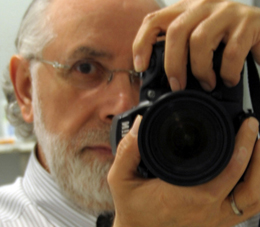
This first posting was done on Saturday, July 25, 2009.
And the website – www.zinga.photos – went public August 1, 2009.
 For years I’ve maintained a written journal and this is my first effort at an electronic format. This is not an interactive forum, no comments are possible, actually no comments are allowed. (It may be that eventually this will change, but in this first iteration, it is a journal not a blog. And yes, all the people that know me are not surprised. What do I care what others think…)
For years I’ve maintained a written journal and this is my first effort at an electronic format. This is not an interactive forum, no comments are possible, actually no comments are allowed. (It may be that eventually this will change, but in this first iteration, it is a journal not a blog. And yes, all the people that know me are not surprised. What do I care what others think…)
In spring of 2008, I bought my first camera – Nikon D60 – and began to take pics. The website and other cameras came next.
This posting is part of the travel-category calabria-09 and applies to the 2009 trip to Italy, specifically our visit to Aprigliano and Reggio. I am using the upcoming trip as an opportunity to keep a live record of the travel. (My first trip back to Calabria was in 2006 and Rose and Derrick had the cameras. For that trip we stayed in Gioia Tauro and did side-trip through out Calabria. The image is me in front of our house in Corte. The scrawl on the wall advertises that the property is for sale.)
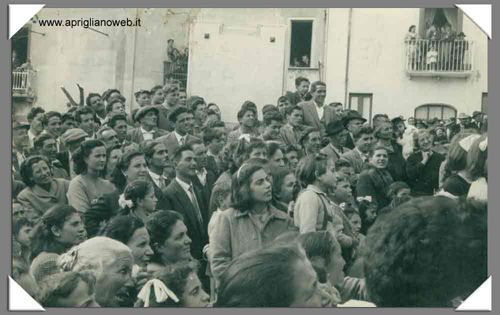
 I’m beginning this trip on my own. Rose and Derrick will join me the second week.
I’m beginning this trip on my own. Rose and Derrick will join me the second week.
The black-and-white images I am using for these initial posts are off the web.
Draft Itinerary
Wednesday, August 5, 2009: Arriving LaMezia Terme, Calabria
Depending on time of arrival, I will either drive into Aprigliano or stay overnight in LaMezia. (I’ve decided to stay overnight and not risk driving to Aprigliano at night.)
Thursday, August 6: Aprigliano
This first day, I’m planning to get situated and to walk around with my camera.
Friday, August 7: Aprigliano
I’ll begin a methodical route to shoot as much of Aprigliano as I can. I may go to the cemetery in the morning.
Saturday, August 8: Aprigliano
This will be the first trip out. I may either go to La Rota or I may go on to Paola.
Sunday, August 9: Aprigliano
I will go around to all the churches that are open to shoot inside.
Monday, August 10: Cosenza
Want to visit with Franco and shoot at the Domenican and Fransciscan churches that I didn’t get to in 2006.
Tuesday, August 11: This will be my last day in Aprigliano before I head down to Reggio.
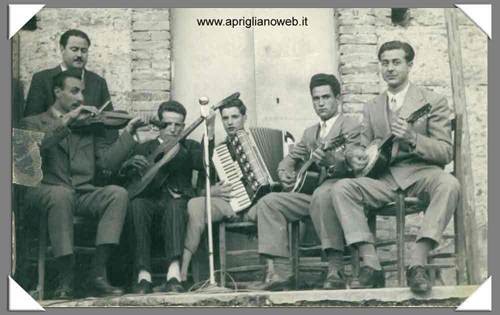
 This is the first time I am taking camera equipment on a plane. I have the right size bag, however it doesn’t have wheels, so I’ll be lugging it about. I spent the day trying to find a collapsible luggage cart that folds in such a way that I can fit it into the camera bag itself. No luck.
This is the first time I am taking camera equipment on a plane. I have the right size bag, however it doesn’t have wheels, so I’ll be lugging it about. I spent the day trying to find a collapsible luggage cart that folds in such a way that I can fit it into the camera bag itself. No luck.
The other change was the check-baggage. I had planned to check two – the small bag and the tripod case with clothes wrapped around the tripod. Once I began packing that plan proved unworkable. That would give me three bags with no wheels. The new plan is to take a bigger check-baggage and to put the tripod, surrounded by clothes, in this bigger bag.
Also, today journal.zinga.photos went live. Before I announce it, I want to see if I can get to it from Aprigliano. I’m hoping to find an unsecured router. Or an Internet cafe.
Part of the reason for the journal is to keep notes so that I can systematize the process.
I am now debating who I tell about the journal. If I knew I would be able to access it to post while in Italy I’d tell a number of people. I may try it and let them know to check it.
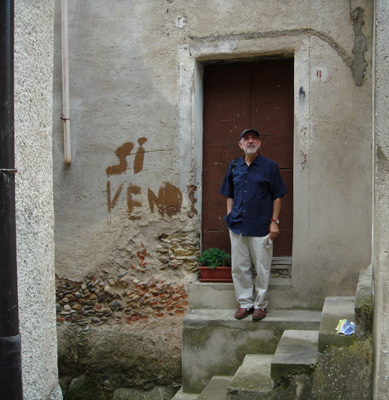
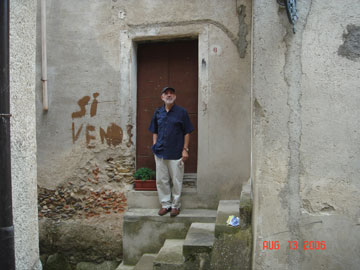
In Corte, I want to go back to visit my cousin who just purchased the house I was born in. She decided after many years that she wanted more room. She even invited me to stay with her. How strange to stay in the house you were born. I’ll visit and take pics instead.
The pic on the left is me standing in front of my house before my cousin’s purchase.
I want to add a side-trip to Grimaldi, Martirano and Conflenti. In Martirano there is a great monument to the fallen and Conflenti has the Santuario della Madonna della Quercia.
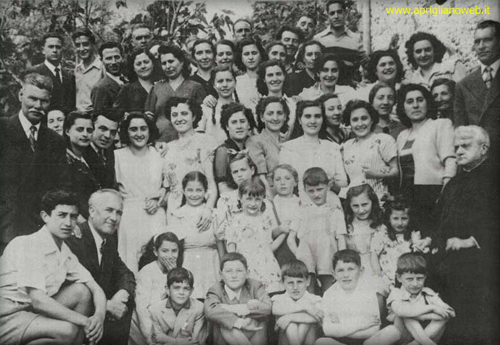
 I believe I have it all packed. Tomorrow morning I’ll pack the laptop and the the trip folders.
I believe I have it all packed. Tomorrow morning I’ll pack the laptop and the the trip folders.
This morning I talked to Antonietta and made sure all was set. She mentioned that they had received my letter, so I re-said what was in the letter. I’m finding that writing in Italian is an easier process than talking mainly because I can edit and research. When I’m talking, especially on the phone, I slip into an mixture of Italian and English. Where this works with Ciccio and Mafalda, it does work as well with people who only speak Italian.
Tonight I learned how to add pics to the journal postings. And I’ve been using the laptop without all the addons for the last three days. I’m glad I did. It got me to change windows and other settings to fit into the 13″ screen.
Tomorrow I leave about 8:30 and head to Detroit. The flight out isn’t until 7:45.
Also found out that August 16 is the feast of San Rocco. Mario is one of the planners and if it’s a big event Rose, Derick and I will drive up to Aprigliano.
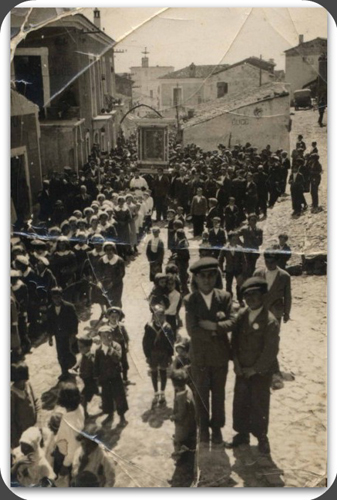
 Modern technology. Here I am at the Detroit airport in the business lounge with connectivity.
Modern technology. Here I am at the Detroit airport in the business lounge with connectivity.
I left Pittsburgh this morning at 9:30 mainly because I wasn’t sure about getting here and finding everything. Well, I got here in 4 hours and am now waiting until 7:00 PM to board, but that’s OK, I’d rather be early than stress.
Security was OK, the camera and lenses went through with no problems. The new bag is great it has the room for all the electronics.
This is my first time in the business lounge and I have to say it makes the layover OK. There’s food, connectivity, electricity and comfort. Who would have thought that I’d have the laptop and connectivity? I should be able to find the same services in Rome another place where I have a 4 hour layover.
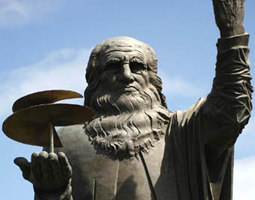
 I have a 5 hour lay-over in Rome. I hate the Rome airport, especially the domestic terminal. It is old, dirty and the air conditioning is almost non-existent. Terminal C which is the international terminal is fine, but I then have to go to the domestic terminal to go to Lamezia, Calabria. I understand that it is a busy airport, but when are the Italians going to get it fixed up?
I have a 5 hour lay-over in Rome. I hate the Rome airport, especially the domestic terminal. It is old, dirty and the air conditioning is almost non-existent. Terminal C which is the international terminal is fine, but I then have to go to the domestic terminal to go to Lamezia, Calabria. I understand that it is a busy airport, but when are the Italians going to get it fixed up?
Lamezia in central Calabria is another busy and not impressive airport.
Luggage return took a good hour and by the time I got the rental, it was 8:00. I asked about sunset, because I wasn’t willing to head out to Aprigliano in the dark and the attendant told me that it would be dark in half hour. I then went with my original plan to stay overnight at a small hotel near the airport.
The hotel was cheap and OK.
Thursday morning I left the small hotel early and headed out for Aprigliano. I was going to have to figure out how to get to the Autostrada. Italy now has traffic circles at major intersections and they are a whirlwind to get through. If you miss the exit you’re off in an entirely new directions or you keep circling. I missed the exit for the Autostrada and ended up on the coastal road. I didn’t mind that, because I wanted to see the beach area north of Lamezia. Well an hour ride through the area cured me. The area is typical low-end beach options and not all that attractive. The Lamezia area is industrial and very green, the beach area is sprawled all along the coast.
I got back on the Autostrada and headed north to Aprigliano. The exit is at a pretty, flats town – Rogliano. This part of Calabria is only flat along the coast and Rogliano benefits from the topography of the area. The town is a good size, the road in is manageable and it has a nice centro.
From the Rogliano exit to Aprigliano is a good half hour. I like the road to Aprigliano, it’s the beginning of the ascent into the mountains. It’s also a road I remember and so it was less intimidating to drive it on my own.
The driving on my own was both exciting and scary. I had this very nice small car Fiat Punta, but there was no one there to look out for signs and directions. This is a disadvantage when travelling at 80 kilometers an hour, but I believed I could remember enough of the road to get there without getting too lost.
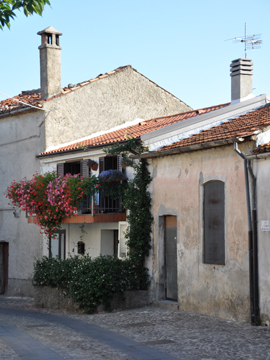 The first stop I made was at Le Donnici. This is a small paese 10 minutes north of Aprigliano. For the first time I took out my camera and began shooting this really nice church and the flowers off someone’s balcony. It felt great to not be lost and to take pictures.
The first stop I made was at Le Donnici. This is a small paese 10 minutes north of Aprigliano. For the first time I took out my camera and began shooting this really nice church and the flowers off someone’s balcony. It felt great to not be lost and to take pictures.
When I was back in Calabria in 2006, I realized that at home we talk a dialect, an Apriglianese dialect. And in that language Le Donnici came out I Runnici so I would be looking for signage that had the place name spelled with an R. It took me a while to understand that the correct pronunciation was different than what I had heard all my life. This is a relatively small sub-urb of Aprigliano, but it had some beautiful houses in its medieval streets.
The next turn-off was at San Nicola, a small suburb of Aprigliano. I asked two ladies waiting for the pulmine – bus if I was on the right road and when they said yes, I started shooting to outside of the church of San Nicola. Also posted outside the church were death notices. I had to shoot these. The road that is the small village of San Nicola is on the south side of the mountain valley. Aprigliano is opposite it on the north side of the valley.
After taking pictures in San Nicola, I headed to Aprigliano.
..
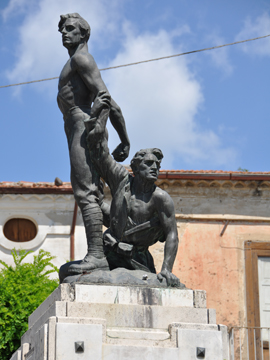 By 9:00, I was in Aprigliano. Wasn’t sure if it was too early to show up at Mario’s and Tonina’s, so I drove up to Guarno, the central section of Aprigliano, parked and headed up the street to Santo Stefano. Naturally everyone in the parking area and in the piazza gave me the once over – who is this stranger? The statue in the piazza is a memorial to those who died in WWI.
By 9:00, I was in Aprigliano. Wasn’t sure if it was too early to show up at Mario’s and Tonina’s, so I drove up to Guarno, the central section of Aprigliano, parked and headed up the street to Santo Stefano. Naturally everyone in the parking area and in the piazza gave me the once over – who is this stranger? The statue in the piazza is a memorial to those who died in WWI.
The church in Guarno was open so I went in to find four women cleaning. I asked if I could shoot. Also, introduced myself, but they didn’t know my family. It was fun walking through Santo Stefano in the morning, on my own shooting pictures.
By 9:30 I headed down to Santo Leonardo, the section of Aprigliano where Mario and Tonina live.
I got unpacked and met Alyssa, she’s the youngest daughter home from college. I went back up to Guarno and found Mario who introduced me to Totonno’s son. Totonno is my first cousin. His son Salvatore is younger than me, but looks quite drawn. I kept wondering if he isn’t ill. Mario also introduced me to all the other people in the piazza. By 12:30 it was time to go home for the mid-day meal. Mario took the steps down to his house. I didn’t know where the steps were had walked the road. (I know the steps in Santo Stefano and the once leading to Corte, by where Mario and Tonina live and the housing on that slope of the mountain didn’t exist when I live there.)
The mid-day meal is the main meal of the day. It is large and hot. Mario and I came in, and he went to change out of his street-clothes and into at-home clothes. We then sat down to eat. (I will talk more about the mid-day meal in other postings.) After eating, Alyssa and Tonina cleaned the table. I tried to help, but they would have none of it. With the meal done and the dished cleaned, it was announced that rest was in order. Me still being on Pittsburgh-time announced that I was going over to the cemetery to take pictures. They all left the street-floor and went off to their apartment on the first floor. I packet my camera and drove to the cemetery.
The afternoon was miserably hot. A fact that became a recurring experience. No one was out, the American with his camera was the only person out in the afternoon heat and sun.
I went back and rested for a couple of hours. At 5:00, Mario came down and knocked on the door to announce coffee time. We sat in the downstairs kitchen and had a coffee. This is strong espresso in a tiny cup. The coffee was the “hold-you-over” until supper snack.
..
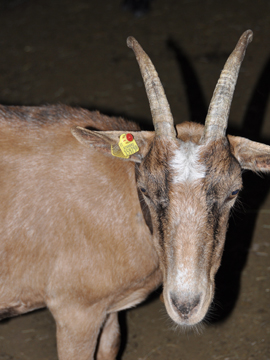
Supper, a light meal, was going to be at 9:00 and afterwords we were going to La Grupa, another section of Aprigliano, for a concert. Mario also told me that if we wanted he was willing to take me up to the Rota, a small farming area half-hour north of Aprigliano, to visit with my cousin Aurelio.
We drove to La Rota around 7:30. Aurelio had just finished milking. Aurelio is a Capisciolto – the business side of my father’s family, and his mother’s side of the family. Aurelio’s father and my Capisciolti grandmother were brother and sister. The Capisciolti own land and ran businesses in Aprigliano.
 Aurelio owns a large track of land where he grazes a herd of sheet, makes cheese and ricotta that he sells in the area. Aurelio is probably in his 70’s. He knew I looked familiar, but couldn’t place me. (The last time I saw him we were both young. I was a junior in college and he was living at La Rota, but both his parents were still alive and his brother was still living at home. They were all involved in the cheese production business.) I took my ball cap off and he immediately recognized me. I look like my dad and he made the connection.
Aurelio owns a large track of land where he grazes a herd of sheet, makes cheese and ricotta that he sells in the area. Aurelio is probably in his 70’s. He knew I looked familiar, but couldn’t place me. (The last time I saw him we were both young. I was a junior in college and he was living at La Rota, but both his parents were still alive and his brother was still living at home. They were all involved in the cheese production business.) I took my ball cap off and he immediately recognized me. I look like my dad and he made the connection.
Aurelio is this strapping man who still works a 12-hour day tending a herd of sheep and producing milk, cheese and ricotta. This is his career and he makes a good living. La Rota however is off the road leading to La Sila, the huge national park that covers the entire middle of Calabria and is forest covered mountains, and therefore remote. If I had stayed the two weeks in Aprigliano, I would have gone back to Aurelio’s and asked to spend the day with him out on the slopes with the sheep. Aurelio is famous in town for two things – he has never married and his herd is registered with the livestock commission making his milk, cheese and ricotta agency approved and acceptable for sale nationally. Aurelio kept inviting us to stay and eat, but I was a bit worried about driving the off-road after dark so we left.
Back at Mario’s we had the evening meal. This was a light meal made of left-overs, one recently cooked dish and a salad. Cheese was on the table for both meals and dessert was fruit. Afterwards we all got changed into less casual, house-clothes and drove to Guarno. We were going on a passegiata. We walked from Guarno to La Grupa. Along the way everyone we chatted with the other Apriglianese out for the evening walk. We ended up in a small piazza in La Grupa. The entertainment was a band singing American songs.
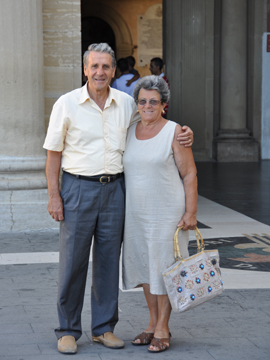
Mario, Tonina and I left for Paolo early. Tonina had asked me if I wanted to visit any particular place and I had mentioned Paola. She suggested we go Friday rather than wait until the week-end. The week-end would be crowded with Italians going to the beach and others going up to the sanctuary. Paola is on the coast and Aprigliano is in the interior.
The road to Paola is one of the few east-west roads in Calabria. The SS107 was built during the 50’s and it was one of the many construction projects that helped revive Calabria after the war. Mario said he would drive which thrilled me. (I had printed out directions before I left, but he knew the roads and the short-cuts.) We ended up going right through Cosenza, passing the hospital where Mafalda was taken after Connie was born. Mafalda had developed an infection and she had to be rushed to the hospital in Cosenza. In 1955 rushed meant being taken on some type of stretcher through the medieval streets of Santo Stefano and to the place where they were able to get her into someone’s car. I remember visiting Mafalda with my dad. What I remember from the visit is the gardens surrounding the hospital and my finding a plastic star on the ground.
SS107 is a scary road. It’s a narrow, two-lane superstrada, the Italian designation for two lane highways, that literally climbs the mountain, goes through a long tunnel and then descends to the Mediterranean. Along the way there are 90 degree turns and crazy Italian drivers. (I was glad to not have attempted this road on my own.) My last visit to Paola was back in the early 70’s. I got off the train from Rome and then made my way to Aprigliano by train and bus. (The mail rail-lines travel the two coasts and from there it’s a matter of taking small trains to the mountain villages.) The train was a funicular, an incline in Pittsburghese. It climbed the mountain, went through a long, dark tunnel and then descended to Cosenza. From there I took a bus to Aprigliano.
 The Santuario was great. Mario and Tonina enjoy going on religious outings. The place is this restored mountain top complex full of medieval buildings and modern structures. The religiosity of the place wasn’t something that I was interested in, but the complex was amazing.
The Santuario was great. Mario and Tonina enjoy going on religious outings. The place is this restored mountain top complex full of medieval buildings and modern structures. The religiosity of the place wasn’t something that I was interested in, but the complex was amazing.
The old hermitage – medieval caves that San Francesco used – has been restored and cleaned, the medieval church is beautiful and the modern church dedicated in the last 10 years is an amazing example of modern Catholic architecture.
A great story – the grounds are sacred, because they have all these locations where San Francesco did something amazing – fought with the devil, held up the mountain, cured someone. One of these locations is a spring on the side of the mountain face. The spring is always crowded with people filling bottles of water to take back with them. I quietly walked away, leaving Mario and Tonina to drink at the holy spring. Mario comes down to me with a ladle of water from the spring. I was stuck, to refuse would have been rude and inappropriate, so I drank. The rest of the day I had visions of gastric upheaval. It never happened.
After the visit to the santuario, Mario drove into the city. Paola is a busy seaside resort that caters to pilgrims and the beach crowd. Not my kind of place.
On SS107 is the amazing village of San Fili. The village is perched on the top of a rock crag. The barren rock is crowned by this beautiful medieval village.
..
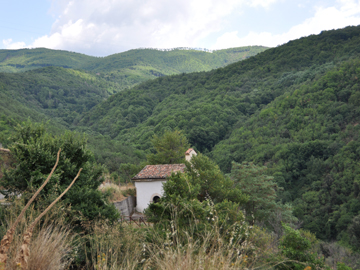
I was supposed to have lunch with my cousin, Maria Lucente, but we got back from Paola late, so I walked over and negotiated going over the next day for the mid-day meal. She had not cooked the pasta, waiting for me to show, but the second piatto was all ready. We agreed that we would have left-overs tomorrow. After that discussion we decided to walk to La Madonna Delle Timpe. This is a small chapel a 45 minute walk from town.

Maria used to walk this on a regular basis, but recently she had fallen on the one of the steep grades and was now hesitant about going out by herself. Given that I was going with her, it was OK. Also, she’s the keeper of the key to the small hillside chapel, so I knew we could get in and I could photograph.
We walked leisurely. Maria brought a walking stick and I my camera. It was great walking and talking with her. She is an honest and simple woman who has lived her whole life in Corte the southern section of Aprigliano. We talked about life, her life, her husband’s death and her life afterwards.
When we got to the chapel, the key would not work. That was OK, because what was more important was the time we had spent walking and talking. Also, she had gotten a chance to go back to her favorite chapel. (Her children had insisted that she not go by herself, well she had gotten someone to go with her, she had gotten to walk in the blazing sun which she liked and she and I had had a chance to laugh and remember.)
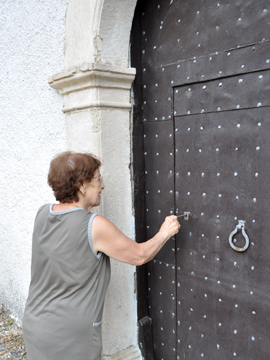 We walked back. I now have the key that did not work. Maria has a second key that works, so she uses it. I will give the key I have to Mafalda, in a shadow box, as a Christmas gift. She’ll love it.
We walked back. I now have the key that did not work. Maria has a second key that works, so she uses it. I will give the key I have to Mafalda, in a shadow box, as a Christmas gift. She’ll love it.
When I came back Mario and I went to San Leonardo and I got to shoot in the church. I remember there being a wax effigy under the altar, but Mario didn’t. I may not have made myself clear. I like being in the churches by myself. It’s the one time I wish I had all the professional lighting stands. After shooting in the church, I got to go up the bell-tower and shoot from there. At one point the bells started tolling it shocked the hell out of me.
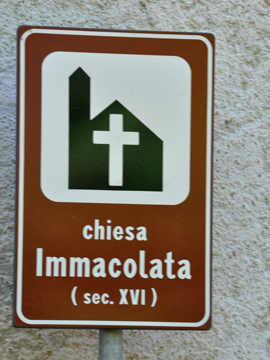
At 6:30, Alyssa and I joined a group from Corte in a walk to the chapel of La Madonna delle Timpe saying the rosary as we walked. The morning rosary was part of a seven day cycle and this was day four. There were about 15 people. Because Alyssa was new, the group leader had her lead the rosary. There I was walking with a group through the mountains praying the rosary. I recorded the group and will put the recording on the website.
At the chapel there was a short ceremony and when we were all finished we had espresso. Someone has brought coffee in a thermos and cups. There we were in the middle of a mountain path having coffee. It as the best.
When we got back home, Alyssa, her father and I had breakfast.
 Given that it was still early, I decided to walk down to Agosto and try and shoot the chapel of L’Immacolata. Mario and Tonina had told me that Agosto is the least re-developed of the various communities that make up Aprigliano. I found a small neighborhood situated on the side of the mountain closest to the stream – Crati. It didn’t seem any less inhabited than other parts of Aprigliano. However, it is one of the non-contiguous sections and the most isolated. I asked around and was told who had the key. The woman was a bit suspicious about my asking for it, but she did give me the key.
Given that it was still early, I decided to walk down to Agosto and try and shoot the chapel of L’Immacolata. Mario and Tonina had told me that Agosto is the least re-developed of the various communities that make up Aprigliano. I found a small neighborhood situated on the side of the mountain closest to the stream – Crati. It didn’t seem any less inhabited than other parts of Aprigliano. However, it is one of the non-contiguous sections and the most isolated. I asked around and was told who had the key. The woman was a bit suspicious about my asking for it, but she did give me the key.
The chapel of L’Immacolata was another amazing place. It was full of paintings, frescoes and statues. It finally dawned on me that these are great examples of primitive, regional art. Imagine the artists who were employed to paint all the various pieces in the many churches and chapels of Aprigliano. When I go home, Tonina and I agreed that these churches and chapels were the museums of Aprigliano.
After shooting the inside and outside of the church, I walked down to the Crati. It is a small stream. I remember it as wide and scary.
The walk back was all uphill and by this time it was almost noon. The sun was beating down. I now understand that common expression differently than I ever did before.
..
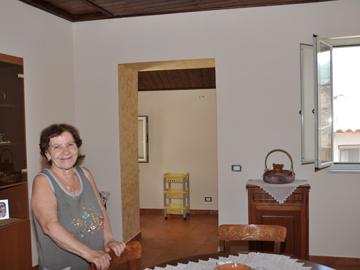
For the mid-day meal I went back to Maria Lucente’s. We had the meal we were supposed to have on Friday. The meal was traditional and great. For dessert we had the standby cetrioli– garden cucumbers. After eating, I went into the room that had been Ciccio and Mafalda’s first apartment.

It was also the room where I was born. Maria bought the one-room building after her husband died and renovated it into a very beautiful dining room. I took many pictures. Through the doorway behind Maria Lucente is a small room with a fireplace. Mafalda told me the three of us would huddle around the fire in the winter. (There’s an image – Mafalda and Ciccio two young, beautiful people with a baby huddling together in front of a roaring fire.) The layout was still as it had been 60 years ago. Mafalda even told me where in the room I was when I fell off the table and cut my head on a axe. (There’s a different image.)
After lunch Maria and I went to visit another Capisciolto relative – Armelia. Armelia’s husband had died in late July and she was still mourning. When I got back to Mario and Tonina’s they told me about Armelia. She and her husband came back to Aprigliano after having spent 20 years or so in Toronto. Armelia is a true Capisciolto, meaning a good business person, and she was able to operate a home-business when she and her husband returned. Mario and Tonina also told me the Armelia lives in a huge house with 4 bathrooms. I’ve only been in a small kitchen, so this was a surprise.
..
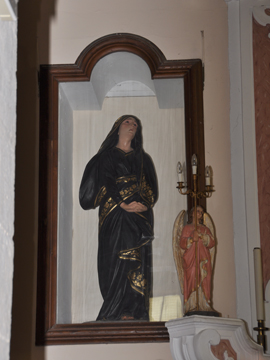
At 5:30 I went up to Santo Stefano, the church. The last time I was in “our” church was 1957. The church was open for mass. I got there early enough to shoot before mass started. The church is not well taken care of. The frazione– section – Santo Stefano probably lost the most people to immigration and the area is just now beginning to revitalize. (Some of the housing is being bought by young couples and renovated. This is a different process than building new. There has been some new development in the frazione, but the old medieval housing stock has been vacant for many years. Since 2006, I have noticed slow but constant move to revitalize this top of the mountain frazione.)
 I shot the things I remembered – the painting of Steven being stoned by the mob, the statue of the Dolorosa, the ceiling. I had totally forgotten about the Dolorosa. This is a classic statue, with Mary in black and in a very sorrowful pose. This image has been in my head forever and I could recognize this statue in the various churches through out Italy, but I never knew where the seminal image came from. It came from the Dolorosa in the church of Santo Stefano.
I shot the things I remembered – the painting of Steven being stoned by the mob, the statue of the Dolorosa, the ceiling. I had totally forgotten about the Dolorosa. This is a classic statue, with Mary in black and in a very sorrowful pose. This image has been in my head forever and I could recognize this statue in the various churches through out Italy, but I never knew where the seminal image came from. It came from the Dolorosa in the church of Santo Stefano.
On leaving the church, there was a group filling bottles from the fountain at the bottom of the church steps. It was my job, as a child, to go up every night to this fountain and fill the jugs so that we would have water for breakfast the next day.
Next I headed down to the Vico, because that church would soon be opened. The Vico is the southern most frazione of Aprigliano. It’s where the train station is. However, it also seems to be the frazione most separated. This is mainly because the Cosenza diocese has assigned a different priest to the Vico church than to the other churches in Aprigliano. This slight change has people talking about the Vico as a separate village. I don’t know if this is true among the people who live in Vico. This also means that the rituals that create the calendar that this area lives by is interrupted and having two different priests managing the church schedules. The Vico group co-ordinates its feast days and its celebrations with the churches on the other side of the valley rather than with the churches of Aprigliano.
The place was a bit intimidating. It’s also the one frazione that no one in my family is associated with. When I got to the piazza to ask directions to the church, a young man insisted on showing me the road, fine. As soon as we got away from the piazza he tried to sell me a lottery ticket. I told him no. When I got to the church, it wasn’t opened and there was a large crowd of children playing soccer in the square in front. It didn’t feel right, so I took pics of the outside and then left.
..
When I was walking around Santo Stefano, specifically in the vinella, Rosina Ciaccio’s door was opened so I went and knocked on the door. One of her son’s answered. It was Rocco her youngest. I really don’t remember him. He was very young when his brother and I played together. I visited with them for a while, found out Rocco is living in Padua with his family, but in the summer the whole family comes back to Aprigliano. His wife’s family is from Grupa, so she and their two sons stay there and Rocco stays with his mother in Santo Stefano. He was interesting to talk with. His brother was on his way to visit, but because it was near dinner time I left went back to Mario’s and then went back to Santo Stefano.
By the time I got back Franco was there, so I visited with them for the next hour.
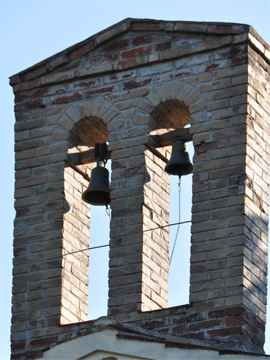
I was going to go up to Portosalvo to take pics, so I drove up to Guarno, because I needed to get back in time for the 10:15 mass at San Leonardo.
Once in Santo Stefano I met a man who was heading out to La Sila and asked about the key. He showed me where it was kept and told me that whenever the key is not there, it means someone it at the church. Key in hand I made my way to Portosalvo.

The road, a dirt road one lane wide, was all uphill. I don’t remember that. I guess the last time I was there, I was so glad to have found the key that I paid no attention. This time I had the key to the front door. The chapel was dark and I had no idea where the lights were, so I used the flash. I took several pics of the bell-tower. It was in the sun and looked great against the blue morning sky. Because I had been here back in 2006, it wasn’t such a “wow” experience.
It occurred to me that I had begun to rely on the bells from San Leonardo to tell me the time. The bells tolled every 15 minutes, so I always knew what time it was. I realized that doesn’t help with being on time, it just tells you if you’re late. By 9:30 I was on my way back.
Mass at San Leonardo was another experience. The church was packed, something that Mario’s family commented on. I sat there with Tonina and all the ladies who had been at the rosary came up and said hello. Alyssa was up in the choir loft and Mario was somewhere else.
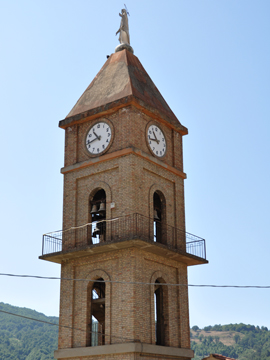
San Leonardo is the church for Corte and its bell-tower with la madonnina on top is the defining landmark for Aprigliano. The church is also surrounded by the new housing plan that Mario and Tonina live in. It’s the entrance into Aprigliano. Another reason why Agosto and Vico get pushed to the side. In actuality, San Leonardo is really in the middle of the mountain side making it the middle of Aprigliano, but because Vico and Agosto are off the main road, San Leonardo has the feeling of the gateway into the town. I remember it always having an uppity reputation, and the generation that created that reputation is now the in-charge generation. (Santo Stefano it’s rival has faded, but it seems to be on the rebound.)
In the afternoon I went with Mario and Alyssa into the archives at San Leaonardo and we found my Baptismal certificate. (It states that I was 4 months old when baptized. This information is there, because it was unusual to wait that long before getting baptized. My mother told me that I almost died soon after I was born, so they quickly baptized me. And once I recovered, they waited until spring to take me to church for the more formal baptism. Two different people baptized me. A friend of my mother’s brother who was in his early teens did the first baptism. In early spring my mother’s friend was my sponsor. No one else was mentioned on the certificate.
We also found Connie’s birth certificate and Ciccio and Mafalda’s marriage certificate.
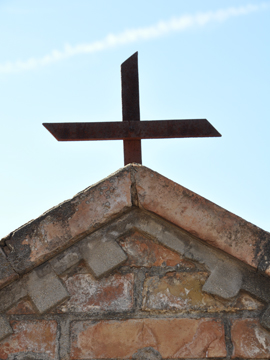
Monday morning Alyssa, AnnaRita and I went to join the rosario walk to La Madonna delle Timpe. This time they aske AnnaRita, Mario and Tonina’s second child, to lead the rosary.
It was a beautiful morning and I took pics of the sun on the back of the church rather than any inside shots. A couple of the shots have a shadow of me taking the pic.
Unlike the Saturday rosario walk, no one brought coffee. The walk back was still pleasant and several picked blackberries to eat or take home. Also, all around us you could hear the sheep bells and the sheep dogs barking.
After the mid-day meal I went to the cemetery with Mario, Tonina and Alyssa. With Mario there I got to all the graves I could not readily find the last time I was there. I also got to see the cappelle, crypts, that Mario purchased for his family. Death is a different experience in Aprigliano. Mario and Tonina were proud of the fact that they had already purchased the crypts where they would be buried. I can’t see Ciccio and Mafalda doing that. In Canada as in the US, pre-buying your burial plot and maintaining it is not a thing people do. As a matter of fact most people would think it strange if someone did that. In Aprigliano, that Sunday morning Mario and his family went to the cemetery to clean the family crypt.
I can’t see Ciccio and Mafalda doing that. In Canada as in the US, pre-buying your burial plot and maintaining it is not a thing people do. As a matter of fact most people would think it strange if someone did that. In Aprigliano, that Sunday morning Mario and his family went to the cemetery to clean the family crypt.
One thing I had noticed the last time I was shooting at the Aprigliano cemetery was the various crosses atop each grave. I began shooting these crosses and was astonished to discover that they were all different, that they all seemed hand forged and that some of them were truly beautiful. The one in the pic was the so unusual. The cross seems like a modern construct and yet it was atop one of the oldest tombs. I suspect that when it was put up it was the cheapest thing the family could afford. (It looks like someone found two discarded pieces of metal on the foundry floor and forged them together.) Now the contrast between an old brick tomb and a modern-looking cross is great.
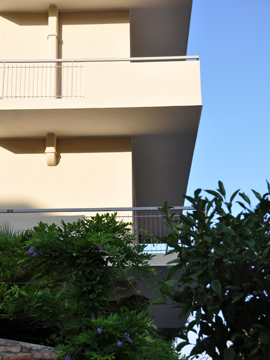
Tuesday morning I left Aprigliano and headed down to Reggio. Mario had suggested and alternate route and I was almost ready to take it, but AnnaRita explained the alternate road to me when she and Alyssa came back from the rosario walk and it sounded a bit difficult. I decided that I knew as was comfortable with the Rogliano road that I had come up and that I was going to use the same route to get to the Autostrada.
The trip down to Reggio was fine, I was on the Autostrada and I had talked to the owner of the house we were staying at in Reggio and his directions sounded very simple. I was still on the Autostrada by myself and even though I had done this trip a couple of times in 2006, I was doing it on my own.
I managed to get to Pellaro with no problems. As a matter of fact it was very easy. The Autostrada ends in Reggio and becomes E90 the superstrada along the Ionian coast. The superstrada is a two-lane road. Once I got the the Pellaro intersection, I made the right followed traffic into the center of town and the owner of the house we were renting met me and I go into the house by 12:30. Rose and Derrick were due by 3:00.
.
 Pellaro is a sea town. The house was on one of the two main streets. It was a beautiful house even if, in the inside, it was not well cared for by the young man who inherited it. It had been his grandparents’ house and he was in the first stages of making a summer rental.
Pellaro is a sea town. The house was on one of the two main streets. It was a beautiful house even if, in the inside, it was not well cared for by the young man who inherited it. It had been his grandparents’ house and he was in the first stages of making a summer rental.
The house was huge. You come in on the street level into a beautiful foyer. It still have what must have been his grandparents’ furniture. You go up these great stairs. (All construction in Italy is cement and hollow, terracotta blocks covered with plaster.) These stairs were topped with rich, dark planks of oak making for an elegant solution to cement stairs. The main floor has this large living room/dining room combination with a large kitchen, pantry and bathroom. This floor has four balconies. The third floor is three large bedrooms and a bath. The two front bedroom share a huge balcony. The top floor has a small room with a door leading onto the terrace. The terrace is the width and length of the house including the balconies making it the largest contiguous space. It is finished with terracotta tiles, railing and low walls. On the east/west sides the house has a garden and a street. It fronts one of the two main streets of Pellaro and it sits against another beautiful empty house.
The house was built in the 1920’s after an earthquake. There are a few pre-earthquake houses left in Pellaro, but much of the old housing stock was either destroyed in the earthquake or torn down to build the ubiquitous post WWII housing that is all over Italy. It’s their version of the Levittown housing that litters American suburbs.
The young man – Paolo – was very helpful and accommodating. He recommended two things that were amazing – a coffee shop, and a small boutique market. The coffee shop – Tahiti – was a gold mine. The granita was to die for and the gelati were sinfully deliciously. The small market became our food store and for the week that I was there we ate food from the market six out of seven days. Across the street was a vegetable stand with great fruit and vegs. The owner was this very generous woman who treated us well. She gave us basil, she gave us figs – the first of the season – both without charging us.

 The most amazing discovery were the churches. These are the museums of Aprigliano and there are many of them. I was able to get into all but one – San Demitri – and that was because I had forgotten it was there and ran out of time.
The most amazing discovery were the churches. These are the museums of Aprigliano and there are many of them. I was able to get into all but one – San Demitri – and that was because I had forgotten it was there and ran out of time.
I will begin to create separate pages for each of the small mountain churches and will post pics of the paintings and frescos .
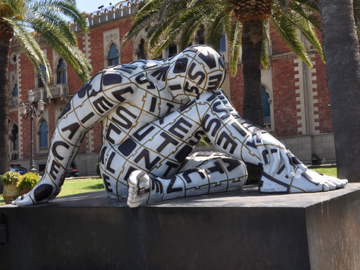
 I am in Reggio di Calabria, one of my favorite cities. (I have to write and not use any contractions, because I do not know where the apostrophe is on the keyboard. Getting the @ symbol was a discovery. Derrick knew where it was because he did a presentation in Germany a couple years back and someone showed his where it was.)
I am in Reggio di Calabria, one of my favorite cities. (I have to write and not use any contractions, because I do not know where the apostrophe is on the keyboard. Getting the @ symbol was a discovery. Derrick knew where it was because he did a presentation in Germany a couple years back and someone showed his where it was.)
The five days in Aprigliano were great. I must have taken close to 500 pics. I also kept notes and will post them as soon as I get a chance.
Today’s agenda includes eating gelato. (The young woman showed me where the apostrophe is.)
The villa where we’re staying in Pellaro, a suburb of Reggio is a beautiful home. All the amenities aren’t there, but the owner has brought in people to repair and install. Hopefully by tonight all will be in working order.
My cousin’s luggage was not on the plane when they came in yesterday. We tried making phone calls, but in Italy phone calls are like shouts across the alley. So this morning I suggested we go to the airport and see if the luggage was there. Face to face works best.
The driving – it’s still true, in Italy traffic rules are suggestions. I was on a two lane road yesterday, but there were four cars across and motorcycles on either side. I am more confident in driving down here, because there are other people in the car that can look out for sign. In Aprigliano, first there was the sheer cliffs and there you are in the mountains and cannot see around the next bend. Here on the ocean, the land is flat and the roads are flat. There are no flat surfaces in Aprigliano.
Last night we had supper on the terrace overlooking the Straights of Messina and Sicily. An amazing view. I look to the left and there’s Etna with smoke coming out of it’s top. On the Calabria side, the foothills of the Aspromonte are all brown, there is no vegetation on the hills. In contrast, Aprigliano in the northern part of the Aspromonte mountain range is all green. Sicily is all brown. I’m beginning to think that Sicily may be an interesting place.
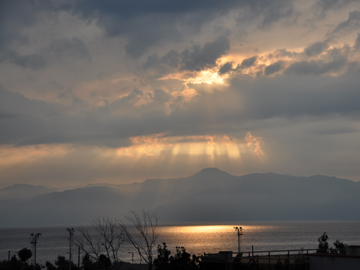
 In Pellaro we had a house with a beautiful terrace. A terrace that overlooked the Straits of Messina – Stretto, the mountains of eastern Sicily and Mount Etna. We had dinner every night on this terrace looking at the setting sun as it died behind the mountains. This feature alone made the house and Pellaro worthwhile.
In Pellaro we had a house with a beautiful terrace. A terrace that overlooked the Straits of Messina – Stretto, the mountains of eastern Sicily and Mount Etna. We had dinner every night on this terrace looking at the setting sun as it died behind the mountains. This feature alone made the house and Pellaro worthwhile.
Behind us the brown mountains of Calabria surrounded the houses of Pellaro. But these was barren and uninteresting compared to the blue Stretto, rugged Sicilia and towering Etna.
Our dinners were supplied by this great boutique marked down the street from the house. Daily we went in a bought the dish of the day. We also bought the local cheese and the local wine. I don’t know what I liked best the food or the view. The view was another WOW. The food was good and allowed for an even deeper appreciation of the WOW. I took no pictures of our table laden with the local products. All I know if that we ate and ate very reasonably.
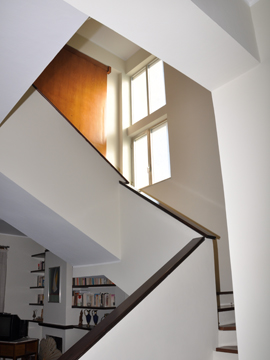
This year my cousin found a house to rent in Pellaro, a suburb of Reggio. The town is about 20 minutes south of center city. I pulled into Pellaro on Tuesday and it wasn’t until Saturday that I got a chance to shoot pictures.
The house is an inheritance and the young man who now owns it is trying to make it a rental. It was a beautiful and huge house. The problem was that we were probably in Italy the two hottest weeks and the house has no central air. The first night we had no air in the bedrooms; the second night I had air, but Rose and Derrick had to wait until the third night before they had air in their bedroom.

Some things that I really liked about the house:
– the foyer
– the stairs
– the roof terrace.
In town, we spent most of our money at the Tahiti Coffee shop, the boutique market around the corner and the vegetable market across the street. At Tahiti we had granita di caffe every morning; at the market we bought local wine and local cheeses; at the fruit stand we bought tomatoes, plums, figs and cucumbers. The food was wonderful. I don’t think we had anything that wasn’t fresh and had great taste.
The main square however was dilapidated and dirty. The streets were not clean, they were full of broken cement and there was dirt and sand everywhere. I’d wear Crocs when walking around, because my feet would sweat from the heat and I’d come home and had to go wash my feet because they were filthy with dirt.
The town had no pretensions and on one level that was quite nice, however it made for a “working vacation.” And for the most part I never mind that, the problem was there were few options outside of going food shopping and preparing meals. The one night we went out to eat, to a highly recommended restaurant, we came away very disappointed. The menu was nothing unusual or particularly good. In Italy I’ve always eaten great bread, at this restaurant we had American-style rolls. (There is a fascination with all things American, but bread is not something we Americans do well. Why would you serve American-style soft bread in the land of crusty bread?)
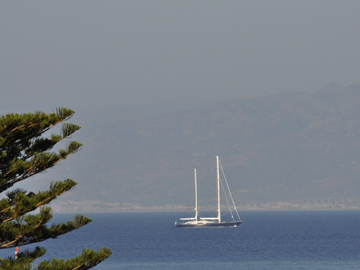 The best part of both the house and Pellaro was the rooftop terrace and the view of the Straight of Messina, the mountains of Sicily and Mount Etna.
The best part of both the house and Pellaro was the rooftop terrace and the view of the Straight of Messina, the mountains of Sicily and Mount Etna.
Sicily was perpetually covered in a haze. That may have been, because it was extremely warm and the heat generated a foggy vapor that clung to the mountains. I kept thinking that in the fall, once the miserable heat lifted and there was no humidity the view across the Straight would be amazing. There were many nights when Etna was under cloud cover.
The other great thing about having Sicily across from the roof top terrace was the boat traffic on the Stretto and the planes landing. The boat traffic made the scenery idyllic. The jet traffic brought us back to reality and allowed us to look at the underbelly of the planes as they buzzed overhead.
The roof top like the rest of the house was under realized. A retractable awning would make it usable all day. Instead we had to wait until the sun was ready to set before we could endure the heat. Having our late afternoon drink on the terrace instead of on one of the side balconies would have allowed us more time staring at Sicily. I used up all my staring time. It was something that made being in Pellaro worthwhile.
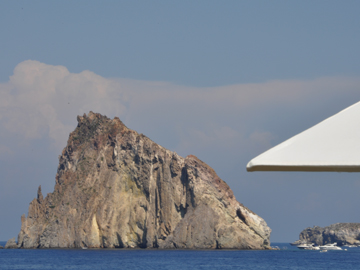
Other years August 15 has always been a down day – the stores are all closed, the towns are closed – so this year we decided that we would plan an outing for the 15th. We had decided to go out the one of the Aeolian Islands, an archipelago off Sicily’s northern coast. And between research and a program I saw on RAI, I suggested Panarea.
We went to Reggio on Wednesday and go tickets for the 15th. On Saturday we headed out early not wanting to be late, well that was an American way of thinking. The boat was a half-hour late pulling into the port at Reggio and it was a mob scene. (This same boat was taking people to any one of the five Aeolian Islands.) And to add to the stress we were to transfer at Lipari to another boat that would take us to Panorea. I kept thinking, this will never work. The boat was a hydrofoil.
When we got to Lipari the transfer was across from us. Obviously, everything was running late. We got to Panarea and it again was a mob scene. Even the “beautiful people” have to put up with crowds. We went to a small market, got was and headed towards the beach. Well that wasn’t going to happen. Panarea as all the Aeolians are volcanic islands rising out of the sea. There is no beach, the housing in all on the clifftop and to reach the water many houses have long spiral steps that go down to the sea. The rocks were miserably hot and the sun was baking anything out. I panicked. I had avoided the sun for 10 days and now I was faced with a six hour stay with no beach or umbrella.
 I went to what turned out the be the most desirable and luxurious hotel on the island – Hotel Raya -and asked if they had “day-passes” for the terrace with the umbrellas and chairs. The young receptionists had me ask the owner – an older woman. I put on my best American charm and asked her if there was any option for using the terrace with the umbrellas and chairs. For some reason she said yes.
I went to what turned out the be the most desirable and luxurious hotel on the island – Hotel Raya -and asked if they had “day-passes” for the terrace with the umbrellas and chairs. The young receptionists had me ask the owner – an older woman. I put on my best American charm and asked her if there was any option for using the terrace with the umbrellas and chairs. For some reason she said yes.
Went out and called to Rose and Derrick and announced that we could use the terrace. After getting over the shock of having been given permission to use this luxurious promontory and after settling down from the fear of being stuck in the baking sun to wither, I finally looked out and saw … What was in front of me was a “WOW”.
This flat vantage point looked out on the Mediterranean littered with huge sailboats and even bigger yachts. And in the middle of all this money were jagged volcanic slabs punctuating the blue. (I know how to think about and talk to rich artists, rich intellectuals, the landed gentry, but I have no idea how to think about people who spend their money on yachts, people who leave port in the morning and spend the day sunning under a desert like sun rolling on azure waves. I don’t know this form on human.) But I quickly let go of that confusion, took out my iPod and headphones and began listening to Dylan … to dance beneath the diamond sky with one hand waving free silhouetted by the sea, circled by the circus sands with all memory and fate driven deep beneath the waves.
Around 5:30 we left the terrace and went walking through the island. All the housing is whitewashed. This uniformity makes the place truly beautiful – the sky-blue water, the red volcanic rock, the green cactus and the white structures.
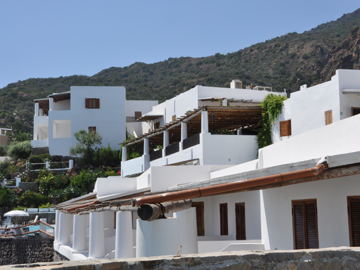 The island had these narrow roads and the vehicle of choice is the golf-cart. I guess when you have the Mediterranean to show off your 80 foot yacht, driving around in a golf-cart is OK. We went to the cemetery where the locals are buried. It is a simple place of simple tombs. Everything is above ground, because you can’t dig into the volcanic rock. The mountain side behind the cemetery was covered with prickly pear growing from every rook and cranny.
The island had these narrow roads and the vehicle of choice is the golf-cart. I guess when you have the Mediterranean to show off your 80 foot yacht, driving around in a golf-cart is OK. We went to the cemetery where the locals are buried. It is a simple place of simple tombs. Everything is above ground, because you can’t dig into the volcanic rock. The mountain side behind the cemetery was covered with prickly pear growing from every rook and cranny.
It finally came time to go back to the docks and wait for our boat back to Reggio. On this trip we would not need to transfer. The boat was 45 minutes late. This time I was really anxious. What were we going to do if it didn’t come? (We had gone to the Hotel Raya for a drink, and two Heinekens and a Martini and Rossi cost us $42.75. Imagine what a room would cost? Also, we suspected the waitress pocketed most of the money.) And the people-watching on the dock was depressing. I never saw so many frivolous peacocks in one small space. Men walking, as if they owned the world, get into catamarans at 9:00 at night and head out into the Mediterranean. Many time, while waiting for the boat, I kept thinking of the cliche – Mussolini made the trains run on time.
I was glad to be off Panarea and heading back to the real-world.
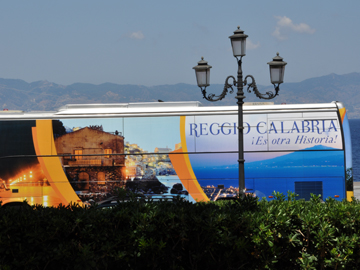
 Reggio di Calabria the southern most city on the mainland is my favorite place. It is truly a beautiful city; a city full of art and the most spectacular lungomare in all of Italy. I discovered Reggio back in 2006 and one of the reasons I was willing to go back south this summer was because of Reggio. Between the beach, the lungomare and the two main streets that border the area you have one of the most magnificent piece of WOW. And to top it all off Cesare’s is in Reggio. Cesare’s is a kiosk where you can get one of the best gelatos in the world.
Reggio di Calabria the southern most city on the mainland is my favorite place. It is truly a beautiful city; a city full of art and the most spectacular lungomare in all of Italy. I discovered Reggio back in 2006 and one of the reasons I was willing to go back south this summer was because of Reggio. Between the beach, the lungomare and the two main streets that border the area you have one of the most magnificent piece of WOW. And to top it all off Cesare’s is in Reggio. Cesare’s is a kiosk where you can get one of the best gelatos in the world.
Two streets up from the lungomare is the main shopping area – a no traffic street with some of the best shops. Reggio is Calabria at its best.
The cathedral boasts a rock that St. Paul supposedly touched. The palazzi fronting the lungomare create a magnificent backdrop to the palm trees and the green strip bordering the sea walk. And look in the opposite direction and you see Messina and the mountains of Sicily. I don’t know of any other Italian city that has both the man-made beauty and the natural wonders of Reggio.
We walked a deserted city, because we were there late morning, early afternoon. I stayed in the shadows and even then I got sun. Reggion is 7 degrees north latitude of the Sahara. Imagine how hot it was.
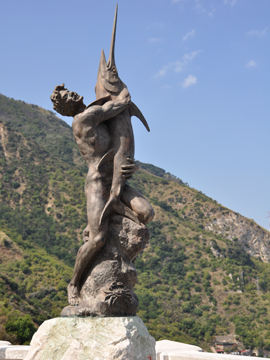
Beautiful Scilla hugs the mountain and spills into the Mediterranean. It sits north of Villa San Giovannini, the transportation hub between mainland Italy and Sicily. Scilla fronts the northern most point of Sicily. It a a city literally built into the rock face, so walking around requires great stamina. You are going up and down the mountain. Yes, the streets are beautifully restored; yes, there is a beach section for tourists and a sea-front section where the locals moor their fishing boats, but any time you walk, you’re going up and down a mountain.
 We had one of our best meals in Scilla. I had home-made pasta in a white sauce of zucchini flowers and muscles. I had to stop myself form licking the plate. The waiter was very quick to point out that the muscles were from the local fishermen and fresh.
We had one of our best meals in Scilla. I had home-made pasta in a white sauce of zucchini flowers and muscles. I had to stop myself form licking the plate. The waiter was very quick to point out that the muscles were from the local fishermen and fresh.
Scilla is divided into terraces. The top of the mountain is where the locals live. The next terrace down is full of restaurant and churches. The sea terrace is divided in two by the foot of the mountain. The left is all beach and tourists, the right is all fancy restaurants and B&B’s.
Before it was a tourist destination, Scilla was a working fishing village. The statue of the boy and the sword-fish it a reminder of that long ago profile. Today the tourist industry has replaced the search for fish.
Scilla has an unusual reputation. People tell you to be careful while in Schilla. Stores and restaurants will take advantage of tourists, and guard all your belongings. For me, these comments are pure Calabrese. I can hear my mother saying, “Remember, nothing can be as good as it looks, and don’t trust another Calabrese especially one that has made it.” It could well be that Scilla deserves its shady reputation, but it’s also more beautiful than most of the other Calabrian villages we visited. And, it was clear of trash. Not something I can say of many other Calabrian villages.
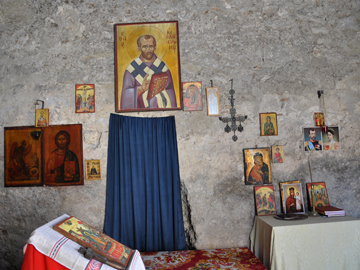
The village of Gerace was a great discovery. The road along the Ionian coast is a narrow, heavy trafficked, two-way local that goes through every town between Reggion and Crotone. It’s not necessarily a pretty road given that the railroad sits between it and the sea. We wanted to go to Gerace, but we knew we would have to deal with E90 and therefore we had to push ourselves to grit our teeth and make the drive.
You can see Gerace, sitting on top of its mountain. Gerace is perched atop a 500 m vertical rock. From the E90 and we kept thinking that it was going to be a miserable uphill drive. The road turned out to be fine. The village of Gerage was another WOW. This is an excellent example of Magna Graecia – Greater Greece. Gerage was at one time the central Greek village governing this entire area of the Ionian coast.
 We parked at the very top and walked into town. From the parking lot you look out at the mountain massif of the Aspromonte – a volcanic mountain range in central Calabria. The town’s leaning is Byzantium not Rome. The cathedral and other small churches look like the churches I saw in Jerusalem, not the Latin churches of Italy. The cathedral had a great display of religious art – monstrances, chalices, and statues all made of precious metals. Even the vestments on display were sewn in gold and silver. The main piazza is circled by three ancient byzantine churches. The smallest had all these icons. It looked like no other church I had been to in Italy. The largest in the group was no longer an active church and the sanctuary was all in-laid marble. Again nothing Latin about it. The windows were like those in the Crusade churches in Jerusalem. It was very disorienting, you had to keep reminding yourself that you were in Italy and not the Middle East. Take a look at the pictures of the king and queen on the wall to the right of the icon. Who are they and what are they doing in a church in the heart of Calabria. Also two of the churches we went into had domes made of inverted, terracotta roof tiles. Different.
We parked at the very top and walked into town. From the parking lot you look out at the mountain massif of the Aspromonte – a volcanic mountain range in central Calabria. The town’s leaning is Byzantium not Rome. The cathedral and other small churches look like the churches I saw in Jerusalem, not the Latin churches of Italy. The cathedral had a great display of religious art – monstrances, chalices, and statues all made of precious metals. Even the vestments on display were sewn in gold and silver. The main piazza is circled by three ancient byzantine churches. The smallest had all these icons. It looked like no other church I had been to in Italy. The largest in the group was no longer an active church and the sanctuary was all in-laid marble. Again nothing Latin about it. The windows were like those in the Crusade churches in Jerusalem. It was very disorienting, you had to keep reminding yourself that you were in Italy and not the Middle East. Take a look at the pictures of the king and queen on the wall to the right of the icon. Who are they and what are they doing in a church in the heart of Calabria. Also two of the churches we went into had domes made of inverted, terracotta roof tiles. Different.
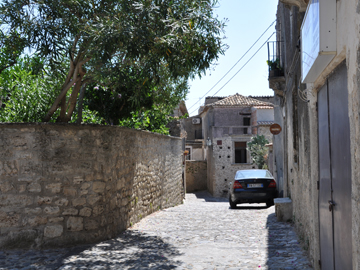 Gerace was unspoiled by tourists and visitors. The small shops that carried souvenir type items were free of the clutter I associate with tourist traps. We couldn’t get over how beautiful the city was; how clean and well maintained it was. It was a city that people took pride in. It was a city with few abandoned buildings. It was a city of lush garden plots attached to houses. (In Aprigliano, the best they could do was cultivate the slopes nearest their homes and even then many of the gardens were quite distant from the house.) In Gerace, it seemed that every house had as attached walled garden. And these gardens were full of grapes and figs and pomegranates. It made for a beautiful sight to have the green hanging over the hundred year old stone walls. You knew that Gerace was a living city. In addition to the gardens there were the modern cars. Nothing ostentatious, but nothing banged up battered.
Gerace was unspoiled by tourists and visitors. The small shops that carried souvenir type items were free of the clutter I associate with tourist traps. We couldn’t get over how beautiful the city was; how clean and well maintained it was. It was a city that people took pride in. It was a city with few abandoned buildings. It was a city of lush garden plots attached to houses. (In Aprigliano, the best they could do was cultivate the slopes nearest their homes and even then many of the gardens were quite distant from the house.) In Gerace, it seemed that every house had as attached walled garden. And these gardens were full of grapes and figs and pomegranates. It made for a beautiful sight to have the green hanging over the hundred year old stone walls. You knew that Gerace was a living city. In addition to the gardens there were the modern cars. Nothing ostentatious, but nothing banged up battered.
Scilla boasted all this rehab work. There were signs everywhere of officially sanctioned restoration. Gerace on the other hand had no official signs, but the whole village had been restored in a lived-in style. (Assisi is the Disneyland of religious destinations – pretty but sterile.) Gerace has real people living out their day-to-day lives in one of byzantiums old centers.
On September 24, I am heading up to Maine to take pics.
The itinerary is to go from Boston up to Portland driving along the coast.
The last time I was in this part of the country I was in college and it was late March early April. A group of us drove from NYC to Boston to Quebec City. What I remember of Maine is tunnels of snow-covered fir-trees. We had left New York City full of spring. Boston was overcast and dreary. Maine was scary. Giant firs looming over us. I still remember thinking – the trees are going to fall over and bury us, the car battery is going to die, it’s getting dark, I hate winter . . . Ah! the joys of college.
Quebec City wasn’t much better. One night we were walking on the Plains of Abraham, a historic site in the city, and it began to snow. April snows in Canada are never easy. You’re exhausted from the long months of winter-white and here comes more snow. I had on loafers and my feet froze.
This time I get to revisit Maine with my friend John who actually knows where he’s going. And I get to stop and shoot pictures. He’s supposed to paint, but I haven’t gotten a firm yes on this.
A Side-note
After Calabria, I realized I needed a camera case with wheels. I really like the one I have, but it’s miserable lugging it around. At Rome Fiumicino, I swallow my pride, found a cart and used it to wheel the camera case around. So this will be my first outing with a new, wheeled case.
The Sunday Times, in the travel section, had an article on Maine . It was about the small town where Winslow Homer spent his years painting the Maine coast.
I’ve gotten away from shooting nature, I removed the nature title from the header on the website and replaced it with structures. I’m curious to see what I’m going to do with Maine and its nature. My hope is to find the lines in the rugged coast and to present the landscape as structures. My reference for this approach are the images of Panarea. There too I was stuck in nature, but the images are of structures, volcanic monoliths pushing away the blue and the green. I concentrated on the sun on the rock-face, the white-waves of streaking motorboats, the verticals of sailboats, the pitch of sun-umbrellas, the flat blue horizon, the white-washed housing. I need to find their counterpoints in Maine.
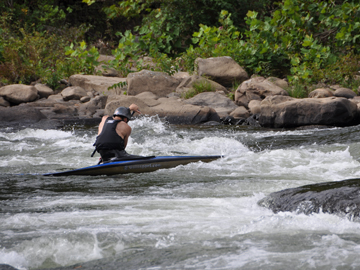
For the time I will be in Maine, the forecast for the area is not sunny. I’m witing this, because I’m slowly learning that the photograph-image can still look OK. I was out at Ohiopyle a couple of weeks ago and I shot at the water’s edge, as a matter of fact I shot kayakers in the rapids. The sky was overcast, and yet you would never know that from the images.
 The image of the kayaker has the following information: f/5.6 and a shutter speed of 1/640. I miss the brilliance of the sunlight, but I can still get a decent image.
The image of the kayaker has the following information: f/5.6 and a shutter speed of 1/640. I miss the brilliance of the sunlight, but I can still get a decent image.
Slowly, I am understanding how light factors into an image. Earlier I was working on a sunset and as pretty as the image was, it lacked a clear light source. Rather the light was all diffused behind the clouds and the mountains which gave me a great sunset shot, but made the overall image static. Being able to identify the light source gives an image a direction and a focus that the eye can go to. (This is probably a convoluted comment and most professional photographers would have all the right words to express this. I don’t.)
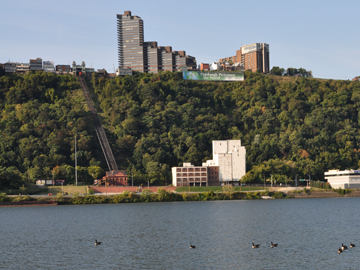
While the G20 meets here, I’m heading out to Maine. This morning I went out shooting only to find town mobbed with workers getting ready for the G20, so I headed to the North Shore. I found the great sign up on Mount Washington and decided to shoot it.

This image gives a wider perspective – the ducks, the river, the incline, the mountain and the high-rises that sit on top. The sign is like a base to the structures.
The ducks are there to remind me that no matter if the world is coming to town, Pittsburgh will always be low-key. Last night a friend described the kind of med-students that come to Pittsburgh. She said they are hard-working and smart. Then there is a group that scores well on their tests, but will not come here because it’s Pittsburgh. These gravitate to Boston and San Francisco. The comment was said with some regret and I didn’t care. My feeling is if you want to go and pay to live in Boston and San Francisco and still get the same education, go and good luck.
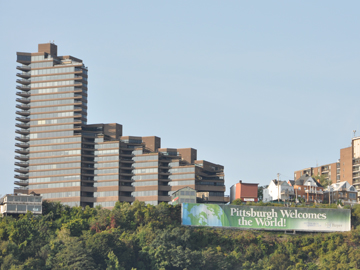
This image on the right is the sign – Pittsburgh Welcomes the World. I get to watch all this from a distance. As the world heads to the confluence of the Allegheny and Monongahela Rivers, I’m heading east.
One of the things we are going to do is travel the back-roads. I always like traveling the back-roads. In Italy the back-roads with their 90 degree turns and cliff hanging vistas drive Rose crazy. This summer, I was reluctant to travel the back-roads, because I was by myself and didn’t have the courage to go it alone. However, when Mario drove to Paola using the back-roads it was great fun. When we went to visit Aurelio using the back-roads it was amazing.
On Thursday, I get to head to the back-roads of Maine.
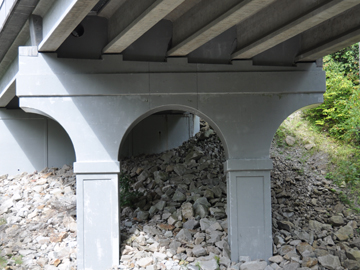
Since Calabria, I have invested in a new camera case with wheels and a small luggage cart. Tonight I tried packing my camera equipment into the new case, but I don’t like it. Also this trip doesn’t have the lay-overs of the trip to Lamezia, so I’m going to use my large shoulder bag. The luggage cart will be fine; I tried it out.
But, I’ll carry the case. Again I’m going from home to the airport, to the gate and then I’m getting picked up at the other end. I also learned in Rome that an airport luggage cart is fine. Once I swallowed my pride and started using the airport luggage cart, having the shoulder bag was not a problem.
The weather for south-eastern Maine is variable, it’s a wait and see thing.
Shooting in Maine

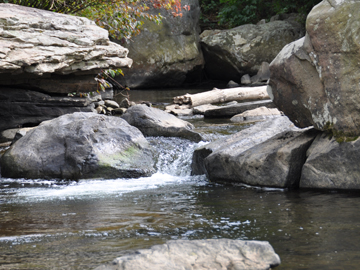
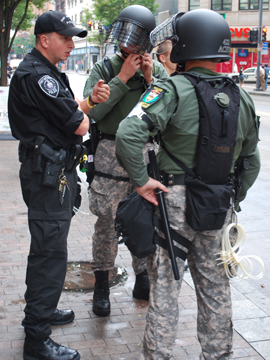
In anticipation of the G20, town was crawling with police. Around noon a battalion of storm-troopers was deposited on Liberty Avenue. From the Point all the way up to Seventh Avenue storm-troopers were stationed – two on either side of the street across from each other.

And I’ll be away during this whole time.
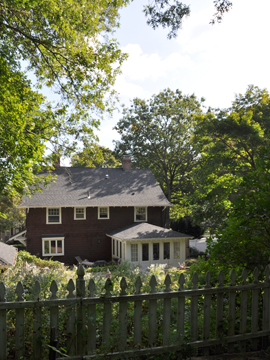
 I arrived at Logan and Mac picked me up. He drove to Reading and I got to visited with Bev. They have this great house and I had a chance to shoot it. The pic here is probably one that neither of them would have thought of, but finding the picket fence at the top of their back yard, a picket that is strictly ornamental, gave me a great vantage point. I don’t know if they think of their house as having this look.
I arrived at Logan and Mac picked me up. He drove to Reading and I got to visited with Bev. They have this great house and I had a chance to shoot it. The pic here is probably one that neither of them would have thought of, but finding the picket fence at the top of their back yard, a picket that is strictly ornamental, gave me a great vantage point. I don’t know if they think of their house as having this look.
It was fun shooting this old New England house. I think of it as standing alone in a field, so I tried to shoot it in a way that isolated it from its neighbors and placed it in the background. The picket fence fools the viewer into thinking that there’s nothing else around, that the house is far in the distance. Oh yes, this is the back of the house and because the yard is on a slope it was easier to capture a far-away look.
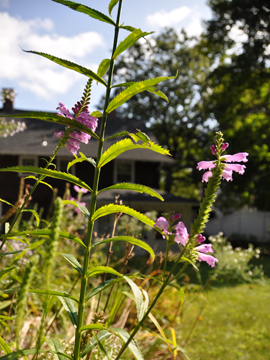 I also discovered a fall flower-garden, in front of the picket, that allowed me to shoot the house out of focus and in the background. For me, the flowers were farmish and added to the isolation and far-away look. To get this shot I lay on the ground as close to the flower as I could get and still keep it in focus. (I always worry that someone will see me on the ground and wonder what the hell I’m doing. If I had had more time and if I was thinking, I should have changed to the wide-angle lens and shot the flowers very close.)
I also discovered a fall flower-garden, in front of the picket, that allowed me to shoot the house out of focus and in the background. For me, the flowers were farmish and added to the isolation and far-away look. To get this shot I lay on the ground as close to the flower as I could get and still keep it in focus. (I always worry that someone will see me on the ground and wonder what the hell I’m doing. If I had had more time and if I was thinking, I should have changed to the wide-angle lens and shot the flowers very close.)
The inside of John and Bev’s house is beautiful, but it was all mixed up, because they’ve been renovating and I didn’t feel right shooting it in its present state, even though I really wanted to. I love what homes looks like when we’re in the middle of change; the rocking chair we cover; the pictures we lean on furniture; the small, blue vase we keep with fresh flowers even if it is surrounded by plaster-dust.
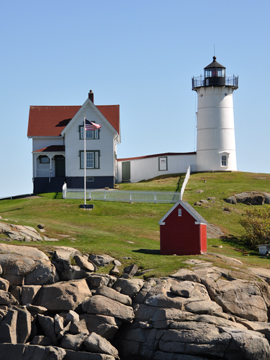
We left Reading and headed north on I-95. (I remember using I95 to get back and forth between New York and DC, New York and Providence, New York and Boston. Back then it seemed the only route through the north east.) We were on our way to Maine, to Ogunquit to be exact.
 Our first stop was to see a lighthouse outside of Ogunquit. The image is deceptive, because the lighthouse is on an island that visitors cannot access and there is a channel between the island and the visitors parking lot. This was my first look at the Maine seacoast – a rugged thing with stone fingers poking out into the cold Atlantic.
Our first stop was to see a lighthouse outside of Ogunquit. The image is deceptive, because the lighthouse is on an island that visitors cannot access and there is a channel between the island and the visitors parking lot. This was my first look at the Maine seacoast – a rugged thing with stone fingers poking out into the cold Atlantic.
My great worry with this trip was that I would not be able to figure out how to shoot nature as structure and what I found was that south eastern Maine is man-made; it has been conquered even if temporarily. Man has built beautiful structures on the rugged stones that cut into the mighty Atlantic. This lighthouse is about man building in the elements, man controlling for the violence of Neptune. The white is as bright as any wash in Panarea.
The structures here in south-eastern Maine are elegant, minimal and strong, because they have to live with the winds off the Atlantic. There is no room for embellishment, for Victorian gewgaws, a hurricane would make short shrift of any and all appendages. Even the colors used to paint the wooden structures are minimalist – pigment is used sparingly. But the red roof, the red building can be seen for miles.
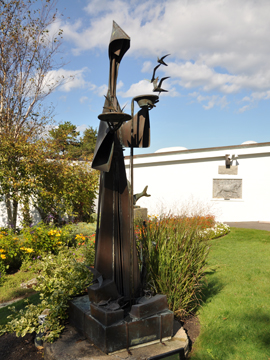 Francis of Assisi in Maine, there’s a non sequitur. On our way into Ogunquit I saw a sign for a Franciscan Monastery and asked Mac to pull in. He said he had wanted to see the grounds for a while but had never stopped. The place had a 1950 retreat house, much like the novitiate Mac and I lived in at Narragansett, an old mansion that was converted into a chapel, and the grounds had devotional places where the faithful could stop and pray.
Francis of Assisi in Maine, there’s a non sequitur. On our way into Ogunquit I saw a sign for a Franciscan Monastery and asked Mac to pull in. He said he had wanted to see the grounds for a while but had never stopped. The place had a 1950 retreat house, much like the novitiate Mac and I lived in at Narragansett, an old mansion that was converted into a chapel, and the grounds had devotional places where the faithful could stop and pray.
The chapel was a beautiful example of 1970’s Catholic design, a legacy to Sister Corita Kent the artist whose works became the symbols of the social upheavals of that period.
The sculpture of Francis was at the Ogunquit museum. What are two references to Francis doing in Maine, they’re supposed to be in Italy. The sculpture was a great find and a great surprise, because it captures the simplicity and power of that simple man from Assisi.
The sculpture is a fountain. The birds light on the bowl and drink. The water drips down gently from the bowl into the earth. The vertical lines are rigid and pull the eye up into the sky. Eventually it will patina green and blend into the landscape.
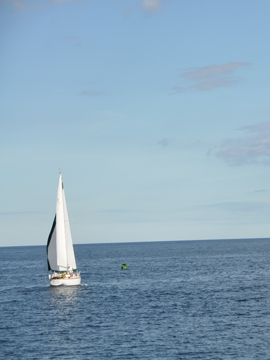 While at the museum I went out into the gardens facing the Atlantic and saw a sailboat going out, so I started shooting. Only later looking at the pictures on the laptop did I discover the stripe on the sail. I’ll never understand people who leave the land and go out into the sea. (Remember, I came from a medieval hilltop town.) So I always look at sailboats as structures in a sea of blue.
While at the museum I went out into the gardens facing the Atlantic and saw a sailboat going out, so I started shooting. Only later looking at the pictures on the laptop did I discover the stripe on the sail. I’ll never understand people who leave the land and go out into the sea. (Remember, I came from a medieval hilltop town.) So I always look at sailboats as structures in a sea of blue.
Sailboats were everywhere, but so were the working boats of local fishermen going out every morning to where the ocean is deep. As a land-person I can’t picture what it must be like to be in the middle of blue vastness having no idea if there are fish below when bringing back fish is your livelihood your family’s income.
What was surprising was the green stripe on the one sail. I don’t think I saw it white shooting, rather for a split second, the wind turned to sail enough to get the stripe. The buoy to the right of the sail boat was a light green and nice contrast to the dark green stripe. The image, for me, is also about loneliness and fear two words I don’t combine when thinking about land-side environments.
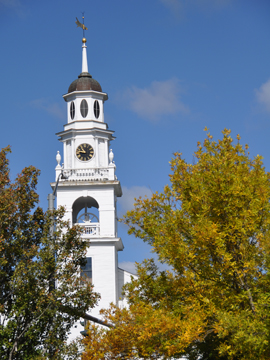
 On Friday morning we headed out of Ogunquit going north, through the back roads, towards Kennebunk. We stopped for breakfast at this famous Maine diner and on the menu were baked beans. Baked beans for breakfast, I had to have them and they were good.
On Friday morning we headed out of Ogunquit going north, through the back roads, towards Kennebunk. We stopped for breakfast at this famous Maine diner and on the menu were baked beans. Baked beans for breakfast, I had to have them and they were good.
Kennebunk has this great church in the center of town. It was the biggest of the Maine churches and steeples that I had shot. And like all the other churches it too was surrounded by a graveyard. The steeple, above the main tower-base, had five sections to it. The first of the five sections had a large bell-wheel in it. The next sections had a clock – four clocks, one at each cardinal point. A weather vane on a pole topped the steeple no cross marker for these New Englanders.
So why are all these churches painted white? Here’s the answer – White paint was associated with the color of stable, enduring classical buildings; white spoke the language of virtue and simplicity. White proclaimed prosperity and class consciousness. White paint was more expensive to produce than colored paint; it was recognized as the tint of wealth. (Imagining New England, by Joseph Conforti)
Kennebunk seems to be a year-round community. I mention this, because so much of south eastern Maine had a seasonal quality to it. It was hard to imagine these beautiful wooden homes being used year-round, especially given the winter and the proximity of the sea. However, Kennebunk had many, many brick homes. As a matter of fact it had the look of a rich suburban community with cul-de-sacs and housing plans.
..
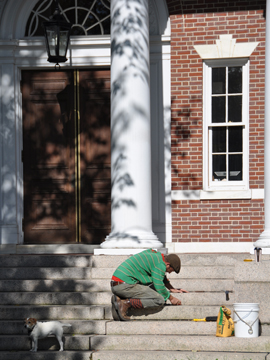
 The New Englander in his green striped sweater and gentleman’s cap worked to repair the steps of the stately Kennebunk Public Library. His dog didn’t bark or run at me as I shot the pictures. (The man was smoking a pipe as he repaired the caulking.)
The New Englander in his green striped sweater and gentleman’s cap worked to repair the steps of the stately Kennebunk Public Library. His dog didn’t bark or run at me as I shot the pictures. (The man was smoking a pipe as he repaired the caulking.)
The library parking lot was full of cars. And non-working, blond women went in and out carrying colorful bags full of children’s books. (Am I reading too much into the actions of these simple people?)
..
Across the street a school of children, dressed in period garb, re-enacted some old, colonial pageant. (We’re too far north for this to be Salem.)
..
In Calabria they re-enact the medieval walk to the holy site, all the while chanting words of pleading:
Santa Maria, Madre di Dio,
prega per noi peccatori,
adesso e nell’ora della nostra morte.
The composition of this image probably reflects my prejudices – the worker bent under the white column of power and power represented by classical architecture. However, there is some hope, he gets to have his dog even if the dog is in the shadows.
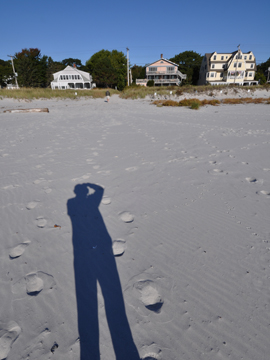
 Before we left for Portland, we headed over to the beach at Kennebunkport and I got to shoot in the morning light.
Before we left for Portland, we headed over to the beach at Kennebunkport and I got to shoot in the morning light.
The sun is behind me and Mac is ahead at the edge of the beach-grass. (I’m wrapped up in as many layers as I could find, one that I had just purchased. He’s wearing shorts. Go figure!) It was low-tide and the beach was this huge expanse – wet sands in various hues of water saturation. I don’t remember seeing that kind of expanse anywhere in the Mediterranean. The only other place that had a vast stretch of sandy beach was the Pacific near Los Angeles.
I hate having my picture taken, but I discovered that I’m OK with shooting shadows. As a matter of fact, I have a whole collection of me in shadow.
The beach is sprinkled with people up early, walking alone, walking and holding hands, running with golden retrievers, and two old men, one tall and in shadow, the other in shorts and a sleeveless vest. The sands at my feet are littered with prints reminding the morning guests of last night’s lovers.
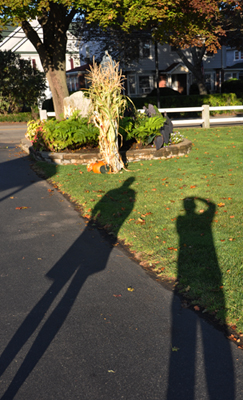
This post was written on Sunday, December 15, 2013.
I was going through the website removing all the image links and when I got to the maine 2009 category, I wanted to add to it. I wanted an image of Mac and I and I wanted to tell the story since then.
The trip to Maine was one of my first with camera in tow and the maine 2009 group of posts one of the first journal categories. The time with Mac was wonderful and yet six months after we got back we stopped talking. It’s been 4 years since I last talked to my old friend.
 I first met Mac in June of 1968. I was a young man from Northern Ontario who had landed in Narragansett at the Christian Brothers Novitiate. We began to spend time together and by July 4, Mac, Bobby, Steve and I sneaked out of the Novitiate and walked down to his family’s summer home. It was such a simple walk and yet in retrospect it was a very daring thing – to leave the enclosure of the monastery without permission. I think that first excursion, that first breaking of the rules, set up the parameters that I would continue to use when thinking about Mac. But what I’ve come to accept in the last four years, in the silence of that time, is that Mac was never the rule-breaker. He may have led us down to his family’s 4th of July celebration, but he was not the proud rebel. He was a homesick young man.
I first met Mac in June of 1968. I was a young man from Northern Ontario who had landed in Narragansett at the Christian Brothers Novitiate. We began to spend time together and by July 4, Mac, Bobby, Steve and I sneaked out of the Novitiate and walked down to his family’s summer home. It was such a simple walk and yet in retrospect it was a very daring thing – to leave the enclosure of the monastery without permission. I think that first excursion, that first breaking of the rules, set up the parameters that I would continue to use when thinking about Mac. But what I’ve come to accept in the last four years, in the silence of that time, is that Mac was never the rule-breaker. He may have led us down to his family’s 4th of July celebration, but he was not the proud rebel. He was a homesick young man.
Mac left the Brothers, went to graduate school, married, bought a house, had a son, worked and retired. His immigrant friend from Northern Ontario revealed himself to be the true rule-breaker. The old friend took a different path and continued to tarnish the golden rule.
When I remember Mac, Leonard Cohen’s song One of Us Cannot Be Wrong always comes to mind.
I lit a thin green candle to make you jealous of me, but the room just filled up with mosquitoes, they heard that my body was free. Then I took the dust of a long sleepless night and I put it in your little shoe. And then I confess that I tortured the dress that you wore for the world to look through. I showed my heart to the doctor; he said I’d just have to quit. Then he wrote himself a prescription and your name was mentioned in it. Then he locked himself in a library shelf with the details of our honeymoon. And I hear from the nurse that he’s gotten much worse and his practice is all in a ruin. I heard of a saint who had loved you, so I studied all night in his school. He taught that the duty of lovers is to tarnish the golden rule. And just when I was sure that his teachings were pure he drowned himself in the pool. His body is gone, but back here on the lawn his spirit continues to drool. An Eskimo showed me a movie he’d recently taken of you. The poor man could hardly stop shivering, his lips and his fingers were blue. I suppose that he froze when the wind took your clothes and I guess he just never got warm. But you stand there so nice in your blizzard of ice, O please let me come into the storm.
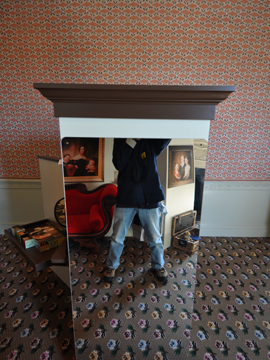
 After the emptiness of the coast we headed to Portland. The ride along Route 1 was the beginning of the return to the real world of asphalt, stop signs and traffic jams. We did stop to shoot at Calvary Cemetery. What was great about the shoot was that I kept the wide-angle lens (12 – 24 mm) and that got me to go up to the subject and shoot it close, real close. It’s my favorite lens, because it forces me to approach the subject – to almost touch it. On a practical level, the lense produces the least amount of distortion.
After the emptiness of the coast we headed to Portland. The ride along Route 1 was the beginning of the return to the real world of asphalt, stop signs and traffic jams. We did stop to shoot at Calvary Cemetery. What was great about the shoot was that I kept the wide-angle lens (12 – 24 mm) and that got me to go up to the subject and shoot it close, real close. It’s my favorite lens, because it forces me to approach the subject – to almost touch it. On a practical level, the lense produces the least amount of distortion.
I used the wide-angle lens in the Portland Art Gallery a wonderful place. Part of the museum is the McLellan House. “The McLellan House (1801) is the product of a post-Revolutionary building boom, fueled by the revival of an energetic maritime economy, that transformed Maine’s coastal towns and cities. In October, 2002, the Portland Museum of Art reopened to the public the fully restored Federal-era building.”
The house has no original furnishings but has kept the designated areas – dining room, parlor, foyer. One of the rooms was the play area for the children, and there I found the mirror.
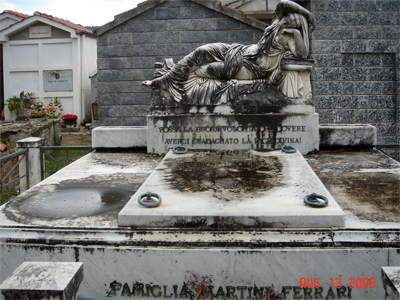
November the Second has always been a melancholy day. My first memory of this Day of the Dead is going with my family to the cemetery in Aprigliano. I was with my parents and someone gave us a ride. As a little kid, the ride felt long. On the way, I remember seeing a road-side memorium and I remember the tall cypress trees that ringed the cemetery. (The trees have been such an enduring memory that at one point I tried to plant a cypress in my backyard. The grower at the greenhouse discouraged me, saying this part of the country did not have the right climate for cypress. Pittsburgh is too wet for this genus of tree.)

The other thing I remember from this long ago time is the Famiglia Martini Ferrari monument. It was the most notable grave site in a country cemetery. All my relatives were in small brick-and-mortar graves. I’ve kept this image, of a woman reclining with a set of books as her pillow, in my mind all my years. And when I was back in Aprigliano in 2006 and we had our own car and we could go to the cemetery, this is one of the first graves I went looking for. I also discovered that the cemetery in my mind was now the “old section.” There is some creeping of the new in the back of the monument. Cinder blocks were not in use back in the early 50’s for mausoleums. In memory it stood alone dwarfing everything around it.
Rose took this shot. It was before I began to pay attention to photography.
The monument in my mind is all white marble, there is no staining, no water puddles on the top.
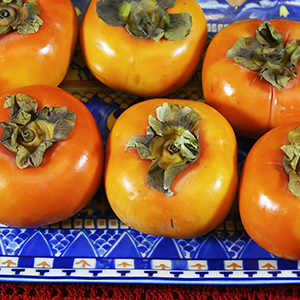
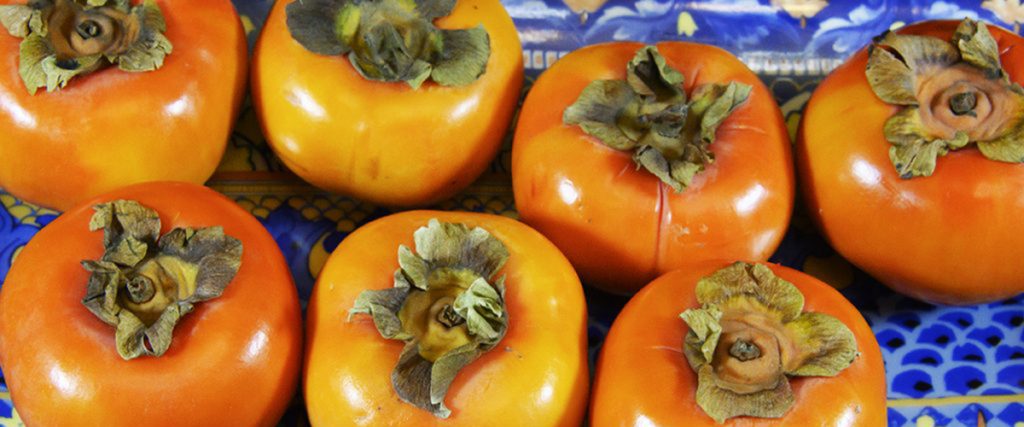
My very first American Thanksgiving was November 28, 1968.
I was living at the Christian Brothers’ Novitiate in Narragansett, Rhode Island and our Director of Novices – John Veale – decided that the novices could go home for the holiday. The five of us from Canada were each paired with a novice who lived local and went to their homes for the holiday. I went to John’s house in Warwick.
Subsequent Thanksgivings have continued to be happy occasions.
My family and relatives observe Canadian Thanksgiving and know little of American traditions associated with the holiday. And having come to this holiday as a foreigner, I have none of the built-in obligations, so I can just enjoy the time off and the visit with friends.
The foods associated with the Thanksgiving meal still hold no interest for me. For the last twenty-some years we’ve spent the holiday with our friends Jerry-and-Diane and their family. And if you had a pic of my dish at today’s meal, it only contained stuffing, cranberry relish, carrots and corn.
This post was originally written on Thursday, November 28, 2019. I re-purposed it when I wanted to create the thanksgiving category. It’s a good intro into this newest grouping.
The image is of persimmons in a Portuguese dish; it’s a fruit I like displayed on a foreign dish.
I’m going back up to Harrow, Ontario this coming week-end. It’s Rainer’s 60th birthday and he and Lynne are throwing a party.
When we got together last summer, it was the time of walking through the corn-fields in the moonlight, holding on to Lynne, because I had no idea where we were and was certain that if I didn’t hold on, I’d never find my way out of the corn.
It was also the summer of the cats and learning from Lynne how they lived in the wild and how she took care of them. I’m curious to see how many are left.
It was also the visit where I sat on their lawn transfixed by the fireflies. There are images that I carry in my head, some wonderfully romantic, some exceptionally beautiful, some emotionally scary and some delibitatingly sad. The fireflies lifting into the air is one of the beautiful.
As I’m writing I realize I don’t have one image to post. The visit was still at a time where I was self-consious of walking around with a camera. Maybe this time, I’ll be a bit more brave.
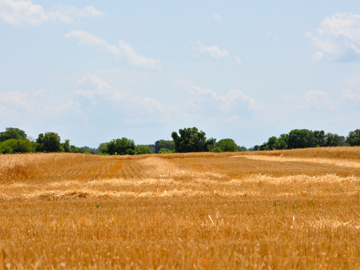
In July when I was here to visit and play golf with the boys, the area was gold with grain.
 I remember just stopping in the middle of a country road and shooting the wheat field. The area is very flat and fields and farms stretch to the horizon. (In Pennsylvania, fields stretch to the next rise.) I had no idea where I was and Rainer literally talked me through getting to his farmhouse. It was only my second visit and I wasn’t paying any attention to directions. All I could see were swatches of color that I wanted to capture. And I was still unsure and reluctant with the camera.
I remember just stopping in the middle of a country road and shooting the wheat field. The area is very flat and fields and farms stretch to the horizon. (In Pennsylvania, fields stretch to the next rise.) I had no idea where I was and Rainer literally talked me through getting to his farmhouse. It was only my second visit and I wasn’t paying any attention to directions. All I could see were swatches of color that I wanted to capture. And I was still unsure and reluctant with the camera.
However, I still stopped and just shot. In the image on the left, the line of trees in the distance was nothing more than a demarcation, separating the blue and the gold. It’s now, six months later, that I even know there are trees in this flat terrain of south-western Ontario. And now six months later, the gold and green are gone and what remains is the brown bareness of this prairie landscape. Winter here in the southern most point of Canada is still desolate.
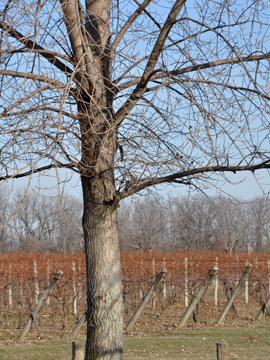 I got to Windsor by 4:00 and pulled over at the Ontario Travel Bureau to call Rainer. I noticed that the office was open, so I decided to go in and get maps of the area. I have a GPS, but I’m not familiar enough with the area to trust myself to driving around. Also, I didn’t want to get caught in some country road after sunset GPS or no GPS.
I got to Windsor by 4:00 and pulled over at the Ontario Travel Bureau to call Rainer. I noticed that the office was open, so I decided to go in and get maps of the area. I have a GPS, but I’m not familiar enough with the area to trust myself to driving around. Also, I didn’t want to get caught in some country road after sunset GPS or no GPS.
The woman was very helpful and suggested a wine tour for Saturday. She also gave me a great map of the area that showed all the roads and situated Rainer’s house in the middle of this vast farm area.
When driving in a new area, I’m never sure that I haven’t passed my turn off. It was very hard to drive down Howard Road – a very long north/south corridor – and not worry that I had missed the right turn onto Rainer’s road. I forced myself to keep driving hoping that I would find the turn off and that it would be well marked. It was.
Along the way I shot a Greek Orthodox church, a cemetery and a vineyard with its bare vines. The wind howled as it ripped through the naked grape tendrils and the rust colored vines were a red haze behind the bare tree.
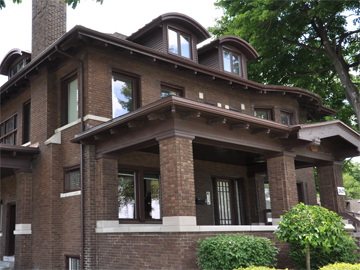
Frank, Norma and I spent Saturday “in the county” as the locals refer to the area. Neither of them had even been to Windsor. We drove down and I took them through the University campus, showing them the house I lived in the year I was there.
 This is the house that I lived in back in 1969/70. I had finished my year at the novitiate in Narragansett, Rhode Island and returned back to Canada and Windsor for university. I shared one of the third floor dormer rooms with a young man who was not a monk, but was living in the house, because he had gone to the Brothers’ high school in Toronto. His bed was in the right alcove you see and mine was in the alcove facing the river. I hated living in Windsor. I remember thinking that Sault Ste Marie was a better place to live than this miserable city on the Detroit River. And I knew nothing of the farm area that 40 years later I would visit to hook up with old childhood friends.
This is the house that I lived in back in 1969/70. I had finished my year at the novitiate in Narragansett, Rhode Island and returned back to Canada and Windsor for university. I shared one of the third floor dormer rooms with a young man who was not a monk, but was living in the house, because he had gone to the Brothers’ high school in Toronto. His bed was in the right alcove you see and mine was in the alcove facing the river. I hated living in Windsor. I remember thinking that Sault Ste Marie was a better place to live than this miserable city on the Detroit River. And I knew nothing of the farm area that 40 years later I would visit to hook up with old childhood friends.
The house was on campus and it was the Christian Brothers center at the University of Windsor. The best part of living here was the cook. She made the best desserts. But even that couldn’t keep me in Canada and at the end of freshman year I transferred back to the United States and joined the New England/New York branch. This was the group that ran the novitiate and had the kids that I had become friends with. I’ve never regretted leaving the Canadian province of the Christian Brothers and settling in the United States.
The house is now a suite of offices for the Theology Department of the University of Windsor. (I wonder what they have in the ball room? When I lived there it was our chapel.)
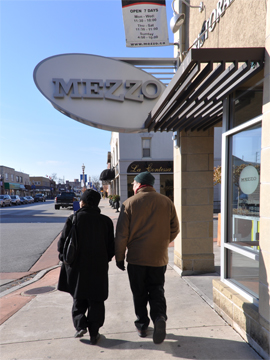
I knew there would be little time to spent with Rainer on Saturday after all it was his birthday party and he and Lynne were hosting a large group, but I made sure to get to his house on Friday and visit with him. I knew I would have more time with Frank and Norma and with Gabriele – Rainer’s sister and the person whose house the three of us stayed at.
It was very nice to visit with Gabriele again. She was part of the group that grew up together all those years ago in Sault Ste Marie. Gabriele is a nurse who has worked all over the world for Médecins Sans Frontières for the last 20 years. The four of us spent both Friday night and Saturday, after the party, talking and talking and talking. It was familiar, comfortable and great fun.
Gabriele is slowly renovating her parents’ home and making it her own. Both Mr. and Mrs. Pahl, two people I remember fondly, have passed away. I spent many outings with the Pahl family going fishing in the small streams around Sault Ste Marie. I remember climbing the low, northern Ontario mountains collecting blueberries. Mr. and Mrs. Pahl never got lost. Mrs. Pahl taught me to play chess and she gave me some World War II book to read that was a seminal experience for me, because for the first time I knew what Europe and my parents and Rainer and Gabriele’s parent went through.
They were always very welcoming and their apartment was a retreat, a place with intelligent people who talked to us as intelligent young men and women. It was also the first place where I saw modern furniture. The Pahl’s apartment was decorated with sleek, teak furniture. No one else I knew had this type of chairs and sofas. My parents decorated in French provincial.
After breakfast, Frank, Norma and I went down to Windsor and first we drove along Riverside Drive next we went to Little Italy and window shopped and had lunch.
 The pic is typical of what I shoot – Frank and Norma walking down Erie Street, the Little Italy of Windsor. The street was empty. We being city people couldn’t understand why. A similar street with great restaurants and specialty shops in either Toronto or Pittsburgh would be teaming on a week-end close to Christmas. Instead we had the place to ourselves. I believe this is because in Windsor this is a local street for the people who live in the area. We stopped in a small grocery store and it was busy with people who lived in the neighborhood.
The pic is typical of what I shoot – Frank and Norma walking down Erie Street, the Little Italy of Windsor. The street was empty. We being city people couldn’t understand why. A similar street with great restaurants and specialty shops in either Toronto or Pittsburgh would be teaming on a week-end close to Christmas. Instead we had the place to ourselves. I believe this is because in Windsor this is a local street for the people who live in the area. We stopped in a small grocery store and it was busy with people who lived in the neighborhood.
We did manage to find a place for lunch and being true city nerds we had to find another place for dessert and espresso. I always enjoy spending time with Frank and Norma. We fit well after all these years and can enjoy hours together. (The pic is unique, because on the cloth sign above the MEZZO marquee is an ad and the script spells Mario.) After dessert we headed back to the county and visited one of the wineries – D’Angelo Estate.
The birthday party was well attended. I didn’t realize how big their renovated farmhouse is until I saw it full of people and there was still room to walk around. We were there for about 4 hours. Got to visit a bit with Ron and met a friend of Gabriele whose grandmother had the original Crown deed that granted the family the land they farmed. Also got to meet Rainer’s brother in law, he and his wife are the present generation farming the land. He said that a farmer needs between 600 and 800 acres in order to make a living off the land. (There’s a tipping point Malcolm Gladwell hasn’t considered.)
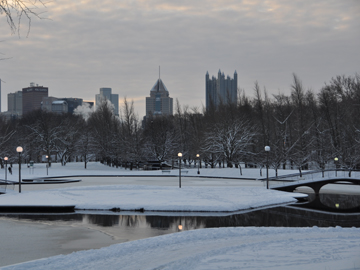
On Saturday, we got 6 inches of snow and on Sunday I went out and shot pictures, especially of West Park. I really like shooting snow landscapes.
 I also began shooting in Manual. (Not sure why or what prompted me, but I turned the dial to M and have left there.) Walking to the park, I was hoping for the sun, but it never came out. Pittsburgh in December is colorless. It reminds me of Narragansett all those years ago when there was no let up from the grey Atlantic, and the grey skies. Even Christmas Eve in the monastery chapel with its songs, candles, liturgy and friends was bleak.
I also began shooting in Manual. (Not sure why or what prompted me, but I turned the dial to M and have left there.) Walking to the park, I was hoping for the sun, but it never came out. Pittsburgh in December is colorless. It reminds me of Narragansett all those years ago when there was no let up from the grey Atlantic, and the grey skies. Even Christmas Eve in the monastery chapel with its songs, candles, liturgy and friends was bleak.
This year Christmas is on a Friday and for the first time since we opened City High, I decided to stay in town for a couple of days and head out for northern Ontario closer to Christmas day. (It also happened that neither of my cousins were available for our pre-Christmas get-together.) This change has meant that I’ve been home the last four days.
I’ve been unhappy that I haven’t been out doing more shooting, especially when I was driving into work and the morning sun bathed the rivers, so once home for vacation, I’ve gone out every day. Yesterday I did some follow-up shooting and began to notice the many doors decorated for Christmas so I turned the camera and photographed them. I found a great shot that ended up as the main image on the website. That shot suggested that I change the focus of the next gallery and make it all doors.
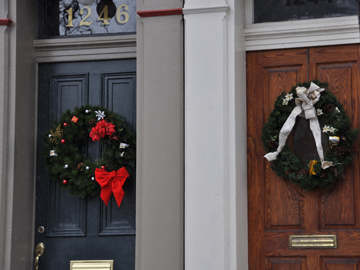 The shot is of two doors side-by-side with a wreath on each. It’s my kind of shot, a composition that is dark but unusual in its recognizable and mismatched ornamentation. I was amazed to get home and find this image. (I don’t know if all photographers have that wow experience when they see an image that they shot, that surprises them.) I don’t know what I like best, so I’ll list my wows – the red ribbon on the dark-blue door, the white ribbon on the wooden door, the placement of the two ribbons – one in the bottom right, the other on the top middle, the house number on the left door, the white trim on the wooden door.
The shot is of two doors side-by-side with a wreath on each. It’s my kind of shot, a composition that is dark but unusual in its recognizable and mismatched ornamentation. I was amazed to get home and find this image. (I don’t know if all photographers have that wow experience when they see an image that they shot, that surprises them.) I don’t know what I like best, so I’ll list my wows – the red ribbon on the dark-blue door, the white ribbon on the wooden door, the placement of the two ribbons – one in the bottom right, the other on the top middle, the house number on the left door, the white trim on the wooden door.
The other unusual thing is that I have no decorations in my house. I wonder if I’m compensating.
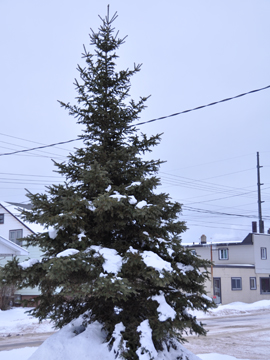
I headed out for the trip to northern Ontario on Wednesday with the goal of getting there Christmas Eve. (I do the trip in two shifts – Pittsburgh, Detroit/Detroit, Sault Ste Marie.) And the roads were great except once I crossed the Mackinaw, a bridge that I hate driving on, miserable winter hit and for the next 30 miles I was driving through snow blizzards and on snow-covered roads.
Once I got to my parents, the skies were grey and depressing, but I did go out and began to shoot.
 The pine tree is the first thing I wanted to shoot. It sits in my parents’ neighbors’ front yard, but it dominated both their house and my parents’. I remember it as a two floor dwarf and thinking it would never grow to anything worthwhile.
The pine tree is the first thing I wanted to shoot. It sits in my parents’ neighbors’ front yard, but it dominated both their house and my parents’. I remember it as a two floor dwarf and thinking it would never grow to anything worthwhile.
I also shot it, because in the background, on the right is the building where the Pahls lived. (This is where Rainer, Gabriele and their parents lived. Mr. Pahl worked at the Tube Mill and he liked being close to his job.) I have fond memories of visiting them in the second floor apartment. The two windows on the second floor were the kitchen.
Sault Ste Marie in the winter, covered in Christmas snow is pretty, deceptively pretty. In the white wonderland it’s easy to forget the isolation and remoteness of this northern Ontario own at the confluence of Lake Superior, Lake Michigan and Lake Huron.
The street where my parents still live and where the Pahls lived still has many of the same families that were there 40 years ago. However, the Pahls are gone, Rainer and Gabriele live in Harrow, I live in Pittsburgh and the Tube Mill has been taken over by a multinational – Tenaris.
..
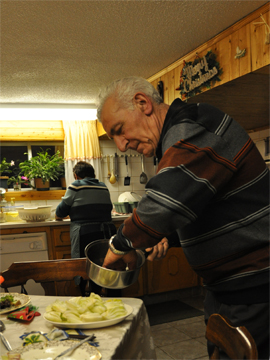
Christmas Eve is always at my aunt and uncle’s. The list included – Ciccio, Mafalda, (parents) Gina, Emilio, (aunt and uncle) Teresina, (uncle’s step mother) Rose, Derrick (cousins) and myself. Connie (my sister) was in Toronto and Mary, Domenic (cousins) and the kids are at Dom’s mother’s. I decided to take the camera and the audio recorded this year.
Rose and I had talked back in August, in Pellaro about getting the old stories from everyone and I promised to do that at Christmas. I’ll create a page in the People section of the webpage and add the recording from Christmas Eve. It was interesting to find out that back in Italy, in 1957, Mafalda had exchanged letters with Teresina hoping to meet up on the boat in Naples. Teresina was leaving Martirano and heading to Sault Ste Marie the same time the Zinga family was leaving Aprigliano and heading to northern Ontario.
The pic is my uncle – Emilio – and Mafalda is in the background doing dishes. Christmas Eve is one of my favorite meals. It’s still the ethnic meal of my childhood with pasta and sardines, rapini, curdurilli e sarde, and baccala. Other dished have been added to these staples, but I don’t eat them. The most notable change is the addition of other fish besides the cod. I hate cod and if I have to eat fish, I’ll try the others. Many people ask me about the Christmas Eve meal and the 7 dishes of fish. My answer is that the seven fish meal is a sea-town tradition. In the mountain-top towns, the only fish we would eat on Christmas Eve was cod and that’s because it was the cheapest fish to buy. But the cod prepared in at least three different ways – sauted in red sauce, sauted in a white sauce and baked. I hated it all.
In the pic, Emilio is dishing out the fennel. The main meal is over and we’re on the dessert. And yes, fennel is one of the dessert items; maybe even my favorite.
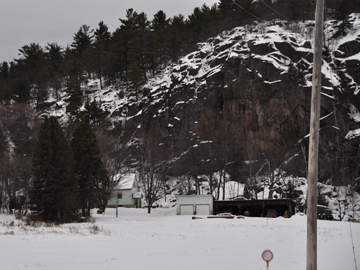
Christmas day I went to pick up Christian at the airport and on the way I had time to shoot in Prince Township.

The Township is a vast lake-plain bordered by low, red-rock mountains. The mountains are part of the Canadian Shield – a broad region of Precambrian rock that encircles Hudson Bay and extends to the Great Lakes. It’s always been one of my favorite areas to shoot. Friday was an overcast, dreary day. The image on the right is one of the most Photoshopped pics I’ve ever created.
I went shooting, because the plane was supposed to be late, but in the middle of my shoot I start getting text messages that the plane had landed followed by, “where r u? i’m waiting.”
The pic is of a house at the base of the mountain chain. The property is vast and there are 8 garage spaces.
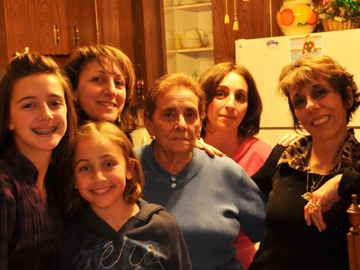
After dinner on Friday, I started taking people pictures. (I hate doing it, but I’m forcing myself and each time I learn something.) Many of the pics were not well lit, and it took me a while to find the best shutter speed and aperture measure. And when I did get my settings figured out, I began to shoot the women in the family.

Following a matrilineal path, these are the Savaia women – descendants of Maria Savaia my grandmother. Maria Savaia left Aprigliano and came to Sault Ste Marie in the early 50’s. (left to right) Seane, Alyssa, Rose, Mafalda, Mary, Connie. (Missing from the line-up is Gina, Mafalda’s younger sister, and Rose and Mary’s mom.)
Maria Savaia’s female descendants:
– daughters – Mafalda, Gina
– grand-daughters – Rose, Mary, Connie
– great-grand-daughters – Seane, Alyssa
I go on about the assertive, intelligent women in the family and I always group them with Mafalda and her side of the family – the Savaias. I don’t mess with anyone in this group.
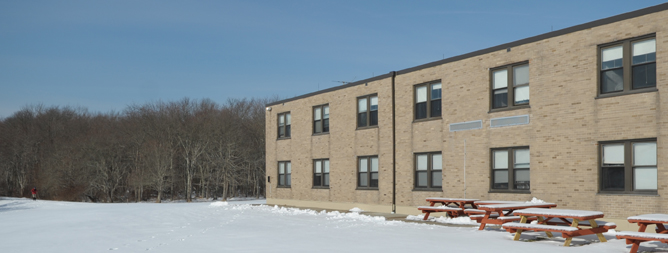

The 2010 category-group contains the following categories:
Boston-2010
Christmas-2010
Harrow-10
Kitchens
Michigan-2010
Murals
Narragansett
Pgh-2010
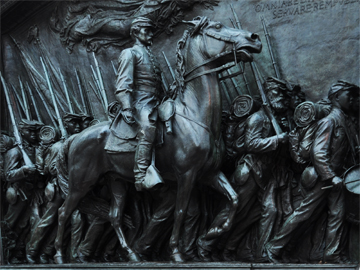
 It was late afternoon and grey only as New England can be grey in winter. I’m slowly beginning to learn how to shoot in this light and some of the images I got, I like very much. Also processing them through Photoshop can alter them enough to compensate for the grey and the diminished light.
It was late afternoon and grey only as New England can be grey in winter. I’m slowly beginning to learn how to shoot in this light and some of the images I got, I like very much. Also processing them through Photoshop can alter them enough to compensate for the grey and the diminished light.
My goal in walking the Common was to shoot the Augustus Saint-Gaudens relief – The Robert Gould Shaw Memorial – commemorating Shaw and the Afro-American 54th Massachusetts Volunteer Infantry. Saint-Gaudens is one of my favorite sculptors. (The other piece I’m determined to shoot is the Adams Memorial in Rock Creek Cemetery in Washington, DC.) I shot the relief with little light remaining and yet I think the image works.
..
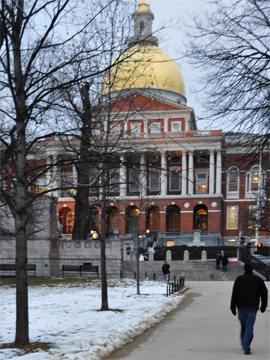 I walked through Boston Common with Ryan Oliver. The area is a great place full of people – students, street performers, policemen on horses and workers heading home. The Common is dotted with great statuary and they were fun to shoot in the dying light. The last time I was here must have been some thirty years ago and never in winter.
I walked through Boston Common with Ryan Oliver. The area is a great place full of people – students, street performers, policemen on horses and workers heading home. The Common is dotted with great statuary and they were fun to shoot in the dying light. The last time I was here must have been some thirty years ago and never in winter.
The second pic is of Mr. Oliver walking towards the Massachusetts’ State House. (I had to get stern with Mr. Oliver who wanted to turn and mug while I shot.) I’m using the pic to place the Shaw Memorial. (Sorry Mr. Oliver.) The back of the monument is on the left hand side, in the middle of the pic. It sits across the street from the State House facing the golden dome.
Oliver had lived in Boston for a good six years so it was great to have him guide through the city. Boston is more like New York than it is like any other city I know. However, it doesn’t have the oppressive feeling of NYC.
I always think of Boston as America’s Jerusalem – the Golgotha where England was killed and a new nation resurrected.
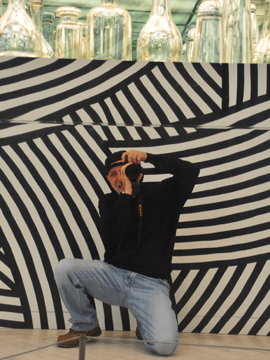

The first time I ever shot in a museum was last fall in Portland. That experience was interesting mainly because I ended up using the wide-angle lens and focusing on items I could shoot with the flash. And by getting real close, the lens gave me some great pictures. (I keep forgetting the adage – walk to the subject, don’t zoom it.) On Saturday, I wasn’t sure what to expect when I walked into the Boston Fine Arts with my camera. This time I mounted the 18-200mm – f/3.5 not sure what the results would be. This is my work-horse lens. What I didn’t expect was a well-lit environment. Can you imagine, it never occurred to me that objects in a museum would be well-lit. Once I figured that out, I shot everything I liked.

The image on the left is probably my favorite. It’s my ‘Antonioni’ picture. I’m referring to the poster for the film BLOW-UP, Antonioni’s first English language movie, released in 1966. I may not be straddling super-model Veruschka, but the image is as close as I’ll ever get to the iconic pose on the famous poster.
What you’re looking at is a reflection. I am shooting the image in the mirror. The mirror is the base of the display – Endless. The bottles above the mirror are the actual display. The black swirls are in the wall paper I’m kneeling in front of.
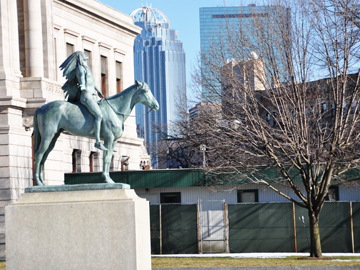
 After the cemetery Mac and I went to the Boston Museum of Fine Arts. All the time I visited Mac in Boston when he was in grad-school, we never went to the museum. Forty years later we head to The Fenway. The museum is undergoing a huge renovation almost doubling its size. In the process it is surrounded by fencing. The sculpture, with its green patina, is in front of the museum’s original entrance, now re-opened to the public.
After the cemetery Mac and I went to the Boston Museum of Fine Arts. All the time I visited Mac in Boston when he was in grad-school, we never went to the museum. Forty years later we head to The Fenway. The museum is undergoing a huge renovation almost doubling its size. In the process it is surrounded by fencing. The sculpture, with its green patina, is in front of the museum’s original entrance, now re-opened to the public.
I’m using this image of the Indian pleading to heaven, because to me it has some of the same sentiments as The Shaw Memorial of the Afro-American Volunteer Infantry in the Common. I find it strange that prominent in this first of American cities are two pieces – one to the conquered and one the oppressed. After all, it was the colonist who took the land from the people they found in the new world and in ’67 Boston was the site of some of the most violent race riots of the era. Yes, Massachusetts is one of the most politically liberal of states, but I never think of it as progressive towards its people.
I will add pictures of the museum in the Additional Pages on the places text-section of the webpage.
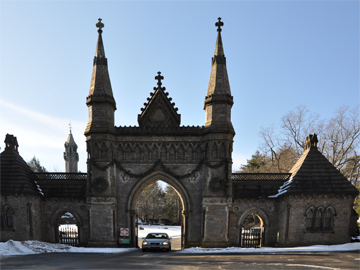
 Saturday morning, Mac and I went first to Forest Hills Cemetery and then to the Boston Museum of Fine Arts .
Saturday morning, Mac and I went first to Forest Hills Cemetery and then to the Boston Museum of Fine Arts .
Forest Hills, chartered in 1848, is among the first ‘park-cemeteries or rural-cemeteries’ in the nation. (Allegheny Cemetery, opened in 1845.) The entrance is Victorian and massive. What I really liked is the bell-tower. In the pic, it’s on the left in the background. It’s a functioning bell-tower and tolls the hours. I haven’t found any other cemetery with a working bell-tower. The picture composition was serendipitous, the car drove through as I was shooting. And I must have shot at the right time to capture the car without any streaking.
I will add pictures of Forest Hills in the Additional Pages on the cemetery text-section of the webpage.
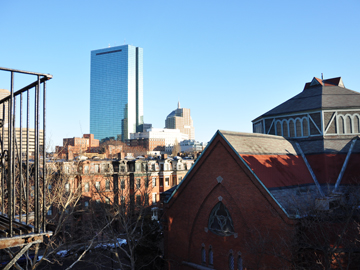
The pic on the right is taken from my window at the Clarendon Square Inn, a B&B that I stayed at.

The neighborhood is full of Second Empire houses, old brick five-story structures with mansard roofs that have been reclaimed and made beautiful again. The B&B is located in Boston’s South End. I had a room on the 5th floor and from my window I could see the high-rises of downtown Boston. The South End reminded me a lot of New York’s East Side.
We have little Second Empire housing in Pittsburgh. One of the owners of the B&B was surprised to know that the Western Pennsylvania region has more Arts and Crafts housing than French influenced architecture. (My neighbors across the street have a mansard roof on the third story.) Pittsburgh, the original gateway to the west, is European in character but American in architecture. The European, upper-class look isn’t here, but Frank Lloyd Wright and H.H. Richardson have left great legacies.
..
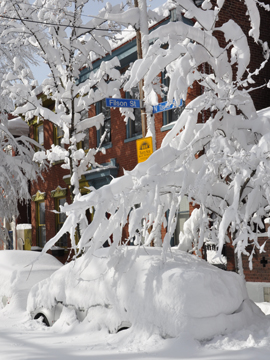
The picture was taken Saturday morning. I’m shooting from the alley-way across the street.

All day Friday, the news media was hyping everyone up with their predictions of snowmageddon. Rick, Sarah and I had a previous date to go to Joan Brindle’s gallery opening and we ignored the hysteria and went to the opening. I drove home proud of having made it from the east-end, via Wilkinsburg, Squirrel Hill, Oakland and to the North Side. The roads were snow-covered and given that the media had scared everyone home, there were very few other cars to navigate or be careful of.
I went to bed thinking that I’d get up early and go take pictures. At 4:00 in the morning I realize that my alarm clock is off and that there’s a chill. I get up and check things and figure out that the electrical had gone off at 11:30 last night. The dogs were not happy in the darkness. A couple of hours later, I get up, make espresso and have breakfast, but still no heat or electricity.
I open the back door to let the dogs out and find that they yard is covered in almost 3 feet of snow. The dogs jump in only to sink and get all snow covered. After the shock of sinking, they begin to eat the snow. They love to eat the stuff. After a lot of shouting I round them up and bring them in only to spend the next half-hour drying them off.
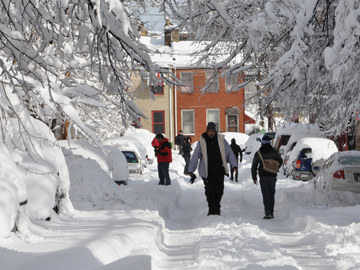
This was the headline in today’s Pittsburgh Post-Gazette. And given that 21 inches of snow fell in 14 hours, and that we were without electricity and heat for 17 hours, the title seems to fit. (A state of emergency was declared throughout Pennsylvania.) I’m using an image shot yesterday. It conveys the amount of snow without the filth of sand and melt.

Yesterday morning everyone was in a great mood. Taylor Avenue was filled with people we all laughed and talked about the fact that none of us had power. Here we were, Pittsburgh’s urban pioneers enjoying a beautiful snow-drenched morning. The sun and snow made it easy to forget that we had no heat and no electricity. That discomfort didn’t set in until sundown and the house was cold and dark.
In the afternoon, I went out and sat in my car for a half hour charging my iPhone and Kindle. (I don’t believe I’ve been alive long enough for such an admission to make sense and to not be embarrassed by this comment.) My neighbors went to a coffee shop in the neighborhood to charge all their peripherals.
The electricity came back this morning at 4:00 – seventeen hours after going off.
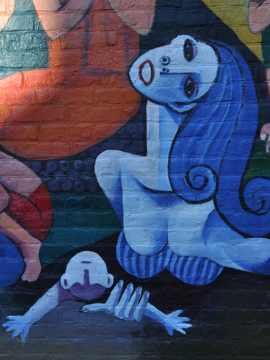
 I’ve discovered the outside murals in Pittsburgh. These have been around for a while, thanks mainly to the Sprout Fund that has been spearheading the effort with a very strong grant program to local artists. On the North Side, the artists living in the housing owned by City of Asylum Pittsburgh have been using the outside of the building as their canvas. Huang Xiang began it all. In 2004 he covered his residence with Chinese calligraphy — his poems, a joyful and celebratory response to his freedom from censorship. (The image on the left is from the Pittsburgh-Burma house.)
I’ve discovered the outside murals in Pittsburgh. These have been around for a while, thanks mainly to the Sprout Fund that has been spearheading the effort with a very strong grant program to local artists. On the North Side, the artists living in the housing owned by City of Asylum Pittsburgh have been using the outside of the building as their canvas. Huang Xiang began it all. In 2004 he covered his residence with Chinese calligraphy — his poems, a joyful and celebratory response to his freedom from censorship. (The image on the left is from the Pittsburgh-Burma house.)
The detail is from a mural on the North Side done by Burmese artist Than Htay in resident at City of Asylum Pittsburgh.
The slide show on the main page is images from a mural in Regent Square. The artist is Kristin Williams and the piece is titled Bird’s Eye View.
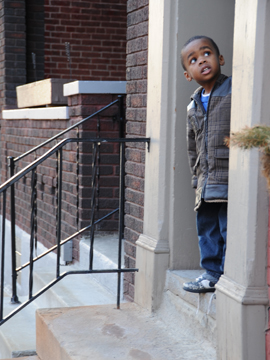
The other day my D90 gave me an error message and then shut down. I removed the battery and it started up again only to shut down again. Went online and started reading blogs and several postings talked about this particular problem. It was described as an electrical problem in the body of the D90.
Next, I called Nikon and they said the same thing and that I had to ship the camera in for repair – shock to the system. I packed it all up and went down to UPS. I was without a familiar camera. Even though, I recently purchased a D700 when offered a “pick-yourself-out-a-gift” offer. But I was intimidated by the fancy, new camera and had not yet used it.

On my way down to UPS, I decided to take the plunge and use the D700 in Auto mode. (I know, I know this could get me drummed out of the “club.”) But then it wouldn’t be the first club I got thrown out of. I read the manual, switched it to Auto and walked out the door.
My neighbor’s kids were playing and I asked them if I could take their picture. (As if they were going to say no.) Here’s one of my favorites.
I agonized over buying the D700 – it’s considered a professional camera and I’m nowhere near that level of proficiency. And never mind the price, even if it was a gift – a gift that was offered back in January. It took me three months before I called and order it and then it sat on my dining room table for the next two weeks. I kept telling myself that I didn’t have time to learn it. It’s funny how things work out. Nothing like necessity to force us to do things we’re afraid of. (At one point, I considered going back to my office and getting my old D60. After all I knew how to use that one and I was already in the car. A short trip to downtown would be easy.)
If I remember correctly, I did the same thing with my first camera – put it on auto and concentrated on composition. It has taken me two and a half years to get to a point where I know my way through the technology to shoot in manual. I hope it’ll be a shorter time with this new, fancy camera.
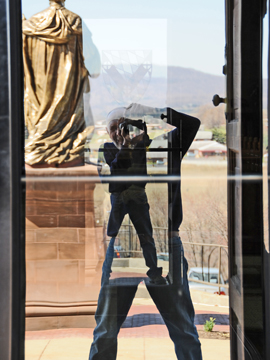
I was out in Westmoreland County, the sun was out and I decided to drive out to St. Vincent College to shoot with the D700.

The doors to the abbey were open so I made a bee-line to the entrance. When I got there, behind the massive wooden doors were two sets of glass doors, and there staring at me was a reflection in a reflection. I couldn’t pass it up.
Now to try and explain the layers – the gold statue is behind me, and its reflection is in the first set of doors. The rolling hills are the western ridge of the Appalachians. My larger reflection is also in the first set of doors. The smaller, full-body reflection is in the second set – the interior doors. The floating, vertical rectangle with the insignia is on the interior doors. The shield is the College’s logo.
Inside, I shot the empty, sterile church of Holy Week. By Sunday it will be festooned in lilies and filled with Halleluiahs. Outside, I found the pond for the old grist mill. (At one time the monks grew wheat, ground it in the mill and made great bread. But those days are gone.) The pond is home to some of the largest gold-fish/carp. And, a group of gold-fish was huddled under rotting leaves. The bright red was in contrast to the browns and dirty-greens of the old autumn leaves.
BTW, I learned that I don’t have the D700 set up correctly. I guess ‘auto’ is a selective feature, not an all encompassing one.
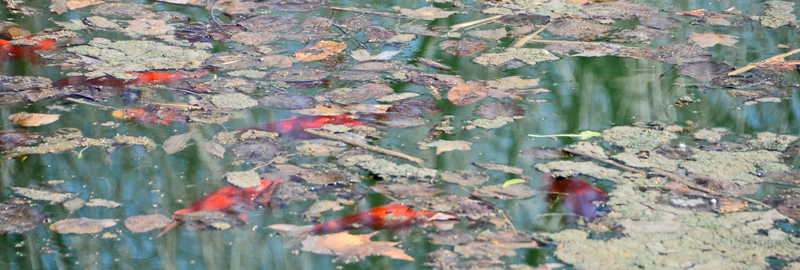
The old gristmill at St. Vincent still has the pond that for years dammed the water that turned the wheel that ground the wheat that became the monks’ bread. Today the mill houses the College’s maintenance and the pond is a nice place to visit on a spring day.

I was standing there shooting the grounds and looked down into the green water and saw all these carp, some of them huge. Farther out, under old leaves and other winter debris was a small group of fish all red and golden. I aimed the lens and shot. The dirty-grey winter leaves, the red carp, the reflected tree-limbs all floating in the cold-green water created an image that reminded me of Monet’s Water Lilies.
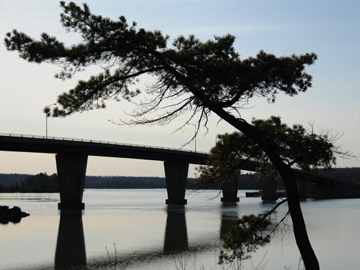
 St. Joe’s Island is a place I keep going back to whenever I’m in Northern Ontario. The island sits at the end of the St. Mary’s Rivers in Lake Huron.
St. Joe’s Island is a place I keep going back to whenever I’m in Northern Ontario. The island sits at the end of the St. Mary’s Rivers in Lake Huron.
As kids, Rainer’s mom and dad would take us to St. Joe’s to fish and to pick blueberries. We would do the 20 mile drive following the St. Mary’s River through the Indian Reservation and end up at the dock to wait for the ferry to take us onto the Island. The ferry held maybe 10 cars. I remember rough, white-capped waves and staying in the car while the ferry navigated the narrow channel. In the late 70’s the Provincial government built the current bridge. The image on the left is the bridge going over to the Island.

And this morning I got to shoot a photograph that echoed back to one of my favorite paintings – Casson’s “White Pine”. AJ Casson was one of the Canadian Group of Seven – artists who, after WW I, fled Southern Ontario for the Georgian Bay and Algoma areas to paint. Reproductions of their famous landscapes were in my basal reader. I remember being proud to see the landscapes that I saw everyday living in the Sault captured in canvas, reproduced in color in my reader. (It was great to see recognizable wilderness instead of Toronto streetscapes and Ottawa parliaments.)
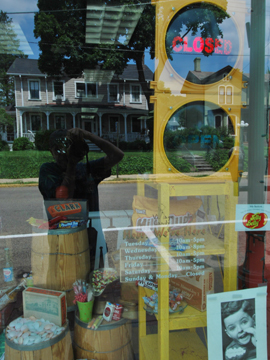
My two high-end cameras are in the shop. And after 3 tries it looks like the problem is the batteries. Nikon has my D90, D700, my 18-200 lens and 4 batteries. (I suspect they may finally be on the right track, because the 18-200 lens is not a problem with the D60.) Also, today was my first day without travel, prom, travel and graduation on my plate. I could finally go out and shoot.
 My first outing was to Sewickley hoping to find some interesting things to shoot, but didn’t. What I did find were some great windows for reflections.
My first outing was to Sewickley hoping to find some interesting things to shoot, but didn’t. What I did find were some great windows for reflections.
This is my first trip shooting in the area in quite a while. I’m troubled, because I want my two cameras back; I really want to shoot with the D700; the picture quality is great. However, I am shooting with my favorite lens – Nikkor 12-24. And regardless, it’s through the lens that I zone out and make pictures.
I walked the main street and was disappointed to find it was deserted and not very interesting. Most of the shops are directed at women and all were closed and shuttered. It doesn’t matter the goal was to get back out there and make pictures.
The picture on the left is fun. There I am in the middle of barrels, candy, fluorescences, ads and a Sewickley frame-house. The ad in the bottom right of the all-American child in the same image as the old immigrant is my sense of fun. I turned the camera to myself out of boredom. Fancy Sewickley had nothing worth shooting.
..
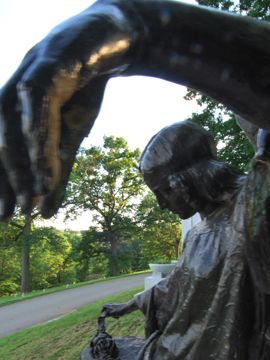

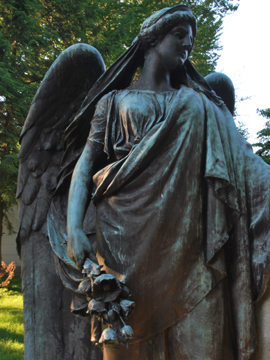
After my disappointing trip to Sewickley, I decided to revisit my two favorite angles in Homewood Cemetery.
I was hoping to find them dripping in evening light. The smaller angel on the left, was in shadow but the large majestic one on the right, holding a bouquet of poppies, still stood in twilight.
..
The Gulentz Angel on the left is the smaller of the two and has a whimsical quality. Her outstretched arm giving her both a melancholy stance and a breadth that encompasses the entire sarcophagus.
The Schoonmaker Angel is elegant and grand. She stands holding poppies in one hand and resting her left hand gently on the sarcophagus, soothing a sleeping child. She is herald, she is mother.

I have all my cameras back. And tomorrow I should have the Canon point-and-shoot. I’ve wanted something that I can have with me all the time and the PowerShot G11 was highly recommended.

There’s no way of knowing if the problem has really been fixed, however this time the techies seemed to attack it more comprehensively. The support manager in California that I’ve been dealing with got the technical manager in New York to work the case. It was the New York person that asked for the lens and batteries. What they found was that two of my four batteries were defective. Also the battery chamber on the D90 had cracked and that got repaired. The battery problems seem right. I already threw away one of the non-Nikon batteries, because it would not keep a charge. But it never occurred to me that what I was buying at a chain camera shop would be defective. I’ve ended up buying and throwing away 3 batteries.
The image on the left was shot with the D700 after a thunderstorm. I put together the D700 with my favorite lens – Nikkor 12-24 – and went out to the back yard. I really like the images from the D700.
The other thing that I did tonight was hang 6 pictures of flower photographs that I shot. (Last fall in Maine, Mac mentioned that he rotated the pictures in his house. There’s what I could do with my photographs – print them, frame them and hang them on a rotating basis.) I gave my friend Scott six flower images that I really liked. He Photoshopped them, printed them and framed them. I know nothing about printing, and I suspect that I will have to learn something about it.
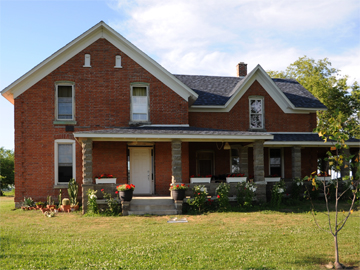
 I spent the week-end in Harrow. Unlike last year, I decided to take pictures of the farm. (The architecture of these Upper Canada farm-houses is consistent all throughout Southern Ontario.) Rainer and Lynne bought the farm-house some 4 years ago and are slowly renovating it. When Rainer first took us to see it, I assumed it was a generic Canadian farm-house, but the back-story is more than generic.
I spent the week-end in Harrow. Unlike last year, I decided to take pictures of the farm. (The architecture of these Upper Canada farm-houses is consistent all throughout Southern Ontario.) Rainer and Lynne bought the farm-house some 4 years ago and are slowly renovating it. When Rainer first took us to see it, I assumed it was a generic Canadian farm-house, but the back-story is more than generic.
Lynne told us that the house belonged to a Mr. and Mrs. Fox and that it was the farm-house that her grandparents and aunt worked at when they came from Portugal two generations ago. Lynne said that the farmer’s wife would not tolerate the three Portuguese workers in the house.
Fast forward 80 years and the grand-daughter of the Portuguese immigrants now owns the farm-house.
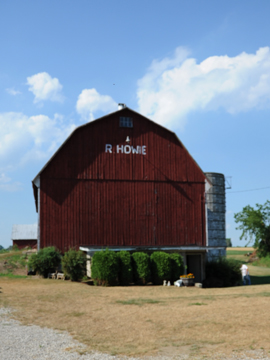
A term that the people in this part of Canada use readily is severed. They all talk about how the farm-house has been severed. This means that the house and some added land is separated from the larger acreage and sold. (The original Crown deeds, in this part of Upper Canada, were 150 acres.) Rainer and Lynne’s house was severed from the farm land that surrounds it. And to add one more twist, the house that Lynne’s dad and his wife lives in, is the same house that his wife was born in and grew up in. The house was severed and they bought the farm-house from her family – the Howies. The property includes the original barn with the R. Howie name on it.
It become clear that the community, in this farm region, has many families that have been in the area for generations. The families have intermarried and consolidated and re-divided the original Crown deeds to create a new patch-work of farms.
The inter-connectedness reminds me of the hill-towns in Calabria. Just as Lynne can point to all the families that are inter-connected in Harrow, I can point to all the families that are inter-connected in Aprigliano.
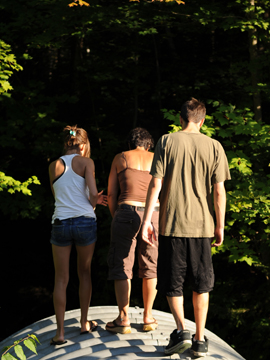
 This is one of my favorite images – Seane, Connie and Christian.
This is one of my favorite images – Seane, Connie and Christian.
The light-green finger, the white tank-top, the blue hair-clip, the black hollow, the sun tanned shoulders, the brown T, the yellow-green leaves, the grey culvert, and the checker-board shadows; Sean protecting, Connie leaning, Christian walking over; serendipity.
Northern Ontario, in early August, still has a summer sun. The evenings are deep-red and soft. Twilight lingers.
It was Christian’s birthday, we had just finished eating and went walking in the evening light; three of us led by an adventurous aunt.
When they got to the culvert, they walked right out onto it. As the reporter and interpreter, I can assign motivation and action to the characters in the image – Connie needs to see what is in the water; Sean is hesitant and cautious; she’s trying to make sure her aunt doesn’t tip into the stream; Christian meanders; the uncle stays back, pushing the shutter-release.
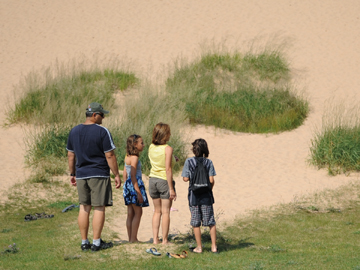
 In lieu of Italy, I spent a week in northern Michigan. Actually on the north-eastern shore of Lake Michigan. The area is nothing like Northern Ontario and the other Great Lakes. It has dunes, sandy beaches, resorts, cherry orchards, golf-courses and cultivated pine-groves. The image on the left is Dom, Alyssa, Mary and Daniel getting ready to climb the dune in the National Lakeshore Park.
In lieu of Italy, I spent a week in northern Michigan. Actually on the north-eastern shore of Lake Michigan. The area is nothing like Northern Ontario and the other Great Lakes. It has dunes, sandy beaches, resorts, cherry orchards, golf-courses and cultivated pine-groves. The image on the left is Dom, Alyssa, Mary and Daniel getting ready to climb the dune in the National Lakeshore Park.
It was a surprise to find National Lakeshore, I had no idea that the east coast of Lake Michigan is protected parkland. (In all the years that I’ve been traveling through Michigan, this is the first time that I ever visited the eastern shores of the Lake.)
I always assumed that Lake Michigan would be much like the other Great Lakes rocky and rugged. Instead it’s sand and gentle, rolling hills. It’s fields of sunflowers and beautifully manicured greens. It’s farmland and orchards. It’s the refuge of the car-manufacturing gentry escaping the industrial south for the dunes and shores of the “up-north”.
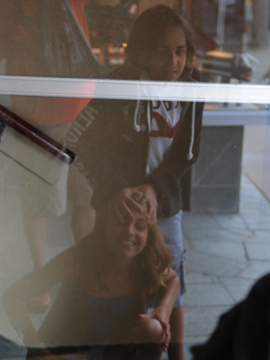
 One of the things I enjoyed best about the trip was spending time with Daniel and Alyssa. The image on the right is a reflection – Daniel is being an eighth-grader and messing with his sister. (I’m glad to see Alyssa is still patient. Hope it lasts.) The five of us – Mary, Dom, Daniel and Alyssa – decided to spend an evening walking the downtown. The children and I ate gelato, dissed the tourists and mugged in every window.
One of the things I enjoyed best about the trip was spending time with Daniel and Alyssa. The image on the right is a reflection – Daniel is being an eighth-grader and messing with his sister. (I’m glad to see Alyssa is still patient. Hope it lasts.) The five of us – Mary, Dom, Daniel and Alyssa – decided to spend an evening walking the downtown. The children and I ate gelato, dissed the tourists and mugged in every window.
Traverse City is beautiful. It has a nice balance. It is not some cheap beach-town littered with souvenir shops and trashy stores or some northern Michigan back-water, hick town. Rather the downtown is manned by local merchants who have managed to keep out the national chains, the graffiti and the garbage. They offer coffee shops manned by local kids, t-shirts designed and printed by local artisans. A canal edges the downtown allowing boats to dock; boaters to pick up pizza; ducks to swim and dive for food; tourists to shop for taffy and t-shirts; locals to work in a tourist environment without being swallowed up by the outsiders. The harbor is filled with motor-boats and sail-boats. It is landscaped with retaining walls and slips. And the sunset colors it red.
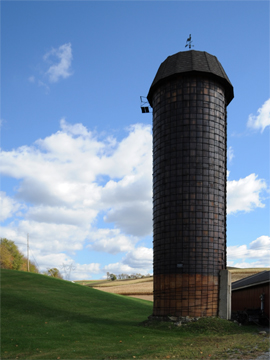

Our fall-foliage trip took us through Westmoreland County. I’ve traveled the turnpike for years, but have never gone exploring the country roads that surround it.
What made the shoot at this furniture store was the tile silo and the blue-blue sky. I haven’t had the opportunity to aim at the blue vastness and the white clouds in the while. The fields that bordered the landscape were gold with cut-wheat and cut-corn. The soybeans dried tan and added a haze to the horizon.
Other silos that I’ve shot have been skeletons – white-washed, cracked and empty – of bygone days. This one near Pleasant Unity, Pennsylvania was made of shiny tiles that were in great shape and it sported a weathervane on its copper cap. The bottom tiles still held their original burnt-red tint. I suspect this section was originally buried and uncovered when digging for the parking lot; or during the renovation when the barn was converted into a furniture store. The tiles on the tall section are shiny black, probably stained by the coal-soot that filled the skies of Western Pennsylvania in the long ago.
But Saturday the ebony silo, the golden fields and the marshmallow clouds filled the indigo skies – what joy.
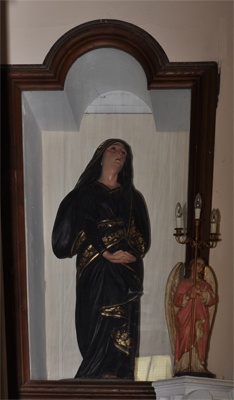
This date is so tied to my memories of Aprigliano. (This summer we didn’t go back to Italy. The uncertain economy is scaring everyone.) I’ll write of another memory associated with that long ago time. (I’m not sure what image to use with this post, but given that last year I used an image from 2006 I have an open field.) I decided to go with a pic of La Dolorosa. We lived in Santo Stefano; the parish at the top of the hill; the parish with the largest of the church of the hillside neighborhoods. (Saint Stephen is a common saint throughout Italy. And there are many churches and parishes named for him.) Our church was also the church of La Madonna di Porto Salvo and her feast-day was a great celebration in Aprigliano.
We lived in Santo Stefano; the parish at the top of the hill; the parish with the largest of the church of the hillside neighborhoods. (Saint Stephen is a common saint throughout Italy. And there are many churches and parishes named for him.) Our church was also the church of La Madonna di Porto Salvo and her feast-day was a great celebration in Aprigliano.
In the sanctuary, there were three statues – Santo Stefano in the middle, San Francesco di Paola on the right and La Dolorosa on the left. La Dolorosa is Mary represented as she would have been at the foot of the cross watching her son nailed to the wood. Most statues of the mourning mother represent her in back attire with her hands together and looking up. This statue is one of the best in the collection of such representations. (This particular representation has gone out of style in modern-day Italy. It was most popular during the interwar period – the 1920’s and the 1930’s.) I’ve always liked this representation of Mary, it’s the most human; it’s the most accessible. And it fits the Italian character perfectly. (I don’t know if Mary as the mourning mother is represented in any other European Catholic culture as pervasively as she is in Italy.)
This statue is tied to those that have died. It was a perpetual reminder of the dead. (In the modern world, remembering the dead is not cool. The media tells us to forget our loved ones that have died and to go shopping.) Many of the women of Aprigliano saw this statue as representing their lot in life, a life that after The Great War had them associating with the sentiments the statue evoked. Many of my relatives had died in The Great War. My aunt Teresina’s husband never came back from the war; my grandfather’s oldest brothers were lost in that massacre. Where I never knew these people, may parents did. And I take my attraction to this representation of a grieving mother from them.
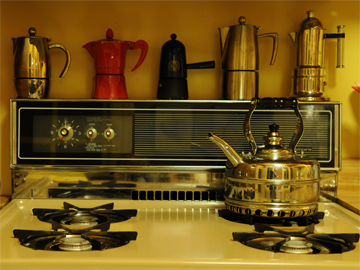
I’ve been listening to the American group Colcannon, and in the wistful song Bermuda Line I found a great phrase – and the warmth of the kitchen with all the outside dark. The more I played the song, the more I kept seeing all the various kitchens I’ve known. For me, kitchens are safe places, places of great memories. I’ve grown up, laughed and cried in kitchens.
I think back to childhood and our kitchen in Aprigliano and all the fun I had in that room. It was big, at least in memory, and in one corner was my bed. What joy to sleep in the kitchen. Its window framed the mountain slope on the other side of the valley. The mountains were where the brigands lived – oooh! But they couldn’t get me in our kitchen. It’s the place where I picture my dad making Sunday dinner. It’s where my mom set up the brazier in the winter. Its circular, wooden frame was my race-track for hours.
I could sit in the huge fireplace and eat my dinner. One night I sat there and flicked fava beans into the ashes. (I hated fava beans.) When the first one disappeared, I believed I had found the promised land – free, free of fava beans. My stay in heaven was short lived. The next morning, my mom told me she had found the favas in the ashes.
On January 5, I hung my stocking on the fireplace hoping the befana would bring me torrone and toys and praying that she would not bring me coal. After all, I was a good boy. That particular year, the befana did not agree with my self-assessment and there were lumps of coal in my stoking. I was mad. Fifty years later, my mom and dad still remind me about the year the befana brought me coal.
..

The image on the left is my first kitchen-picture. It’s my kitchen here in Pittsburgh. The espresso makers are all from Italy. (No electric espresso machine for me.) I love making espresso on week-ends. It’s 5:00 in the morning; the dogs and I are in the warm kitchen; they wait for some banana; I grind the beans; decide which espresso maker to use; fill the bowl to heaping, because I like my espresso strong; next I make toast then sit and read the New York Times – heaven.
I’m going to start shooting kitchens – my parents’ many kitchens, Rose’s kitchens, Mary’s kitchen, Connie’s cottage kitchen, Dave and Isabel’s luxurious kitchen, my friends’ kitchens, . . . any kitchen I can get into.
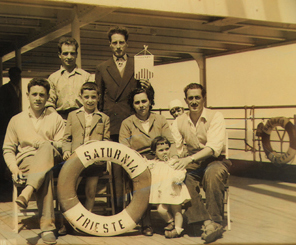

A while back I found Roberto Donna’s webpage and discovered that he had an entire section of old photographs of his family in Le Marche. Now, I’d been collecting family photos for years, but I had no idea how to digitize them. Talked to a local photographer who said he does that work. I gave Scott a bag-load of old pictures and he scanned them. I now have the first batch of these old family photos as JPGs and RAW images.
The image on the left is actually a photograph-of-a-photograph. The original was taken in May, 1957 on the boat – Saturnia – that my family came to Canada on. Front row, left to right – Salvatore, my cousin on my mom side, me at 8 years old, my mom, my sister Connie, two years old, and my dad. The tall man holding the small flag is Carmine Belsito a friend of the family. The gentleman on his right is someone else from the Cosenza area. We were all heading to Halifax. Everyone, except for my mom, seems happy about the future. She admits to not liking Canada and wanting to return to her life in Calabria. (It’s one of my favorite photographs.)
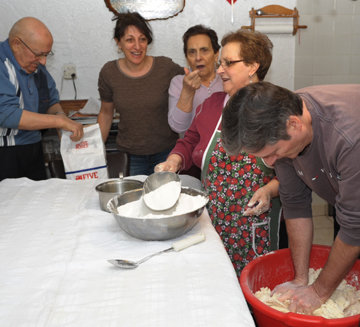

Rose, Derrick and my aunt came over to my parents’ to make a batch of cullurielli. These doughnut-like fritters are a Christmas staple. The dough is made with potatoes, flour and water. And they are shaped into rounds and longs. The longs have sardines in them. They are first eaten on Christmas Eve in place of bread. (My favorites are the ones with the sardines and I like them straight out of the freezer. Everyone in my family already thinks I’m strange, this culinary choice reinforces their prejudices.)
Part of the reasoning for a second batch of cullurielli was getting Rose, Derrick and I to see how to make these Christmas bread-substitutes. The process took the whole day. We began by mixing the dry and wet ingredients, then kneading and kneading the rough dough. This was followed by leavening and an hour later we were rolling the rounds and the longs. I had no idea who was going to eat all these cullurielli. I refuse to take any home, because after all the ethnic eating I need to get back to a sensible diet. . . (left-to-right – my dad, rose, my mom, my aunt, derrick)
The 2011 category-group contains the floowing categories:
Kaua’i-11
le Marche-11
New Orleans
Northern Ontario
Pgh-2011
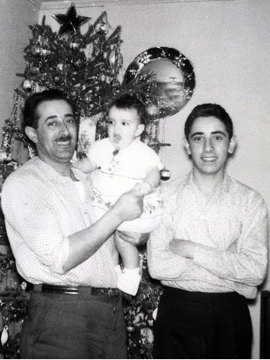
I’ve been trying to figure out the focus of the next old-photographs text-page. And today I may have gotten an inadvertent push.

The picture on the right is one of my favorites. It’s Christmas 1964. And it’s my dad, my sister Jo’ and a young me. I put the image on the desktop of my new laptop. And our tech-manager saw it and said it looked like people from the Sharks and the Jets. The idea that the three of us look Spanish and New Yorkish never occurred to me. Maybe I should do a text-page on the parents and correct any misimpressions of who these two immigrants are. (I have some great pics of them.)
The picture was taken in the original house before the renovation and the expansion. The living room was long and narrow and the Christmas tree had to be put in the corner.
The tree was cut in some field. It never occurred to my dad to buy one, not when there was an axe in the basement and open woods all around us. The decorations were new and shiny. I bought them at the Woolworth’s and Kresge’s. The lead tinsel disguised the gaps in the branches. (I never used the fiber-glass angel hair. That came when Connie took over decorating.) The star and the ornaments have survived. They now hang on a perfectly symmetrical and gap-less plastic tree.
For me, the image is about a young Ciccio holding his new daughter and a young man on the cusp of adulthood. Ciccio was 38. Jo’ was the wonder-child of his thirties. The young man was looking forward to high-school – St. Mary’s College, Catholic Boys High School run by the Basilian Fathers.
I love the smiles. It was an innocent time.
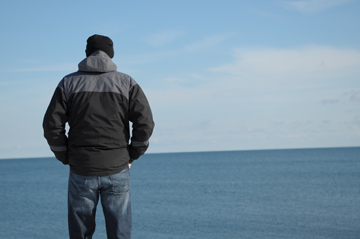
Oliver and I went down to Narragansett. He was interested to see if it was somewhere he and Luz could spend a weekend. I was interested in seeing the Novitiate, the rocks and the beach.

We began at the northern end, at the surfers’ beach, and then drove south on Ocean Road to the Novitiate. I got to tell about my life in the monastery and Oliver was amazed by the story. (I guess thirty-something Jewish Californians don’t know about Medieval European monasticism.) It was also fun being on the Novitiate grounds with someone who was neutral to the idea of my having lived there as a monk.
The next stop was Black Point. This is a small state park, an ocean-access area, across the road from the Novitiate. The strip of land is wooded and has a path down to what we called the rocks. This is an ocean-front of rock and shallow pools. We would walk down to the rocks at least once a week. I remember seeing star-fish in the shallow pools. I took one back to my room, thinking that it would dry and I’d have a souvenir. The smell of rotting flesh was enough to convince me to never try that experiment again.
In January of 1969 a group of novices rescued three fishermen that had run aground on the rocks. We formed a human chain and pulled the men out of the freezing ocean. We made all the local papers. The headline read – Brothers to All.
..

There is a famous picture of me in profile and with hair, sitting on the rocks and wistfully looking out to sea. It was my last summer at Narragansett. Bill Green took the picture without my knowing. (He gave it to me when we were leaving the Novitiate.) Bill’s photograph is soft, pretty and romantic.
I’ve always wanted to take a similar picture and I got the opportunity with Oliver as the subject. The above-left picture is my version of the 1969 photograph. Gone is the summer, gone is the longing, gone is the innocence.
Welcome to blue and black, welcome to geometry.
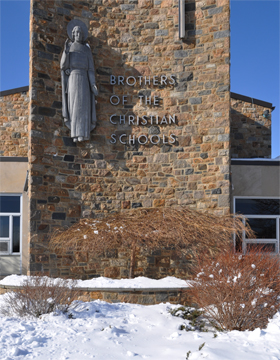

It was a cool Monday evening in July; it was 1969. We had finished Compline – evening prayer – and Tom and I had gone for a walk around the grounds. We ended up in front of the chapel beneath the statue of John Baptist de la Salle. We sat on the edge of the flowerbed looking up at the night sky.
Three-hundred-and-eighty-four thousand miles away, Neil Armstrong and Buzz Aldrin stepped onto the lunar sands. Apollo had landed.
The photograph on the left is the front of the chapel, but it’s forty-two years later. The flowerbed now holds a Japanese maple and snow covers that summer’s memories. But as I focused my lens on the statue, the signage, the flowerbed, it was easy to see the two eighteen year-olds sitting on the shelf and looking up at the night sky.
It was a summer of great change. In a month we all scattered and left Narragansett forever. The young brothers and the teachers that had lived together were all re-assigned back to their districts. Most I never saw again. (I went back to Canada and the University of Windsor, Tom went to DC and Catholic University.)
But I always remember where I was and who I was with when the Eagle landed and Armstrong anointed earth’s moon.
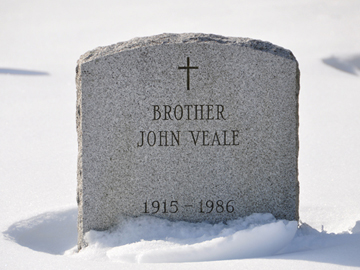
I’m working on a Novitiate text-page and it’s slow going, mainly because I’m not sure how to tell the story. The narrative of my time in the Novitiate is a bit complex. Which story do I tell – the John Veale one, the Benilde story, the house-driver story, the dorm-cloister story, the windmill-cottage story, the wrestling-in-the-grass story?
The Brother John Story – I had placed this grave-marker image at the end of the set, the last one on the text-page, but instead decided to start the series and the narrative with it. I wanted to lead with it as he was such a huge figure in that long-ago time. He was the Director of Novices and he still permeates the perimeter of my feelings about that long-ago.

Each novice met with the Director once a week. It was my first experience with one-to-one counseling. I remember complaining to him, because the Brother Provincial would pull me out of afternoon Manual Labor to play tennis. (Manual Labor was one of the rhythms of novitiate life.) Can you imagine complaining about not doing manual labor? And my Manual Labor assignment was cleaning the common rooms on the ground level. I hate cleaning. I refuse to do it now, but back then I complained about not getting to do it. Actually, I did not like being excused from the Manual Labor assignment when everyone else still had to do it. (Even back then I had socialist tendencies.)
I’ve got the text-page done, but am procrastinating on the captions. The story-telling happens in the captions. Now, I can make the captions as cryptic as I want after all I am the author and who’s going to challenge their authenticity?
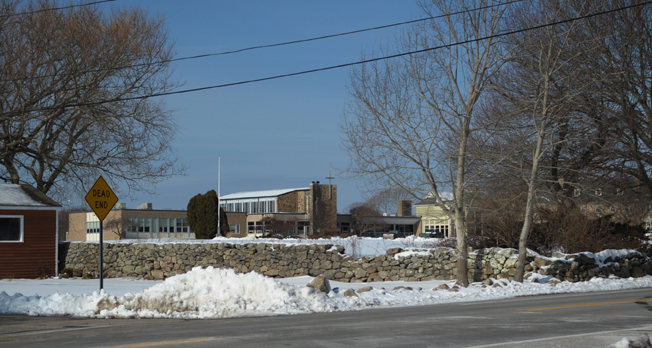
The photograph is of the southern corner of the Novitiate property – Ocean Road and Rhode Island Avenue. (The chapel is in the background.) This is the corner we always used to exit the grounds and go down to the beach or go walking through town. We would change out of our religious habits and into street clothes and head out across the front lawn. In the dark we were smudges on the manicured grass. We would climb the stone wall, both literally and metaphorically and walk out of the enclosure.

Thirty years later the top stones, at this southern end, are still missing. The breach is still there. (The cap stones lie piled on the lawn-side and serve as steps and ramp to the top, to the gap.) The corner is obviously still an exit-point.
Let me talk about the ‘Dead End’ sign. I intentionally included it in the photograph when I first saw it through the view finder. Second, I refused to Photoshop it out even if it’s going to be seen as a blight on the winter landscape. And third, I’m using a larger image-format so as not to lose the sign.
Is the yellow diamond, like the wall, both literal and metaphorical? Was the thought process that brought it into the photograph a subconscious statement?
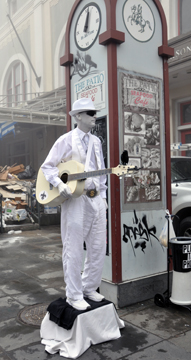

I’ve waited to write this entry, because I wasn’t sure what perspective to take. And I didn’t know how to tell about a place that was nothing like anywhere else I had been.
When we were trying to find a mid-way point between San Francisco and Pittsburgh that was warm, New Orleans popped on the radar. I headed south with little thought of place. I was more interested in the fact that I was going to visit with one of my oldest friends and that it was going to be warm.
Flying in and circling the gulf was amazing. The flat waters were littered with rigs and other oil producing super-structures. It reminded me of a spring garden – all pegs and stakes waiting to be covered with summer green. And heading into the runway, you saw the famous levees like giant potholes scratched in the landscape. We stayed downtown on the edge of the French Quarter.
Friday night we walked the area around the casino. This is all new construction. We found a decent beer garden and sat and talked in short sleeves. (The last time I was in warm weather in February was 2001 and never before then.)
Saturday morning the whole area was wrapped in fog. And not knowing the surroundings I had no idea what the fog was hiding. This time we did get into the French Quarters and I had my cameras.
The young man in the photo reminded me of Paris twenty years ago where I saw similar performance artists. They are living statues spending the whole time immobile. The difference was that in Paris they were all dressed as angles or devils. I guess in 21st century America musicians and robots are our angles and demons. (Will these present-day saints take requests? Will they hear my prayers and intercede?) The black and white cones on the right are for the tourists to deposit their offerings.
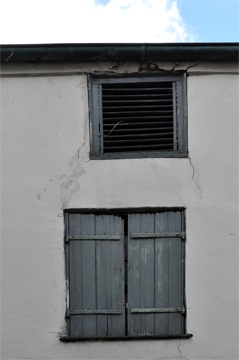

It wasn’t until Sunday that I began to see the old world in New Orleans. The first time through the Quarter, I was too disoriented and in a fog to pay attention. But the second time through I could look and see the muted colors of French country houses, the now-memories of long ago, the shutters, the floor to ceiling windows, the lace-iron balconies.
The shutters and louvers of the windows in the pic on the right, remind me of the country houses we saw on our road-trip south from Paris to Ronchamp. Back then, the five of us – Rick, Sarah, Shana, Mim and I – stayed in a farm house before we headed to Ronchamp. Back then, I saw the chapel in the rear-view mirror and I was lost. Back then, we climbed the mountain-road to Notre-Dame-du-Haut. Back then, in Corbusier’s chapel, I knelt and prayed. (How is it that 20 year old memories and 40 year old feelings find their way back to the present?)
Back then, the five of us – Rick, Sarah, Shana, Mim and I – stayed in a farm house before we headed to Ronchamp. Back then, I saw the chapel in the rear-view mirror and I was lost. Back then, we climbed the mountain-road to Notre-Dame-du-Haut. Back then, in Corbusier’s chapel, I knelt and prayed. (How is it that 20 year old memories and 40 year old feelings find their way back to the present?)
Sunday morning the Quarter and the square in front of the Cathedral were filled. This was the pre-Mardi Gras crowd. The taxi driver, who took us to the airport, told us that by the week-end the place would be crawling with out-of-towners. (The city had already placed road barricades up and down the parade streets.) On one level I was glad to be heading home and away from the pre-Lenten ritual.
The pic of the shutters and louvers is from the courtyard where Tom and I had breakfast Sunday morning. The fog was gone.
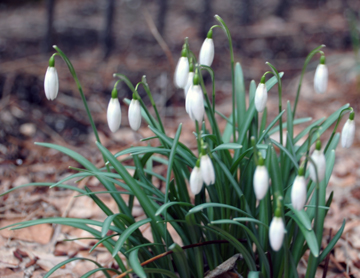
 If I had remembered the death-march that is this third month, I would have suggested to Tom that we go to New Orleans in March. But I guess the mind forgets our misery and pain otherwise mothers would never have a second child.
If I had remembered the death-march that is this third month, I would have suggested to Tom that we go to New Orleans in March. But I guess the mind forgets our misery and pain otherwise mothers would never have a second child.
Today was the switch to daylight-savings-time and I went out and shot the snowdrops at 7:00 PM. (My grandmother used to tell us that the actions we performed on New Year would repeat throughout the coming months. I want the old saying to apply now when I’m immobile with winter. I want the wish and action of shooting in early evening to repeat over the next many months.)
The snowdrops have been coming up in the side-bed for the last 20 years. And they are a welcome in the over-cast days that fill the month. There are many things that I like about Pittsburgh, but the fact that we have only 59 sunny days a year is not one. Outside March was dreary and winter-gray.
In Italian snowdrops are le bucaneve literally, make-a-hole-through-the-snow. And there have been many years when the flower-bed was covered in white and they poked through the March snows. This year they lifted through the litter of rotting leaves and twisted twigs. Not the spectacular contract of green on winter-white, but still welcomed. I’ve tried to fill the bed with snowdrop bulbs, but the same cluster comes up year-after-year.


This post may have the appearance of narcissism, but it’s more about discovery – finding an image, a suggestion in a photograph that I didn’t see at first glance.
Background – For some reason I decided to shoot some reflections, mainly because I wanted to photograph a red-and-black letterman jacket. (The images with the jacket didn’t work.) One of the best places to shoot reflection is in my bathroom mirrors. The photograph on the right is one of the reflection images.
I read the original as a picture of an old man with a striped white shirt and a green-brown tie. He’s holding a nikon that has a black camera-strap. There is a white towel in the background and the light source is coming over the left shoulder creating a reflection on the forehead. The camera and the hands hide half the face.
My first thought was to use this new image to replace the pic on my facebook page. So I began to make adjustments to get the best resolution and the correct size. I uploaded what I thought was a workable picture. But the webpage displayed only the top portion of the picture. I liked this truncated image, so I decided to go back to the original and create the partial that facebook had generated.

The New – The severe cropping changes the perspective. The vertical references – tie, torso, strap and towel – are gone. The new image is about someone looking out from behind a set of hands. (The camera, the big black spot in the middle, is balanced and neutralized.) The left hand has a wedding band. The reflection on the forehead is gone. The person is wearing glasses. The nose-bridge is silver, so is the left temple, so is the hair. The single eye is the focus.
Also, the hands seem separate from the face behind them. Are there two people in the photograph? Do the hands belong to the old man? If not, who’s the other person? In this rendition, the eye is at the center. All of a sudden it’s about looking out, looking at.
I never understood authors who said they didn’t know how their new book would end. I wanted to yell, “What do you mean you don’t know how it’ll end, who the hell is writing it?”
Well, I finally have my own example of an ending that wrote itself; an end-image that I didn’t plan. When I started, I had no idea what the finished photograph would look like.
Here’s looking at you kid.
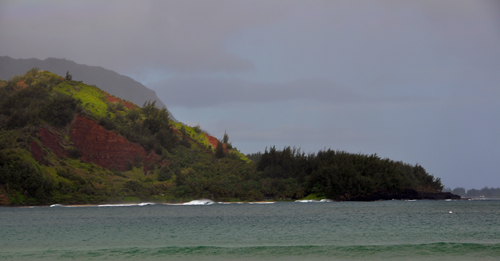
Puff the magic dragon lived by the sea
and frolicked in the autumn mist . . .

Our first trip, Sunday morning, was to the beach at Hanalei Bay and Rose and Derrick pointed out the mountain range that in local legend is associated with the Peter Yarrow song Puff the Magic Dragon. The long line of mountain bumps and humps is supposed to be the dragon’s back. He’s lying on his stomach with his head flat on the water. The image on the left is the snout and eye of that rascal Puff.
The small town of Hanalei and crescent Hanalei Bay are magnets for the left-over-hippie set, the natural-food-beauties, the gel-haired youths on fancy boards and the 30-something, over-weight surfers. The bay was covered in mist and Rose and I tried figuring out the words to Peter Yarrow’s child-song.
Earlier that morning, as I stepped onto the lanai that surrounded the two-bedroom condo, a rainbow arched the mist. Its right curve was anchored in the manicured Makai Course and its left curve on the mountain slopes. My very own welcome mat.
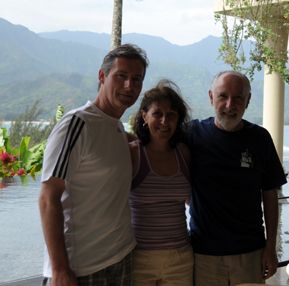

We decided to walk down to the St. Regis, the 4-star hotel in Princeville, for mimosas. The view from the restaurant terrace overlooks Hanalei Bay. I asked the nice waitress to take our picture.
The visit continues our pattern of dropping in on fancy hotels. In Panarea, we sunned on the deck of the Hotel Raya. I went up willing to pay for a day pass to sit under an umbrella and away from the over-heat, the old woman who owned the place must have like little, old me and offered us the patio; in Gubbio we sat in the courtyard of the Bosone Palace and had gelato and caffe; in Princeville we paid tourist prices to drink tropical mimosas with the well-heeled.
Priceville is in the north and is a self-contained, gated community of up-scale homes, condos and golf course. The condo we stayed was on the 12th Tee; the Pacific on the horizon, the bunkers and green holding up the blue.
The St. Regis is at the end of the compound and cascades over the cliffs that hold Hanalei Bay.
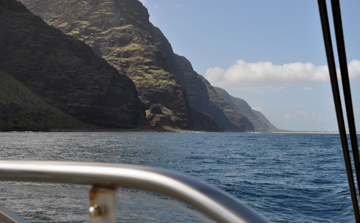

On a catamaran – we sailed from Port Allen on the south-western shore into the blue Pacific and the Na Pali coast.
Before heading out there was all this talk of seeing Spinner dolphins and whales. I assumed it was all an exaggeration to get well-heeled tourists out on a day-trip. Also while waiting to board the catamaran, our fellow passengers were not only well-heeled, but some of the strangest body-types I had ever seen in swimsuits. (Some people should just stay covered. Because you’re in Kaua’i, doesn’t give you license to wear a bikini.)
The south western coast is the beginning of the dry almost desert part of Kaua’i. The beaches as empty, and beyond Polihale State Park there are not roads only cliffs that fall into the ocean. We followed 40 miles of coast.
We weren’t too far out when we spotted the first dolphin. This was a loner who stayed around while the tourists ran from one side of the boat to the other hoping to capture on digital its jump out of the blue waves. This excitement was followed by a whale sighting. Now I was interested. (The dolphin was a single and not worth chasing across the deck of the catamaran.) The whale on the other hand was huge. I’ve seen pictures, but nothing prepares you for the actual thing. It is so big that after it dives, it leave a footprint – a flat water area the size of the mighty beast. The legend of dragon in the sea, comes from early sailors seeing two of these giants frolicking in the waves. Having seen the whale, I can see the dragon stories.
Eventually, we did see the Spinner dolphins. they travel in schools and are very playful and they do jump out of the water and spin before they fall in.
The sea creatures were nothing compared to the cliff of the Na Pali Coast. Sheer green-covered lava-rock rising into the clouds from a deep-blue ocean. (No Photoshop enhancement was needed to get the blue. It’s natural.)
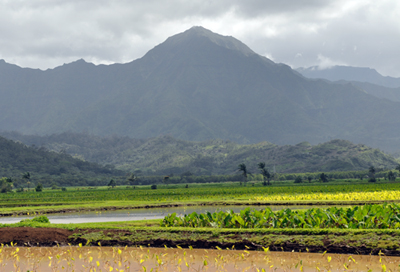

On Wednesday I did a north shore shoot with a local photography company. Five of us tourists spent the day in van being driven around the north shore. The young man who led the tour was very good. He took us to locations that were off the beaten track – great overlooks, small waterfalls, secluded beaches, state parks, the lighthouse, and the taro fields.
Taro is a root vegetable and is sometimes called the potato of the tropics. At one time it was the staple that the Hawaiian diet was based. But it has long been abandoned and the modern American diet is now default. The plant grows in conditions similar to rice – in paddy fields.
The last remaining commercial fields in the state are on Kaua’i in the Hanalei River valley. The flats on either side of the river are flooded and filled with taro plants at various stages of growth.
Outside of the over saturated southern shore and the northern gated community of Princeville, the coastal plain is green. It’s culture rural with a slow tempo. The taro fields – commercial and family fields – look back to an old time.


Talk about a cliche title. Rather, two weeks ago I was looking out from the balcony and saw the cloud, the ocean, the palm trees and the golf-course. Tonight, here in Pittsburgh, I got to sit on my porch and write in my journal. It was the first writing session of the 2011 season. Below me the garden is beginning to grow into the new green of spring.
The dove is back in its nest in the Japanese lilac; the chives are reborn; (I had some in my salad tonight.) the hosta and peonies are soft and new-born green. Soon they will fill the backyard with color and leaves.
Twilight is sweet on this night that is free of rain and severe cold. (Tonight, I was wrapped up in sweat-pants, sweat-shirt, and a red, Lifa toque.) In Kaua’i, I was wearing shorts and enjoying the heat of twilight.
I want to frolicked in the autumn mist, in a land called Honah Lee.
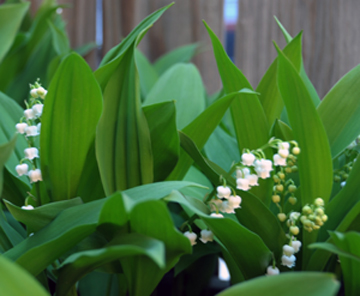

Two of my favorite plants have shown up in my back-yard. The lily-of-the-valley rhizomes that I planted years ago and to which I’ve diligently adding to, have become a bed of green with white bells perfuming the west corner.
Yes, they are mid-spring flowers that disappear and never return until next May, but I love the scented whites and I cut the bells and bring them inside to my desk. They were one of the few spring flowers we would find in the woods of Northern Ontario. The broad leaves grew near the evergreens and finding the fragrant, white bells was proof of winter’s demise.
It took me a while to find a place for them in the back-yard, but when I added the raised beds on the north-west side, I needed something that would grow in the shade in the corner. And I remembered the lily-of-the-valley of those long ago forages into the Cambrian Shield.
My second favorite plant will produce fruit I’m ravenous for.
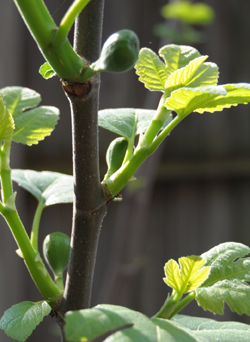
My fig plants are shrub-like with four or five stems. (They never make it into trees, because they can’t survive the Pennsylvania winters.) The cuttings came from my cousins in St. Catharines who smuggled the original cuttings into Canada from their family farm in Calabria. I brought them to Pittsburgh. Rose and Derrick have cuttings in suburban Detroit, Rick and Sarah have cuttings in nearby Wilkinsburg.
My plants are white figs. They are the early figs – the more rare and prized figs. Harvest will be late June, early July. (Rick/Sarah, Rose/Derrick have cuttings of the black figs my cousins brought over from Calabria. These are the more common and familiar figs and harvest in the fall.)
Some Fig Stories
-In Narragansett, my friend Tom was in charge of getting old Brother Leo from his greenhouse to Vespers. Tom remembers being told by our director ‘to make sure we don’t find Brother Leo facedown in a potted plant.’
Brother Leo had a huge fig tree that reached the roof of the greenhouse. He was very proud of it and I remember him showing it off to me. But he never offered me any figs.
Tom likes to remind me that Brother Leo offered him figs all the time. All I can say is that Tom never shared.
-In Calabria, Derrick has no shame about going into people’s gardens and picking the figs especially the ones that overhang into the road. Rose complains at him and I walk farther away. But once we round the corner, Rose and I demand that he share the figs he gathered.
-In Pittsburgh, Paul goes on and on about the alien looking plants that take up most of the side-yard, but never produce any figs. This year, the plants are loaded and I’m not sharing.
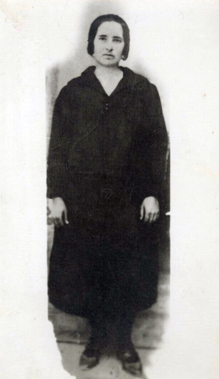

My paternal grandmother – Concetta Capisciolto – died 70 years ago today. The pic on the left is the only one we have. It’s always been in my parents’ house. It’s one of the items that travelled across the Atlantic with us.
It’s the Capisciolto side of the family that still has land in Aprigliano. It’s the Capisciolti that were large land-owners and farmers in the Santo Stefano parish. And when they migrated, they contributed to emptying the parish. Today, the Capisciolti are spread across the globe from Canada, to Argentina, to Australia. Aurelio and his sister Emilia are the last of the family in Aprigliano.
My cousin Aurelio who in his 70’s still runs a heard of goats and makes market quality goat-cheese and ricotta. The last time I saw him, he went on and on about how I look like ‘Ciccio’ his favorite cousin and my dad. My cousin Emilia returned to Aprigliano after many years in Toronto. When her husband became ill, they left Canada and returned to their land in Calabria.
My grandmother married outside of her social and economic group when she married my grandfather – Francesco Zinga. (The Zingas were sharecroppers.) My grandfather died soon after his son was born and Concetta was given to her husband’s next unmarried brother as his wife. Concetta died some three years after her second marriage.
When Concetta died, her family took her body and buried her in the family plot. Her grave is still there. On the west side is Concetta and on the east side is her sister Teresina. (There is no grave for my paternal grandfather. The sharecropper Zingas had no money for a fancy tomb.)
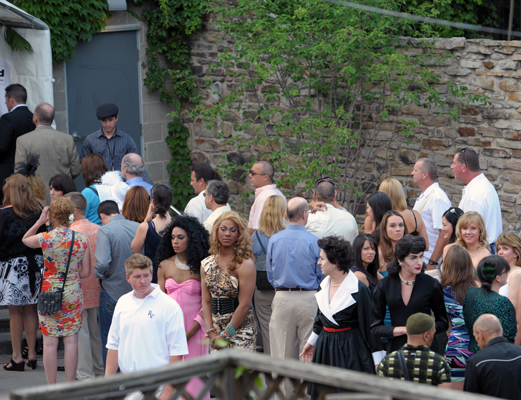
Tonight is the Mattress Factory’s annual Urban Garden Party. This year’s theme is Hollywood. It’s Hollywood on the Mon.

It is the event of the summer season and it’s always scheduled the last Friday of the Three Rivers Arts Festival. All the glitterati, a who’s who of western-pennsylvania’s art community, come out in clusters. And party through the night. The back alley becomes the River Styx separating the domestic from the imports. It’s closed to regular traffic, but open to the rolls, mercedes, and jags that ferry the blue-bloods to the Northshore.
Charon’s fee is variable – green-backs, euros, pounds, glamor, beauty natural or manufactured, celebrity, youth, gender-bending. The young man in the white polo moors the boat while the four drag-queens – pink, leopard, white/blue/red, and black – help the passengers off.
And the little old Italian with his fancy camera and telephoto lens stands on his porch and snaps the show.


The blueberry patch is speckled with berries. It seems to be a good year for figs, berries and grapes. All three are abundant and ripening. (The berries are first, next will be the figs, but the grapes won’t be ripe until fall.)
There are eight bushes in all, four of which are over twenty years old. They were some of the first plants I put into the garden that are still there. I build the bed they are in specifically for the blueberry plants. Also, the plant is beautiful in the fall. Its leave turn a yellow orange.
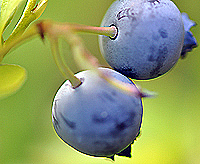
I took out the micro lens and rooted in among the blueberries. I always like shooting with this lens, it can make the tiny fruit look like giant hot-air balloons. The lens allows me to almost touch the fruit. And I generally shoot flowers with it, but this time I turned it on the blueberries.
The dogs love the blueberries. The female insists on going out every hour so that she can beeline right to the berries and rip and swallow as many as she can before I get there and push her away from her prize. She started back in March with the blossoms. And now that the fruit is ripe, she has made it her mission to eat as many as she can sneak.
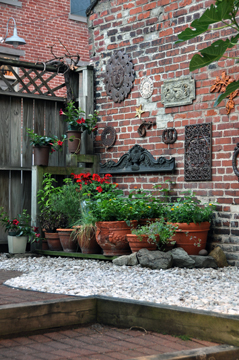
 It’s taken me almost three years to come up with a new design for the back-yard.
It’s taken me almost three years to come up with a new design for the back-yard.
The only maintenance I did was get someone to clean the weeds between the bricks, but didn’t seem to care that things were all over the place and that there was no unifying design. If I had to spend time outside, I just went up on the porch and avoided the back-yard. I knew I wanted to get rid of the last remnant of the bonsai shelves, but I took no initiative to dismantle it.
The shift came, because I’m on vacation and my plans got changed so I have a couple of days without having to run off to catch a plane or drive to northern Ontario. Yesterday, I took the hammer to the shelving and used the chainsaw to get rid of the posts. (I left one set of posts as a decorative piece of architecture.)
Next, I moved the large terra-cotta pots with the lantana and the ginger-jar pot with the geraniums into the area where the shelving had been and created a planting area. I also cleaned up the area where I’ve always kept the herbs pots. Moved them down so that all the pots are now in one area. I really liked the shelving posts and ended up putting two of the vertical bonsai pots on the posts. The verticals have vogue in them. I put the shelving on the ground creating a floor and arranged the pots up on the wood decking. To cover up the rough ends, I added some of the large rocks along the perimeter of the decking.
My last task was to re-distribute the wall pieces.
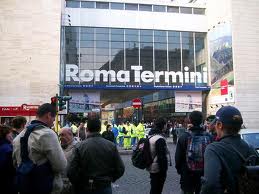
The last time I was at the Paris airport was 20 years ago. I was with the Wertheimers and once we retrieved our luggage we headed into town.
The Charles de Gaulle airport is all renovated. Security is double what it is at any other airport. (Twenty years ago there were soldiers with machine guns walking around.) And the French are efficient, but miserably detached and non-friendly. (The Zingas are originally from France that may explain some of the family characteristics.) It’s the only airport where they had me take out all my camera equipment and put it into one of the security trays. And on the flight from Paris to Rome, the pilot and attendances would give these long explanations about Genoa, Torino, the Alps in French and then two sentences in English. At first I thought they just don’t have the facility with English that they have with French. Wrong! (It’s the French, F the rest of us.)
One of my anxieties about the trip was getting from Fiumicino – Rome Airport – to Stazione Termini – Rome Train Station.  (The Roma Termini pic is something I found online.) I had all these concerns that I would get a rogue cab-driver. Instead I ended up with the airport taxi-group. The driver had on a shirt-and-tie and a jacket, very professional. The ride into town was 50 Euros, around $80. (That is what I had expected.)
(The Roma Termini pic is something I found online.) I had all these concerns that I would get a rogue cab-driver. Instead I ended up with the airport taxi-group. The driver had on a shirt-and-tie and a jacket, very professional. The ride into town was 50 Euros, around $80. (That is what I had expected.)
Stazione Termini was the best. First there were support people everywhere. And the people . . . If it’s wasn’t my first time back in 40 years, and if I wasn’t exhausted from the flight, and if I was with someone else, I would have taken out my camera, assembled the lens and shot and shot. The place was crawling with humankind. These people were all real, they were alive. They were the regular-folk wrapped in their Felliniesque costumes and Italian manners – muzzled dogs leading owners, cigarettes dangling from red-red lips, stiletto heels holding Rubenesque calves, man-purses slung on narrow shoulders, left-over hippies looking for their euro-rail passes, and young kids slumming it, because it’s cool to take the train with the regs.
The train left on time and got to Fabriano on time. It stopped at Spoleto and I was nostalgic for that trip, because it was a great one. On the way I texted Rose and Derrick to tell them where I was and once got off at Fabriano, there they were on the platform.
..
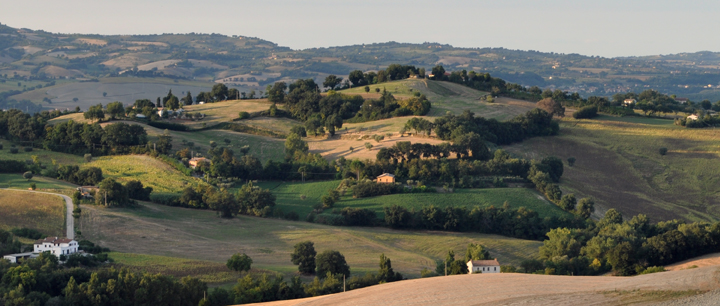
..
From Fabriano we drove through the country to the house in Isola di Fano. The landscape was magnificent.
We rented a renovated workers’ cottage. (When I told my dad where we stayed, he laughed. He grew up in one of these workers’ houses. It was home to some 18 family members who worked the padrone’s land. The first floor housed the animals; the sharecroppers all lived on the second floor. The sharecropping system, abandoned after the war, left many workers houses vacant. In modern times, these cottages have been reclaimed and rehabbed.)
The image below is the view from the kitchen window.

Rose’s comment was, “When you have this outside your window, who needs a painting?”
Large farms cover the northern section of le March. They crown the hills and the tree-lines serve as fences separating one farm from the next.
..
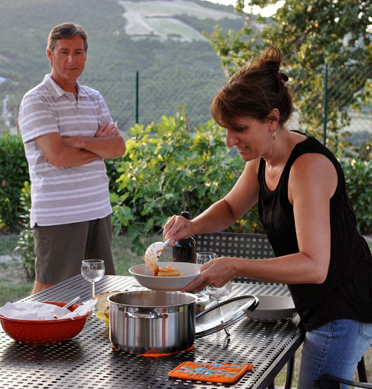
..
One of the things that I’m doing in this set of journal entries is using larger images. I really like this one.

After getting off the train in Fabriano, I said to Rose and Derrick that I needed to do something that told me I was in Italy. (Up to then, I had interacted with traveling attendances – memorable are the nasty airport workers at CDG – but no Italians, no landscapes, no art, and no food.) Well, first came the drive back to the house in Isola di Fano. There was the landscape; nothing like it anywhere; yes I was in le Marche. The house – cale cerque – was the next surprise. (The branches behind Rose are le cerque the oak trees that give the house its name.) Set in the rolling hills, its beautiful yellow-orange stucco blended with the natural colors of the plowed earth that sheltered it. And finally came the food and the wine.
Rose and Derrick are always ready for meals. They spend time shopping for food, cooking it and then sitting down and enjoying it. Dinner was a simple affair. Pasta with fresh tomato sauce, cheeses, a salad and wine from the agriturismo they were at before heading to le Marche. The table is on the upper portion of the property, it’s under a pergola and back-dropped by rolling farmland. This is the northern section of le Marche.
As the moon silvered the twilight, we ate, drank and laughed. I had gotten there late, but I was in finally in Italy doing the things Italian do.
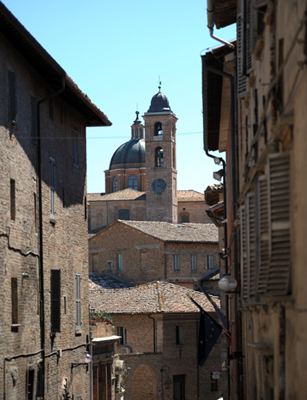

On Thursday we decided to go to Urbino. From Isola di Fano it was a half hour ride. This hill-town is a UNESCO World Heritage Site. (When I told Paul we had gone to Urbino, he announced that no one knows where that is. I hope it stays that way.)
I love Piero della Francesca’s painting of The Duke of Urbino.
 (I want his hat.) How did he produce the red pigment that he used for the hat and the coat?
(I want his hat.) How did he produce the red pigment that he used for the hat and the coat?
We approached Urbino from the south-east finding it on the horizon whenever the tree-line broke. It sat across the valley, its cathedral a blue crown.
We entered through one of its ancient gates to find a lived-in, medieval town absent of tourists. (For me that was the best. It’s hard to not find tourists in Italy, in August.) The rock-paved streets are wide letting the August sun in and the cars through without scraping the walls or the walkers.
Reminders of its Papal State status are everywhere in the city center. The cathedral and ducal palace are riddled with papal crests, statues and sacred liturgical artifacts.
Urbino is also the birthplace of Raphael. And that artistic legacy is embraced by the university. As we walked, hiding in the shade, students were going in and out of palazzos that have been turned into classrooms and offices.
..
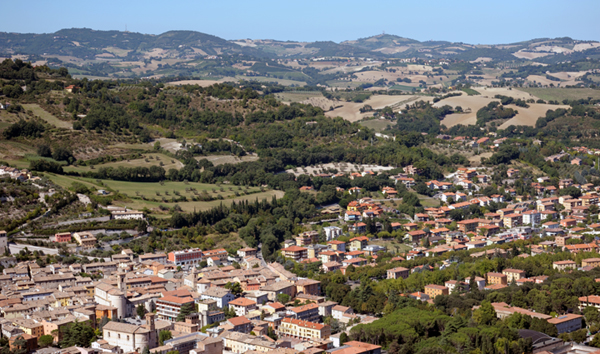
..
On our way home from Urbino, I suggested we go up to the monastery and then back down to the cemetery in Fossombrone. (I had noticed the signs and today we had some time.)

The road up to the colle dei Cappuccini was out of a Calabrian nightmare. In a province covered by round, cultivated hills, the road was narrow, scratched with 90 degree turns, and ledges that looked down and down and down.
Rose was beside herself. Derrick and I were surprised to find this mountain road. At one point we met a driver coming down. He had to back up and make way for us, because there were two cars going up. Also, we had no room on the right to pull over. The over was into the valley.
It took us a good half-hour to reach the top. And there was the Cappiccin Monastery. But the view was the thing. Before us was the valley of the Metauro and the terra cotta roofs of Fossombrone. (I am in front of the monastery, at an overlook and I am shooting into the valley.)
The monastery was established in 1528. I cannot image walking to the summit, let alone bring up building materials.
The expression in Italian for someone going into a monastery suggests that the person is going away from the world. Up here at the summit of the colle dei Cappuccini I finally understood the expression.
..
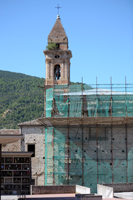
..
The church, swaddled in green gauze, was part of the original Cappuccin complex before two monks left and went up to the mountain to find solace and solitude and ended up founding a new branch monastery. The old church and monastery cemetery are now the modern cemetery of Fossombrone. After years of neglect the old Cappuccin church is being restored.
After years of neglect the old Cappuccin church is being restored.
The cemetery is one of the most efficiently designed and planned burial ground that I’ve ever seen. (In mountainous Calabria where flat land is a premium and the ground is rock, level expanses are given over to the fields of the dead. And tombs are wide-spaced, stand-alone and above ground.) Here in Fossombrone the cemetery is probably half the area of the one in Aprigliano, but holds double the number of dead.
The tombs are all underground crypts and the bodies are stacked one on top of the other.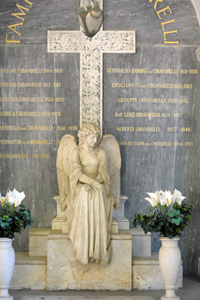 The mausoleum on the right already has 13 people buried in its crypt. And there’s probably room for another 10 or so. All the family crypts have a decorative marble/stone cover.
The mausoleum on the right already has 13 people buried in its crypt. And there’s probably room for another 10 or so. All the family crypts have a decorative marble/stone cover.
On the inside, the perimeter wall is lined with porticoes and under each arch is a family mausoleums; evidence of the wealth in the region. On a second ring of porticoes were many crypts in modern design. This was a surprise. And in the middle of the old cemetery were single graves with mounds of earth and stone. The grave-markers on these mounds were make-shift and temporary. (I would not be surprised if these are temporary graves and the family is waiting for room in the new, mausoleum.
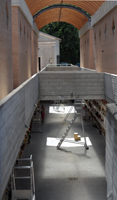 There are so many shelves on the above ground crypts that the cemetery provides ladders so family members can reach the flower vases. (It looks like Home Depot with its ladders-on-wheels in the middle of the isles.) These modern hives are two stories and so well planned that the street-level is a piazza like space.
There are so many shelves on the above ground crypts that the cemetery provides ladders so family members can reach the flower vases. (It looks like Home Depot with its ladders-on-wheels in the middle of the isles.) These modern hives are two stories and so well planned that the street-level is a piazza like space.
The emotional effect of this planning is a less morbid environment. I was more intrigued by the design, the traffic flow and the lack of funereal boxes than the atmosphere of a place of the dead. It all made for a neutral response. (I don’t know if families who come to visit their loved ones have the same detached response.)
.
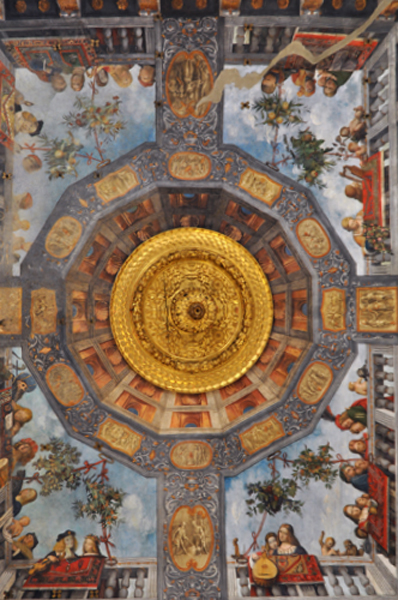
We left Fossombrone and headed north-east to Ferrara. Our last visit to Emilia Romagna took us to Bologna. We went there to eat and were not disappointed. (We have now been in Emilia Romagna twice and the food is absolutely the best.) This trip, I suggested Ferrara hoping for the same eating options. And we found them in droves. And because it’s off the tourist route, prices were amazingly low and the food was amazingly great.
Also, Ferrara is the city of The Garden of the Finzi-Continis and a memory in Stephen Sondheim’s dreamy Liaisons.

Is this the room and ceiling Madame Armfeldt (Hermione Gingold) was dreaming about as she remembered her life in A Little Night Music?
Liaisons
…
At the palace of the Duke of Ferrara
Who was prematurely deaf, but a dear.
At the palace of the Duke of Ferrara,
I acquired some position, plus a tiny Titian.
…
Liaisons!
What’s happened to them?
Liaisons today
Disgraceful!
What’s become of them?
Some of them
Hardly pay their shoddy way.
This is the ceiling of one of the street-level reception rooms of Palazzo Constabili. The corner frescoes represent the four seasons.
(The grand palaces of Ferrara are all brick-faced. Absent are the smooth, marble facades of Tuscany.) This Renaissance palazzo is beautiful even without external ornamentation. However, the interior of the Palazzo Constabili was amazing – the courtyard-garden rippled with thistle and hawthorn; cicadas sang in the pines; and the stone well was topped with lacey, wrought-iron sunflowers; on the main staircase, the risers were written with curlicues of inlaid black-marble; upstairs the piano nobile boasted the largest Etruscan collection in Italy; (The artifacts are from the ancient town of Spina an Etruscan port that flourished between the 6th and 3rd centuries.) and the ball-room had been re-decorated with murals of Spina, the old administrative divisions of the province and maps of the Nazi occupation of Emilia Romagna. (Talk about contrasts.)
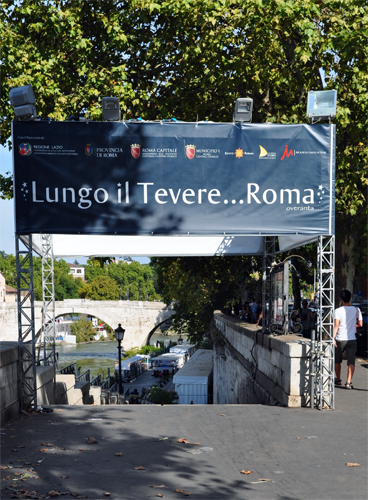

It’s been years since I was in Rome. (The Rome airport doesn’t count. BTW, I hate the Rome airport. It is one of the most difficult airports to begin a trip from; checking in is miserable. And the domestic terminals are over-run with passengers, and not very clean.)
We left Ferrara Monday morning and drove down to Rome. (We were going to return the car and stay overnight at the airport Hilton. My flight was at 7:30 in the morning and I headed over at 5:30. It took me an hour to check in. Why I hate the Rome airport.) Part of our plan was to take the hotel bus into Rome and spend late afternoon and early evening in the city.
This part of the return trip was the best. I loved being back in Rome. I had forgotten how great the city is. In Rome everything is exaggerated. The churches are grand, the streets are wide, the buildings are refurbished and elegant. And most of all, the city is big enough that you can avoid the tourists. Santa Maria in Trastevere was beautiful; Piazza Navona was over-run by tourists and we left quickly; the Pantheon was closed; Piazza Venezia was roped off, but still magnificent; and the Campidoglio was a wonderful surprise.
My favorite discovery was what has been done on the shores of il Tevere. I remember il Tevere in late August as a muddy trickle. I had never gone down to the river, because it felt unsafe. It was far down to get to the river and hardly anyone went down to the edge, especially when all that was down there was a muddy, shallow stream littered with garbage. (Different than Paris, where the banks of the Seine were full of people enjoying a stroll.) Well all that has changed. The water it high and the banks are filled with theatres, restaurants, walkways and people. The street noise if gone and you are surrounded by tents and tables; one restaurant had hookah pipes to smoke and pillows to lounge on as you watched the Romans and wannabes stroll by. Welcome to Lungo il Tevere … Roma.
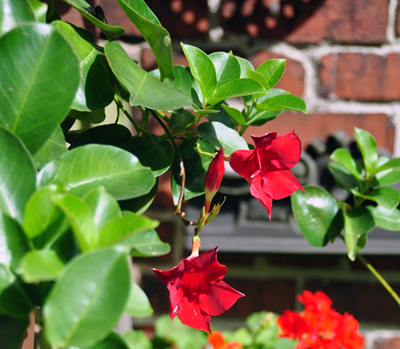
 The last three days began the fall into autumn. Leaves litter the backyard; it’s dark at 7:00 in the morning; and the sun sets by 7:30. September always has a cold week and then we settle into the cool of autumn. This year the cold week came early.
The last three days began the fall into autumn. Leaves litter the backyard; it’s dark at 7:00 in the morning; and the sun sets by 7:30. September always has a cold week and then we settle into the cool of autumn. This year the cold week came early.
It takes me a while to work through the many features on my fancy cameras. This summer I moved totally away from the auto setting and began to shoot with aperture preference. I wanted the depth of the le Marche landscapes, and therefore I had to abandon the flat renderings auto setting even if ease of use had to also be abandoned. I also had to make adjustments for my indoor shots and that too put me into a more manual approach. Each step I take away from the auto setting I get more control over my shots. But I always take a while getting to where I can influence the technology. (I’ve spent more time in the post-shooting phase and have learned Photoshop better.)
My most recent venture has been into Picture Control. I wanted to shoot the flowers in my back-yard in ‘vibrant’ mode, mainly to get used to the setting. I’m going to leave it on this setting for the next couple of months while I shoot various landscapes. The vibrant setting will capture more primary colors.
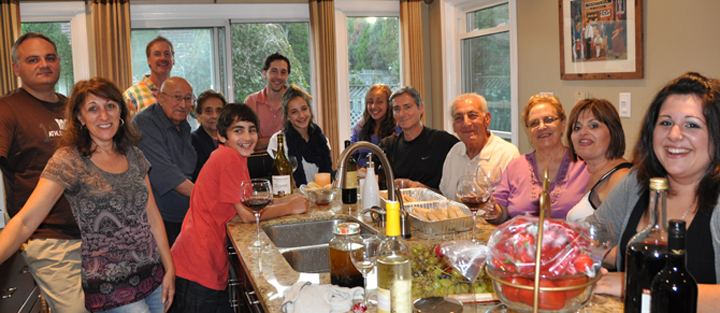
For many years we’ve been collecting at Mary and Dom’s for Canadian Thanksgiving. It’s my favorite family holiday. And this year we got to christen the new kitchen and dining room.
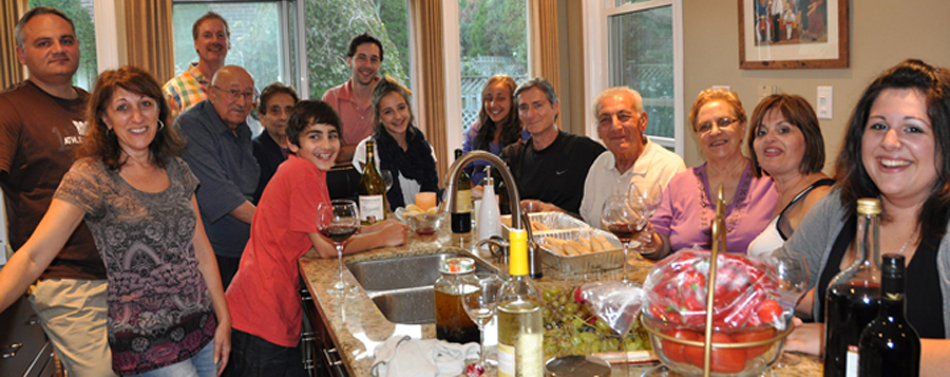
left to right: Rose, Dom, Daniel, Ciccio, Dave, Mafalda, Christian, Seane, Alyssa, Derrick, Milio, Gina, Christine, Dana
(Mary and Mario are missing. I’m taking the picture; I don’t know where Mary is.)
I head out Friday night and drive 2 hours to Fredonia, NY; stay overnight at a B&B and in the morning head out for Toronto. Saturday, I saw Dave and Christian before they went off to play golf. Also saw Isabelle before she went to church services.
Seane, Ciccio, Mafalda and I had lunch on the cedar deck with its cathedral roof framing the autumn trees. We then headed out to Mary and Dom’s. (The QEW and the 401 on a weekend – an LA experience in Canada.)
The eating and drinking begin as soon as we get there. The wine comes out, we start laughing and messing with each other. This year the messing was about my hair. Gina kept telling me it made me look old. My answer, I am old. The rebuttal, But you don’t want to look it. Me, I don’t care. Next, Mafalda threatened to cut it. At one point she came up behind me with scissors. I looked to Alyssa for support, because at a younger time she had cut her hair while playing with her dolls and we all mess with her about that. I was hoping she would be on my side, BUT she would never go against zizi Mafalda. She likes zizi Mafalda way more than she likes me.
Christine and her daughter Dana joined us this year for the afternoon bantering and the mixed-up dinner. (Dinner begins with Gina’s lasagna, this is followed by turkey, my American stuffing, mashed potatoes, Italian rapini and Canadian desserts.) Christine has become family. And she can mess with the best of us.
Christine reads the journal and then reports to Mary on my whereabouts or reflections. (She has been secretly wishing for a mention. Honey, this is your debut – a pic and two paragraphs.) I have to be careful what I write, Christine is good at reading things in the entries that I think are hidden or not there. She can recognize nuance and interpret it.
Around 10:00, Dave, Christian, Seane the parents and I headed back to Oakville. I usually leave to come home Sunday morning at the crack of dawn. (Anything to avoid the QEW jams.) This year I had made arrangements to visit with Frank and Norma, so I was there Sunday morning to spend time with Seane and the parents.
At noon and headed back into town to visit with Frank and Norma. (Francino and I first met back in 1964, the summer before 8th grade. Two Calabrese kids living in the Soo. He’s from San Giovanni in Fiore and I’m from Aprigliano. The hill-towns are 45 minutes apart. We have been in each other’s lives through schooling, college, weddings, births and deaths.)
I missed visiting with Norma. She was out with her cousin. I enjoyed my time with Francino, but then I always do.
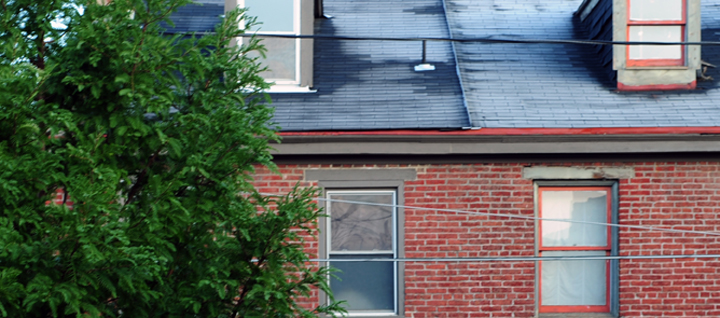
Woke up this morning to the chills of autumn, one of favorite seasons.
The white roofs on the houses in the alley, remind me of September mornings in Sault Ste Marie when I’d walk to St. Veronica’s Elementary. The chill made the air clean and raw. The roofs painted with thin white frost were fingers pointing to December snows. But at 13 who cared that those cold fingers scratched at the memories of a warm Calabria my parents and grandparents treasured. Winter was coming, we could play street-hockey, go tobogganing, unwrap presents. Calabria was a faraway place, lost in memory. It didn’t belong to me. I was running to assimilation.

Forty-seven years later, I still like the white roofs, the raw chill of fall. However, this time ’round, it’s me who clings to the memories of a warm Calabria; to remembrances found and finally understood. And I’ve discovered that assimilation is only one lane of the track; it’s only one of the markers at the cross-road.
I can run on both the inside and outside lane. I can read the signs regardless of language. And winter has lost its appeal. Like my parents and grandparents before me, it has become a season of memories.
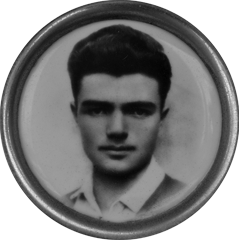
This the 10th year anniversary of the attack on New York City. This is the 10th year anniversary of Jo’s death. The image with this post is of another young person who died at an early age. The memories for this post are of the funerals in Aprigliano.

One – I am walking down to Corte and passing a house where the family and friends were sitting around a coffin. A woman had died. The coffin was in the middle of the room, shrouded with a black lace covering. Around the coffin were tall candle holders and the candles in them were all lit. Around this were chairs and people saying the Rosary. Whenever I’m in Aprigliano I walk by this same house. It is now empty, abandoned.
Two – The coffin would be taken from the home of the deceased to the church for the Mass of the Dead. My friends and I are running through the side-alleys to watch the procession from the home to the church. It was about catching a glimpse of the procession.
Three – A baby died and for the first time I saw a baby-size coffin. It wasn’t black; it had gold slats on top. The child’s mom walked behind the coffin crying. It was a sunny day and they were taking the coffin to the cemetery. The mom was a Belsito. That image is still in my head. I can picture the woman on the road leading from Santo Stefano towards Guarno and then onto the cemetery.
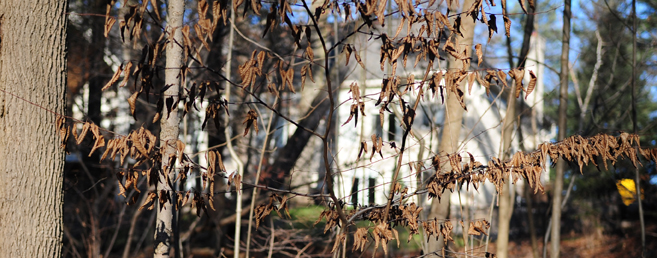
Spent the weekend visiting in Toronto. No snow and no miserable winter weather.

Today was sunny and balmy, so I decided to head down to the small watershed park behind the Thorman’s. Looking up at the house its clean lines were lost in the brown of dry leaves and the bare of winter branches. But the sun caught the back of a dead leaf and for a shutter second gave it life, painting it summer-yellow.
The misty house in the background, the leaves and the branches in the foreground create a New England landscape in suburban Toronto.
Yesterday, had dinner at Frank-and-Norma’s. The before dinner treats included roasted chestnuts. (David, their oldest, and I polished them off.) The main course was roasted goat, oven-roasted potatoes, green beans and salad. (The goat-and-rosemary was a recipe from Frank’s mom.) Dessert was prickly pears and poppy-seed cake.
Daniel and his girlfriend joined us for dinner. He’s working on a documentary for his final project in his journalism program.
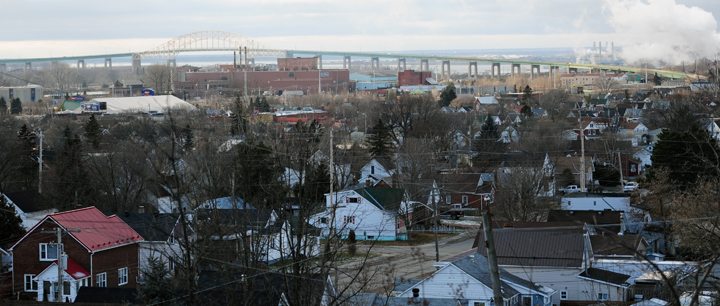
..
The drive up to the Soo was free of snow and ice. And the time is always an occasion for self-reflection and anxiety about the upcoming holiday. (The anxiety is a new awareness, in the past I suspect it was hidden in anticipation, but I guess age strips away the need to hide.)
I went up early, because I could not stay beyond the 25th. This gave me time with my parents before the onslaught. We’ve established an easy routine – 11:30 and 5:00 my dad calls us to eat and the three of us talk all through the meal. (Let me mention that the TV is on all day, playing out the sordid details of the soap bimbos and bimbettes. The American and Italian soaps are populated by similar replicants. The difference is the words and the landscapes. The tits are similarly perky and the angst is all consuming regardless the longitude.)
Today I decided to go up to the old St. Mary’s and shoot some pics. The image below is the landscape we saw every morning as the yellow bus pulled up the hilltop and deposited us at the front door. Even though the the new St. Mary’s is a French immersion high school, students still use the same front doors we used 50 years ago. (The old St. Mary’s – Boys Catholic High School, is now at the bottom of the hill in a building that used to house a vocational high school. Also, the school is no longer single sex; it is now co-ed.)

The bridge is the gateway into the Upper Peninsula and the United States. (It’s the road home.) The smoke on the right is from the steel mill. (I worked in the rolling mill the summer of my junior year.)
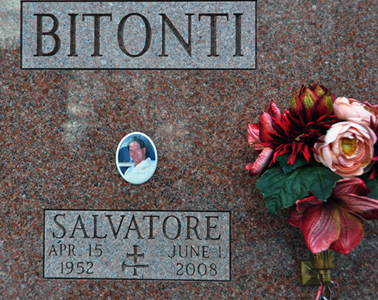
 A visit to the parents now includes a trip to the cemetery. Let me say it this way, my mom and I go to the cemetery. We begin at my grandparents’ grave and then go visit all the people I knew when I was growing up in the Soo.
A visit to the parents now includes a trip to the cemetery. Let me say it this way, my mom and I go to the cemetery. We begin at my grandparents’ grave and then go visit all the people I knew when I was growing up in the Soo.
In the last couple of years the trip has included a visit to Sam’s grave. Sam is Frank’s brother and we all grew up together. (In my head, I can still hear his mother, her distinctive pitch, calling “Satu” – the old Calabrese diminutive and endearment for Salvatore.) Frank and I had given up the old words. We traded them for assimilation into the new Canada. We called him Sam.
I didn’t do well in the hyper-hockey environment of 1960’s Sault Ste Marie and Sam didn’t play hockey because he was crippled by polio. I was his brother’s friend; I was 3 years older than him; I was another immigrant; I was another Calabrese. Sam and I got along. He had an amazing sense of humor and could make me laugh or embarrass me with his observations. All of us would be sitting on the floor in his parents’ living-room on Carufel Avenue, watching TV and he would make a comment that had me laughing out loud; that had me speechless; that had me sweating with embarrassment. It was never anything crude; it was never anything cruel. He just knew how to hit the right nerve, suggest the right nuance, play the right ambiguity.
I wish I had known him as a grown up, because now I could appreciate his nuances, his ambiguities. Now, I could give him a run for his money and we could laugh … even louder.
The 2012 category-group contains the floowing categories:
Christmas-12
le Marche-12
Harrow-12
Kaua’i-12
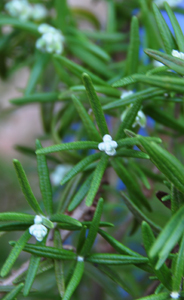
 On December 26, I left the Soo and headed home. The day was sunny so I drove through doing the 10 hour trip in one sitting. And the weather has continued to be bright and mild. Last weekend it was warm enough to put my rosemary plant out in the sun. The plant had buds, and I wanted to expose these white nubs to the warm winter sun.
On December 26, I left the Soo and headed home. The day was sunny so I drove through doing the 10 hour trip in one sitting. And the weather has continued to be bright and mild. Last weekend it was warm enough to put my rosemary plant out in the sun. The plant had buds, and I wanted to expose these white nubs to the warm winter sun.
I positioned the rosemary in front of my big-blue-marble and shot it in Vibrant mode. (Note: not a good setting in winter light.) I looked down the side flower-bed and noticed that the snowdrops were out. These harbingers of spring have never poked their heads out this early. (My friend Tom, who lives in the rarefied city of fog and mild climate that is San Francisco, tells me about playing golf and seeding new plants in the middle of January.) I like my seasons here in the North East with their distinct experiences, their punishing temperatures, their frozen earth, their dead greens, and their soft springs.
But things seem to be changing, so I have to ask; has the solar orbit gone a whack; has Washington lied about the blue haze of carbon emissions; has Michelle Obama inaugurated a new Camelot? Is there a legal limit to the snow here? Is winter now forbidden . . . all together?
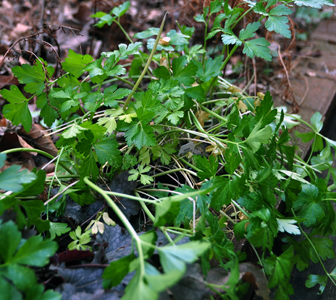
..
 A winter that had been truant for a month made a striking comeback.
A winter that had been truant for a month made a striking comeback.
But the parsley seems immune to winter’s frigid breath. Yes, it sprawls lifeless on the bricks when the temperatures mingle with the teens, making me think that it has lost its battle and given up its green to winter’s white. But today, it ducked the January winds, raised its stems and invited me to pluck its green, flat leaves and add them to the potato salad.
I was thinking they would be void of flavor and serve only to color the Yukon Golds flat faces. I was wrong; the pungent taste survived winter’s freeze. The chopping released the oils; the green flecks spotted the golden wedges and reminded all the dinner guests that we had not lost the battle to the Arctic winds.
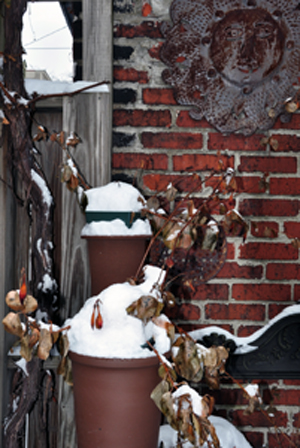
 I’ve been listening to the song Where is Henry Ford by Micah Schraft and Eduardo Machado and it brings back memories of a bucolic Upper Peninsula and an industrial Northern Ontario. In that time, our eyes were all on Detroit, the powerhouse of the Midwest. It called many Southern Italians to this snow-bound land; its tentacles reached into Canada and it gave me the opportunity to work in the steel-mill and make enough money to pay college tuition and board.
I’ve been listening to the song Where is Henry Ford by Micah Schraft and Eduardo Machado and it brings back memories of a bucolic Upper Peninsula and an industrial Northern Ontario. In that time, our eyes were all on Detroit, the powerhouse of the Midwest. It called many Southern Italians to this snow-bound land; its tentacles reached into Canada and it gave me the opportunity to work in the steel-mill and make enough money to pay college tuition and board.
But in my rush to liberation, to long hair I left behind the winter landscapes, the nights of conformity, the generation that had sacrificed to educate me. It was the 60’s, the time of the hippies and navel gazing.
We left behind the mills, the assembly lines, the unions, the suburbs and the sacrifices. I didn’t carry a lunch pail; I worked in mid-town Manhattan; I lived in Park Slope; I subscribed to conspicuous consumption. Michigan and Northern Ontario belonged to my parents. To the generation that had not gone to college, that had not found nirvana, that knew nothing of Timothy Leary, Mick, John and Ringo. We were going to remake the world. It was a new dawn.
We are children of decay
Living in a land that’s built on diesel fuel and clay.
We fight to see the Stars and live another day.
Fifty percent of us can’t read
Too many vacancies and hungry mouths to feed.
The country watches as our Motor City bleeds –
Empty houses under water, broken spouses, sons and daughters.
Question now is; where is Henry Ford?
…
We now anticipate a dawn
Born from the ashes of this destructive porn.
We’ll build a future and accept the past is gone.
So, why are our sons and daughters identifying themselves as children of decay? Didn’t we give them everything the new world had to offer? What do they mean when they claim to build a new future and accept the past as gone? Am I their past?
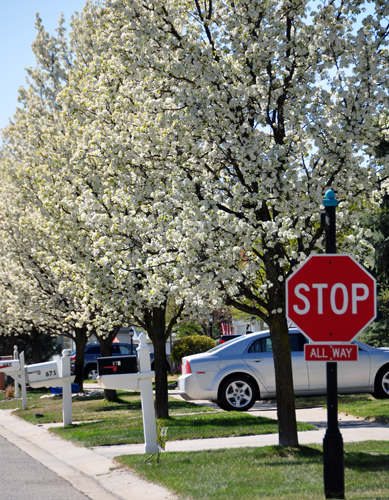
 I spent the Easter week-end at Rose-and-Derrick’s. The sky glimmered azure blue, the wild-almond swayed feathery white, yellow-green leaves sprouted from winter-wood and the subdivision residents sprawled on their concrete driveways.
I spent the Easter week-end at Rose-and-Derrick’s. The sky glimmered azure blue, the wild-almond swayed feathery white, yellow-green leaves sprouted from winter-wood and the subdivision residents sprawled on their concrete driveways.
Derrick decided to go kayaking and I went with him to take some pics. The lake was a mirrored-blue glass. After getting into the yellow kayak he skated on the frigid waves. I headed back deciding to walk through the subdivision and take pics of the spring bloom. I first came on a group of kids shooting hoops and normally I would have asked if I could shoot them playing, but for some reason I didn’t feel comfortable doing that, and I walked on. (Should I have interpreted that feeling was a premonition?) Next, I came on a second group shooting hoops; these guys were in their own driveway. Down the street from them was another young man, he was laying bricks. He belonged to a construction company working on a neighbor’s front yard. It was Good Friday. The contrast was amazing – the young priveleged and the young indentured. My next stop was the most jarring.
I came upon a house overly decorated for Easter. The yew bushes were dripping with plastic, pastel eggs, the front door was ringed in Easter bunting and the mail-box was a kaleidoscope of sixties colors. I began shooting. Immediately a gentleman in his 50’s, balding came out demanding to know what I was doing, who I was, if I was from the area, … He took my picture with his cell. I haven’t met anyone this aggressive in years. I answered all his questions and at the end I apologized for giving him any wrong impressions. He left saying that he felt better after talking to me.
So, what am I supposed to make of all this? He obviously thought I was dangerous. He must have thought the fancy cameras were a disguise and that my real purpose was to case-the-joint. What must be the world view of a person living in a gated community, in south-eastern Michigan who on a sunny day, seeing an old man shooting pictures of his over decorated house interprets the scene as dangerous? Does the fact that the largest Muslim community in the US lives 20 minutes south on I75 have anything to do with his reaction? Does he belong to one of the new political factions that want their country back?
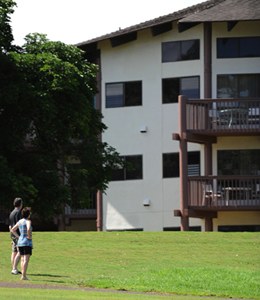
1st entry – kaua’i 2012
This is my second visit to Kaua’i.

The image on the right is of Rose and Derrick looking up at the time-share. The complex is in Princeville, and is situated on a golf-course. (Rose and Derrick are on the cart-path looking up at the apartment we are staying in. The lanai overlooks the 12th tee.)
Once we landed, we headed to Costco to shop for the week. Tomorrow we will go to the farmers’ market in the south and stock up on fresh fruit and vegetables. We will eat breakfast and dinner on the lanai. It’s two of my favorite times. The morning sky is a soft-blue raceway that clouds speed from the ocean to the mountains. In the evening, the sky is star studded.
We are sitting drinking a wine from Puglia and Orion looms above us. To his left is the brightest star in this Tropic-of-Cancer sky. I think it’s Aldebaran, part of the Taurus constellation. Its name – Follower – comes from its position below the Pleiades. (Probably my favorite word in the English language.) Who wouldn’t want to follow the seven sisters? One of them has to be beautiful.


This year we decided to do more walking. And this morning we hiked through the golf-course and down the path beside the fancy Westin Resort to Anini Beach. (As a non-sun, non-sand, non-snorkeling person this is my favorite beach. Yes, I can just hear the reader say, then what the hell are you doing going to Kaua’i?) The waters of Anini Beach sit between the coral reef that surrounds Kaua’i and the white sands of this northern cove. Absent is the under-tow, absent are the mighty waves. Its languid surface is a respite. Its flat waters make it a favorite for first-time triers of parachute surfing.
On our way back, we decided to circumvent the golfers and made a wide arc to the next hole. And there sitting beside the cart-path was an albatross chick. It was bigger than a Thanksgiving turkey. The sign labeled it a Laysan Albatross. There was no evidence of its parents. They must be out with the parachute surfers riding the thermals.
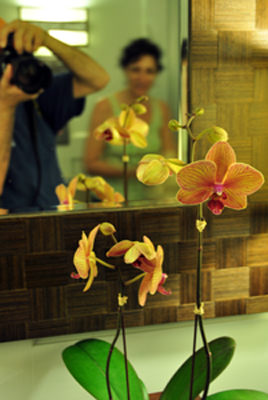

The St. Regis is the fanciest resort on the island and it’s a short walk from the time-share. Last year we went there for mimosas and a glimpse of Puff frolicking in the mists. (The price to see the dragon was exorbitant for a hide-bound budget.) This time we took the steps, along the side of the resort, for our trek down to Hanalei Beach. The resort is built on the cliffs that overlook the bay.
On our way up, we went through the hotel. (It amazes me that you can walk into this super fancy resort and no one asks if you belong. There we were interlopers mingling with the rich-and-famous.) BTW, going back up the cliff through the resort was much like the experience in San Marino where elevators are carved into the mountain and you can ascend to the top in Disneyland comfort.
The elevators ascend through a series of levels, and because you are on the cliff slope, you periodically get off one set of elevators, walk through a fancy lobby to the next set of elevator banks. And even these secondary lobbies are decorated with the best of stuff. I loved finding the orchid in front of the mirror.
(I suspect one of the reasons no one asks if we are staying at the resort, is because I’m walking around with two expensive cameras on my shoulders. I guess looks can fool most of the time. It’s Rose and I in the mirror.)
..
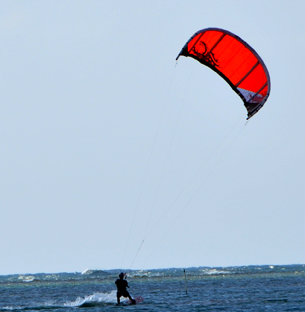

In the morning, we crashed the posh, frou-frou St. Regis, in the afternoon we headed south – the Maha’ulepu area – and drove a dirt road paved with ruts in search of secret beach. (Whenever we go on one of our off-road adventures, Rose is anxious and back-seat drives; I am in the back seat and remind myself that Derrick is a really good driver.)
Secret beach wasn’t as secluded as I had thought. (There are three beaches in the area and we lighted on Gillin’s Beach.) It was full of kitesurfers skating the waves. (Yes, I know the thrill of skating an ice-rink alone in the early dawn – gliding the corners, flying the straight-ways, spinning and pushing backwards. And I love speeding hills on long, waxed skis. But, I’ve never had any desire to surf until I saw the kiteboarders.) The surfer is on a board and attached to a parachute/kite he maneuvers to ride the waves. There were easily a dozen kites harnessing the wind. Their red, green and yellow sails streaked the blue sky.
My favorite part of the show was when the wind would lift the surfer and for a brief moment he was airborne and free. I kept thinking of William Woodsworth’s Daffodils –
.
The waves beside them danced;
but they out-did the sparkling waves in glee.
.
I gazed and gazed but little thought
What wealth the show to me had brought: …
For oft, when on my couch I lie
In vacant or in pensive mood,
They flash upon that inward eye
.
And then my heart with pleasure fills,
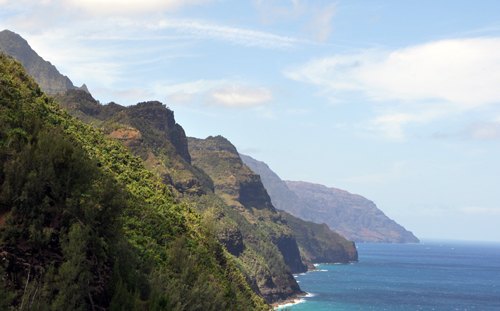

The trail at Ke’e Beach was something that we didn’t get to last April, but I wanted to walk some of it this year. We drove to the end of Route 56, parked and headed up to the trailhead. The park ranger explained the difficulty and the cautioned us against dismissing his comment as over-cautious. (I announced that I was willing to do a mile-and-a-half in. And given that I had a pedometer, I got to monitor the trek. I’m always over-cautious so the ranger’s warning was just a second super-ego affirming my plan.)
To my surprise the trail is well maintained, well marked, well planned and accessible to hiking novices like us. We climbed over rocks, we walked on packed red earth we walked through streams down into the valleys and back up the mountain side. The amazement were the vistas down to Ke’e Beach, the vistas of the Na Pali coast.
Last year I saw these coastal mountains from a catamaran, this year they stretched in front of me. Each bend framing these green giants with their fingers reaching into blue waters.
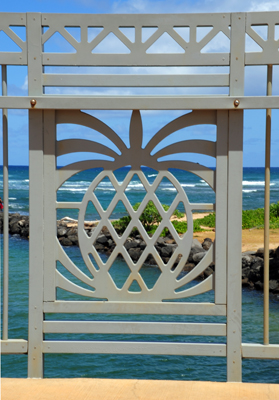
Kapa’a is the everyman town in the north-east sector. (Hanalei is for left-over hippies. Where else would old, bald counter-cultures land, than where the dragon frolics in the autumn mists?) The image is of the railing on the walking-bridge over the Wailua River. The pineapple filigree – a memory of long ago plantation indenture – borders the bridge-deck.

The locals fish from the deck, from the river’s shore, oblivious of the tourists in their Crocs and Keens. In Kapa’a the locals dress down. Here the locals go to bingo-night in cinder-block community centers. Here people have heft; their bodies have curves; their skin is brown; their eyes are coral-black; their hair is straight. (Here the resorts have security patrolling the disneyland grounds, keeping out them locals and making the gate-community native-free.)
The long beach that lines Kapa’a is populated by these locals, these real people who work 8-hour days and can’t sit by the pool basted in SPF 100+ sunscreen. They are the store-clerks, the construction workers, the park-rangers, the teachers. At one end, families fill the pools created by a barrier reef that is 20 meters from shore. At the other end, the reef is broken and surfers ride the waves that sneak through and run to the shore. In between, tourists monopolize the sands, but share the sun.
Along the beach, the town has built a trail that tourists walk. (There’s a voyeuristic element in walking the flat, concrete trail. It’s like come on down and see the real Kaua’i – the old men, their faces cracked like the glaze of ancient pottery, the skinny surfers riding cheap boards, the multi-generational families with no blond children.)
All this sounds rather duplicitous coming from someone who walked the trail, photographed the locals, wears croc slip-ons and keen sandals. Too bad, it’s my journal/blog; I’m the author; I determine content; and I don’t allow comments.
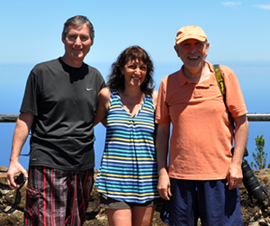
The read this series in chronological order,
click on the category title – Kaua’i-12.

Waimea Canyon, last year shrouded in mist and rain I saw nothing of the gorge. This year, the weather held and there were the green depths, the vermilion sands, the blue skies, and purple waters.
(I rarely post pictures of people, let alone a pic that I’m in, but I thought I’d try it. Some nice tourist took the pic. I set up the shot and told her to keep snapping. She was surprised that I was willing to let her take multiple shots, and once over the surprise, she began to compose shots, change angels, even come in closer. This is the one I like best. I cropped the bottom portion, because I was wearing my bloomer swimming trunks and my legs look like match sticks when I have them on.)
The canyon, on the south-western side, was created by the collapse of the volcano that created Kauaʻi – the oldest island in the archipelago. This canyon, painted in Crayola colors, is part of the Waimea Canyon State Park, one of those government creations that we now seem to dismiss as we wallow in anger and hate in our political discourse.
There are several vantage points, the first is where all the tour buses stop, but we headed for the highest outlook. And there below us in verdant depths, its sides streaked with ochre fingerprints, lay the grand canyon.

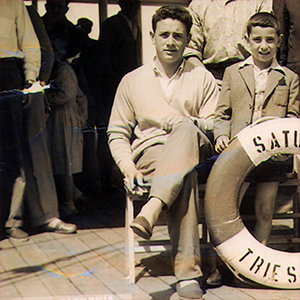
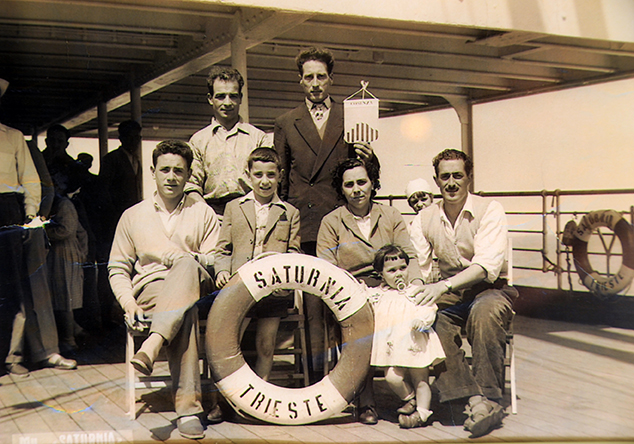
Salvatore De Fazio
Sam was my mother’s cousin. (His mother and my maternal grandfather – Eugenio Perri – were sister and brother.) He died today after a two year bout with cancer.
In the picture, he is in the front row, seated on the far left. (Seated – Salvatore, me, Mafalda, Connie and Ciccio.) As a matter of fact, Salvatore gave me this picture. Our copy is lost somewhere in my parents’ house in Sault Ste Marie.
Salvatore’s family is from Corte. His mother was a Perri. My parents lived in Corte after getting married and it’s the neighborhood where I was born. (Our house was next door to Salvatore’s family.) My mother favored her father’s side of the family and many of her best friends are from that branch. (My grandmother’s family is from Santo Stefano – the neighborhood up the hill. And her family house was in that parish, so that when they left for Canada, my parents inherited the house and we moved up the hill. But all my favorite relatives were down in Corte and I constantly went up and down the hillside visiting.)
Salvatore left Aprigliano at the same time we did; we traveled to the new world together. Salvatore was there that first night when I ate-up all my soup only to throw it up into the bowl I had just emptied. He was there below deck as I stood and stared at the Orthodox priest and his wife. He was there as Mafalda hid Connie’s chickenpox from the authorities in Halifax. He was there with me as I leaned out the train window and saw a priest in his cassock crossing the rails in the Montreal train-yard. But then he left, taking a south-bound train to St. Catherines. We headed north to my grandparents and Sault Ste Marie.
In Memorium
A couple of hours ago, Mafalda called me to tell me that Sam had died. (I knew Salvatore was very ill. I chose not to go visit him back in October, because I didn’t want to see him dying.) I was in DC, at a bowling alley, with my 10th graders when my phone rang. I stepped into the night into the rain and listened as Mafalda cried. Mafalda’s best friends were from this side of the family, and I too liked this branch, in fact Salvatore was one of my favorites. (From this favorite branch, only Maria Lucente is left in Corte and I always visit with her when I’m in Calabria. BTW, the room she is in, is my parents’ first apartment and I was born in this room.)
Among the extended family, in Canada, Sam is known for his amazing fig-trees. And the fig-trees that grow in my backyard, that grow in Rick and Sarah’s backyard, that grow in Rose and Derrick’s backyard are from Sam’s garden in St. Catherines. (The original cuttings come from the mature trees on his family’s land in Corte.) Mine is a white fig, Sam’s favorite.
Sam, I’ll always think of you, of Corte, of the boat, of the ocean we crossed all those years ago when I look at the fig-trees.
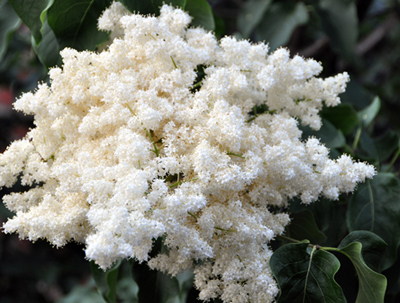
..
I used to live in New York City; everything there was dark and dirty. Outside my window was a steeple with a clock that always said twelve-thirty.

Outside my window, here in Pittsburgh, are the corporate towers of the Golden Triangle. At one time this city was the gateway to the west. It was at the confluence of the Monongahela and the Allegheny that Lewis and Clark began their great adventure. Later the city became the industrial heartland of a continent preparing for war. In the 50’s and 60’s it took its place among the corporate elite and later still it re-invented itself into the Paris of Appalachia, the City of Bridges. Its new colors are sustainable-green and finished-steel blue.
Outside my back-porch is the beautiful Japanese Lilac of the above picture . For a week, every spring, it blooms in glorious clean-white. The new Pittsburgh moves through its seasons, its hours in monastic rhythms. Its sports teams announce the seasons; its church bells the hours. And the hollows and rivers celebrate its neighborhoods.
Young girls are coming to the canyon and in the morning I can see them walking. I can no longer keep my blinds drawn.
In New York City, I could never figure out my geographical boundaries. I don’t know if it was the immensity, the canyons that hid the sun, the silence, the traffic chaos, the windows that would not open, but I always felt at loose ends – where did I belong? If I walked too far east on Flatbush would I still safe? Where did Park Slope end and Bed-Sty begin? I never figured out how to use 8th Avenue, Grand Army Plaza and Prospect Park to define my neighborhood. In Pittsburgh, I know where I belong – the Mexican War Streets, the North Side. I know the boundaries. Friends remind me that it’s the topography that gives me the boundaries I like. I think it’s my reptilian brain remembering the hills and mountains of Calabria.
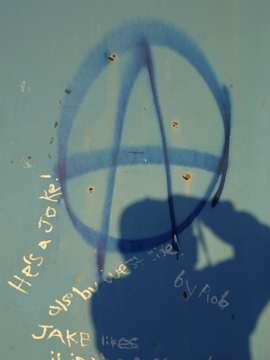
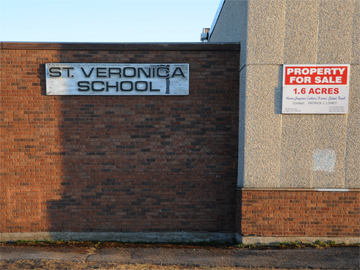 The present building has no windows, no classroom doors to the outside, no immigrant children making new friends.
The present building has no windows, no classroom doors to the outside, no immigrant children making new friends.
In June ’63, my family moved to the West End and for 8th grade I had to go to St. Veronica’s. It was an old school building. Each classroom had its own door to the outside; the exterior wall was mullion windows; and for the first time ever, I had a nun teacher – Sister Drusilla. It’s also the school and the part of town where I met – Frank, Ron and Rainer – three of my lifelong friends.
 A memory is of the four of us playing basketball on the outside court on a Saturday morning and my looking up and seeing the hills golden and crisp with fall. It’s an image still running through my synapses.
A memory is of the four of us playing basketball on the outside court on a Saturday morning and my looking up and seeing the hills golden and crisp with fall. It’s an image still running through my synapses.
It was here we played football and baseball, watered the ice rink for hockey and waited with baited breath while they build a small gym on the creek side. (We got to use it once or twice before we graduated and left for St. Mary’s College, never to use it or visit again.) And it was in our eighth grade classroom that on November 22, a Friday afternoon, Sister Drusilla announced that President Kennedy had been shot.
Fifty years later, the walls are streaked with graffiti, home-plate is littered with broken glass, and chain-link perimeters the creek. The fields and the old-school are waiting for the bulldozer, for the children now grown to visit one last time.
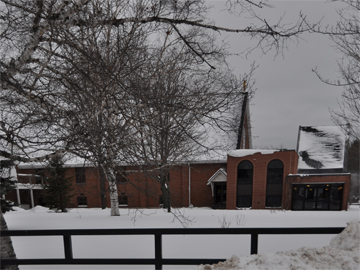
St. Veronica’s is the church where I served as an altar-boy, it’s also the church where Dave and Jo’ got married. It was a simpler building back then without the elaborate, two-part entrance.

I purposely left all the grey in the pic, to remind me of the gloom that was winter in Sault Ste Marie. I remember painting this metal fence the summer between 8th and 9th grade. Back then the parish supported the Catholic Boys High School that I went to and it wasn’t unusual for the parish priest to get work out of the boys that attended St. Mary’s High School on tuition-support. I was in the renovated church four/five years ago when Mimi and I went walking and found it open. The parish priest allowed us to shoot in the sanctuary. It looks nothing like it did 40 years ago.
The parish still has a good size population and I’m glad to know that the area hasn’t been abandoned for the new subdivision plans.

Time period: June 1963 to August 1964
Location: Sault Ste Marie, Northern Ontario
Sentiment: Quiet longing
My family bought a house in Korah – the north-west end of town. I remember going with my dad to look at houses. The realty agent showed us two houses on Turner Avenue, a large older house, which I liked and the smaller house next door which my dad liked. The small house had a truncated roof-peak.
Korah was a neighborhood of older homes and my dad bought the small house on Turner, because it had a double lot and he could expand or even rebuild. (I was more concerned that it was up-the-street from the Tube Mill.) In early July, we moved out of my grandparents’ to our new house. My new school would be St. Veronica’s Elementary.
The journey begins the summer of ’63, when I met the guys that would become my best friends. These were the kids that I played softball with; the kids that I went fishing with. We were the four teenagers that rode double on our bicycles in order to go swimming at Leigh’s Bay. The four friends – Rainer, Ron, Frank and Mario – that played Canasta at Ron’s; that snuck into the Boat Club and played tennis on the fancy courts; that piled into Ron’s car and headed into the back-country.
now I’m going back to Canada, on a journey through the past
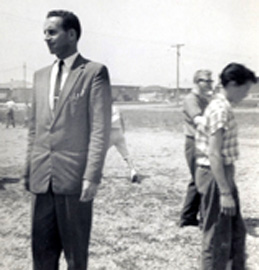
My thinking is that I will use this second entry to situate the time and context for this series.
 The image on the left is of Mr. Murphy my principal at St. Theresa’s. He was my first principal in Canada. When we came in 1957, we lived with grandparents and the school I was enrolled in was St. Theresa’s. (Even though I was 8 years old, Mr. Murphy put me in second grade.)
The image on the left is of Mr. Murphy my principal at St. Theresa’s. He was my first principal in Canada. When we came in 1957, we lived with grandparents and the school I was enrolled in was St. Theresa’s. (Even though I was 8 years old, Mr. Murphy put me in second grade.)
And a memory that is forever burned in my brain is of him giving me the strap, because I was loud and playing on a slide-mound during recess. (He was both handsome and scary.) I never quite figured him out and was glad when my parents bought a house on Turner Avenue and we got to leave St. Theresa’s.
The image of Mr. Murphy reminds me of how empty the area was: there are some bungalows in the background. In the late fifties this was a new subdivision. St. Theresa’s was a newly built school. Most of the families who moved here had left old James Street – the Italian ghetto – for the greener fields of the northern section of the west-end. There was still enough undeveloped land, around the school, for my friends and I to play hide-and-seek in the surrounding fields. And the parish church for the area was St. Gregory established in 1954, three years before we came to live the Soo. The original church was a long rectangular box with a flat tar roof. The idea was that the super-structure would be built once the area filled up with families. (When they finally built the new church in the early 70’s, the basement was demolished and a very different footprint was used.)
I’m heading back up to Sault Ste Marie for the Christmas holidays and am hoping to find some old pictures of old St. Veronica’s Elementary School. BTW, the date on this entry is really December 5, 2012, but I’ve changed it to fit in with the other 8th Grade post.
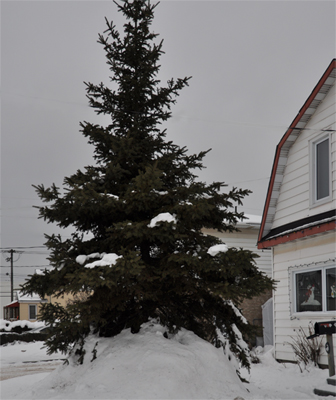
We had moved from my grandparents’ to our new home on Turner Avenue. (I remember going to look at houses with my dad and liking the big old house next door. It’s the house in the pic. The big old house offered 2 floors and lots of options for my own space.) The house they bought was small, but it sat on a lot-and-a-half of land and my dad wanted the added space for a garden. He also believed that the smaller house would be easier to remodel and enlarge. The big old house would be harder to renovate. (My dad has always needed something to renovate or remodel. The little house with the truncated roof-peak was a fixer-upper, right up his alley.)
The house they bought was small, but it sat on a lot-and-a-half of land and my dad wanted the added space for a garden. He also believed that the smaller house would be easier to remodel and enlarge. The big old house would be harder to renovate. (My dad has always needed something to renovate or remodel. The little house with the truncated roof-peak was a fixer-upper, right up his alley.)
Shortly after moving in, my dad began to dig out a basement and it was my job to carry the cinder-blocks from the pallet to the mounds of earth that lined the perimeter of the dig. (I hated the job, because it meant chores rather than going out to play with the new friends I was making.) And yet watching my dad, his friends and relatives dig the earth from under the house was an adventure. I could jump down and walk the footer, inspecting the cribbing columns and hydraulic jacks that now held our house. (But never far from my mind, in that summer of 1963, was the fact that in a couple of months I would be going to a new school – St. Veronica’s.)
The actual date of this entry is Sunday, February 17, 2013.
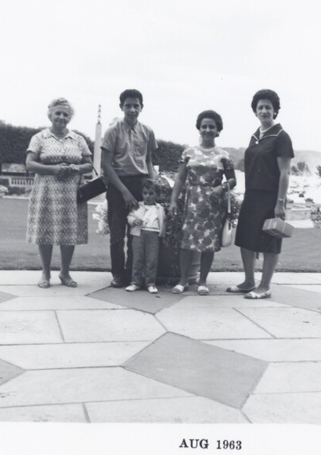
The summer before 8th grade, I went to Toronto with my uncle, aunt, Rose and my grandmother. On the ride down, I remember going in and out of rain-showers. We were driving Highway 17 and we’d go through sheets of rain and then come out onto dry weather only to go through the next sheet. It’s an experience you can have only traveling in a car.
 The image on the left is us in Niagara Falls. (Left-to-right: Maria, Mario, Rose, Egilia, Nunziata) It must have been a side-trip. I bought Mafalda these Niagara Falls decorated shot-glasses that she still has 50 years later. The other memory I have of that trip was my staying at my grandparents’ rather than with everyone else at Nunziata’s. (That too felt grown-up – being allowed to go on the trip and then being allowed to stay somewhere on my own.) The trip was also the end of a period in my life, a time I associated more with the Perri side of the family than the Zingas. It was the bookend to our trip from Calabria, because the next phase was really about being Canadian. Living and being with the Perris was the first experience after immigrating. Now, on Turner Avenue, I would be able to write my own story.
The image on the left is us in Niagara Falls. (Left-to-right: Maria, Mario, Rose, Egilia, Nunziata) It must have been a side-trip. I bought Mafalda these Niagara Falls decorated shot-glasses that she still has 50 years later. The other memory I have of that trip was my staying at my grandparents’ rather than with everyone else at Nunziata’s. (That too felt grown-up – being allowed to go on the trip and then being allowed to stay somewhere on my own.) The trip was also the end of a period in my life, a time I associated more with the Perri side of the family than the Zingas. It was the bookend to our trip from Calabria, because the next phase was really about being Canadian. Living and being with the Perris was the first experience after immigrating. Now, on Turner Avenue, I would be able to write my own story.
This is the first time I’ve connected the trip to Toronto and Niagara Falls to the summer of 1963. (It was an amazing year for change – moved to Turner Avenue and away from the connection to Calabria, went the Toronto and Niagara Falls without my parents, went to a new school and met the crew that would become my best-friends.) Had no idea these events all occurred that year.
The actual date of this entry is Sunday, February 17, 2013.
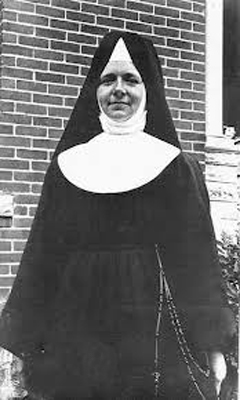
Sister Drusilla was the principal of St. Veronica’s School. She was also the 8th grade teacher. And she was a Sister of St. Joseph. It was the first time I had had a nun as a teacher. Back at St. Theresa’s there were no religious teachers, all were lay-people. Only the older elementary schools in the older neighborhoods had nuns and St. Theresa’s was one of the new schools in a newly-built, Henrietta Street community. 
Having a nun as a teacher was strange for me. My memory of nuns was from when we were living in Aprigliano and Mafalda took me to Pietrafitta – the next hill-town over – to visit a preschool. The experience was horrendous. I hated the nun who walked us around; i hated the jail-like building; and I hated my mother for taking me there. I still have pictures in my head of massive, wrought-iron gates blocking cells and rooms and of a big, fat nun with a huge smile who I was sure was going to lock me up and beat me if my mother left. Mafalda tells the story of an out-of-control child who embarrassed her – screaming, carrying on and holding on for dear life; a child who had to be taken home and promised never to be sent back to that place. (My dad, being a man who didn’t trust nuns, was an ally.) And for the next 10 years, I was nun free.
There were two Sisters of St. Joseph at St. Veronica’s; the second one taught in the lower grades; and she was younger than Sister Drusilla.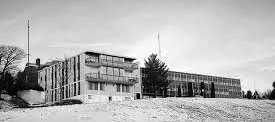 They were driven to school every morning and picked up every evening and taken back to their convent at Mount St. Joseph College. The image on the right is Mount St. Joseph College as I remember it. The right hand side was the girl’s high school; the left hand side was the convent.
They were driven to school every morning and picked up every evening and taken back to their convent at Mount St. Joseph College. The image on the right is Mount St. Joseph College as I remember it. The right hand side was the girl’s high school; the left hand side was the convent.
I have to say that I got along with Sister Drusilla. Not that she was warm-and-fuzzy, there was nothing nurturing about this Irish-Canadian, but I could appreciate her sarcasm and mean sense of humor especially if it wasn’t directed me.
The actual date of this entry is Tuesday, February 19, 2013.
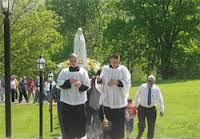
Francesco Bitonti and I have been talking a lot about our experiences in 8th grade and I keep being surprised by how different the two sets of memories are. He had lived in the West End and done most of his elementary schooling at St. Veronica’s. I came in 8th grade and did one year. He knew everyone in the class; they had been together the last six years. I knew no one and I don’t even remember how Frank and I met.
So, I asked Francesco if he was interested in conducting a dialogue. He’d write about topics and memories as I would, and we would comment on each other’s remembrances. Here is one of his first entries. The rally was in May of 1964.
Marian Day Rally and My Second Strap at St. Veronica’s
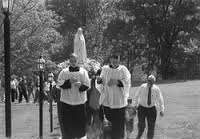 I don’t know if you recall this, but the Marian Day Rally was a Catholic procession in praise of the Virgin Mary held on the first or second Sunday in May. We had promised Sister Drusilla to be part of the rally with other students. However, on that Sunday, my dad needed our help, Joe and myself and even Nicky Porco, to nail down some roofing shingles on the garage. I don’t recall how Mike Rossi got into the picture. He was probably just watching us doing the shingling. Not one of us – Joe, myself, Mike Rossi or Nicky Porco – attended the Marian Day Rally that day. We had all committed to being there. On Monday, we were grilled by Sister Drusilla, who then proceeded to call in Mr. Tokar to strap the four of us because of our spiritual indiscretions. When my dad got wind of this, he was livid and was going to go down to the school. We begged him not to go. He took our advice. The scars healed easily.
I don’t know if you recall this, but the Marian Day Rally was a Catholic procession in praise of the Virgin Mary held on the first or second Sunday in May. We had promised Sister Drusilla to be part of the rally with other students. However, on that Sunday, my dad needed our help, Joe and myself and even Nicky Porco, to nail down some roofing shingles on the garage. I don’t recall how Mike Rossi got into the picture. He was probably just watching us doing the shingling. Not one of us – Joe, myself, Mike Rossi or Nicky Porco – attended the Marian Day Rally that day. We had all committed to being there. On Monday, we were grilled by Sister Drusilla, who then proceeded to call in Mr. Tokar to strap the four of us because of our spiritual indiscretions. When my dad got wind of this, he was livid and was going to go down to the school. We begged him not to go. He took our advice. The scars healed easily.
I have no memory of a rally or of being invited to participate. Joe is Frank’s older brother, Nicky Porco lived across the street from Frank and Mike Rossi lived down on Douglas. The three of them were a year older than Frank and I. Also, I vaguely remember a Mr. Tokar. Frank says he was the 7th grade teacher.
The actual date of this entry is Thursday, March 7, 2013.
This next memory from Francesco had me laughing out loud. (I read the email, while at my desk at work, and I began laughing. The other three admins in the office all wanted to know what was going on. I told them that once I had incorporated the info into the journal, I would send them the link to the hot Italians.)
End of the Year Party – Hot Italians
I don’t know if you remember Kenny Gibbs. He was this preppy, blond kid in our class. He got a lot of attention from the girls. It was June of 1964. Joe and Mike Rossi were planning this grade 8 end-of-year party at someone’s place. I remember that it eventually was held at Tony Guzzo’s house. His father was quite liberal and saw Tony as the next Ringo Starr.
At any rate, sister Drusilla somehow found out about this private party and she apparently told Kenny Gibbs to tell the girls to be very careful because Italians can get very hot. Even at early stages of puberty, I understood the implication. Nature had damned Italians to an uncontrollable sexuality. I don’t know if you were at the party or not. But there was some spin-the-bottle and a few innocent kisses but not much more. The Drusilla curse had struck!
I don’t remember a Sister Drusilla that was that connected to what we as kids were doing. In my memory she was this distant, tiny woman with a wicked sense of humor. And no, I wasn’t invited to the end-of-year party.
The last time I saw Frank in late February, he talked about the various sports and teams that were organized all through the West End. He talked about having played ball and hockey on neighborhood teams while growing up. And that these peewee teams were a strong tradition in the area. I knew nothing about the teams or their organization. Moving into the neighborhood at 8th grade and then going off to a high school at the other end of town kept me out of the network. And as the new kid, it also kept me from getting invited to parties.

 Years ago I lived in Highland Park, in the highrise on the horizon, and the walk around the reservoir was a discovery – a jewel in Pittsburgh’s East End. The walk around the upper two reservoirs is a three-quarter mile trek and an experience unlike anything available in any other American city. (The walkway reminds me most of the paths on Le Mura di Ferrara – the old walls around the city of Ferrara.)
Years ago I lived in Highland Park, in the highrise on the horizon, and the walk around the reservoir was a discovery – a jewel in Pittsburgh’s East End. The walk around the upper two reservoirs is a three-quarter mile trek and an experience unlike anything available in any other American city. (The walkway reminds me most of the paths on Le Mura di Ferrara – the old walls around the city of Ferrara.)
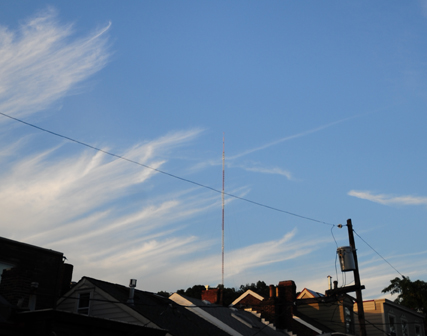
 I’m sitting on the back-porch above the rooftops, my D700 on the bench beside me and I look up at the sky, at the last light of day. On Samsonia, the setting sun is crawling the peaks of the row-houses as it struggles to stay awake. (In Aprigliano the day is asleep, settled into its cradle, breathing softly on its back and dreaming of tomorrow’s dawn.)
I’m sitting on the back-porch above the rooftops, my D700 on the bench beside me and I look up at the sky, at the last light of day. On Samsonia, the setting sun is crawling the peaks of the row-houses as it struggles to stay awake. (In Aprigliano the day is asleep, settled into its cradle, breathing softly on its back and dreaming of tomorrow’s dawn.)
But on the North Side, in the northern latitudes, summer’s rays still color the twilight and yesterday’s clouds streak the indigo sky. Broadcasting tower and electrical wires write on the night-blue canvas. This is a city-scape. And here romanticism must undergo the over-paint of urban operatives; and here nostalgia is bleached of its sepia melancholy.
But espresso and Sambuca can soften these ragged edges and let the mind’s eye play in the dying light.


The sentinels line the drive; stand guard against the invading maize. In Tuscany they would claim cypress heritage, but here in Harrow they pledge allegiance to the arborvitae. The setting sun exaggerates their height. And these giants bar the stalks that march in goose-step through the land-grant fields, from reaching the driveway, from reaching the house.
They’re the markers I look for when I scan the horizon while driving north on Erie Road. They’re the beacons in a sea of corn. They tell me I’ve reached land – Lynn-and-Rainer’s farm.
It’s odd to write about Harrow, Ontario and reference Tuscany. But the beauty I associate with that Renaissance state is mirrored in this languid landscape, in this new world of Upper Canada, in these tall sentinels that border Lynn-and-Rainer’s farm. In Tuscany the rolling hills provide the privacy and the cypress the boundaries, in Harrow the genetically modified corn wraps the property in its green arms keeping out the rest.
Bet the British never thought that some old Italian immigrant would compare the land-grant fields they doled out to the land of Botticelli. Bet those early settlers never thought that the daughter of Portuguese itinerants would own their manor homestead. Bet those early Canadians never pictured a bunch of immigrants – German, Portuguese and Italian – sitting on the porch talking and talking into the night and never thinking about working the fields.
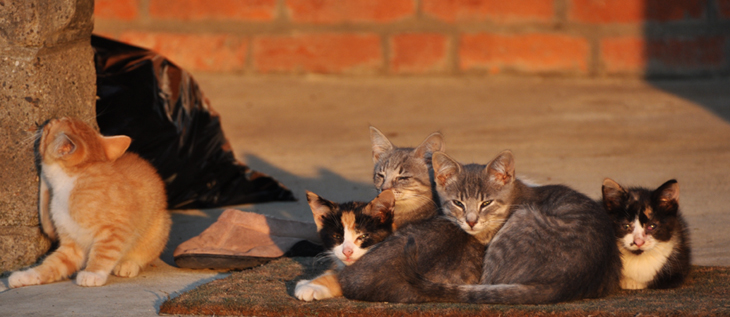

I woke up Saturday morning to this scene. Actually, after they realized I had no food and meowing didn’t change the fact, they abandoned their whining and went to sit in the morning sun. Immediately their cat-eyes were at half-mast. (The orange tabby was too rambunctious to sleep and she had an itch to scratch.)
Rainer told a gruesome story – a couple days earlier he was woken up in the middle of the night by loud screeches. He went downstairs, opened the door to see a coyote on the porch, one of the mother-cats in its mouth and blood all over the cement flooring. Startled, the coyote ran back into the corn, but not before leaving behind two dead kittens and the recently mothered cat half dead. Lynn helped the dying cat out of her misery. But the two remaining kittens, from that litter, are now orphaned. (The greys are from the litter whose mother was killed by the coyote.)
Lynn and Rainer feed and interact with the feral cats on the property. This pride is healthy, free of fleas and almost not-feral. They are great fun to watch. The kittens do all the silly things you expect, but their behavior is exaggerated given that there are over ten of them. (The kittens are from three mothers.)


Left home yesterday to make a 5:40 flight to Philadelphia. Between engine trouble and delays, didn’t leave until 7:00. My flight from Philly to Frankfurt also got delayed. Supposed to leave at 8:30, but didn’t leave until 10:00. (BTW, the Philly airport is new, and very nice. Even had charging stations, so my kindle and iPhone were fully charged.)
Made it to Frankfurt with an hour to go. (They had already booked me on the 6:00 pm flight assuming I would not make my 12:40 connection.) From the air Germany looks a lot like Pennsylvania in that it’s very green. The difference is in the clustering of the towns. For us, rural Pennsylvania is spread out. Rural Germany is clustered very close together and the surrounding area is all woods or small farms.
I made sure to deplane as quickly as possible, then at Passport Control I asked if I could go first and the efficient Germans let me. Next, I ran to the gate and made it with 20 minutes to spare. Rose and Derrick were happy to see me, otherwise they would have had to wait in Bologna until the later flight got in.
With all that hassle out of the way, the next worry was luggage – would my bag make it onto the Bologna flight? It did, we landed at 2:00. But the line from hell was waiting for us.
The next step was to pick up the rent-a-car. By 2:15 we were in line at Budget. We didn’t get up to the counter until 4:00. The drive to Earle-and-Suzanne’s (Isola di Fano) was supposed to be an hour-and-a-half. It took us three hours. On the Autostrada, we met up with all the Italians who were heading to the beach for the weekend.
We got in at 7:00. Ran down to Fossombrone to the grocery store, came back showered and had our first dinner in Italy. We polished off two bottles of wine between the three of us.
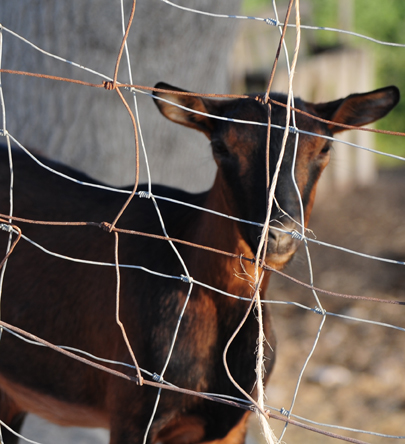
The farm up the road from us, has turkeys and goats. I love the billy-goats. And like Rainer’s cats, when I walked by they expected food – sorry guys!!

(It’s time to cook and eat. I’ll come back after supper.)
Today was a get-adjusted-to-the-local-time day, so we decided to explore the surrounding area. We went to the Gola del Furlo. It’s the valley and gorge of the River Metauro. It’s also the old Via Flaminia, the ancient road from Rimini to Rome.
So first about the house and my morning trek – the fields are different than last summer. Cut wheat-stalks cover the fields that last summer were plowed. There are no farmers plowing into the night, instead the fields are yellow with mowed wheat and bales of new-tied hay. At the farm next to us, the turkeys are still there and so are my favorite billy-goats. (This morning there was a breeze from the north; could it be the tramonto? And it perfumed the air with cow manure.) The waking sun crested the hilltop. I wanted to walk the field the sun lifted from, but it was too far away; maybe tomorrow morning.
At 8:30 the valley was alive with church bells. Yes, it’s Sunday and the bells called all to Mass. For me, the bells pulled memories of long ago. They are the Pavlovian bait that grabs me and throws me back to Calabria, to the late 1950’s; to a time when the rhythms of my life were governed by the agrarian and Roman Catholic calendar that acculturated me.
It’s midnight. Rose and Derrick have gone off to bed, and I’m blogging. I’ll finish the posting about the Gola del Furlo tomorrow morning.
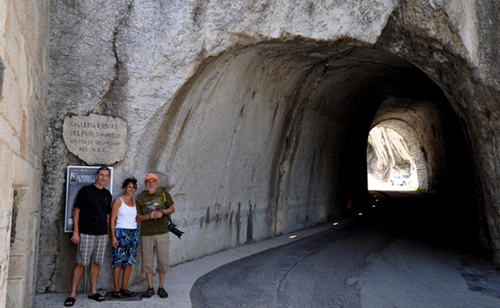
We decided to explore the gorge – Gola del Furlo – not realizing that the tunnels through the gorge were chiseled out by the Romans and their slaves. Who knew that the old Roman road la Via Flaminia was less that 20 kilometers from Isola di Fano. (Vetruvius was supposedly the architect for the tunnels through the gorge of the Metauro.) It’s amazing to realize that the two tunnels were hollowed out by hand. The pick marks are still there.

The structure on the left of us is a small un-consecrated church. (Also, between the two tunnels, was a grotto and some Italian put a statue in it. Whoever said stereotypes are not valid just has to look at the grotto with its madonna, votives and plastic flowers.) There was a young man, a volunteer, who told us all about the Via Flaminia. (In Italy, it’s young men who volunteer at churches and local museums. No sign of the old, retired ladies that volunteer at similar places in the U.S.)
The Italian word for tunnel is galleria. Rose keeps saying that the words sound so much prettier in Italian. The German overtones that permeate English are not there in la bella lingua.
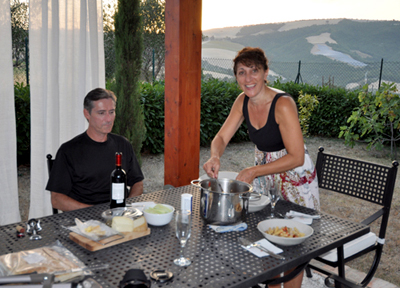
It’s Sunday, it’s August, the natives are no where to be found and nothing is open. (We knew that, hence the mad rush to the grocery store last night.) So we had to figure out supper. We settled on pasta with a sauce of fresh, sauteed tomatoes, chopped artichokes in oil, sauteed red pepper, and porchetta – a pork roll stuffed with wild fennel and garlic.

The pergola is an al fresco dining area on the property. We waited until the sun went down and then brought our food to the wrought iron table under the canvas awning.
The image is a repeat from last summer, when we sat down for my first meal in Le Marche. Then too Rose had made pasta with a fresh tomato sauce, and like last summer we ate under Earle-and-Suzanne’s pergola. It’s actually a stretch of the word, but it’s a wonderful structure, so un-Italian.
The property looks different than last year. Earle-and-Suzanne have tackled the garden area and are beginning to make some real changes to the ivy covered bank that is the base for the top-half of the property. (I love it when a property has different elevations, even if only a difference of two or three meters. My dad’s vineyard in Calabria was on three different elevations, and I remember how fun it was climbing the into-the-hillside steps between the three fields.)
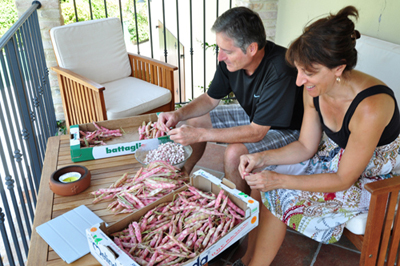
For Welch …
We got up early and headed down to Fossombrone for the weekly farmers’ market. (Fossombrone is the municipality that the house we are in, is part of. Isola di Fano is the village that the house is in.) The markets are a mishmash between fresh fruits-and-vegetables, household items and clothing. In my mind, it’s the mall coming to the consumer and therefore my kind of thing. Young Italians are more willing to go to the indoor box-store malls with parking and chain stores. However, so far there is not a critical mass heading to the box-store malls and the outdoor markets are still busy and vibrant.
I love all the fresh fruits and vegetables, my kind of thing, and not having to go to a mall or a Giant Eagle kind of store is an added perk. We walked around looking at all the products and then we settled on the one or two vendors we liked. This ‘liking’ is a gut feeling consisting of answers to questions such as – do they have nice looking sales clerks? are they pushy in their sales pitch? are they helpful and tell me things I don’t know? are they willing to let me pick out my own tomatoes? are they snobs with airs? (You have to ask this of Italian vendors. Snobby usually means a 10% increase on the sales price. And given that I can be snobby with the best of them, I can pick them out immediately and I’m not giving my money to snots. I may be one, but I’m not paying extra for the priveldge of being with my kind of people.)
When I go with Rose and Derrick to these things, I’m the voice of reason. Left to their own devices, they would buy everything in sight. When it comes to food buying their frugal approach to life goes out the window. Derrick saw the cranberry colored beans – faggiole Borlotti – and then decided to buy three kilos. Now the debate is – “Do we take them home to Michigan or eat them here?” Even my mother urged them to eat them fresh and cook them immediately. (They decided to take them home to Michigan.) Once we got back fromt the market, they sat on the porch and husked them into a bowl. (I love the fact that an iPad is on the table as they surciano le surache an old Calabrese expression for shelling beans.
Once we got back fromt the market, they sat on the porch and husked them into a bowl. (I love the fact that an iPad is on the table as they surciano le surache an old Calabrese expression for shelling beans.
Lunch was fresh tomato salad with green onions and basil, a picante local cheese and these wonderful cucumbers. Rose and I put as much bread into the salad oil as we could jam. There is nothing as wonderful as Italian bread soaked in tomato salad juices.
The afternoon adventure was a trip to Fano to the TIM’s store to put in a new sim card into Derrick’s phone so that next week we could use it as a hot-spot. (Earle-and-Suzanne’s was not available for our second week, so we booked at an agriturismo – La Tavola Marche – and they do not have Internet.)
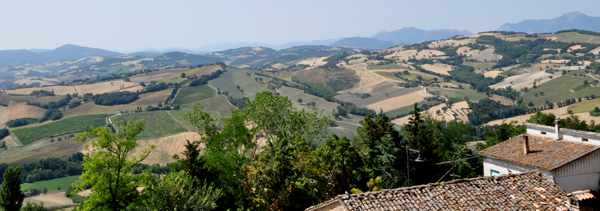
Earle-and-Suzanne’s house is in the Metauro River valley; it’s on the northern slope of the rounded hills that form the valley below us. Each morning I look out and see the hilltop towns of the next valley, and I’ve wanted to go exploring these structures that shape the horizon. Today was the day to explore the next valley to the south of us. We drove down to Isola di Fano and then up the mountain and into the next valley. (Derrick had put in ‘off-road’ when he was setting up the GPS, and Rose yelled and yelled. The off-road trip would have taken us 3 hours, the fastest-time trip had us at Fratte Rosa the hilltown we see from the kitchen window in 30 minutes.) The interior of Le Marche is these cultivated, rolling hills. And this patchwork is one of my favorite landscapes.
The interior of Le Marche is these cultivated, rolling hills. And this patchwork is one of my favorite landscapes.
Our first stop was to Fratte Rosa and immediately there were signs of foreigners. The entire town has been beautifully refurbished; all the houses have been cleaned and pointed. (It reminded me of Assisi. Modern day Assisi is the disneyland of Catholicism. The entire town has been refurbished to keep the tourists with loaded pockets coming. Forget the fact that Francis made poverty a virtue, modern day Assisi is anything but poor.)
The next evidence of foreigners was in San Lorenzo in Campo. (It was full of tall, blond Germans.) I did forgive them their invasion, because we found a Frutta e Verdura shop where the owner sold us the best Visciolata wine ever. This is a dessert wine made in Le Marche. It’s made from wild cherries mixed with wine. I walked in and asked if he would sell us a bottle of wine and then open it so we could have it for lunch. Of course he would. Well, he ended up having to uncork two bottles before he was successful at getting the plastic cork out. He put those two bottles aside and he picked out a third with a real cork that he was able to remove. We now had our wine. Earlier I had bought two slices of pizza with bacon and eggplant, Rose and Derrick had paninis stuffed with porchetta. (I told the owner of the Frutta e Verdura that in America it would be illegal for him to open the wine and then sell it to us. He said American is very open, but very contrary.)
We drove to the next small town and sat in the piazza in the shade and had our picnic lunch. Oh yes, the man from the Frutta e Verdura packed us three plastic cups. After our piazza lunch I went over to the local real estate office. (It was the only business still open.) It listed all these farm-houses for sale. Some were completely restored,, others were ruins. The prices were beyond high. They were so over-priced that I couldn’t believe people were paying these prices. I guess the Germans dodn’t see the prices as exorbitant, highway robbery, out-right stealing …
The Viscolata we had after dinner with fresh melon. (Rose is already planning a trip back to San Lorenzo in Campo to buy more Viscolata. She’s planning to take at least one bottle back to Michigan. I’ll think about it throughout the year and it will become another reason to return next summer.
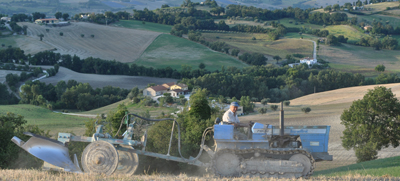
The weather has been miserably hot, but last night it broke. And at 2:00 in the morning the farmer from the next property was still plowing. I understand working in the cool night, but am amazed by the practicality of it all.
 In many ways that’s what keeps surprising me about Italy – how practical everything is organized. The problem is that this orderliness is severely taxed in the summer months when the country is overrun with mobs, and I mean that in a literal sense, of foreigners. And then we all whine about things being inefficient. I wonder if any country can efficiently manage the millions that descend into Italy each summer. Disney can do it at a theme park, could it do if for a whole country? Especially when the locals have to continue their day-to-day routines – go to work, cook, visit, go to doctor’s appointments, go food shopping – all while the tourists, who have left their day-to-days back home, want entertained, want no interruptions, want immediate service, want no traffic jams, want cool days, want people who speak English …
In many ways that’s what keeps surprising me about Italy – how practical everything is organized. The problem is that this orderliness is severely taxed in the summer months when the country is overrun with mobs, and I mean that in a literal sense, of foreigners. And then we all whine about things being inefficient. I wonder if any country can efficiently manage the millions that descend into Italy each summer. Disney can do it at a theme park, could it do if for a whole country? Especially when the locals have to continue their day-to-day routines – go to work, cook, visit, go to doctor’s appointments, go food shopping – all while the tourists, who have left their day-to-days back home, want entertained, want no interruptions, want immediate service, want no traffic jams, want cool days, want people who speak English …
This morning the farmer is back out, I heard the tractor as early as 6:00. He’s spreading manure in the lower field, and because the wind is blowing away from us, there is no perfumed air.
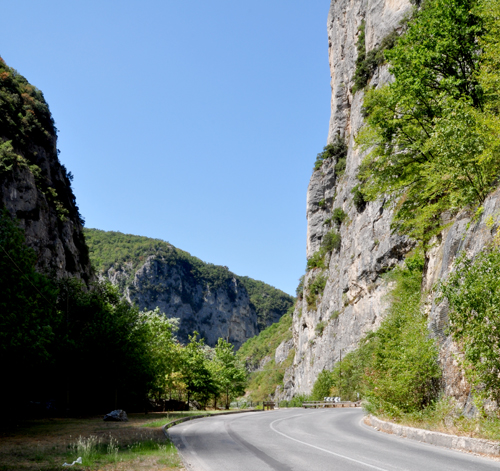
We decided to head south to the caves at San Vittore. This southwestern region is full of caves; the best know are the Grotte di Frasassi. To get there, the GPS took us on the provincial roads that hug the mountains. (In Italian there are different words for mountains depending on their shapes. In Calabria, with its Sila peaks, they’re montagne. Here in north central Le Marche, with its tall rolling hills, they’re colline. I love the ride through the center.
I love the ride through the center.
These are the provincial roads and the only arteries into the country with amazing vistas. (The tolled Autostrada and the non-tolled Supra Strada run in valleys, on flat terrains, along the coast, along the side of mountains, through tunnels in gorges. They are full of traffic – foreigners and locals. For the Italians speed limits and traffic laws are only suggestions. This drives the foreigners crazy. I like the Italian word for foreigner better than the English. In Italian foreigners are stranieri. Our word strange is wrapped up in the Italian comment about people not like them.) The provincial roads are the only access points for people living in the interior. They lead to all the postcard-perfect hill towns we see in travel brochure. But because most stranieri aren’t willing to deal with the roller-coaster ride that the provincial roads offer, they avoid the interior.
The image in this post is the gorge where the Grotte di Frasassi are located. Before we got here, we stopped at a local supermarket and bought lunch. You buy all the ingredients for a panino and the clerks assemble it. We left the store with two panini, two slices of pizza, some olives and both carbonated and non-carbonated water – lunch. There was a picnic table on the right. We sat there and ate out grocery-store lunch. (My pizza was bland, but that’s what I expected when I bought it at the large, chain store.)
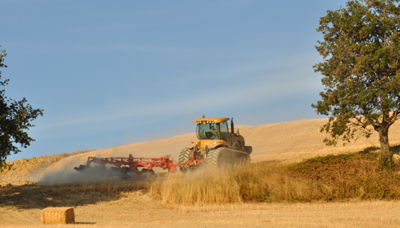
It’s 10:00 pm local time and the farmers of the valley are plowing. The evenings are cool and the night sky is black with stars. The farmer from up the road is driving his blue tractor making patterns in the hillside. If last night is any indication of his work schedule, he will be at it all through the night. The farmer is using a huge tractor to plow. I shot a series of pictures as he came down the hill, the plow into the earth. (The gold haze of the mowed wheat fields is one of my favorite colors.) Coming from a country and city where farm rhythms are things of the past, it’s hard to put my head around the work routines here in rural Le Marche.
Coming from a country and city where farm rhythms are things of the past, it’s hard to put my head around the work routines here in rural Le Marche.
Today we drove through Senigallia, one of the premier beach resorts on the Adriatic. I bet no one there works through the night plowing fields. I bet no one there knows anyone who makes their living plowing fields.
After supper, Derrick and I took a walk up to the old abandoned house I found the other night when I went into the fields to shoot. The field is the highest point on this side of the valley and I wanted to shoot from that vantage point. And there in the trees at the top was an old farmhouse. I figured out where the driveway was and tonight we make the trek back up the house. The view is truly spectacular. From the property you have a 360 degree panorama.
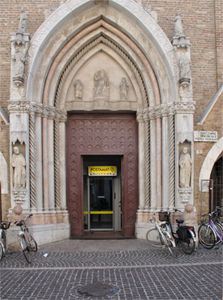
Today we drove to Pesaro and the northern coast. Where Senigallia is overrun with tourists and frantic, Pesaro is full of locals and slow. The streets in the old town are shadowed by trees, and the beaches are orderly if riddled with umbrellas. We got there early enough to walk the streets with the locals. Near the government center, an old church had been retrofitted into a post office, and I decided that would make a great shot, so I walked across the street to shoot the facade with the yellow postal sign inside the main entrance. A young man came up to me and began a harangue about the injustice of having retrofitted a church. He then asked if I was from Pesaro, I went into a full-American pretending I had not understood him and that I was a lowly tourist. He looked disgusted, but left. (So, was the disgust about the injustice of government taking over a church or that I was an American who only spoke one language – American English?)
We got there early enough to walk the streets with the locals. Near the government center, an old church had been retrofitted into a post office, and I decided that would make a great shot, so I walked across the street to shoot the facade with the yellow postal sign inside the main entrance. A young man came up to me and began a harangue about the injustice of having retrofitted a church. He then asked if I was from Pesaro, I went into a full-American pretending I had not understood him and that I was a lowly tourist. He looked disgusted, but left. (So, was the disgust about the injustice of government taking over a church or that I was an American who only spoke one language – American English?)
BTW, most of the English you find here is British English – axioms, spellings, terminology. For example, at lunch the menu had an English translation. I wanted a salad, and I’m looking at the ingredients in English and one of the items was ‘rocket’. What the hell is rocket? There’s no such vegetable with that name. Rose told me that rocket is arugula. And that the British call it rocket. What!! (It may come from the other word for arugula – rucola. But how do you get rocket from rucola? Only a culinary challenged society could call an edible grass a rocket.) Another item for my list of Things-to-Hold-Against-the-British.
I probably need to re-examine my comments. The young man from Pesaro was ranting against the government take-over of church-owned buildings, I’m here ranting about the British. I guess all Italians have something to harangue about, even old ones who now live full-time in America.
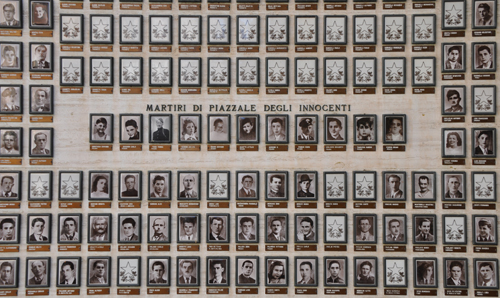
World War II still shapes the Italian character. My family left after the war, and here I am back.
People of my parents’ generation lived through the war years and their children carry that legacy without even knowing it. It took me a while to understand how the war changed my life. Because, my parents were too young to participate, I never thought that their actions and decisions were the result of what the war had done to their homeland. I just assumed we left for Canada, because all the grandparents were there. Certainly never thought about the fact that the economy of post-war Italy was in the toilet and my dad could not make a living.
And growing up in Canada and the US, the war stories were about winning. The books we read in high school were about British men and women who fought valiantly and won. I didn’t hear about the holocaust until I moved to America. And still no one ever talked about Italy in the war except to mention Mussolini. (I came to hate Winston Churchill’s writings. They tell a one sided story. In the writings he has no understanding of what the regular people of Italy and Germany suffered. He has no empathy for the victims of the war. Instead he brags about the resolve of the British people and the low character of the Germans and Italians.) There are World War I memorials in all the piazzas of all the small towns. World War II memorials are rare. The one in Pesaro was disturbing. It’s a wall of funereal pictures of the freedom fighter.
There are World War I memorials in all the piazzas of all the small towns. World War II memorials are rare. The one in Pesaro was disturbing. It’s a wall of funereal pictures of the freedom fighter.
This part of Italy was the Gothic Line – The Gothic Line – Linea Gotica – formed Germany’s last major line of defense in the final stages of World War II along the summits of the Apennines during the fighting retreat of German forces in Italy. The Allies breached the Gothic Line on both the Adriatic and central Apennine fronts during Operation Olive also known as the Battle of Rimini in the autumn of 1944. Over a million men participated in the battle.

How can I pass up a title like that, even if it doesn’t mean anything to people who read this?
After Pesaro we headed north on the winding coastal road that runs along the top of the Apennine ridge; the vistas down to the Adriatic are wonderful.
(Some facts – the road on the ridge is lined with Renaissance mansions. Rich Italians, to escape the blistering summer heat, went to the mountains not the sea. Only poor people, who lived in the mountains throughout the year, would go to the beach for a summer break. The villas of the rich look out onto the Adriatic. The servants would open the house sometime in June and spend the next months cooking the local cuisine. The landowners sat on their verandas and were waited upon.)
The cliff area, outside of the Pesaro, is a national park. And during World War II, this was the Gothic Line that the Germans defended until they lost it in the Battle of Rimini.
At the end of the ridge is the resort town of Gabicce Monte a small quaint mountain-town full of restaurants that cater to the beach crowd. We had lunch at one of these restaurants. I ordered a salad – I can’t do a full lunch and not go back to the house and sleep for the afternoon. (In this way, I’d fit in perfectly with the Italian afternoon routines.) Rose was scandalized that I would order a simple salad when I had a full menu of Italian specialties to pick from. (This was the menu that listed ‘rockets’ as an ingredient in my arugula salad.) Below us, Gabicce Mare is the small coastal town at the north-eastern border of Le Marche and Emilia Romagna. The area is actually two towns, Gabicce Mare on the Le Marche side and Cattolica on the Emilia Romagna side. The pic is shot from our table at the restaurant that served rockets in my salad. The lines in the water are breakers – stone walls to keep the tides away from the sun-bathing public. (I suspect that there are no dermatologists in Italy. No one would pay any attention to their advice about staying out of the sun. Remember, the Italians embrace the sun – O Sole Mio.)
Below us, Gabicce Mare is the small coastal town at the north-eastern border of Le Marche and Emilia Romagna. The area is actually two towns, Gabicce Mare on the Le Marche side and Cattolica on the Emilia Romagna side. The pic is shot from our table at the restaurant that served rockets in my salad. The lines in the water are breakers – stone walls to keep the tides away from the sun-bathing public. (I suspect that there are no dermatologists in Italy. No one would pay any attention to their advice about staying out of the sun. Remember, the Italians embrace the sun – O Sole Mio.)
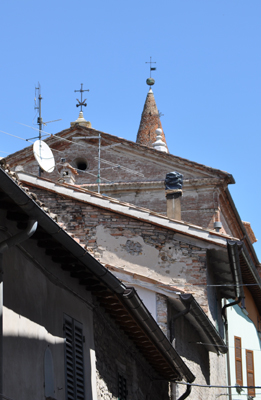
Today is our last full-day at Earle-and-Suzanne’s. (Tomorrow we head over to La Tavola Marche.) We decided to have dinner at a restaurant, in San Lorenzo in Campo, that specializes in farro dishes. San Lorenzo is in the next valley to the south of us and to get there you literally go over the mountain and through the campi.
Because of our dinner reservations, we decided to explore close to the house and Urbania fit the bill. It’s claim to fame is a Befana festival in early January. It’s a small town on the cusp of renewal.
 The town was quite lively and full of Italian tourists and foreign students. (There is an international school here and kids come from all over to the music academy.)
The town was quite lively and full of Italian tourists and foreign students. (There is an international school here and kids come from all over to the music academy.)
After our exploration we stopped at a gelateria and it had a Nutella flavored gelato. I had to have one. It was really not good – too much Nutella and not enough gelato.
The next eating adventure was at the Farroteca in San Lorenzo in Campo. The drive over, as I said, was over the mountain. (We go by one of my favorite hill-towns – Fratte Rosa – and I think I like that valley more than the one we are in.) We parked in the main piazza and walked the short distance to the restaurant.
The place is on a property with three structures – a villa, the itinerant farmers’ residence that is now modernized and the old animal shed that has been renovated into the restaurant. The owner – Lea – is this vivacious older woman who had us laughing throughout the entire meal. (She complained loudly about the Italian version of Socialism and was taken back when I told her that millions of Americans don’t have health care. Her answer was, “Questo non e gusto.” – That is just not fair.
Dinner was great. It was a fixed menu. We began with a farro salad. (The olive oil is from her property across the valley – Monterosso – and tasted amazing.) This was followed by cheese with prosciutto and small farro breads topped with olives and zucchini. The third course was a fresh, soft cheese on farro pita. The primo piatto was ricotta ravioli with porcini mushrooms. This was followed by sweets served with the local dessert wine – Visciolata – and espresso finished the meal. (We had a bottle of red wine from her vineyard and two liters of sparking water with our meal.) The entire dinner cost us 75 euros.
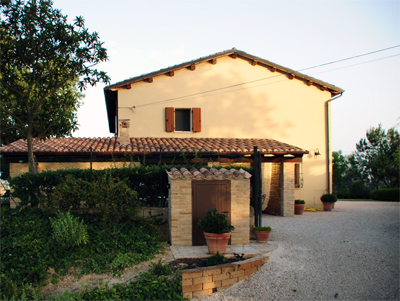
Today is our last day at this great house.
 Last year, Rose found this listing and we decided to take a chance. I believe our expectations were what they had always been – probably looks better online than it really is. We were wonderfully surprised.
Last year, Rose found this listing and we decided to take a chance. I believe our expectations were what they had always been – probably looks better online than it really is. We were wonderfully surprised.
The house is a restored itinerant farmers’ house. (My dad’s family lived in such a house in Calabria. The property owner housed the workers in various such houses on his property.) The ground floor was where the animals were kept and the first floor was where the family lived.
Earle-and-Suzanne have restored the ground floor and they live there. The first floor is the rental. The tall beamed ceilings are all visible, the kitchen is very efficient and comfortable. There are two bathrooms, one en-suite and very large second one. One of my favorite things about the house, and I know there are many, are the views. You get up in the morning to the manicured valley. (The house sits on a hill in the middle of the Metauro Valley.) We sit on the porch and have our morning espresso.
We’ve been going exploring late morning and early afternoon, but we are back by 3:00. We rest. The natives have been home since noon, but we tourists add some extra hours to the first part of the day. We begin preparing for supper around 7:00 and go and sit under the pergola for our evening meal.
For us, the house fits perfectly. It’s convenient to the provincial roads and the Autostrade. There is a small hamlet at the bottom of the hill for bread and cheese and Fossombrone is twenty minutes away.
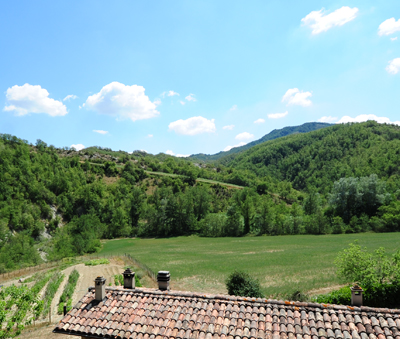
We left Earle-and-Suzanne’s this morning and drove to La Tavola Marche. It’s a combination agriturismo, cooking school and mountain retreat. We showed up around 12:30 and we got settled in. We’re on the top floor. Our apartment is very nice, very roomy. After we had unloaded everything, especially the food, we had lunch and headed over to the pool. It was so nice to just sit in the sun and when it got too hot, jump into the cool water.

The image is the mountains outside our kitchen window – a very different landscape from the Valley of the Metauro in Fossombrone. (Ashley told us that the top of the mountain is really Umbria.) We are in the south-western section of Le Marche. The area around the farmhouse is void of human traffic. The only things you hear are the cicadas, and the other guests at the pool. And if the guests are taking their afternoon nap then the place is silent.
In order to get Internet, we have to go down to Piobbico, a ten minute drive down a dirt road. My strategy this week is to do all the Photoshop and writing off-line and copy and upload everything when we are in town. (Piobbico is the town where they have the Ugliest Man and Woman festival.)
It’s 6:18 pm. I’m sitting outside at the Cafe del Corso in Piobicco, eating a cooffee granita and finishing this posting.
Rose took a picture of the old man, blogging. Once she sends it, I’ll post it.
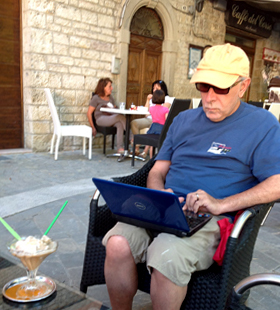
If it were up to me this is the kind of pic that would never see the light of day, but it’s a record. I’m sitting in Piobicco and that is a coffee granita in front of me. And for those truly observant anal retentive friends – yes, I’ve shaved the beard. (Another reason to bury the pic in some directory where it would never be found.)

All the foreigners come here to get Internet access. It’s mainly Dutch and German tourists. They flock here because of the hiking.
After we finish with our online fix, we are heading back to La Tavola Marche and will figure out what to have for supper.
Decided to add to this entry, because I always like to fill up the space around the pics. Yesterday and today, I prepared everything before we come down to Piobbico and then sent it up to the journal while at the Cafe del Corso. I think that writing the entries ahead of time has resulted in text almost free of tension. I’ve been leaving out the edge. An edge, a sarcastic voice that had found its way in as I sat, leisurely reviewing the day.
Today at Cafe del Corso there are more locals than foreigners. The three of us are the only ones sitting together, but not talking. We are busy with our various devices. The Italians around us are all yaking away. (There’s lots of complaining about various family members.) Tonight’s crew is older and probably on a passegata before heading home to the Sunday light meal.
My mandatory drink tonight is a cold chocolate. Still not great, but better than last night’s. Buy something and get Internet connection. Not a bad deal.
BTW, I was telling Rose that I get most of my protein from cheese and she was surprised and had to look up the protein value of milk products.

I love being in the mountains. (Earle-and-Suzanne’s is urban compared to where we are this week.)
This morning I walked down the road and there were all the farms that dot the valley. Came back and started shooting the sunflowers – le girasole – on the property. And the bees … (It was really the dark, dark blue.) There are hives on all the farms we pass, and now I know where the bees end up. Also, found that the plants that look like corn are pig corn. It grows nothing like American, genetically modified corn. The pig corn grows a single cob, a plume at the top of the leaves, with no husk. Here corn has always been something farmers feed the animals. Humans do not eat corn-on-the-cobs in Italy. But, there’s a whole food culture in northern Italy based on polenta – a mush made from corn flour – as the staple.

Today we decided to explore Sant’Angelo in Vado. We expected a back-water town and it turned out to be a great little town. We got there after Mass let out and it was teeming with locals.
To get there we literally went up and over the mountain. The road is this twisty, steep slope heading forever down. The name is Saint Angelo in the Valley. Guess we had to get down the mountain and into the valley. When we got there, we followed the town people into the Cathedral. (I didn’t take pics. There were too many of the faithful still milling around.
We found a store and bought dinner – roasted rabbit in wild fennel and garlic, stuffed zucchini, eggplant and peppers.
We left Sant’Angelo in Vado and did not want to go back up the mountain road, so we headed into Umbria and the provincial roads. We might as well have gone back up the mountain. We traded one mountain for another and headed down the next steep incline into another valley. (The speed limit is 70 km/h. I don’t know how they do it on the mountain roads. Even the bikes are racing the roads. BTW, everyone here wears helmets. There are signs everywhere reminding drives of the dangers of not wearing a helmet. Too bad Americans put machismo ahead of safety. But then they aren’t driving the mountain roads of Italy.)
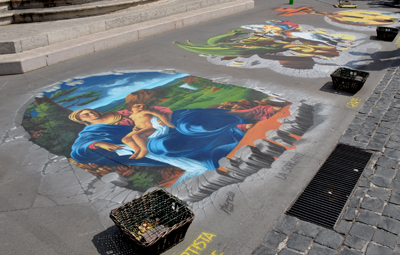
Today we drove across Le Marche and then south to Loreto, the city of the holy house. (Supposedly, angels carried the house that Mary lived in from Palestine and deposited in Loreto.)
The Basilica is this huge structure with a square in front. The square is surrounded by porticos. One side is the Apostolic Palace – Church offices on the piazza level, Church residences on the second floor. These are grand residences that are now a museum and it’s clear that the Church officials who lived in these rooms were nobility. There is no poverty here.
A young man was painting these chalk-drawings on the floor of the piazza. He had three baskets for donations under each. (Hey, if Mother Church can collect from all the pilgrims that flock here, why can’t he?)
Loreto attempts to do the same thing that Assisi does – create a destination for pilgrims. The difference between the two locations stares you in the face. Where Assisi has historical significance – the birth place of Francesco di Bernardone – and artistic significance – Giotto’s famous frescoes line the walls of the Cathedral; Loreto is fictional Catholicism. The Church made up this place.
Inside of the Cathedral, behind the main altar is this four-sided, open box of marble, beautifully decorated with carvings and reliefs. This external box is amazing in its complexity and artistry. The inside is lined with rock – supposedly from Palestine – but open to the dome. The ceiling is early Signorelli. In Orvieto, we see the mature master depicting the Apocalypse with its avenging angels assigning the locals their place in a tableau of eternal-rest. (In Loreto the avenging angel is in grey armor. In Orvieto he’s gloriously naked. In Loreto he’s a two meters tall controller, in Orvieto he’s a 10 meters tall beautiful avenger, the central figure in the tableau.)

It’s hard to walk through this box and think of the young Palestinian woman who was supposed to have lived here. There are frescoes on the stone walls, frescoes of angels. (Judaism does not depict heavenly creatures. The frescoes are Italian in execution and culture.) There is a marble altar in front of the back wall. There are gold candle holders on the marble altar. And the stones look like they could have come from any quarry in the area. And there are small niches with other gold ornaments. It’s absolutely clear that this whole complex was created and given meaning by some Church official. There is no theological, archeological, or religious base for anything here. It was created as a place that would attract pilgrims, that would attract pilgrim money. It is extremely successful. Four million pilgrims a year journey to Loreto.
I always understood Martin Luther on an intellectual level. After being in Loreto, I understand him on a gut level. Seeing the Disneyland house and realizing it’s a for-profit operation, makes Martin Luther a visionary, a prophet that the Catholic Church could not accept or learn from. And like all true prophets, he was persecuted and ostracized.
Oh, BTW, the Madonna of Loreto is a black Madonna.
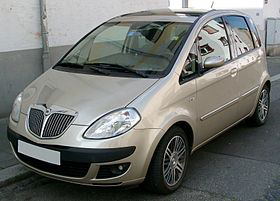
Last night I drove from the agriturismo into Piobbico on my own. It was my first time driving the rent-a-car. (It’s only registered in Derrick’s name.) I was cautious and wanted to get back before sundown; I didn’t want to drive the unpaved country road in the dark.
BTW, the Musa is the Lancia rent-a-car. It’s a great small car. (Wish we had access to some of the small car models they have here.)
We come into town daily to check email and blog. (The agriturismo is in the mountains about 1,400 feet abovee sea-level and no Internet.) For some reason, tonight I could not get Internet access anywhere in the cafe. Even moved my seat to two different tables.
So after calling Leger, because I had a phone connection, I headed back.
I like driving in Italy, it’s never boring. (There’s not a straight road anywhere.) Yesterday we spend most of the day on either the Autostradra or the provincial roads. These are fast arteries on the plains or the side of the mountains. The road to and from the place we are staying at is unpaved and the dust clouds hide the car as we drive its ruts and shoulders.
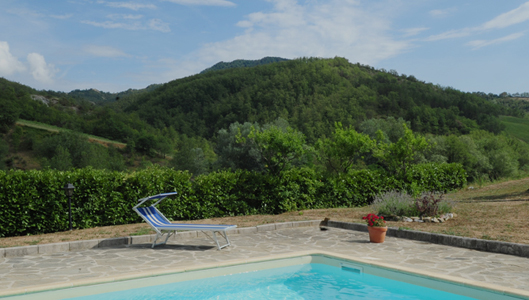
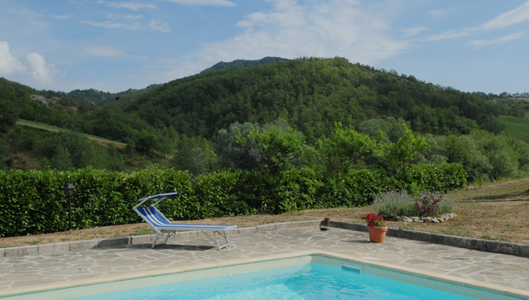 Today was a recoup. We went into Piobbico for the market and for coffee; and then headed back to La Tavola Marche to sit by the pool. (The Dutch family with its four, loud children left for the day; we had the pool to ourselves.)
Today was a recoup. We went into Piobbico for the market and for coffee; and then headed back to La Tavola Marche to sit by the pool. (The Dutch family with its four, loud children left for the day; we had the pool to ourselves.)
It is incongruous to be in the mountains of Le Marche and to sit by a pool full of clear, blue water. It’s Italian and American at the same time. (The two young owners of La Tavola Marche are Americans.) To add to the incongruity, the water in the pool is from a sulfur spring on the property, and every morning it’s treated to make it clear and sulfur free. And finally, Natalie Merchant is on my iPhone singing:
I do like being in the mountains. It really is the summer vacation of my youth. Many families in Aprigliano would go up to La Sila for the summer months. The mountains were their retreat from the summer heat. When she was a young woman, my mother went up with my grandfather, because he lived up in La Sila with the sheep during the summer months. My dad went up to La Sila to work, to hunt, to pick mushrooms. And even though I never went, I am of that generation most associated with my parents and their narrative became my early reference point. I just assumed sooner or later we would go up to La Sila during August. (Nah, we went to cold northern Ontario.) It’s with Connie that my parents’ narrative lost its meaning. She was two when we left Aprigliano. The narrative she heard was of her parents struggling to make a better life in Sault Ste Marie and how she would benefit from their struggle.
It takes a long time to situate oneself in a family continuum and age helps to figure out one’s placement in that family line. That awareness is faint during the time when we are building careers and families. (For me the awareness has come when those two accomplishments have been safely established.) Spending the last 8 summers here in Italy brings me into the continuum that is my family’s legacy to its oldest child.
The idea of going to the sea – al mare – during the summer is a modern protocol. I guess the way we know we are old and the mantle has passed is when the next generation begins to create its own routines. All my cousins in Aprigliano now talk about il mare throughout the summer. They send me pictures of them sitting in the maze of beach-chairs and umbrellas along the Mediterranean coast. I try and explain to my parents that they are on holiday, but the idea is not something they can associate with Calabria. For them, the beach in the summer is an American experience. (Last night we talked to them, and I kept telling Rose to just say that we are in a place like La Sila. As soon as they heard that reference they knew exactly what the area we are in looks like.)
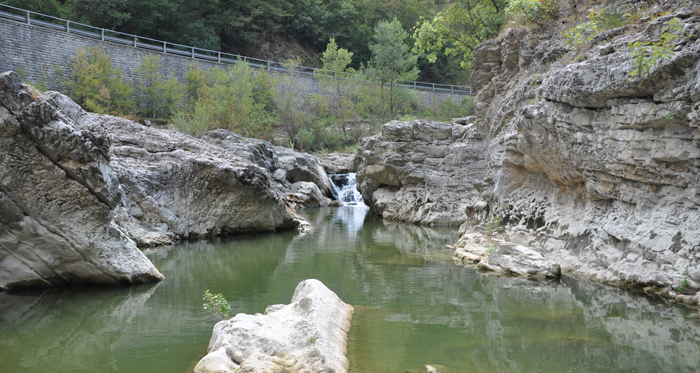
Today is that magical holiday in Italy where everything is supposed to be closed and everyone is away on vacation. (It’s the feast of the Assumption and the Italians are supposed to bee in church.) Since we’ve been coming, we’ve seen this tradition change. This morning all the cafes, on the street are open and I’m sitting in Crazy Bar, with Internet access. (I have no idea why Italians think that using American names for their establishments is great PR.)
The first couple of days we just looked at all the locals down the street at the Crazy Bar. None of the tourists ventured down there. Well, given that Internet access was sporadic at the other location, I walked down, plopped myself among the old me and flipped open my laptop. They looked over and I said, Bongiorno without a trace of a foreign accent. They went back to their card-playing, I went back to blogging.
When we were in Cosenza, everything was closed for ferragosto. And given that Le Marche is similar to Calabria in its history with poverty and Church control, I’m pleasantly surprised to find that the marchegiani seem to have thrown off the shackles of Mother Church.
 Later we will head down to the river for a picnic. That will be our contribution to ferragosto. The tourists that come to this area of Le Marche spend their time trekking the trails around the river beds. (At this time of year, the rivers that in the spring are torrents are trickles of water. This makes the river-beds great trails to walk and explore and picnic along.)
Later we will head down to the river for a picnic. That will be our contribution to ferragosto. The tourists that come to this area of Le Marche spend their time trekking the trails around the river beds. (At this time of year, the rivers that in the spring are torrents are trickles of water. This makes the river-beds great trails to walk and explore and picnic along.)
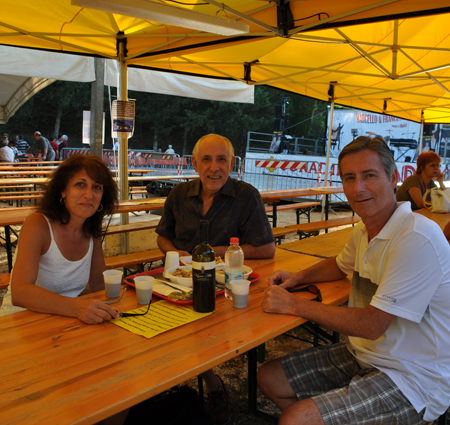
 Tonight, on ferragosto, we went to a Sagra del Polentone alla Carbonara in a small town – Cagli – between Piobbico and Aqualagna. (I hate polenta, and here I am going to a fish-fry type event that will serve nothing but polenta.) My mother and Leger will give me a very hard time about this. The sagra was in the parking lot of a Romanesque, country church – S. Maria A. di Naro, Chiesa Romanica, (sec. XI) – built in the eleventh century.
Tonight, on ferragosto, we went to a Sagra del Polentone alla Carbonara in a small town – Cagli – between Piobbico and Aqualagna. (I hate polenta, and here I am going to a fish-fry type event that will serve nothing but polenta.) My mother and Leger will give me a very hard time about this. The sagra was in the parking lot of a Romanesque, country church – S. Maria A. di Naro, Chiesa Romanica, (sec. XI) – built in the eleventh century.
Tables and tents were everywhere. We went early; the polenta was being made as we got there. And within 15 minutes we got our food. The carbonara sauce was super rich, so here I am eating a gelato to balance the grease. BTW, the cafe down the street from us has a DJ and he just finished playing Everybody is Talking at Me.
Tonight we will have a quiet evening and tomorrow we are going exploring the small towns around Fossombrone. We really like that part of Le Marche.
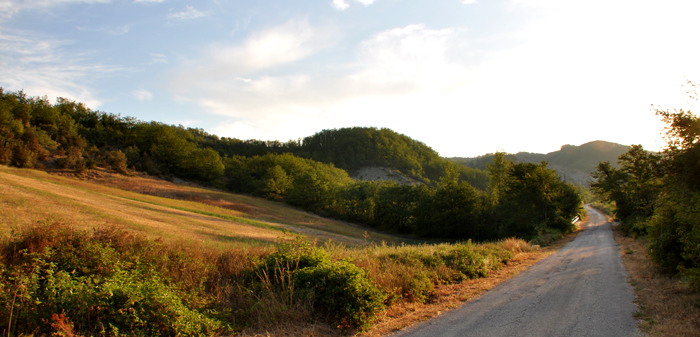
This morning I finally got up early and headed down the road for a walk. (There’s an abandoned cemetery and I wanted to go shoot it.) Mornings are amazing, the sun is just rising, so you don’t get the onslaught of the mid-day heat and the bugs are sleeping. The mountains at this time of day are silent. It’s taken me all these years to finally get into the mountains. (There are side-roads off the unpaved main road, but I didn’t have the proper clothes to trek up these paths.) The pig-corn is still a wonder for me. I’ve not see anything like it in America. (I’ll have to google it and Wikipedia it and see what comes up.) I also found a wide path down to the river – a tributary of the Candigliano which in turn is a tributary of the Metauro. However, the find of the morning was the cemetery. There are less than a dozen graves left. (Ashley said that all the people buried here are from the same farm-family up the road.)
The pig-corn is still a wonder for me. I’ve not see anything like it in America. (I’ll have to google it and Wikipedia it and see what comes up.) I also found a wide path down to the river – a tributary of the Candigliano which in turn is a tributary of the Metauro. However, the find of the morning was the cemetery. There are less than a dozen graves left. (Ashley said that all the people buried here are from the same farm-family up the road.)
The cemetery has a wall around it. The wall opposite the gate has the chamber that would have been used to keep coffins in the winter. The repository chamber is open, so I went in. Inside were all these wrought iron crosses, no two are the same. (In the cemetery in Aprigliano, I was amazed when I discovered all the different crosses that topped the small mausoleums. All were different.) These abandoned crosses are made to put into the ground as markers. Given that the whole left side of the courtyard is empty, these abandoned crosses must have come from that side. (It’s not uncommon in Italy to un-inter a coffin and re-bury it in a new, better, more prestigious location. (Most of my paternal grandmother’s family in Aprigliano, has been moved from the old cemetery in to the newer section. My mother told me that as soon as they build the above-ground crypts in the Soo, many Italian families un-interred their loved ones and placed them in the above ground crypts.) I suspect that many coffins were moved from this small mountain cemetery to the new cemetery in Piobbico. The only remaining graves are on the wall to the right of the chamber. These are the graves of the Gnucci family.
On my way back, I kept thinking that landscape can shape character just as much as family. Italy, except for the coastal plains and these are narrow strips, is a country of mountains. People live in these unique communities with mountain barriers separating them. (In Pittsburgh we talk a lot about the different neighborhoods and how the topography isolates communities and how these communities have developed distinctive personalities.) Well Italy is a whole county of such distinctive communities. No wonder it took forever to unite the country. It also explains the lack of national identity and the focus on local identity. (Pittsburgh too is famous for local identities and a lack of municipal consciousness.) Italy has been dealing with one other variable that only now America is recognizing – bad central government. The lack of trust in a central government, a by-product of living in isolated communities, has added to a strong township allegiance.
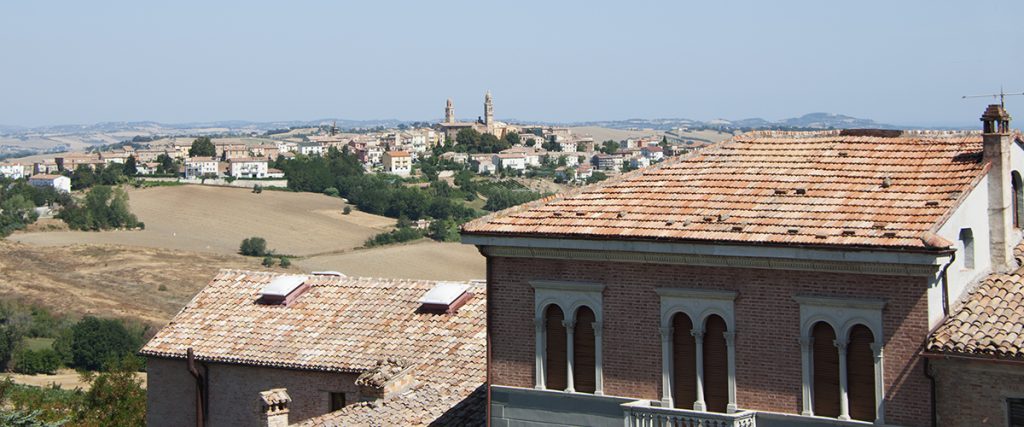

In the afternoon we drove to Mondavio and then Corinaldo. Corinaldo is the birth place of Maria Goretti. The only thing I remember about this saint is that she died rather than give up her virginity. (I remember a lot of jokes about her being the only Italian girl to say, “No.”) Well today got a different story, one that has me thinking that the Church in Le Marche has done some very unusual things – declaring that angels brought a house over from Palestine; declaring that a young girl from a migrant-workers’ family is a saint, because she put up a fight rather than give up her virginity to the landowner’s son. The son frustrated by of her refusal, stabbed her to death. But, before she died, she forgave her would-be-rapist.
The story continues – the son then goes up to Goretti’s mother – Mamma Assunta – and asks for her forgiveness. The mother tells him that since her daughter forgave him, he was forgiven. He then goes to live with a group of Franciscan monks, but never takes vows. Goretti is buried in the church of Santa Maria Goretti in Corinaldo in the crypt, her mother is buried on the left side of the nave and her would-be-rapist on the right side of the nave.
Now, my version of the story – The landowner’s son is the would-be-rapist that part of the story is consistent, but I suspect that his well-connected father went to the local Franciscan prior and made a deal. – “Declare Maria Goretti a saint, but let it be known that she forgave my son before dying. House my son in one of your monasteries and I will give a large donation. The Church gets a new saint from the peasant class, think of how many donations that will bring in; after all the villain is the landowner’s son, another plus in the class warfare propaganda the Church likes to traffic in, but don’t forget that she forgave him proving her worth to be a saint. Plus let’s not forget my sizable contribution.”
Nowhere in the story is law enforcement mentioned. And how is it that a migrant-worker’s family, who was as poor as dirt, can get through the bureaucracy that is the Roman Catholic Church to get their daughter proclaimed a saint. Nah, there were other more powerful forces at work. And for me those are the rich landowner, the Franciscans, and the local law enforcement. All had to agree on the plan and all had to get something from it – a win-win situation – in order for it to work.
The Italians had a new saint. Le Marche had a second site to attract tourists with religious leanings who hopefully will put money into the offering boxes.
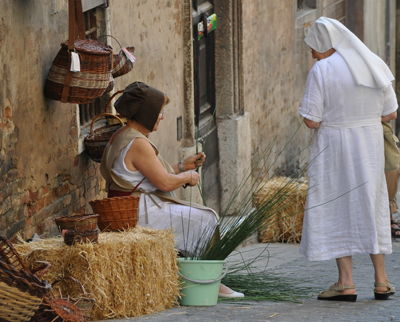
Today we headed up to Urbino. It’s my favorite place in Le Marche. It’s the Milan – modern, organized, clean and rich – of the province. The old centro is vibrant and well maintained. The surrounding suburbs are modern and development is controlled and well managed.
 The old city-center was full of bancarelle – vendor-booths to celebrate La Festa del Duca. We got there as the vendors were setting up. (All the stalls used bales of hay to mark their perimeters. Guess it’s to go with the medieval look.) In the evening more actors would be out participating in processions, jousting tournaments, theatrical performances and other dress-up events. (We didn’t stay for this part of the entertainment.)
The old city-center was full of bancarelle – vendor-booths to celebrate La Festa del Duca. We got there as the vendors were setting up. (All the stalls used bales of hay to mark their perimeters. Guess it’s to go with the medieval look.) In the evening more actors would be out participating in processions, jousting tournaments, theatrical performances and other dress-up events. (We didn’t stay for this part of the entertainment.)
The image above was too difficult to resist. (I did take it with the zoom, wasn’t sure it was polite to shoot it up close.) For me, it’s two medieval characters – one playing at dress-up, the other wearing her required uniform; one representing the merchant class of the Middle Ages, the other representing the corporation that ruled at the time. (In the future, will some men walk around in Armani suits when everyone else is wearing unisex spandex and riding segways or landspeeders? Will cities host Sagra di McDonalds or Bill Gates Festivals?)


Urbino’s palace culture gave rise to the first-ever painted images of utopian cities in the form of a trio of intriguing panels, all now known as “The Ideal City,” one of which remained in Urbino, the other two are in Baltimore and Berlin.
Years ago, I spent part of my junior-year at the Universita per Stranieri in Perugia. At that time Perugia was this sleepy, Umbrian hill-town in the middle of Italy. We lived with the locals. And Corso Vannucci – the main thorough-fare was full of local vendors who tolerated us. There was this great bakery/cafe that had the best pastries. The owner was this very masculine looking woman who ran the register. And after having our espresso or a granita-di-cafe, we had to get up the courage to go up and pay hoping that the she wouldn’t insult or berate us. (For the longest time, I pretended to not speak Italian because I didn’t want her telling me that I had a Calabrian accent. Il Mezzogiorno – the provinces south of Naples – were in great disfavor and looked down upon. I certainly didn’t want to be associated with them people.)
Perugia has changed radically since those long-ago days. All the local vendors are gone from Corso Vannucci. Guess Jeans, Armani, Starbucks and McDonalds now rent the store fronts. Urbino never went through this type of transformation. Instead it managed its transition into the modern world keeping the old centro in tack and economically viable for local vendors; its suburbs orderly; its new construction architecturally cohesive; and its university for Italians. It bills itself as la citta ideale – the ideal city.
Urbino never went through this type of transformation. Instead it managed its transition into the modern world keeping the old centro in tack and economically viable for local vendors; its suburbs orderly; its new construction architecturally cohesive; and its university for Italians. It bills itself as la citta ideale – the ideal city.
Everywhere in Urbino is an energy that you find in all growing, vibrant cities. The streets are free of filth; the medieval walls are pointed and cleaned; the old city is full of people; the cafes and bars cater to the locals rather than the tourists.
The above tag is from an exhibit – La città ideale, l’utopia del Rinascimento a Urbino tra Piero della Francesca e Raffaello – The ideal city. The Renaissance utopia in Urbino from the time of Piero della Francesca to Raphael.
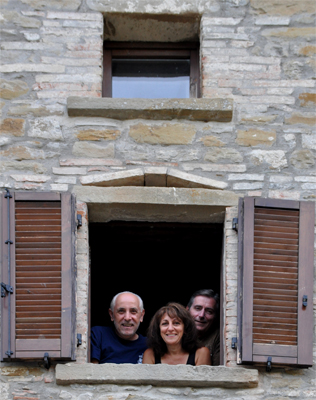
 We are leaving La Tavola Marche and heading to Bologna. I wanted that iconic “Italians in the window” shot, so I asked Ashley if she would take the pic. We are leaning out of the dining-room window looking down onto the courtyard, the outside dining space. (I need to explain the close-up feature of the camera. All the people that I asked to take our pic never zoomed in. Are they uncomfortable with the big camera?) Ours was their largest unit. We had two large bedrooms with en-suite baths and a nice sized living-dining-room/kitchen.
We are leaving La Tavola Marche and heading to Bologna. I wanted that iconic “Italians in the window” shot, so I asked Ashley if she would take the pic. We are leaning out of the dining-room window looking down onto the courtyard, the outside dining space. (I need to explain the close-up feature of the camera. All the people that I asked to take our pic never zoomed in. Are they uncomfortable with the big camera?) Ours was their largest unit. We had two large bedrooms with en-suite baths and a nice sized living-dining-room/kitchen.
I enjoyed our time in the mountains. It was a surprise to hear nothing but the whirring of the cicadas. And I like my attic room with its tall ceilings, beams-and-slats, wooden shutters. (It reminded me of our house in Calabria, me lying awake in bed looking up at the ceiling. And the twin beds certainly stirred the old synapse awake.) The shutters stayed shut all day to keep out the blistering sun, but at night I kept them partially opened to let in the cool night breezes. (I really liked the mechanism that, when open, kept them flush with the outside walls.)
According to Ashley, the third floor was where the family, that owned the house, lived. I find that odd, because the more common arrangement is that the animals are housed on the first floor and the family lives on the second floor. (The only thing I can think of is that it’s a huge house and may have had more than one family living in it. And that the owners chose to live as far away as possible from the smell of the animals.)
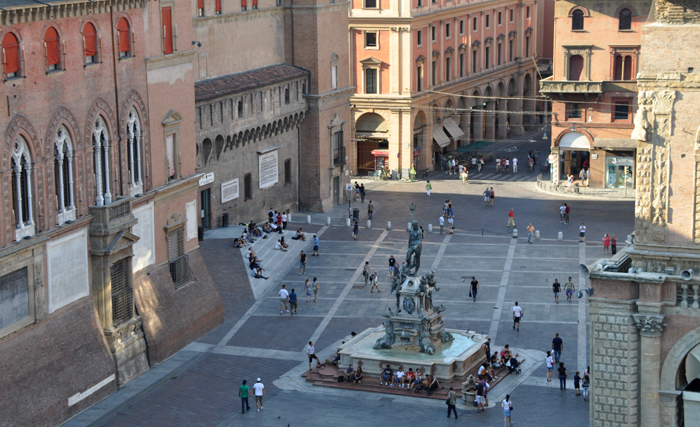
We flew into Bologna thinking that it would be a shorter ride to Fossombrone than driving from Rome. Distance wise it is shorter, but we totally forgot about ferragosto and beach traffic. Two weeks ago, it took us four hours to get to Earle-and-Suzanne’s and today it took us five hours to get back to Bologna. This time we hit all the traffic going home after the August 15 holiday. (It should have been a 2 hour drive.)
We also flew into Bologna knowing that we would have a day there to walk around, visit our favorite restaurant, and visit our favorite cheese and salami store. (The food in the Emilia Romagna region is worth going out of one’s way for.) This time there was an added treat. They are repairing the weather damage to exterior of the cathedral and for 3 euros, you can climb the scaffolding to the top and see the city from on-high.
 The shot is of the Neptune Fountain in the north western section of the piazza.
The shot is of the Neptune Fountain in the north western section of the piazza.
The front of the cathedral has no fancy marble facade. The Reformation put an end to the steady stream of cash and the cathedral was left unfinished. It’s amazing to realize that the Reformation destroyed the economy that the Catholic Church had created. (It’s always presented as a theological threat and never explained as the trigger that ended the reign of a corporate giant. I guess Martin Luther didn’t believe in “too big to fail”.)
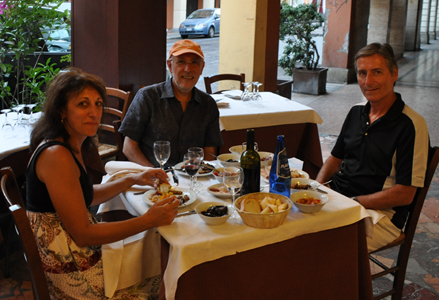
One of the main reasons we flew into and out of Bologna was because we wanted to eat at Ristorante Alice. We had eaten here three/four years ago and really liked it, so we were determined to get back to it. (I kept reminding Rose that the restaurant may not be there. After all, our favorite enoteca was gone. We resigned ourselves to that loss and had a glass of Sangiovese at a tourist joint.)
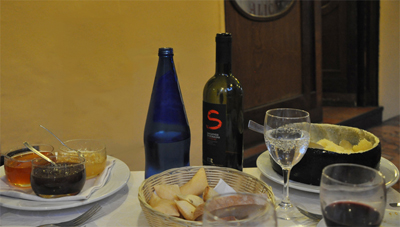
The things we remembered about ristorante alice were the antipasti, the wheel of cheese, and the pasta. Rose had kept the phone number, so I called and made reservations for 8:00. (Italians are just getting dressed to go out at 8:00, we were at the restaurant ready to eat. Whenever we go out to dinner, we are always the first to arrive.)
The restaurant is in the old city – via d’Azeglio – and its outside tables are under one of Bologna’s many porticos. The streets of the old city are lined with these beautiful and practical overhangs. Some are plain and some decorated with frescoes. However, all keep the sun off your head and the rain off your clothes. (In the area of town with Bulgari, Prada, Bottega Veneta, Armani, the porticoes are covered with frescoes.)
We began with the antipasti and the waiter brought out three – grilled zucchini, eggplant, and chick-peas in a balsamic reduction. We just kept smacking out lips and I complained about there being only three. Rose told me to just hold on and the rest would come out slowly. And they did. There was grilled zucchini, buffalo mozzarella, chickpeas in a balsamic reduction, grilled eggplant, roasted peppers, cabbage, dry sausage and prosciutto, roasted turkey with potato dumplings, Borlotti beans with tomatoes, and frittata topped with tomato sauce. We then decided to have a primi piatti, Derrick and I ordered the home-made fettuccini with porcini mushrooms. Rose ordered the ziti with a tomato sauce. She complained about the fact that once again she had missed out on getting the really good pasta. And she had. (The problem was that it was way too much food. I’m not used to eating three full meals a day. One thing about going home is that I will be able to get back to a more restrained eating regiment.)
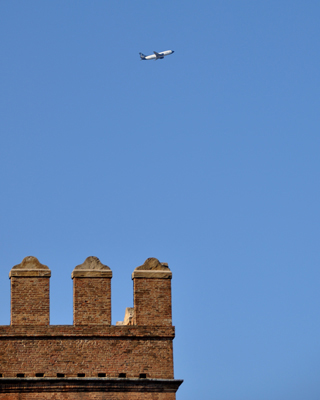
The read this series in chronological order,
click on the category title – le Marche-12 – on the right.
I’ve always wanted to steal lines from John Denver’s Leaving on a Jet Plane and I finally got the opportunity. (I took the shot from the scaffolding covering the front of the Bologna cathedral.)

At 4:30 in the morning even the tourist-packed, under-renovation airport in Bologna is empty. I was the second person through security.
The story of the return trip happened at the airport in Frankfurt. I was one of the first to board the US Airways flight to Philadelphia, so I’m sitting there across the tarmac from an EL AL plane. The entire ground around the plane was roped off and there was a police vehicle at each corner and an armed guard patrolling the perimeter. (The guard had an Uzi strapped across his chest.) Any airport worker coming into the roped-off area was frisked with a metal detector; the perimeter was so secure nothing was allowed to breach it without a full body inspection. There were two layers of security that workers had to maneuver around – the outside layer with the police cars and guards, the inner layer with about 10 supervisors. The police and guards kept people from coming in, the supervisors managed anyone inside the security zone. I don’t know if this is standard-operating-procedure for any and all EL AL planes, or if this only happens in Germany. (I’ve never been on the tarmac next to an Israeli plane before.) I watched for almost 45 minutes and all movements were scrutinized and recorded. Yes, the supervisors had clip boards and made marks every 10/15 minutes.
The trip home, compared to the trip there, was uneventful. (My conclusion is don’t book a trip that has me going through three different airports.)
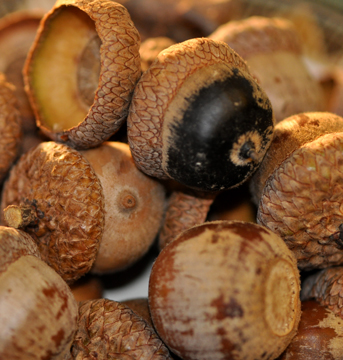
Walking home takes me through Point Park, over the Fort Duquesne Bridge and then through West Park. I began noticing the oak trees the rigid verticals that canopy these two urban gardens. And today I decided to collect the acorns and the caps that littered the grass under the great trees. (Compared to the oak trees – le querce – in Italy these are truly great trees. It’s a wonder what rainfall does to trees. The oak trees in Western Pennsylvania are giants compared to those in Italy.) The image is of acorns I collected from under a moderate sized tree. I gathered these and took them home. This year they are the indicators of autumn.

I began paying attention to le querce, because there have been recurring references the last couple of years to these interesting trees. It all began back in Calabria, in Conflenti when I went looking for the Santuario della Madonna della Quercia. (Never got there, but that didn’t stop learning all about the sanctuary from my uncle whose family lived in the valley. Also, my office manager had gone down to Conflenti to the Santuario and she brought back a brochure that she asked me to translate.) I had to teach myself the correct word for oak tree, all I knew was the Calabrian word I had learned growing up and phonetically it was the Italian word pronounced using French phonetic rules. (The q-sounds became French k-sounds.)
The next references came in Norcia, the city of the cinghiale – the wild boar. (We ate our way through the many shops that sold cinghiale salamis and other cured meats. In a small park, down from the main piazza, we ate paninis, stuffed with cinghiale prosciutto.) Acorns are a staple in the diet of the wild boar. We now look for wild boar options whenever we eat at a restaurant.
Most recently the word came up in the name of the house we stay at, in Le Marche. Earle-and-Suzanne’s house is sheltered by a cluster of oak trees. The soft, rolling fields surrounding the house are perimetered by oak trees, but these are half the size of the majestic oaks here in Pittsburgh.
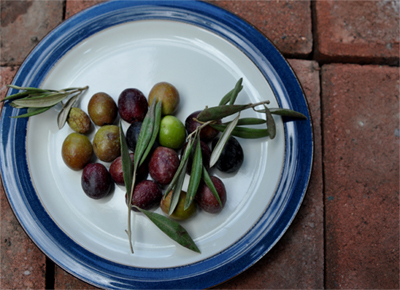
The title is from Dylan’s new album – Tempest. I don’t know if the entry will have anything to do with the title, because I’m going to write about olives, One Young World and probably anything else that comes to mind.

Olives
This year, the olives came from a produce distributor on Penn Avenue in the Strip. He charged a fortune, but then when you’re the only vendor in town you can do that. Unlike other years when the olives came directly from the growers in California, this year the distributor bought 500 pounds and re-packaged them into 10 lbs. boxes and sold them for $30.00 a box. They are Sevillano olives and it was a mixture of olives at different stages of maturity – baby greens, young maroons and mature blacks. I’m hoping that this will add flavors to cured, finished product. (The other olive story is from 3 years ago – the customs official in Buffalo took the California olives that I had bought in Toronto and threw them into the garbage can next to his booth. A nasty man.) The image on the left is a sample of the olives, the stems on a porcelain plate on top of a pallet of bricks.
It was nice sitting in the back deck, cutting the olives. For the second year, we cut them. In the past we cracked them. I told the story of back in Calabria my parents giving me and my friends the job of cracking the olives. In my head there’s a picture of me, Franco-e-Crocca and Corrado cracking olives on the cement in front of our house. When we got bored we’d throw the olives at each other, but stopped when my mother, realizing that laughter meant no-work and mischievousness, came out and yelled at us.
Welch joined us. She wanted to see how we cured the olives.
One Young World
The One Young World conference was in Pittsburgh this year. First year it was in London, last year it was in Zurich and this year Pittsburgh. (And naturally everyone is surprised. Will I live long enough to have Pittsburghers realized what they have here? To realize that the rest of the world understands what we have better than the locals do?) The keynote at the conference was President Bill Clinton.
The conference featured an educational component and they invited three local groups who represent educational reform to speak to the delegates. City High hosted the session. There I was on a Saturday afternoon hosting a bunch of “children” from all over the world who had come to my school to see what we are doing. (Propel Schools and the Pittsburgh Public Schools were also invited and I hosted it.) The person from Propel and the person from Pittsburgh Public Schools were examples of groups that adopted many initiatives and procedures we’ve been doing at City High for 10 years. So when it was my turn it was fun to break the mold – the old man as a young thinker – and to realize we at City High are the trailblazers. There I was, one of the grandfathers of school reform in Pittsburgh. It was a dark illumination.
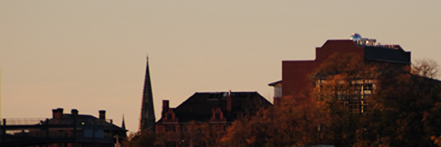
Today on my way home I had the D700 with an old, used 70-210, f/4.5 lens. (A great piece of glass.) I’m having to learn this lens, because there is no manual. So every chance I get I shoot with it.
Also, I’m shooting Manual, but that is somewhat misleading given that the lens a fixed f/4.5. The image on the right is really a slice of a larger shoot. I was trying to capture that fading sun, but in the larger image the surroundings just got blacked out. And in the center of the black was this soft silhouette. (The only thing I did in Photoshop was crop it to its current size.)
I was on the Fort Duquesne Bridge going home to the North Side and I looked across and saw the sun coloring the tops of the buildings over in Allegheny West. (The buildings are on the horizon.) The steeple is Calvary United Methodist a Tiffany decorated church. (It looks like a European landscape.)

In a time of politics, an old Italian is putting up an image of old glory. Let’s hold the snickering down to a whisper. It was an artistic decision. The reason the pic is here is because I like the composition. I’m working with an old lens – 70-210, f/4.5 – and am amazed what I can get from it. (Yes, I took many shots to get one that worked.)
Let’s hold the snickering down to a whisper. It was an artistic decision. The reason the pic is here is because I like the composition. I’m working with an old lens – 70-210, f/4.5 – and am amazed what I can get from it. (Yes, I took many shots to get one that worked.)
I’m in Point State Park, walking home and annoyed that I missed the sun again. (I’ve been trying to get to the blazing trees, and have now missed two days of shooting.) But over Mount Washington the sky is dramatic and I’m shooting at it repeatedly, hoping to capture the rays of the setting sun. So when I got a pic with the rays, who cares that the flag ended up in the composition. (Sarcastic and utilitarian to the end.)
The presidential election is 10 days away; is America going to stumble because she afraid to be inclusive? Is she going to lean backwards believing that going back is the way to move forward?
New York Times – Opinion
The Self-Destruction of the 1 Percent
By CHRYSTIA FREELAND
Published: October 13, 2012
-excerpt-
In the early 14th century, Venice was one of the richest cities in Europe. At the heart of its economy was the colleganza, a basic form of joint-stock company created to finance a single trade expedition. The brilliance of the colleganza was that it opened the economy to new entrants, allowing risk-taking entrepreneurs to share in the financial upside with the established businessmen who financed their merchant voyages.
Venice’s elites were the chief beneficiaries. Like all open economies, theirs was turbulent. Today, we think of social mobility as a good thing. But if you are on top, mobility also means competition. In 1315, when the Venetian city-state was at the height of its economic powers, the upper class acted to lock in its privileges, putting a formal stop to social mobility with the publication of the Libro d’Oro, or Book of Gold, an official register of the nobility. If you weren’t on it, you couldn’t join the ruling oligarchy.
The political shift, which had begun nearly two decades earlier, was so striking a change that the Venetians gave it a name: La Serrata, or the closure. It wasn’t long before the political Serrata became an economic one, too. Under the control of the oligarchs, Venice gradually cut off commercial opportunities for new entrants. Eventually, the colleganza was banned. The reigning elites were acting in their immediate self-interest, but in the longer term, La Serrata was the beginning of the end for them, and for Venetian prosperity more generally. By 1500, Venice’s population was smaller than it had been in 1330. In the 17th and 18th centuries, as the rest of Europe grew, the city continued to shrink.
The story of Venice’s rise and fall is told by the scholars Daron Acemoglu and James A. Robinson, in their book “Why Nations Fail: The Origins of Power, Prosperity, and Poverty,” as an illustration of their thesis that what separates successful states from failed ones is whether their governing institutions are inclusive or extractive. Extractive states are controlled by ruling elites whose objective is to extract as much wealth as they can from the rest of society. Inclusive states give everyone access to economic opportunity; often, greater inclusiveness creates more prosperity, which creates an incentive for ever greater inclusiveness.
The history of the United States can be read as one such virtuous circle. But as the story of Venice shows, virtuous circles can be broken. Elites that have prospered from inclusive systems can be tempted to pull up the ladder they climbed to the top. Eventually, their societies become extractive and their economies languish.
That was the future predicted by Karl Marx, who wrote that capitalism contained the seeds of its own destruction. And it is the danger America faces today, as the 1 percent pulls away from everyone else and pursues an economic, political and social agenda that will increase that gap even further — ultimately destroying the open system that made America rich and allowed its 1 percent to thrive in the first place.
The entire article can be found at: The Self-Destruction of the 1 Percent
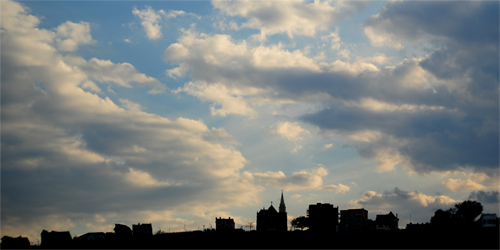
This is the third image using the 70-210, f/4.5 lens. (Now I have to figure out why I’m using the jet plane title.) Think I want to continue the political harangue of the previous post. And inside the aggressive ramblings is the fantasy of leaving and taking the same road Stein and Toklas took to Paris; the road that led them back to the old world; the road that led them to being expats.

America is a different place than when I first come south in the early seventies. The feelings of joint enterprise, of being in it together are gone. We are a nation of I’s with our iPhone and iPads and iTunes, and iBooks and iCars and iHouses. The media is littered with programs where the celebrity’s name is the cache – the drawing card. We seem to not care about anything except things that entertainment us. (It’s not a presidential race, it’s an entertainment event where the gaffes and missteps are reported not the substance. We know we’ve made it if we live in a suburb and our living rooms are frilled with dust-catchers from Pottery Barn and Crate&Barrel; and our double-garage stores a Lexus in one bay and an Audi in the other; and our home-offices are equipped with fiber, iMacs, flat-screens, TiVo, tablets and game consoles.)
I don’t believe that Europeans are any less self-centered, rather it’s not a culture or economy built on anti-intellectualism, conspicuous consumption, frozen foods or home entertainment centers. It’s been around long enough to remember its writers and artists, to remember the horrors of greed, to understand the pleasure of sitting in an outdoor cafe in a piazza. It’s been around long enough to remember its adolescence – the 1900’s.
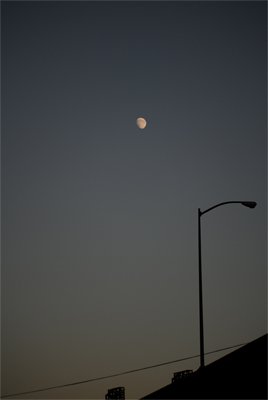
This far inland Hurricane Sandy proved a whimper. I took the pic last week and by now behind the storm-soaked clouds there’s a full moon.
I took the pic last week and by now behind the storm-soaked clouds there’s a full moon.
I’m continuing with the set of images using the 70-210, f/4.5 lens. I’m looking up at the ramps for Interstate 376-South. I like the progression from the yellowish haze of the setting sun, to the pewter sky holding an almost full-moon, to the dark and empty gray.
Today is Connie’s b-day. She’s 57. The image below is from high school.
 It’s funny to remember back to when she was born. The memories are scattered – I remember going upstairs to my parents’ bedroom and finding my mother in bed holding the new baby. The baby was all wrapped up in swaddling and looked very contained and quiet. I don’t remember if I was allowed to hold the new baby. I guess at 6 it wasn’t an option.
It’s funny to remember back to when she was born. The memories are scattered – I remember going upstairs to my parents’ bedroom and finding my mother in bed holding the new baby. The baby was all wrapped up in swaddling and looked very contained and quiet. I don’t remember if I was allowed to hold the new baby. I guess at 6 it wasn’t an option.
I also remember being allowed to use the outside stairs to go up to visit my mom and the new baby. I remember pushing the big door and it opened. At one time our house must have been two separate apartments and the outside steps, to the second floor, remained. We never used them, but the midwife la levatrice had used them when she came to the house. I remember telling my friends, for days afterwards, that if la levatrice came to your house she brought you a new baby.
My friends and I ran up and down these outside steps; we played cards on the narrow ledges; we played castles and knights on the landings; and from the very top steps, we spied on the neighbors. But the door to my parents’ bedroom was always locked except now that la levatrice was visiting. The only other time the door was open was at Christmas. My dad would get us a small pine tree from La Sila and put it up in this upstairs bedroom on top of his dresser. Friends and relatives would bring oranges with stems, torrone in cellophane and chocolates tied with ribbon to hang on the tree. For these holiday visits, the big second-floor door would be open. (On Christmas day I was allowed to eat all the tree decorations.)
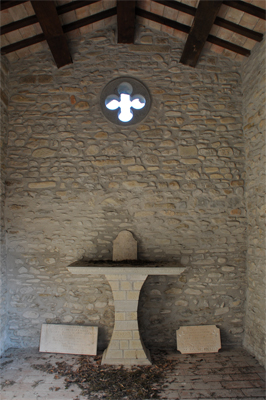
I’m trying to continue the commemoration of this most solemn of days. In Italian it is identified as Commemorazione dei Defunti. In my Italian elementary reader, the story for November 2 is about a dad explaining to his children the culture of the dead. The feast required us all to make a pilgrimage to the cemetery.
This summer in the mountains of Le Marche I shot a cemetery that was no longer in use. (The farm families have abandoned the rural cemeteries and have started to bury their loved ones in the more modern, bigger cemeteries on the outskirts of the towns that the farms surround.) The small chapel on the left was holy in its simplicity. It had been deconsecrated, but the silence evoked the stillness, the sanctity of the campo santo. (The common term for cemetery is Camposanto, or Campo Santo – holy field. It’s an ancient term suggesting that Christian cemeteries were originally built on soil from Golgotha brought back to Italy by the Crusaders.)
My first cemetery experience outside of Aprigliano was my grandmother dying in Sault Ste Marie. (When you move to a new country the young immigrate. And for almost 20 years no one in my family died. My grandparents were in their 60’s, my parents in their 40’s and then we the kids were next. All the old family members were back in Calabria and even though my parents would tell us when someone died, I had started to forget who many of these people were and someone dying back in Calabria was such a distant occurrence that I could forget its impact.) I remember the holding chapel where we left my grandmother’s coffin. It was a damp moldy space. I don’t know why we did not have a grave-side ceremony. The holding chapel was nothing like the one in the pic.
This November 2, I remember Salvatore DeFazio. Requiem æternam dona eis, Domine.
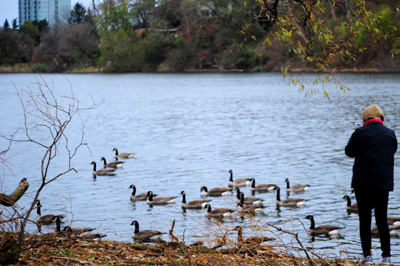
Grenadier Pond is in the south-west quadrant of High Park and also forms the Park’s south-west boundary. Frank and I walked the trail from the baseball diamonds and hockey rink down to The Queensway. (Naturally I went on about the British nomenclature that still lingers in Canada. Grenadier Pond, how much more British can you get? Oh, I forgot The Queensway, the QEW Expressway, The Kingsway.) The Pond was a pleasant surprise. The woman in the picture is taking a picture of the ducks with her cell.
 On the opposite shore and up the embankment sat a line of upscale homes – the houses of Grenadier Heights. This neighborhood, south of Bloor is one of the fancy west-end enclaves. High Park is surrounded by quiet, upscale neighborhoods. Also a surprise was the supposed safety of the park. (In America many urban parks are bordered by unsafe neighborhoods. And the parks are scary along these boundaries.) The people we saw on the trails all seemed, like us, out on an afternoon walk. (Toronto is such a diverse city. I really enjoy the mix.)
On the opposite shore and up the embankment sat a line of upscale homes – the houses of Grenadier Heights. This neighborhood, south of Bloor is one of the fancy west-end enclaves. High Park is surrounded by quiet, upscale neighborhoods. Also a surprise was the supposed safety of the park. (In America many urban parks are bordered by unsafe neighborhoods. And the parks are scary along these boundaries.) The people we saw on the trails all seemed, like us, out on an afternoon walk. (Toronto is such a diverse city. I really enjoy the mix.)
My grandparents lived north-west of the Park on Jane Street. (In those days, Italians did not live in this part of Toronto. My grandparents were the only Italian immigrants in this German, English section of town. In recent years, Czechoslovakian immigrants have taken over many of the stores along Bloor.) I remember my mother and I walking from Jane, down Bloor to the Park. (My grandparents were very proud of their proximity to High Park.)
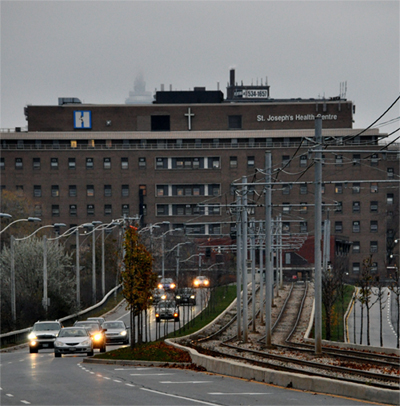
and the years are rolling by me … i am older than i once was, younger than i’ll be
I started traveling to Toronto on my own, back in the late 60’s when I was in high-school. (There’s a picture of me, a very young man, at the Sault Ste Marie airport with my tennis-racket heading out to Toronto. Frank and Ron are there to see me off. It’s dated June 24, 1967.) In those days, I was going back and forth getting my paperwork ready to enter the monastery. One of the trips was to take a psychological.

I always stayed with my grandparents when I went down. Brother Lucien would come get me at my grandparents and take me to the Christian Brothers’ Motherhouse in Scarborough for the various interviews and form filings. (Back then Scarborough was farms.) My grandparents lived in Toronto’s west-end and the Motherhouse was in the eastern reaches. To get there we would drive the Gardiner Expressway and pass St. Joseph’s Hospital. The hospital became one of the mile-marker I used to teach myself where I was on the Gardiner. Another marker was the TipTop billboard and a third was the Canadian National Exhibition gate.
Those were my Simon & Garfunkel and Dylan years, when Sound of Silence, Scarborough Fair, The Boxer and Blowing in the Wind gave words to my thoughts. And I assumed that once I left for the monastery, I would never see Toronto or Canada again. I would live my life in America. Not true. I left the Brothers after 6 years but I’m in Toronto on a regular basis. And now, when I’m alone and driving the western leg of the Gardiner, it’s not unusual to turn on the old music and remember another time when – I was so much older then, I’m younger than that now.
This afternoon, Frank and I went walking through High Park and we ended up down on the Queensway – the road in the picture. And there in front of me was St. Joseph’s Hospital – the same grey-brown facade, the same squat structure. I never knew where to situate it, because it was something I only saw from the Expressway. Now I knew where it fit. Actually I came away from the weekend feeling like I understood Toronto’s west-end. I have a picture of it in my head; I know where buildings stand; where streets and avenues intersect; where the indoor tennis-courts sit.
after changes upon changes we are more or less the same
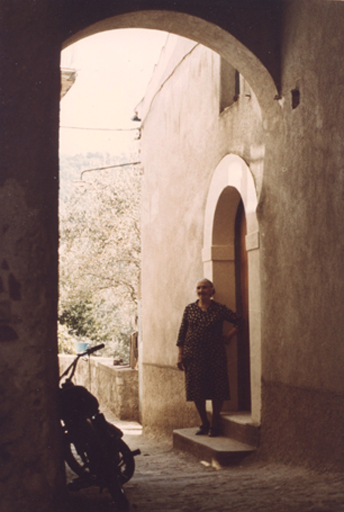
I spent the weekend in Toronto and visited with Za Nuziata and her family. In Aprigliano, Za Nuziata lived next to us in la vinella – the small alley-way that was our street. Nuziata’s grandmother and my grandfather were brothers-and-sisters. This is another branch of the Perri family.
 When I visit Za Nuziata, I am Marru or Marruzu Mio – an endearment of long ago; an endearment that puts me back in la vinella playing hide-and-seek in the doorways, running up and down the stairs, aiming my slingshot at the swallows’ nests.
When I visit Za Nuziata, I am Marru or Marruzu Mio – an endearment of long ago; an endearment that puts me back in la vinella playing hide-and-seek in the doorways, running up and down the stairs, aiming my slingshot at the swallows’ nests.
Nuziata is the youngest of 5 children whose mother died when Nuziata was 22 months. And her father’s sister – Za Peppina made a decision not to marry and instead raise her brother’s children. The image is Za Peppina in front of her house. The door – il portone – led into their house. The small opening in the low wall, at the end of her house was the stairs down to our house. There was a second, smaller door into Za Peppina’s on the stairway that led down to our house. I have memories of going in and out of that side-door.
Za Nuziata’s nephew – Gabriele – was one of my best friends. Gabriele, Franco-e-Crocca, Corrado and I were the group-of-four. (In our Calabrese dialect, Gabriele got its r-consonant switched and became Grabiele.) Franco and Gabriele lived next to each other. Our days were spent going back-and-forth between one end of la vinella – my house – and the other end of la vinella the road that led to Corte, to Santo Stefano, to Guarno.
Gabe, as he’s now called, owns a large construction company. I co-founded a charter school that runs a 10 million dollar budget. Franco-e-Crocca is a partner in and accounting firm. (Three of the group-of-four made it into partnerships, company founders or presidents. Corrado is the only one didn’t aspire to corporate heights.) Gabe lives in Toronto; Franco-e-Crocca and Corrado live in Cosenza; I live in Pittsburgh.
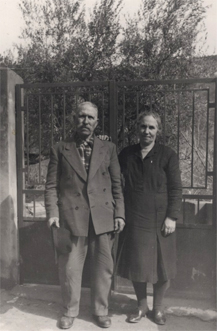
A Brother and A Sister – Gabriele Vigna and Giuseppina Vigna

The Old Names
Gabriel is the messenger, the angel of the Lord. Hail, full of grace, the Lord is with thee.
In old Apriglianese, Gabriele became GRABIELE. It took me years to drop the R-sound at the beginning, but if I’m talking with my parents and we mention the Vigna family – Za Peppina or Zu Grabiele – the R goes right back.
Zu Grabiele’s first grandson was named after him. And we still refer to him using the old dialect. Just as I’m Marruzu, he’s Grabiele.
Giuseppina means the Lord adds.
My youngest sister was supposedly named Giuseppina because she was born on March 19 the feast of St. Joseph. My mother also told me that she was happy to name her youngest child Giuseppina because it was the name of her best friend’s daughter, who also happened to be Zu Grabiele’s grand-daughter. But our Giuseppina allowed only her mother to call her Giuseppi, the rest of us called her Jo’. Would she have become Peppina in her old age?
Coincidence1 – Zu Grabiele’s wife was a Giuseppina. (Her name got reduced to Petrina.) She died leaving 5 small children. Zu Grabiele’s sister was also a Giuseppina. And she took on the task of raising her 3 nieces and 2 nephews. (Her name got abbreviated to Peppinella. And by the time I came along she had matured into Za Peppina.)
Zu Grabiele’s younger son Cristinu – Christian – married my mother’s best friend Giovanna. Cristinu e Giovanna had two children – Grabiele and Giuseppina. (Who were they immortalizing in naming their daughter Giuseppina, her grandmother Petrina or her aunt Peppinella?)
Coincidence2 – Giuseppina Zinga and Dave Thorman named their first child Christian – Cristinu.
Zu Grabiele was born on January 2, 1887 and died October 14, 1971. He was 84.
Za Peppina was born May 5, 1905 and died March 12, 2008. She made it to 103.
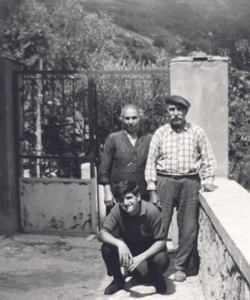
 |
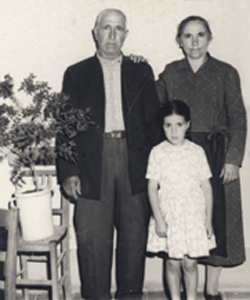 |
The image on the left is Za Peppina, Zu Grabiele and young Grabiele. It’s the same gate as in the picture below.
I saw young Grabiele years ago when he first came to Canada. We met in the Toronto subway. I remember us sitting in the train. I also remember him telling me he was studying to be an architect.
(In Canada he goes by Gabe.)
The image on the right is Zu Grabiele, Za Peppina and young Giuseppina. At this age, Giuseppina looks like her mother. (This is my favorite picture of Za Peppina.) What is the plant in the plastic pot on the whicker seat of the old kitchen chair?
My mom was asking me if I was at Giuseppina’s wedding. I have no memory of seeing Giuseppina in Canada. And I don’t remember her when we were kids growing up in Aprigliano. I think I was gone from Calabria by the time Giuseppina was born.
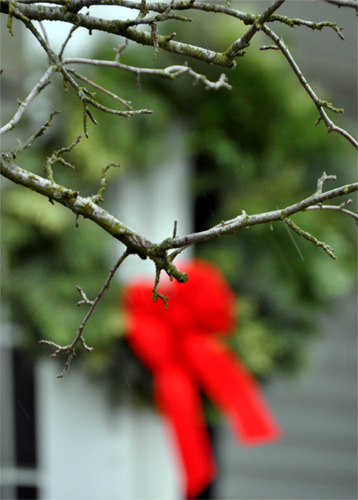
 I began the trip yesterday, hoping to get ahead of the storm, but where the drive was through flat Ohio corn-fields and gray skies; the severe weather was also moving west and got to Northern Michigan by the time I reached Oxford north of Detroit.
I began the trip yesterday, hoping to get ahead of the storm, but where the drive was through flat Ohio corn-fields and gray skies; the severe weather was also moving west and got to Northern Michigan by the time I reached Oxford north of Detroit.
There is a storm warning for Gaylord – the middle of the state, an I-75 corridor and a snow-belt area. The cameras for Michigan State Transportation show a snow-covered I-75 North in the Grayling/Gaylord area. (I’ve always wanted an opportunity to use those two names in a posting, guess it finally came along.)
So, I’ll stay at Rose-and-Derrick’s at least today. We’ll see what the roads look like tomorrow and decide if we’ll travel or wait till Saturday.
The image is of Rose-and-Derrick’s neighbor’s house. I couldn’t do a wreath and this was the next best thing – a blurred wreath in the background and bare branches in the foreground.
I’ve never tried to understand the gray-gloom of this time of year, mainly because I’ve always been focused on the long ride to Sault Ste Marie and getting there without hitting bad weather. But this year it seems that the gray-gloom was all-encompassing. Pittsburgh was cloud-covered and everything was a miserable-gray. And today, it’s raining and gloomy here in Southern Michigan. I finally figured out that the season begins with the gloom and end with the sun. No wonder Mother Church decided to re-structure the Roman Saturnalia and the coming of spring. (Whoever figured out to do Christmas in the gloom and Easter in the brightness of spring was a genius.)
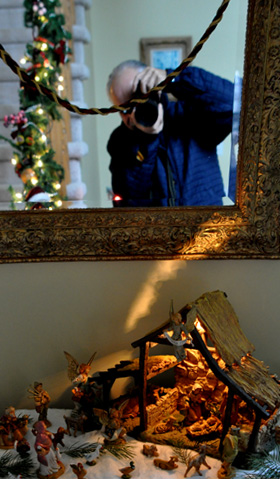
 The weather is really frightful; we are getting the rain-band of the storm. We’ve decided to stay in and enjoy the luxury of not having to go anywhere or do anything. And Sambuca makes doing nothing even more pleasant.
The weather is really frightful; we are getting the rain-band of the storm. We’ve decided to stay in and enjoy the luxury of not having to go anywhere or do anything. And Sambuca makes doing nothing even more pleasant.
The image is of the presepio on top of grandma’s old sewing machine, the stairs festooned in garland and me in the mirror with camera and quilted jacket. The presepio is an old world, Italian tradition we’ve all maintained. They’re no longer the hand-made, hand-painted, paper-mache, Neapolitan figurines, now they’re made in resin molds and colored in bland, faint earth-tones. (The Neapolitan angels drape the Christmas trees at The Metropolitan in NYC, The Carnegie in Oakland. And the mangers scenes, celebrating the poor of the world, spread out under these artificial evergreens.) My presepio was a gift from Jo’. One of her friends had gone to Italy and she got her to buy me my manger figures. (The one I assembled when we first came from Italy is at my parents. It’s figures are Neapolitan and paper-mache.)
Rose talked to both Mafalda, my mom and her mom – Mafalda’s sister and my aunt. Both understand the interference the weather has brought, but are confused about the fact that we just didn’t drive up. (My aunt mentioned that the schools were closed in the Soo, because of the weather. And yet we’re supposed to drive up and visit with them.)

 We had a great supper – pasta with herbs flavored olive oil, salad and dessert. The dessert was wonderful. Derrick roasted chestnuts out on the grill, in the rain and I suggested we have the Visner di Pergola that they had brought back from Le Marche. The Visner is a sweet wine – wild cherries from the Macerata area blended with Sangiovese and Montepulciano wines. The wine gets its name from the wild cherries know as visciole. Throughout Le Marche families make their own version of Visner. And the quality varies just as the quality of the home-made wines we will soon drink up the Soo varies. (I’m curious to see what my dad’s wine will taste like this year. With him it’s always a surprise. My uncle is more consistent with his wine from year-to-year.)
We had a great supper – pasta with herbs flavored olive oil, salad and dessert. The dessert was wonderful. Derrick roasted chestnuts out on the grill, in the rain and I suggested we have the Visner di Pergola that they had brought back from Le Marche. The Visner is a sweet wine – wild cherries from the Macerata area blended with Sangiovese and Montepulciano wines. The wine gets its name from the wild cherries know as visciole. Throughout Le Marche families make their own version of Visner. And the quality varies just as the quality of the home-made wines we will soon drink up the Soo varies. (I’m curious to see what my dad’s wine will taste like this year. With him it’s always a surprise. My uncle is more consistent with his wine from year-to-year.)
Even though it has been a great day relaxing and not having to worry about driving, the news is all about the storm and the havoc it is wrecking across the mid-west. We may not leave until Saturday. By then it will have made its way through Michigan. Also, by Saturday, the Interstate should be in decent shape.
The image on the right is of a Christmas sock on Rose-and-Derrick newel-post.
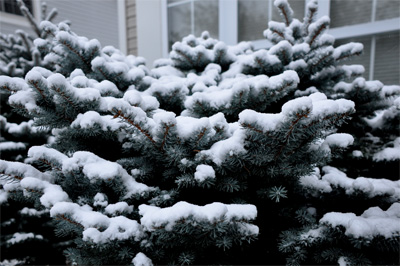
 The snow made it to this part of the Lower Peninsula. Detroit was spared, but we’re 70 miles north of the city.
The snow made it to this part of the Lower Peninsula. Detroit was spared, but we’re 70 miles north of the city.
Went outside to shoot some pics and it’s not all that cold, but you can feel the thin layer of ice on the concrete. After all it rained and rained all day yesterday.
The Michigan Department of Transportation’s camera still shows snow covered roads in the Grayling/Gaylord area. And the decision is to stay put one more day and to head up tomorrow. By then the storm will have moved out of the area and the roads should be in better shape.
Leger texted me to say that Boehner can’t get the votes he needs from his fellow Republicans to pass a Plan B bill. I know this makes me old, but I do remember the same thing happening to the Dems when their run was over. The country had changed and they were still running on a liberal agenda. (Nixon was the symbol of the change of the end, but the Dems wouldn’t look.) Well guess what, the country has changed again and the Republicans still thinks that white-men rule. (Obama is the new symbol and there is just as much cultural blindness now as there was 45 years ago.)
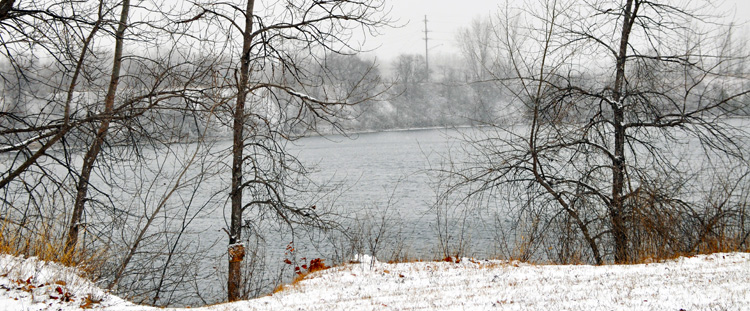
 The world is beginning to get back to a non-sullen routine – the skies are losing their gray pallor; the winds are running empty; the snows are drifting slowly; the reds and greens of the season are twinkling bright.
The world is beginning to get back to a non-sullen routine – the skies are losing their gray pallor; the winds are running empty; the snows are drifting slowly; the reds and greens of the season are twinkling bright.
My dad doesn’t like the fact that we’ve been stranded by the weather and readily expresses his displeasure. (Even Connie couldn’t leave for Toronto and the Thormans. All flights out of Sault Ste Marie were cancelled yesterday.) The storm was correctly named – Draco. (JK Rowling would be pleased to know that the characteristics she gave her fictional antagonist have also served to define the storm.) BTW, did I just mix my metaphors – The Lion the Witch and the Wardrobe, Harry Potter?
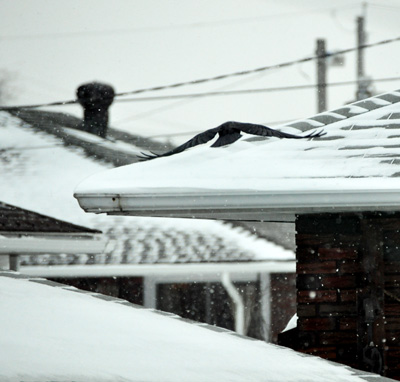
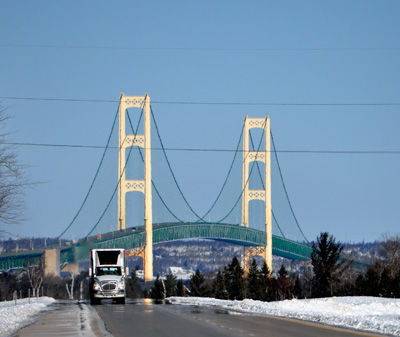 The drive north from Oxford was OK except in two places – 30 miles south of Gaylord and 30 miles before the Soo.
The drive north from Oxford was OK except in two places – 30 miles south of Gaylord and 30 miles before the Soo.
Gaylord is the center of the snow-belt, in Northern Michigan, and the trees surrounding the highway were amazingly beautiful in their snow covers. The winter landscape was worthy of a postcard. (Draco left behind a winter wonderland.) But all I kept thinking about was the snow storm – what it must have been like two days ago on this stretch.
After three hours of snow-free roads, I-75 became a problem. The right lane was covered with packed snow. Not a big problem given that it hadn’t iced, but the packed snow made it difficult to drive casually. Such conditions are two-hands-on-the-wheel-and-no-music driving events. All the cars got into the left lane and we followed each other down the highway like goslings following mother. And because the left lane was clear, we were able to maintain speed. After Gaylord, the road was clean and I thought, “If that is the worst I’m going to get then I’ll thank some higher power.”
There are certain markers that I use when making this trip, Gaylord is one; the sight of the south tower of the Mackinac Bridge is the other. (Once I hit the bridge, I have to steel myself for the crossing. The span is an engineering marvel and a magic string over the straits, but the roadbed and the low railings scare the shit out of me. The low railings and the missing road-shoulder make riding in the right lane feel like I can hurdle into the roaring waves at any minute. The left land is an open metal grid – supposedly the grid allows for wind currents and thus stabilizes the Mighty Mac. But riding on the inside lane is nerve-racking and feels like the car will slip and slide. But that sensation is easier to deal with than the fear of being hurled over the side, so I drive the inside lane. Throughout the ordeal, I keep telling myself that the trip is coming to an end.) Once I crossed into the Upper Peninsula the road was a mess. The north bound lanes were not clean and I drove the last 30 miles on packed snow. I just kept looking for the steel mill smoke stacks. I-75 ends at the International Bridge over the St. Mary’s river, the boundary between the U.S. and Canada. On the Canadian side of the river is the steel mill.
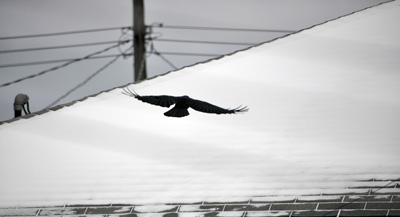
 My favorite room in my parents’ house is the sun-room. It faces the garden and its windows are always curtain-free. It’s also the view that has the most memories.
My favorite room in my parents’ house is the sun-room. It faces the garden and its windows are always curtain-free. It’s also the view that has the most memories.
Behind my parents’ garden is the Coccimiglio’s house. Giselle Coccimiglio was the beauty of my generation. (She was the classic Italian young woman with beautiful long black trusses.) And like all the immigrant daughters was very restricted in who she could talk to and who she could socialize with. (I remember thinking that her parents were more like my grandparents in their over-protectedness.) Giselle was not allowed to socialize with anyone in her class. (Frank, she and I were all in grade 8 at St. Veronica’s.) My mother would tell me about all the kids I had grown up with and she told me that Giselle married some older Italian man that her family selected. Giselle died young of breast cancer.
To the right of Coccimiglio’s is Colleen’s family’s house. We played softball in the field behind Colleen’s house. She was the only girl to play with all us immigrant boys – Frank, Rainer, Ron, Jackie, Mike, Joe, Carlo. And everyone wanted her on their team, not because she was attractive, but because she was the best ball player in the neighborhood. Even Ron with his natural athleticism and fluidity couldn’t hit as far as Colleen. Every time she was up to bat, all the fielders would move back to the road knowing they had to prevent a home run. (I don’t remember any of us caring that she was a girl and could hit and run better than us.)
Next door is Concetta Sirianni’s house. She is this gregarious woman full of bawdy language and extreme opinions. And a welcome breath of fresh air into a very proper Calabrese family. (The two Perri sisters come from families that prided themselves in a sense of propriety. A propriety that set them apart. Afterall their mother came from a family of small business people – lace makers – and their father had made it to l’America and prospered there.) Mafalda told me that Concetta has “buried two husbands” and is now involved with a social group of widows and widowers and having a great time. Mafalda wonders if she’ll find a third husband.
Sitting here drinking my morning espresso, three crows flew into the yard. (I associate crows with winter. It seems I only see them during that time of year.) I quickly got my camera and started shooting. The crow is flying away lighting over the Coccimiglio’s house.

Today I sat down with Mafalda to ask about the Perri family’s geneology.
My grandfather was one of six children – Assunta, Eugenio (my grandfather), Gulia, Emilia, Stefano and Concetta. My great-grandparents were Angelo Perri and Luisa Carbone.
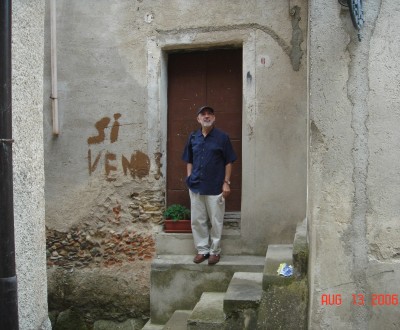
The brothers
The family story is that my grandfather – Eugenio – came to Canada and sent money back to the family in Calabria. My great-grandmother supposedly used the money as dowry for the girls and to purchase a house in Corte. (My great-grandparents raised their family in one of the torre in the hills surrounding Aprigliano. And with my grandfather’s money, they left the country-house and moved into town. The pic on the right is me standing in front of the house that my great-grandparents lived in.) But when my great-grandmother died, my great-grandfather went to live with his son Stefano and gave Stefano the house deed, even though it had been purchased with money his brother, my grandfather, had sent from Canada. (My grandfather believed that his mother had saved the money he had sent and that he could return to Calabria and make a living using his savings to buy land. Instead, when he returned he found that all the money had been spent. He packed up and returned to Canada.)
When my parents married, Mafalda’s uncle Stefano rented them the house in Corte. I was born in that house. (Mafalda tells the story that she and my dad had missed one of the rent payments – 700 lira a month – because times were hard. Her uncle Stefano came over with his shotgun and told her that if they missed any other payment, he would use the gun on them. Mafalda was outraged, because this was the house her father’s money had purchased.) I never knew that the house in Corte had been the Perri family house in town.
My great-uncle Stefano died at work. He fell while he was pruning on olive tree and the fall killed him.
The sisters
Assunta was the oldest of the Perri children. She married Eugenio Vigna and there were 6 children.
Gulia married Giovanni De Fazio. She died young and left behind 5 children.
Emilia married Luigi Carbone and they had three children. I visit with one of those children – Maria Lucente when I go to Aprigliano. Maria bought the old Perri house where my parents first lived and where I was born. She incorporated the old Perri house into her house.
Concetta married Peppino Giordano and moved to Pietrafitta the next main town on the SS178 after Aprigliano. (Mafalda remembers the least about this aunt.)
Connections
Za Nuziata is related to us through her grandmother. Her grandmother Rosaria Perri and my great-grandfather were brother and sister.
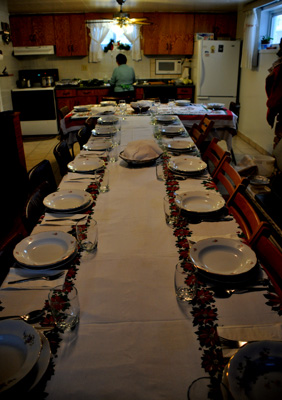
 Let me begin with Christmas Eve. We always go to my aunt-and-uncle’s for this meal. (Years ago, they agreed that for one family to host both the Christmas Eve and the Christmas Day meal was not fair or practical, so the two days got split between my aunt’s family and my family.)
Let me begin with Christmas Eve. We always go to my aunt-and-uncle’s for this meal. (Years ago, they agreed that for one family to host both the Christmas Eve and the Christmas Day meal was not fair or practical, so the two days got split between my aunt’s family and my family.)
My favorite dish is the spaghetti dressed with olive oil and anchovies. The other pasta option is a red sauce flavored with calamari. (They still follow the old Catholic tradition of no meat dishes on Christmas Eve.) The white spaghetti with the anchovies is for the 4 remaining Apriglianesi – Egilia, Mafalda, Ciccio and Mario. My uncle and his step-mother are from Martirano and don’t eat the white spaghetti. Rose and Derrick follow the Martirani and use only the red sauce with the calamari on their pasta.
My uncle always has some surprise at this meal. This year it was Strega – a yellow herbal liqueur from Campania.(He pointed out that this particular bottle was direct from Italy and not purchased in Canada.)
This led to talking about the process that one had to go through to buy any alcohol product in Ontario. I remember the Liquor Control Board (LCB) store on Albert Street. It was lined with shallow shelves and above the shelves were pictures of the various products you could buy. The customer filled out a card with the product name and its number and took the slip up to the counter. One of the agents would go into the back and bring out your product. And my favorite product was a liqueur called Millefiori. It too was a yellow liquid, but inside the bottle was a branch and the branch was coved in sugar icing, clear sugar icing. It was a beautiful presentation. (I’ve been looking for a bottle for years with no luck. Rose said that she had also looked in Italy and was told the company no longer make the product.) My uncle claimed that Strega has a similar taste. I didn’t know Strega, so he rummaged around in his “bar” and brought out a bottle purchased in Italy not at the LCB, and we opened it and had a drink. It does taste similar to Millefiori just not as sweet. But then there isn’t a branch covered is sugar inside the bottle.
Today the meal is at my parents’ and we’re expecting a minimum of 20. And Ciccio has been cooking since this morning at 6:00. Right now the two old people are in the downstairs kitchen arguing about how many will be for dinner. (I had lunch; yelled at them for arguing with each other; (The argument was whether Ciccio should break open his 5-year-old barrel of wine. Mafalda claiming that this was a good occasion, Ciccio claiming that he had no empty bottles to transfer the old wine into.); I left them to their own devices and came upstairs to do this entry. I guess at 85 and 86 arguing may be healthy.)
There will be two distinct meals – an Italian set of dishes and a Canadian set. The Italian foods include capelletti in a chicken broth, lasagna, and various greens – rapini, broccoli, and salad. The Canadian foods include fried shrimp, fried clams, turkey, stuffing, and mashed potatoes. I eat the Italian stuff.
The pic is of the tables in the downstairs kitchen. My mother is at the sink preparing some food.
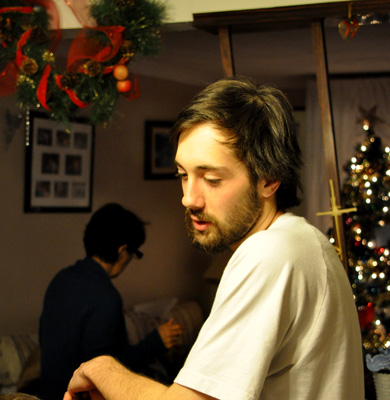
 At dinner my dad got sick, because he ate a bad clam. (I never eat their non-Italian food. I believe they should stick to the foods they are familiar with, but then they wouldn’t be Canadian; they would still be immigrants. And in this family the tension between the two cultures is always a fine line that all of us tread.)
At dinner my dad got sick, because he ate a bad clam. (I never eat their non-Italian food. I believe they should stick to the foods they are familiar with, but then they wouldn’t be Canadian; they would still be immigrants. And in this family the tension between the two cultures is always a fine line that all of us tread.)
Last night, my dad was going on and on about his cousins who spent Christmas Eve at home rather than join their children at a restaurant. Ciccio was outraged at this break – going out to eat on Christmas Eve rather than cook and host all the family – with tradition. I kept saying that it was OK given how much work it was to host a large family gathering.
The bad clam incident led to a memory dump of all the other times that Ciccio inflicted his experiences on the rest of us at Christmas…
There was the time that the neighbors came to wish everyone a Merry Christmas and Ciccio visited with them. They came just as we were getting ready to sit down to eat. The visit got extended and we all left the table hoping that they would get the hint, but Nah, they stayed with Ciccio for at least another 45 minutes. By the time we ate the food was cold.
There was the time when the chimney caught fire just as we were sitting down to eat and Ciccio decided to go on the roof with the hose and sending water down the chimney that was shooting out sparks. The fire department came, made sure there was no chance of fire and left. We all went back in to eat.
The pic is of Christian, with his aunt Connie in the background. He’s sporting a beard. (Connie claims he looks like his nonno when Ciccio was young.)
Connie gave me a new red espresso pot. It will add color to my kitchen.
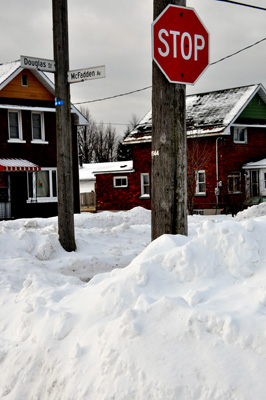
 The British live on in Canada – today is Boxing Day. (By the time I got up, Ciccio had taken down the two extra tables and set them by the stairs. I got Christian and Clay to take them back out to the garage.)
The British live on in Canada – today is Boxing Day. (By the time I got up, Ciccio had taken down the two extra tables and set them by the stairs. I got Christian and Clay to take them back out to the garage.)
Because the sun was out, I decided to take a walk to St. Veronica School. (It’s funny how my one year at St. Veronica’s – 8th grade – is a stronger memory than any of other elementary school experience.) I followed the route I used when going to school in the winter of 1964. In the fall, I would go through the wooded lot between Douglas Street and the school then known as the bush, but in the winter I would use the streets.
The pic is of the corner of Douglas Street and McFadden Avenue. Ron lived on Douglas, in the house on the right. (Much of the housing stock that was there in 1964 is still there. Newer houses fill in the lots that were empty back then.) Growing up, Ron’s house was the place we would all hang out at. It was where we would meet in the morning to decide what we were going to do. Frank lived at the end of McFadden.
I didn’t crop the image, because I wanted to show the snow. The banks were easily 5/6 feet high.
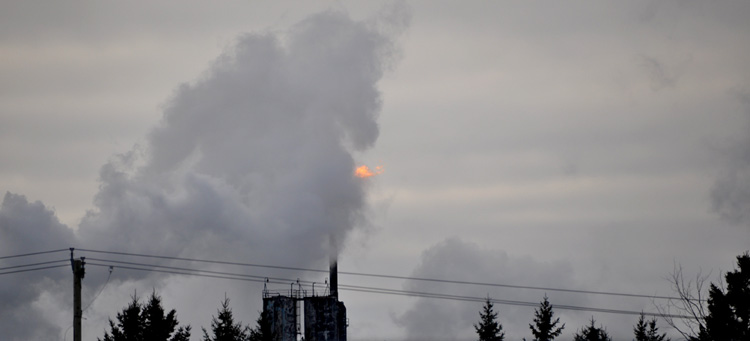
By 10:30 I was on my way home. I drove the first half today and tomorrow will head east to Pittsburgh. The Customs’ agent was this really nice person and we talked about how I became an American citizen. (Going through Customs is usually an ugly experience.) Getting through Customs is the first step home and crossing The Mac is the second.
I’m trying to figure out how to situate this last post and I decided to play with the idea of memory.
 I went out for an early walk, my last before leaving for another year and I was coming down McFadden and there, on the horizon above the pine trees, was the symbol of 1950’s Sault Ste Marie – huge black chimneys bellowing white smoke and narrow chrome chimneys spouting open flames.
I went out for an early walk, my last before leaving for another year and I was coming down McFadden and there, on the horizon above the pine trees, was the symbol of 1950’s Sault Ste Marie – huge black chimneys bellowing white smoke and narrow chrome chimneys spouting open flames.
My family came to this northern outpost, because in the late 50’s, after the war, Canada was building its industrial base and recruited laborers in the devastated cities and towns of post-war Italy. It almost emptied out Calabria. There are more Calabrese in Southern Ontario than there are in Calabria today.
The Canada of the late 1950’s and the 1960’s was a nation on the move – new roads, new airports, new cities, new suburbs, new universities, new museums. The immigrants, who crossed the Atlantic, saw it as the land of hope, the land of work. My dad worked at the mill and made a living for his family. All his children got a university education and the opportunity to make a good life. (While in college, I went home for the summers and worked in the mill. Made enough money to pay my next year’s expenses. That’s how I paid for Junior-Year-Abroad.)
But modern-day Canada is selling its natural resources to the highest bitter. In July, the Wall Street Journal reported:
Cnooc Ltd. swept into Canada with China’s biggest overseas acquisition yet, a $15.1 billion deal to buy one of that country’s largest energy producers that reignites a debate over the role of Chinese state players in North America’s energy industry.
If completed, the deal for Canada’s Nexen Inc., would mark China’s most ambitious push into the continent’s oil and natural-gas fields. It would give Cnooc a key role in technologies reshaping the energy landscape and open the door for it to operate in North American fields alongside such oil-and-gas giants as Exxon Mobil Corp. and Statoil ASA.
The entire article can be found at: China Push in Canada Is Biggest Foreign Buy
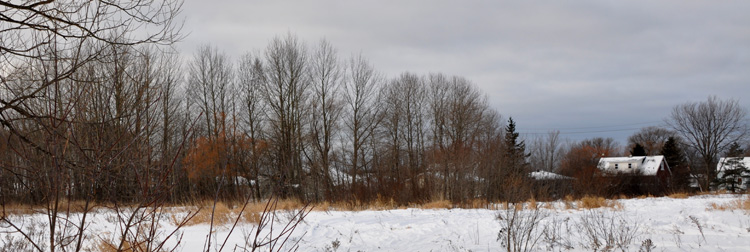
To read this series in chronological order,
click on the category title – Christmas-12.
The drive from Oxford to Pittsburgh has a couple of unpleasant spots, but it also has the pastoral Ohio Turnpike.

The first tension-step is getting on I-75 South. This morning traffic was light and getting on was easy. Two or three miles down there was an accident and a long backup, but I got through it quite quickly. The next tension-spot is the exit towards Toledo. (It’s actually the continuation of I-75 South but it veers west away from downtown Detroit.) From the exit and until you enter Ohio, I-75 is miserable. The landscape is Blade Runnerish. I-75 through south-east Michigan is an ugly environment and the section south of Detroit the worst. The run through the Marathon Oil Refinery area is surreal. (I hope replicants run the machinery?) When I see the Welcome to Ohio sign it’s a relief. I’m out of Michigan.
I-75 through Ohio is beautifully landscaped and the Cable Stayed bridge in Toledo is elegant. Next is 280-South a connector to the Ohio Turnpike. Going through the gate at Entrance 155 and heading east is another marker on the road home. The Ohio Turnpike is really well designed. Huge cement walls separate the east and west bound lanes, and the service centers are new and very modern. The topography undulates through corn-fields and today they were white with December snow.
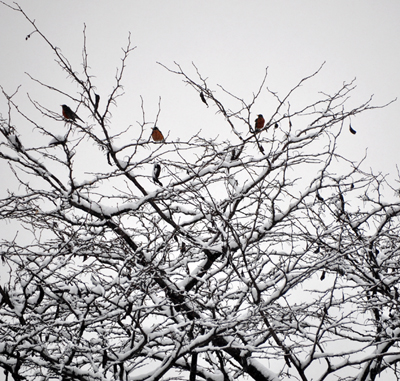
 I missed both recent storms.
I missed both recent storms.
Today the snow started coming down early and by the afternoon had left very pretty images. (I’ve been waiting a long time to get a picture of birds in a leafless tree and today I got it.)
Throughout the trip to Sault Ste Marie and then home, snow-covered landscapes made for beautiful scenes. Going up the snow-laden evergreens south of Gaylord were amazing. There were places where I was driving through tunnels of snow-covered trees. On the home trip, the fields of north-western Ohio were blanketed in wisps of snow. All remnants of the first two winter storms. And yet how is something so pretty, so difficult to live in? I hate shoveling driveways; I hate cleaning the car of snow and scraping the windows of ice; I hate the parking on city streets clogged with snow; and I hate the cold. (And yet, I remember a time when winter was about playing hockey on school-rinks and snow-covered streets, going tobogganing down Garson’s Hill, going cross-country skiing at Hiawatha Park. Now, I count the days until I leave for Kaua’i.)


These are collections of postings.
Kaua’i – 2013
big-dig
le marche – 2013
christmas – 2013
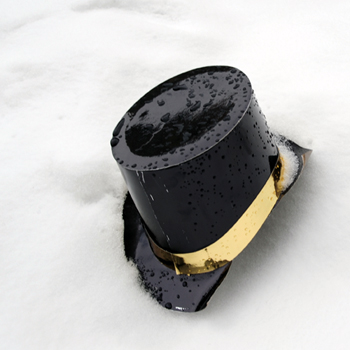

Capodanno is New Year, literally – beginning of the year.
Decided to take a walk – North Side to Downtown and back. The skies are gray, not a hint of sun. (Don’t think this is much different than up north in Sault Ste Marie, but it all feels less claustrophobic. I have not been able to figure out why it all feels so close up north. It must be psychological and experienced emotionally.) Took a bunch of pics and kept having to use a large open aperture to compensate for the gray.
I found the New Year’s hat in the snow on Federal Street across from PNC Park. The brim on the right was ripped off and on the sidewalk. New Years festivities are such a constrast to Christmas. Christmas is family and presents. New Years is strangers and indulgence. There is a great expression in Italian – Natale con i tuoi, Capodanno con chi vuoi. Christmas with your family, New Years with whom you want.


La Befana vien di notte
con le scarpe tutte rotte
e vestita alla romana
viva, viva la Befana!
The rhyme tells of an old woman who comes by night, riding a broom and delivering presents. Her shoes are all ripped and she is dressed like the beggars of ancient Rome. And yet, she is cheered. (The image on the left is a sanitized rendering of the old hag.) La Befana was the character that brought us gifts during the Christmas season. There was no Santa in post-war Italy. The late 40’s belonged to the old hag. American culture was still contained in The Lower 48. La Befana came on January 6, the Feast of the Epiphany. The feast commemorates the occasion when the Christ child received his gifts from the Magi.
Before going to bed, on the eve of the Epiphany, I would hang my dad’s sock on the fireplace mantle (His was the largest sock I could find.) and pray that La Befana didn’t bring me coal. Good children got candy, money and small gifts; bad children got lumps of coal. I remember one time when at the bottom of my sock were lumps of coal. My parents laughed and laughed at my reaction, I was outraged. How could the good child get lumps of coal? My mom says that I threw the sock against the wall and cried and cried, insisting that I had been a good boy.
I recently saw a video of a mom and child talking all about La Befana. The best part was the last exchange. Mom asks about Santa and what they had left for him on Christmas Eve. The child answers, “Cookies and milk.” Next, mom asks what they are going to leave for La Befana and the child answers, “A glass of red wine.” My people…
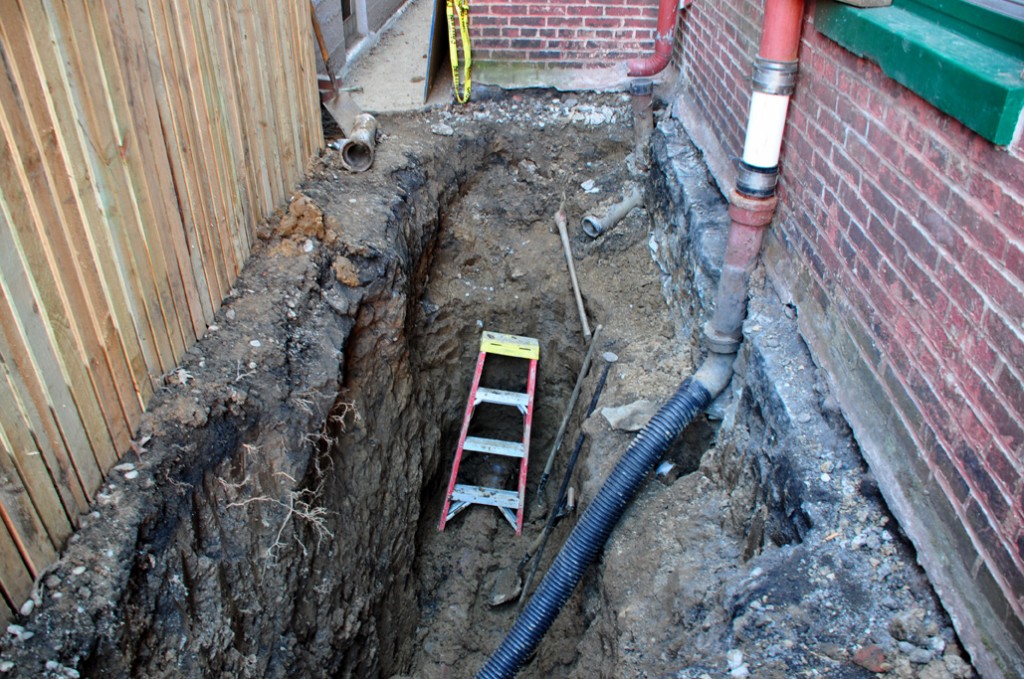
 Had to have the sewer pipes dug up, because water from the shower was finding its way into the basement.
Had to have the sewer pipes dug up, because water from the shower was finding its way into the basement.
The image, right to left – the green kitchen window sill, the outside kitchen wall, the outside-stack that drains the toilet, bathtub and sink, the downspout, the alley and the fence. (Click the small thumbnail to see the large image.) The break that brought water into the basement was at the base of the outside-stack. (Very lucky to have the break this close to the surface.) The reason we were only seeing water is that the break was a crack in the terra-cotta pipe and as such didn’t let waste products through. The water created a sink-hole that brought the water down, and through the basement walls. The sink-hole is where the stack is connected to the blue plastic pipe.
The job is to reconnect the downspouts to the storm-drains and the stack to the sewer line; then fill the hole back up and wait for it to settle before cementing the area.
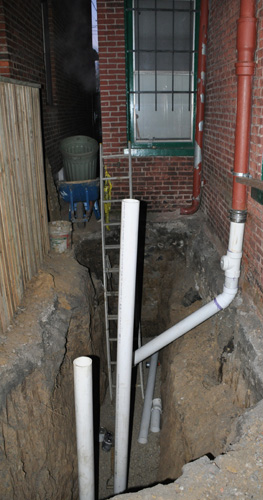
 Today, even though it was miserably cold – a wind chill factor dropping temperatures below zero – the plumbers did all the pipe replacement. The inspector even came by.
Today, even though it was miserably cold – a wind chill factor dropping temperatures below zero – the plumbers did all the pipe replacement. The inspector even came by.
The dig represents an even bigger hole than the one shown in the last post. On Saturday, we made a decision to dig to the basement-wall and replace all the terra-cotta coming from the basement to the end of the dig. The new hole is easily 12 feet long and 10 feet deep.
New PVC was also inserted into the 6 inch terra-cotta still in the ground and going to the sewer. Fifteen feet of new PVC went into the old terra-cotta.
The last work is to put back all the dirt. (Yes, the PVC has to be trimmed, but that will take little time.)
Home repairs are a quagmire. I got three bids for this job. The first one came in at $26,000 with the plumber claiming to bring in a conveyor belt that would move the earth to a dump-drunk in the alley. And he would line the terra-cotta with a resin. (Lining the terra-cotta with a resin sheath is for environments with large trees. The sheath prevents the roots from breaking and clogging the sewer pipe. There are few trees in my neighborhood and tree-roots invading sewer pipes is not an issue in this part of town. Also the resin sheath is very expensive.) I did not go with this bid.
The next bid was for $20,000. The contractor told me that this was not the kind of work he did, but given that no plumber was giving me a workable bid, he would dig and subcontract the plumbing. He was clear about over-estimating the bid, because he didn’t know what was involved and he wanted to make sure all OSHA guidelines were followed. I did not take this bid.
The third bid was from a Calabrese plumber that I had used before and who had done good work. I had contacted him about the job back in October, but he was busy and didn’t get back to me until Christmas Eve. We were able to negotiate a decent time-and-materials contract and he got the job.
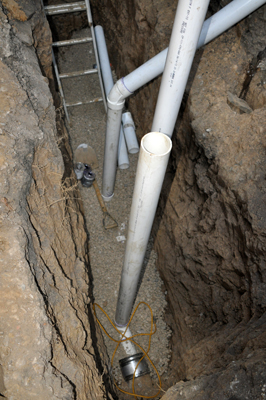
 Day seven has been an inside-work day. The temperatures stayed below zero. The only bright spot was the lack of howling wind to dip them even lower. And the plumbers went to another job site that had them working indoors. I’m hoping that by the end of the week, they will have all the PVC connected, the hole filled, and the debris hauled.
Day seven has been an inside-work day. The temperatures stayed below zero. The only bright spot was the lack of howling wind to dip them even lower. And the plumbers went to another job site that had them working indoors. I’m hoping that by the end of the week, they will have all the PVC connected, the hole filled, and the debris hauled.
The image shows the hole with the three pipes. The pipe with the elbow is the connector from the outside-stack and into the sewer. (The black lines, on the top right and below this pipe are frozen water. This is the sink-hole that the leak had created. And the sink-hole was steering the water from the bathtub and sink into the basement.) One of the vertical pipes is a vent and the other is the connector for the downspout carrying the rain water. (The PVC lying on the ground will be used to connect the downspout to the system.)
In the bottom of the image is the connector-ring into the existing terra-cotta sewer line. (They used the yellow extension cord to hook up a heater. I don’t how they worked yesterday in the bitter, bitter cold.)
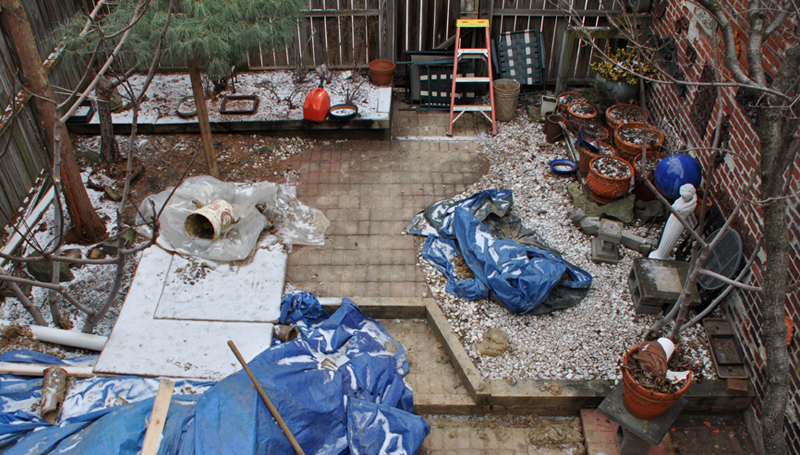
I’ll have to revisit these big-dig posts and rename them. (However, I do like the alliteration and the fact that the ultimate Big Dig was in Boston.)
The weather has messed up the schedule wildly. Something that should have taken a week has gone on for three, because the ground is frozen and the outside temps are super freezing.
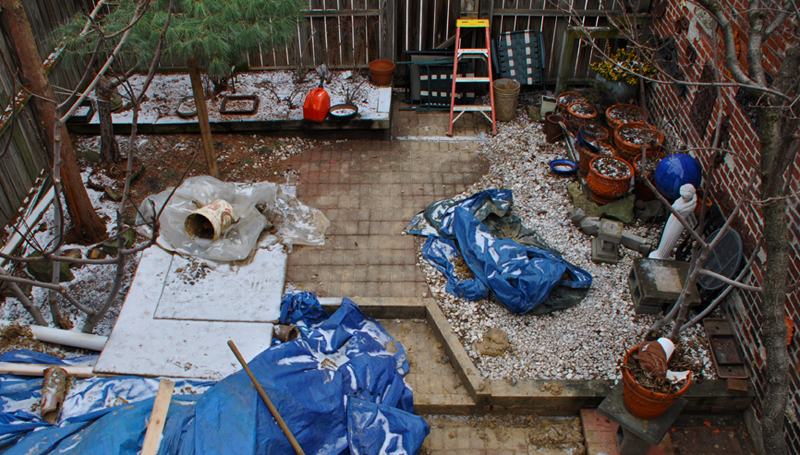 Now the question is, will my back-yard be cleaned up for spring? I keep telling myself, that come spring, there will be no evidence of the digging and mess that is the back-yard now. That has become my mantra each time I look out back. The only convenience of the freeze and snow is that the mud covering everything is frozen (The brown swirls on the bricks is, in warmer weather, mud.) and I can let the dogs out into the back-yard. For three days this week, when the temps were in the 60’s, the dogs had to go for walks. Hate that routine.
Now the question is, will my back-yard be cleaned up for spring? I keep telling myself, that come spring, there will be no evidence of the digging and mess that is the back-yard now. That has become my mantra each time I look out back. The only convenience of the freeze and snow is that the mud covering everything is frozen (The brown swirls on the bricks is, in warmer weather, mud.) and I can let the dogs out into the back-yard. For three days this week, when the temps were in the 60’s, the dogs had to go for walks. Hate that routine.
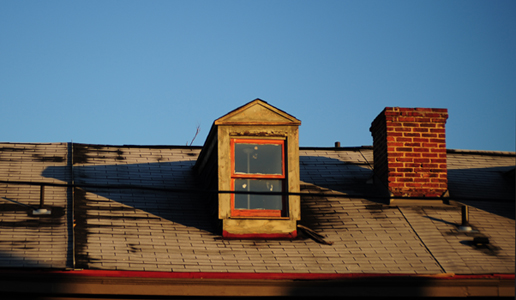
Last weekend the groundhog saw his shadow and this weekend is supposed to end winter’s grip on the land.
The last time winter ruled with an iron grip was four years ago, and I’ve forgotten how tight and chocking that strangle-hold can be. Well the winter of 2013 is reminding me. But that reminder acts like a tease swinging between extremes – one weekend it’s severely cold, the following weekend is spring-like. One week I’m wearing three layers, a scarf wound tight around my neck, a tuque fulled down to cover all my head. The next week, I’m wearing a sweat shirt.
The week of January 22, the temperatures were below zero. This past weekend, everyone was out in shorts. It’s the wild swings I don’t remember. (In my memory winter was a long, slow march with hope and light coming late in February.) And of course the pundits tell us there is no change in our weather patterns and those of us who think there is must be left-wing liberals.
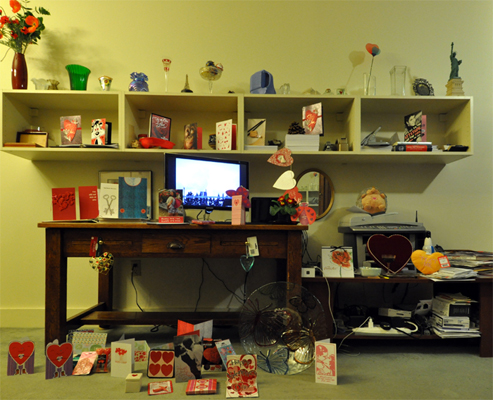
 The cards and gifts of Valentine’s Day.
The cards and gifts of Valentine’s Day.
You’re looking at my desk, shelving, printer table and floor overwhelmed with stuff.
The highlights:
– over 50 cards
– a candy-box in velvet
– a Text-me pillow
– a hedgehog teddy-bear
– a white ceramic box
– heart decorated coasters
– heart bubble wands
– paper-airplane kits
– heart streamers
– heart-shaped ornaments
– three candy dishes
– huge butterfly glass dish
– a primrose plant and
– a Justin Bieber card – It’s all in the attitude. And the eyes. Definetely the eyes.
St. Valentine was martyred north of Rome on the Via Flaminia. In our time, on a daily basis, we drive the SP3 following Gaius Flaminius’ ancient route through Le Marche.
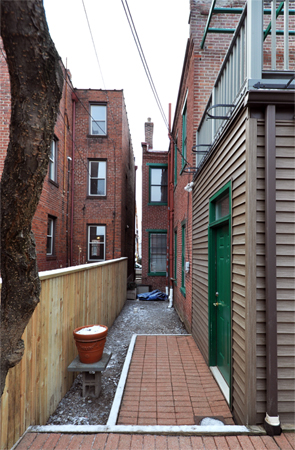
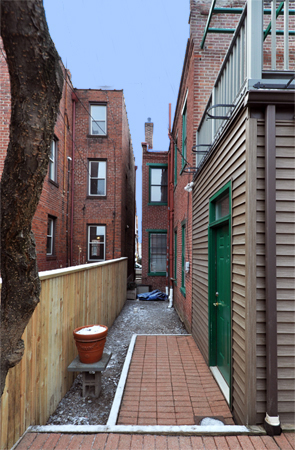 The warm weather this week allowed the plumbers to finish the stack-and-sewer work, fill in the hole with gravel, remove all the muck and clay they had dug up and wash everything down. The back-yard and the side-yard look great. (Mr. Merante came today to trim and cap all the above-ground pipes. Yesterday there was still this tall, white plastic pipe in the middle of the grey gravel.)It’s hard to believe that last week there was still a 12-by-15 feet hole on the side of my house. A hole that went easily 10 feet down to the sewer pipes.
The warm weather this week allowed the plumbers to finish the stack-and-sewer work, fill in the hole with gravel, remove all the muck and clay they had dug up and wash everything down. The back-yard and the side-yard look great. (Mr. Merante came today to trim and cap all the above-ground pipes. Yesterday there was still this tall, white plastic pipe in the middle of the grey gravel.)It’s hard to believe that last week there was still a 12-by-15 feet hole on the side of my house. A hole that went easily 10 feet down to the sewer pipes.
The next project will come in the spring when the contractor can cover the gravel with cement. In the meantime, he will expand the landing, outside the door, over to the new fence. BTW, the flower pot is a place-holder, breaking up the monotony that is the grey gravel. (The narrow area beside the landing was not dug up, so there is no need to wait and see how it will settle. I am curious to see the settlement on the newly filled hole. )
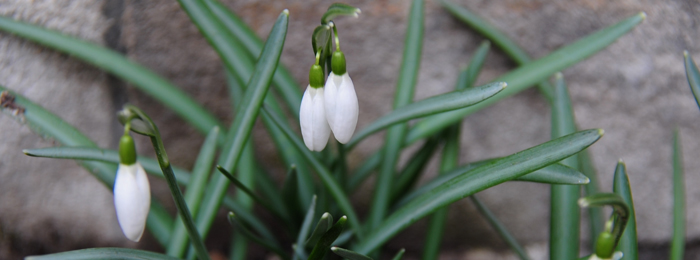
It took me going to Cambridge, Mass. to realize that in the big dig, I had lost the snowdrops; to realize that I used these early harbingers, questi bucaneve, to remind me that winter was waning and the spring sun was coming back.

Saturday morning, coming out of the Guesthouse, I saw these things pushing out from the wet, black earth at the bottom of the steps. Didn’t pay any more notice. Later in the day, the Brother talked about making connections and later still, while writing in the journal, it hit me that the things pushing out were snowdrops. And that in Pittsburgh, on the North Side, in the War Streets, I had lost the galanthus that for years had filled the flower-beds in mid-February.
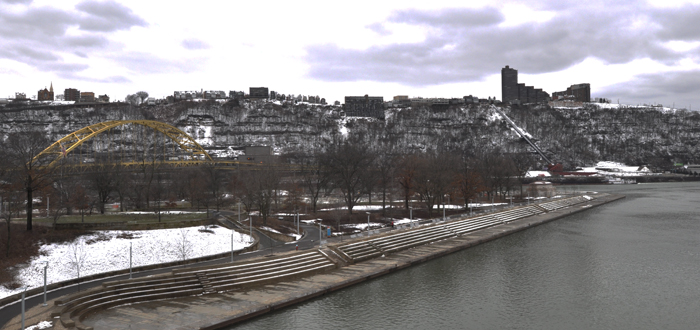
In Northern Ontario, in high school, during a mad March snowstorm we would rummage through the ski gear for the LF10/Yellow hoping for one last run. March snows are wet, heavy and short-lived. But with enough Yellow wax we could pretend to glide the tracks like we did in January. It never worked. One kilometer into the run and we were hitting roots; two kilometers in and our feet were soaked. Winter was done; the skis needed to be put away.
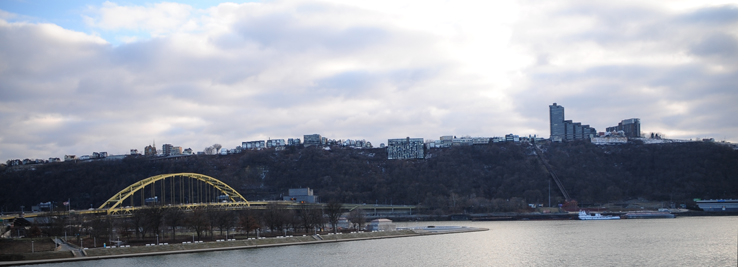
Today madness came to Pittsburgh and schools were closed, but by one o’clock the ground was snow free.
The image is of the Allegheny River, Point State Park, Fort Pitt Bridge and Mount Washington taken from the Fort Duquesne Bridge.

March has to be one of the most contrarian months of the year with hope and dread vying for attention. (Even the soothsayer gave warning.) Half-way through and we’ve had 600 and 200 weather all in the span of a week. During the 600 lull, and before the warning, I walked downtown and stopped at PNC Park and shot the 1949 brick-marker.

The marker is personal after all I was born at the beginning of that year. And, I’ve want to do a journal entry around it. So, I decided to do a critical events list of 1949 with the day-of-the-week as the lead. Now to find the contradictions…
Saturday, January 1 (new year’s day); Saturday, July 2 (film – fountainhead – released); Sunday, December 25 (christmas); Monday, January 3 (mario born); Monday, March 28 (ciccio’s b-day); Monday, April 4 (NATO treaty signed); Tuesday, March 15 (beware the ides of march); Wednesday, March 2 (mafalda’s b-day); Wednesday, June 8 (orwell’s 1984 published); Thursday, October 27 (francesco’s b-day);
Friday, January 21 (rainer’s b-day); Friday, July 1 (membership in a communist party meant excommunication).

My sister Jo’ was born on Tuesday, March 19, 1963. She died Saturday, June 30, 2001 at 9:30 am. Were she still alive, she would be celebrating her 50th birthday today. Happy birthday kid.

(So what image do I use for this posting? There are many pictures from back in the Sixties when we were all kids in Sault Ste Marie, to images taken three and four months before she died. As you can see, I went with her wedding picture from 1989; the picture with the big hair; the picture with her big eyes.)
On Friday June 29, I drove up for the weekend and got to the house on Arkendo around five. My parents and aunt were also visiting. It had been three weeks since my last trip and what I saw scared me. The cancer had eaten her body. She was skeletal; her big eyes were sunken, clouded; her skin pallid; her speech slurred. She couldn’t feed herself. I sat with her and helped her with the broth. After the simple meal, she tired quickly and Dave and I carefully got her to bed. (We had moved her bed to the first floor, to the dining room.)
I spent the rest of the evening on the couch with the kids – three lost souls wrapped around each other.
Next morning Dave, Ciccio and I were in the front-yard planting a peony. Dave went in to help Jo’ with breakfast. Shortly after, my aunt came down opened the door and told us that Jo’ had died. My dad and I went into the silent house and up to the dining room. I walked to the bed, gently closed her eyes and kissed her.
Last night, we had had one last visit. She had waited for me. I miss her.

 silver white winters
silver white wintersI woke to a winter wonderland, to a silver-white morning. The streets were lost under shimmering blankets; the trees were full of new snow; and a sweet breeze ran through the branches flicking wet-snow on my nose and eyelashes. Walking through this white, camera in hand, was surreal. Warm woolen mittens covered my cold fingers between shots. Hadn’t the Druids danced at Stonehenge on Wednesday? Why is winter lingering? Who is giving it license?
The image is taken in Point State Park looking south to Mount Washington. The red parallel lines are the tracks of the Duquesne Incline.
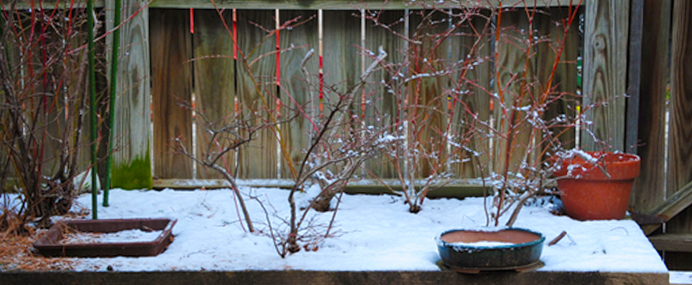
I know the giddiness of the first snows of winter; when big, soft flakes land on your tongue and stir the tastes of Christmas. And I know the relief when the last snow falls; when a winter-weary soul leans into the whirls of spring.

Today, Jadis-of-Narnia looked out her bedroom window and spied the orange branches of the blueberry bushes.
She cried her reign. April is coming and her winter-white is lost to memories of sleigh-bells and Turkish Delight.
april come she will, when streams are ripe and swelled with rain; may she will stay, resting in my arms again.
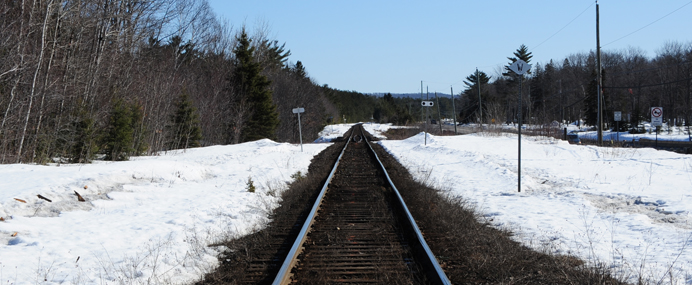
I was in Sault Ste Marie the last week-end of March and went driving down old Highway 17. There is now a by-pass north of Garden River and Echo Bay and the old highway had become the local road through the small hamlets and reservations along the St. Mary’s River. I always drive the old highway, because it’s the road I remember from when I lived there. It’s also the road with the declaration – THIS IS INDIAN LAND – scrawled on the rusting train trestle over the Garden River.
Parallel to the old highway are the CPR train tracks and for the first time, I realized that those were the tracks we rode on the last leg of the journey that brought us from Aprigliano to Sault Ste Marie.

We had begun the journey in Aprigliano. As my childhood friend said, the walk from our home to the town square where we got into a friend’s car was like a death march. He and I held hands as we walked in silence. Two little boys not knowing what the future would bring.
We got onto a train in Cosenza and the next stop was Naples where we boarded the boat that brought us to Halifax. And from there we were put onto trains to make our way to Northern Ontario and my grandparents’ house.
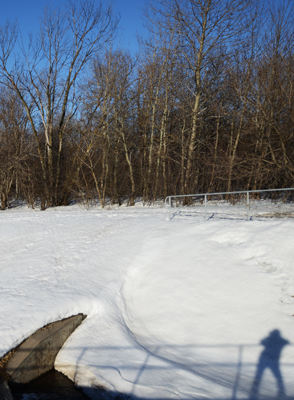

April is the cruelest month, breeding
lilacs out of the dead land, mixing
memory and desire, stirring
dull roots with spring rain.
Eliot’s quote has me thinking of last year and the early spring that banished winter in February; of forsythia, wild almonds, snowdrops and crocus coloring a March landscape. But this year, my wishing for spring started months ago in the middle of a miserable winter full of arctic air, frigid rains and sunless skies.
Bur as the equinox approached and I began to believe winter was leaving, I headed north where snow-banks still towered over my head, sidewalks still hid under soot covered snow, rooftops creaked under the spring melt, and the old still believed spring would stir their dull roots.
The image on the left is the creek bank and the trees above it. These bare branches make up the bush of memory, the shortcut that Frank and I would walk to get to school when we had lollygadded our lunch time away. (I’m standing on the wall that lines the culvert that steers the creek as it goes under Douglas Street.)

 kaua’i – 2013 1st entry – kaua’i 2013
kaua’i – 2013 1st entry – kaua’i 2013To read this series in chronological order,
click on the category title – kaua’i – 13.
This is a preliminary entry to get the formatting set up and tested for this new category.
The image is of my cousin Rose’s hand holding a plumeria flower which we found on the ground as we walked the suburb south of the Princeville condo compound. I like the 4 pieces that make up this image. (left-to-right – the black, the fingers, the white and yellow blossom, the second black bracketing the flower, and finally the blur of white and skin-color.)
I head out Friday, April 12, leaving Pittsburgh at the crack-of-dawn and getting into Lihue 13 hours later. (The good part of this long, outbound trip is that I get to Kaua’i at 2:00 in the afternoon – traveling with the sun and getting added time whoa!)

 farmers’ market – kilauea 2nd entry – kaua’i 2013
farmers’ market – kilauea 2nd entry – kaua’i 2013To read this series in chronological order, click on the category title – kaua’i – 13.
The flights to Kaua’i were all on-time as a matter of fact got into Phoenix half-hour early, but then had to wait for a gate assignment. (Sky Harbor is fast becoming the Kennedy Airport of the west.)
Coming west is always great, you gain time. I got here at 2:00 in the afternoon and had the rest of the day. (I was done by 7:30 and just went to bed and slept the next 10 hours.)
This morning we hit the farmers’ market in Kilauea. It has grown from last year – many more vendors. Naturally we walked out with so many fruits and vegetables that a woman from California who saw us carrying our stash to the condo, stopped us to take a pic. (The above pic is of our purchases – beets, limes, green-onions, papaya, eggfruit, carrots, kale and avocado.)
Been wanting to taste coconut-water for a while and this morning I went and bought a fresh coconut. It’s a relatively bland drink, but supposedly full of nutrients. (After you drink the water, you bring it back to the stall and the farmers splits and scoops out the coconut pulp. The white pulp was too soft for my taste.) Our discovery this year was eggfruit a fruit that reminds me most of persimmon, but a hard-boiled egg consistency.

 beets and rainbows 3rd entry – kaua’i 2013
beets and rainbows 3rd entry – kaua’i 2013To read this series in chronological order, click on the category title – kaua’i – 13.
Let me begin with the beets. At the farmers’ market, Rose and Derrick bought a bunch of beets. Surprising, but I chalked it up to over-enthusiasm. When we got to making supper, Rose put the beets to boil, but had the green tops in a colander ready to fry. What, I had never heard of eating fried beet greens. They were delicious, as good as rapini. (I eat beets with Sarah and Welch, never knew Derrick grew up eating beets.)
It’s Sunday morning and it looks like the rain is on hiatus. Sitting around having coffee and up in the mountains I saw the left arc of a rainbow. Shot some pics, but not the best. (Am working on using Manual with the D700 and Aperture priority with the D800e. Am not always getting the exposure I want, but I’ll never figure it out if I don’t keep at it. So far my most difficult step is relying on the bar-graph that lets me know if I’m over-exposing or under-exposing. I need to learn how to associate the numbers with these rather than the bar-graph.)
The above image is from the lanai looking north. It’s the clouds above the 13th hole.

 i saw the danger 4th entry – kaua’i 2013
i saw the danger 4th entry – kaua’i 2013and yet I passed along the enchanted way . . .
First, the image – it’s the seabirds at the wildlife refuge at the Kilauea Lighthouse Photoshopped into green hues.
Second, the fantasy – the enchanted way. (The title and first line are from Patrick Kavanagh’s poem On Raglan Road.) The island is surreal. One side is wild and inaccessible and the other side is Disneyland houses and gated communities. This morning we walked the Prince Golf Course and it was littered with young men playing in the fields of the One-Percent. The cart-paths were a magic carpet. And walking these undulating landscape you can pretend a new reality – everyone is young, everyone is rich, everyone is white and everyone is straight. The old ghosts have been banished, but the new gods have clay feet. Fuck!

 the true gods of sound and stone and word and tint 5th entry – kaua’i 2013
the true gods of sound and stone and word and tint 5th entry – kaua’i 2013I’m continuing to use pieces of Patrick Kavanagh’s poem On Raglan Road. The title is a line from the third verse.
This was our first day on the beach and in the sun.
The North Shore has been overcast and rainy the last three days so we headed south. (The northern part is one of the wettest areas on the island.) Forecasters promise a cloud free end-of-the-week. But the stone and rain gods that live in the mountains behind us may not agree. (The cloud cover is absent in the morning and at sunset. The image is from the lanai that wraps the condo and provides an outdoor space where we sit, eat breakfast, dinner and hope for blue skies. I took it early in the morning and it’s been tinted and pushed into purple)
The beach at Maha’ulepu is the southern most accessible point. (Last year this was where we saw the kite-surfers.) The road is red clay and full of holes and requires a slow, slow drive. But once there, you are free of the One-Percenters who have turned off their brains and turned on their appetites.
I use this trip to figure out what cameras and lenses to bring to Italy. So, I brought the D700 and D800e. I am enjoying the 38.3 megapixel images, but these two high-end cameras are better in slow and controlled environments. In Le Marche there will be enough situations – churches, museums, mirrors – where I’ll need the auto functions of the D90.

 distesi al sole 6th entry – kaua’i 2013
distesi al sole 6th entry – kaua’i 2013The North Shore was ablaze today. (The image, shot from the lanai at the condo, is the sunset over Hanalei Bay.)
I spent the morning at the Princeville Botanical Gardens shooting the amazing flowers and native plants. I have all these images for a new gallery. It will be my first flowers gallery in several years. It was a great tour with information on local flora and fauna and a chocolate tasting lesson. The family that owns the land is beginning to grow cocoa and making their own chocolate. The lesson had us tasting various chocolates and trying to identify the surrounding plants, because they gave the cocoa bean an added flavor marker. My favorite was dark chocolate from E. Guittard a San Francisco based chocolatier.
In the afternoon, I joined the One-percenters at the pool – distesi al sole.

 the queen’s bath 7th entry – kaua’i 2013
the queen’s bath 7th entry – kaua’i 2013The trek down to The Queen’s Bath is difficult, but the views from the lava-rock cliffs are amazing. The trail-head is in one of the priciest sub-division on the island. Senator Barbara Boxer has a condo in the complex. The trail is steep but scenic following a stream that trips into a waterfall and then spills dramatically into one of the ocean lagoons. (Two years ago a local was showering under this waterfall. All I could think of was – left-over hippie.)
At the bottom, there are signs everywhere cautioning visitors that this is one of the most dangerous spots on the island and yet people still dive from the cliffs into the small lagoons-pools or dangle over the lava-shelves to better see the giant sea-turtles. What’s misleading is that the cliffs are relatively low giving a false sense of safety. Nowhere else on the island are the cliff-faces low or accessible.
The image is of a hollow crab-casing that some industrious sea-bird left behind after it feasted on the sweet white meat.
I’m using this trip to step away from the auto settings of the D90 and into the more controlled setting of aperture-priority. This has always been my default mode, but I want to become knowledgeable enough with it to anticipate what the image will look like.

 painted wings and giant rings 8th entry – kaua’i 2013
painted wings and giant rings 8th entry – kaua’i 2013make way for other toys. One grey night it happened . . .
We were determined to shoot the sunset and this morning on our way down to the Queen’s Bath we saw the perfect spot for our night shoot. All evening we kept vigil and at 6:30 we took off, (It was a two camera shoot.) and drove down to the fancy suburb. The first empty lot did not have a path to the golf course, to the cliff. We tried the next empty lot and there on the left was a path. As we walked down a woman with a glass of white wine looked down from her cantilevered deck and reminded us that we were on her property. She didn’t get cranky, she actually said it was OK for us to walk through. (Did I look upscale, part of the 1%, with my two fancy cameras slung over my shoulders?)
The shot is taken form the 7th Tee. That is what you see at the bottom of the image. Below us is Hanalei Bay and the sleeping dragon.

 far away places with strange sounding names last entry – kaua’i 2013
far away places with strange sounding names last entry – kaua’i 2013far away over the sea are calling, calling . . .
The shot is from the ridge of Waimea Canyon. We went hiking and when the mists moved through the valley there was the Pacific and there was the sailboat. The entire hike was a hide-and-seek experience, one minute you saw nothing, at the next outlook the mist had moved enough to see the ocean. The trail straddled two canyons – on the left the drop led to blue water, on the right to lush green inland. This morning the mist played on the ocean side.
The south western part of the island – Waimea Town area – is large scale farming. You don’t see the black lava-rocks of the north or the hard red clay soil of the East Side. Instead the ground is covered by rich soft earth, buganvilla is everywhere and below the canyon mountains the plain runs flat to the sea. This haven is not a large area and a short drive north leads into desert.

 fair is the lily-of-the-valley
fair is the lily-of-the-valleyComing back East and finding blue skies and cool temperatures was a welcome. The seasonal boundaries are markers just as are the snowdrops and lilies-of-the-valley. They are markers I understand and know how to calculate from. (Once the snowdrops appear then winter is on its way out; once the lilies-of-the-valley sprout then sharp fragrances, green leaves and May flowers will fill the void.)
In my family there’s an expression – cal’a pasta, literally drop the pasta in the boiling water. (The old Calabrese is so much more elegant with its internal rhyme and brevity than the translation.) It let us know that the guests had arrived and that supper was imminent. The snowdrops and the lilies-of-the-valley let me track time; they let me know how to think about March and April, about winter ending and spring beginning. This method of tracking is old. It’s from a time of church-bells announcing the Angelus at noon, of fave announcing spring, of hill-top towns using sun-dials. It’s a medieval system that lingered in post-war Calabria. It’s my circadian rhythm in a digital time.

 the mists of avalon
the mists of avalonThis morning downtown Pittsburgh was shrouded in fog.
And the haze jarred a memory from when I was a child in Aprigliano. It’s late October, and I am walking/hiding in the morning fog, lingering in the heaviest banks, while making my way to Za Rachela’s. I’m late, so I run down the alleys, weaving through the mists, shrugging off my long red coat and wearing only the hood I flap it like a cape, creating swirls around me. I make Merlin magic.
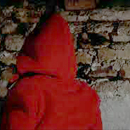 The memory always reminds me of the 1973 Julie Christie, Donald Sutherland film Don’t Look Now with its impressionistic imagery, often presaging events with familiar objects, patterns and colors. (The thumbnail is from the film.)
The memory always reminds me of the 1973 Julie Christie, Donald Sutherland film Don’t Look Now with its impressionistic imagery, often presaging events with familiar objects, patterns and colors. (The thumbnail is from the film.)
The city doesn’t have the canals or claustrophobia that gird Venice, but this morning the cold waters of the Allegheny are flat and they feed the mists that I walk through in hidden delight. They lift slowly revealing a spring landscape of blue water and green hillsides, a tugboat pushing loaded coal-barges and a golden bowstring bridge spanning the horizon. The red coat has been replaced by an 800 and the magic is now digital.
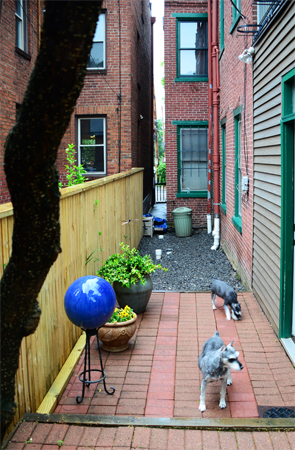
 We are finally done with winter, the digging, the dirt-mound, the mud and the wet basement. It’s even been long enough for the fill to settle and the nest step is to cement the area with the dark-gray slag.
We are finally done with winter, the digging, the dirt-mound, the mud and the wet basement. It’s even been long enough for the fill to settle and the nest step is to cement the area with the dark-gray slag.
The first step in getting the side-yard renovated was to widen the platform in front of the back-door. (In the post – the big dig5 – the trough, that had been the far-end of the flower bed, was still there.) The new platform goes all the way to the new fence. The bricks now have a subtle pattern, the big-blue marble and the two flower pots decorate the pad. And two severely shaved dogs, that as recently as last week looked like matted sheep-dogs, round out the image of the next phase in the renovation. (Bilby is in the foreground, Gurl is in the back.)
Once the cement is poured, I will put four large pots with shade-loving plants on the new surface. (I’ve decided to go with the composite pots rather than the Italian terracotta, because I intent to leave them outside all year. The terracotta pots deteriorate when left out all winter.) I’m going to fill one pot with flag – iris. (There are huge cement pots in front of the boiler plant on Federal Street filled with flags and the iris seem to do well. So, I’m going to try the same thing in the side-yard.)

 requiem aeternam
requiem aeternamAlarm-bells were ringing
To hold back the swelling tide
Friends and lovers clinging
To each other side by side
In the dark illumination
He remembered bygone years
He read the Book of Revelation
And he filled his cup with tears
When the Reaper’s task had ended
Sixteen hundred had gone to rest
The good, the bad, the rich, the poor
The loveliest and the best
Tempest – Bob Dylan

 mourning doves are back
mourning doves are backAfter almost three years, the doves have again built a nest in the Japanese lilac. (Wonder if it’s the same mating pair?) The hiatus was caused by an ambitious raccoon that had traveled up from the park, crawled up the tree, discovered the nest and ate the eggs. But the murderer has been absent these last years and his crime forgotten by the cooing pair.
I can’t tell if there are any eggs or squabs in the mess that is the nest. Doves are terrible nest-builders. It’s more a bunch of twigs and sticks at the fork of trunk and branch. It’s such a haphazard collection, with no mud and in constant need of new twigs and sticks. (The bricks under the tree are littered with sticks and grasses that have fallen from the badly built nest.) Over the weekend, when no bird is roosting, I’ll check for eggs or squabs. (One squab has already fallen out and Gurl almost made a meal of the dead baby.)

 through a glass, darkly emery house – spring, 2013
through a glass, darkly emery house – spring, 2013The image is through the glass at the back of the Chapel of the Transfiguration at Emery House. (I’m outside, shooting into the chapel.) So, what can you see – my head, red azaleas, outside steps, green hillside. Inside, on the left is a schefflera, (The superimposed ferns are outside, behind me and reflected in the glass.) then the altar with candles, a wooden statue of Francis of Assisi, mother-in-law’s tongues, chapel chairs, philodendron leaves. The layers in this image are what I like best especially the steps that cascade through the middle.
The post-title is from the 1961 Ingmar Bergman film of the same title. And he took it from 1 Corinthians 13, verse 12. Through a Glass Darkly is the first film in his Silence of God trilogy. I don’t like Paul’s New Testament diatribes, but I like Bergman’s films. The old construct is from the King James. The modern translation – Now we see things imperfectly as in a cloudy mirror – turn this prepositional diamond into dollar-store bling.

 it’s for them i’m really yearning emery house – spring, 2013
it’s for them i’m really yearning emery house – spring, 2013The seasons in Newburyport, Massachusetts are about two weeks behind Western PA.
I’m walking the trails on the Emery House property through meadows full of yellow dandelion and dandelion seed-heads. And low to the ground another genus sprouts among the tall green grasses. The white petals are wet with dew, they twinkle in the morning light. (I had thought of bringing my iPod, but once I was out in the sunlight, hearing the birds, the iPod would have been the antithesis to the naturalness around me.)

 now in the fading light of day emery house – spring, 2013
now in the fading light of day emery house – spring, 2013The western sky glowed with the setting sun. We had just sung Compline and I was walking the road back to the cottages and decided that I needed to shoot the evening clouds. Clouds laced with the fading light of day.
After Compline, The Great Silence begins. There’s a map in the office of Emery House designating the area where The Great Silence is to be observed. (Did the monks in medieval Europe have a map delineating where one could talk?) It’s amazing to me that I am on a 150 acre farm north of Boston, in Yankee, Protestant New England following Catholic monastic rhythms.
maker of all to you we pray. that with your ever watchful love, you guard and keep us from above.
help and defend us through the night, danger and terror put to flight. never let evil have its way, preserve us for another day.

 road not takenemery house – spring, 2013
road not takenemery house – spring, 2013Nel mezzo del cammin di nostra vita
mi ritrovai per una selva oscura,
ché la diritta via era smarrita.
in the middle of my late years, i find myself in a dark wood
Title – The Road Not Taken, Robert Frost
Quote – La Divina Comedia, Canto Primo dell’Inferno, Dante Alighieri
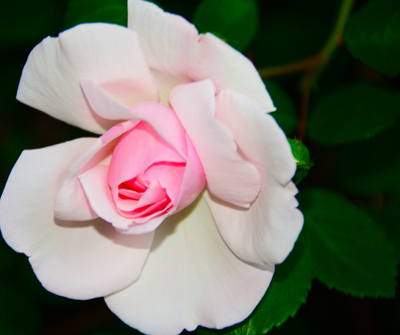
 With the erratic weather systems controlling all our lives, the spring flowering cycle is totally off-kilter. And roses that should have been the harbingers of summer are now blooming in mid-May. Their role as precursors has been usurped. The only good part is that there are roses everywhere. Bushes that lay dormant for seasons are now full of flowers. The ever-blooming hybrids are heavy with buds; the heirloom stalks are dripping with petals; and the climbers have invaded the fences.
With the erratic weather systems controlling all our lives, the spring flowering cycle is totally off-kilter. And roses that should have been the harbingers of summer are now blooming in mid-May. Their role as precursors has been usurped. The only good part is that there are roses everywhere. Bushes that lay dormant for seasons are now full of flowers. The ever-blooming hybrids are heavy with buds; the heirloom stalks are dripping with petals; and the climbers have invaded the fences.
It’s been a while since I’ve had the time to shoot flowers. The micro lens is in its cloth bag and the tripods are collecting dust in the corner. But the 800e compensates, collecting 36.3 mp of data. I’m learning to shoot with the 800e, experimenting, getting comfortable with aperture priority. (I’ve even ventured into using the flash for effect rather than for need. It’s how I got the black background on the pic.) The image on the left was a surprise, but I still manipulated it. The pink middle was exaggerated with Photoshop, and the contrasting black and green were the results of the flash.

 My neighbors – Joe and Rose – used to have peonies, iris and bleeding hearts, but a new fence hides the old flowers. As a tribute to these two gentle people, (They have moved to an assisted living complex.) I’ve planted many of the old flowers on my side of the fence. I put the iris in a huge plastic pot and am hoping they will fill it with their creeping rhizomes. My flower-bed that shared the wrought iron fence with the neighbor’s, was removed in the big dig. (I lost the snow-drops in the removal and didn’t realize it until I was in Cambridge at the monastery and spied a cluster jutting from the frozen earth. In the seeing, I realized the loss.) The new side-yard design eliminated the flower-bed and I’m using large pots, on the cement ground, to bring greens and yellows into this sterile surface. The iris on the left is from one of these large, plastic pots. There were buds on the plants that I selected at the nursery, hence instant flag. (It’s only in Pittsburgh that I’ve ever heard people call iris flags. Yahoo! Answers says that the German Iris are often referred to as flags. Well, western Pennsylvania is full of families from old Germany.) I don’t if the rhizomes will bloom next year, but if they don’t I’ll still have the rigid green leaves. In the image, the blurred background, at the top, is the new wooden fence.
My neighbors – Joe and Rose – used to have peonies, iris and bleeding hearts, but a new fence hides the old flowers. As a tribute to these two gentle people, (They have moved to an assisted living complex.) I’ve planted many of the old flowers on my side of the fence. I put the iris in a huge plastic pot and am hoping they will fill it with their creeping rhizomes. My flower-bed that shared the wrought iron fence with the neighbor’s, was removed in the big dig. (I lost the snow-drops in the removal and didn’t realize it until I was in Cambridge at the monastery and spied a cluster jutting from the frozen earth. In the seeing, I realized the loss.) The new side-yard design eliminated the flower-bed and I’m using large pots, on the cement ground, to bring greens and yellows into this sterile surface. The iris on the left is from one of these large, plastic pots. There were buds on the plants that I selected at the nursery, hence instant flag. (It’s only in Pittsburgh that I’ve ever heard people call iris flags. Yahoo! Answers says that the German Iris are often referred to as flags. Well, western Pennsylvania is full of families from old Germany.) I don’t if the rhizomes will bloom next year, but if they don’t I’ll still have the rigid green leaves. In the image, the blurred background, at the top, is the new wooden fence.
I’m continuing to work with the 800e. For the image in this post, I shot with an 18-300 millimeter lens and used Photoshop to adjust for brightness and contrast – the yellow ruffles, the deep orange beard are beautiful.

 white and black figs – in pittsburgh
white and black figs – in pittsburghMy two, white-fig trees are full of fruit that should ripen by the end of the month. White-fig is a literal translation of the Calabrese name for the plant. On the outside the fruit gets yellow-green, on the inside when ripe it’s yellow-white. The trees are from cuttings from my cousin’s land in Aprigliano. Sam was the Johnny Appleseed of his generation. (My grandfather and Sam’s mother were brother and sister.) He supplied fig-tree cuttings to any and all family members who were willing to try to grow them. In Coraopolis, Bryan has a cutting rooting in an old dry-wall mud pot. In Wilkinsburg, the Wertheimers have a black-fig tree that came from Sam’s stock. They’ve become honorary family members.
Back in the 70’s, on one of his trips to Aprigliano, Sam decided to bring back to St. Catherines, cuttings from the fig-trees that littered the hill-sides of the family farm. He smuggled back two small cuttings – a white-fig and a black-fig. And from these two cuttings he grew a grove of fig-trees in his garden, in southern Ontario.
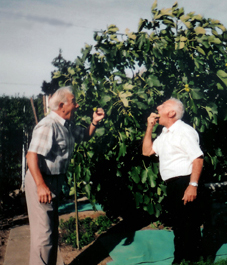 The white-figs with the yellow-white centers, ripen in early summer. The tree is not as bountiful as the black and therefore its green, round fruit is considered a delicacy, a rarity. The black-figs are really a maroon color with an elongated, oval shape. These trees produce ten times the number of figs and the dark brownish-red fruit ripens in early fall.
The white-figs with the yellow-white centers, ripen in early summer. The tree is not as bountiful as the black and therefore its green, round fruit is considered a delicacy, a rarity. The black-figs are really a maroon color with an elongated, oval shape. These trees produce ten times the number of figs and the dark brownish-red fruit ripens in early fall.
Every year in October, at Canadian Thanksgiving, we would all trek down from Toronto to St. Catherines to gorge on the transplants, the black beauties from Calabria. (The picture on the left is of Sam and my uncle Milio stuffing figs.) There were so many figs that we would eat and eat and eat and worry only about not eating enough.
These black beauties would be gone with the first frost and stories of Calabria and figs on the dinner table would be silent for another year. By Thanksgiving Monday, many of us would also be gone heading north, west and south into the pallid isolation of a coming winter.
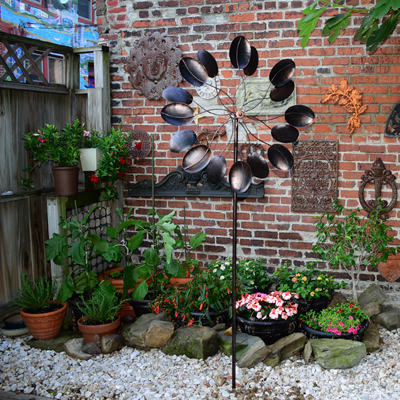
When I was up in Maine with Mac, we went into this art gallery in Kennebunkport. It had these great windmills and I really wanted one. But the cost was also great, so I had to be satisfied with window-shopping. Today, on my last trip to the greenhouse to finish off the backyard I saw someone looking at these double windmills. (The place was empty, so I got to see inventory that has been hidden behind the mobs buying plants for their summer beds.) I went over and saw that they were interesting and that the price was reasonable, I bought one.
 (Right now it’s in the middle of the backyard, but don’t know if this will be its final placement.) The entire back corner is new. (Originally the bonsai racks were here, but a couple of years ago I ripped out the racks and started putting pots on the ground.) I’ve had to replace most of the terra cotta pots, because they did not make it through the winter. And given that I was also redoing the side-yard, I decided to get new pots that I could leave out all year.
(Right now it’s in the middle of the backyard, but don’t know if this will be its final placement.) The entire back corner is new. (Originally the bonsai racks were here, but a couple of years ago I ripped out the racks and started putting pots on the ground.) I’ve had to replace most of the terra cotta pots, because they did not make it through the winter. And given that I was also redoing the side-yard, I decided to get new pots that I could leave out all year.
In the mix are two pots of Rosemary, four posts with eggplant and a ficus tree bonsai. The rest are all flowers. (I made the change the summer of 2011. I was in town for an extra week, because Paul had had surgery and while sitting out, I decided to rip out the bonsai racks and began to redesign the area.) Two years later, I’ve been able to create a setting that from year to year I can fill with my favorite annuals – Lantana, small Petunias, and Begonias. The perimeter rocks I pulled from under the Cypress and Pine where they had become lost under the ground-cover.
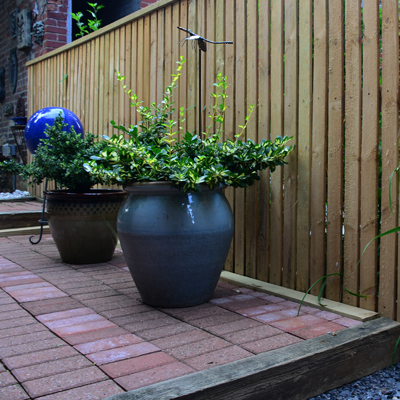
 For the rehabbed backyard, I bought two types of pots – plastic-composites and ceramics. The image on the left are the two glazed ceramics, both have ever-green shrubs in them. The thing sticking out of the ginger jar is a copper dragonfly on a long, thick wire.
For the rehabbed backyard, I bought two types of pots – plastic-composites and ceramics. The image on the left are the two glazed ceramics, both have ever-green shrubs in them. The thing sticking out of the ginger jar is a copper dragonfly on a long, thick wire.
The third item is a hollow, blue, ceramic sphere that I bought in Oakville, in 2001 after the funeral. I bought it in memory of Jo’ who had died the previous Saturday and was buried Tuesday, July 3. It’s my monument, my grave-marker for my baby sister.
The new side-yard looks nothing like the old. The flower-bed is gone and in its place is a new wooden fence, a new brick platform in front of the back-door and eventually new cement down the alley. The new plastic-composites replace the flower-bed. (I’ve decided to plant the replacement snowdrops in among the blueberry. They are the only things I miss from the old flower-bed.) The new is very formal, very linear and very minimal. Characteristics that I highly value. And except for the lost snowdrops, a welcome change.
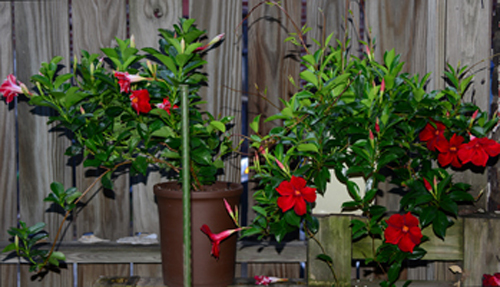
 Shooting with the 800e has been a very different experience. It has no Auto option, and so I’m working in a semi-manual format – aperture priority. And with each shoot I learn something. I’m doing a lot of experimenting, using the flash in daylight, closing the aperture to get a darker image, reading the RGB histograms to determine vibrancy. (I really like the results.) I have to get better at predicting what the various settings produce so that the knowledge is intuitive. Instead of muscle-memory, I need settings-memory. Now I just take multiple images deleting anything that doesn’t work. (I don’t know how people learned when film was the only option. I remember shooting, sending the film away and not seeing the pictures for a couple of weeks. No way could I remember how I shot an image.)
Shooting with the 800e has been a very different experience. It has no Auto option, and so I’m working in a semi-manual format – aperture priority. And with each shoot I learn something. I’m doing a lot of experimenting, using the flash in daylight, closing the aperture to get a darker image, reading the RGB histograms to determine vibrancy. (I really like the results.) I have to get better at predicting what the various settings produce so that the knowledge is intuitive. Instead of muscle-memory, I need settings-memory. Now I just take multiple images deleting anything that doesn’t work. (I don’t know how people learned when film was the only option. I remember shooting, sending the film away and not seeing the pictures for a couple of weeks. No way could I remember how I shot an image.)
In the above image, the Mandevilla Sanderi, commonly known as Red Riding Hood, sit in two old bonsai pots. (The green stake in front of the brown pot, is from the eggplant. For some reason, I can’t hammer it into the ground.) Looking over the various pots, one would think that I have a thing for the color red. Six of the ten flowering plants are red, two are yellow and two are mixed with some red in them.
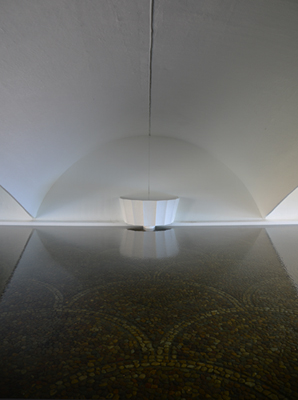
 Perpendicular to, and under the land-bridge that connects the Fort Pitt and Fort Duquesne is another bridge, over a reflecting pool, that leads into Point State Park. The pool floor is decorated with a rock mosaic and flooded with fluoridated water. The entrance tunnel is divided into three vaults, and each arc is lit from a base fixture. The image on the left – the Holy of Holies as a Euclidean dream – is the middle arc with its reflecting pool, lighting fixture, back-drop and the seam-line.
Perpendicular to, and under the land-bridge that connects the Fort Pitt and Fort Duquesne is another bridge, over a reflecting pool, that leads into Point State Park. The pool floor is decorated with a rock mosaic and flooded with fluoridated water. The entrance tunnel is divided into three vaults, and each arc is lit from a base fixture. The image on the left – the Holy of Holies as a Euclidean dream – is the middle arc with its reflecting pool, lighting fixture, back-drop and the seam-line.
Point State Park has undergone a huge renovation – the fountain at the confluence of the Allegheny and the Monongahela rivers was retrofitted, the grasslands in the park were re-sodded and the plantings were weeded and re-stocked all in time for the 2013 Three Rivers Art Festival. Also, the under the land-bridge entrance was rehabbed – plastered, painted and power-washed.
During the Art Festival this middle arc served as a niche for a giant transparent inflatable Buddha – Floating Echo. (The sculpture is the creation of Chang-Jin Lee a Korean-born visual artist who lives in New York City.) The Holy of Holies was desecrated. A rule-religion’s sacred site was violated by a nature-religion’s inflatable god. Floating Echo was worshiped, for 10 days, in this Euclidean sanctuary.
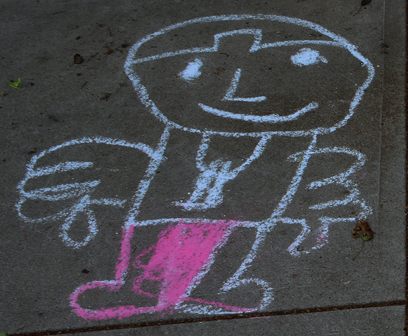
 Oh, make-believe town,
Oh, make-believe town,
Oh make-believe town is a mess.
It’s a mess because all the animals talk;
It’s a mess because they all draw with chalk;
It’s a mess because all the hunting hounds
go no more a-hunting, a-hunting, a-hunting.
The neighborhood children spent the hot humid hours, drawing on all the sidewalks on this side of the street. (The tableau included many other items, but nothing as distinct as this drawing.) And I had just purchased Make-Believe Town from the Peter Paul and Mommy album, so I went out and shot the side-walk art. As the adult/spectator, I want to know: why is the left leg and the space in between pink; is he wearing a hat; is that a dollar sigh on his shirt; why does he have only six fingers, but two thumbs? And why can’t I draw with big fat chalk on the sidewalk? Because I would pick yellow and blue chalk for my figures. But I may have answered my own questions with that initial identifier.
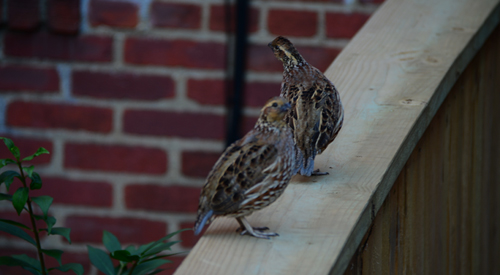
 In my grammar-school basal reader, the story about the Canadian prairies had a drawing of a mother quail, followed by her brood, walking through wheat fields. For whatever reason, that image has stayed with me all these years. I have no idea what the story was about, but the picture is vivid in my memory. I think I tried to read the story, but the memory impression is that it was boring and a disappointment compared to the vibrancy of the picture. The earth tones, the brown-orange plumage the golden wheat were all beautiful – a romantic impression of the far away prairies. (I think the image referenced some seminal memory of wheat fields, full of poppies, in Calabria.)
In my grammar-school basal reader, the story about the Canadian prairies had a drawing of a mother quail, followed by her brood, walking through wheat fields. For whatever reason, that image has stayed with me all these years. I have no idea what the story was about, but the picture is vivid in my memory. I think I tried to read the story, but the memory impression is that it was boring and a disappointment compared to the vibrancy of the picture. The earth tones, the brown-orange plumage the golden wheat were all beautiful – a romantic impression of the far away prairies. (I think the image referenced some seminal memory of wheat fields, full of poppies, in Calabria.)
Last Friday, a number of creatures made their way into our backyard. There was the outside cat that decided to curl up under the hose-box. A family of quail that took over my neighbor’s back-yard. There were two adults and four large chicks. Two of them decided to fly up onto the top of the fence. (I wonder if the cat was really stalking dinner hoping the immature cheepers would jump down into my yard.)
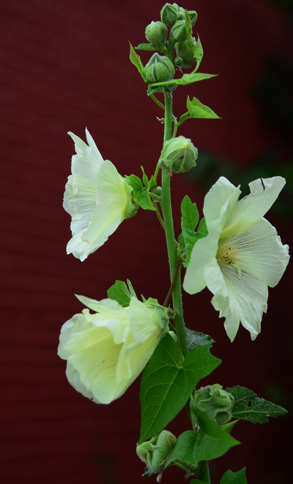
 I’ve always loved hollyhocks, and yet have never been able to grow them. In Sault Ste Marie, down on Wallace Terrace and Korah Road lived an old Italian lady and the perimeter of her double lot was planted with hollyhocks. These solitary, fuzzy, tall plants marked the borders of her property. I could never get up close, there was a wide ditch between the sidewalk and her fence. And the hollyhocks were on her side of the wooden slats.
I’ve always loved hollyhocks, and yet have never been able to grow them. In Sault Ste Marie, down on Wallace Terrace and Korah Road lived an old Italian lady and the perimeter of her double lot was planted with hollyhocks. These solitary, fuzzy, tall plants marked the borders of her property. I could never get up close, there was a wide ditch between the sidewalk and her fence. And the hollyhocks were on her side of the wooden slats.
I don’t like the modern incarnations – the double hollyhocks. Just try and find the old plants. The nurseries assume that if someone is going to plant hollyhocks, they would want the doubles, the full bloom variety. They are no longer the simple farm flowers of old. To me they’re addicts nursed on the chemical tit of modern agri-business. (The hollyhock is native to the far East. In Japan it’s incorporated into the official seal of the Tokugawa shogunate.)
I like the buds as much as I like the paper-thin flowers. The buds remind me of hazelnut pods. (Another of those instances where an item pulls out the primal memories of childhood. But these memories are all mixed up; they are in pieces jigged together to form new pictures. There are image-pieces from growing up in Aprigliano and collecting hazelnut husks; there are image-memories of drying the hazelnuts at Christmas in order to play with them. We would roll them down a ramp. You kept rolling them and rolling them hoping one would hit. If one hit, you got to collect and keep all the nuts on the floor.)

 not leaving on a jet planeprologue – le marche 2013
not leaving on a jet planeprologue – le marche 2013This will serve as the prologue for the journal entries of the 2013 trip to Le Marche.
It’s early June and I’m exactly two months away from leaving for Rome, but I want to tell the story of the horror that is booking through Alitalia.
Back in October, we booked three seats from Toronto to Rome to Ancona. We would be flying Alitalia all the way. But, the tickets were booked through Delta. (We were willing to drive to Toronto so that we could fly into Ancona.) We’ve been experimenting with flying into smaller cities to see if we can make the trip to Isola di Fano shorter and easier. Last year, we flew into Bologna but that became an experience we never want to repeat. Unknown to us foreigners, Bologna is the entry point for vacationers going to the Adriatic beaches. First it took us 4 hours to get through the rent-a-car line and then a trip that should have taken an hour-and-a-half took us 5 because of beach traffic between Bologna and Rimini. For this year we settled on Ancona, believing that we would not hit beach traffic.
Ticketing was a bit difficult, but the Delta agent got us seats and just asked that we check with Alitalia to confirm the seats between Rome and Ancona. By the end of November we had all our seats. (I was a bit anxious, just because it had been a lot of work to get the tickets. And in Kaua’i we agreed to touch base with Delta and make sure everything was on track for the August trip.) Last week, Rose got a phone call saying that the Rome – Ancona leg of the trip had been cancelled by Alitalia. The next couple of days were horrible. She called Delta repeatedly, but they had no access to Alitalia’s new partner for flights between Rome and Ancona. Alitalia would not help, insisting that the ticket was booked through Delta and therefore Delta was obligated to fix the problem. (I even spent a couple of hours at the Pittsburgh airport with an agent to see if she could help. Nothing!) Delta could not get seats from Alitalia, and Alitalia would not let us book on its new partner. (We had already booked a rent-a-car at the Ancona airport. We had already booked hotel rooms for the Saturday before the trip home.) Alitalia refused to help in anyway shape or form and no one at Delta knew how to get to Alitalia. Delta’s option was to refund the ticket.
After much cursing and swearing, we agreed that we would not win against Alitalia and that we had to re-group and figure out how to minimize our financial losses. Rose came up with an absolutely elegant solution. She re-booked the three seats through Delta. I’m flying from Pittsburgh to Detroit, meeting up with Rose and Derrick in Detroit and then fly on to Rome. The return is the same. So we don’t have to drive to Toronto, pay airport parking for two weeks and then drive home. In Rome we will pick up a car and drive the 3 hours to Isola di Fano.
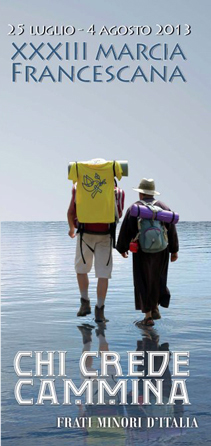
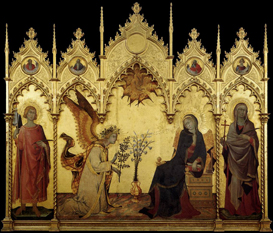 Last summer we walked into this church in Pesaro and taped to the podium was this wonderful poster – Tu sei bellezza – announcing the pilgrimage from Loreto to Assisi. When I got home and did some research, I found that the walk is an annual event sponsored by the Frati Minori d’Italia – Franciscan Brothers of Italy. The poster is what I was amazed by – its design, its concept, its colors, its use of the Gothic Annunciation to frame the title – Tu sei bellezza – You are beauty. Every year in late July, early August the pilgrimage goes from a religious center in central Italy to Assisi. Given that the 2012 walk went from Loreto to Assisi, using Mary in the poster was correct, consistent and celebratory. The designer of the poster cropped the figure of the Virgin from the altar piece – Annunciation with St. Margaret and St. Ansanus – by the Italian Gothic artists Simone Martini and Lippo Memmi. The poster is built around the cropped image of the reluctant young woman receiving Gabriel’s announcement in her study. The altarpiece has the following words coming out of Gabriel’s mouth – Ava gratia plena Dominus tecum (Hail, full of grace, the Lord is with thee).
Last summer we walked into this church in Pesaro and taped to the podium was this wonderful poster – Tu sei bellezza – announcing the pilgrimage from Loreto to Assisi. When I got home and did some research, I found that the walk is an annual event sponsored by the Frati Minori d’Italia – Franciscan Brothers of Italy. The poster is what I was amazed by – its design, its concept, its colors, its use of the Gothic Annunciation to frame the title – Tu sei bellezza – You are beauty. Every year in late July, early August the pilgrimage goes from a religious center in central Italy to Assisi. Given that the 2012 walk went from Loreto to Assisi, using Mary in the poster was correct, consistent and celebratory. The designer of the poster cropped the figure of the Virgin from the altar piece – Annunciation with St. Margaret and St. Ansanus – by the Italian Gothic artists Simone Martini and Lippo Memmi. The poster is built around the cropped image of the reluctant young woman receiving Gabriel’s announcement in her study. The altarpiece has the following words coming out of Gabriel’s mouth – Ava gratia plena Dominus tecum (Hail, full of grace, the Lord is with thee).
 This year’s poster announces Chi Crede Cammina – Who Believes, Walks. It features two figures, a young person and a Friar with back-packs, walking on shallow water. In its Italian incarnation the title is all about alliteration. Each word begins with a hard c sound. (BTW, the titles of both the 2012 and 2013 posters use a 6 syllable phrase. Tu sei bellezza is six syllables, Chi crede cammina is six syllables.)
This year’s poster announces Chi Crede Cammina – Who Believes, Walks. It features two figures, a young person and a Friar with back-packs, walking on shallow water. In its Italian incarnation the title is all about alliteration. Each word begins with a hard c sound. (BTW, the titles of both the 2012 and 2013 posters use a 6 syllable phrase. Tu sei bellezza is six syllables, Chi crede cammina is six syllables.)
This post is really about the differences between our American approach to religion and the Italians’ view-point. In American, religion is about God and Jesus, superiority, it’s about pointing out others’ faults, it’s about voting against, it’s about Puritan self-righteousness, it’s about the rich being God’s favorites, it’s about suppressing women, it’s about paternalism, it’s white, it’s about social division, it’s about separation, it’s about rejection. It’s not about loving your neighbor, it’s not about taking care of the poor, it’s not about contemplation, it’s not about prayer, it’s not about self-sacrifice, it’s not about ritual, it’s not about holiness, it’s not about Mary, it’s not about Joseph, it’s not about the saints. And it’s certainly not about art. As a matter of fact art and artists are viewed as anti-religion in America.
The Frati Minori are hiring some amazing artists to create art that will publicize the annual pilgrimage. American churches use artists to blow up images of fetuses that are carried in rallies. Posters are homemade and announce doom and gloom or personal hatreds. None of the images of American Christianity are about beauty, inclusiveness, humanity, self-sacrifice, self-reflection.
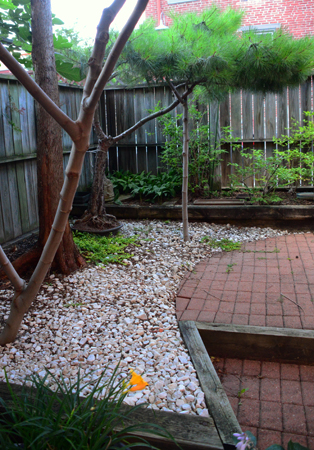
In the back-yard, on the left side of the path, are three trees – the white fig, the cedar and the pine. The fig is from Calabria, the cedar and the pine began as bonsai. The pine still has its small decorative pot. The white fig produced a bumper crop this year, the cedar stands sentinel and the pine leans right, trying for wind-swept.
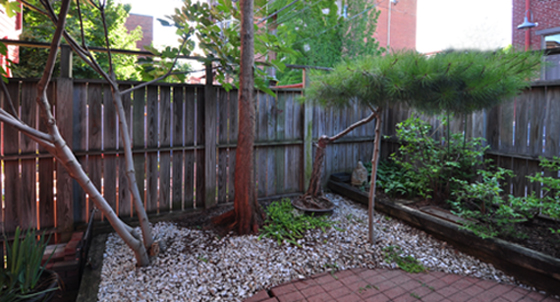 I left the writing long enough to go out back and hack off a huge limb that interfered with the wind-swept alignment. And it’s put-out-garbage night so I hid the sap-seeping branches in a steel-strong bag and threw it into the dispose pile. No one will know I ripped a limb from its trunk, chopped it into small pieces and stuffed the severed branches into plastic bags.
I left the writing long enough to go out back and hack off a huge limb that interfered with the wind-swept alignment. And it’s put-out-garbage night so I hid the sap-seeping branches in a steel-strong bag and threw it into the dispose pile. No one will know I ripped a limb from its trunk, chopped it into small pieces and stuffed the severed branches into plastic bags.
The heavy snow-falls, of the last two winters, have required that I put some kind of support under the wind-swept arm. Back in November I put a piece of wolmanized under the reaching branch. It totally destroyed the feng shui of the back-yard. (Controlled nature and pressurized lumber don’t mix.) So, I’ve been looking for alternatives and opportunities to replace the green-glowing two-by-four. I’ve been keeping a saw in the car thinking that if I find myself in an isolated area and see a tree-trunk with sling-shot like branches I would cut it down. In 9 months, nothing has come my way.
A couple of weeks ago, I began to clean up the fig trees getting rid of any new growth that would not make it through the winter or would sap the tree’s ability to build robust limbs. The oldest of the two trees needed radical pruning. In the trimming, I ended up with a trunk that leaned too far into the middle. I started cutting all the small branches hoping to salvage the thick trunk, but got lost in the removing and ended up with a naked trunk. No problem, I could use it to support the pine tree.
Last night I cut the naked trunk and drove it into the ground under the wind-swept branch. (In the image, it’s the thin trunk on the right, in the foreground, under the green foliage.) As I was digging the hole it occurred to me that the trunk could sprout. Figs are a weed and will grow anywhere from any cutting. Next summer, will the supporting trunk be full of fig leaves? Calabrian fig leaves and wind-swept pine needles – harmony.
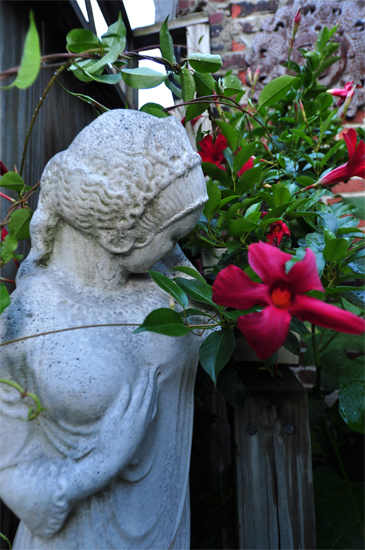
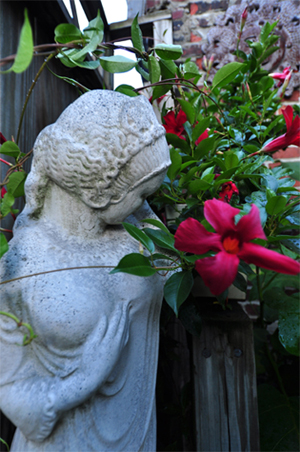 This is a first – I’ve already written a prologue and two posts for the journal le marche 2013 and I haven’t even left Pittsburgh.
This is a first – I’ve already written a prologue and two posts for the journal le marche 2013 and I haven’t even left Pittsburgh.
I was watering earlier and when I got to the Mandevillas all wrapped around the Magdalena statue, I had to get the camera. (The sculpture is Alfonso Iannelli a southern Italian immigrant who at 10 years old moved with his family from eastern Campania to the windy city. He worked with Frank Lloyd Wright creating many of the Sprite statues, but Wright never acknowledged Iannelli’s contribution.) The hair, the hair-band, the braids, the vines, the green, the cement, the discreet gesture, the turned head, the lip-stick red trumpet.
The image on the right is all about using a lens made for landscapes to shoot closeup. I discovered this in Maine. Mac and I had been out walking the shoreline in Portland and we headed up to the museum. When we got there, I realized all I had with me was the 12-24 mm lens. In statuary hall, I started getting right up to the pieces and found that the wide-angle gave me great images when I shot real close.
If this post is about technical issues and throwing around a dead architect’s name, then why the reference to the Renaissance city of Ferrara? · · · 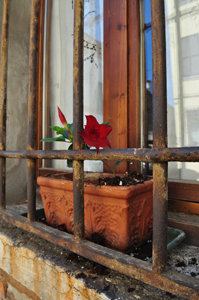 It was August 14, 2011. We were on our third day in this left-leaning, Emilia-Romagna jewel and walking, in the meager shade, to the museum. And there behind wrought iron posts, on a windowsill littered with dirt, was a single Mandevilla – the image on the left. Of course I stopped the trek and shot the lone plant jailed behind rusting bars. (I had bought Mandevillas for the first time that summer and seeing them in Ferrara was a glimpse of home. I’ve planted them every year since.) It always surprises me to see plants in Italy that I grow in my own back-yard. I’m surprised because I keep thinking that the fauna and flora of Italy should be different than what we have in Western Pennsylvania.
It was August 14, 2011. We were on our third day in this left-leaning, Emilia-Romagna jewel and walking, in the meager shade, to the museum. And there behind wrought iron posts, on a windowsill littered with dirt, was a single Mandevilla – the image on the left. Of course I stopped the trek and shot the lone plant jailed behind rusting bars. (I had bought Mandevillas for the first time that summer and seeing them in Ferrara was a glimpse of home. I’ve planted them every year since.) It always surprises me to see plants in Italy that I grow in my own back-yard. I’m surprised because I keep thinking that the fauna and flora of Italy should be different than what we have in Western Pennsylvania.
The Mandevillas have now become harbingers of my trip to Italy and from the day I plant them, I begin a count-down to the date I leave. (I’ll have to be more conscientious and protective of this harbinger. Remember, I forgot all about the Snowdrops, the harbingers of spring, when the flower-bed on the side-yard was ripped out.)
Next week at this time I should be on plane heading for Rome.
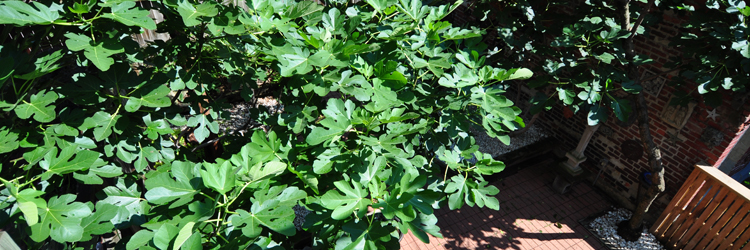
 the fig-trees have taken over
the fig-trees have taken overThe shot is from the porch on the second floor. On the right is the edge of the new fence and my neighbor’s garage wall that I hang all the reliefs and ornaments on. In front of the wall is the base of the Frank Lloyd Wright Sprite statue. The left of the image is the older fig-tree.
Back in January, the back-yard was a mound of frozen mud – the big dig4 – covered in a blue plastic tarp. Today, it’s totally green and overgrown with fig-trees, Japanese lilac, Cedar, Wind-swept Pine and pots and pots of flowers. Let’s not forget the four pots of eggplant. And let’s not forget the fact that for the last four weeks I’ve been trimming and pruning. The fig-trees got the most branches removed, followed by the Cedar. With the Cedar, I keep removing the lower branches so that all you see, at back-yard level, is the straight red trunk.
I think what surprises me most is the canopy. I’ve been nursing the two fig-trees for years and this summer not only did I get a bumper crop, but the two trees have taken over creating an amazing leaf-cover. No one looking at the image would think it’s an urban garden, on Pittsburgh’s North Side or that the canopy is from a cutting from a fig-tree in Calabria.
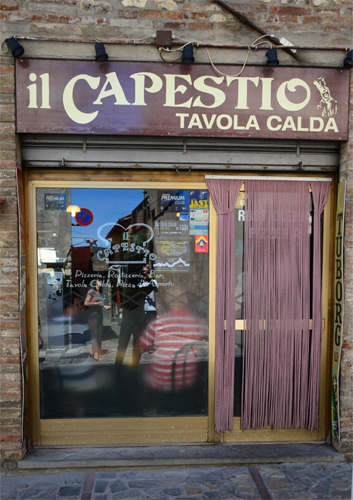
I began Friday, August 2 by going into work. It was a half-day for everyone and there were items that I was in charge of at the morning meeting. Got home by noon, had a quick lunch and got ready to leave. (Dan and Ellen drove me to the airport.) And given that I like going early, I got to the gate two hours before departure. We boarded on time and then began the nightmare. First, the plane had hit a bird on its way from Detroit and that residue had to be cleaned; next we were over-weight and two airline employees had to get off; then we pull away from the gate only to wait on the tarmac for 45 minutes; by this time the couple behind me who had been on the phone to the airline trying to figure out if they were going to make their connection in Detroit, when it was obvious that they had missed the connection, decided that they would rather remain in Pittsburgh than overnight in Detroit; we went back to the gate to let them off. It was now 4:30, an hour delayed. The flying time was only 38 minutes, but we had to get in the air before that applied.
It was 4:55 before we were in the air. I got off in Detroit at 5:45, and began my sprint to terminal A. (Terminal A is the opposite end of the airport. The whole wait-time I had been in contact with Rose and the were just as anxious because we were going to have to deal with the consequences of my not making the Rome flight.) I literally ran the whole way and got to the gate by 6:00. The lounge was empty, and they had to special open the door into the jet-way. I got to my seat with 10 minutes to spare. (As a sat down the thought of my luggage kept floating through my head. Did it make it onto the plane? If it didn’t how was I going to retrieve it? Was I going to have to drive into Rome on Sunday?) The plane to Rome was this luxurious, huge thing so at least the flight was going to be comfortable.
We got to Rome, the line through customs wasn’t too annoying, my bag was at Baggage Claim, and because we got to the rent-a-car before the crowd, we got our Punta and were on our way by 10:00.
 The original plans for this trip were to fly into Ancona, but those fell apart and we were back to driving from Rome to Earle-and-Suzanne’s. Driving out of Rome is like driving out of any modern metropolis. Driving time was three-and-a-half hours and we weren’t scheduled to have access to the house until 4:00. We kept debating how to stretch the time. We settled on stopping in Todi for lunch. We like Todi.
The original plans for this trip were to fly into Ancona, but those fell apart and we were back to driving from Rome to Earle-and-Suzanne’s. Driving out of Rome is like driving out of any modern metropolis. Driving time was three-and-a-half hours and we weren’t scheduled to have access to the house until 4:00. We kept debating how to stretch the time. We settled on stopping in Todi for lunch. We like Todi.
We got off the highway and made out way up the mountain to beautiful Todi. (The GPS is totally annoying as it keeps repeating – Recalculating, recalculating …) We actually go in to see the inside of the famous church outside the walls of the ancient city. (The last time we were here, the church was closed and a couple from the UK took our picture sitting on the wall outside the church.)
Parking is always a problem in the hill-towns, and we were practically outside the walls before we found a spot. As Rose and Derrick were negotiating the parking machine, the owner of the restaurant came out to tell us that on Saturday parking was free between 1 and 4. I looked at the place he came out of and decided that we needed to go in there with the locals and have lunch. It was a great first meal.

 the morning rhythms4th entry – le marche 2013
the morning rhythms4th entry – le marche 2013This year the farmers from up the road are running two tractors. Both the old farmer and his son are plowing. Last year one plowed while the other spread manure. This year, the manure was all spread when we got here. Earle mentioned that they have been plowing every day for the last two weeks. And they are plowing the fields around Earle-and-Suzanne’s. In the morning they are outside the the kitchen window. They begin at sunrise, and go till about 11:00. They will begin again around 5:00. (I want to ask some questions – what is the family’s name, why are they running two tractors, given that they leave behind huge lumps of earth, will they re-plow when it’s time to plant, what is in line for planting, and who do they sell the harvest to?)
The family name is Finocchi. The old man is the father and his name is Fausto;
the younger man is his son and his name is Fabrizio.
They will re-plow in the spring before planting. (OMG, do all that plowing again!)
The sunflowers are planted every four to five years and only the heads are harvested;
the stalks are plowed under to replenish the soil.
The farmers in the valley belong to a farming co-operative based in Isola di Fano.
Also, this year the region is much greener. Last year it all looked and felt dry and dusty, parched. And this summer that desert feel is gone. They had a wet winter and the water table is much higher. The Metauro has water in it. (Last year the river bed was wet with puddles here and there.) The garden is green; the oleander is tall and full of flowers; the lavender is a rich gray and sprouting blue plumes; the oak trees are dense and a deep green.

 the market in fossombrone5th entry – le marche 2013
the market in fossombrone5th entry – le marche 2013Monday is market day in Fossombrone. And the first 5 images in the header slide-show are from the there. (The five images are: olives, zucchini flowers, hot peppers, tomatoes, and Borlotti beans. And my favorite is the zucchini flowers. Rose asked me if I wanted to cook them and I passed. If next week they have them, I’ll buy them and make fritters.) The image on this post is the tray, from one of the non-food vendors, brimming with all the trinkets/charms available to string into a necklace.
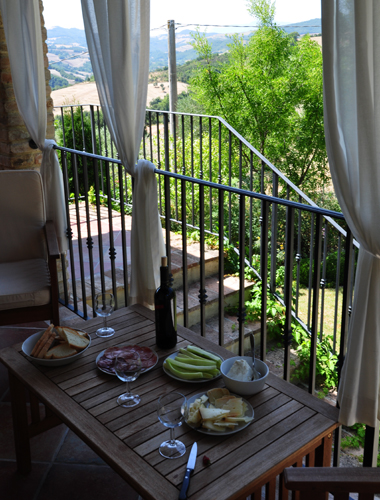
 For the first time in 3 years, we sat and had lunch on the veranda. (In the past, lunch was a pick-up on our way to somewhere. Many times it was something we bought at the Co-ops and then ate when we got to the next town. Most of these experiences satisfied hunger. The quality of the food was sub-par. The only good experience was last year in San Lorenzo in Campo when we met all those great people. The shop-keeper introduced us to Visner and he even uncorked a bottle of wine for us to take away.)
For the first time in 3 years, we sat and had lunch on the veranda. (In the past, lunch was a pick-up on our way to somewhere. Many times it was something we bought at the Co-ops and then ate when we got to the next town. Most of these experiences satisfied hunger. The quality of the food was sub-par. The only good experience was last year in San Lorenzo in Campo when we met all those great people. The shop-keeper introduced us to Visner and he even uncorked a bottle of wine for us to take away.)
We had bought this great cheese at the market and lunch gave us a change to eat it slowly and with a glass of wine. The table has on it left-to-right – bread, sopressata and prosciutto, wine, sliced cucumbers, ricotta, and various pecorino cheeses. It was totally relaxing to sit and eat and know that we could still get to an outing. (After lunch we went to Monestario Fonte Avellana – an amazing place.)
Today, there will be three separate postings.
– lunch
– Fonte Avellana
– after dinner conversation with Earle-and-Suzanne
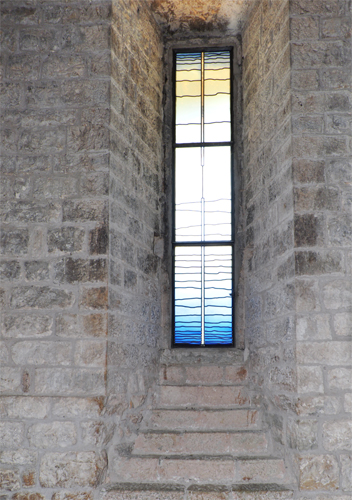
 The Monastery of Fonte Avellana has a checkered history. There were periods when it had a notorious reputation. Today is boasts a library full of ancient manuscripts that the monks diligently copied, wrote and acquired.
The Monastery of Fonte Avellana has a checkered history. There were periods when it had a notorious reputation. Today is boasts a library full of ancient manuscripts that the monks diligently copied, wrote and acquired.
It is a sprawling complex in an isolated wooded valley at the feet of Mt. Catria (elev. 5,600 feet above sea level) The monastery was founded in 980. Dante, who stayed here for a while, mentions it in the 21st canto of Paradiso.
Today, the monastery is a shadow of its former self. A community that at one time numbered a couple of hundred is now down to under 20. However, the Italian, Catholic tourist industry has stepped in and the monastery has become a pilgrimage site. The grounds were crawling with people who had just had lunch in the refectory and were waiting out the clock, to getting back on their tour bus, at the picnic tables that littered the visitors area in front of the monastery gift-shop.
The image on the right is of the window in the small refectory. All the windows in the chapter house and chapel are modern stained-glass and beautiful.
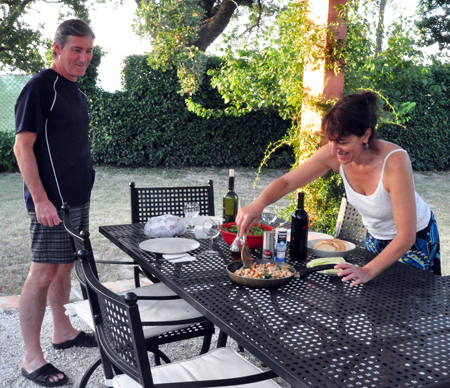
 This has become the signature picture of each of our stays here at Earle-and-Suzanne’s.
This has become the signature picture of each of our stays here at Earle-and-Suzanne’s.
We had an almost vegetarian meal except for the porchetta – rolled pork seasoned with wild fennel and garlic. It’s a local preparation and very popular. (I discovered the rind, baked to hardness and smothered with seasoning.)
Earle joined us for a glass of wine and began talking about his trip to Puglia. I suspected that it was connected to his interest in restoring some ruin. And sure enough he told us that they are close to sealing a deal to buy and restore and four-cone trulli. These are the farmhouses of Puglia, where the itinerant farmers lived and worked the fields for the padrone. They are unique to Puglia and their cone roofs are famous. They will restore it and rent it out much like they do the house here in Le Marche.
We will be one of their first renters.
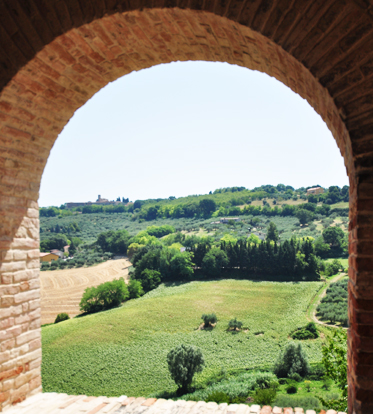
 Today we decided to venture close to home and go looking for the pecorino cheese cured in a hole in the ground. Cartoceto was our destination.
Today we decided to venture close to home and go looking for the pecorino cheese cured in a hole in the ground. Cartoceto was our destination.
We had never been to this area and I kept thinking that it would be nothing like our little corner of Le Marche. And again the idea that Le Marche is really found off the main roads proved true. (I kept thinking that nothing off the SP-78 could be worthwhile and yet today was wonderful.)
Cartoceto is another hill-town and on the ridge. This area of Le Marche is about owning the hill-tops and leaving the valleys to the farmers. (Our area is about owning the valley, because that’s where the Metauro runs, and leaving the sides of the valley to the farmers. Here the water of the Metauro is the currency of power.) What I liked best about Cartoceto is that across the valley was its cemetery. The town’s windows look out onto the valley and onto the cemetery on the opposite ridge. (Aprigliano has the same set up. Looking south-east, the Apriglanese look onto the cemetery.) In the image, the cemetery is at the top of the ridge on the left. We drove there hoping to take a picture of Cartoceto from the opposite ridge, but the cemetery was a walled enclosure with no openings

 i girasoli8th entry – le marche 2013
i girasoli8th entry – le marche 2013This year the sunflowers – girasoli – are everywhere. Earle said that they are more of a replenishing crop than a cash crop. The heads are harvested and the stalks plowed back into the ground.
We stopped in a field of sunflowers outside Todi and then yesterday on our way home, we saw a field with yellow heads above Isola di Fano and stopped. Unless the plants are young and you are shooting them as they reach for the sun, they are not interesting. So, I’m looking for a field of recently bloomed plants and a field I can get to where the flowers are facing me. (The Italian word – girasole – means turns to follow the sun. I need to find a field where they are turning and looking at me.)
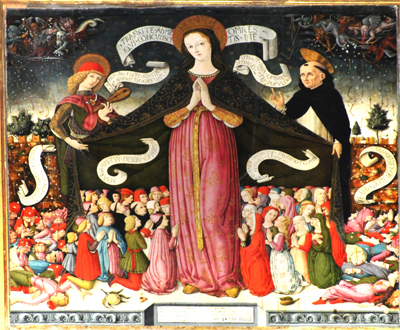
 We went south specifically to see this painting. It’s in the cathedral in San Ginesio.
We went south specifically to see this painting. It’s in the cathedral in San Ginesio.
We walked into this dark church and are looking everywhere, and I spot it behind the altar. We start taking pics, but it’s a weird angle, so I go up the gate and find that the lock is not closed. Derrick and I open the gate and walk into the monks’ stalls and now we’re shooting the painting right on. Don’t you know it, this pretend priest comes in and at first says nothing and then goes off yelling at us. (He screamed something about an alarm going off.) We played the tourist card and left. But I got the shot.
When we get back to Isola di Fano, I’ll add more info about the painting. (The connection here at the hotel is sporadic and I’m amazed it stayed on long enough for me to do this post.) Tomorrow on our way back, we are stopping at another small town to see another rendering of La Madonna della Misericordia – Our Lady of Mercy. It’s a new awareness learning the word misericordia, because it sounds like another word in a famous Italian curse – porca miseria. I grew up listening to the old Italians cursing, and to re-imagine the new word as connected to Mary saving people from the Black Plague, and not to remember the cursing is work.
This particular rendering has a name – Madonna del Populo – by Pietro Alemanno; it is signed and dated 1485.
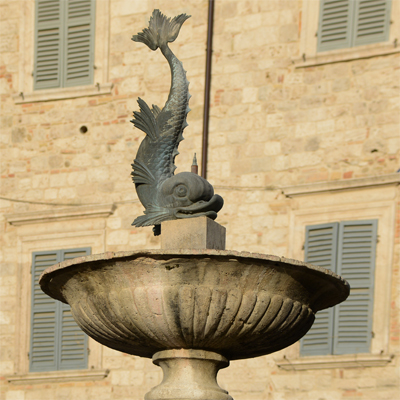
 Ascoli Piceno has the same problem as Reggio di Calabria. Everyone refers to these two cities by the first part of the name.
Ascoli Piceno has the same problem as Reggio di Calabria. Everyone refers to these two cities by the first part of the name.
Also, the people at the hotel kept saying Ascoli with the emphasis on the first syllable. And this morning, two other guests were talking about Offida again putting the emphasis on the first syllable and it dawned on me, that I’ve been pronouncing the words wrong. Also, that once you say the word with the emphasis on the first syllable, there is no need for a second consonant sound at the end. (I’ve been wanting to spell Orvieto and Loreto with double t’s.) Now I understand that the double consonant at the end of the word is the clue to changing the emphasis from the first to the last syllable. The example is Abruzzi. The emphasis is on the last syllable. (It’s taken my a long time to figure this out, but then I’m finally using Italian enough to begin to relearn the language.)
American English generally puts the emphasis on the last syllable. This tends to slow the language down. Italian with its emphasis at the beginning or the word allows for a much faster speaking speed, because you don’t stop to emphasis the ending, rather you are speeding up and onto the next word.
The images is of the top of one of the two matching fountains in the Piazza del Duomo. (An inland city dreaming of sea-horses and fish?)
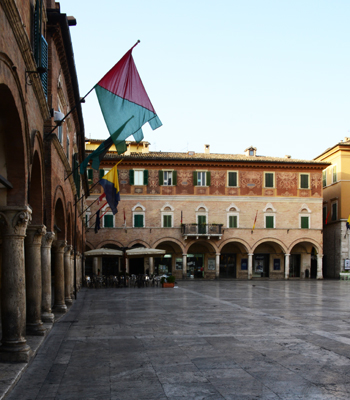
 Ascoli’s Piazza del Popolo is both beautiful and famous. It’s one of a few main piazzas with large, flat paving-stones rather than the more common single stone to make the flooring. One guide-books refers to it as Le Marche’s living-room.
Ascoli’s Piazza del Popolo is both beautiful and famous. It’s one of a few main piazzas with large, flat paving-stones rather than the more common single stone to make the flooring. One guide-books refers to it as Le Marche’s living-room.
In one corner is the famous Caffè Meletti. The Caffè opened in 1904 and still has period decor. We went in last night and ordered their famous Anice. I like it way better than the Sambuca, because it’s more herby and less sweet. My goal once I get back home is to figure out where I can buy the Meletti Anice.
I really liked Ascoli and would gladly go back, I just have to figure out how to identify a decent place to eat, because the suggestions from both the hotel and the people online were not very good. (I suspect the hotel people were pushing restaurants that they had a connection with and the online people are too jaded to recognize a good restaurant.)

 red sky at night … shepherds’ delight12th entry – le marche 2013
red sky at night … shepherds’ delight12th entry – le marche 2013For the first time in 3 years it rained – unbelievable!! After the rain, the sky was a wonder and I shot it from my bedroom window and then I ran up the road and just shot and shot. The red is the sunset hitting the clouds; the horizon is the hilltops looking south-east. I brought the tripod thinking I would shoot the full moon, but I missed it, (Tonight there’s the sliver of a new moon.) but never expected to shoot the night sky after a rain.
We had spend two days down south and coming back north, it was great to have rain and to see the northern sky after such and unusual disturbance. Fausto Finocchi started to plow, but left when the thunder-gods began to argue. All the soil, in fields around us, has been turned over; we live in an undulating landscape of earth tones.
We had supper on the porch and watched the sky redden. I had to run and shoot it. (The last time i shot a sky this red was two years ago in December in Sault Ste Marie.)
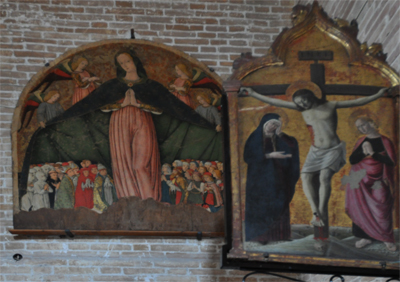
 Sarnano is a small town in the foothills of the Sibillini the mystic mountains. (The dark-green fungal circles marking the grassy hillside are where the goat-footed witches come to dance at midnight. And from caves in the craggy mountains clairvoyant sibyls delivered prophecies in ancient times. Countless female-centred cults held sway in these mountains at one time or another, and one modern academic points out that, viewed from the air, seven ancient churches scattered across the Sibillini mountaintops replicate the arrangement of the stars in the constellation Venus. Witches, soothsayers, devils, goblins. How could there not be such things in such an otherworldly landscape?)
Sarnano is a small town in the foothills of the Sibillini the mystic mountains. (The dark-green fungal circles marking the grassy hillside are where the goat-footed witches come to dance at midnight. And from caves in the craggy mountains clairvoyant sibyls delivered prophecies in ancient times. Countless female-centred cults held sway in these mountains at one time or another, and one modern academic points out that, viewed from the air, seven ancient churches scattered across the Sibillini mountaintops replicate the arrangement of the stars in the constellation Venus. Witches, soothsayers, devils, goblins. How could there not be such things in such an otherworldly landscape?)
The medieval borgo with its narrow, steep streets culminates in a silent piazza at the top. There in a small church is a second Madonna della Misericordia by Pietro Alemanno. The central figure is very similar to the one in San Ginesio, but her robe covers fewer people. (It’s too bad that the painting is not displayed as well as the one in San Ginesio. In front of the painting is a smaller one of the crucifixion. Apparently this smaller piece is paraded through the old town on feat days.) In the crypt are two frescoes attributed to Alemanno. (On the pews were the weekly missals, the cover was Alemanno’s madonna cleaned up and minus the smaller crucifixion. Rose borrowed one to take back to Michigan.)
Sarnano had Wi-Fi signs all through the old borgo. It like Gubbio gives anyone in the old town access. I guess it’s the least they can do for anyone still willing to live in its steep, stone paved alleys.
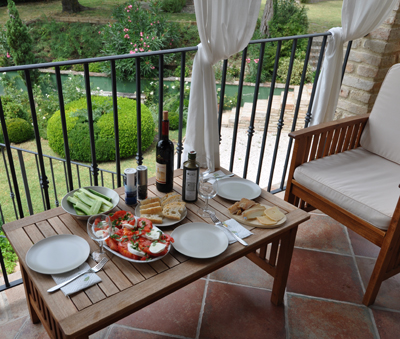
 The heat spell may have broken. We can only hope. We even have the windows open, there’s a breeze and the sun is, at times, hidden by huge white clouds. (When the heat and sun reign, the house is all shut and you live in the dark. Not something I really mind, but Rose has a very hard time with the enclosed atmosphere.)
The heat spell may have broken. We can only hope. We even have the windows open, there’s a breeze and the sun is, at times, hidden by huge white clouds. (When the heat and sun reign, the house is all shut and you live in the dark. Not something I really mind, but Rose has a very hard time with the enclosed atmosphere.)
One of the things that I like about staying here is that we can eat at our own pace and we can eat what we want. The Italian schedule of eating lunch before 1:00, because all restaurants close for the afternoon, and supper after 8:00, when the heat is gone, is hard to adapt to when you are a tourist and not used to the rhythms. We usually get to a place close to 1:00 and it’s a mad rush finding somewhere for lunch. And in Ascoli, the two places we ate at were disappointing.
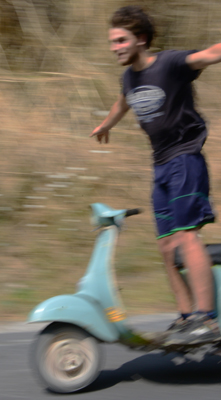
 I walked down the hill, because I want to shoot Earle-and-Suzanne’s and the Finocchi’s farm and land to try and capture the vastness of the mountain-side that these two properties sit on. However, a totally different image became the highlight of the afternoon descent. The image on the right happened after I had shot the mountain-side and was on the provincial road. (At 2:00 in the afternoon, no Italian would be caught dead outside. It’s too sunny and too hot. But today there was a nice breeze, so I figured I could try and walk. And I also figured it would be safe walking the busy road, because everyone would be home hiding from the sun and heat.)
I walked down the hill, because I want to shoot Earle-and-Suzanne’s and the Finocchi’s farm and land to try and capture the vastness of the mountain-side that these two properties sit on. However, a totally different image became the highlight of the afternoon descent. The image on the right happened after I had shot the mountain-side and was on the provincial road. (At 2:00 in the afternoon, no Italian would be caught dead outside. It’s too sunny and too hot. But today there was a nice breeze, so I figured I could try and walk. And I also figured it would be safe walking the busy road, because everyone would be home hiding from the sun and heat.)
I’m on the provincial road and listening for traffic so that I can make sure to be off the road when the cars speed by. I hear a motorcycle and as it comes around the bend I see a young man on a Vespa with no helmet, standing up, arms extended, yelling and screaming for joy while speeding down the road. I got the camera and shot. Wasn’t able to get a clear image as he raced by, hence the blurred one on the right. (He looks a lot like Christian. My nephew wouldn’t do anything like this, would he?)
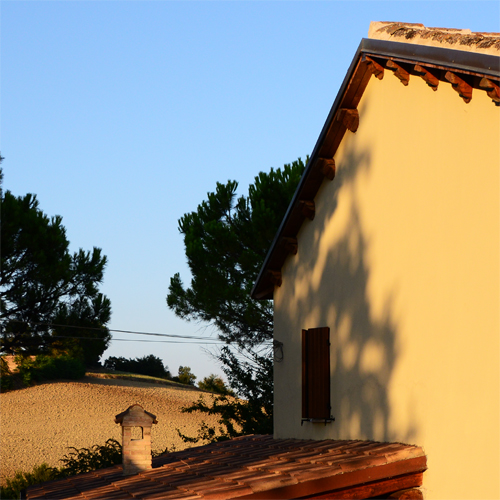
 We ate under the pergola. Dinner was a tomato salad with lots of oily juice to mop up, and a Borlotti beans salad. We had lunch on the porch and supper on the upper terrace. Because the temperature had actually gone down we were able to sit and watch the sun set. The various shades of rust and brown are just comforting and they make the contrasting greens vibrant.
We ate under the pergola. Dinner was a tomato salad with lots of oily juice to mop up, and a Borlotti beans salad. We had lunch on the porch and supper on the upper terrace. Because the temperature had actually gone down we were able to sit and watch the sun set. The various shades of rust and brown are just comforting and they make the contrasting greens vibrant.
Each year I learn something new, this year I’m learning about fagioli Borlotti. (I have a built in prejudice against beans. In my family beans were associated with poor people and people who lived on farms, not people who lived the the medieval borghi that the Perri family called home in Aprigliano.) We’ve bought a kilo at the farmers’ market in Fossombrone and another at the market in Fano. Last night Rose flavored the beans with a soft sausage from Sarnano. The reason I like them is that they have a soft skin and no bean flavor.
I’m shooting from the upper terrace. The chimney and the clay roof-tiles are on the entrance to Earle-and-Suzanne’s, the second story shutters are on the bedroom Rose and Derrick use, and beyond is the clay hill-side of plowed earth.

 the rich get richer17th entry – le marche 2013
the rich get richer17th entry – le marche 2013Today we traveled to Sassocorvaro in the Urbino province. To get there, you take the road to Urbino and keep following it west into the mountains. The drive along the provincial roads was amazing, everything from Fossombrone to Urbino is new and wonderfully paved and designed. The road down to Ascoli was equally well maintained.
I began to think about legacies. Urbino was a Renaissance center and here we are all these years later and it still is a jewel. Pittsburgh is no longer one of the three corporate centers in America, but we benefit from the legacy of the time it was. The road to Urbino is new, modern and well maintained. (It’s too bad that the roads down south where there in no Renaissance legacy are still narrow, not well marked and full of 90 degree turns.)
Sassocorvaro is a hilltop town above the reservoir in the above pic. It’s a busy place; they were setting up for some kind of festival tonight and the town is full of small restaurants and tourist favoring shops. We seem to be following a couple from Milan the whole time we were in the hill-town. At one point they were talking to an old resident who was explaining where he lived as a young boy. He lived two streets down the mountain-side. (The above pic is of Mercatale, the town at the bottom of the mountain and next to the reservoir created on the Foglia River.)
We had a picnic lunch at a park beside the reservoir and then had a cold coffee at the park restaurant. Nine pine trees were integrated into the restaurant’s interior. The tree trunks were part of the restaurant decor.

 august moon18th entry – le marche 2013
august moon18th entry – le marche 2013Dinner was spaghetti with a light fresh-tomato, onion, garlic and hot spice dressing. We then threw fresh arugula on top. (My dad would be making all sorts of comments about the Americani and how they have no regard for food traditions. Green leaves on top of spaghetti, NO!) We saw the arugula on top of pasta at the restaurant with the pine trees growing in the dining room.
Given that it was a pleasant night we stayed longer under the pergola, long enough for the new moon to become visible in the night sky. We began talking about the next trip that is planned for September 2014. What will be fresh at that time of year? The tomatoes will probably be done, and so will the Borlotti beans. Will we be eating lots of squash, potatoes, cabbage and root vegetables? I kept suggesting that there may still be summer vegetables given the different climate. Don’t think I convinced anyone.
Regardless of the fresh vegetable, it will be nice to be here when the weather is cooler and the mobs are home.
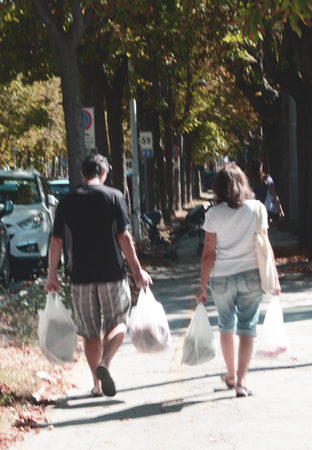
 Today was market day in Fossombrone and we went expecting to buy some tomatoes for salad. Almost $80 later, we came out with bread, cheese and more cheese, 4 kilos of Borlotti beans, honey, half a kilo of hazelnuts, and a dozen cucumbers. (Derrick is taking the 4 kilos of Borlotti back to Michigan. This time he is leaving them in the shell and packing them in zip-lock bags. I’m always amazed customs doesn’t seize the various products they bring home.)
Today was market day in Fossombrone and we went expecting to buy some tomatoes for salad. Almost $80 later, we came out with bread, cheese and more cheese, 4 kilos of Borlotti beans, honey, half a kilo of hazelnuts, and a dozen cucumbers. (Derrick is taking the 4 kilos of Borlotti back to Michigan. This time he is leaving them in the shell and packing them in zip-lock bags. I’m always amazed customs doesn’t seize the various products they bring home.)
Rose and Derrick love the market and I can take pictures of all the various stalls. Today, the cut flowers vendor had some beautiful lavender.
Suzanne was up and telling us that for some reason there are many more people in Fossombrone this August. She suspects that children came home to visit family rather than head to the beach. (Last year the are was almost deserted. Today the parking was very busy and the market was full of people.)
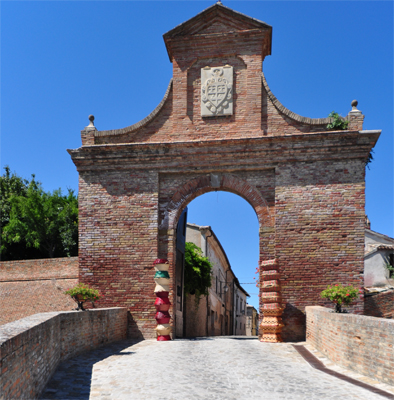
 After our expensive market trip, we decided to have lunch on the veranda and then go driving along the north-west ridge of the valley. (The Metauro River is at the bottom of the valley. And Earle-and-Suzanne’s is on the south-east slope.)
After our expensive market trip, we decided to have lunch on the veranda and then go driving along the north-west ridge of the valley. (The Metauro River is at the bottom of the valley. And Earle-and-Suzanne’s is on the south-east slope.)
We began at San Ippolito another of the Medieval borgo that spires off the ridge. From San Ippolito, using the telescopic lens, I was able to see back to our side of the ridge and make out the Finocchi farm. Next we drove down the provincial road and stopped at Sorbolongo a small borgo that is famous for its snail festival. The valley on the other side is rolling hills and plowed fields, just like our side. Each borgo is situated atop a promontory and looks out at the fields below. The next Medieval fortress was Barchi and the image on the right is the entrance to the old borgo. On either side of the gate are two columns of wicker baskets. Last night they had a festival and these are left from then. In the old town saw a house I would be willing to live in. The house was totally restored, overlooking the valley and the best feature was its walled-in garden. My idea of a house. The garden was like a courtyard well sealed from the world.
The last borgo on the tour was Orciano di Pesaro. It had a modern plaza that was part of the rope climbing museum.
On our way back I wanted to stop at a convent outside of Fratte Rosa, but the GPS is programmed to take us the shortest route and it always messes us up at Fratte Rosa. The white-road back to Earle-and-Suzanne’s was over the hills and through the woods, so we missed the convent.
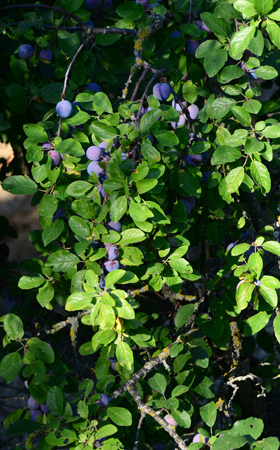
 The first year here everything was new. Last year we explored the area. This year most of the novelty and drive to tourist are gone. We plan market trips and grocery store outings instead. (I guess that happens when you’re familiar with your surroundings. The day-to-day activities become the ordinary.) The following post is a reflection.
The first year here everything was new. Last year we explored the area. This year most of the novelty and drive to tourist are gone. We plan market trips and grocery store outings instead. (I guess that happens when you’re familiar with your surroundings. The day-to-day activities become the ordinary.) The following post is a reflection.
I’ve been trying to figure out why I like being here at Cà le cerque. Is it’s location at the top of a hill, the farm-land that surrounds it, the lack of city noises? The answer is the remoteness of it all. (In Israel, when we were in the Jordanian desert, I understood the stories of the prophets’ finding Yahweh in the desert and in the desert wind.) Here I understand why all the monasteries are in the mountains, why all the holy places are up in the mountains. Guess in ancient lore the sacred and the profane chose to live in the emptiness.
Just like Ferrara made me aware of traffic noise by its absence, Cà le cerque makes me aware of all the ambient noises – TV commercials, iPod music, children, elevators, air-conditioners, humming laptops, phone rings, microwave dings, car radios, garbage trucks, highway rumblings – I live with. Here the cicadas dominate. Their mating calls fill the silence.
After a day of touristing, we come back the outside world is forgotten. I stop thinking about the mobs at the Fano market, the demons speeding the provincial road. The earth tones, the oak trees, the grapevines block all the noises from memory.
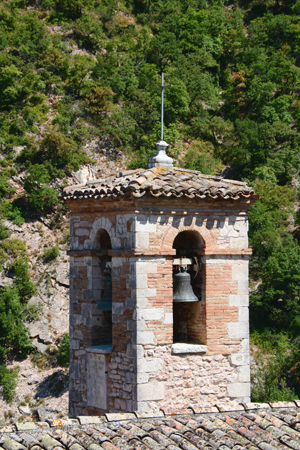
 Last year we tried to go into the Medieval town in Piobbico – the town of the ugly people – and we got stuck on the narrow road that leads into the borgo and we had to back out carefully making our way out. The road was very narrow, there were cars parked on the right and a fortress wall lined the left side. It was a miserable experience. This year we decided to go back for a caffè shakerato – a cold espresso with sugar syrup and ice shaken in a Martini tumbler and poured into a long stem glass – at our favorite bar. (The young woman asked if we wanted it from the machine or made a mano – done by hand. Obviously we asked that she do it by hand as we watched. She got three low glasses, added ice and a shot of sugar-syrup and brewed the first espresso. She threw the espresso into the glass with the ice and syrup, shoved the glass into the mixer tumbler and vigorously shook it. Then using the sieve on the mixer, she poured the concoction into this elegant glass. It was 1.40 euros.)
Last year we tried to go into the Medieval town in Piobbico – the town of the ugly people – and we got stuck on the narrow road that leads into the borgo and we had to back out carefully making our way out. The road was very narrow, there were cars parked on the right and a fortress wall lined the left side. It was a miserable experience. This year we decided to go back for a caffè shakerato – a cold espresso with sugar syrup and ice shaken in a Martini tumbler and poured into a long stem glass – at our favorite bar. (The young woman asked if we wanted it from the machine or made a mano – done by hand. Obviously we asked that she do it by hand as we watched. She got three low glasses, added ice and a shot of sugar-syrup and brewed the first espresso. She threw the espresso into the glass with the ice and syrup, shoved the glass into the mixer tumbler and vigorously shook it. Then using the sieve on the mixer, she poured the concoction into this elegant glass. It was 1.40 euros.)
After our caffè shakerato, we headed up to the old town. It’s a 15 century fortress complete with ducal palace that Holy Mother Church appropriated. The entrance into the palace is now a courtyard in front of a large church. The rest of the palace is the property of the historical caretakers. (The image is of the campanile of the fortress chapel.) The small borgo is being retrofitted with sewers. I can see it being a very tony place, full of tourists, in a couple of years.

 notte stellata23rd entry – le marche 2013
notte stellata23rd entry – le marche 2013I like the Italian title for Van Gogh’s painting; it’s the title of the post.
Yesterday on our was to Piobbico, we stopped in Acqualagna. It’s the truffle center of Italy. In late October early November the place and the surrounding hills are over-run with Italians going mushroom hunting. The above was a huge piece of fabric hung above the narrow street. The town itself was unimpressive, (Other years, we were never there in time to see anything open.) but Rose and Derrick found a butcher shop that sold wild-bore sausage and they got some.
It’s Van Gogh’s title, it’s the name of the town, I like those sounds. (Alabama is an American word with all a’s, but none of the interesting consonant combinations. The cq and gn are uniquely Italian.)
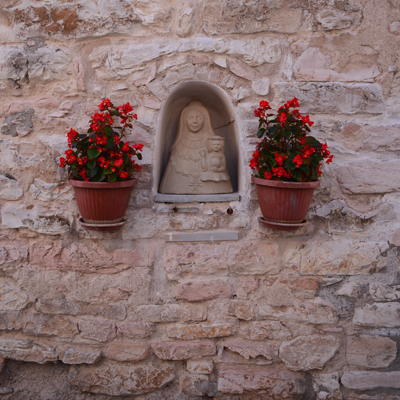
 Everywhere you go in Italy there area idols. Holy Mother Church has legitimized all these by calling them saints, but they are statues of things people idolize and worship.
Everywhere you go in Italy there area idols. Holy Mother Church has legitimized all these by calling them saints, but they are statues of things people idolize and worship.
This morning we went to the restored little hill-town of Torricella di Fossombrone. (Last night the GPS took us all the way down to Pergola, 30 kilometers away, because down there is an official neighborhood called Torricella. When we asked the women, sitting around on the benches outside their homes, if this was the Torricella that had been all restored, they told us that we were looking for Torricella di Fossombrone. Rose had seen the blue sign on our way, close to Earle-and-Suzanne’s, but her suggestion was ignored in favor of the technology.) Sure enough the blue sign led us to the restored fourteen century hamlet.
The reason for the titles is because once again, while trying to do something related to a church, we ran into a mean old man. First the fool in San Ginesio who left the gate open and then yelled at us for going into the sanctuary, today’s mean old man told me that yes he had the key to the church of San Giorgio, but he didn’t give it out. What the hell were we going to do, steal their craven idols? He then condescendingly suggested that I take pictures of the outside of the hamlet. Being a good tourist is hard when you want to give someone the finger.
Meanwhile one of the women that was there with the mean old man was very helpful, telling us how the residents had all worked together to restore the houses. (It’s been a 30 year project.)
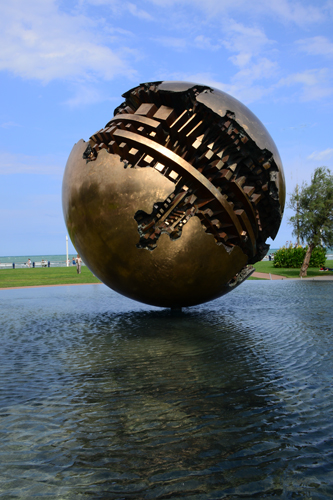
 Pesaro’s main street goes from the old city center down to the Adriatic. At the terminus on the beach-front, the city put this huge bronze sculpture, the image on the right, which has taken on the name of the artist, rather than the name of the piece. This is all helped by the fact that the sculpture’s last name is the Italian word for tomato. Everyone knows and refers to the sculpture not by its name – Sfera Grande – but as il pomodoro – the tomato.
Pesaro’s main street goes from the old city center down to the Adriatic. At the terminus on the beach-front, the city put this huge bronze sculpture, the image on the right, which has taken on the name of the artist, rather than the name of the piece. This is all helped by the fact that the sculpture’s last name is the Italian word for tomato. Everyone knows and refers to the sculpture not by its name – Sfera Grande – but as il pomodoro – the tomato.
We went to Pesaro to tour Villa Imperiale, the 14th century castle of Francesco Maria Della Rovere, Duke of Urbino. This was a summer-palace/hunting-lodge for the family. The villa and grounds are still privately owned by the Della Rovere family. And the castle is open to the public one day a week during the summer months. The Della Rovere family like all Italian noble families are closely linked to the papacy. And the narrative of the castle is all tied to the story of the papacy in the 14th and 15th centuries. (I think it’s easy to think that Italian nobility, because it is so tied to the Roman Church, is different than all others. Not true. The difference is that women are totally missing from its ranks, unless you count all the Mary substitutes, and the powerful men all wear Cardinal red.) The villa boasts a series of frescoed rooms the last of which is a portrait gallery of the papal court of one of the Della Rovere popes. The walls are littered with men in red hats.
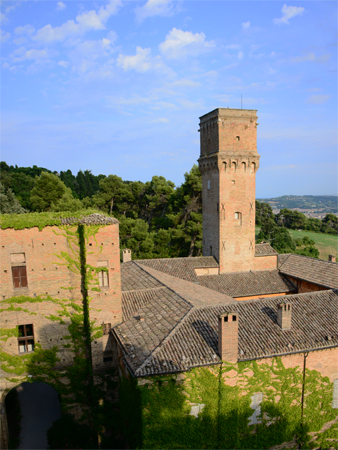
 Across from il pomodoro we got on a tour-bus to go to Villa Imperiale. It’s my first Renaissance palace. The villa’s grandeur is certainly a faded dream. It’s claim to fame these days are the frescoed rooms.
Across from il pomodoro we got on a tour-bus to go to Villa Imperiale. It’s my first Renaissance palace. The villa’s grandeur is certainly a faded dream. It’s claim to fame these days are the frescoed rooms.
The image on the right is taken from the second floor terrace of the new villa. The original fortress is the building on the right. Francesco Maria’s wife Leonora build a second villa and attached it to the original. The second villa is about open spaces – courtyards and enclosed gardens.
The tour guide did a running commentary in both Italian and English. The Italian had all the juicy pieces, the English version was the bare facts. In Italian he talked about how Francesco Maria, from the family that ruled Urbino, moved the duchy seat from the Renaissance city on the hill in the middle of Le Marche to the coastal city of Pesaro. And ever since there has been a rivalry between these two towns. (The guide being from Pesaro was pre-disposed to his side of the clashes.) The two cities are certainly the cultural centers for this region of Italy. The other large cities of the region are industrial power-houses with little memory of a time when noble families held sovereign control. (One of Francesco Maria’s brothers, didn’t like the fact that a faction in Urbino rioted against him because he raised taxes, after all he had to keep his court in the style it had become accustomed to. So he arrested the leaders of the group brought them to Pesaro and killed them. It’s a good thing the Tea Party ideologues don’t read history.)
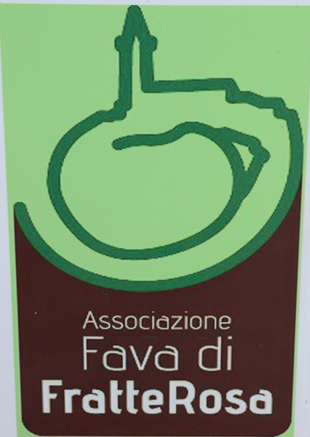
 The image is the logo of a group that is re-introducing, into the small hill-town of Fratterosa, the old fava beans of their ancestors. The young man at the stand talked about how the old contadini, who lived on the farms surrounding the hill-top, relied on the fava bean for a large part of their diet. (Sarcastic me told him that all the old contadini had left and gone to America. He did laugh.)
The image is the logo of a group that is re-introducing, into the small hill-town of Fratterosa, the old fava beans of their ancestors. The young man at the stand talked about how the old contadini, who lived on the farms surrounding the hill-top, relied on the fava bean for a large part of their diet. (Sarcastic me told him that all the old contadini had left and gone to America. He did laugh.)
Fratterosa is on the hilltop on the opposite side of the valley. We look out our kitchen window and its church tower silhouettes the horizon. The town is also know for its ceramics and tonight they are having a festival celebrating both the fava and the ceramics. (Where last August 15 we went to the Sagra di Polente, this year we are going to eat fava.)
The title only makes sense if you know that fava is an early spring plant. You plant in the fall and the seeds winter in the ground. They are sprouting by early April and the fava is ready to pick by the end of the month. (I remember trying to find fava in the Strip, in Pittsburgh, in late June and the guy told me, they are an early spring bean. I had forgotten that, because in Sault Ste Marie the beans are ready in June. Well that’s because the ground doesn’t defrost until late May.)

 an amazing meal27th entry – le marche 2013
an amazing meal27th entry – le marche 2013We were supposed to go back to Piobbico for the Sagra di Polente, because we did not know enough about other August 15 events in the area. However, Rose strongly suggested we go visit Fratte Rosa and we got to see the set-up for their Ferragosto/Assumption event. It looked interesting enough that we decided to fore go Piobbico and go up to fair in Fratte Rosa. And we’re all so glad we did. (Tomorrow we leave Earle-and-Suzanne’s and begin our trek home.)
In the afternoon we saw signs for a wine-tasting in a sub-basement. (Rose and Derrick read the sign and knew that it was free.) We also saw the menu for a restaurant that featured fava dishes and rabbit. Derrick announced that he wanted to try the rabbit. (I was skeptical of it all, thinking that it would be like the sagra we went to last year – chaotic and not all that interesting.) The event turned out to be amazing.
We began at the wine-tasting for the Terracruda Vineyard. (They were running late and it was 6:30 before they took their first tour. I was thoroughly impatient and was ready to leave. The young man running the testing was very pretentious, but he proved to know his stuff and was an excellent host. We learned about Aleatico grapes. And ended up buying a 3 bottle pack. We so liked the wines that Rose liked their Facebook page and once we get home, we are going to see if we can buy it in the States.) Next we went to the restaurant advertising the coniglio – rabbit. Rose and I ordered the pasta, Derrick the rabbit. The pasta was great, and I asked Rose if she wanted to share a rabbit and fava. We did, and it was amazing.
We came back all hyped about our experience at the Fratte Rosa Ferragosto festival. Because the whole town was part of the festival, you go to go from booth to booth and see many different things. One booth taught how to make pasta. And because it was spread out throughout the whole town it did not feel crowded or oppressive. The pic is of the three of us eating at one of the many tables throughout the town. (Two kids and a stroller behind Rose and I got Photoshopped out.)

 leaving il chiostro28th entry – le marche 2013
leaving il chiostro28th entry – le marche 2013Here on a hilltop surrounded by the peaks of the Sibillini, the world of work and responsibilities is far away. This morning we begin our integration back into the rhythms of our day-to-day world. We leave early afternoon and head down to Ancona for the day. We stay overnight and tomorrow we drive down to Rome.
I’ve never been to Ancona. (Frank remembers it from his time here and said the view of the Adriatic from its famous boardwalk is phenomenal.) The hotel, in the center of town, told us we could hang out at the pool while we wait for our rooms to be ready. The integration will be gradual – city, pool, restaurants, tourists.
Tomorrow on our drive to Rome we are stopping at the gardens in Tivoli. There nature has been tamed into ordered gardens and water features. (Did Walt Disney visit Italy before creating his fantasy lands?)
The slide show will also begin to change leaving behind the russets and greens of the valley for the formality of urban life.(The image is of the moon on Ferragosto over the rooftops of Fratte Rosa.)
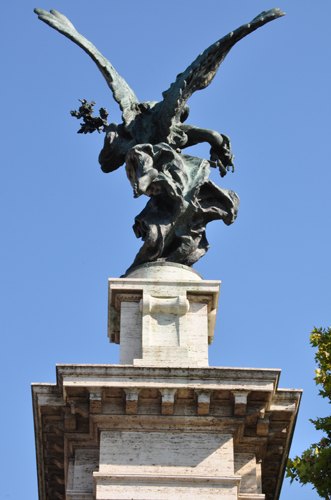
 We got to Rome early and headed over towards the Vatican. We decided to walk Corso Vittorio Emanuele rather than along the Tiber as we did back in 2011. The Vittorio Emanuele bridge that leads into St. Peter’s Square has two columns topped with angels. The image on the right is one of the two angels.
We got to Rome early and headed over towards the Vatican. We decided to walk Corso Vittorio Emanuele rather than along the Tiber as we did back in 2011. The Vittorio Emanuele bridge that leads into St. Peter’s Square has two columns topped with angels. The image on the right is one of the two angels.
Rome is so unlike any other Italian city. Its wide streets and boulevards were build during the Renaissance and reflect the grandeur of that fabled time. (I believe that what makes this obvious is the size of the city. Rome, Florence and Venice are the three jewels of Renaissance Italy, but Rome is the grandest.) Rome has none of the oppressiveness of the Medieval borgos. It’s airy, full of green spaces and giant sycamores line the banks of the Tiber. The river is no dried-up bed; it’s been dammed and therefore full of water.
We walked through Campo de’ Fiori – the old ghetto – hoping to find a wine bar or restaurant, but Rome is empty of Romans in August and full of foreigners. We ended up in a horrible restaurant where the wine was terrible. The only thing was that it was air conditioned.
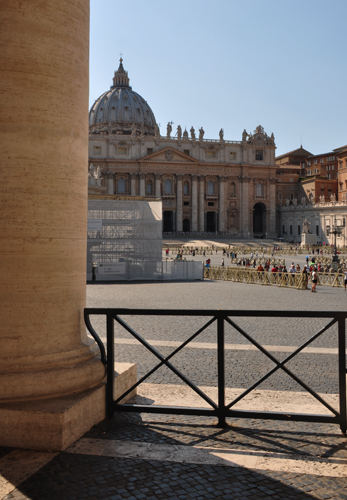
 It’s been 40 years since I was last in St. Peter’s Square. (I visited during my junior-year-abroad.) Back then, the square was grey, its columns and facades tarnished by soot and age. Also, back then you could walk into the basilica; Michelangelo’s Pietà on the first altar on the right with no glass in front of it.
It’s been 40 years since I was last in St. Peter’s Square. (I visited during my junior-year-abroad.) Back then, the square was grey, its columns and facades tarnished by soot and age. Also, back then you could walk into the basilica; Michelangelo’s Pietà on the first altar on the right with no glass in front of it.
Today, the square is awash with tourists and security forbids entry into the church without first going through a metal detector and then showing everything in your bag. Also, the thing that amazed me was the brilliance of the white stone columns. In the blue afternoon their white luster radiated off the blazing sun. They are white marble, who knew.
My memory of the colonnade goes back to 1954. My family had come to Rome to secure the documents we needed to travel to Canada. After getting our passports, we went to St. Peter’s. I remember having lunch in the colonnade, its grey pillars a forest sheltering us. After eating, we went into the church and rubbed St. Peter’s foot and prayed for a safe journey. We also brought a souvenir of the statue to give to my grandmother when we got to Canada.
Sixty years later, the square is full of Chinese tourists hiding from the Italian sun under multicolored umbrellas. (Orientals under polka-dotted umbrellas seemed out of place in a Renaissance piazza.) The grey pillars have been cleaned of their memories of southerners looking to leave, looking to find hope in a new land. A land of the British empire, a land antagonistic to their cherished Catholicism.

 what i learnedlast entry – le marche 2013
what i learnedlast entry – le marche 2013This was my sixth summer in Italy and a bunch of things fell into place. For example, I learned that I:
need to stay out of the right lane when coming up on a highway exit
(After the exit is a very short entry lane and drivers tend to be aggressive about pulling into traffic.)
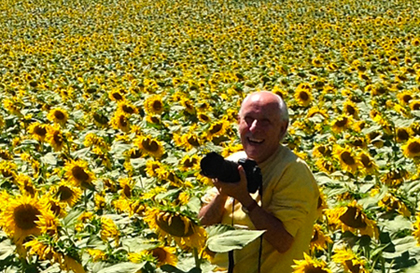
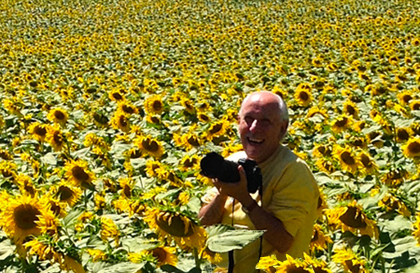 This entry is so after the fact. It’s Sunday evening, September 8, three weeks after the trip to Le Marche, but because I want to use the pic on the right, I’m pretending time travel back to Saturday, August 3 …
This entry is so after the fact. It’s Sunday evening, September 8, three weeks after the trip to Le Marche, but because I want to use the pic on the right, I’m pretending time travel back to Saturday, August 3 …
We’re driving from Rome to Earle-and-Suzanne’s and decide to drive through Todi, one of the towns in Umbria we really like. On the plain below the town, we saw this huge field of sunflowers that still had their yellow petals. We stopped and shot pictures. Rose lifted her iPad and took the image on the right – an old immigrant in a sea of yellow with a sweater complimenting the flower petals.
I’m putting this image in, because it captures the elation, the giddiness of the beginning of the trip. The walking into the field is like a step into the looking glass. We’ve been staying in rural settings the last three years and have never found a field of new sunflowers. It seems that by the time we get here, all we find are mature plants with heads heavy with seeds and ready to harvest. (Found out from Earle that this was a sunflower year, meaning that the crop rotation had come full circle and the farmers were planting sunflowers so that the stalks could get plowed into the soil to replenish the nutrients lost during the last three growing seasons.)
The bookend to this posting is the fact that I left the yellow sweater in the closet in the hotel-room in Ancona. (I never use closets in hotel-rooms, so I never look in them when checking out. In 2009, I left three dress shirts in a hotel closet in Lamezia.) Is the leaving behind part of the sadness, the lethargy of the end of a trip?

 When we were in the south, we headed to the Adriatic, to San Benedetto del Tronto hoping to find the Paolo Annibali sculptures along the waterfront. We couldn’t find them. However across the street from the beautiful ocean-front park were two proclamations, scrawled on the white walls of a fancy hotel, exposing the modern condition of isolation-and-sickness through that most virulent of art forms – graffiti.
When we were in the south, we headed to the Adriatic, to San Benedetto del Tronto hoping to find the Paolo Annibali sculptures along the waterfront. We couldn’t find them. However across the street from the beautiful ocean-front park were two proclamations, scrawled on the white walls of a fancy hotel, exposing the modern condition of isolation-and-sickness through that most virulent of art forms – graffiti.
Some of my countrymen seem to have figured out that affluence is not a gift from God regardless what the Calvinists claim, but a yellow badge that confines the human soul to a gated colony of lepers. And that beauty, as defined by modernity, is more about prosthesis and enhancements than symmetry, elegance and wisdom. (Last summer, the Franciscan Friars proclaimed tu sei bellezza about the Virgin Mary. This summer, in San Benedetto del Tronto, the young anarchists diagnosed beauty’s current condition . . .)

The rich are living in ghettos and the supermodels are dieing of beauty.
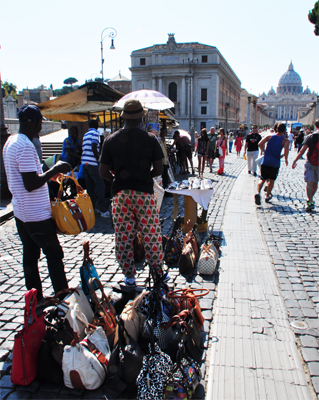
 It’s Saturday, August 17 and we’ve gotten into Rome early with a goal of getting into St. Peter’s and the Vatican Museums. The Hilton bus leaves us off at the Campidoglio and we walked down Corso Vittorio Emanuele towards the river.
It’s Saturday, August 17 and we’ve gotten into Rome early with a goal of getting into St. Peter’s and the Vatican Museums. The Hilton bus leaves us off at the Campidoglio and we walked down Corso Vittorio Emanuele towards the river.
We crossed over on the bridge with the angels and headed down to Via della Conciliazione – the grand boulevard leading from the Tiber into St. Peter’s. It’s the connector between the cloister of the Vatican and the open city of Rome. Forget its symbolic significance, in modern times it’s the street where the pilgrims huddle during papal pronouncements, it’s the street with the Pontifica Academia Pro Vita, (Who said the Italians don’t steal from other cultures? So what that it’s one of America’s most cynical ideas? So what that the word pro isn’t in the Italian dictionary?) and it’s a street with the money changers. You want a knock-off handbag, it’s stacked on the paving stones ready for you to buy – no tax, no receipt.
Does anyone really buy these knock-offs? I can understand getting caught in a rain-storm and resorting to buying an umbrella from a street vendor, but what’s the circumstance that gives one permission to buy a knock-off purse?
Am I that removed that it’s hard for me to believe someone would actually give their money to buy a cheap repro just so that they can pretend to have a designer handbag? What have we done to women’s minds?
The workers are all Africans making their way into a first-world nation, hoping to secure a place in the new world for their children and grandchildren. The Eastern Europeans head inland to work on farms and as domestics, the Africans head for the cities to manage the bancarelle one finds all over Italy. These new immigrants are at all the farmers markets, all around the major piazzas, the famous museums, the famous fountains, the ancient ruins, the empty churches.
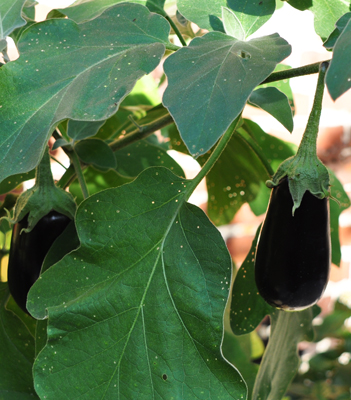
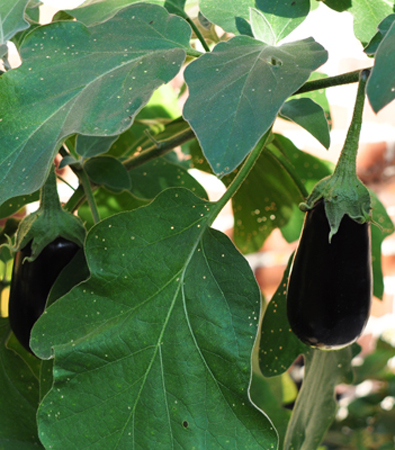 I’m trying to identify a vegetable that would indicate fall is coming and I think the eggplant may qualify. (I’m Calabrese, so jack-o’-lanterns don’t work.) My spring harbinger is the fava, watermelons tell me that summer is here and now the shiny aubergine announces fall. (Background – when we came to Canada, fave were disparaged and downgraded to horse-beans. Who in their right mind would want to eat something that suggested a food fed to horses; certainly no one who wanted to camouflage their immigrant origins? Anguria is the Italian word for watermelon. In my family, the Italian and the English got remixed and all of a sudden we began to refer to watermelon as melone. The Zingas have always been practical – take the second word of the English compound and make it Italian; all you need is a vowel. I had to re-learn anguria, because melone is cantaloupe, a different fruit entirely. In Spoleto, I remember ordering melone and expecting red fleshy sweet watermelon, only to be disappointed when they brought out cantaloupe. And finally, aubergine – what can I say, the French is so much more elegant than the English.)
I’m trying to identify a vegetable that would indicate fall is coming and I think the eggplant may qualify. (I’m Calabrese, so jack-o’-lanterns don’t work.) My spring harbinger is the fava, watermelons tell me that summer is here and now the shiny aubergine announces fall. (Background – when we came to Canada, fave were disparaged and downgraded to horse-beans. Who in their right mind would want to eat something that suggested a food fed to horses; certainly no one who wanted to camouflage their immigrant origins? Anguria is the Italian word for watermelon. In my family, the Italian and the English got remixed and all of a sudden we began to refer to watermelon as melone. The Zingas have always been practical – take the second word of the English compound and make it Italian; all you need is a vowel. I had to re-learn anguria, because melone is cantaloupe, a different fruit entirely. In Spoleto, I remember ordering melone and expecting red fleshy sweet watermelon, only to be disappointed when they brought out cantaloupe. And finally, aubergine – what can I say, the French is so much more elegant than the English.)
The four plants that I put into pots have all done well producing 3 to 4 eggplants each. Tonight for supper I cut the last remaining ones and stuffed and baked them. To supplement the garden eggplants, I got a couple from the grocery store. The filling is made from the pulp and I always like to have a lot of pulp when I mix it with bread-crumbs, cheese and eggs. The dish had a great eggplant taste. This is unusual, because when I make it from only store-bought eggplants, the cheese and herb stuffing dominate. The freshly cut eggplants added a dimension that I had totally forgotten about. (I remember my mother preparing the dish using eggplants she had just cut from the garden and after assembling the dish taking it to the communal oven. It was a dish made on bread-baking day. The casseroles were baked on the embers after the bread was done.)
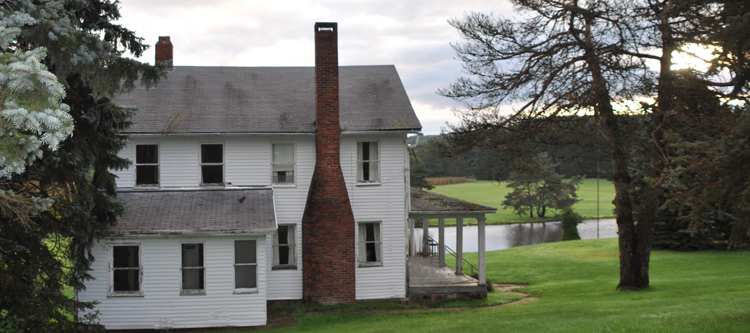
 Last week, I was in the Laurel Highlands and driving the wooded mountain roads, I passed many houses that could be second homes – cottages away from the urban hum. All these retreats were under tall pine trees in shaded glen and groves; some were perched on small rises with rolling meadows off their front porches. This bucolic landscape made me sad, made me want to drive back into town and away from its cloying disposition. I kept trying to understand the feelings, but no reasonable explanation came. My internal monologue went like this – I like the isolation of the Italian countryside, why am I reacting so negatively to this isolation? I love the browns and earth-tones of the fields that surround Earle-and-Suzanne’s, why are the greens of the Laurel Highlands depressing? The far horizons of church steeples and Medieval towers open the world to me, why do the enclosures created by the pine trees make me feel like I’m suffocating? Why did I never buy a cottage in the woods of Northern Ontario? (These houses, tucked into the shadows of the Laurel Highlands, look most like the camps one finds in Sault Ste Marie.) I obviously like the distance away from the madding crowd. Walking into the closed, dark house at Earle-and-Suzanne’s was always a relief. The dark was settling, refreshing. Then why is the dark that surrounds these Laurel homes oppressive?
Last week, I was in the Laurel Highlands and driving the wooded mountain roads, I passed many houses that could be second homes – cottages away from the urban hum. All these retreats were under tall pine trees in shaded glen and groves; some were perched on small rises with rolling meadows off their front porches. This bucolic landscape made me sad, made me want to drive back into town and away from its cloying disposition. I kept trying to understand the feelings, but no reasonable explanation came. My internal monologue went like this – I like the isolation of the Italian countryside, why am I reacting so negatively to this isolation? I love the browns and earth-tones of the fields that surround Earle-and-Suzanne’s, why are the greens of the Laurel Highlands depressing? The far horizons of church steeples and Medieval towers open the world to me, why do the enclosures created by the pine trees make me feel like I’m suffocating? Why did I never buy a cottage in the woods of Northern Ontario? (These houses, tucked into the shadows of the Laurel Highlands, look most like the camps one finds in Sault Ste Marie.) I obviously like the distance away from the madding crowd. Walking into the closed, dark house at Earle-and-Suzanne’s was always a relief. The dark was settling, refreshing. Then why is the dark that surrounds these Laurel homes oppressive?
The above image seems to capture all these feelings. It’s an empty house, surrounded by tall hemlocks, on a huge track of land.
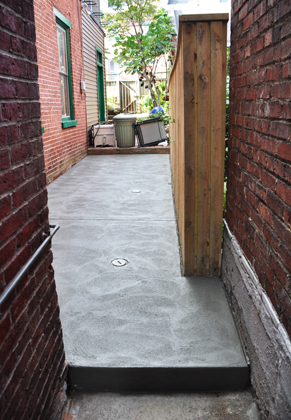
 The concrete has been poured and the project that was begun last fall is almost complete. The last piece is the gate that belongs at the end of the slab, below the step. The wet summer was the problem. Could not coordinate a cement delivery with a rain-free date. They poured 4 inches of concrete covering the vents and the gravel. (It’s hard to believe that I have a paved side-yard and that now I can figure out what I want the whole to look like.)
The concrete has been poured and the project that was begun last fall is almost complete. The last piece is the gate that belongs at the end of the slab, below the step. The wet summer was the problem. Could not coordinate a cement delivery with a rain-free date. They poured 4 inches of concrete covering the vents and the gravel. (It’s hard to believe that I have a paved side-yard and that now I can figure out what I want the whole to look like.)
My original design was for a cement wall and a cement flower-bed. The price for all that concrete would have been exorbitant and it would have not fit anything that is back there. It also would have changed the draining pattern of the area and would have required a whole new set of drainage pipes to be laid. The wooden fence and the small concrete area work so much better with the overall back-yard layout. (I lost the side-yard flower-bed, but it was always a difficult location for plants. The only things I miss are my snowdrops, but I now have a new location and ordered some 30 bulbs to seed.)
The hose-box, the garbage can and the collapsed lawn-chair are the barriers preventing the dogs from walking on the uncured cement.
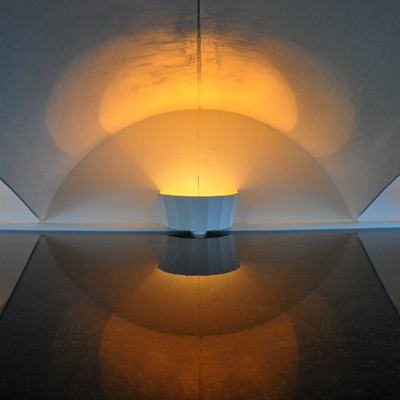
 The culture of the Roman Church permeates my psyche. And until I was 26, I lived in communities – my family, the Christian Brothers, the extended family in Toronto – that followed the rhythms of Catholicism. Today, I have nothing to do with Holy Mother Church, but its tendrils are deep in me.
The culture of the Roman Church permeates my psyche. And until I was 26, I lived in communities – my family, the Christian Brothers, the extended family in Toronto – that followed the rhythms of Catholicism. Today, I have nothing to do with Holy Mother Church, but its tendrils are deep in me.
I shoot churches all over Italy. I love going into the country chapels, monasteries, cloisters and shooting the statues, the ceilings, the crucifixes, the tabernacles, the frescoes, the votives. These items have intrinsic meaning, they are recognizable, they are hard-wired into my synapses. And the Latin has this liquid flow that blots the need for translation.
BTW, I never go anywhere near the churches if there are people and priests in them. But the empty sanctuaries are private museums, shelters from the summer heat, time capsules of a by-gone era – a time when the Church ruled, a time of visual learning and fiery oratory, the time of Botticelli and Savonarola.
I wanted to shoot the reflecting pool and entrance into Point State Park in morning light. The above image is the light fixture, pool and ceiling. An earlier shot of this location had me referring to it as the Holy of Holies. To me, the environment looks like a tabernacle, a place of worship and therefore the titles. In the Catholic Mass, the Sanctus ends the first half of the Liturgy – the Preface. Also, part of the Sanctus is adapted from the book of Isaiah and the prophet’s vision of the throne of God surrounded by ministering seraphims – Sanctus, Sanctus, Sanctus Dominus Deus Sabaoth. Catholicism aside, I love the geometry of the image, its lines of symmetry, its mushroom cloud.

 Mornings at this time of year can be full of ominous colors. Gone are the turquoises of spring and the indigos of August. Instead the sun is blinding in the eastern sky, its light a burnt-orange. And yet its rise across the heavens is rushed – its stamina waning.
Mornings at this time of year can be full of ominous colors. Gone are the turquoises of spring and the indigos of August. Instead the sun is blinding in the eastern sky, its light a burnt-orange. And yet its rise across the heavens is rushed – its stamina waning.
I’m in North East, Pennsylvania a state-line community on Lake Erie. Vineyards cover the rolling fields, Concord grapes perfume the air and harvesters roam the side-roads. The morning light is grey and the skies overcast and yet the horizon is on fire. But in months this phoenix, born in the dark days of 2012, will expire.
The title is from the 93rd Psalm. I went looking at the Psalm selections for Matins and Lauds hoping to find something about the rising son. Instead found hymns to a glorious God, so I truncated the lines and used the words I liked.
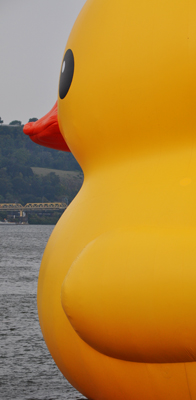
 We are in the middle of a Festival of Firsts, and one of the events is Dutch artist Florentijn Hoffman’s giant Rubber Duck docked off Point State Park. It comes to Pittsburgh, its first US appearance, from a world-wind tour that includes Amsterdam, Osaka, Sydney, Sao Paulo and Hong Kong.
We are in the middle of a Festival of Firsts, and one of the events is Dutch artist Florentijn Hoffman’s giant Rubber Duck docked off Point State Park. It comes to Pittsburgh, its first US appearance, from a world-wind tour that includes Amsterdam, Osaka, Sydney, Sao Paulo and Hong Kong.
The yellow monster has proved extremely popular and families, from all over the region, are coming into downtown for the first time in years. The kids love the duck. I walk home through Point State Park and all week it’s been teeming with ordinary people and screaming children clutching their rubber duckie toys. (In old times, pilgrims brought their rosaries to the Vatican to be blessed. Are modern children bringing their miniature ducks to the Great Mother?) The downtown merchants are giddy with profits. Also, the 2013 Carnegie International opened this weekend, bringing into town the glitterati, but it’s the rubber duckie that’s attracting the crowds.
It’s such and odd sight on the Allegheny side of the Point. There’s nothing unique about it, except for its 40 foot stature. And I don’t understand how making a 40 foot version of a toy is art. (Maybe it’s performance art.) But Pittsburgh is the perfect harbor for this hyper sized duck, after all just blocks north of the floating goddess are the original god’s paintings of the Campbell Soup Cans.
The profile is the duck floating on the Allegheny with the West End Bridge and Mount Washington in the background.

 Last year at this time I collected acorns down in West Park, brought them home, put them in a saucer and photographed them on my dining room table. (I left them on the saucer for a few days, and when I came back, a small white worm had eaten its way out of an acorn and died on the table cloth leaving a white stain that I have not been able to remove.)
Last year at this time I collected acorns down in West Park, brought them home, put them in a saucer and photographed them on my dining room table. (I left them on the saucer for a few days, and when I came back, a small white worm had eaten its way out of an acorn and died on the table cloth leaving a white stain that I have not been able to remove.)
This year, I went with Marroni chestnuts as the autumn indicators. I found the term Marroni in a rhyme on a Calabrian Facebook page; discovered that it was a variety of chestnut that grows all over Calabria. I also found a farm in California that has started growing Marronis and that October was harvest season. I ordered 4 pounds. They’re in the refrigerator and every day I’ve been eating a handful. I like them best raw, but this weekend I’ll roast some. The storage directions suggest keeping them in a cold place until ready to eat them. This will prevent them drying out. When I told my dad this he laughed. They never keep them in the frig.(I can just hear him going on about i ciuti americani putting chestnuts in the frig – crazy americans …)
The Marroni were mentioned in writings of Homer and Pliny and cultivated throughout the mountains of Calabria. In the early 1900’s, the economy of Aprigliano was based on the Marroni chestnut. Hog farmers from Cosenza would bring up the animals to Aprigliano and let them graze on the fallen chestnuts. They would pay the Apriglianesi land owners a grazing fee for each hog in the drove.
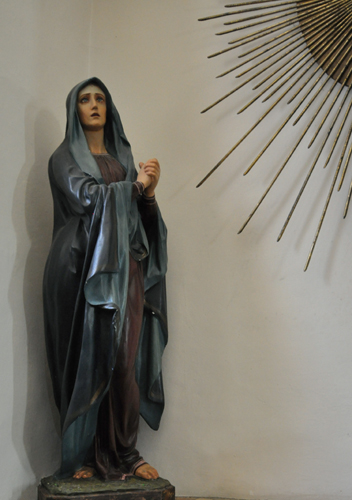

This is a variation of the classic Dolorosa – black-draped, gold-trimmed and mourning madonna. Most renditions represent Mary as distraught, forlorn as any mother would appear witnessing the crucifixion and death of her son. The rendition I remember best is –
La Dolorosa in Santo Stefano in Aprigliano.
I found this Mary in a small chapel in one of the hill-top towns on the opposite ridge from Earle-and-Suzanne’s. (The sun burst is really the background of the altar crucifix, but I like the image better without the cross and instead a hint of hope from the rays behind her.) The black drapery has given way to a dark blue cloak and the ringing hands, usually down below the waist, are up in prayer and supplication. (I also like the elongated neck and purple under-garment.)
This afternoon, in flipping through channels, the Mass on EWTN had the celebrant wearing black vestments. An old custom that has since given way to white, to remind the living of the joys of heaven in the life here after.
This year, the feast day is a time of remembrances.

 It’s that in between time when the morning sun wakes late and falls back below the horizon by 5:00 in the afternoon. Soon, both my morning walk to work and my trek home will be in the dark; soon the reds and yellows will be gone and bare trees will line the mountain side; soon the fountain at Point State Park will be turned off; soon December will clock the season and end the interim. And spring will be a longing a hunger consuming my winter nights.
It’s that in between time when the morning sun wakes late and falls back below the horizon by 5:00 in the afternoon. Soon, both my morning walk to work and my trek home will be in the dark; soon the reds and yellows will be gone and bare trees will line the mountain side; soon the fountain at Point State Park will be turned off; soon December will clock the season and end the interim. And spring will be a longing a hunger consuming my winter nights.
The above image was taken early in the morning on my way into work. I am on the foot-bridge that connects the Northside to Point State Park. It’s such a common shot that I concentrated on altering the image rather than reporting what the camera saw. The picture is heavily Photoshopped – the apartment building that cascades down Mount Washington is clone-stamped out as are the entrance to the Fort Pitt Tunnels, the highway signs on the bridge and the light on the fountain pumping station. (When the electricity runs out and the new dark ages come, will some archeologist find this image on a working server and spend all his time trying to figure out why the bridge leads into the mountain side?)

On Friday, November 22, 1963, I was sitting in my 8th grade classroom at St. Veronica’s when Sister Drusilla came in to announce that the president of the United States had been shot. This was the Catholic president of the United States and as a Catholic Canadian the news was shocking.
 It was my first year at St. Veronica’s. (My family had bought a house in the West-end; we had left my grandparents’ to live on our own.) The classroom, compared to the one I came from, was old fashioned. We had wooden desks with holes in the upper right hand corner for ink-wells. And filling them was the jobs of the “good” kids. There was a piano in the room and Sister Drusilla taught us to sing while sitting on its long bench. (Our music book had Santa Lucia in it. Well, the English version of the Neapolitan song.) Above the piano was a bulletin board and Frank’s birdhouses, that he build for his Science project, hung there. That Friday, we had one of the itinerant teachers and Sister Drusilla kept coming in from her office to give us the latest news on the President. When she came in to tell us that he had died, I remember looking up at the black-framed, round, analogue clock and saw that it was a-quarter-to-four. (In those days no one said, 3:45.) Sister Drusilla’s announcement seemed to suggest that even though one of our own had finally made it, they had killed him. Was she suggesting that the American president was like Jesus?
It was my first year at St. Veronica’s. (My family had bought a house in the West-end; we had left my grandparents’ to live on our own.) The classroom, compared to the one I came from, was old fashioned. We had wooden desks with holes in the upper right hand corner for ink-wells. And filling them was the jobs of the “good” kids. There was a piano in the room and Sister Drusilla taught us to sing while sitting on its long bench. (Our music book had Santa Lucia in it. Well, the English version of the Neapolitan song.) Above the piano was a bulletin board and Frank’s birdhouses, that he build for his Science project, hung there. That Friday, we had one of the itinerant teachers and Sister Drusilla kept coming in from her office to give us the latest news on the President. When she came in to tell us that he had died, I remember looking up at the black-framed, round, analogue clock and saw that it was a-quarter-to-four. (In those days no one said, 3:45.) Sister Drusilla’s announcement seemed to suggest that even though one of our own had finally made it, they had killed him. Was she suggesting that the American president was like Jesus?
Frank and I went home that afternoon confused by the day’s events, but knowing something important had happened. And even though we lived in a small town in Northern Ontario, we were somehow part of it.
Five years later, I would leave Sault Ste Marie and Canada forever and make my way to the land of President Kennedy, to a more congenial spot for happily-ever-aftering.

The date of the first Sunday of Advent of 1963 was December 1. Fifty years later, the first Sunday of Advent again falls on December 1.
I’m beginning the christmas 2013 posts early, because I’m going to organize them differently. I’m linking these posts to the 8th grade category, because I want to wrap them around some memories of nineteen-sixty-three.
December 1963
We had moved to the west-end in June and this was my first Christmas at St. Veronica’s. I was curious to see how it would go, because for the first time I had a nun teacher. Was she going to deal with Advent differently than all the non-religious teachers I had had?
 The Monday of the first week of Advent, Sister Drusilla lined us up in the hallway – the upper grades were in the old hallway and the younger kids were in the hallway leading to the new wing – and with the sign-of-the-cross she began the Advent service. The young nun who taught first grade picked up from Sister Drusilla reciting the Advent prayers and readings. It ended with us singing O Come, O Come Emmanuel. I liked the Advent service. We certainly didn’t do anything like this at St. Theresa’s.
The Monday of the first week of Advent, Sister Drusilla lined us up in the hallway – the upper grades were in the old hallway and the younger kids were in the hallway leading to the new wing – and with the sign-of-the-cross she began the Advent service. The young nun who taught first grade picked up from Sister Drusilla reciting the Advent prayers and readings. It ended with us singing O Come, O Come Emmanuel. I liked the Advent service. We certainly didn’t do anything like this at St. Theresa’s.
The time before Christmas was full of anticipation and even though I knew all about Liturgical Advent, it never seemed real hearing about it only on Sunday at church. We did not have an Advent wreath at church, but having the service at school with the wreath on a small table in the hallway with candles that Sister let a kid light, made the season of Advent real.
(For the image, I wanted something that was both modern and non-realistic.)


| Old Calabrese | Modern Italian | Dates and Feast-days |
| u quàttru Barbara | il quattro Barbara | December 4 – St. Barbara |
| u sie Nicola | il sei Nicola | December 6 – St. Nicholas |
| u òttu Maria | l’otto Maria | December 8 – Immaculate Conception |
| u tridici Lucia | il tredici Lucia | December 13 – St. Lucy |
| e lu vinticinque lu Missìa | e il venticinque il Messia | December 2 – Birth of the Messiah |
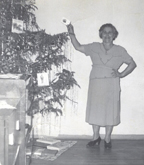 When we first got to Sault Ste Marie, my grandmother whose her image is on the left, taught me this rhyme and I remember thinking it was a fun way of marking off the days until Christmas. But as the years went by, I forgot the last part and could only remembered the first couple of lines. I’ve been trying to find the rhyme online, but have had no success. Finally, I took a chance and wrote it phonetically, in Old Calabrese, into the Google search-box and found it posted by Francesco Pecora on his Facebook page. Francesco lives in Polistena a small town in south eastern Calabria.
When we first got to Sault Ste Marie, my grandmother whose her image is on the left, taught me this rhyme and I remember thinking it was a fun way of marking off the days until Christmas. But as the years went by, I forgot the last part and could only remembered the first couple of lines. I’ve been trying to find the rhyme online, but have had no success. Finally, I took a chance and wrote it phonetically, in Old Calabrese, into the Google search-box and found it posted by Francesco Pecora on his Facebook page. Francesco lives in Polistena a small town in south eastern Calabria.
Below is his text:
Il detto descrive il modo con cui i nostri antenati annunciavano le feste nel periodo dell’Avvento; Il 30 Novembre, infatti, si festeggia S. Andrea Apostolo, che introduce le festività di: Santa Barbara (4 Dicembre), San Nicola (6 Dicembre), l’Immacolata (8 Dicembre), Santa Lucia (13 Dicembre) e il Santo Natale (25 Dicembre).
By the time we moved from my grandparents’ house to our own, the rhyme remained only in my head. In 1960’s Canada, the only feast-day celebrated before Christmas was the Immaculate Conception. At St. Veronica’s, Sister Drusilla insisted on using only the Advent cycle to mark off the days until December 25. And the rhyme lost its purpose when TV began running the Jingle Bells cartoon counting down the shopping days till Christmas. Who cared about Santa Barbara and Santa Lucia when there were gifts to be had.
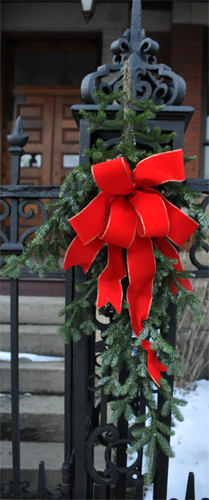
 The newel posts on the wrought-iron fence, at the end of the street, are decorated with boughs of blue pine tied together with red ribbon. On my way home, I decided to head back down and shoot the boughs and ribbons. The sun was at the horizon, but by the time I got down to the house it had set. It was 4:30. (Yes, I know what’s coming – the shortest day of the year, the Winter Solstice . . . the darkness.)
The newel posts on the wrought-iron fence, at the end of the street, are decorated with boughs of blue pine tied together with red ribbon. On my way home, I decided to head back down and shoot the boughs and ribbons. The sun was at the horizon, but by the time I got down to the house it had set. It was 4:30. (Yes, I know what’s coming – the shortest day of the year, the Winter Solstice . . . the darkness.)
Earlier today I was doing some research on the feast-days, listed in the previous post, to see if there was any evidence to support the idea that Andrew the Apostle had created these markers and organized them as precursors to Christmas. Found no information to support this. Instead I found a tradition associated with the feast of Santa Barbara – December 4. In Medieval times, Christians would cut leafless boughs from a cherry tree, bring them indoors and set them in a bucket of water in their kitchens. The belief was that if a bough bloomed then the new year would bring joy. The superstition had ties to the prophecy from the Old Testament from the Book of Isaiah — There shall come forth a Rod from the stem of Jesse, and a Branch shall grow out of his roots. (Santa Barbara was removed from the liturgical calendar of the Roman Rite in 1969. No real evidence that she existed. It’s a good thing them cardinals are selective with this criteria.)
Because the 8th grade stories are about the Advent period of that long ago at St. Veronica’s Elementary, I am using lyrics from the hymn – O Come, O Come Emmanuel – as titles to connect the 8th grade category and the christmas 2013 one. And the image of a pine bough with its scarlet ribbon is a good fit for the title.
December, 1963
Like all good Catholic school children, we got to draw Christmas themed pictures at this time of year. We got to use colored pencils and large paper. The itinerant Art teacher, who came in once a month, made the December lesson great fun. I remember that Mike Bondar drew a picture of the Christ child in a cradle holding a crucifix. (This is the Bondar family of astronaut Roberta Bondar fame.) Sister Drusilla, ever the sarcastic nun, scoffed at Michael’s rendition. He tried to explain that he was foreshadowing what was to come, but Sister would hear none of it. Considering that Michael was not one of the guys I hung with, I shouldn’t have cared that he was being insulted, instead I thought Sister was being overly harsh. He had a good idea and had executed it well. (Lesson learned – stay inside the lines or Sister will yell at you.)
Sister Drusilla was way too literal and closed minded for the likes of thirteen year old Michael or sixty-five year old Maruzzu.


The hymn O come, O come Emmanuel – Veni, Veni Emmanuel – is a synthesis of the great O Antiphons that are used for Vespers during the octave before Christmas (Dec. 17-23). These antiphons are of ancient origin, dating back to at least the ninth century. The hymn itself, though, is much more recent: it first appeared in an 18th century psalmster. There are several arrangements of the hymn. The most common arrangement uses the last of the O Antiphons as the first verse with the next six following in correct order.
It is interesting to note that the initial words of the antiphons in reverse order form an acrostic: O Emmanuel, O Rex, O Oriens, O Clavis, O Radix, O Adonai, O Sapientia. ERO CRAS can be loosely translated as I will be there tomorrow. And tomorrow is Christmas Eve.
| The Hymn | O Antiphons | Dates |
| O come, Thou Wisdom from on high | O Sapientia | December 17 |
| O come, O come Thou Lord of Light | O Adonai | December 18 |
| O come, Thou Rod of Jesse’s stem | O Radix Iesse | December 19 |
| O come, Thou Key of David, come | Clavis Davidica | December 20 |
| O come, Thou Dayspring from on high | O Oriens | December 21 |
| O come, Desire of the nations | O Rex Gentium | December 22 |
| O come, O come Emmanuel | O Emmanuel | December 23 |
I decided to use this post to write about the various Christmas hymns and carols. O Come, O Come Emmanuel was really not a carol that was being widely heard in the 1960’s. (It certainly wasn’t in any muzak collection piped into the stores during the December shopping frenzy.) It was restricted to Sunday Mass. I first heard it, outside of church, at St. Veronica’s during the Advent service led by Sister Drusilla. But it wasn’t until this year that I began to do some research and situated the hymn and the O Antiphons in my Novitiate Breviary in the Advent cycle.
In my mind, I categorize Christmas music: Catholic Christmas music is Latin – Adeste Fideles, In Dulci Jubilo; Italian music is about the child – Gesu Bambino, Tu Scendi dalle Stelle, Mille Cherubini; German and French Christmas music is romantic – Il Est Né, Minuit Chrétiens, O Tannenbaum, Stille Nacht; and American Christmas music is secular – Frosty the Snowman, White Christmas.
Image – Point State Park is all decked out for the holiday. The image is the downtown section of the park looking towards the Northside; the river section is on the other side of the parkway underpass. The entrance to the underpass is on the left of the image.
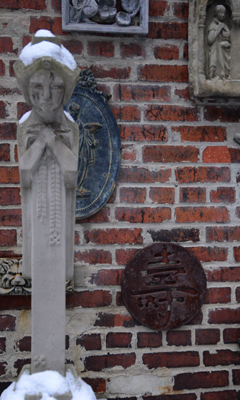
 This posting is going to be a ramble. The monks of The Society of St. John the Evangelist in Cambridge have begun a set of video reflections on the O Antiphons. In two days, I head up to Northern Ontario.
This posting is going to be a ramble. The monks of The Society of St. John the Evangelist in Cambridge have begun a set of video reflections on the O Antiphons. In two days, I head up to Northern Ontario.
December 1963
What I remember most of the winters in Sault Ste Marie, before there was central heating and you heated the house with a coal stove, were the windows decorated with ice-crystals. The sunlight through the frosted glass was bright. At St. Veronica’s the classroom windows did not frost over. And many times I’d look over at the stunted willows that bordered the creek next to the school. (I still can picture the insects that seemed to skate on the water.)
Winter light that far north was always grey. And waiting for Christmas vacation was more about not being in school than presents and family. Tobogganing and street hockey were things to look forward to, but Christmas day had lost some of its luster and I remember thinking that once the noon-day meal was over, a malaise would set in. The local network ran commercials of local businesses wishing us all a Merry Christmas. And daylight was done by 4:00. It was in this down atmosphere that Frank would introduced going to the movies on Christmas Day.
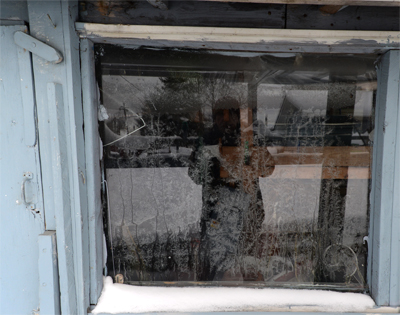
 Today is shortest day of the year. And with this end begins the new light.
Today is shortest day of the year. And with this end begins the new light.
The drive up was miserable, not as bad as last year, but through the snow-belt – the area between Grayling and the Mackinac Bridge – I75 was a one-lane road. (I saw at least 5 vehicles that had slid into the ravines. And I decided that this would be my last car trip to this part of the world during December.)
Before leaving, I had decided to figure out how to get access while I was up here. I had talked to Bell Canada and the person I talked to assured me that I could get a hotspot device to connect to my laptop. My dad would have to sign for it, because I was not a Canadian resident. I called the Soo office to verify that they would have the device, but the woman I talked to had no idea what I was referring and insisted that there was no such device in the store. My next scheme was to see if one of my parents’s neighbors would give me access.
Yesterday evening I walked over to Gerry Pozzebon’s and asked if he would give me access. (The Pozzebons live across the street from my parents. Connie was friends with their daughter, but Gerry was too young to play with us.) Gerry offered, but believed that it would be hard to connect to his router from across the street. He suggested I use my iPhone as a hotspot. I knew nothing about that. His son talked my through it and I went back to see if I could set up the connection. The Verizon represented that the feature had to be activated from a Verizon tower in the US. I told him I was in a border city and could get to the US. He did all the configuration on his side and today I drove to Sault Ste Marie, Michigan to turn my phone on and off and sure enough I had a hotspot connection.
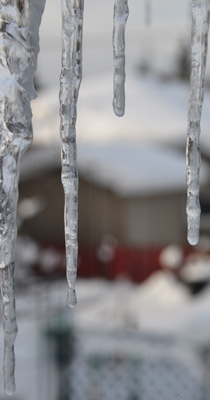
 The hotspot worked perfectly well, but the roaming charges are phenomenal, so I turned it off. (I got an email from Verizon telling me that I had incurred a $40 roaming charge.) But for one brief moment there was a time when I could claim that I had Internet access from Ciccio-and-Mafalda’s.
The hotspot worked perfectly well, but the roaming charges are phenomenal, so I turned it off. (I got an email from Verizon telling me that I had incurred a $40 roaming charge.) But for one brief moment there was a time when I could claim that I had Internet access from Ciccio-and-Mafalda’s.
The weather is the topic of all conversations and news commentaries. Southern Ontario is having ice-storms and all travel has been impacted. Here the snow is falling poster-card pretty. (I just keep hoping the by Friday the weather system will have worked its way out of the area and I can go home without dealing with weather warnings.)
Today, Derrick and I went to exercise at the YMCA and like last year they did not charge us. (The Y is one of the best facilities in town.) And while waiting to get our free admission, noticed that in the lobby/café area there is free WY-FI. Tomorrow, I’ll bring my laptop and upload this post.
Eating is still as regimented as a monastic schedule. My dad hollers up, telling me come down to the basement kitchen. Lunch is at noon and dinner at 5:30. You can set your watch on his eating routines.
The other topic of conversation is what I am going to do once I retire. I am amazed by the topic. I’ve never had an interest in anyone else’s retirement plans. Why people are interested in mine is beyond my comprehension.
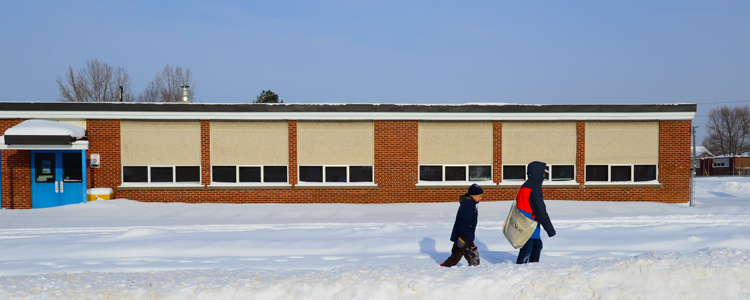

The image is of St. Theresa School. I was here from 2nd to 7th grade. The classroom on the right was my 6th and 7th grade classroom and our teacher was Mr. Orlando. This is the classroom where on a spelling test I spelled the word does DUZ and Mr. Orlando had me go up to the board and write my spelling of the word. I had no idea was I was wrong, but the experience contributed to my insecurities with spelling. (By the time I got to City High, my kids were trained to know that I did not know how to spell and that it was their responsibility to help me.)
This morning we woke up to 3 to 4 inches of new snow and a temperature of 2 degrees. Ciccio insisted on doing his vegetable shopping first thing this morning, so at 8:00 AM we were one of three cars at the No-Frills grocery store.
And for some reason, the public library came to mind as a place for Internet access and sure enough, here I am at the Centennial Branch on Bay Street, with free access. The branch was built in 1966, Canada’s bi-centennial and I remember coming here after school with a bunch of kids to do pretend homework.
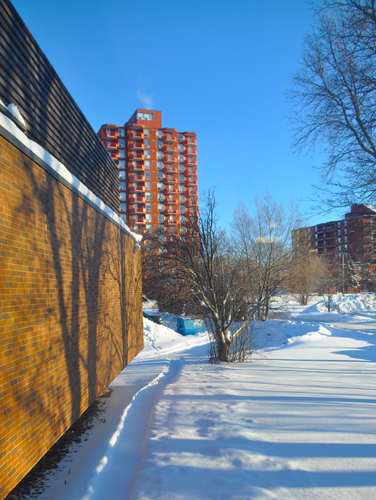
 The image is taken from inside the SSM Public Library. This is the building built in 1966 to commemorate Canada’s centennial. I keep being surprised by the condition of this building and the YMCA building. Both were built when I was in high school and both have held up remarkedly well. I say this, because the weather here in the Great White North is very difficult on shoddy construction. I guess these two buildings were well built.
The image is taken from inside the SSM Public Library. This is the building built in 1966 to commemorate Canada’s centennial. I keep being surprised by the condition of this building and the YMCA building. Both were built when I was in high school and both have held up remarkedly well. I say this, because the weather here in the Great White North is very difficult on shoddy construction. I guess these two buildings were well built.
The temperature this morning was at -9. I don’t know how people live here, but sure enough the mall parking lots are filled, the library has patrons and the streets are being cleaned. (The only good thing about this temperature extreme is that the sun is out and the sky is a beautiful blue.)
Tonight begins the eating. I’m going to take my camera and shoot pics at my aunt-and-uncle’s. Have never done that and I don’t know why. I’m also interested in shooting their two kitchens and beginning to add to that category. The Christmas meal will be at my parents. I always wish the events were reversed. My parents do a great rustic meal which is what the Christmas Eve dinner is; and my aunt-and-uncle do a great formal dinner which is what the Christmas Day meal is. At one time that was the routine, but then the Thormans decided to do Christmas morning at their house and Christmas dinner in the Soo. Ciccio-and-Mafalda changed their plans and now they host dinner on the 25th. It’s always been a odd event, because they insist on serving both an Italian set of dishes and the traditional Canadian turkey. (They make a terrible turkey, but can’t say that, because it’s not about the bird. They make the bird so that the grown children can believe that they are not immigrants and that they have assimilated into Canadian society. Another sarcastic comment from the outsider that crazy Americano. Or, they do it because they want the Canadian additions to the family to feel welcomed. Sarcasm is much more entertaining.)
This will be my last post from the Soo. I will be able to post again on Friday from Rose-and-Derrick’s. (The library closes today at noon and doesn’t open again until Friday. Boxing Day is a holiday here in what used to the British Empire’s outpost in North America.)
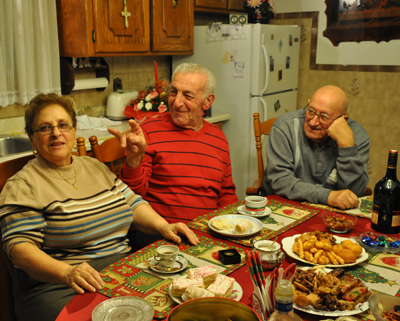
 Christmas Eve dinner is over and before we move upstairs, my uncle makes sure there are 9 dishes left on the table – an old Italian tradition of leaving 9 Christmas Eve dishes on the dinner table so that when the Christ child comes there will be food for all in his retinue.
Christmas Eve dinner is over and before we move upstairs, my uncle makes sure there are 9 dishes left on the table – an old Italian tradition of leaving 9 Christmas Eve dishes on the dinner table so that when the Christ child comes there will be food for all in his retinue.
The meal is always in the downstairs kitchen and dessert is always in the upstairs kitchen. The pic is my aunt and uncle and my dad. My aunt has been going on about not having her pic on the Internet, not that she knows what that means or has ever been near the Internet. (This all started last fall when Connie told her that there was a picture of her online and that it wasn’t a very flattering picture.) So we now tease her about it all the time and I promised to put her pic up online much to her horror. And here it is. My uncle decided to get into the teasing and started making finger gestures at Egilia. (The names in the title are not the people’s formal names, rather the truncated versions used in the family.)
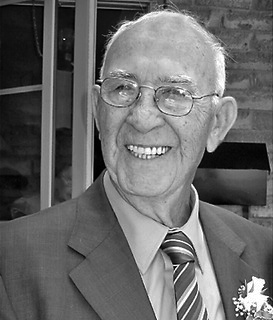
When we came to Sault Ste Marie, there were two families from Aprigliano that my parents were close with, the Belsitos and the Sanguinettis. Cum’amulia e cump’armunte Sanguinetti lived on James Street the old, immigrant neighborhood next to the steel-mill in the west end. And I remember us visiting them in the tall house with the narrow driveway. The Sanguinetti family was Armando, Amalia, Marisa and Joe. I babysat Joe when he was still a child in the crib. I associate the babysitting with reading Burroughs’ Tarzan. It was a thick, hard-cover book. And while Joe slept, I read.
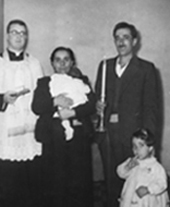 My parents baptized Joe, establishing a formal connection between the Zingas and the Sanguinettis. The thumbnail was taken at Joe’s baptism. Left to right – priest, Mafalda holding Joe, Ciccio holding a candle and Connie. (It’s one of my favorite images of Mafalda.)
My parents baptized Joe, establishing a formal connection between the Zingas and the Sanguinettis. The thumbnail was taken at Joe’s baptism. Left to right – priest, Mafalda holding Joe, Ciccio holding a candle and Connie. (It’s one of my favorite images of Mafalda.)
In June of 72, I met Marisa and Joe in Aprigliano and we spent a month hanging out. They were visiting their grandparents, and I was visiting za teresina e zu milio. It was a vacation for me while I waited for classes, at the University at Perugia, to start – Junior Year Abroad. The best memory from this time is of Joe and I going cherry-picking. We went to the orchards below Portosalvo, climbed the trees and filled a panier with plump red cherries. We were very proud of our efforts, but when we got back to Joe’s grandparents, cum’amulia split the cherries to make sure they were edible and found tiny white worms in all of them. (Joe and I had eaten our fill while picking. Thank God for those strong stomach acids.)
From the three couples, the Belsitos, the Sanguinettis and the Zingas, only 3 remain – Amalia Sanguinetti, Ciccio and Mafalda Zinga. Cump’armunte died Tuesday evening December 24, 2013 – Christmas Eve.
 I always liked cump’armunte. He was the only friend of my parents’ who interacted with me beyond the standard Hello, how are you. He once told me about a run-in he had had with a priest when he was a kid. His disgust played right into my own disgruntled attitude with Mother Church. Other times, we would sit and talk about all that was wrong with Calabria with our beloved Aprigliano. In later years, we would compare notes on the state of modern Italy. He would get out his fact-book on Aprigliano, and I would bring my recent experiences, and we would talk about how them there Apriglianese weren’t making good decisions. If they would just listen to us, after all we had all the answers. I really liked his brash approach, his take-no-prisoners stance.
I always liked cump’armunte. He was the only friend of my parents’ who interacted with me beyond the standard Hello, how are you. He once told me about a run-in he had had with a priest when he was a kid. His disgust played right into my own disgruntled attitude with Mother Church. Other times, we would sit and talk about all that was wrong with Calabria with our beloved Aprigliano. In later years, we would compare notes on the state of modern Italy. He would get out his fact-book on Aprigliano, and I would bring my recent experiences, and we would talk about how them there Apriglianese weren’t making good decisions. If they would just listen to us, after all we had all the answers. I really liked his brash approach, his take-no-prisoners stance.
I did not go visit him those last days in the hospice. I wanted to remember the firebrand, the iconoclast who had been a role-model for a bright kid afraid to let anyone know he was smart. I did not want my last memory of this wonderful man to be that of a cadaver desiccated by cancer. He did not suffer fools gladly and yet he interacted with me.
I am glad to have known him.The titles and italics are in old Apriglianese, our dialect.
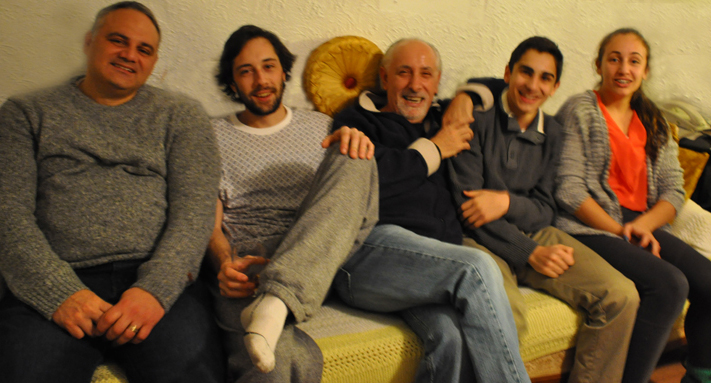

I gave Seane the camera and she shot the group. (I insisted that Alissa join the rowdy boys on the sofa.) There were 20 for Christmas dinner.
We all ganged up on my dad and insisted that he cut down on the food. Gone were the fried shrimp, fried clams, fried baccala and all other fish products. I took care of the turkey, stuffing, the mashed potatoes and cranberry sauce. My parents added soup, lasagne, broccoli salad, rapini, cold green-beans and salad. Dessert consisted of cantaloupe, honey-dew, and fennel. (My dad brought out the wine he’s aged for over three years and everyone drank it, even his son.)
And the gift exchange was minimal.
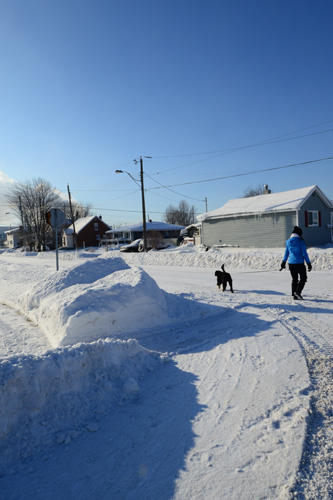
 Seane, Lilly and I went out walking the neighborhood. We’re on Douglas, the street perpendicular to my parents’. The pavement is hidden below the snow-pack and will probably stay out of site for the next couple of months. The snowfall this year has been heavy and early. Already the snow-banks are over 3 feet and winter just started. Yesterday we got 3 additional inches of fresh show. I shoveled my parents’ 30 foot, double driveway, but my dad didn’t like my work and got the man he contract with for snow removal to re-plow.
Seane, Lilly and I went out walking the neighborhood. We’re on Douglas, the street perpendicular to my parents’. The pavement is hidden below the snow-pack and will probably stay out of site for the next couple of months. The snowfall this year has been heavy and early. Already the snow-banks are over 3 feet and winter just started. Yesterday we got 3 additional inches of fresh show. I shoveled my parents’ 30 foot, double driveway, but my dad didn’t like my work and got the man he contract with for snow removal to re-plow.
Boxing Day in the Soo is still fully observed and no stores were open. Merchants in Toronto defy the law and open. They pay the fine and still make a profit on all the shoppers looking for a discount. (It’s Canada’s Black Friday.) According to Wikipedia – Boxing Day is traditionally the day following Christmas, when servants and tradesmen would receive gifts, known as a “Christmas box”, from their bosses or employers. (Isn’t that generous – the upper classes giving to us low people.) Boxing Day is observed in the United Kingdom, Canada, Hong Kong, Australia, New Zealand, Kenya, South Africa, Trinidad and Tobago and other Commonwealth nations. (Will Canada ever give up its connection to good old England?)
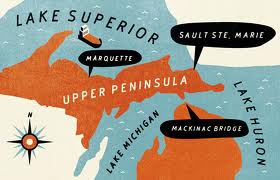
 I think if the drive home in 8 pieces – the UP, the Mackinac Bridge, the Isolation, Gaylord, Grayling, West Branch, Saginaw, the Old Road, Frankenmuth and Birch Run, I-475 through Flint, I-69 East and Michigan 24 to Oxford.
I think if the drive home in 8 pieces – the UP, the Mackinac Bridge, the Isolation, Gaylord, Grayling, West Branch, Saginaw, the Old Road, Frankenmuth and Birch Run, I-475 through Flint, I-69 East and Michigan 24 to Oxford.
1. The UP
Traffic on the International Bridge was heavy and it took me 45 minutes to get through customs. I-75 through the Upper Peninsula is a road in the middle of nowhere. That stretch of the interstate is very pretty and with all the snow a winter wonderland. It’s the beginning of the trip and I tend to be happy about heading home.
2. The Mackinac Bridge
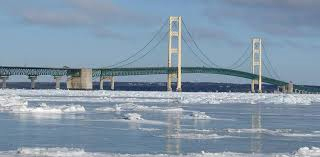 This year, both driving north and on my way home, I rode the outside lanes. These are concrete floorings and less scary than the metal mesh flooring of the inside lanes. However, I have to use tunnel vision and not look to my right. The railing is so low that it looks like you are riding railing-free and the Straights of Mackinac with their swirling waters are just off you right. (Every Christmas as we’re sitting around talking someone brings up a horror story about a car that was blown off the bridge and into the waters below.) The weather had dumped much snow in the area and the middle lanes with their wire mesh flooring seemed slippery and even more scary.
This year, both driving north and on my way home, I rode the outside lanes. These are concrete floorings and less scary than the metal mesh flooring of the inside lanes. However, I have to use tunnel vision and not look to my right. The railing is so low that it looks like you are riding railing-free and the Straights of Mackinac with their swirling waters are just off you right. (Every Christmas as we’re sitting around talking someone brings up a horror story about a car that was blown off the bridge and into the waters below.) The weather had dumped much snow in the area and the middle lanes with their wire mesh flooring seemed slippery and even more scary.
3. The Isolation
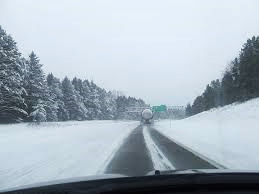 After the Mackinac you enter Michigan’s snow-belt. That the area on the other side of the Mackinac and all the way down to Grayling. The snow-belt has two distinct areas. Between touristy Mackinac City and Gaylord is the most isolated and frightening section. The road is never fully cleared; it’s common to have only one lane of the highway plowed. And even as the land around me looks postcard beautiful, the worry of breaking down in this desolate landscape is also on my mind. Gaylord is the middle of the snow-belt and the beginning of the second section. This part of the winter-land is less forbidding, because you begin to see signs of civilization – gas-stations, rest-stops, fast-food advertisements.
After the Mackinac you enter Michigan’s snow-belt. That the area on the other side of the Mackinac and all the way down to Grayling. The snow-belt has two distinct areas. Between touristy Mackinac City and Gaylord is the most isolated and frightening section. The road is never fully cleared; it’s common to have only one lane of the highway plowed. And even as the land around me looks postcard beautiful, the worry of breaking down in this desolate landscape is also on my mind. Gaylord is the middle of the snow-belt and the beginning of the second section. This part of the winter-land is less forbidding, because you begin to see signs of civilization – gas-stations, rest-stops, fast-food advertisements.
4. Gaylord, Grayling, West Branch and Saginaw
Even though these small towns are in the snow-belt, they are also the beginning of civilization. In Gaylord, along I-75 there are large stands of pine trees with all their lower branches cut. Grayling is insignificant except to note that it is the southern border of the snow-belt. And West Branch is the half-way point of the trip south to Rose-and-Derrick’s. The highway bridge at Saginaw is the official entrance into southern Michigan.
5. The Old Road
Much of I-75 has been repaved, except for the area south and West Branch and almost to Frankenmuth. The lanes are full of ruts and it’s a bumpy ride.
6. Frankenmuth and Birch Run
The area is a shoppers paradise. And I hate it. The only carrot is that the highway becomes 3 lanes.
7. I-475, Flint and I-69
I really hate this part of the trip. It’s side roads to avoid taking I-75 down to Oxford. They are supposed to be shortcuts, but they go through some ugly areas. The i-475 spur through Flint is surrounded by the old city of Flint. The I-69 portion is through sprawling suburbia. This time the ice-storm had covered all the trees and at least that was pretty.
8. Michigan 24 South
This is the last road before Rose-and-Derrick’s. And for three quarters of the way was lined with ice covered trees and bushes. Beautiful.
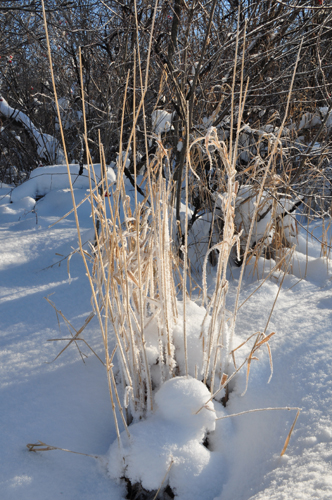
……………………………………………………………………..2014 is a milestone year for me – I get to retire in July.
 The image on the left was taken almost a week ago as Seane and I walked the creek next to old St. Veronica’s school. It was the day after Christmas and the sun made the winter sky blue and the snow bright. White covered everything and glistened in the sharp daylight. The image was my homage to the ice covered wonderland in Southern Ontario.
The image on the left was taken almost a week ago as Seane and I walked the creek next to old St. Veronica’s school. It was the day after Christmas and the sun made the winter sky blue and the snow bright. White covered everything and glistened in the sharp daylight. The image was my homage to the ice covered wonderland in Southern Ontario.
An Italian saying associated with New Year – Natale con i tuoi e Capodanno con chi vuoi. – Christmas with your family, New Year with whom you want. The other saying I think about is what my maternal grandmother – Maria Perri – would tell us: Whatever you do on Capodanno, you will repeat throughout the year. I’ve always spend New Year’s Eve with friends and I’m always conscious of what I do on New Year’s Day, believing that I will repeat those routines throughout the coming year.
Last night, like every other December 31 for the last 30 years, we spent with Jerry-and-Diane and their kids. John and Joanne joined the group a while back so, we are now up to eight for dinner. The meal has two of my favorite dishes – a chicken livers pâté, and Eastern European meatballs. For the longest time it was an all-meat dinner, but the last couple of years a green-beans casserole and a cubed-potatoes and bacon casserole were added to the all-meat menu.
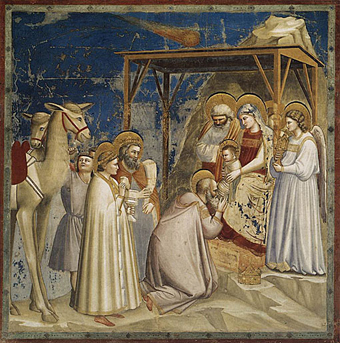
 The impetus for this entry is the magical word twelfth. I can’t spell it, because I have no understanding of how you combine a t, a w, an e, an l, an f, another t and an h into a word. What were them Middle Englishers thinking? And yet I love the contortions the tongue has to perform in order to make the sound. It comes out like an incantation.
The impetus for this entry is the magical word twelfth. I can’t spell it, because I have no understanding of how you combine a t, a w, an e, an l, an f, another t and an h into a word. What were them Middle Englishers thinking? And yet I love the contortions the tongue has to perform in order to make the sound. It comes out like an incantation.
Not to be outdone by them 14th century peoples, I’ve assembled my own contradictions from highfalutin Shakespeare (the post title), and Giotto (the image), to the low-brow Twelve Days of Christmas (the entry title). While using the Catholic feast of the Epiphany to tie them all together.
The pic is Giotto’s Adoration of the Magi. (Giotto’s frescoes remind me of American primitive paintings.) With camels and gifts the three kings have followed the comet – the brown ball at the top of the image – to the stable at Bethlehem. In the fresco, this stable seem to be the end of the road. The oldest king has taken off his crown and kneels before the child. All present watch except for the camel driver who prefers to attend to his animals. (He’s my favorite character in this Medieval pageant.)
The 2013 Christmas season is done. And good riddance. I am so glad to be nowhere near northern Michigan; to not hear anymore carols, holiday greetings, birthday wishes or questions about retirement.
Yesterday, I went over to Rick-and-Sarah’s and we booked our flights to Italy for August.
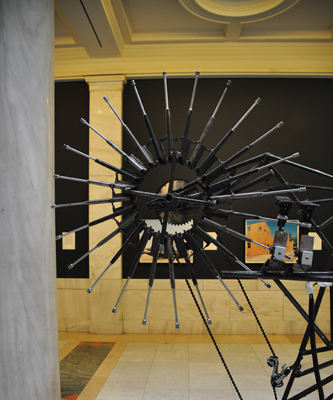
 “. . . string-and-percussion music rises from the room below. The source is an array of eight mechanized sculptures by the Mexican artist Pedro Reyes, made from pistols, assault rifles, machine guns and grenade cases that the Mexican government confiscated from drug cartels.” (Peter Schjeldahl – The New Yorker, October 21, 2013)
“. . . string-and-percussion music rises from the room below. The source is an array of eight mechanized sculptures by the Mexican artist Pedro Reyes, made from pistols, assault rifles, machine guns and grenade cases that the Mexican government confiscated from drug cartels.” (Peter Schjeldahl – The New Yorker, October 21, 2013)
The 2013 Carnegie International has two pieces that I really like – Pedro Reyes’ gun-sculptures (The sunburst on the right is made of gun barrels.) and Taryn Simon’s photographs of all the weapons, vehicles and most of the actresses from the James Bond movies. My favorite image was that of Honor Blackman whose character in Goldfinger is forever hardwired into every 1960’s boy’s brain. The photographs of the Bond women were recently taken and Ms. Blackman now looks like an elegant grandmother. But in my mind she will always be Pussy Galore.
There are two outside pieces, one by British sculptor Phyllida Barlow and one by the Swiss designer Yvan Pestalozzi. The Barlow piece is an immense jungle of boards wrapped with wire mesh, slathered with cement and gray paint and festooned with strips of colored cloth. It covers the space in front of the main entrance and leans against the miserable Richard Serra steel plates. The Pestalozzi piece is playground equipment – a huge, colorful, snaking tunnel with kid-size openings.
It’s not a large show, but many of the pieces are fun and that is not something you can say about most museum surveys.
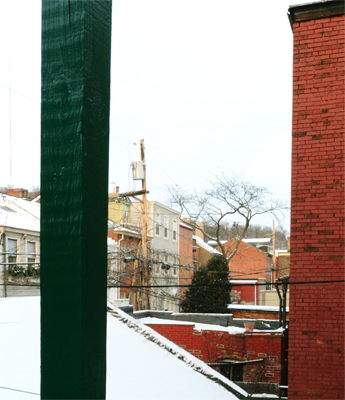
 I’m continuing the quotes from Isaiah, but I don’t think there a Pussy Galore like contradiction out there this time.
I’m continuing the quotes from Isaiah, but I don’t think there a Pussy Galore like contradiction out there this time.
Well, I’m just going to abandon the idea of opposites and make the post about new words being added to the language. Ian Flemming gave us permission to use pussy in polite company and the weather-people are bringing unique words like vortex into everyday parlance. My questions is, can Old Testament Isaiah teach us to not learn war anymore?
There’s a new, unauthorized bio of Roger Eugene Ailes and the book suggests that at Fox News, Ailes made a conscious effort to speak to those people left behind by the pot-smoking hippies – Nixon’s silent majority. And for the last 30 years Ailes and the conservative right have controlled the national dialogue. And they have added to the American lexicon giving us terms like Moral Majority, Right-to-life and Religious Right. I’m wondering if we’ve finally hit a time when the Right will again be eclipsed; when a new progressive movement will push back; when the young will abandon the old guys dream of war.
Took the image on the left at the end of the day. The sun was soft on the rooftops, but I couldn’t capture its hues. Instead I got this vertical contrast between the green porch-post and the red wall. The weather is again frigid and the polar vortex has again descended on the lower 48.
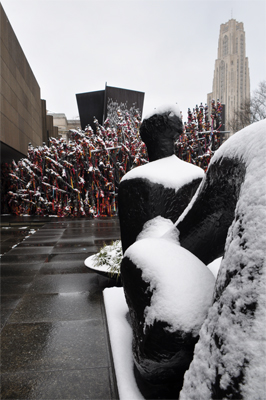
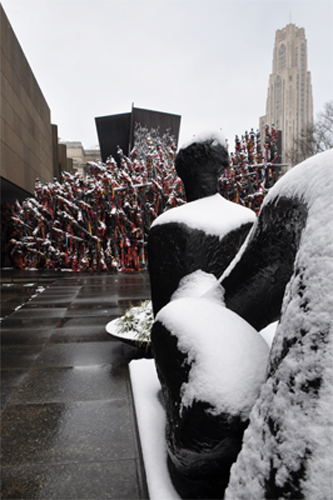 (moore) Reclining Figure, (barlow) Tip, (serra) Carnegie, (left) Scaife Wing, (right) Cathedral of Learning – University of Pittsburgh.
(moore) Reclining Figure, (barlow) Tip, (serra) Carnegie, (left) Scaife Wing, (right) Cathedral of Learning – University of Pittsburgh.
Weather talk is always so cliché, but this has been an incredibly cold month. Frigid temperatures and snowfall have interrupted 25% of our school-days and it looks line next week will get chewed up again by the descent of the Polar Vortex below the 49th parallel.
I used the image on the left more because inside of it is a sense of spring. Barlow’s sculpture suggests growing things. This morning I was thinking about all the snowdrops that I planted in the blueberry beds in the back of the yard. I’m hoping to see some evidence of green in the next 3 or 4 weeks.
The other topic to keep me hopeful through this miserable January is the trip to Italy. This year I’ll be there 3 weeks and for the first time ever, I am not traveling in early August. Three of us are going and we’ll begin in Sicily the first week, travel through Calabria, Basilicata and Campania the second week and then onto Rome for our third week. This will be my first time in Sicily. (I’m not counting the one-day trip to the Aeolian Island of Panarea in 2009.)

 After my experience with doing a bank transfer for a down-payment on the apartment we are renting in Siracusa, I’ve decided to chronicle the planning of the trip to Italy.
After my experience with doing a bank transfer for a down-payment on the apartment we are renting in Siracusa, I’ve decided to chronicle the planning of the trip to Italy.
The bank transfer done, means that I can concentrate on housing for the other two weeks. (The third leg of the trip is Rome and because we’re there for a week, lodging will be easier.) I’m now trying to figure out the middle week and how to divide the time. Rick-and-Sarah want to go to Aprigliano, so we’ll be in southern Calabria for at least 3 days.
The first week, we’re staying in south-eastern Sicily on the peninsula of Ortigia – the ancient city-center of Siracusa. Cicero claimed Siracusa was one of the most important and most beautiful cities of the Greek world. Its grandeur rivaled Athens.
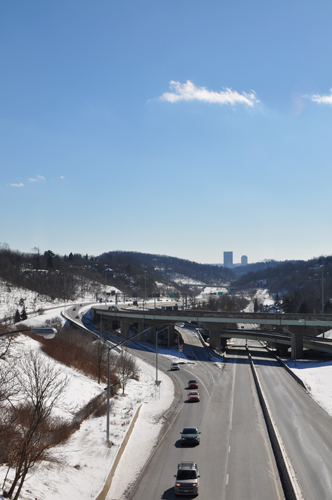
 I shot the image from a bridge over old East Ohio Street. (And I decided to Photoshop all communication towers and light-poles off the horizon.) This is 279 North the modern highway into the North Hills. (The highways in this part of the commonwealth were built into valleys and entrances and exits follow the contours of the rounded Alleghenies. Therefore none have of the supra-structures that one sees in California or Southern Ontario. 279 North is the exception.) The buildings on the horizon are the towers of downtown.
I shot the image from a bridge over old East Ohio Street. (And I decided to Photoshop all communication towers and light-poles off the horizon.) This is 279 North the modern highway into the North Hills. (The highways in this part of the commonwealth were built into valleys and entrances and exits follow the contours of the rounded Alleghenies. Therefore none have of the supra-structures that one sees in California or Southern Ontario. 279 North is the exception.) The buildings on the horizon are the towers of downtown.
I’ve been watching the new HBO series – True Detectives – and have been fascinated by the opening music. Found it online; it’s the song Far From Any Road by the Handsome Family. (Randall Roberts the Los Angeles Times Pop Music Critic calls the song a death dirge.) The title is a line from the song.
We’ve just endured the second Polar Vortex in one month and where the bright blue sky is a great backdrop for an image, in winter a clear sky always means frigid temperatures. Today, the near zero degrees were accompanied by blue skies and cold winds. (The wind on the truncated hilltops that house the big-box-superstores cuts through any insulated poly-mix that is my winter coat.)
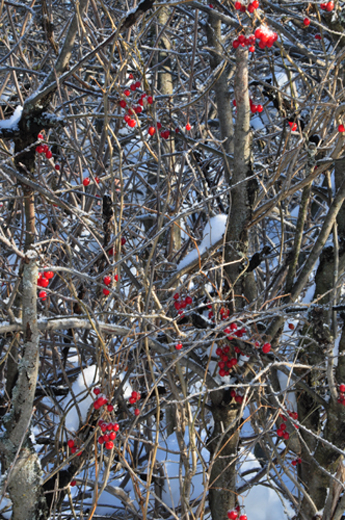
This calendar date has many names. I grew up going to church on February 2nd and having the priest, using two X-crossed candles tied with a ribbon, bless my throat. (My mother always insisted that we get our throats blessed to prevent winter coughs and colds.) It was the feat of St. Blaise. However, this tradition seemed to go away with Vatican II and the feast got re-branded as the Presentation of Jesus at the Temple. When I moved to Pittsburgh it became Groundhog Day using a German legend about winter predictions. Candlemas is more of an Anglican term for the feast-day, but its history also points to predicting the end of winter.
 If Candlemas Day is clear and bright,
If Candlemas Day is clear and bright,
winter will have another bite.
If Candlemas Day brings cloud and rain,
winter is gone and will not come again.
Now Lord you may dismiss your servant
in peace according to your word;
For my eyes have seen your salvation,
which you have set before all the nations,
As a light of revelation to the Gentiles
and the glory of your people Israel.
from Common Compline
Traditionally the Western term Candlemas – Candle Mass – referred to the practice whereby a priest blessed beeswax candles for use throughout the year, some of which were distributed to the faithful for use in the home.

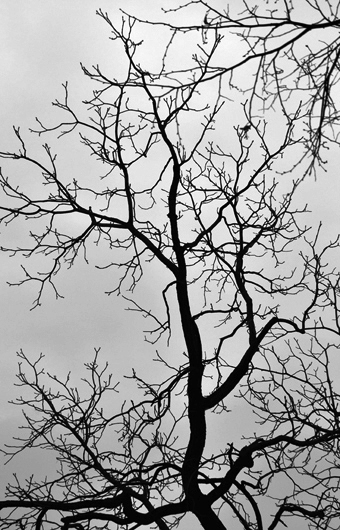 Something’s lost, but something’s gained in living every day.
Something’s lost, but something’s gained in living every day.
I was looking to hear Dave Van Ronk songs and found a video of him singing “Both Sides Now” and that led to listening to Joni Mitchell’s most recent version. I had forgotten that “Both Sides Now” was written by Mitchell. (In my mind it’s associated with Judy Collins.) The old Canadian drops it an octave and makes it a reflection, a lament; gone is the virginal voice; gone is the angel hair, the ice-cream castles, the feathered canyons. The fairy tales have been put to sleep and the grand-children don’t dream of moons or Junes or ferris wheels.
By phrasing “Both Sides Now” with hesitation, as though it were an ongoing thought process, the song is completely divested of its singsongy trappings. Its conclusions – I really don’t know love at all and I really don’t know life at all – becomes devastating confessions of ignorance and failure offered is a weary tone of defeat.
I’m discovering that many of the songs-tracks that I like were not done by the original artists. I had been listening to the commercial singers who had re-recorded these landmarks at the urgings of their handlers and made them into billboard hits, cash cows. For example, I knew “Heard It Through the Grapevine” as a Creedence Clearwater song and then Frank pointed out that it was Marvin Gaye’s anthem. I no longer listen to the pop version, but to Marvin’s voice.
Van Ronk sang his version of “Both Sides Now” 45 years ago. “I may have been the first New Yorker to fall in love with her. She was still living in Detroit when we met. Clouds – Joni didn’t like my tampering with her title for this one. She insisted, justifiably, that the original title – Both Sides Now – be included. Still, though, she did entitle her next album Clouds.” (Dave Van Ronk) Live at Jabberwocky Club – Syracuse, NY – February 1969
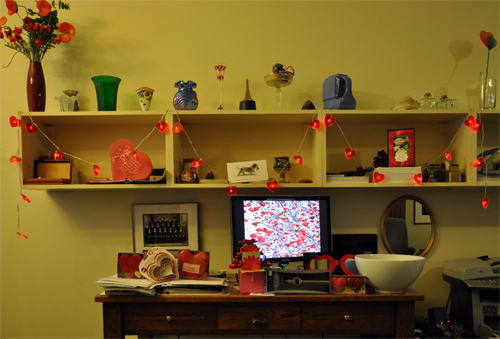
Nothing is reliably known of St. Valentine except his name and the fact that he died on February 14
on the Via Flaminia in the north of Rome. In Le Marche on our way in and out of Fossombrone,
we travel the state highway – Strada Provinciale 3, SP3 – that parallels the old Roman road.

This year the Valentine gifts were reduced, intentionally. And yet, I came down this morning and my office space was all dark except for this red glow. A string of chirtmas-tree-like-lights, with heart shape illuminations, was strung across my desk. And a French porcelain bowl sat next to my keyboard. There were other hear-shaped objects scattered on my desk.
I am more interested in the fact that February 14 marks the beginning of the last leg of winter.
I’m counting the days until the spring equinox.
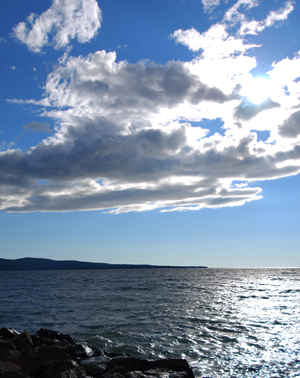

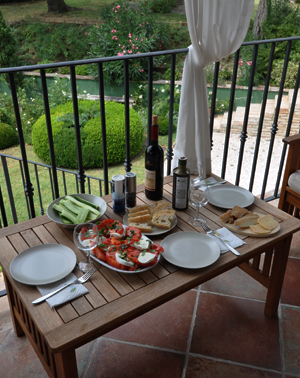
I’ve been listening to a group of Canadian artists – Joni Mitchell, Leonard Cohen, Gordon Lightfoot – and I’m surprised by the recurring language, themes, ideas. All talk about nature as landscape, nature as character. Mitchell talks about a river to skate away on; Cohen talks about hair on a pillow like a sleepy golden storm; Lightfoot sings about pussy-willows, cat-tails, soft winds and roses.
My own writing is full of winters, of big skies, of autumn landscapes, of sunsets and early mornings. My references are about the rhythms of rain, the winds of November, the closings of a December snowfall. I was born in Calabria, but I found the voice that I write in in Northern Ontario.
My sensibilities on the other hand are strictly Italian. (The image I wanted to use for the right was one in which the title – Partito dei Communisti Italiani – was pasted above a self-reflection in an announcement window.) I am an iconoclast and I always attribute that to my Italian ancestry.
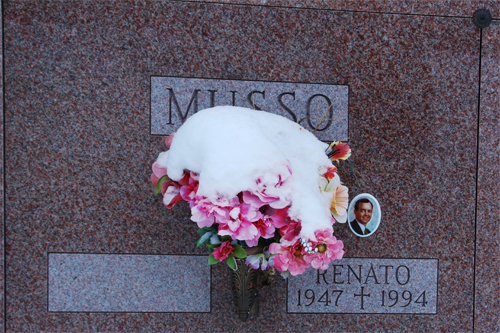
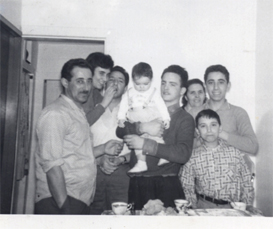 Lately, I’ve been thinking a lot about the kids I grew up with. Renato was one of the Musso children. The photo on the left was taken in 1964. (left-to-right — Ciccio Zinga, the Sirianni – Connie and Frank, Renato holding my sister Jo’, Saveria Musso, Mario and Frank Musso.) The Musso family had recently arrived from Aprigliano. They were from La Grupa the neighborhood that my dad was from. They were his friends, but in Sault Ste Marie they became part of my extended family.
Lately, I’ve been thinking a lot about the kids I grew up with. Renato was one of the Musso children. The photo on the left was taken in 1964. (left-to-right — Ciccio Zinga, the Sirianni – Connie and Frank, Renato holding my sister Jo’, Saveria Musso, Mario and Frank Musso.) The Musso family had recently arrived from Aprigliano. They were from La Grupa the neighborhood that my dad was from. They were his friends, but in Sault Ste Marie they became part of my extended family.
Shortly after their arrival, Lena, the oldest of the Musso children, was engaged and getting ready to marry. Renato immediately went off to work. (He and my dad got along real well. They were young men in a foreign land working construction.) Frank and I were in school. I was at St. Theresa and Frank was at St. Joseph.
Frank Musso and I looked up to Renato, he was the big brother interacting with the world. We would follow him around, listening to his stories; eyes big with wonder. He was the bridge between the world I had left behind and the brave new world that was Canada. He had left the childhood of the school-house behind and was out there in the world of work, in the world of English speaking people. When he came home after a long day, Frank and I listened to his stories. (We followed him around every chance.) He would come home, go up to his room to change out of his work-clothes and we followed hoping for a story. And he would tell us what it was like out there, in those places where we couldn’t go. School seemed so tame, so ordinary compared to his adventures in the adult world. I envied his experiences, his privileged position at the kitchen table. I envied his apprenticeship with my dad, his camaraderie with Ciccio, their easy laugh.
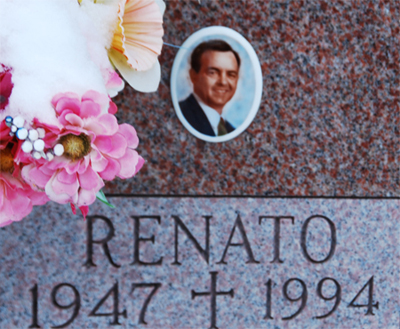 In the last couple of months, I’ve touched base again with Frank Musso, Marisa Sanguinetti and Joe Sanguinetti. We coalesced around the death of Armante Sanguinetti, Marisa’s and Joe’s dad. And today, I went looking for the image I shot of Renato’s grave-marker.
In the last couple of months, I’ve touched base again with Frank Musso, Marisa Sanguinetti and Joe Sanguinetti. We coalesced around the death of Armante Sanguinetti, Marisa’s and Joe’s dad. And today, I went looking for the image I shot of Renato’s grave-marker.
I look at the image on the right and I’m shocked, truly disturbed. He was only 2 years older than me. And at 47, he died of an inoperable, cancerous brain tumor. What the … What am I supposed to do with the big brother memories? How do I understand that he had to be a grown-up while I got to sit in a classroom and draw in my notebook? How do I re-align the remembrances? How do I find empathy for the young man who never got to grow his hair long, never got to go to Uni, never got to sneak a joint?
How can I envy his camaraderie with my dad, their easy laugh?

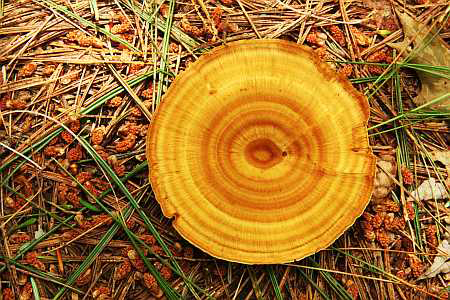 Lately, I’ve been thinking about the group that I grew up in when living in Northern Ontario. For me, the Apriglianese Group of my youth can be best represented by a series of concentric circles. At the core were the Zingas, the Perris and the Mutos. These are my family, my grandparents, my uncle and aunt. In the next ring were the Belsitos, the Sanguinettis and the Mussos. These three families were from Aprigliano and friends of my parents. These are the people in the old black-and-white pictures, the people at the birthday celebrations, the people from the Christmas holidays. (Christmas gifts for me and my siblings came from my parents, my grandparents and my aunt-and-uncle. But the adults of the extended-family also exchanged gifts among themselves. There was a lot of effort to make certain the gifts the adults exchanged were of equal value, of equal prestige. I remember my mom opening up the gifts from her friends before Christmas. Jo’ and I were shocked by this save-face behavior.)
Lately, I’ve been thinking about the group that I grew up in when living in Northern Ontario. For me, the Apriglianese Group of my youth can be best represented by a series of concentric circles. At the core were the Zingas, the Perris and the Mutos. These are my family, my grandparents, my uncle and aunt. In the next ring were the Belsitos, the Sanguinettis and the Mussos. These three families were from Aprigliano and friends of my parents. These are the people in the old black-and-white pictures, the people at the birthday celebrations, the people from the Christmas holidays. (Christmas gifts for me and my siblings came from my parents, my grandparents and my aunt-and-uncle. But the adults of the extended-family also exchanged gifts among themselves. There was a lot of effort to make certain the gifts the adults exchanged were of equal value, of equal prestige. I remember my mom opening up the gifts from her friends before Christmas. Jo’ and I were shocked by this save-face behavior.)
In the cump’armunte journal post, I wrote about Armante Sanguinetti, and that with his death only his wife and my parents remain in that group of friends from Aprigliano. The generation that left Calabria is fading, but they leave behind their children.
There were 14 children in the extended-family. (They are listed vertically – oldest to youngest.)
Three have died.
| Zinga Family | Muto Family | Sanguinetti Family | Musso Family | Belsito Family |
| Mario | Rose | Marisa | Lena | Angie |
| Connie | Mary | Joseph | *Renato | Mimmo |
| *Jo’ | Frank | Gianni | ||
| *Antonino |
* My sister Jo’ died June 30, 2001; Renato died September 6, 1994; and Antonino died January 22, 1994.
Connie, Marisa, Lena, Frank, Angie and Mimmo still live in Sault Ste Marie. I’m in Pittsburgh; Rose is in Oxford, Michigan; Mary is in Pickering; Joe is in Mississauga; and Gianni is in Michigan’s UP. Surprisingly, I still interact with many of these next generation off-springs. (The only ones I do not see are Lena Musso, but then she was a bit older than the rest of us and once she married Bernardo Fragomeni, we began to travel in very different circles. And I haven’t seen Gianni Belsito in years.)

I went out into the backyard and there on the horizontal post were the mourning doves. They had come back.
But their nest in the Mulberry tree was long gone. The winter winds scattered the loose twigs.

Mourning doves mate for life. Is the one on the right the female? And is she ready to nest?
This morning I went looking for the snowdrops, but found no evidence of spring. In the side-yard, the early Galanthus would poke their heads above the snow-cover and remind me that long winter was waning. This evening the mourning doves soothed my disappointment. In the soft setting sun, their coos announced the fledgling season.
The dove posting from last year is dated May 9 and here they are back two months early.
I was in a monastery garden in Cambridge Mass when I spotted a regiment of snowdrops rigid against the basement wall. Seeing them reminded me that I had lost my bulbs in the dig for the new sewer. The heralds of spring were silenced when the flower-bed on the side of the house was demoed in order to dig down to replace the terracotta pipes that drained the sink, the toilets, the bath. So last October, I replanted fifty bulbs hoping to regrow my heralds. I planted them among the blueberry bushes and while I was at it, I buried tens of crocus bulbs in the same bed.
It never occurred to me that the mourning doves would announce the new spring.
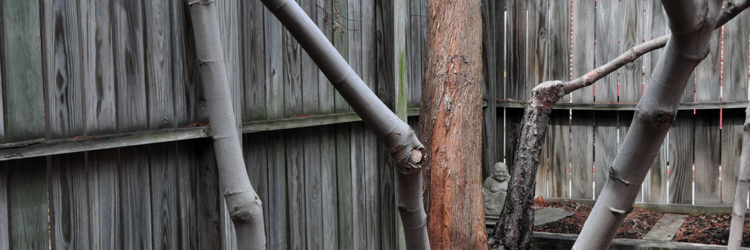
Today, the tilt of the Earth’s axis is inclined neither away nor towards the sun. And the sun rose exactly in the east
and it will set exactly in the west. The word equinox is derived from the Latin words meaning equal night.
horizontal 2by4s, vertical fence planks, angular fig-trees, straight redwood, gnarly pine trunk and 6by6 wolmanizeds
The above image is so complex that I had to use it. I’m shooting manual, because it was the only way to get the Buddha in focus and produce a deep perspective. The flowerbed in the back and on the right holds the bulbs I planted last fall: they stir in the cold earth: but the fleur de lis, under the Buddha, wont wake for another month. Yesterday I saw the first sprouts, I think they’re crocus. The snowdrops take a year to become established so, I may not have any flowers this year.
The post-title is from Truffaut’s La nuit américaine and I’m using it to suggest an equal length of day and night. (The French expression nuit américaine – American night – refers to a technical process where scenes filmed outdoors in daylight are shot using artificial light or infrared film-stock and then underexposed or dimmed during post production to appear as if the scenes are taking place at night. In the English-speaking world the film is known as Day for Night, which is the English expression for the process.)

Frank and I went to Palm House, a Victorian conservatory in Allen Gardens in old Toronto. Outside the conservatory a mural surrounded a construction site. The first time I saw this type of art – images of native people and native themes in bold cartoon-like colors – was in the late 60’s. It looks like pop art – modern American art styles applied to Canadian history. And fifty years later, government agencies across the Commonwealth sponsor this art format in schools, in libraries, in community centers, on subway platforms, on construction murals.
What amazed me most on this trip, was the scale of the buildings in old Toronto and at the University of Toronto. (The modern city is littered with glass supra-structures whose panels still fog in the bitter temperatures.) Palm House and the various colleges that make up U of T are from a different time, from a different sensibility. The old buildings fit in their surroundings. They are of a human scale and walking through the common grounds is such a non-Canadian experience. (Modern Toronto and modern Canada are void of people-friendly environments. The city and country are designed for cars, for suburban landscapes. Southern Ontario is the Los Angeles of Canada.)

Last weekend, the compost layer on the back-yard flowerbed was brown and wet and I resigned myself to not seeing any flowers this spring. Then yesterday, after two days of rain, cold and grey, the crocus and snowdrops sprouted. (I’ve been looking at the crocus in other people’s yards with envy. And I so want snowdrops back in my garden.)
By Sunday morning, the closed buds in the above image, opened and revealed white petals. (There’s an image of the open flowers in the slide show.) I had forgotten that I had planted white crocus bulbs. I kept expecting purple flowers. Am glad for the surprise. The purple crocus in the slide show are from Diane’s garden. Then last night on our way home, I noticed, around the base of a Sycamore up the street from the Halperns, a cluster of crocus . I went back this morning and, in the early light, shot the flowers.
The grape hyacinths and the pink cyclamens are from the greenhouse in Allen Gardens in old Toronto.
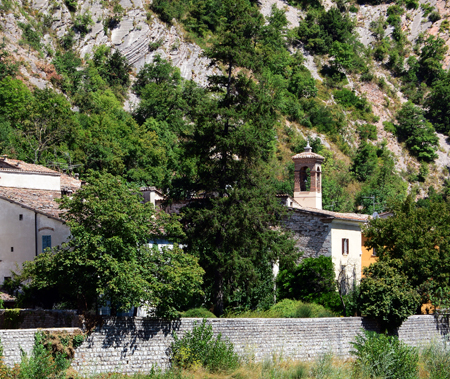
 The last three years, I’ve been in Kaua’i during April break and this year I’m heading back north to Sault Ste Marie. The last time I was there in April was 2010. I had my new Forester with its manual transmission. (I was figuring out how to be comfortable with a stick so that when in Italy I didn’t have to add driving anxiety to my list.)
The last three years, I’ve been in Kaua’i during April break and this year I’m heading back north to Sault Ste Marie. The last time I was there in April was 2010. I had my new Forester with its manual transmission. (I was figuring out how to be comfortable with a stick so that when in Italy I didn’t have to add driving anxiety to my list.)
The Christmas 2013 posts used the O Antiphons as titles. I’m going to try and use the Regina Caeli antiphons for this Easter 2014 set. And to compliment the old Latin title, I’m using the image of the bell-tower of the church in the old section of Piobbico. Through the trees and with its mountain background the setting too is evocative of a long ago time.
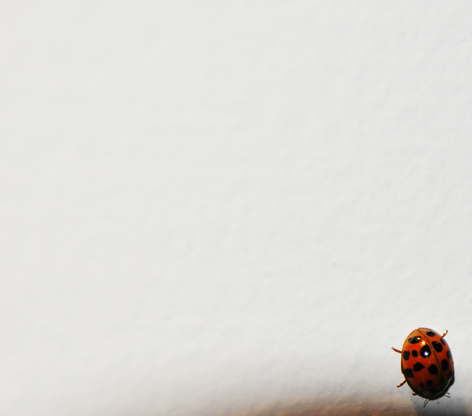
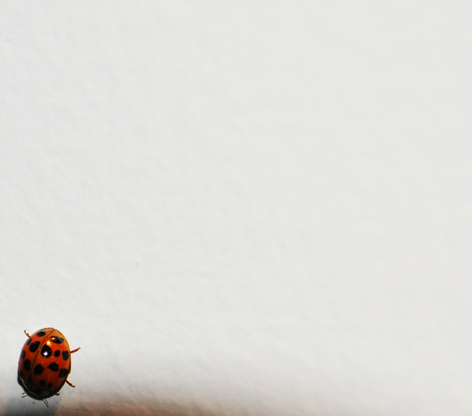 On my way up to the Sault, I decided to take a different route and stop in at St. Gregory’s Abbey south of Kalamazoo. I knew of the place from my visits to the Episcopal community of monks in Cambridge. (One of the Christian Brothers I’ve been working with, on charter school issues, suggested we meet there to follow-up on our conversation.) The group in Michigan lives in a rural setting in the middle of the farming belt that runs through Ohio and Indiana.
On my way up to the Sault, I decided to take a different route and stop in at St. Gregory’s Abbey south of Kalamazoo. I knew of the place from my visits to the Episcopal community of monks in Cambridge. (One of the Christian Brothers I’ve been working with, on charter school issues, suggested we meet there to follow-up on our conversation.) The group in Michigan lives in a rural setting in the middle of the farming belt that runs through Ohio and Indiana.
The monastery is very simple, but very well cared for. The community of monks is small and reminded me of what the isolated monasteries in Europe must be like. The community at St. Gregory is even closer to the Catholic Benedictine tradition, using Latin hymns and prayers. My visit was brief, because the weather was turning miserable. This morning was cold, wet and windy and rather than stay the day, I headed north wanting to do the drive in daylight and hitting the UP mid-day rather than after the sun went down. Didn’t want to risk icy roads and blinding snow. (I am not exaggerating, the landscape 30 miles south was a winter wonderland.)
The image is of a ladybug on the wall of the guest house hallway. I couldn’t believe that in early April a ladybug was out and about. And a ladybug indoors meant good luck, so I had to shoot it. The original image was not good, but I knew that by cropping off most of it, I could create an interesting picture.
I had forgotten how variable April can be in the northern climates. The temperature here is in the 20’s and it’s snowing. Down in Pittsburgh it’s almost 70 degrees.
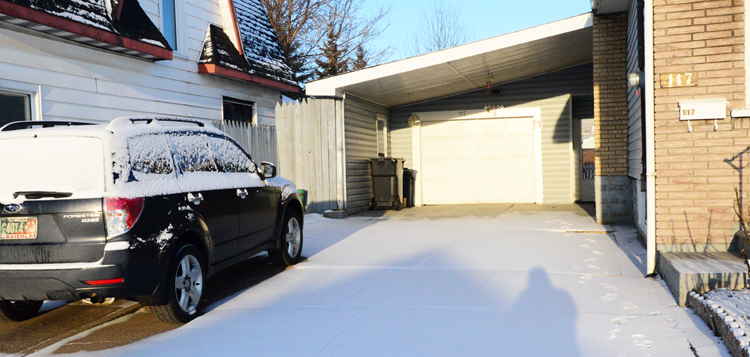
The image is of my parents’ driveway this morning. This will be the last time that I will voluntarily come up here in April. If I come up to visit in the spring, it will be after mid-May. Coming back to winter is depressing.
Today, I finally went up to the Board of Education hoping to find a trove of old photographs of the elementary schools from back in the late 50’s. Found nothing. The Catholic Board is housed in the old convent of the Sisters of St. Joseph. The all-girls high-school – Mount St. Joseph College – next door is the curriculum department. Walking into the door of the old high-school was like going through a time warp. The lobby has had no renovations done to it. It still looks like it did back in the early sixties. Here was a location that I spent many hours in while at St. Mary’s, the all-boys high-school. The Mount was our sister school and we had many dances together. (For one semi-formal, I helped to decorate. I had this idea of hanging streamers from wires strung across the gym. It was lots and lots of yard-long streamers and one of the other guys helping got all pissed at my insistence that they be one yard long. That was the last time I ever volunteered to have anything to do with school dances. To this day, I avoid school dances.)

In the open/liberal days of the 60’s the separations and restrictions of the previous decades were beginning to fade away. By the time Jo’, Rose and Mary were at the Mount, the boys from St. Mary’s were coming over to take classes at the all girls’ school.
The visit had me thinking about all the generational shifts that I’ve seen. I began as a young man believing that the structures and agencies that I had grown up with were worth joining and embracing. The structures were provided by the Catholic Church, so I went off and joined a group of teaching Brothers. What I found when I got there was a group going through a generational shift and I saw the organization and Catholic education radically change. The structures and agencies fell apart as the modern world exerted itself on the old order. Little by little the world that I had grown up in disappeared. The Church and the immigrant community were radically altered. All the familiar sign-posts fell down and new ones could not stay up in the quicksand that was the late 60’s and early 70’s.
I went from a hill-top village in Calabria, to a steel-mill town in Northern Ontario, the a monastery in Rhode Island, to a college in the center of the world – NYC – all in 13 years.
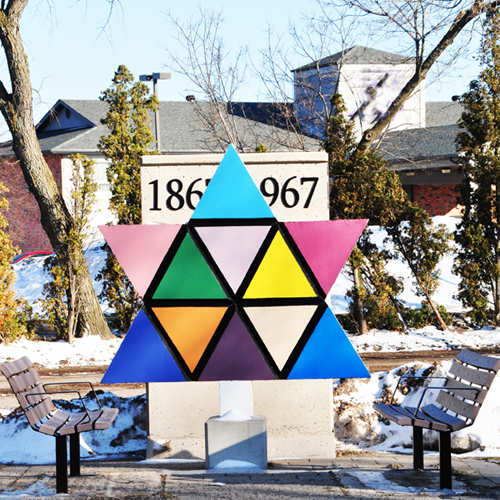
Yesterday, I wrote the first of a set of posts that deal with generational shifts. The idea came when I opened the door to the old Mount and walked in to find the lobby looking just like it did back in the late 60’s. The school is now part of the offices of the Catholic School Board. (In Ontario, the Catholic school system is known as the Separate Schools. It receives almost total government support through an agreement between the Federal Government and a number of influential Church officials back in the 1890’s.)
I keep thinking of how one generation, while it’s still young, accepts the beliefs and cultural norms of its parents’ generation. I believe I accepted the beliefs and cultural norms of my parents’ generation. I grew up in a world created by their parents, my grandparents and I had no true idea of the legacy that I was living in and adopted.
It was many years later that I realized my parents were war refugees. Not in the same way that my grandparents’ generation was. My grandparents left Italy between the wars. My parents left Italy after the war. And yet both groups were motivated by the wars. My grandparents ran from persecution and conscription, my parents ran from economic disaster and great food shortages. But it took me years to see my parents’ departure as connected to the war.
In elementary school in Aprigliano, I remember watching films about undetonated land mines, but it wasn’t until I was in my 50’s that I connected the dots and realized that my parents were children of the war. And that they left their native land and the memories of war behind when they came to Canada. I’ve read about concentration camp survivors who never talked about their experiences when they got out of Europe.
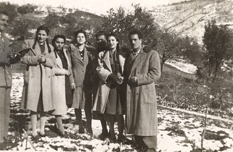 My parents never talked about the war. I was raised to believe that we left Calabria, because of economic reasons; that my dad left Calabria to find work and cash in on the benefits that came from a steady job. And yet my parents grew up in the 40’s. They were teenagers when Hitler marched through Europe; when Mussolini harangued the crowds from the stone balustrade, which overlooks Piazza Venezia. And yet not a word was uttered. Instead I saw pictures of Aprigliano, of their friends in long, elegant coats. (Mafalda is third from the left.) I remember wanting to look like them. And BTW, I have two long elegant coats of my own.
My parents never talked about the war. I was raised to believe that we left Calabria, because of economic reasons; that my dad left Calabria to find work and cash in on the benefits that came from a steady job. And yet my parents grew up in the 40’s. They were teenagers when Hitler marched through Europe; when Mussolini harangued the crowds from the stone balustrade, which overlooks Piazza Venezia. And yet not a word was uttered. Instead I saw pictures of Aprigliano, of their friends in long, elegant coats. (Mafalda is third from the left.) I remember wanting to look like them. And BTW, I have two long elegant coats of my own.
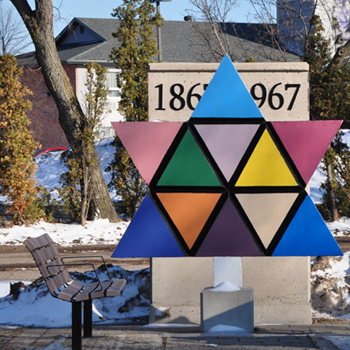 In 1968 at 17, I left Sault Ste Marie believing that I was joining an organization that would set me on a path that was consistent with the values that I had learned in my parents’ home. I was joining a group of Brothers who dedicated themselves to teaching. I was maintaining both a religious tradition and an educational imperative. However, when I got to the Novitiate in Rhode Island, I discovered a group a men on the cusp of reform. Religious traditions and educational imperatives were old fashion; I was told that I belonged to a new generation. I was told to not trust anyone over 30. And so began the shift. I had permission to walk away from what I had learned while living in my parents’ house; while living within the immigrant community in Sault Ste Marie. Like my parents who forget to tell us about the war; I could forget my Catholic upbringing; forget my immigrant roots. I could grow my hair long; wear bell-bottoms; toke a joint. The moon was in the seventh house and the sun would shine onto the post-war world; there would be no more falsehoods or derision.
In 1968 at 17, I left Sault Ste Marie believing that I was joining an organization that would set me on a path that was consistent with the values that I had learned in my parents’ home. I was joining a group of Brothers who dedicated themselves to teaching. I was maintaining both a religious tradition and an educational imperative. However, when I got to the Novitiate in Rhode Island, I discovered a group a men on the cusp of reform. Religious traditions and educational imperatives were old fashion; I was told that I belonged to a new generation. I was told to not trust anyone over 30. And so began the shift. I had permission to walk away from what I had learned while living in my parents’ house; while living within the immigrant community in Sault Ste Marie. Like my parents who forget to tell us about the war; I could forget my Catholic upbringing; forget my immigrant roots. I could grow my hair long; wear bell-bottoms; toke a joint. The moon was in the seventh house and the sun would shine onto the post-war world; there would be no more falsehoods or derision.
The image is the Canadian centennial symbol. Back in the late 60’s they built the library that I am now doing work in as a commemoration of Canada’s 100 birthday. I remember coming down to the library when we were in high-school and pretending to do homework when in reality we were hanging out in the new building.

This is the last of the Marian antiphons.
I am back at Rose-and-Derrick’s in Oxford, Michigan.
Thursday morning, I woke up to the sound of the snow-blower. There was Ciccio, at seven in the morning, running the snow-blower; there were 4 inches of snow in the driveway. I went out and helped. It was the wet-snow typical of mid-April and even though it was disconcerting to be plowing the driveway in early spring, by the afternoon the snow had all melted. Friday morning, I left. I had escaped from Sault Ste Marie. Paul claims that I really escaped many years ago, but each time I cross over into Sault, Michigan I feel like I got away, again.
This morning Rose, Derrick and I went walking and there was this huge day-moon in a blue-blue sky. We spend the afternoon on the back deck in the sun. I even got a bit of color. Supper was phenomenal – home-made lasagna, breaded chicken, rapini, grilled potato wedges and a wonderful Barbera red from northern Italy. (The day makes it feel like I’m back in a world I recognize.)
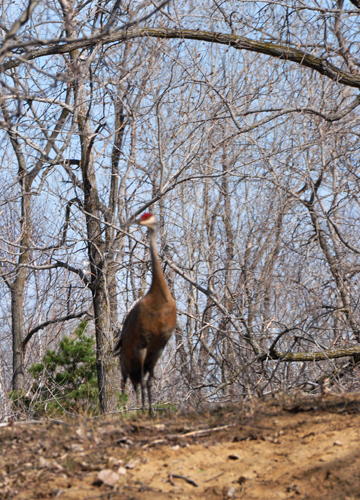
 We called up to the Sault to wish them Happy Easter and the reply was – too bad we were on our own. What does that mean? Is there a magic number of invitees that suggests you aren’t a social failure when hosting Easter brunch? The coda to the too bad statement was the suggestion that we should have been with the rest of the family. Never mind that the weather in the Sault is rain and grey skies; never mind the 10 hour drive. (It’s at these times that I sit back and admit that with regards to family gatherings I have little in common with my parents.)
We called up to the Sault to wish them Happy Easter and the reply was – too bad we were on our own. What does that mean? Is there a magic number of invitees that suggests you aren’t a social failure when hosting Easter brunch? The coda to the too bad statement was the suggestion that we should have been with the rest of the family. Never mind that the weather in the Sault is rain and grey skies; never mind the 10 hour drive. (It’s at these times that I sit back and admit that with regards to family gatherings I have little in common with my parents.)
Easter brunch was great, there was ham, asparagus and frittata with chives, mushrooms and green onions. We began the meal, after our two hour walk, with Mimosas. We needed something to do while waiting for the ham to heat.
Our walk took us past a tall red-headed heron and a cardinal eating left over winter berries. The heron is in the image on the left; the cardinal is in the slide show. The trail is the old rail line that went through this part of south eastern Michigan. Once off the walking path, we continued through old Oxford with its renovated old houses. The new sub-divisions are on the western side of M24.
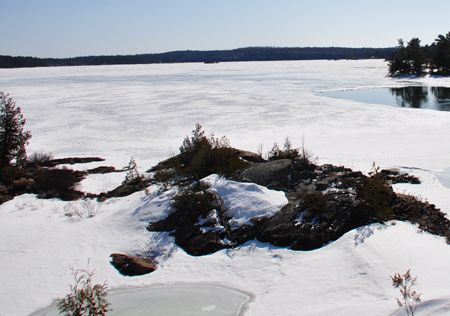
 The image is of the north channel. I’m standing on the St. Joe’s Island side of the bridge facing east and shooting towards the mainland – Northern Ontario. The channel has one of the fastest currents in the Great Lakes system and that’s why you can see open water. The other side of the Island faces Lake Huron; this far north, the Lake is a solid sheet of ice.
The image is of the north channel. I’m standing on the St. Joe’s Island side of the bridge facing east and shooting towards the mainland – Northern Ontario. The channel has one of the fastest currents in the Great Lakes system and that’s why you can see open water. The other side of the Island faces Lake Huron; this far north, the Lake is a solid sheet of ice.
Easter Monday officially ends the season. In Canada and among the Italian expatriates in Sault Ste Marie, Easter is still a big to-do. My family, minus Mario, the Thormans, Melchiorres and McCaigs, had their Easter celebration at lunch. (My dad couldn’t understand that here in the U.S. the holiday is exclusively religious and not recognized by any government entity.)

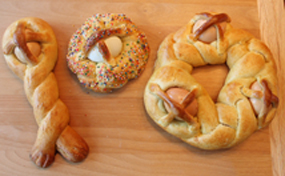 There are two foods that I associate with Easter – the Mylar-wrapped chocolate eggs and the home-made breads with an egg imbedded in the braids. The chocolate eggs were tall, shinny and crinkly; they also had a small toy inside. Ciccio would buy each of his children one of these and give them to us on Easter Sunday. I remember the breads as wonders – because I was too young to understand that the egg cooked while the bread was in the oven, I kept expecting to tap the egg and have it still be raw. My mother still makes the braided Easter bread both the long and the round. However, in post-war Calabria there were no Jimmies to sprinkle on top of the Easter breads. And Mafalda would never blemish her Easter bread with something as American as Jimmies.
There are two foods that I associate with Easter – the Mylar-wrapped chocolate eggs and the home-made breads with an egg imbedded in the braids. The chocolate eggs were tall, shinny and crinkly; they also had a small toy inside. Ciccio would buy each of his children one of these and give them to us on Easter Sunday. I remember the breads as wonders – because I was too young to understand that the egg cooked while the bread was in the oven, I kept expecting to tap the egg and have it still be raw. My mother still makes the braided Easter bread both the long and the round. However, in post-war Calabria there were no Jimmies to sprinkle on top of the Easter breads. And Mafalda would never blemish her Easter bread with something as American as Jimmies.
I spent most of the today on the road, driving home from Oxford. I left early this morning and was home by noon. Michigan-24 was heavy with commuters heading to their suburban offices, but 75 South and the Ohio and Pennsylvania Turnpikes had little traffic; I was able to maintain a speed above 75mph.
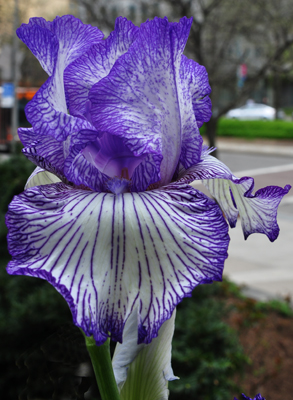
 I’m walking the concrete paths through Gateway Center and come upon a group of planters filled with purple iris. Now, it’s way too early for this rhizome, but then the new local restaurant wants to attract customers so why not decorate with these giant flags.
I’m walking the concrete paths through Gateway Center and come upon a group of planters filled with purple iris. Now, it’s way too early for this rhizome, but then the new local restaurant wants to attract customers so why not decorate with these giant flags.
During World War II, city officials created plans to redevelop the dense and blighted forks of the Ohio River into both Point State Park and a gateway of office buildings. It was announced as fully financed on September 21, 1949 when the Equitable Insurance Co. of New York agreed to underwrite the project after securing lease agreements from Westinghouse, Mellon Financial and other major corporations. Eggers & Higgins, architects on the Thomas Jefferson Memorial, were the architects for the first three buildings, One, Two and Three Gateway Center.
Today Gateway Center is one of Pittsburgh premier office complexes and an amazing example of human-friendly urban design. The office complex has an 87% occupancy rate.
Point State Park is located at the confluence of three rivers – the Monongahela, the Allegheny and the Ohio. The park commemorates and preserves the strategic and historic heritage of the area during the French and Indian War. 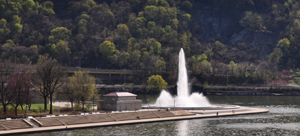 Once a busy industrial zone, the area had deteriorated into a commercial slum by the 1940s. The development of a state park was authorized in 1945 and the first parcel of the 36-acre property was purchased the next year. The park was completed and dedicated in 1974. The fountain at the confluence-point is one of it’s most spectacular feature. Also in the park are a granite tracery of the original French fort, the Portal – a great archway and entrance to the park under the I376 highway, the Fort Pitt Museum and the Fort Pitt Blockhouse. The Blockhouse is the only remaining structure from the colonial fort. It also served as the western headquarters of the Continental Army during the American Revolution.
Once a busy industrial zone, the area had deteriorated into a commercial slum by the 1940s. The development of a state park was authorized in 1945 and the first parcel of the 36-acre property was purchased the next year. The park was completed and dedicated in 1974. The fountain at the confluence-point is one of it’s most spectacular feature. Also in the park are a granite tracery of the original French fort, the Portal – a great archway and entrance to the park under the I376 highway, the Fort Pitt Museum and the Fort Pitt Blockhouse. The Blockhouse is the only remaining structure from the colonial fort. It also served as the western headquarters of the Continental Army during the American Revolution.
In June, Gateway Center and the Point Park are filled with suburbanites, out-of-towners and Pittsburghers as the Three Rivers Arts Festival uses the plazas, walk-ways and lawns to showcase a contingency international and local artists. And many of the best working crafts-people come from across the country and Canada to display their work at the annual event. The 1990 Three Rivers Festival was full of controversy.
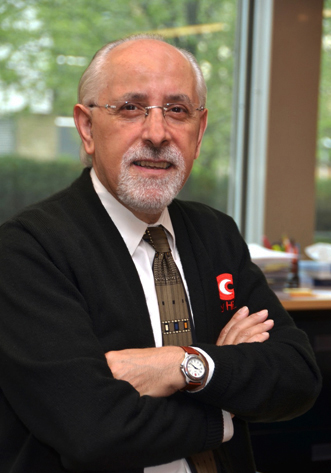
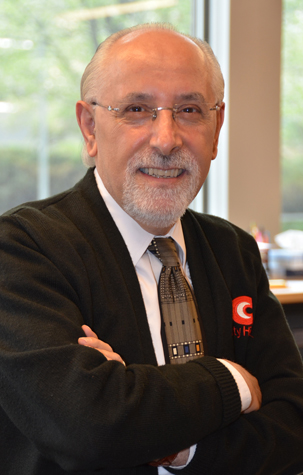 As an adult, I’ve never had a professional do a self-portrait until today. Laura Sheldon my friend and professional photographer did a great job, so much so that I’m willing to post it. She told me how to sit, how to pose and where to look; and I followed her directions. I guess if you want to look good it pays to listen to the professional.
As an adult, I’ve never had a professional do a self-portrait until today. Laura Sheldon my friend and professional photographer did a great job, so much so that I’m willing to post it. She told me how to sit, how to pose and where to look; and I followed her directions. I guess if you want to look good it pays to listen to the professional.
It’s 10:20 am; I am in our office, sitting on the table that we all sit at for meetings. The windows behind me look onto Gateway Center Park. I’m wearing a City High sweater; and my kids, the 12th graders, told me that the Fran Lloyd Wright tie was, so Zinga-esque. (Yes, the bright ones know how to add e s q u e to a noun to make an adjective.) BTW, it was Laura’s idea to cross my arms.
Part of the reason I’m willing to post the image is that I like it. As I tell my kids, I’m only going to sign off on images that I look good in. And, I can just hear all my adult friends saying, that’s so Italian. It is, and I have no shame owning that.
I titled this post selfie and Wikipedia describes a selfie as a self-portrait photograph, typically taken with a hand-held digital camera or camera phone. Forget the self indulgence, low res of a cell phone, I had a professional take this selfie. The Italian expression is fare una bella figura. And I adhere to that maxim of always presenting oneself in a good light. I’m 65, why not look good; why not make a bella figura.
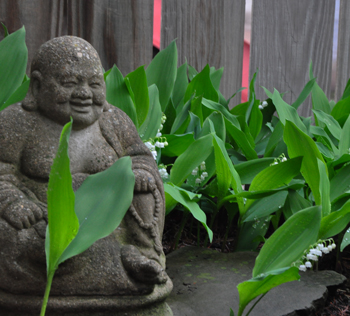
 The Lilies of the Valley are among my favorite late-spring flowers and this year they filled the corner flower-bed. (It’s too bad that the flowers came out just as I was in the middle of an allergy episode. Getting near the flowers or bringing some into the house was not possible unless I wanted to have an even more severe reaction.)
The Lilies of the Valley are among my favorite late-spring flowers and this year they filled the corner flower-bed. (It’s too bad that the flowers came out just as I was in the middle of an allergy episode. Getting near the flowers or bringing some into the house was not possible unless I wanted to have an even more severe reaction.)
The Buddha has been in its spot the last 15 years; he sits on a slate slab; and the rhizomes have filled the corner bed sprouting green leaves and white bell-shaped flowers to surround him. (For the longest time, I could not get anything to grow in this corner bed and then I planted the fleur de lis.)
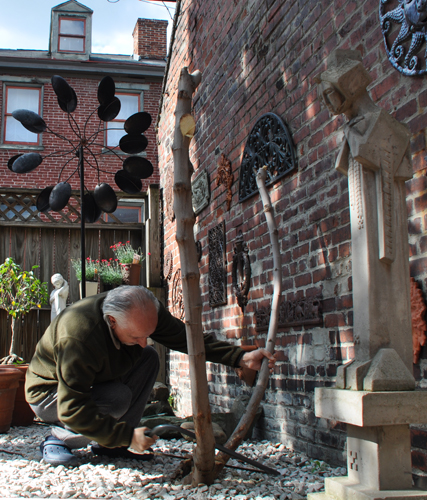
Where last spring I was counting the number of figs on the trees and anticipating a feast of flavors, this year, I am cutting the 20 year old trunks and branches down.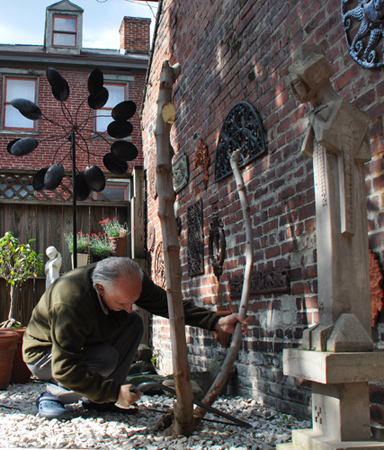 The winter was so severe that the roots were destroyed. And a cutting that had found its way from Calabria, to St. Catherine’s, to Western Pennsylvania is done. (I’m thinking of bringing back two small cuttings – a white fig and a black fig – from Aprigliano when we’re there in September.)
The winter was so severe that the roots were destroyed. And a cutting that had found its way from Calabria, to St. Catherine’s, to Western Pennsylvania is done. (I’m thinking of bringing back two small cuttings – a white fig and a black fig – from Aprigliano when we’re there in September.)
Other years, the branches froze, but never the roots and I’d begin the process of re-growing the trees. In the last years, the trees had grown to a diameter of over six inches and I was certain they would weather the winter; I was certain that I had passed the threshold and trees full of white-figs were in my future. But the winter of 2013/2014 was so severe that the ground froze to such a deep level that the freeze destroyed the root systems of the two white-fig trees.
I kept waiting and hoping that something would sprout from the base of the trees, but nothing. So, I finally gave up and cut the two trees down. In the pic on the left, I am cutting the smaller of the two trees. Each tree was over 15 feet tall and provided an amazing canopy.
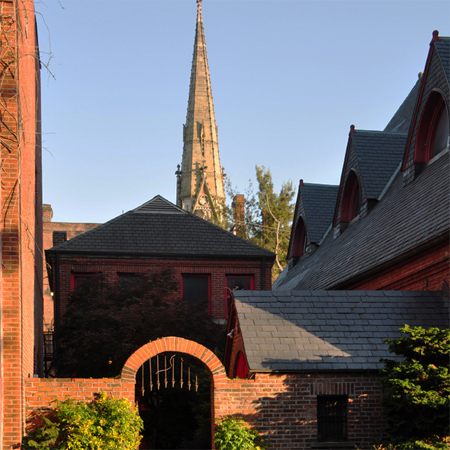
 After a dinner of spaghetti with clam sauce, a group of us went walking. The fading sunlight was supple and golden and I caught it in at least one image. (left to right – Civil-War house, parish-house, steeple of Calvary Methodist, roof of Emmanuel Episcopal, gate-house and entrance into parish-house.)
After a dinner of spaghetti with clam sauce, a group of us went walking. The fading sunlight was supple and golden and I caught it in at least one image. (left to right – Civil-War house, parish-house, steeple of Calvary Methodist, roof of Emmanuel Episcopal, gate-house and entrance into parish-house.)
Memorial Day has become the official day of remembrance for those Americans who died in combat. At cemeteries across the country, the grave-markers of fallen soldiers are decorated with small flags. And families visit these grave-sites on this last Monday of May. Washington DC is full of veterans remembering their fellow soldiers who did not make it out alive. (I’ve added this post to the in memorium category.)
November 11 with its commemoration of The Great War is a European memorial; it never took root here in the western hemisphere. Modern America has enough of its own war casualties to remember and commemorate; we do not need to go back to the events of the early 20th century to remember our young men and women who died for their country.

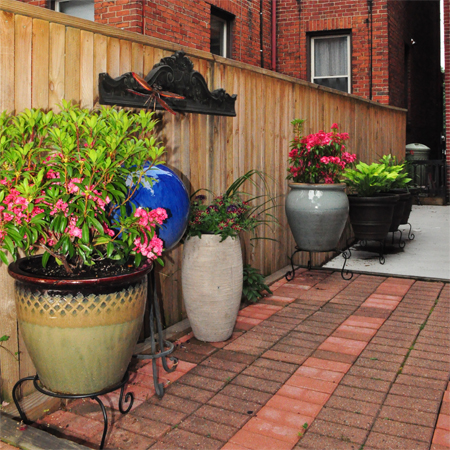 Today, I began the process of replacing the two shrubs burned by the winter freeze, and planting the annuals, herbs and eggplant in the pots, in the rock-garden.
Today, I began the process of replacing the two shrubs burned by the winter freeze, and planting the annuals, herbs and eggplant in the pots, in the rock-garden.
All the pics in the slideshow are flowers from the backyard. I took out the micro lens and mounted the D800e on the Manfrotto and shot the flowers.
On the side of the house – pic on the right – in the glazed pot, I planted a Kalmia Latifolia; in the tall, beige, clay-finish pot is Verbena; (Behind the tall pot and protruding through the slats are Iris and peony leaves.) in the ginger-jar is a second Kalmia; and in the black, plastic pots are Hosta and a Japanese Iris. I bought two Kalmias, because the flowers look like salt-water anemones found on a corral reef. (It’s the Kalmia blossoms in the second-to-last pic in the slideshow.) Also, I’m hoping that the laurel will make it through next winter. I raised the glazed pot and the ginger-jar onto iron stands and now these pots look huge. (They are huge, but resting on the bricks and the cement and looking down on them, they lost their bigness. Elevated on wrought-iron tripods, they’ve become large garden fixtures.)
The big, blue marble next to the glazed pot is a ceramic sphere that I bought on June 30, 2001 in Oakville as a remembrance. Jo’ had died that morning – Saturday, June 30 – and that afternoon I drove over to the greenhouse, up the street from their Arkendo house, and bought the ornament as a marker to always remind me of the day.
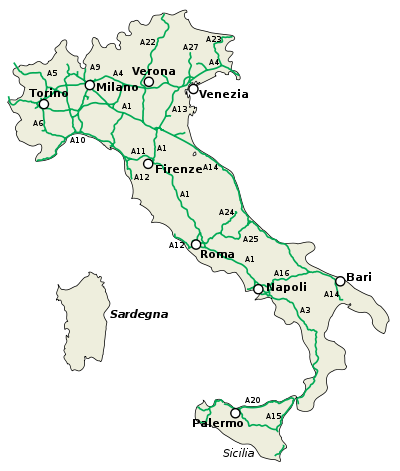
 Let me put up a tentative itinerary.
Let me put up a tentative itinerary.
We arrive in Palermo on Saturday, August 30 and drive the three hours to Modica on the A18. We’re in Sicily for one week. We’ll go to Agrigento, Siracusa, Ragusa and the amazing Scala dei Turchi beach.
On Saturday, September 6 we’ll find our way onto the A15 and head up to Messina to get the ferry to cross over to Villa San Giovanni on the Reggio Calabria side.  I’m hoping we can spend a couple of hours in Reggio; the lungomare is phenomenal. The second week, we’re in Belmonte Calabro for the first half and Naples for the second. We’re driving the A3 between Reggio and Calabro. We will visit with my relatives in Aprigliano and Pietrafitta and go to Pompeii when in Naples.
I’m hoping we can spend a couple of hours in Reggio; the lungomare is phenomenal. The second week, we’re in Belmonte Calabro for the first half and Naples for the second. We’re driving the A3 between Reggio and Calabro. We will visit with my relatives in Aprigliano and Pietrafitta and go to Pompeii when in Naples.
The third week we’ll be in Rome. Half-way between Naples and Rome, off the A1, is Cassino. Here the Axis and Allied forces fought the Battle for Rome. I want to see the WWII cemetery at the bottom of the mountain and Monte Cassino – the Benedictine monastery – at the top. (It was the Allies that bombed the monastery.)
Traveling the Autostrada, I don’t hear the electronic jazz Kraftwerk created all those years ago.
Wir fahr’n fahr’n fahr’n auf der Autobahn (Like the rest of us, the boys have gotten old.)
But let’s not dither, there is no fusion, no syncopation, no elegance to the Italian autostrada. The pastoral lassitude of the German landscape is replaced by the spikes and tunnels of the Aspromonte.
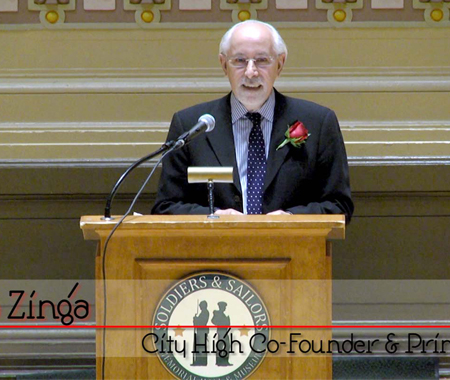
 Today – Saturday, June 21 – we graduated our 9th class. And this was my cohort of kids; I began with them in 9th grade back in 2010 and even timed my retirement so that I would be there to see them walk across the stage. I was their grade-level principal.
Today – Saturday, June 21 – we graduated our 9th class. And this was my cohort of kids; I began with them in 9th grade back in 2010 and even timed my retirement so that I would be there to see them walk across the stage. I was their grade-level principal.
Now, I hate to speak in front of a large crowd mainly because I believe that talking to a crowd should be about logistics and movement. Inspirational rhetoric is not something I understand, believe in or am willing to attempt. But it’s a tradition at City High that the grade-level principal gives the keynote, and I was on deck. I spent a couple of weeks thinking about what I wanted to say and how to organize the speech. (On my walks home from work, I would make lists in my head of topics or items that I wanted to cover.) It wasn’t until last week that I decided to acknowledge my reluctance to speak and my fear of crying in front of my kids. And once I did that I found the path into the delivery of the speech. Once I realized that I could admit to these two anxieties, then delivering the speech was not so scary.
I did the speech and afterwards was glad to have done it. The entire graduation ceremony is recorded and I liked the video of my speech enough to put it up on YouTube. Speech to Graduation Class of 2014
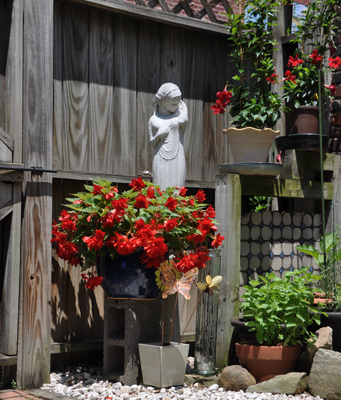
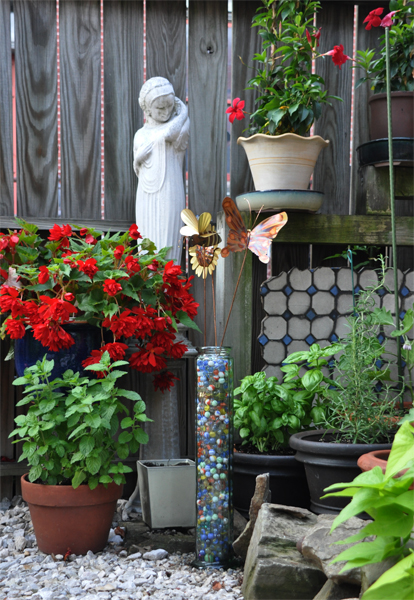 The back-yard is finally planted. This year I bought the large, blue pot that the hanging, red begonia is in. Last year I disguised the cinder block with a cascading petunia, but petunias never seem to keep their fullness as the summer gets dryer and hotter.
The back-yard is finally planted. This year I bought the large, blue pot that the hanging, red begonia is in. Last year I disguised the cinder block with a cascading petunia, but petunias never seem to keep their fullness as the summer gets dryer and hotter.
This year, I was able to plant 3 varieties of eggplants – classic, white and the longer and more cylindrical variety.
Difficult Children
I’ve always wondered what responsible parents do with a difficult child. At this point in my life, I believe difficult children come that way. And that the bonding that began at birth gets altered as parents learn to live with and integrate the difficult child into the family.
I’ve seen several families where the first-child is easy; he/she fits into the family dynamics; he/she gets along well with both parents; he/she gets along well with other adults. And then the second child comes along and behaves and does things very differently. Setting a bed-time is always a fight; getting dressed is a major hassle; eating nutritiously is a battle – the preference is for candy and french-fries. There is reckless talking to family members; reckless behavior with peer group. The parents begin to modify their behaviors and expectations; they begin to back-off on some of the rules and procedures; they let the second child win some of the battles. Parenting the difficult child becomes a compromise.
And now, I find myself doing the same thing – compromising with the difficult child. But I am anxious that the first-child will think that I like the difficult child better; that my leniency and compromise are interpreted as favoritism.
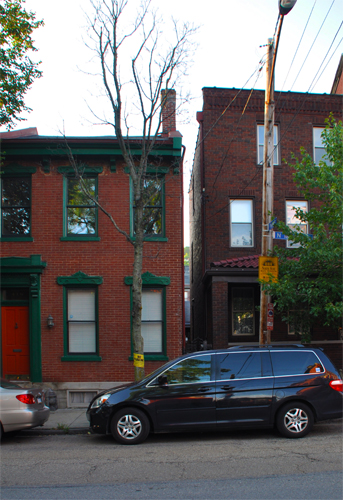
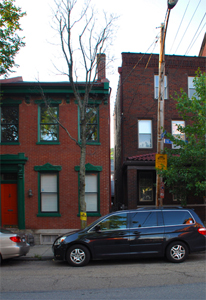 The Pittsburgh Tree Maintenance group is coming tomorrow to cut down the dead maple. There are 3 dead trees on my side of the street that they are probably going to cut down. New trees will be planted either in the fall or next spring.
The Pittsburgh Tree Maintenance group is coming tomorrow to cut down the dead maple. There are 3 dead trees on my side of the street that they are probably going to cut down. New trees will be planted either in the fall or next spring.
The maple was here when we first moved to the North Side. The early urban-pioneers to the Mexican War Streets settled for the upright maples or balloon-like Lindens. (I believe the one in front of the house was an Armstrong Red Maple – a fast growing, columnar tree.) The Linden next door – left corner of the pic – hosts millions of aphids and parking under it leaves the car slithered with aphid droppings. The droppings are syrupy and sticky and hard to clean off. The maple in front of my house was planted shallow, but it seemed to be doing OK. However, when we put in the new sidewalk, the contractor trimmed the root-ball and since then the tree started having problems. First a fungus developed on the bark and the next year there were dead branches. The fungus kept moving up the trunk and the branches without leaves increased. By spring 2014, the tree was dead.
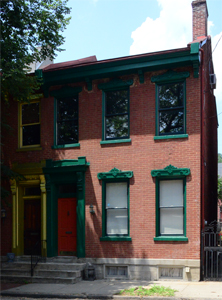 In the last 10 years, all replacement and new trees have been Sugar Maples. The word on the street is that the new trees are better suited to an urban environment. In the above image, the tree on the right in front of my neighbor’s is a Sugar Maple.
In the last 10 years, all replacement and new trees have been Sugar Maples. The word on the street is that the new trees are better suited to an urban environment. In the above image, the tree on the right in front of my neighbor’s is a Sugar Maple.
Last night, I shot the dead maple in front of the house and the image has the vans and cars parked there. With the no parking signs, the street in front of the house was car free. This is very unusual.
Today is Saturday. I came home from work to find the dead maple gone. Interestingly, they cut the tree to ground level, leaving the base and roots. The Tree Maintenance group will replant a new tree in the fall. I wonder what they do about the old trunk and root-ball?
A side note, this post was written over a three day period. The top image was taken after sun down on Thursday, and the bottom pic was shot today in early afternoon, in the blazing sun. (Hate to admit it, but I like the house without the tree in front of it.)
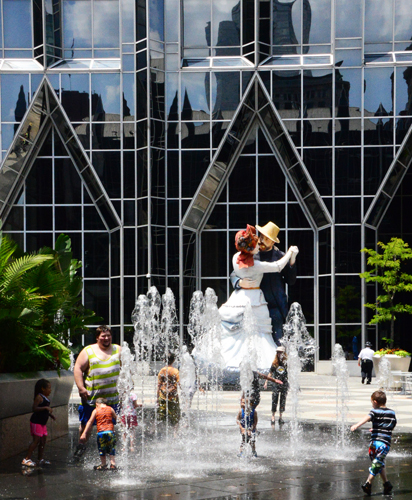
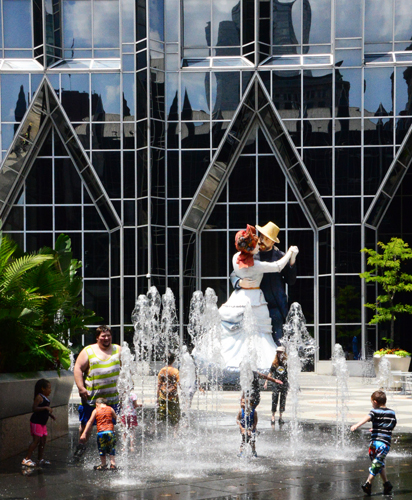 It took three days, a 50-ton lift and a 70-foot flatbed to install Seward Johnson’s statue “A Turn of the Century,” at PPG Plaza. The statue, which has been displayed in other cities, is based on an 1883 life-sized painting by impressionist Pierre-Auguste Renoir, “Dance at Bougival.” Renoir used two of his close friends as models for the piece, which evokes the scene at open-air cafes in the Paris suburb of Bougival. (The full article can be read at the Pittsburgh Post-Gazette.)
It took three days, a 50-ton lift and a 70-foot flatbed to install Seward Johnson’s statue “A Turn of the Century,” at PPG Plaza. The statue, which has been displayed in other cities, is based on an 1883 life-sized painting by impressionist Pierre-Auguste Renoir, “Dance at Bougival.” Renoir used two of his close friends as models for the piece, which evokes the scene at open-air cafes in the Paris suburb of Bougival. (The full article can be read at the Pittsburgh Post-Gazette.)
I walked into PPG Plaza looking to shoot the installation, but the children running in the fountain and the water-spouts were way more interesting. I came into the plaza from the south-side and started to find the best position to shoot the giant statue. Slowly, I walked around to its north quadrant and there were my renoir figures. I don’t know which I like best, the little boy in the bottom right corner with his ballet-like pose or the dad in all his corpulence. (Auguste would have liked the dad’s massive earthiness.)
The Plaza is one of the great open spaces in downtown Pittsburgh. Designed by architect Philip Johnson and his partner John Burgee back in the early 80’s, the Plaza has finally come into its own. With its compliment – Market Square – the area is Pittsburgh’s new hub littered with glitterati and working people in the day and Millennials after hours.
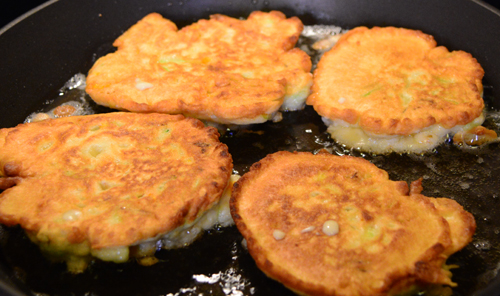
I knew it was summer, because my mom would make pittuli and even though the term in Italian is generic, to me it always meant zucchini flower fritters. Later, I learned that in Calabria they also made puttuli with cauliflower, dandelion and field greens.
 Growing up, I always associated the pittuli with the contadini traditions that we brought with us from Calabria. Traditions grounded in eating vegetables from my dad’s garden, in making wine in the fall, in making sausage, prosciutto and capicola. Today, the markets in Italy are full of zucchini flowers and trendy restaurants both here and there serve the blossoms dipped in batter. (I’ve never eaten the dipped zucchini flowers. This summer whether in Sicily, Calabria, Naples or Rome, I want to make sure to try them.) Today, the salumi my parents make are high-end items at the organic, up-scale markets across the country.
Growing up, I always associated the pittuli with the contadini traditions that we brought with us from Calabria. Traditions grounded in eating vegetables from my dad’s garden, in making wine in the fall, in making sausage, prosciutto and capicola. Today, the markets in Italy are full of zucchini flowers and trendy restaurants both here and there serve the blossoms dipped in batter. (I’ve never eaten the dipped zucchini flowers. This summer whether in Sicily, Calabria, Naples or Rome, I want to make sure to try them.) Today, the salumi my parents make are high-end items at the organic, up-scale markets across the country.
The batter is simple – flour, grated cheese, a couple of eggs and the zucchini flowers. (I use San Pellegrino instead of tap water; the fizz make for a lighter batter.) As a kid, I was given the job of cleaning the zucchini blossoms that my dad picked. He would pick the flowers in the morning when they first open. They are freshest then, and an open blossom tends to have no cucumber beetle in it. By late afternoon the blossoms close and begin to wither trapping any bug in a yellow-orange cocoon. Also, when it comes to zucchini-flower cooking, you can tell who the johnny-came-late are; these late bloomers do not remove the pointy green things at the bottom of the flower before cooking. My mother just shakes her head. She has no understanding why someone who is supposed to know their way around a vegetable can do such a stupid thing.
Also, I don’t put salt in the batter for the pittuli. The cheese has enough salt for this delicate recipe.
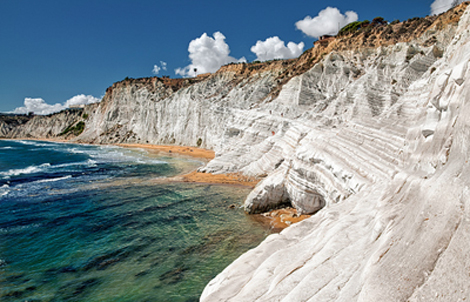
 La Scala dei Turchi literally The Ladder of the Turks is a rocky cliff off the southwestern coast of Sicily. The steps, looking south, face Tripoli. La Scala gets its name from the geographical formations – step-like indentations on the white rock-face – and the historical fact that the Turks conducted many raids on the island from this entry point. It’ll be one of our side-trips while in Modica. I just hope that access to the steps is easy and convenient. Not necessarily a concern at most Italian beaches and landmarks. (I will say that signage on Italian roads is way better than signage on roads in France.)
La Scala dei Turchi literally The Ladder of the Turks is a rocky cliff off the southwestern coast of Sicily. The steps, looking south, face Tripoli. La Scala gets its name from the geographical formations – step-like indentations on the white rock-face – and the historical fact that the Turks conducted many raids on the island from this entry point. It’ll be one of our side-trips while in Modica. I just hope that access to the steps is easy and convenient. Not necessarily a concern at most Italian beaches and landmarks. (I will say that signage on Italian roads is way better than signage on roads in France.)
From online images, in the summer the steps teem with sun-worshipers. Such an Italian approach to sun bathing; no one in America would think of slathering themselves in suntan oil and lying on a mountain side facing the afternoon sun. In 2009, we were in Panarea; the island has no beach, but hundreds of sun-bathers were sitting on the volcanic rocks that make up the island’s cliffs.
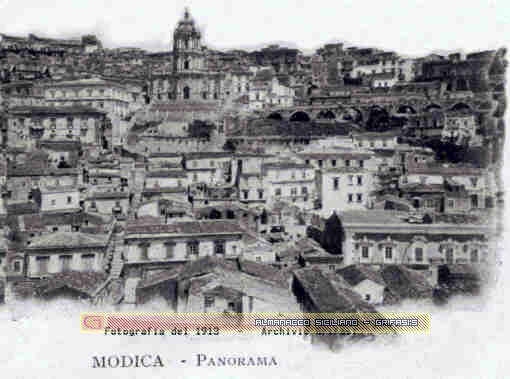
 I’ve never written this much before a trip and I’m not sure why I’m doing it this time. The only reason I can suggest is that I’ve never been to Sicily and am trying to get my head around the place before I actually set foot on the island. My only other experience with Sicily was Panarea and I was amazed. The cannoli were beyond good.
I’ve never written this much before a trip and I’m not sure why I’m doing it this time. The only reason I can suggest is that I’ve never been to Sicily and am trying to get my head around the place before I actually set foot on the island. My only other experience with Sicily was Panarea and I was amazed. The cannoli were beyond good.
I wonder if I’m dealing with my prejudices about Sicily. After all, I am from that generation that will forever associate the island with organized crime. (Coppola’s Godfather movies defined the island.) Also as Calabresi, we thought of ourselves as better than them Sicilians; we were better than them Sicilians that had immigrated earlier. My parents had an education; they lived in town; they brought over an intact family; they weren’t fugitives; they didn’t have ties to the Mafia; they weren’t starving; they came to Canada; they believed they were forging a new path not following in the wake of those that had left years earlier.
We ended up in Modica after our first rental in Siracusa became unavailable. And yesterday, I read a great blog posting by Rick Zullo a blogger who write for expats. He wrote about Modica’s two city-centers, its good restaurants, and its Baroque architecture. The two city-centers are quite typical of areas damage by earthquakes. The rebuilding happens away from the earthquake area, but then the devastated area slowly gets rehabbed and a city ends up with a new and an old downtown.

It began with me shooting the new pebbles at the bottom of the Japanese lilac. Used the D800e for the initial shoot, but didn’t like any of the images. Decided to try the 12-24mm lens and see what I could get – the whole right side.
L2R – begonia, mint, calla, vase with marbles and copper-butterfly, herbs, eggplants, annuals, sunflowers, sprite and lilac trunk
It’s taken almost a month to get it all done. The expense this year was the plants, everything else I had. No wait, it cost me $25 to get a hole drilled in the bottom of the glass tube and although I had a bunch of marbles at my office, I did have to buy two more packages to fill the vase. The mint, calla lily and sunflowers are new this year; and because the sunflowers went into the ground, I didn’t need any new pots.
While planting the sunflowers, I found all the dead fig-tree roots and the old cement floor that’s under the white stone. I realized that the fig-tree roots were all above the cement which explained why the roots froze. Rose-and-Derrick’s trees froze but new shoots came up; so also Rick-and-Sarah’s tree got new shoots. I suspect that because the roots of my fig-trees never made their way below the cement pad and away from the bitter winter cold they had no protection from the extended freeze.
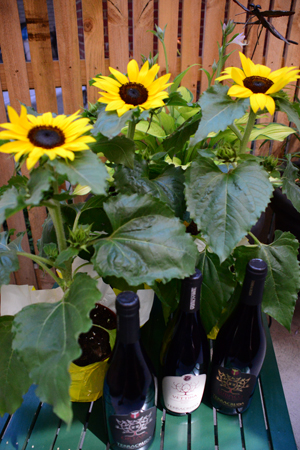
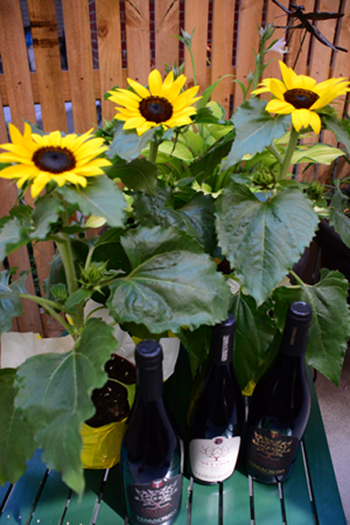 Yesterday, I went and picked up the wine-order Tom sent from San Francisco. It included 6 bottles of Aleatico and two Calabrese wines. The Aleatico is from the Terracruda Winery in Fratterosa. Last summer, our last day at Earle-and-Suzanne’s we went up to the Ferragosto festival in Fratte Rosa – the hilltop town across the valley. While waiting for the restaurants to open, we got in line for a wine tasting. There were only five of us – 3 Americans and 2 Australians – and the young man organizing the tasting, led us down into a brick-walled, vaulted basement. He explained that we were standing in his grandmother’s cantina. (The link is to the post from last summer.) The white wines were OK, but the reds – Lubaco, Ortaia, Vettina – were amazing.
Yesterday, I went and picked up the wine-order Tom sent from San Francisco. It included 6 bottles of Aleatico and two Calabrese wines. The Aleatico is from the Terracruda Winery in Fratterosa. Last summer, our last day at Earle-and-Suzanne’s we went up to the Ferragosto festival in Fratte Rosa – the hilltop town across the valley. While waiting for the restaurants to open, we got in line for a wine tasting. There were only five of us – 3 Americans and 2 Australians – and the young man organizing the tasting, led us down into a brick-walled, vaulted basement. He explained that we were standing in his grandmother’s cantina. (The link is to the post from last summer.) The white wines were OK, but the reds – Lubaco, Ortaia, Vettina – were amazing.
The young man explained about the Aleatico – a dark-skinned grapes with muscat-like aromas. (The Muscat family is touted as the oldest common grape vine on the planet.) He also told us about the new winery – Terracruda – his family had started that uses this ancient grape. They were re-introducing this old vine back into Le Marche, back into the Fratte Rosa region where it had been grown by the men and women who worked the land. Fratte Rosa is becoming the center of an artigianale movement to re-discover the lost fruits and vegetables of Le Marche. The fruits and vegetables that the contadini grew, harvested and made into wonderful foods and drink.
Got home and began searching for a distributor of Terracruda wines in the U.S. And a year later, I have have six bottles, two each of Ortaia, Vettina and Lubaco. I knew I was going to shoot the bottles for a post and while at the grocery store I saw the sunflowers. I had a new composition. We’re not going to Le Marche this summer and I’ll miss the sunflower fields, but I can include the yellow petals in the pic and remember.
Aleatico e Girasoli are kindred spirits sharing root-systems beneath the rolling hills of Fratte Rosa.
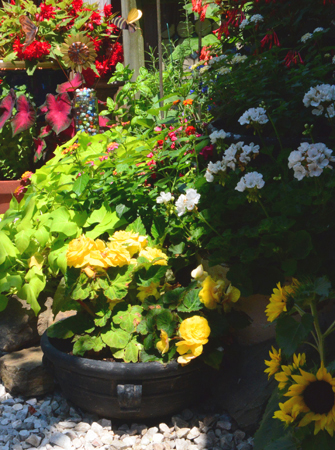
In the last two months, Bilby had lost 25% of his weight; he was skin and bones. We took him in to see the vet and she diagnosed severe diabetes to the point where he was toxic and days, if not hours, away from being very sick. After going through the options – flushing out his system and then beginning an insulin regiment. The flush would require a hospital stay and the insulin would be twice a day. Neither of the options would guarantee that he would live either pain-free or diabetes stable and we were also looking at frequent vet consultations and visits. Given these options and outcomes, we decided that the best thing to do was put him down before he became severely ill.
 I wasn’t willing to watch him die, so the vet took him from the examination room and we waited until she came back and told us he was gone. (Si ne iutu.) Of the five schnauzers, he had the best disposition. He was friendly and very social.
I wasn’t willing to watch him die, so the vet took him from the examination room and we waited until she came back and told us he was gone. (Si ne iutu.) Of the five schnauzers, he had the best disposition. He was friendly and very social.
We got Bilby from a breeder who lived in Columbus, Ohio. The woman who grooms the dogs told me about a breeder she knew that was looking to place two females. (The females were done with their breeding and needed to be placed out of the house.) The dogs would be free. I called the breeder and made arrangements for her to come up to Pittsburgh and show us the females. We also called two friends – Margie and her sister – who were also looking for a dog. The breeder knew she was coming up and had the potential to place both animals.
When she came into the house, she brought one of the females and this 6 month old male puppy. The puppy had this great disposition and I decided that I’d rather have the puppy than a grown dog. Our friends took the female. The breeder placed one her females and made a sale, not a bad trip. (None of us saw the second female.)
Bibly came to live with us on Sunday, December 21, 2003.
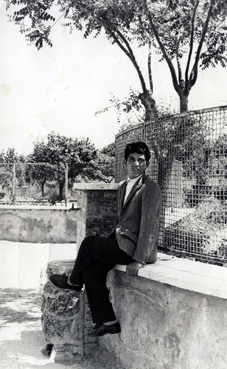
 My Zinga grandparents came over from Aprigliano in the early 50’s and settled in Toronto. My grandfather Annunziato married his brother’s widow – Concetta Capisciolto – my dad’s mom. Concetta died three years later and my grandfather remarried. He married Raffaella De Francesca and they had five natural children and one from my grandfather’s first marriage. (Annunziato was his formal name; in dialect, everyone called him Nunziatu.)
My Zinga grandparents came over from Aprigliano in the early 50’s and settled in Toronto. My grandfather Annunziato married his brother’s widow – Concetta Capisciolto – my dad’s mom. Concetta died three years later and my grandfather remarried. He married Raffaella De Francesca and they had five natural children and one from my grandfather’s first marriage. (Annunziato was his formal name; in dialect, everyone called him Nunziatu.)
I got to know my grandparents in high-school; my dad had a car and we would make the trip south for weddings – my aunts, uncles and cousins were all young. Also, in senior year, I traveled back and forth to Toronto as part of the application process into the Brothers. Later in college, because I had to go through Toronto on my way home to Sault Ste Marie, I always planned the trips with an over-night visit with my grandparents.
The guest-room, was next to my grandparents’ bedroom and every night before they got ready for bed, they would pray the rosary and remember Mario in their prayers. Mario was their oldest child and they had left him behind in an institution in Rome. He is mentally disabled. (The above image is Mario back in the early 50’s.)
Back in the 1950’s, Canadian Immigration would not let children with disabilities into the country. And rather than risk being denied entry, my grandparents left Mario behind in an institution. He is still alive and still institutionalized. I’m hoping to visit with him when I’m in Rome in September.
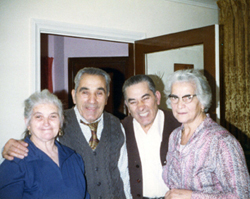 I believe that on the Zinga side of the family there is a genetic abnormality that has resulted in number of children with disabilities. My grandfather Nunziatu and my uncle Luigi, his older brother, both had mentally retarded children. My uncle Luigi’s son made it through immigration. He grew up in Canada; was never able to live on his own, but he was an active member of the family attending all Zinga family events. I don’t know enough about my uncle Mario to know how severe his disability is. However, it’s also true that other Zinga parents had very bright children; both ends of the spectrum are represented in the extended family.
I believe that on the Zinga side of the family there is a genetic abnormality that has resulted in number of children with disabilities. My grandfather Nunziatu and my uncle Luigi, his older brother, both had mentally retarded children. My uncle Luigi’s son made it through immigration. He grew up in Canada; was never able to live on his own, but he was an active member of the family attending all Zinga family events. I don’t know enough about my uncle Mario to know how severe his disability is. However, it’s also true that other Zinga parents had very bright children; both ends of the spectrum are represented in the extended family.
Today, I met a family that has two boys – the older boy is very bright and the younger is borderline MR. The younger child was visiting the school; he is a perspective 9th grader. What prompted this post is a wonderful exchange with the young man. He is in our office waiting for a tour and he begins asking all these questions and in one exchange he says, “I heard this school was founded by teachers.” One of the admins in the office – Mrs. Welch – points to me. I raised my hand to acknowledging both the question and the pointing. The young man says, “Wow! and you’re still alive.” It made my day. There’s obviously nothing wrong with his sequencing patterns.
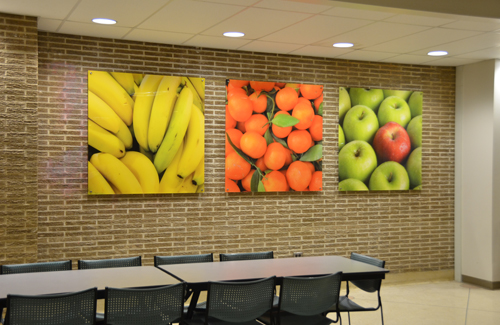
Modern American society stands on two pillars – celebrity-worship and consumerism. Two pillars that compliment each other; two pillars that live in TV land. And high schools don’t know how to fit into this twenty-first century world.
The idea of glamoring aspects of schooling is important if we want young people to engage with us about their learning. They live in a world that communicates through TV, computers and hand-helds and as educators we need to participate in this media. If we want students to pay attention to schooling then we have to glamorize learning. If we want students to eat healthy, then we need to make healthy food look glamorous.
Few people in education understand the idea of glamoring aspects of learning. Most educators think that schools and learning should be separate from the cultural milieu that obsesses on celebrity and consumerism. This viewpoint will just mean that education will continue to exist in a limbo outside of the modern world. And this existence will continue until some corporation and some politician come along and change the rules. The politician will create the guidelines for private take-over, the corporation, through commercials, will glamorize learning and collect the billions that are now going to school districts. Will students learn anything in this new paradigm, who cares? Leaning will not be a goal, making money will be the goal. Students and parents are the consumers, and provided admissions and tuitions keep coming in, the shareholders wont care if anyone learns anything.
 One of the things I’ve always worked for here at City High is to figure out how to make learning glamorous. From the beginning we advertised the new school in cinemas, on billboards and with direct-mail. We glamorize students who got into good colleges – graduation posters in the main hallway; students who had great Internships – website; students who worked for the Tech team – pictures on the first floor; students who worked at the school-store – brochures; students who were in the drama club – flyers. All PR materials featured students engaged in the learning process. (No where are there sports trophies, no where are there pictures of kids at the prom; at the fall dance.
One of the things I’ve always worked for here at City High is to figure out how to make learning glamorous. From the beginning we advertised the new school in cinemas, on billboards and with direct-mail. We glamorize students who got into good colleges – graduation posters in the main hallway; students who had great Internships – website; students who worked for the Tech team – pictures on the first floor; students who worked at the school-store – brochures; students who were in the drama club – flyers. All PR materials featured students engaged in the learning process. (No where are there sports trophies, no where are there pictures of kids at the prom; at the fall dance.
In the last 3 years, we have put in place a breakfast and lunch program that offers students nutritious options. All our food is prepared and cooked on site by a certified chef, a sous-chef and support staff. We buy local products, watch portion sizes, control sugar quantity and monitor for salt content. The food is kid-friendly and nutritious. In our cafeteria we promote good eating and we have been wanting to glamorize good and nutritious foods. We just installed 9 amazing images of nutritious foods. Huge 4 X 4 images printed on plexiglass and showcasing fruits, vegetables and grains, all foods that we serve on a regular basis.
(The above image was taken by Laura Sheldon.)

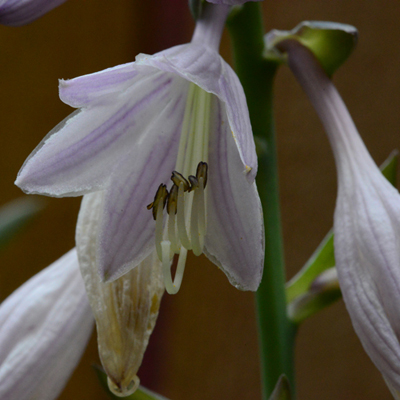 The image on the left is the result of shooting a Hosta flower at close range with a tripod. The soft brown background is the wooded fence. And all I did to the image is crop it into a square; no other Photoshop tweaks. I really like the images from this lens. The stamens are almost impossible to see with the naked eye and yet with the micro lens their black caps center the focus. (Most of the images in the slide-show, in the header, were shot with this same lens.)
The image on the left is the result of shooting a Hosta flower at close range with a tripod. The soft brown background is the wooded fence. And all I did to the image is crop it into a square; no other Photoshop tweaks. I really like the images from this lens. The stamens are almost impossible to see with the naked eye and yet with the micro lens their black caps center the focus. (Most of the images in the slide-show, in the header, were shot with this same lens.)
This post began because of a photo-shoot with a micro lens, but morphed into an account of a medieval king and southern Italy. I added it to Italy 2014, because it’s another piece that has me thinking differently about Sicily.
I just read that the High Renaissance shift in literature normally attributed to Dante and the other Florentines really began with Frederick II in Sicily. Federico II proved an important patron of the arts throughout his entire reign. A poet himself, he prized southern French poetry and welcomed troubadour poets from the region to his court. Through the influence of these writers, a new poetry began to be composed in the Sicilian vernacular. The poetry that emanated from the group had a significant influence on literature and on what was to become the modern Italian language.
Federico was born in Le Marche, in the small town of Jesi. (The original name was spelled Iesi with an i. Many Italian towns have switched and adopted the J. And yet, the letter J is not in the Italian alphabet.)
Jesi is where I found the amazing doors by sculptor Paolo Annibali.
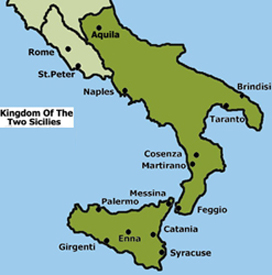 Federico was one of the most powerful Holy Roman Emperors of the Middle Ages. His political and cultural ambitions, based in Sicily, stretched through Italy to Germany and even to Jerusalem. His brilliant court which blended Norman, Arabic and Jewish elements was housed in Palermo. Also, in 1234, Federico founded the University of Naples, the first state university in western Europe.
Federico was one of the most powerful Holy Roman Emperors of the Middle Ages. His political and cultural ambitions, based in Sicily, stretched through Italy to Germany and even to Jerusalem. His brilliant court which blended Norman, Arabic and Jewish elements was housed in Palermo. Also, in 1234, Federico founded the University of Naples, the first state university in western Europe.
Historian Donald Detwiler wrote: Federico was a man of extraordinary culture, energy, and ability – called by a contemporary chronicler stupor mundi – the wonder of the world – by Nietzsche the first European, and by many historians the first modern ruler – Federico established in Sicily and southern Italy something very much like a modern, centrally governed kingdom with an efficient bureaucracy.
Federico, in Italy, ruled over the Kingdom of the Two Sicilies. The kingdom was formed from the union of the Kingdom of Sicily and the Kingdom of Naples. Because of political manoeuvrings, the capital of the unified kingdom fluctuated between Palermo and Naples.
Federico II is buried in the Palermo Cathedral in a sarcophagus of red porphyry mounted on four carved lions.

 Stained glass windows are not a feature of most of the small churches in southern Italy. In Aprigliano, none of the churches I’ve been in have stained glass. (I associated stained glass with the mausoleums in the cemetery across the valley from Santo Stefano.) The churches have small windows near the ceiling, but these serve to release the heat trapped up high. There are several that have only one window on the wall opposite the altar. I guess with the intense heat the thick stone walls would be compromised if they had large window openings.
Stained glass windows are not a feature of most of the small churches in southern Italy. In Aprigliano, none of the churches I’ve been in have stained glass. (I associated stained glass with the mausoleums in the cemetery across the valley from Santo Stefano.) The churches have small windows near the ceiling, but these serve to release the heat trapped up high. There are several that have only one window on the wall opposite the altar. I guess with the intense heat the thick stone walls would be compromised if they had large window openings.
In moderate climates, windows were part of the architectural design. They were the eyes lifting to the heavens, they were the pages of Holy Scripture – the Old Testament, the Crucifixion, the Resurrection; they were The Virgin in glory. Think France, Germany and the UK; think Chartres, Cologne, Canterbury. (The Vatican has the magnificent Bernini window of the Holy Spirit over the throne of Peter. But it’s way up there on the altar wall. Is there any other stained glass in the basilica?)
The image on the left is one of the renovated windows of St. Peter’s Church here on the North Side. The building is undergoing a much needed restoration. The stone has been cleaned and the windows brought back to life.
I have two items to dig for during this summer’s trip – evidence of the Kingdom of the Two Sicilies and examples of stained glass windows in the churches of Calabria. Because of the last post and the research on Federico II, I am determined to understand how Sicily and Calabria are similar. I grew up believing that Sicily was a vast, backward province and now I’m discovering that it was and is a center of culture, art, music, philosophy and learning. I grew up believing that there were few similarities between the Calabresi and the Siciliani. I am suspect of that belief.
Nearly half of the world’s Italians – in Italy and its diaspora – trace their roots to the Kingdom of the Two Sicilies. I am one of the diaspora; my ancestors lived in the Two Sicilies.
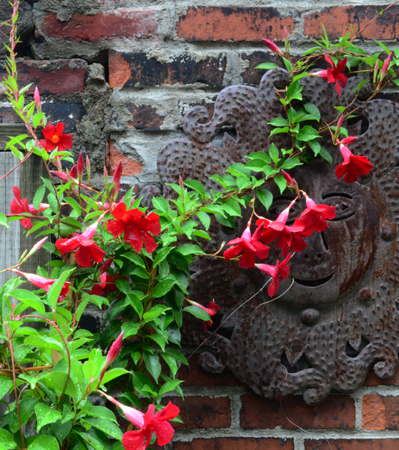
 I’ve been listening to Claudio Villa’s Carozzella romana and marvel at the lyrical names of the Roman landmarks. (It’s interesting that in Italian the adjective Roman loses its proper noun status and is written with a lower-case r .)
I’ve been listening to Claudio Villa’s Carozzella romana and marvel at the lyrical names of the Roman landmarks. (It’s interesting that in Italian the adjective Roman loses its proper noun status and is written with a lower-case r .)
Tevere rolls off the tongue. Tiber requires a walk through the harsh syllables. The original name for the river resembles the English more than the Italian. 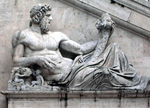 (In the image on the left, the face reminds me of the relief of the Tiber god on the Campidoglio steps – above image. According to legend, the god’s hair represents the river.)
(In the image on the left, the face reminds me of the relief of the Tiber god on the Campidoglio steps – above image. According to legend, the god’s hair represents the river.)
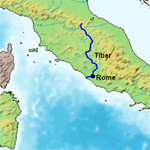 The river begins in the Apennines in Emilia-Romagna, flows south for 252 miles and empties into the Mediterranean south-west of Rome. In the 1930s, Mussolini placed an antique marble column at its source. The inscription reads QUI NASCE IL FIUME SACRO AI DESTINI DI ROMA – Here is born the river sacred to the destinies of Rome. (One sick Italian with illusions of grandeur wrapping himself up in Roman revisionism. And getting hung upside down in a piazza in Milan was a fitting end for this male diva.)
The river begins in the Apennines in Emilia-Romagna, flows south for 252 miles and empties into the Mediterranean south-west of Rome. In the 1930s, Mussolini placed an antique marble column at its source. The inscription reads QUI NASCE IL FIUME SACRO AI DESTINI DI ROMA – Here is born the river sacred to the destinies of Rome. (One sick Italian with illusions of grandeur wrapping himself up in Roman revisionism. And getting hung upside down in a piazza in Milan was a fitting end for this male diva.)
My last two times in Rome were short stays. Dropped the rental at the airport, checked into the Hilton and then got on the bus into town. We’d have about three hours before we had to get back on the bus. The bus stop was at the bottom of the Campidoglio. In 2011, we went walking in Trastevere and on our walk back discovered the development down on the banks of the Tiber – Lungo il Tevere . The name plays off the Italian word for seashore – longomare – which is on directional signs everywhere in the country.
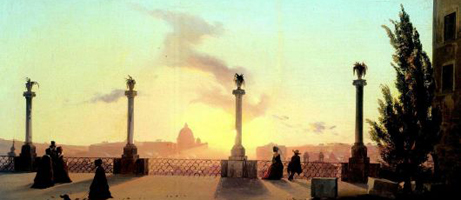
 For the longest time, I had no idea what the term del pincio – from the pincio – in the song Carozzella romana referred to. So I hit Wikipedia and found that Il Pincio is the short name for the Pincian Hill in the northeast quadrant of Rome. At the bottom of the hill is Piazza del Popolo and there are steps from the Piazza up to the top of the Pincian Hill to the belvedere and La Villa Borghese. The belvedere serves as a great overlook to the ancient city. The image on the left is of a painting of spectators on the Grand Tour on the belvedere atop the Pincian Hill. (The post title, with its great alliteration, translates to: from the top of the Pincio, which is also the entrance into the Villa Borghese, one can see the Roman hills smiling.)
For the longest time, I had no idea what the term del pincio – from the pincio – in the song Carozzella romana referred to. So I hit Wikipedia and found that Il Pincio is the short name for the Pincian Hill in the northeast quadrant of Rome. At the bottom of the hill is Piazza del Popolo and there are steps from the Piazza up to the top of the Pincian Hill to the belvedere and La Villa Borghese. The belvedere serves as a great overlook to the ancient city. The image on the left is of a painting of spectators on the Grand Tour on the belvedere atop the Pincian Hill. (The post title, with its great alliteration, translates to: from the top of the Pincio, which is also the entrance into the Villa Borghese, one can see the Roman hills smiling.)
What is today the Piazza del Popolo was the starting point of the Via Flaminia, the road to Ariminum – modern-day Rimini – and the most important route to the north. The Via Flaminia is the road we followed through Le Marche. I always wanted to know where it ended up in Rome.
With each of these posts that I’ve put into the prologue, I am slowly planning the week in Sicily and the week in Rome. I now have a list of traditional tourists sites and things somewhat-off-the-beaten-track. On the tradition list are things like: the Trevi Fountain, Piazza Navona, the Spanish Steps, the Colosseum, the Vatican, the Pantheon, the Campidoglio, Piazza Venezia. On the somewhat-off-the-beaten-track list are places like: Tivoli, San Pietro in Vincoli (Michelangelo’s statue of Moses, the chains of St. Peter), Piazza del Popolo, Campo di Fiori and the Jewish Ghetto, Il Lungo Tevere, Il Museo dell’Ara Pacis, Trastevere, the Monti neighborhood, the Basilica di S. Maria degli Angeli e dei Martiri. (At least now I feel like I’ve over-planned and can pick and choose from my two lists. I have not done this level of planning for our week in Calabria and Naples.)

 I went out this morning hoping to get some images of plants dripping with dew, but the light wasn’t right and instead I shot down into the flower-bed and surprise surprise some decent images emerged. (I was standing on a stool aiming at the ground. And the spots on the Caladium leaves are rain drops.) The eggplant listed in the title is the darker green leaf in the top far right. The lighter green is the sweet-potato vine.
I went out this morning hoping to get some images of plants dripping with dew, but the light wasn’t right and instead I shot down into the flower-bed and surprise surprise some decent images emerged. (I was standing on a stool aiming at the ground. And the spots on the Caladium leaves are rain drops.) The eggplant listed in the title is the darker green leaf in the top far right. The lighter green is the sweet-potato vine.
The website columns got re-sized. I like the huge images in the slide-show; I’ll have to see what it looks like on my laptop screen. And I’ll get to do that later in the week when I am in Canada working on it instead of the 27″ HD screen. The images in the slide-show are flowers from the urban garden on Sherman Avenue. The industrious Northsiders or should I say War-Streeters have turned the empty lots into garden plots; not too many vegetables, but lots and lots of flowers. (I’ve learned to avoid using images of flowers in the red spectrum. The reds just blend in with the header and I lose the distinct contrasts.)
This is the first Sunday where I’m reminding myself that tomorrow I do not have to get up and go to my office. (I never minding going to work, it just meant that for the next 5 days my schedule was not my own.)
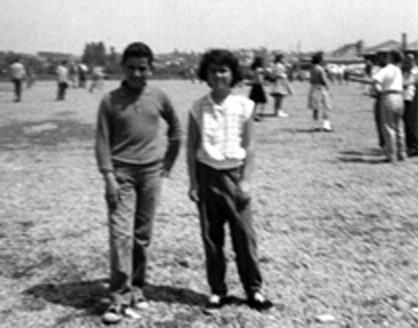

We’d run to the schoolyard and here’s what we did
We’d pick out the captains and we’d choose up the teams
The Paul Stookey lyrics reminded of the summers we spend playing baseball in the field behind Corrine’s house. Baseball was not a game I understood or played well, so right field was the right place for me. Right field extended across the street and into the St. Veronica’s Church parking lot. Still, the ball rarely came in my direction.
The image on the left has little to do with baseball or the field behind Corrine’s, it just seemed to fit. (Janice and I are on the playground at St. Theresa School. I think we were in the 6th or 7th grade.)
I have no idea who provided the ball, the bat, the gloves. For the bases, home-plate and the pitcher’s mound we would trace in the dirt using our shoes to scribe the diamonds and line on the mound.
Ron, Rainer and Frank were good players. Ron and Frank played in the various summer leagues and Rainer and I would ride our bikes to their games. (The bikes were our tickets to exploring the town and we did. Many times Rainer would ride on the handle-bars and the two of us would see how fast we get down a hill.) The league played in fields all over the west end of Sault Ste Marie. My favorites were the ones up on the hills, especially the one on Fourth Line. Fourth Line in those days had little traffic and great dips. We could ride our bikes down the middle of the road and never worry about cars.
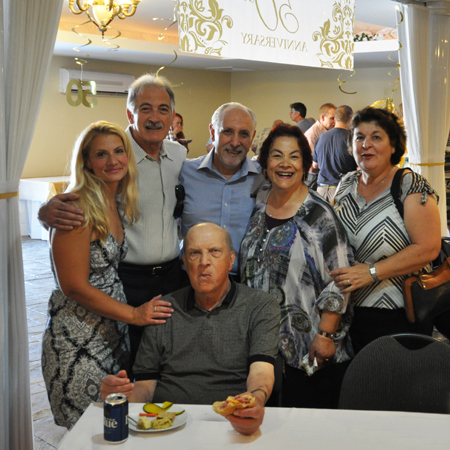
I drove from Toronto – Dave’s house – to Chesley, Ontario. Chesley is 3 hours north-west of Toronto in farming country. It’s that same geographical swath of Ontario that extends south all the way to Windsor. The housing stock is old Canadian farmhouse and the Chesley area has a large Amish community. It’s a bit hillier than the area around Harrow where Rainer lives, but here in Chesley it’s the Georgian Bluffs and by Harrow the bluffs give way to flat prairie.
 The drive was on country roads with bush or farms on either side. Because I wasn’t sure where I was going, I’ve never been through this part of Ontario, I decided to give myself some extra time and found I was the first guest to arrive. Jennifer was putting up the road-sign announcing the reception and I stopped, rolled the window down and said, “You and I look like we’re from the same family.” She was glad to see me and knew that her mom would be extra happy.
The drive was on country roads with bush or farms on either side. Because I wasn’t sure where I was going, I’ve never been through this part of Ontario, I decided to give myself some extra time and found I was the first guest to arrive. Jennifer was putting up the road-sign announcing the reception and I stopped, rolled the window down and said, “You and I look like we’re from the same family.” She was glad to see me and knew that her mom would be extra happy.
The next people to arrive from the Zinga side were Renato and his wife Gina. Renato is my Uncle Michael’s son. We are almost the same age and we’ve always gotten along. (He was 13 when his family came from Aprigliano.) In the above image, left to right, is Jennifer, Renato, me, Susan, and Gina. Gord is sitting.
Renato, Gina and I had a wonderful time getting re-acquainted. It was really the first time that I got to spend time with Gina without a mob of Zingas around and we discovered we could laugh and laugh. We even had a great time ripping on Renato. The Zingas on Uncle Michael’s side are the nice ones and Renato is one of the nicest. So ripping on him is extra fun.
In past family events we were the younger generation, but there were so many other parents, grandparents, uncles and aunts that we never got a chance to just be ourselves. We were always in service to the older group. And today it was just us, and the fact that the other Zingas didn’t show for a while, we got to laugh and have fun.
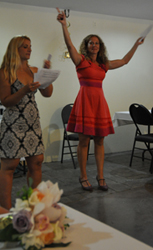
The event was organized around a meet-and-greet, a 1964 trivia competition,  (Liza and Jennifer hosted.) Susan and Gordon renewing their vows and dinner.
(Liza and Jennifer hosted.) Susan and Gordon renewing their vows and dinner.
Where was Gordon-and-Sue’s first apartment?
– Jane Street, a couple of blocks up from my grandparents.
Who was the Prime Minister of Canada in 1964?
– Lester B. Pearson
Which Canadian company opened its doors in 1964?
– Tim Horton in Hamilton, Ontario
Where did Sue and Gordon meet?
– In the elevator of the office building they were working in.
Who won the Stanley Cup in 1964?
– The Toronto Maple Leafs beat the Detroit Red Wings 4 game to 3.
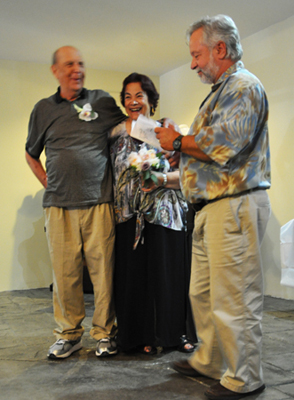 Renato knew most of the answers and our team won 3rd place. When Lisa handed out the prizes, we got a bottle of white wine. And as we all know the Calabrese don’t drink white wine, so Renato went over to another team that had also won and swapped the white for a red. (He is such a Zinga.) The only answer I contributed was which famous American general died in 1964.
Renato knew most of the answers and our team won 3rd place. When Lisa handed out the prizes, we got a bottle of white wine. And as we all know the Calabrese don’t drink white wine, so Renato went over to another team that had also won and swapped the white for a red. (He is such a Zinga.) The only answer I contributed was which famous American general died in 1964.
After the trivia game, Sue and Gordon renewed their vows. (I don’t know if the person officiating was a minister or a Justice of the Peace.) When they got married back in 1964, a Justice of the Peace officiated. I’m sure my extended family in Toronto was scandalized image! – they did not marry in a church; Gordon was not Italian or Catholic – scandal squared.
A second reason I went up was to see some of the relatives on the Zinga side and to get the contact information for Mario in Rome. Sue said she had it and I’ll follow up with her when I get home.
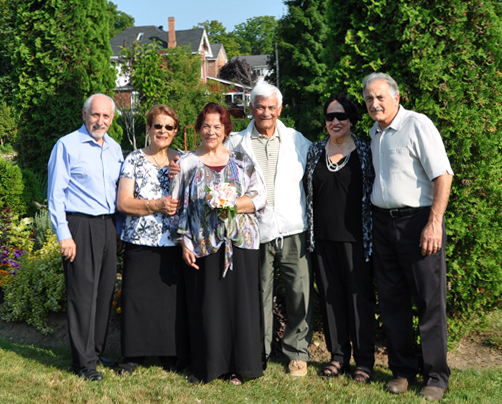
 From left to right – me, Gelsi, Susan, Joe, Rita and Renato. (Gelsi, Sue, Joe and Rita are siblings, children of Nunziatu; Renato is their cousin, child of their uncle Michele.) I believe the birth order is: Gelsi, Rita, Joe, Mario, who is in Rome and Susan. (On Renato’s side the birth order is Salvatore, Maria, Vincenzo, Renato, Raffaella and Gina.)
From left to right – me, Gelsi, Susan, Joe, Rita and Renato. (Gelsi, Sue, Joe and Rita are siblings, children of Nunziatu; Renato is their cousin, child of their uncle Michele.) I believe the birth order is: Gelsi, Rita, Joe, Mario, who is in Rome and Susan. (On Renato’s side the birth order is Salvatore, Maria, Vincenzo, Renato, Raffaella and Gina.)
And in addition to us being all Zingas, the six of us were all born in Aprigliano. They were all born in La Grupa where the Zingas are from. When Ciccio and Mafalda married they moved to Corte into the house that my maternal grandfather had paid for with his wages from his job in Canada. I was born there in that house in Corte.
My father kept his connections to his friends from La Grupa, (The Mussos were from La Grupa.) But I never got to know any of the Zingas. Instead I got to know the Capisciolti, my grandmother’s side of the family and my mother’s relatives. (The only Zinga I remember is Zu Rimitri. He had a barber shop on the road that led into La Grupa. But he never gave me a haircut, I always got my haircuts from the barbers on my mother’s side of the family.)
Renato began to talk about La Grupa; he was 13 when he left and has many more memories of his time in Aprigliano than I do. Also, Susan has all the contact information for her brother, Mario, in Rome and she promised to give it to me.
| The Zingas | Birth and Death | Off-springs |
| Salvatore | 1899 – | Totonno |
| Francesco | 1901 – | Ciccio (my father) |
| Michele | 1904 – | Salvatore, Maria, Vincenzo, Renato, Raffaella, Gina |
| Assuntina | 1906 – | Francino from Sudbury |
| Annunciato | 1908 – 2007 | Gelsi, Rita, Joe, Mario, Susan |
| dimitri | 1910 – | never married |
| Luigino | 1912 – | ___________, Peter, Frank |
| Angelina | 1914 – |

 Connie and Dave insisted that we go up to the cottage, because Seane wanted to toast marshmallows. Connie wanted me to see that the winter ice had removed all the stones from the shore in front of the cottage and that the whole Red Rock area now had sandy beaches. (A geological upheaval, a consequence of last winter’s Polar Vortex.)
Connie and Dave insisted that we go up to the cottage, because Seane wanted to toast marshmallows. Connie wanted me to see that the winter ice had removed all the stones from the shore in front of the cottage and that the whole Red Rock area now had sandy beaches. (A geological upheaval, a consequence of last winter’s Polar Vortex.)
The above image is my shooting at the setting sun from Connie’s cottage. The dark strip on the horizon is an island.
Seane did get her s’mores, but the bugs were over whelming and we ended up visiting with the neighbors and then headed indoors at Connie’s. The neighbor’s property is clear of trees and it looks huge; Connie kept reminding me that the two lots were the same size, and that her lot was still tree covered. Where the next door neighbor’s cottage looks like summer homes I’ve seen on the Outer Banks, Connie’s is rustic and very Northern Ontario-ish. It’s the kind of cabin I remember from when I lived up here in the early 60’s. A time when cottages were referred to as camps and a time when camps were places with out-houses and no running water.
The natural beauty of this part of Canada is wrapped up in its rugged terrain, its jutting rock-faces and its primitive vegetation. Give me the man-made landscapes of the Italian peninsula. The examples of man transforming the environment to make habitable. The land here in Northern Ontario may achieve that imprint, but it will take another thousand years. And even that may be optimistic; I keep forgetting about the winters, those may forever stop the human race from changing this landscape.
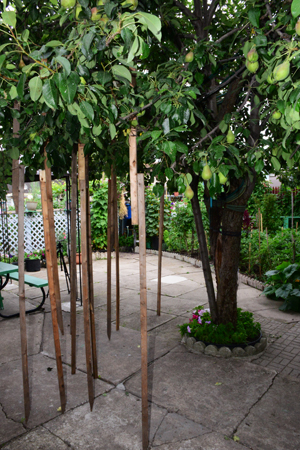
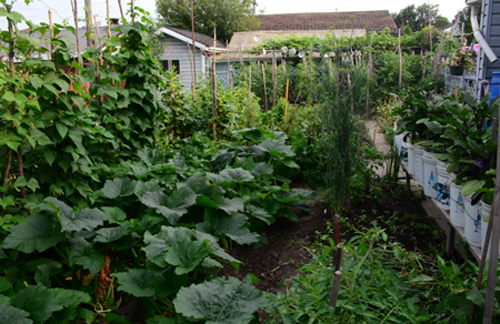 My father’s garden has spilled over into what was once lawn in the back-yard. Between his greenhouse, the added plot and the pole beans along the fence, he has increased his garden by 30%. Ciccio gardens like he did back in Calabria. He plants in rows with watering troughs on either side of the plant. (As a kid it was my job, when I came home from school, to water the garden. I would put the hose down in the trough and once it filled, move the water to the next trough. I hated the job. All my other friends were out playing, I had to water.)
My father’s garden has spilled over into what was once lawn in the back-yard. Between his greenhouse, the added plot and the pole beans along the fence, he has increased his garden by 30%. Ciccio gardens like he did back in Calabria. He plants in rows with watering troughs on either side of the plant. (As a kid it was my job, when I came home from school, to water the garden. I would put the hose down in the trough and once it filled, move the water to the next trough. I hated the job. All my other friends were out playing, I had to water.)
In the image on the left, I am facing north and shooting across the largest section of the garden. The section is behind the garage. And going from right-to-left, he has: eggplants in the buckets, tomato, dill, zucchini, pole-beans and beyond the zucchini are cucumber plants. Each morning I would go out into his garden and pick a cucumber off the vine to eat with my breakfast. (Peas and cucumbers were the sweet products of the garden and as kids we ate them whenever we could.)
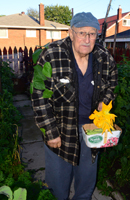 My father’s favorite plants, the ones he lavishes time and energy on, are the pole-beans. The image on the left is Ciccio first thing in the morning. He has picked zucchini flowers that my mother will make into fritters. He also has beans in the basket and the pole-bean leaves on his jacket. (The leaves are sticky and cling to his clothes as he walks through the patch snapping beans.) There are two things he grows well – pole-beans and the fruit trees. My mother cooks the green-beans, cuts garlic into the shells and loose beans and then drizzles them with olive oil. Seane and I eat the whole bowl. We do not share with any other family member. While visiting with my parents, I lived on cucumbers, green-bean salads, zucchini-flower fritters and minestra made with peas and pasta. (I’m glad Seane doesn’t like fresh cucumbers, because I have to share the other foods with her. And she has a bit more clout with her nonno e nonna than I their only son. Go figure.)
My father’s favorite plants, the ones he lavishes time and energy on, are the pole-beans. The image on the left is Ciccio first thing in the morning. He has picked zucchini flowers that my mother will make into fritters. He also has beans in the basket and the pole-bean leaves on his jacket. (The leaves are sticky and cling to his clothes as he walks through the patch snapping beans.) There are two things he grows well – pole-beans and the fruit trees. My mother cooks the green-beans, cuts garlic into the shells and loose beans and then drizzles them with olive oil. Seane and I eat the whole bowl. We do not share with any other family member. While visiting with my parents, I lived on cucumbers, green-bean salads, zucchini-flower fritters and minestra made with peas and pasta. (I’m glad Seane doesn’t like fresh cucumbers, because I have to share the other foods with her. And she has a bit more clout with her nonno e nonna than I their only son. Go figure.)
There’s an unclaimed competition between my uncle and my dad. My uncle uses modern methods to produce the bounty in his garden. My dad doesn’t read English and therefore can’t take advantage of the new chemical mixes with their complex directions. He has to rely of a more organic approach. But let’s be clear, he’s not gone green. He has not made a conscious decision to avoid pesticides; he just doesn’t know how to use them. A side-effect that his liberal, gone-American son appreciates. (He would call me a ciuotu americanu.)

 Derrick’s great-grandfather – Alexander Campbell – built this round barn on his property in Maple Ridge just north of the small town of Thessalon, Ontario on the north shore of Lake Huron. Derrick tells the story that Alexander Campbell, his maternal great-grandfather, designed and planned the barn during the winter of 1927 and built it the following year. This was a working barn used to house livestock and store crops until the late 1960’s. The above image is the roof of the barn with its main post and its octagonal rafters.
Derrick’s great-grandfather – Alexander Campbell – built this round barn on his property in Maple Ridge just north of the small town of Thessalon, Ontario on the north shore of Lake Huron. Derrick tells the story that Alexander Campbell, his maternal great-grandfather, designed and planned the barn during the winter of 1927 and built it the following year. This was a working barn used to house livestock and store crops until the late 1960’s. The above image is the roof of the barn with its main post and its octagonal rafters.
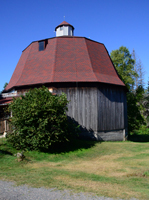 The barn is one of three 12-sided barns in Canada. The oldest of the three was built in 1881 in Mystic, Quebec by Alexander Wallbridge. The second 12-sided barn was built in 1919 by Thomas Cordukes who was born and grew up near Mystic. He left Quebec and settled in the Huron Shores area in 1881, prior to the original barn being built, but returned often to visit family and would have been privy to the progress of the Wallbridge barn. The third barn, built in 1928 by local farmer Alexander Campbell, is located near Maple Ridge. Campbell, a neighbor of Thomas Cordukes, assisted with the building of his barn 9 years earlier.
The barn is one of three 12-sided barns in Canada. The oldest of the three was built in 1881 in Mystic, Quebec by Alexander Wallbridge. The second 12-sided barn was built in 1919 by Thomas Cordukes who was born and grew up near Mystic. He left Quebec and settled in the Huron Shores area in 1881, prior to the original barn being built, but returned often to visit family and would have been privy to the progress of the Wallbridge barn. The third barn, built in 1928 by local farmer Alexander Campbell, is located near Maple Ridge. Campbell, a neighbor of Thomas Cordukes, assisted with the building of his barn 9 years earlier.
The barn and the old farm-house next to it, have new owners. The round-barn is a wonderful gift shop with amazing prices. There were some furniture pieces that in any shop here in the US would cost 10 times more than the price listed in the round-barn gift shop. I bought a hand-made scarf for $9.00, Rose and Derrick bought hand-thrown espresso coffee cups for a ridiculously low price. I was thinking of doing my Christmas shopping there, but the owner said that by December the weather and the highway are not always friendly to travelers. (Highway 17 North, part of the trans-Canada system, follows the contours of the lakes in this past of Northern Ontario and where in the summer months the views over the lakes are amazing, with the beginning of November travel can be hazardous. The winds off of Lake Huron and Lake Superior can deposit snow-drifts that make the highway impassable.)
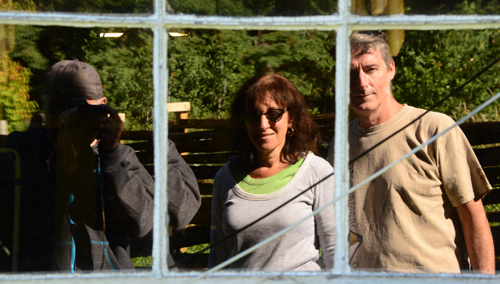
 As Rose, Derrick and I travel, I’ve been taking some standard pictures of the three of us and these are always reflections in a window, door, glass wall or mirror. It’s the only way I have of getting us all in the pic when there is no one else around. Today, the opportunity came as we were walking around the round-barn that Derrick’s great-grandfather built. I was able to frame the three of us in one of the low barn windows; the mullions creating a triptych.
As Rose, Derrick and I travel, I’ve been taking some standard pictures of the three of us and these are always reflections in a window, door, glass wall or mirror. It’s the only way I have of getting us all in the pic when there is no one else around. Today, the opportunity came as we were walking around the round-barn that Derrick’s great-grandfather built. I was able to frame the three of us in one of the low barn windows; the mullions creating a triptych.
Rose and I were dressed for the chill. (On the ferry from Tobermory to South Baymouth, I had bought a sweat shirt. The morning was cool and the facts that I was on a lake and moving added to the chill.) I like that my reflection is in shadow, but spans two window panels. When I got in the car, I commented that it was the same process as when we travel in Italy. And even though we were all staying with our parents and feeling like children again, for the morning we could become adults, we could behave like we do when we are on our own.
Rose and Derrick came to my parents’ to pick me up and then we headed to Starbucks for coffee. Rose brought her mother’s taralli and genetti for breakfast.
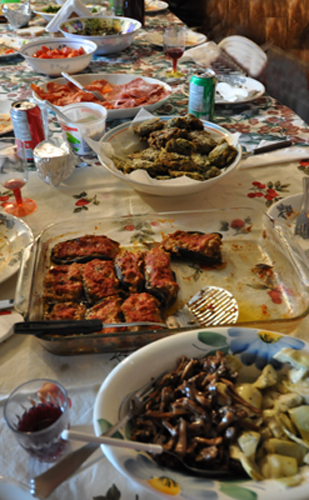
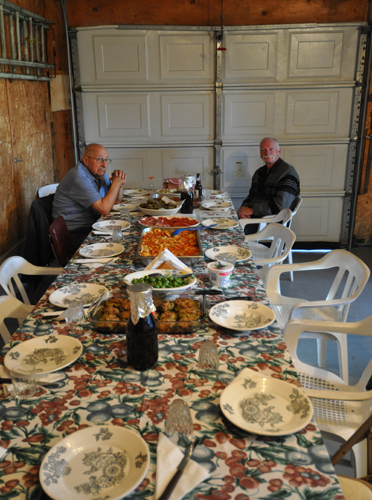 In Sault Ste Marie, it’s very common to have an outdoor meal in the garage. The weather is not summer enough to eat outside and the outside doesn’t have hot water, a sink, a refrigerator, or a stove to make the meal efficient. Also, it may be a picnic in a garage, but you don’t forgo plates, silverware and glasses – two sizes tall for water and short for wine. (In Calabria, they would have been under an olive tree or a quercia. Dam the conveniences, they had the sun, the shade, the landscape and the family.) Today, the weather was very chilly; we all wore long-sleeves and the garage door stayed closed.
In Sault Ste Marie, it’s very common to have an outdoor meal in the garage. The weather is not summer enough to eat outside and the outside doesn’t have hot water, a sink, a refrigerator, or a stove to make the meal efficient. Also, it may be a picnic in a garage, but you don’t forgo plates, silverware and glasses – two sizes tall for water and short for wine. (In Calabria, they would have been under an olive tree or a quercia. Dam the conveniences, they had the sun, the shade, the landscape and the family.) Today, the weather was very chilly; we all wore long-sleeves and the garage door stayed closed.
The menu and I’ll start at the bottom of the image – home-made wine in a half-liter carafe capped with tin-foil (my uncle’s wine is very good.), stuffed green peppers, antipasti (green olives from Calabria), home-made tortellini, antipasti (home-made prosciutto and soppressata), dandelion fritters (mary’s favorites), and hard to see are the stuffed eggplant (the eggplants are from the garden. my uncle doesn’t eat eggplant, but he grows them for my aunt.) and a third antipasti plate of various cheeses. Next course were the salads – tomato and basil (the tomatoes and basil are also from my uncle’s garden. there was home-made bread to sop up the tomato and olive oil juices.), dandelion (my favorite), and cucumber (in the muto family not everyone likes the tomatoes and cucumbers mixed, so my aunt make two separate salads.) My dad and Ron must have been hungry; they were the first ones to sit down.
Given the abundance, I had the stuffed peppers which were wonderful (the ration of chopped meat to rice was skewed to the rice side, the meat was only there for flavor.), dandelion salad (my aunt told us that she had send my uncle to pick them back in the spring and that he had gone up to the field that once housed the paper-mill that my grandfather worked at. she froze the greens knowing that mary and i would appreciate them in august. mary likes the fritters best, i like the leaves in salad and it’s the one salad where i like extra vinegar.) and to finish my second course i filled my plate with tomato salad and got my bread ready to sop up the juices.
Coffee and dessert finished the picnic, but they are never served outside. For these, we all went inside. The table in the upstairs-kitchen was laden with pies and home-made cookies. Mary made coffee using the fancy, stove-top espresso makers. (Every Italian in Sault Ste Marie like every Italian in Calabria has two kitchens – a basement kitchen, called a rustic kitchen in Calabria and situated on street level, for family meals and an upstairs-kitchen for company and desserts.) I just had espresso no Sambuca chaser, no five-berry pie and no amaretto cookies.

 In terms of the drive this was one of the best road-trips. I endured the border crossing at Buffalo once; the drive across the Mackinac once; and I only had to drive I-475 once. (Buffalo desperately needs an additional bridge, but we in America are all about budget cuts and hell with the future. The Mackinac with its low railings is disconcerting. I look straight ahead when I’m on the bridge, because it’s the vast expanse of Lake Michigan on the right and the rugged waters of Lake Huron on the left. And by looking straight ahead, I pretend to not be driving over the Straits. I have this fantasy that the lake-winds will pick up the car and toss it into the water. And 475 South through Flint is a road at the end of its life.)
In terms of the drive this was one of the best road-trips. I endured the border crossing at Buffalo once; the drive across the Mackinac once; and I only had to drive I-475 once. (Buffalo desperately needs an additional bridge, but we in America are all about budget cuts and hell with the future. The Mackinac with its low railings is disconcerting. I look straight ahead when I’m on the bridge, because it’s the vast expanse of Lake Michigan on the right and the rugged waters of Lake Huron on the left. And by looking straight ahead, I pretend to not be driving over the Straits. I have this fantasy that the lake-winds will pick up the car and toss it into the water. And 475 South through Flint is a road at the end of its life.)
The drive from Oakville to Chesley was new; I went through some beautifully preserved farm towns – Shelburne was worthy of Architectural Digest; and heading to Owen Sound, after the anniversary event, was also through rolling farmland. (The area has a large Amish/Mennonite community and there were many sighting of men on buggies and farmhouse with no electrical/cable wires running to them.) Because I had to be at the ferry doc for 6:00 am, I drove to Tobermory in the morning dark, but it was amazing to have the super moon off my left shoulder as I drove Highway 6. The ferry ride across Georgian Bay was a great no-drive time; the water was glass-still and the sky was shocking blue. The final leg through Manitoulin Island and Highway 17 North was also fun. (The last time I drove these roads was 40 years ago when Frank and I did this route on our way to the Sault.)
The week was also marked by visits with friends and family. It was good to see Joe Sanguinetti, Frank-and-Norma. It was good to see Susan again after all these years. And in the process I got to visit with my cousin Renato and his wife Gina. In the Sault, my dad’s garden was at its peak. Going out in the morning and picking cucumbers for breakfast was great; having zucchini fritters at lunch was another perk.

 This morning, Rick, Sarah and I sat down for our last planning session before we leave for Italy on Friday. I’m amazed how well we’ve set things up over the last 7 or 8 months. This morning was more of a summation than a decision making breakfast.
This morning, Rick, Sarah and I sat down for our last planning session before we leave for Italy on Friday. I’m amazed how well we’ve set things up over the last 7 or 8 months. This morning was more of a summation than a decision making breakfast.
I mentioned that the middle week is the time that is not quite set in my mind. We will be three-and-a-half days in Belmonte and two-and-a-half days in Naples. In Calabria we will visit Aprigliano and Cosenza, so I’m thinking we will make the 40 minute trip twice. The other time we can explore the coast and Belmonte. The Naples stay is easier, because it’s shorter and for one day we’re doing to Pompeii. The other time will be taken up with the two museums and the city itself.
We made a decision about how to get to the airport, we decided that we would not buy a tour for Pompeii. (My comment was that with Pompeii all we see are ruins and more ruins. And I don’t know enough Roman history to appreciate the details that a tour-guide would provide.)
On an unrelated topic, today the changes that Dan and I have been talking about are functional on the webpage. There are now buttons for both recent gallery and recent photo-essay. (I need to fix the Photo Essays, the new webpage dimensions have altered the Photo Essay page symmetry. But given that I do photo essays after my trips, this fix will wait until I come back.) And he created a grouping in the gallery listing so that I can organize the various titles into a chronological order.
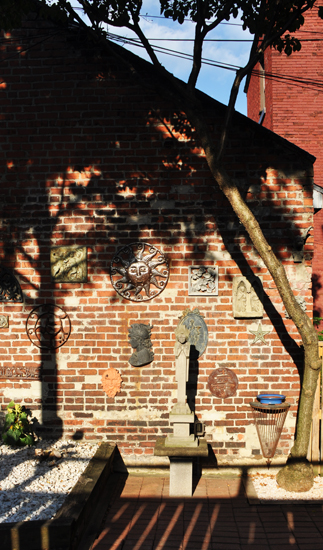
 I’ve been cleaning up the brick in the back-yard and as I was working, noticed the amazing shadows and all the shades of brown streaking the bricks. I love the gradations of reds and browns. (I am shooting east, the setting sun is behind me. The sun streams through the fence slats. In the center is Wright’s sprite; behind it is the garage wall with its reliefs and ornaments; on the left is the shadow of the California Cyprus; and on the right the Japanese lilac leans over the water-spirit.) Also, between beginning this post and now, I’ve cut off the bottom most branch of the Japanese lilac. I’m going for a wind-swept look and need to remove all the verticals.
I’ve been cleaning up the brick in the back-yard and as I was working, noticed the amazing shadows and all the shades of brown streaking the bricks. I love the gradations of reds and browns. (I am shooting east, the setting sun is behind me. The sun streams through the fence slats. In the center is Wright’s sprite; behind it is the garage wall with its reliefs and ornaments; on the left is the shadow of the California Cyprus; and on the right the Japanese lilac leans over the water-spirit.) Also, between beginning this post and now, I’ve cut off the bottom most branch of the Japanese lilac. I’m going for a wind-swept look and need to remove all the verticals.
The colors remind me of our time in Pellaro and where the accommodations were not very good, but the terrace, Mount Etna in the distance, the sun-dried Calabrian hills, the Straits of Messina in front of us, the Tahiti Cafe, the small grocery store across the street and the frutta e verdura opposite us were amazing. Every evening we would set up on the terrace, by then the heat had died down, and we would eat with Etna on our left, the tankers trolling the Straits and behind us the brown hills silent in twilight.
There are two parts of the upcoming trip that are new to me and I don’t know anything about. One is Sicily and the other is Naples. (I wonder if we can go down to the Naples boat-yards. My family left Italy from Naples back in 1957.)
While in Sicily, we will go to Agrigento, the Turkish Steps, Siracusa, and the Baroque towns of the Val di Noto. Modica, where we’re staying, is a decent size city and we will walk through it looking for the places the tourists avoid.

 This post ends the Prologue. (I had to do it on an odd number – prologue-15.)
This post ends the Prologue. (I had to do it on an odd number – prologue-15.)
This past week, I’ve been writing to my cousin Rose and talking about all the detail work she does when planning our trips. For the past 10 years, she has managed all the trip planning. I’m good at suggesting places to stay and visit, but she turns those suggestions into actual trips. She researches accommodations, she finds out when the local food markets happen, she even knows the specialty foods of each area we will be in. Last year when we had a horrendous experience with our airline reservations, she went as far as re-routing my ticket so that we could all travel together. This time we are not traveling together and I’ve taken on a lot of the planning she has done. So in our emails, we’ve been about trip details. It amazes me how time consuming the planning process is and I’m glad I had the opportunity to go through it with her as a mentor. This year we are staying in 4 different locations and each house/B&B requires its own set of details and planning steps.
I decided to use the above pic of the steps in my back-yard to both represent the steps of the planning process, but also to write about the work I’ve been doing to clean the bricks. Every 5 years the bricks need cleaned, because they get covered with weeds that grow flat on their surfaces or in the crevices between each. (The bricks behind the gloves show the green plants and the moss.) And removing the lateral plants or the moss in the crevices is really hard; the plants have this amazing root system that grows under the brick making pulling the roots impossible. I can remove the flat, green leaves, but in a week the plant has regenerated. The only solution is to pick up each brick and tear out the root systems.
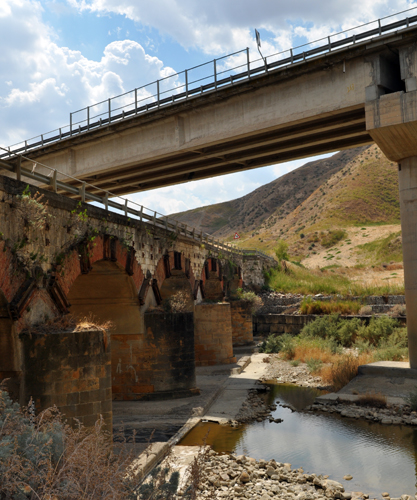
 Our various flights from Pittsburgh to Sicily were very different than any others I’ve been on. In Pittsburgh, we got to ticketing and the agent signed Sarah up for an AE card with 50,000 ai-rmiles. Afterwards, she walked us through the priority line and we had no wait-time. JFK was a bit more work, but we got through the lines and to our gate. The plane was delayed an hour. (The Alitalia agent told that we would still make our connection, because the Palermo flight was also delayed.) When we get to Rome, there was an agent at the gate who collected the Palermo passengers and walked us through the airport and put us on a fast line through immigration. But even with that, we still missed the 7:40 connection. She got us new boarding passes and made sure our luggage also go on the later flight.
Our various flights from Pittsburgh to Sicily were very different than any others I’ve been on. In Pittsburgh, we got to ticketing and the agent signed Sarah up for an AE card with 50,000 ai-rmiles. Afterwards, she walked us through the priority line and we had no wait-time. JFK was a bit more work, but we got through the lines and to our gate. The plane was delayed an hour. (The Alitalia agent told that we would still make our connection, because the Palermo flight was also delayed.) When we get to Rome, there was an agent at the gate who collected the Palermo passengers and walked us through the airport and put us on a fast line through immigration. But even with that, we still missed the 7:40 connection. She got us new boarding passes and made sure our luggage also go on the later flight.
We got to Palermo and our luggage was there. The Palermo airport is very nice. There was even someone with a broom and pan, cleaning the debris the travelers were leaving behind. (Fiumicino has gone through a massive renovation and the new space is comfortable and clean.) We got our rental and we left for Modica.
The drive along the northern coast was a visual contrast. One the left was the very blue Mediterranean on the right these tall brown mountains. (We actually drove the section where Giovanni Falcone’s car and the accompanying security cars all got blown up by the mafia. There is a marker on the auto-strada commemorating this event.) We then took a right and headed inland. The majority of the inland highway is a super-structure built on pylons and concrete support pillars. Inland Sicily is all farmland the northern area dedicated to wheat and the central and southern area gives way to vineyards and fruit orchards.
The image on the left is a riverbed under the super-structure and over an ancient road with 5 arches over the riverbed. (The super-structure was a huge post-war, put-everyone-to-work project. And I’m sure no one understood or was aware of the amazing environmental significance of this design. The super-structure leaves the land un-scared.)
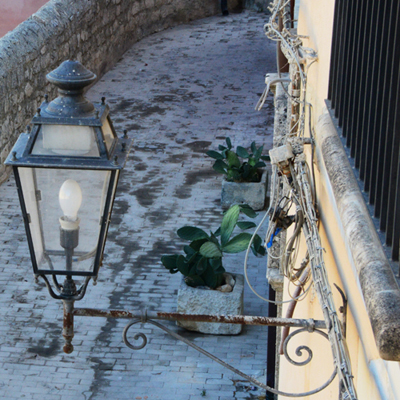
 We are staying in a very old house that has been beautifully restored and renovated. The street floor has vaulted ceilings that have been sandblasted clean Half the area makes up the entrance to the house and the other half at one time probably contained a cellar or an animal holding area. The holding area is now a large bedroom, a kitchen, a dining/living room area and an amazing bathroom carved out of the ancient rock and made modern. The piano nobile is very pretty. A porch, overlooking the western half of the valley, has been carved out of the front part of the floor and a kitchen, bedroom, bathroom and living area make up the rest of the floor.
We are staying in a very old house that has been beautifully restored and renovated. The street floor has vaulted ceilings that have been sandblasted clean Half the area makes up the entrance to the house and the other half at one time probably contained a cellar or an animal holding area. The holding area is now a large bedroom, a kitchen, a dining/living room area and an amazing bathroom carved out of the ancient rock and made modern. The piano nobile is very pretty. A porch, overlooking the western half of the valley, has been carved out of the front part of the floor and a kitchen, bedroom, bathroom and living area make up the rest of the floor.
In the image on the left, I am standing on the small living room balcony. The street-light design and placement are standard throughout the old town. Modica is one of the 8 small towns that was totally rebuilt after the 1613 and 1693 earthquakes. And all 8 towns were rebuilt in the Baroque style. (Baroque describes the grand, overstated, dynamic late-European art between 1650 and 1700. St. Peter’s in Rome is grand Baroque.)
The wires show how electrical and cable get to homes in these ancient towns. All outside wires run along the walls of the houses and because all housing is contiguous there is no problem with gaps.
The cactus plants are everywhere in Sicily and their fruit the prickly-pears or as the Italians call them ficodindia are eaten and used to flavor liquors and pasties. The plants were originally used as boundary markers between properties. One farmer got angry with his neighbor and decided to strip the fruit off the plants. The plant re-bloomed and produced even larger fruit the second time around – a new crop yield method was discovered.

 South-eastern Sicily has been a total surprise. The drive through the middle was through rugged, brown landscapes; through fields planted with citrus, pomegranates and corn; Modica is this wonderful place off-the-beaten-track, it’s full of people at night, the shops are open and the is a great home-base; also there are very few tourists. The roads in the area are limited by the terrain so they’re easier for foreigners like us.
South-eastern Sicily has been a total surprise. The drive through the middle was through rugged, brown landscapes; through fields planted with citrus, pomegranates and corn; Modica is this wonderful place off-the-beaten-track, it’s full of people at night, the shops are open and the is a great home-base; also there are very few tourists. The roads in the area are limited by the terrain so they’re easier for foreigners like us.
Today we drove north to Caltagirone another of the 8 towns in the Val di Noto that was destroyed in the 1613 earthquake and rebuilt in the Baroque style. Calatgirone is also a ceramic center in Sicily. The drive north took us through some beautiful country. We had to stop and just look at the landscape and I went down into the field to shoot the bridge on the white road. (White roads in Italy are paved with a white gravel; they’re country roads in good condition; but they take you off-the-beaten-track; there are no gas stations, no traffic light and no crazy people trying to pass by pulling into the on-coming lane.) The landscape is nothing like the rest of Italy. (The modern building all look the same regardless of where you are, but the ever-present Baroque is unique, the fields are perimetered by dry-stone walls and many of the roads are all elevated providing amazing vistas.)
Piazza Armerina helped me understand why the people left and went to America. The town was a hovel of small streets and alleys, but the Spanish conquers lived in lavish palaces. The fields around the town still have remnants of the feudal system that the people lived under. It was a great example of Spanish power and the indentured people that they exploited.


Siracusa or specifically the island of Ortigia is the home of Archimedes, (The above image is attributed to Archimedes. And tell me it isn’t a quote that’s right up my alley.) the gorgon and Caravaggio’s Santa Lucia al Sepolcro – the Burial of Santa Lucia.
We get there around 10:00 and walk through the food-market full of fruit-and-vegetables and fish. There was tuna, there was sword fish, there were eels, sardines, anchovies and squid. And across the street is the Temple of Apollo. From the market we walked up to the cathedral an amazing structure that retains its Greek, Romanesque, Muslim and Catholic architectural influences.
From the cathedral we went into the Jewish quarter looking for the last remaining ritual bath still in existence here in Sicily. We found the bath, but were not able to take the tour because we were too late. Our next stop was the church and St. Lucy and the famous Caravaggio.
And lunch, OMG! We went to a restaurant recommended by the woman from the agency that I had worked with early in our planning process. (Originally we were going to stay in Ortigia, but that fell through.) We began with antipasti one all vegetable and one all fish and from there we went to the pasta. Let me just say that each year I bring home a food idea, last year it was the caffè shakerato, this year it will be bread-crumbs. The Sicilians put bread-crumbs on fried peppers, on spaghetti. On the fried peppers the bread absorbs the olive oil, on the spaghetti it absorbs some of the tomato sauce. The bread-crumbs give both dishes a texture that I love.

 We arrive in Noto, the most famous of the 8 Baroque towns rebuild after the 1613 earthquake and coming down the cathedral steps is a funeral. (Naturally, I had to shoot it.) We found out later that the funeral mass was held at a different church, because the cathedral had been reserved for a late afternoon wedding – death and life and in this instance life had a reservation and decorators waiting in the wings.
We arrive in Noto, the most famous of the 8 Baroque towns rebuild after the 1613 earthquake and coming down the cathedral steps is a funeral. (Naturally, I had to shoot it.) We found out later that the funeral mass was held at a different church, because the cathedral had been reserved for a late afternoon wedding – death and life and in this instance life had a reservation and decorators waiting in the wings.
I have to say that the Nikon captured the true color of the amazing cathedral. The stone here is more orange than in the other parts of the Val di Noto and with the late afternoon sun bathing the facade the Baroque grandeur glows. Also, the cathedral has been totally restored. In the late 90’s the dome collapsed and in the rebuild, the town also restored the outside of the structure.
Early in the planning, I had wanted for us to stay in Noto, but am glad there was nothing available. The small town was crowded with tourists and outside the main town square and the main street we did not see much commercial development. Instead here in Modica, we can walk down the hill and hit the stores, the gelaterias, the chocolate shops, the cheese shop and all the restaurants.
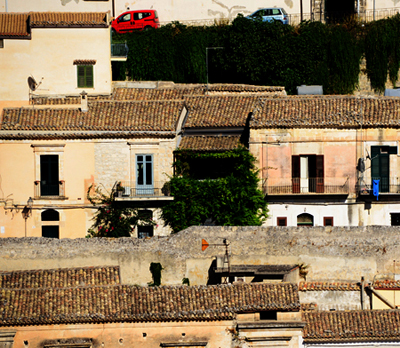
 Today we decided to not travel, relax and explore the other side of the valley from where we are staying. In the image on the left, I am shooting from the west. In the middle, in the middle row of houses is one with a lower roof and with greenery on the second floor. That is the house we are renting. Above the house and one street behind us is a red car. That is the Fiat QUO that we are driving.
Today we decided to not travel, relax and explore the other side of the valley from where we are staying. In the image on the left, I am shooting from the west. In the middle, in the middle row of houses is one with a lower roof and with greenery on the second floor. That is the house we are renting. Above the house and one street behind us is a red car. That is the Fiat QUO that we are driving.
The western slope is probably the oldest part of the town. There are no wide streets, no Baroque churches and no palaces. It’s the medieval city. We walked through narrow alley, and hundreds of steps to get to the top. But the vistas from this side are amazing, because you are looking at the rebuilt, Baroque.
There seems to be a lot of renovation on this side of the valley. We passed many homes being rebuilt and many of the building permits listed British names as the owners. Modica is known to Europeans and not know to American tourists which is fine by me.
At the bottom of the hill, we went looking for the pastry shop that had the cookies that the agency left for us and after that find, we sat and had a granita. He was out of coffee, so we had lemon and almond ones.
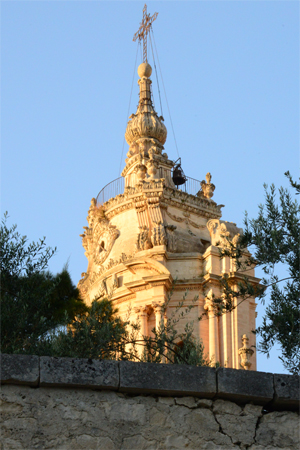
 We’re walking back to the house after our trek up the opposite valley and down to the stores for cookies, pasta and granita and I’m looking up from the alley and see the setting sun bathing the spire of the cathedral. The light turns the stone a honey hue. (In Noto, the evening light and the golden stone make for a spectacular backdrop.) Well there was that same golden hue on the Cathedral of San Giorgio.
We’re walking back to the house after our trek up the opposite valley and down to the stores for cookies, pasta and granita and I’m looking up from the alley and see the setting sun bathing the spire of the cathedral. The light turns the stone a honey hue. (In Noto, the evening light and the golden stone make for a spectacular backdrop.) Well there was that same golden hue on the Cathedral of San Giorgio.
The churches here have not undergone any cleaning or renovations. St. Peter’s the other large Baroque is slowly falling into disrepair. The statues on its outside steps are deteriorating, the inside walls and plaster are crumbling; the place needs a good vacuuming. I don’t know if there is a conservation society that will keep Modica’s patrimony from being destroyed by modern pollution. Modica is real and alive with people going about their day-to-day lives. Noto was much more touristy and artificial at least the part we saw. Also, I’m glad we’re staying in Modica; Noto is much too small and the rental was in the middle of all the tourists. Modica allows us to rub elbows with the locals, buy locally produced products and the house is amazing.
Let me add that the weather has been great. The mornings and evenings are cool to the point of needing long sleeves. (I’ve never been here this late in the season and it seems the best time to travel.)

 Siracusa so much that we decided to go back again today. We drove and parked in Ortigia and went walking.
Siracusa so much that we decided to go back again today. We drove and parked in Ortigia and went walking.
We began in the Catacombs of San Giovanni an amazing necropolis. The Greeks had carved an aqueduct with cisterns into the rock-base that the city sits on and later the Romans and Christians carved catacombs out of the aqueduct creating a vast network of tunnels. The necropolis is laid out like a Roman army settlement. It’s so large, you take a tour with a guide.
Our next stop was the Greek Archeological Park. (Greeks from the city-state of Corinth established Siracusa around 729 BCE.) At the site, we saw the Greek Theater and Archimedes tomb. The theater is carved into the mountain creating an amazing sound amplifier.
From the top of the hill that was the new city at the time of the Greeks, we walked back to Ortigia and the market where I bought the things needed for supper. I made pasta with a tomato and tuna dressing. (This is Rose’s recipe.) We also bought prickly-pears and Rick-and-Sarah got to try them for the first time. (We bought them because they were already skinned avoiding the dreaded spine-needles.) Done with out shopping, we headed out to get some lunch,
At 3:00, we got back to the Jewish Quarter to take the tour of the Mikvah. The ritual-bath is under a palazzo that has been re-purposed as a hotel. The bath was discovered when the hotel began its renovation of the site. The volume was filled with earth. In the renovation they removed over 200 truck load of dirt before they had they had uncovered the original ritual baths. (In 1492, after an edict from Ferdinand and Isabelle of Spain that demanded all Jews in Siracusa to either convert or leave the city, the majority left. Before the exodus, the owners of the Mikvah filled it in with earth and stone.) The ritual bath is an amazing legacy from ancient time.
We return to the car, tired and ready for the drive back to Modica and there on the windshield was a parking ticked. In Italy, if you pay within 5 days there is a 30% reduction. Tomorrow, we will go to the post office to pay the ticket. (Yes, you pay parking violations at the post office, go figure. And I bet you’re wondering how I know this – let me just say this isn’t the first ticket I ever got here in the land of bureaucracy and sunshine.)
 The above image is the lungomare in Ortigia. The original rental for Siracusa was on this street. (It fell through, because the owner of the house sold it and therefore not available to the rental agency.) On Tuesday, we met the rental agent I had been working with at a caffè in the piazza of the Temple of Apollo and she refunded the down-payment.
The above image is the lungomare in Ortigia. The original rental for Siracusa was on this street. (It fell through, because the owner of the house sold it and therefore not available to the rental agency.) On Tuesday, we met the rental agent I had been working with at a caffè in the piazza of the Temple of Apollo and she refunded the down-payment.
There is a difference in the colors here and I can’t seem to put my finger on. For example, what makes for the very blue sky; what makes for the golden light in the late afternoon? I keep thinking it’s the near-desert latitude and mountainous terrain, but have no evidence for this conclusion.
Supper was great. I began by sauteing minced garlic and scallions in olive oil; to that I added cut fresh tomato, and after letting that cook for a while, I added small pieces of sun-dried tomato. (The fresh tomatoes are for liquid, the sun-dried are for flavor.) The last ingredient was the tuna in olive oil. (I would have preferred fresh tuna in olive oil, but there was none. The market in Ortigia is more like the Stip District than a farmers’ market. The vendors are permanent, local farmers do not bring their produce to sell.)
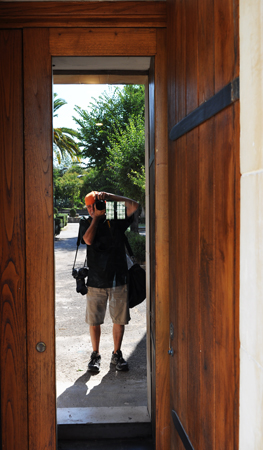
 Today we hit two more UNESCO towns – Scicli and Ragusa. One more amazing than the other, but in each we interacted with various guides and one nun. (I’ll have to write more about Scicli, because it wonderful and because we learned so much about the time when the whole of Sicily was under crisis because of the 1693 earthquake.)
Today we hit two more UNESCO towns – Scicli and Ragusa. One more amazing than the other, but in each we interacted with various guides and one nun. (I’ll have to write more about Scicli, because it wonderful and because we learned so much about the time when the whole of Sicily was under crisis because of the 1693 earthquake.)
The Nun – We’re in Ragusa, the old town with all the palaces, the Duomo and Baroque architecture. We’re almost done and heading back to the car, when at the Church of St. Joseph, I see a sign for a Benedictine Convent museum. I go in to ask and in the small entrance is the receptionist and a little old nun. I say, Bongiourno and if they are open and the cost. The nun answers, Sei Italiano, ma si e vestito come turista. – You’re Italian, but you’re dressed like a tourist. in a condescending, I’m-your-mother tone. The receptionist tells me that it’s an offering – no fixed cost. The nun pipes up again in her I’m-your-mother tone telling me that we better not leave less than 2 euros each, because it takes money to run the museum. I ask if they will give the tour in English, because my friends don’t speak Italian, the nun turns to the receptionists and tells her that she will have to do it. (She spoke Italian with no problem, she berated the turista with the orange hat with no problem, but as soon as I told her we needed an English tour she leaves and goes back into the church to join the other nuns in praying the Rosary. (Why didn’t she do that when I walked in?)
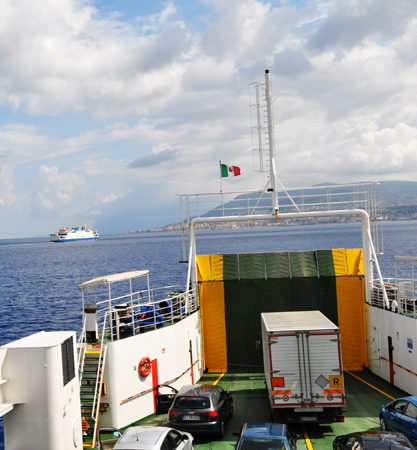
 We left Modica this morning and headed to the Autostrada. We’re going north towards Catania and then on to Messina to get on the ferry that will take us across the Straits and onto the mainland.
We left Modica this morning and headed to the Autostrada. We’re going north towards Catania and then on to Messina to get on the ferry that will take us across the Straits and onto the mainland.
We had driven the Autostrada each time we went to Siracusa, so we knew how to get to the entrance east of Modica. What have amazed me about this long entrance onto the highway are the dry-rock walls. The Sicilian contadini, cleared the fields of rock and used the rock to make walls/fences between the various properties. (In the US, we find the same things in New England. Here in Sicily the contadini used volcanic rock, in New England the farmers used flat shale.
Etna and Catania blew me away. The volcano is gigantic and the modern city of Catania spreads at the foot of mountain. Shouldn’t someone tell the Cataniesi to move? They live in the shadow of an active volcano.
We get to Messina and signage to the ferry is very good. We make it onto the 11:10 ferry and get to Villa San Giovanni on the Calabrian side by noon. My plan was to drive to a suburb of Reggio, have a granita at my favorite café, do some grocery shopping at my favorite little store and then walk the lungomare in Reggio before heading north to Belmonte. (It’s hard to like Reggio. The lungomare is its only asset.)
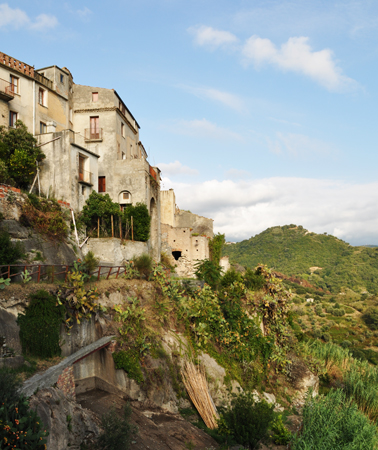
 If my mother saw the house that we are in and the ancient hilltop town she would be convinced that I had lost my mind. The town is everything they left behind for the modernity, convenience and hope of the new world. (The image on the left is outside our kitchen window.)
If my mother saw the house that we are in and the ancient hilltop town she would be convinced that I had lost my mind. The town is everything they left behind for the modernity, convenience and hope of the new world. (The image on the left is outside our kitchen window.)
We are staying in an Albergo Diffuso. This is an organization and a cooperative throughout Italy that works to renovate medieval house that have been abandoned into a dispersed hotel. In other words, the hotel is throughout the town and each renovated house is like a hotel room. A wonderful idea. The one we are staying in is the only Albergo Diffuso in Calabria. The husband and wife who run it have an interesting history. He was born in Belmonte, in one of the renovated houses, she is Venezuelan from Italian parents. They both moved back to Calabria and are making a go of a new enterprise.
Because we didn’t get a chance to shop, we decided to have dinner at the Albergo Diffuso. The meal was a phenomena. We began with a plate of antipasti – capicollo, prosciutto, olive paste on good Calabrese bread, roasted eggplant, marinated zucchini, olives, and pecorino. The primo piatto was a thick spaghetti in a light tomato sauce flavored with chunks of fresh lamb. The secondo piatto was brazed lamb with oven baked potatoes, rapini flavored with fennel, eggplant and potato and a tomato salad with sweet red onions and capers. We finished with a plate of white figs and prickly-pear, home-made yogurt flavored with lemon rind and salva, and wild fennel liquor. Rick-and-Sarah were teasing me, because I kept making all these wonderful sounds as I was eating my favorite dishes.

 We went walking through the medieval town and the alleys create a warren carved from the mountain. The houses are all stone, faced with plaster; the small, narrow walk-ways are carved out of the mountain. In modern times, the flat walk-ways have been paved with brick, the verticals steps have been finished with concrete. (The image is me following one of the sets of stairs down the mountain. On the right is the setting sun, in the middle is the WWI memorial and on the left is the Mediterranean.)
We went walking through the medieval town and the alleys create a warren carved from the mountain. The houses are all stone, faced with plaster; the small, narrow walk-ways are carved out of the mountain. In modern times, the flat walk-ways have been paved with brick, the verticals steps have been finished with concrete. (The image is me following one of the sets of stairs down the mountain. On the right is the setting sun, in the middle is the WWI memorial and on the left is the Mediterranean.)
Gabriella said that the last residents of medieval Belmonte left in the 60’s when the Italians began rebuilding the country using cement. All new construction uses a cement frame, hollow terra-cotta bricks between the framing and then everything is faced with plaster and painted. The new towns were all built near the medieval footprints. Modern day Belmonte spilled down the mountain to the flat plain in front of the Mediterranean. Gabriella said that the residents wanted the convenience of a garage, a place to park near their house but mostly they wanted out of the medieval warren.
This phenomenon – leaving the old city-centers for the modern suburb – is true throughout modern Italy. (Let’s not forget that post war America began life in Levittown.) It’s the Italy the tourists and foreigners avoid, know nothing about, criticize, and use as proof when they say Italy is going the way of Greece, Portugal and Spain. For tourists and foreigners Italy is the Renaissance – the Vatican, Rome, Florence and Venice. It is a still life. Modern Italy is of no interest. (Suburban America is of no interest.)
As we walked the UNESCO sites of La Val di Noto what we were looking at were the palaces and churches of the Spanish nobility. These are grand. Where the real people lived looked much like the warren that is historical Belmonte. The tour-guide in Scicli explained that the servants didn’t live in the palaces, but in the small houses surrounding the massive structures. Housing that had none of the conveniences – heat, running water, a bathroom – of the palaces they cleaned.
I am sitting in this little piazza outside our albergo diffuso house, in my sleeping clothes, reading email and blogging. There is WIFI throughout the historic center, but the best access is outside, because the house walls are a meter thick.
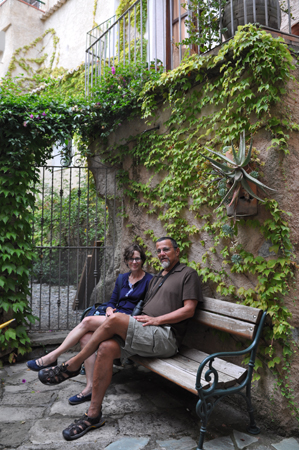
 The whole of the medieval center has free WIFI, but the best access is outside. Last night after our amazing dinner, I went up the steps and sat on the stoop of one of the albergo dissuso houses and read email and wrote posts. It was such a contrast that I had to repeat it again this morning. The difference is that this morning, I went out in the clothes I had slept in.
The whole of the medieval center has free WIFI, but the best access is outside. Last night after our amazing dinner, I went up the steps and sat on the stoop of one of the albergo dissuso houses and read email and wrote posts. It was such a contrast that I had to repeat it again this morning. The difference is that this morning, I went out in the clothes I had slept in.
The image is Rick-and-Sarah, yesterday afternoon, sitting on the bench in the small piazza where I’ve been accessing the Internet. (I’m temped to ask Sarah to take a pic of me on the stoop, with my laptop and sleeping clothes, blogging.)
So far, I’ve talked to our next door neighbor who is a local. She’s and older woman, my parent’s age. (What must she think seeing me in my T-shirt, Nike-shorts, Croq slippers and Cartier glasses sitting on an old stoop with my laptop and coffee cup? No, I don’t wear pajamas. (My mother would say, ciuti americani – crazy Americans. Also, I would never do this in Aprigliano, because someone would call her and tell her that her crazy son was sitting outside dressed badly, drinking coffee and carrying around a machine. And then she would call me and ask why I was embarrassing her.)
The second couple, I talked to, was from Rome. She was born here in Belmonte and like us is amazed by what Gabriella and her husband have created. I love talking to the Italians; I tell them I’m American, but somewhere in the conversation they want to know why I speak Italian and if I was born in Italy. And then I get to ask similar personal questions. With the couple from Rome, we traded Internet access info – best outside – and where they live in Rome – the suburbs. Conversation with the Italians is a sparring match and you give and you take, but always done with great trepidation and hesitancy. You never want to appear forward of nosy. Mining for information has to be done slowly and with grace. (Americans are way too direct for Italians and Italians then conclude that all Americans are rude and uncultured.)
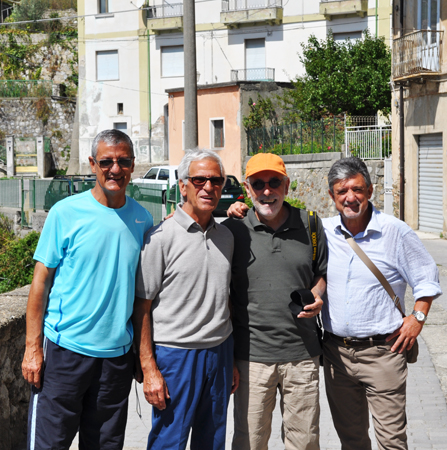
 We went up to Aprigliano and we’re walking towards Santo Stefano and we see a bunch of tourists and it turns out to be Gabriele, Corrado, and Corrado’s brother Gulio. Gabriele, Corrado and I were best friends. We were the group from La Vinella – the little street in Santo Stefano before you hit the fields. It was wonderful to see them. I saw Gabriele in Toronto years ago when he first came to Canada, but it’s been 57 years since I saw Corrado. (I remember Gulio less, because he was younger than us.)
We went up to Aprigliano and we’re walking towards Santo Stefano and we see a bunch of tourists and it turns out to be Gabriele, Corrado, and Corrado’s brother Gulio. Gabriele, Corrado and I were best friends. We were the group from La Vinella – the little street in Santo Stefano before you hit the fields. It was wonderful to see them. I saw Gabriele in Toronto years ago when he first came to Canada, but it’s been 57 years since I saw Corrado. (I remember Gulio less, because he was younger than us.)
Talk about serendipity, we’re walking towards my family’s house and there they are. Gabriele is visiting with his wife and his wife’s brother and his wife. They met up with Gulio and Corrado who both live in Cosenza. They had just come back from the house that Gabriele had grown up in and we were heading in that direction. Gabriele’s grandfather house and our house were next to each other. As kids all three of us were in and out of each other’s houses.
Now I have to figure out a way of keeping in contact with Corrado.
I’ve put together a gallery of images from the time in Aprigliano.
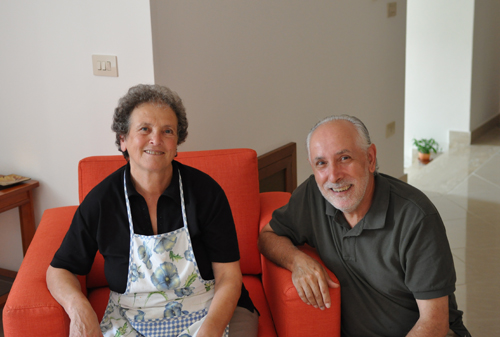
 After all the reminiscence with the old friends, we made our way to the old house. Gabriele said that the people who own it are there and that he had just visited.
After all the reminiscence with the old friends, we made our way to the old house. Gabriele said that the people who own it are there and that he had just visited.
Some background – Gabriele’s grandfather and his sister – Za Peppina – lived next to our house. The current owner – Licia, the woman that I’m sitting with, bought both houses and renovated the space into a beautiful modern living area. The space is painted all white and all the cabinetry is built in. We are sitting in what was Gabriele’s grandfather’s kitchen. The entrance behind me leads into what was Ciccio-and-Mafalda’s house. The room that was my parents’ kitchen is now the kitchen in the new house. The outside stairs that led to my parents’ bedroom is gone, so it was difficult to show Rick-and-Sarah where the pig-under-the-porch lived.
An aside – I’m sitting here in the little piazza, and the couple from Rome brought their tablet over, so that I could help them get online.
Licia, the woman that now own Gabriele’s grandfather’s house and Ciccio-and-Mafalda’s house, is related to my father through his mother. My grandmother was a Capisciolto and Licia’s maiden name is a Capisciolto. Also, she and my aunt Egilia went to school together. Aprigliano is a small, but wonderful place to have grown up in.
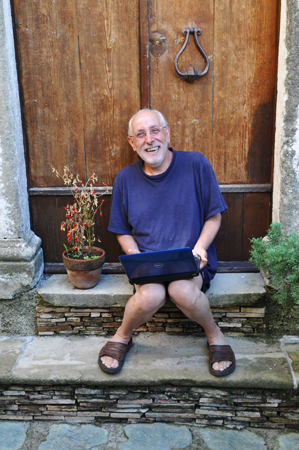
 Each morning, I’ve been going out to the little piazza around the corner from the house in my pajamas and reading email, writing posts and putting up images. Rick-and-Sarah tease me about going out in my pajamas. My comment, “I’m in a medieval, hilltop town in the middle of Calabria. And no one here in Belmonte knows my mother. (If I behaved like this in Aprigliano, my 88 year old mother would be getting phone calls.) There have been threats of sending the image on the left to Welch, so I’m preempting the threat and posting it. (Welch, remember we’re friends and go way back.)
Each morning, I’ve been going out to the little piazza around the corner from the house in my pajamas and reading email, writing posts and putting up images. Rick-and-Sarah tease me about going out in my pajamas. My comment, “I’m in a medieval, hilltop town in the middle of Calabria. And no one here in Belmonte knows my mother. (If I behaved like this in Aprigliano, my 88 year old mother would be getting phone calls.) There have been threats of sending the image on the left to Welch, so I’m preempting the threat and posting it. (Welch, remember we’re friends and go way back.)
I’ve been trying to explain that when you live in medieval warrens, with tiny houses, (our house in Aprigliano had two rooms and there was my mom and dad and me as a child), most of your activities happen outside. My mom would sit with her friends and get supper ready, going back in the house to cook the food. All the food prep was done on the stoop between your house and your neighbor’s or in a communal space. If you were sewing, then you sat in the shade together with your neighbors and you talked and sewed. There was no TV to keep anyone indoors. Also, throughout the day, houses are shut tight against the Southern Italian sun; the house was pitch black inside. Life was lived in the shade, in social groups. (I can just hear all my city-high people going on about Zinga interacting in a social group.)
While the women socialized, my friends and I would run around all day. We’d meet early in the morning and roam the town. We went into the woods around the town; we went to the other parishes/neighborhoods; we went down to the stream at the bottom of our mountain; we went up to the church-yard to kick a soccer ball. The town was our house. Gabriele told Rick that when we were all in Aprigliano, the 4 of us – Gulio, Gabriele, Mario e Corrado, – owned the neighborhood. We must have been obnoxious.)
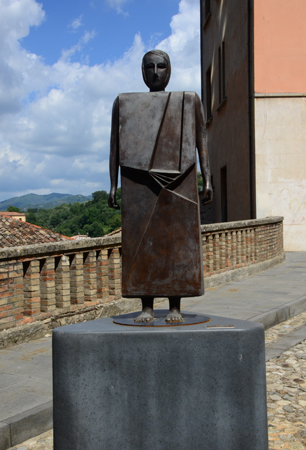
 I have to admit that I do not like any Calabrian city. Reggio, Catanzaro and Consenza are all dirty, not very well designed and full of ugly, modern concrete apartment buildings. None of the three have elegance of a Noto or the geometry of Modica the largos of Scicli. Yes, the towns of La Val di Noto were all rebuilt after the 1693 earthquake and the Spanish king, the nobility and the Church all cooperated in giving architect Giuseppe Lanza, duca di Camastra carte blanche in the rebuilding. The cities of Calabria grew randomly, municipal leadership, city planning, over-sight were missing ingredients. And the result is a hodgepodge environment.
I have to admit that I do not like any Calabrian city. Reggio, Catanzaro and Consenza are all dirty, not very well designed and full of ugly, modern concrete apartment buildings. None of the three have elegance of a Noto or the geometry of Modica the largos of Scicli. Yes, the towns of La Val di Noto were all rebuilt after the 1693 earthquake and the Spanish king, the nobility and the Church all cooperated in giving architect Giuseppe Lanza, duca di Camastra carte blanche in the rebuilding. The cities of Calabria grew randomly, municipal leadership, city planning, over-sight were missing ingredients. And the result is a hodgepodge environment.
The Calabrese have fully participated in the migration from their medieval, hilltop towns and settled in the newly built concrete structures sprouting along the perimeters of the ancient towns or in the cities of Southern Ontario. In Italy, they, more than most other Italians, have embraced English as the lingua franca, the lingua of commerce. (Is that because their legacy is more of the soil and the mountains than of cathedrals and frescoes? The image on the left is a Calabrese woman – a simple person in her peasant dress.)
The foods, especially the fruits-and-vegetables, the sopressata and the breads are among the freshest and tastiest of anywhere in Italy. The tomatoes of Belmonte with their tear-drop shapes, the eggplant in olive oil at the co-op at the bottom of the mountain, the pastries from Cosenza are worth every calorie.
The message from Calabria is: avoid the large cities, travel the secondary roads, visit family, and eat as much local food as you can get your hands on. (Last night I made a simple pasta e faggioli, but in the Calabrese style. We bought the Barlotti beans at an open market that was part of a festa – a community celebration of a Marian feast-day. I went up to a street vendor who was selling crates of tomatoes for sauce and asked him for 5 ripe one that I could use for supper and I stole basil from one of the pots around the corner. Sarah and I shelled the beans, I sautéed the tomatoes in olive oil flavored with garlic, cooked the past in the water that I had cooked the beans and then mixed everything. We drizzled olive oil with pepperoncino on top of the pasta. It was wonderful.)
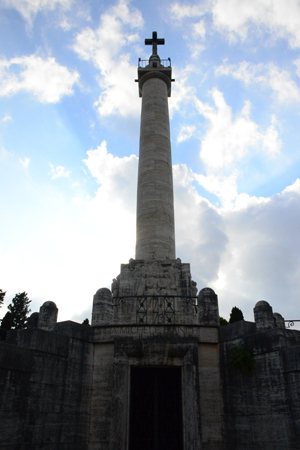
 Today was a down day, Sarah and I did laundry, Rick went down to the Mar Tirreno to swim in the Mediterranean.
Today was a down day, Sarah and I did laundry, Rick went down to the Mar Tirreno to swim in the Mediterranean.
For an outing we drove the half-hour to Paola and visited the famous pilgrimage site of San Francisco di Paola the patron saint of Calabria. San Francisco was a mendicant friar who lived a very simple life. He and his early followers hollowed out caves in the mountain above Paola and lived in them. (The people of Calabria saw in this man a person most like themselves – simple, honest, hard-working.) He was the founder of the Roman Catholic Order of Minims. (The name Minims comes from the Italian word minimo, meaning the smallest or the least.) Unlike the majority of founders of men’s religious orders, but like Francis of Assisi he was never ordained a priest. The Minims abstinence from all meat and dairy products. And the friars do not wear shoes, only sandals are allowed. (Any wonder the poor people of Calabria saw in this man someone who was most like them.)
Today, the Santuario di San Francesco is a favorite pilgrimage site for all Calabrians. People throughout the province come to Paola and the Santuario to get married. Busloads of pilgrims are driven up to the top of the mountain to visit the site.
The old church, the cloister and the gardens are beautifully preserved. To accommodate the hordes that ascend, there is a new church. This too is a beautiful space and a great example of modern Catholic design.
After leaving Paola, we drove back and stopped to visit the mausoleum of Michele Bianchi a Fascist. The monument is at the bottom of the mountain on a promontory. The pillar is Belmonte’s signature logo. Under Mussolini, he was the minister of Labor and brought to Calabria much needed money for road construction, water treatment plants and railroad development. The monument is a great example of Fascist architecture – imposing verticals that speak to power.
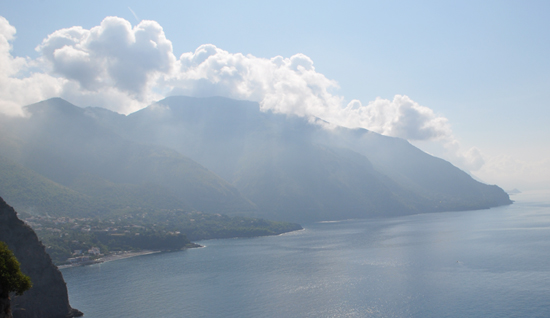
 In planning the best way to get to Naples, we decided to use the beach road or La Strada Superiore – SS18. These were the highways, before the Autostrada. (To reach the Autostrada we would have had to travel south, even though Naples was north and secondly the Autostrada would have shown us nothing new. The SS18 went up the coast and since it was past beach season, we should not hit traffic.)
In planning the best way to get to Naples, we decided to use the beach road or La Strada Superiore – SS18. These were the highways, before the Autostrada. (To reach the Autostrada we would have had to travel south, even though Naples was north and secondly the Autostrada would have shown us nothing new. The SS18 went up the coast and since it was past beach season, we should not hit traffic.)
The SS18 through norther Calabria was one beach-town after another. What was interesting was to see places that had direct access to the beach. In most of Calabria, the railroad prevents direct access. You have to find the tunnels under the railroad in order to reach the beach. Once out of Calabria, we came to Basilicata and the road is on the side of the mountains. It is a ledge and on the side of the mountain drops down to the sea. Basilicata has no coastal plain, but the small towns we went through were well maintained.
In the above image, the view is from a stop on the coastal-road looking back at the landscape we just drove through. (It reminds me of the Napali coast on Kaua’i.)
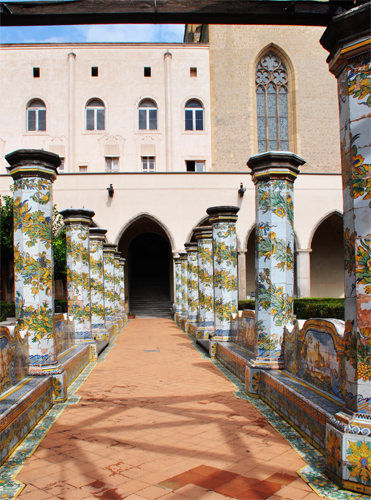
 We began the day by walking the street that divides the old center – spaccanapoli. The street has a name – Via Benedetto Croce, but the Neapolitans refer to it as the street that splits Naples. It is a pedestrian thoroughfare and free of the hurlyburly of the old city.
We began the day by walking the street that divides the old center – spaccanapoli. The street has a name – Via Benedetto Croce, but the Neapolitans refer to it as the street that splits Naples. It is a pedestrian thoroughfare and free of the hurlyburly of the old city.
We began at the Gesù Nuovo a Jesuit church built in the late 1500’s. The church was originally a palace and it retains the original facade of rustic ashlar diamond projections. However, with the expulsions of the Jesuits from Naples, the church moved into Franciscan hands. It is a massive structure and an active church. While we were there several people were going to confession and mass was being celebrated in one of the smaller chapels.
Our next stop, in the same square, was the Church of Santa Chiara a Gothic style church-convent built between 1310 and 1328 for the wife of Robert, King of Naples. The complex retains the citadel-like walls setting it apart from the outside world. The walls contained a vast religious community, and today contain the more modest convent of the Poor Clares and a community of the Grey Friars. It was almost entirely destroyed by WW II bombing and was restored to its original Gothic form in 1953.
The above image is of the monastic courtyard which was renovated in the 1730s, for Maria Amalia of Saxony, wife of Charles III of Bourbon, King of Naples. The majolica tile-work is characteristic of Neapolitan ceramics from that time.
There is more on the church of the Poor Clares in an epilogue post.
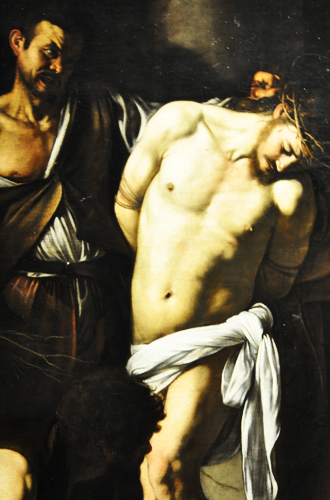
Our three days almost over, and I come away thinking that there are many Naples – the city of the Farnese and the Caravaggios and the city of the graffiti and the beggars.
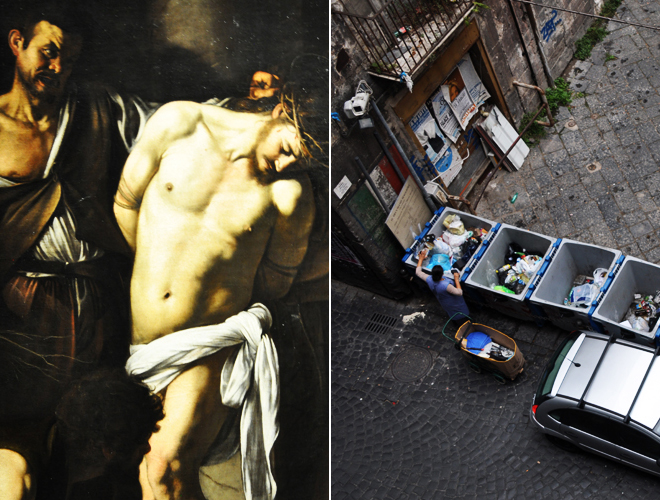
Yesterday we found the first Caravaggio in a palazzo build by a group of noblemen to house a chapel and the administrative offices of a charitable organization. From that palazzo, I shot the woman picking through the garbage bins. (Notice the camera above her. There are cameras everywhere in the old center.) Afterwards we walked through the palace that houses the Archeological Museum with its treasures from antiquity.
Today we went up to the top of the mountain and made our way through the Capodimonte Museum and the Farnese collection with its Caravaggio. The palace and the art were amazing. (The image on the left is The Flagellation by Caravaggio.) In the afternoon we walked Via Toledo, one of the main arteries of the city, the outside shop-walls are covered in graffiti. All buildings in the historic center are covered in graffiti.
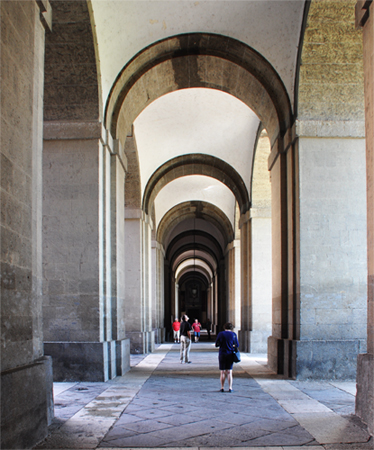
 All the Baroque building are either built out of a black rock or trimmed out in it. (It’s like black bunting at a dignatary’s funeral.) Also the streets in the old city are all paved in a back rock. After some research, I come to find out that it is a volcanic Piperno stone. It creates a funereal environment. And to top it all off, the main cathedral –Cattedrale di San Gennaro – is all about the worship of the dead – there are over 40 reliquaries in one chapel alone each is a silver bust of some saint and it contains a bone fragment, a piece of cloth or some other object that the saint had handled in his/her life. And let’s not forget the blood of San Gennaro and his bones in the crypt under the altar. (Sarah and I walked down to the crypt in the Cattedrale and 30 some women were kneeling in front of an altar that contained the bones of San Gennario praying the rosary.)
All the Baroque building are either built out of a black rock or trimmed out in it. (It’s like black bunting at a dignatary’s funeral.) Also the streets in the old city are all paved in a back rock. After some research, I come to find out that it is a volcanic Piperno stone. It creates a funereal environment. And to top it all off, the main cathedral –Cattedrale di San Gennaro – is all about the worship of the dead – there are over 40 reliquaries in one chapel alone each is a silver bust of some saint and it contains a bone fragment, a piece of cloth or some other object that the saint had handled in his/her life. And let’s not forget the blood of San Gennaro and his bones in the crypt under the altar. (Sarah and I walked down to the crypt in the Cattedrale and 30 some women were kneeling in front of an altar that contained the bones of San Gennario praying the rosary.)
Naples was the only place we saw people go up to coffins and reliquaries and touch them, kiss them, pray in front of them. None of this behavior is seen as strange or in need of corrections.
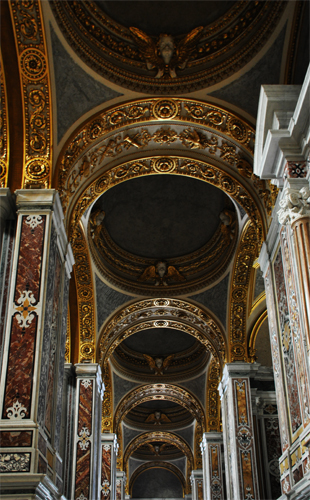
 We drove from Naples and stopped at Cassino to see the WWII cemetery and the monastery at the top of the mountain. St. Benedict of Nursia established his first monastery here around 529. He remained the rest of his life here on the mountain. It was at Montecassino that he wrote his Rule, a set of guidelines for laymen wishing to live a spiritual. The Rule of St. Benedict would become the pattern for monastic rules across medieval Europe.
We drove from Naples and stopped at Cassino to see the WWII cemetery and the monastery at the top of the mountain. St. Benedict of Nursia established his first monastery here around 529. He remained the rest of his life here on the mountain. It was at Montecassino that he wrote his Rule, a set of guidelines for laymen wishing to live a spiritual. The Rule of St. Benedict would become the pattern for monastic rules across medieval Europe.
In World War II, the hill of Monte Cassino was part of a German defensive line guarding the approaches to Rome. Montecassino became the target of assault after assault by Allied troops, and was finally destroyed by air bombardment. The hill was captured at dreadful loss of life by the Polish Army and Italian refugees. After the war, the abbey was rebuilt based on the original plans.
The entire monastery complex was rebuilt in all its splendor. (The image on the left is the ceiling in one of the side isles in the basilica. The cupolas are not frescoed.) While southern Italy was being emptied, because of the post war poverty, the Benedictines here on the Roman plain were rebuilding the bombed monastery. Talk about the mess that was Italy. My family and millions of other Calabrians had to leave their homeland and head to foreign shores in order to put food in the mouth of their children and give hope to their families. All the while, the Benedictines at Montecassino were paying for gold-leaf on the ceilings of the rebuilt abbey.
Throughout the trip from Palermo to the Val di Noto to the Naples to Cassino, we saw the wealth of the 1% that owned Italy. (In the museum at Montecassino, there are old maps of the land/territory that the monastery controlled and managed. For miles around the hilltop structure the land and all its environs belonged to the Benedictines.)

 Our first full day in Rome. (Yesterday, late afternoon, we walked along the Tevere up to Castel Sant’Angelo and down the grand boulevard that leads into St. Peter’s Square. The square wasn’t as over whelming as it is in full daylight.) I got up this morning and made my way down; I met one of the people who lives in the building and asked about where I could get some dolci for breakfast; he pointed me to a pasticceria around the corner.
Our first full day in Rome. (Yesterday, late afternoon, we walked along the Tevere up to Castel Sant’Angelo and down the grand boulevard that leads into St. Peter’s Square. The square wasn’t as over whelming as it is in full daylight.) I got up this morning and made my way down; I met one of the people who lives in the building and asked about where I could get some dolci for breakfast; he pointed me to a pasticceria around the corner.
After coffee and dolci, we began by again walking along the Tevere, this time going south to a huge bazaar of cheap clothes, cheap jewelry, cheap purses, cheap furs, cheap scarves, cheap this, cheap that. (I remember my mother and grandmother taking me to the bazaar down in Cosenza with all its bancarelle. When the bazaar is full of clothing vendors their stands in dialect are called bancarelle. This is to distinguish the bazaar from a farmers’ market or from an antique market.) We walked through the southern section of Trastevere making our way to the Piazza di Santa Maria in Trestevere. This is a Borghese church. (The noble families of Italy always had one son in the Papal court and he lived in a palace close to the Vatican. The son, by virtue of nobility, was always a cardinal. And these cardinals built churches throughout the city and became patrons for the areas/neighborhods where the commissioned church was built.)
The above image is of the horizon showing, from left to right, the winged angels atop of Mussolini’s famous building in Piazza Venezia, the Jewish Synagogue in the Campo di Fiori district and a steeple of a Catholic church in the next neighborhood down.
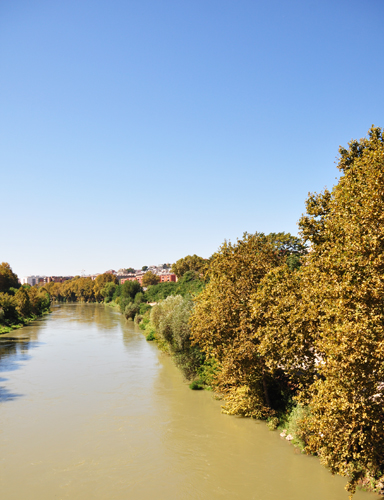
Below Trastevere, the river meanders; it’s not banked by concrete and stone sidings; it’s shores are crowded with vegetation; and the Romans use the paths for jogging and bike-riding.
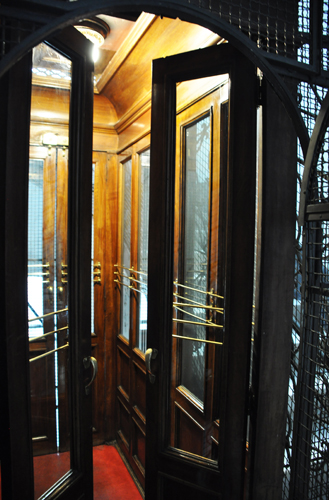 I thought I’d write about the great apartment we in. (The image on the left is one of two elevators in the building. An Otis turn-of-the-century treasure that runs perfectly well.) When I made the four reservations for the accommodations, the one I had the least information about was the apartment in Rome. The original reservation was for a wonderful three-floor apartment in the Jewish quarter, but the owner – Rodolfo – had to cancel, because they were going to repair the roof and drain-spouts in his apartment building. I asked him to recommend something and he sent me to his niece who managed an apartment in Trastevere. Transtevere is across the river from Campo di Fiori – the old Jewish Quarter. (The Trastevere/Campo di Fiori districts are the sections of Rome I know best and I wanted to be here. Also, all the other places were either too expensive, too tiny or too far from the main attractions.)
I thought I’d write about the great apartment we in. (The image on the left is one of two elevators in the building. An Otis turn-of-the-century treasure that runs perfectly well.) When I made the four reservations for the accommodations, the one I had the least information about was the apartment in Rome. The original reservation was for a wonderful three-floor apartment in the Jewish quarter, but the owner – Rodolfo – had to cancel, because they were going to repair the roof and drain-spouts in his apartment building. I asked him to recommend something and he sent me to his niece who managed an apartment in Trastevere. Transtevere is across the river from Campo di Fiori – the old Jewish Quarter. (The Trastevere/Campo di Fiori districts are the sections of Rome I know best and I wanted to be here. Also, all the other places were either too expensive, too tiny or too far from the main attractions.)
I began an email correspondence with Rodolfo’s niece and after seeing images of the apartment and realizing the price was the best I had seen, I sent her a down-payment. I still wasn’t sure what to expect and I had made up my mind that the accommodations were probably going to be fair-to-poor, but it was our last week and we had stayed in wonderful places in Modica and Belmonte. (The B&B in Naples was in the middle of everything, but like everything else in Naples it was an example of faded glory. It had been a palazzo that had been converted to apartments. The vaulted ceilings were all in tack, but the bathrooms were just added to the room. You walked in, saw the faded glory and then saw a cube that had been added to the room. Also, no renovations had been done in years. All fixtures were easily 30 years old.) To be honest, I had expected a similar set of rooms in Rome.
Well, let me tell you the apartment is nothing like the one in Naples. It is a beautiful spacious apartment. We have a dining-room, a living-room, a beautiful spacious foyer and all overlooking the Tevere and minutes from all the main attractions. OMG, it’s the kind of place I would love to live in if I had to be in Rome for any length of time. The icing is that the Internet is reliable, works fast and can be accessed in every room. (Have found that reliability nowhere else in Italy.)

 Campo di Fiori is the square in the old Jewish ghetto that has always been the place where the farmers of Rome have brought their produce to sell to the locals. And after all these years, I got to go and shop for fruits-and-vegetables. In the past, I was too rushed to think about cooking dinner or the places I was staying had no kitchen.
Campo di Fiori is the square in the old Jewish ghetto that has always been the place where the farmers of Rome have brought their produce to sell to the locals. And after all these years, I got to go and shop for fruits-and-vegetables. In the past, I was too rushed to think about cooking dinner or the places I was staying had no kitchen.
We bought new potatoes, artichokes, basil, rosemary and porchetta. And Rick made oven-baked potatoes and Roman style artichoke.
After our food shopping trip, we headed to Piazza Venezia, the Mussolini balcony and the over-exaggerated Victorio II building. (The Altare della Patria also known as the Monumento Nazionale a Vittorio Emanuele II or Il Vittoriano is a controversial monument built in honor of Victor Emmanuel, the first king of a unified Italy. The Italians refer to it sarcastically as the wedding cake.)
We then headed over to the Roman Forum and finally the Coliseum. I have never been to this famous landmark and I have to say, the Romans have done an amazing job restoring the structure and making it very tourist friendly.
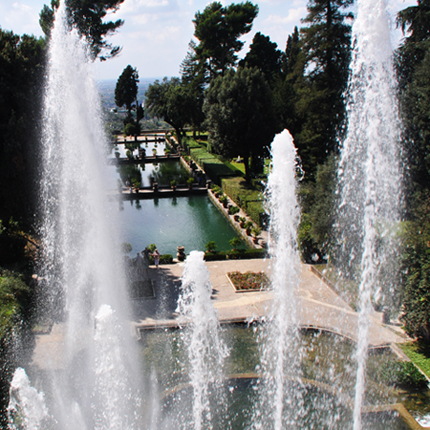
 We kept the rental until today, so we could drive out to Tivoli and visit the Villa d’Este – the famous country house of Cardinal Ippolito II d’Este. The villa is best known for its terraced gardens and fountains. (The country-side east of the city was a favorite retreat for the nobility during the hot Roman summers. Castel Gandolfo, the Papal summer residence, is in this area.)
We kept the rental until today, so we could drive out to Tivoli and visit the Villa d’Este – the famous country house of Cardinal Ippolito II d’Este. The villa is best known for its terraced gardens and fountains. (The country-side east of the city was a favorite retreat for the nobility during the hot Roman summers. Castel Gandolfo, the Papal summer residence, is in this area.)
Because we had to drive through the middle of the city to get to the Autostrada, we got to see the camps for the University of Rome – Sapienza. And like the university district in Naples, it too is full of graffiti.
Once we got to Tivoli, it took us almost 45 minutes to figure out how to get to the villa. No guide-book tells you to park in the center of town and walk the five minutes down the hill. (After driving in endless circles looking for the road that would take us to the house, we pulled over and I went and asked someone for directions. That’s how we found out that the house was around the corner and we just had to park and walk.)
The garden is a set of terraces on the hillside and it’s designed like a group of stage-sets. Each set has a fountain at its center. There is a stage-set with Athena presiding over cascades and spouting fountains. There is a stage-set with a relief of Artemus Ephesus the fertility goddess and each of her breasts is a fountain spout. There are three large reflecting pools all fed by the largest fountain in the garden. The above image shows the pools and the jets of the largest and most spectacular fountain.

 We began our trek crossing the Tiber at Ponte Garibaldi. (I’m shooting up-river at one of the ancient bridges. The larger image has St. Peter’s above the tree-line, but the dome got cropped in creating the narrow slice for the post.) The streets were empty of tourists at least until we got to the Pantheon. Rick is great with a map and he got us to the Pantheon using the opposite side of the circle than I would have used. (Using the distance from where we’re staying to the Pantheon as a diameter, he took us right where I know the route going left.)
We began our trek crossing the Tiber at Ponte Garibaldi. (I’m shooting up-river at one of the ancient bridges. The larger image has St. Peter’s above the tree-line, but the dome got cropped in creating the narrow slice for the post.) The streets were empty of tourists at least until we got to the Pantheon. Rick is great with a map and he got us to the Pantheon using the opposite side of the circle than I would have used. (Using the distance from where we’re staying to the Pantheon as a diameter, he took us right where I know the route going left.)
The Pantheon, similar to the Coliseum, was full of tourist groups, but we were there early enough that the mob wasn’t overwhelming. The Roman structure with its magnificent oculus deserves all the visitors. (The last time I was here was the summer of 1971. I had forgotten that Rafael is buried here, but I hadn’t forgotten the oculus.) The Roman temple has been turned into a Catholic church and on the Feast of Pentecost, workmen drop thousands of rose-petals through the oculus during mass. The marble floor is covered in rose-petals.
From there we wound our way back to Piazza Navona another of my favorite places. The last time I was here it was mid-August and the place was wall-to-wall tourist. Traveling is September has been great. The weather has decent and the mobs manageable.
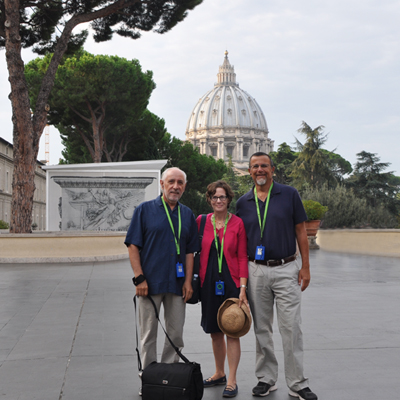
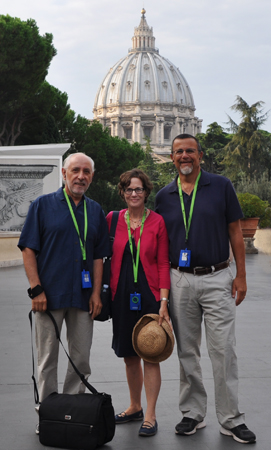 This morning we went to the Vatican for a guided tour. As part of the package, we got in before the mobs and were able to be in the Sistine Chapel with a smaller group.
This morning we went to the Vatican for a guided tour. As part of the package, we got in before the mobs and were able to be in the Sistine Chapel with a smaller group.
The guide first brought us out to a huge balcony and she was willing to take pics. (The pic is altered. There were several people behind us, but after dealing with the mob in the galleries, I wanted to pretend that there was a minute when we were on our own, so I Photoshopped the other tourists out. Also, we are wearing the ubiquitous head-sets that tourist-groups wear around their necks. All over the city, tourist groups are led around by a guide that talks to them through the head-sets.)
I don’t think anyone will understand the vast number of people that are allowed into the Vatican Museum at any given point. There were times throughout the tour when the long hall in front of us and the long hall behind us were filled with tourists. As far as you could see in front of you and and far back as you could see was all tourists. At one point we got to look out onto Bernini’s colonnaded square just to see the line waiting to go into the Basilica. It circled the entire square. These were people in line just to get into the church and the tour-guide said it would be a 4 hour wait to reach the front of the line and get into the church.
Because of the mobs, the tour-guide concentrated on the Michelangelo works, the Rafael frescoes and the Basilica. We raced by Dali and Chagall paintings; we ran through a room full of Matisse drawings and tapestries. I never got to shoot the Laocoön. I saw it as we rushed to get ahead of the mob.
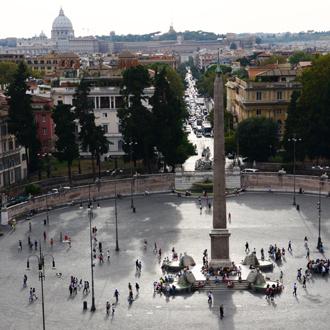
The whole time we were in Le Marche, we traveled the Via Flaminia. The modern Strada Provinciale 3 paralleled the old Roman road. And near Fossombrone, we went to the hand-carved tunnels through the mountains – left image. Yesterday, we made our way to Piazza del Popolo – right image – the southern terminus of the Via Flaminia. (The modern Italian name for the square is a corruption of the Latin. The original name was The Square of the Poplars. In modern Italian is has a very democratic name The Square of the People. The Latin for poplar – populus – is very similar to the the Italian word for people.)
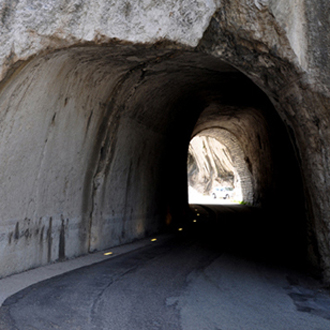 |
 |
Today the same route, still called by the same name for much of its distance, is paralleled or overlain by Strada Statale (SS) 3 in Lazio and Umbria, and Strada Provinciale (SP) 3 in Marche. Once through the mountains, it descends the eastern Apennines and splits, one branch going to Fano on the coast and the other going north to Rimini.
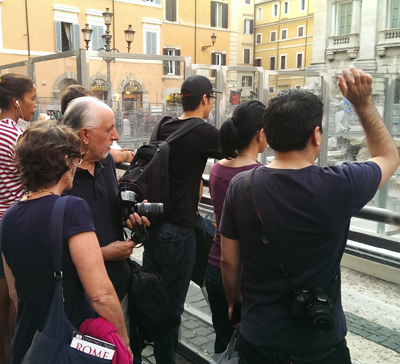
 After the morning and the mob at the Vatican, we went back to Trastevere, rested and made plans for the afternoon. The goal was to head north to the La Piazza del Popolo and then walk back downhill to our apartment. We took the subway up to Piazza del Popolo and then began our walk back. Via del Babuino the straightest path to the Spanish Steps, is the modern Via Veneto.
After the morning and the mob at the Vatican, we went back to Trastevere, rested and made plans for the afternoon. The goal was to head north to the La Piazza del Popolo and then walk back downhill to our apartment. We took the subway up to Piazza del Popolo and then began our walk back. Via del Babuino the straightest path to the Spanish Steps, is the modern Via Veneto.
In the 1970’s the Via Veneto was the most famous street in the city. It was the place to see and be seen. There’s a plaque to Fellini on the street.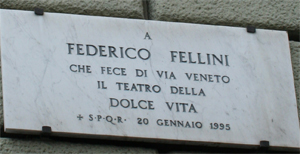 It reads To Federico Fellini who made the Via Veneto that stage for La Dolce Vita But today it’s a memory of its former self and it has been replaced by the Via del Babuino. The Babuino is being repaved and made into a pedestrian road.
It reads To Federico Fellini who made the Via Veneto that stage for La Dolce Vita But today it’s a memory of its former self and it has been replaced by the Via del Babuino. The Babuino is being repaved and made into a pedestrian road.
After the street with all the high-end designers and the Spanish Steps we walked down to La Fontana di Trevi. The fountain is being rehabbed and the work is being paid by Fendi. There’s no water in the basin or spouting from its statues, but there is a walkway over the basin and a small pool to throw your coins into. Sarah and I threw our coins.
This was my first experience with a potential pick-pocketer/crook. Sarah and I were standing there getting ready to throw our coins in and he suggested that he could take our pic. Now he had a camera, but all my senses were in hyper alert. He was perfect – his own camera in hand, Asian, soft spoken. I could be mistaken, but it felt creepy and the area is famous for pick-pocketers and crooks. (He was in the original pic, standing right behind Sarah; I cropped him out.)
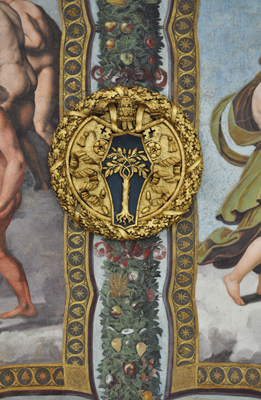
 This being our last day in Rome, we wanted to do an easy walk. We decided to go to the two museums down the street from where we’re staying.
This being our last day in Rome, we wanted to do an easy walk. We decided to go to the two museums down the street from where we’re staying.
The Villa Farnesina, located in Trastevere, is considered one of the noblest and most harmonious creations of Italian Renaissance. Cardinale Alessandro Farnese bought it 1579 and named it Farnesina, a diminutive form of the family name, to distinguish it from Palazzo Farnese on the other side of the Tiber. In the art world, the Farnesina’s claim to fame is Rafael’s fresco the Triumph of Galatea. Raphael did not paint any of the main events of the story. He chose only the scene of the nymph’s glorification. Galatea appears surrounded by other sea creatures whose forms are somewhat inspired by Michelangelo figures in the Sistine.
I am less interested in the one fresco, but more interested in the fact that a cardinal who already had a super-sized villa on the other side of the Tiber needed to buy a smaller house with a large garden, something more country-style. Was the cardinal a predecessor of the billionaires who are crowding out the millionaires in Vale?
It took generations for Italy to die under the weight and greed of the 1%, but it did. World War II was the end of Italian political and financial influence on the continent. It was was 400 years between the time that Cardinal Farnese bought the villa and the end of WW II. (The above image is the coat-of-arms for the Chigi family who had the villa built and from whom the Cardinal bought it.) How long will it take American corporate society to bankrupt the country? Both empires were and are being built on the backs of the 99%.
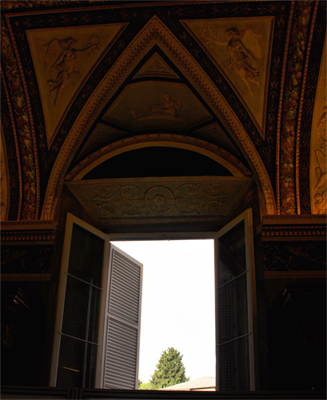
 I’ve been thinking about all the churches and palazzi we went into and my conclusion is that the churches were the lesser of the two evils. The churches, even in the time of the one-percenters, were always open to the public where the palazzi were off limits. The high, brick wall that surrounded the formal gardens of the Villa Farnesina is still intact. There was no access to this country-home.
I’ve been thinking about all the churches and palazzi we went into and my conclusion is that the churches were the lesser of the two evils. The churches, even in the time of the one-percenters, were always open to the public where the palazzi were off limits. The high, brick wall that surrounded the formal gardens of the Villa Farnesina is still intact. There was no access to this country-home.
The image on the left was taken in The Vatican. We were walking down a hall full of tall cupboards, the filing system before the modern age, and there was an open window. For me, it suggests the nobles, in their gilded palazzi, looking out.
Throughout the 3 weeks, we went in and out of churches and palazzi in order to see the art and the architecture. The palazzi blew me away. The fact that the one-percenters could live in such splendor, had access to master craftsmen was information I had never applied to my understanding of Italy. It became most evident at Montecassino, the monastery that was re-built in all its splendor, in four years after having been destroyed in WW II. And during the rebuilding, southern Italy was being emptied, because of poverty. Carlo Levi’s Cristo si è fermato a Eboli became the metaphor for the poverty of Il Mezzogiorno – the region south of Naples. As an expression it means the opposite of its literal meaning – Christ stopped at Eboli. As an expression it suggests that the people of Il Mezzogiorno feel they have been bypassed by Christianity, by morality, by history itself; that the people of the south have been excluded from the full human experience.
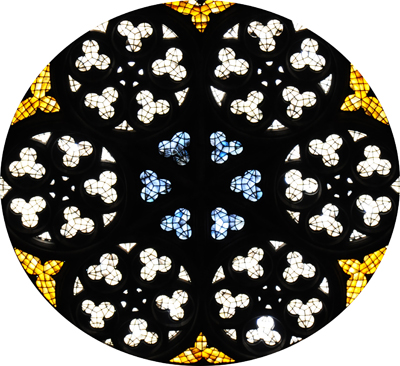
 The huge campus that is the church, monastery and cloister of the Poor Clares was an amazing complex and then there were the majolica tiles and columns throughout the garden cloister. We saw the chapel after visiting the Gesù Nuovo, the over-the-top Jesuit church in the square – Piazza del Gesù Nuovo – of the same name. The chapel was in stark contrast to the Baroque Gesù.
The huge campus that is the church, monastery and cloister of the Poor Clares was an amazing complex and then there were the majolica tiles and columns throughout the garden cloister. We saw the chapel after visiting the Gesù Nuovo, the over-the-top Jesuit church in the square – Piazza del Gesù Nuovo – of the same name. The chapel was in stark contrast to the Baroque Gesù.
(Only the Jesuits have the coglioni to call their church The Jesus.)
I’m doing this post more because I wanted the work with the image on the left; it’s the round window on the back wall in the chapel of the Poor Clares. I shot the image with a zoom and I got a black background with this circle of light. I had to figure out how to isolate the circle and create a tondo-like photograph.
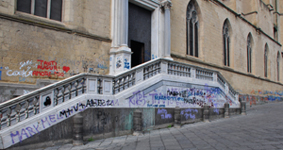 The chapel and the whole complex was a great example of an inside-naples and an outside-naples. The chapel was this amazing minimalist space, but step outside into the courtyard and the whole wall is littered with graffiti. Naples is full of graffiti especially the area around the university. It seems that throughout Italy, university students have decided to decorate their environments with wall scrawl. (Very different than here where graffiti is the domain of the middle and high-school students.) A while back the graffiti throughout Italy was political, this time all I kept seeing were announcements of who loved who. Pathetic! University students reduced to scrawling ti amo and on a wall that already is crowded with lettering. Maybe if they spent more time hitting the books, Italy’s test scores wouldn’t be scraping bottom.
The chapel and the whole complex was a great example of an inside-naples and an outside-naples. The chapel was this amazing minimalist space, but step outside into the courtyard and the whole wall is littered with graffiti. Naples is full of graffiti especially the area around the university. It seems that throughout Italy, university students have decided to decorate their environments with wall scrawl. (Very different than here where graffiti is the domain of the middle and high-school students.) A while back the graffiti throughout Italy was political, this time all I kept seeing were announcements of who loved who. Pathetic! University students reduced to scrawling ti amo and on a wall that already is crowded with lettering. Maybe if they spent more time hitting the books, Italy’s test scores wouldn’t be scraping bottom.
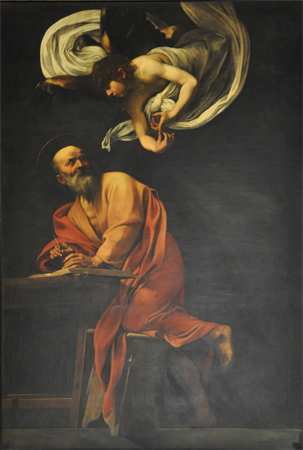
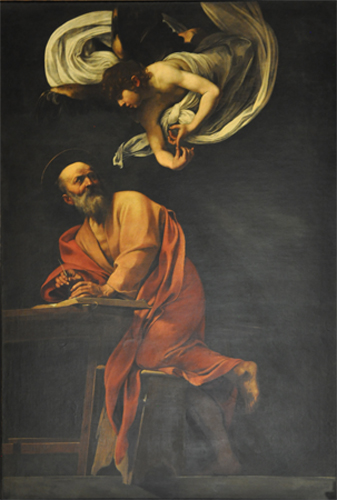 In Ortigia, a neighborhood of Siracusa, we saw our first Caravaggio – Seppellimento di Santa Lucia – The Burial of St. Lucy.
In Ortigia, a neighborhood of Siracusa, we saw our first Caravaggio – Seppellimento di Santa Lucia – The Burial of St. Lucy.
And this began our search.
Michelangelo Merisi da Caravaggio supposedly painted 4 large images in Sicily – Burial of Saint Lucy, Syracuse; Raising of Lazarus and Adoration of the Shepherds, Messina; Nativity with St. Francis and St. Lawrence, Palermo. For centuries the Nativity was displayed in the Oratory of San Lorenzo, but on October 18, 1969 it was stolen from the church and has not been seen since. The most popular rumor suggests that it was taken by members of the local mafia.
We saw two more in Naples.
We saw the Sette Opere di Misericordia – the Seven Works of Mercy and La Flagellazione di Cristo – The Flagellation of Christ. The Flagellation is in the Museo di Capodimonte and the floor it’s on is being reorganized, but they opened it for 15 minutes so patrons could see the famous painting. We all made a bee-line to the last room on the floor. The painting is at the end of a long hallway in a dark room illuminated by Caravaggio’s chiaroscuro.
In Rome, we say five more.
We were walking back to the apartment and Sarah, who was reading the guide-book, discovered that we were in front of the church of San Luigi dei Francesi, and that it had Caravaggio’s triptych of St. Matthew: Vocazione di san Matteo – Calling of St. Matthew, L’ispirazione di san Matteo – The Inspiration of St. Matthew (the above image), and the Martirio di san Matteo – Martyrdom of St. Matthew.
The next day, we took the subway north to Piazza del Popolo and there in the church of Santa Maria del Popolo we saw the Conversione di san Paolo – Conversion on the Way to Damascus and the Crocifissione di san Pietro – Crucifixion of Saint Peter.

 summertime is falling down and winter is closing in
summertime is falling down and winter is closing in
It’s hard to believe that tomorrow is October 1st.
When I came back from Italy, I cleaned up the back-yard; got rid of the sunflowers and the begonias that had wilted replacing them with autumn mums, yellow dahlias and a huge pumpkin. Also, the basil had gone to seed so I cut it. And after six months, I managed to get rid of the fig-tree stumps. It took blunting the teeth of my chain-saw, but after a lot of work, I was able to pull out both sets of stumps.
(The stumps of the original plant took three days of digging and cutting before I got them out.)
I’m having a hard time identifying the transition point into the season. Don’t know if it’s that I was away most of September and therefore didn’t have the time to watch fall slipping in. Many of the trees have turned, but those too seem to just be there; I never got to see the gradual change that is Indian Summer. The forecast is for colder weather later this week, that may be the tipping point.
So far the only indicator of a changing season is the light. Gone is the harsh light of August and the back-yard is ofter bathed in shadows; the sun’s rays are diffused; Apollo’s chariot is no longer over-head.
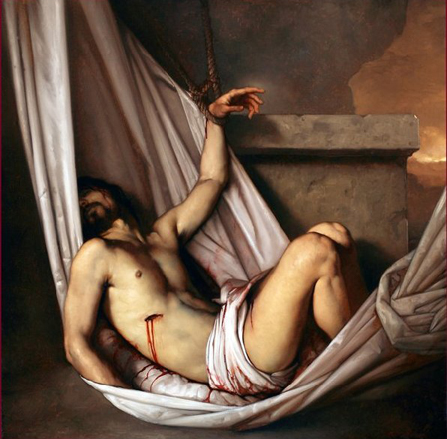
 We drove into Noto and parked. Walking the narrow streets towards the piazza and the cathedral, we had no idea where we’d come out. We ended up on a platform that gave us an amazing view of the steps, the cathedral and the piazza. And coming down the grand staircase, was a funeral cortege. We waited for the procession and the hearse to pull away before we made our way to the duomo. Once inside the Cattedrale di Noto – La Chiesa Madre di San Nicolò, we noticed that a crew was getting ready to set up for a wedding. What a strange juxtaposition; what strange scheduling.
We drove into Noto and parked. Walking the narrow streets towards the piazza and the cathedral, we had no idea where we’d come out. We ended up on a platform that gave us an amazing view of the steps, the cathedral and the piazza. And coming down the grand staircase, was a funeral cortege. We waited for the procession and the hearse to pull away before we made our way to the duomo. Once inside the Cattedrale di Noto – La Chiesa Madre di San Nicolò, we noticed that a crew was getting ready to set up for a wedding. What a strange juxtaposition; what strange scheduling.
On March 13, 1996, a large part of the cathedral collapsed. The reconstruction was a complex process, made all the more onerous by the importance and high visibility of the cathedral and the city, the so-called capital of Sicilian Baroque architecture.
Inside we found a bright, beautiful modern building. What were most surprising were the Stations of the Cross. First they were paintings instead of the standard reliefs that line the walls of most churches and second they were very modern. But the biggest surprise was the composition – the male characters were almost nude and had very modern bodies. I had never seen such a rendition of the traditional fourteen Stations. The image on the left is the XIV Station – Jesus is Laid in the Tomb. The artist is Roberto Ferri. He was born in Taranto, but lives in Rome. He works in the style of Caravaggio. (Another juxtaposition – in an ancient Baroque church, the works of a modern painter using baroque techniques.)
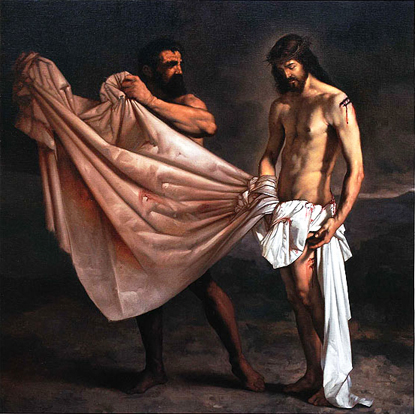
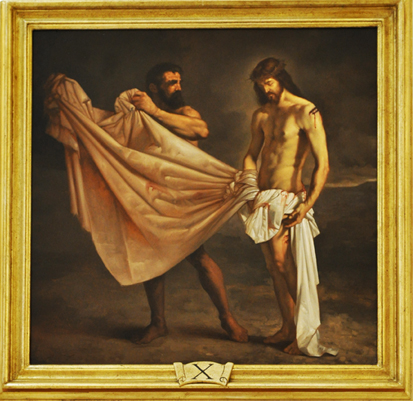 and carrie is stripped of her humanity
and carrie is stripped of her humanityI’ve been watching “Homeland” and the new episodes present the main character as about her career, about her leadership, about her drive, about her ambition. Looking back at previous seasons it is now clear that the Brody character gave Carrie her compassion. But without Brody, Carrie is truly The Drone Queen – the title of the first episode of the new season. At one point she almost drowns her baby daughter, because she is a distraction, a pawn in the Queen’s way.
The connection between Showtime’s Carrie and Ferri’s paintings – Via Crucis – came from the idea of stripping away what prevent us from seeing. In “Homeland,” Carrie is stripped of her humanity and we see the robot; in Ferri’s Stations of the Cross, Christ is stripped of his divinity and we see the man.
I am very curious about Ferri’s commission for Via Crucis. When I saw the paintings in the cathedral in Noto, I couldn’t believe they were in a church. (The photograph on the left is of the 10th Station. Each painting is in a gold-leaf frame.) The images are raw, almost erotic and the Christ has a gym-rat body. Such an interpretation of the Way of the Cross would never be allowed in rabid, conservative America. (Ferri’s Caravaggesque style straddles conventions. But New-World Catholics don’t even know who Caravaggio is, let alone understand a modern artist who paints in the Baroque style.) Catholicism in the west is about violent opposition to abortion and gay-marriage; most American Catholics know little about empathy for the less fortunate or about their Church’s artistic patronage. But then, they too have been stripped of their legacy, their righteousness and what we see is their obsession to punish. Maybe, they would welcome Ferri’s paintings, after-all there’s a lot of S&M references in them.

 Yesterday morning, I took the GO-Train into town and walked from Union Station up to the University. It was a beautiful morning and I like that part of town.
Yesterday morning, I took the GO-Train into town and walked from Union Station up to the University. It was a beautiful morning and I like that part of town.
In the above image, the buildings are King’s College – the founding college that grew into the University of Toronto. They line a circle in this old section of the University. The University is divided into 7 colleges much like the British university system. (When in high-school, my goal was to go to St. Mike’s, the Catholic college at U-of-T. And because I went to a Basilian high-school, and because I had good grades, I was guaranteed a spot at St. Mike’s. My life took me to another Basilian college – Assumption – at the University of Windsor. I lasted one year and then left Canada for the US.)
The above image is emblematic of the Anglophile legacy in Toronto. (As late as the 1940’s, Toronto’s population was largely Protestant – 72 per cent in 1941 – and fundamentally British – 78 per cent, but mainly Canadian-born.) When I was in college, all my relatives who lived in Toronto went to Montreal for the weekend, because even as late as the 70’s Toronto was a very proper and extremely conservative place. This most British of Canadian cities still had Blues Laws on the books, laws closing all pubs and bars early and on weekends. But all things change and the waves upon waves of immigrants have made Toronto one of the most diverse cities in North America. And provided you avoid the old people, its British up-tightness can be largely ignored.

 Last week in Toronto was wonderful. The sun was out and the fall colors were brilliant. The trees is Oakville were red and orange. The image on the left is way east in Durham/Pickering. I went walking the Rouge Park and shot a shadow image. In the preview, I saw the leaf and set up the image so that the yellow maple was in the bottom left.
Last week in Toronto was wonderful. The sun was out and the fall colors were brilliant. The trees is Oakville were red and orange. The image on the left is way east in Durham/Pickering. I went walking the Rouge Park and shot a shadow image. In the preview, I saw the leaf and set up the image so that the yellow maple was in the bottom left.
I spent most of Thursday with my old childhood friend and we had a great time. My favorite catch-up story was him telling about having beaten a bunch of anglo-crazed Torontonians who showed up at a property abatement hearing where my friend the architect was proposing street-name changes. He was proposing changing the anglicized names to more modern neutral names. The haughty Torontonians insisted that the name changes would rip the fabric of the community. My buddy showed up with lawyers and with briefs. The anglo-crazies showed up with their attitude toward the ingrate, dark-skinned Calabrese. He beat them; the judge ruled to let him change the street-names. (Nothing like finding a fellow anglo-hater.)
The second great discovery was that my second cousin lives in this beautiful arts-and-crafts house and that she is continuing the Zinga family tradition of portrait painting. Gina has done some beautiful work. My favorite is the face of an old woman she photographed while in Calabria and then made into a portrait. She also has two paintings from our uncle Dimitri; one is a landscape and the other is a portrait of her grandfather, my great-grandfather.
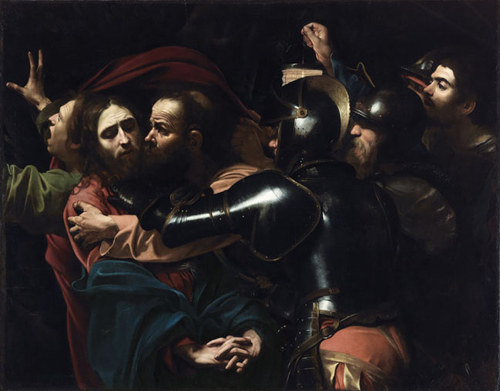

I’ve been listening it Dylan’s “With God on Our Side” and
the second-to-last verse:
through many a dark hour
i’ve been thinkin’ about this
that jesus christ
was betrayed by a kiss
but i can’t think for you
you’ll have to decide
whether judas iscariot
had god on his side.
brought me to Caravaggio’s painting.
The Cattura di Cristo nell’orto – The Taking of Christ – was painted in Rome at the end of 1602. (The Italian title is great, full of alliteration and hard vowels.) Breaking with past traditions, Caravaggio offered a new perspective of the betrayal narrative; all emphasis is directed on the action perpetrated by Judas and the guards on an overwhelmed Jesus. The fleeing disciple on the left is John and the lantern holder on the right is Caravaggio himself at the age of thirty one.
The flight of the terrified John contrasts with the entrance of the artist; it seems that Caravaggio is making the point that even a sinner, one thousand years later, has a better understanding of Christ than one of his own apostles. Two of the more puzzling details of the painting are the fact that the heads of Jesus and John seem to visually meld together; and the prominent presence of the arresting officer’s highly polished, metal-clad arm.
The painting is in Dublin in the National Gallery of Art.
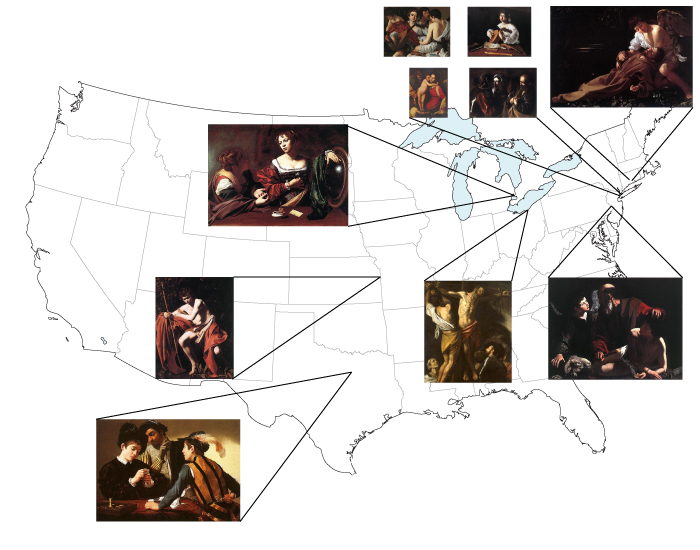

I Bari
The Cardsharps
Fort Worth, Texas
–
San Giovanni nel deserto
St. John in the Wilderness
Kansas City, Missouri
–
Marta e Maddalena
Martha and Mary Magdalene
Detroit, Michigan
–
1.Concerto di giovani
2.Suonatore di liuto
3.La Negazione di Pietro
4.Sacra Famiglia con
San Giovanni Battista
1.The Musicians,
2.Lute Player,
3.Denial of St. Peter,
4.Holy Family with St. John the Baptist
New York City, New York
–
San Francesco in estasi
St. Francis in Ecstacy
Hartford, Connecticut
–
Sacrificio d’Isacco
Sacrifice of Issac
Princeton, New Jersey
–
La Crocifissione di Sant’Andrea
Crucifixion of St. Andrew
Cleveland, Ohio

 Down here in western Pennsylvania, we seem to be about 10 days behind the seasonal shifts that I saw in Toronto last week. In West Park, the trees still have their red, yellow, green and brown leaves. (The Ginkgos, above the rail tracks, seem ready to shed their golden leaves.)
Down here in western Pennsylvania, we seem to be about 10 days behind the seasonal shifts that I saw in Toronto last week. In West Park, the trees still have their red, yellow, green and brown leaves. (The Ginkgos, above the rail tracks, seem ready to shed their golden leaves.)
Today was a banner day – I got to walk into town and hit the farmers market in Market Square where I bought my favorite organic Rosemary flavored bread. It’s great for toast. And I was able to book my trip to Puglia for next summer using 60,000 air-miles. I’ve never paid less than 90,000 air-miles for any trip. The only glitch is that I have to drive to Toronto, but the itinerary from Pittsburgh had me staying overnight in NYC. (The Pittsburgh option was also 60,000 air-miles.) As the Delta representative said, “The early bird gets the worm.” My strategy has always been to get a free ticket every other year and so far that has worked. (It takes me two years to accumulate enough air-miles for a free ticket. This means that my plane fare to Italy has cost me between $500 and $600 a year.)
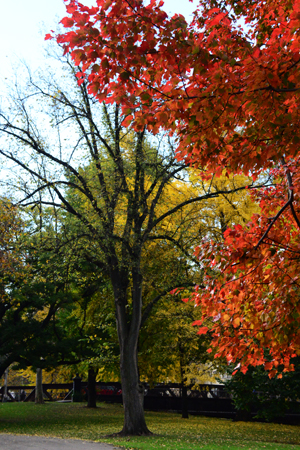
 After almost 25 years I am without a dog.
After almost 25 years I am without a dog.
Two weeks ago, the dog woke me up in the middle of the night hyper-ventilating. I took her downstairs hoping to calm her down, but after an hour and no luck, I called the emergency clinic and took her in. Once there, the vet did an examination and found that she was getting no oxygen into her lungs and after a consultation, because the vet could not get her stabilized, I made the decision to put the dog down. Gurl died of congestive heart-failure.
Gurl came to us from the same breeder that we got Bilby from. We went to Columbus to visit with the puppies (I remember the roads around Columbus being slick with slush and at that time I had no GPS and had to rely on directions printed from MapQuest.) and Gurl made her way onto my lap and insisted on getting petted. That guaranteed the sale.
Gurl was the smartest animal we’ve had and very bossy. She knew when it was time to get up, have breakfast, have dinner and go to bed for the day. Her herding instincts were well developed and she insisted and insisted.
Naming this female was a not easy, we could not come up with a name that fit, so we just kept referring to her as the girl. The name stuck. And to make it more formal rather than a default, we spelled it G U R L.
Gurl came to live with us on Thursday, December 30, 2004.

 The picture on the left is from the walking-through-the-park set of images. The ducks don’t seem to know that the pretend-lake in West Park has been drained and wont be filled again until spring.
The picture on the left is from the walking-through-the-park set of images. The ducks don’t seem to know that the pretend-lake in West Park has been drained and wont be filled again until spring.
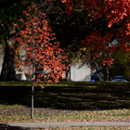 The other thing that happened while walking through the Park was I got my picture taken by Guy Wathen a photographer for the Tribune Review. There I was in my sweats, quilted jacket and hat on backwards minding my own business, shooting with my d800e. This young man comes up to me and says, “I’ve been waiting for someone to come along and take a picture of the red tree. I’m Guy Wathen with the Tribune Review and I took a picture of you taking a picture. Can I use it in our newspaper?” What was I going to say? (The thumbnail is a link to the large image.)
The other thing that happened while walking through the Park was I got my picture taken by Guy Wathen a photographer for the Tribune Review. There I was in my sweats, quilted jacket and hat on backwards minding my own business, shooting with my d800e. This young man comes up to me and says, “I’ve been waiting for someone to come along and take a picture of the red tree. I’m Guy Wathen with the Tribune Review and I took a picture of you taking a picture. Can I use it in our newspaper?” What was I going to say? (The thumbnail is a link to the large image.)
News – there’s a new puppy in the house. I drove out to Findlay, Ohio to get him. He comes from a very famous breeder. She runs a high-end kennel, her animals win top prizes and her animals are well behaved. (I walked into her house and there were at least a half dozen terriers running around, but there was no barking or yapping.) Of the 3 for sale, I took the friendliest and he’s got a great personality and has bonded very nicely. He’s six months old. The puppy behavior will last for another couple of months.
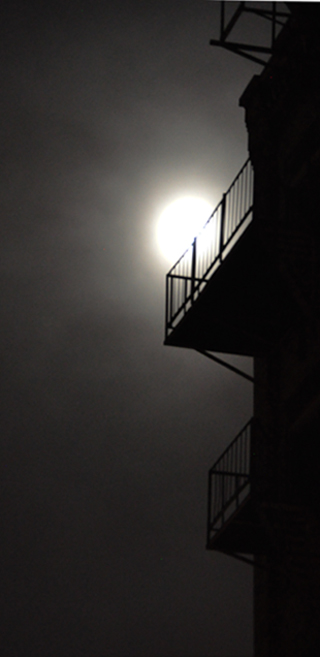
 I shot the image last Sunday morning; I was up early with the dogs. And there, as if hanging from the fire-escape, was the full moon. My favorite aspect of the image is that it came out as a black-and-white photograph. In the past to achieve a B&W effect, I’d strip all the color from and image, but the stripped image lost its contrast giving it a pale blurry finish. The outline is the west wall of the Mattress Factory.
I shot the image last Sunday morning; I was up early with the dogs. And there, as if hanging from the fire-escape, was the full moon. My favorite aspect of the image is that it came out as a black-and-white photograph. In the past to achieve a B&W effect, I’d strip all the color from and image, but the stripped image lost its contrast giving it a pale blurry finish. The outline is the west wall of the Mattress Factory.
I leave for my trek into the wilds of the Upper Peninsula and Northern Ontario later in the week. The weather forecast for the Gaylord and St. Ignace areas includes no snow. If this holds, it will be the first time in five years that I won’t have to deal with winter storms and dangerous driving conditions. Sault Ste Marie has had snow since the middle of November. But my dad says the city-roads are clear.
Have been spending my time writing opinion pieces and finishing a short-story. (18,000 words take up 90 pages double-spaced.) The first opinion piece is the posting – dual citizenship. It the posting opinion #1 in the footer. I am in the process of shopping it around. (Out of civic duty, I sent it to the local paper, but I hold up no hope with them.)
The second piece I’m trying to write is more an essay than an opinion. I want to write about finding the lead into a story, finding the character that can take me into the narrative. I’ve titled it Finding Vigil. The premise is that a person from one’s real life can act as the guide into a fictional narrative. And that the real-life person changes and becomes a fictional character as the narrative gets written.
The short-story took about four weeks. I write first in long-hand using an HB .9 mechanical pencil and after a couple of re-writes, word-process what is on the loose-leaf sheets. Every two or three day, I read the word-processed file out loud. Word-sounds and word-rhythms are critical for me and the reading aloud gives me a way of checking both. I also eliminate as many words as possible during the read-aloud. I believe writing should be free of words that don’t contribute to meaning. (I give myself license to add descriptive words when describing landscape.) A friend, that I did a lot of academic writing with, would always comment that my edits made the piece we were working on ping. I am proud of that comment.
The short-story is not ready to be sent out. I have about another two/three weeks of edits. I also need a title. (The working title – Year after Year – made sense when I first began, but by the end it no longer reflects the story. The working title along with the real-life person I used to lead me into the story got lost in the fictionalization.)

 The trip up had a scary part and a non-scary part. I left Rose-and-Derrick’s around 9:00. As I was packing up I realized their front steps were very icy and I had to be careful, but the outside temp wasn’t above freezing, so I didn’t worry. Was I wrong. Going up Michigan 24 there was snow everywhere and in a few spots there was a white-out. What the … I get on 69 West and start seeing all these cars in the median. The whole time I’ve driving there’s been a steady drizzle, but again the temp was above freezing. Next came the fender-benders and the highway patrols. 69 West and 475 through Flint were littered with accidents and police cars.
The trip up had a scary part and a non-scary part. I left Rose-and-Derrick’s around 9:00. As I was packing up I realized their front steps were very icy and I had to be careful, but the outside temp wasn’t above freezing, so I didn’t worry. Was I wrong. Going up Michigan 24 there was snow everywhere and in a few spots there was a white-out. What the … I get on 69 West and start seeing all these cars in the median. The whole time I’ve driving there’s been a steady drizzle, but again the temp was above freezing. Next came the fender-benders and the highway patrols. 69 West and 475 through Flint were littered with accidents and police cars.
As I near the exit onto 75 North, I’ve already decided that if the drizzle continues, I’m pulling over checking into some motel and waiting out the weather. I get close to 75-N exit and traffic is at a stand-still. Luckily, the exit lane is moving. Up ahead I see ambulances and flashing lights. However, as soon as I turn onto 75-N, the drizzles gets down to a few drops, the road-bed is dry and traffic is moving fine.
I was able to make up the lost time and still got to my parents’ in 5 hours.
The challenge at this time of year is – how many times can I say no and not offend everyone? My parents seem to think that I should eat-and-eat-and-eat. My dad, who gets up even earlier than me, was pushing polpette at six in the morning. When I told him they weren’t breakfast food, he just waited a longer block before offering the meatballs again. And every time company comes over, it’s another occasion for the prodigal to again reject his heritage and not drink wine or eat large amounts. If I ate everything they want me to eat, I’d be huge as a house and then I’d get criticized for having no self-control.
Breakfast is the only meal I eat my mother’s Christmas cookies. On the blue paper-plate are biscotti and turdilli – Calabrese Christmas fritters covered in honey. This year her scalille – braided Calabrese Chritmas fritters covered in honey and sugar – came out really nice. I’ve switched from turdilli to scalille.
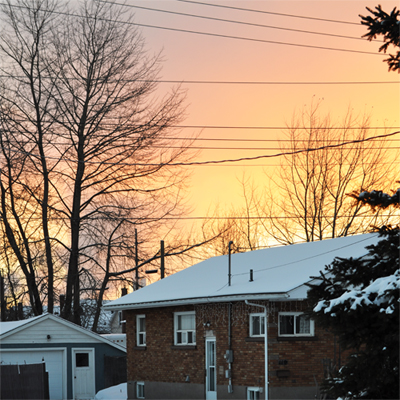
There is Internet at the Zingas. Connie got it all set up with a Bell sales-clerk she know, I figured out how to do a seasonal suspension so that we’re not paying while no one is here to use it and yesterday the technician came to do the install. (There are so many phones in this house, that in order to boost the signal to a normal high-speed bandwidth, he had to install adapters on all the various phone extensions throughout the house. BTW, there are 3 phone on this floor, two upstairs and one in the garage. I suggested to my dad, that we get rid of all the lines and cords and that I get him some portables that will also have the hearing-impaired feature, he scoffed. I went on to a different subject.)
 Except for the first day that I got here, the weather has been grey and overcast making for poor picture taking. The image on the left was one of the rare mornings when I saw the sun. It didn’t stay long, within the hour the cloud-cover brought back the grey. Will not complain. This is the first Christmas visit where we haven’t spent all our time shoveling snow or retreating indoors because of the severe cold.
Except for the first day that I got here, the weather has been grey and overcast making for poor picture taking. The image on the left was one of the rare mornings when I saw the sun. It didn’t stay long, within the hour the cloud-cover brought back the grey. Will not complain. This is the first Christmas visit where we haven’t spent all our time shoveling snow or retreating indoors because of the severe cold.
Company has been visiting on a regular basis and Monday night I went and visited Connie and Ron. We laughed when she told me that she will no longer invite the parents over. The times she’s invited them for dinner, they bring all the food, even though she has spent money and time getting the dinner ready. She and Ron went on and on about having bought all these stakes, just to have to freeze them all, because the parents walked in with pasta, a meat dish, cheese, salad and fruit. “It drives me crazy. I invite them and they don’t get that I’ve cooked.”
Last night my dad got all mad and left to go upstairs when my mother and I told him to not cook all the fish for Christmas dinner. The menu has been – soup (chicken broth with small meatballs), lasagna, fried shrimp, fried calamari, fried white fish, baccalà in a tomato sauce, baccalà in a olive-oil sauce, turnkey, stuffing, cranberry-sauce, mashed potatoes and all sorts of other vegetables. Salad to finish the meal and then fennel, oranges, mandarins, chestnuts, and prickly-pear. Dessert would be served after all the gifts are opened.
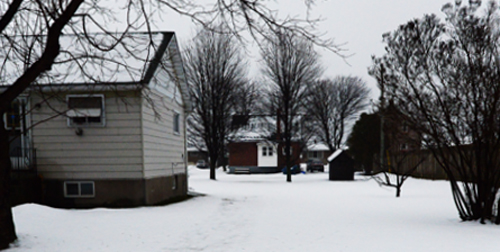
There is a thaw going on, but I need a walk so I head out with my cameras. It really is a pea-soup environment. There isn’t much I can shoot, but with Photoshop I can get rid of some of the gloomy grey. I’m walking down to Ron’s and decide to shoot the empty lot where we used to play baseball. The brick house in the background is where Corrine lived. Sometimes she would play with us. And even though she was a girl she could pitch, hit and run like a boy. The lot was beside Ron’s house and behind Corrine’s. The house on the left of the image was not there.
 Like everything from childhood, the lot looks small. In my mind it was huge. (I’m standing across the street in the church parking lot shooting.) Most of us hit inside the field. Frank Bitonti and Jacky Porco could hit the ball into the church parking lot, so the fielders would back up when they were at bat. (In my old neighborhood, I never played any team sports. The subdivision was just starting to get built and there were not enough kids or established families to organize team sports.)
Like everything from childhood, the lot looks small. In my mind it was huge. (I’m standing across the street in the church parking lot shooting.) Most of us hit inside the field. Frank Bitonti and Jacky Porco could hit the ball into the church parking lot, so the fielders would back up when they were at bat. (In my old neighborhood, I never played any team sports. The subdivision was just starting to get built and there were not enough kids or established families to organize team sports.)
Tonight we head over to my aunt-and-uncle’s. It’ll be a meatless meal with lots and lots of fish options. All the fish will be fried. My aunt, my mother and I will eat spaghetti slathered in anchovies and olive oil; the others will have it with a meatless red-sauce. My uncle is from Aiello – and small mountain town south west of Aprigliano – and in his town the rule was that you left 13 items on the table on Christmas Eve. So after we are all done with dinner, he and my aunt make sure to leave 13 items on the table overnight.
There will be cullurielli – a deep fried sweet dough – made either plain or at Christmas with an anchovy inside. (I like the ones with the anchovies. My friend Chris Colecchia coats the plain ones in powdered sugar and has them for breakfast.) In my extended Calabrese family, the cullurielli are a Christmas tradition and I eat them instead of bread for the time I am here.
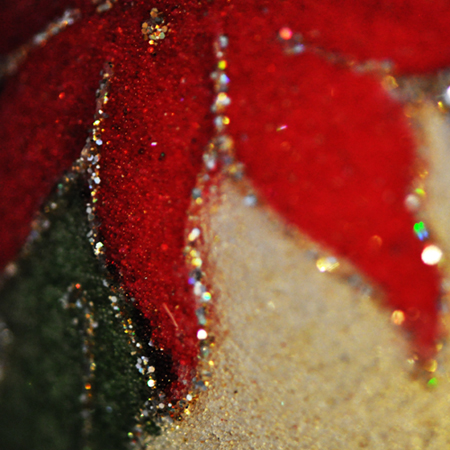
My mother and I were able to convince my dad to not fry shrimp, calamari or baccalà. Don’t forget that these would be in addition to – a chicken broth with polpettini – tiny meatballs – and pastina, lasagna, turkey, two types of stuffing, mashed potatoes, gravy, cranberries, and various vegetables that no American would ever see on a dinner table with roasted turkey.
 Connie came over after lunch hoping to help with the preparations, but all that was left was for her to put out the glasses. (We looked at each other acknowledging how the prep work must have gone down.) The kids, Dave, Isabel and the dog got in by 4:00, but dinner wouldn’t be for two more hours. But, for the two hours until ate, I had to restrain the parents, because they wanted to carve the turkey, mash the potatoes that way everything would be ready. They’ve insisted on having two different menus for the Christmas dinner for years and this is the first time there was some negotiation towards a more reasonable amount of food.
Connie came over after lunch hoping to help with the preparations, but all that was left was for her to put out the glasses. (We looked at each other acknowledging how the prep work must have gone down.) The kids, Dave, Isabel and the dog got in by 4:00, but dinner wouldn’t be for two more hours. But, for the two hours until ate, I had to restrain the parents, because they wanted to carve the turkey, mash the potatoes that way everything would be ready. They’ve insisted on having two different menus for the Christmas dinner for years and this is the first time there was some negotiation towards a more reasonable amount of food.
After all the food was put away, more wine drinking and fennel eating followed. (Rose, Mary and Connie manage the dishes and the clean-up.) And by 9:00 we were upstairs opening gifts.
What remains is helping the parents through the next couple of days. I head home Sunday, but between now and then there will much food preparation to manage and keep under control. (My mother will now follow the kids and I around asking if we’ve had breakfast, what foods we want for lunch, what foods we want for dinner, if we want coffee, if we want a snack …)

 Christian and I put away the extra table and the extra chairs. Both were keeping my father’s obsession with everything-in-its-place on edge. He had already been busy at work drilling rebar into the outside wall of the garage to hold the folding chairs. He used to tie them and then put them on hooks, but the rebar hook would make getting them and putting them back easier.
Christian and I put away the extra table and the extra chairs. Both were keeping my father’s obsession with everything-in-its-place on edge. He had already been busy at work drilling rebar into the outside wall of the garage to hold the folding chairs. He used to tie them and then put them on hooks, but the rebar hook would make getting them and putting them back easier.
The long table is one of two that gets brought in at this time of year to accommodate the 18 to 20 people that eat Christmas dinner at my parents. The tables are hung against the side of the garage, but in order to get them there you have to move everything. Christian moved the huge snow-blower; I moved all the shovels and brooms my dad uses to remove the snow from the double driveway. (Who knew how heavy a snow-blower was. Certainly not me who has no driveway.)
The parents are now busy getting lunch ready. (It’s no use interfering. With the grandchildren in the house, anything I may say about reducing their amount of work will be seen as my suggesting they shirk their responsibilities. And neither of them will tolerate that. I guess that’s what you get when you have 90 year old grandparents from the old country.)
Any minute now, the call will go out from my dad and we will all be expected at the table ready to eat.
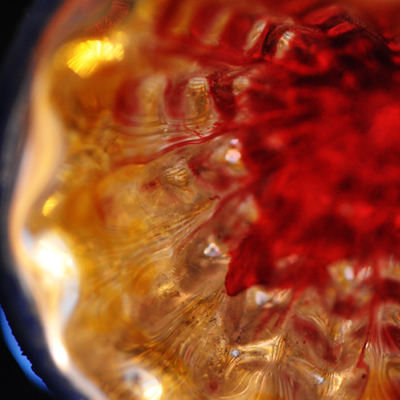
 Today, I get to go home. And it seems that the weather is not going to be an issue. (It did snow last night on this side of the lake, but the forecast for the snow-belt, better known as the area between Saint Ignace and Grayling, Michigan, is for sun and temperatures in the mid 30’s.) It has been 5 years since I was able to head out and not worry about winter weather in the northern Michigan.
Today, I get to go home. And it seems that the weather is not going to be an issue. (It did snow last night on this side of the lake, but the forecast for the snow-belt, better known as the area between Saint Ignace and Grayling, Michigan, is for sun and temperatures in the mid 30’s.) It has been 5 years since I was able to head out and not worry about winter weather in the northern Michigan.
I’ve used the time driving up to think through the character development in the Saturday Smiles short-story. I need to figure out how to end the piece, so the drive to Rose-and-Derick’s will give me a chance to think this through.
The visit was too long. (I thought it would be OK, thinking that since I didn’t make a fall trip I would make the Christmas visit longer. I was occupied working on the Saturday Smiles piece, but it would have been OK to have gotten here a few days later.) For the first time ever, my mother and I did the Christmas dinner. She did the soup and the lasagna, I did the turkey, stuffing, mashed potatoes and cranberries. My dad did the green vegetables and they were done by 7:00 AM. And even with that reduced menu, there was a lot of left-over turkey.
The left-overs make some appearance, but the parents have to cook new foods, because they have the grandchildren to feed and heaven forbid their favorite foods are not on the table. (The advantage of the grandchildren is that no one tells me to keep eating. The parents tell the grandchildren to keep eating more.)
The image on the left is the inside of a very old ornament. (I’m purposely using the out of focus image, because I like the impressionistic quality.) I remember buying it back in the mid-sixties.

If it’s New Year’s Eve, then it’s the all-meat dinner at Jerry-and-Diane’s.
This year, I didn’t take a pic of the long dinner table at my parents, because I have enough pictures of it, and instead decided to shoot the dining-room table at Jerry-and-Diane’s. And being consistent with the other dinner images, I shot the table before all the food was put out.
 We affectionately call this the all-meat dinner, because the only vegetable in sight is a cucumber salad, everything else is a meat dish – meatballs in a red sauce, ham, roast beef and in past years kielbasi and sauerkraut in a sweet tomato sauce.
We affectionately call this the all-meat dinner, because the only vegetable in sight is a cucumber salad, everything else is a meat dish – meatballs in a red sauce, ham, roast beef and in past years kielbasi and sauerkraut in a sweet tomato sauce.
The sunrise time was an add-on when I noticed the difference between first light here and what I was seeing up in Sault Ste Marie. (There’s a half-hour difference between the two places.) I’m an early riser, but I’d stay in my room and wait until there was a hint of light before I went upstairs to have breakfast. I’d take my time making coffee, defrosting the scalille and cutting up the oranges hoping to find some morning light when I made my way into my mother’s sun-room. (The window-rich room gets appropriated by the dog and the kids’ stuff when the Thormans arrive on Christmas Day.)
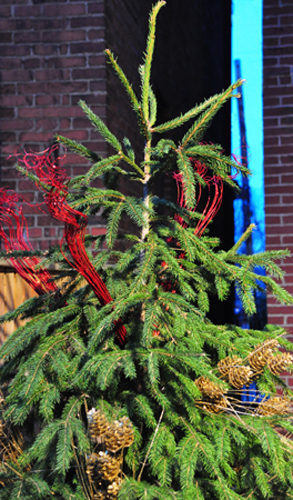
 My grandmother used to say that what you do on New Year’s you will repeat throughout the year. (Chi fa a Capo d’Anno, fa tutto l’anno.) Kielbasi and sauerkraut are supposed to bring good luck; eating lentils on this first day is also supposed to bring good luck. With the image on the left, I’m reaching back to the tree worship customs of the pagan Europeans who decorated the house and barn with evergreens at the New Year’s to scare away the devil.
My grandmother used to say that what you do on New Year’s you will repeat throughout the year. (Chi fa a Capo d’Anno, fa tutto l’anno.) Kielbasi and sauerkraut are supposed to bring good luck; eating lentils on this first day is also supposed to bring good luck. With the image on the left, I’m reaching back to the tree worship customs of the pagan Europeans who decorated the house and barn with evergreens at the New Year’s to scare away the devil.
The decorated tree is in the side-yard. It’s on top of the Hosta pot. (I saw the live tree at the grocery store and decided to pick it up and put it somewhere in the backyard. And after the holidays, if it survived, I’d plant it.)
It has been a slow, lazy day full of sunshine and mild temperatures, and I’m glad for it.
I’ve expanded the dog’s domain on the first floor. They are no longer confined to the kitchen, they have access to the whole floor. I do have to block off the stairs, because Jack loves to go up and then continue on to the loft, but then has no way of getting down. He doesn’t do down-the-stairs yet, so you have to go get him and carry him down.
They love running the big-room chasing and mock wrestling. Jack has figured out that he can wait for Bilby by one of the entrances and pounce as he streaks by. (I’ve brought the water spray-bottle to my desk and threaten when the rough-housing gets to be too much.)
I finished the second short-story. It’s 90 pages and 32,800 words. I’m beginning to think of a collection of novellas that share the same theme – men whose lives get re-organized. I’m staying away from dramatic events as plot devices and letting the day-to-day tell the fictional narrative. It’s much more fun to weave reality into the fiction and let it shift and impact the storyline.
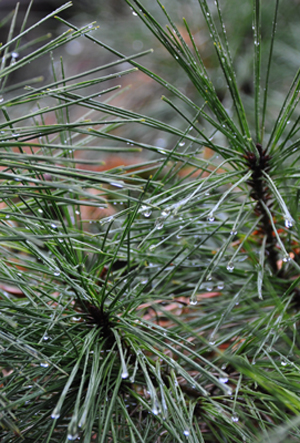
 This morning was a mess. There were accidents all over the place. It started to rain around 6:00 and with the temp below 33, a slick surface covered the asphalt. Drivers in trucks and Range Rovers seemed to pay no attention to road conditions. I was out, because I needed a longer HDMI cable; took the side-roads, because there was an accident on McKnight and I wanted to avoid the two hills.
This morning was a mess. There were accidents all over the place. It started to rain around 6:00 and with the temp below 33, a slick surface covered the asphalt. Drivers in trucks and Range Rovers seemed to pay no attention to road conditions. I was out, because I needed a longer HDMI cable; took the side-roads, because there was an accident on McKnight and I wanted to avoid the two hills.
I finally broke down and got a desktop to better deal with Photoshop and other high res programming issues. The other convenience is that I can now use the laptop throughout the house. I spend a lot of time in the kitchen writing and I the laptop is great for research and for word processing first drafts. (The best would be to have WiFi access to the printer, but that will have to be the next upgrade.)
The White-pine is one of my favorite photo subjects, especially after a rain storm . The long needles hold the raindrops.
I was thinking that 66 years ago, a twenty-two year-old Mafalda had a baby. And the world at that time was vastly different than the one we all live in today. While up in the Sault, Mafalda comes downstairs one night and asks, “Ma, did you touch the electrical?” (Ma, which rhymes with fa, is short for the Italian version of my name.) I had no idea what touching the electrical could possibly mean, so I ask if something was not working. And she told me that the TV had gone off. It came back shortly, so I guess I hadn’t touched the electrical after all. The next day, I tried to explain dish-technology to my 88 year old mother. With my dad, it was trying to get him to understand that the new router wouldn’t interfere with his phone service. Both understood that something had changed, but had no references to make the connections to the new world.
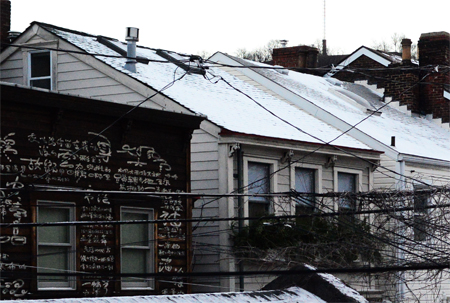
 It has been a crazy three days. Saturday morning the roads were a sheet of ice. It started to rain around 6:00 and for the next three hours driving was at your own risk. Sunday the temperature went up to 60 and today it never went above 25.
It has been a crazy three days. Saturday morning the roads were a sheet of ice. It started to rain around 6:00 and for the next three hours driving was at your own risk. Sunday the temperature went up to 60 and today it never went above 25.
I walked into town and when on the foot-bridge over the Point, I thought the wind was gonna freeze my face. I came home via the 6th Street Bridge. The wind was not as virulent.
Today, the Euro hit an all time low and while in town, I went and bought some. I came home and spent the afternoon restoring the system on the new tower PC. I had downloaded a package of analog-clocks screensavers and with the package came a miserable trojan – pop-fuz. It littered the browser with pops up; it put McAfee into overdrive; and on the blog, it made any Internet related word a link. I would try and do some work, but instead spent the whole time responding to McAfee’s virus alerts.
For some reason in this round of pictures, I am noticing how many wires there are. The above image is of Sampsonia Way the premier Art Street here on the North Side. The wire mesh is a combination of the ubiquitous wires that cross the street and the wild-grape vines that use the wires. Last year someone cut the vines, but it will be a few years before the dead vines disintegrate. And when I was in Canada, I couldn’t get over the fact that every image I shot had wires in it.
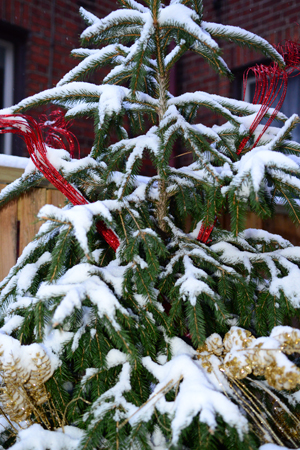
 This is the last entry for the christmas 2014 category. And I wanted to end the posts on the twelfth day of Christmas and on the feast of the Epiphany.
This is the last entry for the christmas 2014 category. And I wanted to end the posts on the twelfth day of Christmas and on the feast of the Epiphany.
Today is gift giving in Italy. I still remember that January 6 when I found gifts and coal in the sock I had hung by the fireplace. Let me tell you, I was not happy. And about trees in old Calabria – our tree was decorated with fruit – oranges and tangerines, and with candy – torrone wrapped in shiny cellophane and chocolate bars, which friends of the family brought when they came to visit during the Christmas season. And I was allowed to eat these decorations. I saw tree ornaments for the first time when we came to Canada.
The winter weather continues and today is a snow-day. I really like what the grocery store tree looks like covered in white. The dogs love eating the snow.
It’s slowly beginning to feel like I’m back home, back to my own routines. The week after Christmas began with the long drives – to Rose-and-Derrick’s, then across Ohio to Pittsburgh. What followed were: the New Year’s dinners, the birthday, coffee with friends and the new tower PC. All were fun, but they were part of the social fabric that began back on December 17 when I left to go to the parents. Monday was my first day back to exercising. I had been away a month. And like all other post holiday weeks, the place was packed. This was on a Monday morning when it’s usually the retired set, but the kids are still home and everyone who had gotten a gift certificate showed up hoping to shed their holiday pounds.
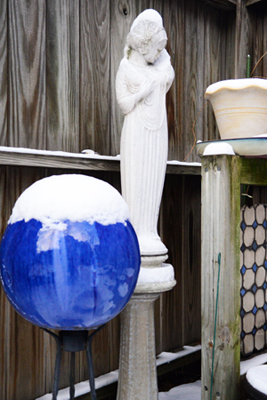
 I shot the image on the left yesterday and it reminded me of Rick’s comment when we were in Belmonte. His directional references were useless in a country that was constructed and operated in a vertical dimension. (I wonder if that’s why I have no built-in sense of left and right, but I intuitively understand up and down. I grew up in a world where all directions were up or down. We went up to Aprigliano to visit my grandmother; we went up to Porto-Salvo to the chapel of La Madonna; we went down to Corte; we went down to Cosenza.)
I shot the image on the left yesterday and it reminded me of Rick’s comment when we were in Belmonte. His directional references were useless in a country that was constructed and operated in a vertical dimension. (I wonder if that’s why I have no built-in sense of left and right, but I intuitively understand up and down. I grew up in a world where all directions were up or down. We went up to Aprigliano to visit my grandmother; we went up to Porto-Salvo to the chapel of La Madonna; we went down to Corte; we went down to Cosenza.)
The image is full of verticals – the tripod, the blue marble, the pedestal, the Ianelli sprite, the fence post, the blue-and-white tiles – so I had to use it. But never mind, that was warm September in Italy.
The weather is miserably cold, but the dogs don’t seem to care. There’s snow out there and they insist on going out and eating it. I already wrote Rose about Kaua’i. I am so ready to be out of the cold and March can’t come soon enough. (I should start a post-it countdown – there are 56 days until I leave for Kaua’i.) And we’re not even a month into the winter season.


Rob Rogers, Pittsburgh Post-Gazette


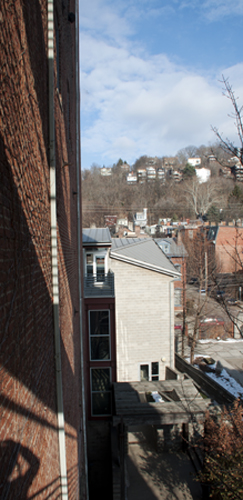
 Finally a day with sun. (Monday was so gloomy that it seemed the sun never showed its face.) I went to the Mattress Factory and asked if I could go up the staircase and shoot. The young man at the desk was very nice and gave the green light. In the image on the left, I am facing north and Jacksonia. Again, I love the vertical lines and I was surprised to find the shadow in the bottom left.
Finally a day with sun. (Monday was so gloomy that it seemed the sun never showed its face.) I went to the Mattress Factory and asked if I could go up the staircase and shoot. The young man at the desk was very nice and gave the green light. In the image on the left, I am facing north and Jacksonia. Again, I love the vertical lines and I was surprised to find the shadow in the bottom left.
Sunrise has shifted; it’s no longer coming later, rather it’s starting to come earlier – by three minutes since January 6.
The writing is coming along. The hardest part is understanding the correct punctuation when it comes to dialogue, so I bought a book recommended on a grammar blog I read. I’m also becoming aware of how often I use certain words. The awareness is forcing me to structure sentences differently. In the latest short, I decided that I would tell the same story from two different perspectives. And even though I’ve realized that beginning chapters need a lot more revision than later ones, having two different characters tell the same story also requires a very strict adherence to time sequence. I wrote the one character’s experience and then I added the second lens. I’m doing a lot of changes in the first character’s narrative so that the two pieces fit.
While in Sault Ste Marie, I took long drives and talked-out the ideas I was exploring and the character’s motivations and actions. This third piece hasn’t needed as much talk-out, because it lives inside the world I already created. But it is fun when I discover a new tangent. I added a nephew who gets a girl, he has no deep feeling for, pregnant and who then decides to raise the child while interning with his uncle on an organic farm.
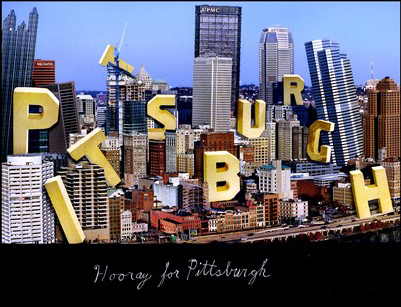
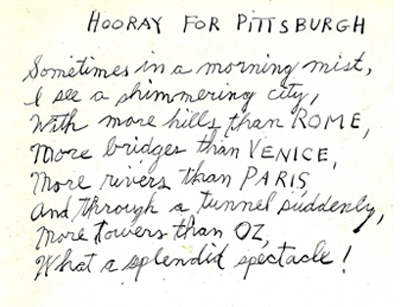 |
 |
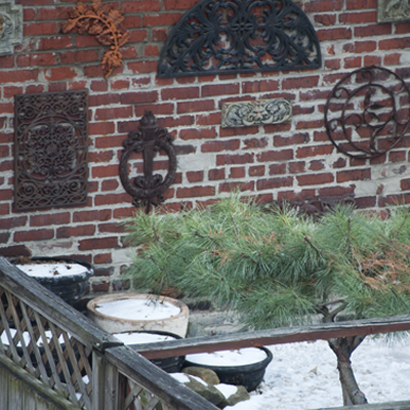
 There are two images taken from the balconies of the Mattress Factory tower. One is the Pittsburgh skyline in the slide-show and the other is the one on the left – my backyard. The brick wall with all the wrought-iron is my neighbor’s garage; the evergreen is the White Pine bonsai. (I photoshopped out the wires.)
There are two images taken from the balconies of the Mattress Factory tower. One is the Pittsburgh skyline in the slide-show and the other is the one on the left – my backyard. The brick wall with all the wrought-iron is my neighbor’s garage; the evergreen is the White Pine bonsai. (I photoshopped out the wires.)
Sunrise today was 2 minutes earlier than it was a week ago. I’m also trying to figure out first-light and sunrise, because first-light is even earlier than the sunrise time, but it’s not tracked and therefore can’t get any official information.
Also, Winter 2014/2015 is 90 days long. And with Dec. 21, 2014 as the official start date, we are now on day 32 of the winter season – not even half-way through. Mid-January is the turning-point and what lies ahead is real winter. Mid-January forces us to acknowledge that White Christmases aren’t winter and that the real season is just beginning its slow descent into freezing weather. We seem capable of deluding ourselves into liking winter when it’s related to the holidays. (I hate I’m Dreaming of a White Christmas. Only someone living in California could romanticize winter. All of us who live in winter climates think about survival during these difficult three months.) Well the holidays are now all done and we facing the season’s true temperature drops.

 Yesterday was one of those scary-weather days. All the Barbies on cable-news were hyperventilating about the incoming storm; the mayor of New York City was out there scaring everyone into staying indoors; and the meteorologists were warning of the storm of the century. In between the prediction of impeding doom the cable stations ran segments on Sara Palin, Rick Santorum and Chris Cristie. The faux candidates were in Iowa at some super-conservative convention where global warming was derided and family values were extolled. And when those became redundant, the Barbies talked about deflated balls. Welcome to 21st century America.
Yesterday was one of those scary-weather days. All the Barbies on cable-news were hyperventilating about the incoming storm; the mayor of New York City was out there scaring everyone into staying indoors; and the meteorologists were warning of the storm of the century. In between the prediction of impeding doom the cable stations ran segments on Sara Palin, Rick Santorum and Chris Cristie. The faux candidates were in Iowa at some super-conservative convention where global warming was derided and family values were extolled. And when those became redundant, the Barbies talked about deflated balls. Welcome to 21st century America.
I am doing research on my maternal great-grandmother – Rafaela Savaia. I found an Adriano Savaia on Facebook; he lives in Aprigliano. I sent him a note asking if his family has any connection to my great-grandmother’s family.
The snow did come and it made everything pretty. (The image on the left is the White Pine, before the snows.)
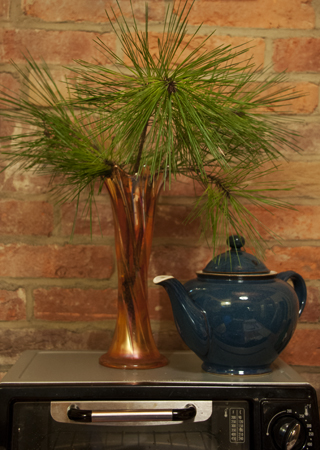
 The snow was so heavy on Monday that I needed to get it off the White Pine or risk it snapping the over-hanging bough. Using a broom, I hit most of the snow off the umbrella-like tree.
The snow was so heavy on Monday that I needed to get it off the White Pine or risk it snapping the over-hanging bough. Using a broom, I hit most of the snow off the umbrella-like tree.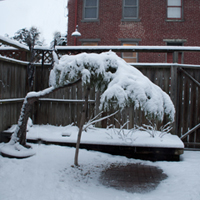 That got rid of the snow, but also broke off some of the small branches. Some info about the White Pine – it originally was a bonsai, and then one one day I put the pot on the ground to keep the soil moist and by the time I got to is again, the tree roots had started to grow into the ground. I’ve left it and now I have a huge tree growing out of a bonsai pot. Each year I sand off a small section of the main trunk in an attempt at creating a curve that begins at the pot-level and continues into the cascading green needles. The branch holding up the cascading branch is from the old fig tree. (The last time we had a major winter-storm, the snow toppled the tree out of its pot.)
That got rid of the snow, but also broke off some of the small branches. Some info about the White Pine – it originally was a bonsai, and then one one day I put the pot on the ground to keep the soil moist and by the time I got to is again, the tree roots had started to grow into the ground. I’ve left it and now I have a huge tree growing out of a bonsai pot. Each year I sand off a small section of the main trunk in an attempt at creating a curve that begins at the pot-level and continues into the cascading green needles. The branch holding up the cascading branch is from the old fig tree. (The last time we had a major winter-storm, the snow toppled the tree out of its pot.)
At first, I left the broken boughs in the snow, but then decided that they could look interesting in a vase in the kitchen. It was well after midnight when I started shooting the images and loved the soft colors the non-flash setting produced. I particularly liked the retro toaster-over that the tea-pot and vase are sitting on. The wall, I stripped of plaster while Ronald Regan was down the street visiting a community employment program, the tea-pot is from an English dish set that I like and the vase is old carnival glass. (The vases were prizes at Kennywood at the various gaming booths.)

 The coffee-pot my mother brought with her when we came from Aprigliano in 1957. She packed it, six espresso cups with saucers in a trunk. I inherited the set a couple years ago. Fifty-eight years has not worn the gold plating on the handle and spout, but it has worn the black ink design on the body of the pot. (It’s a very common design and you can still find the coffee set all over Italy.)
The coffee-pot my mother brought with her when we came from Aprigliano in 1957. She packed it, six espresso cups with saucers in a trunk. I inherited the set a couple years ago. Fifty-eight years has not worn the gold plating on the handle and spout, but it has worn the black ink design on the body of the pot. (It’s a very common design and you can still find the coffee set all over Italy.)
The roses come from a vendor outside of Penn Mac. He was trying to sell off what he had, because the cold was keeping people home and the roses were beginning to suffer. I got two bunches for $3.00. (He was so busy reminding me that in two weeks the same bunch would go for $20.00 that neither he or I realized I had picked out a small and a large bunch. When I was putting them in the water, I noticed that the yellow roses were much bigger than the red ones.)
I paired the roses with a series of 6 other objects.
Top Row
creamer – salt and pepper shakers – copper pitcher
Bottom Row
candle – water pitcher – perfume jar
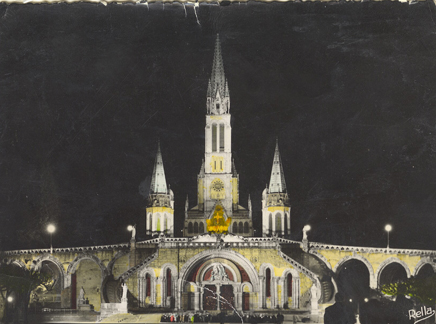
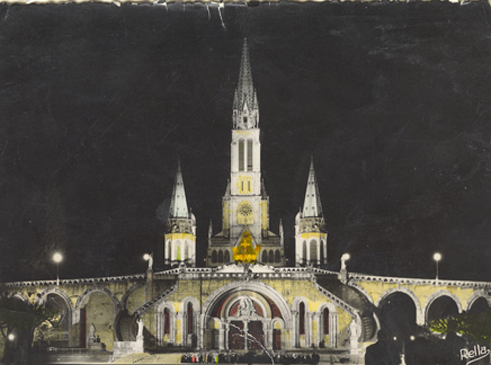 Today is the feast of Our Lady of Lourdes. In our family this date and feast-day has a long history. Before we immigrated to Canada, my dad and a number of people including Totonno Zinga had left Aprigliano and through an agent ended up on a short-term contract in south-western France.
Today is the feast of Our Lady of Lourdes. In our family this date and feast-day has a long history. Before we immigrated to Canada, my dad and a number of people including Totonno Zinga had left Aprigliano and through an agent ended up on a short-term contract in south-western France.
 Totonno was my dad’s first cousin and best-friend. They grew up together. (My dad is far-left, Totonno is in the middle.) Totonno’s two children still live in Aprigliano. The postcard is of the cathedral in Lourdes.
Totonno was my dad’s first cousin and best-friend. They grew up together. (My dad is far-left, Totonno is in the middle.) Totonno’s two children still live in Aprigliano. The postcard is of the cathedral in Lourdes.
The narrative in our family is that my dad had wanted to move to the family to south-western France. He liked the area at the foothills of the Pyrenees and he had made enough contacts to secure work. But my mother wanted to join her family in Northern Ontario and she prevailed at a time when American was the land of streets paved with gold.
All through my preteens and the 1950’s, Lourdes and the feast of the Immaculate Conception were central themes. South-western France was a place my dad had fond memories of and lost to the wilds and winters of Northern Ontario. (I remember many time wondering what life would have been like had we taken that option.) And Holy Mother Church was on a campaign to establish both the doctrine and the feast of Mary’s immaculate conception. Holy cards, statues, rosaries, Lourdes water, crutches all kids of artifacts were distributed to the faithful to promote the new doctrine. (There are Lourdes grottoes throughout the Catholic world. When Mac and I were in Maine, we found one outside of Kennebunkport. In Italy Lourdes grottoes are as common as Mary statues. And pilgrimages to Lourdes are advertised the same way we advertise package trips to Disneyland.)

 We are in midst of an Arctic air surge. Overnight the temperature went into the negative. And, it’s an absolute luxury to stay home during this miserable weather.
We are in midst of an Arctic air surge. Overnight the temperature went into the negative. And, it’s an absolute luxury to stay home during this miserable weather.
Yesterday, I went out for milk and oranges and the flower-shop at the grocery store had these beautiful cut sunflowers and I brought two bunches. (For me, sunflowers are girasoli and associated with Le Marche. So I am certainly not dreaming of sugarplums or of California, but of Puglia and trulli in September.) I knew I wanted to shoot them in the kitchen, but I didn’t want to do the same thing that I did with the roses, so I moved the vase in front of the windows. (The dogs were all disoriented, because the kitchen furniture was moved. Bibly chose to sit by the door the whole time. As far away from the tripod and the rearranged furniture as he could get.)
The image on the left is one of my favorites from the still-life shoot. I love the stained glass, the cruciform mullions and the hint of silhouette. Glenn Greene created the stained glass. (You know, I love the church-look. Who says I can’t pretend religion?)
The shoot has a set of images using the natural light from the stained glass window and a second set where I used a camera flash. The flash gave everything a great orangey hue. (Decided to do a second shoot with the flowers in front of the other window. In this window, Glenn added some glass pieces that had burnt-orange striations in them. And in this shoot, I took the camera off the tripod and shot free-hand. The first image in the second row was shot without a tripod.) Also, the two sunflower images in the slide-show are from the flash set. Click here to see 6 other images from the shoot.

 Meteorologists like to talk about meteorological seasons. There’s meteorological winter – climatologically, the coldest three calendar months of the year: December, January and February, meteorological summer – the three hottest: June, July and August, and the transitions between them: Spring is March, April, May and Fall is September, October, November.
Meteorologists like to talk about meteorological seasons. There’s meteorological winter – climatologically, the coldest three calendar months of the year: December, January and February, meteorological summer – the three hottest: June, July and August, and the transitions between them: Spring is March, April, May and Fall is September, October, November.
Astronomical spring begins this year on Friday, March 20, at the Vernal Equinox, the time when the sun is directly over the equator on its way northward. But we think about seasons more in terms of the weather that’s associated with them than the placement of the sun and that’s where the concept of meteorological seasons comes from.
If you divide the year up into four roughly equal periods based on the coldest (winter), warmest (summer), and transitional (spring and fall) times of the year, then Sunday, February 28 was the last day of winter, the last day of the coldest 91-day period of the year.
My countdown is based on astronomical spring.
In the image on the left, I am experimenting with the built-in White Balance settings – in this instance the Cloudy setting. I’ve finally taken the step to using the built-in light meter and to shooting in Manual. It’s taken me 7 years to get here. (If you look carefully, there’s a rain drop on the Sprite’s chin.)
Coming back to the weather, this is the first time where Spring in Pittsburgh reminds me most of Spring in Sault Ste Marie. Given that we’ve had a lot of snow there are snow-banks everywhere and with the rain, much of the ground is ice-covered. And as rain keeps coming, the back-yard and the streets are full of cold, winter-water puddles. (The difference is that by the time astronomical spring arrives, the ice and puddles will be gone and we should have two or three months of Spring. In Sault Ste Marie, by the time the snow-mounds, the ice and the puddles were gone it was the end of May.)
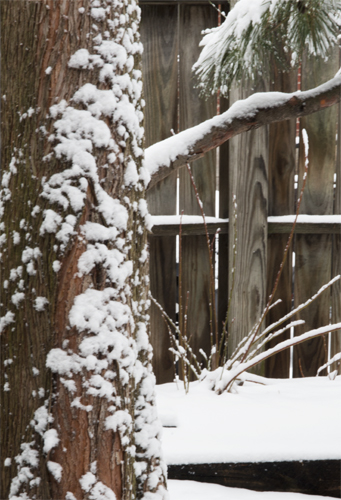
 Winter will not go gentle into that good night and to prove its might, it dumped 3 inches of snow onto the region. The only thing I like is that the new snow covered the melting, filthy ice. (Sault Ste Marie looses its worn and tattered look when blanketed with new snow. At those times it can look postcard beautiful.)
Winter will not go gentle into that good night and to prove its might, it dumped 3 inches of snow onto the region. The only thing I like is that the new snow covered the melting, filthy ice. (Sault Ste Marie looses its worn and tattered look when blanketed with new snow. At those times it can look postcard beautiful.)
In the background is the flowerbed full of snow-drops, but the snow-mound has kept them hidden and unable to poke through. (In other years, when the snow cover was minimal, they would have poked their green leaves and lantern buds through the white blanket to announce the coming sun.) I like the compression the lens is recording – don’t the branch and green needles look like they are part of the tree trunk? Well the trunk is the red-wood, the branch and needles belong to the pine tree – two different plants. Also, the small branches in the background are blueberry bushes. (The Cloudy White Balance does a really good job picking up the grain of the fence planks.)
The weathermen are all claiming that this is the last storm of the season. All I can say it that am glad it came this week, because next Thursday, at this time, I’m supposed to be on a plane heading west, looking for the sun.
What I’m enjoying most about using the Manual settings is that I can work with the built-in light meter. (My first SLR camera had a light meter slider on the display, but the next set of cameras have it on the light meter seen through the view-finder and it’s taken me a while to look at it and to use it. Now, I have to start to making decisions about what I want in terms of the reading the meter gives. I was making the adjustments already using the histogram, now I have to transfer those decisions to the light meter info.)


I walked into town to buy €-euros (The exchange rate is really good.) and brought along the camera. The weather is strange – yesterday the ice was melting, but by last night the rain turned to snow and there’s now well over 3″ on the ground. (March is certainly coming in as a lion.) The landscape too is strange. With the sun it’s this beautiful winter-wonderland; with the overcast it’s grey and depressing. The two alternated all day.
The above image is during a cloud sweep, leaving the entire mountain-side dingy and dark. And all I did was remove the brown from the building on the far right; the scene was as dark and gloomy as is represented by the photograph.
The walk to town was easy, but by the time I was walking home, the temperature was dropping and it wasn’t fun walking in the bitter cold. It was the first time I’d been out with sweats and not dressed for winter in a while. (Guess I’m just so ready for this mess to be over.)
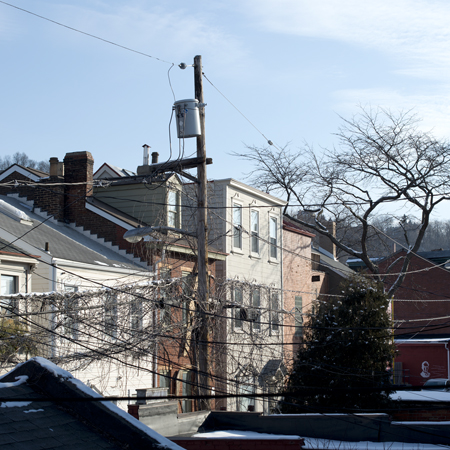
Tonight we move the clocks forward and even though I hated this shift when I was working, because it took the week for my body to adjust, I now welcome it. It’s an official marker indicating winter is done. Even if we are threatened with another storm, we know it’s the end. (What amazes me is how quickly the daylight gets added. In three days, 8 minutes of daylight have been added. And if I go back to late December, today there is an hour more of sunlight.)
 Today is the 50th anniversary of the march in Selma. (Kevin McCarthy is the only Republican attending and he had to be embarrassed into going. What has happened to the Grand Old Party? Yes it has figured out how to win in segregated, gerrymandered districts, but this strategy has put it so far from the mainstream that it will never win the presidency. Its national candidates can’t talk rationally, can’t help explain the modern world, can’t stop hating on the President, can’t stop pushing for a holy-war.)
Today is the 50th anniversary of the march in Selma. (Kevin McCarthy is the only Republican attending and he had to be embarrassed into going. What has happened to the Grand Old Party? Yes it has figured out how to win in segregated, gerrymandered districts, but this strategy has put it so far from the mainstream that it will never win the presidency. Its national candidates can’t talk rationally, can’t help explain the modern world, can’t stop hating on the President, can’t stop pushing for a holy-war.)
Let’s not forget that the Supreme Court of modern Alabama is telling all state judges to ignore the Federal ruling to allow same-sex marriages to go forward. Alabama again represents the inequality that has the potential of destroying this country.
Thomas Piketty, the French economist, claims that the inequality that pervades the American economy will change our status as the world economic power; that we are on our way to becoming an oligarchy with a ruling-class based on inheritance rather than talent. He also claims that economically, Europe is more equal than we are. And that that new status is a result of the two World Wars. And Piketty lists war, inflation and taxation as agencies that change economic inequality.
The image on the left is my first use of a fixed-lens with a UV filter. (And I want to reiterate that my experience with all technology has been to skirt the technical details and concentrate on what I want the finished product to look like. Learning the details has made me more comfortable with changing them, but I still have no interest in learning about the number of f-stops between one f/30 and f/64. But I do like knowing the Ansel Adams and his group were known as the f/64 group.)
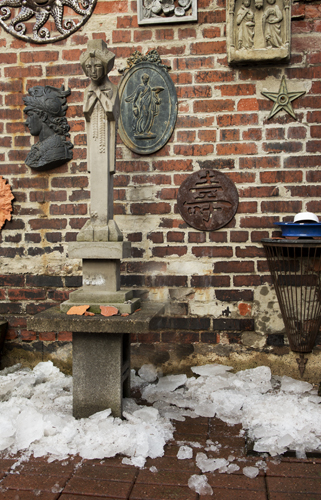
 The daylight-savings-times are in parenthesis. I’m using the non-daylight-savings to keep the ongoing record in the same time-frame. (On December 9, sunrise was at 7:32. We had 9.5 hours of daylight. Three months, we got 12 hours and 20 minutes of daylight.)
The daylight-savings-times are in parenthesis. I’m using the non-daylight-savings to keep the ongoing record in the same time-frame. (On December 9, sunrise was at 7:32. We had 9.5 hours of daylight. Three months, we got 12 hours and 20 minutes of daylight.)
A couple of weeks ago when the ground had at least 4 inches of snow, it rained and turned the entire snow-cover into ice. And after the rain, it snowed. The ice was covered with another 3 inches of new snow. So, the melt has been slow. There are puddles everywhere. (I associate spring melt and puddles with Sault Ste Marie. On one side there was the relief of spring and then the puddles and the sand making the streets miserable.)
I’ve been trying to clear the back-yard so the dogs aren’t walking on the filthy, melting ice or walking into the freezing puddles. I use a heavy-duty scrapper with a shovel handle to break up the ice into chunks and then move them to clear as much of the back-yard as possible.
The large image on the left shows the ice chunks on the bricks below Wright’s Sprite. The flat, terracotta pieces at the base of the Sprite are brick-facing from my neighbor’s garage. As they fall, I collect them and use them as shims to balance pots and other garden ornaments.
The shards remind me of the rocks on Gertrude Steins’ and Alice B. Toklas’ grave marker in Père Lachaise Cemetery. 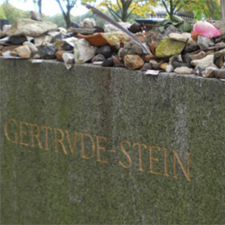 It was the first time I had seen the rocks on a Jewish grave. One explanation is that flowers, though beautiful, will eventually die. A stone will not die, and can symbolize the permanence of memory and legacy. (The kids and I have painted rocks and left them on Jo’s grave-marker.)
It was the first time I had seen the rocks on a Jewish grave. One explanation is that flowers, though beautiful, will eventually die. A stone will not die, and can symbolize the permanence of memory and legacy. (The kids and I have painted rocks and left them on Jo’s grave-marker.)
Yesterday the weather was warm enough to break up a lot of the ice-cover. I shoveled all the ice chunks from the path leading to the back-gate out into the alley – Sampsonia Way. Paul accused me of being an old Italian, moving my snow and ice out onto the city street. Well, by this morning all the snow and ice I moved had been crushed by the passing cars and it was all melted. Left in my back-yard it would still be there creating puddles.
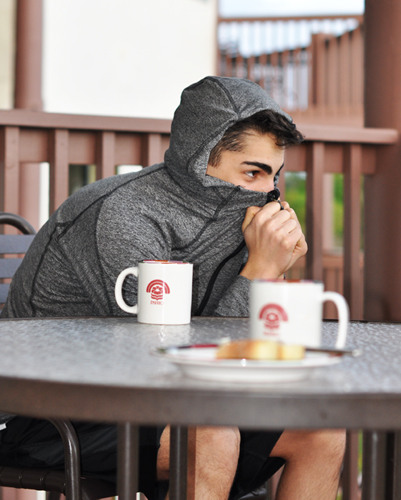
 We got here yesterday, late afternoon. And this year Daniel is with us. We spent the time after we landed food shopping and getting situated in the condo. We all headed to bed by 9:00, because our bodies were still on Eastern Standard Time. (It’s a 7 hour flight from Phoenix and it wasn’t all smooth sailing. The pilot reminded us that it was winter and the flight crew was dealing with the winds and the turbulence. I also don’t know why the route isn’t considered a high-end destination. The plane was old, there were no individual screens, the seats were jammed and the service was minimal. The flight from Pittsburgh to Phoenix was on a newer and roomier aircraft.)
We got here yesterday, late afternoon. And this year Daniel is with us. We spent the time after we landed food shopping and getting situated in the condo. We all headed to bed by 9:00, because our bodies were still on Eastern Standard Time. (It’s a 7 hour flight from Phoenix and it wasn’t all smooth sailing. The pilot reminded us that it was winter and the flight crew was dealing with the winds and the turbulence. I also don’t know why the route isn’t considered a high-end destination. The plane was old, there were no individual screens, the seats were jammed and the service was minimal. The flight from Pittsburgh to Phoenix was on a newer and roomier aircraft.)
We woke to cold and winds. Daniel was so cold he huddled on the lanai as we ate breakfast. I had brought no long-sleeve shirts, and wore my LL Bean sweater to keep from shivering. (It is winter even here in Kaua’i.) After lunch, we drove down to Hanalei and I bought a long-sleeve T and a long-sleeve hoodie.
Spent most of the afternoon in the hot-tub, but left for half-hour to go back down to Hanalei to return one of the items, because it had a rip. Did get some sun, but that was in between cloud cover and the cold winds off the ocean.
Dinner was broiled mahi-mahi, rice and salad. (The trip marks the beginning of switching over from winter-available foods to fresh vegetables.)
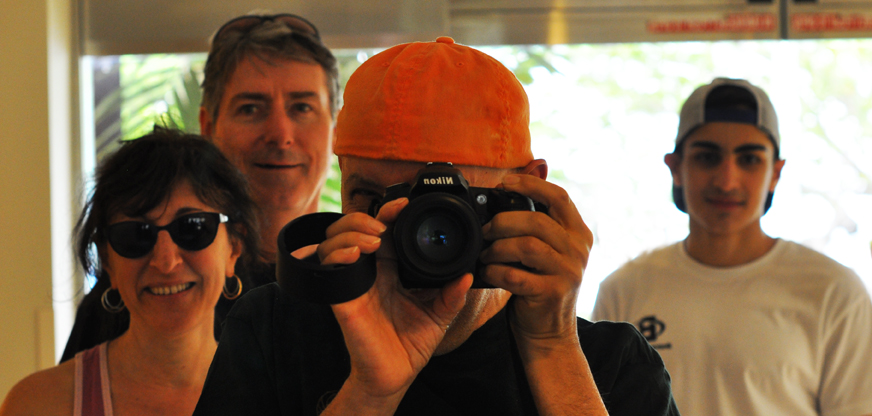

Every year, I take a pic in this mirror on the ground-floor of the St. Regis. We come in from the beach and use the elevators to get back up to the top of the ridge. The mirror is in the elevator lobby.
When I told Daniel that no one wears their hats backwards anymore, Uncle Derrick piped up with, “If you’re wearing a Toronto Maple Leafs hat you want to make sure no one sees the logo.” (I claim immunity, because I have to be able to see through the view-finder.)
The title is a quote from Patti Smith’s book Just Kids.
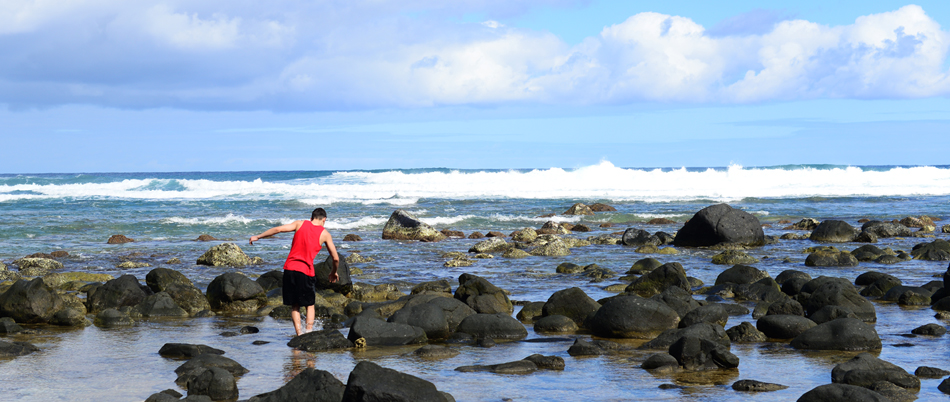

We’re on a beach on the other side of Hanalei Bay. (The path down is cement, extremely steep and through one of the ritziest condo developments.) Daniel decided that he had to walk into the surf, regardless of the slippery or jagged rocks. It’s fun having Daniel here, we can make fun of him all day. He does get some come-backs, but the old folks are so better at the gibes.
In the above image, I told Daniel that he’s inconsequential, that what I liked were the black trunks matching the rocks and the red shirt in contrast to and in opposition with the rocks and sky. He just laughed.
Again, I’m using a quote from Patti Smith’s Just Kids in the title.
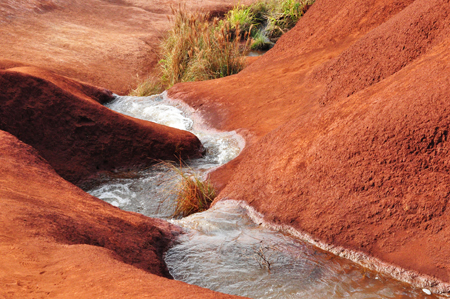
 On our way up to Waimea Canyon, we stopped at the stream. The color of the earthen mounds is true.
On our way up to Waimea Canyon, we stopped at the stream. The color of the earthen mounds is true.
Sunday was a full day. We left Princeville and drove south hoping to get to the canyon before the hordes. We were one of six cars in the parking lot, but on our way down, the tour buses were making their way up the mountain.
From there, we headed to our favorite taco place for lunch. As we made our way south, we had to stop at the farmers-market in Koloa and Rose and Derrick promised to just get a few things. Daniel and I laughed, because there’s no way Uncle Derrick and Zi-Zi Rose can only get a few things at a farmers-marker. It’s not in their DNA to pass up fresh food, regardless what state or country they are in. (In Fossombrone one year, we went to the market after having been there the previous day. They claimed to only need some herbs. By the time they were done, they had spent over $100.)
We spent most of the afternoon in Po’ipu on the lawn of a fancy restaurant. The beach is great for snorkeling and the lawn is best for sunning. The South attracts the move conventional tourist – white, old and over-weights. The clientele here reads from their Kindles and tables while shrouded in floppy hats, Hawaiian shirts or skin-tight tops.
After the beach, we headed back to COSTCO for coffee, taro-chips and cookies.
The title will be the last quote from the Patti Smith book.
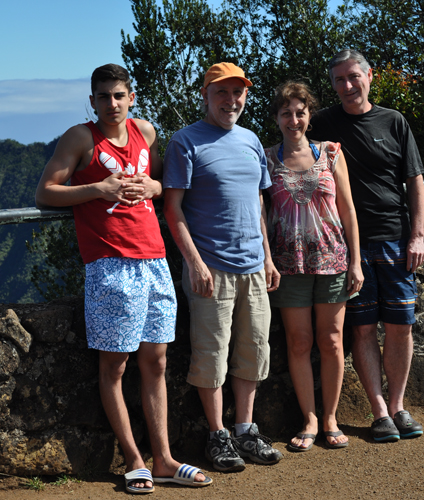
 I believe it’s a Jack Kerouac rule that at seventeen you have to show disdain, detachment and boredom otherwise your teenage ID gets revoked. No worry Daniel, you have the anti-establishment attitude down to an art. And still we love you and are glad you are here with us old folks. (The seventeen-year-old insists on referring to my shorts as capris. I remind him that in Italy, I am very stylish. He reminds me we are not in Italy. His attempt at mockery is endearing.)
I believe it’s a Jack Kerouac rule that at seventeen you have to show disdain, detachment and boredom otherwise your teenage ID gets revoked. No worry Daniel, you have the anti-establishment attitude down to an art. And still we love you and are glad you are here with us old folks. (The seventeen-year-old insists on referring to my shorts as capris. I remind him that in Italy, I am very stylish. He reminds me we are not in Italy. His attempt at mockery is endearing.)
Waimea Canyon is in the background. The woman who took the pic actually knew what she was doing. When I told her it was a fixed lens, she knew what that was and she actually took several pics and all came really well. (At the Queen’s Bath, I asked the woman with the Canon to take our pic, she was confused that there was no zoom, even though I told her it was a fixed lens, and all the pictures she took had our faces in shadow. So much for thinking that a decent camera equates with knowing what you’re doing.)
One year, I didn’t bring the D90 with its Auto feature and didn’t get any pics of us. After that, I always bring one camera that I can hand to someone and make taking our picture an easy step.
The title is a quote from Kerouac.

 Anini Beach is this amazing place; it’s a giant shallow pool. The coral reef keeps out the mighty Pacific and for miles the water is glass-still and knee-high. The beach is sand and long and curvy.
Anini Beach is this amazing place; it’s a giant shallow pool. The coral reef keeps out the mighty Pacific and for miles the water is glass-still and knee-high. The beach is sand and long and curvy.
We walk down the cliff by the Hilton and then along the beach. There a stream at the bottom of the cliff that you have to cross in order to continue down the beach and every year we’re tried different methods. This year, I gave in, took my shoes off and walked across. Derrick used a rope swing, but got all wet. Daniel too used the rope swing and almost dropped his iPhone in the water.
In the above image, the dark line is waves crashing on the coral reef. Anini tends to attract strange people. This morning we again saw two women searching for the tiny shells that they will make into jewelry. (Crouching in the sand picking up tiny items looks strange. We know what they’re doing, because one year our curiosity got the better of us and we asked.) Further down, the public beach is full of young people camping. OMG, I never camped and the modern conveniences don’t make it any more appealing. And then there are the multi-million dollar homes. Many have a Japanese motif with pagoda-like roofs. One of the band-members from R.E.M. has a house on Anini Beach.
The title is Jack Kerouac.
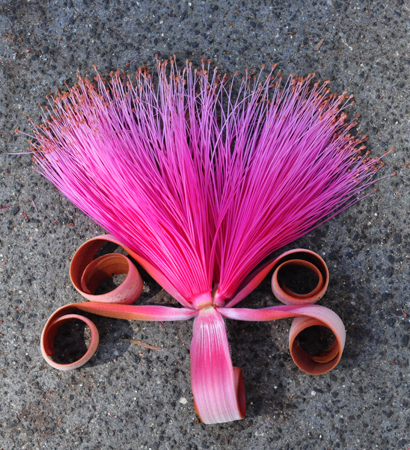
 The condo complex is on the Makai Golf Course and it’s not uncommon for people to walk the cart-paths. We do that without thinking, but yesterday we ran into true bitch. She was in her 50’s, skinny and well groomed and she reminded us in her belligerent voice that it was dangerous to walk on the cart-paths. There was no way I was gonna let some tight-ass, Republican snot-nose talk to us that way and I had to answer. (I was so surprised by her attitude that I didn’t use my best stuff. I really wanted to tell her about herself. I consoled myself with the fact that she must have a husband and children that she talks that way to.)
The condo complex is on the Makai Golf Course and it’s not uncommon for people to walk the cart-paths. We do that without thinking, but yesterday we ran into true bitch. She was in her 50’s, skinny and well groomed and she reminded us in her belligerent voice that it was dangerous to walk on the cart-paths. There was no way I was gonna let some tight-ass, Republican snot-nose talk to us that way and I had to answer. (I was so surprised by her attitude that I didn’t use my best stuff. I really wanted to tell her about herself. I consoled myself with the fact that she must have a husband and children that she talks that way to.)
The plant/flower on the left, I found on the pavement in the parking lot of a resort in the south. The first image in the slide-show is the Shaving-brush tree that the plant/flower fell from. The real name for the tree is – Pseudobombax ellipticum.
Also, we went to the golf course to watch the sunset and this time an employee came out to tell all the trespassers that we were allowed to stay tonight, but we were not to come back again. We were on private property.

 Today was the first day that the sky was clear and the sun was out. The image is of the mountains behind us. Throughout the week the sky was shrouded in mist and the mountain peak was topped by grey clouds. (I keep forgetting that it’s still winter.)
Today was the first day that the sky was clear and the sun was out. The image is of the mountains behind us. Throughout the week the sky was shrouded in mist and the mountain peak was topped by grey clouds. (I keep forgetting that it’s still winter.)
I’m gonna spend the afternoon by the pool, in the sun, with a gin-and-tonic on the small table beside me. Everyone else is seeking refuge on Anini Beach. (I told Daniel I no longer do beach, sand, and salt-water. I’m perfectly happy coming here to enjoy the warm weather, the walking, the fresh fruit and vegetables and the eating on the lanai.)
This morning we went searching for a path down to a snorkeling spot below the Cliffs condo complex. After following the path for a bit, I turned around and went back to shoot the flowering plumeria on the Cliff complex. On my way back to the condo, I had to be cheerful and say hello to everyone I passed. Normally Rose and Derrick do the friendly and I can ignore all the well-wishers. Well not this walk.
Tomorrow is Daniel and my last day. Daniel is anxious to sleep in his own bed again; I’m looking forward to being back among the real world. The Disneyland quality of the vacation compounds puts me in a foul mood. (Princeville is full of old, rich white people. And even though I fit into those categories, I live my life in a very diverse environment. The homogeneity here is stifling.)


here you leave today and enter the world of yesterday, tomorrow, and fantasy
Today is our last day and we moved from the unit we were in to a two-day rental in the same complex. This has been the easiest move, because we went from one unit to a similar one without having to put everything in storage and wait for an afternoon check-in.
Daniel asked why I didn’t stay longer and I answered that I can’t take the old, rich white people for two weeks. Also, I come for the warm weather, the fruit-and-vegetables and after a week, I’ve gotten my fill.
The complex reminds me how vacationing in America has turned into a Disneyesque experience. Every morning someone wipes the bottom of the pool; every morning someone picks up any leaf, flower or stem that has fallen off a tree; every morning someone power-washes the pool area; every morning someone sweeps the cart-path of the Makai Golf Course. The complex is beautifully maintained. All workers are dressed in their Hawaiian shirts and by 9:00 AM they are no where to be seen. I suspect that the workers are told to stay out of sight. They work an 8 hour shift, and they are available throughout the day if you need more salt, a stick-free skillet, more dish-washing detergent … But they are not seen on the property other than first thing in the morning. (It could also be that the crew moves to the next condo complex to do grounds maintenance. But I like the Magic Kingdom metaphor.)

 The crocus are out. (I know that’s the wrong form of the word, but I refuse to use its plural form.) I went looking for snow-drops, but they’re not there, don’t know if they’ll sprout or if the winter burned the bulbs. In 2013, I filled the bed with crocus and snow-dops; last year got some snow-drops; this year got almost double the amount of crocus.
The crocus are out. (I know that’s the wrong form of the word, but I refuse to use its plural form.) I went looking for snow-drops, but they’re not there, don’t know if they’ll sprout or if the winter burned the bulbs. In 2013, I filled the bed with crocus and snow-dops; last year got some snow-drops; this year got almost double the amount of crocus.
With the backyard cleared of all snow and debris, I want to start fixing things or plant. I want someone to come in and level the whole thing, maybe replace the 6X6 or dig them and re-position them and replace the metal band along the walkway. Once I have some time, I’ll go down to the gardening place on Babcock Boulevard and see if I can get them to come look at the back-yard and give me a bid on the work I want done.
Also, some time soon, I’m going to have to make the trip to Northern Ontario. Last year I went the middle of April and found cold and snow. I promised to not visit so early ever again. (Spring is an ugly season in Northern Ontario, because you see all the debris from the winter season and the snow-melt makes sidewalks and park-land impassible.) But Easter is two weeks earlier and my schedule in early May is full. The trip will have to be the week after Easter – early April.
The only consolation to the gray and dreary days is that winter is over and even if there is snow, it’ll not linger. (March, even with a week away, is still a long miserable month.)
The title is an adapted quote from Yoko Ono.
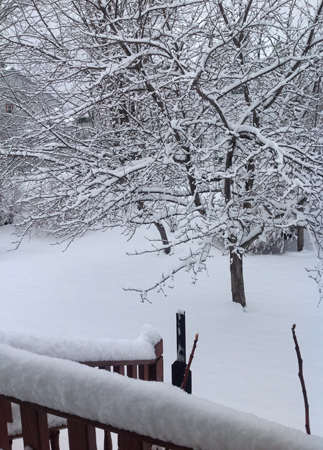
winter’s last blast
|
and a free breakfast
|
Rose sent me the image of her Michigan backyard covered in spring snow and I took the pic of her and Daniel eating the free breakfast-donuts at the Ka ‘Eo Kai condo complex. The breakfast image was taken two weeks ago.
Yes, we traveled to Kaua’i a month earlier than other years and we found cold weather in the garden island. (Why Daniel is all covered up and why I went out and bought a long-sleeve T and a left-over-hippie, VISSLA hoodie.) Finding cold weather when we got back state-side was not a surprise, but three inches of SNOW!
I’m adding to this post on April 1. The date officially puts March 2015 away. Don’t know why, but with March done, winter also feels done.

 Last Sunday, I spent time at Allegheny Cemetery shooting images for my photography class. We were each given an assignment card and mine was to find abstract designs inside an image. I thought that I could shoot some of the scroll work on the various grave-markers and see if that would look abstract. The problem with the granite scrolls was contrast; there just wasn’t enough of it. Also, I think it’s harder to make curves look abstract. So, I headed up the hill to the Porter grave with its massive oxidized-copper angel. The green patina should give me the contrast I was looking for.
Last Sunday, I spent time at Allegheny Cemetery shooting images for my photography class. We were each given an assignment card and mine was to find abstract designs inside an image. I thought that I could shoot some of the scroll work on the various grave-markers and see if that would look abstract. The problem with the granite scrolls was contrast; there just wasn’t enough of it. Also, I think it’s harder to make curves look abstract. So, I headed up the hill to the Porter grave with its massive oxidized-copper angel. The green patina should give me the contrast I was looking for.
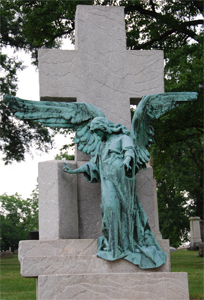
Porter Monument
For some strange reason, the above image makes me think of Ortigia with its undulating coastline and the wing-tip a finger of a Colossal pointing east – back to its home in Greece.
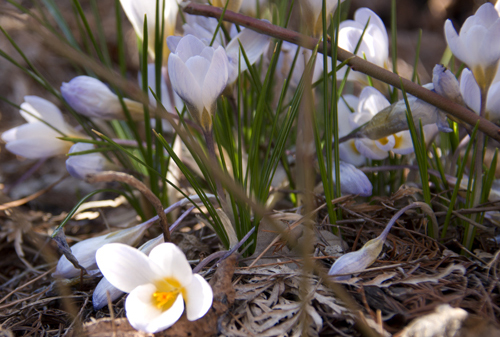
stroll around the grounds until you feel at home

Sitting on a sofa
on a Sunday afternoon.
Going to the candidates’ debate.
Laugh about it, shout about it
when you’ve got to choose
every way you look at this
you lose.
Where have you gone,
Joe DiMaggio,
our nation turns
its lonely eyes to you.
What’s that you say,
Mrs. Robinson
Jolting Joe has left
and gone away.
Easter Sunday is one of my least favorite holidays. I guess once you let go of religion, the myths go too. Christmas is more accessible, more human in its narrative. Easter requires belief in the myth of resurrection. And where its an amazing human construct, belief removes it from a sense-of-wonder and makes it an article of faith; belief removes it from its historical context and makes it a litmus test for Church membership.
For the first time ever, I am sitting on the deck with an unplugged laptop, working on this post, drinking Grey Goose and Anisette and listening to music. It’s hard to go back to mythology when modernity puts magic at my fingertips.
I downloaded Mrs. Robinson when I got back from Kaua’i, to remind me of the woman who hit on our Daniel. It was Sunday, March 15 and the employees’ families were using the pool. One of the woman tried to get Daniel into a conversation; he was polite, but gave no openings and she soon went back to her tattooed family.
iTunes has moved on to Mick who is warning, “Don’t play with me cause you’re you’re playing with fire.”
now, Peter Sarstedt is asking, “Where do you go to my lovely, when you’re alone in your bed?
. . .
Remember the back streets of Naples, two children begging in rags, both touched with a burning ambition …”
The neighborhood is full of night-light – the Mattress Factory seems to have captures two moons in its windows, the street lights on Sampsonia Way are covered in wild-grape and above it all, the beanstalk Tower looms its red, blinking lights punctuating the dark.
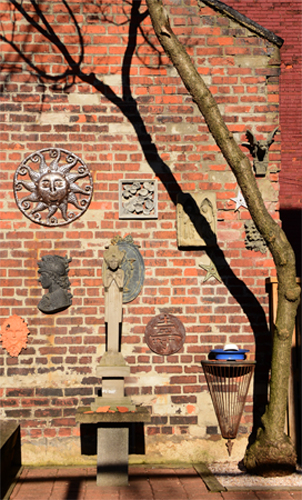
 Sunday was the first day of sun and warmth. Brought out the deck-chairs and sat outside after dinner. The fading sky was spring-blue and it was fun to shoot in the backyard. The image on the left is the Japanese Lilac. Last fall I cut a large branch that was at right-angle to the curving trunk. You can see the scar, the folding bark near the top. It’s healing, but I learned to trim branches differently after that tear. I took the hand-saw to the branch without making a first-cut at the bottom. The first-cut would have prevented the heavy branch from ripping off the trunk once I got deep enough. Instead of ripping it would have collapsed on the first-cut and ripped from the top, the part that I had cut with the hand-saw.
Sunday was the first day of sun and warmth. Brought out the deck-chairs and sat outside after dinner. The fading sky was spring-blue and it was fun to shoot in the backyard. The image on the left is the Japanese Lilac. Last fall I cut a large branch that was at right-angle to the curving trunk. You can see the scar, the folding bark near the top. It’s healing, but I learned to trim branches differently after that tear. I took the hand-saw to the branch without making a first-cut at the bottom. The first-cut would have prevented the heavy branch from ripping off the trunk once I got deep enough. Instead of ripping it would have collapsed on the first-cut and ripped from the top, the part that I had cut with the hand-saw.
I like the shadow of the trunk. It captures the curve more than precisely than the trunk itself.
Kaua’i has always been a time to get ready for summer. I pack and try out any new camera accessories, so that by the time I’m packing for Italy I’ve have a test run. I learned that it wasn’t a good idea to bring only high-end cameras, because if I want someone to take our pic, I can’t give them a difficult camera to use. (Never mind the woman at the Queen’s Bath who was shooting with a Canon but had no clue when I handed her my camera with a fixed lens. She was looking for the zoom. And the pictures she took were useless. The woman who took our picture at Waimea Canyon did a great job and she knew about a fixed lens.) Other years, I got sandals – indoor Crocs and outdoor Keens. This year, I discovered that my runners weren’t the best for walking or trekking the jungle paths. They were too flexible for walking and not flexing enough when walking the lava boulders. I’ve finally figured out that the New Balance products work well for me. (The Merrells look great, but they were terrible for walking around. The summer before last – 2013 – we were walking in Rome and my feet were sweaty, hot and sore. I also had a pair of their original Encore slipons and I had to throw away, because at that time they had no breathing vents and my feet just sweated.) Last summer, we did more walking than I’ve ever done in Italy and not once were my feet sweaty or sore in the New Balance runners. So, when I got home, preparing for Puglia and future trips to Kaua’i, I ordered New Balance walkers and today I got New Balance trekkers. I find I can use the shoes right out of the box with very little breaking-in time. And both the walkers and trekkers have discreet N logos. (I ordered trekkers, because the walking shoes don’t have enough solidity or rigidity for the off-road walking to get to the waterfall at McConnell’s Mill. And I’d like to keep the walkers free of mud and grime, because I want to use them as an everyday shoe.)
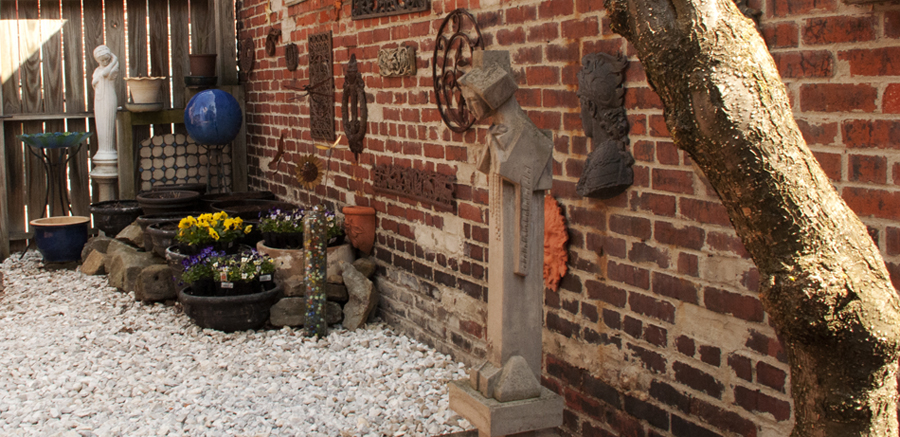
 The terra-cotta pots did not last the winter. I’ve been using these large left-over containers for eggplant. (My dad mentioned that eggplants won’t fruit if planted where the ground gets cold at night. And that in this environment, unlike Italy, they need to be in pots if I want to improve the probability of getting fruit.) So yesterday, I went to Home Depot and bought 3 large plastic pots. These will hold my eggplants. (Getting rid of the terra-cotta also means getting rid of heavy pots that make re-landscaping tough work.)
The terra-cotta pots did not last the winter. I’ve been using these large left-over containers for eggplant. (My dad mentioned that eggplants won’t fruit if planted where the ground gets cold at night. And that in this environment, unlike Italy, they need to be in pots if I want to improve the probability of getting fruit.) So yesterday, I went to Home Depot and bought 3 large plastic pots. These will hold my eggplants. (Getting rid of the terra-cotta also means getting rid of heavy pots that make re-landscaping tough work.)
I put the 3 new pots in the back and that meant rearranging everything else. This year the new addition is a bird-bath – top left-hand corner. (It was a solution to getting rid of a large glass dish from the dining room table.) I found the stand at the local grocery store and decided to use the large bowl that had been on my table full of winter hats, gloves and scarves. I incorporated the ceramic marble into the area and moved the tall glass cylinder full of real marbles to the front.
Was talking to my cousin who just bought a town-house in Mississauga and I asked him if he liked to putz around in the dirt. He answered that he hated it. I told him the cultural-police were going to revoke his Italian ancestry. I also asked Rose what she and Derrick are going to do about gardening when they are living 6 months in Kaua’i and 6 months in an apartment state-side. Haven’t received an answer yet.

 Years ago at some yard sale, I picked up a tall, cylindrical glass-vase. I took it to the Pittsburgh Glass Center and had them drill a hole in the bottom. I filled it with marbles, because I love marbles. It doesn’t look bad.
Years ago at some yard sale, I picked up a tall, cylindrical glass-vase. I took it to the Pittsburgh Glass Center and had them drill a hole in the bottom. I filled it with marbles, because I love marbles. It doesn’t look bad.
I ended up putting the cylinder in among the lilies-of-the-valley. I also stuck the copper ornaments – dragon fly, butterfly, bee and sunflower – into the glass vase. (There are friends who are accusing me of making the back-yard look like Bloomfield. The negative comment references the Italian-American’s sense of decor that is on display in the Bloomfield section of Pittsburgh. A lower middle-class neighborhood with 3rd and 4th generation Italian-Americas.)
The rest of the planting is going slowly mainly because the weather has turned cold and at night it gets below 40. I’m trying something new this year – planted ornamental sunflowers under the white marble stones and zucchini in a pot. Let’s see what comes of this effort. And for the first time, I bought a huge fern and put it into the ceramic pot that last year held a hanging begonia. The green is a great contrast with the white stones.
And I’m finally going to get the back-yard redone. It’s been almost 20 years since the pavers were put down and the sand foundation has fluctuated to the point where nothing is flat. As a matter of fact, when it rains there are puddles all through the back.
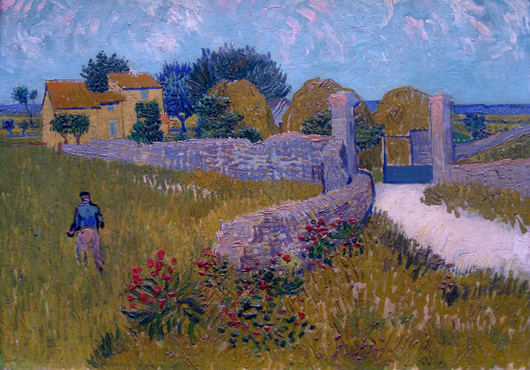
 One of my favorite movies is Ridley Scott’s A Good Year. And screen-writer Marc Klein wrote some of my favorite dialogue.
One of my favorite movies is Ridley Scott’s A Good Year. And screen-writer Marc Klein wrote some of my favorite dialogue.
You’ll come to see that a man learns nothing from winning.
McDonalds is in Avignon, fish-and-chips in Marseille.
No Max, it’s your life that does not suit this place.
In California, they don’t make wine.
They make Hawaiian Punch.
We don’t say “shabby,” Max. We say
“filled with the patina of a bygone era.”
You know what Proust said,
“Leave pretty women to men without imagination.”
And remember you’re in France:
the customer is always wrong!
The film is better than the Peter Mayle book of the same title. The convoluted relationships in the book are reduced, the cinematography of the Luberon is spectacular, the underlying theme of solace-in-a-world-obsessed-with-money is more obvious and Albert Finney, even at the end of his life, is someone you can’t take your eyes off. (He may not be the gorgeous hunk of Tom Jones or Two for the Road, but the voice stayed true to the end.)
“I don’t yearn for how I used to look,” Finney bristles. “I don’t think I’m particularly handsome. I think maybe I’m attractive. I remember with Tom Jones being very concerned to tell people that I was not just another pretty face, and that’s why I took all those character roles. Why I played Luther on Broadway, for instance. All those character roles were perhaps an overreaction to being treated like some kind of sex symbol.”
In the film, in the restaurant is the ubiquitous van Gogh poster – Country Road in Provence by Night. I wanted a less recognizable van Gogh, but one that showed the Provencal rural countryside. And though van Gogh’s blues are not something I like, the purples in the Farmhouse in Provence are very different. They make the blue gate, the blue trees, the blue shutters, the blue mountains palatable.

 I went walking along the North Shore down by PNC Park. The city looks amazing from the north shore of the Allegheny. And with Phillip Johnson’s fairytale skyscraper on the left and the drill-bit building on the right, how can you think of anything other than Oz.
I went walking along the North Shore down by PNC Park. The city looks amazing from the north shore of the Allegheny. And with Phillip Johnson’s fairytale skyscraper on the left and the drill-bit building on the right, how can you think of anything other than Oz.
This is the d800e, 36 megapixels and hues of blue. (My favorite part of the image is the white cloud in the top right. The contrast with the blue spires and the blue sky makes the cloud marshmallow soft.)
It was also game-day and Pirate fans were all over the place. I love being in an urban setting and having people all around – people strolling in the riverside park, people eating and drinking in the restaurant and bars, people dancing and running on the pedestrian-only bridge. A spots venue in the middle of nowhere is desirable only for commuters; a sports venue in the middle of town is dynamic, rich; a sports venue in the middle of town is a celebration of urban living. It’s our twenty-first century version of the Medieval festival. In Pittsburgh, our knights are dressed in black and gold and today they were jousting with the red knights of Cincinnati.
I fear that here in Western Pennsylvania we are slowly adopting the European model of city-living – the city is for the rich and the suburbs are for the poor. Pittsburgh’s downtown, its Southside and its North Shore have been taken over by the next generation. The areas are full of young working people who eat out, who live in apartments, who drive small cars, who take public transportation. The poor, the old and the car obsessed are being priced out of the urban core and forced to go live in the outer-rings. As the city becomes more gentrified, more resident-friendly, suburban Pittsburgh is becoming more poor, more remote, more detached, old. I saw that in Manhattan; the island is no longer affordable by middle and lower-middle class families and certainly not affordable by low-income retirees. I don’t know enough about Baltimore, but with DC as the center of the metropolitan region could it be that it’s where the poor and the old are retreating?
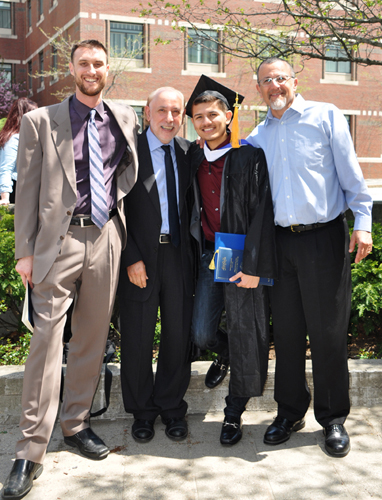
 Over the weekend, Sarah, Rick and I traveled to Worcester to attend Arturo’s graduation from Becker College. Over 300 kids graduated and they were able to keep the ceremony down to 2 hours. The ceremony was not very interesting, the head of Aetna gave the commencement address and she was very poor. (It was hard to believe that this person ran a multi-million dollar corporation.)
Over the weekend, Sarah, Rick and I traveled to Worcester to attend Arturo’s graduation from Becker College. Over 300 kids graduated and they were able to keep the ceremony down to 2 hours. The ceremony was not very interesting, the head of Aetna gave the commencement address and she was very poor. (It was hard to believe that this person ran a multi-million dollar corporation.)
The night before, we had attended the Honors Convocation at Becker’s Leicester Campus. Arturo graduated Cum Laude. Arturo came to Becker from San Diego State and he had a great college experience. (The food at the reception was excellent.)
It was interesting to be back in New England for a college graduation ceremony. No one misbehaved, no one screamed, no graduate danced across the stage. It was all so correct. And that was good, because Arturo is someone who would have frowned on bad behavior. (The Boston area has the same frenetic energy as New York City. And when I’m sitting in the plane getting ready to take off, I’m glad to leave the intensity behind.)
The image on the left – Ryan Oliver, Mario Zinga, Arturo Nieto, Rick Wertheimer – the principals from City High. (Ryan is Arturo’s uncle and the main support behind his Gates Millennium Scholarship and his guide when he transferred from San Diego State to Becker College.)

 It’s always a disturbing experience to come north in the spring. I leave behind warm weather and trees full of leaves for cold days and colder nights, bare trees and gardens growing to the rhythms of a winter dominant land.
It’s always a disturbing experience to come north in the spring. I leave behind warm weather and trees full of leaves for cold days and colder nights, bare trees and gardens growing to the rhythms of a winter dominant land.
The above image is of fava leaves. In Calabria they are already eating the bitter beans, but here in Northern Ontario, the leaves are just sprouting. (I remember going looking for fava, in the Strip, in early July only to have the vendor tell me that fava are an early spring bean and that July is the time for summer fruits-and-vegetables. My reply was that at my Dad’s we always ate fava in July. And then it dawned on me, that we ate fava in July in Northern Ontario. I apologized and went out with a new piece of awareness.)
My Dad’s garden is planted with garlic, onions, fava, radish and early bush-peas. Anything else would not survive the cold nights. (The tomato plants are in the sun room waiting for the threat of frost to retreat.) The garden is also full of seedling from the nearby willow and my Dad is threatening to call the Forestry Department and have the tree cut. I suggested that trees are good for the environment and for air quality. That fell on deaf ears as he pointed to the thousands of seedling he’d have to weed from his precious garden. (The man is 90 and is still planting a huge garden. Hard work that he does all on his own. As he says, he’s now doing it very slowly, but it isn’t like he had to get up and go to work. I think I get my love of putzing around in the soil and planting from him.)
One last note: When it was still a detriment to be Italian in Sault Ste Marie, fava were called horse beans another slur and negative hurled at the immigrants and their foreign foods. Today with the awareness of a nutritionally bankrupt food system and a need to find viable, healthy foods, the fava has regained its status and lost its immigrant negativity. All the grocery stores now carry fresh fava and all the foodies are rushing to eat the bitter, peasant bean. BTW, in Calabria, in the winter, the dry bean was fed to donkeys.
This series will also cover the early August return trip under the category sault 2015.
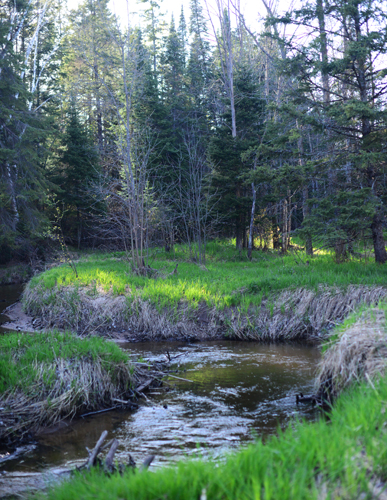
 The day began gray and overcast, but at least no rain. I like the west-end of town with its industrial landscape and rugged coastline. It’s also littered with streams that empty into the St. Mary’s River.
The day began gray and overcast, but at least no rain. I like the west-end of town with its industrial landscape and rugged coastline. It’s also littered with streams that empty into the St. Mary’s River.
The image on the left was taken early evening. The stream is on Connie-and-Ron’s property in the Base Line section of town. The area at one time was all farmland, now solar-farms sprout from the thawing soil. In heavily developed cities, we introduce old icons – weather-vanes, split-rail fences, Home-Depot barns – to remind us of the long ago when the streets, highways and suburbs were rural, forested lands. In Northern Ontario, the inhabitants add modern icons – John Deer tractors, satellite dishes, solar panels – to their properties to remind them that they live in the 21st century. I’ve been taught to regard the old icons as quaint and the new ones as contrary; I don’t know if I can keep to that distinction.
The stream goes through an area that was once a beaver pond. There are still reminders of the pond – felled trees with teeth marks, remnants of a dam and the top of a lodge. The main channel – the stream – when the area was flooded, was probably 10 feet deep and the surrounding area is bordered by a natural embankment that the beavers used to border the pond.


Because the Thormans head home tomorrow, we had the big meal at lunch today. Afterwards, we headed out to Connie’s cottage and we walked the Voyageur Trail from the cottage south towards Gros Cap. The above image is of Lake Superior along the trail.
Before we got to the cottage, there was a discussion about making the big meal simple. I failed to alter those plans; my mother made lasagna, my dad roasted rabbit and potatoes, deep fried breaded shrimp and cooked calamari in a tomato sauce; these were complimented with various vegetable dishes and salad to finish the meal. For dessert, we had these amazing cream-puffs that my mother’s friend made and dropped off before lunch.
I was able to extract from my Dad a change of venue. Instead of preparing all the food here in town and then packing it up and carting off to the cottage, I made the strong suggestion of eating in town and we did. My parents work very hard when we are all visiting and I know they enjoy the company, but they are 90 years old. And cooking everything to then cart it off to eat an hour away was added work that they did not need to do. (I probably robbed my Dad of an outing, but that will just reinforce my reputation as a difficult and uncooperative family member.)
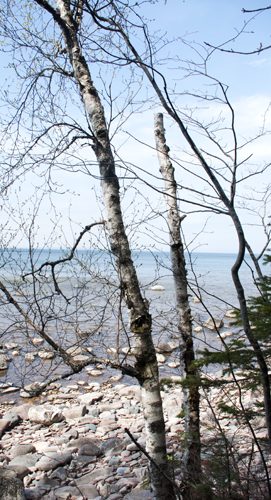
 On the way back from Connie’s cottage, two men were stopped on the side of the road retrieving birch tree bark from the side-ditch. I assumed the two men were collecting the bark to use in some art project.
On the way back from Connie’s cottage, two men were stopped on the side of the road retrieving birch tree bark from the side-ditch. I assumed the two men were collecting the bark to use in some art project.
In elementary school, we learned that Native Canadians made canoes out of birch bark. (In Ontario, the tree is also called the Canoe Birch.) That has always fascinated me and that memory always comes back whenever I see the tree or the bark. The bark is also prized by Canadian artists who make all sorts of things from it. The bark from a dead birch rots very slowly; remaining solid long after the wood had decayed into dust.
The image on the left is from the Voyageur Trail outing. The trail follows the lake-shore, is well maintained and at this time of year mosquito-free. (I hate visiting in early August, because the mosquitoes are in full force and I leave covered in bites.) The white birch grow all along the lake and it was great finding this small stand. The Voyageur Trail is really a series of smaller trails that when linked go across Canada. This particular section, about 20 km, goes south along the Red Rock Ridge and comes out at Gros Cap. In the region most trees still have no leaves and the apple blossoms are weeks away. Spring flowers are almost two-and-a-half weeks later than they are back in Pennsylvania. For us, the spring flowers are done and the trees are full.
I liked the birch tree with its white bark enough to have Derrick cut a dozen of short logs that I put in the non-working fireplace in my Mexican War Street house. (They were hard to keep clean and eventually had to be thrown out, because they were encrusted with dust.)
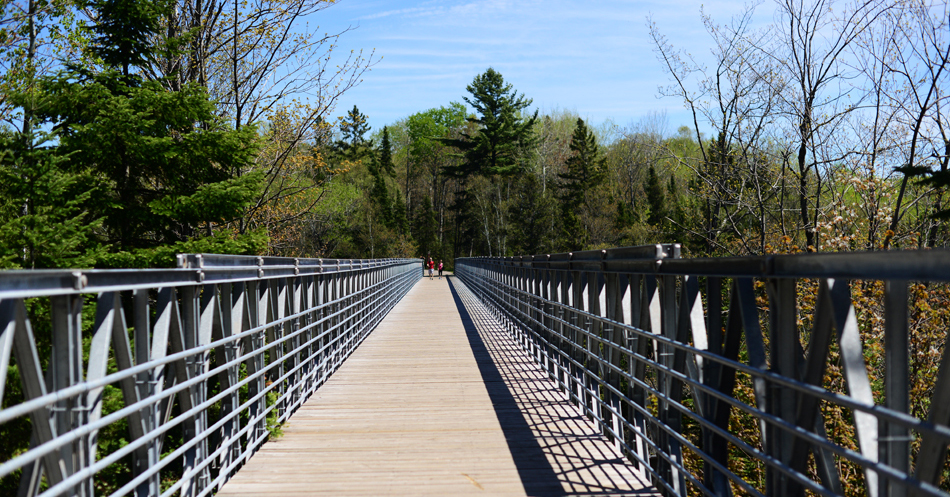

My generation wanted out of the West-End and ran to buy houses in the Protestant East-End. Sir James Dunn High School was the envy of every immigrant living in the West-End. The Dunn was new and full of Canadians. The West End elementary schools were full of immigrant children. (St. Veronica and St. Joseph Elementary were full of children with names like Stocco, Zinga, Bitonti, Pozzobono and Fratesi.)
Forward 50 years and the world has changed. St. Veronica’s and St. Joseph’s are shuttered and the sons and daughters of the immigrants have taken over the political machines. The mayors and aldermen, for the last thirty years, have all had last names ending in vowels. Gone are the McCaigs and the Smiths. And the West-End with its wooded lots and undeveloped ridge has become a magnet for young families and well-to-do families looking for large parcels of land with a view to the Lake.
And the fact that much of the political class has come from the West-End, much of the new development has occurred in the West-End. The above image is of the Fort Creek Conservation Area. The walking path through the area is amazing. The metal bridge in the image is one of three that span the Creek.
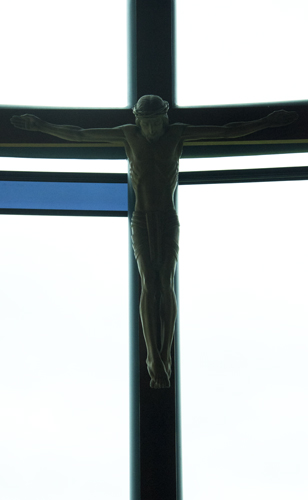
 There are two side-trips I’ve been wanting to do when at Rose-and-Derrick’s. Today, I got to do one of the two – visit St. Benedict Monastery on East Drahner Road. Rose and I got back to her place in the early afternoon and after expelling the last of the Sault residue, we took a drive down East Drahner. (Rose who’s lived there some 20 years, had no idea the monastery existed.) The complex is rather small in comparison to other monastery properties. It has a huge modern church, the monastery and a new large retreat house.
There are two side-trips I’ve been wanting to do when at Rose-and-Derrick’s. Today, I got to do one of the two – visit St. Benedict Monastery on East Drahner Road. Rose and I got back to her place in the early afternoon and after expelling the last of the Sault residue, we took a drive down East Drahner. (Rose who’s lived there some 20 years, had no idea the monastery existed.) The complex is rather small in comparison to other monastery properties. It has a huge modern church, the monastery and a new large retreat house.
The chapel is this huge modern church with floor to ceiling windows behind the main altar. (The chapel was completed in in 2000; the architect was William Wyzinski.) The image on the left is of the corpus behind the main altar. The architect uses the window frame for the cross, putting the corpus at the junction of a horizontal and a vertical pipe. I like the image, especially the blue rectangle on the left. It’s a window shade that was pulled slightly down. I find modern religious architecture not very inspiring; it lacks a sense of the sacred. However, the monastery chapel on East Drahner Road works well as a sacred space. The best example of modern religious architecture that invokes the sacred is Le Corbusier’s Notre-Dame du Houte in Ronchamp. Seeing the hilltop chapel for the first time in the rear-view mirror and then walking its stark interior were amazing experiences. The chapel at Ronchamp was commissioned by the Dominican friar Marie-Alain Couturier. His quote – better to commission geniuses without faith than believers without talent – is amazing and a pillar of faith for the Church during the Renaissance. (The modern-day Republican Party seems unable to commission politicians who are either craftsmen or geniuses at compromise or governance. Primary voters would rather elect a presidential candidate who is a believer in the rule of white-men, regardless of his lack of talent to lead a heterogeneous country.)

 The Japanese lilac is full of blossoms. The plant is part of the olive family and the blossoms are bisexual, with fertile stamens and stigma in each flower.
The Japanese lilac is full of blossoms. The plant is part of the olive family and the blossoms are bisexual, with fertile stamens and stigma in each flower.
Bitter winters produce the most blossoms. The plant is threatened and produces more flowers ensuring more seeds. (In early spring, the city streets are filled with blooming wild almond. In late May, the old streets of the Central Northside are filled with blooming Japanese Lilacs.) And as the small flowers fall, the back-yard will be covered in white. One of the side-effects is that I’m popping antihistamines because of the over-abundance of pollen falling from the blossoms.
I’ve written about the Japanese Lilacs before – the smell reminds me of my time in Rome in the spring of 71. The white flowers are everywhere in the ancient city and the perfume infused the spring air.
Last year I began replacing the terracotta pots, because they were cracking and crumbling. They may look good, but they are made for a warm Mediterranean climate. Also, last year was the first year with the new surface on the side-yard. This year, I finished replacing all the old pots and filled in the holes. (I ended up buying 6 new plastic or ceramic pots.) I’m assuming that going forward, I will not need to buy replacements.
This year, I’m trying to grow some added vegetables – peppers and zucchini – and some new flowers – hollyhocks and sunflowers. Don’t know if I’ll have any luck with these. The zucchini is the biggest gamble, I have enough room for the runners, I just don’t know if the plant will like living in a huge pot. The hollyhocks will end up against the back fence, but the sunflowers are in serious danger of being eaten by the dogs. Bilby has discovered them and apparently the leaves must taste good, because he has eaten all but two plants. (Jack doesn’t seem interested, but Bilby has started to also eat the green blueberries. All the dogs have eaten the blueberry flowers, the green berries and the ripe berries.)

 My first day in San Francisco and we went on a boat ride through the harbor. The harbor is huge reminiscent of the one in Naples. And the hills that surround it are brown with no vegetation.
My first day in San Francisco and we went on a boat ride through the harbor. The harbor is huge reminiscent of the one in Naples. And the hills that surround it are brown with no vegetation.
The city itself is of a human scale. All the housing is two, three and four story buildings. You walk out of Tom-and-Kathi’s house and the neighborhood is proportioned for humans. (It is different to see all the housing constructed from wood. Coming from a cold climate where wood had become an interior material and brick the pervasive external sheath.) The city also has a Mediterranean feel to it making it familiar and accessible. Even the downtown office buildings do not create the caverns of Manhattan Island.
The image is from the harbor cruise-ship looking at Telegraph Hill and the Bay Bridge on the left.

 Up the street from Tom-and-Kathi is the Jesuit University of San Francisco. And given that the Spanish discovered California and that Ignacio de Loyola was a Spanish nobleman, the university church and the priests’ residence are late Baroque and beautiful against the morning sun.
Up the street from Tom-and-Kathi is the Jesuit University of San Francisco. And given that the Spanish discovered California and that Ignacio de Loyola was a Spanish nobleman, the university church and the priests’ residence are late Baroque and beautiful against the morning sun.
The image on the left is the copula and one of the bell-towers from the large campus church. (My goal is to go there tomorrow morning and shoot the interior.) The image was shot from the Jesuit Mother-House that now houses the University Admin offices. The Mother-House complex is high Baroque and its soft stone facade gleams in the California sun.
As I walked around the old Mother-House, I kept thinking that Tom and I lived in the Christian Brothers’ Mother-House in the late 60’s. It wasn’t in California, but in grey New England. But is was every bit as grand and expansive.
There really was a time when Mother Church added to the American culture; when it nurtured its European immigrants in the New World. Mother Church brought over the priests, nuns and brothers that created some of the best schools in the country. And it supported this group that educated the children of the immigrants giving them the opportunity to fully participate and contribute to the economy and culture of the New World. And for this grand legacy, I may have to rethink my antagonism towards Mother Church.


What amazes me is how similar the San Francisco area is to southern Italy, to Calabria. The topography and the look are so familiar, I keep saying, “If my Dad could see this. If the Calabrese could have come here instead of severe Northern Ontario, their transition would have been so much easier.”
Today, Tom and I drove south as far as Santa Cruz. (The above image is of the coastline south of San Francisco.)
The other refreshing aspect of being here is the lack of references to anything English. Canada with its British legacy and Pittsburgh with its English obsession are annoying. Here everything points to its Spanish past. There is no Queen or King Street and there are no East-enders swooning over Masterpiece Theater and its latest costume farce. You know, the ones where the dukes-and-duchesses look down their noses at the chambermaids and footmen. (If only help weren’t so hard to come by or so demanding of a living wage the East-enders too could live like the Royals of public television.)
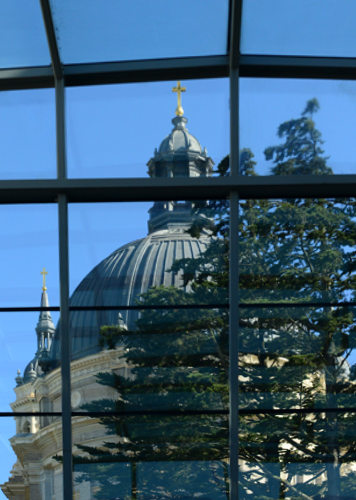
 Sometimes I look at all the religious architecture I shoot and think that maybe I’m over doing it. I’m on the campus of The Jesuit University of San Francisco in a modern atrium. Looking up, I realize that it was built to face the old church and to frame the old copula, so I had to shoot it.
Sometimes I look at all the religious architecture I shoot and think that maybe I’m over doing it. I’m on the campus of The Jesuit University of San Francisco in a modern atrium. Looking up, I realize that it was built to face the old church and to frame the old copula, so I had to shoot it.
It’s and urban campus and therefore everything is compact. The area must have had a collection of religious organizations, because there are two convents and an old all-girls college surrounding the university. (The all-girls college has been assumed into the university.) Within a five block radius, there are many Spanish style steeples. I wonder if the convents are also Spanish in origin.
I’m not interested in going into St. Ignatius Church; I just like the steeples and dome against the blue San Francisco sky.
Tomorrow we head up to Napa. We will tour a couple of the vineyards that Tom-and-Kathi like. (Frank claims that Napa will look even more like Calabria. He and his family were here in 93. So what it took me 23 more years to finally get here.) The weather in Napa is supposed to be warm. The 3 days I’ve been here, I’ve been in long-pants and sweaters. On one level, I want to say, “But it’s June.” but then I remember that I would be wearing the same clothes if it were February – amazing.

 We spent the day in the Napa Valley. We went to two vineyards, the first one because of its art collection, the second one because of the tram.
We spent the day in the Napa Valley. We went to two vineyards, the first one because of its art collection, the second one because of the tram.
The above image is of the canvas awnings in one of the wine tasting areas.
Some of my favorite things about Napa:
– Finding out that the valley runs east and west. This allows the hot winds from the desert to blow into the valley. It was so warm, we were glad to have AC buildings to go into.
– The valley topography is obvious and the flats are covered with grapevines.
– The Christian Brothers have a Novitiate in the Valley and at one time they had one of the largest wineries in the Valley. They made Christian Brothers Brandy.
– The wineries on the Silverado Trail are better.
I did hate the traffic on 29 especially through St. Helena.

 This triptych is in the Hess Gallery at the Hess Winery – the first winery we visited. (I guess wine has made millionaires of the Hess family.) And next door was the Christian Brothers Novitiate and Conference Center. I don’t know what I liked more – discovering the Christian Brothers Novitiate in Napa, especially after having written about the contributions of the religious orders to American culture, or that the old and retired Brothers are living next door to a modern art collection.
This triptych is in the Hess Gallery at the Hess Winery – the first winery we visited. (I guess wine has made millionaires of the Hess family.) And next door was the Christian Brothers Novitiate and Conference Center. I don’t know what I liked more – discovering the Christian Brothers Novitiate in Napa, especially after having written about the contributions of the religious orders to American culture, or that the old and retired Brothers are living next door to a modern art collection.
In the whole United States, there are about 700 Brothers left in the organization I joined back in my youth. (The average age of the group is over 70.) The religious order that took me out of northern Ontario and opened the door to New York City and Pittsburgh is dieing. Within 20 years the Brothers, Sisters and Priests that ran the Catholic Schools in the United States will be no more. Bobby, who is my remaining friend in the Brothers, is in Concord, CA; he is the principal at the Brothers High School there; and Bobby is my age.
Tom and I did go up to the Brothers House asking if Brother Robert was in, but school, in the East-Bay Area is still in session.

 This is the third entry about Napa.
This is the third entry about Napa.
The surprise yesterday was finding the Christian Brothers Novitiate and Holy Family Institute next door to the winery. Tom-and-Kathi had been to the winery before, but neither had ventured into the next property. I saw the bell-tower on the Spanish facade and had decided that I wanted to come back after touring the gallery.
Tom went up to the sign and discovered that it was the Christian Brothers Novitiate. This is comparable to the Novitiate we were at in Narragansett, Rhode Island. This was the west coast version. The above image is the Mont La Salle Chapel and what’s amazing about it is that it was renovated in the same style as the chapel in the Brothers Novitiate in Barrytown, New York. I found the black-and-white picture of the Barrytown chapel online.
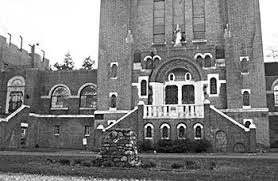 When we were at Narragansett they took us on a trip to the Barrytown Novitiate and Mother-House. (Most of the Brothers who were 10 years older than me, had gone through the Novitiate here on the Hudson. The Narragansett facility wasn’t built until the early 60’s.) The original chapel building, from the outside was your typical European church structure, and walking in to see the modern renovation was a shock. It was amazing to see this minimalist chapel in a building that must have dated from the 30’s.
When we were at Narragansett they took us on a trip to the Barrytown Novitiate and Mother-House. (Most of the Brothers who were 10 years older than me, had gone through the Novitiate here on the Hudson. The Narragansett facility wasn’t built until the early 60’s.) The original chapel building, from the outside was your typical European church structure, and walking in to see the modern renovation was a shock. It was amazing to see this minimalist chapel in a building that must have dated from the 30’s.
I’ve sent Bobby an email asking if he can find out who did the renovations both at Mont La Salle and in Barrytown. He answered that the Brothers had contracted with the Rambush Architectural Firm for the Mont La Salle Chapel, the Barrytown Chapel and the chapel at the Brothers Washington DC house.

 Given that in 4 hours, I’m headed to the airport, today was a down-day. We walked up to Haight Street and then down into Golden Gate Park. Two observations about the Park: one – all the marginal people are white; two – the Park is full of people. I said to Tom, “If San Francisco can do it, why can’t New York City? Why can’t Central Park be made safe so every part of it can be used?”
Given that in 4 hours, I’m headed to the airport, today was a down-day. We walked up to Haight Street and then down into Golden Gate Park. Two observations about the Park: one – all the marginal people are white; two – the Park is full of people. I said to Tom, “If San Francisco can do it, why can’t New York City? Why can’t Central Park be made safe so every part of it can be used?”
It’s a very walkable Park and we ended up at the AIDS Memorial. I had seen the documentary that chronicled the building of the memorial and I’m glad to see that those who wanted a low-keyed, subdued commemoration won out. The place is peaceful and serene.
There are boulders throughout the grove and many of them are carved with people’s names and various epitaphs. The one above was a strange one. I liked the quote, but under it was the name of the corporate sponsor. I removed the corporate name and kept the message.
Running through the grove is a dry stream-bed beautifully landscaped with hand-picked rocks. I found a rock that was split and took it as my souvenir from San Francisco.

 when sundown pales the skysan francisco – 9th entry
when sundown pales the skysan francisco – 9th entryIt’s been four days since my first visit to Northern California. I really liked San Francisco; it felt both safe and accessible. The brown hills, the pine trees, the vineyards were so familiar that I kept thinking I was back in southern Italy. The temperature was cool; the whole time I was there I wore a light sweater and long-pants. The Pacific can be ignored, but the Bay is wonderful. The city exudes a sense of tolerance and the gay community takes that tolerance as a given. I was proud to be in a city where Liberals run an amazing urban center. The urban landscape is on the other side of the Bay – out of sight and maybe out of mind. The housing density is second to New York City and housing prices are extreme. (I kept thinking that Tokyo, must have the same dense feel to it.)
The Golden Gate is majestic, but the Bay Bridge is elegant. (The above image is of the Bay Bridge.) Mendocino is New England, but Napa is Italy. (The rugged coastline and quaint shops of Mendocino stand in for Jessica Fletcher’s home in the fictional town of Cabot Cove, Maine. And the Spanish haciendas and Italianate cantinas blend wonderfully with the long rows of grapevines of the Napa Valley.)
But San Francisco shows that Liberals can succeed in an America held hostage by an intolerant Republican Congress.
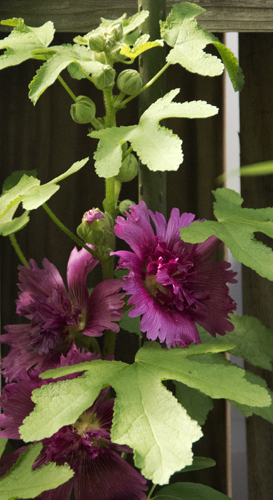
 Talking to my mother about norther California was funny. She revealed that it had always been a place she had wanted to see. Don’t know why she never told me that before. When I told it was my first sight-seeing trip to the state, I had to explain why I had avoided The Golden State, The Land of Milk and Honey, La La Land. She laughed.
Talking to my mother about norther California was funny. She revealed that it had always been a place she had wanted to see. Don’t know why she never told me that before. When I told it was my first sight-seeing trip to the state, I had to explain why I had avoided The Golden State, The Land of Milk and Honey, La La Land. She laughed.
What I keep thinking about is the amazing weather. Tom-and-Kathi just put in a furnace in the last 3 years. (Can you imagine no AC bills, no heating bills?) And the fact that I spent the entire time with long-pants and a light sweater was amazing. Without sounding too sarcastic, I loved that fact that there were no references to England or English things. (The Spanish architecture is so much more interesting than the British influenced, severe buildings of Toronto.)
And then to top it all off, I got an email from one other Calabrian expat – Pietro – who lives in San Francisco. The four of us – Pietro, Gabriele, Carlo and I – left Aprigliano in the 50’s and came to the new world. Pietro’s family went to Montreal, but he couldn’t deal with the winters and left for Florida. But he left The Sunshine State, and headed for the golden, rolling hills of California. He opened two restaurants, one in San Francisco – Ristorante Parma – that his daughter still operates and one in Napa. Gabe landed in Toronto and is the most financially successful of the group. Carlo too ended up in Toronto where he is a partner in a healthcare firm. And Rick Wertheimer and I managed to build an innovative and successful charter high-school in downtown Pittsburgh.
For those who come to San Francisco, summertime will be a love-in there . . . Scott McKenzie’s song was one of my favorites and for the first time ever, I have hollyhocks blooming in my back yard – the accompanying image. But it was too late, by the time I got there, to wear flowers in my hair.


and then sometimes there are days like this
when that slow, steady effort towards progress is rewarded
with justice that arrives like a thunderbolt
No union is more profound than marriage, for it embodies the highest ideals of love, fidelity, devotion, sacrifice, and family. In forming a marital union, two people become something greater than once they were. As some of the petitioners in these cases demonstrate, marriage embodies a love that may endure even past death. It would misunderstand these men and women to say they disrespect the idea of marriage. Their plea is that they do respect it, respect it so deeply that they seek to find its fulfillment for themselves. Their hope is not to be condemned to live in loneliness, excluded from one of civilization’s oldest institutions. They ask for equal dignity in the eyes of the law. The Constitution grants them that right.
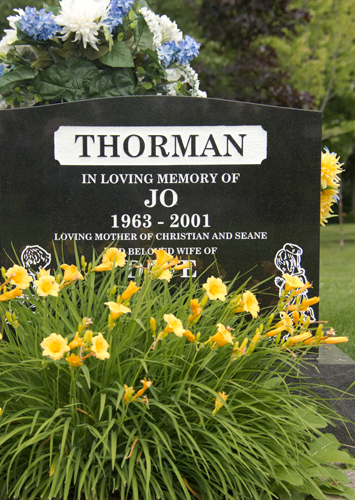
Jo’ died Saturday, June 30, 2001 at 9:30 am.
 My trip to Toronto this year was awkward. I’ve avoided heading up at this time of year, but I had forgotten why. And because of my busy schedule this spring, late June was my only option to go up and visit with Frank-and-Norma, Joe, Mary-Domenic-and-the-kids, Renato-and-Gina. But it wasn’t until I crossed I-80 that I realized why it felt so awkward. Fourteen years ago – Friday, June 29, 2001, I drove up and found my sister at the end of her life. By 9:30 the next morning she was dead. Dave was helping her out of bed and she died in his arms. (The grave marker doesn’t have the Saturday, June 30th date.)
My trip to Toronto this year was awkward. I’ve avoided heading up at this time of year, but I had forgotten why. And because of my busy schedule this spring, late June was my only option to go up and visit with Frank-and-Norma, Joe, Mary-Domenic-and-the-kids, Renato-and-Gina. But it wasn’t until I crossed I-80 that I realized why it felt so awkward. Fourteen years ago – Friday, June 29, 2001, I drove up and found my sister at the end of her life. By 9:30 the next morning she was dead. Dave was helping her out of bed and she died in his arms. (The grave marker doesn’t have the Saturday, June 30th date.)
So there I was driving up on June 29 just like I did fourteen years ago. And on the 30th, I visited the cemetery. The image on the left is from that visit. (I’ll have to tell my mother that I went up. I’ll make sure to explain that the time was a coincidence and not because it was the 14th anniversary of Jo’ death. I have to make that clear otherwise, she’ll think I planned it and I hadn’t.)
Fourteen years ago we all went to Mary-and-Domenic’s and Dave lit fireworks over the suburban houses. Mafalda, being the Calabrian that she’ll always be, was incensed – his wife, her daughter, had died the day before, and he was shooting off firecrackers. Needless to say the picnic was a very subdued affair. (I had driven back to Pittsburgh on the 30th to get my Armani and driven back to Toronto the next day. Remember, I left Toronto after the coroner had signed off on the death-notice and we had gotten the funeral arrangements set up so my mind wasn’t too balanced. I-80 was how I knew I was near home.)
Fourteen years later and both of the kids were absent from the Canada Day celebration. Dave is re-married and at the celebration, at his new house, no one mentioned the life-altering event that we all went through all those years ago. Everyone at the 2015 Canada Day picnic, except for Isabel and Clay, were present 14 years ago. (Why didn’t I make reference to Jo’s death? I probably couldn’t pull it off without tears.)
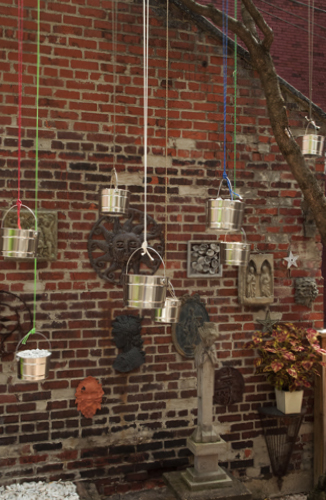
The images below are of paint-buckets hanging from the Japanese Lilac in the back-yard. And the lyrics are from Sondheim’s Into the Woods.
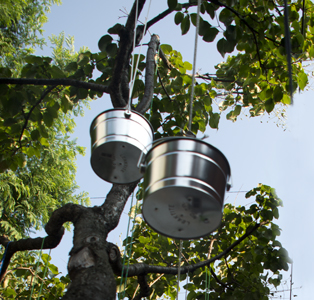 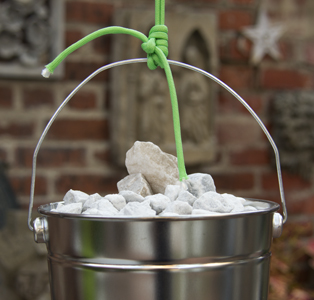 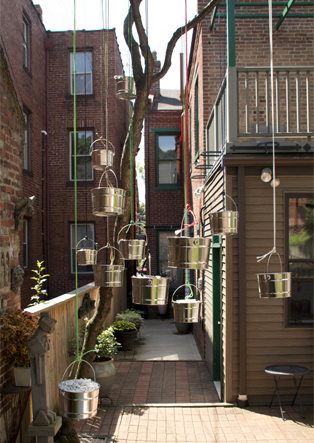 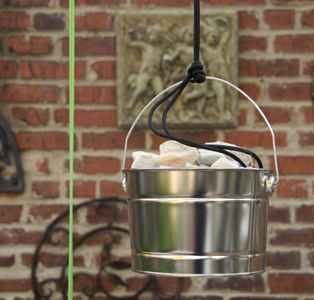 |
|
||||||||||||||||||||||||||||||||||||||||||||||||||||||||||||||||||||||||||
Sondheim’s Into the Woods Agony – Part 1
Sondheim’s Into the Woods Agony – Reprise
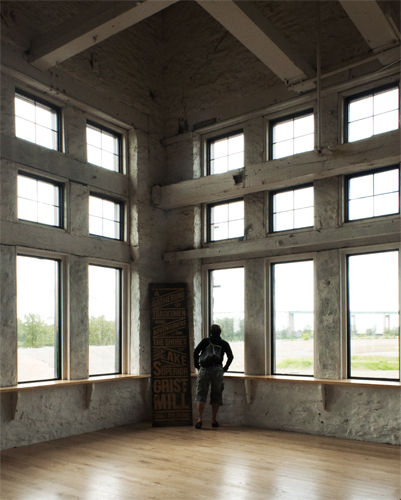
 When I lived in Sault Ste Marie, all those years ago, one the major industries was the paper-mill. And several of the new immigrants worked at the Abitibi. (This was the old name, before it was St. Mary’s Paper. The old name with all its vowels was way easier for the Italian immigrants to remember.) Michele Coccimiglio worked at the Abitibi and whenever we all went to Point des Chiens for Dominion Day, Michele would bring a roll of newsprint that was rolled on the many picnic tables that our families had commandeered. (Rose remembers cumma Maria – Michele’s wife boiling water for the pasta over an open-pit fire on the low bluffs above the cold waters of Lake Superior. The kids were all down on the beach pretending the water wasn’t miserably cold.)
When I lived in Sault Ste Marie, all those years ago, one the major industries was the paper-mill. And several of the new immigrants worked at the Abitibi. (This was the old name, before it was St. Mary’s Paper. The old name with all its vowels was way easier for the Italian immigrants to remember.) Michele Coccimiglio worked at the Abitibi and whenever we all went to Point des Chiens for Dominion Day, Michele would bring a roll of newsprint that was rolled on the many picnic tables that our families had commandeered. (Rose remembers cumma Maria – Michele’s wife boiling water for the pasta over an open-pit fire on the low bluffs above the cold waters of Lake Superior. The kids were all down on the beach pretending the water wasn’t miserably cold.)
The paper-mill went bankrupt a few years back, but the buildings are on the Historical Register and they are being gradually restored. The old admin building has been rented by Algoma University and is their music conservancy. (The University is expanding its campus into the downtown area. The old red-rock buildings will look great on their promotion materials.) The first of the mill buildings has been converted into an events space. The image is of this renovated space. Connie is on the small stage looking out onto the locks and the International Bridge.
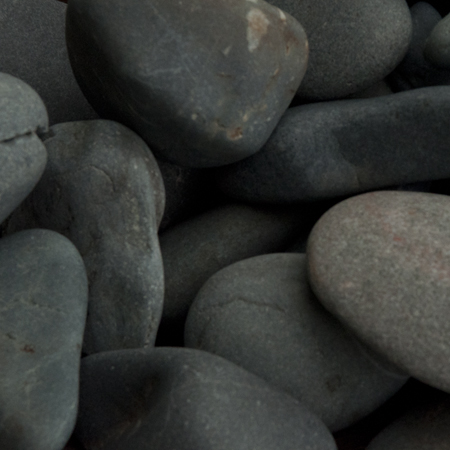
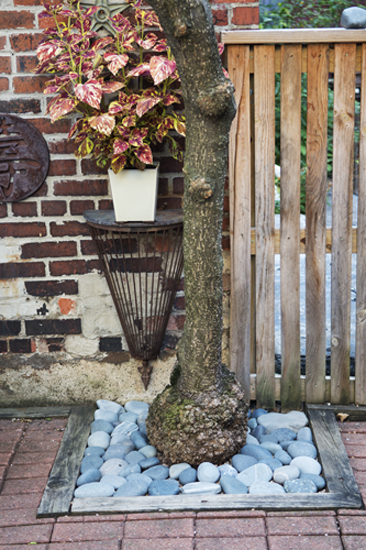 On Monday, Connie and I went up to the cottage, because I wanted to collect some rocks to bring home. Once I noticed the blue-stones, I decided that I wanted only them. At the water’s edge, being washed over by the waves, I found this beautiful, huge, flat stone (bet it must weigh hundreds of pounds) and if I had five or six people helping me, I would have dug it up and load it into my car. (I can picture it in my back-yard, a blue amoeba floating among the white marble-chips.) After a good hour and Connie going into the water to dig out some bigger rocks, we loaded all the blue-stones we had collected into boxes in the back of her SUV. When I got to my parents’ I asked my Dad if he had some old balsa-wood bushel-baskets I could take. He directed me to his greenhouse where I found hundreds of bushel-baskets. (My Dad is a pack-rat; you should see his tool-room in the back of the garage. Over the last couple of years, I’ve taken to borrowing things from this treasure stove. This visit, I borrowed two old extensions and a cutting-board.) I filled two bushels with the blue-rocks from Connie’s car.
On Monday, Connie and I went up to the cottage, because I wanted to collect some rocks to bring home. Once I noticed the blue-stones, I decided that I wanted only them. At the water’s edge, being washed over by the waves, I found this beautiful, huge, flat stone (bet it must weigh hundreds of pounds) and if I had five or six people helping me, I would have dug it up and load it into my car. (I can picture it in my back-yard, a blue amoeba floating among the white marble-chips.) After a good hour and Connie going into the water to dig out some bigger rocks, we loaded all the blue-stones we had collected into boxes in the back of her SUV. When I got to my parents’ I asked my Dad if he had some old balsa-wood bushel-baskets I could take. He directed me to his greenhouse where I found hundreds of bushel-baskets. (My Dad is a pack-rat; you should see his tool-room in the back of the garage. Over the last couple of years, I’ve taken to borrowing things from this treasure stove. This visit, I borrowed two old extensions and a cutting-board.) I filled two bushels with the blue-rocks from Connie’s car.
What is U.S. Customs going to say when they see two bushel-baskets full of rocks in the back of my car?
I needed to find out what kind of rocks we had collected and the search brought up basalt – images of basalt rocks. I then started to think about the Bluestones at Stonehenge. The giant stones outside of Salisbury are also a type of volcanic basalt. It’s amazing to think that the blue-stones on the shores of Lake Superior and the monoliths in southern England share a geological profile.
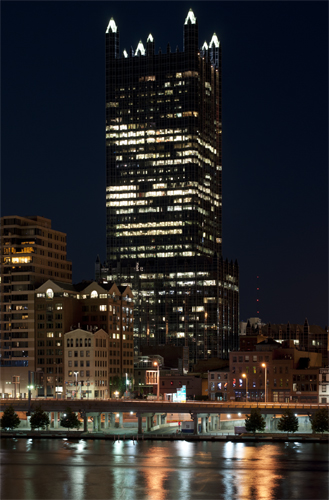
 I’ve been listening to Into the Woods for the last couple of weeks. (Ever since the buckets posting) The following is another of my favorite Sondheim creations. And the title is a line from this word-play.
I’ve been listening to Into the Woods for the last couple of weeks. (Ever since the buckets posting) The following is another of my favorite Sondheim creations. And the title is a line from this word-play.
Must it all be either less or more
Either plain or grand
Is it always “or”
Is it never “and”
This is my first effort at taking pictures at night. I’m on the South Side, at Station Square, and the image is of the main tower at PPG Place.
And up to now, I’ve relied on the built-in light-meter and my judgement to shoot, but with night photography, I have to deal much more with the technology of the camera. Last night, after getting the aperture and and shutter speed I wanted, I began to experiment with White Balance settings and discovered that it can add a sheen to the overall image. However, didn’t like what the various adjustments produced, so I’m gonna stay with an auto setting for the White Balance.
And until I have a better sense of how to set up a pic at night, I’m going to have to work from a set of steps that I write down.

 Don’t know where I’ll end up with this post, because I’m combining two unrelated things – lyrics from Giants In the Sky, and a night-shot of a church up on Mount Washington. I can talk about the imagery – the double-light at the far left, the gate, the dark is the woods, the lights a path in the night and the steeples at the far right, a false destination. And in between, the houses of those afraid of the dark and the Druid’s vicarage.
Don’t know where I’ll end up with this post, because I’m combining two unrelated things – lyrics from Giants In the Sky, and a night-shot of a church up on Mount Washington. I can talk about the imagery – the double-light at the far left, the gate, the dark is the woods, the lights a path in the night and the steeples at the far right, a false destination. And in between, the houses of those afraid of the dark and the Druid’s vicarage.
The above image is a sliver of the larger photograph, but I liked the light-necklace best, so I cropped more that 80% of the original.
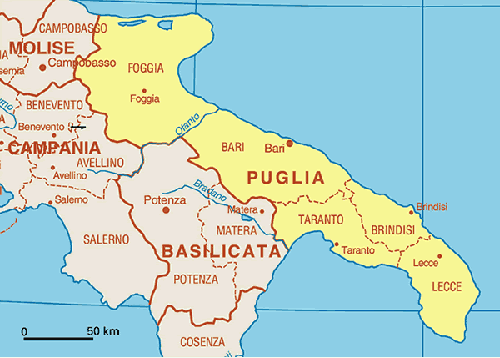
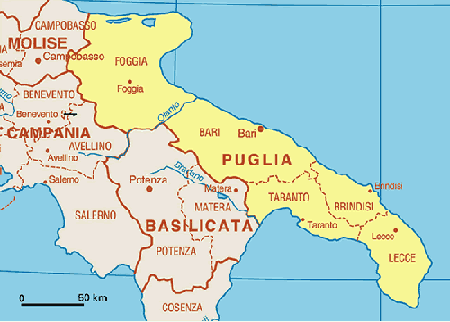 I started using prologues last year when I began writing about Sicily before we got there. In those and these prologues, I use images from online. In both instances, the prologues serve to set the scene. Reflecting on last year’s prologue posts, I’d have to say that we skipped many of the recommended sites that I wrote about. With that in mind, I am using these early posts as introductions.
I started using prologues last year when I began writing about Sicily before we got there. In those and these prologues, I use images from online. In both instances, the prologues serve to set the scene. Reflecting on last year’s prologue posts, I’d have to say that we skipped many of the recommended sites that I wrote about. With that in mind, I am using these early posts as introductions.
The word Apulia is a Roman corruption for the name of the two tribes of Lapigi people – Dauni and Messapi – who first lived in the region. (In ancient times only the northern part of the region was called Apulia; the southern peninsula was known as Calabria, a name now used to designate the southwestern tip of the Italian peninsula.)
In 14 days, I head up to Toronto to begin the 2015 trip to Italy. Like last year, I’m going in September, no more needing to travel in August when the tourists and the heat are at their worst. And this time, I’m flying out of Toronto. (We were able to get the best prices and the least connections. We fly Toronto/Rome, Rome/Bari. Martina Franca, where we’re staying, is an hour south-west of Bari.)
Puglia came on the radar, because of Earle-and-Suzanne the Australian couple we’ve stayed with the last three times we were in Le Marche. In 2013, they told us they were buying a rundown trulli in Puglia and renovating it so they could get away from the winters in Le Marche. And that the new house would be ready for rental the summer of 2015. Given that Rose, Derrick and I like their house in Isola di Fano, the thought of renting from them again in Puglia was an easy decision. However, this is old-house-renovation and I don’t care where you are, the time-frame is never what you think. By February, Suzanne told us the house in Puglia would not be ready to rent until the summer of 2016.
Rose got going and found us an amazing rental – Villa Faraone – near Martina Franca. The online images are great and the reviews, from people who have stayed there, are very positive. This is the first time we are staying at something so grand. We have been gravitating to the best in the low-price range. This bumps us into the next category – rentals with amenities.
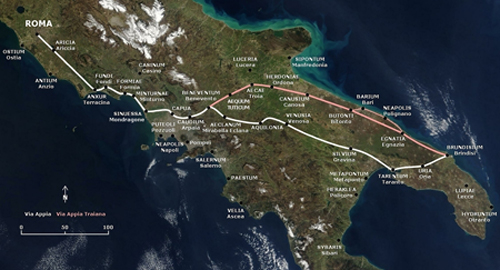
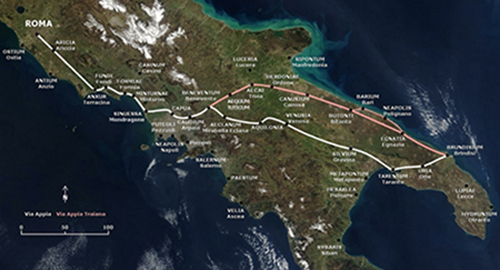 The Via Appia – Appian Way – was one of the earliest and strategically most important roads of the ancient republic. It connected Rome to Brindisi in southeast Italy. The road is named after Appius Claudius Caecus, the Roman censor who began and completed the first section. Its importance is indicated by its common name – regina longarum viarum – the queen of the long roads. The modern Via Appia Nuova – Strada Statale 7 (SS7) – follows the route of the ancient road.
The Via Appia – Appian Way – was one of the earliest and strategically most important roads of the ancient republic. It connected Rome to Brindisi in southeast Italy. The road is named after Appius Claudius Caecus, the Roman censor who began and completed the first section. Its importance is indicated by its common name – regina longarum viarum – the queen of the long roads. The modern Via Appia Nuova – Strada Statale 7 (SS7) – follows the route of the ancient road.
I find it interesting that in Le Marche, we drove the Via Flaminia all the time. And in Rome last year, I insisted we go to the Piazza del Popolo to where the Via Flaminia began. This year, it’s the Via Appia, the most famous and most known of the ancient roads, that we will be using. (It won’t be as ubiquitous and I’ll have to find a reason to get on the SS7. Maybe when we’re on our way to Matera.)
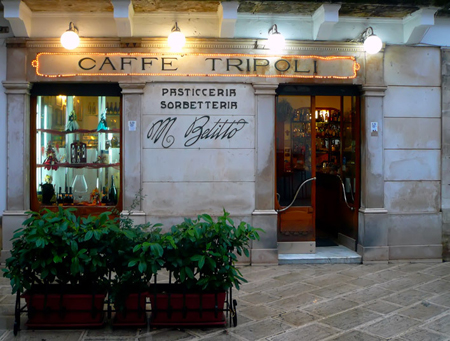
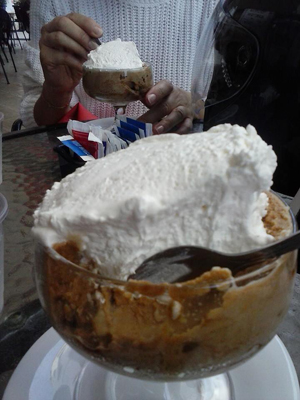 During junior year, I lived on granita di caffè, senza panna – coffee ice, no-whip – until my hands shook so badly and I had to cut back on the caffeine. I mention this, because the image on the left, from the FB page of Caffè Tripoli in Martina Franca, looks most like the granita I gorged on. But granita has gone up-scale and therefore is now served in small cordial glasses befitting the new glitterati traveling through Italy. (F that, I want a sundae-size glass of finely shaved, frozen coffee. Tell me that that doesn’t look like something worth getting the shakes for? Minus the whipped cream of course.) In college we were poor kids, and a big scoop of coffee ice was a cheap order that allowed us to sit and people-watch for hours. (We saved our money for Courvoisier.)
During junior year, I lived on granita di caffè, senza panna – coffee ice, no-whip – until my hands shook so badly and I had to cut back on the caffeine. I mention this, because the image on the left, from the FB page of Caffè Tripoli in Martina Franca, looks most like the granita I gorged on. But granita has gone up-scale and therefore is now served in small cordial glasses befitting the new glitterati traveling through Italy. (F that, I want a sundae-size glass of finely shaved, frozen coffee. Tell me that that doesn’t look like something worth getting the shakes for? Minus the whipped cream of course.) In college we were poor kids, and a big scoop of coffee ice was a cheap order that allowed us to sit and people-watch for hours. (We saved our money for Courvoisier.)
One of the hopes of this trip, is that we’ve finally found a place that has all the amenities – salt-pool, AC, remote location, but close enough to the centro storico to allow us to go out for a passeggiata, a gelato, a granita. (This means I’ll have to pack some decent, non-tourist clothes.)
As much as I liked Earle-and-Suzanne’s in Isola di Fano, going out after dinner was really not an option. The closest small town with somewhat of a night-life was Mondavio, but it was over the hills and through the woods on narrow roads with no street lights. But Puglia is flat and Martina Franca is a two minute car ride. I hope we can walk there, but that will depend on decent roads free of mad-driving Italians. (As I pack, the old bitch of a nun who told me that I was obviously Italian, but my clothes screamed tourist is still in my head.)
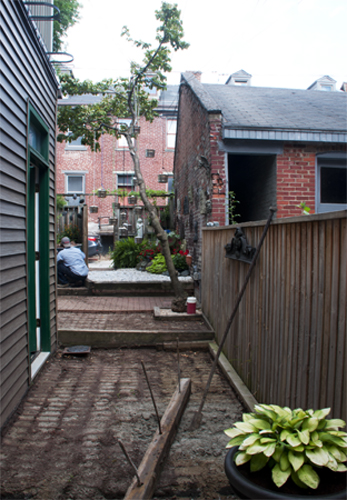
 The work on re-paving the backyard has begun. My neighbor from down the street is taking the old brick pavers. That means less stuff for the landfill and less time needed to complete the job. (They don’t have to haul the old brick away; one of the guys is stacking them in my neighbor’s garage.)
The work on re-paving the backyard has begun. My neighbor from down the street is taking the old brick pavers. That means less stuff for the landfill and less time needed to complete the job. (They don’t have to haul the old brick away; one of the guys is stacking them in my neighbor’s garage.)
The old brick has been there some 20 years. All the dry-mortar between the pavers has been gone for a while and I’ve had to lift, clean and re-set the bricks in order to remove the moss and the weeds that want to grow in the empty spaces where the dry-mortar was. The wolmanized walls between the main patio and the upper section of the yard were bowed at almost 70o. The retaining walls had a layer of brick between the two wolmanized 6X6’s. The bricks gave the walls a unique old look and act as drains for the upper levels. The walls just bowed. (I’m hoping that the new walls will stay perpendicular. After all the upper levels have had years to settle.)
Also, over the years I made some changes to the five platforms that make up the backyard. (There was a long flowerbed on the side and a wrought iron fence between our house and Joe-and-Rose’s. When the sewer needed fixing – the big dig – the whole side of the yard got rebuilt. The flower-bed and the fence went. Also new cement was poured cleaning up the whole side-yard.) The dig, the new fence and the new cement flooring radically changed the platforms closest to the back-door. And new wolmanized borders had to be added to perimeter the lower platforms and un-weathered pieces and miss-matched bricks got added to the mix. (I compensated by adding pots to corners with the most miss-matched elements.)
The new pavers and walls should bring back a more uniform look.
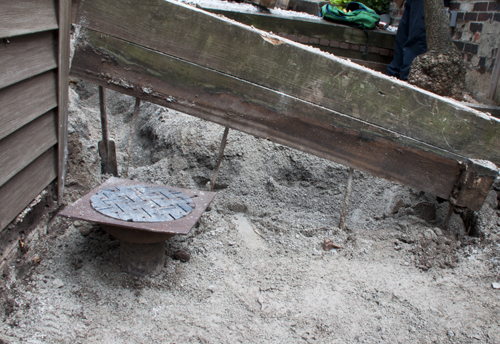
 I have no memory of the first time the backyard was paved and landscaped. It was done by a greenhouse-group from Blawnox. I had gotten to know the old man who ran the greenhouse; he was a great source of information. I had asked him about landscaping my backyard and he said his grandson ran that part of the operation. The grandson came down, gave me a bid and I gave him the work.
I have no memory of the first time the backyard was paved and landscaped. It was done by a greenhouse-group from Blawnox. I had gotten to know the old man who ran the greenhouse; he was a great source of information. I had asked him about landscaping my backyard and he said his grandson ran that part of the operation. The grandson came down, gave me a bid and I gave him the work.
Because I was working, I was not here to see them dig up the place and create the four platforms. What I remember most is my design of the curved upper platform and the left-over pavers. I had so many, that I decided to lay them down on top of the cement on the side of the house all the way down the alley to the gate. (There was almost an entire pallet of extra bricks.)
Watching the guys take everything up and getting the ground ready for a new foundation and new pavers makes me think back to when someone else did all this work to put the retaining walls, the cement-sand and the bricks in place.
The image is the retaining wall between the platform in front of the back-door and the large patio above it. All the wolmanized was anchored into the ground with seven-foot rebar. The drain cover was designed by the blacksmith at Gilgamesh Forge who also did the alley gates, and the flowerpot-holders on the outside of the deck. I love the text accompanying the images of the old and new drain covers. A previous client requested something interesting to replace a rusted drain lid in the courtyard of his Mexican War Street rowhouse. We went with a Celtic weave pattern, to create this interesting option for an otherwise ordinary utilitarian object. Lid is 12” in diameter.


The above image was taken at first-light. I’m shooting from the side of the house and got to include the kitchen windows. I so wanted to brush out the telephone box, but decided that I’m recording what is currently there and therefore the box had to stay.
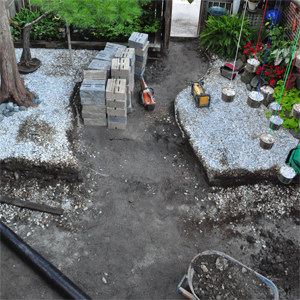
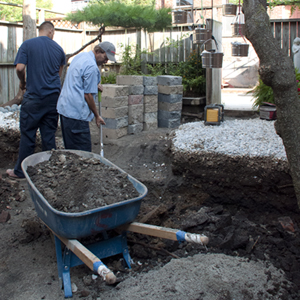 The pic on the left was taken around 9:30; the one on the right after the workers started. They are digging the trenches for the new retaining walls. The block is what they’ll use for the new walls. (The one surprise is how small the two sections with the white marble chips are.)
The pic on the left was taken around 9:30; the one on the right after the workers started. They are digging the trenches for the new retaining walls. The block is what they’ll use for the new walls. (The one surprise is how small the two sections with the white marble chips are.)
It’s a good crew, the guys are Puerto Rican. When I asked the older guy how he had ended up here, he said there was work and family here. We agreed the Latino community in Pittsburgh is small.
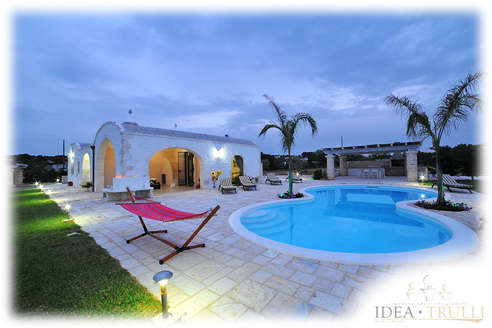
 The website that Carmello, the owner, uses only shows the house and the immediate grounds. But on google-maps you can see Villa Faraone and the land around it. Before finding it, I had no idea where and how the house was situated. And then taking it a step further, I got walking directions and followed them into town. Google-maps says that it’s a 30 minute walk, but I don’t have a good sense of distances in street-view. (It’s a 30 minute walk from my house to downtown Pittsburgh and I did that walk almost daily the last three years, so the walk to Martina Franca shouldn’t be impossible.) By car, it’s a 7 minute ride from the Villa to Piazza Maria Immacolata – the main square, but you cannot take a car into the centro storico. This means we are gonna have to find parking and then walk in. Street-view is clear that once you are in the old town, there are Medieval alleys instead of modern streets.
The website that Carmello, the owner, uses only shows the house and the immediate grounds. But on google-maps you can see Villa Faraone and the land around it. Before finding it, I had no idea where and how the house was situated. And then taking it a step further, I got walking directions and followed them into town. Google-maps says that it’s a 30 minute walk, but I don’t have a good sense of distances in street-view. (It’s a 30 minute walk from my house to downtown Pittsburgh and I did that walk almost daily the last three years, so the walk to Martina Franca shouldn’t be impossible.) By car, it’s a 7 minute ride from the Villa to Piazza Maria Immacolata – the main square, but you cannot take a car into the centro storico. This means we are gonna have to find parking and then walk in. Street-view is clear that once you are in the old town, there are Medieval alleys instead of modern streets.
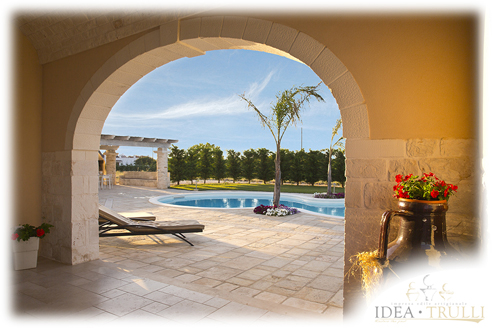
 Rose and I spend yesterday going through restaurants, vineyards and pilgrimage sites we want to visit. The most surprising were the restaurants and gelaterie. My comment was that Derrick will love all the meat dished, Rose will like the risottos and cheeses and I will love all the vegetables and cured meats. And in Ostuni, Rose found a famous artiginal gelato maker and never mind all the options for the famous Pugliese bread.
Rose and I spend yesterday going through restaurants, vineyards and pilgrimage sites we want to visit. The most surprising were the restaurants and gelaterie. My comment was that Derrick will love all the meat dished, Rose will like the risottos and cheeses and I will love all the vegetables and cured meats. And in Ostuni, Rose found a famous artiginal gelato maker and never mind all the options for the famous Pugliese bread.
I don’t remember having all these options when we were in Calabria. It could be that we were in Calabria early on and we didn’t know how to find things. But I’m beginning to think that tourism in Puglia is better organized than it is in Calabria. There certainly seems to be many more accommodations options than we ever found in Calabria. I probably need to decouple Puglia from the Mezzogiorno. I’m beginning to suspect that Basilicata and Calabria are on a similar tourist trajectory and that Puglia is much further ahead. There is a lot of online content for Puglia and there seems to also be a group that left, but has come back. There are several chefs that have gone back to Puglia after they made their reputations here in America.
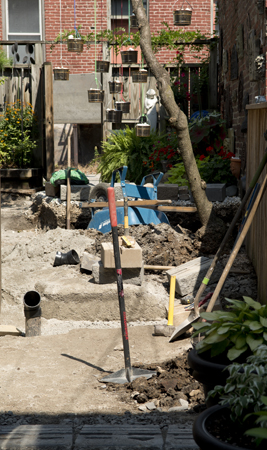

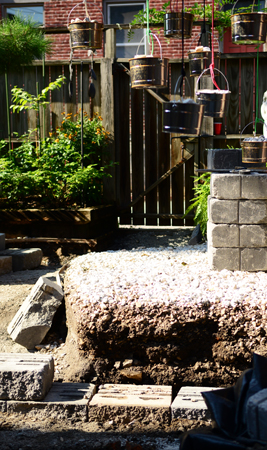 Tim has finished the base for the first retaining wall – foreground left image. He said that by the end of the day, he will have a second one done and half of the large wall that separates the patio from the upper section of the backyard.
Tim has finished the base for the first retaining wall – foreground left image. He said that by the end of the day, he will have a second one done and half of the large wall that separates the patio from the upper section of the backyard.
They actually did the three main retaining walls. The image on the right is the base of the longest wall. All that’s left is the small wall that is the step to the top platform.
The goal is to have the majority of the work done by Friday.
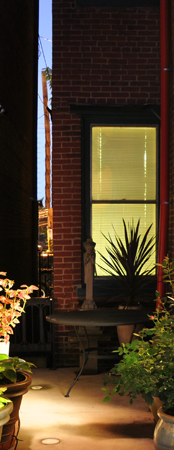
 My second night shoot was about keeping the shutter open when there is little to no light and the shutter indicator suggests bulb. The shot on the left is down the side-yard. All the items are here, because the rest of the back-yard is torn up and being repaved.
My second night shoot was about keeping the shutter open when there is little to no light and the shutter indicator suggests bulb. The shot on the left is down the side-yard. All the items are here, because the rest of the back-yard is torn up and being repaved.
I set up the tripod and did my calculations. The timer on this image was a minute-and-a-half. And the entire side-yard was practically pitch black. There are three light-sources – the kitchen light streaming through the windows; the office light seeping through the window in the center of the image and the night-sky peaking through the alley. The kitchen light is harsh in contrast with the dark also there are no shades on the kitchen windows. And even though they are stained glass, it’s not a colored glass. Because night-shoots in the bulb range and really a trial-and-error experience, I’m gonna shoot again tonight to see how I can minimize the kitchen light. I’m thinking of turning off the over-head and leaving only the light over the stove and the light in the alcove. Anyway, it’ll be a chance to experiment. (I also chucked my 60-Minutes stopwatch for the one on my phone. First of all, the one on the phone can be seen in the dark and the numbers are big.)
Tomorrow the dining-room/office is being replaced. The new window will not have a storm in front of it. I’m wondering what that will do to the light?
There are two aspects of the image on the left that I like: (a) the sliver of blue sky and (b) the soft light from the window. The blue sky between the two houses was a complete surprise. I could see blue above the street-light, but was surprised when I caught it in the image. The soft light is from the overhead light in my dining-room/office. It too was a surprise given how harsh the light from through the kitchen windows turned out to be.
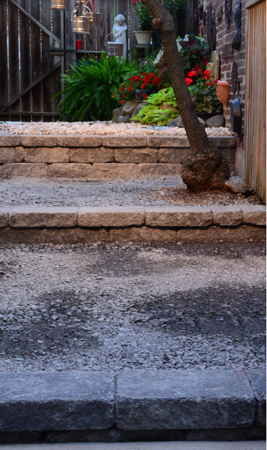

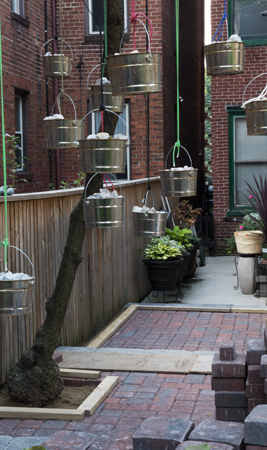
almost finished – repaving5
The slag has been laid and packed, the retaining walls have been built and leveled. Today comes the sand and the pavers.
The images were shot early in the morning. The one on the left has the soft glow of the outdoor flood lights. For the one on the left, I turned the lights off.
One of the renters on Sampsonia has been particularly difficult. He’s moved the orange cones forcing the guys to constantly move the truck; he’s complained about the dust; he’s complained about the noise. Who is this fool? If he wants no interaction with workers, if he wants to not be inconvenienced by the density of urban living he should move to the suburbs.
They are currently laying down the sand-base for the upper section. The goal is to finish tomorrow.
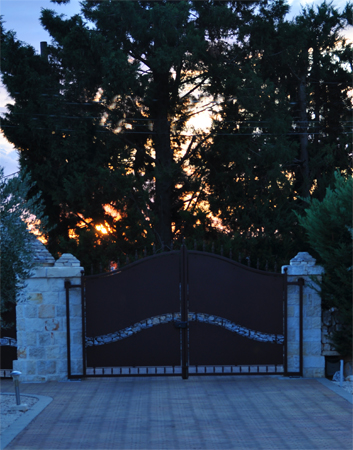
 We’re here in Martina Franca. And the image on the left is the sun through the pine-tree. (The property has the beautiful gate.)
We’re here in Martina Franca. And the image on the left is the sun through the pine-tree. (The property has the beautiful gate.)
It’s 6:00 in the morning and after about five hours of sleep, the bells from some monastery woke me. I’ll have to ask our contact where the place is. Or listen to see if I can figure out where the tolling is coming from. (It’ll take me a couple of days to get onto this time zone.)
South central Puglia is full of olive trees. And when I saw full it means as far as the eye can see. From the plane, the whole area surrounding the city of Bari was green with olive trees. And for the whole hour that it took to drive down to Martina Franca, all you saw were olive trees. The place is green, gone are the brown hills of Calabria. Also, the area has a well-kept, lived in feel to it.
We left Toronto at 10:30 Sunday night, and that got us into Bari late Monday afternoon. And after the drive down and meeting up with Carmello it was too late to eat in, so we asked for a recommendation and Carmello brought us to this very nice pizza restaurant. (I got Derrick to take a pic of my pizza – arugula and fresh mozzarella – and I’ll post as soon as I can get it.)

 “These were not stolen.” (Rose accused me of doing a Derrick, which means stealing figs from a tree close to the street.) I went walking Via Cupa, the street that the house is on, and saw this huge fig-tree. There was an older man in the driveway, so I asked if I could shoot the tree. I introduced myself and he asked what class I was. (BTW, his name was Mario.) Asking one’s class is asking how old you are. The class is the year your were born. I told him 49; he said his was 32. For an 83 year-old he looked damn good.
“These were not stolen.” (Rose accused me of doing a Derrick, which means stealing figs from a tree close to the street.) I went walking Via Cupa, the street that the house is on, and saw this huge fig-tree. There was an older man in the driveway, so I asked if I could shoot the tree. I introduced myself and he asked what class I was. (BTW, his name was Mario.) Asking one’s class is asking how old you are. The class is the year your were born. I told him 49; he said his was 32. For an 83 year-old he looked damn good.
He explained that the tree contained several varieties. They had let three trees grow and entwine together. The limbs where I was standing had the white figs. I picked six ripe ones and took them back for us to have with breakfast.
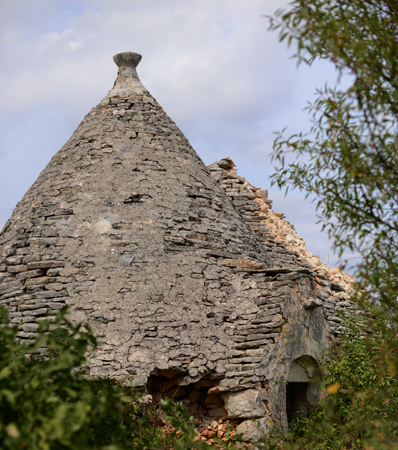
 The country roads in this lower part of Martina (The locals do not refer to their town as Martina Franca and looking at the Italian maps, the Franca part of the name is generally smaller and less emphasized.) are full of old and renovated trulli.
The country roads in this lower part of Martina (The locals do not refer to their town as Martina Franca and looking at the Italian maps, the Franca part of the name is generally smaller and less emphasized.) are full of old and renovated trulli.
We took a long walk down Via Cupa going away from Martina and found both renovated trulli and old, falling-down ones. The renovated trulli use a rounded stone-brick to cover the outside of cone.
The original trulli use a flat stone to cover the cone. The flat stone allowed for stacking without mortar. In the image on the left you can see the flat stones. And between the outside stones and the inside plaster, the old farmers filled the space with the small stones found in their fields. The small stones are exposed in the back cone where the exterior stones are missing.
I’m gonna start writing about the legacy that the peasants left in the Mezzogiorno. In Puglia, the trulli that now attract visitors from all over, were peasants houses. The stones that they removed from the field they used to build the walls that parameter the roads, the properties and the cones that topped their farm-houses. (Both the walls and the trulli use a dry stone construction.)
The cucina povera that is now the rage in all the healthy eating books, was developed out of necessity. When you had no money and the padrone owned the land you farmed, then developing inexpensive, but healthy nutritional option was a necessity. (Today, the first-world nations have freed up their population from the demands of foods production so that they can concentrate on the development of new products and technologies that will make life easier.)
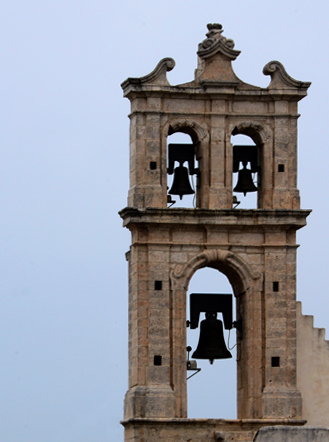
 This morning we went to the open-market in Martina Franca. It had a huge number of clothing vendors and in the back were the fruits and vegetables. (The images of the yellow grapes and the peaches in the slide-show are from the market.)
This morning we went to the open-market in Martina Franca. It had a huge number of clothing vendors and in the back were the fruits and vegetables. (The images of the yellow grapes and the peaches in the slide-show are from the market.)
In the afternoon, we drove to Ostuni. It’s considered one of the five white cities of Puglia. The designation comes from the fact that all the houses are painted white. This tradition is a leftover from the time of the plague, when the inhabitants noticed that there was less contagion in and around the white-houses. This most likely was because of the antibacterial effects of the calcium carbonate – the mixture of limestone dust and water that they used as paint. Today, the white-houses attract the tourists and the local government encourages everyone to repaint every two years by paying half the cost.
The bell-tower is one of the few structures to sit above the roof-line of the old town.
In all the years that we’ve been coming to Italy, this is the first time that we’ve had cold weather. Here we are in a renovated trulli with a pool and haven’t been able to use it yet. But starting Saturday, the weather is back to hot.

 One of the benefits of traveling with my cousin Rose is that she will steer us to the best places to eat and to the best food items to buy. And Puglia, more than anywhere else we’ve been, has a rich tradition of cucina povera – peasant cuisine, or the food that the poor grew, cooked and ate. And with our parents being poor southern Italians, this is the food we grew up eating.
One of the benefits of traveling with my cousin Rose is that she will steer us to the best places to eat and to the best food items to buy. And Puglia, more than anywhere else we’ve been, has a rich tradition of cucina povera – peasant cuisine, or the food that the poor grew, cooked and ate. And with our parents being poor southern Italians, this is the food we grew up eating.
We got here late Monday night and rather than try and cook, the rental agent suggested a pizzeria in town. I had the arugula and mozzarella (Derrick took the pic with his phone.), Rose had tuna and capers and Derrick had a capicola topped pie.
The next day we went walking and picked figs and blackberries as we walked the stone-walled lanes. Dinner last night was a fresh tomato sauce, seasoned with sweet Tropea onions, and fresh ricotta over a pasta. Today, we had lunch in Ostuni. Rose and I had the antipasti and Derrick had a pasta in a green pesto-like sauce made from nettles and served in a cup of bread. (Nettles is such a clear example of cucina povera. Imagine making a delicate sauce from a plant called a stinging-nettle and that most Americans would call a weed and kill on sight.)
The antipasti were different. There were two of each of the following:
– start-shaped asparagus mousse
– potato polpette
– fresh ricotta topped with caramelized onions
– stuffed eggplant
– a grain mixture colored black with squid-ink and topped with melted Gorganzola
– cod in a black squid-ink tempura batter
– sausage and mushrooms
– polenta cakes, and
– a bag of different cuts of bread.

 the trulli of alberobellopuglia 2015 – 6th entry
the trulli of alberobellopuglia 2015 – 6th entry
How can you pass up a title like that? The trulli of Alberobello are a UNESCO World Heritage Site. When we got to Alberobello – beautiful tree – I was expecting a small town with a lot of trulli scattered throughout. Instead, the old town is all trulli. In Italian, the old town is called la zona monumentale and all the housing in the area is trulli, hundreds and hundreds of trulli; their cone roofs filling the sky.
Alberobello is in the Valle d’Itria in south-central Puglia. The region is really a land depression, a giant sink-hole, not a true valley. The rock-table that the land sits on is full of caves and the stone is very porous factors that contributed to the depression as cave walls collapsed because of drainage. The stone that got exposed because of the land sinking is what the peasants used to built their homes – the trulli – and the stone walls the form the boundaries of their properties and the lanes we drive on.
I had seen pictures of Alberobello, but I had no idea the old town had such a dense collection of trulli. Seeing that many trulli, all clustered together, is what make Alberobello amazing. (These trulli all have their original stone cones. Many of the renovated trulli throughout the Valle d’Itria have replaced the ancient stones with modern stone-bricks that keep the look, but change the engineering of the original trulli. The old stone was long, wide and flat. These were stacked without mortar to form the cones.)

 matera in basilicatapuglia 2015 – 8th entry
matera in basilicatapuglia 2015 – 8th entry
Matera, in Basilicata, is another UNESCO Heritage Site famous for its sassi. The Sassi di Matera – the stones-dwellings of Matera – originated in prehistoric times. (The original dwellings were caves carved into the side of the mountain. Some are still visible on the opposite side of the valley.) And the caves are thought to be among the first human settlements on the peninsula.
The top of the mountain is a different story. Here the Church and the nobility appropriated the land. The area is littered with cathedrals, monasteries, convents and palaces. The old monstrosities have been converted into expensive hotels. (Many of the room are in caves; the exteriors are built outside the rock, but the interior spaces are carved into the mountainside. The daily rates, to sleep in a cave can hit over $400 a night.) The above image is of the restorers working on the cathedral at the top of the mountain.
Derrick’s reaction to dwellings on the side of the mountain was similar to Rick’s; both did not understand how people lived in vertical spaces. Having grown up in a vertical space, Aprigliano is built on the side of the mountain, the sassi felt familiar and I knew immediately how to navigate the steep stairs and alleys.
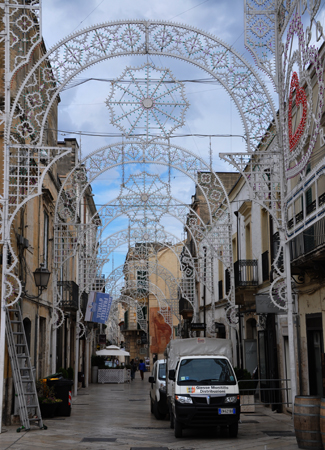
 From Matera in Basilicata, we drove back into Puglia and then to Altamura famous for its rustic, artigian bread.
From Matera in Basilicata, we drove back into Puglia and then to Altamura famous for its rustic, artigian bread.
The photograph on the left is of the main street. For more than three blocks, the street is lined with these luminaries. They will fill the night with their LED light.
A couple of things set me off.
-It was 1:00 and all the high-school kids were off and hanging out everywhere. And like high-school kids everywhere they were annoying and totally self-absorbed. The latest fashion craze among the young and stupid is m c hammer pants. There they were walking around in their isolated, selfie world with their balloon pants and looking like they hadn’t showered in days. The girls have adopted model poses and walk around as if on a cat-walk. (One set of girls were ecstatic, because I took a pic of the street and they were in it. OMG!)
-We saw two weddings. While eating lunch we saw all the wedding guests going back to their cars. All the men, young and old, were wearing suits that had skinny-pants and short jackets and sneakers. (Only the older men still had on dress-shoes.) And on our way back to the car, we walked by a bride-and-groom and their photographer/videographer. The bride was lying down on the cathedral steps, her white dress hiked up and looking at the photographer/videographer with this wanton look. Time Square whore or new bride? (I wanted to ask if I could take a pic, because nothing I can write will do justice to the image of the young woman on her back, on the church steps with her white dress hiked up to her knees and her legs crossed and her one leg dangling a white stiletto shoe.)
I am definitely old.

 This is the first day of full-sun and we headed out into the country to walk the stone-wall lined lanes. We are in the middle of an olive grove and I was determined to shoot the gnarly trunks, but in order to do that, I had to climb the wall and jump into the red fields. Derrick took the pic of me on the wall with the old trulli behind me.
This is the first day of full-sun and we headed out into the country to walk the stone-wall lined lanes. We are in the middle of an olive grove and I was determined to shoot the gnarly trunks, but in order to do that, I had to climb the wall and jump into the red fields. Derrick took the pic of me on the wall with the old trulli behind me.
What is different about Puglia is that we can walk. The area where we’re staying is the flat depression between the hill of Martina Franca and the hill of Locorotondo. And the depression runs some 30 kilometers north and west all the way to Alberobello. (The first pic in the slide-show is Locorotondo and the flats below it.)
And to take advantage of the sun, we decided to have lunch in and to go out for dinner giving us the afternoon at the pool. This is our first luxury rental and we’ve been waiting all week for the sun.
The evening passeggiata in Martina Franca is famous, so tonight we’re eating in the old centro and then joining the walkers as they stroll back-and-forth between the three piazzas – Piazza XX Settembre, Piazza Roma and Piazza Plebiscito – of the old town.
Every town and city in Italy has a Via XX Settembre or a Piazza XX Settembre. The date commemorates when the Italian unification forces entered and captured the city of Rome defeating the Papal army fighting against unification. The September 20 capture of Rome and the defeat if the Papacy meant the Papal States could be annexed into the new unified country.
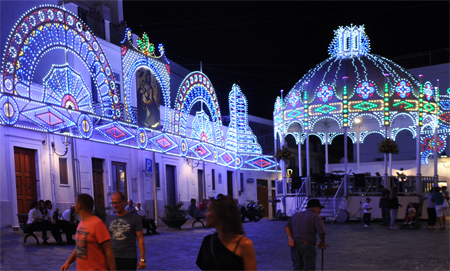
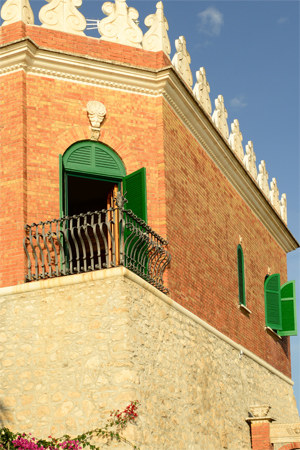 We drove two-and-a-half hours north to the Gargano, a peninsula jutting out into the Adriatic. It was the first time I saw mountains.
We drove two-and-a-half hours north to the Gargano, a peninsula jutting out into the Adriatic. It was the first time I saw mountains.
We rented at a B&B right on the ocean. The problem was the address. We’ve had the most problems getting people to give us house numbers for the places we’re going to. The B&B was no exception. We headed into town thinking that someone could help, but we quickly realized that the town and the resorts down on the water were not necessarily integrated. The best we got was directions down to the water and from there we stopped a couple of times until someone knew the B&B we were searching for.
Originally, the B&B was a defense tower along the Adriatic coast. The grandfather bought it and added a second floor. The stone is the original tower, the bricks are the addition. The shutters on the right are for the room I was in.
Rose and I were both worried about this booking, because it was made through an international group rather than directly with the owner. But when we got there all the worried went away. The second floor is all decorated with precious antiques, amazing.
The reason for the trip north was to go see the Santuario San Michele in Monte San Michele and Renzo Piano’s cathedral in San Giovanni Rotondo. (Renzo Piano designed the Pompidou Center and the new Whitney Museum.)
 We went back to Mattinata for dinner and found the place full of people. The passeggiata was in full swing. It was a three day festival for the Madonna – patron of Mattinata. The main street was decorated with the lumieri. The image on the left is a small portion of the light-decorations. (The image was taken the second night of the festival. But Sunday night, the square was packed.)
We went back to Mattinata for dinner and found the place full of people. The passeggiata was in full swing. It was a three day festival for the Madonna – patron of Mattinata. The main street was decorated with the lumieri. The image on the left is a small portion of the light-decorations. (The image was taken the second night of the festival. But Sunday night, the square was packed.)
I remember the light-decorations from when I was a kid. They were no where this elaborate, because they were still using good-old-fashion incandescent light-bulbs. Also, back then the light-decorations were limited, because Aprigliano doesn’t have the long streets that Mattinata has.
In each town we’ve visited, it’s clear that Puglia either didn’t suffer the drainage that Calabria did or it has recovered much quicker. The whole province looks prosperous; there is little evidence of abandoned towns and villages. In the Valle d’Itria there is a resurgence of locals renovating the trulli and an effort to build a tourist industry. And here in the Gargano, as evidence in the passeggiata, there are lots of young families with kids in tow.
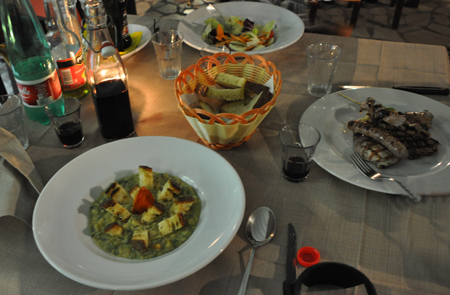
 Rose had found a restaurant in Mattinata that had gotten a lot of good online reviews and we headed for it. (The owner of the B&B had recommended a pizzeria that we passed on, because nothing on the menu looked interesting. That was his third recommendation and we took none of them.)
Rose had found a restaurant in Mattinata that had gotten a lot of good online reviews and we headed for it. (The owner of the B&B had recommended a pizzeria that we passed on, because nothing on the menu looked interesting. That was his third recommendation and we took none of them.)
Again, the menu at the restaurant was typical peasant food and it was delicious. The image on the left is a fava dish. The fave are mashed and mixed with cime di rape – rapini. It was one of the antipasti that Rose had the first night. I asked if I could have it as my main dish the next night and the waiter said yes. We had three main dishes, a half-liter of house wine and bottled water and we still only paid less than 25 euros.
The first night I had an eggplant casserole that was amazing. It was thinly sliced eggplant with layers of parmigiano cheese and tomato sauce in between. I’ve been able to eat vegetable dishes the whole time we’ve been here.
Internet services have been crazy the last two days. We’ve not been able to upload anything, so I’m doing a lot of catching up. The heat has returned and I’m writing, jumping into the pool, coming back to the laptop and going back out to the salt-water pool.
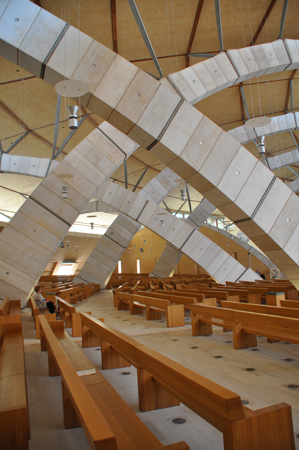
 The new basilica at the Padre Pio Santuario in San Giovanni Rotondo was designed by architect Renzo Piano. The image on the left is the inside of the cathedral. We went there specifically to see the new basilica.
The new basilica at the Padre Pio Santuario in San Giovanni Rotondo was designed by architect Renzo Piano. The image on the left is the inside of the cathedral. We went there specifically to see the new basilica.
I really liked the inside of the building and the outside courtyard. The outside of the building is less interesting and easily overlooked. One of the most interesting designs – all the secondary doors leading into the basilica work and look like garage doors. At street-floor, the building looks like a huge airplane hanger and the garage-door design works great with that motif.
But like all Catholic sites in Italy this too makes it clear why Martin Luther was able to start a revolution. On Sundays and other feast-days the place is full of Italians of a certain age, dropping coins into the hundreds of offering boxes scattered throughout the church and believing that they can negotiate with the Almighty through the intersession of the local saint. (There’s even a set of holy steps next to the old cathedral that people, of a certain age, climb on their knees looking to have their requests and demands considered by the recently canonized Padre Pio.)
Padre Pio was a favorite of the Polish Pope whom I call the Nazi Pope. The Nazi Pope liked Padre Pio as much as he liked Mother Teresa. And the three of them are infamous for their nasty attitudes. The day we were there, a large Polish tour-bus dumped its people into the church. They immediately went down to the crypt and formed a line to view the coffin of San Pio all the while taking selfies – their grinning faces in the foreground, the gold encrusted coffin in the background.
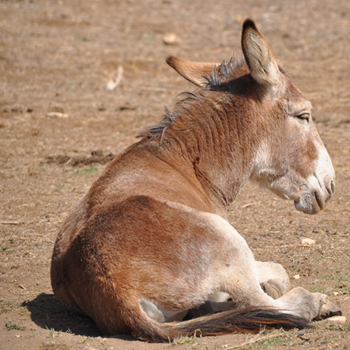
 On our way back south, we drove to see the famous Frederick II castle outside the city of Andria. And on the way we saw a drove of donkeys. Some were eating the thistles that littered the rock covered ground, others were lying in the sun.
On our way back south, we drove to see the famous Frederick II castle outside the city of Andria. And on the way we saw a drove of donkeys. Some were eating the thistles that littered the rock covered ground, others were lying in the sun.
Some random thoughts:
– Andria was a dirty, crammed town and there’s no way of avoiding it, because all roads go through it.
– The lunch we had in San Giovanni Rotondo was the worst ever. The trattoria obviously caters to the thousands that come to the sanctuary looking for favors with the Almighty.
– After the castle, we stopped in Trani for lunch and picked a fancy restaurant where we had one of the best meals. Trani was not very interesting. It’s claim to fame is the huge cathedral at the water’s edge.
– The GPS needs some help, or we need to figure out how to better read it. In the old towns, there are small roads that we often miss and therefore the machine is doing a lot of recalculating.
– There are no other American tourists anywhere in sight.
– Kids in Italy go to school 24 hours a week compared to American students who are in school 32 hours a week. All Italian students go home for lunch. Schools do not have cafeterias; they also don’t seem to have sports teams.

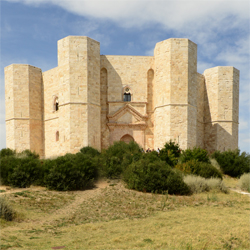
 Castel del Monte, Frederick-the-Second’s 13th-century citadel is 14 kilometers south of Andria. It stands on a promontory, on land inherited from his mother Constance of Sicily. It has neither a moat nor a drawbridge; it was probably built as a hunting lodge. It is considered one of the most fascinating castle built by Frederick II. The castle and surroundings are a UNESCO World Heritage Site. The castle appears on the Italian one-cent euro coin.
Castel del Monte, Frederick-the-Second’s 13th-century citadel is 14 kilometers south of Andria. It stands on a promontory, on land inherited from his mother Constance of Sicily. It has neither a moat nor a drawbridge; it was probably built as a hunting lodge. It is considered one of the most fascinating castle built by Frederick II. The castle and surroundings are a UNESCO World Heritage Site. The castle appears on the Italian one-cent euro coin.
The castle is an octagonal prism with an octagonal tower at each corner. The floors have eight rooms and an eight-sided courtyard occupies the castle’s center. In the image on the right, the three of us are in the courtyard.
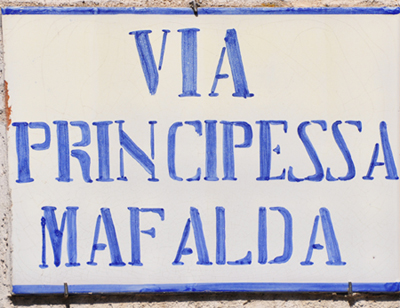
 Mafalda di Savoia was born in 1902. She was the second daughter of the Italian king Vittorio Emanuele III. (Rose likes to point out how similar our grandmother’s maiden name is to name of the King of Italy. Our grandmother’s maiden name was S A V A I A.) My grandparents, in 1927, named their second daughter Mafalda. At that time a very popular name. (All the Italians of my parents generation as well as those of my aunt-and-uncles age group, all know the name Mafalda.) But by the end of World War II, Italy was a different place; the monarchy was gone, Fascism had brought the country to its knees and the south was beginning to empty out. The next generation, whether they immigrated or stayed, forgot the name of the old king’s second daughter. I’ve never met anyone else with the name Mafalda. (I don’t remember where we were in Le Marche when someone called to a woman, my mother’s age, and called her Mafalda.)
Mafalda di Savoia was born in 1902. She was the second daughter of the Italian king Vittorio Emanuele III. (Rose likes to point out how similar our grandmother’s maiden name is to name of the King of Italy. Our grandmother’s maiden name was S A V A I A.) My grandparents, in 1927, named their second daughter Mafalda. At that time a very popular name. (All the Italians of my parents generation as well as those of my aunt-and-uncles age group, all know the name Mafalda.) But by the end of World War II, Italy was a different place; the monarchy was gone, Fascism had brought the country to its knees and the south was beginning to empty out. The next generation, whether they immigrated or stayed, forgot the name of the old king’s second daughter. I’ve never met anyone else with the name Mafalda. (I don’t remember where we were in Le Marche when someone called to a woman, my mother’s age, and called her Mafalda.)
The street sign is from the small town of Cisternino, one of the three white-cities here in central Puglia.
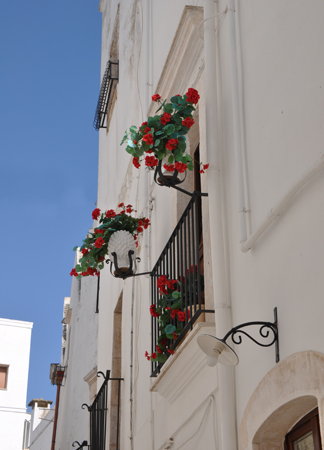
 Tuesday and Wednesday we had no upload capability and today for a short time the uploading problem happened again.
Tuesday and Wednesday we had no upload capability and today for a short time the uploading problem happened again.
This morning we went to the farmers-market in Locorotondo. (The image on the left is one of the white houses in the Medieval town.) The intent was to buy more of the red mushrooms – Lactarius deliciosus – know in our family as risiti. The link takes to the Wikipedia page for Lactarius deliciosus. The following is the entry from the page about wild-mushrooms in Calabria. Lactarius deliciosus – detto volgarmente “rosito” per il suo colore rosa-arancione, è uno dei funghi più noti e ricercati in Sila. (And in the dialect of the Apriglianese, the word became risiti.) Earlier in the week, I bought some risiti at the farmers-market in our area.
When our parents were still going wild-mushroom picking, the risiti were the prized ones, because they’re meaty and have a wonderful flavor. And my Dad would give me some cooked and seasoned in vacuum sealed jars.
When we got back, a great debate ensued about how to prepare the risiti. I suggested – frying them in a olive oil with some small tomatoes to add liquid. Rose and Derrick remembered my uncle preparing them without tomatoes, because they supposedly made their own sauce. I kept explaining that they were a meaty mushroom and released little to no water when fried. In the end we added the tomatoes. They were great over pasta.
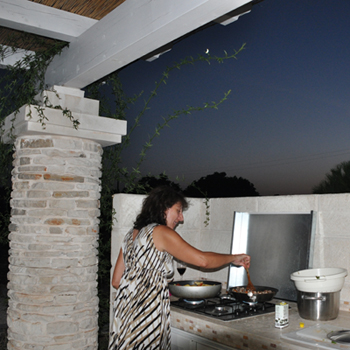
 Today’s farmers-market find was new potatoes. So for supper we had pipi e patate – fried red pepper and fried new potatoes. We also saw Borlotti beans and even though they were mature, we bought a kilo. So along with our pipi e patate, Rose also stewed the beans. This is the time of year for big, red peppers, new potatoes and mature beans.
Today’s farmers-market find was new potatoes. So for supper we had pipi e patate – fried red pepper and fried new potatoes. We also saw Borlotti beans and even though they were mature, we bought a kilo. So along with our pipi e patate, Rose also stewed the beans. This is the time of year for big, red peppers, new potatoes and mature beans.
In the image, Rose is cooking at the outside kitchen. One pan has the pipi e patate, the other the beans.
Growing up, pipi e patate were a staple. Often, the left-overs made it to my lunch. (Tonight we did not eat them with bread, but Rose and Derrick did sprinkle finely chopped Rosemary on theirs.) And as much as I like them, I’ve resorted to just frying the peppers; frying the potatoes takes too much work.
The mature Borlotti were really good. The beans were plump and very tasty. They’ll probably find their way to a pasta dish tomorrow night.
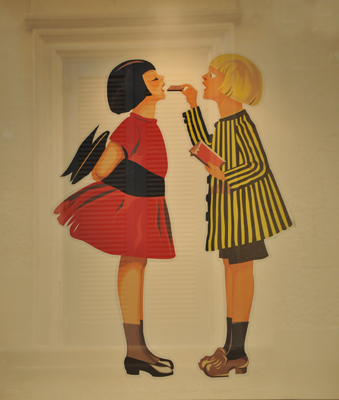
 We drove down to Lecce. It’s a city of contrasts – the old city is full of Baroque architecture, the new city is full of modern, well-designed buildings. Lecce is the largest city in the Salento Peninsula. The County of Lecce was one of the largest and most important fiefs in the Kingdom of Sicily from 1053 to 1463, when it was annexed directly to the crown. From the 15th century, Lecce was one of the most important cities of southern Italy, and, starting in 1630, it was enriched with precious Baroque monuments.
We drove down to Lecce. It’s a city of contrasts – the old city is full of Baroque architecture, the new city is full of modern, well-designed buildings. Lecce is the largest city in the Salento Peninsula. The County of Lecce was one of the largest and most important fiefs in the Kingdom of Sicily from 1053 to 1463, when it was annexed directly to the crown. From the 15th century, Lecce was one of the most important cities of southern Italy, and, starting in 1630, it was enriched with precious Baroque monuments.
The old city is exceptionally well maintained. Where the Baroque cities of the Valle de Noto were not well preserved, Baroque Lecce is being rehabbed and made even more splendid.
The old city is large and because southern Puglia is flat, the elevation that gave us perspective and direction in Sicily was missing in Lecce. This made the experience of exploring the old town more like a walk in a rabbits’ warren. And the add to our confusion and discomfort, the place was crawling with bus-loads of tourists.
We parked the car outside the old city and I got Derrick to program its location into the GPS so that we could find our way back. And it’s a good thing we did, because even following the GPS in walk-mode it took us a while to get out of the old Medieval town and back to the car.
The above image is an old ad for a chocolate store in the heart of the old town.
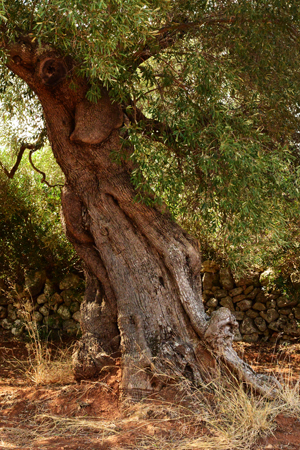
 This morning we drove south to Grottaglie. Online there is information about ceramics and murals. What the blogs don’t tell you is that the old town is a mess and the new town not very interesting.
This morning we drove south to Grottaglie. Online there is information about ceramics and murals. What the blogs don’t tell you is that the old town is a mess and the new town not very interesting.
The GPS took us over the mountain and down on the flats we saw the ancient olive trees. We stopped and went into a grove and shop for about a half-hour. The gnarled trunks seem to give personalities to the old, old trees. In the grove we were in, most of the trees were grafted. It seemed that two small trees had been grafted together to produce trunks a good six inches in diameter. Is that why the ancient trees are so gnarly? Are the ancients really a number of trunks intertwined?
One of the photo-essays will be on olive trees. (Tolkien had to be thinking of olive trees when he created the Ents. And Peter Jackson certainly made his Treebeard look like ancient olive trees.)
In the afternoon, we decided to walk the road on the other side of SS-172, going towards Locorotondo. On the horizon a dark thunderstorm covered the hilltop and Locorotondo’s white walls shimmered. We made it to a rise where I was able to shoot the city on the hill and then ran back to the car, determined to not get rained on.
The last image in the slide-show is from a convent garden we passed on our walk. They are red hot-peppers.

 a storm on the horizon – cucina povera-5puglia 2015 – 23rd entry
a storm on the horizon – cucina povera-5puglia 2015 – 23rd entry
One of the back-road to Locorotondo takes you through beautifully renovated trulli and red-brown fields. The GPS took us down this narrow, stonewall-lined road and I’ve been wanting to walk it ever since. Today, we risked a walk before the storm.
I’m on a small rise facing north and watching the storm come in. Immediately overhead, the skies were blue, but the wind was pushing it towards us. For a brief moment, Locorotondo shimmered against the angry blue-black sky. (Look how dark the left side of the image is. The storm was racing in our direction.) Behind the white shimmer, lightning was cutting the sky, but I couldn’t capture the red bleed.
For lunch, I had pane-e-caso – bread and cheese. And for dinner Rose made a wonderful stir-fried tomato sauce that she mixed the left over Borlotti beans and left-over orecchiette pasta.
Tomorrow is our last day.
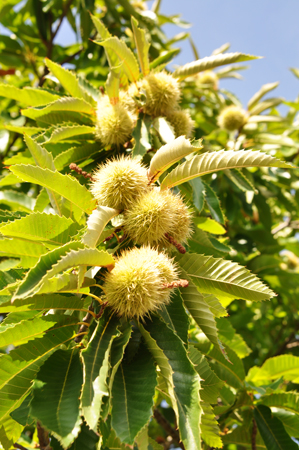
 Considering it’s our last day and it began with driving rain, we made good use of the rain-free afternoon.
Considering it’s our last day and it began with driving rain, we made good use of the rain-free afternoon.
We went to our favorite town – Locorotondo – for lunch. Rose finally had the fave e cicorie Derrick and I had cavatelli con ceci neri.
Fave e cicorie are described as: un piatto povero della tradizione pugliese, fatto con ingredienti semplici e genuini: fave secche in purè con cicorielle selvatiche. A peasant dish from Puglia made from simple home grown and field gathered ingredients: dry fave reconstituted and pureed and wild dandelions.
Cavatelli con ceci neri is cavatelli pasta in a black chickpea sauce. It too comes from the peasant tradition in Puglia.
We came back to the house and took a walk down the lane. The image of the chestnuts is from the walk. The rain, yesterday and today, dropped the temperature and the wind gave the air a chill. It’s the first day of fall and the wind reminded us of the change.
I’ve been reading the political commentators and they’ve been referring to the summer of 2015 as The Summer of Trump. Yesterday, CNN announced an 8% drop in Mr. Trump’s numbers. I guess even for the reality-TV star, the season has turned.
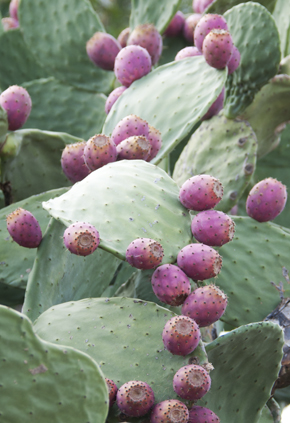
The title is the Calabrian dialect word for cactus-fruit. There are two colors for the fruit, yellow and the burgundy-red in the image on the left. I think the red ficunniane have a bit more taste.
 With this being more of an eating trip than a sight-seeing one, we picked and ate a lot of fruit as we walked the stonewalled narrow lanes. We picked and ate figs off the trees, we picked and ate blackberries off the brambles that covered the stone walls and Derrick decided to try his hand at the prickly cactus-fruit; the plants were everywhere and they were full of ripening ficunniane. Rose put up a fuss, because of the spine – the thin thorns – and I was determined to not get them on my hands. Derrick diligently used paper-towels to handle the fruit and then cleaned them in the sink. I went after him to clean the skins and made sure to reach into the sink with a thick wad of paper-towels and then dried my hands on the tea-towels. Well, I got the thorns on my fingers and I spent lots of time finding them and pulling them off with tweezers.
With this being more of an eating trip than a sight-seeing one, we picked and ate a lot of fruit as we walked the stonewalled narrow lanes. We picked and ate figs off the trees, we picked and ate blackberries off the brambles that covered the stone walls and Derrick decided to try his hand at the prickly cactus-fruit; the plants were everywhere and they were full of ripening ficunniane. Rose put up a fuss, because of the spine – the thin thorns – and I was determined to not get them on my hands. Derrick diligently used paper-towels to handle the fruit and then cleaned them in the sink. I went after him to clean the skins and made sure to reach into the sink with a thick wad of paper-towels and then dried my hands on the tea-towels. Well, I got the thorns on my fingers and I spent lots of time finding them and pulling them off with tweezers.
Ficunniane are a difficult fruit to pick and handle, because the outer shell is covered in both thin and thick thorns. The thick ones are obvious and easy to avoid; it’s the thin almost invisible ones that get stuck in fingers. (I’ve never been able to peel them without getting the almost invisible thorns stuck in my fingers and in my old age, I let my Dad peal them.) The fruit is also full of seeds and not everyone is willing to deal with the seeds or focus on the fleshy pulp.
Last year in Belmonte, the owner of the albergo diffuso had made a wonderful after-dinner liqueur from the yellow cactus-fruit.
Let me talk a bit more about the eating. Puglia is now famous among travelers for its cucina povera. (Many of its chefs have come to America and made a name for themselves and the foods they grew up eating.) As a matter of fact, Puglia cuisine is everywhere online and Rose was able to identify well-reviewed restaurants in each of the small town we visited. The most talked about dish in the cucina povera repertoire is fave e cicorie selvatiche – pureed fave with wild dandelions. One place we ate at, the owner made an effort to explain that fave e cicorie selvatiche are really a winter dish and that restaurants who serve it are doing nothing more than catering to the tourists. That made perfect sense; the dish is heavy and not something I associate with light summer fare. But we weren’t ever gonna get to Puglia in the winter, so we joined the throng of tourists and ate the pureed dish.
The best part of the cucina povera was that I could eat vegetarian the whole time we were there.
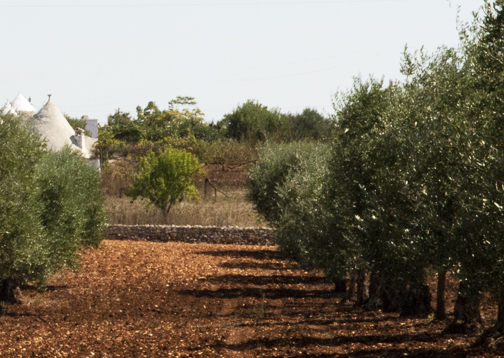
 Puglia is so unlike anywhere else I’ve been in Italy. In the past, as soon as I got off the plane, the environment and landscape seemed familiar; it felt like I belonged; there was a connection. All of that was missing in Puglia. I think a lot of it had to do with the fact that the region is flat, the soil fertile and green fills the landscape. In the flats between the rise of Martina Franca and the Adriatic, there are olive trees as far as the eye can see. And what’s not olive groves are either wheat fields or vineyards. (Mussolini wanted to make Italy self-sufficient and Puglia soon became the new bread-basket.) Because the wheat was all harvested, all we saw was the red-earth. In the vineyards, the grape plants are kept very short; the grape arbors were no more than a meter tall.
Puglia is so unlike anywhere else I’ve been in Italy. In the past, as soon as I got off the plane, the environment and landscape seemed familiar; it felt like I belonged; there was a connection. All of that was missing in Puglia. I think a lot of it had to do with the fact that the region is flat, the soil fertile and green fills the landscape. In the flats between the rise of Martina Franca and the Adriatic, there are olive trees as far as the eye can see. And what’s not olive groves are either wheat fields or vineyards. (Mussolini wanted to make Italy self-sufficient and Puglia soon became the new bread-basket.) Because the wheat was all harvested, all we saw was the red-earth. In the vineyards, the grape plants are kept very short; the grape arbors were no more than a meter tall.
And there was not a mountain to be seen, no brown, dry earth, no precipice to look over, to scare you. The vistas from Calabria’s hilltop towns, the cultivated rugged, mountainsides, the switchbacks leading to the villages don’t exist in Puglia. Even the small country churches that litter the Calabrian countryside are not there. (The small country churches of Calabria are full of amazing folk-art.)
There are no great museums or important churches with great works. The Valle d’Itria is interesting and the trulli are unique and fit into a landscape cleared of rocks. But beyond the Itria depression, Puglia is ordinary.
Immigrants from Puglia make up only 8% of Southern Italian in Canada; Calabrians make up 18%. There was less reason to leave Puglia. Several times throughout the two weeks, my cousin Rose said, “Imagine what our parents could have done if they had had fertile, flat land in Calabria?
I think Puglia, like Calabria, as a destination makes most sense if your family emigrated from there.
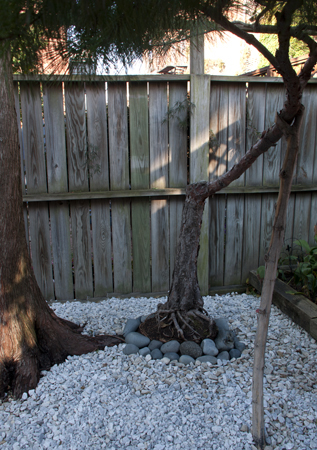
 It’s two-and-a-half weeks since I got back from Puglia and the rhythms of the new season are everywhere; the morning light is bright but diffused; the heat sporadic sometimes tee-shirt warm and sometimes sweat-shirt cold. Summer has slipped into memory.
It’s two-and-a-half weeks since I got back from Puglia and the rhythms of the new season are everywhere; the morning light is bright but diffused; the heat sporadic sometimes tee-shirt warm and sometimes sweat-shirt cold. Summer has slipped into memory.
Puglia, like Naples and Pellaro, is not a place I would go back to. The Valle d’Itria, with its other-worldly trulli, its white cities, its cucina povera, is too far off the beaten track and not interesting enough for a return trip.
The image on the left is the shift from Puglia-travel to being back home. The two trees were originally in plastic bonsai pots. I often kept the pots on the ground to prevent the soil from drying out. With these two pots, the plants started growing into the soil and I let them. I now have a 60 foot red-wood and an umbrella shaped long-needled pine. I removed the pot from the red-wood years ago – its footprint is like a giant’s 40 inch hand with fingers 6 to 8 inches in diameter. But I had kept the pot on the long-needled pine. I liked pointing out that the huge umbrella shaped pine had started in a bonsai pot, but the pot was no longer flat on the ground, rather it tilted with the lean of the umbrella branches. And for someone who likes symmetry, order and harmony the lean upset the feng shui of the garden.
The other day, I decided to cut the pot and surround the root-ball with the blue stones from Connie’s cottage. The stone necklace corrected the lean and cleaning the root-ball of its soil shows all its gnarly tentacles. The long-needled pine now looks to grow out of the white marble chips. The visual harmony has been restored
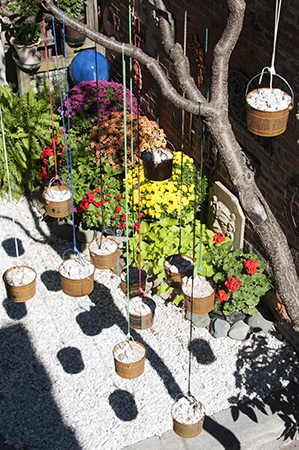
 The autumn sun moves so quickly. I shot the image from the upstairs deck and by the time I got downstairs, the area with the shadows was half what you see. I am trying to capture images that aren’t the typical fall items – turning trees and mounds of brown leaves.
The autumn sun moves so quickly. I shot the image from the upstairs deck and by the time I got downstairs, the area with the shadows was half what you see. I am trying to capture images that aren’t the typical fall items – turning trees and mounds of brown leaves.
Two Discoveries
1. Hearing the va’ pensiero chorus from Nabucco live and in context. It’s the lamentation of a people in exile.
o mia patria si bella e perduta
o membranza si cara e fatal
Verdi may have put the words of longing into the mouths of the Hebrews slaves, but every Italian knows them as the anthem of The Risorgimento – the struggle for unification and the fight for freedom from foreign rule.
2. Hearing a live recording of Simon and Garfunkel’s 1976 Carnegie Hall concert. It’s two voices and Simon’s guitar.
go home outsider
Mississippi’s gonna be your buryin’ place
A young Paul and Artie give a patina of innocence and naiveté to the words of revolution and introspection. And the lead into A Dangling Conversation sets up the recurring theme of isolation. Also, the album has a spontaneity and a bootleg quality to it.
Canadian Thanksgiving is being celebrated today, but this year like last, I didn’t go up. Rather, I’m heading up to Harrow in a week-and-a-half to play golf with the boys. Will grain and corn stalks still cover the concessions of Essex County or will the land have been stripped bare?


and they wither with the wind
and they crumble in your hand
hello, hello
good-bye, good-bye
The last growth spurt is producing some amazing colors. All summer long, I kept pinching the coleus to prevent it from getting long and leggy, but it was the October chill that forced it to fill out and bloom in rusts and yellows. (The plant in the foreground is the coleus.)
It’s been wonderful coming home to a new landscape in my backyard. The renovation was completed the day before I left for Puglia, so I never got to enjoy the new platforms, the short steps, the uniformity of the new pavers, the low stone walls that tier this small space.
I like doing second renovations, because I’ve lived in the space, I’ve lived with the limitations and now know what needs to change. In the first rev, you make the best decisions, but they are not based on experience with the environment, no, they’re based on abstract ideas. In the second iteration the ideas stay, but now there are materials and protocols that better match the abstract designs in my head. — the before and after —
In the new renovation, the emphasis was on digging deeper footers for the walls, creating a solid foundation for the pavers and sealing the the surface to minimize weeds. (The first renovation was done by a group of amateurs who put down a layer of sand to rest the bricks on and who drilled rebar into the wolmanized 6X6 ties to anchor them into the ground.)
How long before I have to say good-bye to all these rich early fall colors?
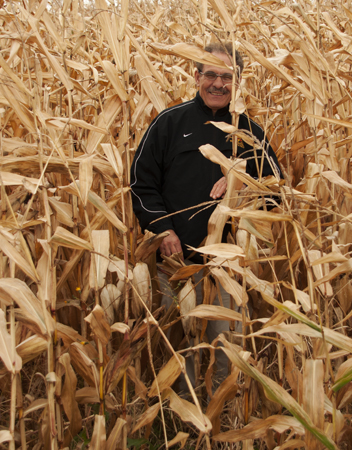
 On the drive to Harrow, I passed all these corn fields and I assumed the corn had been harvested and that what I was looking at were the dry stocks minus the ears of corn. Not true. According to Rainer, the corn is still on the stock drying. (The less water content in each kernel, the more valued the crop.) Weather permitting, farmers leave the corn on the stocks to dry as long as possible. This morning, Rainer called the farmer down the road to see if he was harvesting, because he wanted me to see the combine. The harvester is a gigantic machine. It cuts the corns stocks about six inches off the ground and then separates the corn from the stock.
On the drive to Harrow, I passed all these corn fields and I assumed the corn had been harvested and that what I was looking at were the dry stocks minus the ears of corn. Not true. According to Rainer, the corn is still on the stock drying. (The less water content in each kernel, the more valued the crop.) Weather permitting, farmers leave the corn on the stocks to dry as long as possible. This morning, Rainer called the farmer down the road to see if he was harvesting, because he wanted me to see the combine. The harvester is a gigantic machine. It cuts the corns stocks about six inches off the ground and then separates the corn from the stock.
Frank is in the middle of the dry corn stocks.
The other farm-thing we did was pick apples and eat them. Another of Rainer’s neighbors, grows a variety of apples and many were still on the dwarf trees. (The farmer explained how all his neighbors looked askance when he planted the dwarf trees.) What was surprising was how soft the apple skin was and easy to eat. Most times, I’m peeling the skin from store-bought apples. But when the apple is freshly picked, the skin is still full of juice. Also, the commercial apples at the grocery story are covered in wax to make them look shinny and appealing.
We spent Friday afternoon on an indoor court hitting tennis balls back and forth. I laughed when Ron and Frank had to wrap their knees in various contraptions and naturally I did a lot of trash talk. Here were the two premier athletes of the group having to don their bionic garments in order to hit some tennis balls. I continued the trash talking, because after the first 10 minutes I ended up playing against the two of them, because they needed breaks. Me, the one who had refused to play any organized sports, against the two who played organized baseball, basketball, hockey and tennis. During dinner, I asked after their various injuries and realized that young athletes come into old and middle age with a lot of aches and pains. Ron and Frank had suffered various injuries while playing sports when they were young and foolish. Their conclusion is that it had been worth it.

 There’s always a cat story when we visit Rainer and Lynn. This year, they had 4 kittens they were raising, because the mother, a week after giving birth, left and never came back. (Lynn suspects she was killed by the coyote or foxes that hunt the wild cats.) Lynn took over and the kittens are now eating solid food. They do not domesticate the cats on their property, but supplement their diets to make them healthier.
There’s always a cat story when we visit Rainer and Lynn. This year, they had 4 kittens they were raising, because the mother, a week after giving birth, left and never came back. (Lynn suspects she was killed by the coyote or foxes that hunt the wild cats.) Lynn took over and the kittens are now eating solid food. They do not domesticate the cats on their property, but supplement their diets to make them healthier.
The two in the image on the left are part of a trio – Ursula, Cruella and Maleficent. The missing kitten is shy and nowhere as rambunctious as her two other sisters. While I was shooting, the shy one watched from her bed-box. The litter had 4 kittens – the three females and an all white male. The kittens spend the day outside in and around the milk-shed, but are brought in for the night. Eventually, they will spend their whole time outside. There are also seven grown cats in addition to the kittens. Five of the seven are males and when the females come in heat in late February, one male will emerge as the alpha and he will drive out all the other male cats. Lynn said that over the years, they have lost many many cats. The pride can only have one alpha and all the other males are driven off. (Lynn said that she saw one of their males at a nearby farm. He had apparently become the alpha in the pride that lived there. But that was the only time she ever saw one of the male cats that had been driven off from their property.)
In the morning, I stepped out to shoot the rising sun and the grown cats swarmed around me. Rainer feeds them in the morning and me coming out the door signaled food. They followed me around, but soon figured I had no bowls and sat down and waited for the one who did.
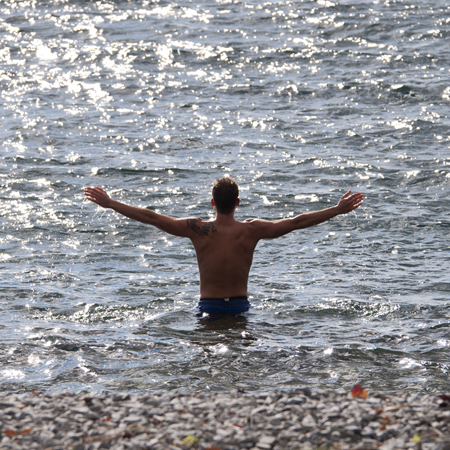
 I’m in Kingston, Ontario and Seane and I are walking the Queen’s campus. It’s a chilly November morning and even this far north, there are crazies who wade into the frigid waters.
I’m in Kingston, Ontario and Seane and I are walking the Queen’s campus. It’s a chilly November morning and even this far north, there are crazies who wade into the frigid waters.
I had never been this far east (Kingston is three hours east of Toronto.) and all the Canadian cities I’m familiar with are the industrial towns of southern and north-central Ontario – Toronto, Hamilton, Windsor, Sudbury, Espanola, Sault Ste Marie. Kingston was a great surprise. It is free of heavy industry – mills, mines – and full of British colonial homes and structures. Kingston was the capital of Upper Canada – the British colony in Canada. The city is at the end of Lake Ontario and at the mouth of the St. Lawrence. It has always been a militarily strategic port. It is home to the Royal Military College of Canada. Modern Kingston has maintained its colonial infrastructure. Many of the old houses have been renovated and re-purposed. And there are no smoke stacks or mine shafts belching into the clean air. (The first and third images in the slide-show are of Kingston.)
Queen’s University – named after Queen Victoria – is one of Canada’s premier schools. (Professor Emeritus Arthur McDonald was the co-winner of the 2015 Nobel Prize in physics.) The campus is beautiful and its old Victorian Romanesque buildings preserved and all still in use. (Some different names – the school’s head is called the principal and in Canada they do not use the terms freshman, sophomore … rather 1st years, 2nd years …)
Seane is living in an old turn of the century house. The houses in the old town remind me of the houses in England. They are very small. I couldn’t get over the fact that London was filled with these small houses. Outside the royal and government structures, the housing was low and narrow. And the old house in Kingston are low and narrow. (There are few tutor style houses, which became the rage throughout the industrial cities of Toronto, Hamilton and Windsor, instead the housing stock is older and much more classical in form.)
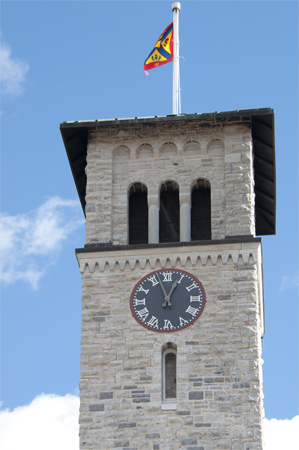
 School legend has it that a group of engineering students, probably drunk engineering students, decided to leave their mark by changing the face of the clock on Grant Hall. They redesigned the Roman numerals and changed the IV to IIII. (The legend is questionable given that it wasn’t unusual to represent the number 4 using the four IIII.)
School legend has it that a group of engineering students, probably drunk engineering students, decided to leave their mark by changing the face of the clock on Grant Hall. They redesigned the Roman numerals and changed the IV to IIII. (The legend is questionable given that it wasn’t unusual to represent the number 4 using the four IIII.)
The Victorian Romanesque style is everywhere on campus as well as in the large, rich houses in the old town.
The university is relatively small by modern standards – 25,000 students. Its campus is well defined and not at all cramped. In the last few years, new construction has been for dorms and other student amenities. Classrooms and research centers are housed in the old, retrofitted buildings. (The new library, keeps many of the Romanesque lines; they’re just in concrete rather than stone.)
When I was living in Canada, Queen’s was not a school anyone I knew, went to. All the kids from northern Ontario went south to the University of Toronto, the University of Windsor or the schools in the London, Kitchener, Guelph area. We gravitated to the urban centers and to the Math/Science schools. Also we were not drawn to anything that looked or smacked of Englishness. And Kingston has always had an air of Englishness about it. Also, the Kingston of the 1960’s was famous for it federal prisons more than it tony university.
The term English in the Canada of the 1960’s represented colonial privileged and colonial entitlement. It was the pejorative that we called the non-Italians. The next generation changed the slur to mangia-cake. A reference to the fact that these non-Italians seem to eat a lot of soft desserts; foods devoid of flavor, but loaded with sugar. The sub-text of the insult was that the diet made these non-Italians stupid. We were the generation that wanted nothing to do with Canada’s British legacy. Because, we were constantly reminded that we were not English, that we were less than. And proof of that diminished status was our olive skin.
In modern Canada, Italian immigrants and their Canadian born children have become mainstream and my niece, nephew and cousins look at Queen’s as a feather in their academic career cap. How things change. Seane was whining about her bland surname. “Why can’t my last name be Zinga? Seane Zinga would be such a cool name.” How things change. I bet her mother would be shocked to hear that in one generation, an Italian surname was more desirable than the English one she left her children.
I just liked seeing a Canadian city without steel mills and mines; a Canadian city that hadn’t bulldozed its old housing stock in favor of the ubiquitous suburban track-house. Mind you, there is plenty of suburban housing in norther Kingston. You know, the ugly garage-houses with their cookie-cutter sameness, their shoddy construction and million dollar price-tags.
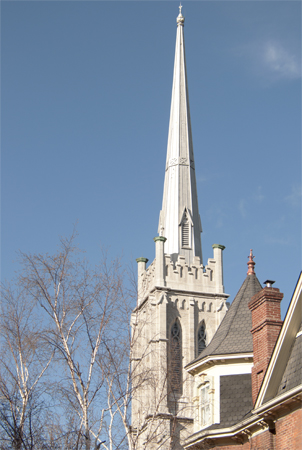
 Kingston is full of church steeples. But unlike New England, the ones here in the capital of Upper Canada are made of white limestone. (They have the look and feel of the colonial steeples of New England, but are much much taller. Guess you could do that when you’re not using lumber. Also this is not a heavily forested area.) Geologically, the Kingston area connects the Algonquin Dome in north-central Ontario with the Adirondack Dome in New York state. The Queen’s University buildings, The Royal Military College, the Martello Towers, the old mansions are all made from the limestone found in the area.
Kingston is full of church steeples. But unlike New England, the ones here in the capital of Upper Canada are made of white limestone. (They have the look and feel of the colonial steeples of New England, but are much much taller. Guess you could do that when you’re not using lumber. Also this is not a heavily forested area.) Geologically, the Kingston area connects the Algonquin Dome in north-central Ontario with the Adirondack Dome in New York state. The Queen’s University buildings, The Royal Military College, the Martello Towers, the old mansions are all made from the limestone found in the area.
Besides steeples, the area is full of commemorations to Sir John A. Macdonald a Scottish-born Canadian politician and the Father of Confederation. He was the first Prime Minister of Canada (1867–1873, 1878–1891). (Macdonald was the leading figure in the discussions and conferences which resulted in the British North America Act and the birth of Canada as a nation on July 1, 1867. A hundred years later, in Sault Ste Marie, the city build the centennial library to commemorate the founding of Canada.) Macdonald’s greatest achievements were building and guiding a successful national government, forging a strong Conservative Party, promoting protective tariffs and building the transcontinental Canadian Pacific Railway.
I promised Seane I would visit again, because I want to take the 1000 Islands boat tour and the old city bus tour. I know enough about the area and the city that the tours could be a way of stringing all the random information together.
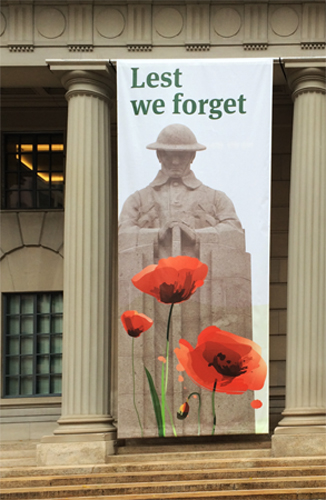

We are the Dead. Short days ago
We lived, felt dawn, saw sunset glow,
Loved and were loved, and now we lie
In Flanders fields.
I was having lunch with friends on Church Street and because I wasn’t familiar with the area, I decided to go early and walked the streets around Church-and-Bloor. The Manufactures Life Insurance Company (Manulife) had two banners – Lest We Forget, N’oublion pas – hanging from its colonnade and the lawn was filled with small Canadian flags. (One of the images in the slide-show is of the flags on the lawn.)
The motif is derived from the display – Blood Swept Lands And Seas Of Red – featuring 888,246 ceramic poppies, one flower for each British or Colonial soldiers killed during World War I. The poppies were planted on the lawns around the Tower of London. Armistice Day is a great celebration in Canada. (Evidence of both its British and European legacies.) Canadians everywhere wears poppy lapel-pins and there is a commemoration that all churches and governments participate in at 11:00. (As Seane and I were walking through the streets of old Kingston, I was looking for a poppy lapel-pin. Well, I found one to wear, but lost it taking my camera case off my shoulders.)
In America, World War I has lost its significance. (For years I tried to find a good, modern book about WWI that teenagers would like to read. No luck.) In Europe the Great War still looms large. In Italy, every village, town or city has a WWI memorial. Aprigliano has a WWI monument in its main piazza. (I shoot every memorial I see, because I want to do both a Photo Essay and a Gallery with the images.)
The above image and the flag image in the slide-show were taken with my iPhone. (It was raining when I got downtown and I wasn’t willing to walk around with my cameras.) I’m surprised by the quality of the images.
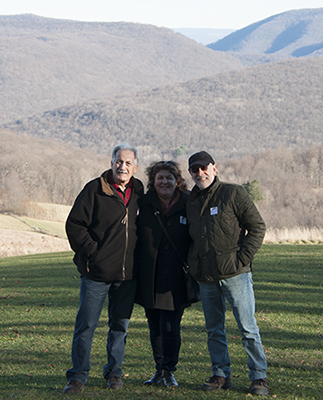
 Renato, Gina and I are on the summit at Kentuck Knob the other Frank Lloyd Wright house in south-western Pennsylvania. (We started off the day at Fallingwater.) My great-grandparents’ three oldest children were Salvatore, Francesco and Michele. Francesco was my grandfather and Michele was Renato’s father.
Renato, Gina and I are on the summit at Kentuck Knob the other Frank Lloyd Wright house in south-western Pennsylvania. (We started off the day at Fallingwater.) My great-grandparents’ three oldest children were Salvatore, Francesco and Michele. Francesco was my grandfather and Michele was Renato’s father.
Kentuck Knob is a one-story house on Chestnut Ridge, the western-most ridge of the Allegheny Mountains. The home is recessed into the southern side of the 2,050 foot peak. And the summit offers a sweeping view of the Youghiogheny River gorge.
Wright never set foot on the site before designing the house. He made a short visit during the construction phase and one of the local engineers pointed out that the cantilevered porch-roof did not have enough supports. Wright supposedly went back to Taliesin and had one of his minions make the necessary corrections. This would be one of the last homes Wright completed.
It’s always a great surprise to my Canadian relatives when I drive them into the mountains and we show up at places like Fallingwater and Kentuck Knob. There are no comparable houses in Canada.
Renato and Gina visited for four days and we spent Saturday in the Ohiopyle area. It was fun taking them around; I haven’t had visitors for a while and it was great to go back to Fallingwater and Kentuck Knob. (They texted once they crossed over into Canada and the subject was snow. Yuck!)
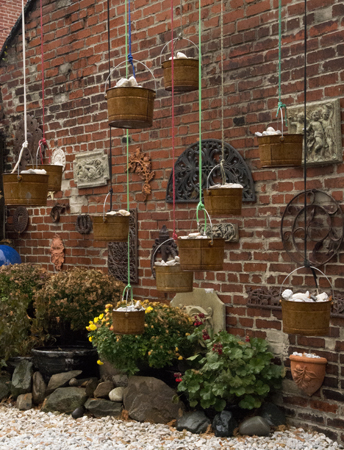
 Today is the first Sunday of Advent. In Western Christianity, Advent begins on the fourth Sunday prior to Christmas Day, or the Sunday which falls closest to November 30, and lasts through Christmas Eve.
Today is the first Sunday of Advent. In Western Christianity, Advent begins on the fourth Sunday prior to Christmas Day, or the Sunday which falls closest to November 30, and lasts through Christmas Eve.
For the posts in the Christmas 2015 category, I’m going to use the lyrics from the Va pensiero chorus from Nabucco and the biblical prophesies for titles and starting-off points.
Isaiah 7:14 – … behold a virgin will be with child and bear a son and she shall call his name Emanuel. I am far removed from all this mumbo-jumbo to actually look at it the same way I look at Greek mythology. Gone are the days of miracle and wonder. The bomb in the baby carriage is real and religion its detonator.
This new day started with Thanksgiving when I made the conscious decision to turn of the boob-tube. What I found was that without its incessant droning, without the broadcast sentimentality, without the push to eat, to shop, without the religiosity, without it being ON its mind-altering suggestions were silenced.
Forget Isaiah, Bradbury is the real prophet. Fahrenheit 451 – Give the people contests they win by remembering the words to more popular songs or the names of state capitals or how much corn Iowa grew last year. Cram them full of noncombustible data, chock them so damned full of facts they feel stuffed, but absolutely brilliant with information.


The title is a line from the chorus Va pensiero from Nabucco.
O membranza si cara e fatal!
It’s my opinion that in this context, the word precious is closest in meaning to the Italian cara. I kept fatal as an antidote to the residue of precious.
In memory, Christmas isn’t all that interesting. It took years to shuffle the various families into a routine. And the blending of Italian foods and Canadian dishes never really worked. We’ve settled on two separate menus with enough left-overs to refill the fridge.
Our current routine is to celebrate Christmas Eve at my aunt-and-uncle’s. This has only 8 people and many traditional Italian dishes. Christmas is at my parents’ and I do the Canadian dishes – turkey, stuffing, cranberry, gravy. My mother does the soup, the lasagna; my dad does the vegetable, the salad, the fruit and the chestnuts. This meal has anywhere between 17 and 20 people representing seven related families.
Gift exchange used to happen after midnight on the 24th, but since Jo’s passing it’s been moved to after dinner on the 25th. I’ve removed myself from the gift-giving and instead donate to the Canadian Cancer Society in the name of my niece-and-nephew, my aunt and my sister. (There are years when I have something worth giving. This year Connie is getting three interesting items, all re-gifts. I think she will like them.)
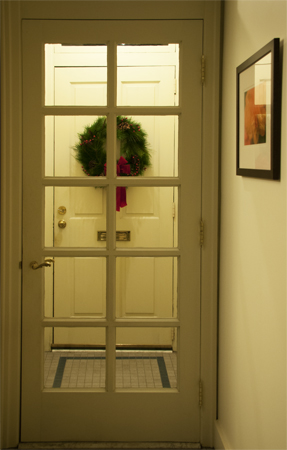
 It’s been a while since I decorated for Christmas and I’m going to use this as an opportunity to weed out ornaments and other chach. I have three huge boxes filled with nut-crackers that haven’t seen the light of days in years. I wonder how they’ve held up.
It’s been a while since I decorated for Christmas and I’m going to use this as an opportunity to weed out ornaments and other chach. I have three huge boxes filled with nut-crackers that haven’t seen the light of days in years. I wonder how they’ve held up.
The image on the left is of the vestibule. I always put the wreath on the inside of the door that way I get to see it. (Putting it on the outside means I only see it when I’m outside. Nah!) I have a second wreath on the kitchen door. It took a while to get the image; I had to take a bunch before I figured out what I wanted and once I decided I wanted the whole door and the whole vestibule, the blue frame in the floor-tile and no transom, then I had to move some things to minimize the number of lines. (I like having the hall-wall and the picture in the upper right, the frame outside the doors matches all the other rectangles in the two doors.)
It’s amazing to research wreaths and to find that they’ve been part of human symbology since the Ancients. Wreaths has been used at funerals since at least the time of Ancient Greece. Evergreen wreaths were laid at the burial place of early Christian virgin martyrs, the evergreen representing the victory of the eternal spirit over death. My first memory of a wreath was in 8th grade at St. Veronica’s. Each Monday in December, Sister Drusilla would march us out to the hall; we would line up on either side of the corridor and we would participate in the Advent ritual of lighting one of the purple candles on the wreath she had placed on a small table. This was followed by the song O Come, O Come Emmanuel.
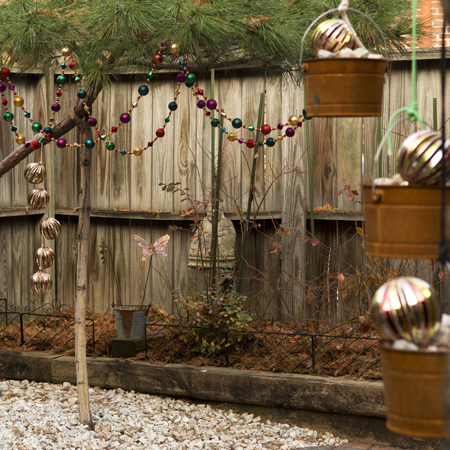
 I’ve always know the various terms associated with Christ and Christmas and that they were part of the prophetic literature of the Old Testament, but I’ve never actually read any of the prophesies in context. The branch reference is from the Book of Jeremiah 33:14-16 – … in those days and at that time, I will cause a righteous branch of David to spring forth and he shall execute justice and righteousness … Amazing how male everything is and how men have been able to maintain this patriarchy for over two thousand years. Let’s not forget that the virgin prophecy denies women their power of procreation reducing them to mere passive vessels.
I’ve always know the various terms associated with Christ and Christmas and that they were part of the prophetic literature of the Old Testament, but I’ve never actually read any of the prophesies in context. The branch reference is from the Book of Jeremiah 33:14-16 – … in those days and at that time, I will cause a righteous branch of David to spring forth and he shall execute justice and righteousness … Amazing how male everything is and how men have been able to maintain this patriarchy for over two thousand years. Let’s not forget that the virgin prophecy denies women their power of procreation reducing them to mere passive vessels.
Is the root of tension in the modern world really about the assault on male power and supremacy? In fifty years when historians look back at this time, is that what they are gonna identify as the basis for the mess, the march to war? Currently, the tension is discussed in terms of oil, guns and Christianity – all male symbols. Rarely does anyone point out that if the woman running for president of the most powerful modern empire wins, the patriarchy will be lost. Let’s not forget that paragon of maleness – Henry VIII – gave way to Elizabeth who ushered in a new world empire. Will a female American president usher in a new world order? What are all those male-centered theocracies and monarchies gonna do if the US president is a woman? Will they ban together and oppose her at every turn like the Congressional Republicans did against the first African-American president?
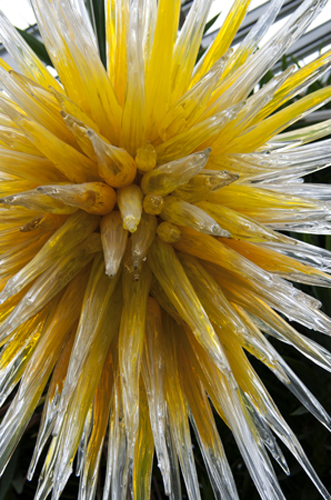
 In a small shop, in the Strip, I found an old glass ornament.
In a small shop, in the Strip, I found an old glass ornament. 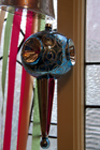 The shape is what I remember as the treetop ornament I always used when I was putting up the tree in my parents’ house. (The surprise was that something that once cost under a dollar ended up costing me $10.00.) I always rejected stars or angels for the top of the tree, that was for everyone else, but once Connie took over the decorating, a red garland star covered the top branch. It’s a convoluted memory, given that I no longer put up a tree. The last time I put up a tree was in the mid 70’s – almost 40 years ago.
The shape is what I remember as the treetop ornament I always used when I was putting up the tree in my parents’ house. (The surprise was that something that once cost under a dollar ended up costing me $10.00.) I always rejected stars or angels for the top of the tree, that was for everyone else, but once Connie took over the decorating, a red garland star covered the top branch. It’s a convoluted memory, given that I no longer put up a tree. The last time I put up a tree was in the mid 70’s – almost 40 years ago.
JOHAN GALTUNG: It’s an effort to try to externalize, to say that there are enemies abroad that are trying to get at us, instead of saying the obvious, namely that we have made a construction, and that construction is dying … If you try to dominate the world economically, militarily, politically and culturally at the same time, and then having these four support each other, it cannot last for a long time. And that’s the phase we are in now. Now, in that period, there will be fascist reactions. It’s not impossible that it could be a military coup in the US from the right, not impossible within this period.
The above is a excerpt from an interview on – Democracy Now.
Johan Galtung is a Norwegian sociologist, mathematician and the principal founder of the discipline of peace and conflict studies. He has spent the past half-century pursuing nonviolent conflict resolution in international relations. His latest book is called The Fall of the US Empire, in which he predicts the collapse of the American empire. However, the decline of the US empire does not imply a decline of the US republic, and the “relief from the burden of Empire control and maintenance…could lead to a blossoming of the US Republic”
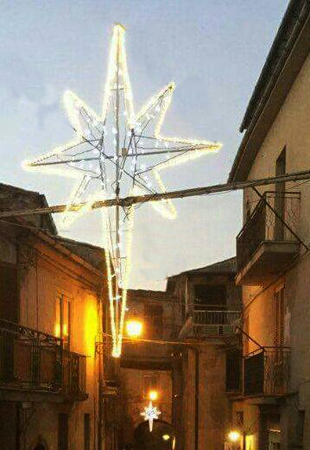
 The star prophecy is from the Book of Numbers 24:17 – I shall see him, but not now: I shall behold him, but not nigh: there shall come a Star out of Jacob, and a Sceptre shall rise out of Israel …
The star prophecy is from the Book of Numbers 24:17 – I shall see him, but not now: I shall behold him, but not nigh: there shall come a Star out of Jacob, and a Sceptre shall rise out of Israel …
The image on the left comes from one of the Apriglianesi that I keep in contact with. He posted it on his FB page. The festival street-lights are no longer restricted to the religious celebrations, in Aprigliano they were used only for the feast of La Madonna di Portosalvo, in mid-September. But as evidenced in the pic, they are now also used at Christmas time. The star in the image is in one of the vinelle – small medieval alleys – that crisscross the town. The abundance of modern Italy has replaced the lean times and the poverty that my parents grew up with. For them the shortages created by the War were the standard, not the incessant push to shop and buy and decorate that TV now proselytizes. (Why am I being such a curmudgeon? The street-light star shows that for those who stayed behind, for those who didn’t rush off in search of the gold-paved streets of America, life turned out OK. They have all the conveniences and the accouterments that their expatriate friends and relatives have in modern day Canada in consumerism America.)
When I was a kid, Christmas was about the bonfire at the church piazza and food and candy. The small tree my Dad cut was decorated with oranges, persimmons, tangerines and different brands of torrone. Most of these were gifts that friends and family brought when they came to visit the days before Christmas. And on the 25th I could eat all these seasonal and exotic things. The other Christmas tradition was a presepio, but we didn’t have one. Only the better-off families seemed to have the nativity figurines. I remember one of the kids down in Corte, her family had a presepio and she organized all the younger kids to go out and collect moss so she could create a landscape for the figurines.
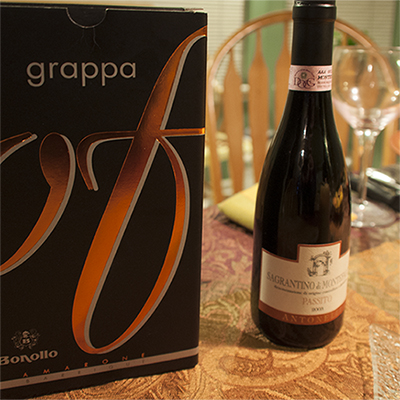
 The drive to Rose-and-Derrick’s was easy and with the sun. Also, Sundays mean no rush-hour traffic. And I’m getting more familiar with 696 East and Telegraph Road as and alternate to potholed I-75, cancer-alley and the heavy traffic through Detroit. Telegraph-Road/Michigan-24 parallels I-75, but it’s a much more pleasant drive. (I don’t know how to do this route going south. I’ll have to check with Derrick. I wonder if it’s the Square Lake exit on I-75 South?)
The drive to Rose-and-Derrick’s was easy and with the sun. Also, Sundays mean no rush-hour traffic. And I’m getting more familiar with 696 East and Telegraph Road as and alternate to potholed I-75, cancer-alley and the heavy traffic through Detroit. Telegraph-Road/Michigan-24 parallels I-75, but it’s a much more pleasant drive. (I don’t know how to do this route going south. I’ll have to check with Derrick. I wonder if it’s the Square Lake exit on I-75 South?)
After supper, Rose decided to pull out the Passito wine she bought when we were in Umbria, in 2005. We had gone out to eat at this very nice restaurant. The place was in a converted post-office a bit out of town. Spoleto was a great place and I’d go back.
Passito is made from dried grapes. The grapes are usually dried on straw mats or left on the vine until almost raisin-like. The drying concentrate the grape juices. The technique dates back to pre-Roman times. The resulting wine is sweet and similar in density to a Sauternes. Needless to say, we finished the small bottle. (It’s a 375 ML bottle.) It was a great way to begin the holiday season.
The grappa box in the image is from San Marino. We had gone there in 2005 and Rose-and-Derrick bought many items at the duty-free in the small principality.
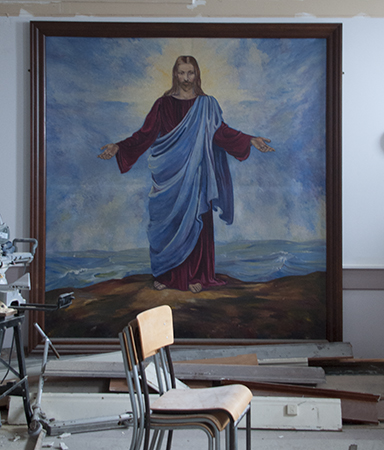
 I spent the morning with Domenic Belsito, known to everyone locally at Mo. (I cannot bring my self to calling him that, because it reminds me of one of the three stooges, but the nickname really comes from the Italian diminutive for Domenico – Mimmo.)
I spent the morning with Domenic Belsito, known to everyone locally at Mo. (I cannot bring my self to calling him that, because it reminds me of one of the three stooges, but the nickname really comes from the Italian diminutive for Domenico – Mimmo.)
His youngest son bought an old church in the west-end of town and is slowly renovating it into six apartments. The image on the left is on the basement wall. The painting is easily 7-feet X 10-feet. Kevin has had it appraised and it has a decent value, but the size makes it hard for anyone to buy it.
The renovation is creating some great spaces in the old church. Kevin and his family will live in one of the apartments during the winter months. They now have two small boys and need to be in town during the winter months. Their home on Trout Lake is beautiful, but the location makes it a difficult place to access during the winter months. We drove to their house on the Lake and the road was covered in ice and melting snow. And there are some difficult hills and curves on this private road. (The City Road to the lake is well maintained, but the road that leads to the cottages around the lake is the responsibility of the residents and that maintenance is inconsistent. Because not all cottage owners are year-round residents it’s been difficult to assess everyone equally and pay for the upkeep and snow removal.) The area is a micro-climate and even though the city was experiencing a very mild no-snow December, up at Trout Lake, the land was covered in snow.
The images I shot from the decks overlooking the lake were not crisp. The weather was so warm that the lake and its environs were shrouded in mist.
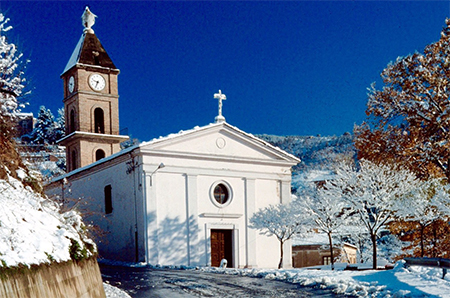
 Giovanni Covello, one of the Apriglianesi that I keep in contact with through FB, posted the image and the title – my beautiful hometown, thirty years ago.
Giovanni Covello, one of the Apriglianesi that I keep in contact with through FB, posted the image and the title – my beautiful hometown, thirty years ago.
It’s Aprigliano’s emblematic church – San Leonardo. Its campanile can be seen from anywhere in the valley and from any hilltop. It’s not my family’s church, rather it’s the church of the generation that didn’t leave Aprigliano and made a life for themselves in post-war Calabria. My cousins, the Femias, live very close to the church. Mario and Tonina raised their family in this new section of Aprigliano.
As much as the image has been doctored, it still suggests a snowfall that doesn’t stay long. You can almost see it melting. When we were kids, my mother and everyone else, would rush out and collect the freshly fallen snow in a bowl and add a vino cotto – a sweet wine made from the grape juice of the first press. The juice was heated in a large pot and reduced to a half or a third of the original volume and then fermented. My mother would drizzle the vino cotto onto the snow to make a sorbet-like treat – scirubetta. The Passito we had at Rose-and-Derrick’s reminded Rose and I of the scirubetta our parents used to make with the first winter snows, here in Northern Ontario. There’s a great YouTube video of an old Italian making – scirubetta. He adds fig-honey to the snow. Fig-honey was not something anyone in my family made; they made the scirubetta with the sweet dark red-wine.
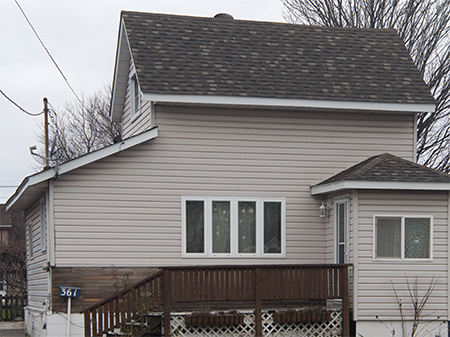
 The image on the right is of the house that the Ingribelli family lived in when I was living here in the far north. The family that I knew is all gone. Frank, who was my age, died of an aneurysm when he was in his early twenties. Dave the youngest died of cancer last year. I vaguely remember the dad; he died before I left. The mom was a big woman, but her life was never the same after Frank passed away. The Ingribelli were related to us through my grandmother and I remember visiting in this house. (The house has since been renovated, but my mom had no problem identifying it. I was walking the neighborhood and when I saw the house, I shot it.)
The image on the right is of the house that the Ingribelli family lived in when I was living here in the far north. The family that I knew is all gone. Frank, who was my age, died of an aneurysm when he was in his early twenties. Dave the youngest died of cancer last year. I vaguely remember the dad; he died before I left. The mom was a big woman, but her life was never the same after Frank passed away. The Ingribelli were related to us through my grandmother and I remember visiting in this house. (The house has since been renovated, but my mom had no problem identifying it. I was walking the neighborhood and when I saw the house, I shot it.)
Prepping for dinner and the incessant Christmas phone calls made the morning a whirlwind. At 7:00 am, my dad got a call from his cousin in Pietrafitta. (Pietrafitta is the next town over from Aprigliano.) This made his day. My paternal grandmother and his cousin’s mother were sisters. The two of them are probably the only remaining Capisciolti from that generation. (Capisciolti was my grandmother’s family name.) From there we moved to my father’s obsession about getting the tables brought in from the garage. Knowing how he can get OCD squared during the prep for Christmas dinner, I let him know last night, that Derrick and I would take care of the tables. Forget that, by 9:00am he was in the garage and had taken down the long table and carried it to the side-door. (This is a 90-year-old, riddled with arthritis, hard-headed Calabrese.) It was only my insistence that he stop with the craziness that got any slow-down. Derrick and I had the table down by 10:30 and it sat there until 2:30 when I set it for dinner.
My mother’s version of Christmas anxiety is to tell me to call all her friends’ children. Her friends and their children are people that I rarely see, but that didn’t seem to deter her. I should call all her friends’ children and wish them Merry Christmas. I didn’t. In addition to this hyper sentimentality, let’s not forget her incessant suggestions of things I need or should eat. (The pushing of food lives side-by-side with us teasing Dave to no end, because he has gained weight.)
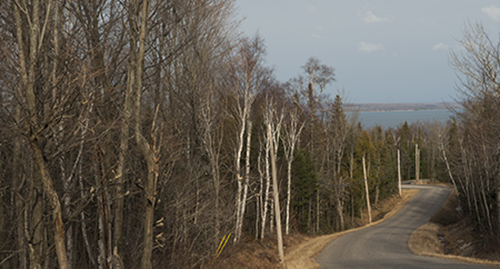
 It’s Boxing Day. The term comes from an old British custom. Since servants and tradespeople had to wait on their masters on Christmas Day, the servants were given the next day off to visit family and celebrate the season. The masters/employers would give each servant a box to take home containing gifts, bonuses and sometimes leftover food. And here we are today, celebrating the legacy of reward and recycling; the legacy of Downton Abbey. Aren’t them Brits the best?
It’s Boxing Day. The term comes from an old British custom. Since servants and tradespeople had to wait on their masters on Christmas Day, the servants were given the next day off to visit family and celebrate the season. The masters/employers would give each servant a box to take home containing gifts, bonuses and sometimes leftover food. And here we are today, celebrating the legacy of reward and recycling; the legacy of Downton Abbey. Aren’t them Brits the best?
I drove out to Connie’s cottage, because I wanted to collect more blue-rocks to put around the base of the Scotch Pine in my back-yard.
The Red Rock area is very close to town and access is straight down Maki Road. Seven kilometers in and the view from this small rise is spectacular. It’s the last elevation before the flats and the lakeshore road with the cottages. It was a spring-like morning and I stopped the car and shot the scene. It’s Lake Superior at the end of the road. On the horizon is Ile Parisienne an island in the south-eastern channel of the biggest and deepest of the Great Lakes. The Ojibwe/Chippewa call the lake gichi-gami meaning great sea. And Henry Wadsworth Longfellow wrote the name as Gitche Gumee in The Song of Hiawatha. (The poem is American Romantic literature, not Native oral tradition.)
Connie, Rose, Derrick and I came back to my parents’ for a lunch of left-overs and newly fried shrimp. We were able to convince Mr. Zinga to postpone cooking the shrimp until today. And even then, he had them breaded and fried by 7:00 this morning. (My mother is convinced that my dad believes all food should be served cold.)


For the first time in ages, there is no snow here in Northern Ontario. And in the last week, the sun broke through the cloud-cover for about half-hour this morning. It has been a week of gray days. The above image is of the Haviland Bay area just north of Connie’s cottage at Red Rock.
I like shooting the misty gloom, it reminds me of the long trudge that was winter when I lived here. So, it was a surprise when Mo reminded me that life is different at this latitude. Winter-gray means warm weather and snow is part of live so you need to lose your fear and trepidation of the white stuff and of snow-covered roads. The road around Trout Lake was covered in snow-and-ice and he just drove. I was ready to turn around as soon as I saw the first hill and the first 900 turn. He continued as if we were driving on pavement. He also described driving in the tracks of a transport as a strategy for highway-driving in bad weather. I want nothing to do with winter and the accommodations the cold and snow demand. The older I get, the more I dislike winter.
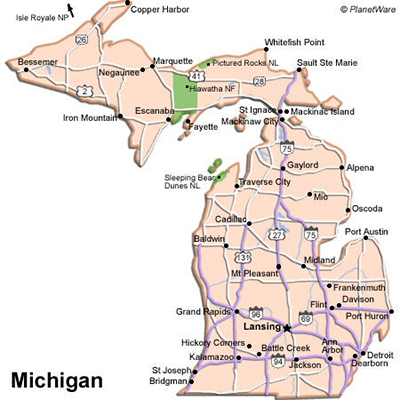

Section One – 52 miles
Sault Ste Marie to St. Ignace
Crossing back into the US is always a struggle, not as bad as the Peace Bridge in Buffalo or the Ambassador Bridge in Detroit. But the International Bridge on the American side has no NEXUS lane and a weird plaza design.
Section Two – 66 miles
St Ignace to Gaylord
This includes crossing the Mighty Mackinac. The Bridge is beautiful, however the railings are very low and it’s easy to feel like you’re floating above the Straits. I have to keep my eyes straight ahead, because looking around me is terrifying. And to make the crossing even harder, the inside lane is a grate and driving on it is even more disconcerting than the outside lane with its almost absent railing.
Section Three – 28 miles
Gaylord to Grayling
This is a winter nightmare and a micro-climate. The weather in this section can close I-75. There have been years where I waited at Rose-and-Derrick’s for the snowfall and forecast to shift up here in the snow-belt before I headed up I-75.
Section Four – 42 miles
Grayling to West Branch
I stop at West Branch and gas up. In the spring and summer, I even stop and shop at the Eddie Bauer outlet.
Section Five – 65 miles
West Branch to Saginaw
The is the last section of I-75 with two lanes. And as I get closer to Saginaw, the rural, farmland begins to shift to light industry and shopping centers.
Section Six – 39 miles
Saginaw to Flint
This is the northern boundary of greater Detroit. The highway is now 10 lanes wide mainly because of the huge outlet mall – Birch Run. And I-475 is the beginning of the eastern direction of the trip.
Section Seven – 21 miles
Flint to Lapeer
Where I-475 goes through crumbling Flint, I-69 to Lapeer goes through suburban sprawl. The farmland has been converted to track-housing and strip malls.

 Dom and I went walking a couple days ago and we got on the topic of expats. He’s always been disappointed that he hasn’t found a way to interact with the town where he was born. (The five of us visit family and that is our interaction with Sault Ste Marie.) This led me to make the statement that Sault Ste Marie and the state of Michigan share many similarities. Both are places that people leave and come back only to visit parents. None of my friends from high-school live in Sault Ste Marie; they have all left and now make their homes in southern Ontario; one has found his way to western Mexico. The city has lost close to 30,000 people since the mid-seventies. Also, I know several people who grew up in Michigan, but now live elsewhere and have never considered going back to The Wolverine State. Both groups of expats have some very successful people in them. The Sault Ste Marie expats include teachers, mid-level managers, agency directors, entrepreneurs …; the Michigan expats include architects, museum founder/directors, city-managers …
Dom and I went walking a couple days ago and we got on the topic of expats. He’s always been disappointed that he hasn’t found a way to interact with the town where he was born. (The five of us visit family and that is our interaction with Sault Ste Marie.) This led me to make the statement that Sault Ste Marie and the state of Michigan share many similarities. Both are places that people leave and come back only to visit parents. None of my friends from high-school live in Sault Ste Marie; they have all left and now make their homes in southern Ontario; one has found his way to western Mexico. The city has lost close to 30,000 people since the mid-seventies. Also, I know several people who grew up in Michigan, but now live elsewhere and have never considered going back to The Wolverine State. Both groups of expats have some very successful people in them. The Sault Ste Marie expats include teachers, mid-level managers, agency directors, entrepreneurs …; the Michigan expats include architects, museum founder/directors, city-managers …
Dom believes that the weather and economic opportunities are the road-blocks preventing people from returning after college, after marriage. I also think the region has lost so much talent, that there’s a sense of stagnation everywhere one looks. And the stagnation stops the move back. Michigan on the other hand, has always been a rough and at times mean place. The 1960’s riots destroyed Detroit. And the sentiments and divisions that fueled that rage are still in evidence today. Look at what the Governor’s Office has done with the water supply in Flint; look what the Governor did to the elected mayors of Flint, Pontiac and Detroit.
In contrast, Pittsburgh pulls back its sons-and-daughters and when they return they make significant contributions to the civic life of the region.


In the spring, I finally removed the bonsai pot that the Scotch Pine had grown through, but removing the pot exposed all the upper roots. I needed to protect the exposed roots and the tip of the root-ball now that the old plastic pot was gone. My solution was to bring back a couple buckets of the tiny bluestones from Connie’s cottage and use them around the gnarled roots.
When I go back, I’ll have to collect more of the small ones.
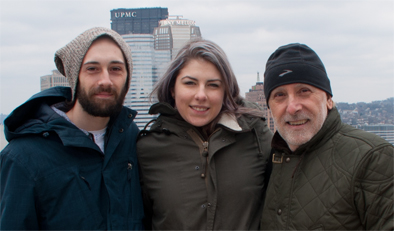
 Christian and Maria drove down to visit and we had a nice time. The last time Christian was here, he was 7 and the four of them – Dave, Jo’, Christian and Seane – spent their visit at Ross Park Mall. When we were talking about him and Maria coming down, he had no idea what they would do except go shopping. I explained that we would do the whole sight-seeing tour, but he had no sense what that meant. He was too young to remember; he did remember Kennywood Park.
Christian and Maria drove down to visit and we had a nice time. The last time Christian was here, he was 7 and the four of them – Dave, Jo’, Christian and Seane – spent their visit at Ross Park Mall. When we were talking about him and Maria coming down, he had no idea what they would do except go shopping. I explained that we would do the whole sight-seeing tour, but he had no sense what that meant. He was too young to remember; he did remember Kennywood Park.
I’m the only family member not to have met Maria and I was trying to find a way for us to meet when she was in from Nova Scotia. (The two of them graduated from Acadia University in Wolfville, Nova Scotia.) I even considered flying up to Toronto for the weekend, but that meant being there with no car and no way of visiting with Frank-and-Norma, Renato-e-Gina, Mary-Domenic-and-Alyssa. Flying in didn’t sound worth it.
We began with a walk from the North Side into town. This was through West Park, over the Fort Duquesne Bridge, through Point State Park and into Gateway Center. Once back on the North Side, we drove to the South Side and got on the incline.
After lunch at the Porch in Schenley Plaza, we walked the Pitt campus. When Maria saw the dinosaur outside the museum and I told her about the exhibit, we went in and did the gem and the dinosaur displays. (The last time I was in the museum to see these two exhibits, it was Frank, Norma and I walking through the jewelry cases and the reconstituted dinosaur skeletons.)

 I find it odd to think back some 60 years and remember that I was living in Aprigliano and that my dad took me to see the Christmas bonfire. He had me on his shoulders as we walked from our house up to the church of Santo Stefano. I also remember that the days before Christmas Eve, someone came around and collected firewood from every family for the bonfire. The fire was lit on the small piazza in front of our parish church and it was nurtured through Christmas Eve and Christmas Day. Each parish had its own Christmas bonfire and if you had moved, you even went back to your old parish to view its bonfire. What I’ve learned since is that it was a male-only event. Both my mom and my aunt tell about not being allowed to go see the bonfire, because they were unmarried young women.
I find it odd to think back some 60 years and remember that I was living in Aprigliano and that my dad took me to see the Christmas bonfire. He had me on his shoulders as we walked from our house up to the church of Santo Stefano. I also remember that the days before Christmas Eve, someone came around and collected firewood from every family for the bonfire. The fire was lit on the small piazza in front of our parish church and it was nurtured through Christmas Eve and Christmas Day. Each parish had its own Christmas bonfire and if you had moved, you even went back to your old parish to view its bonfire. What I’ve learned since is that it was a male-only event. Both my mom and my aunt tell about not being allowed to go see the bonfire, because they were unmarried young women.
The image on the left is from a FB site for residents and expats from Aprigliano. There are several images of the bonfire; my favorites are of the old men in their white-plastic chairs sitting away from the sparks and heat of the bonfire. There are about 50 men in the Piazza and only two women. The men are well over 40; the two women are much younger and they are only interacting with a young man. Guess the old men still rule and the old traditions still hang on.
The fire in the image is in Piazza di Guarno, not at a parish church. Guess everywhere in the world centralization is the rule.
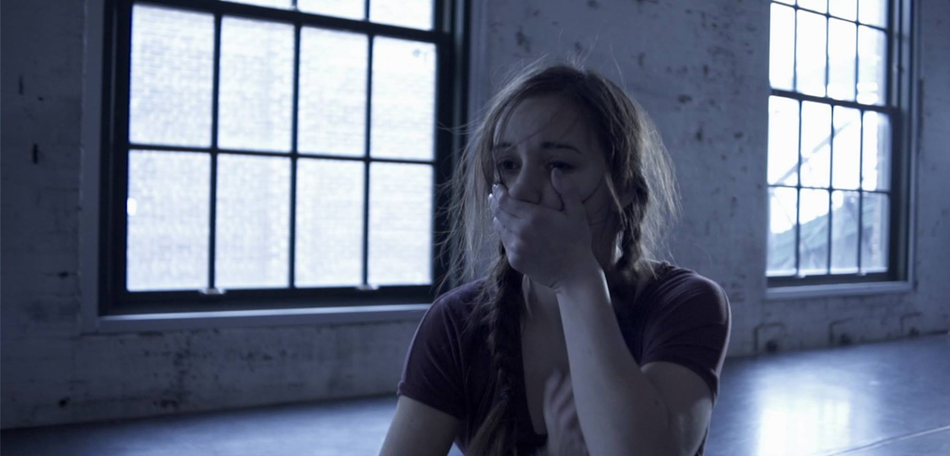

Text from JFO Films Facebook Page
Here are some stills from my first project! I’m creating a series of concept videos featuring dancers.
First up is PENSIVE, featuring the extremely talented Seane Thorman.
Shout outs to my amazing cinematographer, Michael Hitoshi Maddeaux, and support and assistance from Jessamine Fok – couldn’t have done it without you guys!
Note: The image posted on the JFO FB page is longer and has black bands above and below it. Given that I have space restrictions, I cropped off the right side and the black bands.
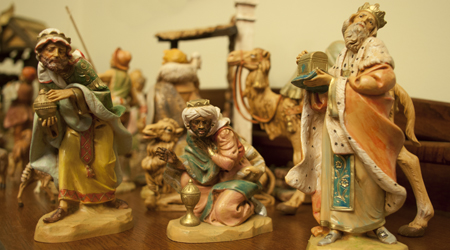
 The title is a quote from the poet Omar Khayyam from Reg Henry’s column in today’s PPG. The image is of the three Magi from the presepio Jo’ got me when her friend Pat went to Italy.
The title is a quote from the poet Omar Khayyam from Reg Henry’s column in today’s PPG. The image is of the three Magi from the presepio Jo’ got me when her friend Pat went to Italy.
Twelvetide – the Twelve Days of Christmas – ends today. But for my relatives and Facebookers in Aprigliano the date marks the feast of La Befana and they have images of the old witch, albeit cute and colorful in her modern incarnation, all over their FB pages. (I want to find out if gift-giving in Italy has moved from the traditional January 6 date, the feast of the Magi, to the more American date of December 25.)
The Legend of La Befana – On the evening of January 5, legend has it that the three wise men knocked on La Befana’s door while looking for the child Jesus. She let them come in, but when asked to go with them to visit the baby, she said she was too busy. Later she regretted her decision and ran out of her house with a broom in hand and gifts for newborn child, but was never able to catch up to the Magi. Today she is still looking for the baby Jesus so she gives all children gifts every eve before Epiphany.
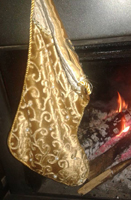 My favorite quote is from my cousin Alessandra – non si è mai troppo grandi per aspettare la befana – the sentiment is that you’re never too old to hang a stocking by the fire and believe that La Befana will stuff it full of gifts. I’m assuming that the image is of her Befana stocking by the fireplace at her Dad’s house. (I particularly like the small, unraveling threads at the bottom of the opening. It must be an old, beloved sock. Wonder if it’s the sock from when she was a child. Is it the sock her Mom and Dad – my cousins Mario e Tonina – hung by the fire when she still believed La Befana brought gifts?) Dag! I remember using one of my Mom’s old socks, because it was the longest and biggest sock we had in the house. It was a plain woolen winter sock. It had no gold thread or fancy embroidery.
My favorite quote is from my cousin Alessandra – non si è mai troppo grandi per aspettare la befana – the sentiment is that you’re never too old to hang a stocking by the fire and believe that La Befana will stuff it full of gifts. I’m assuming that the image is of her Befana stocking by the fireplace at her Dad’s house. (I particularly like the small, unraveling threads at the bottom of the opening. It must be an old, beloved sock. Wonder if it’s the sock from when she was a child. Is it the sock her Mom and Dad – my cousins Mario e Tonina – hung by the fire when she still believed La Befana brought gifts?) Dag! I remember using one of my Mom’s old socks, because it was the longest and biggest sock we had in the house. It was a plain woolen winter sock. It had no gold thread or fancy embroidery.
Henry’s column is about a long ago time – 1977 – when the first Star War movie premiered; when we were all young enough to believe in gifts and wonder.

 It was time to upgrade to a camera with more mega-pixels and replace the d90. And like an old fashion immigrant, I started putting money aside. (Tell me that isn’t anti-modern, anti-consumer.) The d7100 is an entry level camera, but I need one of those. There are enough times when I hand someone a camera to take a pic of the group of us and it has to be something a stranger can just point-and-shoot. I also like the no-flash feature.
It was time to upgrade to a camera with more mega-pixels and replace the d90. And like an old fashion immigrant, I started putting money aside. (Tell me that isn’t anti-modern, anti-consumer.) The d7100 is an entry level camera, but I need one of those. There are enough times when I hand someone a camera to take a pic of the group of us and it has to be something a stranger can just point-and-shoot. I also like the no-flash feature.
The Christmas anxiety and hype seem to have disappeared. It’s as if the season never existed.
The weather has been unusual; today it’s 53o and the sun is out. In the image, I like the glow it casts onto the buckets and the nylon strings. But January always has this confusing period when we pretend that winter will stay away or stay north and not reach down into south-western Pennsylvania. And we are always disillusioned when the frigid temperatures grip the land and we start the count-down to March 21.
Don’t know if I have too much info in the header. Between the sunrise/sunset, the hours of daylight and the countdown to March 21 it looks a bit crowded. So I removed the countdown.
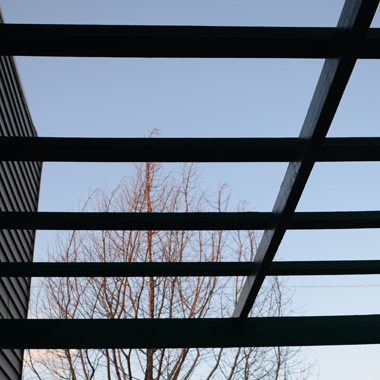
 I only write about weather in winter. Within two days – Saturday to Monday, we went from 59o to this morning’s low of 19o. And since the last post, there are 3 additional minutes of daylight. (For some reason that was a difficult sentence to create. Daylight is an odd noun to structure a sentence around.)
I only write about weather in winter. Within two days – Saturday to Monday, we went from 59o to this morning’s low of 19o. And since the last post, there are 3 additional minutes of daylight. (For some reason that was a difficult sentence to create. Daylight is an odd noun to structure a sentence around.)
The 2X4 grid, in the image, is the roof structure on my back porch.
I’ve decided to not watch any of the 24-hour cable-news except for Rachel Maddow. She’s the only host who doesn’t traffic in innuendos, gossip, fear-mongering or personal opinion. (Chris Hays will chase any story that has an African-American angle. And then contort it so that he can layer his version of liberal tolerance on top of it. Lawrence O’Donnell can’t disguise his dislike of Hillary Clinton and obsession with politicians from New England. He practically orgasms over Elizabeth Warren.) But it’s because of Rachel Maddow that anyone if paying attention to the horrors happening in Flint, Michigan.
The three main networks – CNN, MSNBC, Fox – run Trump all day. And with the three channels chasing ratings, the Presidential primaries have become reality TV. Every word, gesture, pause is analyzed and great pronouncements made.
Is the Vice-President endorsing Bernie?
Is President Clinton going to stay on message?
Is Donald Trump going to go after Ted Cruz?
Did you see Hillary’s face when the announcer mentioned Jeb?
Did you see Rubio’s new shoes?
Is this what 17 century Versailles was like?
The King’s toilette was exceptionally fragrant this morning. Were you there?
Of course. I had a front-row seat next to the Cardinal.
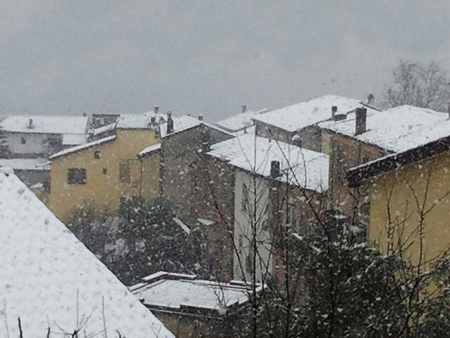
 I stole the image from Maria Callari’s FB photos. It all started with me commenting to Vincenzo Martire that he should add names to the various people pics he posts on the Sei di Aprigliano FB page. And naturally that resulted in a barrage of follow-up comments. My favorite was from Cinzia Fuoco who claimed that Vincenzo Martire just wants everyone to guess who people are. Maria Callari followed that with how can we know everyone. A sincere question, but one that triggered sarcasm and laughter. The conversation wasn’t mean-spirited just edgy. After all we’re Apriglianesi and nice isn’t in our gene structure. We’re not mean, but we’re certainly not nice. (My family members accuse Seane and I of being cut from the same cloth. Apparently the two of us are anything but nice. Seane and I delight in that assessment.)
I stole the image from Maria Callari’s FB photos. It all started with me commenting to Vincenzo Martire that he should add names to the various people pics he posts on the Sei di Aprigliano FB page. And naturally that resulted in a barrage of follow-up comments. My favorite was from Cinzia Fuoco who claimed that Vincenzo Martire just wants everyone to guess who people are. Maria Callari followed that with how can we know everyone. A sincere question, but one that triggered sarcasm and laughter. The conversation wasn’t mean-spirited just edgy. After all we’re Apriglianesi and nice isn’t in our gene structure. We’re not mean, but we’re certainly not nice. (My family members accuse Seane and I of being cut from the same cloth. Apparently the two of us are anything but nice. Seane and I delight in that assessment.)
I have to say, it’s great fun to comment back-and-forth in Italian. (You really do get to a point where writing and talking in Italian stops being torturous. I’ve stopped hesitating, stopped worrying that the spelling is wrong, that the verb tense is screwed up. And Google Translate is there to make sure I don’t misspell anything, because that would be very embarrassing even though Italian is no longer my primary language.)
Over the years, I’ve collected many images of winter in Aprigliano. I like snow on the medieval structures in desert-like Calabria. It’s a contrast that appeals to my sense of absurdity.
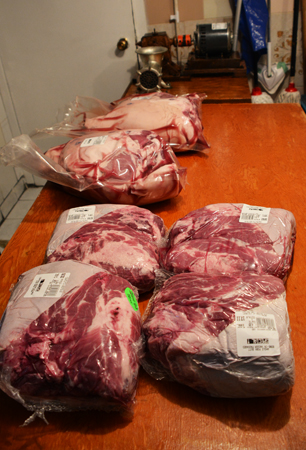
 Rick, Sarah and I left for the trip up to Sault Ste Marie yesterday. We drove to Rose-and-Derrick on Friday and Saturday morning we headed north. We got to my parents at 3:30. We had some coffee and some cookies and then went off to Metro to buy the meat for the prosciutto, soppressata and salsiccia. My 90 year-old dad drove.
Rick, Sarah and I left for the trip up to Sault Ste Marie yesterday. We drove to Rose-and-Derrick on Friday and Saturday morning we headed north. We got to my parents at 3:30. We had some coffee and some cookies and then went off to Metro to buy the meat for the prosciutto, soppressata and salsiccia. My 90 year-old dad drove.
At this time of year every grocery stores with an Italian clientele carries pork cuts to make the various salami. The refrigerated meat-cases were at the front of the store and signage was in both Italian and English. Also, the meat was incredibly inexpensive, because it’s priced like turkeys at Thanksgiving. My dad and Rick get along real well, and when Ciccio suggested maybe buying a fourth butt, Mr. Wertheimer quickly agreed. We bought 70 pound of meat. The bill was $160 Canadian. And for us buying with American money, the meat was a steal. (The Canadian dollar is trading at .69 cents against the US dollar.) So my very bargain-conscious friends were ecstatic.
We loaded two huge pork-legs and four pieces of pork-butt into my dad’s van and headed home. And given our short stay, my dad suggested we cut, debone and process the meat once we got home. He had everything ready – the table from the garage, the meat-grinder attached to a motor and bolted to a home-made cabinet, the knives, the sharpening rod and the aprons. Everything was set up in the old basement next to the stationary sinks. And my mom and my he agreed to hold off dinner until the meat was processed. Very unusual for a man who insists that dinner is always at 5:30.
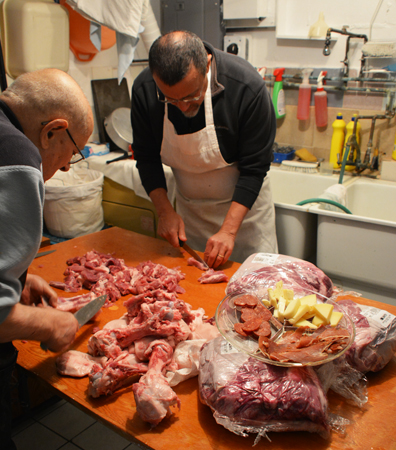
 The pic is of my dad and Rick. The legs and one of the butt pieces have been deboned and they are now cutting the meat into strips so that it can be fed into the grinder. I had expected to buy the prosciutto leg already deboned, but it’s sold with the bone and you either do it yourself or pay the butcher to debone it. (My dad has been butchering meat since he was a young man. There is no way he was paying someone to do something he can do.) Also, my dad is the last hold-out still making his prosciutto with the bone. All the other immigrants have switched to a boneless prosciutto. Leaving the bone means that the prosciutto will need a year to dry and cure. The boneless prosciutto will be ready to eat in about 9 months.
The pic is of my dad and Rick. The legs and one of the butt pieces have been deboned and they are now cutting the meat into strips so that it can be fed into the grinder. I had expected to buy the prosciutto leg already deboned, but it’s sold with the bone and you either do it yourself or pay the butcher to debone it. (My dad has been butchering meat since he was a young man. There is no way he was paying someone to do something he can do.) Also, my dad is the last hold-out still making his prosciutto with the bone. All the other immigrants have switched to a boneless prosciutto. Leaving the bone means that the prosciutto will need a year to dry and cure. The boneless prosciutto will be ready to eat in about 9 months.
The bones next to my dad came from the legs and the one butt. In Italy, these bones along with some of the fat would be boiled down and made into a pâté called frisoli was made. My dad would leave a bit more meat on the bones insuring a more meaty frisoli. I just put the bones in a bag and brought them out to the outside garbage.
My mother worried that we were eating late, put together a plate of meats and cheeses for us to snack on. The plate has last years prosciutto and soppressata. Also, there are four wine glasses, filled with my dad’s homemade wine, on shelves and ledges just outside the picture. You can’t have prosciutto, soppressata and cheese without vino.
BTW, this is the basement laundry room.
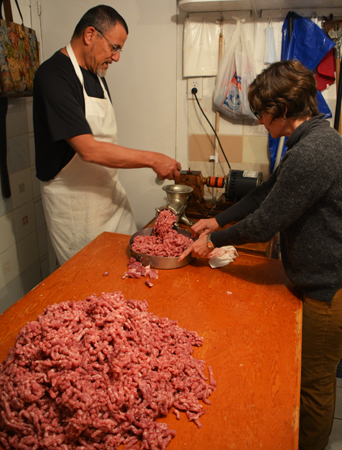
 The next step in the process was to grind the meat and to season it. In the pic, Rick is feeding meat strips into the grinder and Sarah is collecting the chopped-meat in a pan. The pan is the bowl of a casserole my mother brought from Aprigliano 60 years ago. (Growing up, it was my job to turn the crank on the grinder. Now, my dad has the manual meat grinder attached to a motor.)
The next step in the process was to grind the meat and to season it. In the pic, Rick is feeding meat strips into the grinder and Sarah is collecting the chopped-meat in a pan. The pan is the bowl of a casserole my mother brought from Aprigliano 60 years ago. (Growing up, it was my job to turn the crank on the grinder. Now, my dad has the manual meat grinder attached to a motor.)
My dad separated the chopped meat into mounds; each mound a huge ball that fit between his hands. For each mound he added a handful of coarse salt. And he finished the seasoning by adding two small mason jars of red-pepper paste. In Italy, I remember seasoning the meat with salt and paprika. But today a red-pepper paste replaces the paprika. Next, the seasoned meat needed to be mixed and for this my dad used his industrial mixer.
Over the years, my parents have purchased all the modern devices that make cooking, wine-making and salami-making easier. The industrial mixer came from a restaurant that a friend of the family ran. When the restaurant closed, my parents bought the mixer. It’s used to mix bread and cookie dough and meat for soppressata and salsiccia.
The seasoned meat was put into the cold-cellar and we went and had dinner. Tomorrow we fill the soppressata and sausage casings.

The meat grinder is re-assembled for stuffing. The knife and extruding plate are removed and a funnel is attached. The large funnel is for soppressata. My dad was up early tying one end of the casings. In the bowl are 13 other tied casings. He puts in the orange peel to mask the intestine smell. In the image on the right, he and Rick are tying the other end of the soppressata. This end has an extra long string so that the soppressata can be hung up. (And my dad, being the ultimate utilitarian, hung a spool of string from the ceiling. The string in the middle of the pic is from the spool. It’s out of the way, but easily accessible.)
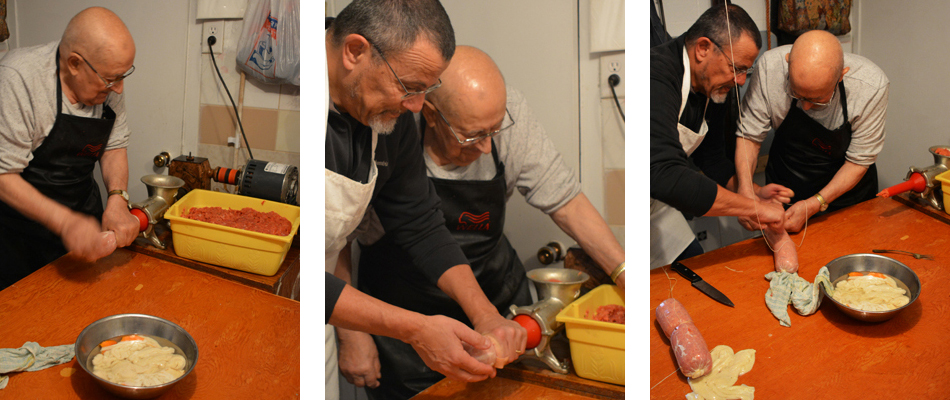

At the end, we made six sausage links. The center image is of the grinder, its motor and the drawer with all the parts. (My dad assembled the whole contraption. It works from a peddle.) The star shaped items are the knives and the round face-plates with the holes determine the size of the meat being extruded. The face-plate with the larger holes is for soppressata and the one with the smaller holes is for salsiccia – sausage. The image on the right is Rick bolting the grinder back onto the cabinet.
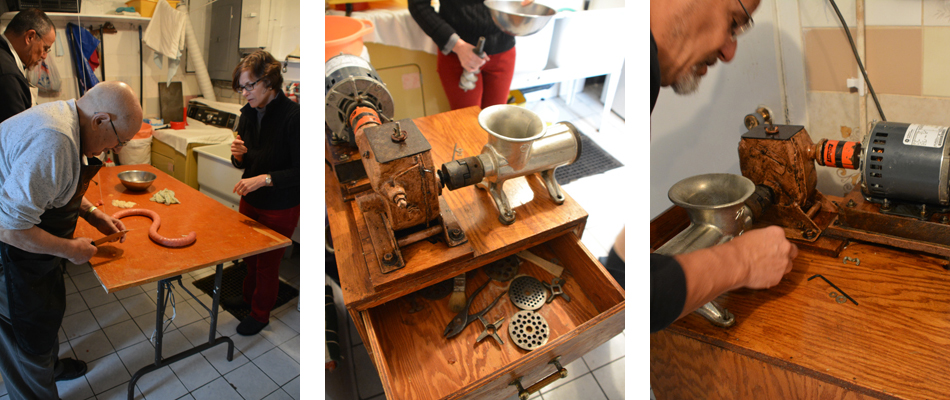

In the image on the left, my dad is salting the prosciutti. The four prosciutti – two large and two smaller ones – stayed in the plastic tub for 48 hours. The middle image is of the salami my dad has already made. The second item in is pancetta. The last image on the right are the soppressate and the salsiccie we made. The outside-casings on the soppressata squeeze it and make the drying easier. (Sarah and I put the soppressate into these outside-casing. My dad had me gather the outside-casing onto a piece of PVC piping. Sarah and I slid the soppressata through the pipe and when it emerged it was wrapped in the constricting string casing.)
The middle and right images are in my dad’s cold-cellar. (There is enough food-stuff in this space to feed a family for at least six months. The demijohns with the wine are behind me.)
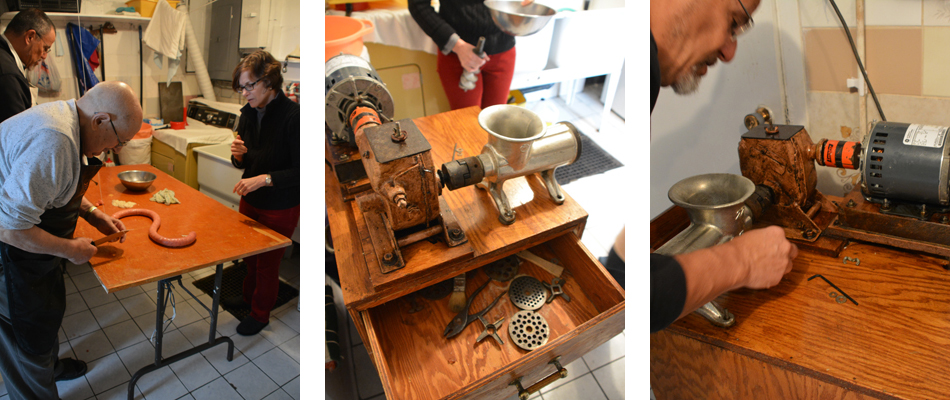

 Connie invited us to take a ride out to the cottage and after lunch, we headed out. Maki Road that last month was snow-free was now buried under packed snow. Am so glad I don’t live here.
Connie invited us to take a ride out to the cottage and after lunch, we headed out. Maki Road that last month was snow-free was now buried under packed snow. Am so glad I don’t live here.
We stopped at the windmills. I like the tractors and snowplows at the bottom of the sleek elegant tower. When it comes to clean energy, Canada is ahead of us. The windmills on the Red Rock ridge have been turning for almost 10 years and the number of solar-farms in the area is a surprise and a hopeful sign.
We also stopped at the rise above Lakeshore Road; the same location where I shot the Boxing-Day pic. And of course I shot the same landscape now covered in snow.
……………………………………………………………………………………………………………….


 It’s Monday morning and we’re packing the salami for our trip home. My dad bought a plastic tub (The black container is on the floor, under the mops, between Rick and my dad.) and I think everything will fit. The apron Rick is wearing was the prompt for the pic. Isn’t it the best? It’s one of my mom’s aprons. The image also has all the mechanics of the laundry room and I wanted to show them.
It’s Monday morning and we’re packing the salami for our trip home. My dad bought a plastic tub (The black container is on the floor, under the mops, between Rick and my dad.) and I think everything will fit. The apron Rick is wearing was the prompt for the pic. Isn’t it the best? It’s one of my mom’s aprons. The image also has all the mechanics of the laundry room and I wanted to show them.
The proscuitti have been in a salt brine since Saturday and this morning my dad cleaned off the excess salt and coated them with pepper and paprika. They will be the first things into the plastic container, but until we’re ready they’ll hang in the cold-cellar for a couple of hours. This will shed or dry any excess moisture.
The highlight of the day will be lunch. My dad promised to serve moose meat. And sure enough by 11:30 a beautiful roast sat on the table surrounded by soft roasted carrots. It looked really good, but I stay away from game much to my dad’s displeasure. I ate a fava and pasta soup and some salad. There’s no way I can eat a full lunch and not want to sleep afterwards. And given that I’m all hepped up over getting through customs with our meat products, I had little appetite.
In packing the car, I suggested we casually throw our winter coats over the luggage and meat container.
It’s been a very short visit, but we have a four hour trip down to Oxford, an overnight at Rose-and-Derrick’s before we head out for the five hour trip home to Pittsburgh.

 During the winter months, the area between the Mackinaw Bridge and Grayling is infamous for raging storms. The area is also the narrowest part of the peninsula with Lake Michigan/Grand Traverse Bay on the west and Lake Huron on the east. Winds from the west are generally considered the mildest and most favorable, but up here they are deadly, because they mix with the winds coming down from the Arctic. These two systems sweep over Lake Michigan/Grand Traverse Bay picking up moisture and then dump it onto this 100 mile strip. The area is a micro-climate, a snow-belt.
During the winter months, the area between the Mackinaw Bridge and Grayling is infamous for raging storms. The area is also the narrowest part of the peninsula with Lake Michigan/Grand Traverse Bay on the west and Lake Huron on the east. Winds from the west are generally considered the mildest and most favorable, but up here they are deadly, because they mix with the winds coming down from the Arctic. These two systems sweep over Lake Michigan/Grand Traverse Bay picking up moisture and then dump it onto this 100 mile strip. The area is a micro-climate, a snow-belt.
We drove through white-outs where visibility was non-existent; we got caught behind a foolish driver and ended up swerving into the left lane; and at Gaylord we were routed off I-75 and onto local roads. The miserable conditions didn’t end until we made the bend east at Roscommon. Once out of the snow-belt, driving conditions were amazingly good.

 This is the last entry of the making salami posts.
This is the last entry of the making salami posts.
In five days, we drove 1200 miles; made proscuitti, soppressate and salsiccie with my dad; brought everything back; and hung them in Mim’s cold-cellar in Forest Hills. Both my dad and Rose suggested hanging the meat low. This keeps it away from the warmest and least humid ceiling area. And the shelf in the cold-room should be a good elevation.
There were two stressful times – at the Sault-Michigan border and driving through the Mackinaw/Grayling snow-belt. At the border, the worry was getting across with the meat; in the snow-belt, the worry was getting safely through the blinding conditions.
We now have to monitor the drying to make certain that the proscuitti and soppressate cure.

Found the FB page – Calabria ieri – and these three amazing images. I downloaded the one on the left, because my parents had that same picture of the Holy Family in their bedroom in Aprigliano. Today it’s in Jo’s old bedroom. I’ve been meaning to take it, maybe next time I’m up. The image in the middle is the best. I couldn’t pass up. I love his head against the wall and his looking down. And that has to be his sister keeping guard, right? Mi piace troppo. The image on the right is there, because of the brazier. I remember us having one and my playing on the wooden stand holding the copper dish with the coals. Also, I love the two women; there’s a wonderful sense of camaraderie and ease; and those shoes, and those big feet – OMG.
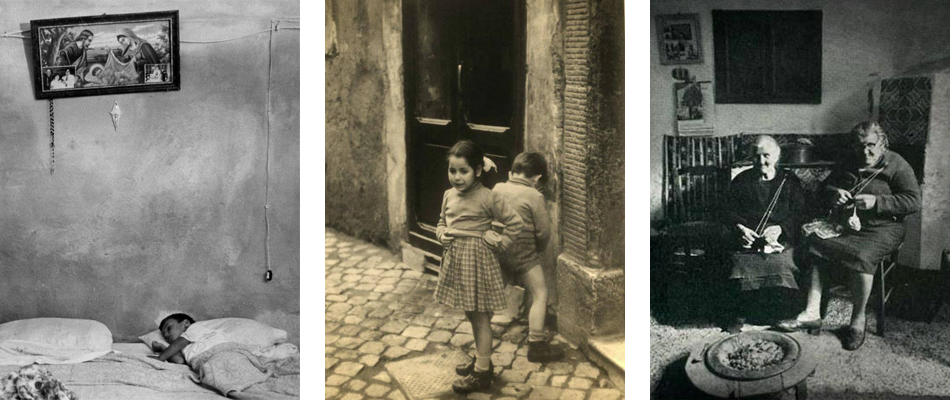
57 days till spring
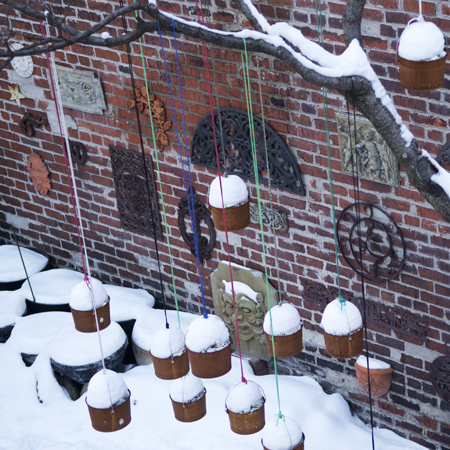
 The shot is from the porch and so the weird perspective.
The shot is from the porch and so the weird perspective.
The snow started Friday evening and lasted all the way through mid-day Saturday. I went out with the broom to clear the area in front of the back-door, but it was fruitless; within the hour the swept area was covered in snow. Total accumulation was between 6 and 10 inches. We were on the northern edge of the storm.
I kept thinking of all the farmhouses we passed going up to my parents in Northern Ontario and how isolated they all seemed; how scary it felt picturing myself in those farmhouses; and yet the snow-storm here left many isolated. (I have a pic that Jo’ gave me of a barn in winter in the middle of a field. It’s all gray and blurry with falling snow. It’s one of the most desolate, depressing photographs I have ever seen.) Is the difference one of duration? By the middle of the next week, the snow will be gone, but in Northern Ontario and the Upper Peninsula winter and snow will last into April.
And it’s on days like this that I go looking for summer rental in Italy. (I’m already counting down to Kaua’i.) In Calabria, the rental situation is very different than in other parts. Even Puglia, which is similar economically, had several viable rental properties. Most of the online rentals in Calabria are in resort areas and most are new construction. Forget refurbished medieval housing with modern amenities. The albergo diffuso in Belmonte was truly a find.
55 days till spring

 Throughout Italy every town has a piazza with a WWI memorial. And I try and shoot all the various monuments, walls, commemorations. In Aprigliano, the WWI monument is how I remember Piazza Guarno; it’s how I identify the town. For me, it’s as iconic as The Eiffel, Lady Liberty, The Vatican, Cinderella’s Castle, The Pantheon, The Brandenburg.
Throughout Italy every town has a piazza with a WWI memorial. And I try and shoot all the various monuments, walls, commemorations. In Aprigliano, the WWI monument is how I remember Piazza Guarno; it’s how I identify the town. For me, it’s as iconic as The Eiffel, Lady Liberty, The Vatican, Cinderella’s Castle, The Pantheon, The Brandenburg.
Over the last couple of years, a number of WWI memorial images have emerged. And given the Italians penchant for pretty and romanticism, the new posters present a sanitized event; a memory wrapped in sharp whites, greens and reds. Nothing like remembering the drab khaki landscapes, the shell-blasted sludge, the blood-baths, the trench warfare with modern, digital pretty.
And talking about pretty, there’s an episode of Comedians in Cars Getting Coffee where Jerry is talking with Fred Armisen in Portland about good coffee:
Fred: Have you been to Italy?
Jerry: It’s amazing that it only functions on this level of charm.
Fred: Yeah
Jerry: Without that, it’s like a young pretty girl that never ages. That’s Italy.
Fred: Absolutely
Jerry: She never gets older; never looses her allure; and you can’t get enough of it.
Fred: Yeah
Jerry: And it survives, but all other beauty on earth fades,
Fred: Yeah
Jerry: Except Italy.
Fred: Why is that?
Jerry: I don’t know.
Fred: That is perfect, what a perfect description.
54 days till spring


For these three images, I’m gonna quote the Italian comments posted with each on the FB page Calabria Ieri e Oggi. I see no need to translate the words when the images evoke sentiment and meaning.
Left Image: Emigranti si preparava la valigia di Cartone e un vecchio Baule..si Partiva a quei tempi in cerca di fortuna per il Nord per le Americhe e per l’Australia. Ma al giorno d’oggi troppi nostri calabresi lasciano la loro Terra a causa della disoccupazione e per andare avanti si cerca fortuna altrove. Ma la Calabria rimarrà per sempre nel loro ❤.
My mother still has the cardboard suitcase and the trunk. I remember the shoes with the metal clips. It was a way of extending the life of the shoes.
Middle Image: Peppino e Ntonuzza furono i miei primi fotomodelli, amici e vicini dei miei nonni si prestarono ai miei primi scatti con una vecchia Koroll Bencini, sono passati 41 anni da allora ma il ricordo è vivo, loro non ci sono più, di loro conservo la loro straordinaria bontà e semplicità antica, a loro la dedico. (Mario Greco)
Imagine, they are not husband and wife, but friends and neighbors.
Right Image: Ricordi di un tempo non avevamo il PC e lo Smartphone ma in compenso avevamo il giradischi dove ascoltavano Modugno, Morandi e Celentano.
The guy on the right could easily be me. I had that haircut and I have that nose.
51 days till spring

 When I borrow someone else’s photograph, I usually write down all the attributing info so that I can add it to the post. But, I can’t remember which site or from whose FB page I downloaded this image.
When I borrow someone else’s photograph, I usually write down all the attributing info so that I can add it to the post. But, I can’t remember which site or from whose FB page I downloaded this image.
The image is taken from the small town of Bagnara Calabra. The town sits north of Reggio on the coast looking across the Strait of Messina. And there looms Etna in all its winter beauty. (My favorite part of our week in Pellaro – August 2009 – was having dinner on the roof-terrace and seeing the volcano on the horizon. Then in 2014, when we drove right by it on the Autostrada, the immensity was something I had never considered. When you see it from far away, there is no sense of scale. Etna is enormous. Being below it and realizing that there is a whole city at its base was disconcerting. I don’t understand how you live at the base of an active volcano.)
Wanted to compare sunrise and sunset between Pittsburgh, Aprigliano and Sault Ste Marie.
Pittsburgh – 10 hours and 03 minutes (7:32 – 5:35)
Aprigliano – 10 hours and 10 minutes (7:03 – 5:12)
Sault Ste Marie – 9 hours and 30 minutes (8:02 – 5:37)
49 days till spring
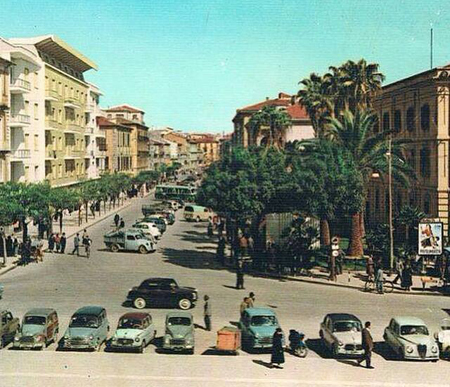
 When I see these old images, I think about where I was at the time. In 1959, my family had been in Canada two years; we were still living at my grandparents; my aunt had been married a year-and-a-half – November 30, 1957 – and living upstairs; and I was in 3rd grade at St. Theresa’s. Nineteen-fifty-nine was also the year there was a construction fire down the hall from my classroom, in the new extension. The smoke damage was enough that all students were bused to other schools until the damage was cleaned up. My 3rd class was sent to Sacred Heart Elementary on the edge of downtown. And for the next three months, we had class in the basement gym of Sacred Heart School. There were at least two other classes in the space and portable blackboards were used as dividers between the groups. Imagine 100 kids sharing a large open space and keeping quiet. (I could look under the blackboard and see the shoes of the kids in the other grade.) But lessons went on and we did our work. And because we couldn’t go home for lunch, they fed us. It was my first experience with school lunches. It was all very exotic.
When I see these old images, I think about where I was at the time. In 1959, my family had been in Canada two years; we were still living at my grandparents; my aunt had been married a year-and-a-half – November 30, 1957 – and living upstairs; and I was in 3rd grade at St. Theresa’s. Nineteen-fifty-nine was also the year there was a construction fire down the hall from my classroom, in the new extension. The smoke damage was enough that all students were bused to other schools until the damage was cleaned up. My 3rd class was sent to Sacred Heart Elementary on the edge of downtown. And for the next three months, we had class in the basement gym of Sacred Heart School. There were at least two other classes in the space and portable blackboards were used as dividers between the groups. Imagine 100 kids sharing a large open space and keeping quiet. (I could look under the blackboard and see the shoes of the kids in the other grade.) But lessons went on and we did our work. And because we couldn’t go home for lunch, they fed us. It was my first experience with school lunches. It was all very exotic.
Meanwhile, in Cosenza it was spring and they were walking around in suits; in Sault Ste Marie, I went to school in my winter coat, got on a school-bus and went cross-town to a basement gym. And for lunch, I ate Canadian cafeteria food. Bet my fellow Cosentini had never had Wonder Bread. (I remember being on the train from Montreal to Sault Ste Marie and my dad disgusted with the mushy white-bread they gave us for lunch.) The thought that my fellow Cosentini were eating good Calabrian bread while we gummed the bleached, nutrient-free wonder-food of modern Canada makes me believe in the power of advertising. We left Calabria because of the poverty and because we were told that the streets of America were paved with gold.
47 days till spring


photography is by Leonard Nimoy
inspiration by Henri Matisse
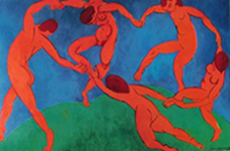
and lyrics by Mark Stewart
Naked girls at breakfast tables
Talking Hegel and Camus
While men dressed up in Gauloises smoke
Quote Marx right back at you
46 days till spring


It’s 2006, I’d found an interesting stone. The B&W1 image is from 1955. Both were taken at the beach at Gioia Tauro.
My family left Calabria in 1957. I went back in 1972 and spent a couple of weeks in Aprigliano at my uncle-and-aunt’s and then went up to Perugia for school. The next time I was in Italy was 1999. Rick, Sarah, Shana, Mim and I went. (British Airways was winding down its Pittsburgh/London route and they offered a $99 seat sale. Imagine $99 to go from Pittsburgh to London.) We stayed in Verona and did day-trips to Venice.
In 2006, Rose, Derrick and I went to Italy and we stayed in Calabria. We flew into Lamezia and drove down the coast to Gioia Tauro where Rose had found us a very nice apartment.
39 days till spring1 FB – Calabria Ieri e Oggi

 1 Yesterday was the first time I heard a cable-news/social-media personality admit that Donal Trump was a scary presidential prospect. The occasion was Trump’s retweeting of a white-supremacist’s tweet. Ezra Klein of Vox Media finally admitted that Trump has been very good for cable-news and social media; that the ratings and number-of-clicks have skyrocketed when they run all-things-Trump. But Mr. Klein went on to admit that what cable-news and social-media are dismissing as entertainment is really scary political policy. DUH!
1 Yesterday was the first time I heard a cable-news/social-media personality admit that Donal Trump was a scary presidential prospect. The occasion was Trump’s retweeting of a white-supremacist’s tweet. Ezra Klein of Vox Media finally admitted that Trump has been very good for cable-news and social media; that the ratings and number-of-clicks have skyrocketed when they run all-things-Trump. But Mr. Klein went on to admit that what cable-news and social-media are dismissing as entertainment is really scary political policy. DUH!
And what about the fact that cable-news/social-media has advanced the Trump political agenda, because he serves their all-consuming need for viewers and eyeballs. Cable-news/social-media is doing for Donald Trump what Leni Riefenstahl and Joseph Goebbels did for Adolf Hitler in the Weimar Republic. Riefenstahl was the epitome of the young and talented generation that overlooked Hitler’s dark side. The generation that presented Nazism as the new religion. Cable-news/social-media is the young and talented phenomena of the current age and they have enshrined Trump on every TV, computer and phone screen.
To me, the current political climate is similar to the 1928 presidential election. The progressives/Democrats were for decent, common goals – repealing prohibition, religious tolerance; the conservatives/Republicans were for tougher enforcement of Prohibition and stricter immigration restriction. The Klan and the Protestant churches were potent forces against all things democratic and Herbert Hoover, who had no electoral experience, was swept into office by a landslide beating out Roman Catholic and Democratic New Yorker Al Smith.
37 days till spring1 Leni Riefenstahl stands near Heinrich Himmler while instructing her camera crew at Nuremberg, 1934.
In Nazi Germany, a version of the undercut – long on top but shaved at the back and sides –
was popular among the young men of the Wehrmacht – armed forces.


chi di voi lo possiede? nelle famiglie del sud quasi tutti lo avevano 1
The B&W image on the left shows a Calabrian family in all its poverty, but there on the wall is the iconic painting of the Holy Family.
The comments below are from the FB page – Calabria Ieri – where the image of the painting was first posted.
The comments are a response to the above question – who has one? and to the comment that all families in southern Italy had this painting.
Antonella Dominici – Si ce lo e credo che sfiora i 50anni il mio quadro trovato in una casa vecchia abbandonata e rotta entrai ed era appeso al muro pieno di terra lo preso e lo portato via adesso e come nuovo
Mario Zinga – i miei genitori hanno portato il quadro dalla Calabria – Aprigliano – a Sault Ste Marie, Ontario Canada
Francesca Liguori – Lo abbiamo anche noi sulla testiera del letto dei miei genitori eredità dei nonni
Antonio La Rosa – io ce lo odintico con la stessa cornice e lo vendo
Giovanna Trichilo – vero.. io ce l’ho.. in camera da letto appeso sulla parete del letto matrimoniale dei miei genitori.. anche se non ci sono piu
My favorite comment is from il signore La Rosa who has no shame using the comment-string to pitch a sale,
because after all, he has the same image in the same faux-wood frame.
35 days till spring1 FB – Calabria Ieri


1 Uno sguardo sullo stretto – mario greco
The image was taken from Bagnara Calabra a small town on the western coast of Calabria just north of the mouth of the Strait of Messina. On the left and around the bend are the cities of Scilla, Villa San Giovanni and Reggio. On the right is the northeastern tip of Sicily. The image was taken by Mario Greco. Il signore Greco has posted some amazing images. I cropped his original image to fit into the post. (Follow the link attached to the footnote to get to the image Mario Greco posted.)
The rant today is about the garbage all over southern Italy. (It was not as pervasive in Le Marche and in Puglia it was restricted to the sites where the garbage bins are located.) How did I get to garbage? I wanted to see what the northeastern tip of Sicily looked like, so I went and looked at images of Torre Faro, the town at the tip. In almost all the images there were empty plastic bottles and cardboard and paper lining the streets. And among the litter were the Italians walking around as if they were strolling down some grand boulevard with not a care in the world.
One excuse is that garbage collecting is a government task and in a country where government is suspect, why would I be surprised that there’s garbage all over the place. You could also say that garbage collection is controlled by crime syndicates and there’s no oversight that anyone can bring to the problem. I reject both excuses. I think it’s about conspicuous consumption. Southern Italy grew rich after The War and the garbage is evidence that il mezzogiono it’s no longer poor, that it’s people are no longer peasants; that it’s stores are chuck-full of the products and conveniences of the north. What’s a little garbage next to that brag? And what’s the problem with old refrigerators lining the side-of-the-road? The American tourists are getting more and more like the Germans. Stop looking down and look at the azure sky. Where else do you see a sky this color?
O mia Patria sì bella e perduta
31 days till spring1 FB – Calabria Fotografia
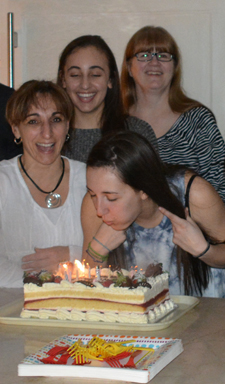
 Today is Seane’s 20th birthday. (left-to-right – Mary, Alyssa, Cathy and Seane blowing out the candles.)
Today is Seane’s 20th birthday. (left-to-right – Mary, Alyssa, Cathy and Seane blowing out the candles.)
I drove up yesterday and the New York Thruway was hazardous. There were very high winds coming from the south and where there were no trees to on my right, the winds dumped all the snow from the open fields/the vineyards onto the highway creating white-outs and a slippery road-bed. There were several accidents; at one point traffic was down to one lane, because paramedics and police were untangling two cars that had somehow wrapped around each other. Also, there were many cars in the median. The winds were so strong that I was gripping the steering wheels trying to stabilize the car in order to minimize the sway from side-to-side. But once I was beyond the vineyards, the winds were also behind me. (It was strange to have the south lanes be so hazardous while the north lanes going west were free of drifts and raging winds.)
Because there was a full-house at Dave’s, I booked a room at the Holiday Inn. When I got there, the lobby was swarming with young kids all girls. They were chasing each other through the lobby playing tag and the screams were bouncing off the metal ceiling amplifying the volume. The parents were all Millennials and they were totally ignoring their children’s bad behavior. (They were in line waiting to check-in and until the kids started to come up to them, I thought that they like me, had nothing to do with the screamers. But no, they were the parents and totally oblivious to the disruption. OMG!! There they were with the iPhones, and their Coach bags, and their skinny jeans, and helmet hair, and their put-upon attitudes waiting on the overwhelmed clerks who didn’t seem to know who they were dealing with. We were in WASP Oakville and they were the better people. So what that the nannies weren’t there to take care of the out-of-control kids that shouldn’t reflect badly on the aging thirty-somethings in line.) I asked the receptionists what was going on and she told me it was a girls hockey tournament. What? Yap, seven and eight year-old girls playing hockey.
28 days till spring


a walk in the woods
On the drive back from Kingston, we stopped in to see Connie’s friend Jody in Castleton. Jody and his partner bought 55 acres in this small farming community an hour-and-a-half east of Toronto. The location is beautiful and after coffee and muffins we went walking in the back-thirty. Jody has cleared an entire trail system in the woods behind their log-house.
Jody and his partner went from urban Vancouver to bucolic South-eastern Ontario.
24 days till spring

The area below the railroad tracks and above Lakeshore Road and between Trafalgar Road and Ford Drive is the most desirable section of Oakville. The area is chuck-full of millennials and their elders.
The area north of the tracks is full of cookie-cutter homes; the strip south of Lakeshore is reserved for the one-percents; and west of Trafalgar is full of older homes and families who have lived in the community for generations.

Trending in the AAA enclave is french-provincial – the mcmansion on the right. Realtors and their surrogates are buying up existing homes, tearing them down and putting up monstrosities sheathed in Loire-Valley ribbing. And the millennials are scarfing them up. So what, they have a $5,000,000 price-tag and you can touch your neighbors’ side-wall; the area is free of undesirables. At Whole Foods on Cornwall Road, I overheard the following comment: “It’s people like us.” The speaker was referring to her neighbors.
The building on the left is Canadian vernacular. And along the Trafalgar dividing line there are many examples of simple homes. They are unpretentious and hark back to a time of modest means and hard work.
The faux mcmansions won’t make it to the next tend. After-all, the price tag is based on the absence of the undesirables not the quality of the construction or the beauty of the architecture. And soon the arched windows and the mansard roofs with be passé.
23 days till spring
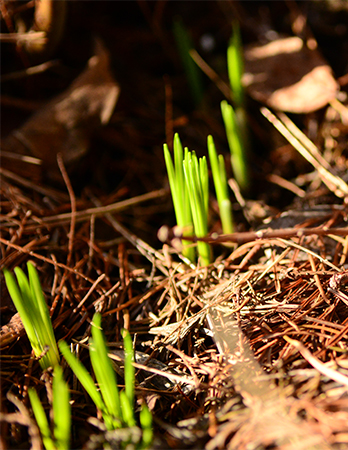
 I went rummaging in the flower-bed looking for sprouts and I found them. (I noticed the green shoots the other day, but the weather was miserable and gray, too ugly to shoot. Today, the late afternoon sun was on them and I simply removed the dry leaves to expose the green.) I wish I knew if they are crocus or snow-drops. I so want them to be snow-drops. Everything I’ve read says that it takes the bulbs a couple of seasons to naturalize and bloom. And I’m so hoping to have them bloom this year. I really like the pendulous, bell-shaped white flower.
I went rummaging in the flower-bed looking for sprouts and I found them. (I noticed the green shoots the other day, but the weather was miserable and gray, too ugly to shoot. Today, the late afternoon sun was on them and I simply removed the dry leaves to expose the green.) I wish I knew if they are crocus or snow-drops. I so want them to be snow-drops. Everything I’ve read says that it takes the bulbs a couple of seasons to naturalize and bloom. And I’m so hoping to have them bloom this year. I really like the pendulous, bell-shaped white flower.
Last year I got no snow-drops. Very disappointing. They had been a staple in the side-bed for years and when I removed the flower-bed, I just assumed I could replace them. NOT. The bulbs in the side-bed had been there a good twenty years and they came up every February. (Most flower in winter, before the vernal equinox.) I don’t know when I started using them as indicators of spring, but it must have been years after I had planted the bulbs, because I had no idea that they didn’t bloom the first or second year after planting. Back then, I was putting anything in without reading the packages. And the only reason I read up on snow-drops was because I missed them the spring the side-bed was gone.
21 days till spring
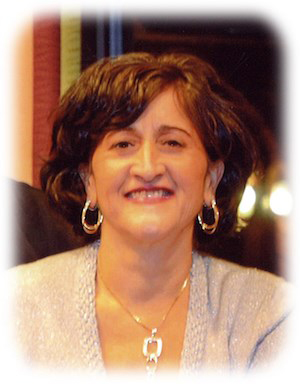
Mary died Sunday, February 28, 2016.
 In the spring of 1963, when my family mover to Turner Avenue, our neighbors were the Siriannis – Concetta and Frank and their two kids Mary and Gino. Mary was 2 years old when we moved to Turner Avenue and Gino was a newborn. The two families became friends. And it was common for both families to visit back and forth.
In the spring of 1963, when my family mover to Turner Avenue, our neighbors were the Siriannis – Concetta and Frank and their two kids Mary and Gino. Mary was 2 years old when we moved to Turner Avenue and Gino was a newborn. The two families became friends. And it was common for both families to visit back and forth.
Also living with the Siriannis was Frank’s mother – Za Maria – an old Italian lady who had left Calabria to come live with her son in frigid Northern Ontario. She always wore black.
I remember Mary as a little girl. The young all used Anglicized names. (I became MAY-RIO. And in Canada, my name is still pronounced with the long-A sound.) We discarded the Italian names faster than you could blink. Also, back then she was Mary Sirianni. I even remember baby-sitting her. She was a happy child who would laugh and never give me any trouble.
Five years after moving to Turner Avenue, I left Canada. Soon after the Siriannis also moved from Turner to a new subdivision. But the two families stayed friends. I never saw Mary again not as a teenager not as an adult.
Last week, my mother told me that Mary had been hospitalized with pneumonia, but because of her compromised immune system, Mary had had bone-cancer, the pneumonia put her into a comma from which she never woke up. The image on the left is from the SOOTODAY.com Obituary page.
Mary looks a lot like her dad in the picture. And the obituary attests to a life full of children, grandchildren and a large extended family. It’s wonderful to know that Mary had built a life for herself. To the little girl I once baby-sat, good-bye. You leave behind a group of people who will always remember you.


It has been a topsy-turvy week. Sunday through Tuesday the temperature hit 670, but by Wednesday it had dropped 20 degrees and by Thursday it plummeted to 190. And to add to the misery, last night it started to snow. It’s the wet-snow of late spring and it won’t last long, but man winter needs to be over.
In the image, east and sunrise are on the right. On the bricks, you begin to see the morning sun creeping down Sampsonia and lighting the row-houses. (I thought of re-shooting, but it’ll be well after noon before the sun hits the backyard.)
I never understand March, its weird weather patterns feel like a torture regiment. I’m terribly impatient with the yo-yo mercury. And even though this has been a mild winter, certainly compared to last year, I want it done. And to think there was a time in my life when wet, March snow just meant using the red ski wax.
15 days till spring


There are two photographers – Gianfranco Mancini and Walter Meregalli – that I am friends with on FB, whose work I really like.
Gianfranco wrote the following about his image – Esci di casa di buon’ora e agli occhi appare questa bellissima immagine della natura –
Da viale Gramsci il paese dove abito Montegranaro.
Nella foto si vede avvolto dalla nebbia Monte San Giusto paese confinante della Provincia di Macerata.
Walter’s image is of the Val d’Orcia in Tuscany.

sunrise – 6:45, sunset – 6:18
11 hours and 33 minutes of daylight
13 days till spring


Tomorrow morning, I head off for Kaua’i. And for the first time, I’ll be the one who has been there before. Rose and Derrick had to cancel their trip. So, it’ll be Mary, Dom, Alyssa and I.
After supper I go check my phone and Rose sent a quick text telling me that they were going and that she was in a panic getting ready.
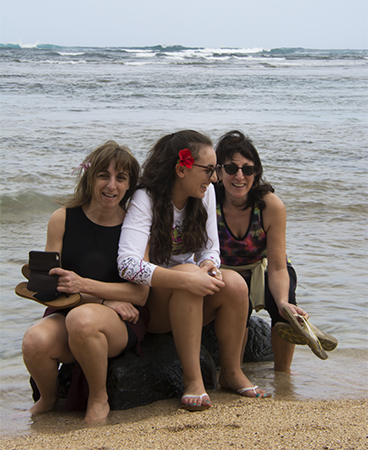
 It’s our second day and we did the walk from the Ka’Eo Kai resort to the fancy St. Regis Hotel. (It’s taken me all this time to finally realize that we are on a ridge.) When we got to the end of the road, we walked down to the water and once at the beach facing Hanalei Bay, we went over the legend of Puff-The-Magic-Dragon.
It’s our second day and we did the walk from the Ka’Eo Kai resort to the fancy St. Regis Hotel. (It’s taken me all this time to finally realize that we are on a ridge.) When we got to the end of the road, we walked down to the water and once at the beach facing Hanalei Bay, we went over the legend of Puff-The-Magic-Dragon.
Mary suggested that the three of them sit on the rock and that I take their pic. (L to R – Mary, Alyssa, Rose. The dragon is above their heads.) Derrick and Dom are off down the beach.
We spent the rest of the afternoon poolside; me drinking Gin-and-tonics, the rest of them downing Mai Tais. Even without the sun, we had a great time laughing and messing with each other.
Tomorrow is the Farmers’ Market and then a rush to find some sun. (I will not go looking for Helios; the beaches of the sun-god is not where I worship.)
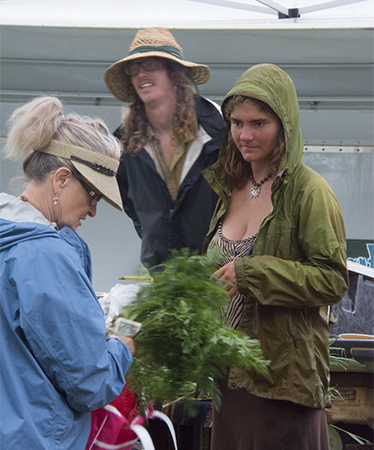
 The market in Kilauea, just down the street from Princeville, is one of my favorites. And today it did not disappoint even with rain, at times, coming down in buckets. It was full of old hippies and what I call live-forevers. These are Kaua’i’s Millennials and here too they defined themselves by a compulsion for exercise and for healthy-eating. They do yoga, eat only organic, wear dreads, spurn make-up and work for environmentally conscious projects. All are blond, all are tall, all are skinny. It’s a very exclusive club and like their counterparts on the mainland pretend openness and diversity.
The market in Kilauea, just down the street from Princeville, is one of my favorites. And today it did not disappoint even with rain, at times, coming down in buckets. It was full of old hippies and what I call live-forevers. These are Kaua’i’s Millennials and here too they defined themselves by a compulsion for exercise and for healthy-eating. They do yoga, eat only organic, wear dreads, spurn make-up and work for environmentally conscious projects. All are blond, all are tall, all are skinny. It’s a very exclusive club and like their counterparts on the mainland pretend openness and diversity.
Many have started scented-oils boutiques, juice bars, but all espouse a philosophy of modernity that removes them from the agri-businessses and fossil-fuelers of the mainland.
Like the hippies of old, they too want a better world; like the hippies of old, they too have retreated from society; like the hippies of old, they too want an alternate life-style. But unlike the old hippies these new iterations are not willing to forego the luxuries of modernity. Their devices – iPhone and iPads – are never out of reach; their Coach purses and Marc Jacob’s sandals look right at home on the wet grounds of Kilauea farmers market.


And Jesus was a sailor
when he walked upon the water
And he spent a long time watching
from his lonely wooden tower
And when he knew for certain
only drowning men could see him
He said all men will be sailors then
until the sea shall free them
We’re on the Makai Golf Course, at the end of the ridge; to the right is Hanalei Bay; to the left is Anini Beach. (L to R – Derrick, Alyssa, Rose, Mary, Domenic) We decided that the path down to Anini Beach would be less wet, less difficult so we headed off. We always stop on the ridge. It’s taken me five years to understand that Princeville is all build on the ridge above Hanalei Bay.
Nina Simone was singing Suzanne and I wanted to add some of the lyrics to this post.
The other awareness that finally landed in my head was the length of the Anini Coral Reef. Derrick’s phone listed it as a 2 mile barrier. The Anini Coral Reef stops the waves from coming into shore creating a flat pool of ocean water.
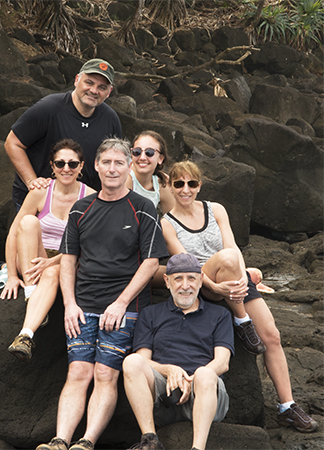
 This is the first blog-category that I’ve featured people in 4 of the 5 posts. Am I just getting old? I think it’s more about having featured the locations in previous Kaua’i posts and it’s natural to focus on the people. (L to R – Dom, Rose, Derrick, Alyssa, Mary, Mario. And none of the men are wearing sun-glasses.)
This is the first blog-category that I’ve featured people in 4 of the 5 posts. Am I just getting old? I think it’s more about having featured the locations in previous Kaua’i posts and it’s natural to focus on the people. (L to R – Dom, Rose, Derrick, Alyssa, Mary, Mario. And none of the men are wearing sun-glasses.)
The Queen’s Bath always attracts the strange and stupid. This morning there was a family with 4 kids and a puppy. The kids were running over the black-lava rocks barefoot; the poor puppy had to make his way around the pools, over the boulders with no one near to help or guide him. The parents were huddle together looking at an iPhone oblivious of their kids, of their pet; they laughed together at some inane item on the device as their kids roamed all over the rocks. The imbecile award goes to another family who came down with snorkel equipment and pride in their stupidity. The ocean screamed danger, but they were pissed at the suggestion that it wasn’t safe to go down to the water. I insisted we leave, because I wasn’t interested in watching someone drown. The Queen’s Bath is infamous for the number of people who have drowned off its cliffs. The location is so remote, that any rescue effort is find the body.

 We began the day hiking the Kalalau Trail one mile up and into jungle. The trail-head is at Ke’e Beach and after our hike, we sat on the beach for a couple of hours. This is one of my favorite beaches, because the Na Pali Coast is right there and the barrier reef keeps the waves back, creating an amazing swimmable area. The beach also offers me the option of staying out of the sun. The section between the parking lot and the beach is shaded by hundreds of ironwood pines.
We began the day hiking the Kalalau Trail one mile up and into jungle. The trail-head is at Ke’e Beach and after our hike, we sat on the beach for a couple of hours. This is one of my favorite beaches, because the Na Pali Coast is right there and the barrier reef keeps the waves back, creating an amazing swimmable area. The beach also offers me the option of staying out of the sun. The section between the parking lot and the beach is shaded by hundreds of ironwood pines.
In the above image – L to R – Mary, Derrick, Rose. The adult had gone walking and after a long trek down the length of the beach we headed back.
The hike up the into the mountains that are the Na Pali Coast is strenuous, but the look-outs make it worth the effort. Looking down on Ke’e Beach from the quarter-mile marker and seeing the reef, the still pools, the undulating coast-line is mesmerizing. Periwinkle, azure, cerulean, turquoise, cobalt, denim – are all there in one pallet. How is it that the Pacific can produce such variants in one location? I’ve never seen these shades of blue in the Atlantic or the Mediterranean.
Because of last night’s downpour, the trail was wet and more difficult. I spent most of the climb stepping with my hikers side-ways to minimize slipping and falling on my ass. This time I also brought no cameras. The last time we did the trail I was carrying two cameras. (Talk about a stupid idea.) The only thing I can say is, ignorance is not a great planner. This time knowing what to expect, all I carried was a water-bottle.
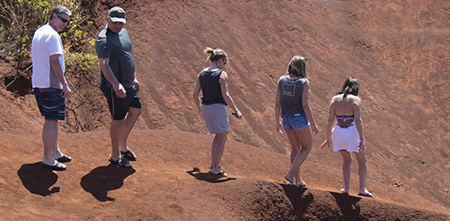
 Today we headed south to Waimea. The drive up to the canyon is always a surprise to people who do it for the first time. (This was my 4th trip up the mountain.) The stream is one of my favorite locations on the ride up. The red soil surrounding the stream really does look extra-terrestrial. It’s hard to believe that the black lava-rocks disintegrate to red soil. And I have no understanding of why the banks of the stream have no vegetation. (L to R – Derrick, Dom, Mary, Alyssa, Rose)
Today we headed south to Waimea. The drive up to the canyon is always a surprise to people who do it for the first time. (This was my 4th trip up the mountain.) The stream is one of my favorite locations on the ride up. The red soil surrounding the stream really does look extra-terrestrial. It’s hard to believe that the black lava-rocks disintegrate to red soil. And I have no understanding of why the banks of the stream have no vegetation. (L to R – Derrick, Dom, Mary, Alyssa, Rose)
At the first overlook, we could see the canyon and two waterfalls; at the second overlook, the one facing the ocean, the mist was so dense you could see nothing. We turned around and headed back down to Waimea. There’s a taco hut calling our names.
We always stop at the Taco Place for lunch and I always get a vegetarian taco. It’s a deep fried taco shell filled with fresh veggies.
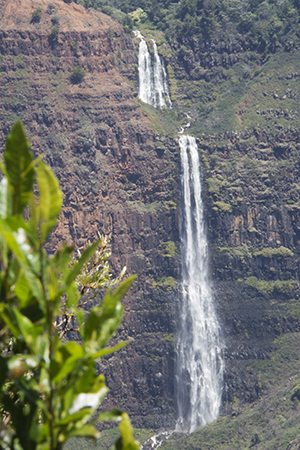
 I don’t remember seeing this full of a waterfall on any of the other visits to the canyon. But then there have been a lot of clouds this week and we had a major rainstorm Tuesday night.
I don’t remember seeing this full of a waterfall on any of the other visits to the canyon. But then there have been a lot of clouds this week and we had a major rainstorm Tuesday night.
The falls are on the opposite side of the canyon. We are standing at the lowest overlook facing into the canyon. The other overlooks are on the same side, but to the left and around the side of the cliff, facing the open chasm and the blue, blue Pacific.
The ride down is very disorientating and can feel like sea-sickness – nausea and headache. But lunch settled all stomachs and we proceeded down to Poipu Beach. This is the land of the true tourists; locals are absent and the place reeks of money. (There are million dollar homes with no property, built against the black rocks of the shoreline. But they have a million dollar view of the setting sun.) The appeal of the south is the sun and the tourists. Locals do not live in the Poipu area; they come in to clean and at the end of their shifts leave by bus. All the major hotel chains are down here and the Grand Hyatt is the Vatican of 20th century American consumerism. It’s grand lobby and multi pools celebrate American excess. The complex is as grand as any of the robber-baron mansions of Newport. The difference is that it won’t last, because after all it’s all prefab cheap construction make to look like a Frank Lloyd Wright prairie house.
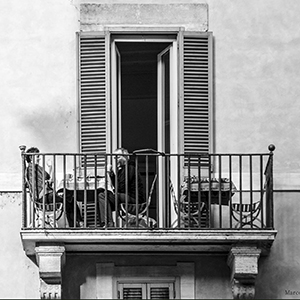
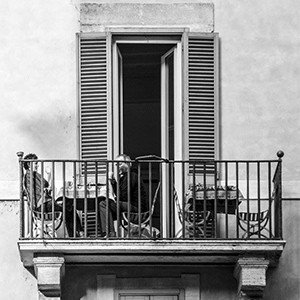 Marco Passaro posted the image on the italian-street-photography FB page. The image was shot in Rome near the Pantheon. Here, in Western Pennsylvania, the mornings are still too dim and too chilly to sit outside and have breakfast. (One of the things I like best about Kaua’i in March, is having breakfast on the lanai and watching the eastern sky turn blue with the sunrise.)
Marco Passaro posted the image on the italian-street-photography FB page. The image was shot in Rome near the Pantheon. Here, in Western Pennsylvania, the mornings are still too dim and too chilly to sit outside and have breakfast. (One of the things I like best about Kaua’i in March, is having breakfast on the lanai and watching the eastern sky turn blue with the sunrise.)
And even though we’ve had a mild winter and I have put the rose-bush and the rosemary outside, the weather is still variable. Denver had a mild spring day on Tuesday and a severe, blinding snow-storm yesterday. Patterns here show that March 17 seems to be dividing line between winter and spring weather.
I’ve always wanted to go to Italy in late-spring/early-summer mainly to see the country-side in bloom and to sit on a balcony and drink my espresso and eat my Nutella filled cornetto as the sun warms the sky.

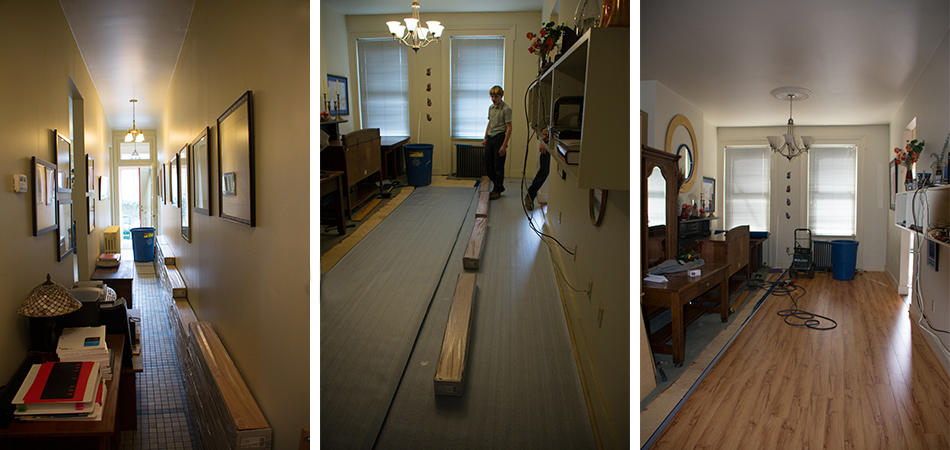 After many years, I’m replacing the abused carpet in the downstairs large-room with a laminate wood-floor.
After many years, I’m replacing the abused carpet in the downstairs large-room with a laminate wood-floor.
Spent yesterday emptying out the bookshelves, the side-board, the coat-closets and this morning moving the TV/cable table and the computer/printer table into the hall. And where I liked the color of the carpet that was down, it had been terribly abused by the 8 dogs we’ve had over the years. And given its light color, it did not do well in this high-trafficked room.
This morning, I had to figure out how to lay the flooring-planks and I decided to have them run north/south – the direction of the room. I also figured that it would make the room seem longer if the eye went north/south when looking down at the flooring. An Amish family from north-east Ohio is doing the installation. The young man in the image on the left is bringing in the planks and laying them down as they will be installed. The planks are floated on top of a padding. No nails or mastic are used to secure the new flooring onto the old joists.

 In 1950’s Calabria, elementary-school students wore black smocks, white collars and colored bows. The color indicated the grade-level. (In modern times, the smocks have become light-blue. U G L Y!)
In 1950’s Calabria, elementary-school students wore black smocks, white collars and colored bows. The color indicated the grade-level. (In modern times, the smocks have become light-blue. U G L Y!)
There’s actually a picture of my 3rd class in Aprigliano, me in my smock and collar and bow.; I just can’t find it. (I sent my friend from back then – Franco Ciaccio – a FB message asking if he has a copy of the pic.)
 The school was on the second floor of a local house just around the corner from where we lived. There were only two classes and they were across the hall from each other. Back then, like in so many other small towns in Calabria, there were enough kids to warrant having these small, two-room schools. It was also after the war, and new construction, new schools weren’t affordable. (I remember the teacher showing us a film-clip imploring its audience to not go near anything that looked like a grenade or bomb. The Germans had left many live land-mines throughout rural Italy and the government wanted kids to stay away from such dangerous war relics.)
The school was on the second floor of a local house just around the corner from where we lived. There were only two classes and they were across the hall from each other. Back then, like in so many other small towns in Calabria, there were enough kids to warrant having these small, two-room schools. It was also after the war, and new construction, new schools weren’t affordable. (I remember the teacher showing us a film-clip imploring its audience to not go near anything that looked like a grenade or bomb. The Germans had left many live land-mines throughout rural Italy and the government wanted kids to stay away from such dangerous war relics.)
Withing ten years, Calabria would be empty, its people leaving, in droves, for Canada, Argentina and Australia. The one and two room school-houses would be consolidated into regional schools.
The picture on the right is me in August of 2006 in front of the school-house door. The B&W image is from the FB page Calabria Ieri e Oggi.


The modern name for Golfo di Sibari is Golfo di Corigliano and it it part of the huge Gulf of Taranto – the body of water between the spur of Puglia and the eastern coast of northern Calabria. Franco shot the image from the hill-town of Albidona. Under the dense clouds are the golf waters.
What I like best about the image are the telephone/electrical poles and wires at the edge of the green. The poles and wires put a human dimension into a surreal landscape.
The motivation for the post is the experience of mixing cold and hot. In north-eastern Calabria, the mixture produced a cloud-blanket over the warm waters. In south-western Pennsylvania the contradiction left us freezing and full of fear that winter hadn’t lost its bite. Last week it was so warm I took the pots of roses and rosemary out into the garden to soak in the sun. But withing 3 days I had to haul them back in, because snow and freezing cold had vanquished the warmth. (I know it’s a last hurrah, but MAN is it depressing.)

 It will take some time to get the back-yard all planted and re-organized. I bought a Red Haven peach tree and will plant it tomorrow along the garage wall on the eastern side of the yard. The research said it was the best variety for this region. It will be nice to go out and pick a peach off a tree.
It will take some time to get the back-yard all planted and re-organized. I bought a Red Haven peach tree and will plant it tomorrow along the garage wall on the eastern side of the yard. The research said it was the best variety for this region. It will be nice to go out and pick a peach off a tree.
The other great development is the wisteria – there are blooms all over the long trellis. That is a shock and I’m being accused of reacting to the prospect of a flowering wisteria like an old immigrant. BTW, I am an old immigrant.

 Two years ago, I cut the blueberries down to ground level and this year there will be a bumper crop. (The cutting came about, because the plants were producing little to no fruit. And after some research found that the remedy was to cut them down and let them re-grow.) The candles on the conifer are always beautiful. The wisteria is a total surprise. I thought that it would take years before the plant was ready to shoot out flowers. Clapping for genetically modified intervention. The lilies-of-the-valley take up a whole corner of the back-yard and I love the smell these tiny bells give off.
Two years ago, I cut the blueberries down to ground level and this year there will be a bumper crop. (The cutting came about, because the plants were producing little to no fruit. And after some research found that the remedy was to cut them down and let them re-grow.) The candles on the conifer are always beautiful. The wisteria is a total surprise. I thought that it would take years before the plant was ready to shoot out flowers. Clapping for genetically modified intervention. The lilies-of-the-valley take up a whole corner of the back-yard and I love the smell these tiny bells give off.
Today is my parents’ 68th wedding anniversary. April 1948 was an unusual time in Calabria. The aftermath of World War II hung over this rugged, poor land. My grandfather would tell the story of the American soldiers marching down Strada Statale – the main thoroughfare through Aprigliano.
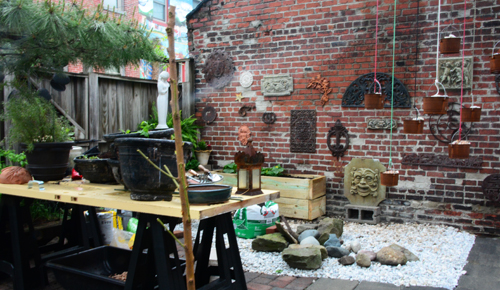
 Had thought that after buying the 3 large, plastic pots, I was finished with buying new containers and that I could look forward to growing vegetables along with the flowers. But the large pots were the worst. They didn’t drain, even though I had filled the bottoms with shards of the terra-cotta. One was so bad that the whole pot became water logged. I had to break the bottom tray to get the water to seep out and even then drainage was so poor that the soil stayed wet throughout the whole growing season. Well at least I now know why the vegetables did so badly last year. My plan was to re-fill the plastic pots with new soil and to replace the shards with stone. When I did that, I discovered that they were all cracked. After some consideration, I decided to replace the pots with a planter. The planter would also give me added room to grow a few more vegetables.
Had thought that after buying the 3 large, plastic pots, I was finished with buying new containers and that I could look forward to growing vegetables along with the flowers. But the large pots were the worst. They didn’t drain, even though I had filled the bottoms with shards of the terra-cotta. One was so bad that the whole pot became water logged. I had to break the bottom tray to get the water to seep out and even then drainage was so poor that the soil stayed wet throughout the whole growing season. Well at least I now know why the vegetables did so badly last year. My plan was to re-fill the plastic pots with new soil and to replace the shards with stone. When I did that, I discovered that they were all cracked. After some consideration, I decided to replace the pots with a planter. The planter would also give me added room to grow a few more vegetables.
This year, I’m growing cucumbers. (The green leaves in the wolmanized planter against the wall.) The hybrid plants will produce fruit throughout the season and I love cucumbers from the vine. A very different vegetable than the wax covered, tasteless things one buys at the grocery store. I’m also adding chives this year. These I will use too. The other big step was to not grow basil. I never used enough of it and once the stalks turned wooden, the leaves would be bitter.
The narrow trunk in the foreground is the new Redhaven peach tree. This purchase started, because I wanted a white dogwood to plant in front of the brick-wall. I had pictures in my head of white blossoms against the red bricks. But a Calabrian immigrant can’t plant for ornamentation; it’s against our DNA. So, I did some research on the best fruit-trees for this region and came up with a dwarf Redhaven peach. It will put out blossoms and give me tree-ripened peaches.
The contraption behind the peach tree is my old kitchen door in two saw-horses. It’s a great work area, minimizing bending and lifting. At the edge is a rusted, old lantern that I want to restore and repaint.
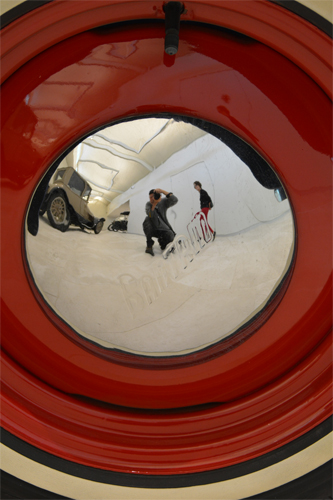
 Yesterday, Sarah and I went to the Frick to see the photographs of Jacques Henri Lartigue – The privileged, younger son in a wealthy, glamorous French family, Jacques-Henri Lartigue (1894–1986) was a first-hand witness to the amusements and pleasures of life in the Belle-Époque and early-20th century France. The title of the show is Fast Cars and Femmes Fatales. (Isn’t the alliteration great – the f’s, the a’s and the t’s?)
Yesterday, Sarah and I went to the Frick to see the photographs of Jacques Henri Lartigue – The privileged, younger son in a wealthy, glamorous French family, Jacques-Henri Lartigue (1894–1986) was a first-hand witness to the amusements and pleasures of life in the Belle-Époque and early-20th century France. The title of the show is Fast Cars and Femmes Fatales. (Isn’t the alliteration great – the f’s, the a’s and the t’s?)
It’s always both amazing and a surprise to see how the one-percenters of early-20th century Europe lived. The women in yards and yards of silk and satin, their exaggerated hats and their frou-frou dogs; the men in their Spats, fur-lined over-coats, their fedoras, their cigarettes.
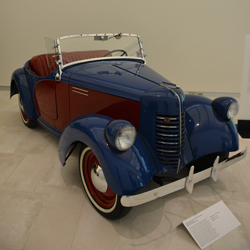 Afterwards we went to see the new space that houses the Frick’s collection of antique cars. The image on the left is our reflection in the hub-cap of a 1939 Bantam Roadster; and the image on the right is the car. The coupe was built in Butler by the American Bantam Company. With the coming of WWII, the car was adapted for use as a reconnaissance vehicle, making it the first jeep prototype.
Afterwards we went to see the new space that houses the Frick’s collection of antique cars. The image on the left is our reflection in the hub-cap of a 1939 Bantam Roadster; and the image on the right is the car. The coupe was built in Butler by the American Bantam Company. With the coming of WWII, the car was adapted for use as a reconnaissance vehicle, making it the first jeep prototype.
The first image in the above slide-show, is the hood-ornament on the Bantam Roadster.


Rose claims that in the Lartigue photo, I’m the old man snoring, she’s the one shelling the Romano beans and Derrick is the person on the floor. My contribution was to add the Empty-chair character and to note that the two women shelling both have erratic hair.
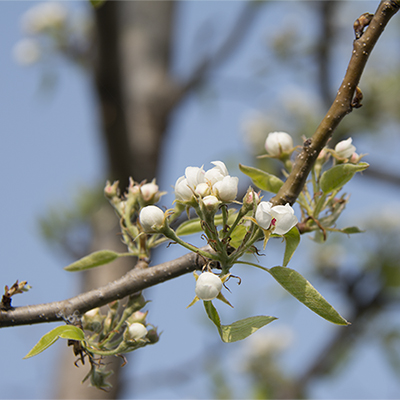
 I am up in Northern Ontario and on the 19th of May, I found apple-blossoms that are getting ready to open – AMAZING. Earlier today, in Oakville, I was surprised to find that the dandelions had all gone to seed and here I am some 250 miles north of Oakville and the dandelions are just in bloom. Where Oakville is two-and-a-half weeks behind Pittsburgh, Sault Ste Marie is easily three-and-a-half weeks behind us in Western Pennsylvania.
I am up in Northern Ontario and on the 19th of May, I found apple-blossoms that are getting ready to open – AMAZING. Earlier today, in Oakville, I was surprised to find that the dandelions had all gone to seed and here I am some 250 miles north of Oakville and the dandelions are just in bloom. Where Oakville is two-and-a-half weeks behind Pittsburgh, Sault Ste Marie is easily three-and-a-half weeks behind us in Western Pennsylvania.
The blossoms are on my dad’s trees in his back-yard.
This is my first time flying up in at least 20 years. And I think it’s going to continue. Combining the Toronto trip and the Sault Ste Marie trip was an inspiration. Last night, I visited with my cousins, when I go back I’m visiting with Frank-and-Norma, helping Joe plant his back-yard and going to dinner with Dave-and-Seane. In the past I would have done two separate trips. It’s nice to drive only to Toronto and then fly up to visit with my parents. (The two day car trip from Pittsburgh to Sault Ste Marie is now a thing of the past.)
14.5 hours of sunlight in Pittsburgh

 I took a walk to my aunt-and-uncle’s and along the way, shot every spring flower I found. I’m here at a great time – all the blossoms are on the cusp, the lawns are yellow with dandelions. A sense of hope and new-life is everywhere. (I’ve always wanted to be in Italy for spring. I want to shoot poppies in the wheat fields; eat fresh fava with old priscuitto.) In industrial Sault Ste Marie, spring disguises the dirt, the deteriorating housing stock, a west-end neighborhood full of old people.
I took a walk to my aunt-and-uncle’s and along the way, shot every spring flower I found. I’m here at a great time – all the blossoms are on the cusp, the lawns are yellow with dandelions. A sense of hope and new-life is everywhere. (I’ve always wanted to be in Italy for spring. I want to shoot poppies in the wheat fields; eat fresh fava with old priscuitto.) In industrial Sault Ste Marie, spring disguises the dirt, the deteriorating housing stock, a west-end neighborhood full of old people.
The walk took me through streets full of memories – the recurring one is of the old sub-basement church that was St. Gregory’s. I remember walking there in the winter; we were still living at my grandparents’ and I would walk over on Saturday night to go to confession. (Talk about a long time ago and a ritual that no longer exists.)
My dad’s garden is the opposite of my uncle’s. Where Ciccio is ambiguous with his environment, Milio is exact and methodical. My father’s garden has randomness built into it; my uncle’s garden is laid out in precise, even rows. The roof of my father’s greenhouse is covered in moss; shiny glass panels front and roof my uncle’s greenhouse. (My uncle is able to grow primrose; he has several beautiful clusters that come back year-after-year. I’ve had no luck with spring primrose.)
Lunch today is gnocchi, deep-fried chicken from some fast-food place, and rapini. I complained to my mother that the chicken is full of salt, but the warning went in one ear and out the other. (I can’t figure out if buying deep-fried chicken is a convenience or a gesture to the idea that they are not hide-bound to old immigrant traditions.)
14 hours 36 minutes of sunlight in Pittsburgh
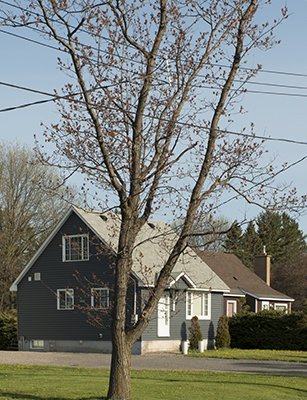
 The title – vernacular – is a favorite word of mine. However, it’s always been difficult to apply it to anything other than the switching of the Catholic Mass from the universal Latin to the local language. This mental block comes specifically because I was raised Catholic and can remember Vatican II and the switch – the altar moved so that the priest faced the congregation and the old Latin became English. But my non-Catholic friends have always used the term to refer to the architectural designs common in an area. And I like applying the term to housing design. The house in the image is a typical 1920’s/1930’s frame structure here in Northern Ontario. It resembles in form, what we in the US, would call Cape Cod style. (I remember seeing similar house in the beach communities around Narragansett. John’s family summer cottage looked a lot like the house in the picture, just smaller and with no basement.) The alterations, to the typical New England cottage design, are mainly in the steeper roof pitch – understandable given the northern climate and the snow-bound winters and in the addition of a basement lifting it off the ground, off a ground that can stays frozen 5 months of the year.
The title – vernacular – is a favorite word of mine. However, it’s always been difficult to apply it to anything other than the switching of the Catholic Mass from the universal Latin to the local language. This mental block comes specifically because I was raised Catholic and can remember Vatican II and the switch – the altar moved so that the priest faced the congregation and the old Latin became English. But my non-Catholic friends have always used the term to refer to the architectural designs common in an area. And I like applying the term to housing design. The house in the image is a typical 1920’s/1930’s frame structure here in Northern Ontario. It resembles in form, what we in the US, would call Cape Cod style. (I remember seeing similar house in the beach communities around Narragansett. John’s family summer cottage looked a lot like the house in the picture, just smaller and with no basement.) The alterations, to the typical New England cottage design, are mainly in the steeper roof pitch – understandable given the northern climate and the snow-bound winters and in the addition of a basement lifting it off the ground, off a ground that can stays frozen 5 months of the year.
Without a car, I’ve been walking everywhere and this morning I headed west and into the subdivisions on the other side of Goulais Avenue. I had never walked in this area before and it was wonderful to discover a neighborhood full of old houses that have been maintained, upgraded, but not fractured. (The house in the image does not have its front steps, but the pylons are there to support them once they are installed. Let’s hope that they don’t use wolmanized or pre-fab materials.)
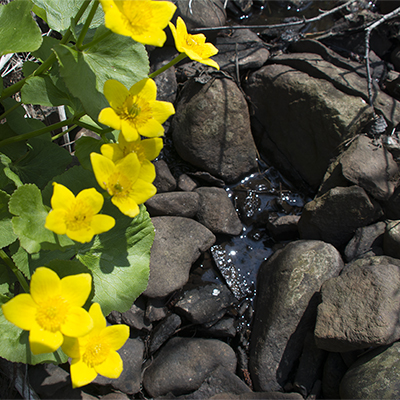
 The last two times I was up here in the spring, I shot these beautiful yellow flowers that lined the ditches and covered the bogs in and around Connie-and-Ron’s cottage. Connie has transplanted a bunch of the plants from the boggy back-lot across the street to the banks of the drainage-ditch on the north-side of the property. The plant is also know as Caltha cowslip and kingscup.
The last two times I was up here in the spring, I shot these beautiful yellow flowers that lined the ditches and covered the bogs in and around Connie-and-Ron’s cottage. Connie has transplanted a bunch of the plants from the boggy back-lot across the street to the banks of the drainage-ditch on the north-side of the property. The plant is also know as Caltha cowslip and kingscup.
Naming this plant turned out to be easier than I had expected. I went to Google-Images and once I found something that looked like the plant, I was able to trace it back to a name and a genus. (This is not a plant I remember from when I was living here, but then looking at spring flowers or shooting them weren’t things I was doing or interested in. Never mind the fact that I went no where near bogs or ditches. These wet-areas were reminders of winter, reminders that we were living in a non-urban landscape and therefore undesirable. And let’s not forget, that the ditches, the stagnant waters were mosquito breeding-tanks.)
The long Victoria Day weekend is the traditional time to go out and open the cottages that line the shorelines of this norther community. The weather is cool; the land has lost its winter moisture; and the trees are full of blossoms and sap. It’s a great time to be out in the woods. The evergreens on Connie-and-Ron’s property are now mature and provide a wonderful canopy. Connie was putting in annuals and trying to rake-up all the twigs and dead branches winter left behind.

 The wisteria is planted in the worst soil, in the most inhospitable spot and yet in its second year it bloomed. There are more than a dozen flower-clusters and the bumblebees love them. They climb right into the flower, almost disappearing into its cup-shaped petals.
The wisteria is planted in the worst soil, in the most inhospitable spot and yet in its second year it bloomed. There are more than a dozen flower-clusters and the bumblebees love them. They climb right into the flower, almost disappearing into its cup-shaped petals.
I spent some time tying the new growth down so that it didn’t look like wild green hair sprouting from the top of the fence post. I want to grow the vine all the way down the lateral beam keeping it long rather than thick. And I suspect it was that pruning and shaping that I did last year that produced the flowers; that and the genetically modified plant the company shipped. (Years ago when we planted a wisteria at Rick-and-Sarah’s the literature all said that it would take 7 years before the plant produced flowers. Research also pointed out that the plant produced blooms when it determined that it was in danger – poor soil, bad environment. I remember thinking that I could plant it in the concrete, in the corner near the alley between my house and the neighbor’s.)
The genetically altered plant ended up in the north-east corner, because the grape-vine I had there needed extra care to produce grapes. (I wasn’t willing to introduce the insecticides needed to keep the grapes from falling off the cluster.) It took almost 3 years to get rid of the grape-vine. When I planted the wisteria, I was expecting a vine that would cover the long two-by-four that straddles the top of the fence. By the end of last year’s growing season, the vine was half-way across the back-yard. It gave the top of the fence an added dimension. I liked it.
I’ve been recording the daylight in Sault Ste Marie, because I finally figured out why my dad and his fellow immigrants are able to grow vegetables in such a short growing season. The answer is the amount of daylight. Down here we have the temperatures, up there the cold lingers, but once the daylight comes it stays. They get almost an hour more of daylight than we do down here in Western Pennsylvania.
15 hours 26 minutes of sunlight in Sault Ste Marie
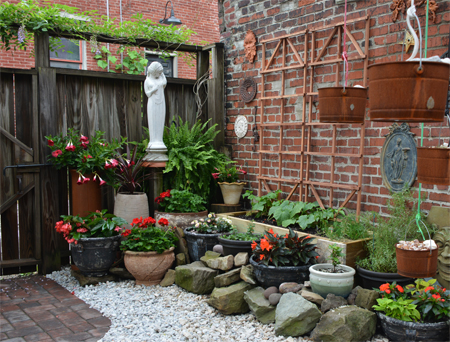
 For the last two years, I’ve been working on creating a number of set-pieces that would only require annuals to fill the various pots. Last year I purchased what I thought would be the last set of pots – 3 large, plastic things that I imagined would last and in which I would plant vegetables. They were a disaster – drainage was so bad that for most of the growing season they were filled with water. My only option was to break the trays at the bottom and even then the soil never got dry. This year, I replaced the cheap pots with a planter I built out of wolmanized. OK, that wasn’t too bad, I now had a decent sized vegetable-bed. But then I discovered I needed another pot to fill the space where the bird-bath was. (Birds never came to take a bath. And, it was either block/fill the space or have the dogs sneak in behind the pots and rocks.)
For the last two years, I’ve been working on creating a number of set-pieces that would only require annuals to fill the various pots. Last year I purchased what I thought would be the last set of pots – 3 large, plastic things that I imagined would last and in which I would plant vegetables. They were a disaster – drainage was so bad that for most of the growing season they were filled with water. My only option was to break the trays at the bottom and even then the soil never got dry. This year, I replaced the cheap pots with a planter I built out of wolmanized. OK, that wasn’t too bad, I now had a decent sized vegetable-bed. But then I discovered I needed another pot to fill the space where the bird-bath was. (Birds never came to take a bath. And, it was either block/fill the space or have the dogs sneak in behind the pots and rocks.)
This morning, I set out for Lowe’s, Home Depot and the various North Hills greenhouses looking to find something that would block/fill the space. I found this amazingly tall pot at Brenckle’s Greenhouses and there sitting on the concrete next to it was a large Mandevilla. I checked that the plant fit into the tall pot and it did. I walked out and headed home. No need to do any more shopping.
The title refers to the items in the back-row – red Mandevilla in the tall bronze pot, a Cordyline Red Star Spike, an Alfonso Ianelli garden sprite and a large fern. The twisty vine above the fern is the wisteria coming up from its bed in the corner.
15 hours 31 minutes of sunlight in Sault Ste Marie

 I keep reminding myself that temperature is not the most important variable in determining agrarian yield. In Harrow it’s its geographical location. The severe weather goes around the Southwestern Ontario peninsula; winter weather skirts the area and dumps its snows on London and Cleveland. In Sault Ste Marie it’s its latitude. Toady, the Sault had 45 more minutes of daylight than Pittsburgh. In Northern Ontario, daylight is the critical variable during a short growing season.
I keep reminding myself that temperature is not the most important variable in determining agrarian yield. In Harrow it’s its geographical location. The severe weather goes around the Southwestern Ontario peninsula; winter weather skirts the area and dumps its snows on London and Cleveland. In Sault Ste Marie it’s its latitude. Toady, the Sault had 45 more minutes of daylight than Pittsburgh. In Northern Ontario, daylight is the critical variable during a short growing season.
This is the first post in the zinga.photos domain.


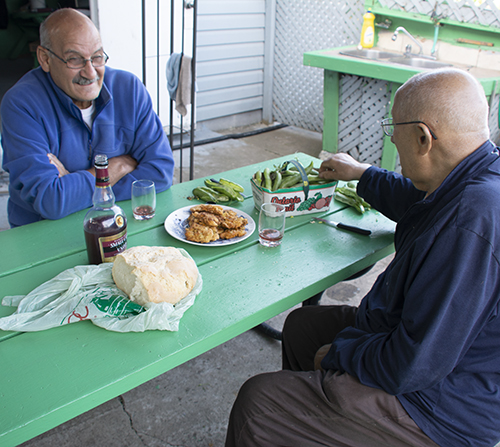
Yesterday, I drove to Toronto, parked the car at Dave’s, took a cab to City Island and got on a plane to Sault Ste Marie. (So much easier than the two-day drive.) By 5:30, I was sitting in my parents’ house having supper.
This morning, I look out the window and there are Ciccio and Dominic, at the backyard picnic-table, having breakfast – fave, wine, home-made bread and zucchini-flower fritters. It was 7:00 am. I walked out with my espresso to eat some fave and a couple of fritters. (Ciccio made the fritters without salt. Not recommended. And, I like my fave cooked; they are bitter, raw.)
When I mentioned that in the spring, online there were images of Italians eating fave, bread and drinking wine for breakfast, my dad said that in Calabria the fave were ready for the feast of St. Michael in early May. Whoa! that is two months earlier than here in Northern Ontario.
I didn’t visit long; it was in the low-sixties and I had on a tee and shorts.

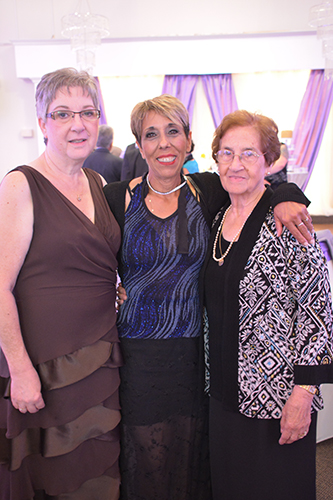
Last night, Connie, Ron and I went to the reception for Lily and Michael – Marisa’s son and daughter-in-law. Lily and Michael live in Taiwan, and were married last year. This is their first trip back to Sault Ste Marie and Michael’s parents had a reception for the newlyweds.
The image is Marisa, Connie and Marisa’s mom – Commare Amalia. Connie and Marisa are old friends, they grew up and got in trouble together. Commare Amalia and Mafalda grew up together in Aprigliano and have maintained their close friendship all there years.
It was nice to see people that I haven’t seen in years. Guido Caputo, a guy I went to high-school with, came over and said hello and Ugo Le Pera, a guy i grew up with in Aprigliano, also came over to visit and chat. Had I met either of them on the street, I would never have recognized them. I also got to visit with Lina Fragomeni (née Musso) and with Franca Caputo (née Pedatello). The Musso family and my Dad were very close; they came from the same parish in Aprigliano; and back in the 1960’s the two families spent a lot of time together. The Pedatello family lived across the street. Emilio Pedatello designed, built and installed the modern looking cupboards in my parents’ upstairs kitchen.

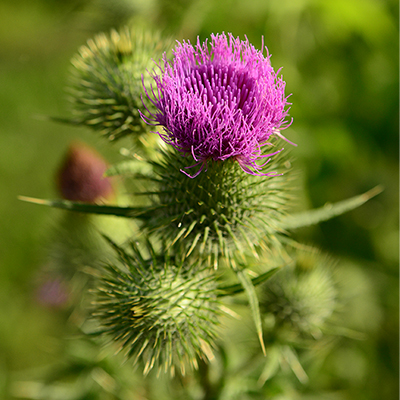
 This morning, on my walk to my aunt-and-uncle’s, I wanted to see how the vegetation changed since mid-May. The blossoms are all gone; it’s the transition between the summer and fall flowers.
This morning, on my walk to my aunt-and-uncle’s, I wanted to see how the vegetation changed since mid-May. The blossoms are all gone; it’s the transition between the summer and fall flowers.
Thistle-like, common Burdock is pretty to shoot, I like the spiky purple flower, but a miserable plant to interact with. I remember getting the green burrs on my clothes and spending time yanking and cutting them off. Its only redeeming quality is that the flowers provide pollen and nectar for honeybees when clover is on the wane and goldenrod is still thinking of blooming.
Already, the wild-grass is turning yellow and the unwanted, fast-growing, summer weeds are taking over. They sprout from cracks in driveways and sidewalks; they invade the weed-free gardens and the edges of flower-beds. (My mother laments the Canadian ban of Roundup; my uncle and father spend extra time weeding.) Where spring made everything look clean and fresh, the mid-summer weeds remind all of the coming cold. The frost-free growing season at this latitude is about 130 days. They could have their first frost as early as mid-September. In contrast, Pittsburgh has 171 frost-free days and the first frost is postponed until late-October.
It took a lot of searching to find the common Burdock; it was similar to the work I did to find the marsh-merigolds. In both instances it was fun to finally put a name and information to plants that I’ve seen all my life.

 The most surprising and at times disturbing aspect of visiting this far north is seeing flowers that in more southern climates thrive and fill pots and gardens here look defective, stunted and out of place. The geraniums are especially stunted. Begonias, petunias and impatience grow scrawny or are totally missing from the landscape. But then dahlias and clematis do amazing well. It’s cold nights and warm soil these renegades need and that combination is here in spades. Also, Gold-yarrow and Burdock are everywhere.
The most surprising and at times disturbing aspect of visiting this far north is seeing flowers that in more southern climates thrive and fill pots and gardens here look defective, stunted and out of place. The geraniums are especially stunted. Begonias, petunias and impatience grow scrawny or are totally missing from the landscape. But then dahlias and clematis do amazing well. It’s cold nights and warm soil these renegades need and that combination is here in spades. Also, Gold-yarrow and Burdock are everywhere.
I think the pervasiveness of warm-climate plants and southern housing structures makes the environment contrary. The plants that thrive here – Dandelions, Burdock, Yarrow – are all designated as undesirable and worthy of extermination. Home-owners are encouraged to buy the mass-produced, genetically modified annuals stocked by Home Depot, Walmart and every other discount chain that has invaded the landscape. The idea that native plants can make beautiful gardens and beautiful flower-beds is totally missing. Just like the idea that steep-roofed, easily heated homes work best this far north.
At one time Mother Church controlled the message – you spoke Polish, too bad, the Mass is in Latin. In modern times, corporations decide what we wear, what we eat, what we grow, where we live, how we live. And their vision, just like that of Mother Church, is focused on conformity, standardization and sameness. Best for control, the quarterly-report, the bottom-line.

 Connie and I are driving up to the cottage at Red Rock and there in the middle of the road is a Black-bear. Holy Shit!! Connie thought it was great; I thought, let’s get out of here NOW. I did manage to pull the camera out and get a few shots. It looked like a young cub recently weaned and not a full-grown adult. Thank god for small favors.
Connie and I are driving up to the cottage at Red Rock and there in the middle of the road is a Black-bear. Holy Shit!! Connie thought it was great; I thought, let’s get out of here NOW. I did manage to pull the camera out and get a few shots. It looked like a young cub recently weaned and not a full-grown adult. Thank god for small favors.
In all the years I’ve been coming up here, this is my first bear-sighting. It came as we were talking about the practice of people already living in this isolated, Northern Ontario, wilderness community buying cottages to escape the urban landscape that is the small town of Sault Ste Marie, population 75,000. Having a lake-side cottage, here known as a camp, is very common. Joe Sanguinetti and I laugh. They already live in the middle of the woods, why do they need a camp a bit of an overkill, No?
Connie also mentioned how much work it is to maintain two homes. I laughed; thinking how ingrained the idea of a camp is for people up here. The whole time we were growing up, we badgered our parents to buy a camp. Mafalda claimed she had spent enough time in the wilderness helping my grandfather tend his flock in La Sila. And Cicio was busy making a living and building a house to listen to us preteen, Canadian wannabes.


This morning I walked the neighborhood south of Wallace Terrace. When I was living here back in the early 60s, it was full of Polish immigrants. The elementary school in the neighborhood was St. Stanislaus. Like St. Veronica’s, the grammar school Frank, Ron and I went to, is was made over in the 1970’s with a new skin and modern lines and like St. Veronica’s the building is now abandoned and graffiti covered. The thousands that filled these Catholic schools have all left. (In the 1970s the Soo reached 90,000. But when the steel industry went to China and South America, the immigrants stopped coming and the population dropped to 75,000. It has never seen an increase again.)
I don’t remember walking these streets before. Back then, there was no reason to go below Wallace Terrace. We had our neighborhood and they had theirs. The only Polish person I knew from this part of town – Jerry Obierski – I met in high-school.
Today the area is a mix of old Italians and Polish Canadians and families who have fallen through the social safety-net. The houses in the above image are almost derelict, but still have people living in them. They are across from mill Gate #3. It’s the Canadian version of the left-over, 1940’s mill-towns that dot the Western Pennsylvania landscape.

 Back in the late Fifties and Sixties, the steel-mill the Plant was a source of pride for those of us living in this Northern Ontario town. A job in the mill guaranteed a great income; a job in the mill meant you and your family had access to the Algoma Steel Health Clinic – free doctors, free health care, free prescriptions. Calabrian immigrants flocked to Sault Ste Marie to work in the steel-mill, the Abitibi Paper-mill, the Algoma Central Railroad, the Weyerhaeuser Lumber-mill.
Back in the late Fifties and Sixties, the steel-mill the Plant was a source of pride for those of us living in this Northern Ontario town. A job in the mill guaranteed a great income; a job in the mill meant you and your family had access to the Algoma Steel Health Clinic – free doctors, free health care, free prescriptions. Calabrian immigrants flocked to Sault Ste Marie to work in the steel-mill, the Abitibi Paper-mill, the Algoma Central Railroad, the Weyerhaeuser Lumber-mill.
Going from high-school to the mill was an acceptable career path. For those of us heading to Southern Ontario for university, the mill was a great place to work during the summers. Frank worked at the Plant for over 4 summers, plus a 7-month stint from January to August of 1974. He claims, that the coke ovens and the blast furnaces have left an indelible mark on my mind. We could make enough money between May and August to cover the next year’s tuition, room-and-board, books and spending money.
I worked at the Plant the summer of 1970. My first assignment was on a steel-coil conveyor-belt. The red-hot coils came down the belt and a full-time worker and I put a band around the coil. You banded 10 coils and took a rest. I liked this assignment; it had a specific task and you did that task for 8 hours. The second assignment was in the Cold Mill. When we got there, for our 11 to 7 shift, the foreman told us to go find a place a sleep and to come back in time to punch out. I hated working in the Cold Mill. There was no way I could fall asleep on some bench in the middle of a warehouse. The third assignment that summer was at the blast-furnace. I worked with my uncle and my neighbor from across the street. The university guys moved the scarred bricks, lining the sides of the furnace, out and then handed new refractory-bricks to the brickworkers as they relined the sides. The old guys loved to mock us snots, after all we were never gonna get to feel the 3500-degree heat of hell on our faces. 1
In the Eighties and Nineties, a new reality hit – cancer was ravaging the mill-workers, young people were being laid-off in droves, the summer jobs dried up and the town’s economy went into a tail-spin. Within 10 years, the city lost 25% of its population.
But back in the late Fifties and Sixties, the steel-mill was our pride-and-joy.
1 At the end of August of 1970, I left Sault Ste Marie and never lived in Canada again.

 Driving up to Toronto and getting on a plane to Sault Ste Marie is amazing. The twelve hour car ride has become a 4 hour drive. My favorite part is Porter’s inflight service. They actually serve a nice red in glass tumblers.
Driving up to Toronto and getting on a plane to Sault Ste Marie is amazing. The twelve hour car ride has become a 4 hour drive. My favorite part is Porter’s inflight service. They actually serve a nice red in glass tumblers.
The only hitch is Porter, as of yet, doesn’t have a phone-app for a digital boarding pass. The pass gets sent to email and you show the QR code in the email message. (For the trip up, I printed the boarding-pass and therefore didn’t have to fuss with email on my phone.) My parents take me to the airport and I convince them to not come in, because I am going directly through Security and the waiting area.
At check-in, I show the agent the QR code from my email using my phone. When I ask about Security, she reminds me that I’m early and can wait in the outside area. (I know I’m early and one reason is to go through security quickly and without standing in line.) At Security, the agent also reminds me that I am very early and then she asks for my phone. (Apparently looking at the boarding-pass isn’t enough.) I give her my phone and start loading everything – camera case, brief, laptop, belt, hat and shoes – onto the belt. Once on the other side of the scanner, I start putting everything back together. I’m sitting in the waiting area when an attendant announce that someone left behind their cell phone. In my head – OMG, what an airhead, like totally. A few minutes later, I go into my brief to check if any new texts have come in and realize I don’t have my phone. Guess I’m the airhead! I’ve taught myself how to use the phone-apps to check-in and get my boarding pass. I’ve not used my email to do the same and interrupting my routine and handing my phone over made me forget the get it back from the security agent. I retrieve my phone and start reading on the tablet.
When the plane is ready to board, I again show the email and am allowed to proceed to the tarmac. On the plane, the attendant is checking boarding-passes and when I go to show her mine, the email is gone. What the fuck! She politely asks me to sit and wait until she’s checked in the rest of the passengers; she will use her passenger list to verify my seat. The surprise was that the next passenger after me had the same problem – her boarding pass email had also disappeared from her phone. The problem got resolved and I went to my seat. (The email QR code had not been downloaded from the server and when I lost connectivity, I lost the email.)
Had to tell Rose the story, because she is compulsive about printing out her boarding passes fearing that the technology wont work and she will be left behind. Well now she has proof that her fears are not unfounded.
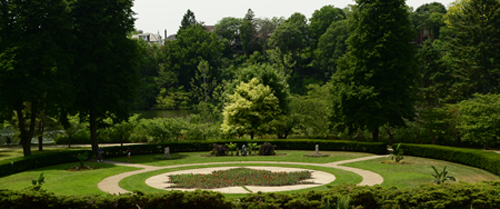
 something that was once an anticipation will become a memory
something that was once an anticipation will become a memory
In the stifling heat, Frank and I still got in a walk in. And like other times, we head for High Park and the trail around Grenadier Pond.
The planter is shaped like a maple-leaf and filled with red impatiens. Toronto has many such planters. On the Gardiner, on a slope across from Exhibition Place, are a number of floral advertisements that use flowers and shrubs to create corporate logos. The first time I saw these was back in the Sixties and then, the most prominent one was for Tip Top Tailors. (Their old Art Deco headquarters, on Lakeshore Boulevard, near the entrance to Toronto City Airport, has been turned into expensive lofts.)
I’m the first wave of out-of-town guests for David-and-Marc’s wedding. Tomorrow, Frank and Norma are hosting his family from Sault Ste Marie for brunch. There’s a calm sense of anticipation, but today is for politics; for two old hippies to analyze the Republican Convention. I tell Frank that I’m so glad to be in Canada while that miserable slug-fest is taking place. I do mention how I’m keeping track of the events geared to broaden The Donald’s appeal (after-all isn’t that what conventions are for?) and to gauge if they’re successful. I explain:
– Melania’s speech was well received, but then lost its impact when it was revealed that it had been plagiarized. (first effort goes awry)
– Chris Christie’s call-and-response was too much like a Nazi rally. (second effort scares the shit out of most Independents)
– Trump’s daughter is too Steford for a modern audience. (third effort misses its mark)
– Ted Cruz doesn’t endorse The Donald, rather he tells people to vote their conscience. (fourth effort gets derailed)
– Mike Pence to way too bland. (fifth effort doesn’t catch fire)
– The Donald’s speech was dark and exclusionary and scary (last effort leaves a national audience shocked)

 Canada has had marriage equality since July 2005 – eleven years today. Marc and David were married by a Justice-of-the-Peace at beautiful Rosetta McClain Gardens on the south-east side of Toronto.
Canada has had marriage equality since July 2005 – eleven years today. Marc and David were married by a Justice-of-the-Peace at beautiful Rosetta McClain Gardens on the south-east side of Toronto.
I’ve never been to this end of town and it was a great surprise. For the longest time, I had no idea where the area, now known as The Danforth, was; then Norma explained that on the other side of the Don Valley Parkway, Bloor Street changes names and becomes Danforth Avenue. With that reference, I knew how to situate the area in my internal map of the city.
Bloor is one of my anchors in my experience of Toronto. My grandparents lived on Jane a couple blocks north of Bloor. And when I visited, my grandfather and I would walk down to Bloor to do the food shopping. My aunt Rita and I went to see the 1968 Planet of the Apes at a movie theater on Bloor. My first ever experience riding a subway began at the Jane and Bloor station. When my parents visited, my mother and I would walk Bloor all the way to High Park. Later still, Jo’ and I came to the west end of Bloor for coffee and dessert. There were some amazing German bakeries in the area. And later still, I remember taking Christian and Seane there for lunch at McDonald’s. And I remember Seane refusing to hold hands when we needed to cross busy Runnymede.
 So, taking those old memories and extending them east to The Danforth allowed me to get my bearings. And as I drove to the park for the wedding, I couldn’t help but think old Toronto. The city as I knew it when I visited with my grandparents.
So, taking those old memories and extending them east to The Danforth allowed me to get my bearings. And as I drove to the park for the wedding, I couldn’t help but think old Toronto. The city as I knew it when I visited with my grandparents.
On The Danforth there were no glass spires cutting the horizon; there was no clogged expressway shadowing the streets below it. The neighborhood was full of single-family homes and family-owned business and there were people everywhere strolling, eating, sight-seeing. I saw several community parks with pools and baseball diamonds and tennis courts and playgrounds; I followed the trolley as it rode the rails on Kingston. Where recently I’ve been comparing the modern city to the urban landscapes of Blade Runner, east Toronto is a throw back to a gentler more humane city.
Also, The Danforth has drawn a new generation of gays and hipsters who are gradually turning what used to be GreekTown into a modern community. The old immigrant houses are being repurposed and retrofitted to accommodate the technology, the design-sense and the reconstituted families of the new inhabitants. Plexiglass, and brushed-chrome, and barn-doors, and multi-purpose kitchens, and huge bathrooms have redefined the interior spaces of the old houses. David-and-Marc’s home is one of those renovated structures and it’s elegant in its reincarnation. The wedding reception for family and Open House for friends were both held at their house.
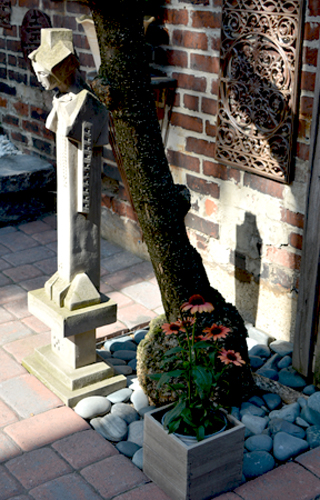
 I had to move the Midway Gardens Sprite, because the contractors are sealing the seam between the house-bricks and the cement pad on the side of the house. At first, I moved it into the corner with all the annuals. (I left a post from the old bonsai shelf and put the Sprite up on top of it. It’s way too tall for that location.)
I had to move the Midway Gardens Sprite, because the contractors are sealing the seam between the house-bricks and the cement pad on the side of the house. At first, I moved it into the corner with all the annuals. (I left a post from the old bonsai shelf and put the Sprite up on top of it. It’s way too tall for that location.)
When looking for a new place for the Sprite, Leger suggested that I put it on the ground next to the Japanese lilac. I wasn’t sure about this, but I tried it. It didn’t work on the right side of the trunk, but man it looked great on the left. To balance it, Leger suggested a Wright-like pot for the opposite side. Today, I found a great Wright-like pot at Home Depot. The Coneflower is a great match for the blue-stones and the patio-bricks. (I have to keep the dogs away from the plant; they like eating the leaves. They touch no other plant, but the Coneflower.)
It’s a surprise how well the Sprite, the pot and the Coneflower fit the space.
The National Gardening Association has the following info about the plant on their website – Coneflower is a native North American perennial sporting daisylike flowers with raised centers. The flower, plant, and root of some types are used in herbal remedies. Widely renowned as a medicinal plant, coneflowers are a long-flowering perennial for borders, wildflower meadows, and prairie gardens. Blooming midsummer to fall, the plants are relatively drought-tolerant and rarely bothered by pests. The flowers are a magnet for butterflies, and the seeds in the dried flower heads attract songbirds. Flower colors include rose, purple, pink, and white, plus a new orange variety. Plants grow 2 to 4 feet tall, depending on variety.
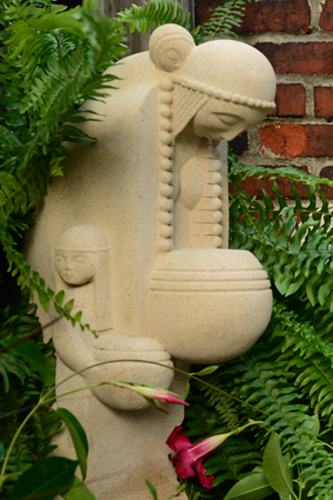
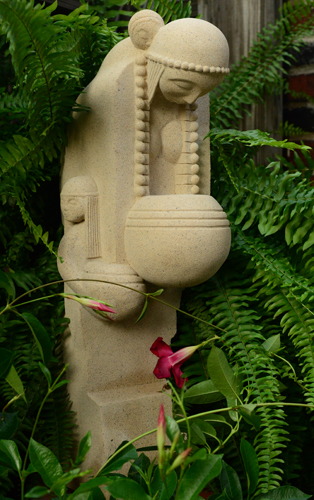 Wright created the Nakoma sculpture as a tribute to the Winnebago Indian Nation. The female Nakoma and the male Nakomis were to stand in large circular shallow water basins at the entrance to the Wright designed Nakoma Country Club in Madison. Neither the statues nor the clubhouse were ever built in Wisconsin. But, a group of developers purchased the clubhouse plans from Wright’s Taliesin architects and built the stunning structure on the brow of a hill in the Mohawk Valley of Plumas County, California.
Wright created the Nakoma sculpture as a tribute to the Winnebago Indian Nation. The female Nakoma and the male Nakomis were to stand in large circular shallow water basins at the entrance to the Wright designed Nakoma Country Club in Madison. Neither the statues nor the clubhouse were ever built in Wisconsin. But, a group of developers purchased the clubhouse plans from Wright’s Taliesin architects and built the stunning structure on the brow of a hill in the Mohawk Valley of Plumas County, California.
There are three figures in the sculpture – the mother, the daughter at her side and the papoose on her back. (I noticed the papoose today for the fist time. I was thinking that the ball shape behind her head was her hair in a bun. And because of that oversight, I cut the papoose out in the large image in the slide-show. In the photo on the left, the small ball shape shows itself to be a face – amazing.) Originally the sculpture was meant to stand 16 feet high with water spilling from the round bowl. The flow was to be the water source for the basin. In 1929 Wright had small models of the female and male figures produced in terracotta. The reproduction I have is from the statue at Taliesin in Spring Green, Wisconsin.
I saw the sculpture back in November when I was at Fallingwater with my cousins and I was temped to buy it, but didn’t. Then when I made the decision to get rid of the Alfonso Ianelli garden sprite, the Wright sculpture came back into play.
(Leger referred to the Ianelli as the breast-examination statue.)
Last Wednesday, I called the gift-shop at Fallingwater and the gentleman that answered – Keith – said they had a second Nakoma sculpture in their store-room. I drove up on Sunday and picked it up. And I spent today rearranging the plants around the new piece.

 Last year at this time, the back-yard got all new pavers. The back-planter had to wait, because I was leaving for Puglia. When I got back, I decided to wait until next summer because by then, the blueberries would be all harvested. The guys come yesterday and ripped out the old wolmanized 6X6 and built a new planter out of rock-slabs.
Last year at this time, the back-yard got all new pavers. The back-planter had to wait, because I was leaving for Puglia. When I got back, I decided to wait until next summer because by then, the blueberries would be all harvested. The guys come yesterday and ripped out the old wolmanized 6X6 and built a new planter out of rock-slabs.
The plants in the front got severely disrupted. Two of the oldest blueberry bushes got dislodged. When the old 6X6s were removed, the bushes just fell out into the trough the guys were digging for the foundation. The fact that the plants weren’t yanked out, should mean that the root-ball is intact. I wrapped the root-ball and its surrounding soil in a plastic bag to keep it moist and prevent further damage. I replanted them today.
In the smaller section on the left, I did an experiment – I cut all the lily-of-the-valley down to soil-level and then covered the entire bed with Peat Moss. Am hoping that since the lily is a rhizome, the Peat Moss should protect the disrupted underground stems and next spring the bed should be full of lilies. (I did the same thing a couple of years ago with the blueberries and within two years I had a bumper crop.)
The small bed has the fencing, because the dogs just want to climb into it. The attraction is the blueberries in the other section. (Jack hasn’t figured out that the berries are all done. He still goes up to the plants looking for berries. Jack has a great personality, but he is not the smartest dog we’ve had.)
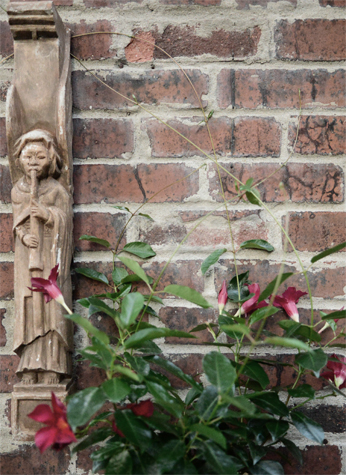

got a tattoo of a snake
and a ski-mask on my face
but i woke up in a ditch
behind the stop’n go
lying in the weeds
with a bullet in my gut
watching dollar bills
fly away in the dust
Handsome Family, (2016). Unseen. Gold
In the image on the right, I’m experimenting with Photoshop Adjustments. I tried to wash out most of the colors except for the green and the red of the leaves and trumpet-flowers. A contrast to the image on the left with its setting sun hues and gleaming gecko.
Sitting here watching Rachel Maddow interviewing Kellyanne Conway, Trump’s new campaign manager, and it’s amazing to see Conway squirm as she tries to explain the Republican candidate.
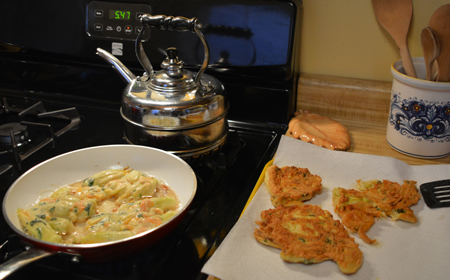
 Along Sampsonia Way, my neighbor, whose back-fence is not up against the alley, planted a couple zucchini plants in the small, raised flower-bed outside her back-fence. The plants are now well over 10 feet in length. And because some of my other neighbors planted annuals along my back-fence, I am out in the alley watering; and because I need to keep the wisteria contained, I am out in the alley, with my little step ladder, trimming all the off-shoots sprouting from the wisteria vines; I’ve been keeping an eye on the zucchini plants. And my neighbor seems to have no idea that the golden male flowers are edible. And after watching many of these golden delicacies shrivel and wither, I decided it was time to pick them and make fritters.
Along Sampsonia Way, my neighbor, whose back-fence is not up against the alley, planted a couple zucchini plants in the small, raised flower-bed outside her back-fence. The plants are now well over 10 feet in length. And because some of my other neighbors planted annuals along my back-fence, I am out in the alley watering; and because I need to keep the wisteria contained, I am out in the alley, with my little step ladder, trimming all the off-shoots sprouting from the wisteria vines; I’ve been keeping an eye on the zucchini plants. And my neighbor seems to have no idea that the golden male flowers are edible. And after watching many of these golden delicacies shrivel and wither, I decided it was time to pick them and make fritters.
I went out with my colander and filled it with both opened and unopened flowers. (Paul went on and on about my having stolen from my neighbor.) I cleaned the flowers removing the stems and green petals. The shriveled flowers need to be opened, because ants and cucumber beetles tend to get caught in them. Next, made the batter – equal parts flour and cheese, two eggs, parsley and salt to taste – threw the flowers in and fried them. (At my parents’ zucchini flower fritters are a summer staple. My dad picks the flowers every morning and my mom makes and fries the fritters for lunch and a late afternoon snack.) The above image has the fritters – some golden brown and some still in the skillet.

 The majority of the wall-plaques have no color and then, I found 3 painted-aluminum salamanders from Mexico. The one on the left is the biggest. I like the hints of the other things in the pic; on the left are the green leave of the sweet potato vine as well as their shadows; the black-green rope holds one the buckets hanging from the Japanese Lilac; in the middle is the hint of another one of the ropes; and on the right is the outer arc of a circular iron ornament.
The majority of the wall-plaques have no color and then, I found 3 painted-aluminum salamanders from Mexico. The one on the left is the biggest. I like the hints of the other things in the pic; on the left are the green leave of the sweet potato vine as well as their shadows; the black-green rope holds one the buckets hanging from the Japanese Lilac; in the middle is the hint of another one of the ropes; and on the right is the outer arc of a circular iron ornament.
My favorite image from this shoot is the first one in the slideshow – the tiny, blue oregano flowers, the rocks, the sweet-potato vine and the negative black spaces. Whenever I’m hiking and see a hole in the rock or a deep black tunnel on the side of a cliff, I fantasize that some creature lives in it. The black spaces in the above image bring back those wild ideas.
This miserable election has me turning off all cable news. People who live with it 24-7 must be living anxious lives. Everything is an occasion for anxiety; everything Trump does is widely reported; nothing Clinton says is reported at all. By November, on Fox, there will be real-time Trump fart-alerts and a death-watch for Clinton. Will this election finally put the nail in broadcast TV’s coffin? Will this election finally marginalize all the old people who have been living with the boob-tube in every room of their house? Will this be the last election to play out on TV? Please let it be the last election to use broadcast TV with its headline porn, because the next generation has no loyalty to the manipulative, greedy bastards running the networks. At least the head of CBS admitted that Trump is the ruin of the country, but a ratings super-star.
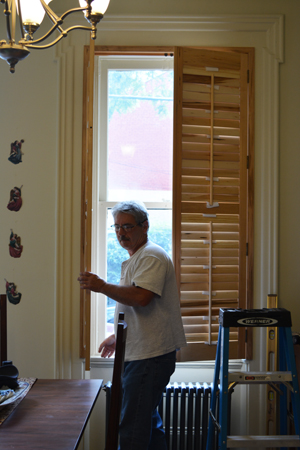
 The new shutters give me the option of opening some louvers to let in daylight. The thin blinds that were there could be set to either opened or closed. And because the front windows are right on the sidewalk, the blinds were always closed. The shutters have an upper and lower section and I can open the upper louvers and not sacrifice privacy. This should mean that I don’t have to automatically put on the electric lights in order to see. I also like looking through the upper louvers and seeing the tree in front of the house and the rooftops of the alley-houses in the back. (It’s a surprise to realize that this is the first time in 30 years that I can sit and my desk, in the big downstairs room and see the outside.)
The new shutters give me the option of opening some louvers to let in daylight. The thin blinds that were there could be set to either opened or closed. And because the front windows are right on the sidewalk, the blinds were always closed. The shutters have an upper and lower section and I can open the upper louvers and not sacrifice privacy. This should mean that I don’t have to automatically put on the electric lights in order to see. I also like looking through the upper louvers and seeing the tree in front of the house and the rooftops of the alley-houses in the back. (It’s a surprise to realize that this is the first time in 30 years that I can sit and my desk, in the big downstairs room and see the outside.)
The real surprise is that from the outside, the shutters look plywood like. On first impression, the yellow-pine finish makes it look like the window is boarded up, but the well between the shutters and the glass, and the yellow paint on the sides of the well correct that first impression. The other thing that corrects this first impression is having the louvers point up. This allows interior light to come through.
This is the second image I’ve posted that has a number of items in it that I like. Going from left-to-right – the angels, the Amish dining-room table, the overhead light, the fancy frame on the window and the blue radiator. The contractor is Rick from Blind Doctors.
John, who is the owner of the company and an amateur wine maker, promised me a bottle of his wine. When he came to take measurements, he saw the Terra Cruda/Aliatico wine bottles on the side-board and that got us talking.
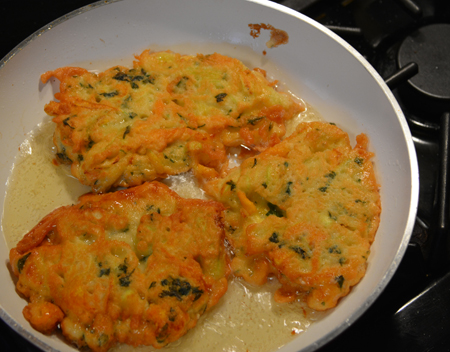
 I again went out onto Sampsonia Way and picked zucchini flowers from the plant growing in my neighbor’s alley flower-bed.
I again went out onto Sampsonia Way and picked zucchini flowers from the plant growing in my neighbor’s alley flower-bed.
The last time I made the pittuli, I added no additional salt thinking that what was in the cheese would be enough. It wasn’t. This time I added a bit too much. (I have an excuse to make another batch.) I also separated the zucchini flower from its base and made the batter more liquidy; both alterations made it easier to fold the flowers into the batter. The only change from my mother’s recipe is that I add parsley. (In the image on the left, the black specks are parsley.) I take my mother’s frozen parsley and shave it into the batter. My mother gives me the parsley frozen in a tube-shape wrapped in cellophane. BTW, the frozen parsley looks like a bag of weed.
This is an eat-standing meal, because I eat the fritters as soon as they come out of the pan. Yes, they are very hot and you have to delicately rip them into small steaming chunks or risk burning your mouth. In the Zinga family, there are two foods – zucchini pittuli and fried potato wedges – that you eat out of the frying pan or immediately after you take the item out. I love eating the crispy fritters hot out of the frying pan; my dad loves eating the potato wedges as they brown.
The black prongs and the coin-shaped gas-burner lid add interesting elements to the image. Also, I like the rigid circles of the frying pan and the coin shaped gas-lid as well as the amorphous circular shapes of the pittuli.
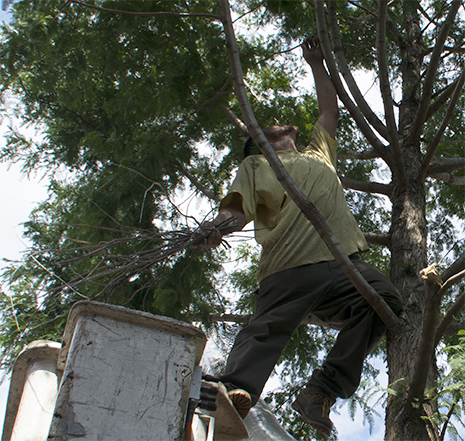

sometimes an image surprises
and then it’s worth the time
to expose that kernel of wonder
the pruner’s pose
is classical in its reach
baroque in its setting
american in its clothing
ethereal in its glide
and generous
in its offering
Today, the tree-service guys came to prune the lowest branches of the Redwood. And Jason – the pruner in the pic – used a cherry-picker for the job. He parked the humongous bucket-truck in the alley, and because there were parked cars, he only dropped two safety feet. He did an amazingly job setting the right foot a millimeter away from the parked Acura tire. (In another life, he was a surgeon.) He then telescoped the bucket, using the 60 foot hydraulic lift, over all the wires and brought it into my back-yard and into the Redwood. After cutting the six bottom limbs, he climbed into the tree and removed all the deadwood. My father would have used all these dead branches – frasce; the large ones as stakes in his garden and the small one for kindling .


 It’s official, we have moved into fall.
It’s official, we have moved into fall.
The rusted lantern sits on top of the fence between my back-yard and Carl’s; the Rose-of-Sharon is in his yard, a legacy of Joe and Rose Ferrara the previous owners.
Try to remember the kind of September when you were a tender and callow fellow
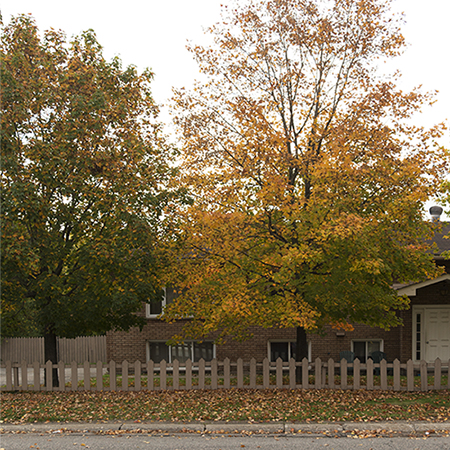
 The last time I was here, at this time of year, was October of 1969. (Writing that date makes is seem so long ago.) I was a freshman at the University of Windsor and I drove up with a fellow student. He was older and could rent a car and in exchange, I invited him to my parents’ for Canadian Thanksgiving. He was an American from Cincinnati.
The last time I was here, at this time of year, was October of 1969. (Writing that date makes is seem so long ago.) I was a freshman at the University of Windsor and I drove up with a fellow student. He was older and could rent a car and in exchange, I invited him to my parents’ for Canadian Thanksgiving. He was an American from Cincinnati.
It’s a nice time of year, the weather is mild, but everywhere there are indicators of winter. Every yard, has hockey nets and hockey sticks – the kids are anticipating upcoming season; the gardens are all harvested; and the lawns have had their final cut.
The image on the left is of the corner of Korah Road and Douglas Street. The house is both a residence and a music school. When we came from Italy in 1957, the area was full of stores. My parents ran a tab at Tagliabracci Groceries; their first chesterfield they bought at Spatone Furniture; and in between the two was the pharmacy where I bought my DC and Marvel comics. A couple of doors was the infamous Roosevelt Hotel Bar. No self-respecting Italian immigrant, of my parents’ age, went anywhere near the place, but the previous generation of immigrants, the ones well on their way to assimilation, the ones who had traded in their home-made wine for Carling Black Label; the ones who could speak English without an accent; the ones who drove new cars not used junkers; they flocked to the Roosevelt.
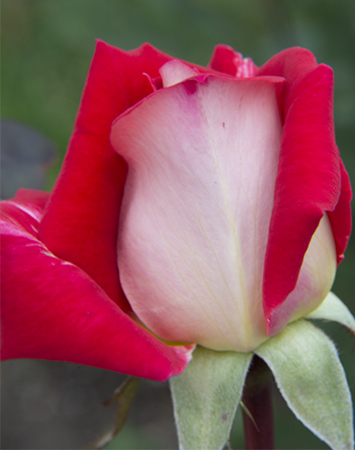
 One of the surprises is the flowers in my parents’ front yard. These are the genetically modified flowers – geraniums, begonias, dahlias, impatience, roses, petunias – we all plant. They are on their last bloom. Soon the morning frost will wither them and the hurried winds will rip their petals apart.
One of the surprises is the flowers in my parents’ front yard. These are the genetically modified flowers – geraniums, begonias, dahlias, impatience, roses, petunias – we all plant. They are on their last bloom. Soon the morning frost will wither them and the hurried winds will rip their petals apart.
In order to snap the pic, I had to hold the stem, because the wind was whipping everything.
It’s interesting to have been here in May when all the fruit-trees were in bloom and my dad and my uncle were planting their gardens. Fast forward four months and the gardens are empty. My uncle still has plants in the ground in his greenhouse. But my dad has pulled all the vegetable plants and turned them into the soil. The only plants left in the garden are escarole. The plant is hardy enough to last well into early winter. And as long as the snowfall is minimal, my parents will eat garden-fresh escarole salads and my mother will make pasta-e-scarola well into December.
The summer days of endless light have given way to cloudy skies and early sunsets. This is the In-between. By late October, there will be snow flurries. (Languid Indian Summer is for the domains south and east of the 49th parallel.)
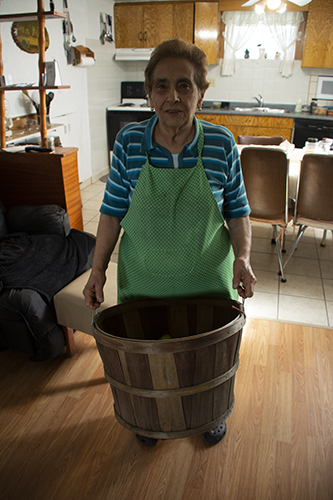
 It was time to harvest the winter pear tree, so my dad and I got the ladders out and my mom brought out the bushel and the crook. When I asked for a pair of pruning shears my 90 year old parents laughed. “Just rip them down.” Guess using pruning shears was too hoity-toity.
It was time to harvest the winter pear tree, so my dad and I got the ladders out and my mom brought out the bushel and the crook. When I asked for a pair of pruning shears my 90 year old parents laughed. “Just rip them down.” Guess using pruning shears was too hoity-toity.
My dad is one of those people who just wants to get the job done, whether it’s done well or done correctly is less important. So while I was on the ladder cutting the fruit off the branches and placing each pear into a bucket so not to bruise it, he was on the ground with a long stick whacking the fruit off. So much for gathering unbruised fruit. My cousin Joe tells the story that his dad and his son-in-law couldn’t work together, because his dad was similar to mine – get the job done and style and accuracy be damned. His son-in-law would measure twice before cutting a piece of wood; Cump’ Armunte would cut and use whatever came out, making it fit by hook-or-by-crook. Ciccio Zinga is the same way. Guess growing up in Aprigliano in the 20s and 30s must have ingrained similar sensibilities.
For me the obsession for accuracy and correctness come in the writing. I can spend days going over a couple of paragraphs. It would drive Rick crazy. He would write a memo, give it to me to proof and then hate the process of revision.
Many of the pears were on the ground and you could tell the ones I cut from the ones that had fallen to my dad’s whacking stick. He explained that because they’re not eating pears, it’s less important that they not banged up. After-all, the fruit is gonna be cut up and made into jam.
The pic is my mother, holding one of bushels with the pears, in the downstairs kitchen.


Excerpt from Toni Morrison’s Acceptance Speech for the Nobel Prize for Literature (December 7, 1993)
The systematic looting of language can be recognized by the tendency of its users to forgo its nuanced, complex, mid-wifery properties for menace and subjugation. Oppressive language does more than represent violence; it is violence; does more than represent the limits of knowledge; it limits knowledge. Whether it is obscuring state language or the faux-language of mindless media; whether it is the proud but calcified language of the academy or the commodity driven language of science; whether it is the malign language of law-without-ethics, or language designed for the estrangement of minorities, hiding its racist plunder in its literary cheek – it must be rejected, altered and exposed. It is the language that drinks blood, laps vulnerabilities, tucks its fascist boots under crinolines of respectability and patriotism as it moves relentlessly toward the bottom line and the bottomed-out mind. Sexist language, racist language, theistic language – all are typical of the policing languages of mastery, and cannot, do not permit new knowledge or encourage the mutual exchange of ideas.
The invention of print, however, made it easier to manipulate public opinion, and the film and the radio carried the process further. With the development of television, and the technical advance which made it possible to receive and transmit simultaneously on the same instrument, private life came to an end.
They were born, they grew up in the gutters, they went to work at twelve, they passed through a brief blossoming period of beauty and sexual desire, they married at twenty, they were middle-aged at thirty, they died, for the most part, at sixty. Heavy physical work, the care of home and children, petty quarrels with neighbors, films, football, beer, and, above all, gambling filled up the horizon of their minds.
Often she was ready to accept the official mythology, simply because the difference between truth and falsehood did not seem important to her.
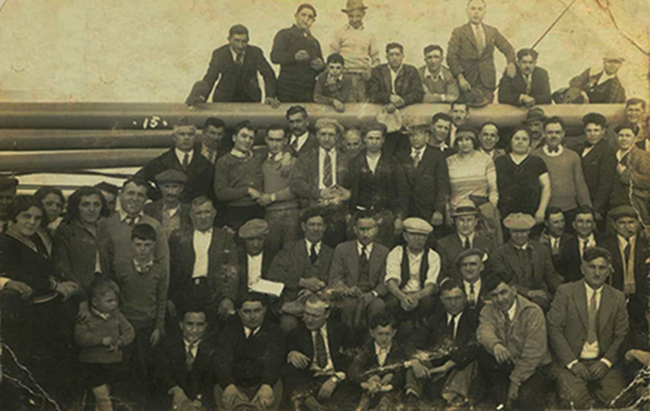

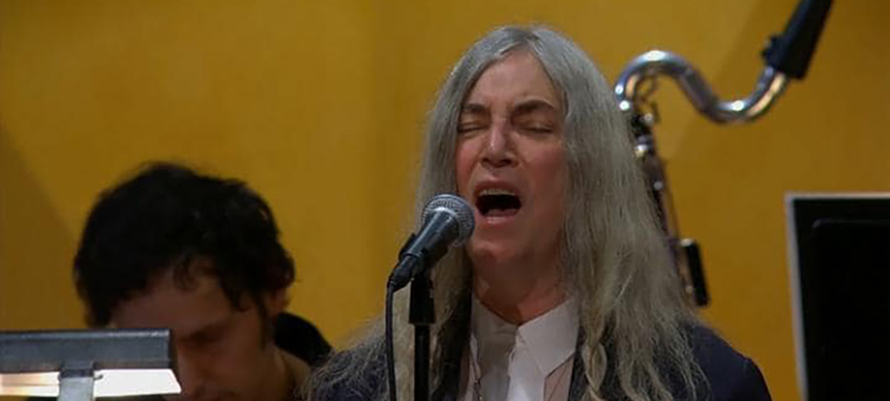
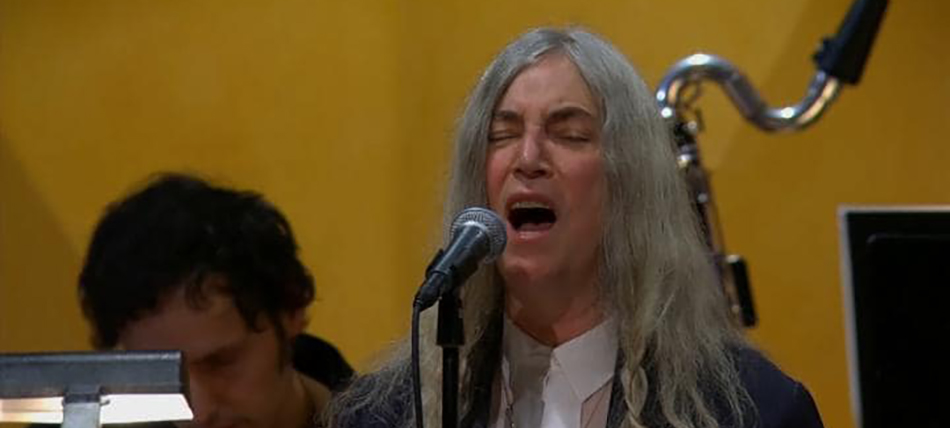
1
In the online edition of The New Yorker, Amanda Petrusich wrote a schmaltzy, but wonderful piece about Patti Smith’s performance at the 2016 Nobel Prize ceremony. My favorite paragraph …
Smith was accompanied by the Philharmonic performing a spare and gentle arrangement of Dylan’s “A Hard Rain’s A-Gonna Fall,” orchestrated by Hans Ek, a Swedish conductor. She looked so striking: elegant and calm in a navy blazer and a white collared shirt, her long, silver hair hanging in loose waves, hugging her cheekbones. I started crying almost immediately. She forgot the words to the second verse—or at least became too overwhelmed to voice them—and asked to begin the section again. I cried more. “I’m sorry, I’m so nervous,” Smith admitted. The orchestra obliged. The entire performance felt like a fierce and instantaneous corrective to “times like these”—a reiteration of the deep, overwhelming, and practical utility of art to combat pain. In that moment, the mission of the Nobel transcended any of its individual recipients.2
Smith is priestess, chanting an anthem, to a generation that lost its soul on November 8. She is troubadour and in the last verse, she rejects the alt-right’s silencing of democracy; and with fists clenched, she insists, she will – tell it and think it and speak it and breathe it. Her Druid voice makes Dylan’s words a clarion call.
1 A defiant and nervous Patti Smith performing A Hard Rain’s A-Gonna Fall at the Nobel ceremony. (The above image is a still from the video.)
2 Amanda Petrusich writing in The New Yorker – A Transcendent Patti Smith Accepts Bob Dylan’s Nobel Prize

This is the first time in almost 20 years that I flew up to Sault Ste Marie at Christmas. The thought of driving through the unpredictable, miserable snow-belt that is Grayling/Gaylord was too scary.
 And I followed the old protocol from 20 years ago and booked through Air Canada. When I made the reservations back in June, the lay-overs in Toronto were not bad, but by the end of October, Air Canada had made so many changes to my itinerary, that today I had a 5-hour lay-over and next week, when I go home, I’ll have a 6-hour lay-over. Today, I had breakfast with my cousin Joe and next week I’ll go visit Frank-and-Norma.
And I followed the old protocol from 20 years ago and booked through Air Canada. When I made the reservations back in June, the lay-overs in Toronto were not bad, but by the end of October, Air Canada had made so many changes to my itinerary, that today I had a 5-hour lay-over and next week, when I go home, I’ll have a 6-hour lay-over. Today, I had breakfast with my cousin Joe and next week I’ll go visit Frank-and-Norma.
The other inconvenience was the walk from the gate to customs. It took me 30 minutes and there were no interruptions or delays, just miles of glass-walled corridors. (I can’t think of any other airport that I’ve been in where I’ve walked that far from where we deplaned to where I could exit the building.)
What I’ll do in the future is fly Air Canada into Toronto, because they have an early morning flight and then fly Porter between Toronto and Sault Ste Marie. There’s a direct shuttle between Pearson Airport and Union Station downtown. And from there, I can then walk to City Airport to get on a Porter flight to the Sault.
The surprise is all the snow. Everything in Toronto is covered in a thin layer of white. Up here, the snow is easily 6-inches deep; the roads are covered with packed-snow; and the snow-banks are over my head.

Woke up to a cliché winter-wonderland. Last night there had been a soft, light snowfall and everything was covered in fluffy, super-white snow. And with winter-wonderlands come decent temperatures or at least mercury readings that make walking outside OK.
 Rose, Derrick and I went out for coffee to a chorus from Mr. Ciccio Zinga – Oh my god, going out to buy coffee, when you can make a perfectly good cup at home. This was followed by asking Rose where Derrick was and when she told him that he was waiting in the car on the street, Mr. Ciccio went off on his latest rant – Can you believe that it’s 9:00 and my driveway is still unplowed? (This is a man who for years had his driveway cleaned and swept free of snow by 7:00 am.) My driveway … my driveway unplowed. Son-of-a-bitch! I gotta call that son-of-a-bitch, as soon as your aunt gets up, I call that son-of-a-bitch and cuss him out. It was great fun repeating the conversation to Derrick. This led to Rose describing her dad’s obsession with a clear-of-snow driveway.
Rose, Derrick and I went out for coffee to a chorus from Mr. Ciccio Zinga – Oh my god, going out to buy coffee, when you can make a perfectly good cup at home. This was followed by asking Rose where Derrick was and when she told him that he was waiting in the car on the street, Mr. Ciccio went off on his latest rant – Can you believe that it’s 9:00 and my driveway is still unplowed? (This is a man who for years had his driveway cleaned and swept free of snow by 7:00 am.) My driveway … my driveway unplowed. Son-of-a-bitch! I gotta call that son-of-a-bitch, as soon as your aunt gets up, I call that son-of-a-bitch and cuss him out. It was great fun repeating the conversation to Derrick. This led to Rose describing her dad’s obsession with a clear-of-snow driveway.
My dad uses a Red Cross service that helps needy families. (The Red Cross co-ordinates a snow-removal service that hires people, at a certain income level, to clear home-owners driveways.)
After coffee, I went to visit my aunt-and-uncle and then opted to walk back to my parents’. The sidewalk-plow had just gone down the street where my aunt-and-uncle live, so I followed it walking the the tunnel that it had cleared between the snowbanks and what used to be the front-lawns. Winter really is the main experience this far north. And on days like today, it’s the landscape is exceptional. Snow decorates the aging housing; it distracts from the fading, pealing paint; it blankets sagging roofs; it covers weed infested lawns and cracked sidewalks.
The red barn in the image is on a side-street close to my aunt-and-uncle’s. In spring and summer it sits as a reminder of an older time when the area was all farms. In spring and summer is goes un-noticed, but in winter its red paint shines in contrast to the white, white snow.
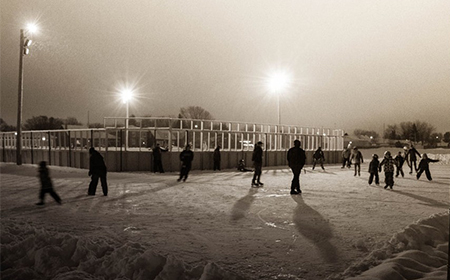
It used to be that every K-8 school made an outdoor ice-rink during the winter months and recess time was spent playing hockey with-your boots on or shoveling the snow off the ice. There were also city-rinks that were open week-days well into the night and all weekend. These city-rinks had hockey leagues, lessons, open skating and even couples-night. The attraction was the hours, the on-site attendant and the warming shacks. We would skate until our toes frozen and then we would run into the shack and try and get warm. The shack was a room with wooden benches around the perimeter and an oil heating unit in the middle. (I can still remember the distinct smell associated with oil burning furnaces and warming stoves.)
 The city-rink across from my aunt-and-uncles on Henrietta Street, is named after William Merrifield a World War I Canadian soldier who was awarded both the Victoria Cross and the Military Medal for gallantry during the mud and carnage at the Battle of Passchendaele, Belgium. Following the Great War, Merrifield settled in the Sault and worked at the Algoma Central Railroad. He died in August 1943 and was buried in West Korah Cemetery.
The city-rink across from my aunt-and-uncles on Henrietta Street, is named after William Merrifield a World War I Canadian soldier who was awarded both the Victoria Cross and the Military Medal for gallantry during the mud and carnage at the Battle of Passchendaele, Belgium. Following the Great War, Merrifield settled in the Sault and worked at the Algoma Central Railroad. He died in August 1943 and was buried in West Korah Cemetery.
I had no idea Merrifield was buried in West Korah Cemetery. Connie took me to the cemetery, because many members of Ron’s family are buried here. West Korah Cemetery was used by the “English” families of the west-end. All these years, I had no idea who Merrifield was or his connection to Sault Ste Marie. I just knew it was one of the many “English” names tagged on public schools and spaces throughout town.
The Merrifield rink is very popular and ended up adding a second, no-boards rink for kids. (I have this memory of Dave taking little Seane out to the Merrifield rink to try out her new skates and she crying and absolutely refusing to move. Seane won the argument and never did get to skate.) The above image shows mainly the no-boards, kids rink.
.
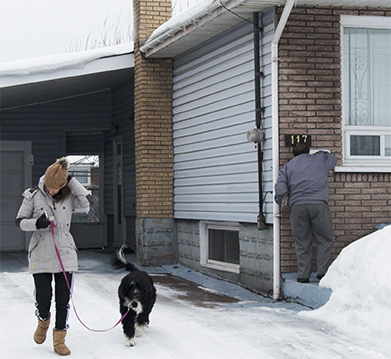
Last night it started to rain and by this morning the snow was wet and the snowbanks down to under 5-feet. Everything is gun-barrel-grey. Seane, Lilly and I went walking, but it was like walking through cold dense fog; a chill left me shivering; a chill that you can only experience in a northern climate in melting snows.
 There was a similar thaw last year. Town was clear of snow, but the area around Trout Lake, where my cousin’s son lives and where we were headed, was a winter micro-climate. The ground, the granite slabs, the boulders were covered in thick layers of wet snow. And the evergreens looked like tall pregnant women; their branches round with dripping white mounds. It was disconcerting driving the rut-filled, unpaved road that circled the lake, but there was no other option for getting to Dominic’s son’s house.
There was a similar thaw last year. Town was clear of snow, but the area around Trout Lake, where my cousin’s son lives and where we were headed, was a winter micro-climate. The ground, the granite slabs, the boulders were covered in thick layers of wet snow. And the evergreens looked like tall pregnant women; their branches round with dripping white mounds. It was disconcerting driving the rut-filled, unpaved road that circled the lake, but there was no other option for getting to Dominic’s son’s house.
On our walk, two guys on bicycles with hoodies and cigarettes dangling from their lips and looking like meth-addicts said hello and merry christmas. (Yeah, only someone high as a kite could be merry in this morning gloom.) My comment to Seane was that there are some scuzzy people in this end of town.
The image is Seane and Lilly and my dad at the mailbox getting the morning mail. And I brightened the image as much as I could and it’s still grey. The sun and winter-wonderland of a couple days ago are gone. Also, I’ve almost completed the slide-show change from summer to winter. The third image was also from our morning walk and the tree is full of frozen apples that for some reason have not fallen to the ground.

 Christmas Eve is always at my aunt-and-uncle’s. It’s my favorite of the two meals – 24th and 25th – because it’s the most traditional. It’s a fast meal which in old Catholicism meant no meat. The pasta was seasoned with olive oil, garlic and sardines. The fish was always baccalà – cod – in a variety of guises – breaded and fried, un-breaded and fried, baked, in a red-sauce, in olive oil and onions. The vegetables were rapini, and broccoli. There was no leavened bread instead we ate cullurielli, a deep-fried bread dough cooked plain or filled with anchovies.
Christmas Eve is always at my aunt-and-uncle’s. It’s my favorite of the two meals – 24th and 25th – because it’s the most traditional. It’s a fast meal which in old Catholicism meant no meat. The pasta was seasoned with olive oil, garlic and sardines. The fish was always baccalà – cod – in a variety of guises – breaded and fried, un-breaded and fried, baked, in a red-sauce, in olive oil and onions. The vegetables were rapini, and broccoli. There was no leavened bread instead we ate cullurielli, a deep-fried bread dough cooked plain or filled with anchovies.
Most years it’s my aunt-and-uncle, my parents, me, Rose-and-Derrick and my uncle’s 95-year old aunt Teresina. This year Dave, Isabel, Seane and Christian joined us. And like all Italians in Sault Ste Marie, we eat in the basement kitchen. Back in Aprigliano, the meal was very simple, because everyone went out to the town square for the Christmas bonfire. In northern Ontario, the celebrations stay indoors and therefore the meal and its presentation have become more important, more sumptuous, more Canadian.
In the Canadian version, the white anchovy pasta is supplemented with spaghetti in a red calamari sauce; the rapini is displaced by Brussels-sprouts; and the salted baccalà is balanced with shrimp, sea-perch or a fresh fish. The Christmas Eve meal was both a tribute and a celebration of la cucina povera. The meal reflected the poverty into which the Christ child was born. But now, the Italian immigrants celebrate Christmas, by demonstrating the bounty they found in the new world.
There are really two parts to every Christmas meal – the real food and everything after the real food is eaten. And the second set of offerings are just as important as the traditional dishes. Once the pasta, vegetable, salad and fish dishes were collected and put on the counter, my uncle began bringing out the second group of foods. There were fichi d’india – prickly pears, cherries, Abate pears, finocchio – fennel, chestnuts, dried figs, mandarins and tangerines.
The last part of the meal is espresso, the Calabrese Christmas sweets – turdilli, scalille, pitta impigliata – and various liqueurs. (These would normally be served in the upstairs/formal kitchen.) Keeping with the move to modernity, Rose brought up a wonderful berry cheesecake. My uncle brought out two bottles of Anice – one from Cosenza and one from Sardegna. The one from Sardegna, has a silhouette of Queen Ann’s Lace on its label and it tasted soft and less lickerishy. The one from Cosenza is stronger and wonderfully flavored with anice and pear.
Images top to bottom – my uncle and aunt getting the two spaghetti ready the dining table in the downstairs kitchen
the vegetable – Brussels-sprouts, broccoli, and salad Seane, Dave and my dad my dad and Christian

Mr. Zinga has been up since 5:00 cooking up a storm. He has all the vegetables prepped, he has cut up all the fruits for after the meal and he has added his little touches to the turkey. He bought a pre-stuffed bird and it was difficult getting him to understand that he was not to defrost it and that it needed to go into the over frozen. (Apparently, the last stuffed turkey he bought, he decided that it needed to be defrosted and they ended up having to throw it all away or risk salmonella poisoning.)
 And even after I got the turkey ready, because I stepped away for 5 minutes and wasn’t there to monitor, he decided to cook it without a cover, to get it browned and to add white wine to give the drippings more flavor. IT’S FROZEN!!! browning and drippings are hours away. Oh, did I mention that my dad is 91.
And even after I got the turkey ready, because I stepped away for 5 minutes and wasn’t there to monitor, he decided to cook it without a cover, to get it browned and to add white wine to give the drippings more flavor. IT’S FROZEN!!! browning and drippings are hours away. Oh, did I mention that my dad is 91.
Don’t let me forget that in addition to turkey, stuffing, cranberry, gravy, Brussels-sprouts, green-beans, broccoli and salad there will be chicken broth with tiny meatballs and my mother’s lasagna. And let’s not forget both home-made bread and cullurielli both plain and with anchovies. I keep forgetting to mention the home-made wine, the beer and of course pop for all the non-wine/non-beer drinkers.
The other task that sets off Mr. Zinga’s OCD is the setting up of the tables and chairs for the 20 people who will be here for dinner. He’s already started in on my bringing all the tables in from the garage. (Last Christmas, I had to get Derrick to show up here at 9:00 to help me with the tables, because my dad wouldn’t stop fussing. 9:00 am!!! even though dinner was set for 5:30.) So when he started in this morning, I told him Christian would help me and that put an end to his fussing, because anything his grandson is involved in is automatically OK. Wait till he hears we’re going for a walk after lunch and that we’ll do the tables when we get back. (Rose continually accuses me of being evil. Maybe there’s something to it. But it’s definitely fun prodding Mr. Zinga’s OCD.)
He is now all about lunch. I wish I had a tape-recorder to capture his fussing at my mother as they get lunch ready.

 It was a tradition to go driving through the west-end to see the various Christmas light displays. The area west of Goulais Avenue was infamous for over-the-top illuminations. Guess that tradition made more sense when we were younger, less jaded and had a more naive world-view. In the age of the crazy-man, naiveté is a dangerous characteristic. So I shot the house across the street. When I lived here, the Greniers, a French-Canadian family, lived in the small house. My parents referred to them as i francesi, because the family still spoke French.
It was a tradition to go driving through the west-end to see the various Christmas light displays. The area west of Goulais Avenue was infamous for over-the-top illuminations. Guess that tradition made more sense when we were younger, less jaded and had a more naive world-view. In the age of the crazy-man, naiveté is a dangerous characteristic. So I shot the house across the street. When I lived here, the Greniers, a French-Canadian family, lived in the small house. My parents referred to them as i francesi, because the family still spoke French.
By early afternoon, Mr. Zinga had exhausted himself and sat back in his chair commenting. Connie, the kids and I announced that we were going for a walk; Dave retreated upstairs to ESPN; and Mafalda and Isabel set about getting the actual meal assembled. Normally, I work with my mom at getting the vegetables, the soup, the lasagna and the turkey sides ready, but it was nice to leave all that in Isabel’s capable hands. The two of them worked wonderfully together and we even got some modified dishes – baked mashed potatoes, salad with black olives.
After our walk, Seane and I got the tables ready. Mr. Zinga couldn’t control himself and started to give us orders. I just looked at him and started to laugh especially when he questioned why we left a space in front of the fireplace. Seane and I had great fun grimacing about fly body-parts in the bowls, where to put the napkin, the knife, the fork. When Isabel suggested putting the soup-spook above the plate, we roared. I told her that we weren’t doing that, because A: the group wouldn’t find it and B: after finding it, they would hound her with their comments.
The Hub trail is one of the many wilderness trails in the west-end. It’s a 10 minute drive from my parents. The trail was again a reminder of that nouveau term – micro-climate. There was no evidence of melting or ice-covered snow anywhere. Strange given that where my parents are, everything was covered in a sheet of ice because of the rain the previous day. (After dinner, Alyssa and Seane went on about liking getting mentioned or having their pics on the blog. Who knew my jaded niece and my still unjaded cousin cared.)
The soup was done with store-bought capelleti instead of the small home-made meatballs – we complained; the lasagna hadn’t settled, it was wet – we complained; Daniel had a pimple – we complained; Christian filled up on shrimp – we complained; Seane dumped her boyfriend – we complained; Alyssa wants to come to Kaua’i – we cheered. After dinner, my mother complained about pics-on-phones, so she pulled out the old albums and we had a great time looking at the old pictures. “Yes, I was a monk. I used to be holy.” You can just image the comments that followed that statement.
Images top to bottom – the blue house across the street, Mafalda and Isabel preparing Christmas dinner, the table in the downstairs kitchen set for 20, Seane on our Christmas day walk, Connie, Seane, Christian on the bridge over the hollow

Each time I visit, I’ve had a chance to go see the renovations Kevin and his dad have done on the old Lutheran church on Wellington. They are close to finishing and to putting the rental units on the market. Kevin said that the local media did a great piece on the renovation and that they had many inquiries. Old Steelton Church Born Again. His hope is that he will have all 5 units rented within the month.
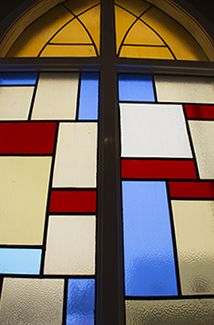 All the windows had a second plastic window in front of them; this was to both protect the old glass and to keep the winter out. The tall stained-glass at the entrance was hidden behind an opaque plastic sheath. Kevin said that once they removed the yellowed plastic the colors and the incoming light were amazing. For the side and basement windows, Kevin used a craftsman style replacement glass unit; and a great tradesman, who is working with them, was able to fashion the interior window framing so to maintain the arch in the windows at the front of the church.
All the windows had a second plastic window in front of them; this was to both protect the old glass and to keep the winter out. The tall stained-glass at the entrance was hidden behind an opaque plastic sheath. Kevin said that once they removed the yellowed plastic the colors and the incoming light were amazing. For the side and basement windows, Kevin used a craftsman style replacement glass unit; and a great tradesman, who is working with them, was able to fashion the interior window framing so to maintain the arch in the windows at the front of the church.
Watching Kevin’s renovations and earlier in the week talking to Albert Tucci at the re-purposed St. Mary’s High School there is a real sense that the town is investing in the old Gore Street/Wellington Street area. Kevin’s renovation is at the west-end of the neighborhood and the re-purposed St. Mary’s is at the east-end of the neighborhood. Because the two commercial street – Gore and Wellington – are surrounded by solid, brick housing that can be renovated, this town supported revitalization comes with a residential component. The houses in the area date back to the 1940s.
So much of the newer housing in town is what I call throw-away suburban-track. These are houses that the extreme weather ages in 5 years; these are houses with a short life expectancy. They are built as temporaries, encouraging their occupants to move to a new house as soon as possible. But the houses around the Gore Street/Wellington Street corridor have solid bones. The old Lutheran church has basement walls 5-feet thick – solid, poured cement. And it’s good to see the next generation reclaiming, renovating and re-purposing the old structures that built the steel town that is Sault Ste Marie.
When I lived here some 50-years ago, the east-end was the promised land. We in the west-end lived too close to the mill; we in the west-end had few amenities; we in the west-end were Polish, German, Italian and French; we in the west-end were too Catholic. The real, true white-skinned Canadians lived in the east-end surrounded by their Anglican churches and manicured parks. And we west-enders were supposed to grow up, marry an east-ender – a non-immigrant – and then move away from the dreaded west-end. But the winds have shifted; they now blow west.

Rose and Derrick took me to the airport for a 10:15 flight. The line to the counter was through the entire lobby and it took 45 minutes to get to the attendant. Many of the people in line had shown up hoping to get on stand-by, but the flight was sold out. When the airport is 20 minutes away, it’s OK if I have to drive back home. Also, many of the college kids were in line with their parents. The other surprise was that these same kids hadn’t checked-in online. Having checked-in the night before, it took me 5 minutes to get my bag tagged; and I headed off to security. (I even had a container of cullurielli cu sarde for Joe that his had made and because of all the chaos, no one said anything about the extra carry-on.)
And then the crazies . . .
 The unprepared delayed boarding, but when we were all on-board, a woman in front of me picks up and heads out. (For a minute, I thought I must have been on the wrong plane, but then I remembered I was in Sault Ste Marie and there was only one Air Canada plane on the tarmac.) Once inside the terminal you could see her flaying and I’m assuming yelling. Immediately, a security group gathered around the crazy. Next, the baggage people started scrambling to retrieve the crazy’s luggage. Meanwhile the show went on in the terminal; too bad we had no sound. But soon the door closed; the plane was de-iced; and we headed to the run-way. Crazy, part one – done.
The unprepared delayed boarding, but when we were all on-board, a woman in front of me picks up and heads out. (For a minute, I thought I must have been on the wrong plane, but then I remembered I was in Sault Ste Marie and there was only one Air Canada plane on the tarmac.) Once inside the terminal you could see her flaying and I’m assuming yelling. Immediately, a security group gathered around the crazy. Next, the baggage people started scrambling to retrieve the crazy’s luggage. Meanwhile the show went on in the terminal; too bad we had no sound. But soon the door closed; the plane was de-iced; and we headed to the run-way. Crazy, part one – done.
In Toronto, Joe picked me up and we headed off the Sherway Gardens Mall for lunch at Pusateri’s – a high-end Italian eatery. I had roasted turkey and rapini. Next we went for coffee; then made our way to Sacks; and finally to his house for a glass of wine. He got me back to the airport around 4:30 for a 6:30 flight. (I had no idea how long it was going to take me to get through security and customs, so it was OK to have the extra time.)
Air Canada has service to most US cities within an hour’s flying-time of Toronto. However, the gates for these routes are in the extremities of Terminal 1. (Last Wednesday, it took me 30 minutes to walk from the gate to customs on the arrivals’ level.) The gates are in a long corrugated metal structure and the waiting areas are in the hallway. And sitting there for an hour afforded an amazing people-watching experience. First of all, anyone who says Canadians are not as fat as Americans is delusional. I repeatedly kept thinking – how is that person gonna fit in an airplane seat? And then the kids. There was a mom with two kids; she spent her whole time reading off her iPhone while her two brats touched and played with anything they could reach. There was a second family, waiting to get on a Cleveland flight; they had three small kids who were so misbehaved that the dad gave one a spanking. And there was the odd couple going to LA via Kansas City; the young woman looked like the Goodyear blimp and the young man was skinny and very metro. And then to top it all off came the wheel-chair people; if you can’t walk on your own, what the hell are you doing traveling during Christmas?
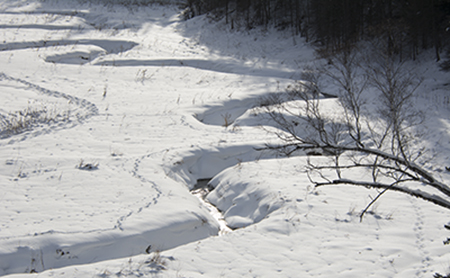
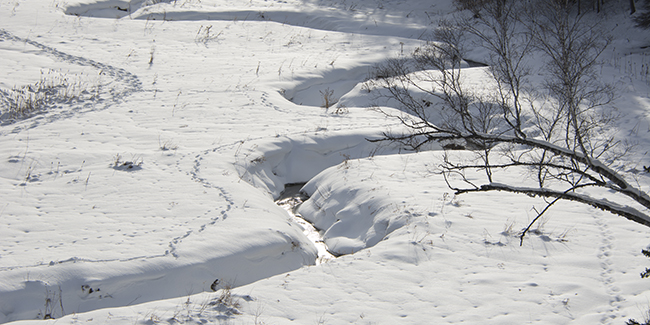

Image top – creek on the Hub Trail, Images bottom (left-right) open flame at steel-mill, window at repurposed church, aunt’s basement kitchen,
Lilly, Seane, Connie, Christian on Hub Trail
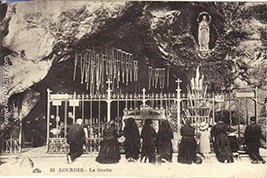
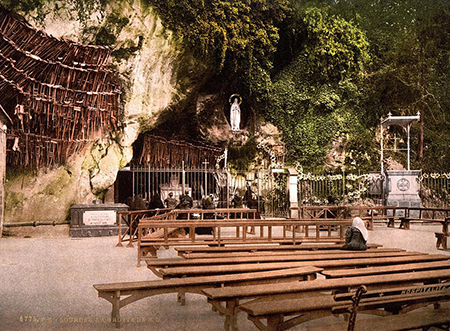 To those of us from certain parts of Calabria, today is a major holy-day – the feast of Our Lady of Lourdes.
To those of us from certain parts of Calabria, today is a major holy-day – the feast of Our Lady of Lourdes.
Even today, throughout southern Italy there are shrines to Our Lady of Lourdes. In many small towns, in Calabria, in Basilicata, in Puglia you can still see posters advertising pilgrimages to Lourdes. Devotion to Our Lady of Lourdes is still wide-spread. Many of my relatives in Aprigliano have made the pilgrimage to Lourdes, some more than once.
This date and this holy-day were important religious events of my early life. When we came to Canada, I had all sorts of memorabilia for Our Lady of Lourdes. My dad, who did a 3-month work-stint in south-western France, went to Lourdes and brought back most of the paraphernalia we had in Sault Ste Marie.
But age and some ability to connect dots previously isolated by cultural myths, allows me to look at the past through a different lens. What I’m finally realizing is the economic and PR machinery that promoted the pilgrimage to south-western France. An industry that got poor peasants from Italy’s poorest regions to travel to south-western France. A 2,000 kilometers or 1200 miles bus ride. And imagine all the people and businesses, along the 1200-mile route, that made money off the pilgrims. And imagine all the restaurants, all the hotels, all the souvenir shops in Lourdes that profited from the pilgrims from southern Italy.
When we were in San Giovanni Rotondo, in Puglia, it was clear that the town was totally dependent on its Santuario Padre Pio for its economic livelihood. (Padre Pio is southern Italy’s own saint and his burial place in San Giovanni Rotondo is a huge pilgrimage site.) Assisi is the prototype Italian pilgrimage town. The whole town is a religious tourist destination. The old medieval town has been cleaned up and refurbished; all the buildings are pointed with new grout, all the walls – houses, palaces, churches – are clean; there are beautiful medieval street lamps throughout; and all the hotels, the restaurants cater to the religious tourists.
Thinking about the economy of pilgrimages, led me to realize that my dad and his friends didn’t end up working in south-western France by accident. I’ll bet that the same people who organized the bus-trips from Aprigliano to Lourdes, over the years, got to know the small business owners – in this case the forestland-owners – in south-western France and when those business owners needed migrant workers to prune and cut trees, the pilgrimage organizers recruited in Aprigliano. How different can recruiting to fill a bus or a small hotel be from recruiting workers who can chop down trees? In post-war Calabria men transitioning from a farm economy to an urban economy were a dime a dozen. Transportation and lodgings options were already in place, so what that the people going over were going to work rather than pray.
What gets revealed in this new awareness is the religious veneer – the patina that covers the economic engine of moving people from one location to another.
The above image is an old postcard of the grotto at the shrine in Lourdes. Note the hundreds of crutches hanging on the wall and from the ceiling in the cave.

thursday, february 16

Thursday morning, fat flurries were dropping delicately, nothing massive or blinding enough to make me want to cancel the road-trip. What I had forgotten though was that wet-snow and wet-roads make for lots of windshield fluid and salt-spray gunking up my car. 79 North was a mess. Outside of Erie, it was a winter-wonderland and I started to worry, however, as soon as I turned east onto 90, the winter weather stayed behind me and I drove into sun and dry roads.
In Hamilton, I took the 407 East, rather than stay on the non-toll, super-congested QEW, 427 and 16-lane horror known as the 401. Driving the 407 Express-Toll-Road (ETR) is like driving a Pittsburgh highway – limited traffic and pleasant surroundings. Got to Mary-and-Dom’s, in Pickering, around 4:00.
Friday morning, Rose and I took Sadie out for a walk in the sub-division. The above image is of one of the older houses in the neighborhood. This particular section of eastern metropolitan Toronto began development in the 1970s and the bungalow was the premier house design. The house in the above image was a high-end version of the common bungalow. The large property and the sheltered front door were not typical design elements of the affordable suburban ranch. Today, many of these older homes are being demolished and replaced with faux mini-mansions.
In the afternoon, I went into town to High Park to Frank-and-Norma’s for dinner. We always have a nice time, even if we talk about the crazy-man in DC.
On my way home, because I was staying in Pickering, I had to get on the Gardiner going east. I’d never done that before and I wasn’t familiar with the downtown entrance ramps. I vaguely remembered that they were short and had no merging lane. And sure enough when I found one I immediately ended up on the side of the highway with cars zooming by. I managed to get on even if the car behind me sat on his horn until I achieved cruising speed. It reminded me of driving in Calabria, specifically in Reggio where most entrances onto the highway were up short ramps with a stop sign at the top. Talk about nail-biting. But then, there’s nothing like going from 0 to 60 to get the adrenaline running. Guess those experiences in Reggio prepared me for the Gardiner at night.
saturday, february 18

Everyone at the Melchiorre’s kept referring to my Saturday schedule as Driving Miss Daisy. (I was driving down to Oakville, picking up Connie, coming back east to The Danforth for lunch, taking Connie back to Oakville and then eventually driving back to Pickering.) It was a beautiful day and the various drives didn’t bother me. I got to Oakville by way of the 401, the 427 and the QEW. (The 401 is really a miserable highway.)
Connie and I were going out to lunch with her friend Jim and his partner Dan. Jimmy is an old friend from Sault Ste Marie. (The last time she had seen him, my sister Jo’ was still alive. Back then, Jimmy had come down to Oakville visited with Jo’ and then he and Connie went for coffee.) At Christmas, Connie asked me to contact Jimmy through his FB account. He was very glad to hear from her and to meet me and suggested we all get together the next time we were in Toronto.
Over the last couple of months Jimmy’s FB comments and messages have popped up on my account. When Connie and I knew we were heading to Toronto for late February, we all exchanged phone numbers and made arrangements to visit. Jimmy suggested that we go to his place, off The Don Valley, on The Danforth for lunch.
The valley gets its name from the small creek – the Don – that flows through the park. The valley separates the sprawling, Blade Runnerish downtown from the more human scaled Danforth/Greek-Town neighborhood. The area has none of the glass skyscrapers that litter downtown and most of its original housing stock is still in place. As a matter of fact, the first time I was in the area, all I could think of was the Toronto I knew from my high-school days. A small Canadian city of two-story structures and wide commercial streets with lots of food markets. My grandfather and I would walk down to Bloor Street and within a three/four block radius he could do all his grocery shopping. The Danforth has that feel – the businesses are all on the street floor of the two-story structures and the avenue is wide and teeming with people. BTW, Danforth is the name Bloor Street takes on east of the Don Valley.
Jim and Dan live on the edge of The Danforth facing the valley. The above image is taken from their balcony. And the bridge in the lower-right is the span that connects Bloor Street on the west to Danforth Avenue on the east.
sunday, february 19
 The day before Rose and Mary had gone walking down by the lake and Rose kept commenting about the wonderful walk and how much I would like it and what a great place it was for pictures. So Mary decided that for our Sunday morning walk, we should go back down to the lake-front park. The area is the Rouge River National Park and the Waterfront Trail. The above image is shooting into the silt-ponds at the mouth of the Rouge before it empties into Lake Ontario. I love the haggard cat-tails – left-overs from a distant fall.
The day before Rose and Mary had gone walking down by the lake and Rose kept commenting about the wonderful walk and how much I would like it and what a great place it was for pictures. So Mary decided that for our Sunday morning walk, we should go back down to the lake-front park. The area is the Rouge River National Park and the Waterfront Trail. The above image is shooting into the silt-ponds at the mouth of the Rouge before it empties into Lake Ontario. I love the haggard cat-tails – left-overs from a distant fall.
There are three estuaries that originate in the moraine north of the city and flow through modern metro Toronto to Lake Ontario. Roughly, the Humber comes into town along the western edge of High Park; the Don is the middle river separating the city into west and east; and the Rouge is the third watercourse marking the eastern edge of the metro region.
We got home from our walk along the north-eastern shore of Lake Ontario, Mary went to all the downstairs windows and lifted them open. Holy shit, it’s February in Canada and she’s opening windows as if it were spring.
Early afternoon we drove down to Oakville for my niece’s birthday party. (It was so warm in the car, I ended up putting on the AC rather than keeping the windows open and letting in the road-noise.) I took the super-clogged highways going down, but on our way home, I took the Gardiner and the Don Valley to the soul-draining 401. Mary was surprised by my facility with getting around and to knowing more than one way to get home that she asked if I had ever lived in Toronto. I just said that I had been coming to town all my life and once I started driving, I had a car to explore with.
I have to say that this was the first time when I didn’t think-about or worry-about driving. Took me long enough to get to the point of seeing Toronto highways as familiar and ordinary.


It’s taken two years for the snow-drops to come up and bloom. I say that, because in the old, side-yard flower-bed, these early bulbs never missed a season. But that’s really not accurate, because I have no idea how long it took them to take root, because I have no idea when I first planted them. Back then, I didn’t know one bulb from another. (In an area with limited sun, I planted tulips, and other long-stem flowering bulbs.) It took me a while to understand that I have limited sun in my urban back-yard and that tall plants, because they follow the sun, tend to fall over when reaching excessively for the afternoon light that just touches the fenced in back-yard.
I didn’t missed the snow-drops, in the side-yard, until I was in Cambridge in March of 2013 and they were all through the monastery courtyard. (I had removed the side flower-bed the previous summer and had totally forgotten about my harbingers of spring.)
The ones in the above image are not from my back-yard; mine are just coming up and when they first bloom, they’re singles – one plant per bulb; it takes a few years for the bulbs to multiply and clusters. Also, the above flowers are a giant version – genetically modified for sure – of the original plant. (The modified bulbs produce large white flowers the first couple of years, but then the modification appears only in the leaves; the flowers revert to a more standard size.)
What is most strange about spring 2017, is that on February 23, the temperature reached 76o. (The last time there were temperatures this warm was 1906.) There is no snow and the galanthus are one of many early flowering bulbs. For this year, they have lost their uniqueness as the first flowers of spring and instead are competing with lush crocus, iris retuculata, dwarf daffodils, bushy forsythia and fragile magnolia.
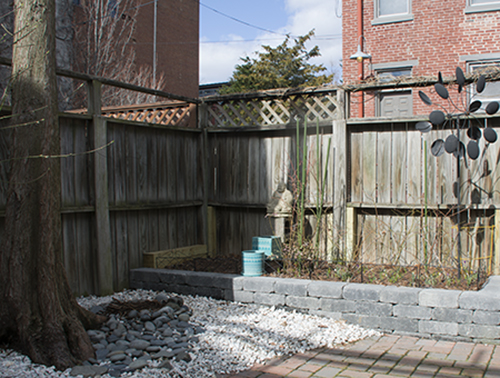
 The pine needle scale, Chionaspis pinifoliae, is probably the most common armored scale found on conifers in the United States and Canada. The white, oystershell-shaped scales can completely cover needles, causing plant discoloration to needle and branch death. Heavy infestations of pine needle scales remove considerable amounts of plant juices resulting in yellowed needles. From a distance, trees appear frosted or silvery.
The pine needle scale, Chionaspis pinifoliae, is probably the most common armored scale found on conifers in the United States and Canada. The white, oystershell-shaped scales can completely cover needles, causing plant discoloration to needle and branch death. Heavy infestations of pine needle scales remove considerable amounts of plant juices resulting in yellowed needles. From a distance, trees appear frosted or silvery.
The scales appeared last year and by the time I noticed them, it was too late to treat for them. (I also didn’t want to start spraying insecticide all over the back-yard.) This year, the tree’s spring growth was greatly reduced; gone were the green plumes and candles of scale-free years. I made the decision to cut the tree down and to replace it with a hardy fruit-tree. (Last spring, I planted a peach suitable for this climate and this zone and it did very well.) I went back to the same growers and looked for a hardy apricot and when I found one, it made replacing the Scotch pine easier to stomach. The image is the west-corner minus the cascading pine tree.
Both the now defunct pine and the gigantic red-wood – the trunk on the left of the image – began life as bonsai. I wintered them on the west-side of the yard, the most protected side, and in the spring discovered the roots had started growing into the ground. I left the trees there and watched, year after year, as they grew from their miniature pots to fill up my back yard. Of the two, the pine tree took up most of the usable space, because it was low and cascading. (The red-wood shot straight up and with yearly pruning of the lower branches all that was at eye-level was the beautiful trunk. The last pruning brought the green growth almost 30 feet above the ground; proving more light and space in the back-yard.)
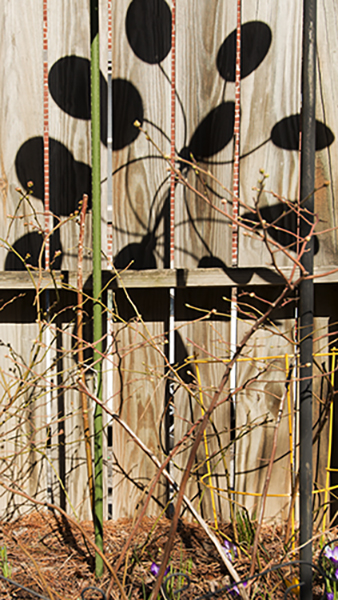
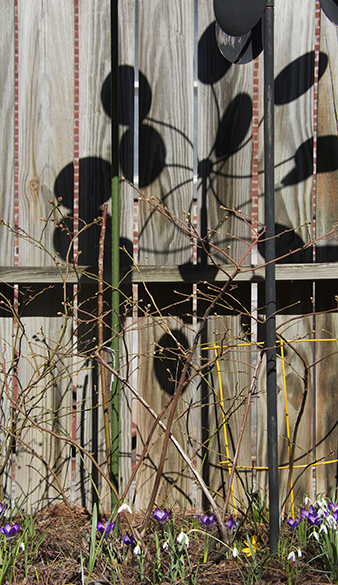 Today, the sun was back in full-force and the images it created with the bare branches, with the windmill-blades, with the shadows are amazing. The pic on the left is of the back flower-bed and it’s full of lines – verticals, horizontals, diagonals, perpendiculars, ellipticals, parabolics. (Whoa, how often do you get to use all those great words in a post about a sunny day in spring?) My favorites are the candy-striped verticals created by the gaps in the fence slots and the red bricks, of the houses across the alley.
Today, the sun was back in full-force and the images it created with the bare branches, with the windmill-blades, with the shadows are amazing. The pic on the left is of the back flower-bed and it’s full of lines – verticals, horizontals, diagonals, perpendiculars, ellipticals, parabolics. (Whoa, how often do you get to use all those great words in a post about a sunny day in spring?) My favorites are the candy-striped verticals created by the gaps in the fence slots and the red bricks, of the houses across the alley.
The branches are blueberry bushes, fat and bursting with buds. The green stake is a support for the tall blueberry plants and the black steel shaft is the base-pole of the windmill. I just noticed the circle shadow of the yellow tomato-cage that will hold up the lanky, hybrid cornflowers. The ground-cover is pine-needles from the red-wood, the purples and yellows are crocus and the white are snow-drops.
It’s that time of year when we can briefly forget the disgrace of urination in a Moscow hotel-room; it’s that time of year when we can briefly forget the disgrace of Kellyanne Conway of Jeff Sessions; and it’s that time of year when we can briefly forget the disgrace of November 8.
It’s that time of year when we dream of slim waists; it’s that time of year when cancer briefly loses its grip; and it’s that time of year when old-age dreams of midsummer nights.
It’s that time of year when new-life sneaks among the winter bareness; it’s that time of year when daylight lingers among the evening chill; and it’s that time of year when warm temperatures play among the March winds.
The image is the antithesis of simplicity, of minimalism; representations and expressions I obsess over. It’s also not a cool image; it’s full of reds, vermilions, purples, yellows, browns, tans, sepias.

 In our family, daylight saving time is a horror. (Paul claims that if Trump had promised to end daylight saving time, he would have voted for him.) The first day of the time-switch is always disorienting – you’re waking up an hour earlier than usual and then there’s no way of determining what time it is throughout the day. You look at the clock and are amazed that’s it’s 7:30. What! What the fuck happened to late afternoon and why is it still light out?
In our family, daylight saving time is a horror. (Paul claims that if Trump had promised to end daylight saving time, he would have voted for him.) The first day of the time-switch is always disorienting – you’re waking up an hour earlier than usual and then there’s no way of determining what time it is throughout the day. You look at the clock and are amazed that’s it’s 7:30. What! What the fuck happened to late afternoon and why is it still light out?
a brief history
William Sword Frost, mayor of Orillia, Ontario, introduced daylight saving time in the municipality during his tenure from 1911 to 1912.
Starting on April 30, 1916, the German Empire and its World War I ally Austria-Hungary were the first to use daylight saving time – sommerzeit – as a way to conserve coal during wartime. Britain, most of its allies, and many European neutrals soon followed suit. Russia and a few other countries waited until the next year, and the United States adopted it in 1918.
Broadly speaking, daylight saving time was abandoned in the years after the war with some notable exceptions including Canada, the UK, France, and Ireland. However, it became widely adopted, particularly in North America and Europe, starting in the 1970s as a result of the 1970s energy crisis.
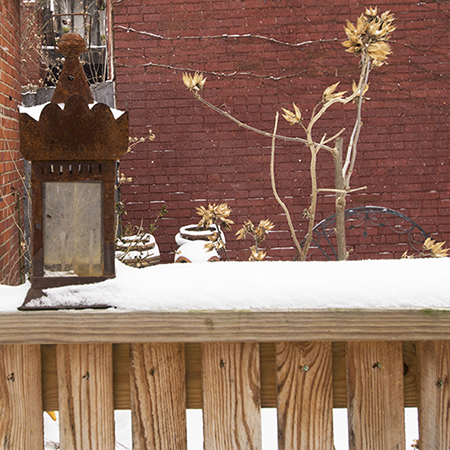
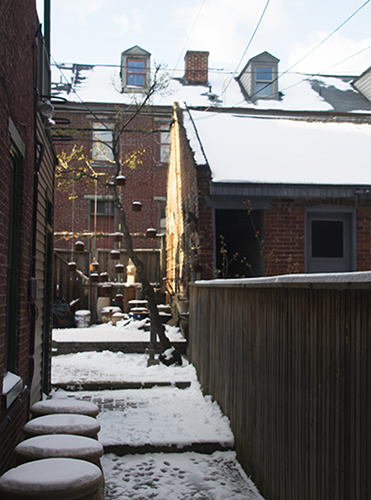
The back-yard is totally covered in snow and it’s still coming down. (I shot the pic from the alley-window in the downstairs big-room. It’s the side-yard and east-side of the back-yard. The burlap covered pots hold hosta. I covered them to stop the vagrant squirrel from digging in them, but it just ripped the burlap. What’s next, chain-mail?) Somewhere under all that white covering are crocus, snowdrops and other early bulbs. Will they be dead when the snow finally melts? My Japanese lilac, in the back there, is full of green buds; the peach tree is also ready to bloom; hope the tender leaves don’t freeze. And the newly planted apricot is also a great worry. My only consolation is that the storm wont freeze the thawing ground and therefore the roots should be OK.
It’s hard to believe that only days ago, I shot the pics of the spring bulbs in the slide-show. And how long will it be before all this new snow melts? The forecast for the next couple of days is not for warm weather.
Yesterday, I cancelled my travel plans, because I didn’t want to travel the New York Throughway and the snow-belt that is Buffalo. Snow totals for the area were in the 8 to 10 inches with hazardous driving conditions. On the Canadian side, the strip between Niagara and Hamilton got dumped on, but Toronto missed it. And because Toronto was storm-free, Porter was able to fly and I did not get a full refund on my cancellation. The damage was $67 between the cancellation and the rebook.
I had opted to travel to Sault Ste Marie in March, thinking that there would be less chance of winter weather and winter driving, man did that probability prove wrong.
Also, today I got rid of a 70s hold-over – a platform bed. Taking the platform apart was an awakening especially considering what Ikea has been able to do with pre-fab furniture. The platform was primitive by Ikea standards.
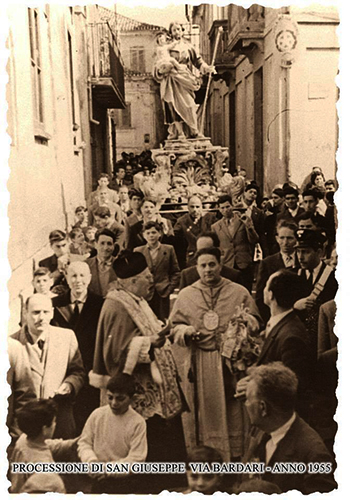
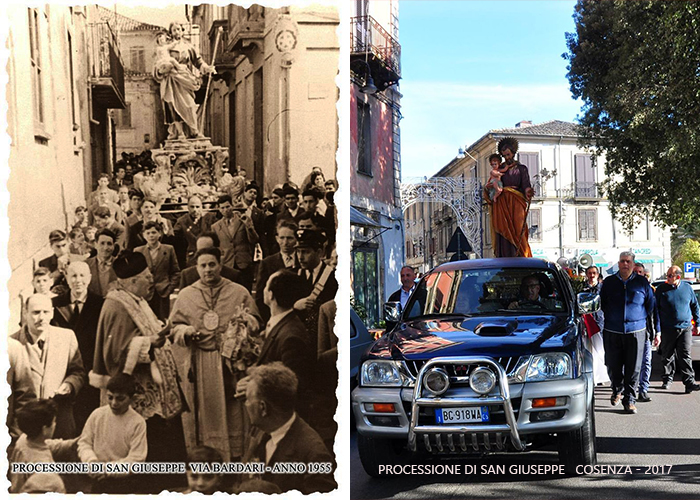
part one
March 19 is the feast-day of Saint Joseph. The holiday’s roots date back to the middle ages, when Sicily underwent a major drought that threatened a massive famine. The locals prayed to their patron saint to bring them relief in the form of rain. In exchange, they promised to honor St. Joseph, the husband of Mary, with a proper banquet. Sure enough, he answered their prayers. In return, they feasted on local foods such as fava beans, which thrived after the rain, as well as many sweets. Since the feast occurs in the middle of Lent, it is a meatless celebration.
The Father’s Day angle is a more modern emphasis. As Catholicism shrinks to a tradition, rather than an active religion, the day is more about fathers than the Saint. (Most notices on social media have holy-card pictures of St. Joseph, but text over the images wishing congratulations.)
There are two things I associate with this date:
There was little fanfare in Aprigliano around St. Joseph, because none of the churches had statues of him and therefore there were no processions. Interesting enough all my relatives from Aprigliano are posting congratulations to fathers and little about the feast-day on their Facebook pages. Even the dessert most associated with this feast-day – zeppole, a dough fritters covered in sugar – are not common in the Apriglianese sweets repertoire.
The old, 1955 postcard is from Pizzo Calabro, a small sea-side town on the Tyrrhenian Sea in south-western Calabria. The photograph on the right (photographer Osvaldo Spizzirri) is from the procession in Cosenza earlier today. (By American standards, Aprigliano is like a suburb of Cosenza, most Apriglianesi work, shop and socialize in Cosenza.) Both pics were posted on the Facebook page Calabria Ieri e Oggi.
Oh my, how things have changed in 62 years!
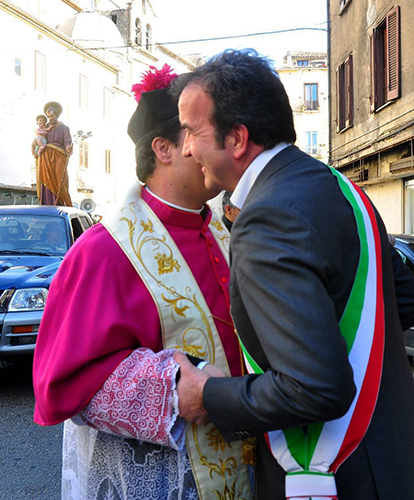
 part two – click to go to part one
part two – click to go to part one
This photograph was in the collection of images that Osvaldo Spizzirri posted on Facebook yesterday after the procession for St. Joseph in Cosenza. I had to use it. The man in the red-pink cassock and white-gold stole is some bishop or other; the man in the suit and sash is the mayor of Cosenza, Mario Occhiuto.
It’s common knowledge that the Pope gets his largest audiences in Puglia, Campania, Basilicata, and Calabria. They are regions where Catholicism still holds a firm grip. And they are also some of the least developed, most rural areas of Italy.
So, it’s no wonder that the St. Joseph celebration in Cosenza shows the affinity between church and state. An affinity that has not served the people of the Mezzogiorno, or southern Italy well. Mother Church has just been another controlling factor in the lives of the Italian contadini.
I remember my utter depression when at Monte Cassino I realized that in 1944 while Calabria emptied, because its people were starving, Mother Church rebuilt the Benedictine monastery, bombed by the Allies, in 6 months. Tell me Mother Church was about the poor, the hungry, the forgotten, the victims of Italian and German fascism. Go ahead, tell me.

It’s no different now; the church where the statue of San Giuseppe was housed is well maintained, its outside walls freshly plastered and painted, but the historic center of Cosenza, where the church is located, still looks like a slum. (Calabrians don’t seem to gravitate to gentrification or restoring their Medieval heritage. The cry seems to be, “Let’s move out and into new construction.”)
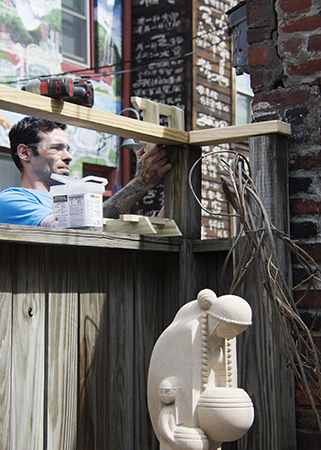
 I needed to solve two problems – replacing the weathered 2X4 cap on the wolmanized back fence; and creating guide-rails to hold the ever-growing wisteria vine. Where the fence posts and pickets have held up exceptionally well, the 2X4s across the top had deteriorated. Also, I had started weaving the wisteria around the old caps and as the vines thickened they were swallowing the old 2X4s. It was time to replace the fence caps and to design a workable solution that would allow the vine to grow and spread.
I needed to solve two problems – replacing the weathered 2X4 cap on the wolmanized back fence; and creating guide-rails to hold the ever-growing wisteria vine. Where the fence posts and pickets have held up exceptionally well, the 2X4s across the top had deteriorated. Also, I had started weaving the wisteria around the old caps and as the vines thickened they were swallowing the old 2X4s. It was time to replace the fence caps and to design a workable solution that would allow the vine to grow and spread.
This will be the third season for the wisteria and it’s easily some 30 feet long. (Wisteria has a very rapid growth rate – up to 10 feet a year.) It’s a genetically altered plant and it already bloomed last spring. (In the old days, before genetically modified plants took over, the rule-of-thumb was that wisteria didn’t bloom its first 7 years.) Also, you can trick the plant into blooming by planting it in dire soil conditions – a nutrient starved soil can triggers the plant’s survival mechanism forcing it to bloom and seed. I planted the vine in the most inhospitable corner of my back-yard. I still remember walking the Upper East Side and seeing wisteria growing among the cement cracks of the front pads and seeing the vines, full of flowers, snaking up the fronts of the brownstones.
Years ago, we planted a wisteria at Rick-and-Sarah’s, but it has never produced flowers. It was probably not a genetically modified variety and we planted it in very rich, well-watered soil. Every year the plant covers their back deck in a luscious, green canopy, but it doesn’t bloom. It doesn’t need to; it’s living in the mar-a-lago section of a Wilkinsburg back-yard.)
The contractors at DNL Home Improvement came up with these Japanese looking brackets that got screwed on the sides of the new caps across the back-and-side fence. (In the slide-show, the second image is of the wisteria twisted around the old weathered 2X4 and the third image is the wisteria inside the new brackets.)
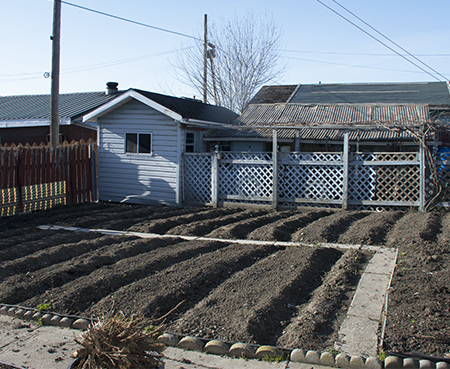
 My 91 year-old father plowed the entire back-yard, (The image shows only half of the garden.) cut down a 20-foot tall plum tree and is now growing tomato seeds in the small sun-room. And his latest medical issue – giant cell arteritis – hasn’t slowed him down any.
My 91 year-old father plowed the entire back-yard, (The image shows only half of the garden.) cut down a 20-foot tall plum tree and is now growing tomato seeds in the small sun-room. And his latest medical issue – giant cell arteritis – hasn’t slowed him down any.
The trip up was easy – guess Good Friday means the airports are not too busy. The flight from Pittsburgh had some 30 passengers, but the flight to the Sault was full.
This was a trip I was supposed to have done back in March – driving to Toronto and then flying up to the Sault, but the unexpected snow-storm put off driving the New York Throughway. It took three phone-calls to Porter before I got an agent who was able to figure out a new itinerary that wouldn’t cost me a fortune. He kept parts of the original Toronto/Sault ticket and just added a new return date and a Pittsburgh/Toronto leg to the reservation. The whole change-package cost me $100 more than the drive-and-fly trip I had originally planned.
This is not my favorite time to come up north; the region can still be in the grips of cold weather, the left-over snow-piles can look like mountains of filth and the sand that was used on the ice-covered roads can swirl into eyes and ears and noses. But the weather isn’t extreme; the dirt speckled snow-piles are almost melted; and the sand has been cleared away. (They’ve had a lot of rainfall and this helped clean the streets of sand-powder and blackened ice-chunks.)
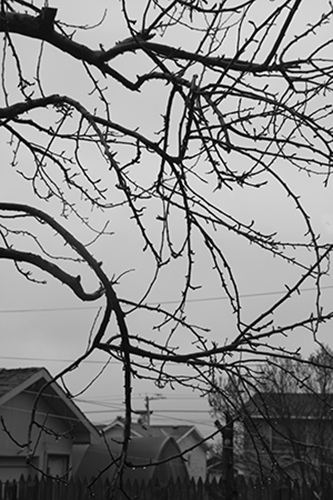
 If I was prone to Catholic imagery, I would have used this pic with yesterday’s post (Good Friday). It was great stripping what little color was left from the image and have it look almost B&W.
If I was prone to Catholic imagery, I would have used this pic with yesterday’s post (Good Friday). It was great stripping what little color was left from the image and have it look almost B&W.
After driving my mother to visit her friends, I headed for the neighborhood below old St. Mary’s College – the Catholic boys’ high school I attended – to scout it for a photo trip. OMG, the area between the railroad tracks and the slope of hill is a wreck. After the James Street area, it’s the second oldest part of town and it’s showing wear. Even when I lived here, it was known as a low-income area full of Protestants. And the economic migration for this non-ethnic group was to go from this central section to the east-end.
There’s no Catholic church in that central part of town, but it’s full of old Methodists, Lutheran and Anglican churches. For my grandparents’ generation it was a desirable neighborhood, because it meant you could move out of the tenements in James Street and into one of the many small, newly-built houses. Both of my grandparents were buried from a funeral home in this Protestant section of town and my parents have made similar arrangements. (The march to assimilation continues across generations.)
The original town was laid out between the St. Mary’s River and The Hill. The plain had room for the steel-mill, the tube-mill, the rail-yards, the highways and the workers’ houses. Along the riverbanks, long cargo ships unloaded coal and other raw materials needed to make steel. Through the locks, connecting Superior to the rest of the Great Lakes, ships brought out raw materials and finished steel. Modern Sault Ste Marie has moved away from the industrial yards that gave it life; it has moved to the top of The Hill. And modern Sault Ste Marie has followed the hilltop west, abandoning the once-desirable east-end. (The eastern part of town, and the portion of The Hill that borders it, is Indian land and not available for development.) Locally, The Hill has no identifying name, instead it’s named and added into conversation based on the street that climbs it – Second Line Hill, Bruce Street Hill, Pim Street Hill.
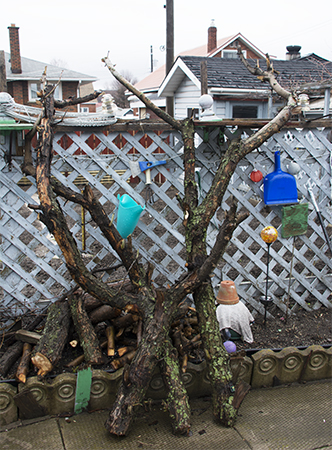

Talk about a glooming hanging over the land. It’s day two of cold, wet and gray. Bet there were no sun-rise services anywhere in Northern Ontario.
And given that gray is the color, there’s a need to find something other. Can these qualify – the green moss, the blue plastics, the yellow globes, the white towel, the clay pot, the arctic-blue fencing? Can they lighten a dreary morning?
The branches are off the plum tree my dad cut down. He will finish removing the rest of the trunk and the lower branches once he gets the chain-saw serviced. It’s amazing that a 91 year-old is taking down 20-foot trees.
Easter lunch was pleasant and low-keyed. It was a Sunday meal with a few extras – Connie and Ron, Uncle and Aunt, Rose and Derrick, my parents and I. Here in Canada, Easter and Catholicism don’t have the same cultural pervasiveness that they do back in Calabria.
In contrast, my relatives in Cosenza have been uploading hundreds of pictures showing Palm Sunday processions, passion plays complete with chubby Jesuses and fake blood, Good Friday stations led by arch-bishops and Holy Saturday services with huge vigil fires and giant Pascal candles. The rituals of the week have brought the people of the Calabrian hill-towns into the streets to celebrate both spring and their shared cultural heritage.
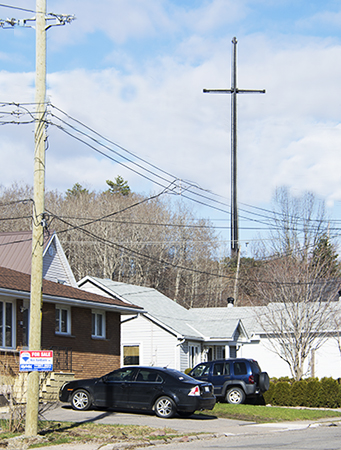
 The following is an excerpt from Brian Kelly’s March 22, 2010 article in the Sault Star.
The following is an excerpt from Brian Kelly’s March 22, 2010 article in the Sault Star.
The 12-tonne cross was erected by the St. Mary’s College Men’s Club on May 14, 1960. It’s believed to be in the same area where a cedar cross was raised on June 14, 1671 as part of a French celebration that drew thousands of aboriginals.
A monster bingo, the largest ever in the city at the time, was held at the Memorial Gardens in 1958 to help pay for the cross’s construction.
The cross, which can be seen for about 30 kilometres, is lit by 15 bulbs.
Bill Taylor, Mike Perepelytz and Mike Lukenda spearheaded the cross’s creation.
An acre of land is leased for a dollar a year from Huron-Superior Catholic District School Board.
The following are excepts from Mike Verdone’s November 13, 2014 article in the Sault Star.
The cross that stands on Moffly Hill near St. Georges Avenue East, is one of the largest in North America.
It was erected in 1960 as a reminder of a wooden cross that was erected on a hill in the area — more than 340 years ago — overlooking the St. Mary’s River after the French proclaimed sovereignty over a vast portion of the New World.
In 1671 the wooden cross was the centre piece of ceremony dedicating the area to God.
The ceremony was reportedly attended by aboriginal people that represented 17 nations, Jesuit priests and traders, trappers and French army officers.
As teenagers, we hated the spring winds. The cold weather may have broken, but the miserable winds would flap the tennis-court nets and jar the ball enough to screw up your swing. (And you didn’t dare blame a bad lobby on the wind.) It would be late June before the winds died down enough to not interfere.
Note: The above image has been heavily Photoshopped. The last image, in the slide-show, is a more accurate representation of the area.
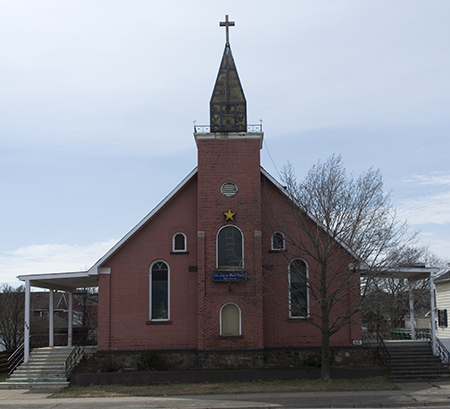

When my grandparents first came to Canada, to Sault Ste Marie, the Italian immigrants lived west of downtown, in an area butting up against the steel-mill. The neighborhood was called James Street after the main commercial street in the area. The stores on James Street were all owned and operated by Italian families – Tagliabracci, Scarfone, Bumbacco, Greco, Spadoni, Boniferro.
By the time we arrived in the late 50s, many of the Italians had moved to the north-side of the west-end. The north-side was separated from the official west-end by rail-yards and the Tube-mill. My grandparents were part of the first wave to leave the west-end and head north to the other side and that’s where we first lived when got to Canada. But they still went back to James Street to shop; and we all went back to the west-end for Midnight Mass at Our Lady of Mount Carmel – the Italian church.
Biagini Studios, which all the Italians used for births, first-communions, engagements and weddings, was the premier photography studio in town and it was in the west-end. My aunt-and-uncle’s wedding pictures were all take at the studio. (End of November 1957, and little May-ree-oh, in his Sunday-best that Mafalda brought from Calabria, is standing sideways at the end of the family line in his little suit-jacket and looking like a little old man with a pot belly.) I remember this huge camera and the photographer getting under a dark-cloth and the noise and burst of the flash-powder.
My sister Jo’s first-communion pictures were taken at Biagini’s. And she has the famous 1970s big-hair; we’re talking a serious bouffant, big enough to put a crown around it. (At least she wasn’t on a kneeler looking off at a superimposed Jesus surrounded by heavenly clouds.)
I bought my very first pair of hockey-skates, used, at a shoe-store next to the James Street Hardware. I can still picture the wooden display-box, up on 2X4s, and full of worn skates. The leather was all scuffed, the blades covered in dust and my friend told me that they would need sharpening. They were so narrow and so uncomfortable, but buying a new pair that actually fit was beyond the means of a struggling immigrant family. A new pair of skates was more expensive than dress-shoes. Oh yeah, my parents were gonna buy me skate; skates and hockey-sticks were frivolous things; things for English people. (I used my Christmas money to buy that first pair; I think they were $6.00.)
The Sanguinettis lived in the James Street area when they first came from Calabria. (Joe was born while they were still living in the Italian section, and I babysat him in that second floor walk-up.) From there they moved eastward to Bush Street and then finally to the new subdivision at the northern corner of the expanded west-end, to Digby Crescent. I remember when they moved into the new house; my dad was helping and took me along; I carried in a coffee-table with a glass top. (What strange details the mind keeps and brings forward.)
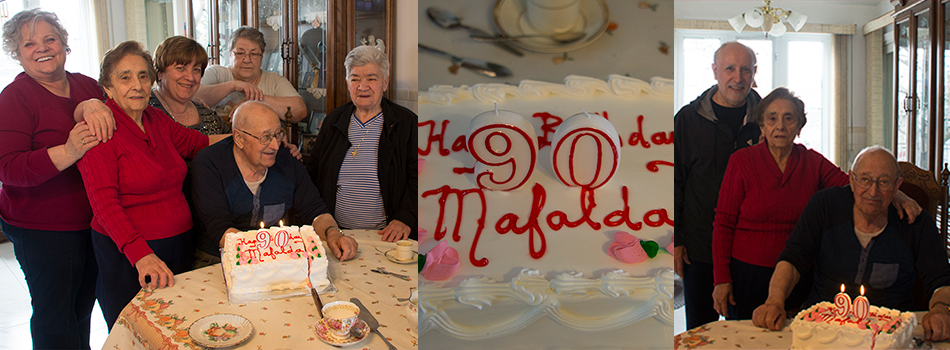
 left to right – Zita, Mafalda, Elda, Angie, Nunzia (sitting Francesco)
left to right – Zita, Mafalda, Elda, Angie, Nunzia (sitting Francesco)
Mafalda’s birthday was March 2, but this was the first free date that her friends – Zita, Elda and Nunzia – could get together to celebrate. They came by around 11:00, dropped off a cake, picked up my mom and headed out to lunch. Afterwards, they came back here for coffee, cake and happy-birthday singing. (They pulled in as Angie was heading home and convinced her to turn around and join them for cake.)
Mafalda told me, before the ladies came, that they wanted me to be ready to take pics. OK, I can do that.
Once they had the coffee made and the cups and plates on the table, my dad and I were called upstairs.
The cake was from the Calabrese bakery up the street and it was really good – thick layers of cream surrounded by moist cake.
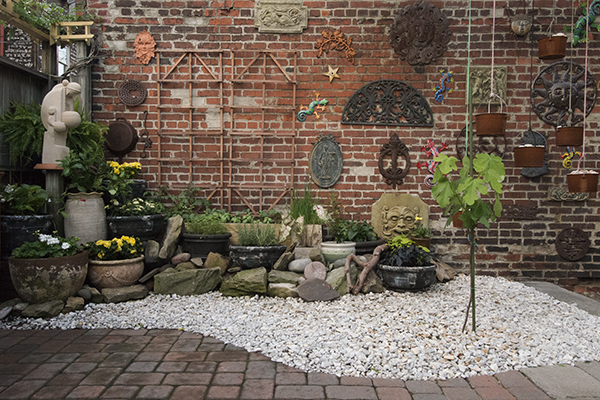
 The common wisdom, in this part of the country, is to wait until Mother’s Day to plant annuals. Well, I’m two-and-a-half weeks before the guaranteed frost-free date.
The common wisdom, in this part of the country, is to wait until Mother’s Day to plant annuals. Well, I’m two-and-a-half weeks before the guaranteed frost-free date.
The flowering plants seems to be relegated to the left corner and only white and yellow are being featured this year. Yes, that’s a fig tree in the foreground. It’s a Chicago Fig touted as able to survive our Zone 6 winters. I’ll let you know how that goes. And it’s a dark fig not the desirable, uppity white variety I had from Aprigliano. Also, returning for a new season are the oregano and the chives planted last year.
Confession time – I did something I’ve never done before – throw plants away. I wanted to cram the vegetable planter with seedlings and so I bought 2 cherry-tomatoes, 6 basil, 4 zucchini and 4 cucumber plants. Even though I hated the taste of the cucumbers and the vine had become totally infested by the striped beetle, I put 4 of the plants in my cart. (Come on, they were big and bushy. And I pretended that this year, the cubes would taste better.) Then on Saturday, I went to another nursery and they had a Burpee variety that I knew and immediately decided to replace what I had. This would mean pulling out and throwing away what I had planted only days ago. The next trow-away was for aesthetics. It appears that Dragon-wing Begonias, my favorites, only come in red and that’s not a desirable color this year. (Need I remind you who perpetually wears an overly long red tie to cover his bulging fatness?) So today, I bit the bullet and replaced the beautiful Dragon-wings with a hybrid Wax Begonia, in white.


Acupuncture, an imaginative light sculpture by German artist Hans Peter Kuhn, will appear to “pierce” the roof and south-facing side of the building. The installation will include components of what Kuhn calls “light sticks.” Attached to metal scaffolding, the “sticks” will appear to cut through the top floor of the building, coming out of the roof, and then cutting back through the staircase tower. The installation’s size and configuration will make the piece visible from all angles, throughout the neighborhood and the city.
From the Mattress Factory website
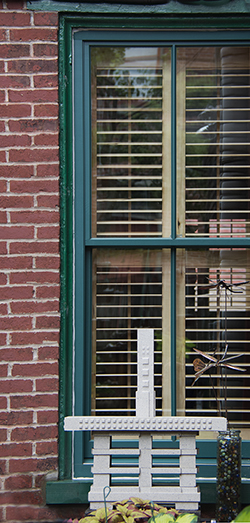

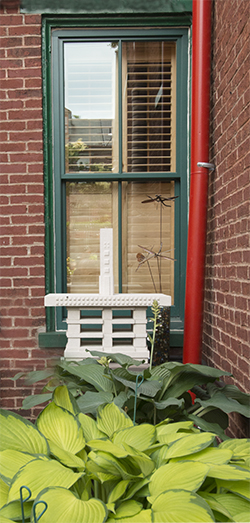 The shots are down the side-alley and the focus is the white concrete structure with the vertical thingy on top. In the left image, I purposely opened the louvers to add to the horizontals – bricks, mortar-lines, louvers, window-sashes. In the right image, because I wanted to show the copper insects and because I wanted a background for the birdhouse, I shut the lower louvers.
The shots are down the side-alley and the focus is the white concrete structure with the vertical thingy on top. In the left image, I purposely opened the louvers to add to the horizontals – bricks, mortar-lines, louvers, window-sashes. In the right image, because I wanted to show the copper insects and because I wanted a background for the birdhouse, I shut the lower louvers.
A quartet of birdhouses sits perched atop the Darwin D. Martin House conservatory roof – one at each of its four corners. Frank Lloyd Wright designed these solid limestone structures for the Martin House Complex as homes to attract the purple martin – North America’s largest species of swallow. It is also believed that Wright intended these birdhouses to serve as a whimsical, yet metaphorical, nod to his clients – the Darwin D. Martin Family. It is not fully known whether purple martins ever nested there; regardless, the birdhouses with their distinctive Pagoda-like shape are an architectural element unique to and in complete harmony with the overall composition of the site.
I can tell you that no self-respecting swallow took up residence in Mr. Wright’s stone dwelling. Man, his houses look great, but live in one, NEVER! We all know humans, with their little brains and giant egos, can be talked into almost anything. Think stiletto heels, neckties, skinny jeans. But I assume purple martins don’t have a style obsession or a better-than gene and therefore flew by the whatchamacallits on the roof of the fancy-house and down to the homey birdhouses built by the little kid and his parent on the next block. (The Martin House is surrounded by regular, 1940’s, Buffalo houses – two-and-a-half story, wood construction, clapboard siding, peaked roof.)
One last thing – the birdhouse weighs nearly 140 pounds. Good thing it’s in pieces – the finial, the roof-slab and the 3-floor residence. It was delivered wrapped in cellophane and situated on a huge pallet. The delivery person left it on the sidewalk and I had to take the wooden crate apart to get to the birdhouse.
Also, the 32″ high pedestal that it sits on, weighs close to 300 pounds. It’s the concrete base of a fountain, but because it’s cracked, the guy at the greenhouse was willing to sell it separately. I got it for $50. It took 3 big guys to load it into my Forester. And I drove around with this monster in the back, for almost a week. (Yes, weight impacts gas consumption; filled the tank twice in one week.) Finally, last night, my neighbors – Marcus and his dad – helped me lift the pedestal out of the back of the car and onto a hauler dolly.
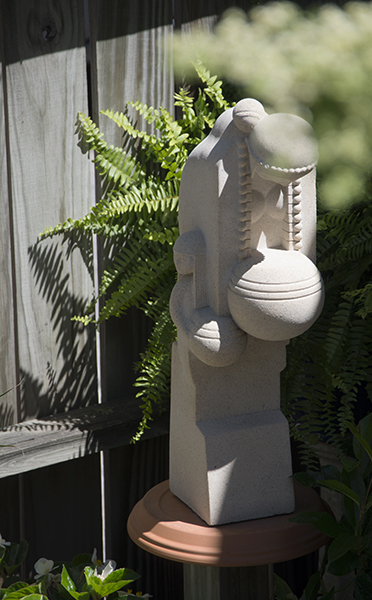

we plow the fields and scatter
the good seed on the land
but it is fed and watered
by god’s almighty hand
he sends the snow in winter
the warmth to swell the grain
the breezes and the sunshine
and the soft refreshing rain
all good gifts
we thank thee then
for all things bright and good
the seedtime and the harvest
our life, our health, our food
no gifts have we to offer
for all thy love imparts
but that which you desire
our humble thankful hearts1
1 All Good Gifts – Godspell (modified lyrics – I tried to de-god them, but had to leave in one reference.)
In the play, the song and the scene portray the ultimate hippie stereotypes – the cast holds hands and dances around the actor singing the simple song; and as they get to the end-chorus, they lift the singer up and out of their closed circle.
2 The title is in dialect. My parents would often talk about the post-war years in Calabria as a time when, ud aviamu mancu nu coccio e granu – we didn’t even have a grain of wheat. Standard Italian flattens the phrase to – non avevamo nemmeno un seme di grano – removing all the emphatic guttural sounds of the dialect. Sorry, the old Calabrese, using a double negative, drives home the dire straits of a people on the verge of starvation. The old Calabrese captures the desperation of a people mired in feudalism and then abandoned by the same patroni – landowners – who had subjugated them.
The Winnabago Indian woman, holding the pannier and carrying her two children, is the Frank Lloyd Wright Nakoma statue in my backyard. (I shot the image from my second floor porch and the yellow haze, in the top right corner, is an out of focus white lilac blossom.)
The sculpture represents both the sentiment of the song and the tragedy of nurturing children during periods of deprivation.

 where are you going
where are you going
can you take me with you
for my hand is cold
and needs warmth
where are you going
far beyond where the horizon lies
and the land sinks into mellow blueness
oh please, take me with you
let me skip the road with you
i can dare myself
i’ll put a pebble in my shoe
and watch me walk
i can walk, i can walk
i shall call the pebble dare
we will talk, we will talk together
we will talk about walking
dare shall be carried
and when we both have had enough
i will take him from my shoe, singing
meet your new road
then i’ll take your hand
finally glad
that you are here
by my side1
1 By My Side – Godspell (modified lyrics) In the play, the haunting lyrics are sung by the Magdalene watching the man, who has just forgiven her, go off to be arrested and crucified.
2 The title is again in dialect. My mom and dad and others of their generation would say, è nu garofalu russu – it’s a red carnation. Standard Italian sanitizes it to è un garofano rosso. Sorry, the old Calabrese is less fussy, less flat; the dialect is robust, guttural.
I garofali russi are in my backyard, and I shot the image with a 40mm micro lens.

 The honey bees, and I’m talking big fat ones, are all over the wisteria flowers. Last year, a few visited, but this spring it seems like an entire hive has found the the purple clusters on Sampsonia Way.
The honey bees, and I’m talking big fat ones, are all over the wisteria flowers. Last year, a few visited, but this spring it seems like an entire hive has found the the purple clusters on Sampsonia Way.
Wisteria facts
Wisteria is deciduous vine that belongs to the pea family.
Lounging languorously over a fence or pergola – the charms of wisteria are almost impossible to resist. Marco Polo was an early conquest. He brought seeds back from China.
The world’s largest known wisteria is in Sierra Madre, California, covering more than 1 acre and weighing close to 500,000 pounds. It was planted in 1894 and it’s a Chinese lavender variety.
In modern times, botanists are making new plants from layering or grafting; these methods have produced plants that bloom quickly and abundantly.
Chinese and American wisteria twine in a clockwise direction; Japanese wisteria twines in a counter-clockwise direction.
Bees and hummingbirds are the main pollinators of wisteria.
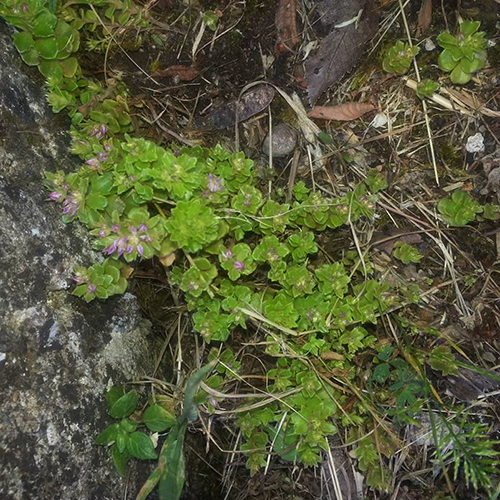
 This post began life last week when Lucy Gagliardi, a FB-friend from Aprigliano, posted about the Feast of the Ascension on Thursday, May 25. She explained the old Apriglianese tradition of collecting a furtunella – a good luck plant – on your way home from Ascension Thursday Mass. As a kid, I remember collecting the plant and bringing it home for my mom to hang on a nail on a wall in our kitchen.
This post began life last week when Lucy Gagliardi, a FB-friend from Aprigliano, posted about the Feast of the Ascension on Thursday, May 25. She explained the old Apriglianese tradition of collecting a furtunella – a good luck plant – on your way home from Ascension Thursday Mass. As a kid, I remember collecting the plant and bringing it home for my mom to hang on a nail on a wall in our kitchen.
I spent most of the week trying to identify the plant known in dialect as a furtunella. Lucy sent me a picture she took with her phone, and Maria Lucia Le Pera posted the image on the left.
The references I found on google.it were under the title l’erba dell’ascensione – grass of the Ascension. And that made sense – generalizing the legend and linking it specifically with the Feast Day. The research placed the legend of a plant, collected on the Feast of the Ascension, and bringing good luck, to the towns and villages of central Calabria; and identified the plant was a succulent belonging to the sedum group. Google images along with Lucy’s and Maria’s pictures helped me narrow down the varieties in the group to sedum stellatum.
The most surprising finding was that the plant was a succulent. That had never crossed my mind, but once I thought about it, it made perfect sense. Calabria is dry and desert-like; succulents would be common wild flowers in that environment.
According To My Cousin Annarita Femia
The legend
A furtunella, è una pianta inodore con dei fiorellini rosa tenui.
A furtunella is a plant with soft pink odorless flowers.
Si racconta che nella festa dell’ascensione viene raccolta e appesa al muro a mazzolino,
It’s said that if on the feast of the Ascension, you pick a bouquet of it and hang it on a wall,
nel corso dei giorni essa fiorisce e i suoi rametti vanno verso su,
and if during the following days it blooms and branches up,
se succede questo porta fortuna.
then good luck and good fortune will come to that home and that family.
grazie – Lucy, Maria Lucia, Annarita
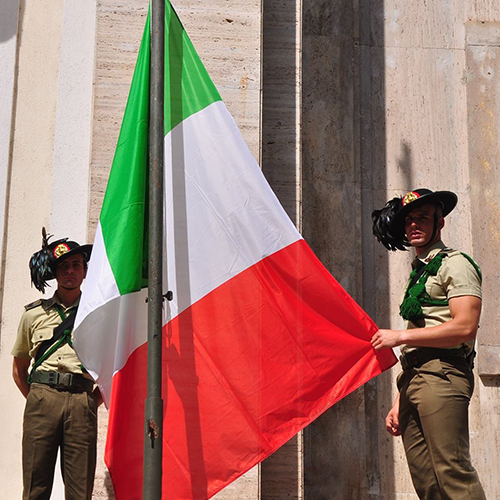
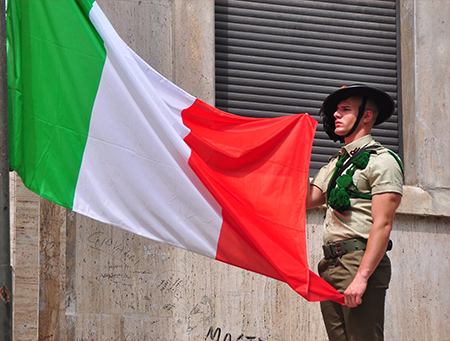 The Festa della Repubblica is the Italian national holiday celebrated on June 2nd. It commemorates the institutional referendum of 1946 when by universal suffrage, the Italian population was called to decide what form of government – monarchy or republic – to give to the country after the Second World War and the fall of Fascism. With 12,717,923 votes for a republic and 10,719,284 votes against, Italy became a Republic; and the monarchs of the House of Savoy were deposed and exiled.
The Festa della Repubblica is the Italian national holiday celebrated on June 2nd. It commemorates the institutional referendum of 1946 when by universal suffrage, the Italian population was called to decide what form of government – monarchy or republic – to give to the country after the Second World War and the fall of Fascism. With 12,717,923 votes for a republic and 10,719,284 votes against, Italy became a Republic; and the monarchs of the House of Savoy were deposed and exiled.
The referendum swept away the feudalism that both the monarchy and the church used to subjugate the people of the peninsula. And let’s not pretend that it won by a great majority; it won by 5%. Does this mean that only after horrendous experiences will people consider advancing systems that push for expanded human rights?
The pic was taken by Osvaldo Spizzirri during the holiday celebration in Cosenza. (Notice the graffiti on the wall behind the flag.)


This was my first time in a Frank Lloyd Wright prairie-house. The Darwin D. Martin house in Buffalo was a wonderful surprise. It actually works as a house – unlike Fallingwater and Kentuck Knob. The kitchen in the Martin house is functional, spacious and beautiful. (I kept thinking of the octagonal, claustrophobic kitchen in Kentuck Knob. This was nothing like it.)
I could actually see myself sitting in any of the first-floor rooms of the Martin House. I can never picture myself in any of the overwhelming spaces of Fallingwater or Kentuck Knob. Do I want to sit on the step going down to the stream at Fallingwater? Absolutely! Do I wanna have dinner at Fallingwater? Absolutely not! Would I like to sit in the library at the Martin House? Absolutely!
The Martin House has been greatly restored – much of the original complex was left to the elements or torn down and only through the efforts of the Martin House Restoration Corporation have the property and the structures been brought back to life. The corporation used photos taken in 1907 as their blueprints for the extensive restoration. For example in the space between the main house and the carriage house, Wright designed an amazing pergola – breeze-way – to connect the two buildings. After Mrs. Martin abandoned the house, because she could no longer maintain it, the space between the main-house and the carriage-house was sold to developers who took down Wright’s pergola and put two five-story apartment building in the space.
The above photo is of the pergola.
This is the first entry for the June trip to Toronto and Sault Ste Marie.
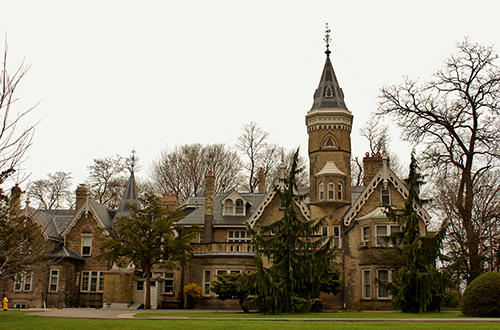
 I spent the day with my friend Booby walking the area around De La Salle College in the Summerhill neighborhood of Toronto. Bobby is the head of the Board of Trustees for De La Salle College and he was in town for a meeting.
I spent the day with my friend Booby walking the area around De La Salle College in the Summerhill neighborhood of Toronto. Bobby is the head of the Board of Trustees for De La Salle College and he was in town for a meeting.
The various Christian Brothers districts throughout Ontario and the U.S. have consolidated and Bobby, an American Christian Brother from New York City, now works with the Brothers’ schools in Canada. It’s the first time that I met one of the guys I was in Novitiate with here in Canada.
The above image is the Brothers’ House on the campus of De La Salle College. The elaborate mansion was built in the 1860s by John McDonald, a successful dry goods merchant. The sprawling house – Oaklands, because of the many oak trees on the property – was completed with a tower observatory that provided Mr. McDonald with a clear view of Lake Ontario some 5 kilometers to the south. The Oaklands mansion has been designated as a historical building by the City of Toronto, as an example of local Gothic Revival architecture.
The Christian Brothers have run a school on the property since 1931. The school is named after the founder Jean-Baptiste de La Salle.


My goal today was to figure out how to get from Oakville to the Toronto City Airport using public transportation. (The last couple of times I did this, I used a cab and that was an $80 tab going and a $100 tab coming back.)
At 7:00 am, Seane drove me to the Oakville GO-Train station; the ticket to Union Station – downtown Toronto – was $9.00. I got on an express and was downtown in 30 minutes. (The QEW/Gardner at that time of morning was crawling with commuter traffic.) From Union Station, I walked the block to the Royal York Hotel and got on the courtesy shuttle to the airport.
Connie picked me up in Sault Ste Marie and we headed to my parents where we joined Dom, Marcella, their grandson Dawson and my parents for lunch. The garden is full of plants whose seeds wintered in the frozen ground. Fava, swiss-chard, garlic, carrots and spinach color the brown earth in my dad’s garden. My mom made fritters, a salad and a soup from the fresh spinach.
In the evening, I went over to Connie-and-Ron’s to visit and take pictures. It’s early spring here in the north country and the fields are covered with wild-flowers. (At this time of year, they have almost 45 minutes more daylight than we do in Pittsburgh. It was 9:33 and it was not even twilight.) The above image is from Connie-and-Ron’s property on Allen Side Road in the south-western section of Prince Township.


The last time I was in the Sault, in early June was 1968; and I had forgotten about the extended daylight, the dark-green lawns and the ubiquitous lilacs – their thicket fill the yards. So this morning on my walk to my aunt-and-uncle’s all these markers of spring in the north-country were everywhere.
The west-end – from Goulais Avenue to Korah Road – is filled with lilac trees. This older section was full of Polish, Ukrainian and other Eastern European families. (Interestingly, lilacs are native to the Balkans. Did the early immigrants bring seeds with them?) Every house seems to have several lilac trees in their yard. And it was amazing to see that many lilac trees in full bloom. But as soon as I crossed Korah Road, the trees disappeared.
The area north and east of Korah Road is the newer section of the west-end. Houses in this area are from the 1960s and the 1970s; there are even newer subdivisions in the quadrant. Guess these immigrants, people like my grandparents, saw themselves as different, as younger than the Slovaks that filled the streets closest to the mill. And these immigrants were from Western Europe and they planted fava, rapini, and tomatoes. No one planted cabbage or root-vegetables; those winter-hardy crops belonged to the Polacks over there in the old section of the west-end.
The first time I visited Rome was in June of 1972 and the streets were lined with blossoming Japanese Lilacs. Their scent filled the city. I still associate Rome with that scent. And it was such a strong and lingering memory that when I bought a house, the first tree I planted was a Japanese Lilac. (It’s my very own reminder of 1970’s Rome.) My parents’ neighborhood in Sault Ste Marie is purple-blue with thickets of lilacs and their scent fills the streets of the old west-end.
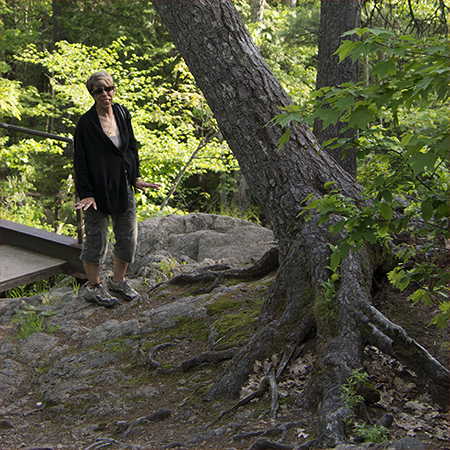
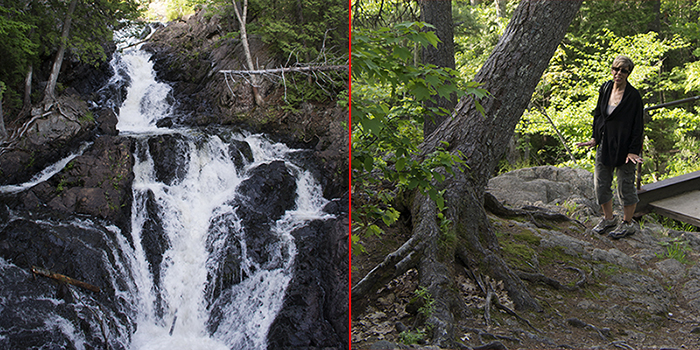 After dinner, Connie and I drove up to Minnehaha Falls. The last time I saw the falls my grandparents were alive; mid-1960s. And back then, it was known locally as Hiawatha Falls; and back then, there were stairs from the bottom of the valley up to the cascade.
After dinner, Connie and I drove up to Minnehaha Falls. The last time I saw the falls my grandparents were alive; mid-1960s. And back then, it was known locally as Hiawatha Falls; and back then, there were stairs from the bottom of the valley up to the cascade.
What I don’t remember are the mosquitoes. Holy shit! As soon as we got out of the car, we were assailed by swarms of stinging, miserable insects. As the locals like to remind me, “June is mosquitoes only month, but July, well the black-flies wake and join the swarms.” And people wanna live here, WHY?
The section of Hiawatha Park with the Falls, is run by the Kiwanis Club of Sault Ste Marie and the organization maintains a paved road down into the valley. From the parking lot, we walked up the ravine, on foot-paths beside the falls. (Connie mentioned that when she was much younger, she and her friend Jodi jumped from one of the outcrops and into the ice-cold pool at the bottom of the falls.)
Tomorrow, I get to see the area again from an airplane. Two things surprised me on this trip – the profusion of lilacs in the west-end and the various shades of green as spring fills the trees with leaves. Coming up, I saw the variant greens from the air, but wasn’t sure why I was seeing this spectrum of green. Then, I saw the variants again when Connie and I went to her cottage and realized I was looking at different trees coming-into-leaf at different points in their development towards a full crown of leaves.

 Canadian Confederation, through the British North America Act, was the process by which the British colonies of Canada, Nova Scotia, and New Brunswick were united into one Dominion of Canada. (The Act received royal assent on March 29, 1867, and set July 1, 1867, as the date for union.) Upon Confederation, the old province of Canada was divided into Ontario (Canada West) and Quebec (Canada East); along with Nova Scotia and New Brunswick, the new federation was thus composed of four provinces. Over the years since Confederation, Canada has seen numerous territorial changes and expansions, resulting in the current union of ten provinces and three territories.
Canadian Confederation, through the British North America Act, was the process by which the British colonies of Canada, Nova Scotia, and New Brunswick were united into one Dominion of Canada. (The Act received royal assent on March 29, 1867, and set July 1, 1867, as the date for union.) Upon Confederation, the old province of Canada was divided into Ontario (Canada West) and Quebec (Canada East); along with Nova Scotia and New Brunswick, the new federation was thus composed of four provinces. Over the years since Confederation, Canada has seen numerous territorial changes and expansions, resulting in the current union of ten provinces and three territories.
But it wasn’t until 1931, that Canada achieved near-total independence from the United Kingdom with the Statute of Westminster. Near independence meant that the British Parliament could amend Canada’s constitution, on request from the Canadian Parliament. Total independence had to wait another fifty years; and with the Constitution Act 1982, Canada finally took control of its constitution, removing the last legal dependence on the United Kingdom. The Constitution Act of 1982 gave Canada full sovereignty – a mari usque ad mare – from sea to sea.
I was living in Canada in 1967 when the country celebrated its 100th birthday. But wait, in 1867 Canada wasn’t a self-governing country; it was still a colony of Great Britain. And yet in 1967, all Canadians celebrated the country’s birthday. In Sault Ste Marie a brand new, state-of-the-art library was build to commemorate the centenary. My 1967 yearbook had, on the inside front-cover, a sweeping picture of the Montreal World’s Fair honoring the birthday. Isn’t the Constitution Act 1982, the real date marking Canada as a sovereign nation? But then I’m probably being too detail focused and too contrary.
Well this July 1, using the date of Confederation as its beginning, Canada celebrates its 150th birthday. (Lets note that in 1867, when John A. McDonald and the rest of the Fathers of Confederation were in London compiling the resolutions that became the British North America Act, my house in Pittsburgh was 50 years old.)
This is the last entry for the June trip to Toronto and Sault Ste Marie.
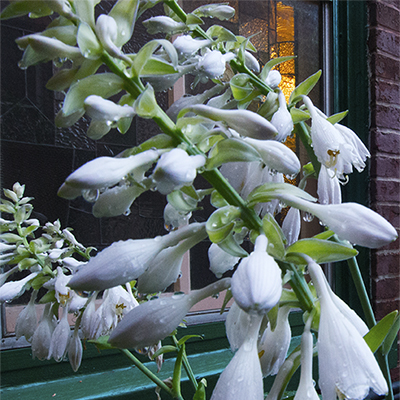
 This post is about several things: the rains we’ve had all week, the image on the left, a liqueur made with grappa & camomile and fat blueberries.
This post is about several things: the rains we’ve had all week, the image on the left, a liqueur made with grappa & camomile and fat blueberries.
the rains
I could go on about climate disruption, but I don’t know enough about the science and I don’t want to come across as another blabber-mouth. It’s just that since Tuesday, we’ve had between 8 and 10 inches of rain. That’s more a July weather pattern, but then everything these days is topsy-turvy.
I may not have to water, but the excess moisture is wrecking havoc with the roses.
the image
The rains have been crazy – one minute there’s a torrential downfall, the next the sun is out. I wanted to get an image with raindrops and went out to shoot the hosta flower-stalk. Looking through the view-finder I realized that if I shot with the kitchen window in the background, I was gonna get some strange colors on the stained-glass. What I got was the beautiful gold-brown at the top right of the image. The color comes from the overhead light in my kitchen.
And I used the gold-brown in the border around the image.
milla
Visiting my cousins Renato and Gina is always a wonderful time. This visit, the highlights were Gina’s sister and brother-in-law and Marolo’s Milla liqueur. The label describes it as a liquore alla camomilla con grappa.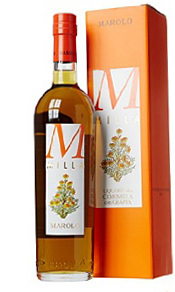
First we went on about gagumilla, camomile in Calabrese dialect. How at any sniffle, cough, ache, suggested melancholy our mothers boiled water and made a cup of gagumilla which we had no choice about drinking. (Gina and Angie’s mom is Calabrese.) We all agreed that we hated the taste; it was yuck. And yet there we were sipping the delicious extract made from camomile and laced with grappa.
I’m old enough to remember my mom making the brew with the dry, yellow-orange, daisy-like flowers. Forget tea-bags or sachets, back then you put the loose dry flowers into a cup and poured hot water over them. Drinking the tea, you hoped the stems and flowers stayed at the bottom and didn’t migrate into your mouth.
Renato and Gina wrapped up a bottle of the liqueur for me to take home. (They are very generous that way and on previous occasions, because I was worried that the custom agents in Buffalo would confiscate any alcohol, I said no to their generosity. But between the beautiful packaging and the great taste, I wanted to try getting the bottle across. The agent in the NEXIS lane had no problem with my having the liqueur and I now have a bottle of Milla in my home.)
the blueberries
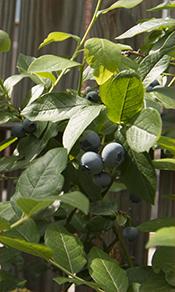 The rains have swelled the blueberries and (a) the plants are full of fruit and (b) the berries are huge. Normally, the berries are medium size, especially on the low bushes in the front. Not this year. The low bushes are full of plump berries and they actually have taste. And the rains have made this possible.
The rains have swelled the blueberries and (a) the plants are full of fruit and (b) the berries are huge. Normally, the berries are medium size, especially on the low bushes in the front. Not this year. The low bushes are full of plump berries and they actually have taste. And the rains have made this possible.
I love going in the morning and picking a bowl full to have with breakfast.
One of the dogs, loves the berries; as soon as they’re let out, he runs to the blueberries and tries his best eat anything within reach. Well that’s not allowed; the berries are for me, so I put up fencing.
Three years ago, after several disappointing harvest, I did some research and most of what I read, suggested cutting the bushes down to ground level. The first year, there was new-growth; the second spring, the plants were full of berries. And now in the third year since the drastic cut, the plants are producing more and bigger berries than ever.
The majority of the plants in the plot are over 30-years old. I have added some newer varieties, but these new plants haven’t produced fruit yet.
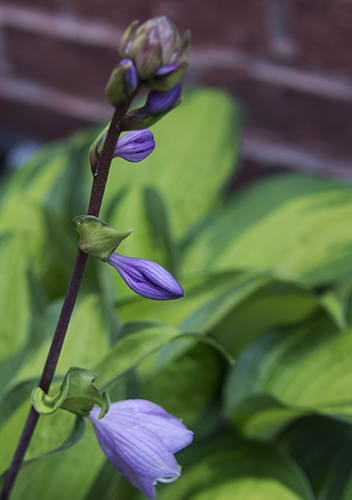

when i left my home and my family
i was no more than a boy
in the company of strangers
in the quiet of a railway station
now the years are rolling by me
they are rockin’ evenly
i am older than i once was
younger than i’ll be, that’s not unusual
no, it isn’t strange
after changes upon changes
we are more or less the same
after changes we are more or less the same
in the clearing stands a boxer
and a fighter by his trade
and he carries the reminders
of every glove that laid him down
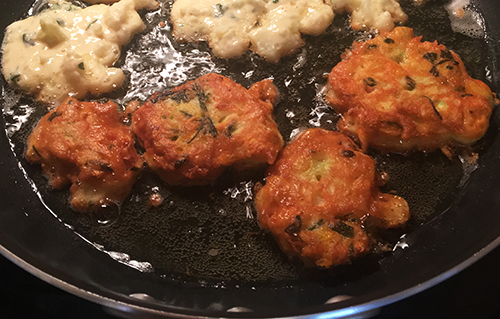
 When my neighbors re-paved their back-yard, the contractors mounded some of the excess dirt against my back fence. This is a four-inch wide mound, on the side of the alley-street – Sampsonia Way – behind my house. To prevent it from turning into a weed bed, I went to the greenhouse, grabbed some zucchini plants and stuck them in. It’ll take another couple of weeks for the plants to acclimate; they are producing small flowers and today I picked enough to make a small batch of fritters.
When my neighbors re-paved their back-yard, the contractors mounded some of the excess dirt against my back fence. This is a four-inch wide mound, on the side of the alley-street – Sampsonia Way – behind my house. To prevent it from turning into a weed bed, I went to the greenhouse, grabbed some zucchini plants and stuck them in. It’ll take another couple of weeks for the plants to acclimate; they are producing small flowers and today I picked enough to make a small batch of fritters.
I’ve been teasing with my Italian relatives that only an immigrant who still has some WOP1 in him is gonna plant zucchini on the side of an alley-street. Guilty as charged.
The title is dialect.
1. WOP is a pejorative slur used to describe Italians or people of Italian descent.

 Last spring, I made the decision to replace the ornamentals in the backyard with fruit-bearing trees or plants. (Some may say that in my old age, I’m becoming an immigrant; others may say I have too much time on my hands.) The first new planting was a Redhaven dwarf-peach. (I researched the best peach variety for Zone 6 and the Redhaven kept coming up. The variety is known for its attractive pink spring flowers, sweet yellow fruit and bright gold fall foliage. The Redhaven produces large, yellow freestone peaches that are ready for harvest midseason – July. The dwarf version of the tree, reaches only about 6 feet and can be expected to live more than 40 years with proper care.) By the end of last year’s growing season, the tree was spindly, but almost 5-feet tall. All the literature on the plant mentioned not to expect fruit in the first two or three years. But this spring, the tree had a number of blossoms. This was a wonderful surprise.
Last spring, I made the decision to replace the ornamentals in the backyard with fruit-bearing trees or plants. (Some may say that in my old age, I’m becoming an immigrant; others may say I have too much time on my hands.) The first new planting was a Redhaven dwarf-peach. (I researched the best peach variety for Zone 6 and the Redhaven kept coming up. The variety is known for its attractive pink spring flowers, sweet yellow fruit and bright gold fall foliage. The Redhaven produces large, yellow freestone peaches that are ready for harvest midseason – July. The dwarf version of the tree, reaches only about 6 feet and can be expected to live more than 40 years with proper care.) By the end of last year’s growing season, the tree was spindly, but almost 5-feet tall. All the literature on the plant mentioned not to expect fruit in the first two or three years. But this spring, the tree had a number of blossoms. This was a wonderful surprise.
The above pic is one of the peaches and it was juicy and very tasty. Imagine eating a peach that isn’t hard as a rock or a peach that you can eat by just biting into the flesh. Going out, first thing in the morning, and picking a peach off the tree and having it with my toast is what summer is all about.
And I’m certainly looking to fall and to pruning the very full tree. I found these guidelines online.
Prune the tree every year in the late fall when the leaves have all dropped and the tree is dormant. Remove all dead and diseased limbs, followed by any that grow toward the center of the tree and those that cross or rub against each other. Cut off any branches that grow straight up and shape the tree similar to a vase or lollypop. Thin the canopy by removing any branches that will shade the fruit growing at the center.
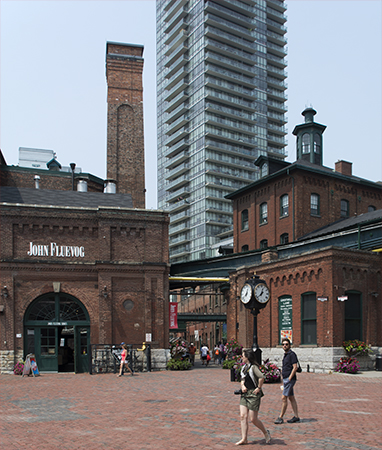
 Downtown Toronto is slowly being over-developed into a Blade-Runner environment. There are sections of the Gardner Expressway, downtown, where it’s lined with glass high-rises on both sides and when driving this portion, it feels like a Blade Runner set. All that’s missing is the constant acid-rain that bathed the building in the 1982 neo-noir classic.
Downtown Toronto is slowly being over-developed into a Blade-Runner environment. There are sections of the Gardner Expressway, downtown, where it’s lined with glass high-rises on both sides and when driving this portion, it feels like a Blade Runner set. All that’s missing is the constant acid-rain that bathed the building in the 1982 neo-noir classic.
The Torontonians refer to the over-development as the Manhattanization of their city. They insist that the many, many glass towers are making their city into a replica of the mess on the Hudson. And is everyone forgetting that winter here is not just cold, but f’in freezing?
I think of Manhattanization as a disposable architecture, allowing real-estate conglomerates to take down and rebuild every twenty years. And here in the north country even sooner. Bet that in twenty years, the glass tower behind the century old distillery buildings will be gone.
Today, we went to the old distillery district that has been reclaimed and re-imagined as a tourist area. We had lunch at a Mexican restaurant; the food was very good. One of the things that I always find in Toronto is that tourists destinations are less full of clap-trap and cheap memorabilia. The distillery district is populated with high-end restaurants, antique shops and boutique clothing stores.
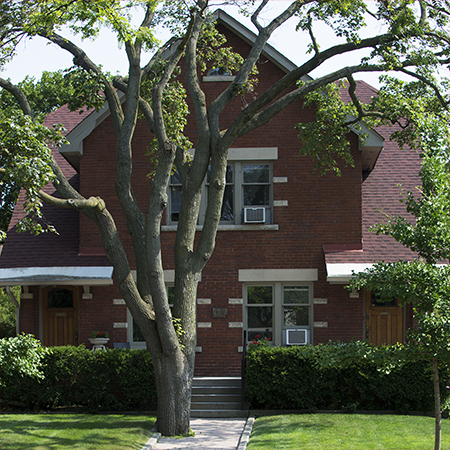

High Park is the largest in-city park in Toronto. It begins on Bloor Street and stretches all the way down to the shore of Lake Ontario. And I’ve walked around the High Park neighborhoods all my life. My grandparents lived on Jane Street and High Park was an easy destination. I remember on one visit, my mother and I walked from my grandparents’ house all the way to the entrance of High Park.
The High Park neighborhood, as well as many others east and south of Bloor Street, are filled with Arts and Crafts houses. The one in the image is on High Park Boulevard and an old friend lived there on the second floor, before he and his partner bought a house. My cousin Gina lives in an Arts and Crafts house east of High Park and below Bloor. Apparently, most of the upscale neighborhoods High Park North and Swansea included went Arts and Crafts at the turn of the 19th century.
I found the following text while doing research on the Arts and Crafts movement in Toronto.
By the time the Arts and Crafts movement had reached Canada, the defining elements were well set. The overlying theme was the house as a living element within the natural environment; it was based on the function of the home as a shelter for the family, not a banner building relentlessly trumpeting the owner’s status. Houses were meant to fit intrinsically into their sites: orientation of the house was based on the relationship of the house to the garden. Rooms were positioned to take advantage of the movement of the sun for warmth and light during daylight hours. The grandiose central entrances of so many other styles were often replaced by side entrances that allowed for manipulation of the front façade for light or garden use. Entrances were often recessed, accessed through a covered porch, giving the impression of solidity and permanence, almost like entering a cave dwelling.
And then a comment on what is happening in modern day Toronto.
Scott Weir’s excellent article on Arts and Crafts homes in Toronto sums up the sad fate of many of these homes beautifully. He says “It may be that the Arts and Crafts house’s lack of ostentation has been its undoing.” Many of these fine homes are being torn down and replaced by monster homes that are beige on beige monuments to the owner’s pretensions and self delusions. Where the Arts and Crafts aesthetic was to provide a beautiful living space built in harmony with nature and the surrounding area, many of these new buildings are simply overlapping masses of ill proportioned, unrelated architectural features. Return On Investment building (ROI Modern) is wiping out some of the best houses in the province. Instead of fine homes where people actually live and are part of the community, there is a growing trend for ‘renovators’ to hop from one spot to another gutting old homes and gutting established neighborhoods and leaving behind houses, not homes, that can only be described with Dickens’ famous term “Architectooralooral”.

 2
2
That may be the formal definition of midsummer, but I want to use the term more literally to mean the half-way point of the season – mid-way between June 21 and September 21. That would make today the middle of summer.
Where spring is renewal and re-birth, summer is lazy days and vacations. It’s the season for picnics, fireworks, baseball, for sun-bathing. It’s the season when economies slow down, when highways are filled with campers, when cities are abandoned and the country-side and the beach are teeming; it’s the time when schools are shuttered, repainted and cleaned. In Calabria, it’s the dry season when rivers become rivulets and streams turn into stagnant pools. In Northern Ontario it’s the season of endless daylight.
Summer is temporal, fleeting. It’s a time to experiment, explore, to dabble; it’s the season of no-strings, no commitments.
– 1967 was the summer of love, the summer of the Detroit riots
– 1968 was the summer I left Canada for Narragansett
– 1972 was the summer I went back to Italy for the first time
1 William Shakespeare: A Midsummer Night’s Dream – Act V, Scene I
2 The pic is of from the second-floor deck – looking through the slats to the waning light.

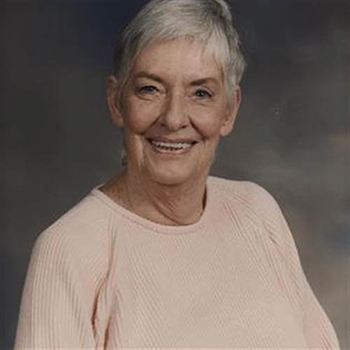
The first time I met Frances and Tim Thorman was in the spring of 1989 at a great restaurant – Oro – in downtown Toronto. Jo’ and Dave were getting married in June and this was the first time the two families were meeting. (Interesting that I was the only other sibling there. Guess I was there to help my parents navigate the meet-and-greet and to help translate the menu.)
The next time I saw Frances was at the back of St. Veronica’s Church, in Sault Ste Marie, waiting to go down the isle at Jo’ and Dave’s wedding. I remember her comment about having reached an age where her oldest was getting married. “I never saw myself as the mother of a groom, that’s for old women.” We laughed.
At the service on Saturday, Dave and Bridget remembered their mom’s life. A recurring theme of the speech was Frances’ belief in the importance and power of family; her belief in the importance of transformation and of moving forward regardless what life hands you. That idea got me thinking of how Frances and Tim, how my parents, how the parents of most of the people sitting in that small chapel were and are part of a generation that created modern Canada. A generation of adults that worked hard; that worked long hours so that their children could have a better life in a new country.
Frances and her generation were pioneers building a new land for their children; determined pioneers, moral upright pioneers. And all of us sitting there honored her hard work, her determination her strength. We are who we are, because Frances and her generation made sure to raise children who could continue the hard work she and her group started. We are who we are, because Frances and her generation sacrificed to make a better world for us sitting there at her memorial service.


Stephen Colbert used the seventh circle reference in his monologue on Tuesday night.
In Dante’s Inferno, the seventh circle is reserved for those who’ve committed violence. In the first ring of the circle, murderers, war-makers, plunderers, and tyrants are immersed in a river of boiling blood and fire. These monsters are sunk into the boiling blood, each according to the degree of his guilt – the more monstrous the violence they committed, the deeper they’re sunk.
The same day, Michael Steele, former Republican National Committee Chairman, described Trump and his comments about the riots in Charlottesville: He’s the schoolyard bully and no matter what the teacher, in this instance the news media, says, the bully looks to his sycophants, in this instance, the White Supremacists, the KKK, the Neo-Nazis and together they snicker. Who cares what the teacher/news media says?
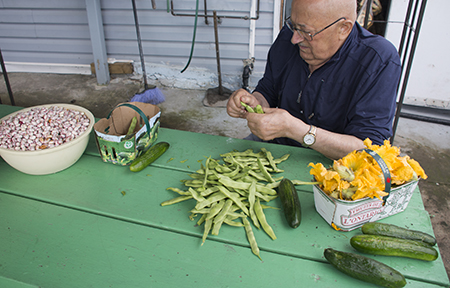
 Here in the north country, hints of fall are everywhere. The weather is cool enough to wear a sweatshirt (I brought a limited number of long-sleevers, so I’ll have to dig into the winter clothes I leave here.); the sun rises at 6:00 and by 8:00 pm it’s getting dark (very different than June when daylight lasted almost 16 hours.); and my father’s garden has large empty patches (the bush peas, the lettuce, the fava, the onions are all gone.); the winter vegetables are filling in where the garlic and the other early summer greens once grew.
Here in the north country, hints of fall are everywhere. The weather is cool enough to wear a sweatshirt (I brought a limited number of long-sleevers, so I’ll have to dig into the winter clothes I leave here.); the sun rises at 6:00 and by 8:00 pm it’s getting dark (very different than June when daylight lasted almost 16 hours.); and my father’s garden has large empty patches (the bush peas, the lettuce, the fava, the onions are all gone.); the winter vegetables are filling in where the garlic and the other early summer greens once grew.
In the image, Ciccio is doing his morning ritual – every morning, my dad gets up and at sunrise heads into the garden and harvests what is ready. In the garden, the other indicator that points to fall is the beans. In the bowl, Ciccio has the Romano beans he shelled yesterday and on the table he’s cleaning the flat-green beans. In my mind, whenever the beans were being harvested, I knew summer and the growing season were coming to an end. On the picnic table is a basket full of zucchini flowers that my mom will make into fritters, also on the table are five cucumbers.
I’ve always liked going into the garden and picking the small cucumbers off the vines and eating them as I walked under the pole-beans and towards the peas to eat my fill. A breakfast of small, juicy cucumbers and big, sweet peas will always mean summer in my dad’s garden. (Under my rimless Cartiers, my blue-swede Hubbards, my fitted Etro and my skinny-jeans, I really am an old Calabrese.)
Also walked over to my uncle-and-aunt’s and in their garden too, the harvest was in full swing. My uncle grows amazing eggplant; the plants, in plastic barrels, were heavy with a second picking.
I don’t think I was ready for the chill. (Everyone talked about it having been a wet and cold summer.) But then, I’ve been here in early August and even then we were eating indoors, because by late afternoon the weather had begun to cool.
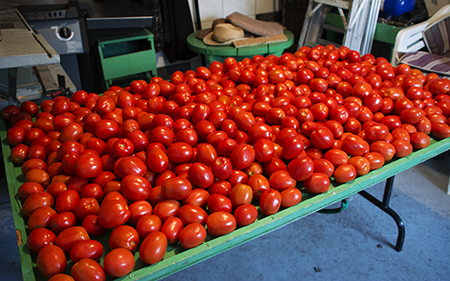
 After finding out that Rick, Sarah and I didn’t have any more tomato sauce, Ciccio Zinga made a dash to Metro, a Canadian grocery chain, and came back with two bushels of tomatoes. He paid $12 a bushel. (He was proud of that price, because No Frills wanted $18 a bushel.)
After finding out that Rick, Sarah and I didn’t have any more tomato sauce, Ciccio Zinga made a dash to Metro, a Canadian grocery chain, and came back with two bushels of tomatoes. He paid $12 a bushel. (He was proud of that price, because No Frills wanted $18 a bushel.)
I was called out to take them from the van and to the room in the back of the garage (notice all the stuff – table-saw, grill, stool, table, ladder, and patio-chair), and to spread them on his table with the lip all around. Also, as I dumped the hard Romas on the green table, I’m thinking that they will be here for a while (they as hard as baseballs).
The next task, was to get the ladder and climb into the crawl-space above the garage and bring down the huge caldron for cooking the tomatoes and a smaller caldron for transferring the cooked mixture to the table with the milling machine.
After supper, Ciccio announced that he was going out to cut up the tomatoes, so that tomorrow morning he could start cooking them and be done by noon. WHAT!!!
Next thing I know, I’m lugging bowls of tomatoes from the back-room to the sink; washing them, and then lugging them to middle of the garage where Mr. Zinga had set up his chair and pails. He cored the pith, cut the fruit in half and threw the halves into one of the tall pails. When I asked why he was removing the pith, he said, “We’ve always done it that way.” Never one to accept tradition, I went online and found several discussion about removing the pith, because it was often unripened and if left on, added a bitter taste to the sauce. That made sense.
Let me be clear – I took 4 half-bushel boxes from the van to the back of the garage (each box weighing around 30 pounds), then I took all those tomatoes back out to the sink in the garage and then to the work station in the middle of the garage. WHY!!! Why didn’t he have me stack the boxes next to the sink?
Two bushels of cored and cut tomatoes filled two 10 gallon pails and two 5 quart metal bowls. My mother covered the cut tomatoes with clean dish-rags and we all went back in the house.
Click to read the second entry of making tomato sauce.
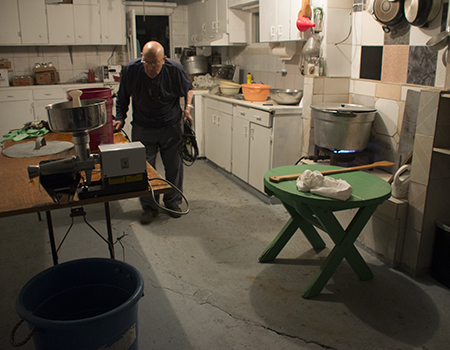

It’s 5:00 and I’m standing in front of my dad’s garage, facing south-east and shooting the house across the street and the waking sky.
It’s day 2 of the tomato sauce protocol. My dad has been up for a half hour and he’s already started cooking the tomatoes – the huge pot with the lid on the left, on the burner.
 We’re in the garage, where there’s a third kitchen for canning and making tomato sauce. The machine in the forefront will strain the cooked tomatoes removing the peels and the seeds; the big plastic bucket under it will catch the tomato sauce. The long paddle on the small green table is for stirring the tomatoes in the giant pot. (The stirring is muscle building, well at least after the strain goes away.) My dad is getting ready to plug in the milling machine; the tall bucket on his right is full of halved tomatoes that will soon get added to the large pot (more muscle building). The tomatoes cook for about two hours.
We’re in the garage, where there’s a third kitchen for canning and making tomato sauce. The machine in the forefront will strain the cooked tomatoes removing the peels and the seeds; the big plastic bucket under it will catch the tomato sauce. The long paddle on the small green table is for stirring the tomatoes in the giant pot. (The stirring is muscle building, well at least after the strain goes away.) My dad is getting ready to plug in the milling machine; the tall bucket on his right is full of halved tomatoes that will soon get added to the large pot (more muscle building). The tomatoes cook for about two hours.
The next step is take the very liquidy mixture and transfer it to a smaller pot that he and I lug over to the table. My dad then begins to put the liquidy pulp through the milling machine. (After this first round, I opt for a smaller transfer bowl. Man, lifting a pot full of hot tomato sauce is not pleasant.) When all the sauce has been milled, I get to take the caldron out into the back-yard and scour it clean. (Ciccio claimed that I didn’t need to keep stirring, that the flame was low enough to prevent burning. Wrong!!!)
The caldron is back on the burner and now I get to transfer the sauce from the blue bucket under the milling machine into the cleaned pot. Once I transfer all the sauce, Ciccio starts cooking it a second time and I drive off to my uncle’s to get basil.
By the time I’m back, Mafalda has joined the crew. She is washing the jars and putting then on the round table near the caldron. She shifts and quickly washes the basil and she and I begin to add two leaves to each of the empty jars. My dad using a small pot with a handle and a funnel, begins filling the jars. It’s my job to place the lids on the filled jars and to then screw the rings on tightly. We fill 58 Mason pint-jars. (I asked about putting the jars in a water-bath canner, but my dad said they haven’t done in years. The lid, tightened by the ring, seals as the piping hot sauce cools.)
The jar end up on the counter in the back and covered in a green synthetic blanket. This will slow down the cooling process guaranteeing that the lids seal tightly onto the top of the jars.


We’re walking in Humber Bay Park – two landspits situated at the mouth of Mimico Creek where it empties into Lake Ontario. The Park is below the Gardiner Expressway on the south-western edge of Humber Bay; following the Bay’s contours takes you to downtown Toronto.
Background – The Park, opened on June 11, 1984, is built on 5.1 million cubic metres of lakefill. Several habitat restoration projects have been initiated at Humber Bay Park, including the planting of Carolinian trees and shrubs, the establishment of wildflower meadows and the creation of a warm-water fish habitat and wetland on the east peninsula. The park is also a popular destination to view migrating birds.
We got up early and Franchino drove down so that we could see the sun rise.
I’ve been traveling this end of the Gardiner for years, but this is my first time in the Park.
What I like best about the image is the golden hues bathing the skyline silhouette. The morning sun’s reflection, on the glass skyscrapers, is more obvious in the larger image in the slide-show.
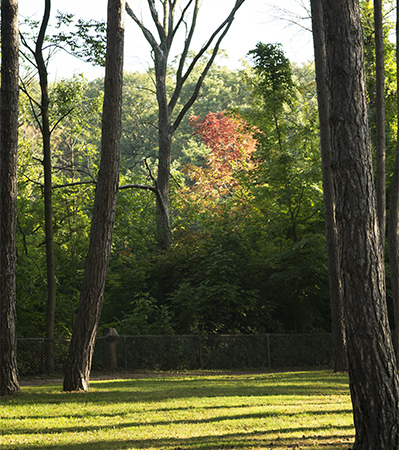
 This morning’s walk was through High Park. It’s a walk we’ve done before, but not first thing in the morning. The dew was still on the grass; the fog lazied just above the ground; the sunlight fracted from the east; and morning silence filled the hollows.
This morning’s walk was through High Park. It’s a walk we’ve done before, but not first thing in the morning. The dew was still on the grass; the fog lazied just above the ground; the sunlight fracted from the east; and morning silence filled the hollows.
High Park anchors a huge green-space in southwestern Toronto. This green-space, along the lakeshore, goes from Humber Park, in the west, to downtown. It’s almost 7 miles of beautiful park-land along the shore of Lake Ontario.
I remember when Canada, because of its wilderness, its open lands, its small population, its miserable winters was considered a backward country. Canadians, when compared to their southern neighbors, were labeled second-class citizens. Today, those once negative attributes make Canada a very desirable destination and Toronto a world-class city. (Franchino has been showing me all the parks and green-spaces within the city limits. Within the city there are multiple golf-courses and it seems like every street has some kind of park or green-space. The city, the 4th largest in North America, doesn’t have the paved-over look of New York or Los Angeles. Toronto actually looks green.)

 High Park is 400 acres (in comparison Central Park is 780 acres). Every time Frank and I walk High Park, it’s always amazed me that we can do the whole perimeter in one session; now I know why.
High Park is 400 acres (in comparison Central Park is 780 acres). Every time Frank and I walk High Park, it’s always amazed me that we can do the whole perimeter in one session; now I know why.
Another difference is that High Park relies much more so on natural contours and elevations. Frederick Law Olmsted and Calvert Vaux designed Central Park to such detail – creating every rise, every path-twist, every pond, every knoll – that after all these years and because the park looks so natural, we forget the structure they imposed on the acreage in central Manhattan. On the other hand, one third of High Park is still in its natural state and the rest of it has been added onto to provide amenities – tennis courts, baseball diamonds, soccer fields, pools, zoo, sculptures and fountains – for its many users.
The Park is part of the Canadian penchant towards wilderness, towards natural environments, towards a love of its rugged lands.
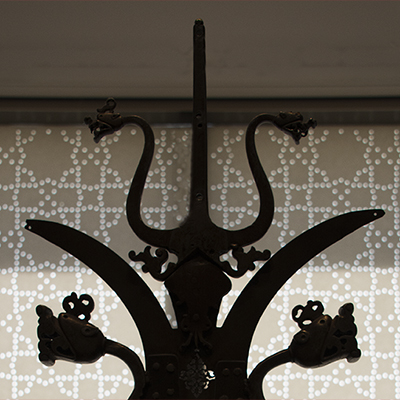
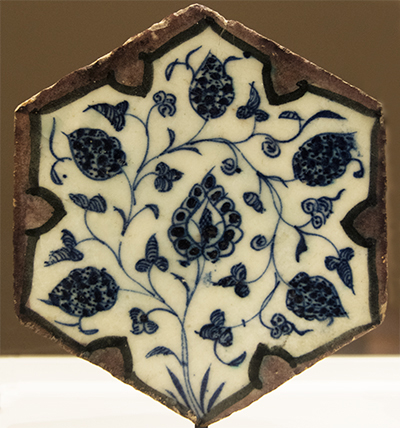
How can I pass up such a header – a French article, an accent aigu and an ancient Islamic title.
The pic on the left, is of an 15th, underglazed, painted tile from either Syria or Egypt. The blue-and-white color scheme was meant to imitate Chinese porcelain. The tile is one of the 300 artifacts and art pieces on display at the Aga Khan Museum in North York.
The building is faceted, white geometry; the gardens, a glimpse into paradise; the black pools, the quality of mercy. The Museum represents Islamic culture from the Iberian Peninsula to the Malay Archipelago. Its collection is remarkable and beautifully displayed; its textiles and clothing shimmer in the ambient light; its Korans and manuscripts illuminate (the museum holds the earliest surviving manuscript of Avicenna’s Canon of Medicine, the text that kept ancient Greek thought alive while the west plunged into the dark ages); its apothecary jars chipped, but lustrous; its ancient pottery ablaze with reds, oranges and blues.
Prince Shah Karim Al Husseine – The Aga Khan – is the 49th hereditary Imam of the estimated 15 million Shia Muslims and a direct descendant of the Prophet Muhammad. He was ready to build his museum in London; a site, on the southern bank of the Thames, had already been selected, but it became politically difficult to locate an Islamic museum in Brexit-drunk England. The push-back brought the Prince, his famed Japanese architect and his collection of Islamic masterpieces, across the pond, to multi-cultural Toronto.
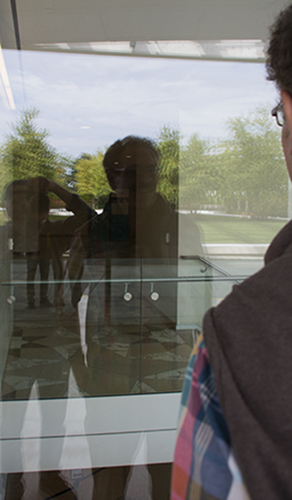

Consiglio’s Kitchenware has been on St. Clair (this northern east/west thoroughfare is always referred to without the street identifier) for as long as I can remember. Every time my parents, my uncle-and-aunt visited Toronto a trip to St. Clair and to Consiglios was mandatory. (all my stovetop espresso makers, my colanders were bought at Consiglios)
My grandparents and their fellow immigrants settled in the west-end around College. (In everyday language, this southern east/west thoroughfare is also referred to without the street identifier. This use of the street name without the road, way, crescent … identifiers is very common in Toronto. The exception is Avenue Road.) Back then the city was a small urban grid hugging the lake-shore. The next wave – my parents’ generation – stayed in the west-end, but went north to St. Clair.
There’s a great story of my dad and I standing in front of a woman’s apparel store, holding bags containing half of a goat that one of his paisani had to cut up; my mother, seeing the sale sign, had rushed in looking for a bra, because after all the bras on St. Clair were so much cheaper than anything she could buy in that little outpost better known as Sault Ste Marie. And not to be outdone by the two old people, I texted Welch and described the whole absurd scene.
Welch, I’m in the middle of St. Clair holding two bags of goat meat
My dad is cursing, there’s blood running out of a bag and onto his shoe
My mother is in the underwear store
I can see her through the window, she’s touching the bras feeling them
My generation left the city behind and moved further north into the suburb of Vaughan and Woodbridge.
The new store has a series of small showrooms, but its focus has shifted from a traditional brick-and-mortar store to an online business. (My parents have lost their favorite store.) The owner explained that going online, going virtual was the only way to survive. “We’re trying not to go the way of Sears.” OK, I understand, but my world has tilted. A store that has been there all my life, a store where I bought most of the items in my kitchen, is now doing business in the ether.
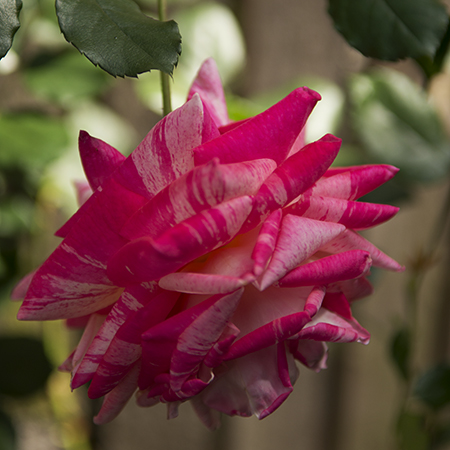

Am I ready to let go of summer and consider that we’re getting closer and closer to the end of 2017?
Summer-2017 was not great for the trees and vegetables in my backyard – the peach tree produced wonderfully tasteful fruit, but then developed a leaf fungus and lost all it leaves by the end of July. (i have no idea if it’ll come back next spring) The only vegetables that survived through the season were the tomatoes. The kale, the cucumbers, the fennel all withered and died. The flowers that filled the many pots in the north-east corner were filled with yellow and white annuals. The pallet soon faded – the yellow begonias were rust ridden by the end of June, the white geraniums were feeble and stringy. Ended up replacing the begonias and diversifying the color pallet to include purples and reds.
And finally, summer-2017 brought 3 deaths – Frances Thorman died August 9, Norma Cornblat died August 21 and Tom Stack died September 16. And for that alone, I’m ready to leave the season behind for a time to re-group, re-examine and remember.
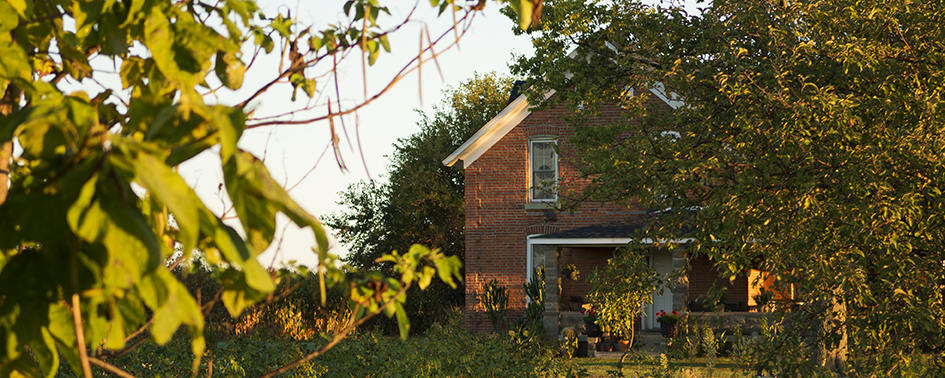
 Frank, Ron and I met up in Windsor at the indoor tennis courts that we played at before. (the indoor courts are easier on the feet and way easier on the body than the heat-reflecting asphalt courts in the public park in Harrow.) We volley, two on one, for an hour.
Frank, Ron and I met up in Windsor at the indoor tennis courts that we played at before. (the indoor courts are easier on the feet and way easier on the body than the heat-reflecting asphalt courts in the public park in Harrow.) We volley, two on one, for an hour.
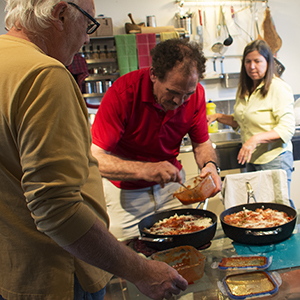 Franchino had volunteered to cook veal scallopini, so I took everyone to the LCBO down the street to purchase many bottles of Pinot-grigio and Italian-red. (ontario has liquor stores – LCBO – as well as separate beer stores) The Pinots would be for before dinner, the Reds for during and after.
Franchino had volunteered to cook veal scallopini, so I took everyone to the LCBO down the street to purchase many bottles of Pinot-grigio and Italian-red. (ontario has liquor stores – LCBO – as well as separate beer stores) The Pinots would be for before dinner, the Reds for during and after.
The image on the right is really the next evening. (l to r – Ron, Franchino, Lynn) Franchino brought all the ingredients he needed for the veal scallopini and we all helped putting it together.
The drive from Windsor to Harrow is through flat farmland, perimetered by scrubby thickets with some trees sprouting above the green walls (the locals call these “the woods” and they are home to foxes and feral cats). The GPS takes us south through Harrow and down Snake Lane to Gore Road. The last time we were at Lynn-and-Rainer’s was October of 2015 and in two years the property has changed significantly. The cedars that line the west side of the long driveway are now easily 30 feet tall; the other trees on the property are full, tall, massive; the landscaping is now settled and the property no longer has that work-in-progress look.
Once we unload, we migrate out to walk the property. In the fading light, the dissonance is made obvious by the lack of ambient noise. (imagine a place with no urban sounds) The second jolt comes when a stream of beautiful young cats comes running to greet us. There are 14 of them.
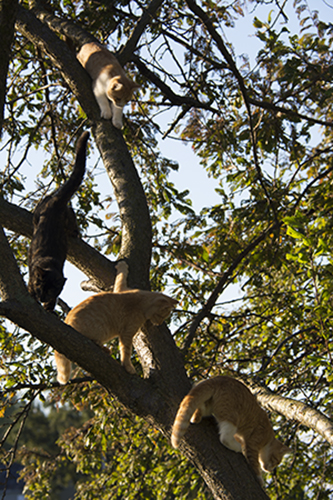
 visiting south-western ontario
visiting south-western ontario
 Saturday morning, at first-light, I’m outside with my camera. And the cats, assuming that I’m there to feed them, swarm around me. There are currently 14 cats on the property and none of the females will go into heat until early spring. This will be the first winter Rainer-and-Lynn will have this large of a pride through winter.
Saturday morning, at first-light, I’m outside with my camera. And the cats, assuming that I’m there to feed them, swarm around me. There are currently 14 cats on the property and none of the females will go into heat until early spring. This will be the first winter Rainer-and-Lynn will have this large of a pride through winter.
One of the things I like best about the image of the cats in the tree is the direction of the light. The morning sun falls on the eastern side of the tree trunk.
The image on the right is of Ron’s 1988 Lincoln Town Car (I refer to it as the boat ). It was his brother Louie’s car. We are on Gore Road, facing east. Ron had gone home to Leamington to water the new sod he had put in around his house. In the image, Rainer is standing on the left and Franchino is talking to Ron who is in the driver’s seat.
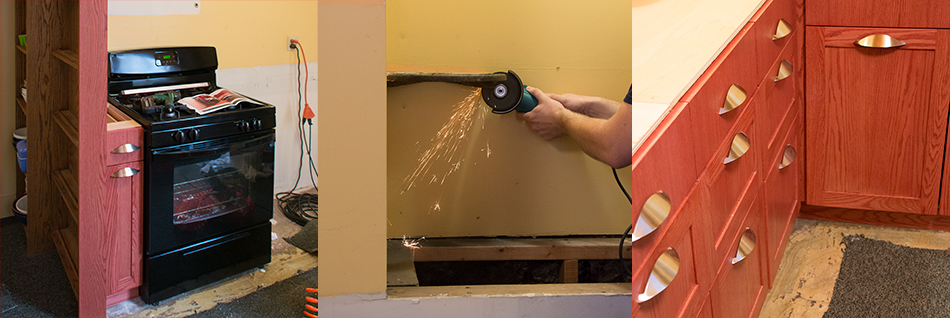

Over the weekend, the contractor began taking down the old kitchen cabinets – basically dismantling the old kitchen and removing the old microwave. She left the sink, the sink-cabinets and a portion of the old counter. This gave me a usable sink and a somewhat usable kitchen for a couple extra days.
This morning Marty, from M&D Plumbing, came in to take apart the old sink and to cap all the pipes and drains under it. Once he had everything cut, he and I dismantled the last two reaming cabinets and partial counter. Marty then stayed until the carpenters and installers showed; he wanted to make sure that all pipes and drains had been cut and capped to minimize the least amount of holes in the new sink cabinet.
The left image is the spice cabinet. One of the reasons I ended up with a custom cabinet maker is because he proposed options that gave me the largest amount of cabinet space. The other bids, used standard cabinets from the large, home-improvement chains; and their solution for the non-standard space that is my kitchen, was to use fillers – covering any unused space with Sheetrock. Joe Kelley covered the side and back of my dish-shelf with a laminate to match the new cabinets; he extended the height of the dish-shelf to match the new above the counter cabinets; he added the spice cabinet on the left of the stove; and designed an amazing unit for the alcove between the old warming-oven and the back wall.
In the middle image Ross, one of Joe’s people, is starting to cut the cast-iron ring on the side of the warming-oven. He only managed cutting one side before the grinder over-heated and died. Once the ring is cut, a great custom-built unit will fit into this space, giving me additional storage.
The image on the right is of the base cabinets. The push was to get the base-cabinets installed so that the counter measurers can come tomorrow morning. I will have no water or sink until the new pressed-glass counter is installed. And it will take a week from the time of measuring to the installation. As soon as we knew the base-cabinets would be done today, both Joe and I called the counter people and the measuring is rescheduled for tomorrow. (Once the new counter is in, Marty will come back and reconnect all the plumbing. If things work out, I should have a full functioning kitchen by next Wednesday.)

 new kitchen, day-two
new kitchen, day-twoI’m going to begin by writing about the image on the left. It’s probably one of my favorite images. In reality it’s the inside panel of four cabinet doors above the microwave. The larger image at the end of this post shows the knobs as they are on the cabinets.
I selected drawer-pulls that are large and have a modern design; for the very top cabinets, the glass fronted ones, I selected a blue ceramic knob; the large doors have hidden finger pulls. The two doors above the microwave have the finger pulls. But once the microwave was installed, it mounted beyond the depth of the cabinets so the finger-pulls were inaccessible. I suggested that we use two of the blue ceramic knobs on these doors.
Creating the abstract, vertical image was great fun. It’s a sliver of the left image in the triptych below. I kept cropping until I had what you see on the left. The blue knobs on the cherry stain, the vertical line of symmetry, the cruciform, the different grains. If you look carefully, you can see the finger-pulls on the underside of the top knobs.
The top cabinets came in 3 sections – the largest is above the stove; the smallest is the cabinet in the alcove; and the third sectional is above the sink. The new cabinets doubled the space I had before. Also, the new cabinets were fixed 22 inches above the counter. That is 4 inches higher than standard, but the extra height makes for a more open counter area. (The old cabinets were a whopping 25 inches above the counter-top. The standard is 18 inches. I don’t know why the original contractor put them so high. In the right image in the triptych, the white patch above the stove was the old microwave and the patch to its right was the old above-the-counter cabinet.)
There are some minor fixes that need to happen – the drawer-pulls are very wide and the second drawer in the cabinet closest to the sink can’t open, because is butts against the pulls on the sink cabinet. (My suggestion is that we replace the two pulls on the sink cabinet with something similar, but narrower. And if we find the right replacement, then I want two more smaller/narrower pulls for the spice cabinet. This cabinet is itself narrow and a smaller/narrower pull would look better.)
Tomorrow the electrician comes in to connect the microwave and put power behind the alcove cabinet for TV, cable-box and router-amplifier. The counter-top people aren’t due until the middle of next week. And when the new counter is in, I can get Marty back to hook up the new sink.

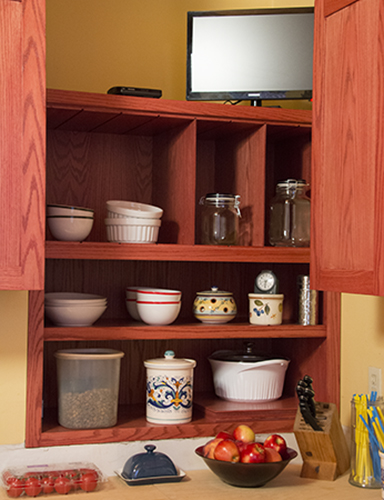
 new kitchen, following-days
new kitchen, following-daysAs soon as the new cabinets were hung and the carpenters gone, I put everything back. I needed a semblance of kitchen even if there was no microwave, no TV, no counter, no sink, no water.
Last Thursday, Clay came in and put power in the alcove, behind the unit pictured on the left. (There were two additions that Joe Kelly suggested that in many ways clinched the deal. The first was the alcove unit, the second was a custom built table to replace the IKEA special that we had been using for 30 years.) Clay hooked up the new microwave, and ran power into the back of the alcove. All wires – cable, electrical – are now well hidden behind the new, open, corner cabinet.
I covered the bottom cabinets with some thin plywood that was left over from a bed platform. Got out the electrical saw and cut the pieces to fit on top of the cabinets. It’s not the best, but it gives me a place to work when making coffee, lunch or filling the dogs’ bowls. The new, pressed-glass counter-top is being installed Thursday morning.
Marty is coming Thursday afternoon to hook up the faucet and disposal to the new sink. It’s hard to believe that I may have a functioning kitchen by dinner time Thursday.
Items in the alcove cabinet: the ceramic canister on the bottom shelf holds dog biscuits and is from Deruta – a hill-town in central Italy known for its ceramics; the squat, yellow canister on the second shelf is a garlic-keeper also from Deruta; and the jars on the top shelf are glass canisters with spring-sealed lids that I use to keep coffee in.


I’ve been working on the image most of the day, hoping that the daylight would fill the kitchen especially the top of the cabinets. It didn’t and I ended up adding a floor-lamp light source – notice the bottom of the image and the shadow of the knobs. Also, the best shots came from me standing on a ladder and getting eye-level with the top-cabinets and even then they needed a lot of Photoshop tweaking.
In the above image, besides the espresso pots, you can see the stain-glass windows and the bowl of the overhead light. The stain-glass and the knobs are in the blue range, the espresso pots add primary colors and the red-cherry cabinets frame everything.
A side note – the renovation sparked a great cleaning-out; last week, on garbage-day, 10 huge garbage bags lined the alley. They were filled with dishes, pots, pans – anything we hadn’t used in over a year; they all went. The cleaning-out is continuing and so far I’ve filled 4 forty-two gallon bags and it’s only Tuesday. (Update – counted 15 large garbage bags for this week’s pick-up.)
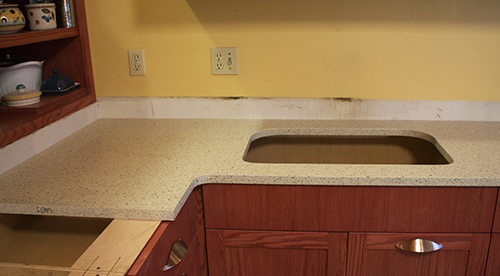
 new kitchen, new counter
new kitchen, new counterGetting closer. This morning they came to install the new counter, but didn’t bring the back-splashes, so they’re either coming back later today or tomorrow morning.
The pressed-glass counter is very low-keyed. Up close, you can see all these amazing bits of color – reds, greens, blues, tiny shards of clear-glass, even things that look like shells. This splattering will make it great at hiding dirt and crumbs. The new sink is fastened to the bottom of the pressed-glass countertop with 7 small pieces of corian. The installer put glue on the corian and then fastened the small pieces around the perimeter of the new sink holding them in place with painter’s tape. Apparently the corian and the glue are strong enough to hold the sink in place. (The two installers said that anymore, it’s rare to drill into the counter-top and use metal clips to fasten a sink. The new glues are strong enough and long-lasting enough to forego drilling.)
Besides using the corian as a fastener, the next interesting aspect of the install was to see the worker use two electrical vacuum units to move the heavy slabs into alignment. Once he had them aligned and level he added the poxy to the seam.
Right now, Marty is beginning to rebuild the pipes and drains under the new sink. Wonder if I’ll have water by dinner time?


The countertop is actually more white than it appears in the image, but in an room full of yellows, browns and cherry-reds, it’s hard to eliminate the tan hue. (Paul says it has a 1950’s look.)
The back-splashes are in and Marty is here to finish hooking up the plumbing.
Two weeks after it all began, I have a working kitchen again. The last two things before it’s completely finished is the flooring and repainting.
Total cost was approximately 28K and that includes – demolition, cabinets, table, countertop, sink, microwave, electrician, plumber, flooring and painting.
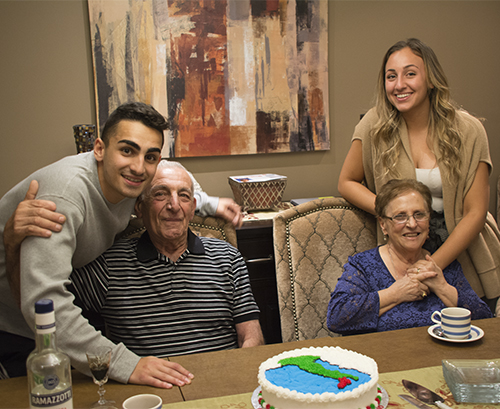
 Today is my uncle’s 80th birthday and last night we celebrated with dinner and cake. We’re at Mary-and-Domenic’s and it’s my uncle and aunt, Daniel and Alyssa in the pic.
Today is my uncle’s 80th birthday and last night we celebrated with dinner and cake. We’re at Mary-and-Domenic’s and it’s my uncle and aunt, Daniel and Alyssa in the pic.
What amazes me is that my uncle began life in a small Calabrian town – Martirano – on a remote farm and 80 years later, his life is such that he flies down from Sault Ste Marie, to Toronto and then to his daughter’s in Pickering to celebrate his birthday.
I believe Canada has been enriched by these courageous immigrants who left their homes and made a new life in a foreign land. It’s a generation, pushed out of Italy because of the war and its aftermath, but it’s also a generation of pioneers. And much like the pioneers of an earlier age, they too had to conquer the wildness of Northern Ontario in order to establish homesteads, build cities and raise families. Sault Ste Marie is no longer the industrial center that it was back in the 50’s and 60’s when my uncle’s generation worked its mills and factories; it has lost most of that manufacturing base to cheap labor in other parts of the world; and it has lost most of the kids, from those immigrant families, to Toronto, to Vancouver, to the United States. But the modern world, unlike 19th century Europe, affords us the opportunity to meet up and to celebrate life’s milestones.


I drove from Pickering down to High Park and both the 401 and the Don Valley were congestion free. But the Gardiner between the Air Canada Center – hockey arena – and the Rogers Stadium – baseball park – crawled. Once through the downtown tourist bottle-neck, the highway opened up and I thought I was making good time until I hit the Dunn exit and road construction forced me onto Roncesvalles Avenue. Roncy, in local parlance, is the current hip-area and at 12-noon it was full of older, well-dressed residences who had left their suburban enclaves to come back to the old neighborhood for Sunday Mass in Polish and young hipsters in their torn jeans and low-fade haircuts anxious through a sunny afternoon.
Franchino and I were walking through Humber Bay Park and there in the haze was the skyline. (I like the image because of the ephemeral, far-off quality of the skyline silhouette and the immediacy of the fall colors on the trees in the bottom left corner.)
It continued to be a day of contrasts. The apartment was excessively warm, but the shoreline walk, with the wind whipping off the Lake, was uncomfortably cold. We took the paths away from the water and the chilling wind.
Franchino always has a movie ready and tonight’s was as disturbing as High Noon. Tonight’s movie was The Ox-Bow Incident. I literally sat there with my mouth open. Wikipedia has the following description – The Ox-Bow Incident is a 1940 western novel by Walter Van Tilburg Clark in which two drifters are drawn into a lynch mob to find and hang three men presumed to be rustlers and the killers of a local man.
Clifton Fadiman wrote an introduction to the Readers Club edition in which he called it a “mature, unpitying examination of what causes men to love violence and to transgress justice,” and “the best novel of its year.” In 1943, the novel was adapted into an Academy Award-nominated movie of the same name, directed by William A. Wellman and starring Henry Fonda and Harry Morgan. The movie was seen as a repudiation of Fascism.
What is jarring is that the actions/plot of the novel/film are based on fake-news – the cattle were legally purchased and the local rancher was hurt not killed. And watching this classic with a 2017 sensibility, l can’t stop thinking that like the 1940’s, fake-news is driving much of our political discourse, group-think and military actions. And fake-new, now like then, seems to be pulling us towards killings, towards war. (About 46 percent of Republicans support a preemptive strike on North Korea; 11,000 troops are currently in Afghanistan; and American special forces are in South Sahara Africa.)


Frank’s apartment is in the back of the building and it faces the North High Park neighborhood. I’m on the balcony and shooting the canopy that covers the area north of Bloor and west of Dundas.

 the witch of november
the witch of novemberMy mother was telling me that they were having miserable weather, that the winds were wrecking havoc across the city. When the weather front hit us yesterday and today, we had the rain and cold, but no winds. This is the first true fall weather of the year and I almost want to say, about time. The pumpkins were the only color is an otherwise dreary, gray and cold day.
Last night, I made comfort food – pipi e patate. I fried potatoes and red-peppers – an old Calabrese dish that fits cold damp weather. The variations are on how long you cook the pipi e patate; I like the potatoes to be firm, so I toss them in first and brown them before throwing in the red-peppers. And I do not cook the red-peppers to limpness; I like some crunch in my fried peppers. And last night for some reason, I didn’t add onion. I used my dad’s recipe and he doesn’t add onions to his oil when he’s frying.
Listening to Motongator Joe’s cover of The Wreck of the Edmund Fitzgerald and wanting to use the line – T’was the witch of November come stealin’ – for this post, I did some research on the term – witch of November.
The witch of November refers to the strong winds – gusts greater than 100 mph – that frequently howl across the Great Lakes in the fall. The witches are caused by intense low atmospheric pressure over the Great Lakes pulling Arctic air from the north and warm Gulf air from the south. When these contrasting air masses collide, hurricane-force winds churn up massive waves across the lakes.1
Since the mid-1800s there have been more than two dozen of these cyclones recorded in the Great Lakes, most of them in November, and many affecting the largest lake, Lake Superior.
And finally, BuzzFeed Canada had some amazing photos by Dave Sandford. He recently spent time on Lake Erie shooting the Great Lake’s turbulent fall season. From mid-October to mid-November, the longtime professional sports photographer traveled each week to Port Stanley, Ontario, on the edge of Lake Erie to spend hours taking photos.3
1 Wikipedia – link
2 WeatherBug – link
3 BuzzFeed Canada – link

 the other side of the tracks
the other side of the tracksThe area, outlined in blue, is bounded on the east by Highway 279, on the south and west by Route 65; its northern border is the first ring of hills that reach all the way into the middle of the state. This area is sometimes know as the Northside Flats (it’s the northern shore of the Allegheny River). The area is approximately one-and-a-half square miles or 960 acres, and it has been the focus of great renovation and redevelopment over the last 40 years. The Northside contains the 4 largest historic districts – The Mexican War Street, Allegheny West, Manchester and Deutschtown/East Allegheny; it’s the home of The Mattress Factory, The Warhol Museum, The Children’s Museum, Alphabet City/City of Asylum, The National Aviary, Allegheny General Hospital and the oldest park in the city – Allegheny Commons.
I’m trying to develop a walking routine that will get me ready to hike the Inca Trail in late May, and this morning I decided to walk up the hills east of Highway 279. The area is know as Spring Garden. Many life-long Northsiders who lived in the Flats migrated to Spring Garden when gentrification and redevelopment forced them out of their old neighborhoods. The contrast between the Northside Flats and this old neighborhood was amazing. The slopes of Spring Garden feel more like the hills and hollers of West Virginia than a Pittsburgh neighborhood. The housing is edgy, the yards are littered, the sidewalks are crumbing, but the views of downtown are spectacular. As I’m walking and taking pictures, the mailman comes over to tell me there’s a Pit-bull running loose, so I may want to move on and take the headphones off.
The old expression – the other side of the tracks – gives way to the modern – the other side of the highway.
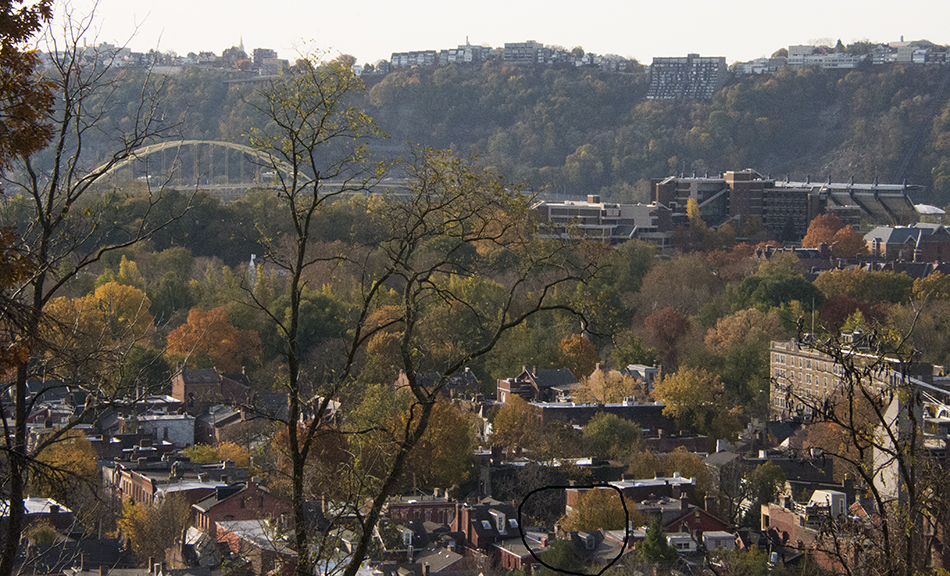 The image is taken from Perrysville Avenue the ridge that borders the Flats and I’m shooting south. The Northside Flats – the facing hillside is Mount Washington; the tall structures on the right are CCAC-Allegheny; you can also see one wing of Heinz Stadium. The bridge on the left is the Fort Pitt spanning the Monongahela River at the Point. The black circle in the bottom is my house. And all the trees in front of my house are the park – Allegheny Commons.
The image is taken from Perrysville Avenue the ridge that borders the Flats and I’m shooting south. The Northside Flats – the facing hillside is Mount Washington; the tall structures on the right are CCAC-Allegheny; you can also see one wing of Heinz Stadium. The bridge on the left is the Fort Pitt spanning the Monongahela River at the Point. The black circle in the bottom is my house. And all the trees in front of my house are the park – Allegheny Commons.
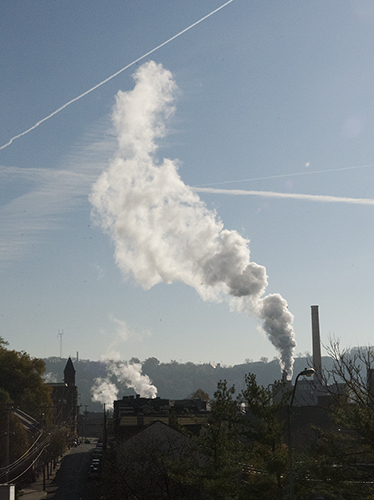

 The image on the left is one of the renovated houses in the Flats; the image on the right is a view from a set of stairs in Spring Garden. I’m shooting the smoke from the Heinz Plant. Recently, after the merger with Kraft, the old Heinz Plant is slowly being converted to hipster lofts. The smoke and all manufacturing will soon be gone.
The image on the left is one of the renovated houses in the Flats; the image on the right is a view from a set of stairs in Spring Garden. I’m shooting the smoke from the Heinz Plant. Recently, after the merger with Kraft, the old Heinz Plant is slowly being converted to hipster lofts. The smoke and all manufacturing will soon be gone.
The word – Galileo – was part of Alphabet City’s wordstream, an art event creating a stream of words from its location on Sampsonia Way to its new headquarters on West North Avenue. Many of the old hipsters, living in the Mexican War Streets, tacked a plethora of words on their walls and windows helping to create the stream from Sampsonia to North Avenue.
From my house to the top of Itin Street in Spring Garden is 3.1 miles; (yesterday I walked from my house to Gateway Center 1.9 miles). I headed into Spring Garden because I wanted to climb Itin; it was my first uphill hike.
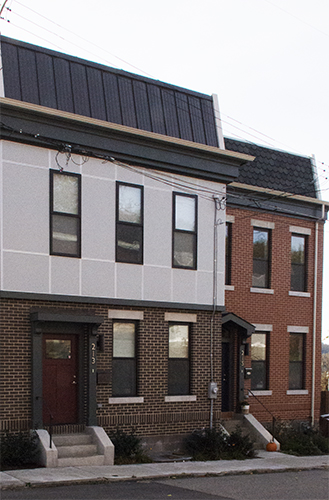
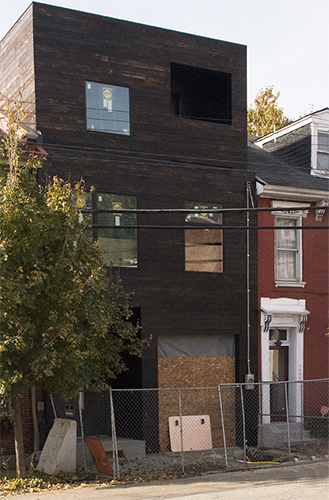
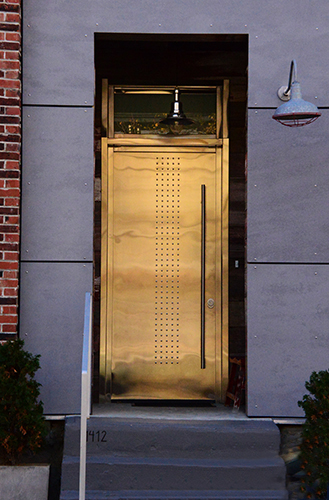 Along the periphery of the historic district – The Mexican War Streets – there is great development and we’re finally seeing modern design infiltrating the staid and traditional. The two images are new houses going up on Buena Vista just north of the historic district boundaries.
Along the periphery of the historic district – The Mexican War Streets – there is great development and we’re finally seeing modern design infiltrating the staid and traditional. The two images are new houses going up on Buena Vista just north of the historic district boundaries.
Seeing the new designs is seeing new life in an area that was rescued from the wrecking ball by the urban homesteaders of the 1960s and 1970s. And those same pioneers are now welcoming new homesteaders who have a different world-view, a different sensibility than those of us who preserved and rehabbed the old structures.
The construction and rehab rules are different outside the original historic district – the gray area – and what these new home-owners seem to be doing is using the lines and the symmetries of the old houses to develop a new architectural language that looks to the past, but isn’t confined by it.
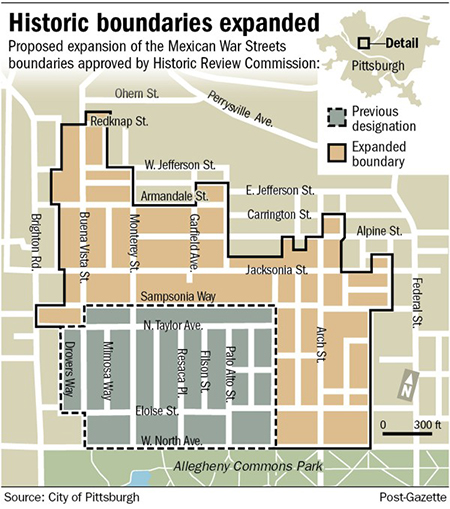 This morning’s hike was up Buena Vista Street. The Department of Public Works classifies Buena Vista at 12.5% – 6o grade/steepness from horizontal. (A 0% grade is perfectly flat and a 100% grade is 45 degrees from the horizontal. The percentage expresses the steepness of the hill as the rise over run expressed as a percentage.)
This morning’s hike was up Buena Vista Street. The Department of Public Works classifies Buena Vista at 12.5% – 6o grade/steepness from horizontal. (A 0% grade is perfectly flat and a 100% grade is 45 degrees from the horizontal. The percentage expresses the steepness of the hill as the rise over run expressed as a percentage.)
I walked up Buena Vista to Perrysville and then took steps down to Arch and then home; the hike was 1.5 miles. The uphill portion – Buena Vista – was .6 miles; Google Maps shows a rise from 761 feet at the bottom to 1063 feet at the top. (My Thursday hike up Itin Street was a rise from 761 feet at the bottom to 965 feet at the top. No wonder this morning’s hike was so much more strenuous.)
Also, found a set of stairs from Perrysville down the hillside to Arch Street. I’m not ready to do stairs yet, but I’ll keep using them as the way down to the Flats.
Am also using the hikes to better learn the d800e camera. Today, all the images were shot using the preprogrammed settings – P is Nikon’s auto setting for its high-end cameras. I’d like to take the d800e (36.3 effective megapixels) with me to Peru and I’m assuming that I will be handing it off to other people on the tour so that I can be in the Machu Picchu pictures, and so I need to get familiar with the auto setting.
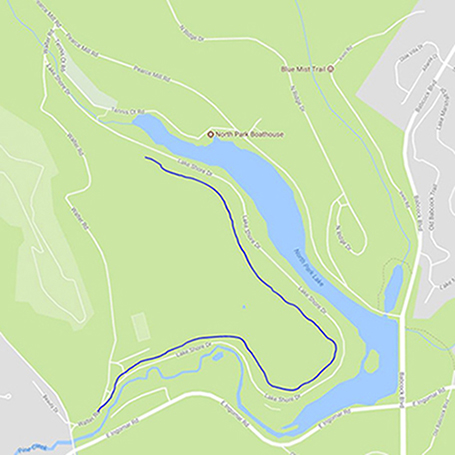
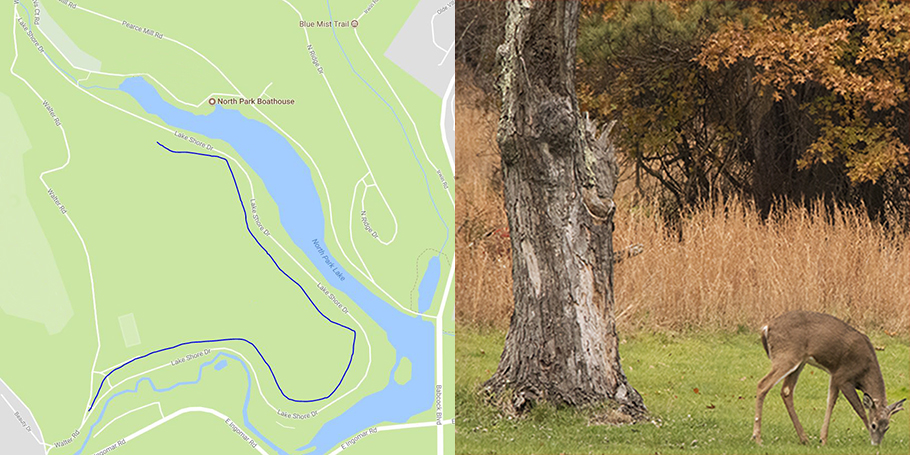
Rather than hide indoors, I decided to explore the lake-trail in North Park. The artificial lake covers over 75 acres and because I’ve never walked this trail, I used the solid portion on the southern shore; I walked to a 1¼ mile-marker and turned around. The hike was 2.8 miles. On the map, it’s the blue line; I started in the bottom left corner, 1600 feet before the beginning of the marked trail on Lake Shore Drive. Afterwards, to better understand the whole of the lake route, I drove the perimeter road. From where I parked, it’s a 5 mile trek around the lake.
Tomorrow morning, I’m gonna walk Walter Road; it’s the road on the left-hand side of the map. It has some elevation, going from 968 feet at the bottom to 1,158 feet at the top. In contrast, Lake Shore Drive is a set of low rolling hills. And next week, I’ll do the entire 5 miles around the lake.
While walking, I’ve taken to listening to music (franchino would chide me, insisting that i’m missing the natural sounds, the world around me). On my own, with my camera on my shoulder, it’s amazingly peaceful listening to music and walking. The road-noise is silenced by Tracy Chapman’s repetitions in Stand By Me and Dylan’s longings in If You See Her Say Hello. And then, I look up and there on the hillside is a deer snacking on the green grass. What else can I ask for?

 Walter Road, for a mile-and-a-half, climbs the hillside above the lake and then descends to meet the Lake Shore Drive at the man-made lake’s northern most point. At its steepest, Walter Road climbs 200 feet above the lake. (The pedometer, on my iPhone, assigns a 9-floor or 90 feet elevation to the climb and descent.)
Walter Road, for a mile-and-a-half, climbs the hillside above the lake and then descends to meet the Lake Shore Drive at the man-made lake’s northern most point. At its steepest, Walter Road climbs 200 feet above the lake. (The pedometer, on my iPhone, assigns a 9-floor or 90 feet elevation to the climb and descent.)
North Park is full of shelters that look like they were built by the Civilian Conservation Corps. The old ones, like the one in the above pic, are made from local materials – field-stone, hand-made bricks, logs and planks from the park’s trees; and these old shelters seem situated to blend into the hilly landscape. (An aside on the pre-programmed setting for the d800e – it takes great pics in overcast, gloomy weather. The above pic was taken on a gray, dull day.) The back of the shelter is built into the hillside making the top deck accessible directly off the parking-lot.
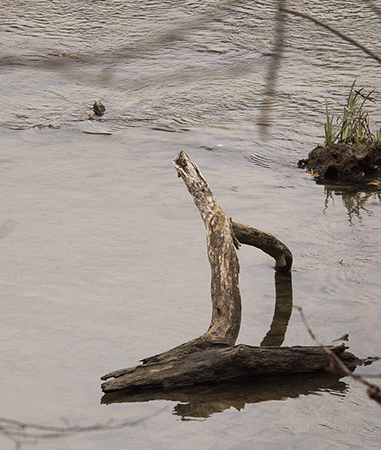
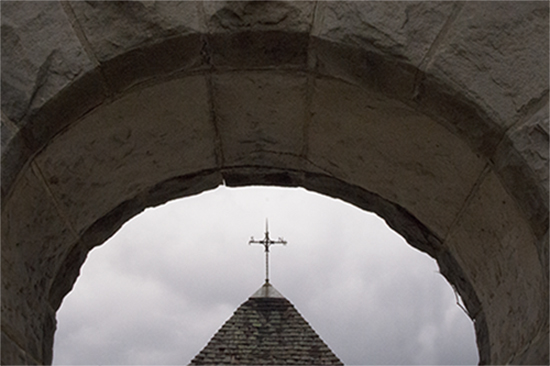 This post is dedicated to Father Pierce one of my high-school teachers. (Yeah, I know it’s two different spellings, but let’s not forget English’s propensity for homophones.) I called Franchino to ask about Father Pierce, because I couldn’t find him in my 11th or 12th grade yearbooks and Frank remembers high-school much better than I do.
This post is dedicated to Father Pierce one of my high-school teachers. (Yeah, I know it’s two different spellings, but let’s not forget English’s propensity for homophones.) I called Franchino to ask about Father Pierce, because I couldn’t find him in my 11th or 12th grade yearbooks and Frank remembers high-school much better than I do.
Father Pierce was a tall Texan who taught us Religion – Catholic History – in 9th and 10th grades. (I learned about the Babylonians and Nebuchadnezzar from the tall Texan.) He was famous or infamous for insisting that on every sheet of foolscap – writing paper measuring 13.5 inches by 17 inches – we write JMJ – Jesus, Mary, and Joseph – in the left-margin and the date on the right-side (i don’t remember where we wrote our names). Also, he lectured and we were expected to take verbatim notes. He also checked homework. His was the only class that I did homework for, simply because he checked it. Most of our teachers only checked homework if during the homework review, you couldn’t answer their questions (any homework that I knew how to talk through, I didn’t do, because if called on, I could answer and prevent the teacher from asking to see my notebook and my homework).
We had final exams twice a year, first in December before the Christmas break and then again in June before summer vacation. There were no classes during finals week and you were expected to study and prepare for your tests in the time when you were not scheduled to write an exam. All finals were taken in the auditorium/gym and the Friday before finals we would bring our classroom desks down to the auditorium/gym and set them in long rows. You wrote finals either in a 2-hour morning session or in a 2-hour afternoon session (the afternoon sessions were most desirable, because you could study in the morning). The teachers proctored the exams.
Back in 1964/1965, all exams required essay answers and you had write in ink. Foolscap was provided and you could ask for as much paper as you needed. The only exams that had fill-in-the-blanks or multiple-choice questions were the French or Latin finals (verb conjugations and noun adjective agreements were common fill-in-the-blanks or multiple-choice questions). Father Pierce’s finals were renowned for their length and the amount of writing they required. And because of Father Pierce long exams, a saying developed among the “brains” (in 1964 terms like geeks and nerds were not in use, the geeks and nerds of that bygone time were known as brains). After taking Father Pierce’s final we would come out and ask each other, “How may foolscaps did you write?” Franchino always wrote more than the rest of us; I’m talking 15 to 20 pages in a two-hour sit-down. The expression stayed with us even after Father Pierce was gone from St. Mary’s.
The image at the top of the post is of the weather-vane shot through the archway at the entry to the pump station. The two smaller thumbnails on the right are of the pump station and its weather-vane.
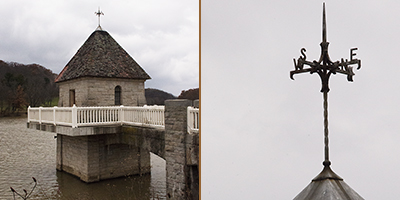 Today, I walked the circumference of North Park Lake – 4.7 miles. Google Maps tracks the circuit at 5 miles, but I took a .3 mile shortcut. I decided to start on Pearce Mill Road and to circle the lake north-shore to south-shore. The northern shore is amazingly diverse. First, Pine Creek that looks inconsequential from the south shore turns out to be wide and meandering; second, the north shore has all these new walking-paths that take you down to the creek banks; third, the north shore has all the historical plaques outlining the park’s origin; fourth, on this side are the historical stone structures – pump-station, boat-house – that iconically identify the park; this side also has the dams and spillways that create the lake and direct Pine Creek into the surrounding Hampton Township.
Today, I walked the circumference of North Park Lake – 4.7 miles. Google Maps tracks the circuit at 5 miles, but I took a .3 mile shortcut. I decided to start on Pearce Mill Road and to circle the lake north-shore to south-shore. The northern shore is amazingly diverse. First, Pine Creek that looks inconsequential from the south shore turns out to be wide and meandering; second, the north shore has all these new walking-paths that take you down to the creek banks; third, the north shore has all the historical plaques outlining the park’s origin; fourth, on this side are the historical stone structures – pump-station, boat-house – that iconically identify the park; this side also has the dams and spillways that create the lake and direct Pine Creek into the surrounding Hampton Township.


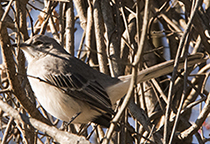 Today was the first time hiking North Park that the sun was out. (The background in the above landscape image is water. I’m high up on the riverbank shooting through the trees and bare branches at the lake below.) Walked Walter Road and the north side of the lake for a total of 4.1 miles. Saw the bird at the beginning of the trek. Almost missed it, because it’s beautifully camouflaged among the vines draping the dead tree.
Today was the first time hiking North Park that the sun was out. (The background in the above landscape image is water. I’m high up on the riverbank shooting through the trees and bare branches at the lake below.) Walked Walter Road and the north side of the lake for a total of 4.1 miles. Saw the bird at the beginning of the trek. Almost missed it, because it’s beautifully camouflaged among the vines draping the dead tree.
I sent the image to the Interpretive Naturalist at North Park’s Latodami Nature Center for ID and she wrote back identifying it as a Northern Mockingbird – once quite rate, they are becoming so common that they are now year-round residents. The Cornell Lab of Ornithology describes the specie – These slender-bodied gray birds apparently pour all their color into their personalities. They sing almost endlessly, even sometimes at night, and they flagrantly harass birds that intrude on their territories, flying slowly around them or prancing toward them, legs extended, flaunting their bright white wing patches.
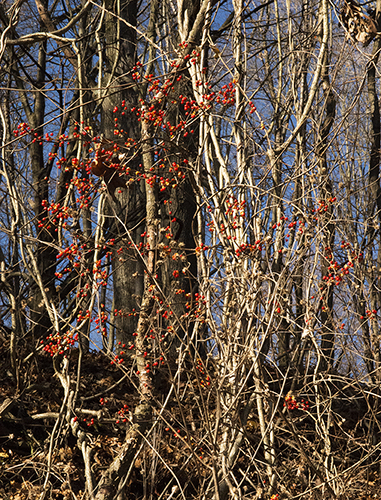
 Today, I walked 4.7 miles. Once at the top of Walter Road, I followed a utility-pole access-path to the top of the hill and the North Park golf-course, this added more uphill to the walk giving the hike an average 110 feet elevation. My route has three parts to it: 1.Walter Road – the first half of Walter Road is the climb – to Pearce Mill Road (1.6 miles), 2.Pearce Mill Road to Babcock Boulevard (1.7 miles), and 3.Babcock Blvd. to East Ingomar Road, right onto Kummer Road and right onto the parking area on Lake Shore Drive (1.4 miles).
Today, I walked 4.7 miles. Once at the top of Walter Road, I followed a utility-pole access-path to the top of the hill and the North Park golf-course, this added more uphill to the walk giving the hike an average 110 feet elevation. My route has three parts to it: 1.Walter Road – the first half of Walter Road is the climb – to Pearce Mill Road (1.6 miles), 2.Pearce Mill Road to Babcock Boulevard (1.7 miles), and 3.Babcock Blvd. to East Ingomar Road, right onto Kummer Road and right onto the parking area on Lake Shore Drive (1.4 miles).
This was the first time I used a wide-angle lens – 17-55mm. Turns out it’s not the best lens for use in the Park; there aren’t any open landscapes; and I’m walking along the edge of an artificial lake at the bottom of the holler. (Yes, I’m using an Appalachian term.) I’ve used this lens very effectively up close, but the ravines and hillsides don’t allow me to get near any of the things I’m shooting. Several times today, I found myself wishing I had a second camera with a telephoto lens.
The main reason for the walking is to get in shape for the trip to Machu Picchu. When I walk, I wear a fanny-pack and carry a camera – d800e – things I will have with me on the trip. The wide-angle lens is heavier than the multi-purpose 18-300mm that I normally use, but I wanted to see if the results made it was worth packing and lugging it on the Inca Trail. Today’s pics decided that the wide-angle lens is not coming with me. I have one more lens to try the 80-400mm before making a final decision. (The 80-400mm needs to return great pics to warrant its weight.)
With a super blue sky, I decided to shoot the vines with the orange berries that cover many of the trees on Walter Road. The best results were impressionistic images showing a red/orange haze in the trees; the details – the berries – didn’t come through. There’s a large image of the vines and the berries cascading over a tree-trunk in the slide-show. The vine is Oriental Bittersweet and here in Western Pennsylvania it’s considered an invasive species – the vines twist themselves around the trunk eventually strangling the host tree. And let’s just add that all parts of the plant are poisonous to humans. The species is native to Eastern Asia, but was introduced to the US for aesthetic purposes – it has been used in floral arrangements. Now, the plant is recklessly affecting the ecology of over 33 states from Georgia to Wisconsin. And here in the Paris of Appalachia, in North Park, Bittersweet is everywhere.
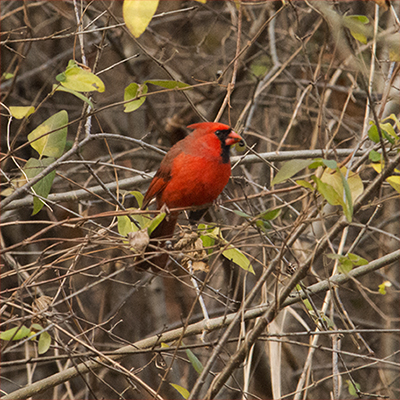
 Today, I had two goals – see if the 80-400mm lens was a viable option for the Machu Picchu trip and measure the walk around the Highland Park Reservoir.
Today, I had two goals – see if the 80-400mm lens was a viable option for the Machu Picchu trip and measure the walk around the Highland Park Reservoir.
the lens
In the plaza, in front of the reservoir, are several holly plants and they are full of red berries. In order to get the shot that is in the slide-show, I had to move far away from the bush and shoot it from a distance. I like the shot, but not having used the 80-400mm lens in a while, I had forgotten that it needed the distance. And where normally I like a manual focus, because it allows me to decide the core of the image, the problem with the 80-400mm is that it’s so heavy that keeping the camera still while adjusting the focus becomes a difficult balance. Also, I want to take a user-friendly camera with me to Peru so that I can hand it off and be in some of the pictures. The manual focus and the weight of this lens don’t make this an easy set-up.
the walk
The flat asphalt path around the two reservoirs is .96 miles. The reservoirs are at the highest point in the park and I had thought that being high up I’d get some good vistas and some good shots of the environments below. Nah! The trees are so thick around the path that the Allegheny River and valley below are, for the most part, hidden.
For the second part of the walk, rather than do the path again, I went down to Reservoir Drive which circumscribes the two huge reservoirs; this part of the walk clocked in at 1.1 miles.
It was just past the pump station, half-way around Reservoir Drive, that I saw the Cardinal. The above pic has been greatly zoomed. I took the original RAW file and zoomed in until the bird was front-and-center. A 300 pixels per inch resolution makes this zooming process easier and the limited zooming maintains pixel density and resolution. I copy the zoom detail into another file, creating a brand new image. And it’s at this step that I save the new image for the web – 72 pixels/inch.
I so want to say something about the contrast between the suburban Mockingbird and the urban Cardinal, but I may be beating a dead horse …
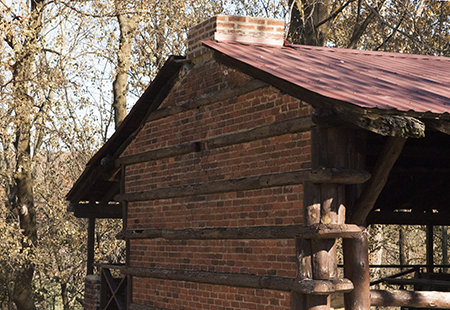
 glad tidings of comfort and joy
glad tidings of comfort and joyLast night, I discovered Annie Lennox’s Christmas album. It’s great fun; she takes all the schmaltz out of the seasonal songs and replaces it with pounding drums, African voices and her smooth contralto.
After looking at all the images of Lennox online, I settled on the Mapplethorpe photograph. Come on, how can I pass up the opportunity to write about Annie Lennox, Robert Mapplethorpe and Christmas carols? (It’s my answer to, “We’re saying Merry Christmas again.” )
1 The website – Diva Divotee – has great info on Lennox’s unique voice.
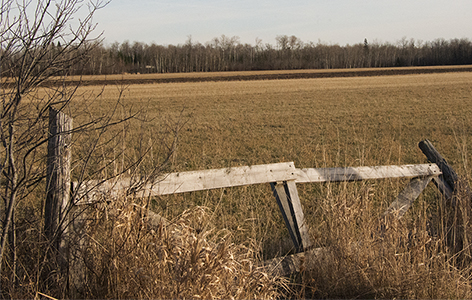
 Today, I walked from my parents’ to Connie’s for a total of 4.97 miles. Connie and Ron live in Ron’s family old house, west of the city. Ron is the third generation to live on the land that his ancestors farmed. The original farm has been subdivided into smaller plots and various family members live on these smaller plots. And the original homestead, built in the 1900s, is still in use; it’s on the plot next to Connie-and-Ron’s and a cousin lives in the old farmhouse.
Today, I walked from my parents’ to Connie’s for a total of 4.97 miles. Connie and Ron live in Ron’s family old house, west of the city. Ron is the third generation to live on the land that his ancestors farmed. The original farm has been subdivided into smaller plots and various family members live on these smaller plots. And the original homestead, built in the 1900s, is still in use; it’s on the plot next to Connie-and-Ron’s and a cousin lives in the old farmhouse.
The farms are between Base Line and the shores of the St. Mary’s River; approximately a 3500 acres area. Base Line marks the bottom of the hill and the beginning of the flats. The St. Mary’s connects Lake Superior and Lake Huron.
The image was taken at the corner of Base Line and Carpin Beach Road; Connie and Ron live down Carpin Beach Road. The roads below and perpendicular to Base Line take their names from the beach where they terminate.


Like all aging boomers, I’ve needed to look into support housing for my parents. My search is into the Canadian system, because my parents live in Northern Ontario. The advantage here is that it’s a small market and there are enough family and friends who can act of resources. The most surprising aspect is the cost. NOTHING like what the same facilities would cost in the US. And as my brother-in-law added, “Nothing like what it costs in metro Toronto.”
Currently, my parents tap into the various home-services that the provincial and federal governments provide. These services have allowed them to begin this phase of their lives while still living in their home. (My parents have always been practical people and we’ve begun the application process for an assisted living residence before we find ourselves with our backs against a wall, because one of them needs immediate placement.)
I’m using the farm photo for this post, because it’s a harkening back to an older time when grandparents, parents all lived in a multi-generational home; when extended families ran farms; when people didn’t move away from their communities and families. In today’s world, mobility, opportunities, schooling have dispersed family units and aging parents often find themselves alone in the town or city where they raised their kids. In my family, only my younger sister stayed in Northern Ontario. (I’m part of that age-group that ran to the cities for college and work.)
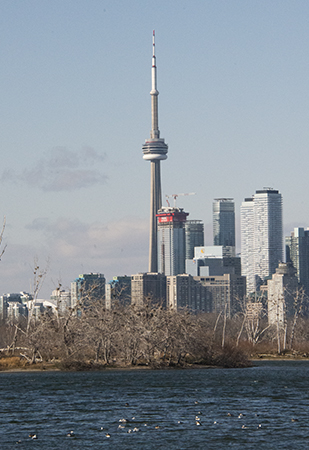
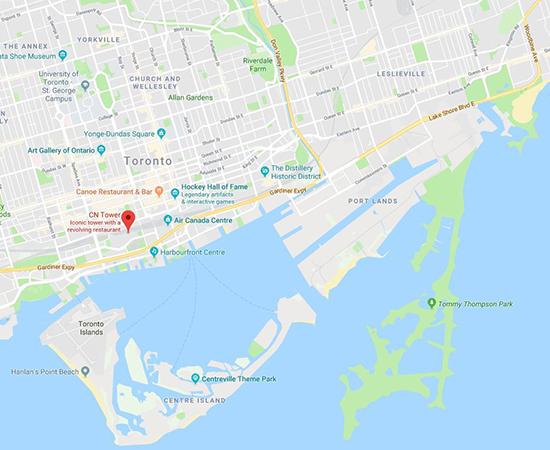
 The Leslie Street Spit is a man-made headland, or land-fill, extending from Toronto’s east-end into Lake Ontario. Originally, it was conceived as an extension of the Toronto harbor, but it has evolved into a largely passive recreation area. On the map, it’s the green amoeba-like protrusion crawling into Lake Ontario. The area is officially the Tommy Thompson Park. Thompson is one of Canada’s famous Group of Seven artists.
The Leslie Street Spit is a man-made headland, or land-fill, extending from Toronto’s east-end into Lake Ontario. Originally, it was conceived as an extension of the Toronto harbor, but it has evolved into a largely passive recreation area. On the map, it’s the green amoeba-like protrusion crawling into Lake Ontario. The area is officially the Tommy Thompson Park. Thompson is one of Canada’s famous Group of Seven artists.
Its common name – The Leslie Spit – is technically incorrect, since the land form is not truly a spit or a peninsula, but an amorphous landfill. The road running along the middle of the Spit is a southern extension of Leslie Street, hence the popular nickname.
The walk from the end of Leslie Street, on the mainland, to the end of the peninsula and back was 4.3 miles. (After two days of absolute miserable weather in Northern Ontario, it was great to find the sun again.)
The views of downtown Toronto are spectacular from this vantage point. The image on the right is deceptive, because it suggests that downtown is on the other side of vegetation. However, between the outcrop and the skyscrapers is the Toronto Harbor and Centre Island – better seen on the map.


Back in the late 60s and throughout the 70s, every time I went back to Canada to visit my parents, I would fly into Pearson Airport, take the bus down to the Islington Subway station and hop the eastbound train to Jane. I’d get off at Jane and Bloor and walk the 5 long blocks to my grandparents’ house and stay with them. I would visit with them; I would visit with my cousins; and I would visit with Frank.
It was great to fly in and get into town on public transportation. The airport bus and the subway allowed me to get to know my grandparents and to maintain my friendship with Frank and later his family. (At Norma’s memorial, Frank mentioned how through all the years – from grade-school on – we were able to stay in touch.) Toronto’s bus and train systems were an amazingly cheap and convenient way of getting around. I was a poor university student for many of those years and public transportation gave me options. (I remember meeting my cousin Gabe, after he and his family had moved from Calabria to Toronto, on the subway and us going out to lunch.)
Also, because of public transportation, I was able to nurture and expand my friendships into the extended Zinga family; I met, two or three times a year, with my cousins Gina and Renato. And 50 years later, I still see Renato and keep in touch with Gina through social media. I built a whole friendship group in Toronto and public transportation allowed me to come into town and visit with these friends regularly.
And, 50 years later, I’m repeating the process. This time around, I’m talking the UP – Union Station/Pearson Airport – train from the airport to the Bloor St. station and walking up to Frank’s. The trip cost $2.00. And it’s a 10 minute walk from the train station to Frank’s. This morning I did the reverse.
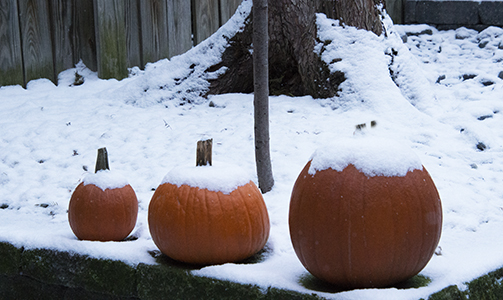
 winter’s first snow
winter’s first snowI shot these same pumpkins back at the end of October and then the focus of the post was the coming gales of November. (Back then, there were only the two large ones, the small one was still in the kitchen – fall decor.) It looks like the middle pumpkin may be collapsing. Once they freeze, with the next thaw, they collapse and it’s time to throw them away; fall is officially over.
Today, the weather turned – the skies stayed murky and gray all day, the winds brought blinding snow and when they had exhausted themselves, flurries and dropping temperatures allowed the snows to continue. (Dug out the snow-scraper and put it in the car.)
And today is the infamous election in Alabama. It all feels so much like the Carter years (1977 – 1981) when everything seemed to be in an upheaval; when we lived with stress on a daily basis. The difference is that back then the threats were external, now the threats are internal. Also now like then, new news-programs are emerging and reflecting the anxiety of the times. In 1980, Ted Koppel became the voice of the nation, counting the days that the American hostages were being held in Iran. Today, Rachel Maddow and Jake Tapper are rising above the din to tell the narrative of the times.
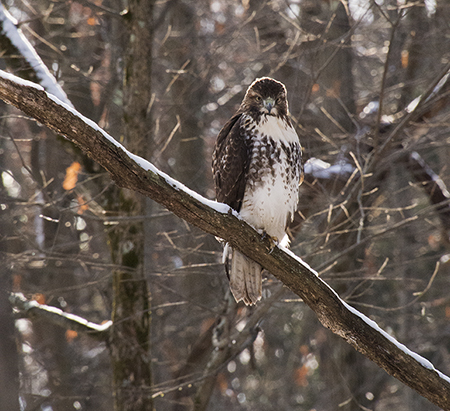
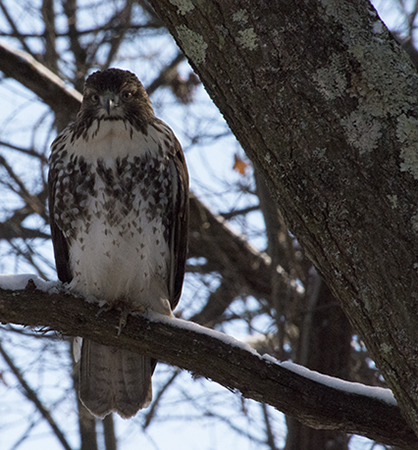
The title is an old Italian proverb. I like it, because it describes the current political state of Democrats and Republicans. As Democrats, we are well off; civil rights are a foundation of the party; we champion LGBT people; we support net-neutrality; we believe in climate change; we stand for a woman’s right to choose; we want health-care for all; we believe wealth should distributed not concentrated; and we believe that a good education is a civil right. And yet, in 2016, we were shellacked by nasty, rapacious Republicans who with their first piece of legislation will take away health-care from 13 million poor Americans, forbid health-care to millions of children; loot the treasury to give their cronies – the richest Americans – even more of our money; and to make up for the revenue loss, will make poor people pay more taxes. The hawk has eaten the dove.
The only pause, and let’s not pretend it’s anything else, in this carnage, is that yesterday, Alabama voters, for the first time in 25 years, elected a Democrat to fill the seat vacated by Republican Jeff Sessions. (In the 2016 presidential election, 62% of Alabama voters voted for the Republican candidate. Clinton got only 34% of the vote in this very Red state.)
The image is from my walk up Walter Road in North Park. As I was climbing the hill, the hawk lighted onto the snow covered branch; he was quite a way up from me. The 18-400mm lens allowed me to capture the predator from a distance that didn’t disrupt or disturb him. I stood there and did shot after shot, hoping that one would come out; and when I saw the above image, I knew I got it. Isn’t he glorious. Makes me think of Albus Dumbledore. (I sent the pic off to the the naturalist at the Latodami Environmental Center for ID. And I may have to change the pronoun once she gets back to me.)
I walked from the Off-leash-dog-area parking lot to the Kummer Road parking lot; a distance of 2.5 miles with an elevation of 190 feet. I climbed the Walter Road hill twice.
In researching the proverb, which I never found in Italian, I came across another one which is in keeping with the tone of the post. (My translation is more sentiment than literal.)
l’amicizia fugge della ricchezza come colomba del falco 1 — friendship is destroyed by wealth, like a dove is destroyed by the hawk.
1 Niccolò Tommaseo, Pensieri morali, 1845
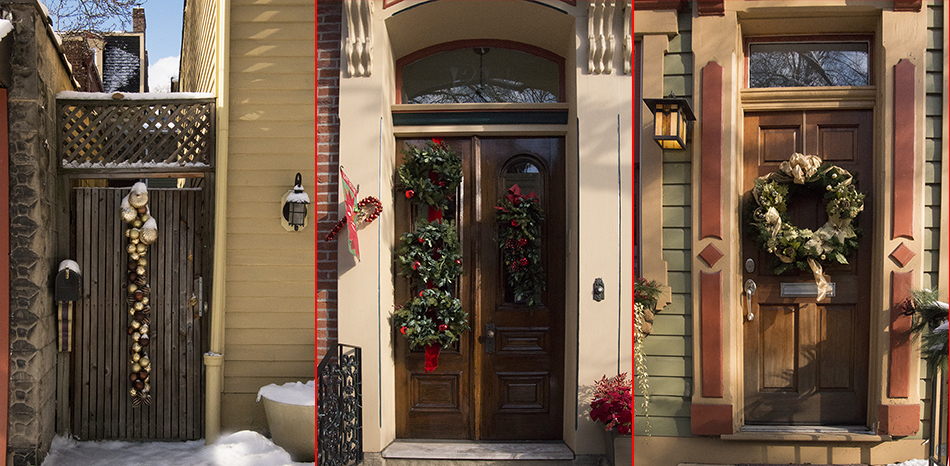

I’ve finally hit the Ebenezer Scrooge phase, and I’m enjoying it. A recognition of the hypocrisy of the season has helped push me into an anti mindset. The media and the business community are telling everyone to spend and spend; to buy frivolous shit, because everyone needs something to unwrap on Christmas Day. And reality can be suspended, rejected if it interferes with anything Christmas. This coercion is everywhere. I’m seeing people, some in my own family, spending money on insignificant and even insincere gifts, just because it’s what you’re supposed to do.
And to stand against this tide of hypocrisy is to be a Scrooge. For years, I’ve been on the fringes of the Christmas craziness, this year I’m actively announcing my resistance.
I can appreciate the decor, I just don’t want to participate. The above image is three doors in the War Streets.
Today, the walk was into town, for a 3.5 mile trek.


I’m looking for walks in North Park that include a climb. (I’ve walked Walter Road enough times.) Earlier in the week, I stopped by the park-office and got two trail-maps and a park map. The maps give a detailed outline of all the roads and trails in the park. In walking the circuit around the lake, I had seen a road that climbed the hill off of Pierce Mill that I thought it may be something to explore. Using the maps, I figured out a route to the intersection of the hill road and Pierce Mill and decided to give it a try.
I parked at Kummer-and-Walter, set the pedometer and headed across the street to walk the north shore of the lake. A mile and a half from my starting point, I got to the hill I wanted to climb – North Ridge Road. It was great seeing it closed off to traffic and not plowed – no oncoming traffic and undisturbed snow. This section of North Ridge Road is quite steep, shooting the overall elevation of the walk to 100 feet. Last week I had taken a spur off of Walter Road and I was careful, because it was a dead-end service-road. Today, I was less concerned, going up the closed road, because it was a wide two-lane and obviously used regularly, but out of service because of Wednesday’s snowfall.
The walk from the parking lot at Kummer-and-Walter, to East Ingomar Road, to Babcock Boulevard, to Pierce Mill Road, to the top of North Ridge Road, around the shelter loop, and then back down retracing my steps to Kummer-and-Walter was 4 miles.
Today was also a lesson in dressing for winter-walking. If I’m going to wear a short jacket, then I need to wear heavier pants or a base layer under my sweats. (When I did the first winter-walk a couple of days ago, I wore a long winter coat that covered me like a blanket. Today, I went back to the Canada Goose short-coat; not great for the lower body when the wind is pushing the cold through the sweats.)
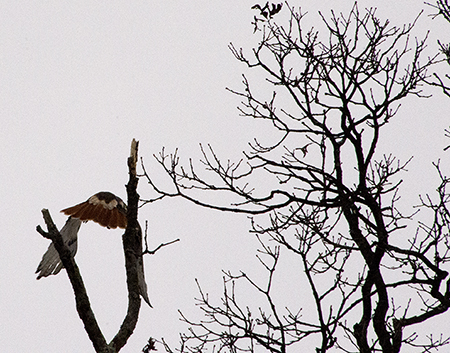
 red-tailed hawk
red-tailed hawkWhen I was doing the research, the Red-tailed came up as a common hawk in Western Pennsylvania, but I hadn’t seen the birds tail feathers and therefore couldn’t identify it such. Today, I saw one in flight and caught its beautiful cinnamon tail feathers. What also amazed me was the wide wing-span.
Because they are so common and easily trained, the majority of hawks captured for falconry in the United States are red-tails. Falconers are permitted to take only passage hawks (which have left the nest, are on their own, but are less than a year old) so as to not affect the breeding population.
Today’s walk was up North Ridge Drive. The road climbs the hillside above Pearce Mill and it starts and end at Pearce Mill. The other day, I walked the southern portion of the hillside road and today, did the northern leg. The road was plowed and open up to the Senior Center and the Water Tower, but closed for there on. The red-tail was in the trees below the Senior Center.
This leg of the Drive is steep; the overall elevation of today’s walk was 270 feet. I walked a mile-and-a-half in and then back out. Two factors restricted how long I walked: one, the day was gloomy, foggy and very gray making for dull, muted pictures; two, the Steelers were playing at 4:00 and I needed to get home well before that time or have no parking spot. On game-day, our street fills up with cars of fans who don’t want to pay the exorbitant stadium parking fees or get stuck in the post-game, get-home pandemonium. (It’s 7:30 and the fans are just now coming back; there’s a cacophony of beeping sounds out on the street.)
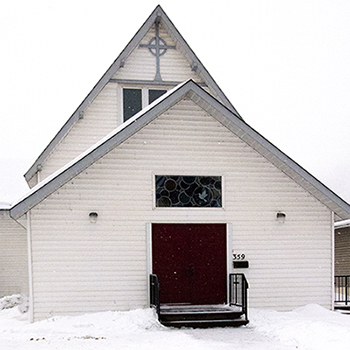
 st. peter’s
st. peter’sMy memory is that Mafalda took me to this Protestant church for my first set of vaccines back in 1957. (Nothing like two immigrant Catholics walking into a non-Catholic church. But Mafalda, ever the practical one, could set aside those cultural beliefs if it meant her child would get access to health services.) The free clinic was in the basement, so I never got to see the church or sanctuary.
The history of St. Peter’s Anglican Church goes back to 1906.
Got here yesterday afternoon. Pittsburgh was drenched in sunshine; Toronto was gray, but free of snow; Sault Ste Marie was covered in the white stuff and the temperature was at freezing. In the two weeks since my last visit, the landscape has changed radically. Only the major roads are snow-free, everything else is covered with ice and snow. There’s easily 6 inches of snow on the ground and the snow-banks are already almost 2 feet tall.
Today, Rose, Derrick and I went walking. I started from my parents’, walked to my aunt-and-uncle’s and from there up to the Fort Creek trail. The walk, there and back, was 5.4 miles.
Learned two things – cold weather drains the camera battery; the preprogrammed settings, on the d800e are not good on gray, overcast days. (For the first time, I brought only one camera and one lens, because wanted to see what I could do over a week’s time with one camera.) Between the cold weather, the gray days and the manual settings, the simpler d7100 may be the better camera for this environment.
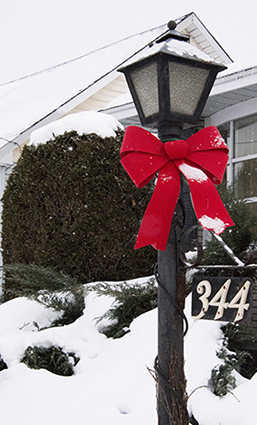
 winter has hit
winter has hitIn the last week alone, Sault Ste. Marie has received over 4 inches of snow. The most recent snow activity was yesterday and today – it hasn’t stopped snowing.
The image on the left was taken before the new snow fall. Notice the picture-window on the right side. The majority of houses in this part of town were built in the 1950; and having a picture-window was how you announced that you were living in a new house and that you were a young family.
Talking with friends of my parents, a couple of facts intruded into my consciousness:


I went out my front door, with the camera on a tripod and just shot up at the moon. Also, I did nothing to the image in Photoshop except to crop it.
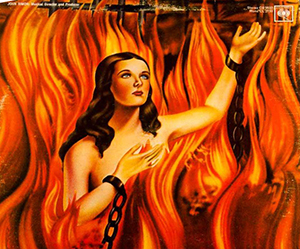 Fifty years ago, the album – Song of Leonard Cohen – was released. On the back cover of the album is a Mexican religious picture of the Anima Sola (Based on Roman Catholic tradition, the Anima Sola or Lonely Soul is an image depicting a soul in purgatory, popular in Latin America, as well as much of Andalusia, Naples and Palermo.) depicted as a woman breaking free of her chains surrounded by flames and gazing towards heaven. In a Rolling Stone interview, Cohen described the image as “the triumph of the spirit over matter. The spirit being that beautiful woman breaking out of the chains and the fire and prison.” Cohen found the picture in a botánica near the Hotel Chelsea in 1965. The album’s front cover depicts a sepia tint photo of Cohen credited to Machine.
Fifty years ago, the album – Song of Leonard Cohen – was released. On the back cover of the album is a Mexican religious picture of the Anima Sola (Based on Roman Catholic tradition, the Anima Sola or Lonely Soul is an image depicting a soul in purgatory, popular in Latin America, as well as much of Andalusia, Naples and Palermo.) depicted as a woman breaking free of her chains surrounded by flames and gazing towards heaven. In a Rolling Stone interview, Cohen described the image as “the triumph of the spirit over matter. The spirit being that beautiful woman breaking out of the chains and the fire and prison.” Cohen found the picture in a botánica near the Hotel Chelsea in 1965. The album’s front cover depicts a sepia tint photo of Cohen credited to Machine.
The first two LPs I ever bought were Gordon Lightfoot’s first album – Lightfoot! – released in January of 1966 and Cohen’s debut album – Songs of Leonard Cohen – released on December 27, 1967.
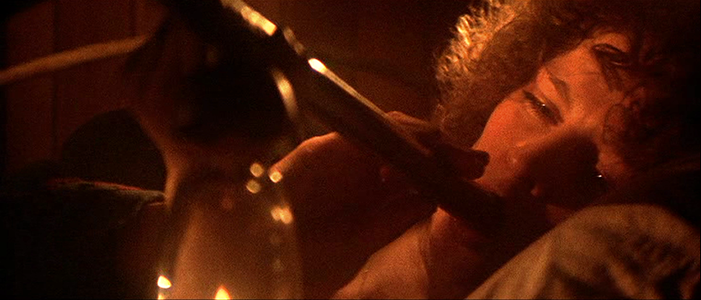

The image is from Robert Altman’s McCabe & Mrs. Miller released June 24, 1971. It’s gorgeous Julie Christie toking in an opium den.
Film Facts 1
1 The information in the Film Facts came from Wikipedia.
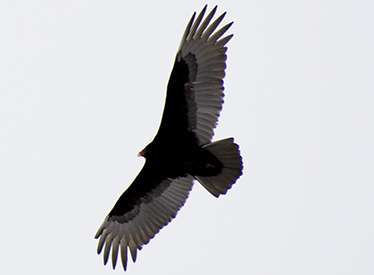
 you chose your journey long before
you chose your journey long beforeThe last time I did any walking was a week ago and that was indoors at Pearson Airport going from the domestic terminal to the new gates for the puddle-jumpers between Toronto and the American cities within a 500 miles radius. The pedometer clocked that walk at two-and-a-half miles.
Between getting over a cold and the miserably frigid temperatures, I’ve been indoors the last ten days. But today I wanted to see if I could get some walking in. Not too successful. After being out in the wind and cold for less than a half-hour – 1.1 miles – I turned around and headed back to the car. But I did shoot the red-tailed hawk in the above image; I’m on Lake Shore Drive with my camera pointing at the sky and clicking away.
I’m staying with lyrics from Cohen’s first album. The title, like that of the last post, is from Winter Lady.
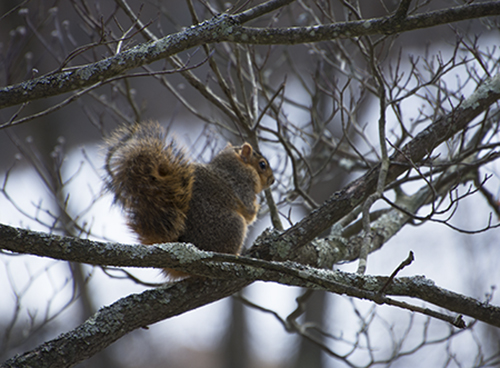
 and where do all these highways go
and where do all these highways go Today, the Park’s rodents ventured out – squirrels and chipmunks were everywhere. The miserable freeze is in retreat and the January thaw has marched in. The Park’s inhabitants, like its human users, ran the branches, rested on the tree-tops, crowded the roads and the tramped the trails.
I got in a 3.9 mile hike. And given that it was my first in a while, I stayed on the flats.
This is also the beginning of using the d7100 with the Tamron 18-400mm. Discovered that the lens couldn’t read the focus-point at 400mm, the solution was to switch to manual focus. (I want to see if there a difference in picture quality between the Tamron and the Nikon 18-300mm. The Tamron is a slightly lighter lens.)
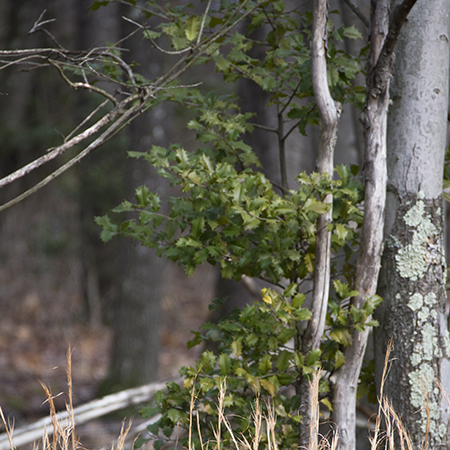
 the holly bears a berry
the holly bears a berry I’ve been trying to incorporated hills into my North Park walks. The first was Walter Road; before I walked it, I drove Walter Road and knew where it lead, its terrain and elevation. North Ridge Drive is a second hill road. But a major part of the drive is currently closed to traffic and therefore I can’t picture the walk, the elevation or the ups and downs. (North Ridge Drive is approximately 3.3 miles. This is from rough calculations on Goggle Maps.)
The climb from the skating rink, at the bottom of Ridge Drive, to the top is a 250 foot elevation change. The initial hill, the rest of Ridge Drive and then Pearce Mill Road back to the car is a 5.2 miles trek. (I’m leaving this loop for a nice spring day.)
Ridge Drive at the top has a number of new plantings – American Holly Trees. These are native to Western Pennsylvania and have been planted along the northern slopes of the road where there is good drainage and much organic-laden mulch. It was a surprise to see these small evergreens among the tall, bare trees. I also saw and shot a young red-tail. I’m assuming it was a young bird, because it was half the size of the others I’ve seen.
I think I’ve settled on the d7100 and the Nikon 18-300mm for the trip to Machu Picchu. It’s definitely the lighter camera, much more versatile and easier to hand off it I want someone else to take a pic with me in it.
Today, I walked 3.7 miles.

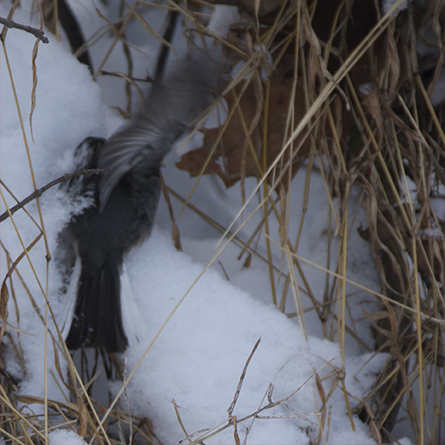
 in order to see birds
in order to see birds Walking Walter Road was a way of getting back into a routine. (The cold and snow have made walking sporadic. Today, the cold was still there, but it was sunny.) Walter Road, from its southern junction with Lake Shore Drive to its northern junction with Pearce Mill Road, is 1.2 miles with an elevation of 203 feet. I walked to Pearce Mill Road and back to the southern junction.
There were birds all along the walk. They flew in and out of the reeds, that were above the snow on the side of the hill, pecking for seeds. Most were brown, sparrow-like things, but the one in the image on the left could be a mockingbird, but I’m not sure. I liked that I caught it fluttering its dark-blue wing and I liked the contrast between its very white tail-feathers and the surrounding snow.
Actually today was a wildlife day; besides the various birds hunting for seeds, there was a red-tail hawk monitoring the skies and deer that came down to the roadside where the snow was less deep and twigs were accessible. Never mind that the snow, around the picnic shelters, was littered with animal tracks.


My favorite version of Ed Sheeran’s Perfect Symphony is the one he does with Andrea Bocelli. I like the orchestral arrangement and Bocelli’s tenor voice singing the choppy lines in Italian. Sheeran sings about dancing in the dark, Bocelli makes it even more intimate with his – ballo con te, nell’ oscurità. The English – dancing in the dark – provides an amazing image; the Italian wraps beautifully soft sounds, ballo con te, nell’ oscurità around the dancers.
Went back to Ridge Road for today’s walk. The southern half from the junction of Babcock Blvd/Pearce Mill Road to the Wyoming Grove – the midpoint – and back is 3.2 miles. So, I’ve now walked both the northern half and the southern half; somewhere along the line I’ll have to walk all of Ridge Road.
The second image in the slide-show – the trees – and the above image are both from today’s walk.


This shot is from Frank’s balcony, looking west, and it’s the first time I’m seeing the steeples.
Winter in Canada is a miserable season. The ticket-clerk at Union Station commented on the cold, but it was a throw away line, because her tone suggested the freezing weather was nothing out of the ordinary. When I got off the train at Bloor, it was -100 Celsius and with the wind-chill factor it felt much much colder. In the one-block walk to Frank’s, it was so cold my face hurt.
I generally don’t like Spielberg movies. They are too romantic, too sappy, too pretty, too long. I hated what he did to Thomas Keneally’s book on Oskar Schindler. A character that in the book is anything but attractive, is impersonated in Spielberg’s romantic retelling by gorgeous Liam Neeson. Talk about making Schindler a superhero; talk about manipulating an audience.
The only over-the-top, sappy scene in the current movie is his having a reporter repeat out-loud the Supreme Court decision – In the First Amendment, the Founding Fathers gave the free press the protection it must have to fulfill its essential role in our democracy. The press was to serve the governed, not the governors.
Yes, Mr. Spielberg we get the message. Thank you Mr. Spielberg for making sure we don’t miss your elitist liberal views, because they weren’t on display throughout the film. (Frank says that I’m being too harsh and that normal people need the repetition, the pointing out of the obvious.)


Wikipedia describes Barrie as a city in central Ontario. The city was named after Sir Robert Barrie, who in the early 1800s was in charge of naval operations in Canada and frequently commanded forces through the city. Today, with a population of about 136,000, Barrie is the 34th largest city in Canada.
Barrie is 70 miles north-west of Toronto and in a show-belt. Prevailing westerly, blowing off Georgian Bay, just dump lake-effect snow onto the Barrie area. This morning, we drove up to Barrie to go cross-country skiing. (The last time I cross-countried, I had more hair, more stamina and less weight.)
What I like best about cross-country skiing in Canada are the groomed trails. (I used the above image to show the groomed trails.) When I tell Pittsburghers about groomed trails, they have no idea what I’m talking about; when I tell Canadians that people in the US cross-country in the woods, on golf courses, they look at me, shake their heads and whisper, crazy Americans.


For years, officials in the city of Cosenza have been working on an ambitious urban regeneration project. One of their primary goals was to bridge the gap between two neighborhoods, Contrada Gergeri on the eastern shore of the Crati and Via Reggio Calabria on the western shore of the Crati. (Cosenza is at the confluence of the Busento and Crati rivers; the Busento terminates in Cosenza and merges with the Crati that feeds into the Ionian Sea.) To accommodate this difficult site, Santiago Calatrava suggested a cable-stayed bridge with a single inclined pylon rising above its urban surroundings.
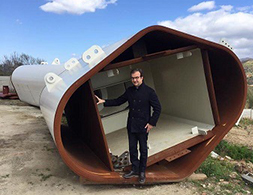 The slender steel pylon has a quadrilateral cross section shape with rounded corners (the image on the left is of Mario Occhiuto, the mayor of Cosenza, inside the pylon) and it is inclined backwards to show visible tension as well as create a clear visual direction towards the city. Overall the strings and form of this structure suggest a giant harp that’s been floated above moving water. The structure stretches some 460 feet between the two neighborhoods. Traffic for both vehicles and pedestrians moves in both directions.
The slender steel pylon has a quadrilateral cross section shape with rounded corners (the image on the left is of Mario Occhiuto, the mayor of Cosenza, inside the pylon) and it is inclined backwards to show visible tension as well as create a clear visual direction towards the city. Overall the strings and form of this structure suggest a giant harp that’s been floated above moving water. The structure stretches some 460 feet between the two neighborhoods. Traffic for both vehicles and pedestrians moves in both directions.
“I’m proud and honored to be a part of this momentous urban improvement project for the City of Cosenza,” Santiago Calatrava said in a statement. “Thank you to the officials of Cosenza who have placed their trust in me to deliver such an important piece of urban infrastructure …”
Facts: – Cosenza, with a population of 71,000, is a city in Calabria (population – 735,000); it is also the capital of the Province of Cosenza which has a population of 268,000. The ancient town is the seat of the Accademia Cosentina, the second academy of philosophical and literary studies to be founded in the Kingdom of Naples (1511) and one of the oldest in Europe. To this day, the city remains a cultural hub in Southern Italy, with several museums, theaters, libraries and the University of Calabria.
Partial Text: Nick Mafi – Architectural Digest – link
Photos: Osvaldo Spizzirri – January, 2018


The above images were posted by Antonio Rende on his Facebook page. They’re amazing.
My favorite is the image in the middle; il signore Rende was able to maintain the monochromatic elements even though there’s a red-light at the top of the tower and a person, with a mustard coat, on the bridge-deck.
Deciding how to organize and create the above composite was also great fun. The blog-page is 950 pixels across. And, I wanted to showcase the narrow center image and bookend it with two wider horizontal ones. The center image is 1⁄5 of 950 and the other two are each 2⁄5 of 950. (Visually, the image on the left looks wider than the image on the right, but they are the same width.)
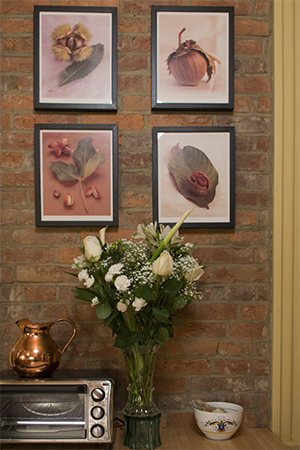

The midwinter mark was February 3 (the season has 88 days); we have turned the corner and are moving towards the end of snow and cold.
Yes, there was a time, long long ago, when winter was full of things to do and the snow and the cold were just incidentals. Why pay attention to your cold toes when there was a rink to shovel; when there was a warming-hut full of friends and hot apple-cider? Why worry about the 10 inches of new snow when there was a Bon Soo 1 dance to get to and a promise that Jim Morrison would plead, Come on baby, light my fire?
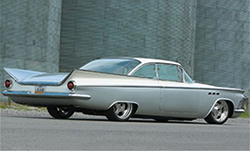
Remember Ron’s 1959 Buick LaSabre?
Yeah, we spun round and round up on Pine Street hill.
Whoa! Man, that was great.
That was a boat not a car.
The tree-huger speaks. Oh speak again dark angel.
We all fit in that boat and in winter it went everywhere. And don’t forget, we were the only kids from the West-End
with a friend who had his own car. Yeah Ron!!
Hey, hadn’t you just started dating that Anita chick? Man, you were the first one to have a girlfriend.
Oh wait, you still have one of those.
My favorite memory, was tobogganing down Garson’s Hill.
You took my brother’s toboggan without even asking.
Well, I wasn’t going down on no sleigh. Them was for losers.
Tobogganing was great until we started cross-country. Remember going down the snowbanks at my parents’ with our first skis? Yeah! 2 seconds of downhill.
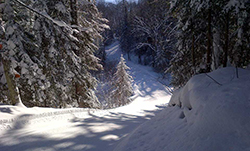
My sister smoked and she still kicked my ass on the trails. She could do the Pinder
9K extension and never break a sweat. Man, I hated her.
Aren’t you like supposed to get winded and wheeze when you smoke a pack a day?
This from the man who refused to pay trail-fees. And bragged about it. Of course, focus on your sister
and not on your ILLEGAL activities.
You have nothing to say, so put a straw in that mickey, shuck on it and shut-up.
Remember you refused to come skiing, because it was TOO COLD. A Canadian whining about winter.
1 Bon Soo – the Ontario Winter Carnival, Sault Ste Marie
Images: top left – kitchen outside wall; top right – 1959 Buick LaSabre; bottom right – Hiawatha Highlands trail


Everyone who’s been hiding from the cold and snow came out today. The 4-mile loop around the manufactured lake was full of joggers, walkers and bikers. It was also the first time I saw two red-tails chasing each other.
hawk facts
All I did was point the camera and shoot and that’s how the above image came about.
1 Pittsburgh Post-Gazette
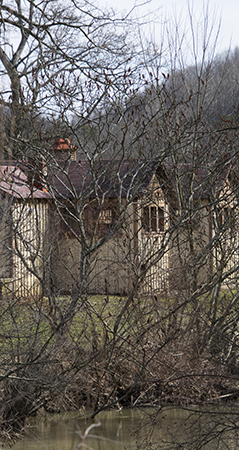

The temperature at 4:00 pm was 78o; the previous record was 77o on February 8, 1900. Today, a 118-year old record was broken.
North Park was full of people and cars. I forget that there are many for whom a car-ride, on a nice day, is an outing. Why walk or jog when you can sit in the comfort of your monster-car and see the sunshine, see the walkers, see the joggers through your tinted windshield?
I hiked up Walter Road and walked the western half of Lake Shore Drive for a total 2.8 miles with a 70 feet elevation.
The photograph on the right is deceptive. I noticed the structure and the creek through the bare trees and decided that I could configure an image that would look rustic, remote, romantic. Didn’t realize it would also has an appalachian feel to it.
The structure, built many years ago, has been re-purposed as a concession stand and bathroom facility.
Today’s record-breaking temperatures and the 11 hours of daylight can cause deadly damage to dormant trees. A heat spike, followed by a week of above normal temperatures can start the sap running. And where that sounds promising and spring-like, running sap can turn lethal in a cold-spell. Trees running sap will die if the mercury drops below freezing. (In 2014, we had similar temperature aberrations that caused the sap to start running before the last frost date for Western Pennsylvania. That year, throughout the region, thousand of trees were lost – died when the running-sap froze. I lost the two huge fig trees.)
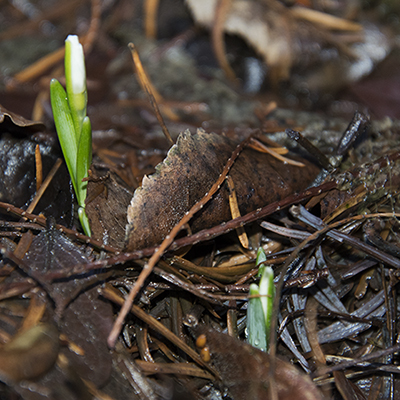

These appeared between yesterday afternoon and this evening. When I went looking for first shoots yesterday, the flower-bed was awash in wet rotting leaves; tonight, as the sun was leaving the western sky, I went looking again and there they were – the first shoots, the messengers, the heralds of spring.
This is also the beginning of the extreme-period – the last hurrah – that ends a season. (If only the same process spilled into the political arena, we could wake from our winter of discontent.)
It’s been a whirlwind of sunny/warm, windy/chilly, rain/close. And this turmoil will probably continue through March, expiring with the showers of April.
The first post on snowdrops is dated March 13, 2011 – le bucaneve – and I titled the post with the wonderful Italian word for these heralds of spring. (bucaneve is literally translated as puncturing through the snow.)
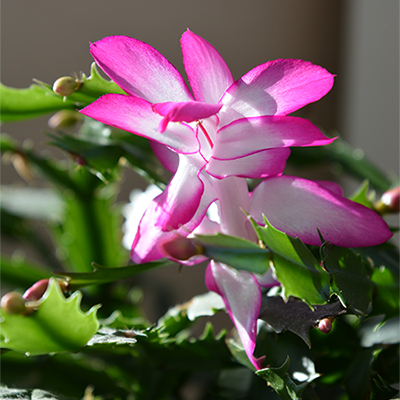

Years ago, I promised to avoid coming up to Northern Ontario in March, because I knew I would find winter again. But family circumstances brought me back.
The flights up were a retreat back into a frozen, snow-covered landscape. Western Pennsylvania was snow-free, so was Toronto, but from Barrie north, white covered the land.
What I found is that the snow is slowly melting and that my dad is probably in the best mindset and the best health I’ve seen him since the onset of winter. The end of the seasonal confinement and the hope of spring are bringing smiles back. He’s also figured out how to use both the wheelchair and the walker to get around and he now goes all through the house. He, my mom and I spent two hours in the sun-room, talking about all the crazy relatives and basking in the late afternoon light. The image on the right is a Christmas cactus, in the sun-room, that has decided to bloom in artless March rather than in deep December.


This morning took my dad into the hospital for a follow-up appointment and I was able to reserve an ambulance that came to the house and comfortably wheeled him out on a portable chair. (My dad has limited mobility, because of severe arthritis in his knees.) The Canadian health-care system has its detractors both here and certainly in the US, but this public system provides extensive care and support for 36 million people. The ambulance service, part of the large out-of-hospital support, is an amazing component of this universal health-care. (I marvel at all the at-home support my parents are getting.) The at-home option is a way of keeping patients in familiar surroundings and out of the hospital unless absolutely necessary.
After the appointment, I called the ambulance service to schedule the return and the dispatcher told me it would be a two-hour wait. (Because I had no idea how long the appointment would take, I couldn’t make a reservation for the return portion, so we had to take what was available.) My dad didn’t want to wait, so I called my sister and we went to the lobby to wait for her. (I had ridden in the ambulance and expected to get home the same way, so I didn’t have a car.)
While we were waiting, a relative of my dad’s saw him and came over. When she realized we were waiting to go home, she immediately called her husband and arranged for him to come by and pick us up and take us home. This all happened so quickly and without any hesitation on the relative’s part, that I didn’t even get a chance to tell her that we already had a ride. So, I was left to call my sister and tell her not to come up.
Only in a small town, where one frequently sees extended family and where everyone lives near, is this happenstance possible. The flip side of this feeling of belonging/of community, is the suffocating experience of living in a place where everyone knows your name.
I left the small town 50 years ago; I thrived in the anonymity of New York City; I experienced the freedom of living away from parents and relatives; and I got to create my own non-biological extended family. But even I, skeptic and stranger, could appreciate the serendipity of this morning’s chance encounter.
The above image is the pond, still under winter snow, above the Fort Creek spillway.
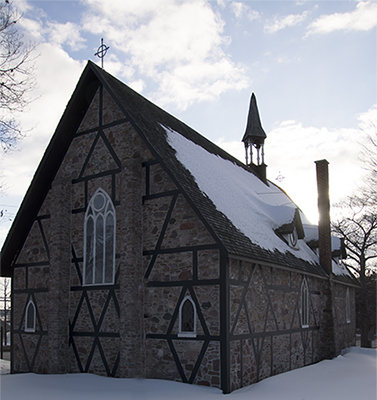

As Imperial England marched across the new continent, the Anglican Church was one of its most successful brigades. The Shingwauk/Fauquier Chapel, on the grounds of Algoma University, is a left-over from the time of subjugation and raping of Native people by the British Redcoats.
But the time of empire is over, and as it recedes into shadow its war-crimes get whitewashed and disguised in pageantry, romantic melodramas, heroic movies,2 country homes and quaint stone structures. I’m shooting a beautiful historic chapel, on a rise, on the north shore of the St. Mary’s River. In the early 19th century, what did the Indian children, ripped from their families and tribes, see when they looked out their dormitory windows, what did they feel when they heard the chapel bell toll?
1 – The Bishop Fauquier Memorial Chapel
2 – In Winston Churchill, Hollywood rewards a mass murderer

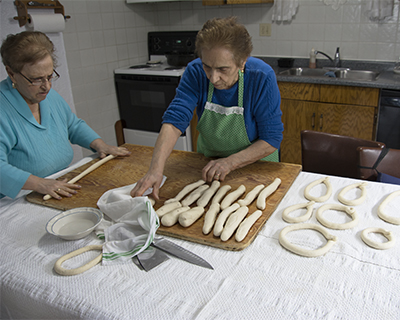
On Thursdays and Fridays, a relief-worker comes in to sit with my dad and my mother uses the time to go shopping, keep appointments or bake.
This week, because I’m visiting she asked if we could make taralli when the relief-worker was here on Thursday. This morning, I suggested we put off making the taralli and that she take the time to rest. Her answer – “Rest !!! And have people think I’m a vacabunna – a lazy good-for-nothing?” Needless to say, we made taralli. My mother is 93.)
Taralli are bread-sticks in an oval shape. They are most common in southern Italy, and in Calabria they are flavored with small black anise seeds.
My mother began early this morning to set the yeast and by noon, she had mixed the dough and was ready to make the taralli. In the image, my aunt, on the left, is rolling out the dough into a long thin strip that she will then form into an oval pinching the ends together. (The small bowl has water in it and both my aunt and my mother would lightly wet their hands while rolling out the dough. The wetness stops the dough from sticking to either their hands or the kneading board.) My mother, in the middle, is rolling the dough, she had cut and kneaded into small pieces, and making long ovals. Making the dough into long ovals begins to break the yeast down and gets it ready to roll into long strips. On the right are some of the raw taralli.
The most I could do during this portion of the process was admit that I could never roll out perfectly even strips; keep them company and take pictures. However, I could certainly do the next two steps – boil the taralli and then bake them.
The raw taralli get dropped into a pan of boiling water and removed once they float to the surface. Boiling the dough gives the baked taralli their shiny surface.
The boiled taralli are then put onto the oven rack and baked until golden brown. In my mother’s electric oven, because the heating coil is on the bottom, the taralli need to be flipped when the one side is golden brown. We made close to 75 taralli.



We’re on the boardwalk east of Exhibition Place and I’m shooting the mills in Hamilton.
But time has no beginnings and history has no bounds
As to this verdant country they came from all around
They sailed upon her waterways and they walked the forests tall
Built the mines the mills and the factories for the good of us all 1
There was a time when the steel-mills in Hamilton lit the horseshoe that is this section of Lake Ontario; when train-whistles and boat-horns serenaded the golden horseshoe. Today, the mills are silent, dark, skeletal. And the city is being invaded by Toronto hipsters looking for cheap rents. Dirty, polluted Hamilton is becoming the Brooklyn of Canada.
Lightfoot’s lyrics talk to an aging generation, my parents’ generation, a generation that is quickly passing. No one under 50 sees mines, mills and factories as good. And yet these aging infrastructures built the middle class; built modern Canada.
The province is on the cusp of an election that will either return the Liberals and Premier Kathleen Wynne to power or embrace a loud, obnoxious Tory – Dough Ford – who is promising to return Ontario to the manufacturing giant it was 50 years ago.
1 – Gordon Lightfoot. Canadian Railroad Trilogy.
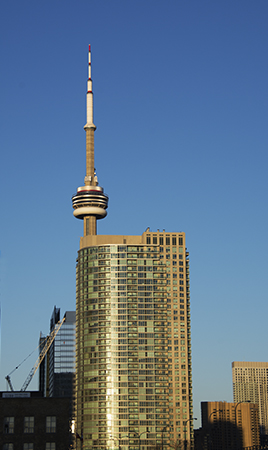

It’s 7:00 am, it’s a chilly -3 Celsius, and we’re on our way to the St. Lawrence Market. Because we can’t find on-street parking, guess others were up well before us, Franchino parks in the Loblaws’ lot and we walk up to the Market. (The shot is from the roof of the parking lot. The shadow on the bottom right lets you know that we are in the eastern part of the city and the sun is coming up off the Scarborough bluffs.)
There has been a public market on the site – corner of Front Street East and Jarvis Street – since 1803. It was great to see a plethora of root vegetables in the various stalls. My favorites were the orange beets.
After the Market, Franchino went to Loblaws for mangoes and cilantro; he’s making a salad for Sunday dinner.
Finding a landscape, in Northern Ontario, that was still covered in feet of snow was disconcerting. Temperatures in Toronto may be chilly, but blue skies and the absence of snow point forward to spring not backwards to the misery of winter. It’s great to be out of snow country.
Besides the weather, being away from the claustrophobic immigrant community is another plus. I can’t figure out if the atrophy, in the Italian community in Sault Ste Marie, is due to aging. The majority of immigrants that came to Canada in the 40’s and 50′ are now in their 90’s and focused on end-of-life issues rather maintaining a healthy, progressive community. The claustrophobia may be symptomatic of aging and the lack of new blood, but Sault Ste Marie is not unique in this degeneration. Most manufacturing centers in Canada and the US are wasting away and the left-over populations are unable to deal with the protocols that impose a new world-order.
Small-town Canada – Sault Ste Marie, Harrow, Leamington – is where I know people that reject cell phones, reject the internet. These new fangled devices and technologies don’t fit into their analog experiences and are therefore marginalized. It’s these attitudes and fears that make slogans like – Make America Great Again – resonate because small-towns are being decimated my modernity.
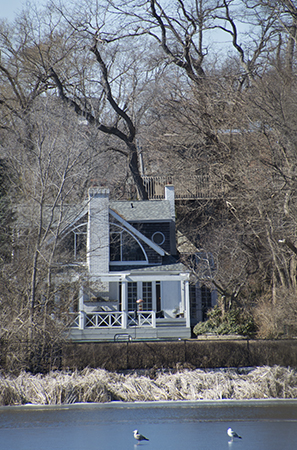

The lingering ice on the edges of ponds and lakes is a reminder that winter still holds Canada in its grip. The sea-gulls, in the bottom of the image, are standing on the thin edge-ice. Here in Toronto winter’s grip is not the tight fist that is still strangling Northern Ontario, instead it’s a velvet choker suggesting we wear winter coats, winter hats, gloves and scarves.
We did a 2.3 mile hike through High Park and I shot the house because I had never noticed it before – it’s been hidden by the greenery that perimeters Grenadier Pond. It’s one of the many high-end houses, in the upscale neighborhoods, that surround the Park.
When my family would visit back in the late 50s and early 60s, the Park was one of the first destinations my grandparents took us to. They lived 2 kilometers west of the Park on Jane north of Bloor. Sundays we would drive into the Park and picnic. My grandmother was in charge of the food and set-up; my grandfather walked us down to the pond and the zoo. And here I am, fifty years later, still in Toronto’s west-end; still walking High Park.
The main difference between that long-ago time and today, is that this morning the Park was full of young families, lycrad joggers, and determined walkers. In the late 50s/early 60s we had the picnic grove to ourselves. Immigrants went to the Park; the staid, nose-in-the-air Torontonias never did anything as plebeian as eat outdoors.
Back then, Toronto was ruled by first and second generation British immigrant families. Blue Laws were in effect and Toronto closed up at 5:00pm on a Friday and didn’t reopen until Monday morning. If you wanted to have a good time, you drove the 5 hours to Montreal. Them French were uncivilized, uncouth, peasants still. My aunts and uncles would often head east to Quebec for a weekend away from the rigidity that was English Toronto.
The British legacy families are in their twilight; their children have inter-married with the non-English and new immigrants have pushed the old British into the insignificant single-digit demographics.


I’ve refused to shoot or write about the March 21 snowstorm. After spending a week in Northern Ontario where there’s still two to three feet of snow in the backyard, I won’t showcase another winter event.
The shift to Daylight-Savings-Time is a major inconvenience. The only saving grace is that at 7:30pm it’s still light.
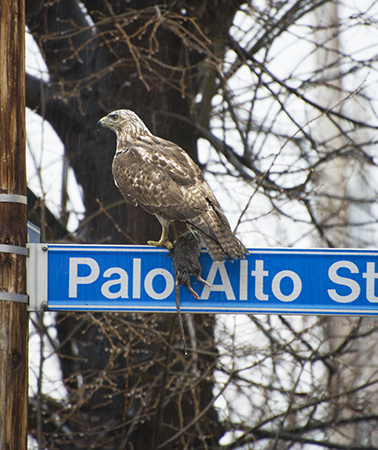
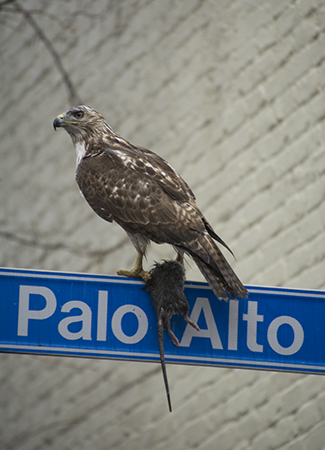
I parked and there across the street on a white SUV was a hawk. Amazing! I had no camera, so I took our my phone, not the best telephoto, but … Figured I could get in the house and grab my camera. Before going in, I looked at the raptor and realized it held a dead rat in its talons.
By the time I got back out with camera in hand, something had scared it and it was flying, low to the ground, weighted down by a wet dead rat. It lighted onto the street sign and I ran up, in the rain, and started shooting. Palo Alto is half-a-block up from me and the white background is the corner house on Taylor and Palo Alto.
The image is amazingly incongruous – a raptor with its prey, perfectly perched on a blue Pittsburgh street-sign and photographed with a high-end camera using a Japanese telephoto lens.
Yeah, one wants to ask, What the hell is a hawk doing in a residential area? but then one is happy to see it killed a rat, so maybe the question of a raptor on a street with families with children is less important. (Too bad it wasn’t a pigeon in its claw. Oh come on, pigeons are just the rats of the air.)
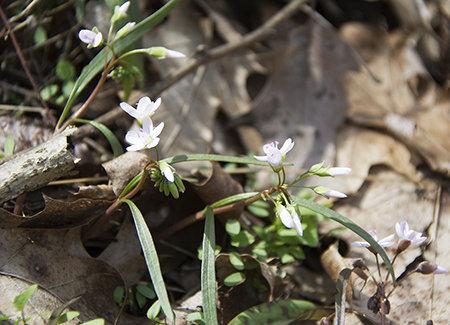

With every recent hike through North Park, I’ve been looking for early woodland wildflowers (I’ve been looking for violets, hoping to find a hillside covered in delicate purple hues) and it wasn’t until yesterday – late April – that I finally saw some. Research names them Eastern Spring-beauties – claytonia virginica. It’s an herbaceous perennial and its native range is Eastern North America. Its scientific name honors Colonial Virginia botanist John Clayton (1694–1773).
This plant has been used medicinally by the Iroquois, who would give a cold infusion of the powdered roots to children suffering from convulsions. They would also eat the raw roots, believing that they permanently prevented conception. They would also eat the roots as food, as would the Algonquin people, who cooked them like potatoes.
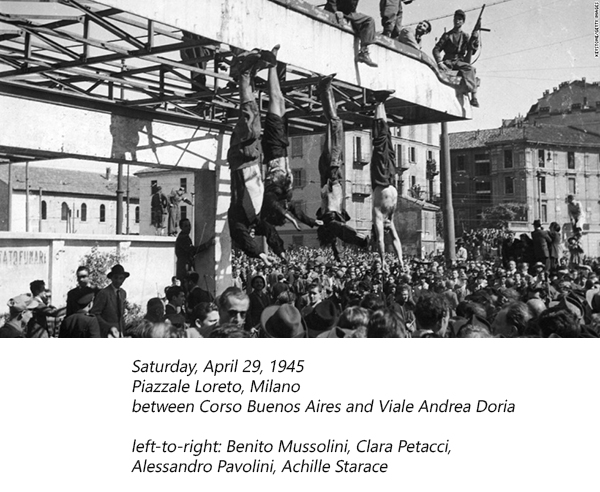
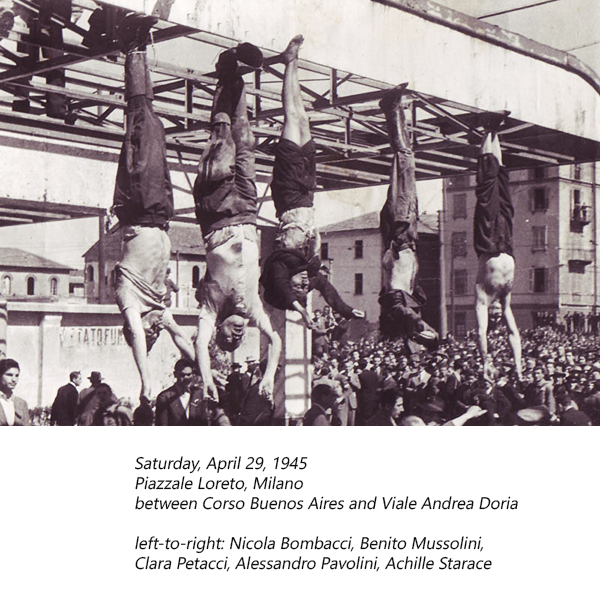
By April 1945, the Allies had landed in Southern Italy; Mussolini was losing his grip on the country; and the Third Reich was considering surrender.
In late April, Benito Mussolini his mistress Claretta Petacci together with other Fascist leaders joined a German convoy fleeing Italy. A group of local communist partisans attacked the convoy and forced it to halt. In all, over fifty fascist leaders and their families were found in the convoy and arrested. On Saturday, April 28, 1945, Mussolini and Petacci were executed by Walter Audisio an Italian partisan, in the small village of Giulino de Mezzegra, 80 kilometers north of Milan.
The next day, the bodies of Mussolini and Petacci were brought to Piazzale Loreto in Milan, the scene of a mass execution of partisans the year before. The corpses were beaten and urinated upon and left to hang upside down from a rusty beam outside a gas station on the north-west corner of the square. (Petacci had not been wearing any underwear and a group of old women rearranged her skirt to preserve her modesty.) People surged around, desperate to get a look, to laugh at and spit upon the bodies, wanting to make sure that Mussolini, fascist dictator of Italy for 23 years, was dead.


I’m at 46o North and 84o West and sunset wont be until 8:50. The area has almost 45 minute more daylight than Pittsburgh (40o North and 80o West).
The snow is finally gone. This is an amazing statement given that two weeks ago everything was covered in snow and the white stuff was still coming down. But the extended daylight has dried the ground and waken up the trees. I walked the neighborhood around my parents’ house and there were trees everywhere full of buds. Also, the new, soft-green grass is a clean breath in the industrial landscape.
My cousin and I drove up. (He had two goals – make it on one tank of gas and avoid getting a speeding ticket. He accomplished both.) It’s been 40 years since I made the trip from Toronto to Sault Ste Marie by car.
The trip has 3 section to it – Toronto/Parry Sound (150 miles), Parry Sound/Sudbury (107 miles), Sudbury/Sault Ste Marie (195 miles). My favorite part is the stretch between Toronto and Perry Sound particularly around Georgian Bay. The highway is one rock-cut after another. It’s a surreal landscape through low mountains of rock.
Also, from Toronto up to Perry Sound, it’s a divided highway. But at Perry Sound it becomes a two-lane road with occasional passing lanes. Finally after some 50 years, the province is rebuilding Highway 69 making it a modern divided highway from Toronto to Sudbury. And, you can see the path of the new lanes, of the new highway. (There was some evidence of new construction between Sudbury and the Sault, but it’s in its early stages. Sudbury to the Sault is still a two-lane highway. And because you’re following the contour of the lake, the landscape is flat and boring.)
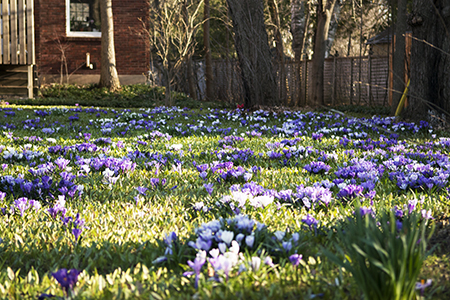

I was in the East-end, where the better people live, driving down Queen Street, when I glanced this front-yard full of crocus. Had never seen so many naturalized crocus and totally unexpected up here in the northern latitudes.
I find a place to turn around and head back. There’s no parking on Queen, so I turn right and pull up in front of a 1970s bungalow on fancy Lake Street. There’s an older guy sitting on his crowded front-porch behind his painted wrought-iron railing which some West-end immigrant crafted and installed. (Why do men’s chests and abdomens, as we age, look like barrels when we sit?)
It’s a short walk across the street, to the yard covered with crocus. And in my head, I script the following monologue for the East-end home-owner who eyed me as I got out of my dad’s van:
who’s this person parking in front of my house
he doesn’t look like one of us and look at that old rusted van
must be one of them dark-skinned EYE-talian from the West-end
doesn’t he know his kind aren’t welcome in this end of town
bad enough them other people took over the university down the road
we need to take back our province from them EYE-talians and them Injuns
Dough Ford is my man; he’ll make Ontario strong again.
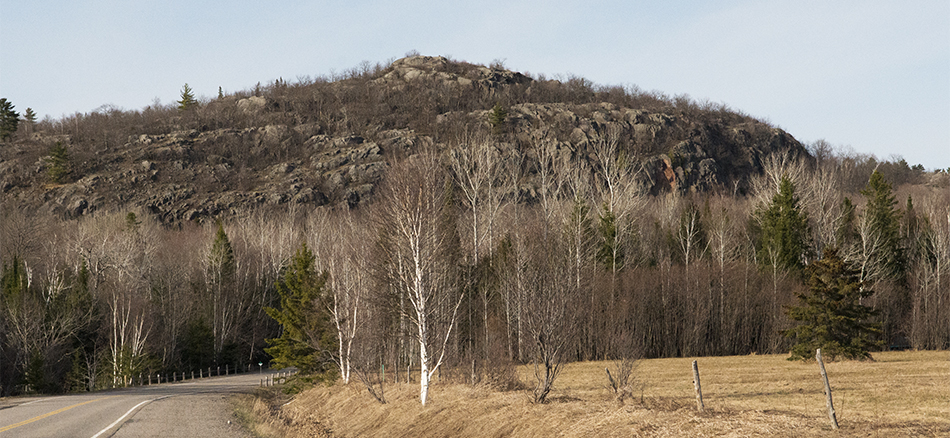

Highway 550, locally known as Second Line, runs 14 miles from Black Road in the east to Gros Cap in the west. (Gros Cap, is a jutting point on Lake Superior. It’s the southern tip of Goulais Bay, a small inlet on the south-eastern shore.) The western section of the Highway, rings the rock-ridge that borders the flats along the north shore of the Lake.
The white trees, in the above image, are birch and at this time of year, they shimmer in the sunlight.
Memories
As I’m driving Highway 550 towards Gros Cap, I’m wondering – are memories different for people who stay in the place they were born than for people who move away?
If you stay, the brain seems to adjusts for the contradiction between memory and current reality. You drive by the location where you experienced your first kiss, but now it’s a dilapidated, graffiti strewn wreck of a school building. The brain seems capable of allowing the memory and present to exist simultaneously. The brain doesn’t let the current reality tarnish or corrupt the memory.
If you leave the place of that first-kiss, then the brain hasn’t worked to balance and ameliorate the memory and the present reality. So, while in Pittsburgh, the first-kiss memory stays in that golden realm of long-ago. However, when I come back to the location of that memory and I see the wreck that is the school-yard, where someone kissed me for the first time, the contradiction between memory and reality is disconcerting. My brain has had no time, no practice to adjust, to ameliorate between the euphoric remembrance and the devastation that is the present location.
For me driving through sections of the West-end, where I spent my preteens and my teenage years is driving in a landscape of ghosts. An area that was full of young kids, full of young families is now an area in transition. My elementary school is wreckage; many houses that I hung out in are boarded up and abandoned; and my aging parents and some of their friends and neighbors, who have stayed in the area, are the last remnants of that long ago.
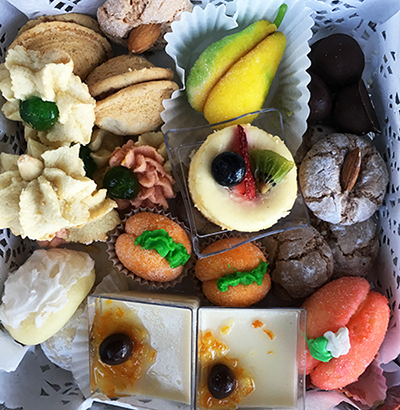

My mother’s friend Teresa, whose son is getting married this summer, brought these amazing dolci as a thank-you for my mother’s gift for her son’s shower/stag. And Teresa made them all; she has a reputation, among the Calabresi in the Sault, as a great baker.
So, for breakfast, I indulged. (It’s OK to have sweets for breakfast, because you can burn off the calories throughout the day. Every Italian knows that; it’s one of our rules.)
I’ve seen these dolci all my life, but it’s the next generation that has made them bite-size. My mother and her group of friends made the orange peaches, bottom right, the green-yellow pears, top right and the walnuts, top left corner, actual size. (The round white cookie in the bottom left is known as a ginetti and the round brown cookie with an almond in its middle is an amaretti. The two custard cups are new and I didn’t try them. They don’t fit the definition of a Calabrian breakfast.)
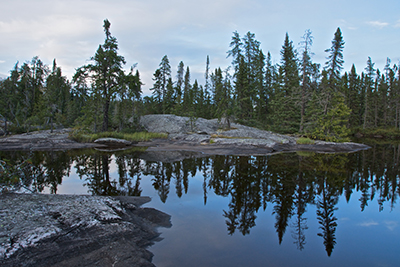

Yesterday, my cousin Joe and I drove back from the Sault to Toronto. (The last time I did this drive, I was in high-school.)
The trip has two distinct parts – the first part is east to Sudbury, the second part is south from Sudbury to Toronto. Between the Sault and Sudbury you’re on Highway 17, part of the Trans-Canada Highway, and the drive is very boring. The highway follows the contours of Lake Huron and is a flat uninteresting landscape. The highway also goes through many one-horse towns – Spragge, Serpent River – where the speed-limit drops to 30mph or traffic-lights force you to a complete stop. And did I mention that for the 190 miles it’s a two lanes road; this means that to pass you have to cross into the oncoming traffic lane. (Joe drives a Mercedes Coupe; and having an 8-cilinder engine in that driving environment made passing a ZOOM experience.)
However, once you get to Sudbury you turn south and for this portion of the drive down to Toronto, you follow the bend of Georgian Bay. Here you get to see the famous Canadian Shield or Laurentian Plateau. (The Shield is one of the world’s richest areas in terms of mineral ores. It is filled with substantial deposits of nickel, gold, silver, and copper. Throughout the Shield there are many mining towns extracting these minerals. The largest, and one of the best known, is Sudbury.) The highway is cut through exposed Precambrian and metamorphic rocks; these red-rocks formed the ancient geological core of the North American continent. There are areas in this part of the Shield that look totally surreal, other-worldly and there are areas where the rocks cradle deep-blue pools – above image – and everywhere there are marshes with evidence of beaver. There were beaver-dams and lodges in all the ponds and marshes off the highway.
The norther Georgian Bay region has slowly been sucked into what the Toronto urbanites call cottage-country. Yes, it’s almost 200 miles north-west of the city, but if you’re looking to buy a summer-home, prices in the established cottage-country area around Lake Simcoe, are in the stratosphere. Driving an extra hour brings young families into an affordable, hip and amazing landscape. It’s no wonder that the provincial government is invested millions into upgrading transportation into the region – there will soon be a modern divided highway from Toronto all the way to Sudbury.
After 50 years, the highway between the two largest cities in Northern Ontario – Sudbury and Sault Ste Marie – is still a two-lane road; and there are no plans to expand it into a modern divided highway.
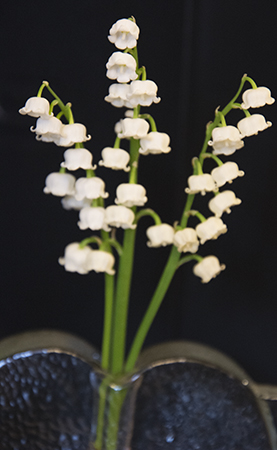

Rather than photograph the fleur-de-lis in the patch, in the back-yard, I decided to stage a more dramatic shoot. The lilies are in front of my black computer tower in a one-flower, heart-shaped, glass vase.
Also, I needed a segue from the posts about Northern Ontario to images and writings about the routines of daily life here at home. And here in Western Pennsylvania, the spring bulbs, the tree blossoms are done; and it’s now time for the lilies, the wisteria and the annuals.
Back in March, Franchino had given me a bunch of Dylan albums to listen to. (He’s taken on the job of educating me on his unparalleled fav – Bob Dylan.) And listening to The Freewheelin’ Bob Dylan was one of the highlights of last week’s road-trip.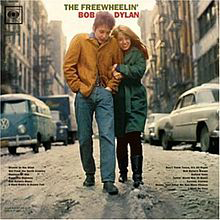 It’s only my second time listening to an entire Dylan album. (The other Dylan album I’ve listened to is Tempest.) I had no idea that some of his best compositions and best-known songs – Blowin’ in the Wind, Girl from the North Country, Masters of War, A Hard Rain’s a-Gonna Fall, Don’t Think Twice, It’s All Right, Bob Dylan’s Dream – were on that 1963 album. (Freewheelin’ is Dylan’s second studio album; and eleven of the thirteen songs are original compositions.)
It’s only my second time listening to an entire Dylan album. (The other Dylan album I’ve listened to is Tempest.) I had no idea that some of his best compositions and best-known songs – Blowin’ in the Wind, Girl from the North Country, Masters of War, A Hard Rain’s a-Gonna Fall, Don’t Think Twice, It’s All Right, Bob Dylan’s Dream – were on that 1963 album. (Freewheelin’ is Dylan’s second studio album; and eleven of the thirteen songs are original compositions.)
The album cover is a photograph of Dylan with his girlfriend Suze Rotolo. It was taken in February 1963 by CBS staff photographer Don Hunstein at the corner of Jones Street and West 4th Street in the West Village.
But it was the last song in the album – I Shall Be Free – that had me howling. I was at the Thruway toll at Buffalo, laughing hysterically at Mr. Dylan’s surreal lyrics.
Well, my telephone rang it would not stop
It’s President Kennedy callin’ me up
He said, My friend, Bob, what do we need to make the country grow?
I said my friend, John, Brigitte Bardot
Anita Ekberg
Sophia Loren
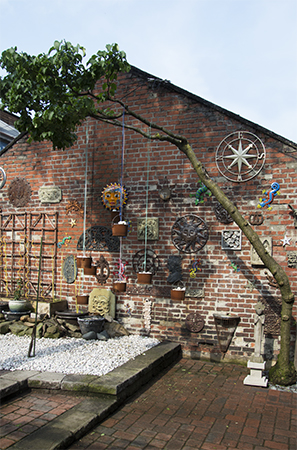

I spent the day working in the back-yard. Began by pruning the Japanese Lilac. Wanted to get rid of the vertical branches near the garage wall for two reasons: (1) wanted to create a wind-swept effect (am thinking of the pine trees, leaning over the rocks that I saw around French River, Ontario) 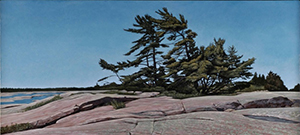 and (2) wanted to get sun in that corner, because the shade and moisture were creating idea conditions for moss.
and (2) wanted to get sun in that corner, because the shade and moisture were creating idea conditions for moss.
The image on the left is from the French River area; the image on the right is the Lilac trimmed and leaning; hopefully I can work on making more of a flow and less of a jut.
After all the work trimming, I tackled the mess, on the pavers, that winter left behind. The four levels were covered in moss and the corners were filled with leaves, needles and sticks from the redwood; the debris and a layer of green covered everything. Grabbing the hose and a wire brush, I went to work. The moss was the most difficult to clean up; I literally wire-brushed half of the back-yard. The resulting accumulation of water, ripped moss and other winter residue was a witches’ brew. There’s a great Calabrese word for this kind of wet mess – fracoma. The meaning suggests something rotten, something putrefied. And the word even sounds like what it means. (As a junior, I had an English prof who explained that fuck was one of the few English examples of onomatopoeia. And that correlation between sound and meaning was more common in other languages, especially ones derived from Latin.)
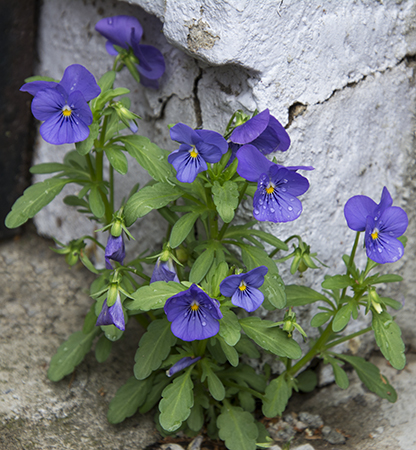

I noticed the cluster of violets in the corner of my neighbor’s front steps. They rose proud and defiant through the old, cracked concrete of the North Taylor sidewalk. The sidewalks are the home-owner’s responsibility and the results are a patchwork of new-and-old, brick-and-concrete slabs. The hodgepodge is proof that we are not a cookie-cutter suburban plan, even though when the area was first developed it certainly was a new, non-city housing development.
The Mexican War Streets, originally known as the Buena Vista Tract, is an area on Pittsburgh’s northside, filled with restored row houses, tree-lined streets and alleyways. The neighborhood dates to around the time of the Mexican–American War – 1846.
In the 1970’s, as a means of kicking off the gentrification process, community leaders and promoters planted trees in front of the historical houses; this meant breaking the sidewalks to create plots for the new trees. And once the cement was broken, the remaining slabs started to crack and chip. The results are what we have today – old cement that is broken, cracked and covered in thin layers of mildew.
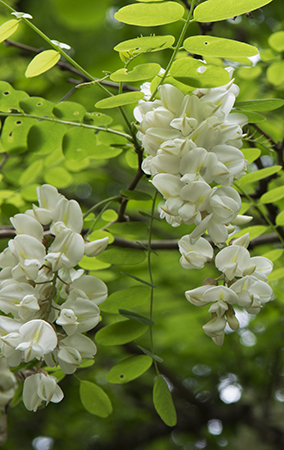

The last time I was in North Park was April 23, almost a month ago. Between my trip up to Northern Ontario and the fact that it’s been raining for the last two weeks, my options for hiking have been reduced. But, the rain and the moving season have transformed the Park. The tree-canopy is the beautiful new-green of first growth and there are flowering trees everywhere. There are Black Locust throughout Western Pennsylvania and at this time of year the tall skinny trees are in bloom.
off on a tangent
Every once in a while, I can grab, a slice of an image that totally re-imagines the original shot. The cropping process always reminds me of the pre-digital photographers and artists looking through an eye-magnifier at slides; looking for a detail, in a large image, that is extraordinary that is transformative.
On today’s walk, I shot several images of flowering trees; the image on the right is of the loose drooping clumps of the Black Locust. I also shot the flowering clusters of a Northern Wild Raisin, also known as Viburnum. It’s a mid-size shrub that can reach 12 feet. (The naturalist at the Allegheny County Parks Department said that there only a few Viburnum in the Park – along North Ridge Drive, the section near the Ice Rink.) In Photoshop, I looked to see which section of the image showcased the tiny white flowers with the giant yellow stamens. The best detail was at the bottom of the cluster and that’s the section that I cropped. The result is one of my favorite images. Click to see the image detail.

There have been five destinations that have been out of my comfort-zone. These were – England, Switzerland, Kuala Lumpur, Israel and Sicily.
● I hate all things British and to voluntarily go to England was a big step. And still afterwards, none of my misgivings or prejudices needed correcting. Outside of the grand palaces, England was littered with tiny houses and tiny spaces; the highway shoulders were strewn with garbage; the food was terrible; Oxford was a warren; Stonehenge polluted by the car-noise from the A303; and London had none of the grandeur of a Paris or a Rome.
● Switzerland was never on my radar, but the trip was a great experience. The place was super clean and the mountains were majestic. We took a gondola up into the Alps and it was truly surreal – going through the clouds, suspended above snow-covered peaks. There’s a famous family-photo of me and Mim, in our matching sweaters, at the restaurant at the top the mountain where the gondola dropped us off. It’s the iconic photo from the trip.
 ● Went to Kuala Lumpur, reluctantly, for an Internet conference. Back then, the Common Knowledge: Pittsburgh project was the only example, world-wide, of school-kids having Internet access. And Rick and I were invited to talk about the Internet in schools. The place was an experience is contrasts – American style highways, American style suburbs, American skyscrapers, American hotels all floating in an equatorial, colonial soup. Whoa!
● Went to Kuala Lumpur, reluctantly, for an Internet conference. Back then, the Common Knowledge: Pittsburgh project was the only example, world-wide, of school-kids having Internet access. And Rick and I were invited to talk about the Internet in schools. The place was an experience is contrasts – American style highways, American style suburbs, American skyscrapers, American hotels all floating in an equatorial, colonial soup. Whoa!
● The Wertheimers took me along on their trip to Israel and it turned out to be one of my favorite places. The country is ethereal, intense, scary, inconsistent. I loved the food; breakfast at the kibbutz was great; the date syrup was worth every calorie. The winds in the Judean desert echoed the music of the spheres; and in Wadi Rumm, we heard the sounds of silence.
● If you’re Calabrese and an immigrant, then Sicily is a place to avoid. It’s the land of Mafia. And it’s a people that you, as a Calabrese, are better than. I was 65 by the time I made it to Sicily. What an amazing place. It has a dynamic culture, a creative class, a beautiful landscape. But best of all, is its attitude towards political and Catholic Rome. The Sicilians look northward and raise their middle fingers. How can you not love a people that have blocked every effort to connect their island to the mainland via bridge; that have shuttered over 60% of their churches?
And now, I’m getting ready to add a sixth destination to my list. Bitonti and I are heading to South America, to Peru, to the Sacred Valley of the Incas, to Machu Picchu.
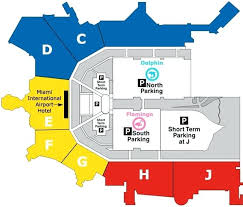

This morning, American Airlines called Frank’s cell to suggest that we take their 1:00 flight, because the later flight, we were scheduled on, would probably not be flying out – mechanical problems. So, we got it together and headed to Pearson by 10:30.
It’s now 6:00 pm, we’re in the Miami Airport and our flight to Lima doesn’t leave for another 7 hours.
The airport is a sprawling complex and we put in almost a mile walking from the domestic gate where we landed to the international terminal. And the international concord is a Spanish speaking area. Miami is an eastern gateway to Central and South America.
I always bring my phone and tablet charges with me, but it never occurred to me to also have my laptop charger and do some work while I’m waiting for a flight. (I’m just getting used to having WI-FI access at airports.) This is the first post, I wrote at an airport. (Frank is sitting across from me grading papers for his online course-work.)
I couldn’t sit in the uncomfortable chairs any more and just laid down on the floor. That’s the image on the right.
Sitting at the international terminal, I can’t help but think that this morning we left Canada, a country that was part of the British empire; and here we are in Florida and getting ready to go to Peru – a country that was part of the vast Spanish empire.
A side note: Our Miami/Lima flight got posted on the Departures board as delayed an hour. When I went up to the gate-agent to ask, she told me that the flight was on-time and that I should just ignore the board. The agent made an announcement about the on-time departure, but only in Spanish. (The Departure board was never corrected.)
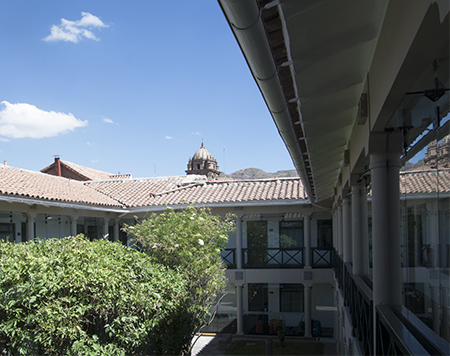

At the Lima airport we met our first VBT-person and he got us from the international terminal to the domestic one to check-in. The airport is extremely busy and having someone direct us was great. We also met the people that we will be traveling with.
At the Cusco airport, the guides took over and all we had to do was get in a small bus for the trip to the hotel. The pic is the courtyard in front of our room.
Cusco is 11,200 feet above sea-level and this is where everyone talks about altitude sickness. So far, I’ve had no reaction to the altitude. Tomorrow, we are descend into the Sacred Valley. Cusco is the highest point we will be at.
The VBT organizers, left today unplanned to give the group a chance to acclimate to both the altitude, weather and to give people traveling on their own time to get to Cusco.
We are in that space between the end of fall and the beginning of winter. So the weather is variable. We went out walking and I’m dressed in long-sleeves and layers. It never occurred to me to put on sun-screen and I can now feel that pre-sunburn tingle on my ears and face.
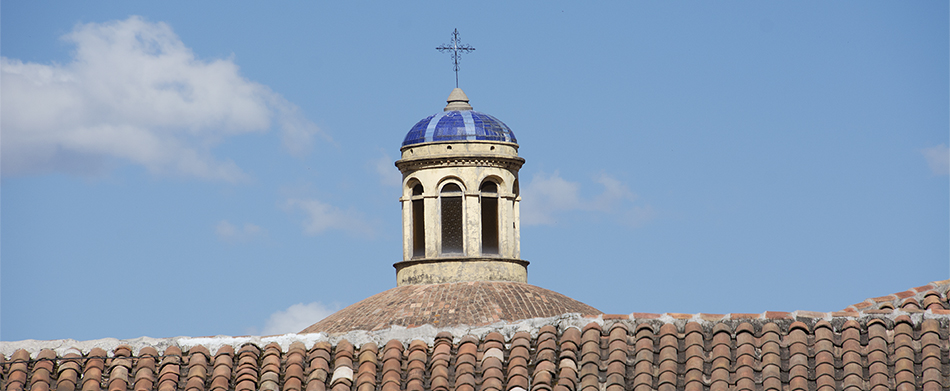

The main plaza in Cusco, with is magnificent Baroque cathedral, is so like the piazzas in Caltagirone, Catania, Modica, Noto, Ragusa and Scicli – the towns in the Valle di Noto. Both locations are magnificent examples of Spanish Baroque architecture. Here in Cusco, the facades of the convents, churches, basilicas are brown stone; in Sicily it’s the white rock, the tuffa stone, that is everywhere in Italy.
The Spanish, under Francisco Pizarro, with the Battle of Cajamarca in 1532, ambushed and captured Atahualpa – Emperor of the Inca Empire. It was the first step in a long campaign to subdue the mightiest empire in the Americas. To cement their control over the people, the Inca Empire’s central city – Cusco – was rebuild in the Spanish Baroque style.
Frank pointed out that Columbus’ first voyage in 1492 began the Spanish expansion in the Americas. And it would be 100 years before France and England joined the rush to conquer the New World. Imagine, for 100 years, Spain had sole access to the treasures and resources in the Americas.
In the seventeen century, the Spanish ruled the Kingdom of the Two Sicilies. After a devastating earthquake in January of 1693, in south-eastern Sicily, the Spanish sent architects to the region to rebuild the devastated cities in the Baroque style.
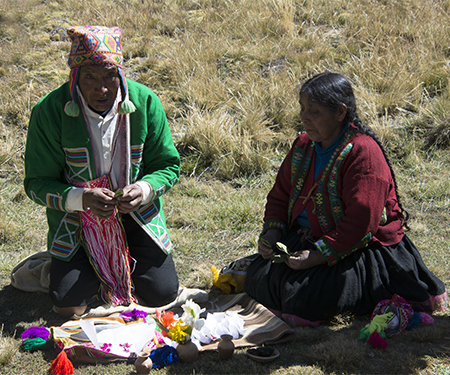

Today, was the first tour-day and the guides took us 30 miles south and east to a rural community in the Urcos region. Community, in this instance, refers to extended families working together for their common good. To reach the community we took the Interoceanic Highway an east-west, two-lane road that spans 1,600 miles from Peru’s Pacific coast, across the Andes, through a large part of the Amazon rain forest and into Brazil where it connects with a network of existing highways ending at the Atlantic.
The Cuyuni community operates a way-station for pilgrims going to the glacier in the adjoining mountain range as well as hosting tourist group like ours. In the above image, the community wise-man and an assistant are performing a ritual to Mother Earth. And the goal of the ritual is to honor and ask Mother Earth for her help with their crops, their animals and their families.

The community is slowly building the tourist side of their business. The tour package included a 2-mile trek through their properties, various ceremonies, a weaving demonstration and lunch. Also, the group is slowly building up a gift-shop that stocks hand-made items that their women have woven. The above image is a table runner I shot while browsing.
A side note: Potatoes were being harvested at various plots in their large holdings. At one point, two community women stopped at a smoldering mound and began to dig into the hot earth uncovering potatoes roasted in the ashes. With their thick roasted skins and natural sweetness they were amazing.
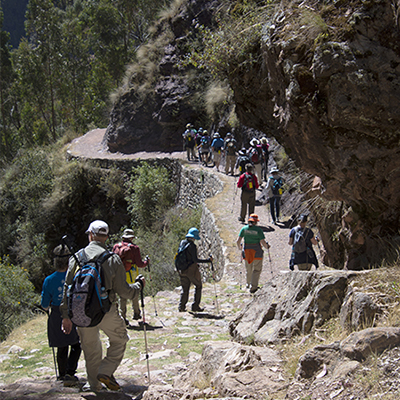

We began at the top of the mountain in the small town of Chinchero, 12,346 feet above sea-level and followed a section of the Inca Trail down through the valley to the town of Urquillo on the valley floor. During the 4-hour trek, we walked 9 miles along the remains of the ancient Inca Trail. In places, the steps were totally gone and you were slowly going down the slope that remained.
The ancient trail hugged the side of the mountain and in 4 hours, we dropped 3,000 feet.
You would think that going downhill should make hiking easier, but downhill places particular demands on knees and hips.
This was a very strenuous trek, made difficult by rock-covered slopes. We all used two walking-poles for stability and to minimize sliding down.
In the above image, we are at the beginning of the trail; and you can still see the walls that the Incas built, along the side of the mountain, to hold the trail-path.
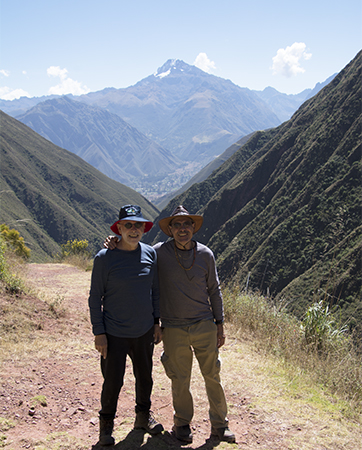

Halfway down and we reach a flat area and we all took pictures with the snow-capped mountain in the background.
Frank brought the hat with him; I quickly discovered that my ball-cap didn’t keep the equatorial sun off my nose or ears, so I had to buy a hat with a brim. (It will not come back to Pittsburgh.)
What I really wanted was a stovetop hat like the locals wear, but I was told that those are not sold at the tourist markets. 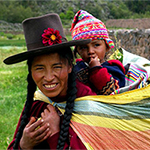 Apparently, each town or district still has its own hat-maker and he makes the unique hats for the people of his community. The unique hats designate what section, of the area, a person is from. (I didn’t need it to have a flower.)
Apparently, each town or district still has its own hat-maker and he makes the unique hats for the people of his community. The unique hats designate what section, of the area, a person is from. (I didn’t need it to have a flower.)
The other discovery was that winter in equatorial Peru is a misnomer. It is cold after the sun goes down and in the morning for a couple of hours, but for most of the day the weather is mild. I should have brought lighter pants and more T-shirts.
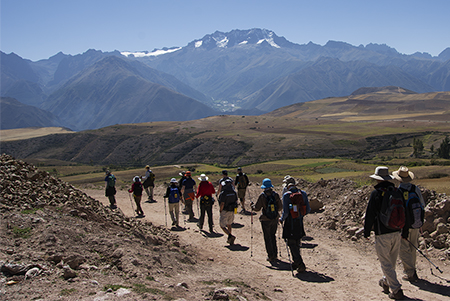
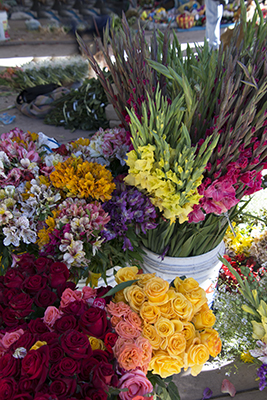
We began the day by going to the sprawling Qotowincho Market in central Urubamba, the largest town in the Sacred Valley. The market has everything from gladiolas to guinea-pigs. In Peru, guinea-pigs are a food, not pets. (Yesterday, at the corn-beer tasting, the hosting family served roasted guinea-pigs. I passed. How can I eat an animal that Connie and Danny had as a pet?)
The market is all local products grown in the surrounding cooperatives. There were sacks of fava; potatoes took up all of the northern stalls; squash filled a whole aisle. The market showed how, at the equator, the growing season is year-round; fava, a spring crop, and winter squash, were being sold side-by-side.
The animal vendors had guinea-pigs, ducks, piglets, rabbits, chickens, and sheep. And only the American tourists were oohing and ahhing the baby animals; the locals were dragging piglets and chickens into their trucks. (I asked our tour-guide what the bundles of green reeds that everyone seemed to be carrying were. He explained that they were food for guinea-pigs. Every family keeps guinea-pigs and they fatten them up before cooking them.)


After the market, we drove up to the small town of Maras – 11,082 feet above sea-level – to begin our hike to the salt flats. We walked through a large, rather flat, farming area at the top of the mountain. Our guides kept reminding us that the area was farmed collectively by a number of the surrounding communities. (In the Andes, the notion of working collectively is not an ideology, it’s an economic and social necessity when living in such a steep and rugged environment.)
When my mother asked what Peru was like, I answered, “Like Calabria 80 years ago.” Her comment was, “So, you’re saying that the people are poor and that they live interdependently.” The tour-guide suggested that this interdependence makes for a less aggressive and more cooperative personality. And therefore more welcoming and accommodating of tourists. (The locals are nothing like the snooty French or the disdainful Italians I’ve dealt with on other trips.)
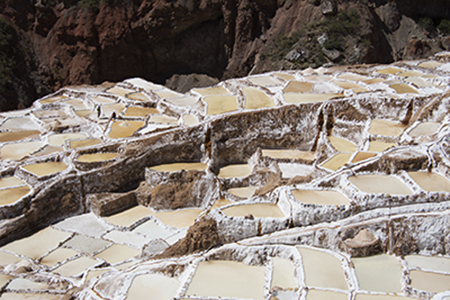

The salt flats are another cooperative effort of the communities around Maras Town.
There is a huge salt deposit under the mountains in this area and subterranean streams carry the salt to the surface. The flow is directed into an intricate system of tiny channels constructed so that the water runs gradually down onto the terraced ponds. (This aqueduct system is like a giant spider web stretched over the salt-flats.) Each pond is about 40 square feet and only 11 inches deep. There are some 700 shallow ponds and maintenance of the feeder channels, the side walls, the water-entry notch, the bottom surface, the quantity of water, and the removal of the salt deposits requires close cooperation among the families and communities that own the flats. Locals and pond workers say that the cooperative system was established during the time of the Incas, if not earlier.
As the water evaporates what’s left behind are huge deposits of salt. The top layer of the salt-flat is harvested and used for the animals, the middle layer is used by the community and the bottom layer, the desirable pink salt, is sold to the tourists.
In a valley perimetered by rugged peaks, a set of cascading ridges, covered with shallow salt-water pools and made white by evaporation, create a prehistoric landscape.

The logistics of getting to the ruins at Machu Picchu were not clear in the travel packet. All I focused on, was the need to bring a secondary bag that would server as my luggage when we went to Machu Picchu. (It was only after talking to Allie at VBT that I understood the need for a “carry-on” size bag that I packed a backpack.)
Access to the Inca ruins at Machu Picchu is strictly controlled by the Peruvian Government.
VBT interfaced with the government agency managing Machu Picchu to secure all the needed tickets.
The only way to get to the ruins at Machu Picchu is by PeruRail. And luggage size and weight are heavily restricted.
We left from Ollantaytambo Train Station early in the morning. We stored our small bags in the narrow space between the seats. And even though luggage size is restricted, service on the two-car train was like service on a trans-Atlantic flight. It was amazing.
The trip takes about an hour-and-a-half. The tracks follow the sacred Urubamba River – the reflection of the Milky Way here on earth. The train stops twice; once, to let off hikers who are doing the 4-day hike to the ruins; and a second time to let off hikers who are doing the 6-hour hike.
The majority of our group got off at marker Km104 for the 6-hour hike up the Inca Trail to the ruins. Ann, Don and I passed on the hike.
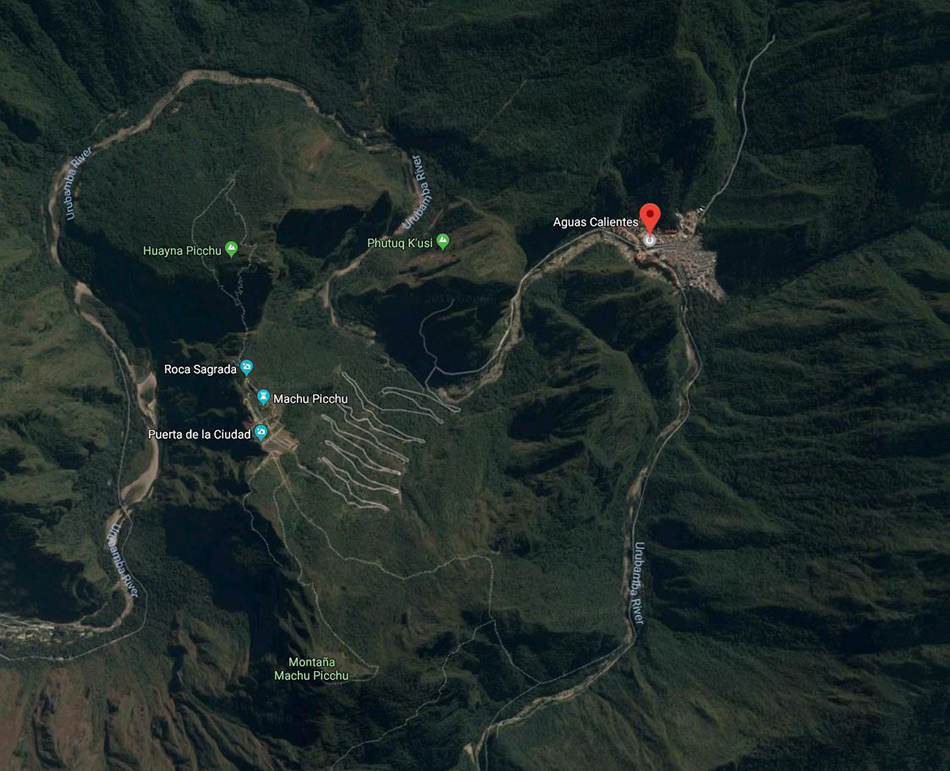
The final stop is Aguas Calientes. This small town services, accommodates and transports the thousands who come to see the ruins.
The whole town is about tourism. Near the railroad station are all the hotels, hostels and other accommodations. To get to our hotel – Inkaterra, Machu Picchu – we walked through the warrens that are the souvenir stalls. The hotel porters lugged all the luggage from the train station to the hotel on flat-bed carts that they push up the steep inclines.
There are no private vehicles in Aguas Calientes. To get to the ruins, you board a bus in town and for an hour you ascent the mountain on a one lane, gravel road.
It was both amazing and nerve-racking when two buses had to negotiate the right-of-way. Only the corners, on the switch-back road, were paved with stones otherwise we were on a dusty dirt road.
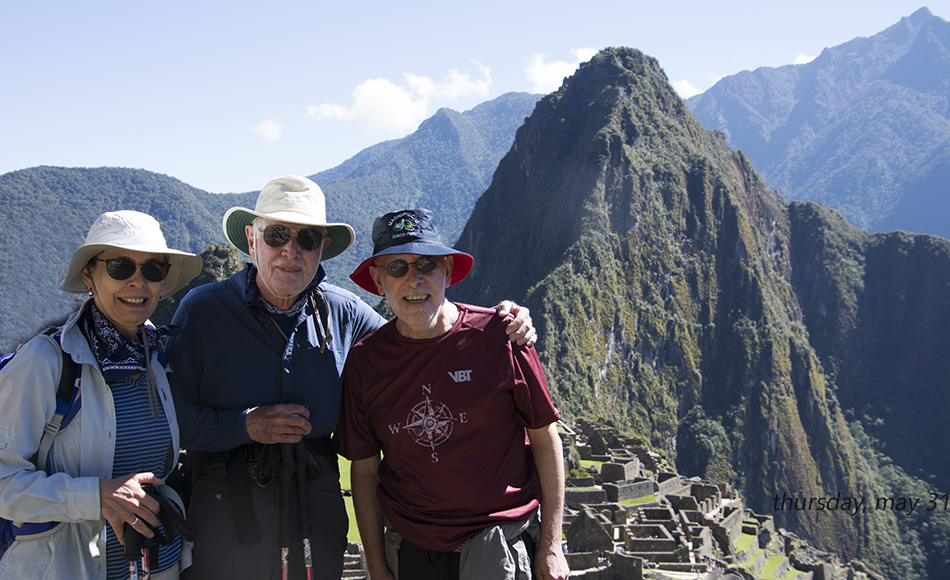

Ann, Don and I opted to not do the 6-hour hike, following the Inca Trail up Machu Picchu mountain. Instead we went up to the ruins on the shuttle bus. (Sergio, one of our guides, came with us.) We walked the Inca Trail from the ruins up to the Sun Gate.
The image is somewhat deceptive, because the ruins are quite far away from where Sergio took the shot. We are standing on a small plateau south of the ruins. (The small plateau is part of Machu Picchu Mountain.) From this distance, the ruins, the smaller mountain look like a set; it’s hard to get a sense of the size of the settlement, the size of the various structures from this far away. But as a backdrop the whole thing is amazing, right?
The peak behind us was at one time part of Machu Picchu Mountain. The earthquake that split the mountain left an area in-between relatively workable and it’s on this in-between outcrop that the Incas build the settlement.
Also, at the top of the peak, behind us, is an Inca observation station that can be reached from steps along the side of the mountain. Jorge, our other guide, said that when he was a teenager, the rage among he and his friends was to see who could reach the observation station in the shortest time. He made it up the mountain in 16 minutes. However, it became such a draw that people began to do very risky and dangerous antics to get to the top. The Government now restricts access to the peak and you have to make an appointment and be approved to go up. You also have to sign all sorts of waivers promising to not hold the Government liable for any harm that comes to you while making the steep climb.
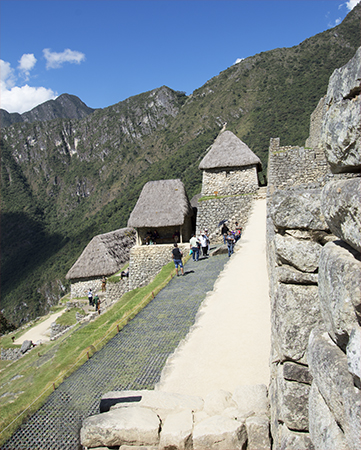
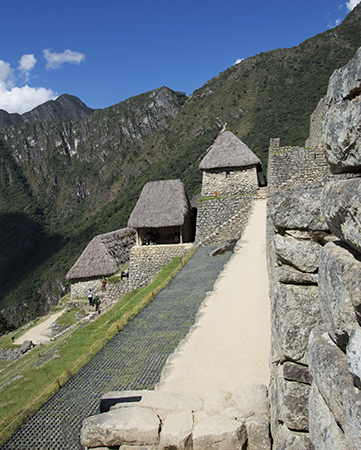
Yesterday, seeing the ruins from the southern plateau did not prepare me for the experience of walking into the settlement.
For many in the US, with its English Empire legacy, South America is seen as less than. American culture still holds on to those British prejudices towards southern people, towards people who are not English speaking, towards people who have dark skin.
And yet in Mach Picchu we are presented with indisputable evidence of a great culture, a society of scientists, mathematicians and astronomers; scientists who were breeding plants and animals for high altitudes; mathematicians who were using zero; astronomers who tracked the sun and the moon and believed the earth was round. (The astronomers were looking at the heavens through small reflecting pools found throughout the ruins. They were looking at reflections and had to convert what they saw back to a non-reflection.)
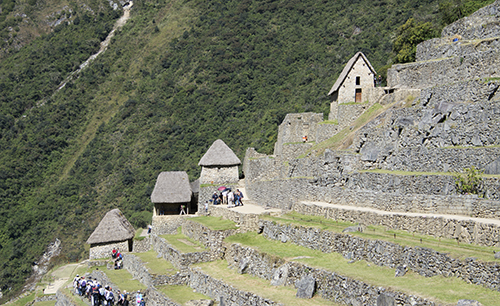 The ruins take their name from the mountain – Machu Picchu; no one knows what the Incas called the settlement, because there are no written accounts.
The ruins take their name from the mountain – Machu Picchu; no one knows what the Incas called the settlement, because there are no written accounts.
The Peruvian Government that manages the ruins, has roofed a number of the structures to show how they would have looked when people were living in the settlement. Both images are looking at the southern edge of the ruins; in the top pic I’m standing on the terrace directly in front of me. The bottom image, taken from the across the valley, shows the terraces that climb the side of the mountain.
In both images, I removed some of the people to give a better idea of the landscape and the ruins.
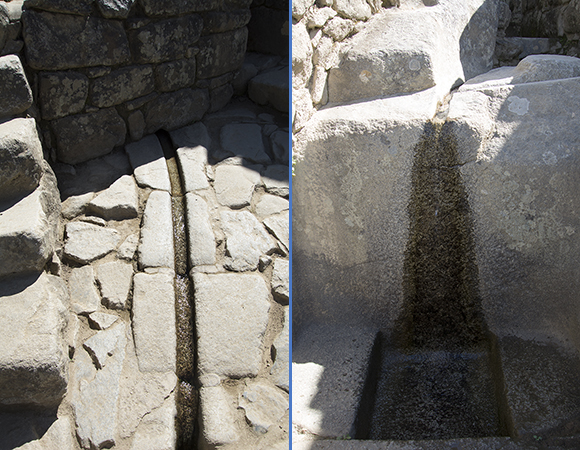

The settlement has a network of water troughs, pipes, and fountains that distribute the water the Incas channeled from the mountain streams in the vicinity. There’s even an underground sewage system that uses water to bring the waste out of the settlement and dumps it onto the agricultural terraces or over the mountain side.
The water story began on Tuesday when we entered the Sacred Valley. The valley is formed by the Urubamba or Sacred River. In the heartland of the Inca Empire, the Sacred Valley was the most important area for maize production; the valley also facilitated the import of products such as coca leaf and chili peppers from the tropical areas in the north and east. The valley was the main commerce channel to the empire’s capital at Cusco.
The Incas believed that the Urubamba River was a reflection of the Milky Way on earth. The Milky Way1 – the Mayu – was believed to be a river and the source of all water on earth. And since earth and sky are connected the Sacred River was the reflection of the celestial river.
1The Milky Way a barred spiral galaxy with roughly 400 billion stars appears like a band of light in the night sky. The galaxy stretches between 100,000 to 120,000 light-years in diameter.
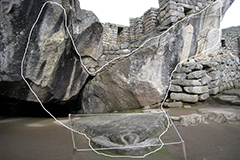
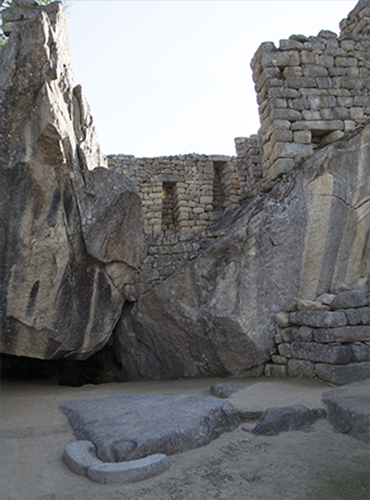
In Inca mythology, the condor ruled the sky, the puma the earth and the snake the underworld.
The Temple of the Condor at Machu Picchu is a very small space in the south-east section of the settlement. The space is dominated by a massive abstract representation of a condor, its outstretched wings carved onto pre-existing slabs of stone.
On the floor of the temple is a rock carved in the shape of the condor’s head and neck feathers, completing the figure of a three-dimensional bird. Historians speculate that the head of the condor was used as a sacrificial altar.
Under the temple is a small cave that originally contained a mummy. Also, there’s a prison complex directly behind the temple comprised of human-sized niches and an underground maze of dungeons. According to historical chronicles that documented similar Inca prison sites, an accused citizen would be shackled into the niches for up to 3 days to await deliberation. He could be put to death for such sins as laziness, lust, or theft.
Throughout the settlement we saw example of where the Inca incorporated pre-existing slabs, outcrops or boulders into walls, stairs, floors. In the Temple of the Condor, the use of two gigantic slabs to represent the condor’s outstretched wings was the most spectacular.
 This was the last location we entered before we made our way out of the ruins. By then we were all tired and the place was emptying out, so my options for finding a location to shoot this massive abstract were limited. It was the one time I regretted not bringing a wide-angle lens. To shoot the pic and to get any semblance of the wings, I had to press flat against the outside temple wall.
This was the last location we entered before we made our way out of the ruins. By then we were all tired and the place was emptying out, so my options for finding a location to shoot this massive abstract were limited. It was the one time I regretted not bringing a wide-angle lens. To shoot the pic and to get any semblance of the wings, I had to press flat against the outside temple wall.
(I found the image on the left online. It gives a better idea of the outline of the condor and the massive slabs that form its wings. The low rock-wall on the right is an entrance into the temple.)
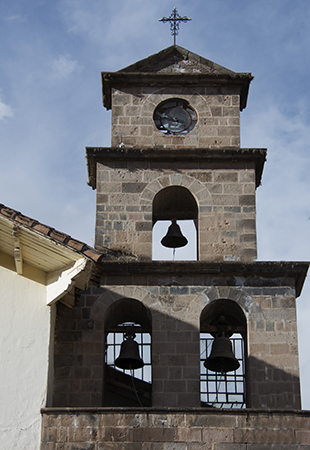

We were back at the train station in Aguas Calientes Town for our trip back to Ollantaytambo. The service was again spectacular, but this time the agents added a fashion-show. They modeled various alpaca clothing that you could buy. (It was quite strange and funny.)
From Ollantaytambo we got back onto the VBT bus for the ride back to Cusco. Between the train and the bus, we were sitting for almost 5 hours.
The trip into Cusco was very different than the trip from the airport. We came in from the north-west and at various points we saw the city laid out in the valley. Cusco has 600,000 residents and for the first time from various viewpoints we saw the whole city spread out through the valley and up the slopes.
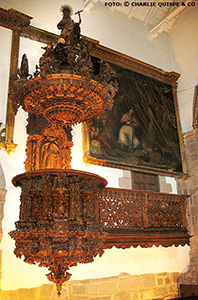 We got dropped off in the artisan section and we walked the narrow cobblestone streets of the old city to San Blas church. The attraction in the church was an elaborately carved pulpit. The Archdiocese in Lima has ruled that no photographs are allowed in any church. The image on the left is from online and from a time when you could take photographs inside a church. (The story the guide told us is that the Archdiocese is afraid thieves will come and steal the valuable artifacts if they are photographed and put where anybody and everybody can see the treasured housed in the Peruvian churches.)
We got dropped off in the artisan section and we walked the narrow cobblestone streets of the old city to San Blas church. The attraction in the church was an elaborately carved pulpit. The Archdiocese in Lima has ruled that no photographs are allowed in any church. The image on the left is from online and from a time when you could take photographs inside a church. (The story the guide told us is that the Archdiocese is afraid thieves will come and steal the valuable artifacts if they are photographed and put where anybody and everybody can see the treasured housed in the Peruvian churches.)
San Blas was another over-the-top Spanish Baroque church. I haven’t liked any church I’ve seen. Everything is over-decorated, everything looks oppressive, extreme, gaudy, unrecognizable. Yes, the pulpit required a master carver. But Oh my God what happened to simple lines? What happened to form and function? It seems it’s all made to overwhelm to overpower.
A side note: According to tradition, while Blas/Blaise was being taken into custody, a distraught mother, whose only child was choking on a fishbone, threw herself at his feet and implored his intercession. Touched at her grief, he offered up his prayers, and the child was cured.
On the feast-day of St. Blaise – February 3, the priest holds two burning candles in a crossed position over your head or on either side of your throat and gives the following blessing: “May Almighty God at the intercession of St. Blaise, Bishop and Martyr, preserve you from infections of the throat and from all other afflictions”. This is supposed to keep you infection free for a year. (Note: You need to renew your blessing annually.)
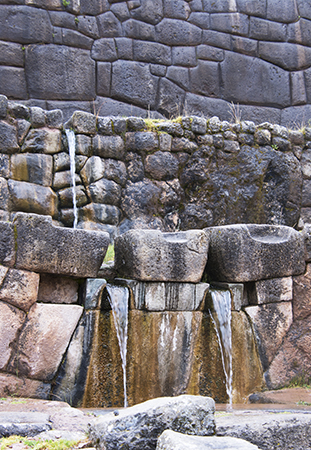

The only day we had rain was our last day in Cusco. That didn’t deter anyone from donning our rain gear and heading out.
We began the morning at the fortress of Sacsayhuaman on a hilltop above the city. What is incredible is to see are the various megaliths that make up the walls; some weigh between 90 and 130 tons and they are amazing in their precision – cuts and fits. The site also has a large ceremonial plaza that was still used for re-enactments on the winter solstice.
And the vistas of Cusco from this vantage point were great – terra-cotta tiles filling an Andean valley. In Cusco, you are never far from Catholic symbols. On this mountain top, on an eastern promontory was a tall white statue of Jesus and on a western outcrop a huge wooden cross. The tiled rooftops below us made you forget the religious intruders.
My favorite part of the walk were the fountains and aqueducts at Tambomachay. The image on the right captures three of the fountains. The stone work and the masonry on the top wall are as good as any laser cuts and modern construction. And lets not forget that it was all done with relatively rudimentary tools.
Tomorrow morning we leave for the airport at Cusco and from there to Lima. Because of the long layover in Lima, VBT has reserved hotel rooms for us. And this time the layover in Miami is only 6 hours – Oh joy!
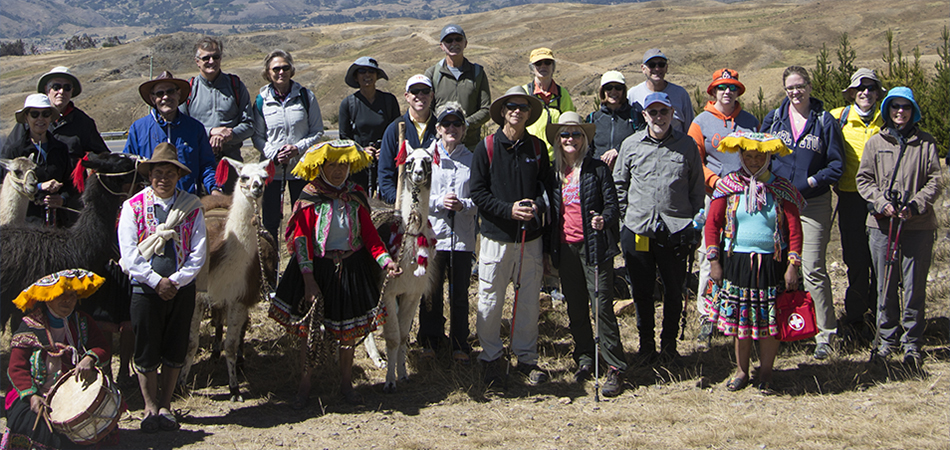



I always need some incentive, some starter to pay attention to the back-yard. And because this year’s spring-planting was interrupted by the trip to Peru and the re-acclamation once back, I didn’t get to the rock-garden until last weekend. The incentive came in the form of an urn. (i’ve been wanting to buy an amphora, that a potter in Highland Park makes, but never got around to it) I saw the urn at the greenhouse when I was looking for an organic-insecticide, (i’m now trafficking in oxymorons) because I’m determined to grow zucchini plants and not lose them to mildew and borers. (i don’t want to use monsanto poisons to achieve this goal, hence the organic-pesticide)
Hahn’s Nursery in the North Hills is my go-to place for organic sprays for the roses, vegetables and fruit-trees; it’s also my favorite place for wall ornaments and other decorative garden pieces. (i tend to buy at the end of the season and I buy items that are slightly damaged and therefore reduced) While walking through their non-plants area, I saw this large urn – in the middle in the pic – but when I looked at the $180 price-tag, I moved on. However, I did notice that it was missing two of its four handles, so I asked about it. The sales-woman, that always given me great advice on fungus and insect treatments, said that it was reduced to $75. I bought it. (a third handle was inside the urn and i glued it back on with super-glue)
Integrating the 3-feet tall urn into the flower area, required a redesign of the rocks and the pots that fill up the north-east corner of the back-yard. And I’ve been working on situating everything for the last 5 days. Today, I made the final re-arrangements.
Items in the pic – left to right – bay leaf, yellow daisies and vermillionaire or firecracker plant, the urn and an ornamental sweet-potato vine.

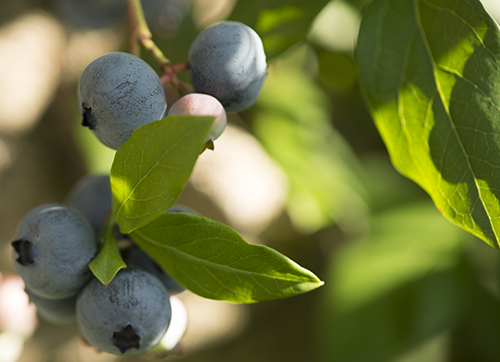
This year’s crop is plentiful and the berries are big, plumb and juicy. I love going out, first thing in the morning, and eating the sweet fruit.
Jack has been picking at the plants since they set flowers and now that the berries are ripe, he can’t stay away from the back planter. Bilby has also discovered the berries, but he’s nowhere as obsessive as the other one. And Bilby eats because he’s hungry and even then he’s fussy about finishing his bowl; Jack on the other hand would eat and eat and eat. The berries are a treat that both will run in, sit and wait for me to give them a berry each.
Last night and this morning, the light has been amazing. I did nothing to the image on the right except crop it.
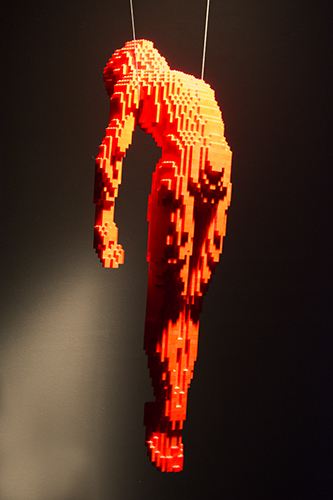

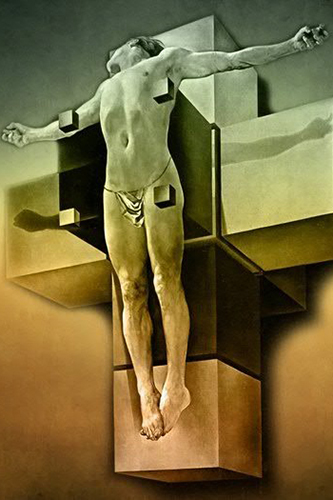
The Nathan Sawaya exhibit at the Carnegie Science Center is an unusual collection of pieces. I didn’t much like his rendering of famous sculptures, paintings or windows in Lego bricks. The Easter Island head worked best in plastic blocks; but The David, Caesar Augustus and Winged Victory were greatly reduced in size and looked amateurish rather than majestic. His original pieces, however, were very different and very interesting.
One of Sawaya’s original pieces – Hanging Man – reminded me of Dalí’s painting Corpus Hypercubus. Dalí’s geometry, his cubes, the lighting are all there in the way Hanging Man is rendered and exhibited.
BTW, the two images are the same width, height and resolution, and yet the image on the right looks wider. I think the outstretched arms fool the eye.
Also, the photographs Sawaya and Dean West collaborated on were great. The Lego sculptures – tree, towel, umbrella, dog, railroad tracks, dress – that were integrated into West’s photographs were part of the exhibit.
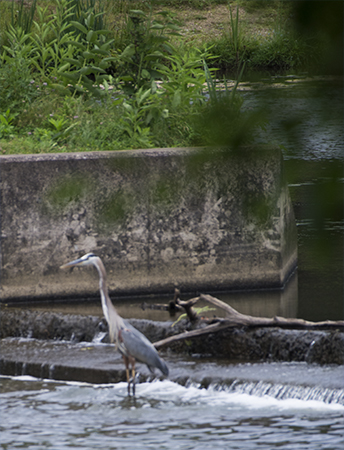

The last time I went walking in North Park was the end of April. And back then, spring was just edging into the hillsides and shores around the man-made lake. Two months later and the park has pulled its green canopy over the roads, the trails and steams; it has dressed itself in thorny briar, new cattails, red berries, pink roses and hanging vines. (i began hiking north park in mid november, so I never saw it green)
Two things surprised me last night; Pine Creek, along the southern bend of Lake Shore Drive, was totally obscured by trees and shrubs; and the evening skies were filled with acrobatic chimney swifts.
From the Allegheny Parks Foundation Webpage
Chimney swifts are beneficial birds to the environment because they are voracious eaters of bothersome flying insects including mosquitoes and flies.
Chimney swifts are migrant birds, returning to our region in April, when they begin looking for nesting sites.
They roost by hanging vertically on the interior of hollowed trees and chimneys, but these options have been lost as dead trees are removed for suburban development and chimneys are capped for more efficient heating.
To counter this loss, the Parks Foundation in collaboration with the Audubon Society, Allegheny County Parks and The Pittsburgh Foundation constructed a number of towers that could serve as nesting sites for the returning birds. The 12-foot towers have a grooved wooden interior that allows the birds to hang and build their nests.
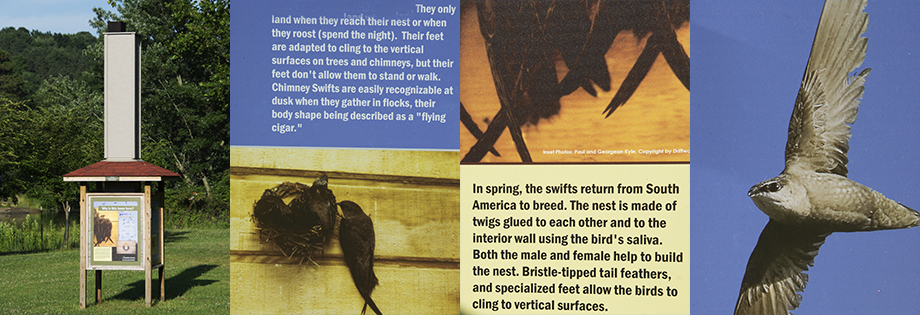
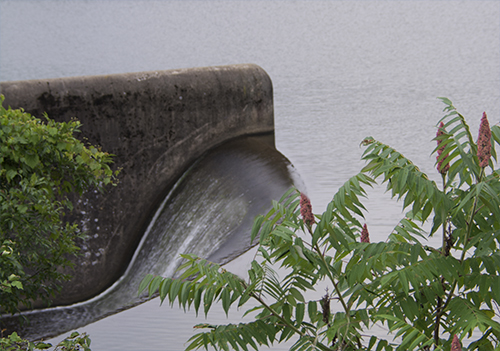
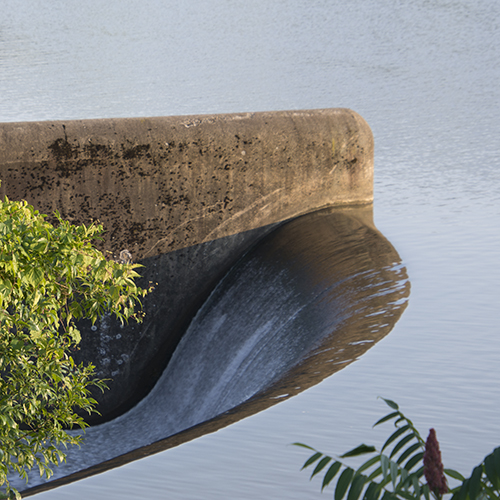
I certainly don’t consider myself a technically savvy photographer. (over the years, i’ve used more and more of the bells-and-whistles available on my cameras, but these are always secondary to identifying an interesting item to shoot) My skill has always been in the area of seeing a unique piece of the whole.
One of the people on the Machu Picchu trip said that he always looked to see where I was pointing my camera, because he would see something that he had missed or not considered. I understood his comment to mean that I focused and shot objects and landscapes that most others didn’t see.
Also, I’ve also gotten better at using Photoshop to make the unique perspective more evident. This usually involves removing excess people, distracting foliage, overhead wires, glaring signs. And most often taking a slice of the image and making that detail the photograph. I use the crop and stamping tools all the time. And yes, once I alter the photograph it’s no longer a visual record; it’s no longer a representation of reality, a snapshot of a particular time and place; it’s a new narrative. (i like to think that i don’t alter the original to the point where it’s no longer a photograph, but a photoshop piece that started as a photograph)
The image with this post is a good example of what I’m writing about. I saw the curve of the spillway as I come around the corner and onto Babcock Boulevard. It’s a perspective that you usually don’t see because it’s hidden behind the shrubs that crowd the hillsides and, most people wait until they get past the intersection to shoot the spillway into Pine Creek head on. What caught my eye was the gentle curve of the south rim. It was elegant in its simplicity. To emphasize the bend, I zoomed in on the original image and cropped out what you see in the above photo; I also stamped out leaves and two of the plumes on the Sumac on the bottom right; this excess foliage interfered with the sweep of the curve.
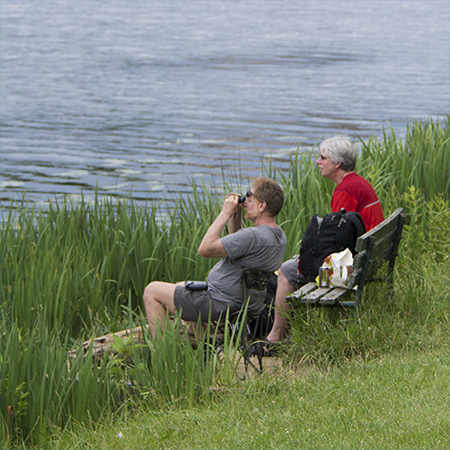
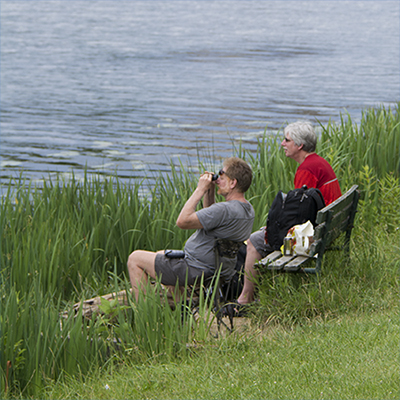
Lately, I’ve been thinking a lot about my generation; its unwillingness to accept the fact that we’re old; its belief that to wind-down or slow-down is tantamount to surrender; its refusal to stand aside and let the next group come to bat.
And why should we? There’s a 72-year old in the White House who insists that he’s full of vigor; many of my contemporaries, who find themselves alone, are rushing into new romances; and even as we scoff and deride the modern world, we are bathing in its comforts and perks. (i expected something different from a generation of daydream believers and homecoming queens, really)
So, what brought on this introspection? The new car has Pandora and I’ve been listening to old songs from the 60s and 70s. OMG, some of them are embarrassingly trite and stupid.
The image is from the many I took when walking around North Park Lake. I saw the two guys and immediately thought of using the photograph for a post about friends on a park-bench. (the image is a detail of the larger wide-angle shot – i pretended to focus on the boat-house and the lake in order to not alert or disturb the guys) The subject is unusual, in that most people in the park are walking, jogging or fishing; they are the first two people I saw just sitting, enjoying the evening calm. And they seem the right age and the right shape to fit into my musings; also their idleness gives me hope that my generation may not be as far gone as i feared.
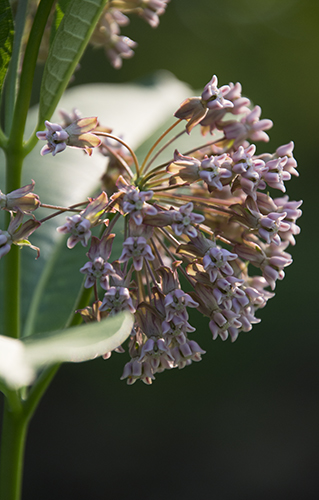

Yesterday after dinner, I decided to head to North Park to get a walk in. (managed 3.4 miles before the dark descended) The setting sun provided a soft light, bathing the low-lying plant in a delicate palette. With the light sliding through the canopy, I got some amazing shots. The image on the right is as it came out of the camera; I just cropped it to showcase the blossom. The twilight dying the stamens gold just takes my breath away.
I’m getting rid of the fanny-pack. The same problems that I found while in Peru became obvious again. It’s a pain to keep twisting it around to get anything; it holds nothing but my wallet and phone; and because there’s no room, I have to carry everything. Last night, for the last mile, I had my hat and headphones in one hand, the water bottle in the other and my camera over my shoulder. Bad set up. When I finally abandoned the fanny-pack in Aguas Calientes and started using the Inkaterra mini-backpack, carrying things while walking became easier; the camera even fits in the mini-pack.
Also, during the walk, the Beatles’ Can’t Buy Me Love came on and I just wanted to dance. But, it probably would have gotten me picked up; “Officer, there’s an old man thrashing and twisting. I think he’s having a seizure. You should probably send an ambulance.” After cancelling the urge to dance, I thought it would be funny to call Ron and tell him about my need to twist and shout, but even the call got cancelled. Ron is always surprised to hear me say that I’m out walking; it seems that for him walking needs another person. But give me my headphones and my camera and I can walk and walk; and I can even dance in my mind while walking.
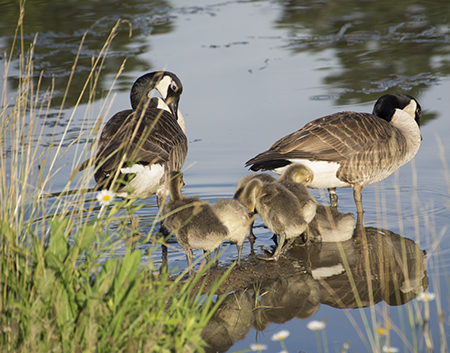

After reviewing the shots, on the memory-card, I was amazed by the light in some of the images. The geese and goslings were in the direct path of the diffused evening light. (the sun is setting on the right hand side) I made no alterations to the image. What you see is what the camera captured.
What do I like best about the image?
For years, I’ve been shooting in afternoon light. I like its harshness; its extreme; its contrast. What’s been missing though is softness, but that was the trade-off. Also, afternoons were the time when I was out. I only started walking in the evening, because it’s been miserably hot during the day. I also kept thinking that evening light would be nothing more than a reduction, shrinking the majority through shadows. Instead, I began to see that objects, low to the ground, got bathed in delicate light; that branches grabbed the fading rays; that berries and fruit gleamed in the indirect glow. It never occurred to me that evening light could bring a new dimension a beautiful clarity to the objects I was shooting.
Earlier in the week, while reviewing my cable and Internet options, I upgraded to 5G. And the technicians are coming Tuesday to make the necessary adjustments. However, since the conversation with the agent, I’ve been noticing a degradation of my connectivity – movies and music weren’t streaming; and tonight, I just lost all access. Going in to reconnect, I noticed a new network, same name as the old except for the 5G add-on. I tried connecting using the old password and it accepted it. All of a sudden, I’m running on 5G and everything is streaming. Good-bye net-neutrality, hello higher costs.
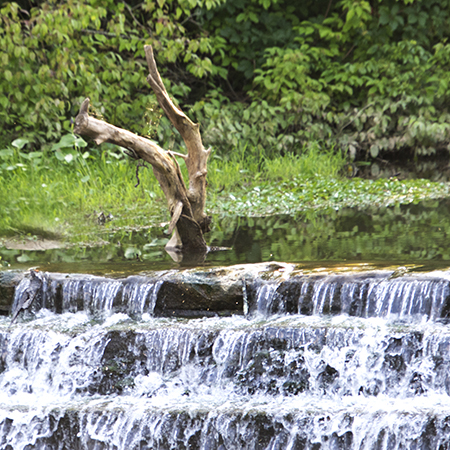

Another image showing the delicate light of the evening sun. Look at the upper pool; at the glass surface, at the gold shimmer in the water before it spills over the rock-wall. The gold flecks in between the driftwood branches are a spider web catching the fading light. And like the picture of the geese in the previous post, what you see is what came out of the camera. All I did was crop the image. And like the geese picture, the light is coming from the right.
The dam is at the cross-over from Lake Shore Drive to the paddle and tennis courts, the zip line and the boathouse. And the dam is on the north fork of Pine Creek. I shot the driftwood from the small bridge that crosses the creek. The extra 100mm on the Tamron lens gave me enough of a close-up to both capture the image and render the driftwood surreal – a submerged prehistoric Megaloceros.
Also, it’s only when I’m reviewing the images that I get to see the amazing effects of the evening light; and at that point, in the post-production, it’s a total surprise.


A glimpse of the south fork of Pine Creek – the stream, that in North Park creates a huge lake, meanders almost 30 miles south to Sharpsburg where is enters the Allegheny River just below the 62nd Street Bridge. Months ago, the winding creek was the most obvious landmark in the winter landscape, but summer has hidden it and it’s only at rare openings that you can even spy it through the green.
And keeping with the driftwood-as-animal theme, the two pieces of wood, lying on the creek mud-bed, look like giant pond-skaters.
Also, at 4:00, it’s still harsh afternoon light – the sun was almost directly over the western leg of the walking path. The sun needs to sit much lower in order to get a delicate diffusion.
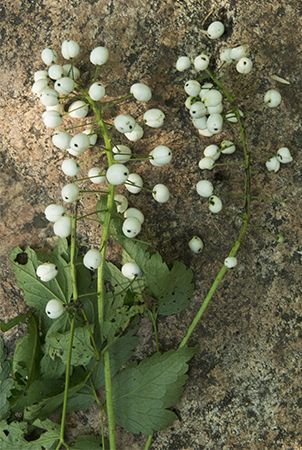

The St. Mary’s River, at the bend between Sault Ste Marie, Ontario and Sault Michigan, runs between 4 islands. On the Canadian side, St. Mary’s Island and Whitefish Island interrupt the river’s rush to Lake Huron.
St. Mary’s Island has the Sault Ste Marie Canal going through it.
Whitefish Island, on Goggle Maps, is listed as an Indian Reservation; it belongs to the Batchewana First Nation, an Ojibway tribe. Among themselves, Ojibway refer to their people as Anishinaabe, which mean Original People.
When French settles got to this part of Canada, the island had a permanent Anishinaabe settlement; it was also a fishing base for the tribes in the area, and therefore an important trade center. The earliest written accounts of the island date back to Jesuit reports from the 1600s describing the fishery at the rapids. (a side note – smoked, freshwater whitefish is sold in delicatessens and eaten as part of ashkenazi jewish cuisine)
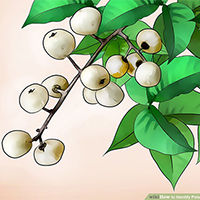 Because of its rich history, the Canadian Government designated Whitefish Island a national historic site. Today, the island is open to the public and wide dirt trails cross and perimeter the 22 acres between the rapids and the canal.
Because of its rich history, the Canadian Government designated Whitefish Island a national historic site. Today, the island is open to the public and wide dirt trails cross and perimeter the 22 acres between the rapids and the canal.
The artfully arranged stems of white berries were lying on a rock on the side of the trail; they look like poison-ivy berries. (the small drawing is from the webpage wikiHow) It’s hard to believe that someone would intentionally displayed a poisonous plant in a way that invited touching, picking it up, or bringing it home to put in a vase. But there’s no logic to what locals will do to fuck with them tourists.
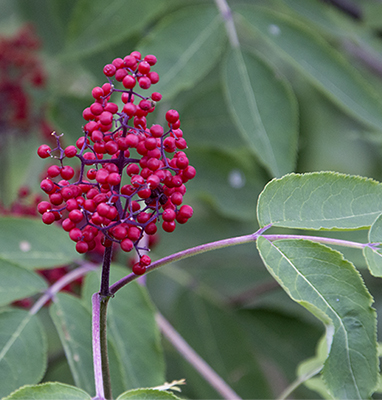

Tonight’s walk was through Fort Creek Park.
At the end of the walking path, a bee flew into my lower lip. (who ever heard of a bee just flying into a person) I quickly brushed it off, but not before it stung me. It didn’t get a full bite, and it didn’t leave behind a stinger, so my lip never swelled up, but it hurt. My cousin Rose had some salve and that helped to lessen the pain. Amazing, I’m walking and a bee runs into me.
I’ve never been on the Creek trail in summer; the conservation area is totally filled in with wild greenery; it’s like walking through the woods, but you’re in the middle of town.
The red berries in the above pic and the shrub they grow on are everywhere; they were all over Whitefish Island; they were on the side of the road up at Red Rock where Connie has her cottage; and they were all through Fort Creek Park. It’s wild elderberry – Sambucus racemosa.
The Italian liqueur Sambuca is made from elderberries. How come it’s taken me all these years to discover that fancy Sambuca is made from the lowly elderberry; and that the red variety is ubiquitous in Northern Ontario where thousands of Italian immigrants live? Not one of these transplants has ever identified the berries or explained that his/her preferred espresso sweetener is made from this wild fruit.


This morning I harvested the fava in my parents’ garden.
Here in Northern Ontario, fava is ready between the middle and the end of July. (in calabria, it’s planted in the fall, where it overwinters and then is ready for harvesting in late spring) Earlier in the week, a local Calabrese farmer who grows fields of fava brought his crop to market and my parents and my uncle-and-aunt bought a bushel each. We shelled the beans and then my mother blanched them, put them in bags and froze them for later use.
My aunt and my parents still use the term – horse-beans – for the legume. I tried to explain that in the mouths of the English it was a pejorative and that it’s purpose was to insult and demean the immigrants by suggesting that their prized fava was nothing more than food fit for horses.
The left image is the fave on the plant; the middle image is the plants in a pile after I’ve pulled the fave off and then pulled the plants out; the right image is the harvested fave in a bushel.


The shot is from the Canadian side; Frank and I are walking the downtown, river-front boardwalk. It’s the St. Mary’s River and the powerhouse of the Cloverland Electrical Cooperative on the American side. The massive structure has been a famous landmark when looking across the river and I finally found its history.
In 1885, with the state approval to divert water from the St. Marys River, the village of Sault Ste Marie voted to construct a canal and hydroelectric milling center. The St. Marys Falls Water Power Company was to dig the canal and construct the waterworks system.
The design agreed upon consisted of a canal 200 feet wide and 23 feet deep and running in length two and one half miles from the intake to the powerhouse at its end. In the canal, water traveled from six to seven feet per second. The bend would slow the water down in preparation for its entrance into the powerhouse.
In April of 1899 a Romanesque design was selected for the powerhouse. The design was both economical and would give the impression of power, importance, and stability to the building. The new design called for three large pavilions, one at either end of the structure and one in the center, thus breaking up the structure’s extraordinary length. The roof would be double pitched, also helping to counter balance the length of the powerhouse. 1
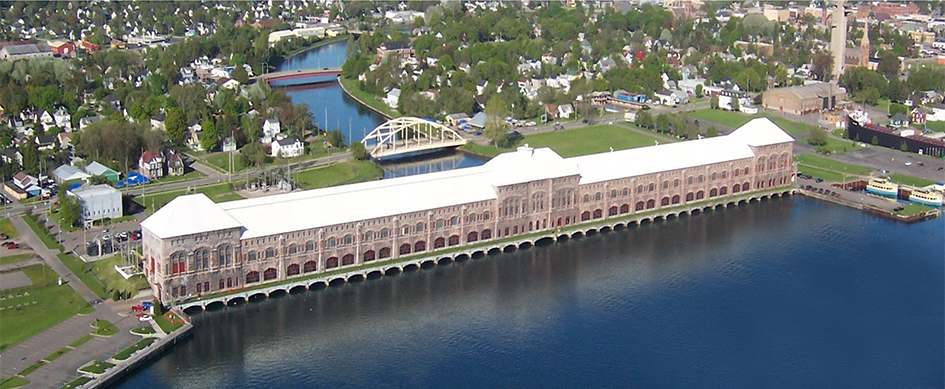
The image is from the Cloverland Electric Cooperative webpage. 1 the history of the powerhouse
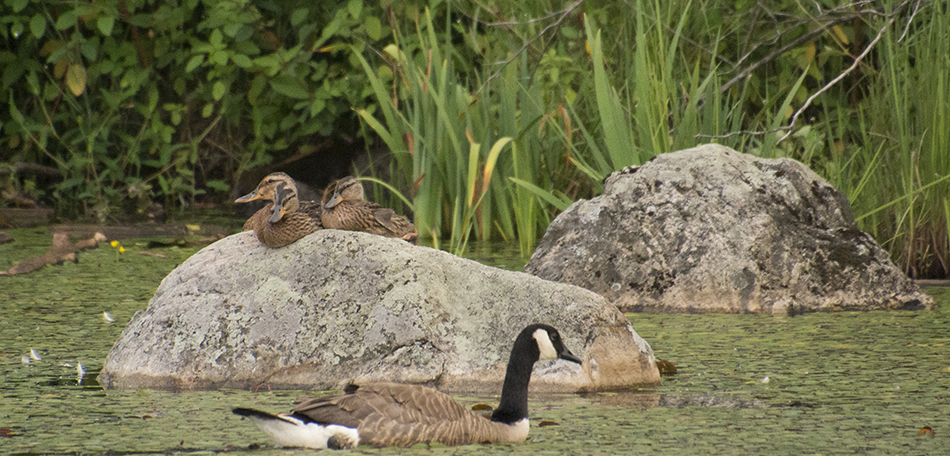

Frank and I walked the northern trail of Whitefish Island. We saw three beaver lodges, as well as all the other aquatics that live around the pond. There’s a large number of Canada geese and various ducks that make the beaver pond their home. And given that we were walking in early evening, many of the ducks were finding their way to sleeping areas. (i assumed ducks slept on the shore, but these three were snuggling on the large rock)
There are three beaver dams lower in the channel, but I wasn’t sure about the beavers, because there are very few large trees on the island and I thought that a pond covered in lily-pads could suggest no beaver. Not true.
Water lilies are one of their favorite foods, and through both consumption of the water lilies and construction of wetland habitats, beavers help support water lily populations. This is how John Eastman puts it in The Book of Swamp and Bog: “Beavers relish [water lilies], sometimes storing the rhizomes. Their damming activities create water lily habitat, and they widely disperse the plants by dropping rhizome fragments hither and yon.” 1
The lodges have weeds growing on them which suggests that they’ve been here for a while. In a large pond, one beaver family can maintain several lodges; the group here has three.
There were two surprises – the chipmunks on the trails seemed to have no fear of people, as a matter of fact they kept approaching us and approaching us. Because many walkers feed them, they were expecting us to do the same. And people also feed the ducks and geese, so when they saw us walk by, they made a beeline to the shore. Of the two wild animals expecting food, the chipmunks were the most startling.


It’s good to be back home and to walk familiar paths. The perimeter of North Park Lake is filled; the shallow waters are covered with lily-pads and the shores are littered with wild hibiscus swaying in the evening breeze. (the spider web, between the two large flowers, is delicately surreal)
Left Northern Ontario on Tuesday afternoon and drove I-75 South to Oxford; David Sedaris’ new book Calypso kept me laughing all the way down. (the portion after saginaw is tedious, but david sedaris’ voice made me forget the drudgery, the long stretches, that michigan voted for that crazy man in white house) Visited with Rose-and-Derrick, Mary-and-Domenic and left to come home Thursday morning.
1 Simon & Garfunkel – America
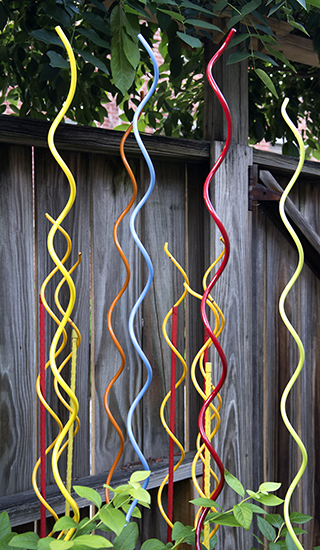

I bought the shorter spirals last year because I liked the yellow finish and they would add color to the backyard. They were not very good stakes for tomatoes, even when I added verticals to keep the spirals from falling over.
This year, I stuck them in among the blueberry bushes. I later saw the red verticals at Home Depot and added them. The configuration was looking interesting and so I went looking for more spirals. The newest ones are taller and in a variety of colors. Together with the shorter, yellow ones, I now have a composition of spirals.
I found the title online and just modified it a bit. (quotes about spirals aren’t all the plentiful) What I like about the title is all the R sounds.
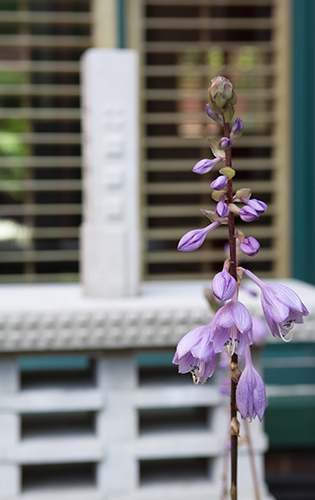

tragically hip
Sundown in the Paris of the prairies wheat kings have all their treasures buried
And all you hear are the rusty breezes pushing
Around the weather vane Jesus
gordon lightfoot
The way I feel is like a robin
Whose babes have flown to come no more
A tall oak tree alone and cryin’
When the birds have flown and the nest is bare
joni mitchell
We are stardust, we are golden
We are billion year old carbon
And we got to get ourselves back to the garden
loreena mckennitt
Take me with you on this journey
Where the boundaries of time are now tossed
In cathedrals of the forest
In the words of the tongues now lost>/p>
leonard cohen
I lit a thin green candle to make you jealous of me,
But the room just filled up with mosquitoes, they heard that my body was free
Then I took the dust of a long sleepless night and I put it in your little shoe
And then I confess that I tortured the dress that you wore for the world to look through
julie doiron
Let’s get out of the romance
The house that I walk home to is in flames in this wind
The wind is getting stronger
The emptiness shows
The breath that moves the branches saying words that I don’t know
k.d. lang
I was lying in a burned out basement
With the full moon in my eyes.
I was hoping for replacement
When the sun burst thru the sky.


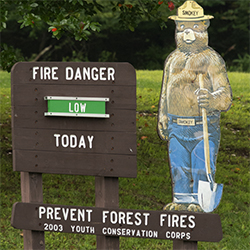 Southern Ontario, the region above Lake Erie and Lake Ontario, is dry, the grass is brown; and fire warnings are everywhere. Western Pennsylvania is wet, the fields and streams are swelled with rain. Pine Creek runs fast with rainwater and North Park Lake is filled to the brim. (because of all the rain, the wisteria is still putting out shoots)
Southern Ontario, the region above Lake Erie and Lake Ontario, is dry, the grass is brown; and fire warnings are everywhere. Western Pennsylvania is wet, the fields and streams are swelled with rain. Pine Creek runs fast with rainwater and North Park Lake is filled to the brim. (because of all the rain, the wisteria is still putting out shoots)
The sign on the right, at the southern entrance to North Park, is out of another time and another place. I remember when Smokey Bear was the spokesperson for forest fire prevention.
The five-mile route around the Lake is getting easier; somehow, it’s been internalized and I just walk it without thinking; without getting bored and counting shelter-signs. (the Erie shelter-sign let’s me know I’m nearing the end when walking the Ingomar Road/eastern side first; the Kilbuck sign lets me know I’m near the end when walking the Lake Shore Drive/western side first)
1 Norman Maclean, A River Runs Through It and Other Stories
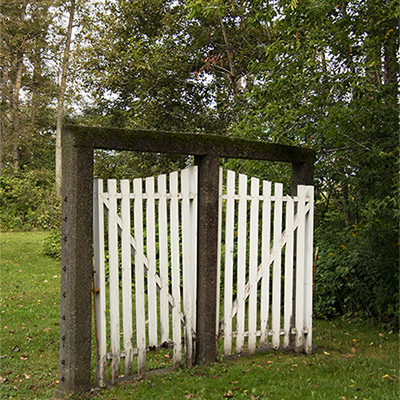

Behind the Superintendent’s residence at the Sault Locks is the original garden and on the canal side of the garden are the gates in the picture on the right. (the residence was built in 1896)
Cement was a wonder material and the idea of building the frame for the gates out of this wonder material showed both ingenuity and wealth. Looking at these garden gates today, it’s an odd juxtaposition.
The Superintendent’s House 2
The Superintendent’s House is set among a group of buildings located on St. Mary’s Island, which is bisected by the Sault Ste. Marie Canal. The two-and-a-half-storey stone building has a gable roof with a decorative bargeboard – an ornamental board fixed to the gable end of a roof to hide the ends of the roof timbers – regularly placed windows and doors with stone surrounds. An open porch protects the main entrance.
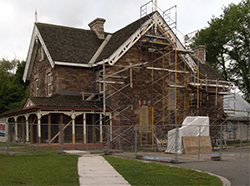 The House is a late example of a building inspired by the Gothic Revival style. The massing, design and good functional interior arrangement of the Superintendent’s House reflects the important social position of the Superintendent in Sault Ste. Marie society.
The House is a late example of a building inspired by the Gothic Revival style. The massing, design and good functional interior arrangement of the Superintendent’s House reflects the important social position of the Superintendent in Sault Ste. Marie society.
The House is a good example of a building associated with the construction and operation of the Sault Ste. Marie Canal, commencing in 1889, and illustrates the theme of the development of the Canada’s transportation network during the later 19th century. The first ship passed through the locks at the Sault in September 1895, and most of the canal buildings were completed by 1896. The complex of buildings illustrates the crucial years when Sault Ste. Marie was transformed from a small community into a modern industrial center.
The title is from one of my favorite operas – Philip Glass’ Akhnaten – and when I saw the garden gates, I knew I had an image that could fit the refrain – Open are the double doors of the horizon, Unlocked are its bolts. – the scribe sings in Act I.
The image also marks my d800e going on the blink. The shutter-release button is not operating correctly. It’s acting on a delay.
1 Philip Glass – Akhnaten, Act I
2 Canada’s Historic Places – The Superintendent’s House
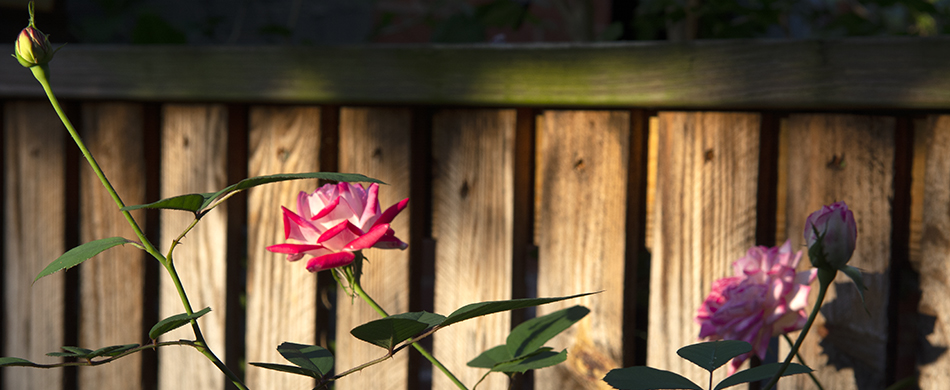

maker of all to you we pray
that with thy wonted favor thou
wouldst be our guard and keeper now
from evil dreams defend out eyes
from nightly fears and fantasies
tread underfoot our ghostly foe
that no pollution we may know
maker of all to you we pray
that in your ever watchful love
you’ll guide and keep us from above
help and defend us through the night
danger and terror put to flight
never let evil have its way
preserve us for another day
1 Opening Hymn, Compline (Liturgy of the Hours – Official Public Prayer Life of the Church)
2 Modern, Catholic Version


Last evening, Seane, Connie and I went walking and there was yellow yarrow along the side of the path. (it’s one of those flowers I can rarely pass up)
The cooler weather has been great. Going from miserably hot-and-humid to temperatures in the low 60s is OK. In Pittsburgh, schools were letting out 2 hours early, because of the heat and humidity.
Indian Summer is no longer a respite from the onset of fall; its extremes hearken to the dog-days of August not the last blush of summer.


Connie’s friends – Carl and Terri-Lyn – invited us to go on a boat-ride down the St. Mary’s River. We began at the marina in downtown Sault Ste Marie and followed the river some 30 miles south and east to Lake George/Echo Bay.
What always amazes me about this area of Northern Ontario is the vast scale of the wilderness. Lake George is part of greater Lake Huron. And in the middle of Lake George and looking south you can totally forget you’re in the middle of the continent. There’s water all the way to the horizon. (the lake has an official name mainly because it’s such a large body of water and the surrounding islands, that cluster in this northern section of Lake Huron, almost create a seamless shoreline)
Carl anchored the boat in 3 feet of water and the three of them – Connie, Carl and Terri-Lyn – all jumped in; not me. The three of them marveled at the fact that it was mid-September and that they were still able to still jump into the water. (normally, by this time of year the temperatures and the water is too cold)
In the pic, Connie has just come out of the water. The camp-grounds behind us are on the Garden River reserve; in front of us is the vastness of Lake George.
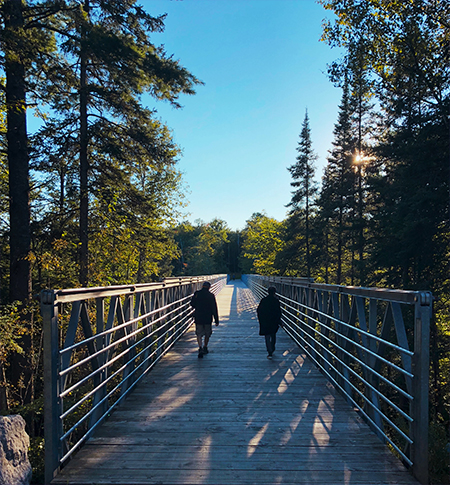
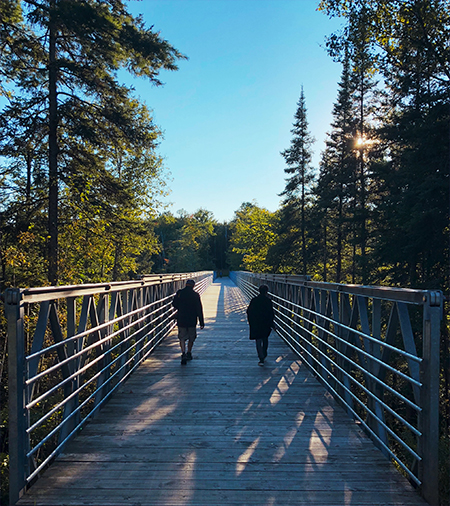
1 Robert Frost — The Road Not Taken
(Saturday, September 8 – Fort Creek Park – Picture by Seane)


1 The Dies irae – verse 16
Confutatis maledictis
Flammis acribus addictis
Voca me cum benedictis
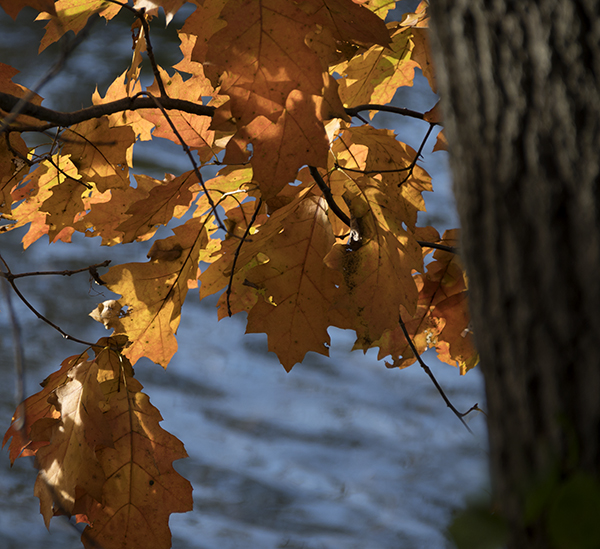
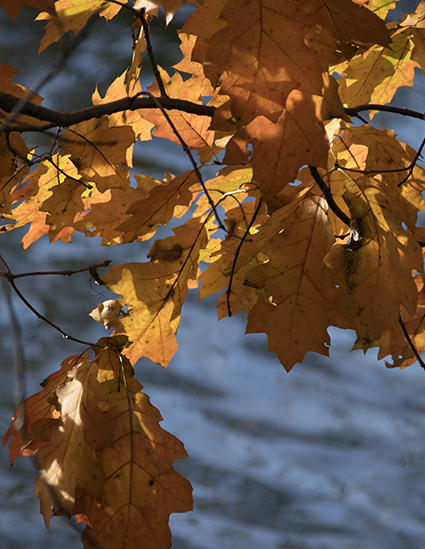
Helena McCaig
Sunday, January 21
Aged 75
(My cousin Rose’s mother-in-law)
Derryll McCaig
Friday, May 11
Aged 56
(My cousin Rose’s brother-in-law)
Hin Tan
Saturday, August 11
Aged 64
(My friend Carlo’s partner)
Ciccio Zinga
Thursday, September 6
Aged 92
(My father)
Eternal rest grant unto them O Lord and let perpetual light shine upon them.


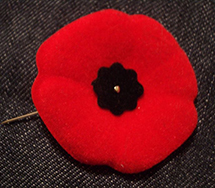
Here in Toronto, most people are walking around with a poppy pinned to their clothing. The red poppy, a native plant along much of the Western Front – a meandering line of trenches, stretching from the North Sea to the Swiss border with France – has been used since 1921 to commemorate military personnel who have died in the First World War. It was inspired by the poem In Flanders Fields.
The poem, written by Canadian physician Lieutenant-Colonel John McCrae, and the poppy are prominent Remembrance Day symbols in Canada, where In Flanders Fields is one of the best-known literary works. But the wearing of a symbolic poppy to commemorate The Great War is a British tradition that has been adopted by Canada, Australia and New Zealand – countries that were once part of the British Empire.
In Flanders fields the poppies blow
Between the crosses, row on row
. . .
We are the Dead. Short days ago
We lived, felt dawn, saw sunset glow,
Loved and were loved, and now we lie,
In Flanders fields. 1
1 McCrae, John. “In Flanders Fields.”
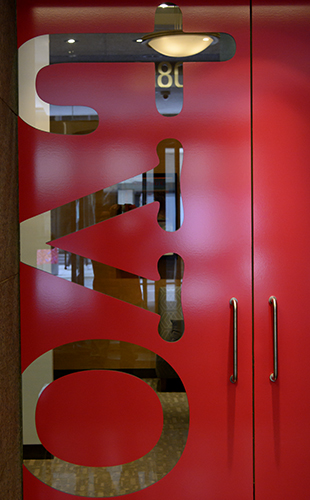

I’ve been going with Frank to the offices of TV-Ontario – Independent Learning Center for years. He goes to pick up the exams of the students he tutors online. One of my favorite things in the lobby are the doors leading to the TV-Ontario offices. This is one of the many examples of modern design throughout Canada.
A couple years ago, I began researching a road-trip from Toronto to Halifax and each time I looked at online pics of cities like Oshawa, Montreal, Trois-Rivières, Moncton, I kept seeing modern housing, modern office buildings that looked like all the other housing and buildings throughout Ontario, Quebec and New Brunswick. (my sister reminds me that most of modern Canada was built in the 1970s and the 1980s)
Within this milieu is another characteristic of modern Canada an aversion to anything old. The last 50 years have see a rush away from the old downtowns, the abandoning of old housing; wholesale permission to rip down old buildings. The disdain of the old was balanced with an euphoria for new housing, new subdivisions. The immigrants that made Canada their home after the Second World War, wanted nothing to do with anything that looked old, that looked old-worldish. They wanted new bungalows, new appliances, new cars, new colors, new designs. They wanted the promise of the new.
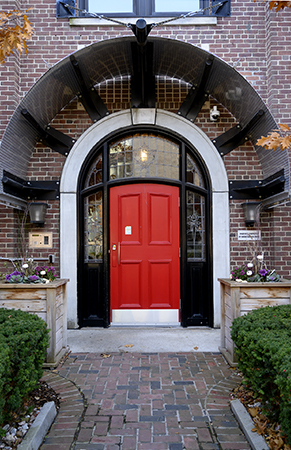

After years, I crossed the tracks and found a whole new world.

The west-side of the tracks, where Frank lives, is the edge of the High Park North residential area; the other side is the Junction Triangle neighborhood. And on this east-side, developers have installed a green-way along the tracks, renovated an old warehouse (the red door is the entrance to the renovated warehouse) and razed old houses to create a new neighborhood of fancy condos and Millennial worthy apartments.
I’m amazed that it’s taken me all this time to cross the tracks and explore the area across the street from Frank’s condo. (the small image on the left is the bridge over the railroad tracks)


The inland lake that the Huron people called Beautiful Water, was renamed by the first Lieutenant-Governor of Upper Canada – modern Southern Ontario – in memory of his father, Captain John Simcoe of the Royal Navy. (To the conquerors go the spoils.)
We drove up to Georgina, an administrative-township along the south shore of Lake Simcoe; the township is a collection of 5 smaller communities – Keswick, Sutton, Jackson’s Point, Pefferlaw, and Udora. We drove through Sutton along Hedge Road – a beautiful residential road that follows the shore of the lake.
The township, 40 miles north of the city, was covered in snow; it’s a micro climate, a snow-belt, in the Greater Toronto Area. I haven’t been in this part of the country, at this time of year, in a long time and it’s a surprise to see snow in early November. (I keep forgetting that Sault Ste Marie had snow in early October.)
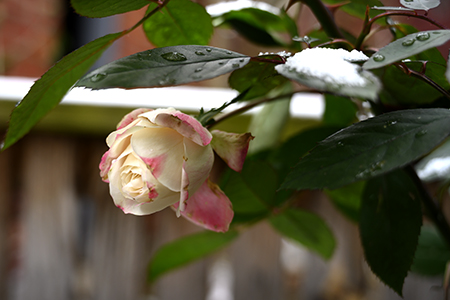
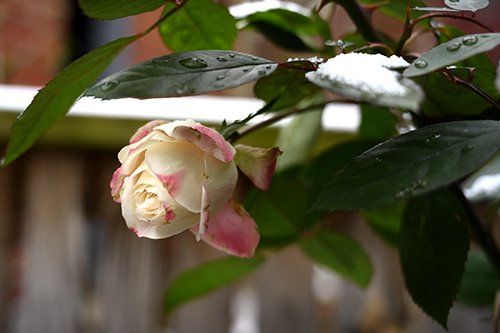
My complaint is less about the snow and more about the facts that I haven’t seen the sun in two-and-a-half weeks and that it’s been raining non-stop. (The last time I was able to go walking was back in early November.)
I’m slowly learning how to use the new camera with its 47.5 MP resolution; the image on the right was taken with the new camera and its unique 24-70mm Z-mount lens.
This is also the time to bring in all the summer stuff – chairs, tables, pots – and the weather has really hampered the process – I keep bringing things in that are wet or snow-covered.
The last winter-prep I need to do is wrap the fig tree. This year, I’ve decided to use roofing tar-paper and see if it keeps the branches from freezing. Roof-paper and duck-tape – what can go wrong?
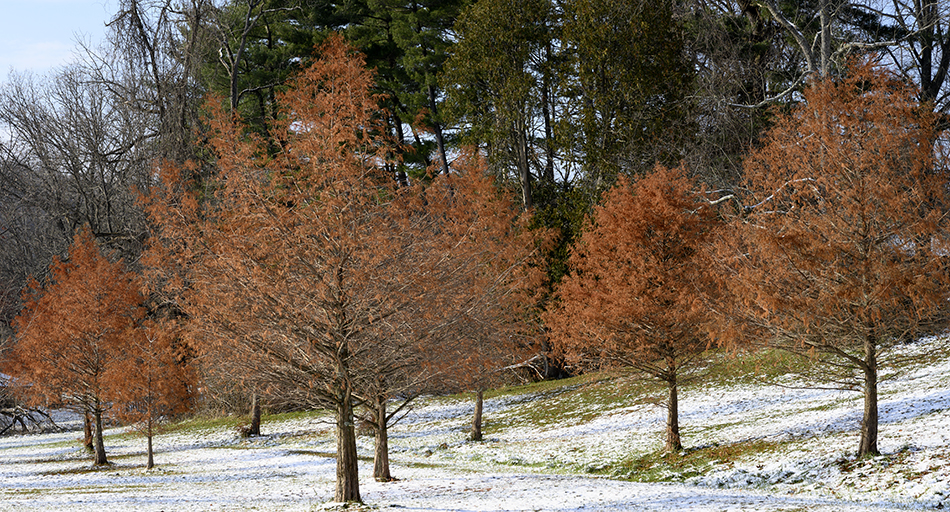

This image made it to the blog because of the title. It’s not often you get to put the present participle of orange and the compound evergreen next to each other.
To quote from Sondheim’s Into the Woods, “Opportunity is not a lengthy visitor.” So when it comes a-knocking, you steep the Earl-Grey, bring out the Fine-Bone china and lift your pinky as you slowly sip.

Today, House Minority Leader Nancy Pelosi and Senate Minority Chuck Schumer met with the President and Vice President to discuss a proposed wall on the southern border and whether Trump would, in fact, shut down the government if he doesn’t get the cash he wants for it.

The conversation, which was televised, quickly turned heated and ultimately ended without a compromise, but with the President accepting and owning the possibility of a government shutdown. The Democrats took that as a win.
And as soon as images of Pelosi emerging from the West Wing started making the rounds, Twitter was abuzz at the sight of the Speaker-designate’s power look: the sunglasses, the smirk, the impossibly fabulous rust-colored coat.
Barry Jenkins 1 – And she knew exactly what she was doing wearing THIS coat on THIS day coming out of THAT room, placing THOSE shades on JUST so. This is diplomacy in motion, soft power wielded like a machete through the diligent, decisive act of dressing. They’ve never been JUST clothes.
The New York Times was one of the first to correctly identify the maker of the coat: Max Mara 2. This wasn’t fresh-off-the-runway, just-hit-stores Max Mara, though, Pelosi’s burnt-red style dates back to 2013.
Ian Griffiths, the creative director of Max Mara, issued a statement on the Pelosi sighting too: “You develop an emotional relationship with a coat like nothing else in your wardrobe. I can imagine why Ms. Pelosi chose to wear it for this important moment, and I’m honored.” 3
Barry Jenkins – What I love about this coat is what it says about the supposed impotence of fashion. From the asymmetrical front to the high collar, the strong yet unstrained shoulder and, of course, that COLOR — a deeply serene yet emphatic & ravishing color. This look kicks soooo much ass.
And it kicked HIS ass.
1 Barry Jenkins is an American film director, producer, and screenwriter based in Los Angeles. The quotes are from his Twitter account.
2 Max Mara is an Italian fashion business. It markets up-market ready-to-wear clothing. It was established in 1951 in Reggio Emilia by Achille Maramotti.
3 Nancy Pelosi’s Red Coat – by Ana Colón at Glamor Magazine (excerpts)


The image is by Luigi Tuoto and it was posted on the Facebook page of Fuscaldo e le Sua Terra, a hill-town in Calabria north of Paola on the Tyrrhenian coast.
The following post accompanied the picture.
Una bella vista del Convento di S.Francesco di Paola di Fuscaldo paese con la luna pronta al solstizio d’inverno (21 dicembre) che fa registrare la notte più lunga e il giorno più breve dell’anno – a beautiful vista of the Convent of St. Francis of Paola in the town of Fuscaldo with the moon ready for the Winter Solstice (December 21) which will mark the longest night and the shortest day of the year
Some interesting language differnces
● Fuscaldo paese – Fuscaldo town
This is to distinguish between Fuscaldo the hill-town and Marina di Fuscaldo the beach-town below on the Tyrrhenian coast.
● (21 dicembre) – December 21
In Italian, the numerical date is written first and then the month; also the month is not capitalized.
● che fa registrare – that will register
The verb register is used in American-English more as a legal term therefore, I translated the phrase using the verb mark.
I photoshopped Luigi Tuoto’s original image, because I wanted to focus on the structure at the top of the hill. And, I wanted to contrast the russet-browns of Calabria with the insipid white-christmas of America. The convent also reminds me of the Spanish mission in Kill Bill: Vol. 1 where The Bride is spectacularly gunned down and presumed dead. A false assumption similar to the lie of peace on earth and goodwill to men when the reality of this holy tide of Christmas-2018 is a world gone mad.
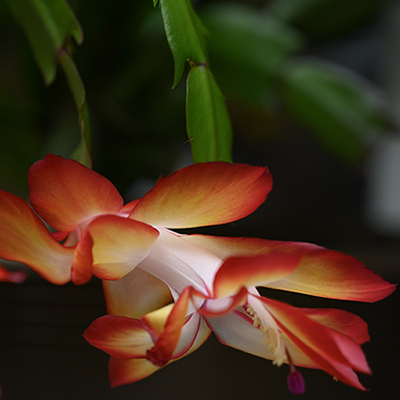

In the last 10 years, we’ve eaten at my aunt-and-uncle’s for Christmas Eve and then at my parents’ for Christmas Day. I’ve rarely brought my camera to Christmas Eve, but this year I wanted to capture some of the meal. Instead, I saw this beautiful orange cactus and decided to shoot it. The black background in the image – and great contrasting color – is the plastic pot the plant is in.
Derrick’s dad joined us for dinner; my uncle’s 97-year old aunt – Teresina – couldn’t make it this year and my dad was fondly remembered. Seane and Dave drove up and were there for the fish course (they still had the left-over pasta, even though both the white and red were cold – terribly non-Italian); by 10pm, the Melchiorres – Dom, Mary, Daniel and Alyssa – who spend Christmas Eve at Dominic’s mom’s, came by; so, we all got to visit – a day earlier than usual.
The Christmas Eve – vigilia di natale – Foods
pasta course
• white spaghetti with anchovies, red spaghetti with calamari sauce and a fish-stew topping,
fish course
• breaded fried shrimp, calamari, clams and muscles in a tomato sauce and cullurilli – potato donuts
• brussel-sprouts, broccoli salad
(I passed on the shrimp and ate the fish stew, using the cullurilli to soak up the delicious red sauce. Also, this was a reduced menu; in past years there would have been fried clams, perch, salt-water smelts and the old standby baccala – cod – prepared, in at least, 3 different ways.)
salad
• leaf-greens and cherry tomato salad in a red wine vinaigrette
after-dinner palate-cleansers
• anise, cantaloupe and melon
desserts
• genetti – soft anice cookies, scalille, turdilli, tangerines, oranges, apples, espresso, and various liqueurs
And we easy went through 5 to 7 bottles of red wine.
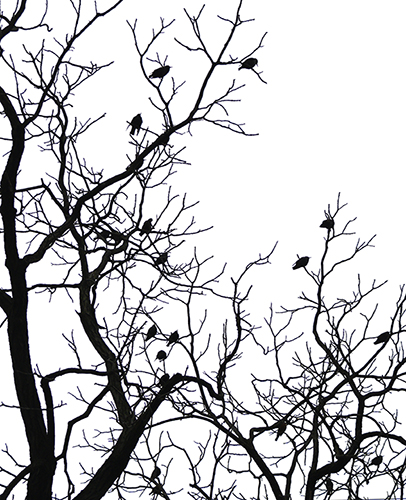

The image is of the trees – maclura pomifera – across the street. A more common name is Osage orange tree.
In 1804, Meriwether Lewis, of “Lewis and Clark Expedition” fame, sent cuttings of the plant back east. Supposedly, the descendants of those samples can still be found as far away as Philadelphia. As a result, although the trees are native to the southwestern United States, they have been used widely throughout the country, and have probably been in the region for nearly two centuries.
The tree bark can be used to make a yellow dye, and the Osage Indians — who introduced Lewis and Clark to the plant, and for whom the plant is named — valued the tree for its exceptionally strong, rot-resistant wood.
In the days before barbed wire, the trees were often planted in close-knit hedgerows — both to hem in the livestock and to mark property lines. It’s a “pretty tough tree,” says Masiuk, which has “potential for rugged, polluted areas.”
In fact, the Western Pennsylvania Conservancy’s guide The Trees of Pittsburgh notes that the trees were once used as hedges here. “The remains of such a planting can be seen on the south side of Dorchester Avenue in the Pittsburgh neighborhood of Brookline,” the guide notes. Located just off Penn Avenue near Frick Park, “Osage Lane in Point Breeze was once lined with these large trees,” though only a few small survivors remain. 1
This morning continued the dark-and-gloom that is early winter in Western Pennsylvania. As I was opening the shutters, I saw the birds in the trees and went out with my camera. All I did to the image was adjust the white level slider; this removed the gray and produced the white background.
1 Pittsburgh City Paper – They’ve been called “monkey balls” since my youth.
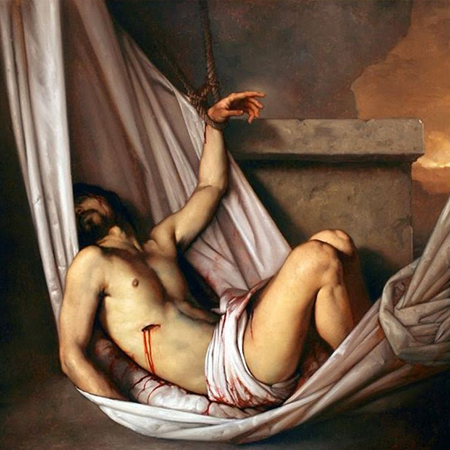
In the Coen Brothers’ movie The Ballad of Buster Scruggs, in the last short, The Mortal Remains, Brendan Gleeson sings the old Irish ballad The Unfortunate Lad. Listening to the directors talk about the film’s soundtrack, Joel Coen mentioned that the old Irish ballad was the basis for the American song Streets of Laredo whose melody serves as a unifying thread – a leitmotif – throughout the six short segments.
I really like Burl Ives’ cover of the ballad, re-titled Cowboy’s Lament, on his album A Twinkle in Your Eye. His honey-sweet tenor adds pathos to the story of a young man facing death. The lyrics, especially the couplet at the end of the first verse, brought to mind Roberto Ferri’s painting of the XIV Station of the Cross – the white shroud cradling the dead body. I saw the Ferri paintings of the Stations of the Cross – Via Crucis – at the Cathedral of San Nicolò in Noto, Sicily.
The Couplet
I spied a young cowboy all wrapped in white linen
Wrapped in white linen as cold as the clay
Yes, I can hear you asking; Who the hell pairs a cowboy ballad and a Caravaggesque painting . . . with a Jesus in it?
lament
As I walked out in the streets of Laredo
As I walked out in Laredo one day
I spied a young cowboy all wrapped in white linen
Wrapped in white linen as cold as the clay
 1
1
I see by your outfit that you are a cowboy
These words he did say as I boldly walked by
Come sit down beside me and hear my sad story
I’m shot in the breast and I know I must die
It was once in the saddle I used to go dashing
Once in the saddle I used to go gay
First down to Rosie’s and then to the card house
Got shot in the breast and I’m dying today
Get sixteen gamblers to carry my coffin
Get six jolly cowboys to sing me a song
Take me to the graveyard and lay the sod o’er me
For I’m a young cowboy and I know I’ve done wrong
Get six jolly cowboys to carry my coffin
Get six pretty maidens to sing me a song
Take me to the valley and lay the sod o’er me
For I’m a young cowboy, I know I’ve done wrong
Oh beat the drum slowly and play the fife lowly
Play the Dead March as they carry me along
Put bunches of roses all over my coffin
Put roses to deaden the clods as they fall
As I walked out in the streets of Laredo
As I walked out in Laredo one day
I spied a young cowboy all wrapped in white linen
Wrapped in white linen as cold as the clay 2
1 Roberto Ferri. “XIV Station of the Cross.” Cattedrale di Noto, Sicily, 2014.
2 Burl Ives. “Cowboy’s Lament.” A Twinkle in Your Eye, Sony Wonder, 1997.

Drag legend Jinkx Monsoon has summed up the controversy surrounding Covington High School boys perfectly. Monsoon’s Instagram post is a refreshing take on the situation because she breaks the issue down to the basics.
It’s possible that this whole thing was sensationalized by the media to whip us all up into arguments – encouraging us to click on each outlet’s story… It’s possible that it’s exactly how it looks – a group of teenage boys harassing one man with mockery and arrogance.
But there’s one constant in this sea of variables. The MAGA hat.
The phrase ‘Make America Great Again’ is synonymous with taking a step backwards in regards to progress, and there’s no way around that. To the minorities being oppressed, that red hat is frightening, and people need to understand that.
Americans have the right to wear whatever they want – but you can’t be surprised when people are on edge, when you sport a symbol of oppression.
After all, if you’re still wearing a MAGA hat after baby cages, admitted sexual assault, a Muslim ban, a trans military ban, a refugee ban, Charlottesville, Mexican rapists, Puerto Rico, Pocahontas, shithole countries, NFL protests, and support for white nationalism…
You can’t be surprised when people assume you’re a racist prick.
However, Monsoon needed to follow up the above comments with – Yesterday I posted a meme, referencing the stand off between a teenager wearing a MAGA hat, and an indigenous protester. I have taken it down, because my comment section was flooded with threats of violence toward the teenager, and threats to violence towards other followers … and that’s not something I want to promote. These are divisive times, and passions are running hot – but we do not prove our points by inciting violence.
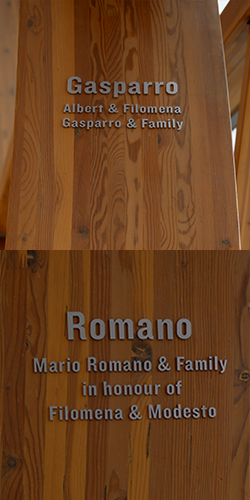

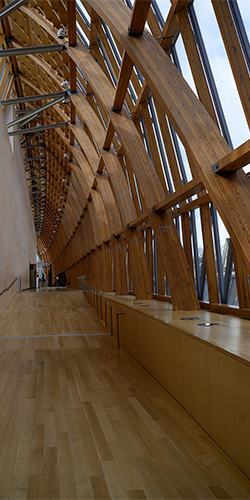
Today we went to the Art Gallery of Ontario; it’s one of my favorite Toronto museums. The building was re-imagined by Canadian-born architect Frank Gehry in 2008. On the second floor, on the northern face, Gehry designed a long gallery – Galleria Italia – which displays the names of rich, prominent Torontonians, of Italian heritage, who contributed to the redesign. The image on the left is the gallery; the image on the right is an example of the commemorative plaques on the spine-line ribs of the block-long gallery.
What was interesting about the plaques, was that the man’s name had been Anglicized – Albert, Benny, Jimmy – but the women’s names retained their Italian formats. Frank suggested that the men Anglicized their names, because they were interacting with the English majority. The women, who stayed home and socialized in their immigrant communities, didn’t need to change their names. (My dad became Frank, only his Italian friends called him Ciccio. My mother kept her Italian name – Mafalda.)


One of the benefits of visiting in Toronto is eating really good food.
At my cousins’ in Pickering, the food is simple, healthy and delicious. The wine is plentiful and the atmosphere is homey, congenial and full of laughter.
At Frank’s it’s Nouveau-Calabrese with a healthy absence of all things wheat, carbs and sugar. Breakfast is homemade granola, fruit chased by strong Lavazza espresso. And because it’s morning it’s a Cappuccino. Lunch is homemade soup, homemade olives a la Calabrese, (smashed and jarred in a salt brine until ready to eat), finocchio (fennel) and salad. The beverage for this repast is a red wine at room temperature. On Tuesday, dinner was eggplant parmigiano and on Wednesday the meat dish was baby-goat, his mother’s recipe. (He had to go out to Scarborough to a Middle-Eastern butcher to get the baby-goat and he had to buy half the goat. He has a goal for after his hip surgery, he’s determined to find a butcher who has milk-fed baby-goat. That is supposedly the best.) Frank is famous for his small side-dishes; every meal has at least 6 or 7 small-sides and every meal has a fresh salad.
Late afternoon-tea is espresso and a piece of chocolate. This time, Frank had homemade chocolate truffles. He used a bitter chocolate this round, but they were still an amazing compliment to the rich dark coffee.
But the above served as prelude to what happened Thursday.
Background: when I visit Toronto, I begin in Pickering – the first suburb east of the city – and work my way back west, so that by the end of the visit I’m in Mississauga – the first suburb west of the city – visiting my Cumpare Joe.
Four of us – Joe, Carlo, Frank and I – went to dinner and Joe called in a favor and asked his friend Mike, the owner of Vivo Pizza and Pasta in Etobicoke, to make us a special dinner. He asked if Mike had any rabbit available.
It blew my mind to realize that I was going out to dinner and we were going to have a dish that was not on the menu; a dish the owner was making specifically for us.
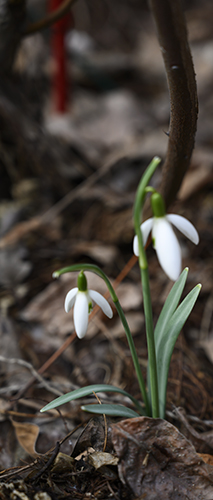

How do you decide which elements of an landscape to keep in focus and therefore critical to both composition and meaning and which elements to leave in the background and out of focus?
In the image, on the right, I liked the smaller flower, its spiky green leaves and the branch reaching out of the picture more than I liked the larger white flower or the red spike. To me, the larger flower will be front-and-center no matter where I focus; and the red spike will pull the eye from the greens and browns around it. I chose to concentrate on the smaller secondary flower and to keep it in sharp focus. (Cropping the whole right-side of the image further showcases the flowers, the branch and the red spike.)
Snowdrops multiply and cluster each year they are in the ground. (My last group of snowdrops had reached clump status – blooming in large batches – in the side flower-bed. When the side-bed was removed, I didn’t bother transplanting the clumps, because I assumed all I had to do was replant. Wrong. I had forgotten all the years where only one or two flowers came out.) This is the second year for the snowdrops and already the bulbs are producing more than single white flowers.
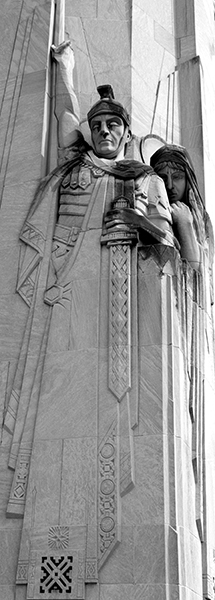

I’m on Woodward Avenue, in Royal Oak, Michigan, at the Basilica of the Little Flower. (Man, I could spout snark about Catholics, Art Deco and Detroit, but …)
Art Deco is one of my all time favorite visual-arts styles. (There’s a surprise – Zinga, clean geometric lines, symmetry, stylized bodies, handsome curves …) And, the Basilica built in the thirties, in the Art Deco style, is adorned with warrior angels, super-sized men and mournful women; in the picture on the left, the two figures are among some of the most striking.
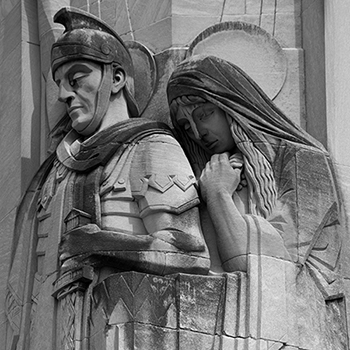 The bell-tower carvings depict the crucifixion; the Centurion and the Magdalene scale the right wall; John the Evangelist and Mary the Mother anchor the left face. (Earlier, I use the verb adorned, because the exterior walls of the church are yellow stone-block; only the bell-tower, the windows, the window frames and balustrades are decorative, carved limestone.)
The bell-tower carvings depict the crucifixion; the Centurion and the Magdalene scale the right wall; John the Evangelist and Mary the Mother anchor the left face. (Earlier, I use the verb adorned, because the exterior walls of the church are yellow stone-block; only the bell-tower, the windows, the window frames and balustrades are decorative, carved limestone.)
In the image on the left, I don’t know what I like best – the Roman’s extravagant drapery, the toggle-button holding the cape closed, his helmet, the sword, the lance the centurion holds up to the Christ. (Art Deco may be French in origin, but it’s definitely masculine and phallic in its lines and trajectories.)
In this south-east corner of Michigan there are many Art Deco structures among the soulless suburbs that surround the once-great Motor City. I noticed the massive tower a couple of years ago when I was driving down Woodward towards I-696. But, it was on Google Maps that I found out it was a Catholic basilica dedicated to a very non-Michigan, non-American woman – Thérèse de Lisieu.
From the Basilica’s webpage – The church was first built in 1926 in a largely Protestant area. Two weeks after it opened, the Ku Klux Klan burned a cross in front of the church. The original wood structure was destroyed by a fire March 17, 1936. Construction of the new building started in 1931 and ended in 1936.
A dramatic limestone Art Deco tower called the Charity Crucifixion Tower, completed in 1931, features integrated figural sculptures by Rene Paul Chambellan, including a large figure of Christ on the cross, 28 feet high on the Woodward Avenue façade. It was built as a response to the Ku Klux Klan as a “cross they could not burn”. … At the upper corners of the tower are symbols of the Four Evangelists. … On the front are carved depictions the Archangels Jophiel, Raphael, Michael, Gabriel and Uriel. The pulpit is flanked by depictions of John the Apostle and the Virgin Mary to the left and a Roman Centurion holding a spear and Mary Magdalene on the right.
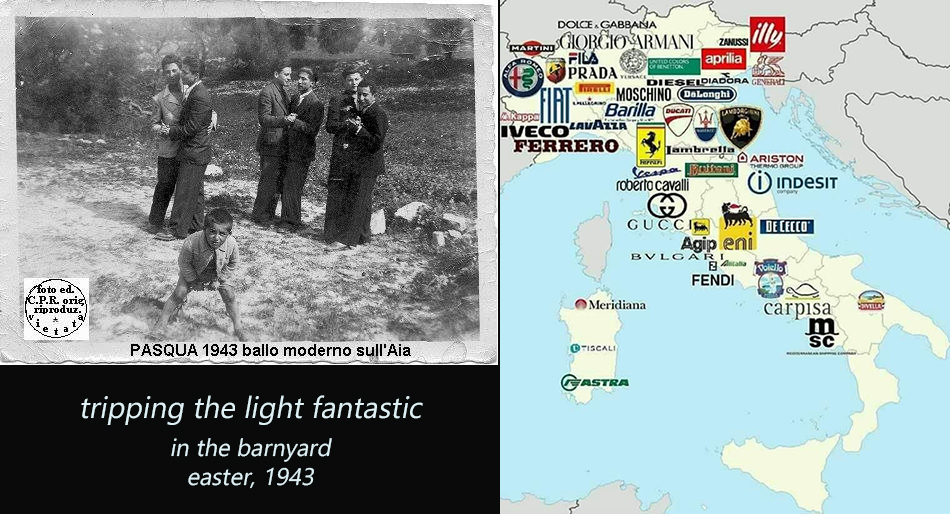
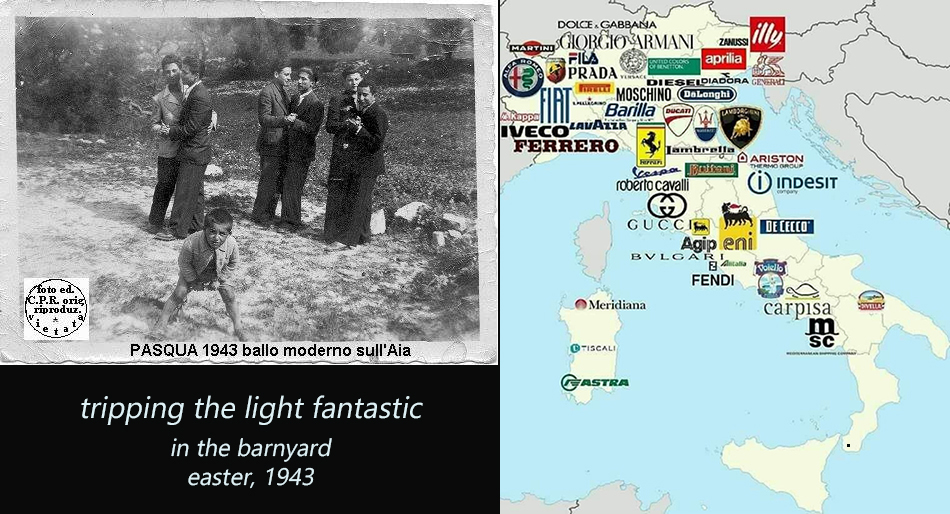
then & now
The photograph is from the Facebook page – Calabria ieri – and the caption reads – Ballerini Mottesi, tutti ci hanno lasciati – Dancers from Motta, they have all left us.
Motta San Giovanni is a small hill-town in the province of Reggio Calabria. The small black dot on the map is approximately where Motta is located.
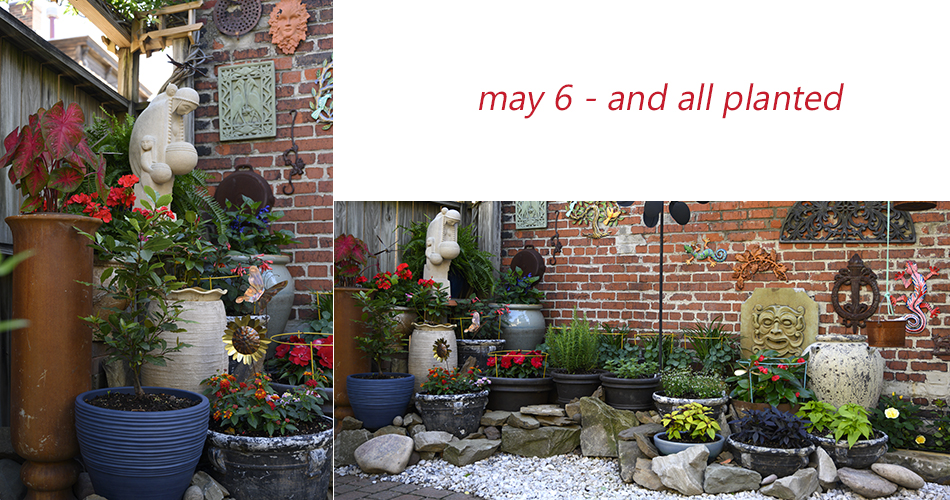

I started on this corner of the back-yard sometime in early March; I did the work in small increments whenever the weather allowed. My goal was to have all the prep done by Mother’s Day, the frost-free date for this part of the country. The main work was putting down stone-fill to anchor the various shelves, cinder-blocks, pavers and posts that held the pots. I also needed to eliminate the many tunnels and bolt-holes that the supports had created behind the stones and under the pots. In behind the flower-pots and rock-walls, the tunnels and bolt-holes had become home to a family of Northside rats. (And you can imagine how the dogs – also known as Ratters – reacted to the squatters in their back-yard.)
A secondary goal was to delegate all ceramics into this landscape. Ceramic pots look great, but man they are a bitch to move; and taking them in for the winter was becoming too much work. The large greenish-blue pot in the back corner has been coming in and out of the house for almost 10 years; I was done with that routine. (The large urn in the foreground has always been decorative and therefore empty.)
This year, I added the small flowerbed in the right-hand corner of the landscape image. I want to grow rosebushes that I can trellis in front of my neighbor’s garage wall. When we first moved into the house back in January of ’83, there was a spectacular rose with wine-red flowers. It lasted all of one year; the next winter killed it. And since then, I’ve been trying to grow roses with minimal success. Am hoping that the rosebushes will work out.
On a separate topic – I’m trying to figure out the optimum location and light for the Ƶ-7. The two image in the above composite were first shot with the Mirror-less camera, but they were too dark. I re-shot with the the D7100 and used the new images from that shoot to recreate the composite.
The Ƶ-7 is a great camera for indoor, no-flash photography. The images of the quilts that I shot at the Westmoreland Museum were absolutely amazing. The colors were true and touch-ups were minimal. I will use it for indoor shoots throughout my trip to Italy. The D7100, with a zoom lens, gives me better results out-of-doors and so I will use it when walking the streets of Florence and the alleyways of Venice.
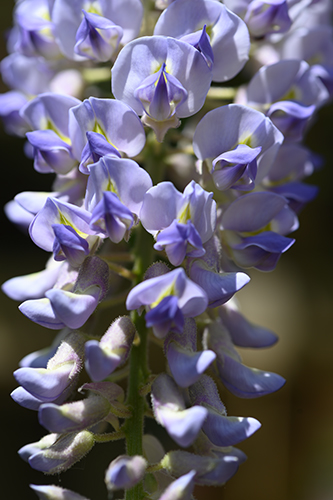

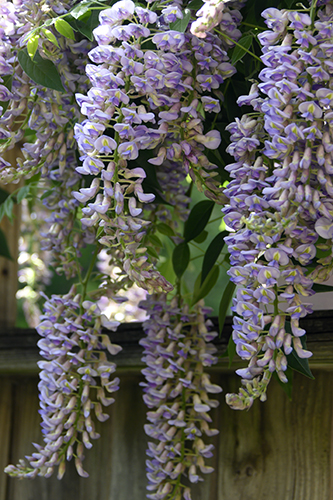
I was convinced that the wisteria bloomed in mid-June and it was early this year because of the the unusually warm weather – WRONG. I had to go back to 2017, but there it was – a late-May post that showed the wisteria in bloom.
This is the first year where the vine covers the entire top of the fence. (Last year the focus was on getting it to the end of the west-side.) The other surprise is that all of the vine, even the youngest stems, have flowers. And it also seems that there are more flowers than ever. (The pic on the right was added later to show the density of the flowers.)


Many photographers live in morning light; in its coolness, its intolerance, its sting. But I work in evening light; with its softness; its solitude; its warmth. Evening light gently unwraps the landscape; it bathes in new-mowed grass; it hums with drowsy songbirds. It calls the fading light to walls, to meadows, to marshes. I found the tiny Forget-me-nots along the edge of a new-mowed meadow.
This was my first time in North Park in May. (Last year, I spent the first part of May in Norther Ontario and the end of May in Peru.) The shoreline of the man-made lake and the banks of the creeks that feed it are lined with clumps of yellow Iris.
Paleyellows are native to Europe, northern Africa, and temperate Asia. A valued horticultural plant, paleyellow iris was brought to North America and escaped cultivation, often spreading down watercourses or washing downstream in floods. A review of early floras documented paleyellow iris in Virginia as early as 1771. Paleyellow iris is widely distributed across most of the United States and Canada. In the eastern United States, paleyellow iris is found in forested wetlands, open wetlands, and in riparian and floodplain communities.2
Golden light rounds the edges; it hides in leaves; it dissipates trials and tribulations; it calls to tranquility, to prayer. – Now in the fading light of day/ maker of all to you we pray/ That with your ever watchful love/ you’ll guard and keep us from above/ Help and defend us through the night/ danger and terror put to flight/ Never let evil have its way/ preserve us for another day.3

1 Wordsworth, William. “It is a Beauteous Evening, Calm and Free.”
2 U.S. Department of Agriculture, Forest Service, Rocky Mountain Research Station, Fire Sciences Laboratory (Producer)
3 Monks, Mount Savior Monastery. Opening Hymn of Compline.
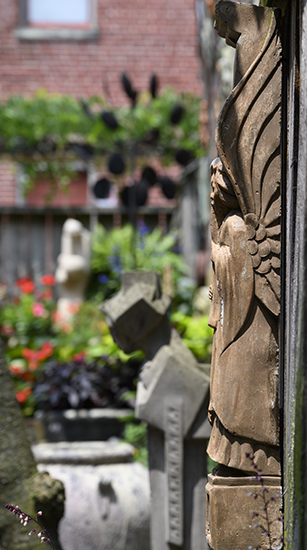
prologue
click to read all the italy – 2019 posts
In the image on the right, the foreground piece is a Medieval angel hanging from a nail on the fence-slat. What I like best about the sculpture is the wings.
 And there are two elements in the photographs that I really like:
And there are two elements in the photographs that I really like:
– the fade from the super-focused angel, to the grey Sprite, to the out-of-focus, white structure in the far back, and
– the delicate, almost-open, tiny, cerise flower-stem in the bottom left corner.
prologue
I said to my sister, who left for Toronto this morning, that we are taking our youngest sister’s kids to the land of their Nonno and Nonna; to the land where their uncle and aunt were born; to the land that is part of their DNA; that is part of their heritage. We leave for Italy Saturday. (Our youngest sister died of breast cancer on June 30, 2001.)
As we get ready for the trip, let me add a piece of serendipity that I’ll probably came back to throughout the posts.
When my family came from Italy in May, 1957, we landed in Halifax and then traveled by train, with our fellow immigrants – relatives and neighbors – to Montreal.
 The Montreal rail-yard and the park across the street from the station are images that I can still see in my mind’s eye – I stick my head out the train window and see a young priest in his black cassock and wide cloth belt, crossing the tracks; in the park, in the shade, our group from Aprigliano is sitting and eating panini americani – Wonder Bread sandwiches – as we wait to transfer out.
The Montreal rail-yard and the park across the street from the station are images that I can still see in my mind’s eye – I stick my head out the train window and see a young priest in his black cassock and wide cloth belt, crossing the tracks; in the park, in the shade, our group from Aprigliano is sitting and eating panini americani – Wonder Bread sandwiches – as we wait to transfer out.
It was in Montreal, that the group from Aprigliano, after crossing an ocean together, split up. My family got on a train and headed north-west to Sault Ste Marie; my cousin – the young man sitting on the far-left – got on a different train and headed south-west to St. Catherines.
It’s 2019 and on the outbound leg, we have a layover in Montreal. And once again, after 62 years, Connie and I will transfer out of Montreal, but this time we’re going east. This is her first time back to Italy. (In the sepia print, my sister is the small child between my mom and dad.)
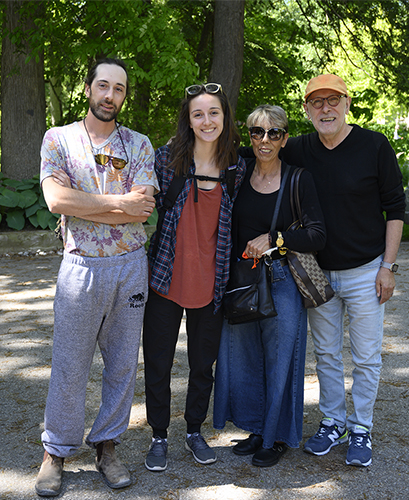
first-post – toronto
click to read all the italy – 2019 posts
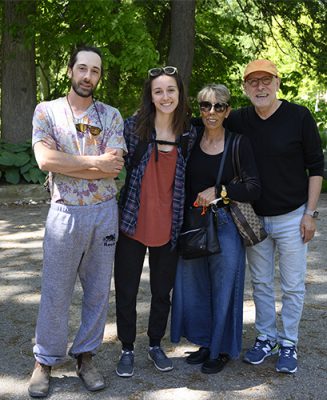 Christian looks like he just rolled out of bed/gutter; Seane just rolls her eyes at us all; Connie is anxious beyond beyond, she hates plane-travel and has never flown over-seas; and I’m there with my salmon hat, black Calvin, AppleWatch, skinny jeans and new Balance. Let’s go!
Christian looks like he just rolled out of bed/gutter; Seane just rolls her eyes at us all; Connie is anxious beyond beyond, she hates plane-travel and has never flown over-seas; and I’m there with my salmon hat, black Calvin, AppleWatch, skinny jeans and new Balance. Let’s go!
The group is ready to go to the airport, even if it means we’re there early. (Christian is the only one who would rather go at the last minute, but it’s 3 against 1.) The pic is in the Thorman’s driveway and Isabel is the acting photographer.
Have never flown Air Transat. It’s one of the charters, out of Montreal, that in the winter months shuttles Canadians south to the Caribbean and in the warm months ferries them east to Europe. The price – Toronto/Rome return – was $600.
Left-to-Right – Christian (26), Seane (23), Connie (63), Mario (70)
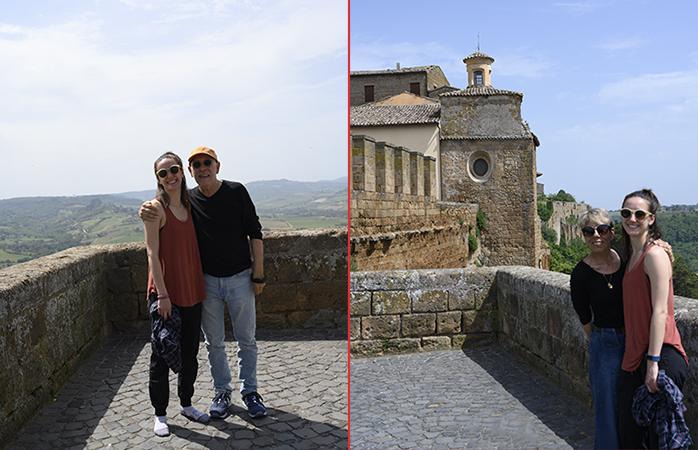
second-post – orvieto
click to read all the italy – 2019 posts

seane with her uncle and seane with her aunt
We’re still in our traveling clothes – Seane is minus her shoes – but how can you pass up an opportunity to show off Orvieto – our first stop. (Christian is behind us moving the car. And Connie is hiding her cigarette; she didn’t want a pic with her holding a lit cig.)
The B&B La Magnolia is a wonderful place; we’re 100 feet away from the Piazza del Duomo, on a pedestrian-only cobblestone street. Connie and the kids are in an attic apartment across the way and I’m in the main house.
By 6:00, the street is full of locals out for their evening passegiata. We’re sitting at a bar watching the Italians in their amazing clothes.
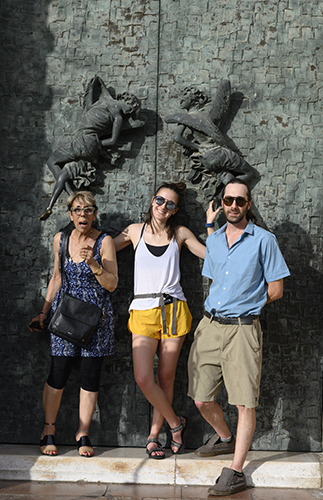
third-post – orvieto
click to read all the italy – 2019 posts
 The 3 front doors, of the Cathedral of Orvieto, are recent additions; the original wooden doors were replaced in 1970. The new bronze doors were designed by Sicilian sculptor Emilio Greco. And my favorite pieces of the side-doors are the angel door-handles. In the image, Seane is holding onto the angels’ legs and feet. These are the pulls-and-push to open and close these massive side-doors.
The 3 front doors, of the Cathedral of Orvieto, are recent additions; the original wooden doors were replaced in 1970. The new bronze doors were designed by Sicilian sculptor Emilio Greco. And my favorite pieces of the side-doors are the angel door-handles. In the image, Seane is holding onto the angels’ legs and feet. These are the pulls-and-push to open and close these massive side-doors.
Equally amazing are the frescoes by Signorelli in the Cappella di San Brizio – San Brizio side chapel. Signorelli, who lived before Michelangelo, creates a visual choreography between the Last Judgment, the apocalypse and the redemption. I like these frescoes more than those that cover the Sistine.
I’ve told everyone that in Florence we will not get the same quality of food that we’ve had the last two days. The reason is that even though Orvieto attracts a large number of tourists, most come in and leave after visiting the Cathedral. Florence, on the other hand, will be filled with tourists who stay in town, and the restaurants cater to this trade. (My only hope is that the people at the Airbnb will offer suggestions of restaurants owned and operated by locals.)
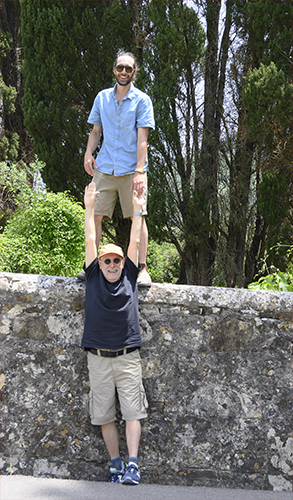
fourth-post – florence
click to read all the italy – 2019 posts
 On the drive from Orvieto to Florence, the car GPS took us into the Tuscan hills. And we loved it. Seane saw a peacock and Connie insisted we stop; I saw a field of poppies and I insisted we stop; Christian deciding that he needed to climb the wall surrounding a derelict villa, turned off the car and made for the wall. The care abandoned, the destination forgotten, we just played.
On the drive from Orvieto to Florence, the car GPS took us into the Tuscan hills. And we loved it. Seane saw a peacock and Connie insisted we stop; I saw a field of poppies and I insisted we stop; Christian deciding that he needed to climb the wall surrounding a derelict villa, turned off the car and made for the wall. The care abandoned, the destination forgotten, we just played.
We realized the GPS took us to an area north-east of the city – Fiesole – and once we corrected for the mistake, we were back on the road towards the city of The Medici.
Coming into Florence at 4:00 in the afternoon, on a hot day should be forbidden. The place was crawling with tourists indiscriminately walking and locals rushing to get home. It was not a pretty site or an easy situation.
After negotiating the technology to get into our Airbnb, rush-hour traffic to find a parking garage and luggage lugging up 3 landings, we headed to Piazza della Signoria. (Seane is the navigator, and she’s excellent at it; I can co-pilot – read the Italian street signs, point to where we need to go and explain what we’re seeing – what I can’t deal with are directions and figuring out how from point A to point B. My mantra is, “We need to go this location; get me there and I’ll take care of the rest.”)
We get to the Piazza and it’s set up for Salvatore Ferragamo men’s wear presentation. The entire area in front of the Loggia and the Palazzo Vecchio is sectioned off and guarded my a small army of men in black – security squeezed into skinny-fits jackets and pants.
“No fashion show has ever been allowed in Piazza della Signoria before,” . . . It was also the first show with the designer – Paul Andrews – in the role of creative director of both the men’s and women’s lines, and the first time that Ferragamo staged a fashion show in its hometown of Florence.
The label contributed to the recently completed restoration of the majestic Fountain of Neptune, which dominates Piazza della Signoria. 1
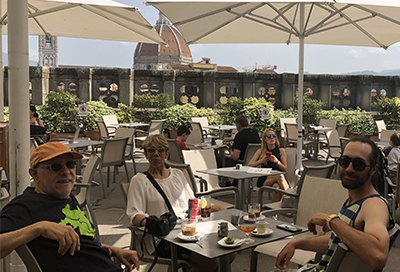
fifth-post – florence
click to read all the italy – 2019 posts
 We began the morning at the Uffizi. (It’s probably my least favorite museum. It’s art collection covers such a narrow period that after a while I think, “How many more Marys; how many more crucified Jesuses do I need to see?”) However, the Medici palace, that is the museum, is an amazing place; it’s a precursor of Versailles. And the views of Florence, out of its massive windows, are spectacular. (I have to wait until I get home to post some of those images, because they are in the camera hard-drive not on a removable memory card.)
We began the morning at the Uffizi. (It’s probably my least favorite museum. It’s art collection covers such a narrow period that after a while I think, “How many more Marys; how many more crucified Jesuses do I need to see?”) However, the Medici palace, that is the museum, is an amazing place; it’s a precursor of Versailles. And the views of Florence, out of its massive windows, are spectacular. (I have to wait until I get home to post some of those images, because they are in the camera hard-drive not on a removable memory card.)
We did have to have coffee at the cafe overlooking the Piazza della Signoria. It was worth every Euro (3 coffees, 1 Pepsi, 1 cognac = €27) maybe not.
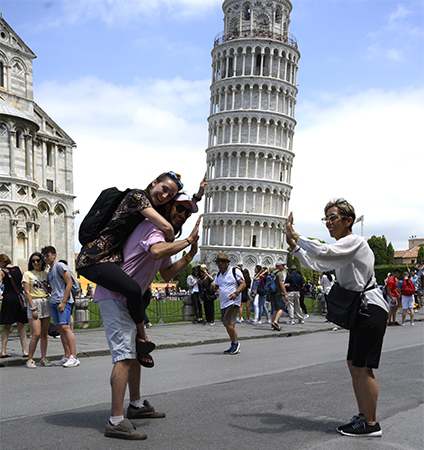
sixth-post – pisa
click to read all the italy – 2019 posts

I’ve avoided Pisa for 20 years, but given that this was Connie’s, Christian’s and Seane’s first time here, I gave in and we went. OMG, what an absolutely amazing place. (I’m referring strictly to the complex that is the Cathedral, because we saw nothing of the town.) The Duomo complex has been all restored – the Bell-tower glimmers, the white marble on the Cimitero arches are crinoline elegant and the Baptistry and Cathedral sparkle under the Tuscan sun.
Everyone – Asian, Indian, African, Canadian, American – takes selfies holding up the leaning Bell-tower giving the place an atmosphere of playfulness and just plain fun. Seane mentioned that she’s seen these selfies all over the place, but had no idea how much fun it would be to create them.
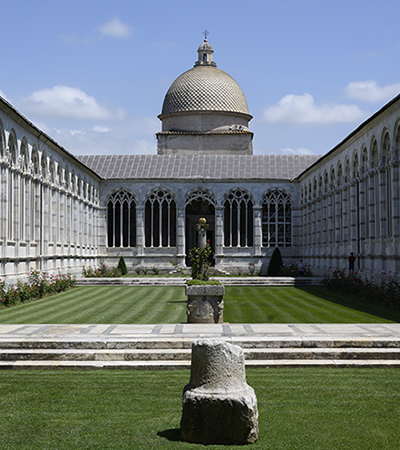
seventh-post – pisa
click to read all the italy – 2019 posts

The Cimitero – cemetery – is one of the four structures that make up the Duomo complex in Pisa. The Cimitero straddles the northern flank of the complex between the Cathedral and the Baptistry. The image on the right is the courtyard of the Cimitero.
The cycle of life is represented within the complex. You begin as a child being baptized in the Baptistry. (Baptism is evidence that you now belong to the ‘club’.) The bells ring out for the new member; the bells also mark the hours and on Sunday call you to Mass at the Cathedral. At the end of your life, you are carried into church and after the funeral Mass, the procession makes its way to the cemetery, accompanied by the tolling of the bells. (The Catholic Church organized and managed everything in Medieval times.)
The complex has green grass in between the buildings which adds to a sense of frivolity and serenity. (Missing is the hassle and bustle that is Florence.)
In the above image, I was interested in capturing the amazing blue sky through the lattice stone-work. (How do they make stone look so delicate, so ethereal?)
It is fun to remind Connie that she’s in a cemetery; that she’s walking on top of people’s graves.

eighth-post – pisa
click to read all the italy – 2019 posts

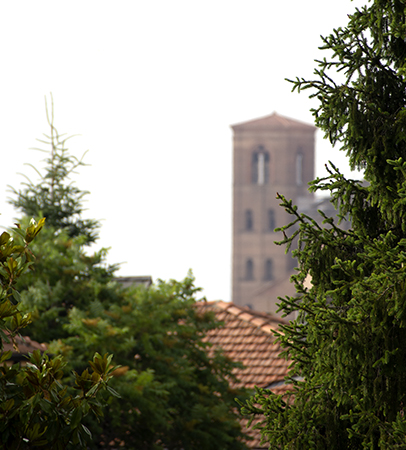
ninth-post – bologna
click to read all the italy – 2019 posts

We’re staying at this amazing Airbnb in the southern hills of Bologna; it’s a 3-bedroom apartment. There’s a park – Giardini Margherita – across the street. (On our way into town, we went food shopping and had a picnic in the park.) The apartment building is nestled in the hillside surrounded by sumptuous villas and giant ever-greens. From the balcony, I captured the image on the right. The Romanesque bell-tower is down in the flats, in the city proper.
Bologna is a respite from the craziness of Florence; it breaks up the drive to Venice; and we can eat some of the best food in all of Italy. We went out for gelato; it was so good that we decided to try out their granita – amazing. We then walked over to Restorante Alice and made reservations for tomorrow night. Restorante Alice was one of the reasons to come to Bologna. (Rose, Derrick and I first ate at Alice some 15 years ago and we’ve coming back whenever we’ve been in this part of the country.)
My mother’s generation knows Bologna as a premier medical center; my group knows it as the foodie capital of Italy.
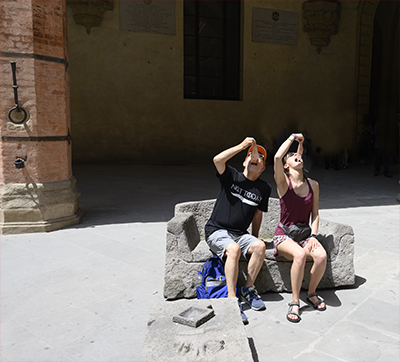
I planned Orvieto as an alternative to Rome, that way when we got in we wouldn’t have to deal with the craziness that is The Eternal City. I planned Bologna as a place to decompress after Florence and a place where we could do laundry. (How gouache would it be to dry your undies on a balcony in the city of Lorenzo de’ Medici?) Also in Bologna, we could have amazing gelato, as often as possible, and we needed to have dinner at Ristorante Alice.
The other thing we needed to do while in Bologna was buy mortadella at Ceccarelli’s and eat it in the courtyard of the Palazzo Communale – City Hall. It was 2012 and my cousins – Rose and Derrick – bought mortadella and when we went into the courtyard, they decided that they had to have a snack. I remember being aghast at their audacity, but when it comes to good food these two will break all protocols, all sense of civility. (The middle image, in the triptych, is of Rose and Derrick.)

It’s 2019 and the four of us proudly followed in their footsteps.
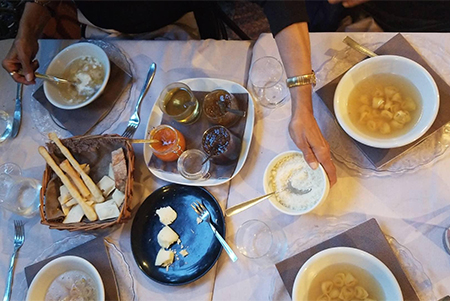
 This post has two goals – explaining the various foods and explaining the hands grabbing the bowl of Parmigiano.
This post has two goals – explaining the various foods and explaining the hands grabbing the bowl of Parmigiano.
We’re at Restorante Alice on the edge of the University quarter. We ordered the buffet and by mistake added a tortelleni-al-brodo and a tagliatelli-a-ragu.
The buffet is what Ristorante Alice is know for. It’s a series of amazing delicious tapas – zucchini grilled in a balsamic reduction, eggplant wonderfully charred and drizzles with olive oil … but the all time favorite is the ricotta. It’s so creamy we were wiping the side of the bowl with our fingers and bread, because we weren’t going to let any of it go back. And the small bowls just kept coming. There was cured sausage, cherry tomatoes in olive oil, a sweet cabbage, grilled red and yellow peppers, mortadella. (Seane and I were trying to distract Christian from eating his creamy ricotta, but he wouldn’t cooperate.)
The last item of the buffet is fresh pecorino scooped with a spoon and served with 4 amazing toppings – pumpkin jam, fig jam, local honey and onion jam. The jams are made by the chef. (The very first time Rose, Derrick and I were at Ristorante Alice, the server brought us the pecorino wheel and a spoon stuck in the middle along with the jams. We didn’t know what to do. But we learned quickly.)
Reaching for the Parmigiano
We discovered that Connie loves her grated Parmigiano. She will literally move heaven-and-earth to get to the cheese. We first noticed in Orvieto when she told the server that he could leave the grated pecorino; he gave her such a look, but he left the cheese bowl. Our standing comment was that Connie like some brodo – broth – with her cheese. But let’s be clear, the emphasis was on the grated cheese.
At Alice we ordered two additional dishes – the tortellini and the tagliatelli – by the time they were served we were already bursting, but Connie was not going to pass up a pasta dish that allowed her to add grated cheese. In the above image, Connie is reaching for the cheese bowl.
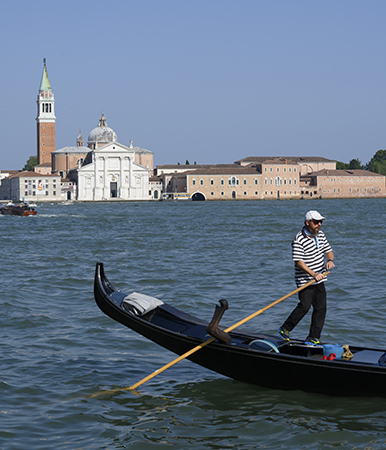

My favorite explanation for why Venice is referred to as La Serenissima is:
In addition to being prosperous for the wealth it held, it is said that Venice was particularly tolerant of foreigners who went to the city for commercial reasons. Thanks to the incorruptible system of justice, in force at the time, a real climate of peace and serenity had been established in the city, for which the lagoon would continue to boast this name – La Serenissima – in the following centuries.
The last time I was here was some 20 years ago and we did day-trips, because we couldn’t find accommodations over Easter. (Venice was full of Italians who travel during the Easter break.)
This time, we were coming into the city through the airport. (I figured returning the rental at the Venice airport was easiest.) And the Airbnb in Venice gave me a list of options for getting into town. There is public transportation – boat – for approximately $20 between the Marco Polo Airport and the center of Venice. It took an hour to get to the Rialto Bridge, a central point on the Grand Canal. And our Airbnb was a ten minute walk towards the Mercato – the farmers’ market area of town.
The above image was shot from the airport-boat taking us into Venice.
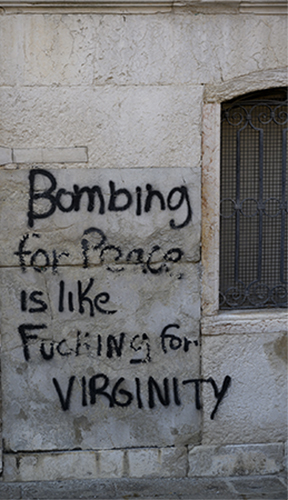

As soon as we put our suitcases in the rooms and changed, we headed into the calle – allies – and canals of San Polo, Santa Croce and the Dorsodouro. In one of the many small piazza, Seane spotted the graffiti about bombing and fucking.
For someone with little sense of direction and a need for visual landmarks in order not to get lost, the beehive that is Venice doesn’t bother me, mainly because no matter how deep into the maze I am, I can always reach the Grand Canal. And as long as I know that, all the disorientation of the twists and turns don’t bother me.
I used the title, because it was somewhat of a shock to see in very plain, very correct English a pertinent announcement. It’s not necessarily a new message, I’ve seen variations before, but it was a shock to be reminded of the hypocrisy we live with, and it was a shock to see it in Venice.
—————————————————
Let me get something off my chest. I dislike Florence; I prefer Venice. And I believe the tourist industry and the cultural cognoscenti push Florence over Venice. Florence is pretty; Venice is falling apart; Venice stinks; Venice is full of graffiti. I say, Florence is pretension and attracts the pretension. I never saw so many men in salmon colored suit-jackets, so many over-coiffed peacocks strutting around; so much artificial cleanliness. To me, Florence is a mausoleum being jealously guarded and excessively polished. It’s a glorification of wealth; it calls out to the wannabes telling them that they too can bask in the Medici’s leftovers. It’s Americans watching Downton Abbey and believing that they are part of the Upstairs people.
Venice is alive – the graffiti, the Bienales, the people still living in the calle, on the secondary canals. La Serenissima is still subject to the whims of nature, the pull of the moon. You can never forget that the sea is a punitive mother; you never forget that old dowager is fading.
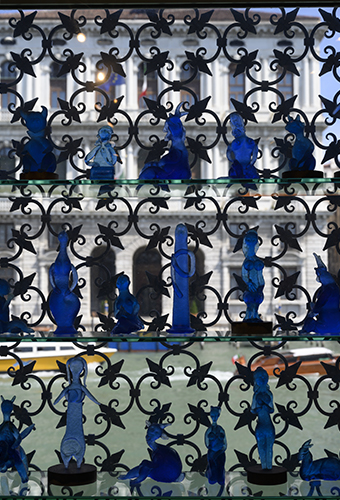

We’re at the Peggy Guggenheim. The collection is housed in the Palazzo Venier dei Leoni, an 18th-century palace on the Grand Canal, which was her for three decades. It is one of four Guggenheims; the other three are in New York City, Bilbao and Abu Dhabi.
The last time I was here, the Wertheimers went to the museum and I went to the cemetery on the Isola di San Michele; I went to find Stravinsky’s grave. I even collected a handful of small pebbles from the grave-site and still have them on my desk in a shallow bonsai pot.
I want to write that it was a simpler time and Venice wasn’t yet over-run with foreigners using its majesty as a backdrop for their selfies – ME on the Rialto bridge, ME in front of the Campanile, ME in San Marco square. But that certainly sounds hypocritical given that I took home rocks from Igor’s grave.
In the image on the right, the small poured-glass figurines, on shelves in the window, overlooking the Grand Canal, are sculptures from sketches by Picasso. The grand palazzo in the background was once home to Caterina Cornaro, the daughter of an ancient Venetian family.
The Marino Marini sculpture – L’angelo della città – The Angel of the City – in the entrance courtyard, is silk-screened on all the museum’s T-shirts and as much as I wanted to buy one, walking around Pittsburgh with an line-drawing of a man on a horse with a hardon just wouldn’t work.


We began our last day in Venice riding the elevator to the top of the Campanile. What an amazing vantage point. (We had expected to walk up, but that is no longer an option.) And to top off the experience, the massive bells began to toll while we were up there. OMG!
Our next stop was the island of Murano. We got to see a glass-blowing demonstration, but Murano is very commercial and very touristy. After walking into a few stores and seeing the extravagant prices, we opted to get back on the boat and head up to Burano – the northern-most, peopled island in the lagoon.
Muraon is glass; Burano is lace. What we didn’t expect were the outrageously painted houses. We went off the main canal through an archway and headed into the small town and what we found was house after house painted in the most outlandish colors. It was Disneyland like. The above image is in town on one of the smaller canals.
What I liked best about Burano were the regular people going on about their everyday lives. I stopped at a small Frutti e Verdura – fruit and vegetable market – and everyone in line spoke the Venetian dialect.
All the boat-rides – Rialto to San Marco, San Marco to Murano, Murano to Burano, and Burano back to Rialto – as well as the boat-ride to the train station the next day cost us €20 per person.
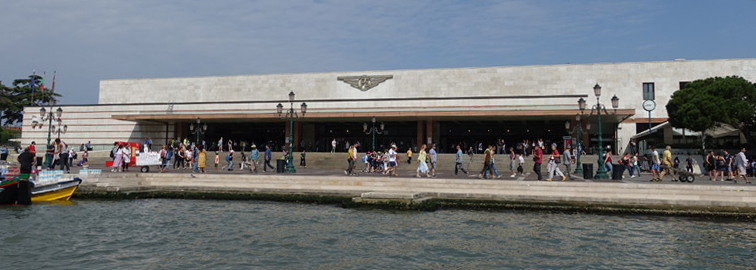
The Venice train-station deserves its own post.

This brief history of the train-station if from Wikipedia. – The current station building is one of the few modernist buildings facing the Grand Canal. It is the result of a series of plans started up by the rationalist architect Angiolo Mazzoni in 1924 and developed by him over the next decade.
In 1934, a contest for a detailed design for the current station was won by Virgilio Vallot. Between 1936 and 1943, Mazzoni and Vallot collaborated on the construction of the station building; Mazzoni also designed the train hall. The final implementation, however, was undertaken only after the Second World War. In 1952, the station was completed on a design which had been developed by another architect, Paul Perilli.
In November 2009, work began on the renovation of Santa Lucia station. The renovation would include improvements to the use of spaces and the flow of internal transit. In addition, certain architectural elements would be recovered and restored; the atrium would be altered to house several retail spaces. This project was completed in 2012 with a cost of 24 million euros.
Throughout Italy, train-stations tend to be in the older, poorer sections of town; well not in Venice. Throughout Italy, train-stations are riddled with graffiti and garbage; not in Venice. Throughout Italy, train-stations are areas that attract pickpockets, migrants and the homeless; not so in Venice. Throughout Italy, train-stations are cruising areas, pick-up spots and venues for beggars; not in Venice. Throughout Italy, the old, 19-century train-stations are being torn down and replaced by soul-less concrete coverings; the Venetians renovated their pre-war station for modern times. The Santa Lucia train-station is elegant, clean and well run; it has cafes and small restaurants that are efficient and reasonably priced. And Venice is on the newly built, high-speed – Frecciarossa – train system. (I decided that I wanted to travel at bullet-speed and in comfort, so I bought tickets in the QUIET/Business carriage of the Frecciarossa; we enjoyed our 4-hour ride to Rome.)
Using our 24-hour pass, we boarded the #1 vaporetto to Santa Lucia at 8:11 and by 10:30 we were speeding towards Baroque Rome. We made 3 stops – Padova, Bologna and Florence. Only the Bologna station was as clean and as graffiti free as the Venice terminal; the rest fit the stereotype. The Florence train-station was particularly dirty, graffiti strewn and surrounded by dilapidated buildings.
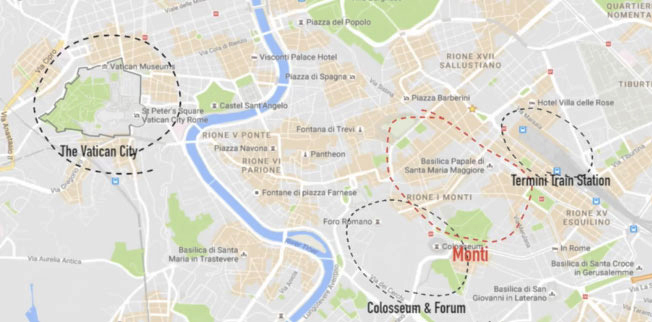
 We arrived at Roma Termini on time and after realizing that we were 10 minutes from the Airbnb, we decided to walk.
We arrived at Roma Termini on time and after realizing that we were 10 minutes from the Airbnb, we decided to walk.
Rione I Monti is Rome’s hipster neighborhood. It’s also one of the few remaining areas that is home to actual Romans not tourists. It’s also Rome oldest neighborhood.
Monti is an eclectic neighborhood in the city center, with both bohemian and classical elements. Archaeological sites like Trajan’s Markets and Nero’s Domus Aurea palace occupy its southwestern edge. Family-run trattorias, hip wine bars and funky vintage boutiques are tucked in its piazzas and back streets, and draw a mix of expats, students and locals. (from the web)
Our Airbnb was on via dei Capocci – Cabbage Street – and the small square down the street from us was Piazza degli Zingari. My last name in a form of zingari which in Italian means gypsies.
The Airbnb – I Capocci – was the best accommodations of the entire two weeks. It was a two-floor apartment beautifully renovated. The bedrooms were substantial, the kitchen/dining area were wonderful spaces to cook eat and socialize. (Such a contrast to the place we had stayed in Venice.) Even though the Colosseum was down the street from us, and the massive Santa Maria Maggiore was up the street, the area was quiet and felt like a neighborhood instead of a heavy trafficked tourist thoroughfare. Also, we were nowhere near the Vatican with its swarming sycophants and its men and women prancing around in Medieval dresses. (Oh tell me your surprised by my comments.)
BTW, we went nowhere near a church while in Rome even though San Pietro in Vincoli with Michelangelo’s Moses was only a short walk from us. We were in town for a day-and-a-half and I decided that we would do Outdoor Rome, rather than museums and churches. We walked 14 miles in our day-and-a-half visit in temperatures in the 90’s. (Here’s a generational comment – Seane and Christian drank and filled their water-bottles from any outdoor fountain they could get near. Their old uncle wouldn’t touch the water coming from the hundreds of fountains. It’s still in my head that the water isn’t as clean as the water here at home.)

None of the images on this post are mine. Because we were visiting locations that I had shot several times before, I didn’t take any new pictures. And we were in Monti for such a short time before we headed to the tourist sites, that I didn’t get to walk and shoot the neighborhood.
The image on the left is Piazza della Madonna dei Monti a hot-spot for hip young Romans and a couple of block down from where we were staying. In the image on the right, in the middle background, is the monumental Santa Maria Maggiore.
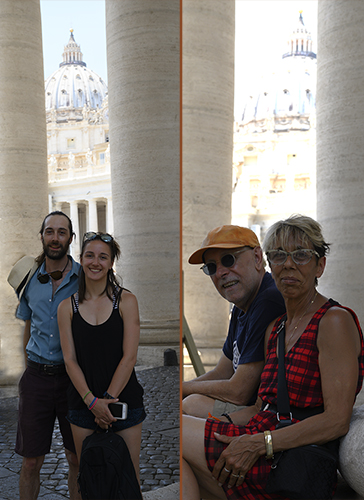
 We began this morning at the Colosseum. We were there early and still had a long wait, because once they reach a capacity of 3,000 in the amphitheater, they slow the lines down until some leave. From Monti, we walked to the Pantheon to see the oculus, (I refuse to acknowledge that the amazing Roman temple has been turned into a church.) then onto Piazza Navona and then across Ponte Sant’Angelo and into the Vatican.
We began this morning at the Colosseum. We were there early and still had a long wait, because once they reach a capacity of 3,000 in the amphitheater, they slow the lines down until some leave. From Monti, we walked to the Pantheon to see the oculus, (I refuse to acknowledge that the amazing Roman temple has been turned into a church.) then onto Piazza Navona and then across Ponte Sant’Angelo and into the Vatican.
In memory – sixty-two years ago – Spring, 1957 – Ciccio, Mafalda, Mario and Connie sat in St. Peter’s colonnade and had lunch. We were in Rome for our physicals, a requirement before we could emigrate to Canada. And in my memory, it’s always the right-side and the area as soon as you go into the of the colonnade.
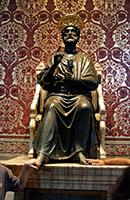 After our picnic, we went into the basilica and touched St. Peter’s foot – a certain good-luck-charm of the time. We even bought a small statuette of St. Peter, from one of the many hucksters outside the colonnade, to give to my grandmother when we got to Canada. (The thumbnail on the left is the statue inside the church. The left foot is so worn, from pilgrims touching it, that it no longer has toes.) And I remember that when we got to Sault Ste Marie, I gave grandma the small gift. She displayed it proudly and I can still see it on the dresser in the living room that had become my grandparents’ bedroom. (Ciccio, Mafalda and Connie had taken over their old room.)
After our picnic, we went into the basilica and touched St. Peter’s foot – a certain good-luck-charm of the time. We even bought a small statuette of St. Peter, from one of the many hucksters outside the colonnade, to give to my grandmother when we got to Canada. (The thumbnail on the left is the statue inside the church. The left foot is so worn, from pilgrims touching it, that it no longer has toes.) And I remember that when we got to Sault Ste Marie, I gave grandma the small gift. She displayed it proudly and I can still see it on the dresser in the living room that had become my grandparents’ bedroom. (Ciccio, Mafalda and Connie had taken over their old room.)
And that’s where we are, 62 years later, under the right colonnade and away from the white, Roman sun. No food this time only water.
Connie suggested we do a generational pic – the two of us and Seane and Christian – and the composite is those images. (The two images are slivers, because I had to remove a family who was sprawled in the background.) When Connie told Mafalda about our re-enactment, my mother said she had no memory of having gone to the Vatican. All she remembers of the trip was that she had worn heals to “look good” and her feet were so sore that she stayed back in the hotel room when we went on our trek across Rome.
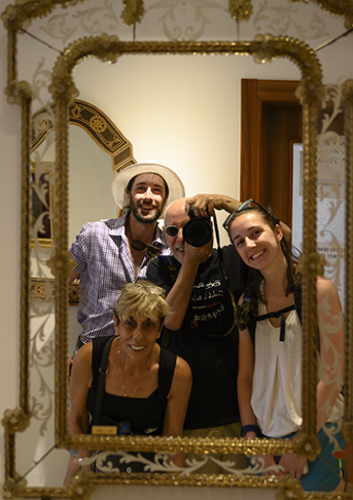
 This is my favorite picture from the trip. (I like the frame of the second mirror behind Christian and I like the green of Seane’s shorts in the lower right corner.) We’re in Murano at a glass factory and the gilded mirror, created by the factory glass-blowers, was hanging in the hallway.
This is my favorite picture from the trip. (I like the frame of the second mirror behind Christian and I like the green of Seane’s shorts in the lower right corner.) We’re in Murano at a glass factory and the gilded mirror, created by the factory glass-blowers, was hanging in the hallway.
from the prologue – I said to Connie that we are taking our youngest sister’s kids to the land of their Nonno and Nonna; to the land where their uncle and aunt were born; to the land that is part of their DNA; that is part of their heritage.
I’m writing this entry on June 30, 2019 the eighteenth anniversary of Jo’ death. This is my toast to someone I still miss very much.
It was great having two weeks with the kids; and I can honestly say we had a lot of fun. Connie’s sense of wonder allowed me to see Italy through an unfiltered lens; Christian’s focus on safe-driving made the trek to Venice enjoyable and gave me one less thing to worry over; Seane’s navigational skills always got us where we needed to go, removing all anxiety about finding ourselves lost.
—————————————————
Maneuvering the ancient alleys of Orvieto in an over-sized Ford van, finding great pasta in the side streets, the kids in their blue capes, in the Cathedral, looking like penitents or super-heroes
— Ferragamo in Florence, the Medici Chapel, the cannabis shop, a street-vendor
hocking God-and-Adam’s hands, and a beautiful Armani sweater
A leaning bell-tower, a Cimitero, and the gleaming white of Pisa’s wedding-cake Duomo
— santo stefano gelato and mint granita in the university quarter, mortadella in the courtyard, a picnic in Gardini Margherita,
and then Ristorante Alice
The Peggy Guggenheim on the Grand Canal, the vaporetto to Murano, dancing in Piazza San Marco, and the painted houses of Burano
— The cobble-stoned streets of Monti, Piazza degli Zingari, the Colosseum, St. Peter’s colonnade, the Airbnb on via dei Capocci,
the home-cooked meals and the sparkling white wine
All amazing
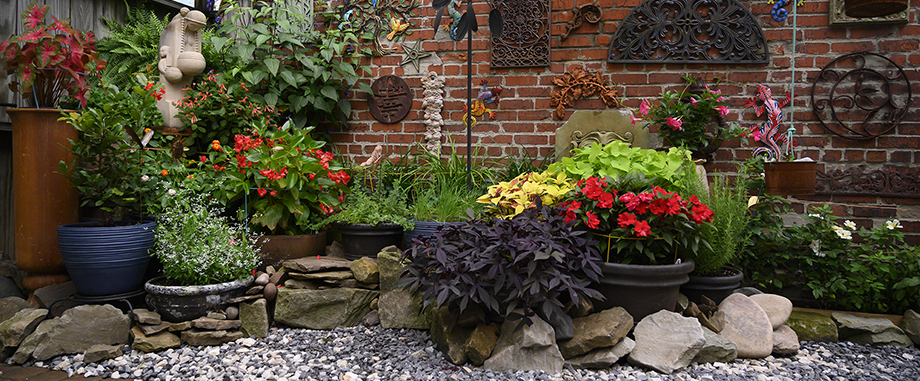

It’s been a miserable couple of days – the temperatures have stayed above 80o and the humidity is so close it’s like walking through a sauna. And the forecast is the same for the rest of the week. (Venice was hot and humid, but Rome was just hot and we still walked from Monti to the Vatican. It’s the humidity that I hate most.)
Recently someone asked a friend, who now lives year-round in Florida, what happens during the summer months down in the sunshine state; the answer was great, “We do what you guys do up here during winter; we stay indoors.”
There are a number of small projects that I want to do in the backyard, but they will have to wait for better weather. (The above image was taken right before a summer-storm and the sky was a deep brownish-red.)
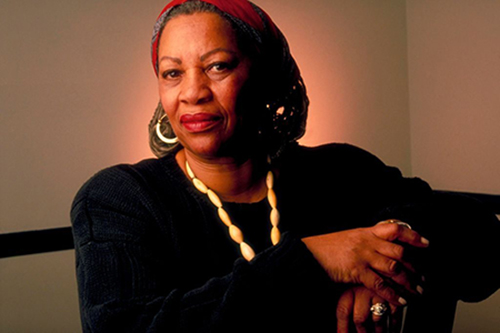

Toni Morrison
Wednesday, February 18, 1931 – Monday, August 5, 2019
We die. That may be the meaning of life.
But we do language.
That may be the measure of our lives.
Thank you. My sincere thanks to the Swedish Academy and thank you all for this very warm welcome.
Fiction has never been entertainment for me. It has been the work I have done for most of my adult life.
I believe that one of the principal ways in which we acquire, hold and digest information is via narrative. So, I hope you will understand when the remarks I make begin with what I believe to be the first sentence of our childhood that we all remember, the phrase “once upon a time.”
“Once upon a time there was an old woman. Blind but wise.” Or was it an old man? A guru, perhaps. Or a griot soothing restless children. I have heard this story, or one exactly like it, in the lore of several cultures.
“Once upon a time there was an old woman. Blind. Wise.”
In the version I know the woman is the daughter of slaves, black, American, and lives alone in a small house outside of town. Her reputation for wisdom is without peer and without question.
Speculation on what (other than its own frail body) that bird-in-the-hand might signify has always been attractive to me, but especially so now thinking, as I have been, about the work I do that has brought me to this company. So I choose to read the bird as language and the woman as a practiced writer. She is worried about how the language she dreams in, given to her at birth, is handled, put into service, even withheld from her for certain nefarious purposes. Being a writer she thinks of language partly as a system, partly as a living thing over which one has control, but mostly as agency – as an act with consequences. So the question the children put to her: “Is it living or dead?” is not unreal because she thinks of language as susceptible to death, erasure; certainly imperiled and salvageable only by an effort of the will. She believes that if the bird in the hands of her visitors is dead the custodians are responsible for the corpse. For her a dead language is not only one no longer spoken or written, it is unyielding language content to admire its own paralysis. Like statist language, censored and censoring. Ruthless in its policing duties, it has no desire or purpose other than maintaining the free range of its own narcotic narcissism, its own exclusivity and dominance. However moribund, it is not without effect for it actively thwarts the intellect, stalls conscience, suppresses human potential. Unreceptive to interrogation, it cannot form or tolerate new ideas, shape other thoughts, tell another story, fill baffling silences. Official language smitheryed to sanction ignorance and preserve privilege is a suit of armor polished to shocking glitter, a husk from which the knight departed long ago. Yet there it is: dumb, predatory, sentimental. Exciting reverence in schoolchildren, providing shelter for despots, summoning false memories of stability, harmony among the public.
The systematic looting of language can be recognized by the tendency of its users to forgo its nuanced, complex, mid-wifery properties for menace and subjugation. Oppressive language does more than represent violence; it is violence; does more than represent the limits of knowledge; it limits knowledge. Whether it is obscuring state language or the faux-language of mindless media; whether it is the proud but calcified language of the academy or the commodity driven language of science; whether it is the malign language of law-without-ethics, or language designed for the estrangement of minorities, hiding its racist plunder in its literary cheek – it must be rejected, altered and exposed. It is the language that drinks blood, laps vulnerabilities, tucks its fascist boots under crinolines of respectability and patriotism as it moves relentlessly toward the bottom line and the bottomed-out mind. Sexist language, racist language, theistic language – all are typical of the policing languages of mastery, and cannot, do not permit new knowledge or encourage the mutual exchange of ideas.
The old woman is keenly aware that no intellectual mercenary, nor insatiable dictator, no paid-for politician or demagogue; no counterfeit journalist would be persuaded by her thoughts. There is and will be rousing language to keep citizens armed and arming; slaughtered and slaughtering in the malls, courthouses, post offices, playgrounds, bedrooms and boulevards; stirring, memorializing language to mask the pity and waste of needless death. There will be more diplomatic language to countenance rape, torture, assassination. There is and will be more seductive, mutant language designed to throttle women, to pack their throats like paté-producing geese with their own unsayable, transgressive words; there will be more of the language of surveillance disguised as research; of politics and history calculated to render the suffering of millions mute; language glamorized to thrill the dissatisfied and bereft into assaulting their neighbors; arrogant pseudo-empirical language crafted to lock creative people into cages of inferiority and hopelessness.
Word-work is sublime, she thinks, because it is generative; it makes meaning that secures our difference, our human difference – the way in which we are like no other life.
We die. That may be the meaning of life. But we do language. That may be the measure of our lives.

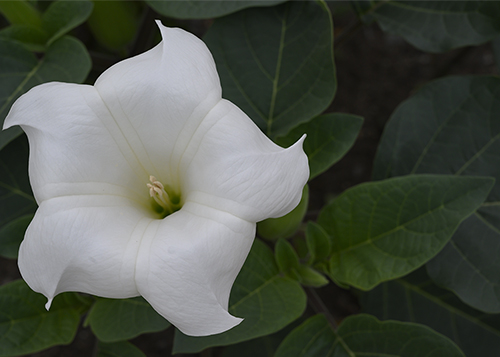
John J. Greeley
Monday, October 7, 1929
Saturday, August 10, 2019
During my year at the Novitiate in Narragansett – 1968/1969 – John Greeley was our theology teacher. And he was funny, dynamic, smart, subtle – amazing. He introduced us to the study of scripture. And what Greeley did, that was severely left for the time, was present the Old and New Testaments as archives to learn from, to understand. He was our resident scholar and the bible our research lab. (John never suggested that these testaments were recipes or guidelines for a good Catholic life.)
John had us work from The Jerusalem Bible, the first Catholic bible translated from the Hebrew and Greek texts, rather than from Jerome’s Latin Vulgate. (One of the postulants who left the Novitiate shortly after we got there in June of 1968, deeded me his copy of The Jerusalem Bible. His nickname – Pini, written in ballpoint – is still scrawled on the inside front-cover.)
The Jerusalem Bible became our textbook; we wrote in the margins; we folded corners, we stored our notes among the verses … Greeley opened up a window into the study of scripture that I never knew existed. And because of John, the love and study of these ancient texts has stayed with me.
Obituary

John J. Greeley S.T.D., 89, of Middletown, Rhode Island, passed away at Newport Hospital on August 10, 2019.
John was born in New York, NY to the late Arthur L. Greeley and Mary F. (Fogarty) Greeley. He was the husband to Mary Louise (Ide) Greeley, PhD.
After John had graduated from Bishop Loughlin Memorial High School in New York, NY, he entered the Novitiate of The St. John Baptist De La Salle Brothers of the Christian Schools. John received his Bachelor of Arts at The Catholic University of America and moved on to receive his Master’s degree at Manhattan College. He received his licentiate in Sacred Theology (S.T.L.) and went on to complete his Doctorate in Sacred Theology (S.T.D.) both at The Catholic University of America.
In 1979, he received his dispensation from the Pope to leave the Christian Brothers. In January of 1980, he was hired by Salve Regina University as chair and professor of Religious Studies. John assisted in the Roman Catholic Initiation of Adults Program (RCIA) at St. Mary’s Roman Catholic Church in Newport for many years. He also helped with Troop 1 Portsmouth Boy Scouts.
John is survived by his loving wife, Mary Louise Greeley, their son, John J. Greeley Jr., of Somerville MA.
Besides his parents, he was predeceased by his three brothers, James Greeley, Arthur Greeley, and his twin brother, Charles Greeley.
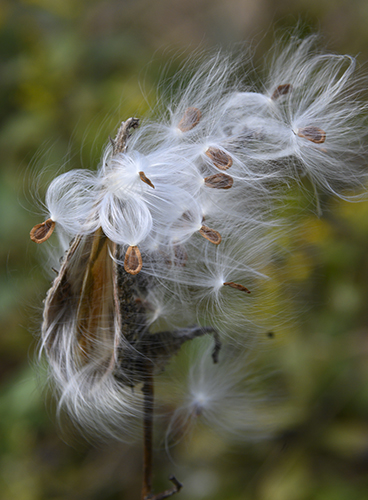

This is the first post in the re-designed website. I’m no longer working in code. WordPress has me learning to use blocks.
Today is also the autumnal equinox with both the Northern and Southern hemispheres experiencing an equal amount of daylight.
For those of us in the Northern Hemisphere, it marks the beginning of astronomical fall, with daylight hours continuing to shorten until the winter solstice in December.
The image is from North Park, I was walking up Walter Road and saw the Milkweed pod along the hillside. My favorite route is to climb the southern ridge using Walter Road and then take flat Lakeshore back to the parking lot. It’s one of the most quiet and car-free of the various trails in the Park. (The best is North Ridge Road in the winter when it’s closed to traffic.)
I made no alterations to the image except to crop it – sometimes it’s just right the way it comes. I’m using the new camera in aperture priority and am getting some decent results. The bend in the filaments show the direction of the wind – a soft autumn breeze.
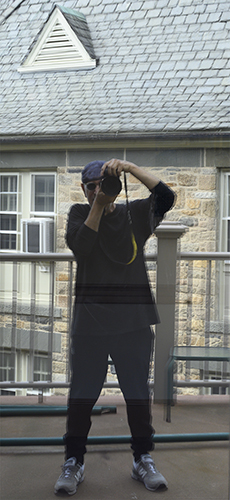

I’m in Narragansett at the Christian Brothers Center – what used to be the district’s administrative offices and the Novitiate.
I was assigned a room in the new wing. In the image, I’m on a small deck between the old mansion and the new wing. (This is the first of several images that I shot through a ‘looking-glass’.) Greg is in the mansion; and where my room, in the addition, is modern and well appointed; his is a bit more dated.
The drive up was amazing – the area around Newark Airport was a massive traffic jam and getting across the George Washington Bridge was nightmarish.
And when I crossed into the Bronx, the density of the region just hit me – from Philadelphia east it’s a mega human colony – and I shivered remembering a time when I too lived in this eastern beehive.
Thankfully, Waze took me off I-95 and sent me up to the Hutchinson Parkway and then onto the Merritt Parkway; these ‘parkways’ made up for the New Jersey Turnpike and the George Washington.
I-95 through Connecticut was also an experience in driving through human density just not as stressful as earlier in the drive. But once I hit Rhode Island and turned south towards the beaches, the environment changed. The buzz and swirl of I-95 gave way to the bucolic Rhode Island landscape. A landscape and lethargy I remembered from years gone by.
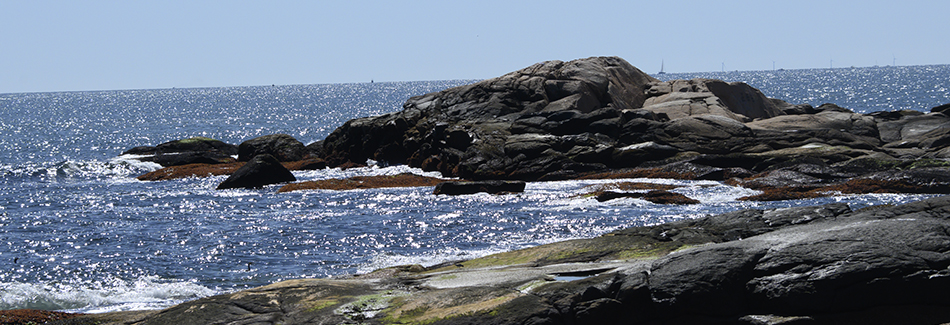

The coastline in front of what was The Novitiate, we always referred to as The Rocks. It’s a rugged, inhospitable sliver just north of Scarborough State Beach.
After getting here, Greg and I walked down to The Rocks. Fifty years ago, all of us would walk through under-bush to reach the water, now the area across from the Christian Brothers Center, is a park with gravel trails leading both to the rocky coast and down to the beach.
Back then, I never considered the thought that there would come a time when I would be 70 years old and again walking The Rocks with a friend from my Novitiate group.
In ’68, the Rhode Islanders – John and Mike – kept telling us that by fall the beach would be empty; by the end of September, the tourists and the summer residents would be gone. And I do remember having The Rocks and Scarborough Beach to ourselves; looking for starfish in the rocky pools; body-surfing in the warm salt water.
And this weekend, we again had the rocks and the ocean to ourselves .
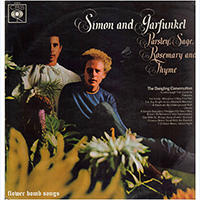

In 1968, I was wearing out the grooves of Simon & Garfunkel’s LP Parsley, Sage, Rosemary and Thyme. And Scarborough Fair/Canticle was my favorite cut on the album.

are you going to scarborough fair
parsley, sage, rosemary and thyme
remember me to one who lives there
she once was a true love of mine
And a series of coincidences, surrounding the Scarborough Fair/Canticle track, will always be linked in my brain:
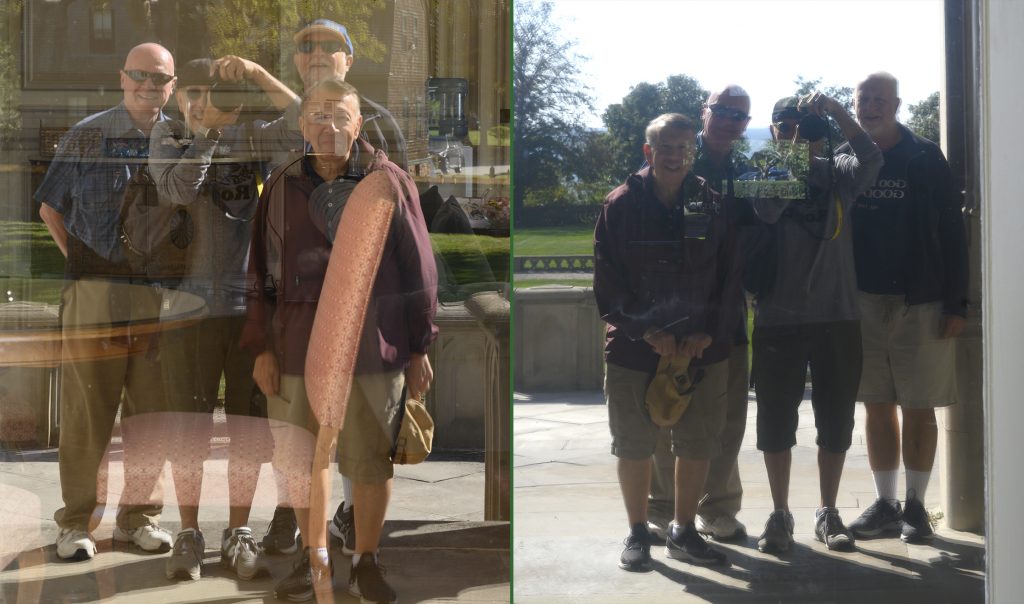

Saturday morning Greg, Paul, Bobby and I headed over to Newport. In the image on the right and going L to R – Bobby, Greg, me and Paul; we’re on the grounds of Salve Regina and walking around the Ocre Court mansion – the main administrative building. The two images were shot against the massive mansion windows. (Ochre Court is a large chateau-like mansion. It was commissioned by Ogden Goelet, a New York financier (robber baron), and built at a cost of $4.5 million in 1892. It is the second largest mansion in Newport after the nearby Breakers.)
The Newport Bridge, like us, was also celebrating its 50th. (I remember it being a big deal when it opened back in 1969. Narragansett is across the bay from Newport and we practically watched as the new bridge was going up.)
Salve’s 80-acre historical campus, bordering the Newport Cliff Walk, is set on seven contiguous Gilded Age estates with 21 structures of historic significance. And the college has weathered the transition from Catholic, all-girls school to co-ed, modern university. It’s also dear to the hearts of the four of us, because our Theology teacher during the Novitiate, John Greeley, taught here and our Director of Novices – John Veale – ran a house of prayer on campus. (Bobby pointed out where John’s office had been and Greg pointed out the building where he had spent a summer with our Director at the house of prayer.)
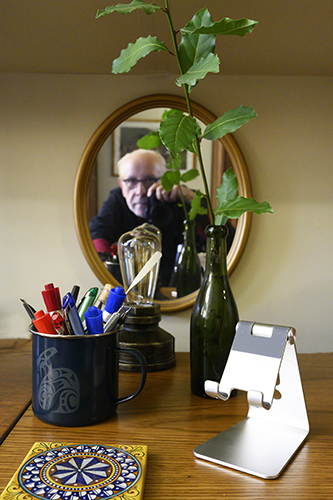

The last week had me fly to Northern Ontario; visit with my mom; meet with her rehabilitation team; deal with the first snow-storm of the season; negotiate the roads and streets of a town drenched in six-inches of snow; visit with Franchino; and finally come home.
I was totally unprepared for the weather. WTF, it’s early November. (my only concession was to bring a knit, in-between Canada Goose jacket. and even with that, I risked being mocked by the ‘manly’ Canadians.) Besides the snow, it was freezing. Parking lots and streets were treated with sand, it was too cold for salt. And by the afternoon, walking anywhere meant sloshing through dirty, sand covered melt.
The image on the right came about because I was pruning the bay-leaf I had brought in for the season. Didn’t want to throw away the stem I had cut, so decided to put on my desk as counter programming to the coming of winter.
The Objects
– tile from Deruta that I use as a coaster
– tin cup is from the gift-shop at The McMichael in Kleinburg, Ontario
– light-bulb-and-base is an industrial table-lamp
– oval mirror is IKEA’s best
– bay-leaf stem
– glass bottle – truly vintage (it comes from Paul’s grandparents’ house in Wilmerding, PA)
– and a brushed-steel cell-phone stand
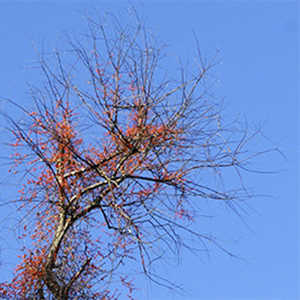
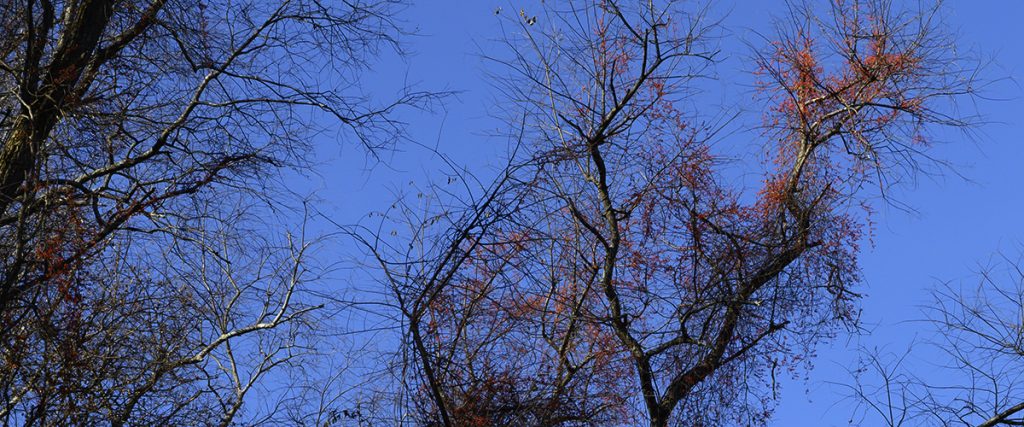
In contrast to the gloom of Northern Ontario, today the skies were brilliant (even if pittsburgh is the fifth gloomiest place in the lower 48). And even though it’s November – the month of the dead – and even though we’re racing towards the winter solstice, having a sunny day helps to neutralize, helps to balance the gray.
The above image is from my walk in North Park. My favorite route is up Walker Road and once off the hill, south along Lake Shore Drive to my car.
Many of the bare trees along Walker Road are draped in vines full of orange berries. (i don’t remember as many berries last year.) I kept thinking – is this a harbinger of a bad winter? is nature providing for its creatures in what may be a long dark season?
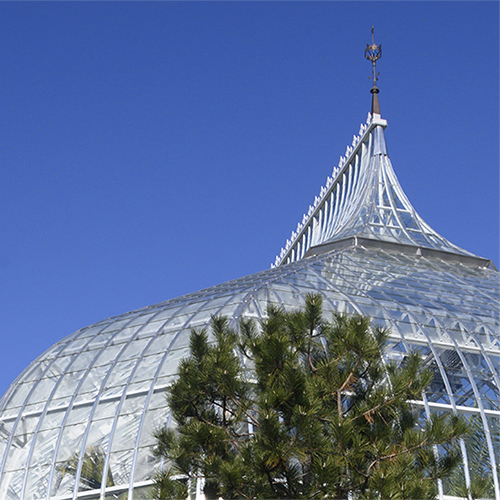
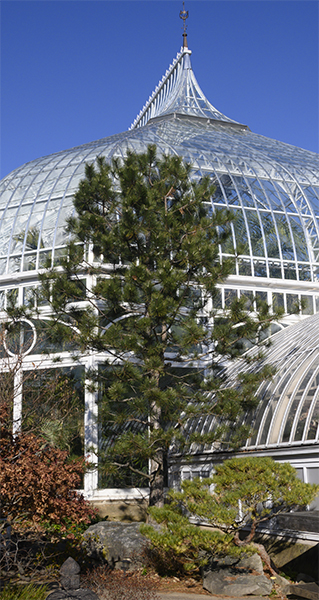
Tuesday, September 26, 1950
Saturday, September 16, 2017
I hear the drizzle of the rain
Like a memory it falls
Kathi – my friend Tom’s wife – moved back to Pittsburgh back in September and today, we spent the morning walking through Phipps Conservatory. The Winter Flower show was beautifully pretty.
And talking with someone who lived with and loved a dear friend was a restorative experience.
And from the shelter of my mind
Through the window of my eyes
I gaze beyond the rain-drenched streets
I wanted to know about Tom’s end-of-life and Kathi was amazingly generous and honest.
Tom died two years ago and I’ve been trying to write an in memorium for him ever since. I think today, after spending the time with Kathi, I can write about Tom.
My mind’s distracted and diffused
My thoughts are many miles away
Tom and I were friends from our time at the Novitiate in Narragansett. The friendship was forged in the winter of 1968/69. One of my favorite memories of that time is of a bunch of us going out walking, after a huge snowstorm, through the fairways of the golf-course that surrounded the Novitiate property. I got stuck in a snow-drift and Tom lay down flat on the surrounding snow and reached over to pull me out of the mound. (who knew that a kid from Queens, could conquer 10 feet of snow.)
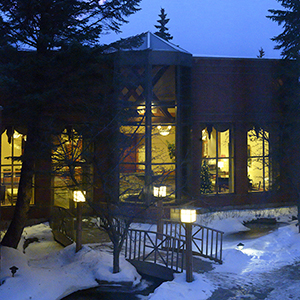
This was both a familiar and an unusual Christmas in Sault Ste Marie.
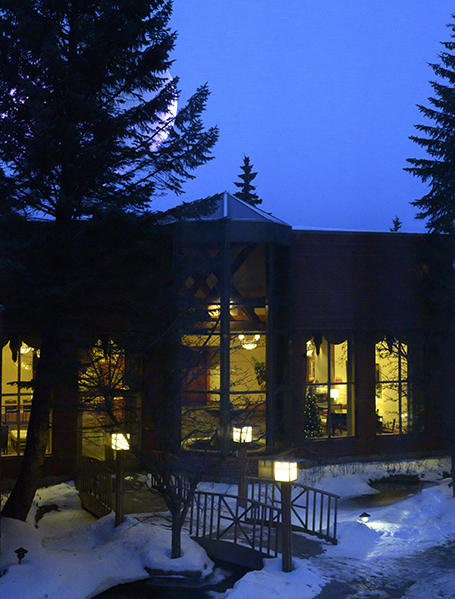
The familiar
– Christmas Eve dinner was at my uncle-and-aunt’s and it consisted of the traditional dishes.
– Christmas Day dinner was at my mother’s house. My sister created the same menu my parents have served the last 50 years. My brother-in-law and his family cooked and prepared the meal with my sister and my mother.
The unusual
– my mother, who now lives in a retirement home, was both a participant and a guest.
– I stayed at the Water Tower Inn during my visit. (the image on the right is the courtyard from my window.)
– never saw the sun the whole time I was visiting. It was wonderfully warm (as warm as Northern Ontario can get in late December), but gloomy.
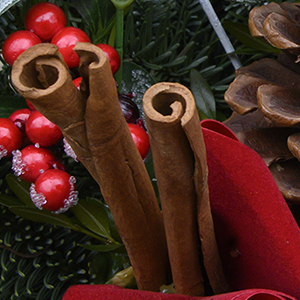
It’s different getting to your seventies and looking back – the focus is softer, the memory forgiving. 2

I’ve been emailing with an old acquaintance from when I was a monk back in the 1960s and it seems that the correspondence is slowly moving towards a friendship. What an unusual development. It’s certainly not what I had expected.
Reconnecting with someone you knew as teenagers is always a crap-shoot. You have no idea what life has done to them. Have they become adults in the time between; are they able to look at the intervening years and see a shared history or are they stuck on the mythology of the past? And, if the reacquaintance proves awkward – difficult even, is it OK to resettle that person back in memory?
The past is a different country; they do things differently there. 3
Exchanging emails with an old classmate has been a great surprise. In memory he was a brooding clairvoyant who seemed to see much more than he could contain; that made him both scary and appealing. And, as a snotty teenager, I focused on the scary and repressed the pull to get to know him.
Fifty years later, I’m discovering a kindred spirit – a thinker, a hard worker, a self-made man, a responsible adult, a dad, a husband, a son-in-law, maybe a friend.
What a curious situation to find myself in …
So why the pic of the wreath on the gray-washed door?
The picture has the two elements that I’m struggling with – background and foreground – memory and clarity. The door is an old design, with age-old patina and classical hardware, the wreath, with its withering greens and garish ribbon, is 2019. And yet the two elements exist in alignment, in proper arrangement; they compliment each other.
They make a great visual composition.
1 – Dougie MacLean. Auld Lang Syne. 2014.
2 – It’s my 71st birthday.………………………….
3 – Hartley, L.P. The Go-Between. 1953.
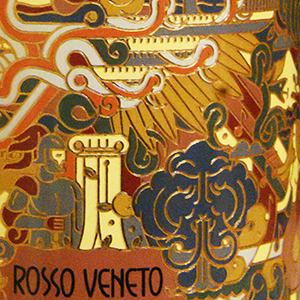
The holidays insist on lavish and traditional meals. And this is true both in Sault Ste Marie at my uncle-and-aunt’s and at my mother’s as well as here in Pittsburgh. The New Year’s Eve meal here in town, that we’ve come to call ‘the all meat dinner,’ had 8 different dishes. It’s been a month of big dinners.
Tonight, I wanted a simple meal – rapini sautéed in olive oil and seasoned with garlic and hot pepper flakes, a sharp Australian cheddar, a crusty baguette and a glass of Chianti.
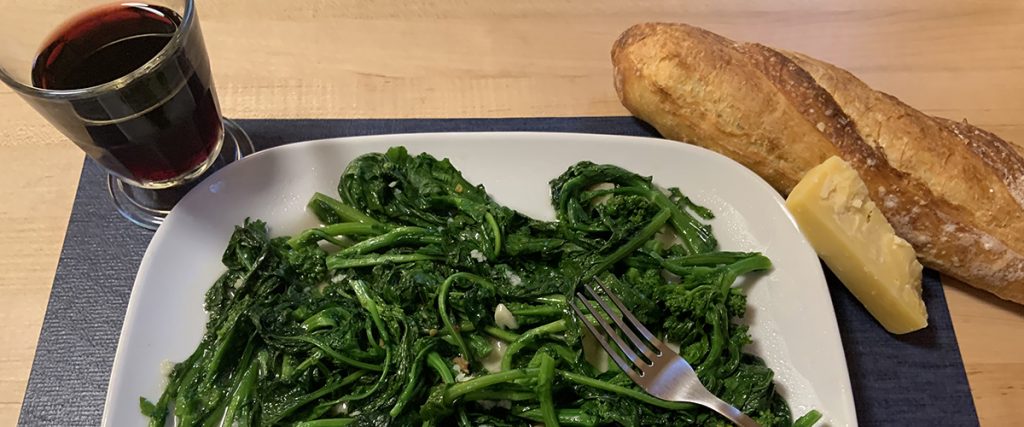
I’ve been forced into a transition – a shift away from a hard-copy newspaper. For years, I’ve been getting the New York Times daily and I read half of it with breakfast and half with dinner. Well, this week the paper hasn’t been there in the morning. To compensate, I moved my laptop to the kitchen and began reading the Times online. (i miss turning the pages – yeah, yeah i know – turning pages is so 20th century)
Also, since my November visit to Sault Ste Marie, I decided to have a glass of wine with my dinner. (in the past, i would have wine with meals only when visiting with my immigrant family and friends or if i went out to dinner) This shift was prompted mainly by my uncle’s discovery of the Spadafora Winery’s Terrano Rosso. Its grapevines run the south-west side of the mountains that Aprigliano sits on; and this Rosso is exceptional. (i was born in aprigliano/cosenza, many moons ago) And thanks to LCBO online – Liquor Control Board of Ontario – I was able to order a case and it’s waiting for me at my cousin’s. (my uncle is great at discovering new wines and the LCBO brings in many calabrian wines that he judiciously samples) In the image below, the Terrano is the second from the left.

The Prosecco – far left – is from the Prosecco Hills of Conegliano e Valdobbiadene a UNESCO World Heritage Site, north-west of Venice. This bubbly was the inspiration to go back to northern Italy this coming May. (i’m saving this last bottle for when my friends move into their new condo) The Terrano, besides its low tannins and its home-town appeal, I’m keeping until I can retrieve my reserves from my cousin’s. The Appasimento is another Venetian; this Passito Rosso is full-bodied with a 14% ABV – alcohol by volume. My fellow immigrant from San Giovanni in Fiore introduced me to this hardy red. (it’s my only bottle, so until i can get more it’s gonna sit and look pretty, i love the label) And lastly the Chianti with its classic fiasco bottle wrapped in raffia, it’s imported into Pennsylvania by the Emilio Pio Group of California. (the prosecco, terrano and appasimento are from the LCBO, the chianti is from the PA state store)
Both of the above images were shot with my phone camera.
The featured image – not shot with a phone camera – is the label on the Appasimento bottle.
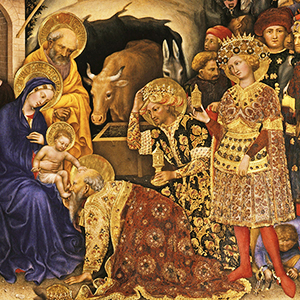
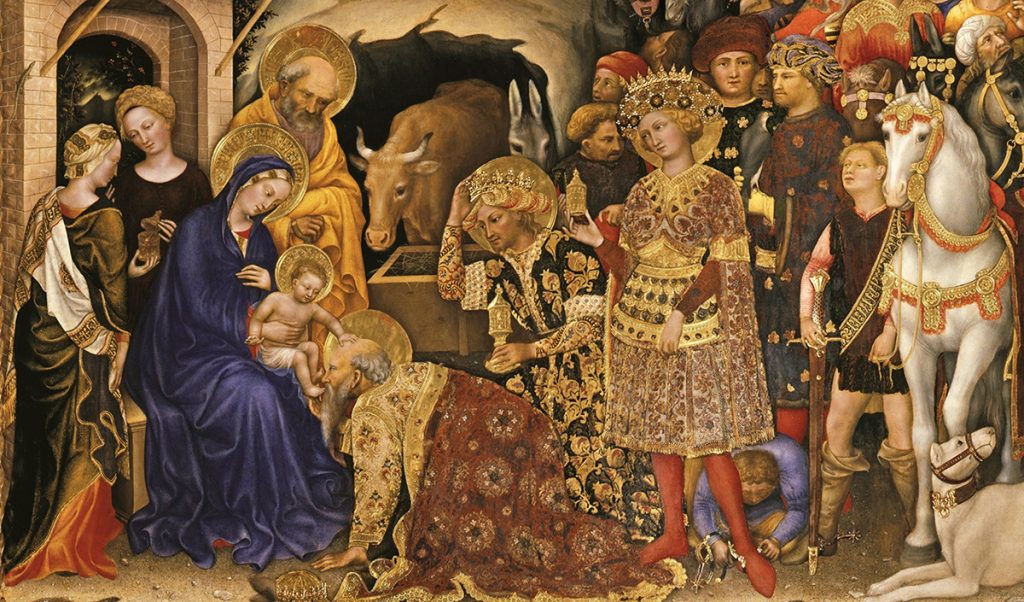
The image is a fragment from Gentile da Fabriano’s Adoration of the Magi.
The altarpiece is housed at the Uffizi.
I like the palette – the golds, the dark-blues, the yellows, the rich browns. But the fact that the Magi look like Renaissance Florentines, in extravagant dress, just heightens my disdain of the 1%ers and my antipathy for Holy Mother Church.
The little boy, in the blue top and bending under the skirt of the third king, is removing the regent’s spurs. Don’t we all want a lackey following us around and bending to remove unnecessary accouterments when we’re on our way to an important meeting?
And spurs can be so inconvenient and never mind how long I had to wait for that jeweler to make me something that matched the hose I had picked out for the meeting with them Jewish peasants.
The falconer behind the third king and above the little boy is Palla Strozzi who commissioned the altarpiece; and the young man on his right is his son Lorenzo.
Palla Strozzi was heard whinnying to a local TV anchor that he had no choice but to commission the painting, because his fellow Florentines didn’t believe that he was there in Bethlehem with the Three Kings.
And let’s not forget the two women behind The Virgin examining the gift presented by the kneeling king.
“Buff, it’s only gold-plated. It must be a re-gift.”
“Muff, they’re foreigners.”
In the 15th century, Palla Strozzi, one of the richest man in early Renaissance Florence, commissioned Gentile da Fabriano to paint the altarpiece for his family church of Santa Trinita.
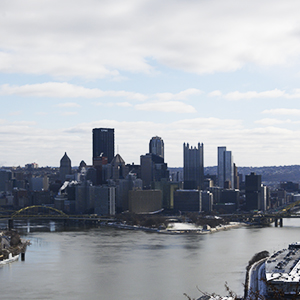

The last time I was at the West End Overlook was easily 30 years ago. It was my first visit to Pittsburgh and Jerry-and-Diane took us there. (jerry worked in the west-end and knew about the scenic overlook)
Where Mount Washington gives one the view of downtown from a southern vantage point, the West End Overlook faces east and directly at the downtown triangle with Point State Park at its vertex.
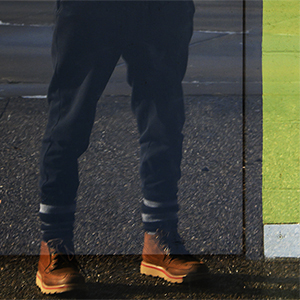
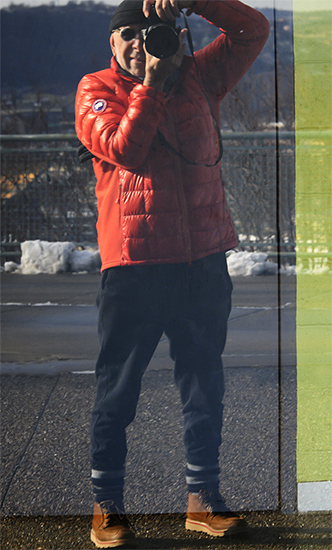
In Calabria, it’s still common to celebrate one’s Saint-day – onomastico. And today, being the feast of Saint Marius, many of my Aprigliano relatives sent congratulations. What a contrary experience – receiving best-wishes over social-media for a tradition begun some six hundred years ago.
The image on the right was shot in front of the glass windows of the West End Overlook visitors center.
And what I like best are the verticals and horizontals that live in the flat surface. (the only rounds are the glasses, the lens-face and the logo on the jacket)
It seems narcissistic and presumptuous to use a reflection as the image on a post about one’s Saint-day, but I like juxtapositions and I rarely take pictures of people and when I do, I default to reflections. (an old friend, who recently found my images, pointed out that i have many pictures of myself in mirrors) Glass and mirrors filter; they reverse; they distort; they reflect an unreality; they create a surrealism. (think orson well’s the lady from shanghai – rita hayworth in the funhouse mirrors)
With the thumbnail that leads to this post, I wanted to distort the selfie motif. And since the bottom of the original, with the tan snow-boots and striped socks, is my favorite detail, I made it the featured image. It continues the contradiction theme – this time going from self-promotion to anonymity.
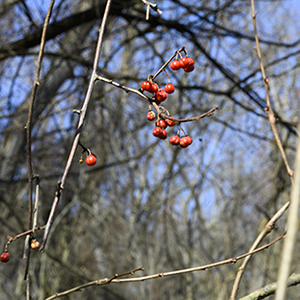
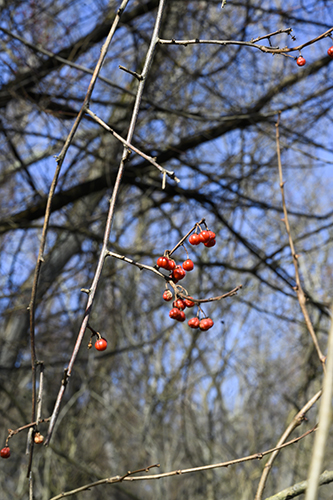
Being Calabrese, I’m very susceptible to superstition – there’s a lot of my maternal grandmother – Marietta Perri – in me. Hockey players may have the reputation for being the most superstitious of athletes – lacing their skates a certain way, putting on their equipment in a particular order, wearing the same underwear each game – but let me tell you, they have nothing on us Southern Italians.
For example …
– I always put my car key into the ignition button-side forward. It obviously insures that the car will start.
– My shoes are always lined up in a particular order because random invites evil.
– I always wait for an odd-numbered time to get out of bed, because rising on an even-numbered time could totally wreck a day.
– And all my journal entries have odd-numbered time signatures. Some of the best times are 1:03, 5:13, 7:17, 9:59, 11:11, but the most auspicious is 3:33.
And I blame it all on my grandmother and my Roman and Greek ancestors.
With that set-up, you can understand why writing this post is scary. I worry that if I make any reference to a short and mild winter, the weather gods will summon the snowstorm from hell; or for laughs-and-giggles, conjure an arctic vortex and bury us in a deep freeze until April. And I know no prayer or offering I can make that could entreat leniency.
My grandmother could counter the curse of the malocchio – the evil eye – and her fellow immigrants came from near and far to have her minister to them. But she never taught me her secrets, so I remain captive to my unjustified beliefs and their hallucinatory consequences.
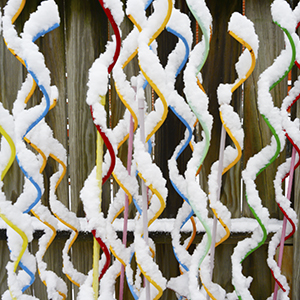

The first week of February brought the first significant snowfall. That is the best.
Winter 2019/2020 has 89 days and today is day 47. We made it through the first half of the season without snow. Also, today’s snow is a wet-spring-snow and will probably be gone in the next couple of days.
Wet-spring-snow always reminds me of March days in Sault Ste Marie, when we would chase the last snows of the season on the cross-country trails. Skiing in March required specialty waxes and I can still remember the drudgery of waxing skis just to get another run before the woods would be drowned in mud from the retreating melt.
No-wax skis were useless in heavy, wet snow and we were forced to abandon the new technology for the true and tried elbow-grease of old fashion waxing.
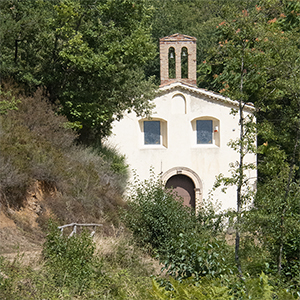
I left Aprigliano when I was 8 and at that age you don’t get to hear all the stories that define a place.
The small hilltop town southeast of Cosenza is organized around its parishes; my family lived in the Santo Stefano parish and neighborhood. A recent online posting explained the origin of the ‘special’ saint associated with the parish of Santo Stefano. For the families of the parish, La Madonna di Porto Salvo was our patroness. Her feast day is September 11 and the ensuing celebration was as huge an event as Christmas. I remember the procession to bring the statue from its small chapel in the woods east of town and the installation of La Madonna in our parish church. The next couple of days the main street in Santo Stefano was lit with luminara and under the lights street vendors hucked toys and foods; I tasted peanuts for the first time at one of these feste.
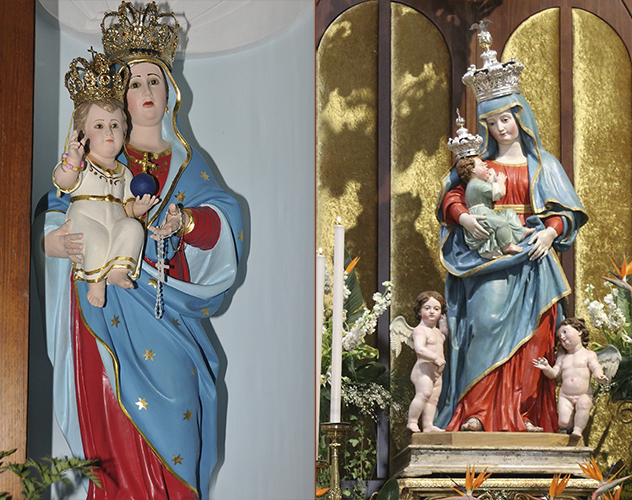
On an online post, a person from Aprigliano explained that the Madonna di Porto Salvo was established as a response to the 1854 earthquake that supposedly spared the parish of Santo Stefano.
Earthquakes were a preoccupation of everyone in town. And I guess that when you live in stone buildings – structures that are all interconnected – seismic shifts are things to be greatly feared.
In the above composite, on the left is the Madonna di Porto Salvo and on the right is the Madonna del Pilerio in the cathedral in Cosenza. The feast of the Madonna del Pilerio is February 12.
I suspect that the prototype for the statue of the Madonna di Porto Salvo was the statue of the Madonna del Pilerio. Aprigliano is a suburb of Cosenza, the provincial capital.
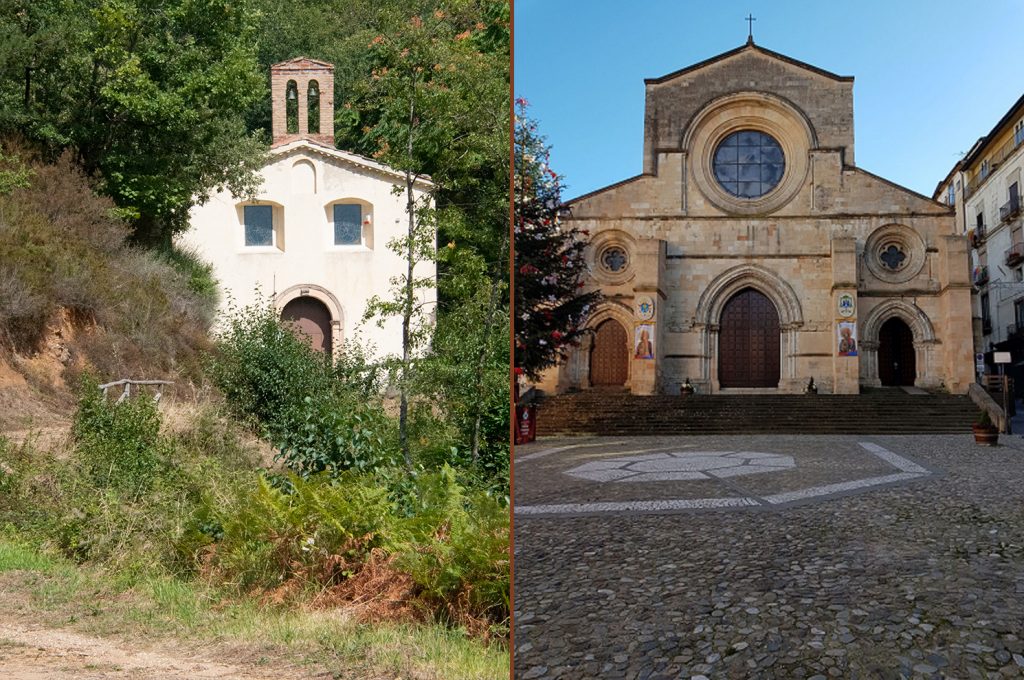
In the composite above, on the left is the small woodland chapel of the Madonna di Porto Salvo and on the right is the cathedral in Cosenza dedicated to the Madonna del Pilerio.
It’s taken almost 70 years to fill-in-the-blanks.
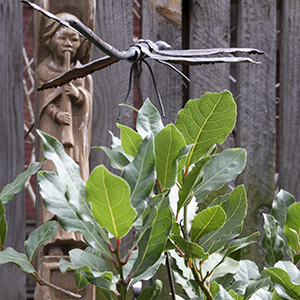
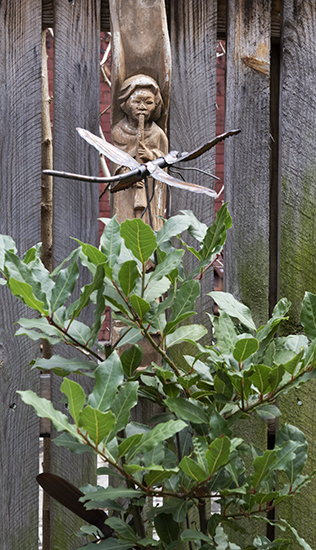
It may be the beginning of spring here in Southwestern Pennsylvania, but damn is it cold outside.
Many, in this part of the country, have re-calculated the seasons:
– winter spans the time between Thanksgiving and Valentine’s Day
– spring goes from February 14 to Memorial Day
– summer begins the last Monday in May and rolls on to Labor Day
– fall starts in the early weeks of September and ends with Thanksgiving in November.
But if today was our ‘over-the-hump day’, we were all being laughed at by the weather gods that live in them there clouds.
Also, I’ve been trying to figure out a correlation between latitude/longitude and highs/lows and it’s clear that many factors contribute to temperature and geographic coordinate are not necessarily great indicators of warm or cold. What follows is a list of four cities, I’ve tracked today.
– At 40o North Latitude, Pittsburgh is the southern most city of the four. Today’s low was 12.
– At 43o North, Toronto is the next southern most city and its low today was 15.
– At 44o North, Saint-Émilion, France had a low of 38 this morning – go figure. This southwestern French town made it onto the list, because I follow a couple of British expats who run a vineyard – Clos Vieux Rochers – outside of town. And their recent photographs show a region free of snow or they record activities – pruning, laying cement – I associate with mild spring temperatures.
– And finally at 46o North, Sault Ste Marie registered a low of 11 this morning.
Saint-Émilion is the outlier and I want to know why.
The image is my bay-leaf plant with its copper dragonfly hovering above the green leaves. The temperature was freezing, but the sun was shining, so I took the pot outside, positioned it in front of the angel and photographed it. I wanted to pretend that, on my favorite holiday, winter was on its way gone.
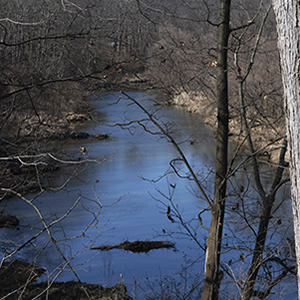
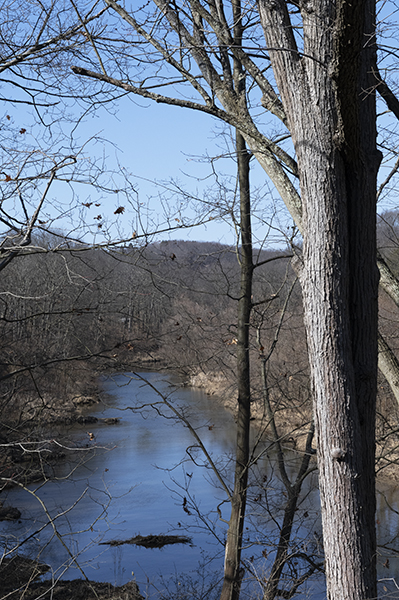
You could see how at the end of each day the world seemed cracked open and the extra light made its way across the stark trees, and promised. It promised, that light, and what a thing that was. As Cindy lay on her bed she could see this even now, the gold of the last light opening the world.
The quote is from Elizabeth Strout’s new book Olive, Again.
Today the sun was brilliant and I walked up Walter Road and then along the eastern shore of the man-made lake at North Park. Elizabeth Strout’s quote flashed in my mind as I shot picture after picture of the blue sky and the blue waters. The image is of Pine Creek as it flows into the artificial lake that is the heart of the park.
I’ve never paid much attention to the vagaries of February; never knew that there was such a thing as February light. And yet for the last couple weeks, I’ve been amazed to find it still light at 6:00 pm; to see the snowdrops sprouting in my back flowerbed; to discover the lenten-roses full of buds; to see the robins chasing each other.

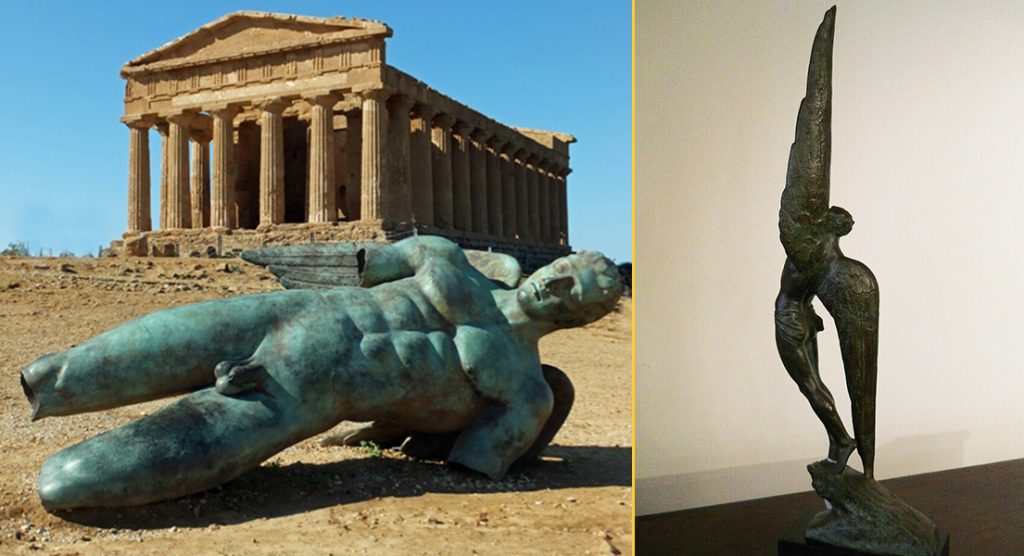
Flying too low is even more dangerous than flying too high,
because it feels deceptively safe.
Three version of Icarus are represented in this post:
– the thumbnail, featured image on the homepage is Henri Matisse’s Icarus painted in 1947
– in the above composite, the left image if from the Valley of the Temples in Sicily and the fallen Icarus is from ancient Greek
– and the image on the right is Pierre Le Faguay’s Art Deco sculpture of Icarus created in 1928.
In myth, Icarus is Daedalus’ rule-breaking and tragic son.
Literary interpretation found in the story the structure and consequence of over-ambition.
In psychology there have been synthetic studies of an Icarus complex – an alleged relationship between fascination for fire, high ambition, and ascensionism. (love the word) Psychiatrists saw disease in the ecstatic-highs and depressive-lows of the complex an illness similar to bipolar disorder.
Seth Godin’s 2012 The Icarus Deception points to the historical change in how Western culture both propagated and interpreted the myth. Everyone knows that Icarus’s father made him wings and told him not to fly too close to the sun; he ignored the warning and plunged to his doom. The lesson: Play it safe. Listen to the experts. It was the perfect propaganda for the industrial economy. What boss wouldn’t want employees to believe that obedience and conformity are the keys to success?
But Godin also argues that “we tend to forget that Icarus was also warned not to fly too low, because the seawater would ruin the lift in his wings.”
In the composite, I put the fallen hero first; so that in reading left-to-right, you see a young man getting ready to leap last. It’s the strategy of putting the most important element at the end.
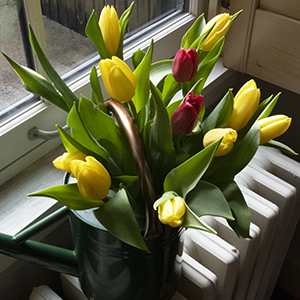

It’s the interim between the End-of February, Daylight-Savings-Time and the Spring-Equinox. It’s the interregnum between Winter’s icy grip and Spring’s opening fist.
It’s the day after Super Tuesday and Senator Sanders didn’t see the swell of new and young voters running to his cause. Rather it was the old Democratic voters who turned out in record numbers to vote for the other ‘old man’ – Joe Biden.
Jon Meacham, presidential historian, made some amazing comments about what happened on on Super Tuesday.
The tulips are in a watering can on top of the radiator.
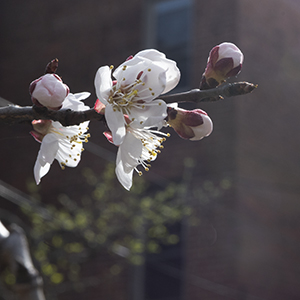
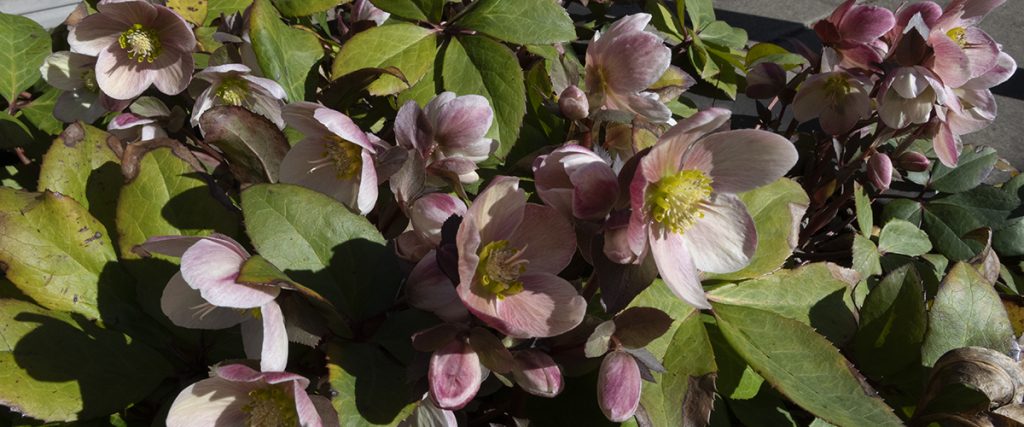
For three long years, the country has tolerated, has showcased an administration that has repeatedly told lies and now when we are confronted with a pandemic we’re insisting that the same people who’ve been lying to us turn on a dime and tell the truth.
I am one of the people who believes that MSNBC and Fox News are equal partners in propping up the lying. Just because MSNBC scolded and was outraged for 3 years, the network never stopped covering the lying. Every one of their shows was about the lying.
The New York Times, The Washington Post, The Wall Street Journal covered the lying every day. In the last 3 years more ink and more newspaper was used to keep the lying on the front-page, above the fold.
Every comedian from Stephen Tyrone Colbert to Trevor Noah, to Bill Maher made the lying the centerpiece of their show.
It’s been the trump-show 24/7 for 3 long years. And all media profited GREATLY from this focus – chiching, chiching!
And now we’re tired; we’re bored; we’re scared. Now we’re in crisis and we want someone to tell us the truth; we want a new show … good luck with that.

they lay down beside me, i made my confession to them
…..

Oh, the sisters of mercy, they are not departed or gone
They were waiting for me when I thought that I just can’t go on
And they brought me their comfort and later they brought me this song
Oh, I hope you run into them, you who’ve been traveling so long
Yes, you who must leave everything that you cannot control
It begins with your family, but soon it comes around to your soul
Well, I’ve been where you’re hanging, I think I can see how you’re pinned
When you’re not feeling holy, your loneliness says that you’ve sinned
Well, they lay down beside me, I made my confession to them
They touched both my eyes and I touched the dew on their hem
If your life is a leaf that the seasons tear off and condemn
They will bind you with love that is graceful and green as a stem
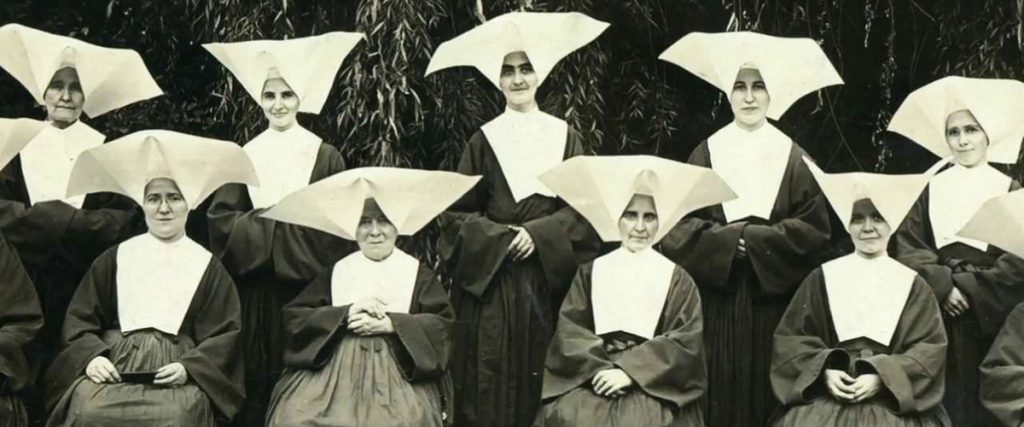
When I left they were sleeping, I hope you run into them soon
Don’t turn on the lights, you can read their address by the moon
And you won’t make me jealous if I hear that they sweetened your night
We weren’t lovers like that and besides, it would still be alright
We weren’t lovers like that and besides, it would still be alright
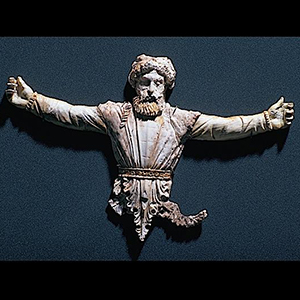
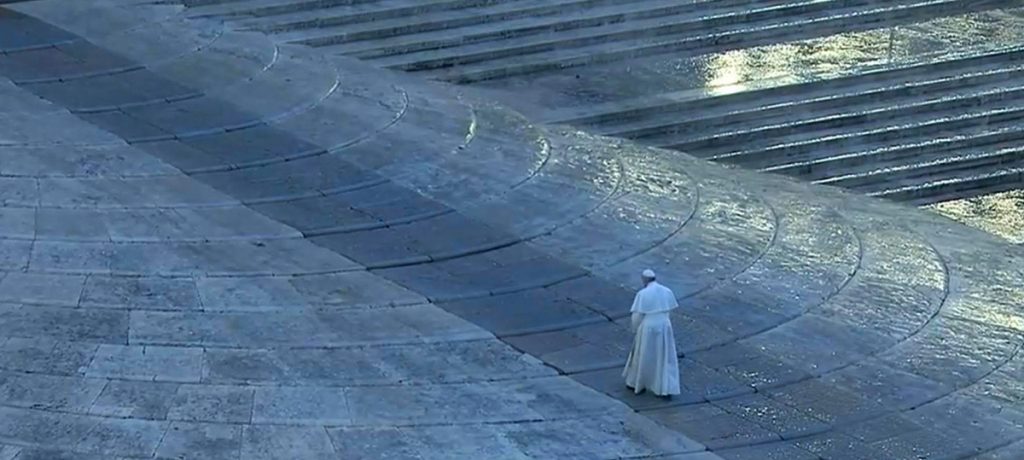
The image is of Pope Francis, in Piazza San Pietro, walking up the rise to the outside podium on the evening of March 27. An empty piazza, rain washed steps, a pope alone in a time of plague.
It’s strange for me to use this image, but I know what that space looks like, having been there with thousands, and to see it empty, shimmering and blue let me get over my own prejudices.
In this time of plague
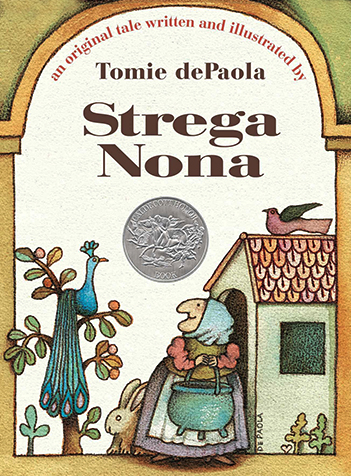

In a town in Calabria …
Today is the feast of San Francesco di Paola – St. Francis of Paola – the Calabrese mendicant friar and founder of the Order of Minims. He is the patron of Calabria, and because Paola was an hour away from my hometown of Aprigliano, my family made the trip several times.
My most lingering memory of Paola is a day-tip with my dad and our cousin Za Peppina – Aunt Josephine. We went to the beach. And among the various entertainment, there was a vendor, who for a small fee, would take you out to the outlying rocks on his wooden rowboat. I refused to go, but my dad went and when the small wooden boat disappeared in the swell of the wave, I was convinced the boat and my dad were lost forever. (was it a lack in object permanence development or a lack of knowledge of waves?)
Also Tomie dePaola, the American writer and illustrated who created the children’s book Strega Nona, died on March 30. His Italian grandparents came from the city of Paola. The book begins with the endearing phrase – In a town in Calabria …
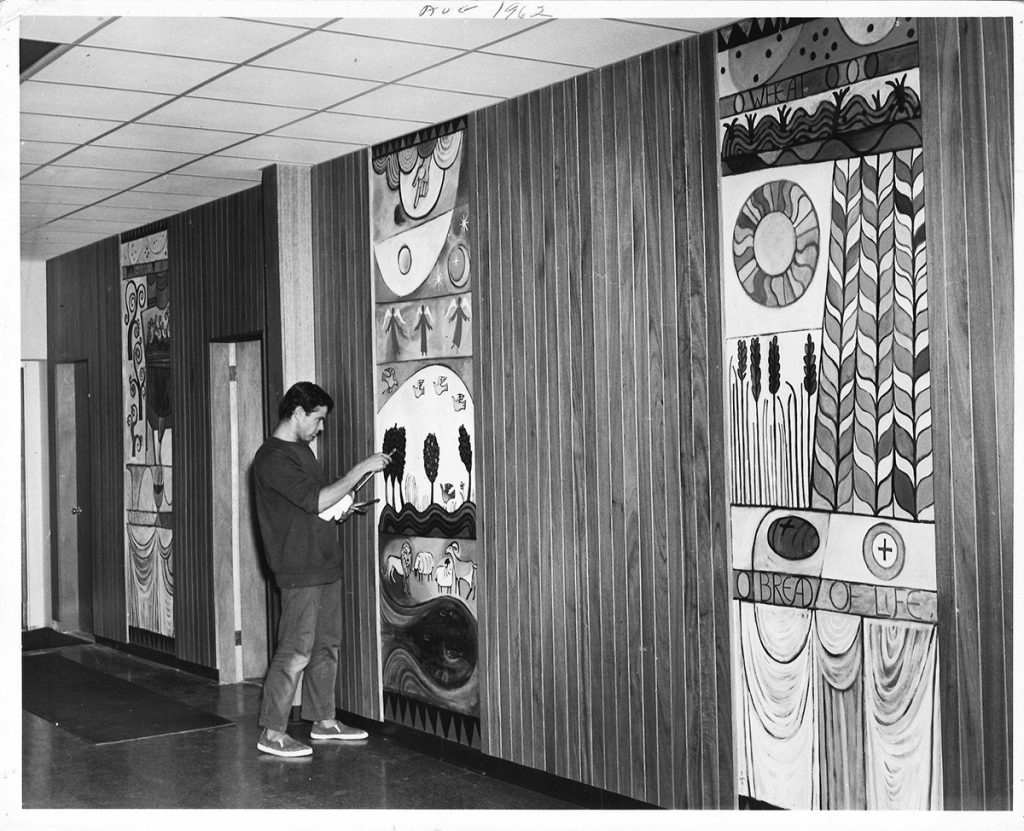
On the death of Tomie dePaola, the Glastonbury Abbey published the above image on its Facebook page.
The next paragraphs in this post are about my cousin.
My cousin and her husband live north of Detroit an area hit particularly hard by the COVID plague. And as a relief gesture, I sent her a copy of dePaola’s Strega Nona.
She came home from her walk in the subdivision to find an Amazon box on her front steps. She opened the box and saw the children’s book. Her first thought was that someone had hacked her Amazon account and her credit card account. She spent the next couple of hours frantically trying to contact both Amazon and the credit card company. She had no luck.
She went back to the box and after lifting out the book, noticed a piece of paper that had information saying that the book was a gift. She called and relayed the story.
My first comment was to suggest she not tell the story to anyone else. My second comment was – WHAT HACKER WOULD BREAK INTO YOUR ACCOUNT AND THEN SEND YOU A $15 CHILDREN’S BOOK? OMG!!!
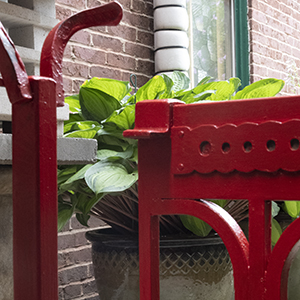
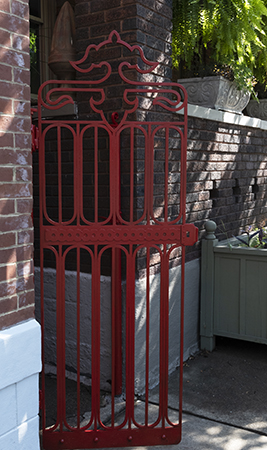
Haven’t posted since the beginning of April.
(Pennsylvania went into lock-down on March 16.)
Didn’t want to write during the quarantine mainly because everyone else was documenting the experience, and I didn’t think it needed another voice. After-all, I’m a retired 70-something – I have a pension; I don’t work, I don’t have to worry about rent; I don’t have to worry about health care ...
Yes, I learned how to Zoom and that has been fun. I even play canasta online with 3 Canadians – Frank in Toronto, Ron in Leamington and Brian in Markham.
…………………………………
So, what finally gotten me here?
The newly painted alley-gates – the above image is of the gate at the sidewalk; the featured image is of the back alley-gate. Both were designed and built by Steve Shepherd of Gilgamesh Forge up in Sharpsburg, Pennsylvania.
The above pic came after several tries. I’ve been shooting the front gate for the last 3 days and it was only this morning, when I went back to simply remove the lock so as to get only the gate in the pic, that I began experimenting. And, the result is the above image. It looks like something you’d find in Europe.
In the next paragraph, I’m going to reference Freud’s definition of uncanny – the class of frightening things that leads us back to what is known and familiar. (now tell me that isn’t a spectacular definition)
Let me begin by saying that I am terrible at picking a pallet from a set of color chips. Every time I’ve had to do this, I always picked wrong. (In the kitchen, it took three paint jobs before I got the right color. In the bathroom, there are paint splatters around the light fixtures that no where match the wall paint, but the bathroom is getting re-done, so it’ll get repainted.)
This inability to generalize from color-chips continued when I went to pick the paint colors for the wooden window-trims, door-frame, door and decorative cornices on the front of the house. The painters had to paint over the accent color I had picked. (For a couple of days, the front of my house looked like an Italian flag – OMG!!! – tacky to the max.)
However, I did pick the right color for the front-door and on a whim, I decided to have them paint the alley-gate the same red as the front-door.
And wallah, I got a red alley-gate.
Freud would refer to the serendipity as uncanny; I like his word better.
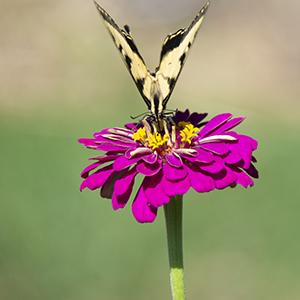
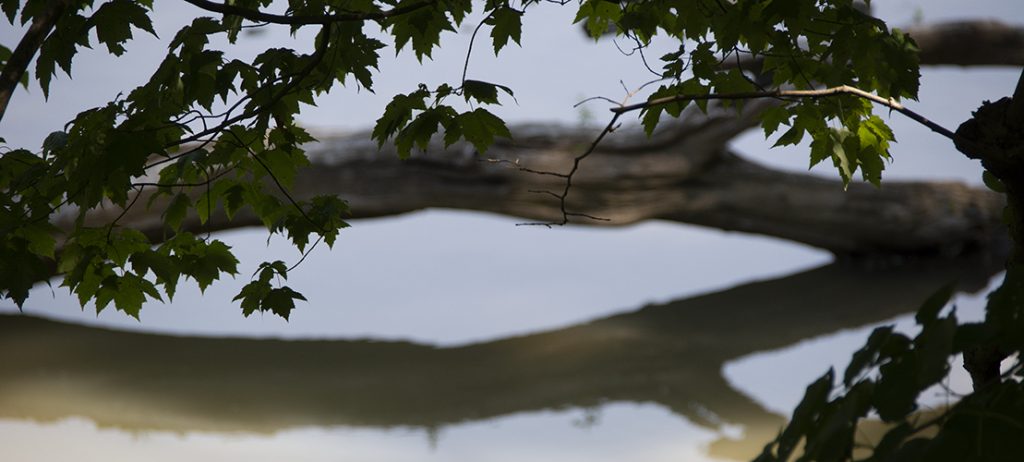
North Park was full of walkers – even an a morning when the mercury hit 87 before noon – and no one was wearing masks.
I got in a 2-mile walk before heading home.
The above image is of a fallen log – the reflection and haziness are what I liked best.
According to Amazon, I’ve reading non-stop since January 1, 2020. Don’t understand why that’s worth recording. And in the course of my reading, I’ve lifted the following quotes from the various books.
Nothing is impossible at seventeen. The world lays open like a giant buffet of possibilities. Seventeen is bulletproof. Seventeen is Superman with no kryptonite. Seventeen is fast cars, raging hormones, loud music and instant infatuation. Seventeen is fuckin’ amazing.
Time folds in on itself.
Tell me again how we fell in love.
It was during the smaller moments in our lives … and all the spaces in between.
He latched onto it, trying to anchor himself, only to be caught by an eddy of questions and suppositions.
For last year’s words belong to last year’s language
And next year’s words await another voice
TS Elliot
What is amiss, plague and infection mend.
Timon of Athens
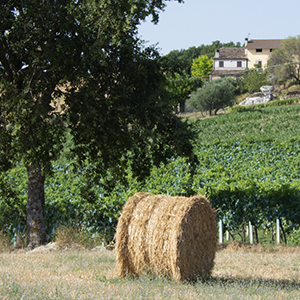
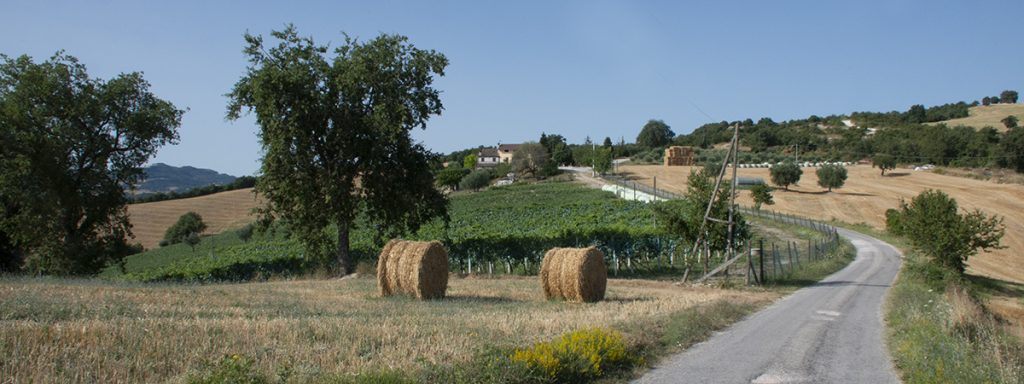
They were hiding behind hay bales
They were planting
in the full moon
They had given all they had
for something new
But the light of day was on them
They could see the thrashers coming
And the water
shone like diamonds in the dew
And I was just getting up
hit the road before it’s light
Trying to catch an hour on the sun
When I saw those thrashers rolling by
Looking more than two lanes wide
I was feelin’ like my day had just begun
Where the eagle glides descending
There’s an ancient river bending
Thru the timeless gorge of changes
Where sleeplessness awaits
I searched out my companions
Who were lost in crystal canyons
When the aimless blade of science
Slashed the pearly gates
It was then I knew I’d had enough
Burned my credit card for fuel
Headed out to where the pavement turns to sand
With a one-way ticket to the land of truth
And my suitcase in my hand
How I lost my friends
I still don’t understand
They had the best selection
They were poisoned with protection
There was nothing that they needed
Nothing left to find
They were lost in rock formations
Or became park bench mutations
On the sidewalks and in the stations
They were waiting waiting
So I got bored and left them there
They were just dead-weight to me
Better down the road without that load
Brings back the time when I was eight or nine
I was watchin’ my mama’s TV
It was that great Grand Canyon rescue episode
Where the vulture glides descending
On an asphalt highway bending
Thru libraries and museums
galaxies and stars
Down the windy halls of friendship
To the rose clipped by the bullwhip
The motel of lost companions
Waits with heated pool and bar
But me I’m not stopping there
Got my own row left to hoe
Just another line in the field of time
When the thrasher comes
I’ll be stuck in the sun
Like the dinosaurs in shrines
But I’ll know the time has come
To give what’s mine
Neil Young, “Thrasher,” Rust Never Sleeps, Reprise, June 22, 1979.
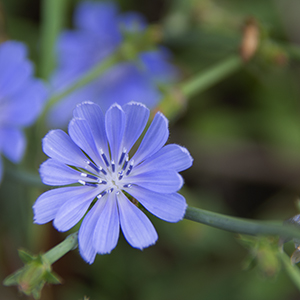
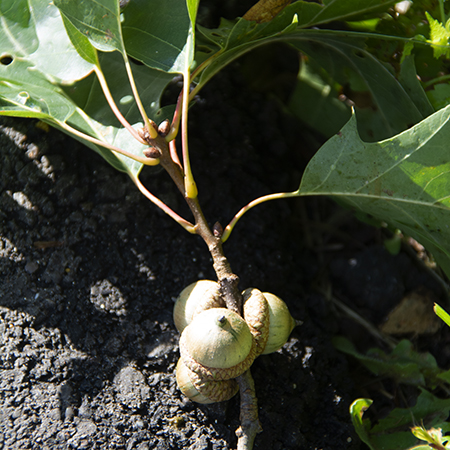
There are places I’ll remember
All my life, though some have changed
Some forever, not for better
Some have gone, and some remain
All these places had their moments
With lovers and friends, I still can recall
Some are dead, and some are living
In my life, I’ve loved them all
…
Though I know I’ll never lose affection
For people and things that went before
I know I’ll often stop and think about them
This morning, I went walking in North Park and the cool weather made it feel like fall; also, finding acorns on the ground reinforced the shift that’s coming.
And where shifts and change push us away from the present, push us further from the past, they are also occasions to remember what went before.


Rene and Georgette Magritte
With their dog after the war
Returned to their hotel suite
Easily losing their evening clothes
They danced by the light of the moon
To the Penguins, the Moonglows
The Orioles, and The Five Satins
The deep forbidden music
Rene and Georgette Magritte
With their dog after the war
Were strolling down Christopher Street
When they stopped in a men’s store
With all of the mannequins
dressed in the style
That brought tears to their immigrant eyes
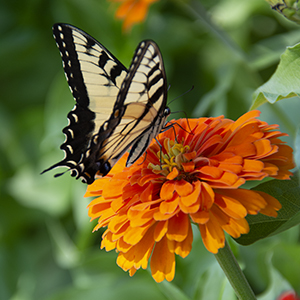
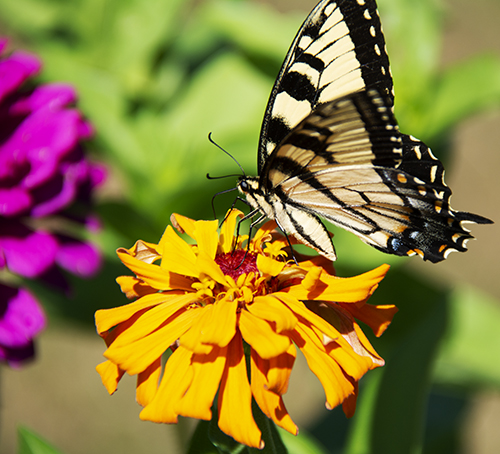
“It used to be thought that the events that changed the world were things like big bombs, maniac politicians, huge earthquakes, or vast population movements, but it has now been realized that this is a very old-fashioned view held by people totally out of touch with modern thought. The things that change the world, according to Chaos theory, are the tiny things. A butterfly flaps its wings in the Amazonian jungle, and subsequently a storm ravages half of Europe.”
Today, Joe Biden named Kamala Harris as his running mate.
Recently, Franchino and I have been talking about chaos theory, specifically the butterfly effect. I believe that when Dylan, on August 12, 1965, walked on stage at the Newport Folk Festival carrying an electric guitar, he was the butterfly who flapped its wings changing pop music forever.
In the last six months, something has occurred, something small – somewhere a butterfly has flapped its wings – and the world will be forever changed. I can’t identity the incident; it will probably take some time, some distance from the current chaos to be able to point to the event that was the butterfly effect of 2020.
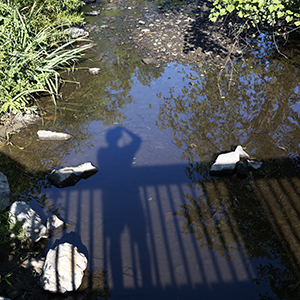
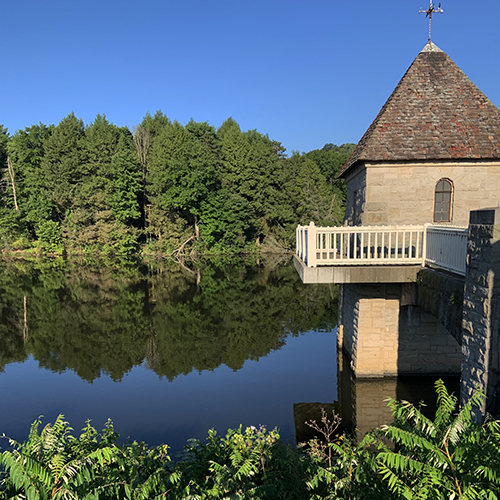
I will kill your friends and family to remind you of my love
The above quote is from Hamilton – King George singing about his relationship with the Colonies. (It’s such a Southern Italian sentiment.)
It also seems pertinent today with our own ‘mad king’ making threats – threats that he thinks sound normal. But many of his rants force us to acknowledge that we are are witnessing a leader deteriorating into mental illness at a time when our country is most in need of honest, and talented leadership.
Last night at the opening of the Democratic National Convention, Michelle Obama said the following:
So let me be as honest and clear as I possibly can. Donald Trump is the wrong president for our country. He has had more than enough time to prove that he can do the job, but he is clearly in over his head. He cannot meet this moment. He simply cannot be who we need him to be for us. It is what it is.
And the above pic is of North Park Lake. Morning light is amazing. When I came back around, an hour or so later, the contrast, the details were all bleached out by the late morning sun.
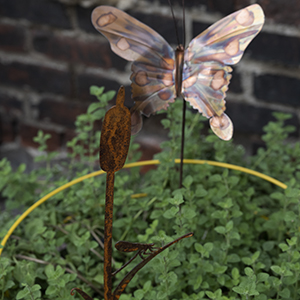
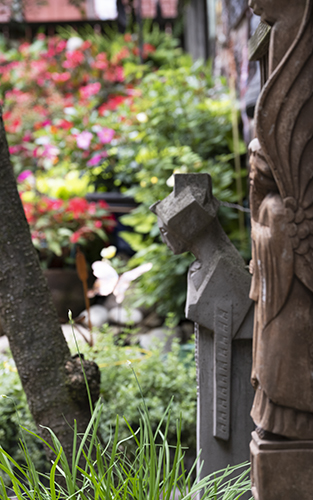
One of the things I like best about photography is its ability to define reality. Looking at the above pic, it’s easy to pretend that we are looking at some lush landscape. No, ur looking at my backyard.
The green shoots in the foreground are chives, the green in the background is my gigantic oregano plant.
The sacred–profane dichotomy is an idea by French sociologist Émile Durkheim, who considered it to be the central characteristic of religion: religion is a unified system of beliefs and practices relative to sacred things, that is to say, things set apart and forbidden.
In Durkheim’s theory, the sacred represented the interests of the group, especially unity, which were embodied in sacred group symbols. The profane involved mundane individual concerns.
Durkheim explicitly stated that the sacred–profane dichotomy was not equivalent to good/evil. The sacred could be good or evil, and the profane could be either as well.
The most amazing piece of the quote is that Durkheim saw the profane as mundane, individual concerns.
In the 21st century, on the cusp of a national election, we Americans must choose between the sacred and the profane.
BTW, people who know me will not be surprised by the following confession – I rarely use the chives and oregano to cook with, but I diligently keep them free of yellow, dried-out stems and rigorously prune for the right form. (Please – the chives and oregano plants are showcase worthy. The featured image for this post – the image on the homepage that links to this post – is the oregano plant.)
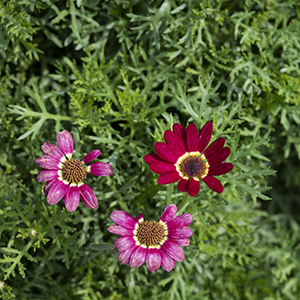
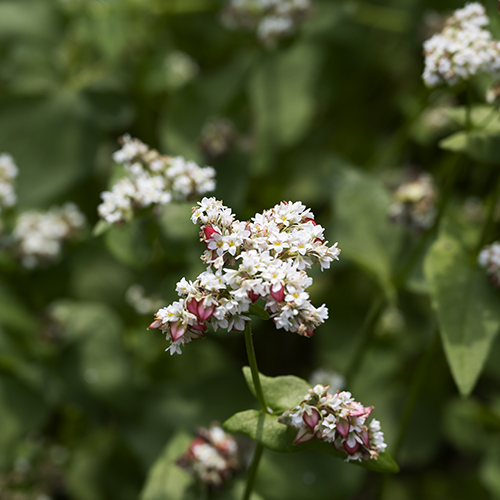
why do you stand by the window
abandoned to beauty and pride
. . .
lost in the rages of fragrance
lost in the rags of remorse
. . .
and come forth from the cloud of unknowing
and kiss the cheek of the moon
. . .
and leave no word of discomfort
and leave no observer to mourn
Sunday, Sarah and I did the 5-mile loop around the man-made lake in North Park.
The above pic is from the Demonstration Garden at Babcock and Ingomar. (I need to go back and get the name of the plant.)
Because I got some great shots at the Garden, I’m trying something new – embedding large images into a post. Pictures this large have always been reserved for the homepage slide-show or the galleries; I wanted to see what a post full of images looks like. (The Featured image on the homepage that links to this post is also from the Garden.)

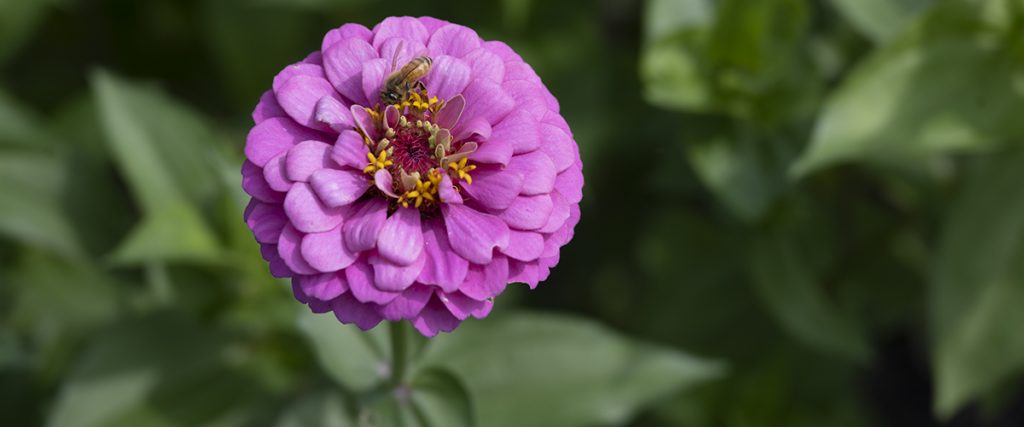
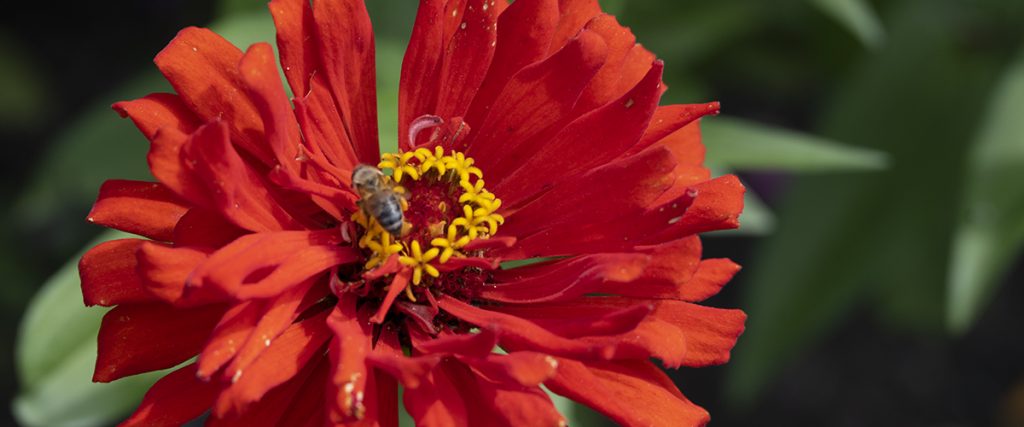
All I did was crop the three large images – 1200px X 500px.
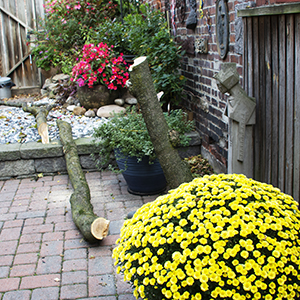

I always find it difficult watching playoffs and election results. And this time it was the election results that were spiking my anxiety into the stratosphere.
I had tuned off the TV last Friday, October 30. Couldn’t deal with the tension coming from the cable-news readers. And on election night, the best I could do was watch for a minute at 8:00, 9:00 and 10:00. And even that became an exercise in frustration, so the TV went off and stayed off.
But just because the ‘boob-tube’ was off that didn’t mean my anxiety was reduced or controlled. The thought of 4 more years of the ‘asshole’ was not a thought that settled me in any way; if anything it made me crazy. So, I decided that it was time to step away from the electronics and to tend to my garden. I was Candide returning from the New World of 24/7 cable-news and scattered social-media to the slower more practical reality of my backyard.
The lilac tree that has been part of my backyard landscape for some 30 years was badly diseased and needed to be cut down. So, Thursday morning I got my pruning sheers and my saw and began cutting it down. And by Friday afternoon, the contractor was taking out the stump.
The images below show the progression from bare trunk to removed root-ball.

The last four years have been my slow and painful disillusionment of the American culture I readily joined in 1968.
The novella begins with a young man, Candide, who is living a sheltered life in an Edenic paradise and being indoctrinated with Leibnizian optimism by his mentor, Professor Pangloss. The work describes the abrupt cessation of this lifestyle, followed by Candide’s slow and painful disillusionment as he witnesses and experiences great hardships in the world. Voltaire concludes Candide with, if not rejecting optimism outright, advocating a deeply practical precept, “we must cultivate our garden”.
And I too returned to my garden after the craziness of the last 3 days.

And then at 11:44 am, I started hearing people outside cheering and celebrating.
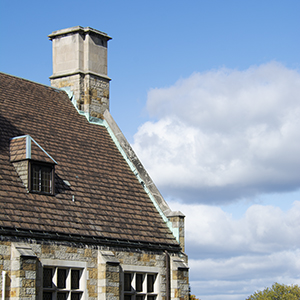
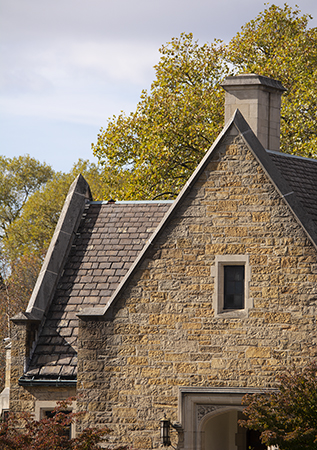
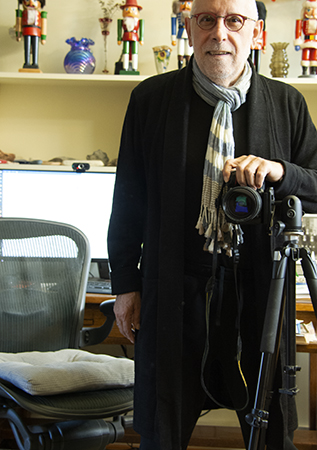
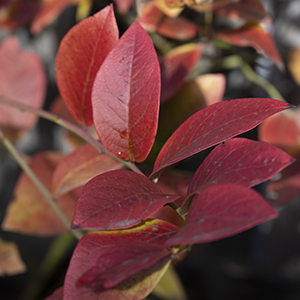
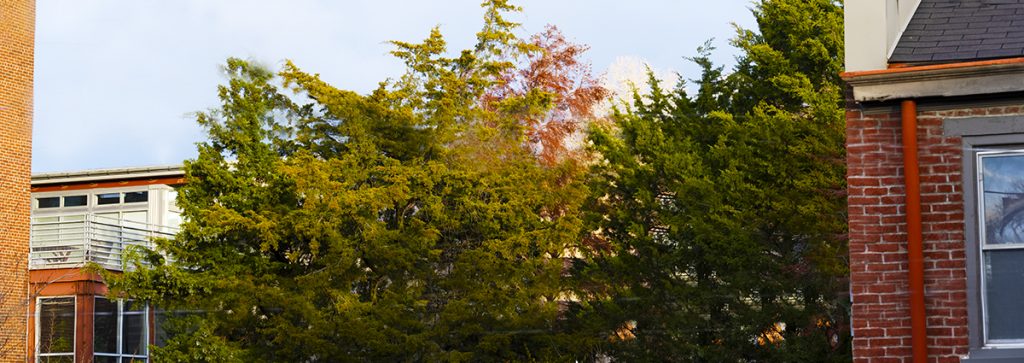
What I remember of that first Thanksgiving, back in 1968, in Warwick, Rhode Island …
Saturday morning, John and I drove into Providence to visit his uncle and aunt and, I remember seeing,
for the first time, three-story clapboard houses.
John’s uncle and aunt – his mother’s brother and sister – lived just down from La Salle Academy – the Christian Brothers’ highschool in Providence and John’s alma mater.
This morning the sun peaked over the rooftops landing on the red leaves of the trees in the garden of the Mattress Factory. It was an interesting effect. The above image doesn’t capture the brightness of the morning sky.
It’s a strange time in post-election, COVID-raging America. Yes, some 61% of people opted not to travel for Thanksgiving, but all college-students are returning home both for the holiday and for the semester. The rest of the world has no idea what Americans are doing traveling given the infection rate and an out-of-control virus.
And the Supreme Court ruled to temporarily block governors from applying mitigation efforts to gatherings at religious institutions. The crazies are cheering, because the Supreme Court is finally fighting for religious freedom – OMG.
Even the Pope seemed to disagree with the Court – Looking to the common good is much more than the sum of what is good for individuals. It means having a regard for all citizens and seeking to respond effectively to the needs of the least fortunate . . . It is all too easy for some to take an idea- in this case, for example, personal freedom- and turn it into an ideology, creating a prism through which they judge everything.


Last night, I watched an interview with Sidney Lumet. And one topic that he kept coming back to was – what happens to the children of radicals. Four of his films – Long Day’s Journey Into Night, Running on Empty, 12 Angry Men and Daniel – try to examine this disturbing topic.
Also, an amazing short – Tragedy In A Temporary Town – from his days in early TV, deals with what happens to a young man when there’s mob-rule. Lloyd Bridges, as the antagonist, is amazing.
All of this had me thinking of what has happened with the children of many of the ‘radicals’ of the current administration.
The Media and the Left have focused on the outrageous behavior of the out-going president; who will finally look-at/examine the tragedy, the abuse of what the adults, associated with the current administration, have brought on their children?
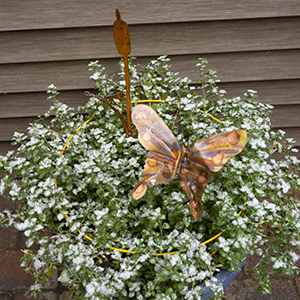
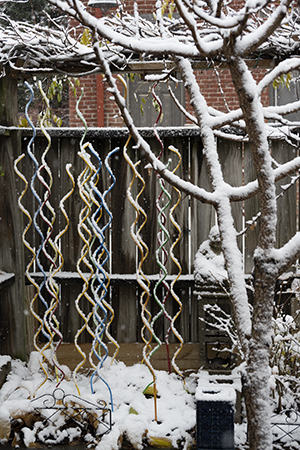
it came …
I’m having an absolute ball listening to Brian Muraresku’s The Immortality Key. The other day I was walking in North Park and laughing at his telling of the story of Persephone and Dionysus at the wedding feast. Muraresku makes some amazing statements …
Some Explanations
– today was our first snowfall
– the title is from Chim Chimney from Mary Poppins;
Up where the smoke is all billered and curled
‘Tween pavement and stars is the chimney sweep world
When there’s ‘ardly no day nor ‘ardly no night
There’s things ‘alf in shadow and ‘alfway in light
– the photo is of the various garden-posts clustered in the back-corner flowerbed;
– and the tag next to the pic is from the carol – It Came Upon a Midnight Clear.
Don’t ask what Mary Poppins, tomato stakes and a Christmas carol have to do with psilocybin, the Greeks and the Eucharist, because I don’t have an answer. But in my head these 6 topics all travel the same neurological pathways.
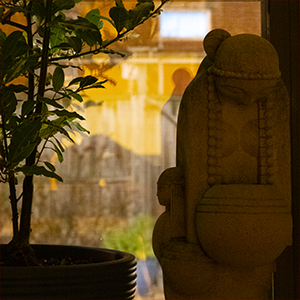
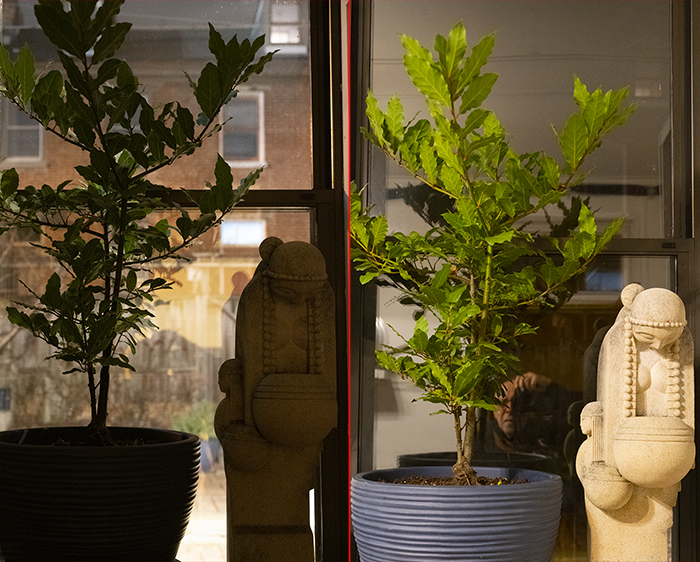
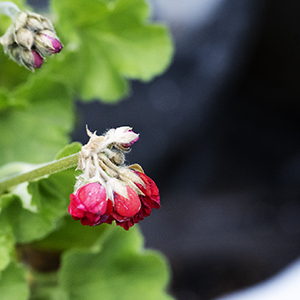
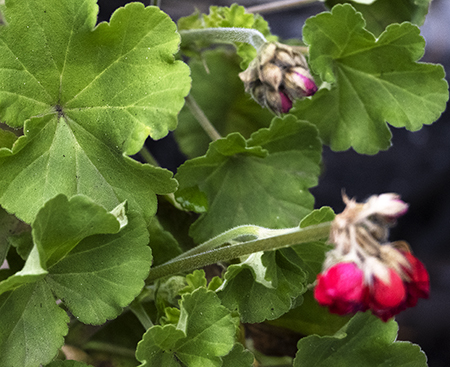
May the longest night and the shortest day,
bring rest to your mind and soul, I pray.
May you find guidance and may you find peace,
as the cycle of light will slowly increase.
Embrace the magic that the darkness bears,
breath deep in the chill and shift in the air.
May you always be blessed with the light from within,
and may well-being be yours as the new cycle begins.
The geranium is still alive – it’s been covered by snow for the last 5 days.
The Solstice Blessing was poster by JoAnne.
In the Featured image I tried to show the darkness and the light.
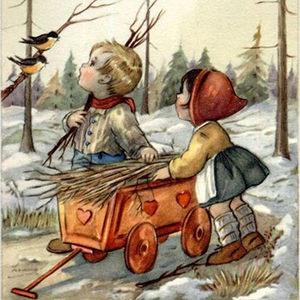

For the first time since 1968, I am not in Sault Ste Marie for Christmas.
I am at home.
1968
I’m living in Narragansett, Rhode Island and Brother John Veale, our Director of Novices, decided that we could go home on December 26.
(I did miss the two major holidays meals – the traditional Calabrese Christmas Eve meal and Canadian hybrid Christmas Day dinner.)
1977
Paul and I had decided to leave New York City and move to Pittsburgh. And given that it would be our last Christmas in the City, I decided not to travel for the holidays.
2001
My sister Jo’ had died at the end of June and I really didn’t want to be in Sault Ste Marie for Christmas. (We each mourn in our own way.)
Rick and Sarah suggested a trip to Israel and I was onboard.
(I remember calling my mother, on December 26 – the feast of St. Stephen – to tell her I was at St. Stephen’s Gate in Jerusalem. Our frazione/neighborhood/parish in Aprigliano was Santo Stefano.)
2020
The border with Canada is closed. Them Canadians are smart to keep us COVID deniers out; to keep us no-mask fools out of their country.
The Ontario government has issued a lockdown as of 12:01am December 26 – they are trying to prevent what happened in America after the Thanksgiving travel-and-spread.
I’ve been collecting Italian Christmas cards for years.
The image above is one of my favorites. Love its simplicity. The featured-image is another card in the same style.
Also, love being in my own home for the holidays; and I love not celebrating Christmas.
Are we finally able to define ‘family’ as something other than our DNA group; as something other than our husbands and wives?
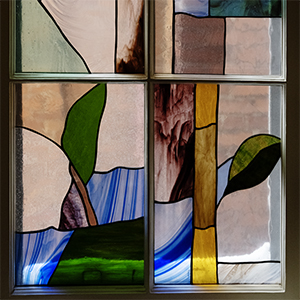
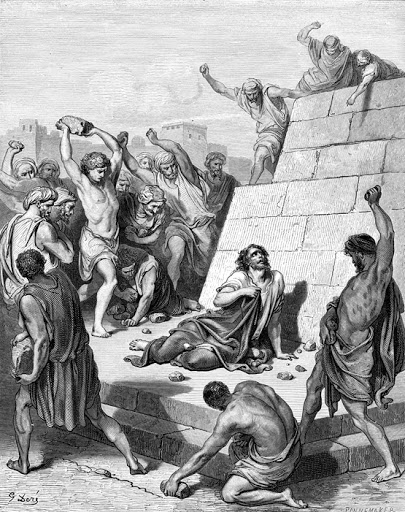
in aprigliano,
we lived
in frazione
santo stefano
Where in Canada today is Boxing Day, a leftover from British colonialism, in Italy this is the feast of Saint Stephen. All over the peninsula there are towns, and hamlets named for this so-called first martyr.
In Aprigliano, my family lived in the frazione/neighborhood/parish of Santo Stefano. We had moved up the hill once my grandmother and aunt left for Canada to join my grandfather.
We moved into what was my grandmother’s ancestral home.
– The term ‘ancestral’ is relative, especially when you consider it was two large rooms at the bottom of a wide staircase. But it overlooked the Crati valley and the mountains opposite – an outstanding view. The downstairs room had a window overlooking the mountains to the east; but the upstairs room had a balcony and a pergola; I used to love to sit and stare at the opposite hilltop; and in the fall eat the ripening grapes. (My mother claimed that the mountains were full of briganti – brigands, and 5-year old me believed her.)
– Also, there were no internal stairs. My mother tells the story of having to go outside and up the exterior steps to go to bed. My dad put in a set of inside stairs.
In the early 40’s that section of the hilltop was the new, up-and-coming neighborhood. It attracted the new families, the younger people. And yet these ‘middle-class’ families soon abandoned it for the wilds of Canada, Argentina and Australia. (If you’ve ever been to Northern Ontario, you know that my adjective is almost sarcastic.)
When I first visited, some 25 years ago, Santo Stefano was almost empty; the alleyways that I ran through as a kid were filled with derelict houses; the communal over where my mother baked bread and cooked taiella had been bricked over; our beloved parish church had a leaky roof; and the interior was water stained and musty with disuse.
Today, the frazione has become the hub of gentrification in Aprigliano.
In 2001, I spent Christmas in Israel – one of my all time favorite trips. On the 26th, we walked the Via Dolorosa in the old town. The route to Golgotha begins at St. Stephen’s Gate. I remember calling my parents and explaining that Stephen had been martyred in Jerusalem. (All that time I assumed Stephen was just another Italian Catholic saint – aren’t they all.)
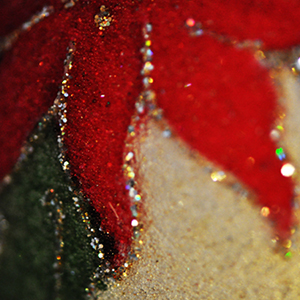
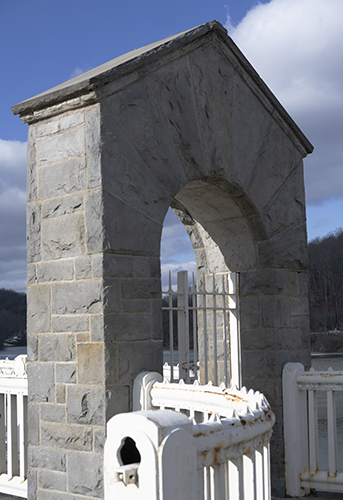
once
in royal
david’s city
The carol Once In Royal David’s City is a favorite, but it hits-you-over-the-head with its English syntax and its Anglo message.
And through all His wondrous childhood
He would honour and obey,
Love and watch the lowly maiden,
In whose gentle arms He lay:
Christian children all must be
Mild, obedient, good as He.
Indoctrination
Tell me that the above stanza isn’t a description of how British children should behave. And in the land of severe class assignments and proper behavior, having a Christmas carol that preaches the ‘party-line’ can’t be a surprise.
Syntax
Royal David – OMG
But in Oakville, the most English of Toronto’s suburbs, there’s Royal Windsor Drive.
And from the Property Portal come the following: Streets with regal or titled names such as Royal, Palace, Lord and Bishop can boost the value of homes lining their pavements.
……………………………………………………………..
The title Christmas head-space came from a text exchange with a friend. He began talking climate change and I answered that I couldn’t think about that right now, I was still in my Christmas head-space.
I had to explain that the term has NOTHING to do with belief. The Christian myths surrounding the season, to me, are just that – myths.
However, I do like the music. Wait, let me qualify that. I like the music associated with the Christian myths; the commercial American carols are not interesting. Sorry Rudolph, sorry Halls, sorry Bells, sorry Frosty …
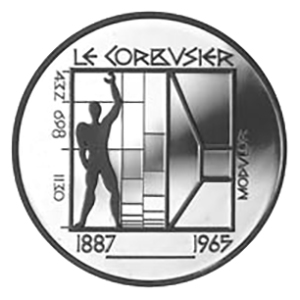
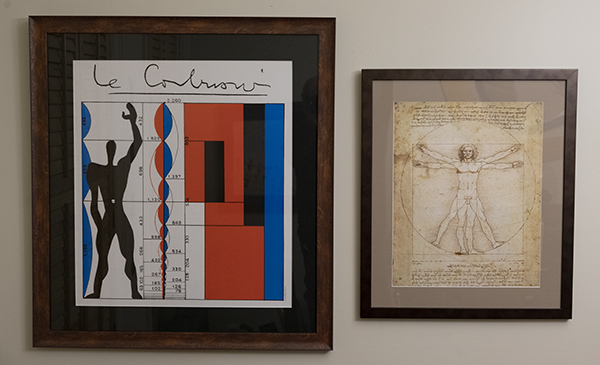
The above images – on the left Modular by Le Corbusier and on the right Vitruvian Man by Da Vinci – have finally been united.
I bought the Modular poster when the Wertheimers and I were in Romchampt at Notre-Dame du Haut – the amazing chapel designed by Le Corbusier to commemorate the resistant fighters of World War II. And it’s been in the downstairs big-room since then – some 30 years.
I knew it was based on Da Vinci’s famous Vitruvian Man drawing, but I was always too bashful about putting the two pieces next to each other, mainly because Da Vinci’s man was naked. But time and age change many things; I bought a poster of the famous geometric man and put it next to Modular.
The Vitruvian Man – L’uomo vitruviano – originally known as Le proporzioni del corpo umano secondo Vitruvio – The proportions of the human body according to Vitruvius – is a drawing made by the Italian polymath Leonardo da Vinci in about 1490. It is accompanied by notes based on the work of the Roman architect Vitruvius. The drawing, which is in ink on paper, depicts a man in two superimposed positions with his arms and legs apart and inscribed in a circle and square. – Wikipedia
The Modulor is an anthropometric scale of proportions devised by the Swiss-born French architect Le Corbusier (1887–1965).
It was developed as a visual bridge between two incompatible scales, the Imperial and the metric systems. It is based on the height of a man with his arm raised.
Le Corbusier developed the Modulor in the long tradition of Vitruvius, Leonardo da Vinci’s Vitruvian Man, and other attempts to discover mathematical proportions in the human body and then to use that knowledge to improve both the appearance and function of architecture.The system is based on human measurements, the double unit, the Fibonacci numbers, and the golden ratio. Le Corbusier described it as a “range of harmonious measurements to suit the human scale, universally applicable to architecture and to mechanical things”. – Wikipedia
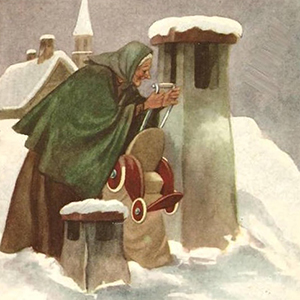
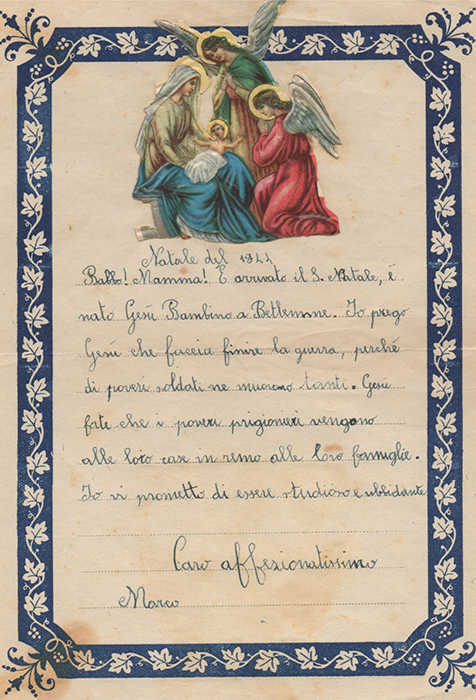
Christmas
1922
On this the 12th day of Christmas, the feat of La Befana and the day that right-wing terrorists stormed the US Capital, I wanted to use the wonderful note, from 1922, written by the young Marco. (I love the old fashion cursive.)
In the note, the young-man is writing to his dad and his mom – Babbo, Mamma. And in it, he prays that the child born in Bethlehem, will help end the war; that the child born in Bethlehem help the many wounded and imprisoned soldiers.
It’s an amazing sentiment that still rings true some hundred years later.
And to commemorate La Befana, I used a drawing of the ‘old hag’ from another antique card, as the featured image for this post.
Growing up in Aprigliano, in the early 50s, our stockings were filled for the feat of the Epiphany, when the Magi came to the stable bearing gifts. December 24 and December 25 were occasions for family and friends, for Christmas Eve dinner with Midnight Mass. We got gifts on January 6, and they were brought to us by La Befana.
Today, with the feat of the Epiphany, the Christmas Season ends.
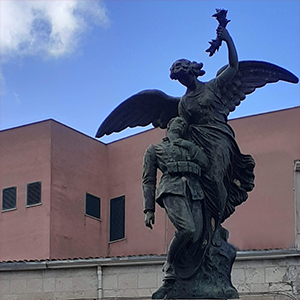

And now a word from the merry murderesses of the Cook County Jail …
| He had it comin’ He had it comin’ He only had himself to blame You know how people have these little habits that get you down Like Bernie Bernie, he liked to chew gum No, not chew, pop So I came home this one day And I’m really irritated And I’m looking for a little bit o’ sympathy And there’s Bernie lyin’ on the couch, drinkin’ a beer and chewin’ No, not chewin’ Poppin’ So, I said to him, I said “Bernie, you pop that gum one more time” And he did So I took the shotgun off the wall And I fired two warning shots Into his head | Now, I’m standing in the kitchen Carvin’ up a chicken for dinner Minding my own business In storms my husband Wilbur in a jealous rage “You been screwin’ the milkman, ” he says He was crazy And he kept on screamin’ “You been screwin’ the milkman” And then he ran into my knife He ran into my knife ten times If you’d have been there If you’d have seen it I betcha you would have done the same |
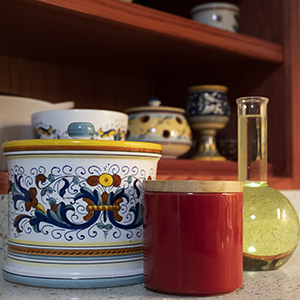
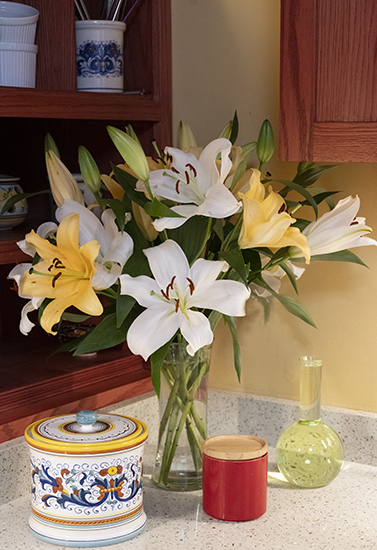
an end
and a
beginning
I bought the lilies on January 11 to mark the death of Sheldon Adelson – a one-percenter who has funded the worst in our politics. And today, one of those worsts, the 45th president, became gone.
But then, by 11:59 am, Joe Biden and Kamala Harris had been sworn-in to become the new President and the new Vice President.
By today, all the blooms had opened and for two days, I’ve lived in nasal congestive hell. But I wanted to have the lilies there for the inauguration; I wanted something that I had purchased to celebrate a death, become a symbol of new life.
Today, in the New York Times, Thomas L. Friedman wrote an amazing op-ed.
And he opens the piece with absolutely elegant writing.
Folks, we just survived something really crazy awful: four years of a president without shame, backed by a party without spine, amplified by a network without integrity, each pumping out conspiracy theories without truth, brought directly to our brains by social networks without ethics – all heated up by a pandemic without mercy.
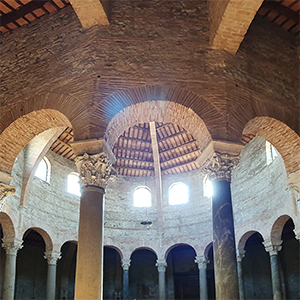
Two events – a FB posting and an old old photograph – stirred memories of that long ago.
One – Chiesa di San Michele Arcangelo
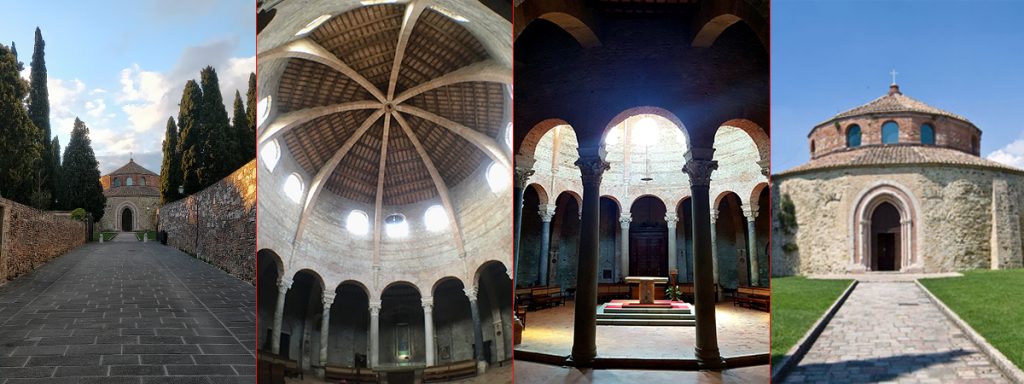
Between April and August of 1972, I lived in Perugia attending the Universita per Stranieri – Italian University for Foreigners. It was a program similar to what today may be called Junior-year Abroad; in other words, my course-work was pre-approved by Manhattan College and I received credit for my Italian classwork.
One afternoon, I was exploring the area north of the university and I saw this round structure at the end of stone-paved alley. It turned out to be a beautiful Medieval chapel.
I saw no signage, so had no idea what it was. I went inside to discover a chapel of sorts. The place was empty, but around the altar, on a raised dais were sheaves of wheat – which the sun, from windows up in the dome, bathed in golden light.
Even now that sweet memory lingers.
For some fifty years, I’ve been trying to figure where that chapel was. But memory is fickle, it’s elusive, it’s unreliable and I never figured out what I had stumbled on, all those years ago.
Until today. There on Facebook was my chapel from memory. I recognized it from the one pic in the post. And that led me to Google Maps. It’s the Chiesa di San Michele Arcangelo.
Here’s the Wikipedia entry for the small church.
San Michele Arcangelo, also known as Sant’Angelo, is a paleo-Christian temple in the city of Perugia in Umbria. The circular building dates to the 5th to 6th century and it incorporates Corinthian capped columns from a prior pagan temple. It is dedicated to the Archangel Michael, whose churches were often located in elevated spots. The small round church is also often called Tempio or Tempietto, and is located in the neighborhood Borgo Sant’Angelo, near the ancient northern gate (Porta Sant’Angelo) of the city.
The structure of the church has been altered across the centuries; in 1479, it was converted into a small fort. A major restoration occurred in 1948 that revealed ancient frescoes and sealed windows. The architecture is an early Romanesque with Byzantine influences in the chapel placement, but the circular temple is something seen in other ancient churches in central Italy.
The interior has a circumferential ambulatory delimited by sixteen columns with Corinthian capitals. The interior has some notable early Christian symbolism, including a pentagram at the entrance and some crosses belonging to Knights Templar order.
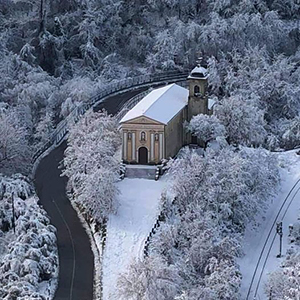
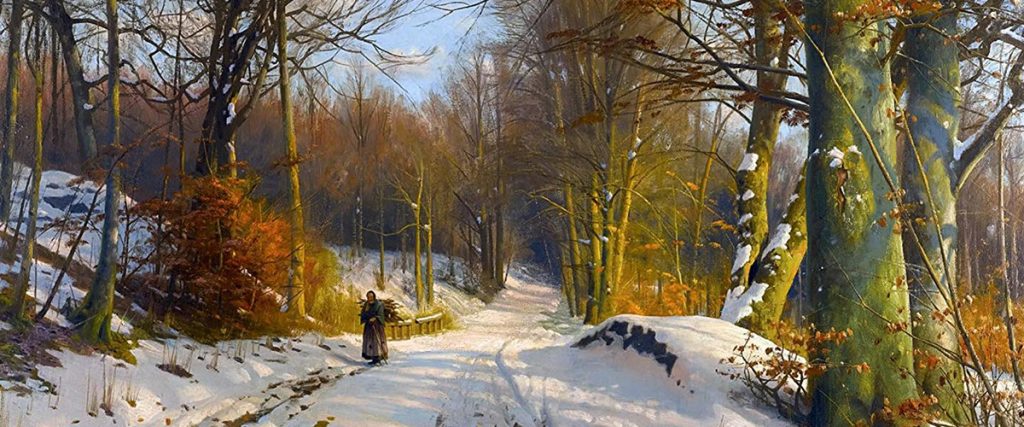
Today has many names – Midwinter, Groundhog Day, Candlemas, Feast of the Presentation.
First: I didn’t know that February 2nd marked the mid-point of the season. The confusion comes from the fact that the carol – In the Bleak Midwinter – is part of the Christmas repertoire. And even though it makes no sense to reference the middle of winter in late December, I went with the timeline – it’s a Christmas carol. But when I calculate the length of winter 2020 – there are 89 days – February 2nd is day 43 and close enough to claim the mid-point.
Second: Groundhog Day is famous for Punxsutawney Phil and the Bill Murray, Andie McDowell movie. The famous Pennsylvanian rodent is an American icon and this year predicted six more weeks of winter; the movie wonderfully captured 1990s America – stupid, harmless, oblivious, repressed …
Third: I first came across the term Candlemas, in the 1970s, in the Deryni novels by Katherine Kurtz. The author did an amazing job blending Catholic monasticism and Church of England traditions in a surreal feudal landscape. The main characters are hybrid monks with great powers and Candlemas was a day to call up strong magic.
Wikipedia says the following about the day. (The Mother Church sarcasm and calling-out the hundred-year olds are all mine.)
Candlemas, is a Christian Holy Day commemorating the presentation of Jesus at the Temple. It is based upon the account of the presentation of Jesus in Luke 2:22–40. In accordance with Leviticus: a woman was to be purified by presenting a lamb as a burnt offering, and either a young pigeon or dove as sin offering, 33 days after a boy’s circumcision. And using Holy Mother Church’s trumped up calendar, it falls on February 2.
On Candlemas, many Christians, (especially those over 100) especially Anglicans, Methodists, Lutherans, Orthodox and Roman Catholics also bring their candles to their local church, where they are blessed and then used for the rest of the year.
——————————————————————————————–
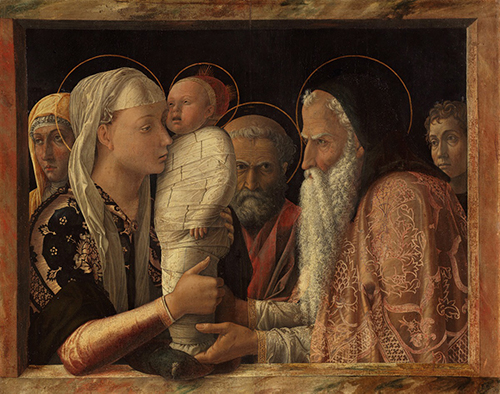
Fourth: The Andrea Mantegna painting of The Presentation At the Temple is one of my favorites.
– the child is swaddled in a fassa – an old Calabrese word. I still remember my sister being wrapped up when she was first born; (we’re talking 1955) my mother claimed it was to insure that her legs would grow straight
– the frame is part of the painting – notice how the mother’s elbow rests on the bottom horizontal
– the line halos are the best
– the middle figure – who the hell is he; who pissed in his corn-flakes (bet you it’s Joseph)
– and, nothing like dressing up a group of humble, devout Jews as Italian Renaissance aristocrats (I want the rose robe Simeon is wearing – look at that embroidery; even his skull-cap would be OK on a cold winter night.)
….
….
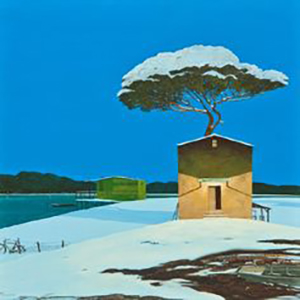

Shakespeare’s famous couplet from Richard III:
Now is the winter of our discontent
Made glorious summer by this sun of York;
is generally truncated and only the first line referenced.
For years, I too used it to refer to the cold, miserable season; I too assumed Mr. Stratford-upon-Avon had given us mortals an apt descriptor for the winter doldrums. But once I realized I was taking the line totally out of context, and once I read the entire couplet did I understand its wonder, its beauty.
The next four lines feel like something I would read in the Palmer Report. It’s as if Bill Palmer is addressing his fellow Democrats, but without his constant reminder not to get complacent, because gerrymandering and voter suppression can take the delightful measures all away.
Now are our brows bound with victorious wreaths;
Our bruised arms hung up for monuments;
Our stern alarums changed to merry meetings,
Our dreadful marches to delightful measures.
And then comes this weak piping time of peace. My only hope, and I believe the country’s only hope, is that the GOP is leaderless. The GOP seems to have lost its thinkers, its statesmen; its elders, its spokesmen. The Grand Old Party seems to have lost its soul; it has certainly lost its mind.
If the shift to Republicanism started with Goldwater in 1964, the GOP has had a some 50 years to deteriorate into the party that believes Jewish lasers started the California wildfires.
Why, I, in this weak piping time of peace,
Have no delight to pass away the time,
Unless to spy my shadow in the sun
And descant on mine own deformity:
And therefore, since I cannot prove a lover,
To entertain these fair well-spoken days,
I am determined to prove a villain
And hate the idle pleasures of these days.
I began this post, because I wanted to record the date that I got my COVID vaccination appointment – February 9. And from there I went to the Bard.
Also, I’ve been grabbing many pics off the FB site Dal Rinascimento ai Pittori Macchiaioli e oltre and have been trying to use them. Both the above winterscape and the featured image on the mainpage are from the FB page.
…
…
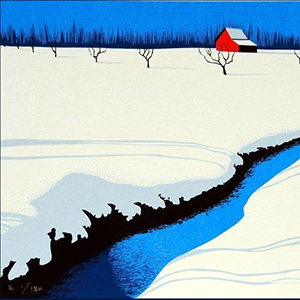
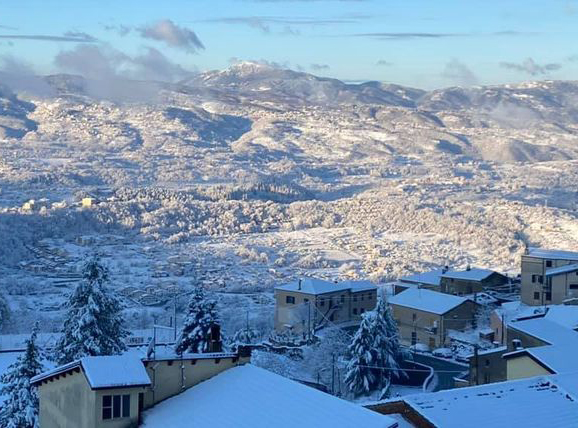
aprigliano
frazione
grupa
….
I left my house at 7:15 this morning and trudged through unplowed streets and sidewalks lost in snow to get to Allegheny General for my COVID vaccination.
It’s normally a 10 minute walk, but this morning it took me 20. The next task was to find where the vaccine was being administered and given the complexity of the campus that took some time. But I still got to the location by 8:40 and I was sixth in line.
And now the antics …
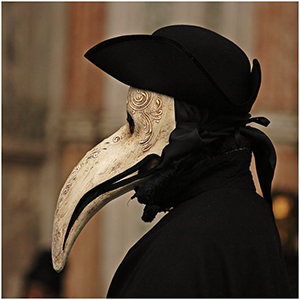
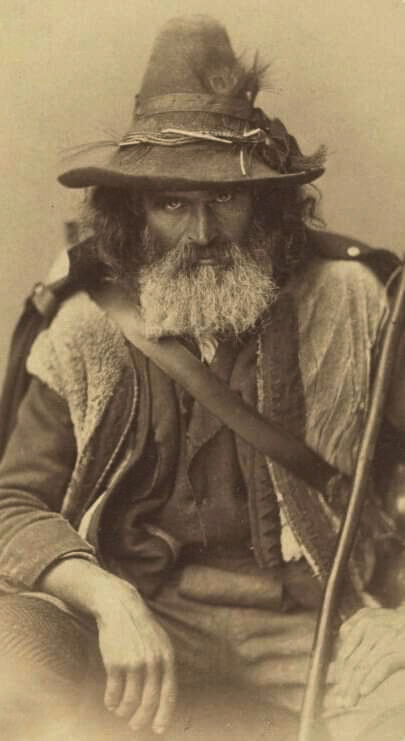
Tornerà il tempo
in cui me revestirò
da brigante
e verrò a cercarvi
uno ad uno,
e non sarà
per carnevale.
…….
Translation
There will come a time
when again, I will dress as an outlaw
and then, I’ll go searching
for each and everyone of you
and it will not be
to celebrate Carnival
I found the above photograph and the accompanying quote on FB. And I immediately downloaded it; made it my FB image and now writing a post using it.
Deconstruction – Part OneAnd this morning, a federal lawsuit was filed on behalf of Representative Bennie Thompson against former President Donald J Trump, his personal lawyer Rudy Giuliani, the Proud Boys and the Oath Keepers alleging they violated the 1871 Ku Klux Klan Act for inciting the January 6 riot at the United States Capitol.
The act, formally known as “An Act to enforce the Provisions of the Fourteenth Amendment to the Constitution of the United States, and for other Purposes”, passed as the racist KKK was waging a campaign of voter suppression and murder against newly-freed Black citizens of the US.
Representative Thompson is another person putting his outlaw clothes back on; another person who has heard the clarion call.
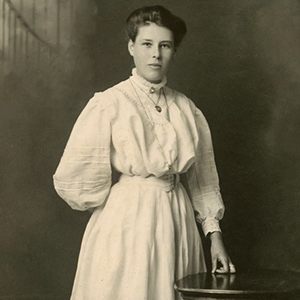
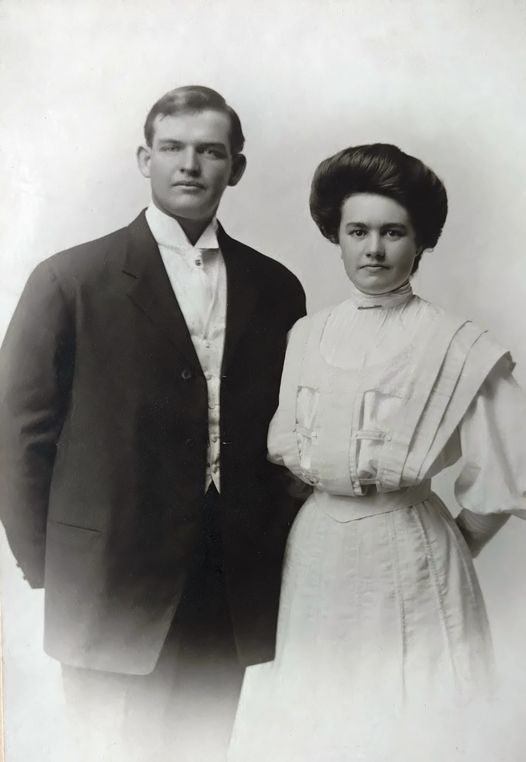
The image was posted on a FB vintage photographs page; and I thought it beautiful, elegant, gorgeous . . .
The couple is from Holdrege, Nebraska; it’s their wedding photo; it’s dated Thursday, August 27, 1908.
The title comes from the 2016 film – This Beautiful Fantastic – and I’m thinking through using it for my next piece of fiction.
What would a story with the title – Long Ago, Before the World Was Round – be about? And how can I include Claude and Jessie in that narrative?
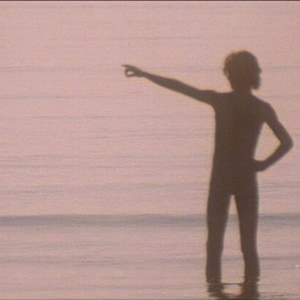

Another Post Full of Mixed Metaphors
– the pairing of Aschenbach (Dirk Bogarde from Visconti’s Death in Venice), and Giuliani is common on social media
– Venice and Washington, Gustav and Rudy – their lives leeching down their faces
– it’s cholera and COVID, past and present, Dorian and Faustus, fixation and delusion
– the soothsayer warns Caesar of his untimely death
– the title – Thomas Mann – calls to a conflicted writer, to a dark time
– and the featured image, also from Visconti’s film, is Tadzio in silhouette; he’s standing feet-deep in the river Styx; his hand stretched towards the gates of hell
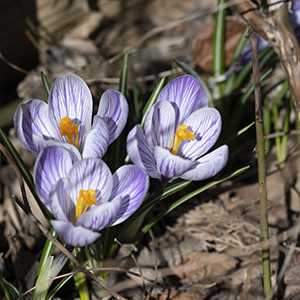
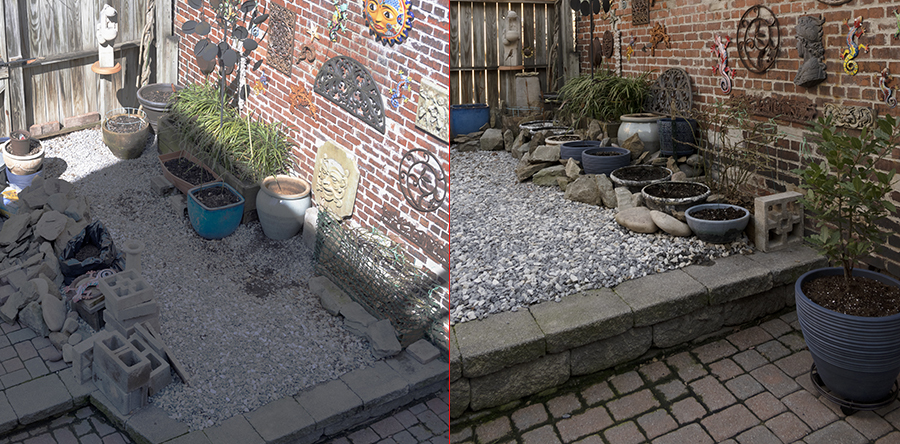
The above images, specifically the one on the right, was re-shot.
(First of all, I don’t like either of the two images in the composite. But I decided to use them because they record the changes I’m making. Am hoping to shoot a second set of after pictures – on the right – tomorrow morning and deal with the blow-out and shadows.)
Given the great weather, I decided to clean up the rock-garden and in the process decided to get rid of all the various shelves and under-pinning. (Buried under the various post were 7 large cinder-block, 6 square cinder-blocks and at least a dozen bricks and pavers.) Also, I wanted to showcase the ceramic pots, Wright’s Native American and the ornamental grasses that have finally filled out; and that meant re-thinking the entire layout.
The end result is a more streamlined rock-garden and a whole new planting on the left-side. (More on that later.)
Monday, March 23, 2021
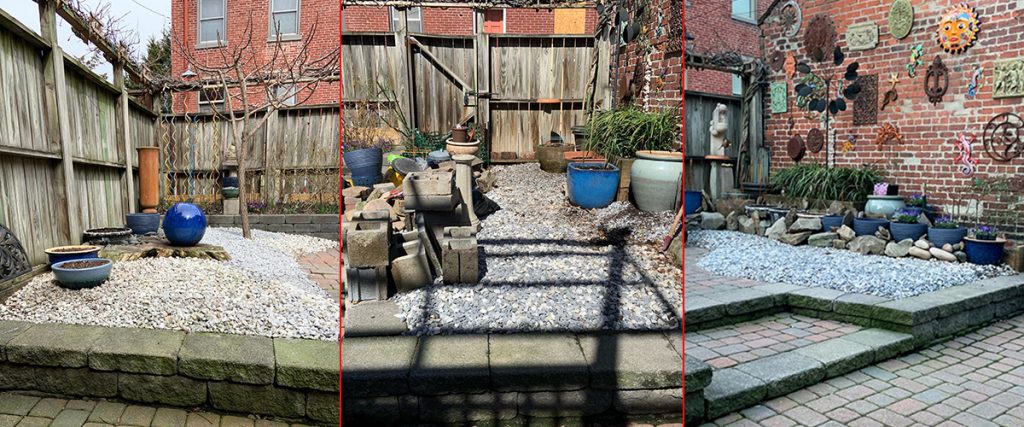
I began work on the backyard on Friday; today is Monday. I easily put in 6 to 8 hours a day.
The final modifications have produced two very distinct gardens; note – the middle image is from Friday:
– the planting on the right will be full of annuals
– on the left, I’ve begun a Zen garden.
All three images are from my phone camera.
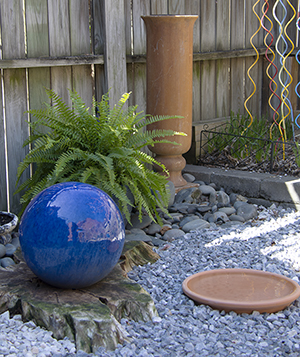
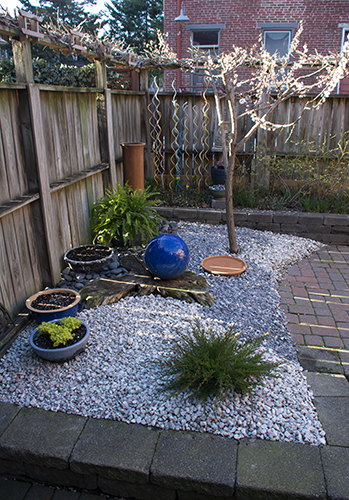
the greatest
action
is
not conforming
The left side of my backyard has for years been a forgotten step-child. But for some reason, this spring I decided to make it other. My solution, and it was a serendipitous process as to how I got to a decision, was to turn it into a zen-garden. And with that idea in the back of my mind, I began to shape it.
What you see, in the above pic, is its latest transformation.
Some Background
– At one time the left-side had a 50 foot sequoia on it. It had started life as a bonsai but its roots left the confines of the pot and borrowed into the soil; the blue marble sits on what’s left of the tree-trunk.
– Where the apricot tree stands, there once was a cascading spruce. It too had been a bonsai that refused to conform. It grew a magnificent canopy and every spring its soft, green candles danced with the night winds. But a late, heavy, wet snow ripped it from the ground.
– The blue marble that everyone loves, is really a tribute to my sister Jo’. I bought it the weekend she died – June 30, 2001 – and it has been in the backyard ever since.
– Between the fern and the tall terracotta planter is a large blue-stone from the shores of Lake Superior. Under it is written September 6, 2018 – the day my dad died.
– The Buddha, in the back against the fence, too has been in the backyard for years.
It very much feels like I’ve been circling the idea of a zen-garden for years – look at all the elements that have been always part of the left-side. At one time, in the area with the small, blue stones, I had fashioned a stream-like feature using hundreds of blue rocks that I brought back from the shores of Lake Superior. Those are now along the left fence where the pots are.
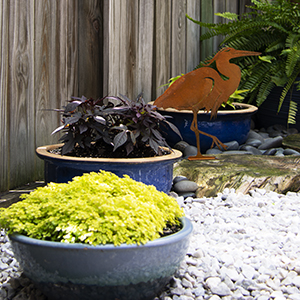
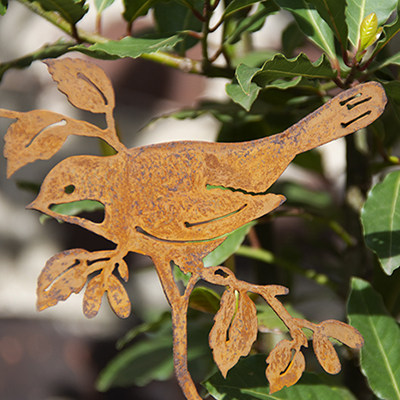
Some thoughts after surfing Netflix, and browsing the doc on Queen Elizabeth and her sister Princess Margaret.


to dance beneath the diamond sky
with one hand waving free
. . .
silhouetted by the sea
. . .
. . .
with all memory and fate
driven deep beneath the waves
. . .
let me forget about today
. . .
until tomorrow
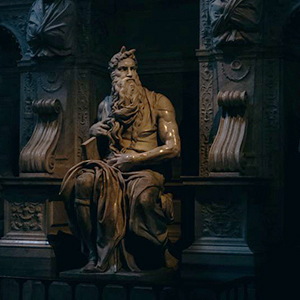
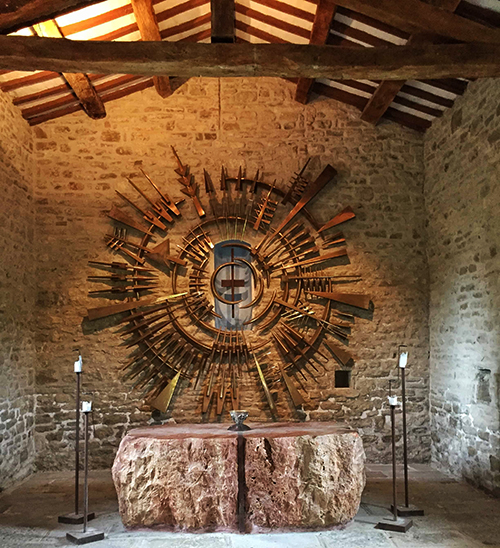
Every once in a while, especially in this time of pestilence and gloom, I need a reminder that there are still artists working; that there are artists searching for a path through this anguish; that there are artists interpreting this devastation.
The above image is of the altar in the Church of San Silvestro in the small town of Pietrarubbia, north-west of Urbino. (a small country-church – chiesetta – among the rolling hills of Le Marche) The artist is Arnaldo Pomodoro.
And I used The Moses, shot in shadow and light, as the featured image, because like the ancient Hebrews, we too need passage out of this darkness.
Both images – The Moses and Pomodoro’s altar sculpture – are from Facebook posts.
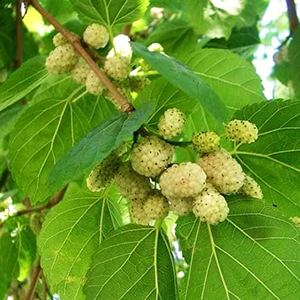
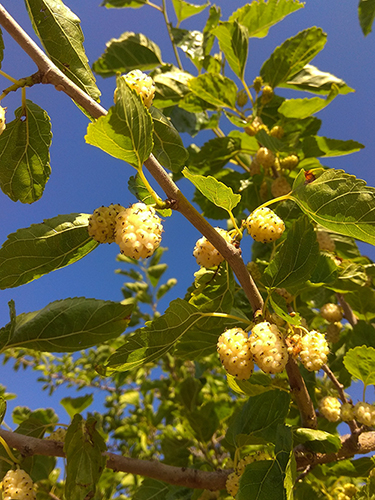
The Italian for mulberry is gelsi; the Calabrese word for mulberry is amurella.
Now tell me that amurella isn’t a more interesting word than the pedantic gelsi. But then modern Italian is about Florentine snobbery not the rolling r’s that are produced by vibrating the tip of the tongue against the roof of the mouth, just behind the
teeth.
In Aprigliano, this is the time of l’amurella. As kids, we would eat our fill and maybe, just maybe, bring some home. I remember lining the bottom of a panaru – shallow willow basket – with mulberry leaves to keep the berries from getting squished against the woven strands. (Mafalda and I were amurella aficionados; we only ate the white ones. Mafalda is my mother.)
The white ones – amurella bianchi – were prized for their subtle taste, their scarcity. The dark mulberry were common; they grew anywhere and everywhere.
This post is dedicated to Lucy Galiardi, an Apriglianese FB friend. She posted both the featured image and the one above.
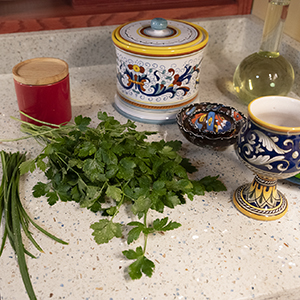
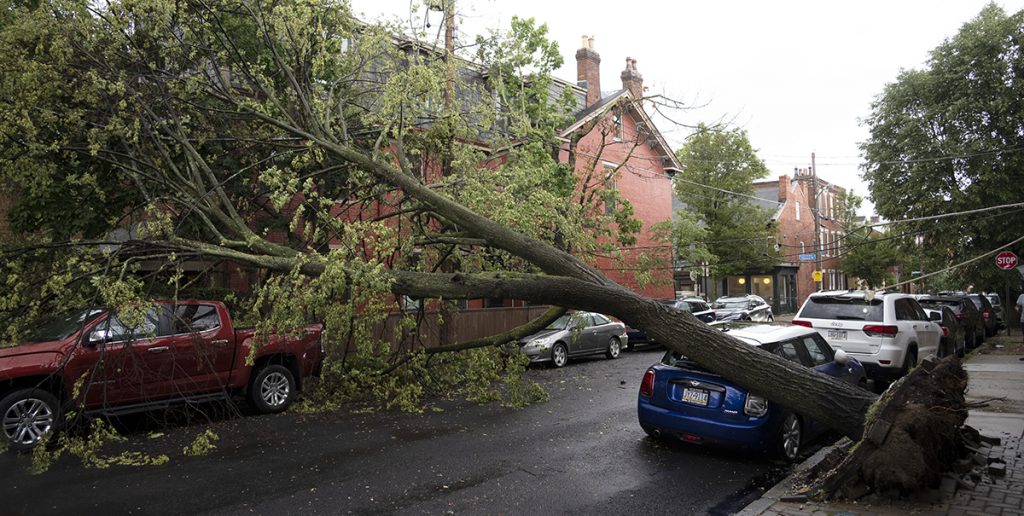
It’s early evening, and the heavens open up. The rain is coming down so hard and so dense that I can’t see anything out the window.
When I hear a cracking-like sound, I open my front door and see the tree in front of my neighbor’s house down.
My new car was parked behind the Mini; it’s undamaged and I move it. In the pouring rain, with a tree down and electrical wires low enough to touch, I maneuver the car, climb it onto the sidewalk, all in an effort to get it away from the massive down tree.
The linden was no longer healthy. It’s canopy was sparse, but I certainly didn’t think it would come down in a Biblical caliber rain storm.
The cable wires are keeping it from falling onto the street and crashing the red truck. The Mini is not as lucky – its rear window is shattered and its suspension is probably gone.
The fire department determined that the wires were not broken or live and just put up yellow tape to close off the street.
Monday morning, some time around 2:00am, the electric utility came and removed the low-hanging wires cutting off electricity to my neighbor house.
Tuesday evening, around 9:00pm, a tree company showed up with a cherry-picker and after a thorough assessment began to cut the tree apart.
My neighbors and I sat on out stoops drinking wine and beer and watched as they dismantled the fallen tree. It took the crew, working in the dark, 3 hours.


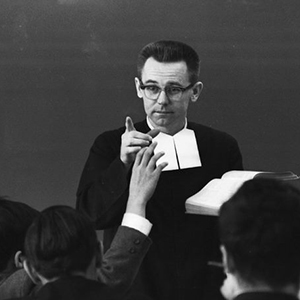
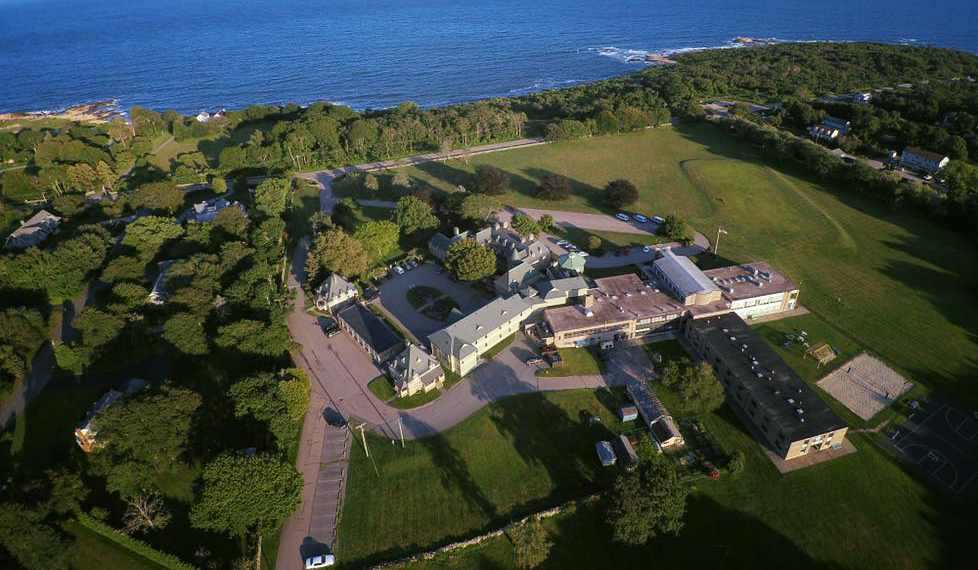
Fifty-three years ago – Saturday, June 29, 1968 – six of us – Nelson P, Jimmy C, Ray St G, Mario Z, Brother Phillip P, Brother Lucian R – traveled from Scarborough, Ontario to Narragansett, Rhode Island, to the Christian Brothers’ Novitiate. Nelson, Jimmy, Ray and I were beginning our path to becoming Christian Brothers.
I’ve trying to piece together some of the events I remember from that long-ago:
The Saturday arrival makes sense, because Bobby, who remembers much from that time, was saying that he and the other guys from Mater Christi High School in Queens also arrived on the 29th.

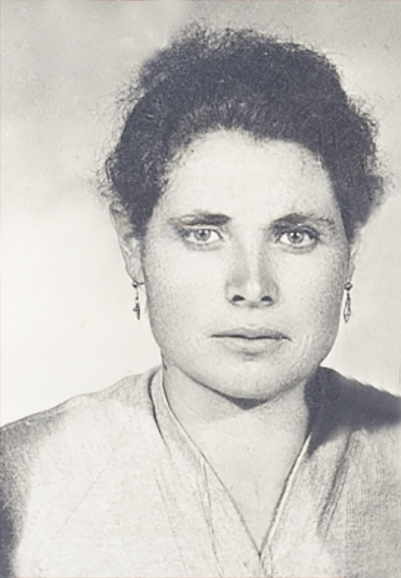
Eulogy for Barbara Bitonti
Friday, August 27, 2021
St. Gregory RC Church, Sault Ste Marie, Ontario
Welcome and thank you for attending this celebration for the life of Barbara Bitonti.
I’m Frank Bitonti, the eldest of her four surviving children.
Barbara lived a full and most productive life in her 96 years.. She has left us a very rich legacy of perseverance, of devotion and of love, and a zeal for living.
Barbara’s perseverance – born in San Giovanni in Fiore in 1925, she grew up during a very turbulent period in Italian and world history. She was a teenager at the start of World War II. She and our father often spoke of those lean years, of many days of hunger that many in southern Italy experienced during the war. Molte volte abbiamo provato la fame. Many times, we tasted hunger. Their reminders recall the famous scene Gone with the Wind where a famished and desperate Scarlett Ohara, near the end of the Civil War, raises her fist defiantly crying “As God is my witness, as God is my witness, I shall never go hungry again.” I picture Barbara doing a Scarlett Ohara during the lean years of World War II. And perhaps true to those words, she made sure for so many years anyone who entered her house, never left hungry. And for her children and grandchildren she made sure her pantry and cold cellar were always full; we all came to benefit from her incredible and varied skills as homemaker – baking home made bread, making sausages and prosciutto, curing olives, and pickling tomatoes, melanzane, and peppers. Not to mention, the strength that she showed in administering the fatal blows to rabbits and chickens we kept at 154 McFadden well in to mid 60’s. The rest of us, including our Dad, would squeamishly leave Mom on her own to pluck the chicken feathers and skin the rabbits. Her grandchildren always marveled how she could quickly whip up chicken cutlets, French fries, and a tomato salad in minutes to feed them a hearty lunch.
Her determination would be most evident after her first unsuccessful attempt at settling down with her children in Sault Ste Marie in 1952. She returned to Italy in 1954 with four children in tow. Our Dad Pasquale stayed in Canada hoping to get permanent employment that would hopefully lead to Barbara returning with his family. Barbara returned in 1956 determined to settle down. I recall vividly her strength on the ten-day voyage in 1956 from train to passenger ship across the Atlantic and back to train to Sault Ste Marie with four young children. There were moments on that voyage that she was so exhausted she’d burst into tears. I remember vividly trying to console her in our cabin on the passenger ship as we crossed the Atlantic. She could have been feigning sea sickness to keep me and my brother Joe from leaving the cabin to roam the ship – which we too often did. Little did I know that she was so prepared this time to meet the challenges of the new world. My brother Joe had completed grade 2 in Italy and I had completed grade 1. And my younger brother Sam, at 4 was only two years away from starting school. As some of you older Italians are aware, Italian school children wore black smocks and coloured bow ribbons that we would don to indicate a specific grade, red for example for grade 1, blue for grade 2 on so on. She brought with her all the correct coloured ribbons that would last her children through elementary school only to be told by Aunt Lucia, her sister-in-law, that black smocks and coloured ribbons are not worn by students in Canadian schools. She recovered from this revelation to her lack of understanding of Canada. She was determined to become more informed and made sure that we all got the education that would serve all of us well into adulthood.
Barbara’s Devotion to Family and Friends
Barbara’s devotion to family was best illustrated in the care and commitment she showed our father Pasquale during his five-year battle with colon cancer. She was at his bedside when he passed. In 1969, when she was able to afford it, she made the trek back to Italy to see her aging mother. In 1985, she and Pasquale, reconnected with the extended family back in Italy. Beyond her immediate family, she was devoted to maintaining her relations with all her relatives in Canada and in the United States, sending her famous bread-sticks to her uncle Bill and her cousins Albert and Rosemarie in Clarksburg, West Virginia and in Pittsburgh, Pennsylvania, as well as sewing and mending dresses on her Singer machine for so many in the neighbourhood.
Barbara’s Unconditional Love
She always made sure that her children and grandchildren got the love and attention she was always so eager to give. In 2006, she and her sister Lucrezia, made a trek to Nova Scotia, to visit her grandchildren Pat and Anthony, their wives Heidi and April. Her piercing hazel eyes would sparkle with delight upon seeing her great grandchildren Megan, Matthew, Kiara, Kalie. In the last year, Henry her youngest great grandchild was the light of her life. Her love for her family came with some deep pain with the loss of her two adult children, Sam in 2008 and Joe in 2020. No greater pain does a parent experience than the loss of a child, even an adult child. Mom often talked about the pain her own mother had had losing three children – Lucrezia, Barbara, and Giovanni – to the Spanish Flu in 1918.
Barbara’s Zest for Life
Barbara raged and raged against the dying of her light because she loved living so much. That was so evident in way she reveled in relating her stories of the old country and her life experiences. As an adult, I could listen to her entranced for hours at her incredible memory of the minutest details of her life in Italy. She was often tired of late but a few weeks ago after lunch I saw how in the presence of Kaitlin and Courtney, two of her Personal Support Workers, (PSW) she lit up brilliantly and talked incessantly for over a half hour. The three of use could only understand a word or two of what she was saying but she felt she was communicating well by the sheer power of her emotions. Barbara loved the bright lights and excitement that was part of her many visits to the casinos with her sister Lucrezia. Similarly, she reveled in the noisy screaming game shows such as The Price is Right, Wheel of Fortune and Family Feud. She and Lucrezia would watch these shows faithfully for many years even though they didn’t understand the English well. And their limited English did not prevent them from becoming big fans for many years of the soap opera, The Young and the Restless primarily because of the popular character Victor Newman played by actor Eric Braeden. They would refer to him affectionately as Mr. Newman.
Special thanks to my sisters Theresa and Rose and my younger brother Tony, their spouses, Rick, Marchy, and Julie as well as their children for the immense sacrifices they made over the last seven and half years in caring for our dear Barbara after her stroke in 2014. They showed enormous love and care for Mom by making sure she had someone there for her at night and in the morning. Up to 2014, as so many of you know, Mom was a fiercely independent woman in her home.
I recall Mom saying a number of times, that when she lived in Italy, she could never in her wildest dreams imagine living in a house so big and with so much. To her, only the very rich lived in such palaces. Quest casa e un palazzo, – this house is a palace. And perhaps over the last 7 and half years she arguably deserved to be waited on hand and foot like royalty for all she did for her family. And true to form, she felt an allegiance and special kinship to Queen Elizabeth with whom she shared many birthdays. Queen Elizabeth was born on April 21, 1926, exactly one year to the day after Barbara’s birth. And of course, when Queen visited Sault Ste. Marie many years ago in 1959, Mom rushed downtown to try to get a glimpse of her.
The family would also like to extend a special thank you to Vicki Fecteau, the special PSW who for seven and half years provided such wonderful care for our Mom.
Mom, was often so distraught at having lost her son Sam in 2008. He was such a supportive son to her after Dad died. Theresa and Rose would often joke with her that Sam who was such a fine handyman, was building a castle for her in heaven. Mom, your castle is now waiting for you. We will miss all things you did for us on earth. Mom, now heaven is blessed to have you.

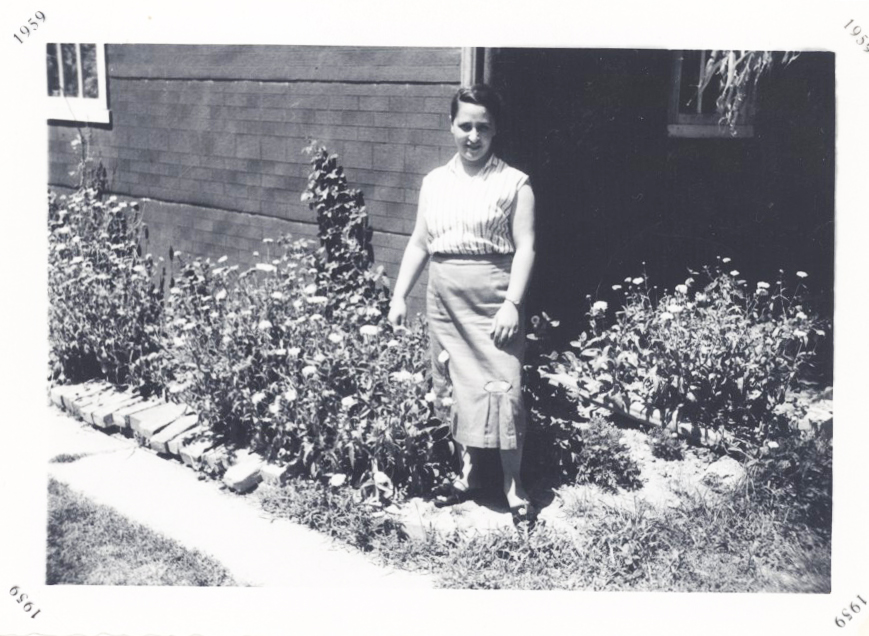
Eulogy for Amalia Muto
Saturday, September 11, 2021
St. Gregory RC Church, Sault Ste Marie, Ontario
delivered by Mary Melchiorre
My sister and I would like to thank you for coming to celebrate my mom’s life during this very unpredictable time. When the pandemic began my mom lost her love of coming to church so it would mean a great deal to her to know that you have come to celebrate her life in a place she felt very much at home.
It is important that we share with you our mom, nonna, wife, sister, zia, friend and what many would come to affectionately call her “G”!
My mom came to Canada from Aprigliano in 1951, at the age of 12 with her mom by her side to start a new life as many of you here have done. How brave for one woman with a young child; no English, uncharted territory, and a long boat ride to take such a leap of faith. Thank you for the courage to begin a new life that your grandchildren are fortunate to experience.
My mom was able to attend school in Canada and would graduate from St. Theresa’s school where my sister and I both attended. How remarkable is that! She was always self-conscious of being older than most of her peers in her class but later she would appreciate the value of being given the opportunity to learn another language. That skill would help many new family members and friends to this country. And so began my mom’s journey of how we will remember her as always concerned for others and wanting to help in any way possible.
Soon my mom would be reunited with her sister Mafalda in Canada. A bond that has served as a beautiful example of what being sisters means! The two have taken care of each other through many joyous and tragic events in both their lives. Just recently my aunt shared a story of how she would teach my mom various crochet patterns over and over until they could both create heirloom pieces for their families.
My mom and dad would begin their life together of 64 years strong! And together they would surround themselves with the love of family and friends! During this summer, my sister and I have been able to share many memories with my mom. Her greatest concern was that she never did enough for her family. We would like to take this time to let her know how much she thinks she didn’t do (Italian)
My mom would selflessly provide for her family in the best way to demonstrate love…through food! And how fortunate we were…there is nothing like coming home from school on a cold, winter Sault day to the smell of fresh homemade bread. We couldn’t get to the Nutella fast enough! Or being picked up from school that was literally around the corner because we forgot our umbrellas. My mom would soon share her love of kids by becoming a “special zia” to many! We have grown in an extended family through the various children my mom helped to raise. My sister and I had firsthand experience on what would happen if foul words were used…apparently hot peppers and soap came in handy and soon the kids would learn this lady can cook and she means business. Nothing but love came from the care she gave and she so proudly shared in the many accomplishments of the children she cared for.
My mom loved to sew and we have fond memories of Fabric Land and watching her sew our many outfits for special occasions and in true waste not spirit the scarp material was always available to make our barbies matching outfits.
My mom never missed baking for our birthdays and a special cake tweaked with a little Vermouth was something to always look forward too. Friends would soon learn of her baking skills and her famous Ginetti to which my friends lovingly referred to her as “Gina Ginetti!”
Knitting and crocheting intricate patterns became her hobby. And she found comfort in creating for others. A few years ago my mom completed two bed spreads for Daniel and Alyssa to bring to university. How fortunate for them to have these beautiful heirloom items to remember their nonna!
While knitting, sewing, baking and crocheting are not necessarily skills my sister and I have developed yet they definitely became the patterns and recipes to which she would use to give to others.
Besides the love of her family our mom had very strong religious beliefs, a great devotion for prayer and an abundance of devotion to God. Her phone calls to the kids when they were studying always ended with “don’t worry Nonna will pray for you!” We will miss the unconditional love for us through your prayers!
In a kitchen most people might have a junk drawer mom has what we call the “church drawer” where you can find many past bulletins, news articles of Fr. Trevor’s ordainment, tributes, prayers, the rosary and obituaries. These mattered to mom because they honoured someone’s life and their life story mattered!
Our mom became involved with the Catholic Women’s League (CWL) and how proudly she spoke of the work done by these ladies. She would find joy in a community of women that also had a strong faith and wanted to contribute. In our house St. Anthony is held in high regard. And there was a great deal of joy for my parents in both being able to contribute to a festival that they loved being a part of. A part of bringing what they left to their new life.
My mom was often humbled by others’ generosity and would never want to inconvenience others. She was extremely honoured to receive an award from the CWL for her contributions. She had never won an award before and this honour meant so much to her.
As small as Gina was it was the big things that mattered most family, faith and friends.
Her greatest gift was her kindness, care for others and gentle spirit. We are grateful to celebrate our mom in a place that was extremely important to her. My mom was able to celebrate her last mass on Sunday via the efforts of the church and volunteers to keep the community connected.
As difficult as it is to physically let go of someone the legacy of their memory is everlasting! So mom thank you for always wanting to do so much more for us that it felt like it was never enough! You will always be Our Little Mom, wife, nonna, Zia, friend with a big heart!
Editorial Note:
The featured image is my aunt’s passport photo. It was probably taken in 1950.
(there’s a similar picture dated August, 1950)
The above image was taken at my grandparents’ house – 106 Henrietta.
(and given that it’s dated, my aunt was 20 years old)
I opted for a different title for this in memorium post, because within her family – among those of us who were born in Aprigliano – she was know as Gilia. And I will always remember her by that name. The formal name, in Italian, was Egilia, but she hated it.
One of my favorite stories about my aunt is her admitting to a group of us, in one of our many visits, that she hated her formal name and that when she applied for a Sears Credit Card she used the name Jean because she liked it.
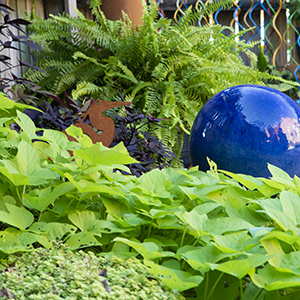

The lunatic is on the grass.
The lunatic is on the grass.
Remembering
games and daisy chains and laughs.
Got to keep the loonies on the path.
The lunatic is in the hall.
The lunatics are in my hall.
The paper holds their folded faces
to the floor
And every day the paper boy brings more.
And if the dam breaks open
many years too soon,
And if there is no room upon the hill,
And if your head explodes
with dark forebodings too,
I’ll see you on the dark side of the moon.
The lunatic is in my head.
The lunatic is in my head.
You raise the blade, you make the change,
You rearrange me ’till I’m sane.
You lock the door
And throw away the key,
There’s someone in my head
but it’s not me.
And if the cloud bursts thunder in your ear,
You shout and no one seems to hear,
And if the band you’re in
starts playing different tunes,
I’ll see you on the dark side of the moon.
“I can’t think of anything to say, except…
I think it’s marvelous.”
All that you touch
And all that you see
All that you taste, all you feel
And all that you love
And all that you hate
All you distrust, all you save
And all that you give
And all that you deal
And all that you buy, beg, borrow or steal
And all you create
And all you destroy
And all that you do
And all that you say
And all that you eat
And everyone you meet
And all that you slight
And everyone you fight
And all that is now
And all that is gone
And all that’s to come
And everything under the sun is in tune,
But the sun is eclipsed by the moon…
“There is no dark side in the moon really. Matter of fact, it’s all dark.”
i’ll see you on the dark side of the moon

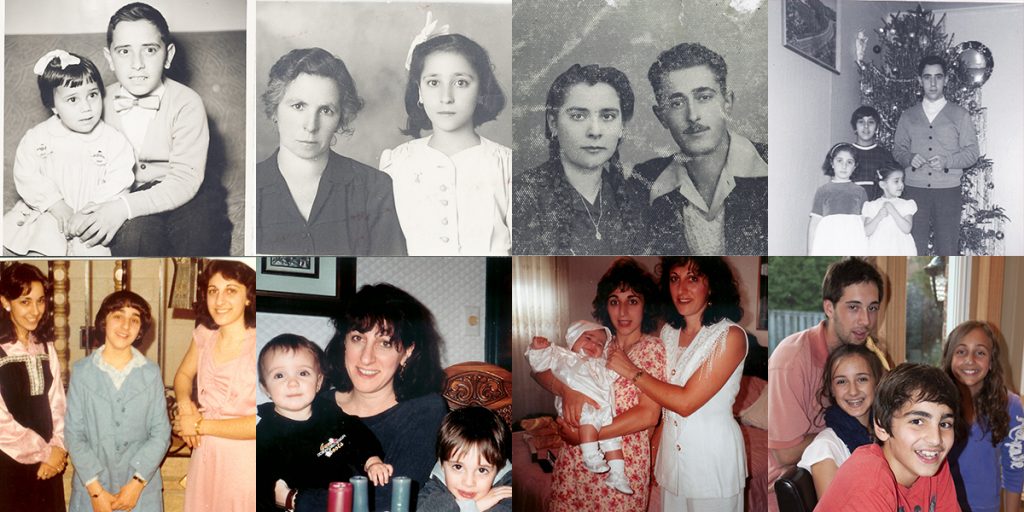
Oh, the gentlemen are talking
and the midnight moon is on the riverside,
They’re drinking up and walking
and it is time for me to slide.
I live in another world
where life and death are memorized,
Where the earth is strung with lovers’ pearls
and all I see are dark eyes.
A cock is crowing far away
and another soldier’s deep in prayer,
Some mother’s child has gone astray,
she can’t find him anywhere.
But I can hear another drum
beating for the dead that rise,
Whom nature’s beast fears as they come
and all I see are dark eyes.
They tell me to be discreet
for all intended purposes,
They tell me revenge is sweet
and from where they stand, I’m sure it is.
But I feel nothing for their game
where beauty goes unrecognized,
All I feel is heat and flame
and all I see are dark eyes.
Oh, the French girl, she’s in paradise
and a drunken man is at the wheel,
Hunger pays a heavy price
to the falling gods of speed and steel.
Oh, time is short and the days are sweet
and passion rules the arrow that flies,
A million faces at my feet
but all I see are dark eyes.
Dark Eyes
written by Bob Dylan
copywright 1985
The lyrics are usually shown in long lines (I cut each line into two.).
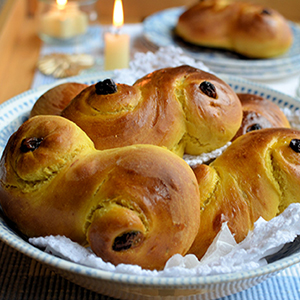
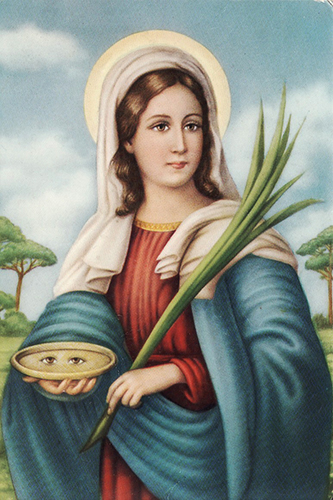
u 4 Barbara
u 6 Nicola
u 8 Maria
u 13 Lucia
e lu 25 lu messia
The above holy-card is of St. Lucy; I remember it from when I was a kid back in Calabria.
Believe it or not, the holy-card, with the eyes in a dish – bizarre as that seems – is the sanitized version of the legend of St. Lucy. The narrative, of Lucia of Siracusa, is full of horror and carnage. (BTW, the palm is there to symbolize martyrdom.)
The rhyme on the right of the image, with its Calabrese definite articles u and lu, was something we all learned in order to remember the important feast-days preceding Christmas. I associate the rhyme with my grandmother, remembering that it was she who I went to when I forgot one of the lines.
December 4 is the feast of St. Barbara.
December 6 is the feast of St. Nicolas.
December 8 is the feast of the Immaculate Conception.
December 13 is the feast of St. Lucy.
And December 25 is the feast of The Messiah.
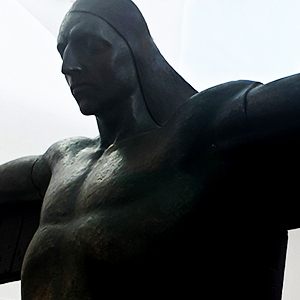
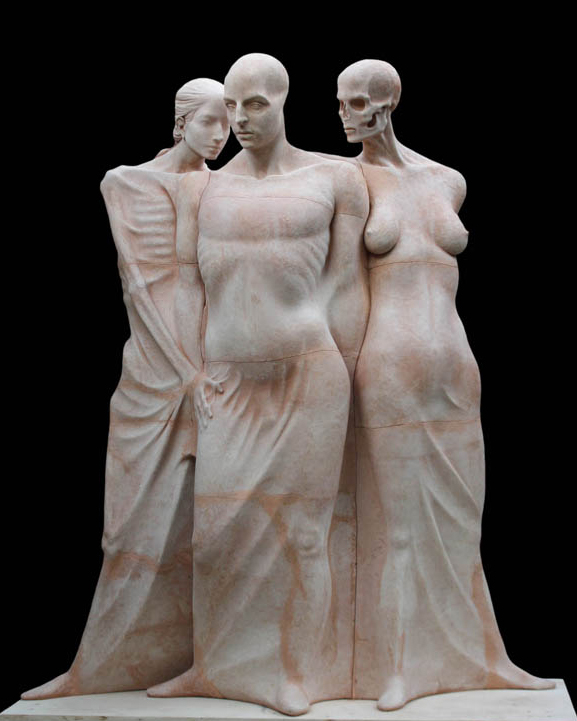
…
three lives
…
il canto delle serene
| Year | mario | franchino | slavatore |
| 1949 | aprigliano, cosenza january 3 | san giovanni in fiore, cosenza october 27 | caltabellotta, agrigento july 4 |


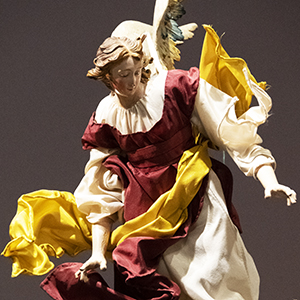
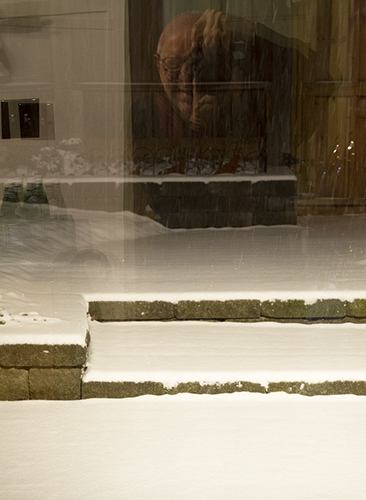
there are 3
Apriglianesi
left
Yesterday, a cousin posted that her dad – Franchino Barberio – had passed away on Saturday, January 22. With zu Franchino’s death, there are only three remaining Apriglianesi of my parents’ generation – my mother, Cum’Amalia, and Maria Capisciolti – in Northern Ontario.
All my life, the Apriglianesi in Sault Ste Marie and my cousins Rusaria-and-Franchino Barberio of Sudbury were a very close group of Italian immigrants all from Aprigliano, Cosenza. Rusaria-and-Franchino (Franchino’s mother and my dad’s father were siblings) came often to Sault Ste Marie. They visited with my parents and their other cousins the Capisciolti. The Barberios came in January to make sausage, in the spring to celebrate Easter, and in the fall to gather mushrooms, make tomato sauce and make wine. And let’s not forget that they also drove in for all the important family events – baptisms, weddings, funerals.
The Apriglianesi of Sault Ste Marie and the Barberios of Sudbury, numbered about 12.
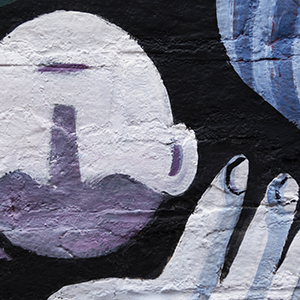
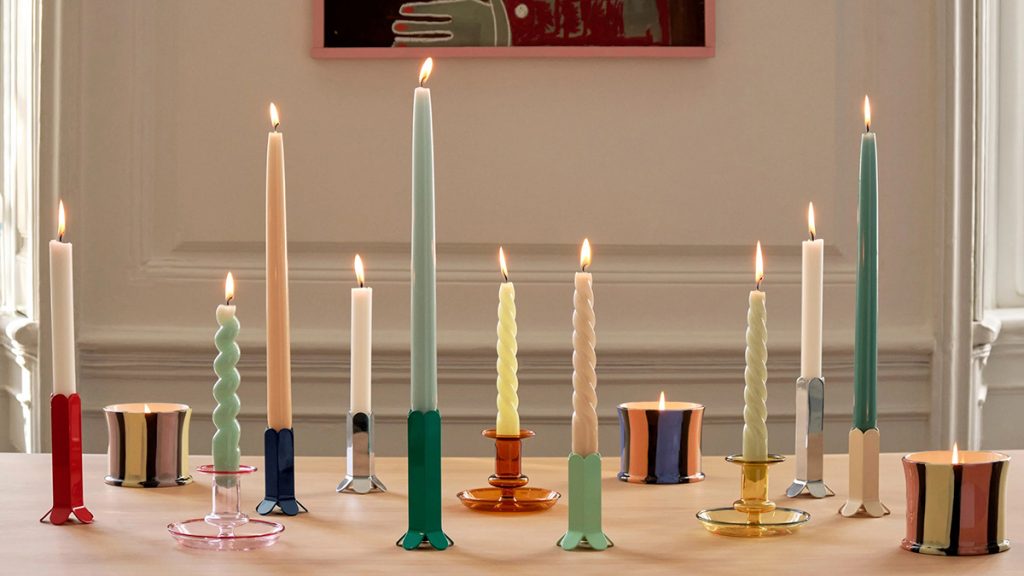
…..
remember me when the candle lights are gleaming
remember me at the close of a long, long day
it would be so sweet when all alone I’m dreaming
just to know you still remember me
The lines from John Prine’s version of Remember Me, are soft and demanding.
They’re about memory bathed in gloaming; memory situated in the mundane;
memory intimate and fatal.
the sweetest days are the days that used to be – Narragansett, RI, 1968
– thinking back to that first summer – us walking to Scarborough Beach; us riding the waves; your parents’ tiny summer home; the rickety wooden chairs, the kids behind us necking, the chaos that was the Newport Folk Festival; in the stifling humidity, us lifting our robes to catch a breeze, but revealing forbidden shorts – all these images, all these vids still fill my head
– thinking back to the December of our fist year – the snows on the golf-course and making angels in the glittering white-light; the kiss in front of the windmill house, in the glow of the full moon; the orange juice, in the stainless steel pitcher, that you brought to my room that kept me hydrated – all these images, all these shorts still fill my head
the saddest words I ever heard were words of parting – Portsmouth, RI, 1969
– I left for Canada, sick as a dog; we wished each other Merry Christmas at the Providence airport
– in the new year, in the gray winter light, we smiled, we laughed, but went walking with new friends. I couldn’t tell you, I had fallen in love
– in the silence of Compline, you cried because he was going to Vietnam; in the silence of Compline, I held you and prayed
– in August, we went for our last dinner; you were going down to DC; I was heading up to Windsor. the restaurant was a restored stone-house; in the back, there was a pond and willow-trees that swayed above the silent waters
good bye
good bye sweet New England
I’ll miss you
and we will never be the same, except in memory
…
The image is from Dezeen 2364 – Christmas Card 2021.

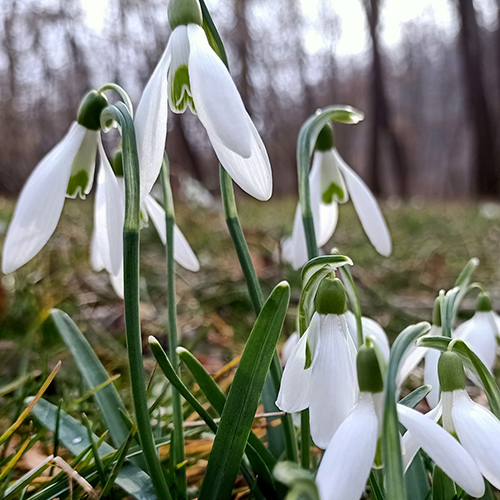
…
Another list
— there are two words that are much more interesting in Italian than in English – the Italian for sunflower – girasole, and the Italian for snowdrop – bucaneve
— girasole literally means – turns with the sun
— bucaneve literally means – cuts through the snow
— and staying with the theme that some things work better in their Italian versions; I like Sececa’s quote on fortune/luck in its Italian translation. La fortuna non esiste: esiste il momento in cui il talento incontra l’occasione. (fortune or luck don’t exist: what exists if the moment when talent meets an opportunity)
— don’t know if I’m remembering right, but it seems to me that other years, the bucaneve were already out by now
— and when the snowdrops do come up, there are never as many as I thought I planted
— in Europe, you can buy snowdrop plants and that way you know where to put them in a garden
— winter will be done in 23 days, 21 hours, 8 minutes and 19 seconds
— February has been a volatile month – we’ve gone from temps in the 60s to temps in the low teens
— it’s hard to believe that spring is closer than it’s ever been
– the image above was taken by Gabriele Bistoletti
– the featured image for this post is from online
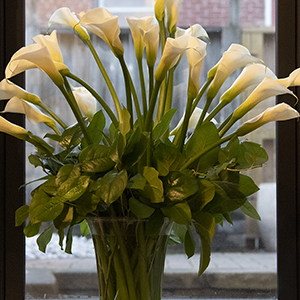

Brother James Loxham
Sunday, January 21, 1934
Saturday, March 5, 2022
He will always be Benilde – an absolutely wonderful human being.
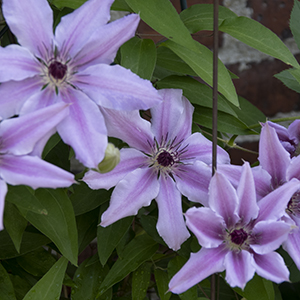
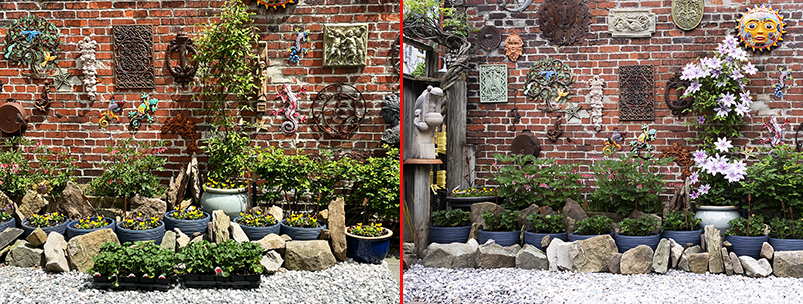
Last year, I reduced the number of pots and minimized the entire planting configuration on both the east and west sides of the backyard. On the east-side – the two images above – the simplified rock-garden with its ribbon of red geraniums looked really good. This year, I again got rid of ‘excess’ pieces – 3 extra-large pots and several ceramic pots (ceramic may look good, but man! a ceramic pot full of soil is not easily moved). The result is a simple line of blue plastic pots in front of two flower-beds and a large pot containing a clematis -flowering in the right image.
Also, for the first time, I did a spring planting – filled all the pots with violets (that is what is in all the pots, in the left image). Don’t know why it’s taken me all these years to figure out a spring planting. I suspect it had a lot to do with the need to clean and reorganize everything and by the time I did that work, it was May and I could plant for the summer season. But with a more streamlined and fixed planting arrangement there was no need for a lot of prep work; and with everything all laid out, I just added the violets and all of a sudden the backyard was no longer a place waiting for summer flowers. And dreary, cold spring was brightened up by yellows and purples throughout.
Here are some other changes:
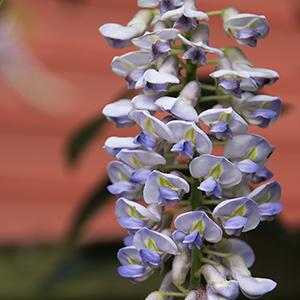
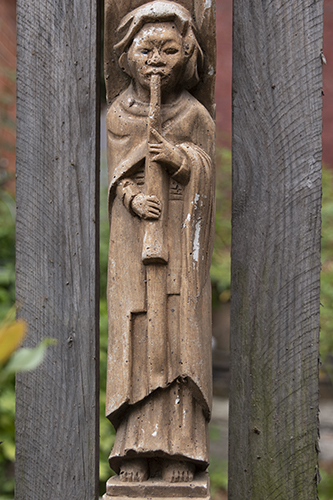
…
Yesterday, I found the website – monastero sant’Agostino – of a small group of cloistered nuns in Rossano, Provincia Cosenza, in the Sila Mountains in the eastern part of the Calabrian providence.
The website has a Note di Vita – word of the day – section and some of the writing is absolutely elegant. So far my favorite is the entry for transumanza – the seasonal moving of livestock to greener pastures.
And I have to admit that I like the Italian better than the English translation. The Italian has flow; it has cadence; it has great word-choice.
| Una sapienza antica, tramandata di padre in figlio e tuttora viva in queste terre calabresi, conosce il tempo della transumanza: quando è bene far migrare il bestiame. Alla ricerca di pascoli diversi, di un clima migliore, di un terreno più adatto. | An ancient wisdom, handed down from father to son and still alive in these Calabrian lands, knows the time of transumanza: when it is good to migrate livestock. In search of different pastures, of a better climate, of a more suitable terrain. |
| Si tratta di percorsi a volte non brevi, lungo disagiati tratturi; le mucche salgono lentamente, mansuete, oppure attraversano in fila indiana il centro dei paesi montani della Presila. | These are sometimes not short routes, along uncomfortable steep tracks; the cows climb slowly, meekly, or cross the center of the Presila mountain villages in single file. |
| Transumare: fa bene non solo agli animali. | Transumare is good not only for animals. |
| Prendere le distanze dal terreno del consueto, alla ricerca di uno diverso e che ci renda migliori. | To distance ourselves from the terrain of the usual, in search of a different one that makes us better. |
| Dal terreno della rassegnazione alla terra della speranza. | From the land of resignation to the land of hope. |
| Dal terreno della pretesa alla terra della gratitudine. | From the land of claim to the land of gratitude. |
| Dal terreno della fatica alla terra del riposo. | From the land of fatigue to the land of rest. |
| Ogni stagione è buona per queste transumanze. | Every season is good for these transumanze. |
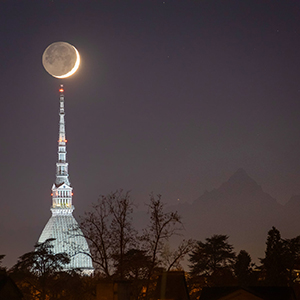
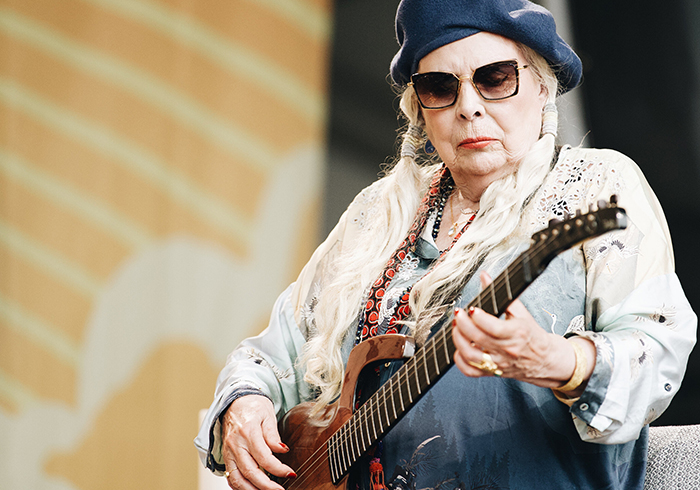
Newport
2022
And the seasons, they go round and round
we’re captive
on the carousel of time
we can’t return
we can only look
behind
YouTube is full of videos of the 2022 Newport Folk Festival, and my favorites are those with Joni Mitchell.
In 1968, I was there in Newport sitting on a hard, wooded, folding chair and listening to unknown folk singers. Now, 54 years later, a 78 year-old Joni Mitchell shows up to perform.
Looking behind, for me, doesn’t mean living in the past, because it was better than today – that’s pure bullshit. Rather, looking behind is about acknowledging where I’ve come from, what I experienced, who I met, because all those variables will impact where I’m headed and how I’ll respond the the experiences of the last part part of my life.
The pundits constantly put in front of us the screaming voices of those who reject the present; they put in front of us the horrors the Right wants to unleash in order to stop the present, to stop the future. But in the end none of that will work, because we can’t return from where we came.
– women aren’t going to accept second-class citizenship
– queer people are not going to accept marginalization
– black and brown people are not going to accept slave-labor wages
– non-believers are not going to embrace Christianity, and
– young people are not going to accept the restrictions the old, fat, white men are insisting on
The post-title is from Both Sides Now, (how can you pass up an opportunity to use the phrase moons and junes) but the sentiment of the post is more accurately summarized by the simple words from The Circle Game.
The featured image is the moon and the spiral of the Mole Antonelliana in Torino.
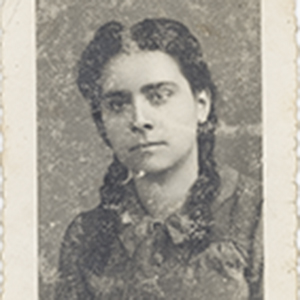
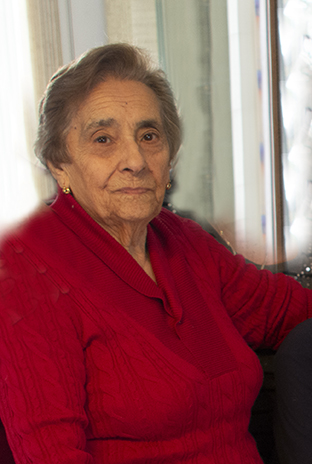
Wednesday, March 2, 1927
Thursday, September 15, 2022
Zinga, Mafalda (nee Perri)
Mafalda Zinga died peacefully on Thursday, September 15, 2022, at the age of 95.
She was predeceased by her loving husband Francesco (Ciccio) Zinga who died four years ago. Ciccio was her life-partner for 69 years.
Mafalda is the mother of Mario Zinga (Paul Leger), Connie Zinga (Ron Crowle) and Josephine – Giuseppina – Thorman (deceased). Josephine was married to David Thorman. Her three children and her husband were the most important people in Mafalda’s life.
Josephine and David (Isabel Thorman) gave Mafalda two delightful grandchildren – Christian Thorman and Seane Thorman (Liam Lavesseur). With her grandchildren, Mafalda’s life blossomed; she acquired a new name; she became Nonna. She made sure Christian had his soppressata and Seane had her soup regardless of what other foods covered her sumptuous table. Her grandchildren were also wonderful reminders of her daughter Giuseppina.
Mafalda was the daughter of Eugenio Perri and Marietta Perri. Her parents invited Mafalda and her family to immigrate to Canada from the Calabrian town of Aprigliano. The family arrived in Sault Ste Marie in May of 1957.
She was the sister of Amalia Muto (deceased). Amaila was married to Emilio Muto. These two women and their respective families – the Zingas and the Mutos – became an extended family. And that extended family nurtured friendships and forged bonds that remain. Friendships and bonds that will define and grow the next generations that Mafalda and Amalia leave behind.
She was the aunt of Rose McCaig (Derrick McCaig) and Mary Melchiorre (Dominic Melchiorre). For Rose and Mary, Mafalda was both aunt and confidant. They knew she would be their support and their champion and therefore Mafalda became an integral part of their adult lives.
I want to mention three other people who were great friends and companions to Mafalda:
Their loyalty and dedication brought great joy to Mafalda. And as a family, we would like to thank them for their friendship and love towards a courageous woman whose life we remember in this obituary.
There’s one other person that needs to be part of this story and that is Amalia Sanguinetti. Amalia and Mafalda were both born in Aprigliano; and they were young friends in that long ago. For the last four years, these two friends – Amalia and Mafalda – have lived at the Great Northern Retirement Home. What a wonderful gift life gave these two extraordinary women. They were friends in their youths and continued that friendship into their old age. Truly a gift from heaven.
The last group that deserves our thanks is the staff of the Great Northern Retirement Home. Mafalda spoke often of their generosity, their care and their companionship especially during the long periods of Covid isolation. As a family we want to thank them for bringing quality and dignity to Mafalda’s life.
We each come to this point of remembrance with our own sorrow, with our own sadness. And we each come to this point of remembrance with our own grief and our own way of grieving. But we also come to this inflection point with our memories of mom, Nonna, Zia and friend.
Thank you.
Service Details:
Viewing
Tuesday, September 20, 2022
10:30am – 12:30pm
O’Sullivan Funeral Home, 215 St. James Street
Funeral Mass:
Tuesday, September 20, 2022
1:00pm
St. Veronica Church, 559 Douglas
Entombment in Holy Sepulchre Cemetery following the Funeral Mass
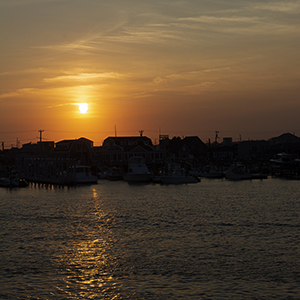
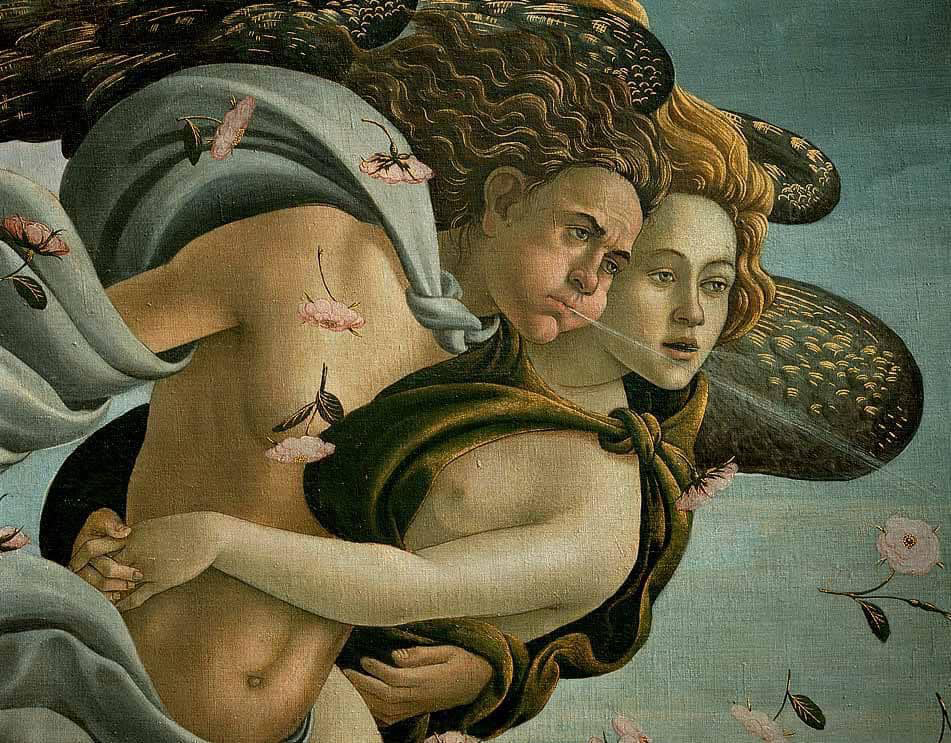
soave sia il vento
tranquilla sia londa
…
As you begin
this last journey
may the winds be soft
and the waters gentle
Note: The two title-lines and the above text are from the funeral-card for Mafalda Zinga – my mother;
the funeral was Tuesday, September 20, 2022.
The two lines on the right of the image – a detail of Botticelli’s Nascita di Venere – are from the Mozart opera Cosi fan tutte.
The four-line stanza is my incorporation of the Italian into a tribute for a life well-lived.
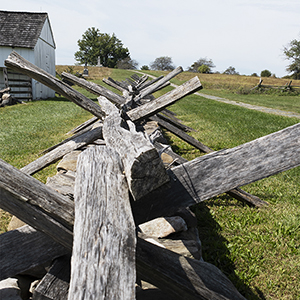
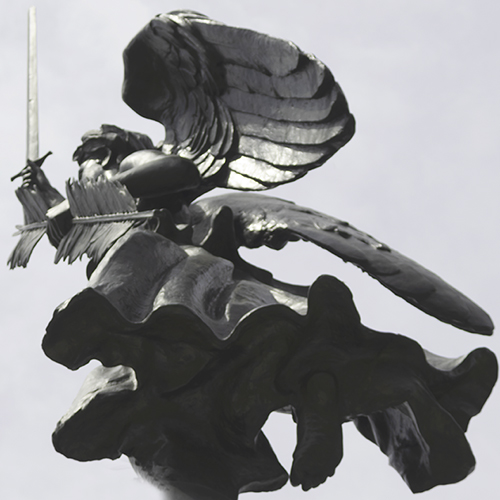
into battle
….
It’s been a while since I just did a list of random thoughts:
…..
The thumbnail leading to this post on the homepage is of the post-and-rail fences at Gettysburg;
and the above image is of the sculpture atop the Pennsylvania memorial at the Civil War battlefield.
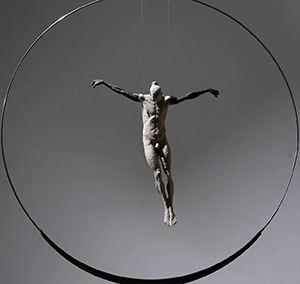
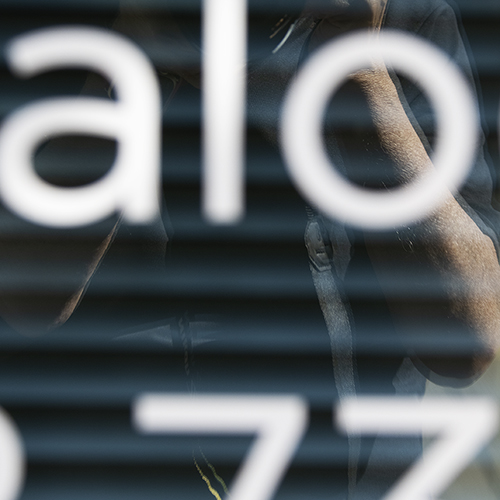
a half
forgotten
dream
…..
This is an unplanned post, so I have no idea where I’m going with it.
First – the featured image is a Max Leiva sculpture; second – the above image is a reflection; you should be able to make out my right arm and the camera strap.
I begin with a question – Is it possible to grab my life experiences, grouped by where I’ve lived – Aprigliano, Sault Ste Marie, Narragansett, Windsor, New York City, Pittsburgh – and one, deconstruct them and two, rank-order their value, importance and relevance?
Aprigliano
What I remember most is my time with my parents, with aunts, uncles and cousins, my time with my friends, and those experiences when I got away from everyone and was on my own.
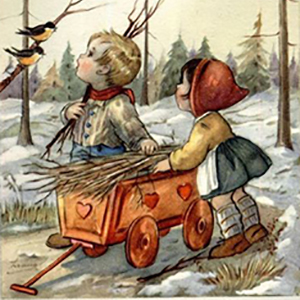
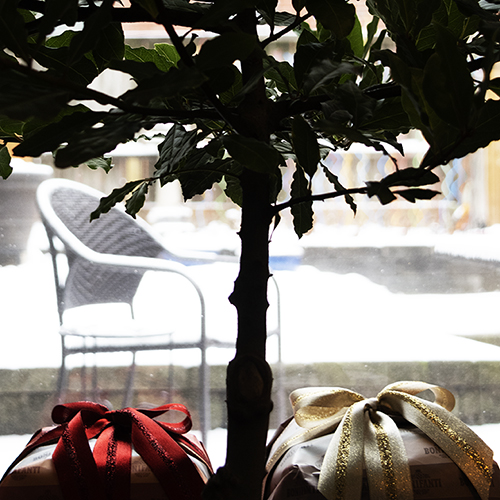
christmas eve
la vigilia di natale
…
This is the solstice
the still point of the sun
its cusp and midnight
the year’s threshold
and unlocking
where the past
lets go of and becomes the future
the place of caught breath
the door of a vanished house
left ajar
My third Christmas Eve at home – amazing and wonderful. It’s hard to believe that for 50 years, I drove or flew to Northern Ontario at this time of year. With many years the weather being as horrendous as it is today. In 2018 it took me 12 hours to get home; in 2019 it took 18 hours; both trips made miserable by weather conditions, flight delays and airport layovers (because sitting on those back-breaking lounge chairs is my idea of a pleasant Christmas trip).
I added the title la vigilia di natale, to mark how in Italy, Christmas Eve has taken on an importance it never had. It’s now very common, on social media, for people to post a season greeting about the 24th. That is a new development and I suspect it’s the Italians way of keeping the traditions and the religiosity of the holiday in place. Because, I suspect, like all First-World countries, Italy has defaulted to December 25 being an overwhelmingly commercial event full of insincere gift-giving and Hallmark sentimentality.
The image is from my back window looking out onto the snow-covered yard. The plant is a bay-leaf tree, in for the winter, and the two beautifully wrapped things under it are panettoni. (I decided to leave the patio-chair out to remind me that this too shall pass – and please let it pass fast. It’s clear I HATE winter, right?)
The poem – Solstice – is by Margaret Atwood.
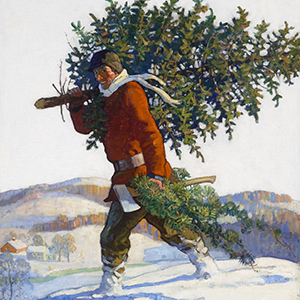
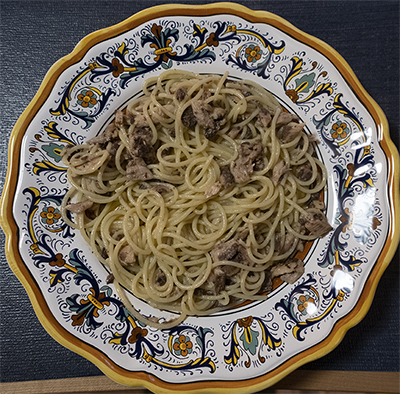
pasta e sarde
…
As I’ve written many times, the menu and traditions of la vigilia di natale – Christmas Eve – have always been my favorite.
Christmas Day, at least for the immigrant communities of Ontario, has been usurped by the mythology of happiness through conspicuous consumption – propaganda the British and the American corporations have peddled for decades.
And as I wrote in a previous post, Italians in Italy have decided to take back la vigilia and celebrate their traditions and their foods on December 24. Because they too have succumbed to the conspicuous consumption of Christmas.
Food traditions brought over from Calabria
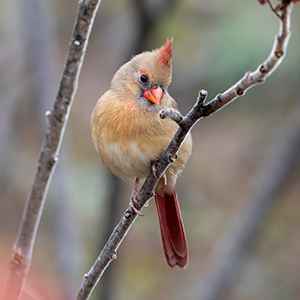

a
fat
cardinal
…
Where do I start?
Reality
For the first time, I put out a bird-feeder and after two weeks of no visitors, the wilds of the Northside found it. Now, I’m refilling it every day.
Each morning, they – some 50 winged wilds – keep me company as I drink my espresso and eat my Costco corn muffin. On a dreary winter morning, their chirping, fluttering, littering, their bickering are all welcome. (Since January 1, Pittsburgh has had 4 sunny days.)
Fantasy
The Roman Church is truly going through a wormhole. Dead Cardinal Pell, who is currently residing in the third ring of the seventh circle, is screaming because The Argentinian is talking about homosexuality. (It’s like a fat priest crashing the dinning hall at Auschwitz. Can’t you just picture it – his mouth covered in cake crumbs, his cardinal-red train fluttering behind him as he grabs his gold pectoral-cross and screeches, ‘Gluttony is a mortal sin; you’re all going to burn in hell.’)
And what about the German Georg Gänswein? Yes, he’s so smart, he writes a book instead of screaming. He screeches, he rants, he scribbles all about a dead Latin rite – OMG. Maybe a train fluttering in the Vatican breeze would settle his Hun heart? What about tea with Cardinal Burke; Leo could wear his ermine collar and bring his ‘train-boy’? No? … Methinks the lady doth protest too much.
…
The above image is shot through a window with a screen, hence its blurry quality. And compared to all the other wilds that come to feast, this Northern Cardinal female is hefty, full-figured.
The featured image is by Kelly Flanagan. I follow her on Twitter.
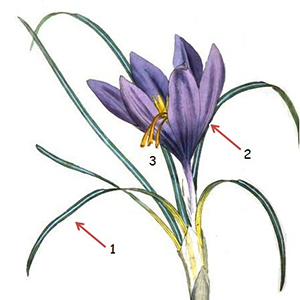
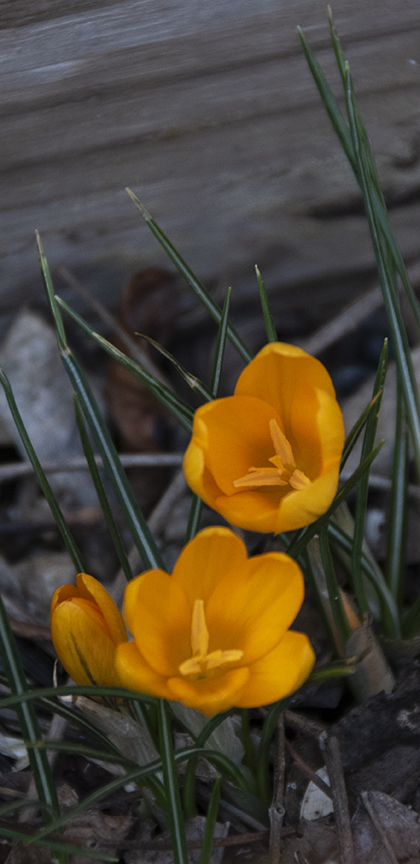
Though a tremor of the winter
Did shivering through them run;
Yet they lifted up their foreheads
To greet the vernal sun.
…
The stanza, to the right of the image, is from The Crocuses by Frances Ellen Watkins Harper.
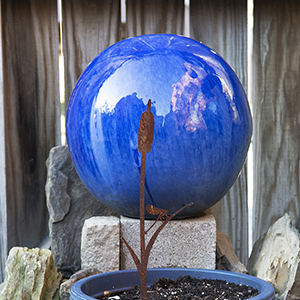
17 days
till the vernal
equinox

…
The pots sit ready; the rocks lean left; and the sun is setting on the rich, white psychopaths.
Last year, I got rid of many items – rocks, cinder-blocks, bricks, planks, pots, decorations. But in simplifying, I didn’t have time to organize what was left. This year, with a stripped-down, minimized area, I ordered what remained.
Sometime at the beginning of April, I will fill the pots with violets – the first planting.
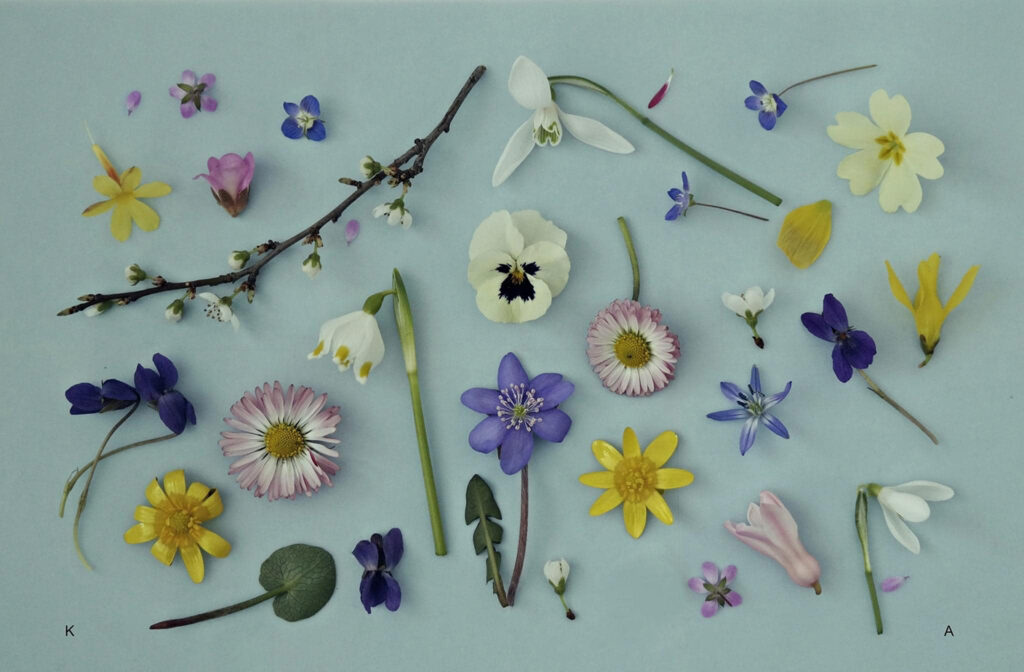
art by
Andrea Kiss

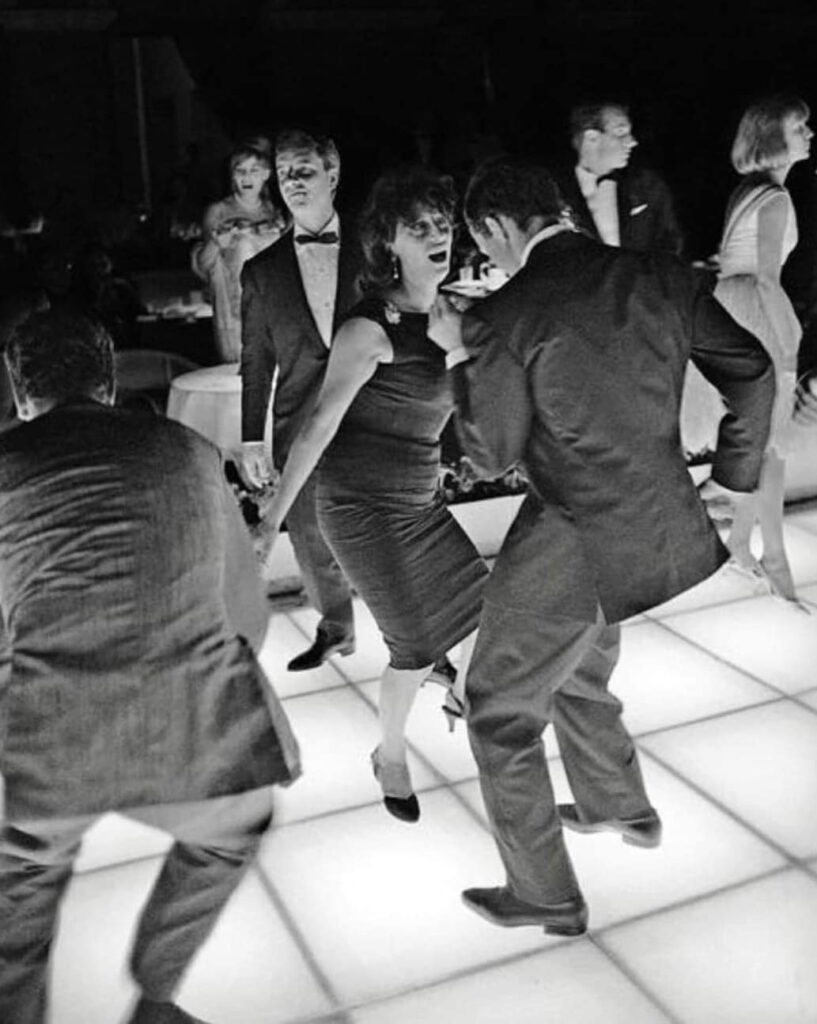
#1
Magnani e Pasolini
Venice, 1962
…
We are the sum of our experiences; uniquely defined by our memories.
We spend a lifetime gathering a collection of treasured object and symbols.
Each of them holding a tiny fragment of our identity.
…
I’ve been wanting to do a set of posts that present the various images in my head – fragments that belong to another time, another country, another sensibility.
These image-slivers have been with me all my life, and now I realize they’re memories.
The past is a foreign country: they do things differently there. L.P. Hartley, “The Go-Between“.
Anna Magnani
The above image represents all the pictures in my head of Italian immigrants at weddings. Real people dancing; dancing before the reality of Lee Harvey Oswald, before the horrors of Vietnam, before the unraveling of Catholicism, and before the assimilation into a Canadian dullness.
But Magnani is real; she’s luminous; her mouth hangs with laughter; her simple black dress caresses her body. There’s fun, there’s heat.
Living in Sault Ste Marie, in a Calabrese community, in the 60s, I had relatives like Magnani.
Pier Paolo Pasolini
Pasolini, with his back to the camera, heralds what’s coming; he’s the reality of Last Tango; he’s the horror of AIDS; he’s the unraveling of the lies of the 1950s; and he’s the assimilation of blacks, women and gays.
But Pasolini is hidden; his head is down; he’s contorted. His vented jacket covers his ass; his pointy shoes squeeze his feet. There’s disquiet; there’s fear.
Living in New York in the heady, lewd 70s, I had friends like Pasolini.
Both the above image and the featured image of Magnani are from online.
The quote is from an episode of Vienna Blood.
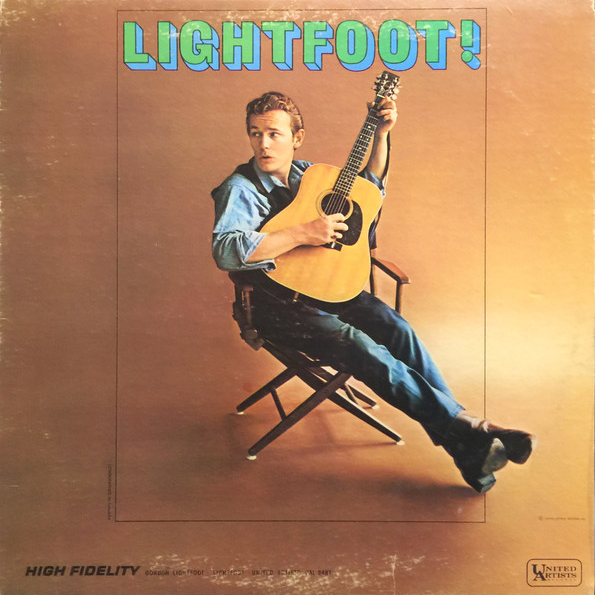
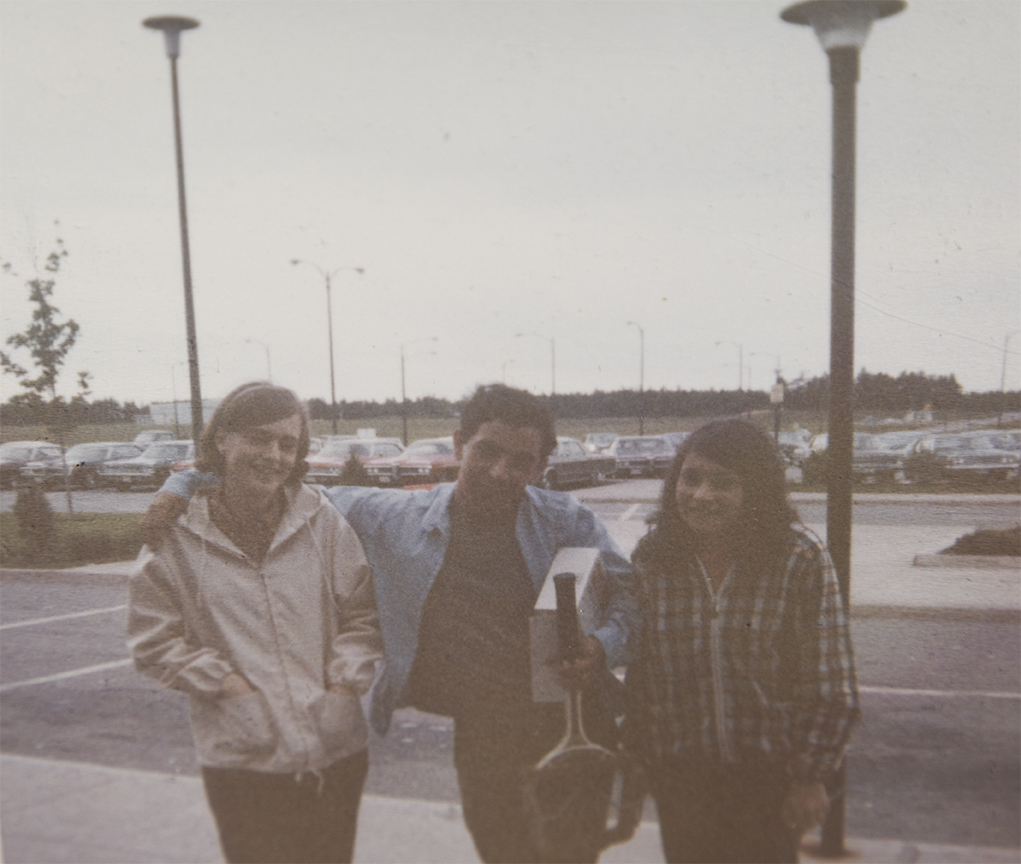
#2
Bruna, Mario, Anita
June 24, 1968
…
Gonna buy me a long white robe
I’m gonna find me a smilin’ angel
This second image fragment is also from that long-ago. We’re at the Sault Ste Marie airport and I’m leaving for Toronto. My final destination is the Christian Brothers Novitiate in Narragansett, Rhode Island. Talk about a leap into the unknown.
My friends drove me to the airport; Bruna was ‘going with Rainer’; Anita was dating Ron. I’m holding my Slazenger tennis racket with its wooden press – OMG. In a weird twist of fate, it became my ticket into the upper echelon of the Brothers – OMG squared.
The way I feel is like a robinWhose babes have flown to come no moreLike a tall oak tree alone and cryin’When the birds have flown and the nest is bare
A Slazenger
Living in Northern Ontario, in that long-ago, life was about assimilation into the ‘English’ culture. The Slazenger racket was a symbol of having left behind my immigrant roots. Brandishing the talisman let slip from memory my very Italian name. And the long-ā, Canadian pronunciation, of my very Italian name, disguised its foreign origins.
We lived in a town with a French name, but looked down on our French-Canadian neighbors; we bought Slazenger equipment – it was the racket of Wimbledon; we had names like Bruna, Mario, Anita, but we weren’t Italian; I was going to a monastery, but we’re posed like a vacation picture.
In Sault Ste Marie, in the 1960s there were tennis courts at every municipal playground. My friends and I, played tennis as often as possible. Taking my racket with me, was the equivalent of today’s kid taking a basketball with him to college.
However, walking onto the ocean-front campus of the Christian Brothers Novitiate with a tennis racket sent a message; a message I was oblivious of. But that summer, I played tennis with all the mucky-mucks vacationing in the mansion and cottages on the property; I even played tennis with a New York Mafia don.
In May of 57, my family left Calabria for Canada. In June of 68, I left Sault Ste Marie for Rhode Island – never to live in Canada again.
Lightfoot
The featured image for this post is the 1966 cover of Gordon Lightfoot’s first solo album. Imagine, I took it with me to a monastery. Also, the two quotes – Gonna buy me and The way I feel – are from songs on that album.
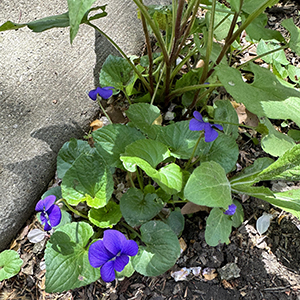
#3
le viole
by a stream
in aprigliano
in 1954

…
the smell of violets hidden in the green
pour’d back into my empty soul
and frame the times when I remember
to have been joyful and free of blame
This third entry is about two remembrances that are forever intertwined. Two memories – my father leaving for southern France, and me sitting by a trickling stream surrounded by violets – are fused together. In reality the two events were probably not related, but memory and synapses don’t care about timestamps or separateness.
Two Stories
1956
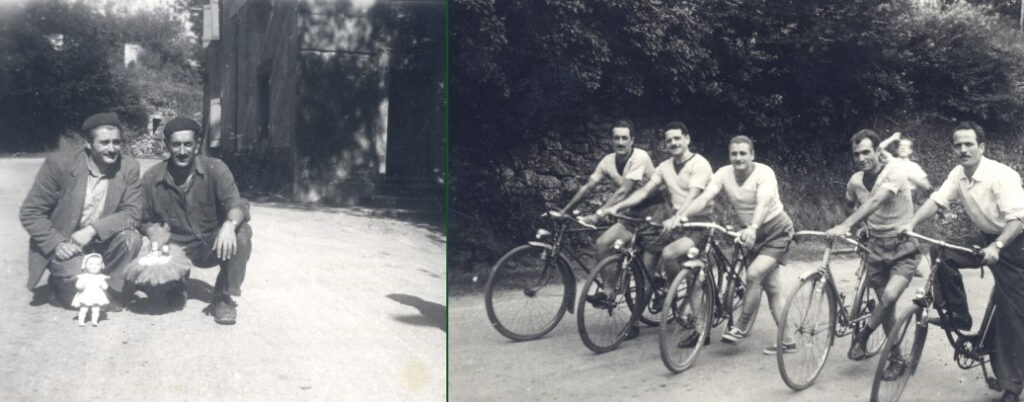
Left image (L to R): Antonio – Totonnu – my father’s first cousin and best friend, and my dad.
Right image (L to R): all men from Aprigliano who went to south-western France for work.
(far left, my dad. in the middle Totonnu.)
South-western France
– In the picture on the left – the doll in front of my dad, was a gift for my mother. The doll came with us to Canada; but my mother put it on top of a lamp in their bedroom on Henrietta Street in Sault Ste Marie and it caught on fire and burned.
– The other souvenir that came with us to Canada was a small wall-statue of Our Lady of Lourdes; it glowed in the dark. (My dad and his friends went to Lourdes; it wasn’t far from where they were working.)
– In the picture on the right – the man in the middle is my cousin Totonnu; the man to his left immigrated to Canada and traveled with us from Naples to Halifax. I don’t know his name, and I have no idea where he ended up in Canada.
2006
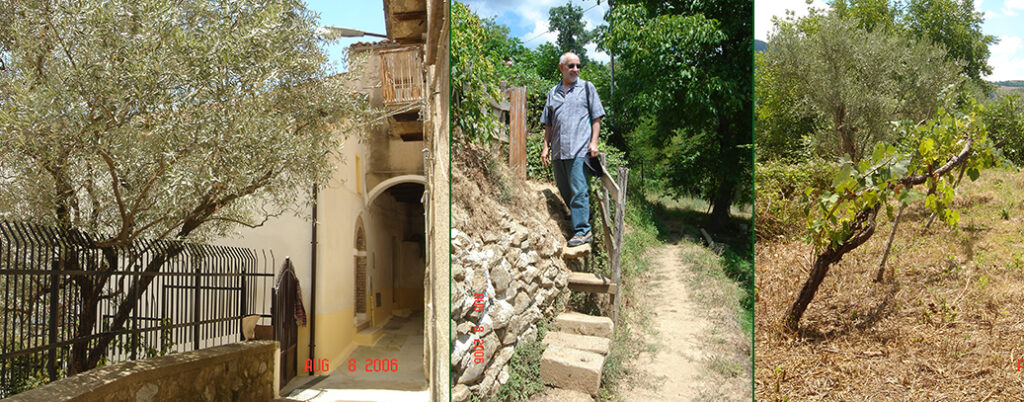
Left image – Our family house in Aprigliano. Our was the last house before the fields. The alleyway led to town.
Middle image – Me on the steps going up to my dad’s vineyard. The path is also how I would get to the small stream.
Right image – the lower tier of the vineyard that is now abandoned.
Trickling Stream
– Beside our house in Aprigliano were a series of plots that families rented for vineyards and vegetable gardens. Among these plots, my dad worked a small, two-tier vineyard and I went with him whenever he worked the vines.
– Because our house was next to the fields, my friends and I spent hours exploring and playing in and around the gardens, the chestnut trees, the oak trees, the vineyards. If we wanted away from the adults, we followed the path. A small stream and its bog hid further down the dirt path shown in the middle image.
– I remember retreating to the stream the day my dad was leaving for France. A safe place with its violets, trickling waters, its wet moss – all soothed a sad seven-year-old. But, I stayed too long; by the time I got back, my dad had left.
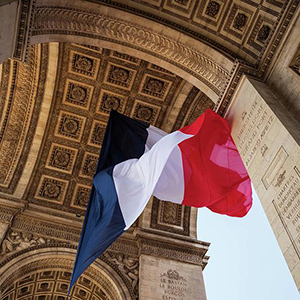
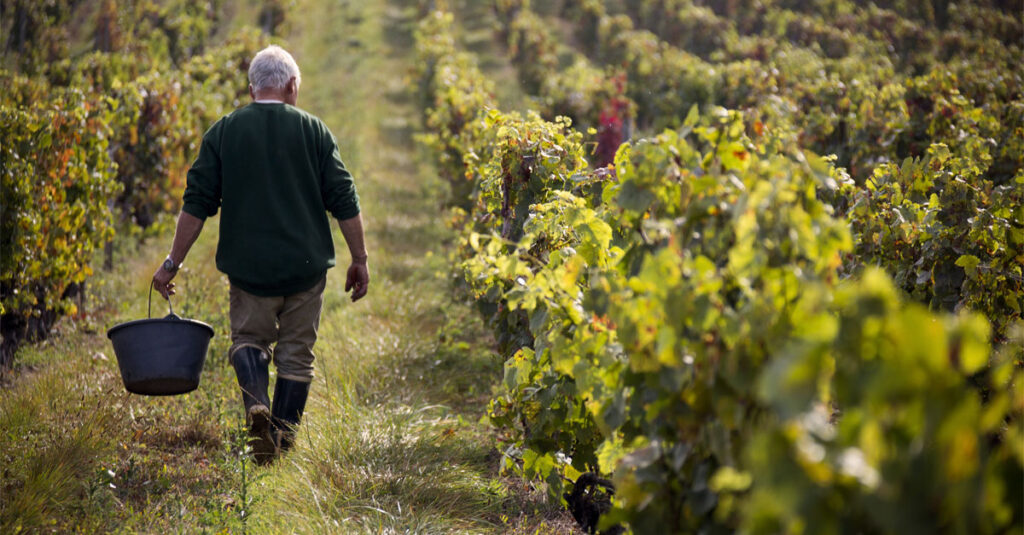
it begins
in
2-days
…
The last time I was in France was some 20 years ago – I was a younger man and was there with Rick and Sarah and their daughters Shana and Mimi. We landed in Paris and after a couple of days we headed south-east towards the Italian border. Our destination was Verona because we couldn’t find accommodations in Venice, so we just visited.
That long-ago trip had many memorables:
– in Paris, for lunch, the girls had horse-meat hamburgers
– for dinner, that same day, I had tripe at Au Pied du Cochon
– Mimi and I went out and got pastries for breakfast
– Jim Morrison’s grave at Père Lachaise was littered with weed-roaches
– the top of Gertrude Stein’s grave-marker was covered with small stones
This time, eight of us are traveling – Rose and Derrick, Mary and Dom, Rick and Sarah, Frank and I. We’ll be in Paris for two-and-a-half days and then we’re going to Burgundy for a seven-day canal-barge cruise.
Both the featured image and the above picture are from the Internet.
The flag in the Arc de Triomphe has always been one of my favorite symbols of France.
The man in the vineyard points to Burgundy and the wines we’ll be savoring while being spoiled cruising the Canal de Bourgogne.
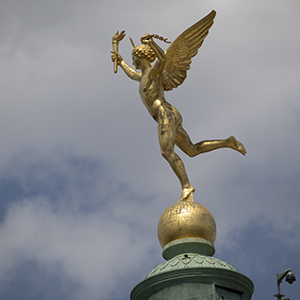
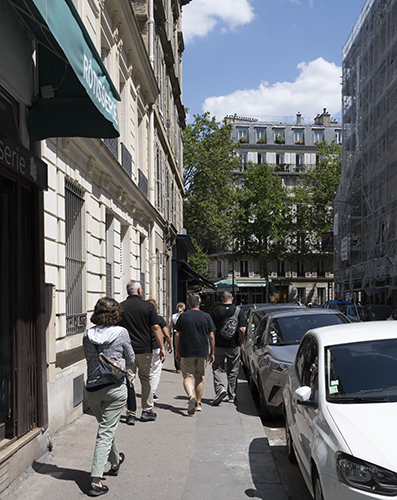
day 1
rue Jules César
and we’re off
…
We got here using different airlines, and Frank is still back in Toronto. He will join us tomorrow.
I’ve never been to Charles de Gaulle Airport and let me tell you it was both efficient and overwhelming. You go through customs before getting your luggage and getting through customs was horrible. Got through but it reminded me of Lima and its masses of humanity. Same was true waiting in lines to get through to have my passport almost ignored.
We decided to take the RER-A commuter into town. The train barrels through several northern arrondissements as it heads south towards the center of Paris. The City of Lights is organized very differently than most American cities. In the US, whites, middle and upper middle-class people live in the suburban rings that circumscribe large metropolitan areas. In Paris it’s the reverse and on the RER we saw how modern Paris is organized.
Our hotel is at 13 rue Jules-César – poor Caesar, even in modern times he gets assigned and ‘unlucky’ number. Personally, I love the address.
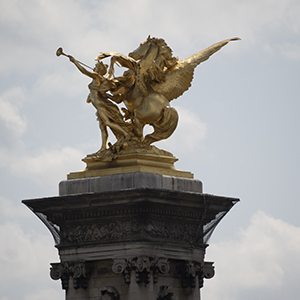
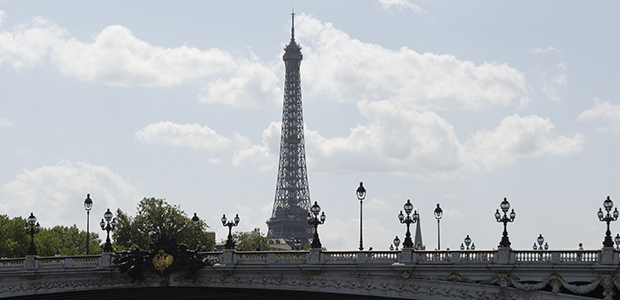
day 2
up river
& round the bend
…
I’m continuing to use the gold-leaf sculptures atop columns and plinths as the featured images. Today’s sculpture is atop the Pont Alexandre III bridge pylon.
Rather than walk all the way up river, we decided to buy tickets on a hop-on/hop-off boat that cruised up and down the Seine. Our first stop was Le musée du Louvre. The story we will all take from this our first stop of the day, is that Dom got lost – hey, he was doing his thing. And being a good, frugal Canadian, he was damned if he was going to turn his phone on and pay the soul-sucking provider $15 a day. So we had no way of phoning or texting him. Naturally, I texted his kids back in Pickering telling them we had lost their father in the middle of Paris. After all, we all want to know of any breaking news, right?
But the more lasting experience was at Le Musée de l’Orangerie and interacting with Monet’s surreal, fascinating and other-worldly water lilies – le célèbre cycle des Nymphéas. At the entrance to the oval gallery, the notice asked that we remain quiet and respectful. I laughed; in Florence you were asked to remain quiet and respectful in the Medici Tombs; in Paris we are asked to remain quiet and respectful when interacting with beautiful art. I may have been born in Italy, but my sensibilities are certainly more French than Italian.
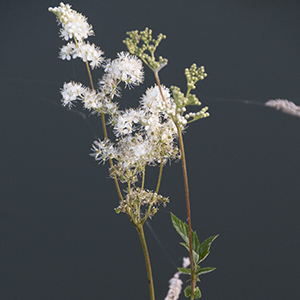
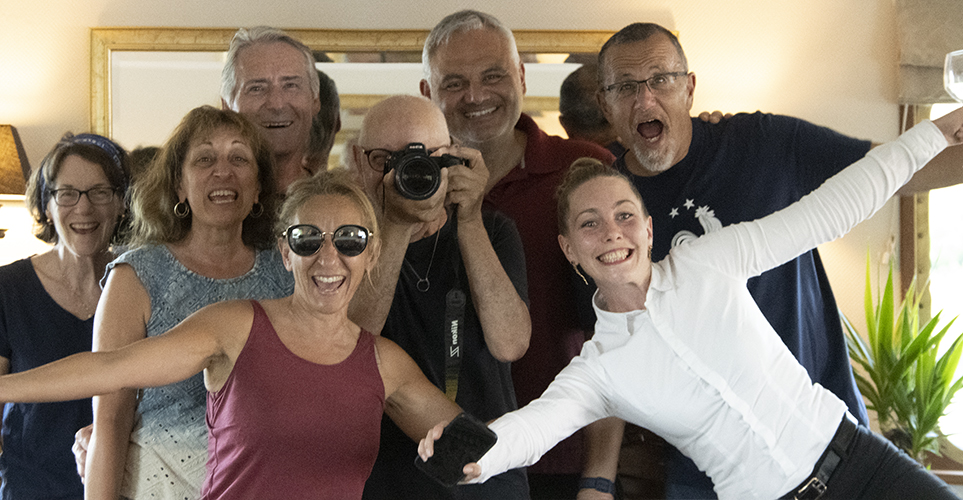
day 4
we made it
…
Frank is missing, yes we know; but it’s a great pic.
First, let me tell you why there is not post for our 3rd day in Paris – I walked out and forgot to put the camera card in; I left it in the reader. So, I have no pictures of the Picasso Museum and our day in Le Marais.
On Sunday, early afternoon, staff from the Barge picked us up at our hotel and we drove the 3-hours to the small village of Vandenesse-en-Auxois.
What followed was a gastronomic super-bowl.
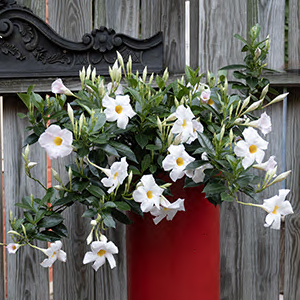
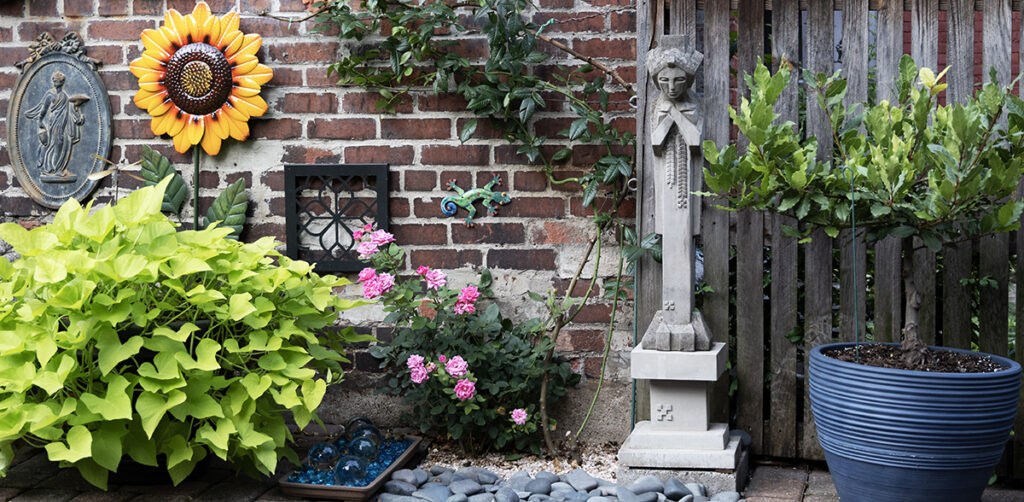
…
I’m home as you can see, but my camera equipment, laptop and thumb-drive are in Toronto. The Paris airports strike again. I’ve NEVER gotten out of either airport without some hassle.
Should have everything back Sunday and will be able to process all the pictures from the amazing trip.
Stay tuned to read about Sarah’s phone falling into the canal and recovered by a scuba-diving Emile; Herve NOT being Spanish; Frank getting lost on the not-a-towpath; the new light fixtures in L’église Notre-Dame de Dijon …
…
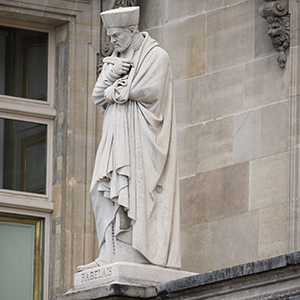

day 2 –
continued
l’Orangerie
…
The French for waterlilies is nénuphars; sorry, English has the better word.
The Italian for sunflower is girasole – turns to the sun; girasole has motion, sunflower is static.
The French for Queen-Anne’s-lace is carotte sauvage; the English is elegant, the French pedestrian.
The Musée de l’Orangerie is church – you walk in and you’re transfixed, made holy. Monet’s waterlilies have replaced the statues, the crucifixes, the stained glass, the incense, the candles. The rectangular nave gives way to infinity space. We’re not looking for salvation; we are the children of François Rabelais; we are the children of The Revolution.
So we pray to blue, to yellow, to green. We pray in silence and we pray alone.
…

∞
The above image shows the infinity design of the two galleries that showcase Monet’s amazing paintings.
Also, the featured image for this post is from the Louvre courtyard. Many of the statues decorating the parapet that runs outside the second floor have been restored. The featured image is of the statue of François Rabelais.